Table of Contents
- ZyWALL/USG Series
- User’s Guide
- Introduction
- Installation Setup Wizard
- 2.1 Installation Setup Wizard Screens
- 2.1.1 Internet Access Setup - WAN Interface
- 2.1.2 Internet Access: Ethernet
- 2.1.3 Internet Access: PPPoE
- 2.1.4 Internet Access: PPTP
- 2.1.5 Internet Access Setup - Second WAN Interface
- 2.1.6 Internet Access Succeed
- 2.1.7 Wireless Settings: AP Controller
- 2.1.8 Wireless Settings: SSID & Security
- 2.1.9 Internet Access - Device Registration
- 2.1 Installation Setup Wizard Screens
- Hardware, Interfaces and Zones
- Quick Setup Wizards
- 4.1 Quick Setup Overview
- 4.2 WAN Interface Quick Setup
- 4.3 VPN Setup Wizard
- 4.3.1 Welcome
- 4.3.2 VPN Setup Wizard: Wizard Type
- 4.3.3 VPN Express Wizard - Scenario
- 4.3.4 VPN Express Wizard - Configuration
- 4.3.5 VPN Express Wizard - Summary
- 4.3.6 VPN Express Wizard - Finish
- 4.3.7 VPN Advanced Wizard - Scenario
- 4.3.8 VPN Advanced Wizard - Phase 1 Settings
- 4.3.9 VPN Advanced Wizard - Phase 2
- 4.3.10 VPN Advanced Wizard - Summary
- 4.3.11 VPN Advanced Wizard - Finish
- 4.4 VPN Settings for Configuration Provisioning Wizard: Wizard Type
- 4.4.1 Configuration Provisioning Express Wizard - VPN Settings
- 4.4.2 Configuration Provisioning VPN Express Wizard - Configuration
- 4.4.3 VPN Settings for Configuration Provisioning Express Wizard - Summary
- 4.4.4 VPN Settings for Configuration Provisioning Express Wizard - Finish
- 4.4.5 VPN Settings for Configuration Provisioning Advanced Wizard - Scenario
- 4.4.6 VPN Settings for Configuration Provisioning Advanced Wizard - Phase 1 Settings
- 4.4.7 VPN Settings for Configuration Provisioning Advanced Wizard - Phase 2
- 4.4.8 VPN Settings for Configuration Provisioning Advanced Wizard - Summary
- 4.4.9 VPN Settings for Configuration Provisioning Advanced Wizard- Finish
- 4.5 VPN Settings for L2TP VPN Settings Wizard
- Dashboard
- 5.1 Overview
- 5.2 Main Dashboard Screen
- 5.2.1 Device Information Screen
- 5.2.2 System Status Screen
- 5.2.3 VPN Status Screen
- 5.2.4 DHCP Table Screen
- 5.2.5 Number of Login Users Screen
- 5.2.6 System Resources Screen
- 5.2.7 CPU Usage Screen
- 5.2.8 Memory Usage Screen
- 5.2.9 Active Session Screen
- 5.2.10 Extension Slot Screen
- 5.2.11 Interface Status Summary Screen
- 5.2.12 Secured Service Status Screen
- 5.2.13 Content Filter Statistics Screen
- 5.2.14 Top 5 Viruses Screen
- 5.2.15 Top 5 Intrusions Screen
- 5.2.16 Top 5 IPv4/IPv6 Security Policy Rules that Blocked Traffic Screen
- 5.2.17 The Latest Alert Logs Screen
- Technical Reference
- Monitor
- 6.1 Overview
- 6.2 The Port Statistics Screen
- 6.3 Interface Status Screen
- 6.4 The Traffic Statistics Screen
- 6.5 The Session Monitor Screen
- 6.6 IGMP Statistics
- 6.7 The DDNS Status Screen
- 6.8 IP/MAC Binding
- 6.9 The Login Users Screen
- 6.10 Cellular Status Screen
- 6.11 The UPnP Port Status Screen
- 6.12 USB Storage Screen
- 6.13 Ethernet Neighbor Screen
- 6.14 Wireless
- 6.15 The IPSec Monitor Screen
- 6.16 The SSL Screen
- 6.17 The L2TP over IPSec Session Monitor Screen
- 6.18 The App Patrol Screen
- 6.19 The Content Filter Screen
- 6.20 The IDP Screen
- 6.21 The Anti-Virus Screen
- 6.22 The Anti-Spam Screens
- 6.23 The SSL Inspection Screens
- 6.24 Log Screens
- Licensing
- Wireless
- Interfaces
- Routing
- DDNS
- NAT
- HTTP Redirect
- ALG
- UPnP
- IP/MAC Binding
- Layer 2 Isolation
- Inbound Load Balancing
- Web Authentication
- RTLS
- Security Policy
- IPSec VPN
- SSL VPN
- SSL User Screens
- ZyWALL/USG SecuExtender (Windows)
- L2TP VPN
- BWM (Bandwidth Management)
- Application Patrol
- Content Filtering
- IDP
- Anti-Virus
- Anti-Spam
- SSL Inspection
- Device HA
- Object
- 35.1 Zones Overview
- 35.2 User/Group Overview
- 35.3 AP Profile Overview
- 35.4 MON Profile
- 35.5 Application
- 35.6 Address Overview
- 35.7 Service Overview
- 35.8 Schedule Overview
- 35.9 AAA Server Overview
- 35.10 Auth. Method Overview
- 35.11 Certificate Overview
- 35.12 ISP Account Overview
- 35.13 SSL Application Overview
- 35.14 DHCPv6 Overview
- System
- 36.1 Overview
- 36.2 Host Name
- 36.3 USB Storage
- 36.4 Date and Time
- 36.5 Console Port Speed
- 36.6 DNS Overview
- 36.6.1 DNS Server Address Assignment
- 36.6.2 Configuring the DNS Screen
- 36.6.3 Address Record
- 36.6.4 PTR Record
- 36.6.5 Adding an Address/PTR Record
- 36.6.6 CNAME Record
- 36.6.7 Adding a CNAME Record
- 36.6.8 Domain Zone Forwarder
- 36.6.9 Adding a Domain Zone Forwarder
- 36.6.10 MX Record
- 36.6.11 Adding a MX Record
- 36.6.12 Security Option Control
- 36.6.13 Editing a Security Option Control
- 36.6.14 Adding a DNS Service Control Rule
- 36.7 WWW Overview
- 36.8 SSH
- 36.9 Telnet
- 36.10 FTP
- 36.11 SNMP
- 36.12 Authentication Server
- 36.13 CloudCNM Screen
- 36.14 Language Screen
- 36.15 IPv6 Screen
- 36.16 ZyXEL One Network (ZON) Utility
- Log and Report
- File Manager
- Diagnostics
- Packet Flow Explore
- Shutdown
- Troubleshooting
- Customer Support
- Legal Information
- Product Features
- Index
- Monitor
Zyxel ZyWALL 310 User Manual
Displayed below is the user manual for ZyWALL 310 by Zyxel which is a product in the Hardware Firewalls category. This manual has pages.
Related Manuals

Quick Start Guide
www.zyxel.com
ZyWALL/USG Series
ZyWALL 110 / 310 / 1100
USG40 / USG40W / USG60 / USG60W / USG110 / USG210 /
USG310 / USG1100 / USG1900
Security Firewalls
Version 4.13
Edition 1, 08/2015
Copyright © 2015 ZyXEL Communications Corporation
User’s Guide
Default Login Details
LAN Port IP Address https://192.168.1.1
User Name admin
Password 1234

ZyWALL/USG Series User’s Guide
2
IMPORTANT!
READ CAREFULLY BEFORE USE.
KEEP THIS GUIDE FOR FUTURE REFERENCE.
This is a User’s Guide for a series of products. Not all products support all firmware features.
Screenshots and graphics in this book may differ slightly from your product due to differences in
your product firmware or your computer operating system. Every effort has been made to ensure
that the information in this manual is accurate.
Related Documentation
•Quick Start Guide
The Quick Start Guide shows how to connect the ZyWALL/USG and access the Web Configurator
wizards. (See the wizard real time help for information on configuring each screen.) It also
contains a connection diagram and package contents list.
• CLI Reference Guide
The CLI Reference Guide explains how to use the Command-Line Interface (CLI) to configure the
ZyWALL/USG.
Note: It is recommended you use the Web Configurator to configure the ZyWALL/USG.
• Web Configurator Online Help
Click the help icon in any screen for help in configuring that screen and supplementary
information.
•Knowledge Base
See Support > Knowledge Base at the ZyXEL website for FAQs, application examples,
troubleshooting and other technical information on the ZyWALL/USG.

ZyWALL/USG Series User’s Guide
3
Part I: User’s Guide .........................................................................................19
Chapter 1
Introduction.........................................................................................................................................21
1.1 Overview ...........................................................................................................................................21
1.1.1 Applications .............................................................................................................................21
1.2 Management Overview .....................................................................................................................24
1.3 Web Configurator ..............................................................................................................................25
1.3.1 Web Configurator Access ........................................................................................................25
1.3.2 Web Configurator Screens Overview ......................................................................................28
1.3.3 Navigation Panel .....................................................................................................................31
1.3.4 Tables and Lists .......................................................................................................................38
Chapter 2
Installation Setup Wizard...................................................................................................................41
2.1 Installation Setup Wizard Screens ...................................................................................................41
2.1.1 Internet Access Setup - WAN Interface ..................................................................................41
2.1.2 Internet Access: Ethernet .......................................................................................................42
2.1.3 Internet Access: PPPoE ..........................................................................................................43
2.1.4 Internet Access: PPTP ...........................................................................................................45
2.1.5 Internet Access Setup - Second WAN Interface ......................................................................46
2.1.6 Internet Access Succeed ........................................................................................................47
2.1.7 Wireless Settings: AP Controller ............................................................................................47
2.1.8 Wireless Settings: SSID & Security ........................................................................................48
2.1.9 Internet Access - Device Registration ....................................................................................49
Chapter 3
Hardware, Interfaces and Zones .......................................................................................................50
3.1 Overview ...........................................................................................................................................50
3.1.1 Front Panels ............................................................................................................................50
3.1.2 Rear Panels .............................................................................................................................51
3.1.3 Default Zones, Interfaces, and Ports .......................................................................................52
3.2 Mounting ...........................................................................................................................................54
3.2.1 Rack-mounting ........................................................................................................................54
3.2.2 Wall-mounting ..........................................................................................................................55
3.3 Stopping the ZyWALL/USG ..............................................................................................................55
Chapter 4
Quick Setup Wizards..........................................................................................................................56
4.1 Quick Setup Overview .......................................................................................................................56
4.2 WAN Interface Quick Setup ..............................................................................................................57
4.2.1 Choose an Ethernet Interface ..................................................................................................57
4.2.2 Select WAN Type .....................................................................................................................58

ZyWALL/USG Series User’s Guide
4
4.2.3 Configure WAN IP Settings .....................................................................................................58
4.2.4 ISP and WAN and ISP Connection Settings ............................................................................59
4.2.5 Quick Setup Interface Wizard: Summary ................................................................................61
4.3 VPN Setup Wizard ............................................................................................................................62
4.3.1 Welcome ..................................................................................................................................63
4.3.2 VPN Setup Wizard: Wizard Type .............................................................................................64
4.3.3 VPN Express Wizard - Scenario .............................................................................................64
4.3.4 VPN Express Wizard - Configuration .....................................................................................66
4.3.5 VPN Express Wizard - Summary ...........................................................................................66
4.3.6 VPN Express Wizard - Finish .................................................................................................67
4.3.7 VPN Advanced Wizard - Scenario .........................................................................................68
4.3.8 VPN Advanced Wizard - Phase 1 Settings .............................................................................69
4.3.9 VPN Advanced Wizard - Phase 2 ...........................................................................................71
4.3.10 VPN Advanced Wizard - Summary ......................................................................................72
4.3.11 VPN Advanced Wizard - Finish .............................................................................................72
4.4 VPN Settings for Configuration Provisioning Wizard: Wizard Type ..................................................73
4.4.1 Configuration Provisioning Express Wizard - VPN Settings ...................................................74
4.4.2 Configuration Provisioning VPN Express Wizard - Configuration ..........................................75
4.4.3 VPN Settings for Configuration Provisioning Express Wizard - Summary .............................76
4.4.4 VPN Settings for Configuration Provisioning Express Wizard - Finish ...................................77
4.4.5 VPN Settings for Configuration Provisioning Advanced Wizard - Scenario ...........................78
4.4.6 VPN Settings for Configuration Provisioning Advanced Wizard - Phase 1 Settings ..............79
4.4.7 VPN Settings for Configuration Provisioning Advanced Wizard - Phase 2 ............................81
4.4.8 VPN Settings for Configuration Provisioning Advanced Wizard - Summary ..........................81
4.4.9 VPN Settings for Configuration Provisioning Advanced Wizard- Finish .................................83
4.5 VPN Settings for L2TP VPN Settings Wizard ...................................................................................84
4.5.1 L2TP VPN Settings ..................................................................................................................85
4.5.2 L2TP VPN Settings ..................................................................................................................86
4.5.3 VPN Settings for L2TP VPN Setting Wizard - Summary ........................................................87
4.5.4 VPN Settings for L2TP VPN Setting Wizard Completed ........................................................88
Chapter 5
Dashboard...........................................................................................................................................89
5.1 Overview ...........................................................................................................................................89
5.1.1 What You Can Do in this Chapter ............................................................................................89
5.2 Main Dashboard Screen ...................................................................................................................89
5.2.1 Device Information Screen ......................................................................................................91
5.2.2 System Status Screen .............................................................................................................92
5.2.3 VPN Status Screen ..................................................................................................................93
5.2.4 DHCP Table Screen ................................................................................................................94
5.2.5 Number of Login Users Screen ...............................................................................................95
5.2.6 System Resources Screen ......................................................................................................96
5.2.7 CPU Usage Screen .................................................................................................................97

ZyWALL/USG Series User’s Guide
5
5.2.8 Memory Usage Screen ............................................................................................................98
5.2.9 Active Session Screen .............................................................................................................99
5.2.10 Extension Slot Screen .........................................................................................................100
5.2.11 Interface Status Summary Screen .......................................................................................100
5.2.12 Secured Service Status Screen ...........................................................................................102
5.2.13 Content Filter Statistics Screen ...........................................................................................103
5.2.14 Top 5 Viruses Screen ...........................................................................................................103
5.2.15 Top 5 Intrusions Screen .......................................................................................................104
5.2.16 Top 5 IPv4/IPv6 Security Policy Rules that Blocked Traffic Screen .....................................104
5.2.17 The Latest Alert Logs Screen ..............................................................................................105
Part II: Technical Reference..........................................................................106
Chapter 6
Monitor...............................................................................................................................................108
6.1 Overview .........................................................................................................................................108
6.1.1 What You Can Do in this Chapter ..........................................................................................108
6.2 The Port Statistics Screen ..............................................................................................................109
6.2.1 The Port Statistics Graph Screen ......................................................................................... 110
6.3 Interface Status Screen ................................................................................................................... 111
6.4 The Traffic Statistics Screen ............................................................................................................ 114
6.5 The Session Monitor Screen .......................................................................................................... 117
6.6 IGMP Statistics ................................................................................................................................ 118
6.7 The DDNS Status Screen ............................................................................................................... 119
6.8 IP/MAC Binding ...............................................................................................................................120
6.9 The Login Users Screen ................................................................................................................120
6.10 Cellular Status Screen ...................................................................................................................121
6.10.1 More Information .................................................................................................................124
6.11 The UPnP Port Status Screen ......................................................................................................125
6.12 USB Storage Screen .....................................................................................................................126
6.13 Ethernet Neighbor Screen ............................................................................................................127
6.14 Wireless .......................................................................................................................................128
6.14.1 Wireless AP Information: AP List .........................................................................................128
6.14.2 AP List More Information ...................................................................................................129
6.14.3 Wireless AP Information: Radio List ....................................................................................131
6.14.4 Radio List More Information ................................................................................................133
6.14.5 Wireless Station Info ............................................................................................................134
6.14.6 Detected Device .................................................................................................................135
6.15 The IPSec Monitor Screen ............................................................................................................136
6.15.1 Regular Expressions in Searching IPSec SAs ....................................................................137
6.16 The SSL Screen ............................................................................................................................137

ZyWALL/USG Series User’s Guide
6
6.17 The L2TP over IPSec Session Monitor Screen .............................................................................138
6.18 The App Patrol Screen ..................................................................................................................139
6.19 The Content Filter Screen .............................................................................................................140
6.20 The IDP Screen .............................................................................................................................142
6.21 The Anti-Virus Screen ...................................................................................................................144
6.22 The Anti-Spam Screens ................................................................................................................145
6.22.1 Anti-Spam Report ................................................................................................................146
6.22.2 The Anti-Spam Status Screen .............................................................................................148
6.23 The SSL Inspection Screens .........................................................................................................149
6.23.1 Certificate Cache List ..........................................................................................................150
6.24 Log Screens ..................................................................................................................................152
6.24.1 View Log ..............................................................................................................................152
6.24.2 View AP Log ........................................................................................................................153
Chapter 7
Licensing...........................................................................................................................................156
7.1 Registration Overview .....................................................................................................................156
7.1.1 What you Need to Know ........................................................................................................156
7.1.2 Registration Screen ...............................................................................................................157
7.1.3 Service Screen ......................................................................................................................157
7.2 Signature Update ............................................................................................................................158
7.2.1 What you Need to Know ........................................................................................................158
7.2.2 The Anti-Virus Update Screen ...............................................................................................158
7.2.3 The IDP/AppPatrol Update Screen ........................................................................................160
Chapter 8
Wireless.............................................................................................................................................162
8.1 Overview .........................................................................................................................................162
8.1.1 What You Can Do in this Chapter ..........................................................................................162
8.2 Controller Screen ...........................................................................................................................162
8.3 AP Management Screen ................................................................................................................163
8.3.1 Edit AP List ...........................................................................................................................164
8.3.2 AP Policy ...............................................................................................................................165
8.4 MON Mode ......................................................................................................................................166
8.4.1 Add/Edit Rogue/Friendly List .................................................................................................168
8.5 Load Balancing ...............................................................................................................................169
8.5.1 Disassociating and Delaying Connections ............................................................................170
8.6 DCS ................................................................................................................................................171
8.7 Auto Healing ....................................................................................................................................174
8.8 Technical Reference ........................................................................................................................175
8.8.1 Dynamic Channel Selection ..................................................................................................175
8.8.2 Load Balancing ......................................................................................................................176

ZyWALL/USG Series User’s Guide
7
Chapter 9
Interfaces...........................................................................................................................................177
9.1 Interface Overview ..........................................................................................................................177
9.1.1 What You Can Do in this Chapter ..........................................................................................177
9.1.2 What You Need to Know ........................................................................................................178
9.1.3 What You Need to Do First ....................................................................................................182
9.2 Port Role Screen .............................................................................................................................182
9.3 Ethernet Summary Screen ..............................................................................................................183
9.3.1 Ethernet Edit .........................................................................................................................185
9.3.2 Object References .................................................................................................................201
9.3.3 Add/Edit DHCPv6 Request/Release Options ........................................................................201
9.3.4 Add/Edit DHCP Extended Options ........................................................................................202
9.4 PPP Interfaces ................................................................................................................................204
9.4.1 PPP Interface Summary ........................................................................................................204
9.4.2 PPP Interface Add or Edit .....................................................................................................205
9.5 Cellular Configuration Screen .........................................................................................................210
9.5.1 Cellular Choose Slot .............................................................................................................213
9.5.2 Add / Edit Cellular Configuration ...........................................................................................213
9.6 Tunnel Interfaces ............................................................................................................................219
9.6.1 Configuring a Tunnel .............................................................................................................221
9.6.2 Tunnel Add or Edit Screen .....................................................................................................222
9.7 VLAN Interfaces .............................................................................................................................226
9.7.1 VLAN Summary Screen ........................................................................................................227
9.7.2 VLAN Add/Edit ......................................................................................................................229
9.8 Bridge Interfaces ............................................................................................................................238
9.8.1 Bridge Summary ....................................................................................................................240
9.8.2 Bridge Add/Edit .....................................................................................................................241
9.9 Virtual Interfaces ............................................................................................................................250
9.9.1 Virtual Interfaces Add/Edit .....................................................................................................250
9.10 Interface Technical Reference .......................................................................................................252
9.11 Trunk Overview ............................................................................................................................255
9.11.1 What You Need to Know ......................................................................................................255
9.12 The Trunk Summary Screen .........................................................................................................258
9.12.1 Configuring a User-Defined Trunk .......................................................................................259
9.12.2 Configuring the System Default Trunk ................................................................................261
Chapter 10
Routing ..............................................................................................................................................263
10.1 Policy and Static Routes Overview ...............................................................................................263
10.1.1 What You Can Do in this Chapter ........................................................................................263
10.1.2 What You Need to Know .....................................................................................................264
10.2 Policy Route Screen ......................................................................................................................265
10.2.1 Policy Route Edit Screen .....................................................................................................267

ZyWALL/USG Series User’s Guide
8
10.3 IP Static Route Screen ..................................................................................................................272
10.3.1 Static Route Add/Edit Screen ..............................................................................................272
10.4 Policy Routing Technical Reference ..............................................................................................274
10.5 Routing Protocols Overview .........................................................................................................275
10.5.1 What You Need to Know ......................................................................................................275
10.6 The RIP Screen .............................................................................................................................275
10.7 The OSPF Screen .........................................................................................................................277
10.7.1 Configuring the OSPF Screen .............................................................................................280
10.7.2 OSPF Area Add/Edit Screen ..............................................................................................281
10.7.3 Virtual Link Add/Edit Screen ...............................................................................................283
10.8 Routing Protocol Technical Reference ..........................................................................................284
Chapter 11
DDNS................................................................................................................................................286
11.1 DDNS Overview ............................................................................................................................286
11.1.1 What You Can Do in this Chapter ........................................................................................286
11.1.2 What You Need to Know ......................................................................................................286
11.2 The DDNS Screen .........................................................................................................................287
11.2.1 The Dynamic DNS Add/Edit Screen ....................................................................................288
Chapter 12
NAT.....................................................................................................................................................292
12.1 NAT Overview ...............................................................................................................................292
12.1.1 What You Can Do in this Chapter ........................................................................................292
12.1.2 What You Need to Know ......................................................................................................292
12.2 The NAT Screen ............................................................................................................................292
12.2.1 The NAT Add/Edit Screen ....................................................................................................294
12.3 NAT Technical Reference ..............................................................................................................296
Chapter 13
HTTP Redirect...................................................................................................................................299
13.1 Overview .......................................................................................................................................299
13.1.1 What You Can Do in this Chapter ........................................................................................299
13.1.2 What You Need to Know ......................................................................................................299
13.2 The HTTP Redirect Screen ...........................................................................................................300
13.2.1 The HTTP Redirect Edit Screen ..........................................................................................301
Chapter 14
ALG ....................................................................................................................................................303
14.1 ALG Overview ...............................................................................................................................303
14.1.1 What You Need to Know ......................................................................................................303
14.1.2 Before You Begin .................................................................................................................306
14.2 The ALG Screen ...........................................................................................................................306

ZyWALL/USG Series User’s Guide
9
14.3 ALG Technical Reference .............................................................................................................309
Chapter 15
UPnP ..................................................................................................................................................311
15.1 UPnP and NAT-PMP Overview ..................................................................................................... 311
15.2 What You Need to Know ............................................................................................................... 311
15.2.1 NAT Traversal ...................................................................................................................... 311
15.2.2 Cautions with UPnP and NAT-PMP .....................................................................................312
15.3 UPnP Screen ................................................................................................................................312
15.4 Technical Reference ......................................................................................................................313
15.4.1 Turning on UPnP in Windows 7 Example ............................................................................313
15.4.2 Using UPnP in Windows XP Example .................................................................................315
15.4.3 Web Configurator Easy Access ...........................................................................................317
Chapter 16
IP/MAC Binding.................................................................................................................................320
16.1 IP/MAC Binding Overview .............................................................................................................320
16.1.1 What You Can Do in this Chapter ........................................................................................320
16.1.2 What You Need to Know ......................................................................................................320
16.2 IP/MAC Binding Summary ............................................................................................................321
16.2.1 IP/MAC Binding Edit ............................................................................................................321
16.2.2 Static DHCP Edit .................................................................................................................322
16.3 IP/MAC Binding Exempt List .........................................................................................................323
Chapter 17
Layer 2 Isolation ...............................................................................................................................325
17.1 Overview .......................................................................................................................................325
17.1.1 What You Can Do in this Chapter ........................................................................................325
17.2 Layer-2 Isolation General Screen ................................................................................................326
17.3 White List Screen ..........................................................................................................................326
17.3.1 Add/Edit White List Rule .....................................................................................................327
Chapter 18
Inbound Load Balancing..................................................................................................................329
18.1 Inbound Load Balancing Overview ...............................................................................................329
18.1.1 What You Can Do in this Chapter ........................................................................................329
18.2 The Inbound LB Screen ................................................................................................................330
18.2.1 The Inbound LB Add/Edit Screen ........................................................................................331
18.2.2 The Inbound LB Member Add/Edit Screen ..........................................................................333
Chapter 19
Web Authentication .........................................................................................................................335
19.1 Web Auth Overview ......................................................................................................................335

ZyWALL/USG Series User’s Guide
10
19.1.1 What You Can Do in this Chapter ........................................................................................335
19.1.2 What You Need to Know ......................................................................................................336
19.2 Web Authentication Screen ...........................................................................................................336
19.2.1 Creating Exceptional Services .............................................................................................339
19.2.2 Creating/Editing an Authentication Policy ............................................................................339
19.3 SSO Overview ...............................................................................................................................340
19.4 SSO - ZyWALL/USG Configuration ..............................................................................................342
19.4.1 Configuration Overview .......................................................................................................342
19.4.2 Configure the ZyWALL/USG to Communicate with SSO ....................................................342
19.4.3 Enable Web Authentication .................................................................................................343
19.4.4 Create a Security Policy ......................................................................................................344
19.4.5 Configure User Information .................................................................................................345
19.4.6 Configure an Authentication Method ...................................................................................346
19.4.7 Configure Active Directory ...................................................................................................347
19.5 SSO Agent Configuration ..............................................................................................................348
Chapter 20
RTLS ..................................................................................................................................................352
20.1 Overview .......................................................................................................................................352
20.1.1 What You Can Do in this Chapter ........................................................................................352
20.2 Before You Begin ..........................................................................................................................353
20.3 Configuring RTLS ..........................................................................................................................353
Chapter 21
Security Policy..................................................................................................................................355
21.1 Overview .......................................................................................................................................355
21.2 What You Can Do in this Chapter .................................................................................................356
21.2.1 What You Need to Know ......................................................................................................356
21.3 The Security Policy Screen ...........................................................................................................357
21.3.1 Configuring the Security Policy Control Screen ...................................................................358
21.3.2 The Security Policy Control Add/Edit Screen ......................................................................361
21.4 Anomaly Detection and Prevention Overview ...............................................................................363
21.4.1 The Anomaly Detection and Prevention General Screen ....................................................364
21.4.2 Creating New ADP Profiles ................................................................................................365
21.4.3 Traffic Anomaly Profiles ......................................................................................................366
21.4.4 Protocol Anomalies ..............................................................................................................369
21.5 The Session Control Screen .........................................................................................................371
21.5.1 The Session Control Add/Edit Screen .................................................................................372
21.6 Security Policy Example Applications ...........................................................................................373
Chapter 22
IPSec VPN.................................................... .......... ............................................................................376
22.1 Virtual Private Networks (VPN) Overview .....................................................................................376

ZyWALL/USG Series User’s Guide
11
22.1.1 What You Can Do in this Chapter ........................................................................................378
22.1.2 What You Need to Know ......................................................................................................379
22.1.3 Before You Begin .................................................................................................................381
22.2 The VPN Connection Screen ........................................................................................................381
22.2.1 The VPN Connection Add/Edit (IKE) Screen .......................................................................382
22.3 The VPN Gateway Screen ............................................................................................................389
22.3.1 The VPN Gateway Add/Edit Screen ....................................................................................390
22.4 VPN Concentrator ........................................................................................................................397
22.4.1 VPN Concentrator Requirements and Suggestions ............................................................397
22.4.2 VPN Concentrator Screen ...................................................................................................398
22.4.3 The VPN Concentrator Add/Edit Screen .............................................................................398
22.5 ZyWALL/USG IPSec VPN Client Configuration Provisioning .......................................................399
22.6 IPSec VPN Background Information .............................................................................................401
Chapter 23
SSL VPN ............................................................................................................................................411
23.1 Overview ....................................................................................................................................... 411
23.1.1 What You Can Do in this Chapter ........................................................................................ 411
23.1.2 What You Need to Know ...................................................................................................... 411
23.2 The SSL Access Privilege Screen ................................................................................................412
23.2.1 The SSL Access Privilege Policy Add/Edit Screen .............................................................413
23.3 The SSL Global Setting Screen ....................................................................................................416
23.3.1 How to Upload a Custom Logo ............................................................................................417
23.4 ZyWALL/USG SecuExtender ........................................................................................................418
23.4.1 Example: Configure ZyWALL/USG for SecuExtender .........................................................419
Chapter 24
SSL User Screens.............................................................................................................................422
24.1 Overview .......................................................................................................................................422
24.1.1 What You Need to Know ......................................................................................................422
24.2 Remote SSL User Login ...............................................................................................................423
24.3 The SSL VPN User Screens .........................................................................................................426
24.4 Bookmarking the ZyWALL/USG ....................................................................................................427
24.5 Logging Out of the SSL VPN User Screens ..................................................................................428
24.6 SSL User Application Screen ........................................................................................................428
24.7 SSL User File Sharing ...................................................................................................................429
24.7.1 The Main File Sharing Screen .............................................................................................429
24.7.2 Opening a File or Folder ......................................................................................................430
24.7.3 Downloading a File ..............................................................................................................431
24.7.4 Saving a File ........................................................................................................................431
24.7.5 Creating a New Folder .........................................................................................................432
24.7.6 Renaming a File or Folder ...................................................................................................432
24.7.7 Deleting a File or Folder ......................................................................................................433

ZyWALL/USG Series User’s Guide
12
24.7.8 Uploading a File ...................................................................................................................433
Chapter 25
ZyWALL/USG SecuExtender (Windows) ........................................................................................435
25.1 The ZyWALL/USG SecuExtender Icon .........................................................................................435
25.2 Status ............................................................................................................................................435
25.3 View Log .......................................................................................................................................436
25.4 Suspend and Resume the Connection .........................................................................................437
25.5 Stop the Connection ......................................................................................................................437
25.6 Uninstalling the ZyWALL/USG SecuExtender ...............................................................................437
Chapter 26
L2TP VPN...........................................................................................................................................439
26.1 Overview .......................................................................................................................................439
26.1.1 What You Can Do in this Chapter ........................................................................................439
26.1.2 What You Need to Know ......................................................................................................439
26.2 L2TP VPN Screen .........................................................................................................................440
26.2.1 Example: L2TP and ZyWALL/USG Behind a NAT Router ...................................................442
Chapter 27
BWM (Bandwidth Management) ...................................................................................................444
27.1 Overview .......................................................................................................................................444
27.1.1 What You Can Do in this Chapter ........................................................................................444
27.1.2 What You Need to Know .....................................................................................................444
27.2 The Bandwidth Management Screen ............................................................................................448
27.2.1 The Bandwidth Management Add/Edit Screen ....................................................................451
Chapter 28
Application Patrol.............................................................................................................................459
28.1 Overview .......................................................................................................................................459
28.1.1 What You Can Do in this Chapter ........................................................................................459
28.1.2 What You Need to Know .....................................................................................................459
28.2 Application Patrol Profile ...............................................................................................................460
28.2.1 The Application Patrol Profile Add/Edit Screen ...................................................................462
28.2.2 The Application Patrol Profile Rule Add Application Screen ...............................................463
Chapter 29
Content Filtering...............................................................................................................................465
29.1 Overview .......................................................................................................................................465
29.1.1 What You Can Do in this Chapter ........................................................................................465
29.1.2 What You Need to Know ......................................................................................................465
29.1.3 Before You Begin .................................................................................................................466
29.2 Content Filter Profile Screen .........................................................................................................467

ZyWALL/USG Series User’s Guide
13
29.3 Content Filter Profile Add or Edit Screen ......................................................................................469
29.3.1 Content Filter Add Profile Category Service ........................................................................469
29.3.2 Content Filter Add Filter Profile Custom Service ................................................................477
29.4 Content Filter Trusted Web Sites Screen .....................................................................................480
29.5 Content Filter Forbidden Web Sites Screen .................................................................................481
29.6 Content Filter Technical Reference ...............................................................................................482
Chapter 30
IDP......................................................................................................................................................484
30.1 Overview .......................................................................................................................................484
30.1.1 What You Can Do in this Chapter ........................................................................................484
30.1.2 What You Need To Know .....................................................................................................484
30.1.3 Before You Begin .................................................................................................................484
30.2 The IDP Profile Screen .................................................................................................................485
30.2.1 Base Profiles .......................................................................................................................486
30.2.2 Adding / Editing Profiles .....................................................................................................487
30.2.3 Profile > Group View Screen ...............................................................................................488
30.2.4 Add Profile > Query View ...................................................................................................491
30.2.5 Query Example ....................................................................................................................495
30.3 IDP Custom Signatures ................................................................................................................496
30.3.1 Add / Edit Custom Signatures ............................................................................................499
30.3.2 Custom Signature Example .................................................................................................503
30.3.3 Applying Custom Signatures ...............................................................................................505
30.3.4 Verifying Custom Signatures ...............................................................................................506
30.4 IDP Technical Reference ...............................................................................................................506
Chapter 31
Anti-Virus...........................................................................................................................................509
31.1 Overview .......................................................................................................................................509
31.1.1 What You Can Do in this Chapter ........................................................................................509
31.1.2 What You Need to Know ......................................................................................................510
31.2 Anti-Virus Profile Screen ............................................................................................................... 511
31.2.1 Anti-Virus Profile Add or Edit ...............................................................................................513
31.3 Anti-Virus Black List ......................................................................................................................515
31.3.1 Anti-Virus Black List or White List Add/Edit .........................................................................516
31.3.2 Anti-Virus White List ............................................................................................................517
31.4 AV Signature Searching ................................................................................................................518
31.5 Anti-Virus Technical Reference .....................................................................................................519
Chapter 32
Anti-Spam..........................................................................................................................................521
32.1 Overview .......................................................................................................................................521
32.1.1 What You Can Do in this Chapter ........................................................................................521

ZyWALL/USG Series User’s Guide
14
32.1.2 What You Need to Know ......................................................................................................521
32.2 Before You Begin ..........................................................................................................................522
32.3 The Anti-Spam Profile Screen .......................................................................................................523
32.3.1 The Anti-Spam Profile Add or Edit Screen ..........................................................................524
32.4 The Mail Scan Screen ...................................................................................................................526
32.5 The Anti-Spam Black List Screen ..................................................................................................528
32.5.1 The Anti-Spam Black or White List Add/Edit Screen ...........................................................530
32.5.2 Regular Expressions in Black or White List Entries .............................................................531
32.6 The Anti-Spam White List Screen .................................................................................................531
32.7 The DNSBL Screen .......................................................................................................................533
32.8 Anti-Spam Technical Reference ....................................................................................................535
Chapter 33
SSL Inspection..................................................................................................................................539
33.1 Overview .......................................................................................................................................539
33.1.1 What You Can Do in this Chapter ........................................................................................539
33.1.2 What You Need To Know .....................................................................................................539
33.1.3 Before You Begin .................................................................................................................540
33.2 The SSL Inspection Profile Screen ...............................................................................................540
33.2.1 Add / Edit SSL Inspection Profiles ......................................................................................541
33.3 Exclude List Screen .....................................................................................................................543
33.4 Certificate Update Screen ............................................................................................................545
33.5 Install a CA Certificate in a Browser ..............................................................................................546
Chapter 34
Device HA..........................................................................................................................................548
34.1 Overview .......................................................................................................................................548
34.1.1 What You Can Do in this Chapter ........................................................................................548
34.1.2 What You Need to Know ......................................................................................................548
34.1.3 Before You Begin .................................................................................................................549
34.2 Device HA General .......................................................................................................................549
34.3 The Active-Passive Mode Screen .................................................................................................550
34.3.1 Configuring Active-Passive Mode Device HA ......................................................................552
34.4 Active-Passive Mode Edit Monitored Interface .............................................................................555
34.5 Device HA Technical Reference ....................................................................................................556
Chapter 35
Object.................................................................................................................................................561
35.1 Zones Overview ............................................................................................................................561
35.1.1 What You Need to Know ......................................................................................................561
35.1.2 The Zone Screen .................................................................................................................562
35.2 User/Group Overview ....................................................................................................................563
35.2.1 What You Need To Know .....................................................................................................564

ZyWALL/USG Series User’s Guide
15
35.2.2 User/Group User Summary Screen .....................................................................................566
35.2.3 User/Group Group Summary Screen ..................................................................................569
35.2.4 User/Group Setting Screen ................................................................................................570
35.2.5 User/Group MAC Address Summary Screen .....................................................................575
35.2.6 User /Group Technical Reference .......................................................................................576
35.3 AP Profile Overview ......................................................................................................................577
35.3.1 Radio Screen .......................................................................................................................578
35.3.2 SSID Screen .......................................................................................................................583
35.4 MON Profile ..................................................................................................................................592
35.4.1 Overview ..............................................................................................................................592
35.4.2 MON Profile .........................................................................................................................592
35.4.3 Technical Reference ............................................................................................................595
35.5 Application .....................................................................................................................................596
35.5.1 Add Application Rule ...........................................................................................................598
35.5.2 Application Group Screen ...................................................................................................601
35.6 Address Overview .........................................................................................................................602
35.6.1 What You Need To Know .....................................................................................................603
35.6.2 Address Summary Screen ...................................................................................................603
35.7 Service Overview ..........................................................................................................................608
35.7.1 What You Need to Know ......................................................................................................609
35.7.2 The Service Summary Screen .............................................................................................609
35.7.3 The Service Group Summary Screen ................................................................................. 611
35.8 Schedule Overview ......................................................................................................................613
35.8.1 What You Need to Know ......................................................................................................613
35.8.2 The Schedule Summary Screen ..........................................................................................614
35.8.3 The Schedule Group Screen ...............................................................................................617
35.9 AAA Server Overview .................................................................................................................618
35.9.1 Directory Service (AD/LDAP) ..............................................................................................619
35.9.2 RADIUS Server ...................................................................................................................619
35.9.3 ASAS ...................................................................................................................................619
35.9.4 What You Need To Know .....................................................................................................620
35.9.5 Active Directory or LDAP Server Summary .........................................................................621
35.9.6 RADIUS Server Summary ...................................................................................................625
35.10 Auth. Method Overview .............................................................................................................627
35.10.1 Before You Begin ...............................................................................................................627
35.10.2 Example: Selecting a VPN Authentication Method ............................................................627
35.10.3 Authentication Method Objects ..........................................................................................628
35.11 Certificate Overview ...................................................................................................................630
35.11.1 What You Need to Know ....................................................................................................630
35.11.2 Verifying a Certificate .........................................................................................................632
35.11.3 The My Certificates Screen ................................................................................................633
35.11.4 The Trusted Certificates Screen .......................................................................................640
35.11.5 Certificates Technical Reference .......................................................................................645

ZyWALL/USG Series User’s Guide
16
35.12 ISP Account Overview ...............................................................................................................645
35.12.1 ISP Account Summary ......................................................................................................646
35.13 SSL Application Overview ..........................................................................................................648
35.13.1 What You Need to Know ....................................................................................................648
35.13.2 The SSL Application Screen ..............................................................................................650
35.14 DHCPv6 Overview ......................................................................................................................653
35.14.1 The DHCPv6 Request Screen ...........................................................................................654
35.14.2 The DHCPv6 Lease Screen ..............................................................................................655
Chapter 36
System...............................................................................................................................................657
36.1 Overview .......................................................................................................................................657
36.1.1 What You Can Do in this Chapter ........................................................................................657
36.2 Host Name ....................................................................................................................................658
36.3 USB Storage .................................................................................................................................658
36.4 Date and Time ...............................................................................................................................659
36.4.1 Pre-defined NTP Time Servers List .....................................................................................662
36.4.2 Time Server Synchronization ...............................................................................................662
36.5 Console Port Speed ......................................................................................................................663
36.6 DNS Overview ...............................................................................................................................664
36.6.1 DNS Server Address Assignment .......................................................................................664
36.6.2 Configuring the DNS Screen ...............................................................................................664
36.6.3 Address Record ..................................................................................................................668
36.6.4 PTR Record .........................................................................................................................668
36.6.5 Adding an Address/PTR Record .........................................................................................668
36.6.6 CNAME Record ...................................................................................................................669
36.6.7 Adding a CNAME Record ....................................................................................................669
36.6.8 Domain Zone Forwarder .....................................................................................................669
36.6.9 Adding a Domain Zone Forwarder ......................................................................................670
36.6.10 MX Record ........................................................................................................................671
36.6.11 Adding a MX Record ..........................................................................................................671
36.6.12 Security Option Control .....................................................................................................671
36.6.13 Editing a Security Option Control ......................................................................................671
36.6.14 Adding a DNS Service Control Rule ..................................................................................672
36.7 WWW Overview ............................................................................................................................673
36.7.1 Service Access Limitations ..................................................................................................673
36.7.2 System Timeout ...................................................................................................................674
36.7.3 HTTPS .................................................................................................................................674
36.7.4 Configuring WWW Service Control .....................................................................................675
36.7.5 Service Control Rules ..........................................................................................................678
36.7.6 Customizing the WWW Login Page ....................................................................................679
36.7.7 HTTPS Example ..................................................................................................................683
36.8 SSH ............................................................................................................................................690

ZyWALL/USG Series User’s Guide
17
36.8.1 How SSH Works ..................................................................................................................691
36.8.2 SSH Implementation on the ZyWALL/USG .........................................................................692
36.8.3 Requirements for Using SSH ...............................................................................................692
36.8.4 Configuring SSH ..................................................................................................................692
36.8.5 Secure Telnet Using SSH Examples ...................................................................................693
36.9 Telnet ............................................................................................................................................694
36.9.1 Configuring Telnet ................................................................................................................694
36.10 FTP ............................................................................................................................................696
36.10.1 Configuring FTP ................................................................................................................696
36.11 SNMP .........................................................................................................................................697
36.11.1 SNMP v3 and Security .......................................................................................................698
36.11.2 Supported MIBs .................................................................................................................699
36.11.3 SNMP Traps ......................................................................................................................699
36.11.4 Configuring SNMP .............................................................................................................699
36.12 Authentication Server ..................................................................................................................702
36.12.1 Add/Edit Trusted RADIUS Client ......................................................................................703
36.13 CloudCNM Screen ......................................................................................................................704
36.14 Language Screen ........................................................................................................................706
36.15 IPv6 Screen .................................................................................................................................706
36.16 ZyXEL One Network (ZON) Utility ..............................................................................................707
36.16.1 ZyXEL One Network (ZON) System Screen .....................................................................708
Chapter 37
Log and Report .................................................................................................................................710
37.1 Overview .......................................................................................................................................710
37.1.1 What You Can Do In this Chapter ........................................................................................710
37.2 Email Daily Report ........................................................................................................................710
37.3 Log Setting Screens .....................................................................................................................712
37.3.1 Log Setting Summary ..........................................................................................................713
37.3.2 Edit System Log Settings ...................................................................................................714
37.3.3 Edit Log on USB Storage Setting .......................................................................................719
37.3.4 Edit Remote Server Log Settings .......................................................................................721
37.3.5 Log Category Settings Screen .............................................................................................724
Chapter 38
File Manager......................................................................................................................................729
38.1 Overview .......................................................................................................................................729
38.1.1 What You Can Do in this Chapter ........................................................................................729
38.1.2 What you Need to Know ......................................................................................................729
38.2 The Configuration File Screen ......................................................................................................731
38.3 The Firmware Package Screen ....................................................................................................735
38.4 The Shell Script Screen ...............................................................................................................738

ZyWALL/USG Series User’s Guide
18
Chapter 39
Diagnostics ......................................................................................................................................740
39.1 Overview .......................................................................................................................................740
39.1.1 What You Can Do in this Chapter ........................................................................................740
39.2 The Diagnostic Screen ..................................................................................................................740
39.2.1 The Diagnostics Files Screen ..............................................................................................741
39.3 The Packet Capture Screen ..........................................................................................................742
39.3.1 The Packet Capture Files Screen ........................................................................................744
39.4 The System Log Screen ................................................................................................................745
39.5 The Network Tool Screen ..............................................................................................................746
39.6 The Wireless Frame Capture Screen ...........................................................................................747
39.6.1 The Wireless Frame Capture Files Screen ........................................................................748
Chapter 40
Packet Flow Explore ........................................................................................................................750
40.1 Overview .......................................................................................................................................750
40.1.1 What You Can Do in this Chapter ........................................................................................750
40.2 The Routing Status Screen ...........................................................................................................750
40.3 The SNAT Status Screen ..............................................................................................................755
Chapter 41
Shutdown...........................................................................................................................................758
41.1 Overview .......................................................................................................................................758
41.1.1 What You Need To Know .....................................................................................................758
41.2 The Shutdown Screen ...................................................................................................................758
Chapter 42
Troubleshooting................................................................................................................................759
42.1 Resetting the ZyWALL/USG .........................................................................................................771
42.2 Getting More Troubleshooting Help ..............................................................................................772
Appendix A Customer Support ........................................................................................................773
Appendix B Legal Information..........................................................................................................779
Appendix C Product Features..........................................................................................................790
Index ..................................................................................................................................................797

19
PART I
User’s Guide

20

ZyWALL/USG Series User’s Guide
21
CHAPTER 1
Introduction
1.1 Overview
ZyWALL/USG refers to all ZyWALL and USG models in the series.
Besides performance variance, the following are the key feature differences between the models:
• ZyWALL models need a license for UTM (Unified Threat Management) functionality
• USG models need a UTM license after one year
• The following UTM features work without a UTM license:
• Configuration > Content Filter > Trusted Web Sites
• Configuration > IDP > Custom Signatures
• Configuration > Anti-Virus > Black/White List
• Configuration > Anti-Spam > Black/White List
• ZyWALL models do not support SSL Inspection
• USG40 / USG40W / USG60 / USG60W support UTM but not SSL Inspection
• USG40W / USG60W have built-in Wi-Fi functionality
• Some interface names vary by model - see Table 13 on page 53 for default port / interface name
mapping. See Table 14 on page 53 for default interface / zone mapping.
See the product’s datasheet for detailed information on a specific model.
1.1.1 Applications
These are some ZyWALL/USG application scenarios.
Table 1 ZyWALL/USG Models
ZYWALL MODELS USG MODELS
ZyWALL 110 USG40
ZyWALL 310 USG40W
ZyWALL 1100 USG60
USG60W
USG110
USG210
USG310
USG1100
USG1900

Chapter 1 Introduction
ZyWALL/USG Series User’s Guide
22
Security Router
Security includes a Stateful Packet Inspection (SPI) firewall, and UTM (Unified Threat
Management). ZyWALL models need a license to use UTM (Unified Threat Management) features.
UTM features include the following:
• Application Patrol (AP)
• Intrusion Detection & Prevention (IDP)
• Anomaly Detection & Prevention (ADP)
• Content Filtering (CF)
• Anti-Virus (AV)
• Anti-Spam (AS)
• Secure Socket Layer (SSL) encrypted traffic Inspection
Figure 1 Applications: Security RouterApplications: Security Router
IPv6 Routing
The ZyWALL/USG supports IPv6 Ethernet, PPP, VLAN, and bridge routing. You may also create IPv6
policy routes and IPv6 objects. The ZyWALL/USG can also route IPv6 packets through IPv4
networks using different tunneling methods.
Figure 2 Applications: IPv6 Routing
VPN Connectivity
Set up VPN tunnels with other companies, branch offices, telecommuters, and business travelers to
provide secure access to your network. You can also purchase the ZyWALL/USG OTPv2 One-Time
Password System for strong two-factor authentication for Web Configurator, Web access, SSL VPN,
and ZyXEL IPSec VPN client user logins.

Chapter 1 Introduction
ZyWALL/USG Series User’s Guide
23
Figure 3 Applications: VPN Connectivity
SSL VPN Network Access
SSL VPN lets remote users use their web browsers for a very easy-to-use VPN solution. A user just
browses to the ZyWALL/USG’s web address and enters his user name and password to securely
connect to the ZyWALL/USG’s network. Here full tunnel mode creates a virtual connection for a
remote user and gives him a private IP address in the same subnet as the local network so he can
access network resources in the same way as if he were part of the internal network.
Figure 4 SSL VPN With Full Tunnel Mode
User-Aware Access Control
Set up security policies to restrict access to sensitive information and shared resources based on
the user who is trying to access it. In the following figure user A can access both the Internet and
an internal file server. User B has a lower level of access and can only access the Internet. User C is
not even logged in, so and cannot access either the Internet or the file server.
OTP PIN
SafeWord 2008
Authentication Server
File Email Web-based
Server Server Application
*****
Web Mail File Share
Web-based Application
https://
Application Server
Non-Web
LAN (192.168.1.X)

Chapter 1 Introduction
ZyWALL/USG Series User’s Guide
24
Figure 5 Applications: User-Aware Access Control
Load Balancing
Set up multiple connections to the Internet on the same port, or different ports, including cellular
interfaces. In either case, you can balance the traffic loads between them.
Figure 6 Applications: Multiple WAN Interfaces
1.2 Management Overview
You can manage the ZyWALL/USG in the following ways.
Web Configurator
The Web Configurator allows easy ZyWALL/USG setup and management using an Internet browser.
This User’s Guide provides information about the Web Configurator.
Figure 7 Managing the ZyWALL/USG: Web Configurator
A
B
C

Chapter 1 Introduction
ZyWALL/USG Series User’s Guide
25
Command-Line Interface (CLI)
The CLI allows you to use text-based commands to configure the ZyWALL/USG. Access it using
remote management (for example, SSH or Telnet) or via the physical or Web Configurator console
port. See the Command Reference Guide for CLI details. The default settings for the console port
are:
FTP
Use File Transfer Protocol for firmware upgrades and configuration backup/restore.
SNMP
The device can be monitored and/or managed by an SNMP manager. See Section 43.3 on page 359.
CloudCNM
Use the CloudCNM screen (see Section 36.13 on page 704) to enable and configure management
of the ZyWALL/USG by a Central Network Management system.
1.3 Web Configurator
In order to use the Web Configurator, you must:
• Use one of the following web browser versions or later: Internet Explorer 7, Firefox 3.5, Chrome
9.0
• Allow pop-up windows (blocked by default in Windows XP Service Pack 2)
• Enable JavaScripts, Java permissions, and cookies
The recommended screen resolution is 1024 x 768 pixels.
Note: Most screen shots in this guide come from the USG110 and USG60W. Screen shots
for other models may vary a little.
1.3.1 Web Configurator Access
1Make sure your ZyWALL/USG hardware is properly connected. See the Quick Start Guide.
Table 2 Console Port Default Settings
SETTING VALUE
Speed 115200 bps
Data Bits 8
Parity None
Stop Bit 1
Flow Control Off

Chapter 1 Introduction
ZyWALL/USG Series User’s Guide
26
2In your browser go to http://192.168.1.1. By default, the ZyWALL/USG automatically routes this
request to its HTTPS server, and it is recommended to keep this setting. The Login screen appears.
3Type the user name (default: “admin”) and password (default: “1234”).
If you have a OTP (One-Time Password) token generate a number and enter it in the One-Time
Password field. The number is only good for one login. You must use the token to generate a new
number the next time you log in.
4Click Login. If you logged in using the default user name and password, the Update Admin Info
screen appears. Otherwise, the dashboard appears.
5The Netw ork Risk Warning screen displays any unregistered or disabled security services. Select
how often to display the screen and click OK.

Chapter 1 Introduction
ZyWALL/USG Series User’s Guide
27
If you select Never and you later want to bring this screen back, use these commands (note the
space before the underscore).
See the Command Line Interface (CLI) Reference Guide (RG) for details on all supported
commands.
6Follow the directions in the Update Admin Info screen. If you change the default password, the
Login screen appears after you click Apply. If you click Ignore, the Installation Setup Wizard
opens if the ZyWALL is using its default configuration; otherwise the dashboard appears.
Router> enable
Router#
Router# configure terminal
Router(config)#
Router(config)# service-register _setremind
after-10-days
after-180-days
after-30-days
every-time
never
Router(config)# service-register _setremind every-time
Router(config)#

Chapter 1 Introduction
ZyWALL/USG Series User’s Guide
28
1.3.2 Web Configurator Screens Overview
The Web Configurator screen is divided into these parts (as illustrated on page 27):
•A - title bar
•B - navigation panel
•C - main window
Ti tle Bar
Figure 8 Title Bar
The title bar icons in the upper right corner provide the following functions.
A
C
B
Table 3 Title Bar: Web Configurator Icons
LABEL DESCRIPTION
Logout Click this to log out of the Web Configurator.
Help Click this to open the help page for the current screen.
About Click this to display basic information about the ZyWALL/USG.
Site Map Click this to see an overview of links to the Web Configurator screens.
Object Reference Click this to check which configuration items reference an object.
Console Click this to open a Java-based console window from which you can run command line
interface (CLI) commands. You will be prompted to enter your user name and password.
See the Command Reference Guide for information about the commands.
CLI Click this to open a popup window that displays the CLI commands sent by the Web
Configurator to the ZyWALL/USG.

Chapter 1 Introduction
ZyWALL/USG Series User’s Guide
29
About
Click About to display basic information about the ZyWALL/USG.
Figure 9 About
Site Map
Click Site MAP to see an overview of links to the Web Configurator screens. Click a screen’s link to
go to that screen.
Figure 10 Site Map
Table 4 About
LABEL DESCRIPTION
Current Version This shows the firmware version of the ZyWALL/USG.
Released Date This shows the date (yyyy-mm-dd) and time (hh:mm:ss) when the firmware is released.
OK Click this to close the screen.

Chapter 1 Introduction
ZyWALL/USG Series User’s Guide
30
Object Reference
Click Object Reference to open the Object Reference screen. Select the type of object and the
individual object and click Refresh to show which configuration settings reference the object.
Figure 11 Object Reference
The fields vary with the type of object. This table describes labels that can appear in this screen.
Console
Click Console to open a Java-based console window from which you can run CLI commands. You
will be prompted to enter your user name and password. See the Command Reference Guide for
information about the commands.
Table 5 Object References
LABEL DESCRIPTION
Object Name This identifies the object for which the configuration settings that use it are displayed. Click the
object’s name to display the object’s configuration screen in the main window.
# This field is a sequential value, and it is not associated with any entry.
Service This is the type of setting that references the selected object. Click a service’s name to display
the service’s configuration screen in the main window.
Priority If it is applicable, this field lists the referencing configuration item’s position in its list,
otherwise N/A displays.
Name This field identifies the configuration item that references the object.
Description If the referencing configuration item has a description configured, it displays here.
Refresh Click this to update the information in this screen.
Cancel Click Cancel to close the screen.

Chapter 1 Introduction
ZyWALL/USG Series User’s Guide
31
Figure 12 Console Window
CLI Messages
Click CLI to look at the CLI commands sent by the Web Configurator. Open the pop-up window and
then click some menus in the web configurator to display the corresponding commands.
Figure 13 CLI Messages
1.3.3 Navigation Panel
Use the navigation panel menu items to open status and configuration screens. Click the arrow in
the middle of the right edge of the navigation panel to hide the panel or drag to resize it. The
following sections introduce the ZyWALL/USG’s navigation panel menus and their screens.

Chapter 1 Introduction
ZyWALL/USG Series User’s Guide
32
Figure 14 Navigation Panel
Dashboard
The dashboard displays general device information, system status, system resource usage, licensed
service status, and interface status in widgets that you can re-arrange to suit your needs. See the
Web Help for details on the dashboard.
Monitor Menu
The monitor menu screens display status and statistics information.
Table 6 Monitor Menu Screens Summary
FOLDER OR LINK TAB FUNCTION
System Status
Port Statistics Port
Statistics
Displays packet statistics for each physical port.
Interface
Status Interface
Summary
Displays general interface information and packet statistics.
Traffic
Statistics Traffic
Statistics
Collect and display traffic statistics.
Session
Monitor Session
Monitor
Displays the status of all current sessions.
IGMP Statistics IGMP
Statistics
Collect and display IGMP statistics.
DDNS Status DDNS
Status
Displays the status of the ZyWALL/USG’s DDNS domain names.
IP/MAC Binding IP/MAC
Binding
Lists the devices that have received an IP address from ZyWALL/USG
interfaces using IP/MAC binding.
Login Users Login Users Lists the users currently logged into the ZyWALL/USG.
Cellular Status Cellular
Status
Displays details about the ZyWALL/USG’s mobile broadband connection
status.

Chapter 1 Introduction
ZyWALL/USG Series User’s Guide
33
Configuration Menu
Use the configuration menu screens to configure the ZyWALL/USG’s features.
UPnP Port
Status Port
Statistics
Displays details about UPnP connections going through the ZyWALL/USG.
USB Storage Storage
Information
Displays details about USB device connected to the ZyWALL/USG.
Ethernet
Neighbor Ethernet
Neighbor
View and manage the ZyWALL/USG’s neighboring devices via Smart
Connect (Layer Link Discovery Protocol (LLDP)). Use the ZyXEL One
Network (ZON) utility to view and manage the ZyWALL/USG’s neighboring
devices via the ZyXEL Discovery Protocol (ZDP).
Wireless
AP Information AP List Lists APs managed by the ZyWALL/USG.
Radio List Lists wireless details of APs managed by the ZyWALL/USG.
Station Info Station List Lists wireless clients associated with the APs managed by the ZyWALL/
USG.
Detected
Device Detected
Device
Display information about suspected rogue APs.
VPN Monitor
IPSec IPSec Displays and manages the active IPSec SAs.
SSL SSL Lists users currently logged into the VPN SSL client portal. You can also
log out individual users and delete related session information.
L2TP over
IPSec Session
Monitor
Displays details about current L2TP sessions.
UTM Statistics
AppPatrol AppPatrol
Statistics
Displays application patrol statistics.
Content Filter Report Collect and display content filter statistics
IDP IDP Collect and display statistics on the intrusions that the ZyWALL/USG has
detected.
Anti-Virus Anti-Virus Collect and display statistics on the viruses that the ZyWALL/USG has
detected.
Anti-Spam Report Collect and display spam statistics.
Status Displays how many mail sessions the ZyWALL is currently checking and
DNSBL (Domain Name Service-based spam Black List) statistics.
SSL Inspection Report Collect and display SSL Inspection statistics.
Certificate
Cache List
Displays traffic to destination servers using certificates.
Log View Log Lists log entries.
View AP Log Lists AP log entries.
Table 7 Configuration Menu Screens Summary
FOLDER OR LINK TAB FUNCTION
Quick Setup Quickly configure WAN interfaces or VPN connections.
Licensing
Table 6 Monitor Menu Screens Summary (continued)
FOLDER OR LINK TAB FUNCTION

Chapter 1 Introduction
ZyWALL/USG Series User’s Guide
34
Registration Registration Register the device and activate trial services.
Service View the licensed service status and upgrade licensed services.
Signature
Update Anti-Virus Update anti-virus signatures immediately or by a schedule.
IDP/AppPatrol Update IDP signatures immediately or by a schedule.
Wireless
Controller Configuration Configure manual or automatic controller registration.
AP
Management Mgnt AP List Edit or remove entries in the lists of APs managed by the ZyWALL/
USG.
AP Policy Configure the AP controller’s IP address on the managed APs and
determine the action the managed APs take if the current AP
controller fails.
MON Mode Rogue/Friendly AP
List
Configure how the ZyWALL/USG monitors rogue APs.
Load Balancing Load Balancing Configure load balancing for traffic moving to and from wireless
clients.
DCS DCS Configure dynamic wireless channel selection.
Auto Healing Auto Healing Enable auto healing to extend the wireless service coverage area of
the managed APs when one of the APs fails.
Network
Interface Port Role Use this screen to set the ZyWALL/USG’s flexible ports such as
LAN, OPT, WLAN, or DMZ.
Ethernet Manage Ethernet interfaces and virtual Ethernet interfaces.
PPP Create and manage PPPoE and PPTP interfaces.
Cellular Configure a cellular Internet connection for an installed mobile
broadband card.
Tunnel Configure tunneling between IPv4 and IPv6 networks.
VLAN Create and manage VLAN interfaces and virtual VLAN interfaces.
Bridge Create and manage bridges and virtual bridge interfaces.
Trunk Create and manage trunks (groups of interfaces) for load
balancing.
Routing Policy Route Create and manage routing policies.
Static Route Create and manage IP static routing information.
RIP Configure device-level RIP settings.
OSPF Configure device-level OSPF settings, including areas and virtual
links.
DDNS DDNS Define and manage the ZyWALL/USG’s DDNS domain names.
NAT NAT Set up and manage port forwarding rules.
HTTP Redirect HTTP Redirect Set up and manage HTTP redirection rules.
ALG ALG Configure SIP, H.323, and FTP pass-through settings.
UPnP UPnP Configure interfaces that allow UPnP and NAT-PMP connections.
IP/MAC
Binding Summary Configure IP to MAC address bindings for devices connected to
each supported interface.
Exempt List Configure ranges of IP addresses to which the ZyWALL/USG does
not apply IP/MAC binding.
Table 7 Configuration Menu Screens Summary (continued)
FOLDER OR LINK TAB FUNCTION

Chapter 1 Introduction
ZyWALL/USG Series User’s Guide
35
Layer 2
Isolation General Enable layer-2 isolation on the ZyWALL/USG and the internal
interface(s).
White List Enable and configure the white list.
DNS Inbound
LB DNS Load
Balancing
Configure DNS Load Balancing.
Web
Authentication
Web Authentication Define a web portal and exempt services from authentication.
SSO Configure the ZyWALL/USG to work with a Single Sign On agent.
RTLS Real Time Location
System
Use the managed APs as part of an Ekahau RTLS to track the
location of Ekahau Wi-Fi tags.
Security Policy
Policy Control Policy Create and manage level-3 traffic rules and apply UTM profiles.
ADP General Display and manage ADP bindings.
Profile Create and manage ADP profiles.
Session
Control Session Control Limit the number of concurrent client NAT/security policy sessions.
VPN
IPSec VPN VPN Connection Configure IPSec tunnels.
VPN Gateway Configure IKE tunnels.
Concentrator Combine IPSec VPN connections into a single secure network
Configuration
Provisioning
Set who can retrieve VPN rule settings from the ZyWALL/USG
using the ZyWALL/USG IPSec VPN Client.
SSL VPN Access Privilege Configure SSL VPN access rights for users and groups.
Global Setting Configure the ZyWALL/USG’s SSL VPN settings that apply to all
connections.
SecuExtender Check for the latest version of the SecuExtender VPN client.
L2TP VPN L2TP VPN Configure L2TP over IPSec tunnels.
BWM BWM Enable and configure bandwidth management rules.
AppPatrol General Enable or disable traffic management by application and see
registration and signature information.
UTM Profile
AppPatrol Profile Manage different types of traffic in this screen. Create App Patrol
template(s) of settings to apply to a traffic flow using a security
policy.
Content Filter Profile Create and manage the detailed filtering rules for content filtering
profiles and then apply to a traffic flow using a security policy.
Trusted Web Sites Create a list of allowed web sites that bypass content filtering
policies.
Forbidden Web
Sites
Create a list of web sites to block regardless of content filtering
policies.
IDP Profile Create IDP template(s) of settings to apply to a traffic flow using a
security policy.
Custom Signatures Create, import, or export custom signatures.
Anti-Virus Profile Create anti-virus template(s) of settings to apply to a traffic flow
using a security policy.
Table 7 Configuration Menu Screens Summary (continued)
FOLDER OR LINK TAB FUNCTION

Chapter 1 Introduction
ZyWALL/USG Series User’s Guide
36
Black/White List Set up a black list to identify files with virus file patterns and a
white list to identify files that should not be checked for AV.
Signature Search for signatures by signature name or attributes and
configure how the ZyWALL/USG uses them.
Anti-Spam Profile Turn anti-spam on or off and manage anti-spam policies. Create
anti-spam template(s) of settings to apply to a traffic flow using a
security policy.
Mail Scan Configure e-mail scanning details.
Black/White List Set up a black list to identify spam and a white list to identify
legitimate e-mail.
DNSBL Have the ZyWALL check e-mail against DNS Black Lists.
SSL Inspection Profile Decrypt HTTPS traffic for UTM inspection. Create SSL Inspection
template(s) of settings to apply to a traffic flow using a security
policy.
Exclude List Configure services to be excluded from SSL Inspection.
Certificate Update Use this screen to update the latest certificates of servers uisng
SSL connections to the ZyWALL/USG network.
Device HA General Configure device HA global settings, and see the status of each
interface monitored by device HA.
Active-Passive
Mode
Configure active-passive mode device HA.
Object
Zone Zone Configure zone template(s) used to define various policies.
User/Group User Create and manage users.
Group Create and manage groups of users.
Setting Manage default settings for all users, general settings for user
sessions, and rules to force user authentication.
AP Profile Radio Create template(s) of radio settings to apply to policies as an
object.
SSID Create template(s) of wireless settings to apply to radio profiles or
policies as an object.
MON Profile MON Profile Create and manage rogue AP monitoring files that can be
associated with different APs.
Application Application Create template(s) of services to apply to policies as an object.
Application Group Create and manage groups of applications to apply to policies as a
single object.
Address Address Create and manage host, range, and network (subnet) addresses.
Address Group Create and manage groups of addresseto apply to policies as a
single objects.
Service Service Create and manage TCP and UDP services.
Service Group Create and manage groups of services to apply to policies as a
single object.
Schedule Schedule Create one-time and recurring schedules.
Schedule Group Create and manage groups of schedules to apply to policies as a
single object.
Table 7 Configuration Menu Screens Summary (continued)
FOLDER OR LINK TAB FUNCTION

Chapter 1 Introduction
ZyWALL/USG Series User’s Guide
37
AAA Server Active Directory Configure the Active Directory settings.
LDAP Configure the LDAP settings.
RADIUS Configure the RADIUS settings.
Auth. Method Authentication
Method
Create and manage ways of authenticating users.
Certificate My Certificates Create and manage the ZyWALL/USG’s certificates.
Trusted Certificates Import and manage certificates from trusted sources.
ISP Account ISP Account Create and manage ISP account information for PPPoE/PPTP
interfaces.
SSL Application SSL Application Create SSL web application or file sharing objects to apply to
policies.
DHCPv6 Request Configure IPv6 DHCP request type and interface information.
Lease Configure IPv6 DHCP lease type and interface information.
System
Host Name Host Name Configure the system and domain name for the ZyWALL/USG.
USB Storage Settings Configure the settings for the connected USB devices.
Date/Time Date/Time Configure the current date, time, and time zone in the ZyWALL/
USG.
Console Speed Console Speed Set the console speed.
DNS DNS Configure the DNS server and address records for the ZyWALL/
USG.
WWW Service Control Configure HTTP, HTTPS, and general authentication.
Login Page Configure how the login and access user screens look.
SSH SSH Configure SSH server and SSH service settings.
TELNET TELNET Configure telnet server settings for the ZyWALL/USG.
FTP FTP Configure FTP server settings.
SNMP SNMP Configure SNMP communities and services.
Auth. Server Auth. Server Configure the ZyWALL/USG to act as a RADIUS server.
CloudCNM CloudCNM Enable and configure management of the ZyWALL/USG by a
Central Network Management system.
Language Language Select the Web Configurator language.
IPv6 IPv6 Enable IPv6 globally on the ZyWALL/USG here.
ZON ZON Use the ZyXEL One Network (ZON) utility to view and manage the
ZyWALL/USG’s neighboring devices via the ZyXEL Discovery
Protocol (ZDP).
Log & Report
Email Daily
Report Email Daily Report Configure where and how to send daily reports and what reports to
send.
Log Settings Log Settings Configure the system log, e-mail logs, and remote syslog servers.
Table 7 Configuration Menu Screens Summary (continued)
FOLDER OR LINK TAB FUNCTION

Chapter 1 Introduction
ZyWALL/USG Series User’s Guide
38
Maintenance Menu
Use the maintenance menu screens to manage configuration and firmware files, run diagnostics,
and reboot or shut down the ZyWALL/USG.
1.3.4 Tables and Lists
Web Configurator tables and lists are flexible with several options for how to display their entries.
Click a column heading to sort the table’s entries according to that column’s criteria.
Figure 15 Sorting Table Entries by a Column’s Criteria
Click the down arrow next to a column heading for more options about how to display the entries.
The options available vary depending on the type of fields in the column. Here are some examples
of what you can do:
• Sort in ascending or descending (reverse) alphabetical order
• Select which columns to display
• Group entries by field
• Show entries in groups
• Filter by mathematical operators (<, >, or =) or searching for text
Table 8 Maintenance Menu Screens Summary
FOLDER
OR LINK TAB FUNCTION
File
Manager
Configuration File Manage and upload configuration files for the ZyWALL/USG.
Firmware Package View the current firmware version and upload firmware. Reboot with your
choice of firmware.
Shell Script Manage and run shell script files for the ZyWALL/USG.
Diagnostics Diagnostic Collect diagnostic information.
Packet Capture Capture packets for analysis.
System Log Connect a USB device to the ZyWALL/USG and archive the ZyWALL/USG
system logs to it here.
Network Tool Identify problems with the connections. You can use Ping or TraceRoute to
help you identify problems.
Wireless Frame
Capture
Capture wireless frames from APs for analysis.
Packet
Flow
Explore
Routing Status Check how the ZyWALL/USG determines where to route a packet.
SNAT Status View a clear picture on how the ZyWALL/USG converts a packet’s source IP
address and check the related settings.
Shutdown Shutdown Turn off the ZyWALL/USG.

Chapter 1 Introduction
ZyWALL/USG Series User’s Guide
39
Figure 16 Common Table Column Options
Select a column heading cell’s right border and drag to re-size the column.
Figure 17 Resizing a Table Column
Select a column heading and drag and drop it to change the column order. A green check mark
displays next to the column’s title when you drag the column to a valid new location.
Figure 18 Moving Columns
Use the icons and fields at the bottom of the table to navigate to different pages of entries and
control how many entries display at a time.
Figure 19 Navigating Pages of Table Entries
The tables have icons for working with table entries. You can often use the [Shift] or [Ctrl] key to
select multiple entries to remove, activate, or deactivate.

Chapter 1 Introduction
ZyWALL/USG Series User’s Guide
40
Figure 20 Common Table Icons
Here are descriptions for the most common table icons.
Working with Lists
When a list of available entries displays next to a list of selected entries, you can often just double-
click an entry to move it from one list to the other. In some lists you can also use the [Shift] or
[Ctrl] key to select multiple entries, and then use the arrow button to move them to the other list.
Figure 21 Working with Lists
Table 9 Common Table Icons
LABEL DESCRIPTION
Add Click this to create a new entry. For features where the entry’s position in the numbered list is
important (features where the ZyWALL/USG applies the table’s entries in order like the security
policy for example), you can select an entry and click Add to create a new entry after the
selected entry.
Edit Double-click an entry or select it and click Edit to open a screen where you can modify the
entry’s settings. In some tables you can just click a table entry and edit it directly in the table.
For those types of tables small red triangles display for table entries with changes that you have
not yet applied.
Remove To remove an entry, select it and click Remove. The ZyWALL/USG confirms you want to remove
it before doing so.
Activate To turn on an entry, select it and click Activate.
Inactivate To turn off an entry, select it and click Inactivate.
Connect To connect an entry, select it and click Connect.
Disconnect To disconnect an entry, select it and click Disconnect.
Object
References
Select an entry and click Object References to check which settings use the entry.
Move To change an entry’s position in a numbered list, select it and click Move to display a field to
type a number for where you want to put that entry and press [ENTER] to move the entry to the
number that you typed. For example, if you type 6, the entry you are moving becomes number 6
and the previous entry 6 (if there is one) gets pushed up (or down) one.

ZyWALL/USG Series User’s Guide
41
CHAPTER 2
Installation Setup Wizard
2.1 Installation Setup Wizard Screens
When you log into the Web Configurator for the first time or when you reset the ZyWALL/USG to its
default configuration, the Installation Setup Wizard screen displays. This wizard helps you
configure Internet connection settings and activate subscription services. This chapter provides
information on configuring the Web Configurator's installation setup wizard. See the feature-specific
chapters in this User’s Guide for background information.
Figure 22 Installation Setup Wizard
• Click the double arrow in the upper right corner to display or hide the help.
• Click Go to Dashboard to skip the installation setup wizard or click Next to start configuring for
Internet access.
2.1.1 Internet Access Setup - WAN Interface
Use this screen to set how many WAN interfaces to configure and the first WAN interface’s type of
encapsulation and method of IP address assignment.
The screens vary depending on the encapsulation type. Refer to information provided by your ISP
to know what to enter in each field. Leave a field blank if you don’t have that information.
Note: Enter the Internet access information exactly as your ISP gave it to you.

Chapter 2 Installation Setup Wizard
ZyWALL/USG Series User’s Guide
42
Figure 23 Internet Access: Step 1
•I have two ISPs: Select this option to configure two Internet connections. Leave it cleared to
configure just one. This option appears when you are configuring the first WAN interface.
•Encapsulation: Choose the Ethernet option when the WAN port is used as a regular Ethernet.
Otherwise, choose PPPoE or PPTP for a dial-up connection according to the information from
your ISP.
•WAN Interface: This is the interface you are configuring for Internet access.
•Zone: This is the security zone to which this interface and Internet connection belong.
•IP Address Assignment: Select Auto if your ISP did not assign you a fixed IP address.
Select Static if the ISP assigned a fixed IP address.
2.1.2 Internet Access: Ethernet
This screen is read-only if you set the previous screen’s IP Address Assignment field to Auto. If
you set the previous screen’s IP Address Assignment field to Static, use this screen to configure
your IP address settings.
Note: Enter the Internet access information exactly as given to you by your ISP or
network administrator.

Chapter 2 Installation Setup Wizard
ZyWALL/USG Series User’s Guide
43
Figure 24 Internet Access: Ethernet Encapsulation
•Encapsulation: This displays the type of Internet connection you are configuring.
•First WAN Interface: This is the number of the interface that will connect with your ISP.
•Zone: This is the security zone to which this interface and Internet connection will belong.
•IP Address: Enter your (static) public IP address. Auto displays if you selected Auto as the IP
Address Assignment in the previous screen.
The following fields display if you selected static IP address assignment.
•IP Subnet Mask: Enter the subnet mask for this WAN connection's IP address.
•Gateway IP Address: Enter the IP address of the router through which this WAN connection
will send traffic (the default gateway).
•First / Second DNS Serve r: These fields display if you selected static IP address assignment.
The Domain Name System (DNS) maps a domain name to an IP address and vice versa. Enter a
DNS server's IP address(es). The DNS server is extremely important because without it, you
must know the IP address of a computer before you can access it. The ZyWALL/USG uses these
(in the order you specify here) to resolve domain names for VPN, DDNS and the time server.
Leave the field as 0.0.0.0 if you do not want to configure DNS servers.
2.1.3 Internet Access: PPPoE
Note: Enter the Internet access information exactly as given to you by your ISP.

Chapter 2 Installation Setup Wizard
ZyWALL/USG Series User’s Guide
44
Figure 25 Internet Access: PPPoE Encapsulation
2.1.3.1 ISP Parameters
• Type the PPPoE Service Name from your service provider. PPPoE uses a service name to identify
and reach the PPPoE server. You can use alphanumeric and -_@$./ characters, and it can be up
to 64 characters long.
•Authentication Type - Select an authentication protocol for outgoing connection requests.
Options are:
•CHAP/PAP - Your ZyWALL/USG accepts either CHAP or PAP when requested by the remote
node.
•CHAP - Your ZyWALL/USG accepts CHAP only.
•PAP - Your ZyWALL/USG accepts PAP only.
•MSCHAP - Your ZyWALL/USG accepts MSCHAP only.
•MSCHAP-V2 - Your ZyWALL/USG accepts MSCHAP-V2 only.
•Type the User Name given to you by your ISP. You can use alphanumeric and -_@$./ characters,
and it can be up to 31 characters long.
•Type the Password associated with the user name. Use up to 64 ASCII characters except the []
and ?. This field can be blank.
•Select Nailed-Up if you do not want the connection to time out. Otherwise, type the Idle
Timeout in seconds that elapses before the router automatically disconnects from the PPPoE
server.
2.1.3.2 WAN IP Address Assignments
•WAN Interface: This is the name of the interface that will connect with your ISP.
•Zone: This is the security zone to which this interface and Internet connection will belong.
•IP Address: Enter your (static) public IP address. Auto displays if you selected Auto as the IP
Address Assignment in the previous screen.

Chapter 2 Installation Setup Wizard
ZyWALL/USG Series User’s Guide
45
•First / Second DNS Serve r: These fields display if you selected static IP address assignment.
The Domain Name System (DNS) maps a domain name to an IP address and vice versa. Enter a
DNS server's IP address(es). The DNS server is extremely important because without it, you
must know the IP address of a computer before you can access it. The ZyWALL/USG uses these
(in the order you specify here) to resolve domain names for VPN, DDNS and the time server.
Leave the field as 0.0.0.0 if you do not want to configure DNS servers. If you do not configure a
DNS server, you must know the IP address of a machine in order to access it.
2.1.4 Internet Access: PPTP
Note: Enter the Internet access information exactly as given to you by your ISP.
Figure 26 Internet Access: PPTP Encapsulation
2.1.4.1 ISP Parameters
•Authentication Type - Select an authentication protocol for outgoing calls. Options are:
•CHAP/PAP - Your ZyWALL/USG accepts either CHAP or PAP when requested by the remote
node.
•CHAP - Your ZyWALL/USG accepts CHAP only.
•PAP - Your ZyWALL/USG accepts PAP only.
•MSCHAP - Your ZyWALL/USG accepts MSCHAP only.
•MSCHAP-V2 - Your ZyWALL/USG accepts MSCHAP-V2 only.
•Type the User Name given to you by your ISP. You can use alphanumeric and -_@$./ characters,
and it can be up to 31 characters long.
•Type the Password associated with the user name. Use up to 64 ASCII characters except the []
and ?. This field can be blank. Re-type your password in the next field to confirm it.

Chapter 2 Installation Setup Wizard
ZyWALL/USG Series User’s Guide
46
•Select Nailed-Up if you do not want the connection to time out. Otherwise, type the Idle
Timeout in seconds that elapses before the router automatically disconnects from the PPTP
server.
2.1.4.2 PPTP Configuration
•Base Interface: This identifies the Ethernet interface you configure to connect with a modem or
router.
•Type a Base IP Address (static) assigned to you by your ISP.
• Type the IP Subnet Mask assigned to you by your ISP (if given).
•Server IP: Type the IP address of the PPTP server.
•Type a Connection ID or connection name. It must follow the “c:id” and “n:name” format. For
example, C:12 or N:My ISP. This field is optional and depends on the requirements of your
broadband modem or router. You can use alphanumeric and -_: characters, and it can be up to
31 characters long.
2.1.4.3 WAN IP Address Assignments
•First WAN Interface: This is the connection type on the interface you are configuring to
connect with your ISP.
•Zone This is the security zone to which this interface and Internet connection will belong.
•IP Address: Enter your (static) public IP address. Auto displays if you selected Auto as the IP
Address Assignment in the previous screen.
•First / Second DNS Serve r: These fields display if you selected static IP address assignment.
The Domain Name System (DNS) maps a domain name to an IP address and vice versa. Enter a
DNS server's IP address(es). The DNS server is extremely important because without it, you
must know the IP address of a computer before you can access it. The ZyWALL/USG uses these
(in the order you specify here) to resolve domain names for VPN, DDNS and the time server.
Leave the field as 0.0.0.0 if you do not want to configure DNS servers.
2.1.5 Internet Access Setup - Second WAN Interface
If you selected I have two ISPs, after you configure the First WAN Interface, you can configure
the Second WAN Interface. The screens for configuring the second WAN interface are similar to
the first (see Section 2.1.1 on page 41).

Chapter 2 Installation Setup Wizard
ZyWALL/USG Series User’s Guide
47
Figure 27 Internet Access: Step 3: Second WAN Interface
2.1.6 Internet Access Succeed
This screen shows your Internet access settings that have been applied successfully.
Figure 28 Internet Access Succeed
2.1.7 Wireless Settings: AP Controller
The ZyWALL/USG can act as an AP Controller that can manage APs in the same network as the
ZyWALL/USG.

Chapter 2 Installation Setup Wizard
ZyWALL/USG Series User’s Guide
48
Figure 29 Wireless Settings: AP Controller
Select Yes if you want your ZyWALL/USG to manage APs in your network; otherwise select No.
2.1.8 Wireless Settings: SSID & Security
Configure SSID and wireless security in this screen.
Figure 30 Wireless Settings: SSID & Security
SSID Setting
•SSID - Enter a descriptive name of up to 32 printable characters for the wireless LAN.
•Security Mode - Select Pre-Shared Key to add security on this wireless network. Otherwise,
select None to allow any wireless client to associate this network without authentication.

Chapter 2 Installation Setup Wizard
ZyWALL/USG Series User’s Guide
49
•Pre-Shared Key - Enter a pre-shared key of between 8 and 63 case-sensitive ASCII characters
(including spaces and symbols) or 64 hexadecimal characters.
•Hidden SSID - Select this option if you want to hide the SSID in the outgoing beacon frame. A
wireless client then cannot obtain the SSID through scanning using a site survey tool.
•Enable Intra-BSS Traffic Blocking - Select this option if you want to prevent crossover traffic
from within the same SSID. Wireless clients can still access the wired network but cannot
communicate with each other.
For Built-in Wireless AP Only
•Bridged to: ZyWALL/USGs with W in the model name have a built-in AP. Select an interface to
bridge with the built-in AP wireless network. Devices connected to this interface will then be in
the same broadcast domain as devices in the AP wireless network.
2.1.9 Internet Access - Device Registration
Click the link in this screen to register your device at portal.myzyxel.com.
Note: The ZyWALL/USG must be connected to the Internet in order to register.
Figure 31 Internet Access: Device Registration
You will need the ZyWALL/USG’s serial number and LAN MAC address to register it if you have not
already done so. Use the Configuratio n > Licensing > Registration > Service screen to update
your service subscription status.

ZyWALL/USG Series User’s Guide
50
CHAPTER 3
Hardware, Interfaces and Zones
3.1 Overview
This table is an overview of the different housings in the series.
3.1.1 Front Panels
The LED indicators are located on the front panel.
Figure 32 ZyWALL 110 / USG110 / USG210 Front Panel
Figure 33 ZyWALL 310 / ZyWALL 1100 / USG310 / USG1100 / USG1900 Front Panel
Figure 34 USG40 / USG40W Front Panel
Table 10 Housing Comparison
MODELS WITH SAME HARDWARE MODELS WITH SAME HARDWARE
• ZyWALL 110
• USG110
• USG210
• ZyWALL 310
• ZyWALL 1100
•USG310
• USG1100
• USG1900
•USG40
• USG40W (with two antennas)
•USG60
• USG60W (with four antennas)

Chapter 3 Hardware, Interfaces and Zones
ZyWALL/USG Series User’s Guide
51
Figure 35 USG60 / USG60W Front Panel
The following table describes the LEDs.
3.1.2 Rear Panels
The connection ports are located on the rear panel.
Figure 36 ZyWALL 110 / USG110 / USG210 Rear Panel
Figure 37 ZyWALL 310 / ZyWALL 1100 / USG310 / USG1100 / USG1900 Rear Panel
Table 11 LED Descriptions
LED COLOR STATUS DESCRIPTION
PWR Off The ZyWALL/USG is turned off.
Green On The ZyWALL/USG is turned on.
Red On There is a hardware component failure. Shut down the device, wait for a few
minutes and then restart the device (see Section 3.2 on page 54). If the LED
turns red again, then please contact your vendor.
SYS Green Off The ZyWALL/USG is not ready or has failed.
On The ZyWALL/USG is ready and running.
Blinking The ZyWALL/USG is booting.
Red On The ZyWALL/USG xd an error or has failed.
USB Green Off No device is connected to the ZyWALL/USG’s USB port or the connected
device is not supported by the ZyWALL/USG.
On A mobile broadband USB card or USB storage device is connected to the USB
port.
Orange On Connected to a mobile broadband network through the connected mobile
broadband USB card.
P1, P2... Green Off There is no traffic on this port.
Blinking The ZyWALL/USG is sending or receiving packets on this port.
Orange Off There is no connection on this port.
On This port has a successful link.

Chapter 3 Hardware, Interfaces and Zones
ZyWALL/USG Series User’s Guide
52
Figure 38 USG40 / USG40W Rear Panel
Figure 39 USG60 / USG60W Rear Panel
The following table describes the items on the rear panel
Note: Use an 8-wire Ethernet cable to run your Gigabit Ethernet connection at 1000
Mbps. Using a 4-wire Ethernet cable limits your connection to 100 Mbps. Note that
the connection speed also depends on what the Ethernet device at the other end
can support.
3.1.3 Default Zones, Interfaces, and Ports
The default configurations for zones, interfaces, and ports are as follows. References to interfaces
may be generic rather than the specific name used in your model. For example, this guide may use
“the WAN interface” rather than “wan1” or “wan2”, “ge2” or” ge3”.
An OPT (optional) Ethernet port can be configured as an additional WAN port, LAN, WLAN, or DMZ
port.
Ta ble 12 Rear Panel Items
LABEL DESCRIPTION
Console You can use the console port to manage the ZyWALL/USG using CLI commands. You will be
prompted to enter your user name and password. See the Command Reference Guide for
more information about the CLI.
When configuring using the console port, you need a computer equipped with
communications software configured to the following parameters:
• Speed 115200 bps
•Data Bits 8
• Parity None
•Stop Bit 1
• Flow Control Off
CF Card Slot Insert a compact flash card into this slot to store ZyWALL/USG system logs. This feature is
not available at the time of writing.
Power Use the included power cord to connect the power socket to a power outlet. Turn the power
switch on if your ZyWALL/USG has a power switch.
Lock Attach a lock-and-cable from the Kensington lock (the small, metal-reinforced, oval hole)
to a permanent object, such as a pole, to secure the ZyWALL/USG in place.
Fan The fans are for cooling the ZyWALL/USG. Make sure they are not obstructed to allow
maximum ventilation.

Chapter 3 Hardware, Interfaces and Zones
ZyWALL/USG Series User’s Guide
53
The following table shows the default physical port and interface mapping for each model at the
time of writing.
The following table shows the default interface and zone mapping for each model at the time of
writing.
Table 13 Default Physical Port - Interface Mapping
PORT / INTERFACE P1 P2 P3 P4 P5 P6 P7 P8
•USG40 wan1 lan1 lan1 lan1 opt
• USG40W wan1 lan1 lan1 lan1 opt
•USG60 wan1 wan2 lan1 lan1 lan1 lan1
• USG60W wan1 wan2 lan1 lan1 lan1 lan1
•ZyWALL 110
• USG110
• USG210
wan1 wan2 opt lan1 lan1 lan1 dmz
•ZyWALL 310
• ZyWALL 1100
• USG310
• USG1100
• USG1900
ge1 ge2 ge3 ge4 ge5 ge6 ge7 ge8
Table 14 Default Zone - Interface Mapping
ZONE / INTERFACE WAN LAN1 LAN2 DMZ OPT NO
DEFAULT
ZONE
•USG40 WAN1
WAN1_PPP
LAN1 LAN2 DMZ OPT
OPT_PPP
• USG40W WAN1
WAN1_PPP
LAN1 LAN2 DMZ OPT
OPT_PPP
•USG60 WAN1
WAN1_PPP
WAN2
WAN2_PPP
LAN1 LAN2 DMZ
• USG60W WAN1
WAN1_PPP
WAN2
WAN2_PPP
LAN1 LAN2 DMZ
•ZyWALL 110
• USG110
• USG210
WAN1
WAN1_PPP
WAN2
WAN2_PPP
LAN1 LAN2 DMZ OPT
OPT_PPP
•ZyWALL 310
• ZyWALL 1100
• USG310
• USG1100
• USG1900
GE1
GE1_PPP
GE2
GE2_PPP
GE3 GE4 GE5 GE3_PPP
GE4_PPP
GE5_PPP
G6
GE6_PPP
G7
GE7_PPP
G8
GE8_PPP

Chapter 3 Hardware, Interfaces and Zones
ZyWALL/USG Series User’s Guide
54
3.2 Mounting
Some models can be mounted in a rack, and some can be mounted on a wall.
3.2.1 Rack-mounting
See Table 15 on page 54 for the ZyWALL/USG models that can be rack mounted. Use the following
steps to mount the ZyWALL/USG on an EIA standard size, 19-inch rack or in a wiring closet with
other equipment using a rack-mounting kit. Make sure the rack will safely support the combined
weight of all the equipment it contains and that the position of the ZyWALL does not make the rack
unstable or top-heavy. Take all necessary precautions to anchor the rack securely before installing
the unit.
Note: Leave 10 cm of clearance at the sides and 20 cm in the rear.
Use a #2 Phillips screwdriver to install the screws.
Note: Failure to use the proper screws may damage the unit.
1Align one bracket with the holes on one side of the ZyWALL/USG and secure it with the included
bracket screws (smaller than the rack-mounting screws).
2Attach the other bracket in a similar fashion.
3After attaching both mounting brackets, position the ZyWALL/USG in the rack and up the bracket
holes with the rack holes. Secure the ZyWALL/USG to the rack with the rack-mounting screws.
Table 15 Mounting Method
RACK-MOUNTING WALL-MOUNTING
• ZyWALL 110 • USG40
• ZyWALL 310 • USG40W
• ZyWALL 1100 • USG60
• USG110 • USG60W
• USG210
• USG310
• USG1100
• USG1900

Chapter 3 Hardware, Interfaces and Zones
ZyWALL/USG Series User’s Guide
55
3.2.2 Wall-mounting
See Table 15 on page 54 for the ZyWALL/USG models that can be wall-mounted. Do the following to
attach your ZyWALL/USG to a wall.
1Screw two screws with 6 mm ~ 8 mm (0.24" ~ 0.31") wide heads into the wall 150 mm apart (see
the figure in step 2). Do not screw the screws all the way in to the wall; leave a small gap between
the head of the screw and the wall.
The gap must be big enough for the screw heads to slide into the screw slots and the connection
cables to run down the back of the ZyWALL/USG.
Note: Make sure the screws are securely fixed to the wall and strong enough to hold the
weight of the ZyWALL/USG with the connection cables.
2Use the holes on the bottom of the ZyWALL/USG to hang the ZyWALL/USG on the screws.
Wall-mount the ZyWALL/USG horizontally. The ZyWALL/USG's side
panels with ventilation slots should not be facing up or down as this
position is less safe.
3.3 Stopping the ZyWALL/USG
Always use Maintenance > Shutdown > Shutdown or the shutdown command before you turn
off the ZyWALL/USG or remove the power. Not doing so can cause the firmware to become corrupt.

ZyWALL/USG Series User’s Guide
56
CHAPTER 4
Quick Setup Wizards
4.1 Quick Setup Overview
The Web Configurator's quick setup wizards help you configure Internet and VPN connection
settings. This chapter provides information on configuring the quick setup screens in the Web
Configurator. See the feature-specific chapters in this User’s Guide for background information.
In the Web Configurator, click Configuration > Quick Setup to open the first Quick Setup
screen.
Figure 40 Quick Setup
•WAN Interface
Click this link to open a wizard to set up a WAN (Internet) connection. This wizard creates
matching ISP account settings in the ZyWALL/USG if you use PPPoE or PPTP. See Section 4.2 on
page 57.
•VPN SETUP
Use VPN Setup to configure a VPN (Virtual Private Network) rule for a secure connection to
another computer or network. Use VPN Settings for Configuration Provisioning to set up a
VPN rule that can be retrieved with the ZyWALL/USG IPSec VPN Client. You only need to enter a
user name, password and the IP address of the ZyWALL/USG in the IPSec VPN Client to get all
VPN settings automatically from the ZyWALL/USG. See Section 4.3 on page 62.Use VPN
Settings for L2TP VPN Settings to configure the L2TP VPN for clients.

Chapter 4 Quick Setup Wizards
ZyWALL/USG Series User’s Guide
57
•Wizard Help
If the help does not automatically display when you run the wizard, click teh arrow to display it.
4.2 WAN Interface Quick Setup
Click WAN Interface in the main Quick Setup screen to open the WAN Interface Quick Setup
Wizard Welcome screen. Use these screens to configure an interface to connect to the Internet.
Click Next.
Figure 41 WAN Interface Quick Setup Wizard
4.2.1 Choose an Ethernet Interface
Select the Ethernet interface (names vary by model) that you want to configure for a WAN
connection and click Next.

Chapter 4 Quick Setup Wizards
ZyWALL/USG Series User’s Guide
58
Figure 42 Choose an Ethernet Interface
4.2.2 Select WAN Type
WAN Type Selection: Select the type of encapsulation this connection is to use. Choose Ethernet
when the WAN port is used as a regular Ethernet.
Otherwise, choose PPPoE or PPTP for a dial-up connection according to the information from your
ISP.
Figure 43 WAN Interface Setup: Step 2
The screens vary depending on what encapsulation type you use. Refer to information provided by
your ISP to know what to enter in each field. Leave a field blank if you don’t have that information.
Note: Enter the Internet access information exactly as your ISP gave it to you.
4.2.3 Configure WAN IP Settings
Use this screen to select whether the interface should use a fixed or dynamic IP address.

Chapter 4 Quick Setup Wizards
ZyWALL/USG Series User’s Guide
59
Figure 44 WAN Interface Setup: Step 2 Dynamic IP
Figure 45 WAN Interface Setup: Step 2 Fixed IP
•WAN Interface: This is the interface you are configuring for Internet access.
•Zone: This is the security zone to which this interface and Internet connection belong.
•IP Address Assignment: Select Auto If your ISP did not assign you a fixed IP address.
Select Static if you have a fixed IP address and enter the IP address, subnet mask, gateway IP
address (optional) and DNS server IP address(es).
4.2.4 ISP and WAN and ISP Connection Settings
Use this screen to configure the ISP and WAN interface settings. This screen is read-only if you
select Ethernet and set t the IP Address Assignment to AutoStatic. If you set the IP Address
Assignment to static and/or select PPTP or PPPoE, enter the Internet access information exactly
as your ISP gave it to you.
Note: Enter the Internet access information exactly as your ISP gave it to you.

Chapter 4 Quick Setup Wizards
ZyWALL/USG Series User’s Guide
60
Figure 46 WAN and ISP Connection Settings: (PPTP Shown)
The following table describes the labels in this screen.
Ta ble 16 WAN and ISP Connection Settings
LABEL DESCRIPTION
ISP Parameter This section appears if the interface uses a PPPoE or PPTP Internet connection.
Encapsulation This displays the type of Internet connection you are configuring.
Authentication
Type Use the drop-down list box to select an authentication protocol for outgoing calls.
Options are:
CHAP/PAP - Your ZyWALL/USG accepts either CHAP or PAP when requested by this
remote node.
CHAP - Your ZyWALL/USG accepts CHAP only.
PAP - Your ZyWALL/USG accepts PAP only.
MSCHAP - Your ZyWALL/USG accepts MSCHAP only.
MSCHAP-V2 - Your ZyWALL/USG accepts MSCHAP-V2 only.
User Name Type the user name given to you by your ISP. You can use alphanumeric and -_@$./
characters, and it can be up to 31 characters long.
Password Type the password associated with the user name above. Use up to 64 ASCII characters
except the [] and ?. This field can be blank.
Retype to
Confirm Type your password again for confirmation.
Nailed-Up Select Nailed-Up if you do not want the connection to time out.
Idle Timeout Type the time in seconds that elapses before the router automatically disconnects from
the PPPoE server. 0 means no timeout.
PPTP Configuration This section only appears if the interface uses a PPPoE or PPTP Internet connection.

Chapter 4 Quick Setup Wizards
ZyWALL/USG Series User’s Guide
61
4.2.5 Quick Setup Interface Wizard: Summary
This screen displays the WAN interface’s settings.
Base Interface This displays the identity of the Ethernet interface you configure to connect with a
modem or router.
Base IP Address Type the (static) IP address assigned to you by your ISP.
IP Subnet Mask Type the subnet mask assigned to you by your ISP (if given).
Server IP Type the IP address of the PPTP server.
Connection ID Enter the connection ID or connection name in this field. It must follow the "c:id" and
"n:name" format. For example, C:12 or N:My ISP.
This field is optional and depends on the requirements of your DSL modem.
You can use alphanumeric and -_: characters, and it can be up to 31 characters long.
WAN Interface
Setup
WAN Interface This displays the identity of the interface you configure to connect with your ISP.
Zone This field displays to which security zone this interface and Internet connection will
belong.
IP Address This field is read-only when the WAN interface uses a dynamic IP address. If your WAN
interface uses a static IP address, enter it in this field.
First DNS
Server
Second DNS
Server
These fields only display for an interface with a static IP address. Enter the DNS server
IP address(es) in the field(s) to the right.
Leave the field as 0.0.0.0 if you do not want to configure DNS servers. If you do not
configure a DNS server, you must know the IP address of a machine in order to access
it.
DNS (Domain Name System) is for mapping a domain name to its corresponding IP
address and vice versa. The DNS server is extremely important because without it, you
must know the IP address of a computer before you can access it. The ZyWALL/USG
uses a system DNS server (in the order you specify here) to resolve domain names for
VPN, DDNS and the time server.
Back Click Back to return to the previous screen.
Next Click Next to continue.
Ta ble 16 WAN and ISP Connection Settings (continued)
LABEL DESCRIPTION

Chapter 4 Quick Setup Wizards
ZyWALL/USG Series User’s Guide
62
Figure 47 Interface Wizard: Summary WAN (PPTP Shown)
The following table describes the labels in this screen.
4.3 VPN Setup Wizard
Click VPN Setup in the main Quick Setup screen to open the VPN Setup Wizard Welcome screen.
Ta ble 17 Interface Wizard: Summary WAN
LABEL DESCRIPTION
Encapsulation This displays what encapsulation this interface uses to connect to the Internet.
Service Name This field only appears for a PPPoE interface. It displays the PPPoE service name specified
in the ISP account.
Server IP This field only appears for a PPTP interface. It displays the IP address of the PPTP server.
User Name This is the user name given to you by your ISP.
Nailed-Up If No displays the connection will not time out. Yes means the ZyWALL/USG uses the idle
timeout.
Idle Timeout This is how many seconds the connection can be idle before the router automatically
disconnects from the PPPoE server. 0 means no timeout.
Connection ID If you specified a connection ID, it displays here.
WAN Interface This identifies the interface you configure to connect with your ISP.
Zone This field displays to which security zone this interface and Internet connection will belong.
IP Address
Assignment
This field displays whether the WAN IP address is static or dynamic (Auto).
First DNS Server
Second DNS
Server
If the IP Address Assignment is Static, these fields display the DNS server IP
address(es).
Close Click Close to exit the wizard.

Chapter 4 Quick Setup Wizards
ZyWALL/USG Series User’s Guide
63
Figure 48 VPN Setup Wizard
4.3.1 Welcome
Use wizards to create Virtual Private Network (VPN) rules. After you complete the wizard, the Phase
1 rule settings appear in the VPN > IPSec VPN > VPN Gateway screen and the Phase 2 rule
settings appear in the VPN > IPSec VPN > VPN Connection screen.
•VPN Settings configures a VPN tunnel for a secure connection to another computer or network.
•VPN Settings for Configuration Provisioning sets up a VPN rule the ZyWALL/USG IPSec VPN
Client can retrieve. Just enter a user name, password and the IP address of the ZyWALL/USG in
the IPSec VPN Client to get the VPN settings automatically from the ZyWALL/USG.
•VPN Settings for L2TP VPN Settings sets up a L2TP VPN rule that the ZyWALL/USG IPSec
L2TP VPN client can retrieve.
Figure 49 VPN Setup Wizard Welcome

Chapter 4 Quick Setup Wizards
ZyWALL/USG Series User’s Guide
64
4.3.2 VPN Setup Wizard: Wizard Type
Choose Express to create a VPN rule with the default phase 1 and phase 2 settings to connect to
another ZLD-based ZyWALL/USG using a pre-shared key.
Choose Advanced to change the default settings and/or use certificates instead of a pre-shared
key to create a VPN rule to connect to another IPSec device.
Figure 50 VPN Setup Wizard: Wizard Type
4.3.3 VPN Express Wizard - Scenario
Click the Express radio button as shown in Figure 50 on page 64 to display the following screen.

Chapter 4 Quick Setup Wizards
ZyWALL/USG Series User’s Guide
65
Figure 51 VPN Express Wizard: Scenario
Rule Name: Type the name used to identify this VPN connection (and VPN gateway). You may use
1-31 alphanumeric characters, underscores (_), or dashes (-), but the first character cannot be a
number. This value is case-sensitive.
Select the scenario that best describes your intended VPN connection. The figure on the left of the
screen changes to match the scenario you select.
•Site-to-site - The remote IPSec device has a static IP address or a domain name. This ZyWALL/
USG can initiate the VPN tunnel.
•Site-to-site with Dynamic Peer - The remote IPSec device has a dynamic IP address. Only the
remote IPSec device can initiate the VPN tunnel.
•Remote Access (Server Role) - Allow incoming connections from IPSec VPN clients. The
clients have dynamic IP addresses and are also known as dial-in users. Only the clients can
initiate the VPN tunnel.
•Remote Access (Client Role) - Connect to an IPSec server. This ZyWALL/USG is the client
(dial-in user) and can initiate the VPN tunnel.

Chapter 4 Quick Setup Wizards
ZyWALL/USG Series User’s Guide
66
4.3.4 VPN Express Wizard - Configuration
Figure 52 VPN Express Wizard: Configuration
•Secure Gateway: Any displays in this field if it is not configurable for the chosen scenario.
Otherwise, enter the WAN IP address or domain name of the remote IPSec device (secure
gateway) to identify the remote IPSec router by its IP address or a domain name. Use 0.0.0.0 if
the remote IPSec router has a dynamic WAN IP address.
•Pre-Shared Key: Type the password. Both ends of the VPN tunnel must use the same password.
Use 8 to 31 case-sensitive ASCII characters or 8 to 31 pairs of hexadecimal (“0-9”, “A-F”)
characters. Proceed a hexadecimal key with “0x”. You will receive a PYLD_MALFORMED (payload
malformed) packet if the same pre-shared key is not used on both ends.
•Local Policy (IP/Mask): Type the IP address of a computer on your network that can use the
tunnel. You can also specify a subnet. This must match the remote IP address configured on the
remote IPSec device.
•Remote Policy (IP/Mask): Any displays in this field if it is not configurable for the chosen
scenario. Otherwise, type the IP address of a computer behind the remote IPSec device. You can
also specify a subnet. This must match the local IP address configured on the remote IPSec
device.
4.3.5 VPN Express Wizard - Summary
This screen provides a read-only summary of the VPN tunnel’s configuration and commands that
you can copy and paste into another ZLD-based ZyWALL/USG’s command line interface to configure
it.

Chapter 4 Quick Setup Wizards
ZyWALL/USG Series User’s Guide
67
Figure 53 VPN Express Wizard: Summary
•Rule Name: Identifies the VPN gateway policy.
•Secure Gateway: IP address or domain name of the remote IPSec device. If this field displays
Any, only the remote IPSec device can initiate the VPN connection.
•Pre-Shared Key: VPN tunnel password. It identifies a communicating party during a phase 1
IKE negotiation.
•Local Policy: IP address and subnet mask of the computers on the network behind your
ZyWALL/USG that can use the tunnel.
•Remote Policy: IP address and subnet mask of the computers on the network behind the
remote IPSec device that can use the tunnel. If this field displays Any, only the remote IPSec
device can initiate the VPN connection.
• Copy and paste the Configuration for Secure Gateway commands into another ZLD-based
ZyWALL/USG’s command line interface to configure it to serve as the other end of this VPN
tunnel. You can also use a text editor to save these commands as a shell script file with a “.zysh”
filename extension. Use the file manager to run the script in order to configure the VPN
connection. See the commands reference guide for details on the commands displayed in this
list.
4.3.6 VPN Express Wizard - Finish
Now the rule is configured on the ZyWALL/USG. The Phase 1 rule settings appear in the VPN >
IPSec VPN > VPN Gateway screen and the Phase 2 rule settings appear in the VPN > IPSec
VPN > VPN Connection screen.

Chapter 4 Quick Setup Wizards
ZyWALL/USG Series User’s Guide
69
Figure 55 VPN Advanced Wizard: Scenario
Rule Name: Type the name used to identify this VPN connection (and VPN gateway). You may use
1-31 alphanumeric characters, underscores (_), or dashes (-), but the first character cannot be a
number. This value is case-sensitive.
Select the scenario that best describes your intended VPN connection. The figure on the left of the
screen changes to match the scenario you select.
•Site-to-site - The remote IPSec device has a static IP address or a domain name. This ZyWALL/
USG can initiate the VPN tunnel.
•Site-to-site with Dynamic Peer - The remote IPSec device has a dynamic IP address. Only the
remote IPSec device can initiate the VPN tunnel.
•Remote Access (Server Role) - Allow incoming connections from IPSec VPN clients. The
clients have dynamic IP addresses and are also known as dial-in users. Only the clients can
initiate the VPN tunnel.
•Remote Access (Client Role) - Connect to an IPSec server. This ZyWALL/USG is the client
(dial-in user) and can initiate the VPN tunnel.
4.3.8 VPN Advanced Wizard - Phase 1 Settings
There are two phases to every IKE (Internet Key Exchange) negotiation – phase 1 (Authentication)
and phase 2 (Key Exchange). A phase 1 exchange establishes an IKE SA (Security Association).

Chapter 4 Quick Setup Wizards
ZyWALL/USG Series User’s Guide
70
Figure 56 VPN Advanced Wizard: Phase 1 Settings
•Secure Gateway: Any displays in this field if it is not configurable for the chosen scenario.
Otherwise, enter the WAN IP address or domain name of the remote IPSec device (secure
gateway) to identify the remote IPSec device by its IP address or a domain name. Use 0.0.0.0 if
the remote IPSec device has a dynamic WAN IP address.
•My Address (interface): Select an interface from the drop-down list box to use on your
ZyWALL/USG.
•Negotiation Mode: This displays Main or Aggressive:
•Main encrypts the ZyWALL/USG’s and remote IPSec router’s identities but takes more time to
establish the IKE SA
•Aggressive is faster but does not encrypt the identities.
The ZyWALL/USG and the remote IPSec router must use the same negotiation mode. Multiple SAs
connecting through a secure gateway must have the same negotiation mode.
•Encryption Algorithm: 3DES and AES use encryption. The longer the key, the higher the
security (this may affect throughput). Both sender and receiver must use the same secret key,
which can be used to encrypt and decrypt the message or to generate and verify a message
authentication code. The DES encryption algorithm uses a 56-bit key. Triple DES (3DES) is a
variation on DES that uses a 168-bit key. As a result, 3DES is more secure than DES. It also
requires more processing power, resulting in increased latency and decreased throughput.
AES128 uses a 128-bit key and is faster than 3DES. AES192 uses a 192-bit key, and AES256
uses a 256-bit key.
•Authentication Algorithm: MD5 gives minimal security and SHA512 gives the highest
security. MD5 (Message Digest 5) and SHA (Secure Hash Algorithm) are hash algorithms used to
authenticate packet data. The stronger the algorithm the slower it is.
•Key Group: DH5 is more secure than DH1 or DH2 (although it may affect throughput). DH1
(default) refers to Diffie-Hellman Group 1 a 768 bit random number. DH2 refers to Diffie-Hellman
Group 2 a 1024 bit (1Kb) random number. DH5 refers to Diffie-Hellman Group 5 a 1536 bit
random number.
•SA Life Time: Set how often the ZyWALL/USG renegotiates the IKE SA. A short SA life time
increases security, but renegotiation temporarily disconnects the VPN tunnel.
•NAT Traversal: Select this if the VPN tunnel must pass through NAT (there is a NAT router
between the IPSec devices).

Chapter 4 Quick Setup Wizards
ZyWALL/USG Series User’s Guide
71
Note: The remote IPSec device must also have NAT traversal enabled. See the help in the
main IPSec VPN screens for more information.
•Dead Peer Detection (DPD) has the ZyWALL/USG make sure the remote IPSec device is there
before transmitting data through the IKE SA. If there has been no traffic for at least 15 seconds,
the ZyWALL/USG sends a message to the remote IPSec device. If it responds, the ZyWALL/USG
transmits the data. If it does not respond, the ZyWALL/USG shuts down the IKE SA.
•Authentication Method: Select Pre-Shared Key to use a password or Certificate to use one
of the ZyWALL/USG’s certificates.
4.3.9 VPN Advanced Wizard - Phase 2
Phase 2 in an IKE uses the SA that was established in phase 1 to negotiate SAs for IPSec.
Figure 57 VPN Advanced Wizard: Phase 2 Settings
•Active Protocol: ESP is compatible with NAT, AH is not.
•Encapsulation: Tunnel is compatible with NAT, Transport is not.
•Encryption Algorithm: 3DES and AES use encryption. The longer the AES key, the higher the
security (this may affect throughput). Null uses no encryption.
•Authentication Algorithm: MD5 gives minimal security and SHA512 gives the highest
security. MD5 (Message Digest 5) and SHA (Secure Hash Algorithm) are hash algorithms used to
authenticate packet data. The stronger the algorithm the slower it is.
•SA Life Time: Set how often the ZyWALL/USG renegotiates the IKE SA. A short SA life time
increases security, but renegotiation temporarily disconnects the VPN tunnel.
•Perfect Forward Secrecy (PFS): Disabling PFS allows faster IPSec setup, but is less secure.
Select DH1, DH2 or DH5 to enable PFS. DH5 is more secure than DH1 or DH2 (although it may
affect throughput). DH1 refers to Diffie-Hellman Group 1 a 768 bit random number. DH2 refers to
Diffie-Hellman Group 2 a 1024 bit (1Kb) random number. DH5 refers to Diffie-Hellman Group 5 a
1536 bit random number (more secure, yet slower).
•Local Policy (IP/Mask): Type the IP address of a computer on your network. You can also
specify a subnet. This must match the remote IP address configured on the remote IPSec device.
•Remote Policy (IP/Mask): Type the IP address of a computer behind the remote IPSec device.
You can also specify a subnet. This must match the local IP address configured on the remote
IPSec device.
•Nailed-Up: This displays for the site-to-site and remote access client role scenarios. Select this
to have the ZyWALL/USG automatically renegotiate the IPSec SA when the SA life time expires.

Chapter 4 Quick Setup Wizards
ZyWALL/USG Series User’s Guide
72
4.3.10 VPN Advanced Wizard - Summary
This is a read-only summary of the VPN tunnel settings.
Figure 58 VPN Advanced Wizard: Summary
•Rule Name: Identifies the VPN connection (and the VPN gateway).
•Secure Gateway: IP address or domain name of the remote IPSec device.
•Pre-Shared Key: VPN tunnel password.
•Certificate: The certificate the ZyWALL/USG uses to identify itself when setting up the VPN
tunnel.
•Local Policy: IP address and subnet mask of the computers on the network behind your
ZyWALL/USG that can use the tunnel.
•Remote Policy: IP address and subnet mask of the computers on the network behind the
remote IPSec device that can use the tunnel.
• Copy and paste the Configuration for Remote Gateway commands into another ZLD-based
ZyWALL/USG’s command line interface.
• Click Save to save the VPN rule.
4.3.11 VPN Advanced Wizard - Finish
Now the rule is configured on the ZyWALL/USG. The Phase 1 rule settings appear in the VPN >
IPSec VPN > VPN Gateway screen and the Phase 2 rule settings appear in the VPN > IPSec VPN
> VPN Connection screen.

Chapter 4 Quick Setup Wizards
ZyWALL/USG Series User’s Guide
73
Figure 59 VPN Wizard: Finish
Click Close to exit the wizard.
4.4 VPN Settings for Configuration Provisioning Wizard:
Wizard Type
Use VPN Setti n gs for Configura tion Provision ing to set up a VPN rule that can be retrieved
with the ZyWALL/USG IPSec VPN Client.
VPN rules for the ZyWALL/USG IPSec VPN Client have certain restrictions. They must not contain
the following settings:
•AH active protocol
•NULL encryption
•SHA512 authentication
• A subnet or range remote policy

Chapter 4 Quick Setup Wizards
ZyWALL/USG Series User’s Guide
74
Choose Express to create a VPN rule with the default phase 1 and phase 2 settings and to use a
pre-shared key.
Choose Advanced to change the default settings and/or use certificates instead of a pre-shared
key in the VPN rule.
Figure 60 VPN Settings for Configuration Provisioning Express Wizard: Wizard Type
4.4.1 Configuration Provisioning Express Wizar d - VPN Settings
Click the Express radio button as shown in the previous screen to display the following screen.

Chapter 4 Quick Setup Wizards
ZyWALL/USG Series User’s Guide
75
Figure 61 VPN for Configuration Provisioning Express Wizard: Settings Scenario
Rule Name: Type the name used to identify this VPN connection (and VPN gateway). You may use
1-31 alphanumeric characters, underscores (_), or dashes (-), but the first character cannot be a
number. This value is case-sensitive.
Application Scenario: Only the Remote Access (Server Role) is allowed in this wizard. It
allows incoming connections from the ZyWALL/USG IPSec VPN Client.
4.4.2 Configuration Provisioning VPN Express Wizard - Configuration
Click Next to continue the wizard.

Chapter 4 Quick Setup Wizards
ZyWALL/USG Series User’s Guide
76
Figure 62 VPN for Configuration Provisioning Express Wizard: Configuration
•Secure Gateway: Any displays in this field because it is not configurable in this wizard. It allows
incoming connections from the ZyWALL/USG IPSec VPN Client.
•Pre-Shared Key: Type the password. Both ends of the VPN tunnel must use the same password.
Use 8 to 31 case-sensitive ASCII characters or 8 to 31 pairs of hexadecimal (“0-9”, “A-F”)
characters. Proceed a hexadecimal key with “0x”. You will receive a PYLD_MALFORMED (payload
malformed) packet if the same pre-shared key is not used on both ends.
•Local Policy (IP/Mask): Type the IP address of a computer on your network. You can also
specify a subnet. This must match the remote IP address configured on the remote IPSec device.
•Remote Policy (IP/Mask): Any displays in this field because it is not configurable in this
wizard.
4.4.3 VPN Settings for Configuration Provisioning Express Wizard -
Summary
This screen has a read-only summary of the VPN tunnel’s configuration and commands you can
copy and paste into another ZLD-based ZyWALL/USG’s command line interface to configure it.

Chapter 4 Quick Setup Wizards
ZyWALL/USG Series User’s Guide
77
Figure 63 VPN for Configuration Provisioning Express Wizard: Summary
•Rule Name: Identifies the VPN gateway policy.
•Secure Gateway: Any displays in this field because it is not configurable in this wizard. It allows
incoming connections from the ZyWALL/USG IPSec VPN Client.
•Pre-Shared Key: VPN tunnel password. It identifies a communicating party during a phase 1
IKE negotiation.
•Local P olicy : (Static) IP address and subnet mask of the computers on the network behind your
ZyWALL/USG that can be accessed using the tunnel.
•Remote Policy: Any displays in this field because it is not configurable in this wizard.
•The Configuration for Secure Gateway displays the configuration that the ZyWALL/USG IPSec
VPN Client will get from the ZyWALL/USG.
• Click Save to save the VPN rule.
4.4.4 VPN Settings for Configuration Provisioning Express Wizard - Finish
Now the rule is configured on the ZyWALL/USG. The Phase 1 rule settings appear in the VPN >
IPSec VPN > VPN Gateway screen and the Phase 2 rule settings appear in the VPN > IPSec
VPN > VPN Connection screen. Enter the IP address of the ZyWALL/USG in the ZyWALL/USG
IPSec VPN Client to get all these VPN settings automatically from the ZyWALL/USG.

Chapter 4 Quick Setup Wizards
ZyWALL/USG Series User’s Guide
78
Figure 64 VPN for Configuration Provisioning Express Wizard: Finish
Click Close to exit the wizard.
4.4.5 VPN Settings for Configuration Provisioning Advanced Wizard -
Scenario
Click the Advanced radio button as shown in the screen shown in Figure 60 on page 74 to display
the following screen.

Chapter 4 Quick Setup Wizards
ZyWALL/USG Series User’s Guide
79
Figure 65 VPN for Configuration Provisioning Advanced Wizard: Scenario Settings
Rule Name: Type the name used to identify this VPN connection (and VPN gateway). You may use
1-31 alphanumeric characters, underscores (_), or dashes (-), but the first character cannot be a
number. This value is case-sensitive.
Application Scenario: Only the Remote Access (Server Role) is allowed in this wizard. It
allows incoming connections from the ZyWALL/USG IPSec VPN Client.
Click Next to continue the wizard.
4.4.6 VPN Settings for Configuration Provisioning Advanced Wizard - Phase
1 Settings
There are two phases to every IKE (Internet Key Exchange) negotiation – phase 1 (Authentication)
and phase 2 (Key Exchange). A phase 1 exchange establishes an IKE SA (Security Association).

Chapter 4 Quick Setup Wizards
ZyWALL/USG Series User’s Guide
80
Figure 66 VPN for Configuration Provisioning Advanced Wizard: Phase 1 Settings
•Secure Gateway: Any displays in this field because it is not configurable in this wizard. It allows
incoming connections from the ZyWALL/USG IPSec VPN Client.
•My Address (interface): Select an interface from the drop-down list box to use on your
ZyWALL/USG.
•Negotiation Mode:This displays Main or Aggressive:
•Main encrypts the ZyWALL/USG’s and remote IPSec router’s identities but takes more time to
establish the IKE SA
•Aggressive is faster but does not encrypt the identities.
The ZyWALL/USG and the remote IPSec router must use the same negotiation mode. Multiple SAs
connecting through a secure gateway must have the same negotiation mode.
•Encryption Algorithm: 3DES and AES use encryption. The longer the key, the higher the
security (this may affect throughput). Both sender and receiver must know the same secret key,
which can be used to encrypt and decrypt the message or to generate and verify a message
authentication code. The DES encryption algorithm uses a 56-bit key. Triple DES (3DES) is a
variation on DES that uses a 168-bit key. As a result, 3DES is more secure than DES. It also
requires more processing power, resulting in increased latency and decreased throughput.
AES128 uses a 128-bit key and is faster than 3DES. AES192 uses a 192-bit key and AES256 uses
a 256-bit key.
•Authentication Algorithm: MD5 (Message Digest 5) and SHA (Secure Hash Algorithm) are
hash algorithms used to authenticate packet data. MD5 gives minimal security. SHA1 gives
higher security and SHA256 gives the highest security. The stronger the algorithm, the slower it
is.
•Key Group: DH5 is more secure than DH1 or DH2 (although it may affect throughput). DH1
(default) refers to Diffie-Hellman Group 1 a 768 bit random number. DH2 refers to Diffie-Hellman
Group 2 a 1024 bit (1Kb) random number. DH5 refers to Diffie-Hellman Group 5 a 1536 bit
random number.
•SA Life Time: Set how often the ZyWALL/USG renegotiates the IKE SA. A short SA life time
increases security, but renegotiation temporarily disconnects the VPN tunnel.
•Authentication Method: Select Pre-Shared Key to use a password or Certificate to use one
of the ZyWALL/USG’s certificates.

Chapter 4 Quick Setup Wizards
ZyWALL/USG Series User’s Guide
81
4.4.7 VPN Settings for Configuration Provisioning Advanced Wizard - Phase
2
Phase 2 in an IKE uses the SA that was established in phase 1 to negotiate SAs for IPSec.
Figure 67 VPN for Configuration Provisioning Advanced Wizard: Phase 2 Settings
•Active Protocol: ESP is compatible with NAT. AH is not available in this wizard.
•Encapsulation: Tunnel is compatible with NAT, Transport is not.
•Encryption Algorithm: 3DES and AES use encryption. The longer the AES key, the higher the
security (this may affect throughput). Null uses no encryption.
•Authentication Algorithm: MD5 (Message Digest 5) and SHA (Secure Hash Algorithm) are
hash algorithms used to authenticate packet data. MD5 gives minimal security. SHA1 gives
higher security and SHA256 gives the highest security. The stronger the algorithm, the slower it
is.
•SA Life Time: Set how often the ZyWALL/USG renegotiates the IKE SA. A short SA life time
increases security, but renegotiation temporarily disconnects the VPN tunnel.
•Perfect Forward Secrecy (PFS): Disabling PFS allows faster IPSec setup, but is less secure.
Select DH1, DH2 or DH5 to enable PFS. DH5 is more secure than DH1 or DH2 (although it may
affect throughput). DH1 refers to Diffie-Hellman Group 1 a 768 bit random number. DH2 refers to
Diffie-Hellman Group 2 a 1024 bit (1Kb) random number. DH5 refers to Diffie-Hellman Group 5 a
1536 bit random number (more secure, yet slower).
•Local Policy (IP/Mask): Type the IP address of a computer on your network. You can also
specify a subnet. This must match the remote IP address configured on the remote IPSec device.
•Remote Policy (IP/Mask): Any displays in this field because it is not configurable in this
wizard.
•Nailed-Up: This displays for the site-to-site and remote access client role scenarios. Select this
to have the ZyWALL/USG automatically renegotiate the IPSec SA when the SA life time expires.
4.4.8 VPN Settings for Configuration Provisioning Advanced Wizard -
Summary
This is a read-only summary of the VPN tunnel settings.

Chapter 4 Quick Setup Wizards
ZyWALL/USG Series User’s Guide
82
Figure 68 VPN for Configuration Provisioning Advanced Wizard: Summary
Summary
•Rule Name: Identifies the VPN connection (and the VPN gateway).
•Secure Gateway: Any displays in this field because it is not configurable in this wizard. It
allows incoming connections from the ZyWALL/USG IPSec VPN Client.
•Pre-Shared Key: VPN tunnel password.
•Local Policy: IP address and subnet mask of the computers on the network behind your
ZyWALL/USG that can use the tunnel.
•Remote Policy: Any displays in this field because it is not configurable in this wizard.
Phase 1
•Negotiation Mode: This displays Main or Aggressive:
•Main encrypts the ZyWALL/USG’s and remote IPSec router’s identities but takes more time to
establish the IKE SA
•Aggressive is faster but does not encrypt the identities.
The ZyWALL/USG and the remote IPSec router must use the same negotiation mode. Multiple SAs
connecting through a secure gateway must have the same negotiation mode.

Chapter 4 Quick Setup Wizards
ZyWALL/USG Series User’s Guide
83
•Encryption Algorithm: This displays the encryption method used. The longer the key, the
higher the security, the lower the throughput (possibly).
•DES uses a 56-bit key.
•3DES uses a 168-bit key.
•AES128 uses a 128-bit key
•AES192 uses a 192-bit key
•AES256 uses a 256-bit key.
•Authentication Algorithm: This displays the authentication algorithm used. The stronger the
algorithm, the slower it is.
•MD5 gives minimal security.
•SHA1 gives higher security
•SHA256 gives the highest security.
•Key Group: This displays the Diffie-Hellman (DH) key group used. DH5 is more secure than
DH1 or DH2 (although it may affect throughput).
•DH1 uses a 768 bit random number.
•DH2 uses a 1024 bit (1Kb) random number.
•DH5 uses a 1536 bit random number.
Phase 2
•Active Protocol: This displays ESP (compatible with NAT) or AH.
•Encapsulation: This displays Tunnel (compatible with NAT) or Transport.
•Encryption Algorithm: This displays the encryption method used. The longer the key, the
higher the security, the lower the throughput (possibly).
•DES uses a 56-bit key.
•3DES uses a 168-bit key.
•AES128 uses a 128-bit key
•AES192 uses a 192-bit key
•AES256 uses a 256-bit key.
•Null uses no encryption.
•Authentication Algorithm: This displays the authentication algorithm used. The stronger the
algorithm, the slower it is.
•MD5 gives minimal security.
•SHA1 gives higher security
•SHA256 gives the highest security..
The Configuration for Secure Gateway displays the configuration that the ZyWALL/USG IPSec
VPN Client will get from the ZyWALL/USG.
Click Save to save the VPN rule.
4.4.9 VPN Settings for Configuration Provisioning Advanced Wi zard- Finish
Now the rule is configured on the ZyWALL/USG. The Phase 1 rule settings appear in the VPN >
IPSec VPN > VPN Gateway screen and the Phase 2 rule settings appear in the VPN > IPSec VPN

Chapter 4 Quick Setup Wizards
ZyWALL/USG Series User’s Guide
84
> VPN Connection screen. Enter the IP address of the ZyWALL/USG in the ZyWALL/USG IPSec
VPN Client to get all these VPN settings automatically from the ZyWALL/USG.
Figure 69 VPN for Configuration Provisioning Advanced Wizard: Finish
Click Close to exit the wizard.
4.5 VPN Settings for L2TP VPN Settings Wizard
Use VPN Settings for L2TP VPN Settings to set up an L2TP VPN rule. Click Configuration >
Quick Setup > VPN Settings and select VPN Settings for L2TP VPN Settings to see the
following screen.

Chapter 4 Quick Setup Wizards
ZyWALL/USG Series User’s Guide
85
Figure 70 VPN Settings for L2TP VPN Settings Wizard: L2TP VPN Settings
Click Next to continue the wizard.
4.5.1 L2TP VPN Settings
Figure 71 VPN Settings for L2TP VPN Settings Wizard: L2TP VPN Settings
•Rule Name: Type the name used to identify this L2TP VPN connection (and L2TP VPN gateway).
You may use 1-31 alphanumeric characters, underscores (_), or dashes (-), but the first
character cannot be a number. This value is case-sensitive.

Chapter 4 Quick Setup Wizards
ZyWALL/USG Series User’s Guide
86
•My Address (interface): Select one of the interfaces from the pull down menu to apply the
L2TP VPN rule.
•Pre-Shared Key: Type the password. Both ends of the VPN tunnel must use the same password.
Use 8 to 31 case-sensitive ASCII characters or 8 to 31 pairs of hexadecimal (“0-9”, “A-F”)
characters. Proceed a hexadecimal key with “0x”. You will receive a PYLD_MALFORMED (payload
malformed) packet if the same pre-shared key is not used on both ends.
Click Next to continue the wizard.
4.5.2 L2TP VPN Settings
Figure 72 VPN Settings for L2TP VPN Settings Wizard: L2TP VPN Settings
•IP Address Pool: Select Range or Subnet from the pull down menu. This IP address pool is used
to assign to the L2TP VPN clients.
•Starting IP Address: Enter the starting IP address in the field.
•End IP Address: Enter the ending IP address in the field.
•First DNS S erver ( Option al) : Enter the first DNS server IP address in the field. Leave the filed
as 0.0.0.0 if you do not want to configure DNS servers. If you do not configure a DNS server you
must know the IP address of a machine in order to access it.
•Second DNS Server (Optional):Enter the second DNS server IP address in the field. Leave the
filed as 0.0.0.0 if you do not want to configure DNS servers. If you do not configure a DNS server
you must know the IP address of a machine in order to access it.
•Allow L2TP traffic Through WAN: Select this check box to allow traffic from L2TP clients to go
to the Internet.
Click Next to continue the wizard.

Chapter 4 Quick Setup Wizards
ZyWALL/USG Series User’s Guide
87
Note: DNS (Domain Name System) is for mapping a domain name to its corresponding IP
address and vice versa. The DNS server is extremely important because without it,
you must know the IP address of a computer before you can access it. The
ZyWALL/USG uses a system DNS server (in the order you specify here) to resolve
domain names for VPN, DDNS and the time server.
4.5.3 VPN Settings for L2TP VPN Setting Wizard - Summary
This is a read-only summary of the L2TP VPN settings.
Figure 73 VPN Settings for L2TP VPN Settings Advanced Settings Wizard: Summary
Summary
•Rule Name: Identifies the L2TP VPN connection (and the L2TP VPN gateway).
•Secure Gateway: “Any” displays in this field because it is not configurable in this wizard. It
allows incoming connections from the L2TP VPN Client.
•Pre-Shared Key: L2TP VPN tunnel password.
•My Address (Interface): This displays the interface to use on your ZyWALL/USG for the L2TP
tunnel.
•IP Address Pool: This displays the IP address pool used to assign to the L2TP VPN clients.
Click Save to complete the L2TP VPN Setting and the following screen will show.

Chapter 4 Quick Setup Wizards
ZyWALL/USG Series User’s Guide
88
4.5.4 VPN Settings for L2TP VPN Setting Wizard Completed
Figure 74 VPN Settings for L2TP VPN Settings Wizard: Finish
Now the rule is configured on the ZyWALL/USG. The L2TP VPN rule settings appear in the VPN >
L2TP VPN screen and also in the VPN > IPSec VPN > VPN Connection and VPN Gateway
screen.

ZyWALL/USG Series User’s Guide
89
CHAPTER 5
Dashboard
5.1 Overview
Use the Dashboard screens to check status information about the ZyWALL/USG.
5.1.1 What You Can Do in this Chapter
Use the main Dashboard screen to see the ZyWALL/USG’s general device information, system
status, system resource usage, licensed service status, and interface status. You can also display
other status screens for more information.
Use the Dashboard screens to view the following.
•Device Information Screen on page 91
•System Status Screen on page 92
•VPN Status Screen on page 93
•DHCP Table Screen on page 94
•Number of Login Users Screen on page 95
•System Resources Screen on page 96
•CPU Usage Screen on page 97
•Memory Usage Screen on page 98
•Active Session Screen on page 99
•Extension Slot Screen on page 100
•Interface Status Summary Screen on page 100
•Secured Service Status Screen on page 102
•Content Filter Statistics Screen on page 103
•Top 5 Viruses Screen on page 103
•Top 5 Intrusions Screen on page 104
•Top 5 IPv4/IPv6 Security Policy Rules that Blocked Traffic Screen on page 104
•The Latest Alert Logs Screen on page 105
5.2 Main Dashboard Screen
The Dashboard screen displays when you log into the ZyWALL/USG or click Dashboard in the
navigation panel. The dashboard displays general device information, system status, system
resource usage, licensed service status, and interface status in widgets that you can re-arrange to
suit your needs. You can also collapse, refresh, and close individual widgets.

Chapter 5 Dashboard
ZyWALL/USG Series User’s Guide
90
Figure 75 Dashboard
The following table describes the labels in this screen.
Ta ble 18 Dashboard
LABEL DESCRIPTION
Widget Setting
(A)
Use this link to open or close widgets by selecting/clearing the associated checkbox.
Up Arrow (B) Click this to collapse a widget. It then becomes a down arrow. Click it again to enlarge the
widget again.
Refresh Time
Setting (C)
Set the interval for refreshing the information displayed in the widget.
Refresh Now (D) Click this to update the widget’s information immediately.
Close Widget (E) Click this to close the widget. Use Widget Setting to re-open it.
Virtual Device
Rear Panel Click this to view details about the ZyWALL/USG’s rear panel. Hover your cursor over a
connected interface or slot to display status details.
Front Panel Click this to view details about the status of the ZyWALL/USG’s front panel LEDs and
connections. See Section 3.1.1 on page 50 for LED descriptions. An unconnected interface
or slot appears grayed out.
The following front and rear panel labels display when you hover your cursor over a
connected interface or slot.
AB
CDE

Chapter 5 Dashboard
ZyWALL/USG Series User’s Guide
91
5.2.1 Device Information Screen
The Device Information screen displays ZyWALL/USG’s system and model name, serial number,
MAC address and firmware version shown in the below screen.
Figure 76 Dashboard > Device Information (Example)
Name This field displays the name of each interface.
Status This field displays the current status of each interface or device installed in a slot. The
possible values depend on what type of interface it is.
Inactive - The Ethernet interface is disabled.
Down - The Ethernet interface does not have any physical ports associated with it or the
Ethernet interface is enabled but not connected.
Speed / Duplex - The Ethernet interface is enabled and connected. This field displays the
port speed and duplex setting (Full or Half).
The status for a WLAN card is none.
For cellular (mobile broadband) interfaces, see Section 9.5 on page 210 for the status that
can appear.
For the auxiliary interface:
Inactive - The auxiliary interface is disabled.
Connected - The auxiliary interface is enabled and connected.
Disconnected - The auxiliary interface is not connected.
HA Status This field displays the status of the interface in the virtual router.
Active - This interface is the master interface in the virtual router.
Stand-By - This interface is a backup interface in the virtual router.
Fault - This VRRP group is not functioning in the virtual router right now. For example, this
might happen if the interface is down.
n/a - Device HA is not active on the interface.
Zone This field displays the zone to which the interface is currently assigned.
IP Address/
Mask This field displays the current IP address and subnet mask assigned to the interface. If the
interface is a member of an active virtual router, this field displays the IP address it is
currently using. This is either the static IP address of the interface (if it is the master) or
the management IP address (if it is a backup).
Ta ble 18 Dashboard (continued)
LABEL DESCRIPTION

Chapter 5 Dashboard
ZyWALL/USG Series User’s Guide
92
This tabel describes the fields in the above screen.
5.2.2 System Status Screen
Figure 77 Dashboard > System Status (Example)
This table describes the fields in the above screen.
Ta ble 19 Dashboard > Device Information
LABEL DESCRIPTION
Device Information This identifies a device installed in one of the ZyWALL/USG’s extension slots, the
Security Extension Module slot, or USB ports. For an installed SEM (Security
Extension Module) card, this field displays what kind of SEM card is installed.
SEM-VPN - The VPN accelerator. The SEM-VPN provides 500 Mbps VPN
throughput, 2,000 IPSec VPN tunnels, and 750 SSL VPN users.
SEM-DUAL - accelerator for both VPN and UTM. The SEM-DUAL provides the
benefits of the SEM-VPN and increases the maximum anti-virus and IDP traffic
throughput from 100 Mbps to 400 Mbps.
System Name This field displays the name used to identify the ZyWALL/USG on any network.
Click the link and open the Host Name screen where you can edit and make
changes to the system and domain name.
Model Name This field displays the model name of this ZyWALL/USG.
Serial Number This field displays the serial number of this ZyWALL/USG. The serial number is
used for device tracking and control.
MAC Address Range This field displays the MAC addresses used by the ZyWALL/USG. Each physical
port has one MAC address. The first MAC address is assigned to physical port 1,
the second MAC address is assigned to physical port 2, and so on.
Firmware Version This field displays the version number and date of the firmware the ZyWALL/USG
is currently running. Click the link to open the Firmware Package screen where
you can upload firmware.
Ta ble 20 Dashboard > System Status
LABEL DESCRIPTION
System Uptime This field displays how long the ZyWALL/USG has been running since it last
restarted or was turned on.
Current Date/Time This field displays the current date and time in the ZyWALL/USG. The format is
yyyy-mm-dd hh:mm:ss. Click on the link to see the Date/Time screen where
you can make edits and changes to the date, time and time zone information.
VPN Status Click on the link to look at the VPN tunnels that are currently established. See
Section 5.2.3 on page 93. Click on the VPN icon to go to the ZyXEL VPN Client
product page at the ZyXEL website.

Chapter 5 Dashboard
ZyWALL/USG Series User’s Guide
93
5.2.3 VPN Status Screen
Click on VPN Status link to look at the VPN tunnels that are currently established. The following
screen will show.
Figure 78 Dashboard > System Status > VPN Status
SSL VPN Status The first number is the actual number of VPN tunnels up and the second number
is the maximum number of SSL VPN tunnels allowed.
DHCP Table Click this to look at the IP addresses currently assigned to the ZyWALL/USG’s
DHCP clients and the IP addresses reserved for specific MAC addresses. See
Section 5.2.4 on page 94.
Current Login User This field displays the user name used to log in to the current session, the
amount of reauthentication time remaining, and the amount of lease time
remaining.
Number of Login Users This field displays the number of users currently logged in to the ZyWALL/USG.
Click the icon to pop-open a list of the users who are currently logged in to the
ZyWALL/USG.
Boot Status This field displays details about the ZyWALL/USG’s startup state.
OK - The ZyWALL/USG started up successfully.
Firmware update OK - A firmware update was successful.
Problematic configuratio n afte r firmw are update - The application of the
configuration failed after a firmware upgrade.
System default configuration - The ZyWALL/USG successfully applied the
system default configuration. This occurs when the ZyWALL/USG starts for the
first time or you intentionally reset the ZyWALL/USG to the system default
settings.
Fallback to lastgood conf iguration - The ZyWALL/USG was unable to apply
the startup-config.conf configuration file and fell back to the lastgood.conf
configuration file.
Fallback to system default configuration - The ZyWALL/USG was unable to
apply the lastgood.conf configuration file and fell back to the system default
configuration file (system-default.conf).
Booting in progress - The ZyWALL/USG is still applying the system
configuration.
Ta ble 20 Dashboard > System Status
LABEL DESCRIPTION

Chapter 5 Dashboard
ZyWALL/USG Series User’s Guide
94
This table describes the fields in the above screen.
Ta ble 21 Dashboard > System Status > VPN Status
ZyXEL VPN Client Product Page
5.2.4 DHCP Table Screen
Click on the DHCP Table link to look at the IP addresses currently assigned to DHCP clients and the
IP addresses reserved for specific MAC addresses. The following screen will show.
LABLE DESCRIPTION
# This field is a sequential value, and it is not associated with a specific SA.
Name This field displays the name of the IPSec SA.
Encapsulation This field displays how the IPSec SA is encapsulated.
Algorithm This field displays the encryption and authentication algorithms used in the SA.
Refresh Interval Select how often you want this window to be updated automatically.
Refresh Click this to update the information in the window right away.

Chapter 5 Dashboard
ZyWALL/USG Series User’s Guide
95
Figure 79 Dashboard > System Status > DHCP Table
This table describes the fields in the above screen.
5.2.5 Number of Login Users Screen
Click the Number of Login Users link to see the following screen.
Ta ble 22 Dashboard > System Status > DHCP Table
LABEL DESCRIPTION
# This field is a sequential value, and it is not associated with a specific entry.
Interface This field identifies the interface that assigned an IP address to a DHCP client.
IP Address This field displays the IP address currently assigned to a DHCP client or reserved
for a specific MAC address. Click the column’s heading cell to sort the table
entries by IP address. Click the heading cell again to reverse the sort order.
Host Name This field displays the name used to identify this device on the network (the
computer name). The ZyWALL/USG learns these from the DHCP client requests.
“None” shows here for a static DHCP entry.
MAC Address This field displays the MAC address to which the IP address is currently assigned
or for which the IP address is reserved. Click the column’s heading cell to sort
the table entries by MAC address. Click the heading cell again to reverse the sort
order.
Description For a static DHCP entry, the host name or the description you configured shows
here. This field is blank for dynamic DHCP entries.
Reserve If this field is selected, this entry is a static DHCP entry. The IP address is
reserved for the MAC address.
If this field is clear, this entry is a dynamic DHCP entry. The IP address is
assigned to a DHCP client.
To create a static DHCP entry using an existing dynamic DHCP entry, select this
field, and then click Apply.
To remove a static DHCP entry, clear this field, and then click Apply.

Chapter 5 Dashboard
ZyWALL/USG Series User’s Guide
96
Figure 80 Dashboard > System Status > Number of Login Users
This table describes the fields in the above screen.
5.2.6 System Resources Screen
Hover your mouse over an item and click the arrow on the right to see more details on that
resource.
Ta ble 23 Dashboard > System Status > Number of Login Users
LABEL DESCRIPTION
# This field is a sequential value and is not associated with any entry.
User ID This field displays the user name of each user who is currently logged in to the
ZyWALL/USG.
Reauth Lease T. This field displays the amount of reauthentication time remaining and the
amount of lease time remaining for each user.
Type This field displays the way the user logged in to the ZyWALL/USG.
IP address This field displays the IP address of the computer used to log in to the ZyWALL/
USG.
User Info This field displays the types of user accounts the ZyWALL/USG uses. If the user
type is ext-user (external user), this field will show its external-group
information when you move your mouse over it.
If the external user matches two external-group objects, both external-group
object names will be shown.
Force Logout Click this icon to end a user’s session.

Chapter 5 Dashboard
ZyWALL/USG Series User’s Guide
97
Figure 81 Dashboard > System Resources
This table describes the fields in the above screen.
5.2.7 CPU Usage Screen
Use the below screen to look at a chart of the ZyWALL/USG’s recent CPU usage. To access this
screen, click CPU Usage in the dashboard.
Ta ble 24 .Dashboard > System Resources
LABEL DESCRIPTION
CPU Usage This field displays what percentage of the ZyWALL/USG’s processing capability is
currently being used. Hover your cursor over this field to display the Show CPU
Usage icon that takes you to a chart of the ZyWALL/USG’s recent CPU usage.
Memory Usage This field displays what percentage of the ZyWALL/USG’s RAM is currently being
used. Hover your cursor over this field to display the Show Memory Usage icon
that takes you to a chart of the ZyWALL/USG’s recent memory usage.
Flash Usage This field displays what percentage of the ZyWALL/USG’s onboard flash memory
is currently being used.
USB Storage Usage This field shows how much storage in the USB device connected to the ZyWALL/
USG is in use.
Active Sessions This field shows how many sessions, established and non-established, that pass
through/from/to/within the ZyWALL. Hover your cursor over this field to display
icons. Click the Detail icon to go to the Session Monitor screen to see details
about the active sessions. Click the Show Active Sessions icon to display a
chart of ZyWALL/USG’s recent session usage.

Chapter 5 Dashboard
ZyWALL/USG Series User’s Guide
98
Figure 82 Dashboard > CPU Usage screen
This table describes the fields in the above screen.
5.2.8 Memory Usage Screen
Use the below screen to look at a chart of the ZyWALL/USG’s recent memory (RAM) usage. To
access this screen, click Memory Usage in the dashboard.
Figure 83 Dashboard > Memory Usage screen
Ta ble 25 Dashboard > CPU Usage
LABEL DESCRIPTION
The y-axis represents the percentage of CPU usage.
The x-axis shows the time period over which the CPU usage occurred
Refresh Interval Enter how often you want this window to be automatically updated.
Refresh Now Click this to update the information in the window right away.

Chapter 5 Dashboard
ZyWALL/USG Series User’s Guide
99
This table describes the fields in the above screen.
5.2.9 Active Session Screen
To see the details of Active Sessions, move the cursor to the far right of the Active Sessions box and
the Detail and the Show Active Session icons appear. Click the Show Active Session icon.
Figure 84 Dashboard > Active Sessions > Show Active Session
This table describes the fields in the above screen.
Ta ble 26 Dashboard > Memory Usage screen.
LABEL DESCRIPTION
The y-axis represents the percentage of RAM usage.
The x-axis shows the time period over which the RAM usage occurred
Refresh Interval Enter how often you want this window to be automatically updated.
Refresh Now Click this to update the information in the window right away.
Ta ble 27 Dashboard > Active Sessions > Show Active Session
Sessions The y-axis represents the number of session.
The x-axis shows the time period over which the session usage occurred
Refresh Interval Enter how often you want this window to be automatically updated.
Refresh Now Click this to update the information in the window right away.

Chapter 5 Dashboard
ZyWALL/USG Series User’s Guide
100
5.2.10 Extension Slot Screen
Figure 85 Dashboard > Extension Slot
This table describes the fields in the above screen.
5.2.11 Interface Status Summary Screen
Interfaces per ZyWALL/USG model vary.
Ta ble 28 Dashboard > Extension Slot
LABEL DESCRIPTION
#
Extension Slot This field displays the name of each extension slot.
Device This field displays the name of the device connected to the extension slot (or
none if no device is detected). For an installed SEM (Security Extension Module)
card, this field displays what kind of SEM card is installed.
SEM-VPN - The VPN accelerator. The SEM-VPN provides 500 Mbps VPN
throughput, 2,000 IPSec VPN tunnels, and 750 SSL VPN users.
SEM-DUAL - accelerator for both VPN and UTM. The SEM-DUAL provides the
benefits of the SEM-VPN and increases the maximum anti-virus and IDP traffic
throughput from 100 Mbps to 400 Mbps.
USB Flash Drive - Indicates a connected USB storage device and the drive’s
storage capacity.
Status The status for an installed WLAN card is none. For cellular (mobile broadband)
interfaces, see Section 6.10 on page 121 for the status that can appear. For an
installed SEM (Security Extension Module) card, this field displays one of the
following:
Active - The SEM card is working properly.
Ready to activate - The SEM was inserted while the ZyWALL/USG was
operating. Restart the ZyWALL/USG to use the SEM.
Driver load failed - An error occurred during the ZyWALL/USG’s attempt to
activate the SEM card. Make sure the SEM is installed properly and the
thumbscrews are tightened. If this status still displays, contact your vendor.
Ready - A USB storage device connected to the ZyWALL/USG is ready for the
ZyWALL/USG to use.
Unused - The ZyWALL/USG is unable to mount a USB storage device connected
to the ZyWALL/USG.

Chapter 5 Dashboard
ZyWALL/USG Series User’s Guide
101
Figure 86 Dashboard > Interface Status Summary
This table describes the fields in the above screen.
Ta ble 29 Dashboard > Interface Status Summary
LABEL DESCRIPTION
Name This field displays the name of each interface.
Status This field displays the current status of each interface. The possible values
depend on what type of interface it is.
For Ethernet interfaces:
Inactive - The Ethernet interface is disabled.
Down - The Ethernet interface does not have any physical ports associated with
it or the Ethernet interface is enabled but not connected.
Speed / Duplex - The Ethernet interface is enabled and connected. This field
displays the port speed and duplex setting (Full or Half).
For cellular (mobile broadband) interfaces, see Section 6.10 on page 121 for the
status that can appear.
For the auxiliary interface:
Inactive - The auxiliary interface is disabled.
Connected - The auxiliary interface is enabled and connected.
Disconnected - The auxiliary interface is not connected.
For PPP interfaces:
Connected - The PPP interface is connected.
Disconnected - The PPP interface is not connected.
If the PPP interface is disabled, it does not appear in the list.
For WLAN interfaces:
Up - The WLAN interface is enabled.
Down - The WLAN interface is disabled.

Chapter 5 Dashboard
ZyWALL/USG Series User’s Guide
102
5.2.12 Secured Service Status Screen
This part shows what Unified Threat Management (UTM) services are available and enabled.
Figure 87 Dashboard > Secured Service Status
This table describes the fields in the above screen.
HA Status This field displays the status of the interface in the virtual router.
Active - This interface is the master interface in the virtual router.
Stand-By - This interface is a backup interface in the virtual router.
Fault - This VRRP group is not functioning in the virtual router right now. For
example, this might happen if the interface is down.
n/a - Device HA is not active on the interface.
Zone This field displays the zone to which the interface is currently assigned.
IP Addr/Netmask This field displays the current IP address and subnet mask assigned to the
interface. If the IP address is 0.0.0.0/0.0.0.0, the interface is disabled or did not
receive an IP address and subnet mask via DHCP.
If this interface is a member of an active virtual router, this field displays the IP
address it is currently using. This is either the static IP address of the interface
(if it is the master) or the management IP address (if it is a backup).
IP Assignment This field displays the interface’s IP assignment. It will show DHCP or Static.
Action Use this field to get or to update the IP address for the interface.
Click Renew to send a new DHCP request to a DHCP server.
Click the Connect icon to have the ZyWALL/USG try to connect a PPPoE/PPTP
interface. If the interface cannot use one of these ways to get or to update its IP
address, this field displays n/a.
Click the Disconnect icon to stop a PPPoE/PPTP connection.
Ta ble 29 Dashboard > Interface Status Summary
LABEL DESCRIPTION
Ta ble 30 Dashboard > Secured Service Status
LABEL DESCRIPTION
# This field is a sequential value, and it is not associated with a specific status.
Status This field displays the status of the ZyWALL/USG’s secure services. It will show
four types of status, Licensed or Unlicensed or Disabled or Enabled.
Name This field displays the name of the service, for example Security Policy.

Chapter 5 Dashboard
ZyWALL/USG Series User’s Guide
103
5.2.13 Content Filter Statistics Screen
Configure Configuration > UTM Profile > Content Filter and then view results here.
Figure 88 Dashboard > Content Filter Statistics
This table describes the fields in the above screen.
5.2.14 Top 5 Viruses Screen
Figure 89 Dashboard > Top 5 Viruses
Version This field displays the version number of the services.
Expiration This field displays the expiration code of the services. For example, 364 means
Ta ble 30 Dashboard > Secured Service Status
LABEL DESCRIPTION
Ta ble 31 Dashboard > Content Filter Statistics
LABEL DESCRIPTION
Web Request Statistics
Total Web Pages
Inspected This is the number of web pages the ZyWALL/USG has checked to see whether
they belong to the categories you selected in the content filter screen.
Blocked This is the number of web pages that the ZyWALL/USG blocked access.
Warned This is the number of web pages for which the ZyWALL/USG has displayed a
warning message to the access requesters.
Passed This is the number of web pages that the ZyWALL/USG allowed access.
Category Hit Summary
Security Threat
(unsafe) This is the number of requested web pages that belong to the unsafe categories
you have selected in the content filter screen.
Managed Web pages This is the number of requested web pages that belong to the managed
categories you have selected in the content filter screen.

Chapter 5 Dashboard
ZyWALL/USG Series User’s Guide
104
This table describes the fields in the above screen.
5.2.15 Top 5 Intrusions Screen
Figure 90 Dashboard > Top 5 Intrusions
This table describes the fields in the above screen.
5.2.16 Top 5 IPv4/IPv6 Security Policy Rules that Blocked Traffic Screen
Figure 91 Dashboard > Top 5 IPv4/IPv6 Security Policy Rules that Blocked Traffic
This table describes the fields in the above screen.
Ta ble 32 Dashboard > Top 5 Viruses
LABEL DESCRIPTION
# This is the entry’s rank in the list of the most commonly detected viruses.
Virus ID This is the IDentification number of the anti-virus signature.
Virus Name This is the name of a detected virus.
Hits This is how many times the ZyWALL/USG has detected the event described in
the entry.
Ta ble 33 Dashboard > Top 5 Intrusions
LABEL DESCRIPTION
# This is the entry’s rank in the list of the most commonly triggered signature
policies.
Signature ID This is the identification number of the signature.
Signature Name This is the name of the signature.
Type This is the type of the signature, for example Schedule.
Severity This is the level of threat that the intrusions may pose.
Hits This is how many times the ZyWALL/USG has detected the event described in
the entry.
Ta ble 34 Dashboard > Top 5 IPv4/IPv6 Security Policy Rules that Blocked Traffic
LABEL DESCRIPTION
# This is the entry’s rank in the list of the most commonly triggered security
policies.
From This shows the zone packets came from that the triggered security policy.

Chapter 5 Dashboard
ZyWALL/USG Series User’s Guide
105
5.2.17 The Latest Alert Logs Screen
Figure 92 Dashboard > The Latest Alert Logs
This table describes the fields in the above screen.
To This shows the zone packets went to that the triggered security policy.
Description This field displays the descriptive name (if any) of the triggered security policy.
Hits This field displays how many times the security policy was triggered.
Ta ble 34 Dashboard > Top 5 IPv4/IPv6 Security Policy Rules that Blocked Traffic
LABEL DESCRIPTION
Ta ble 35 Dashboard > The Latest Alert Logs
LABEL DESCRIPTION
# This is the entry’s rank in the list of alert logs.
Time This field displays the date and time the log was created.
Priority This field displays the severity of the log.
Category This field displays the type of log generated.
Message This field displays the actual log message.
Source This field displays the source address (if any) in the packet that generated the
log.
Destination This field displays the destination address (if any) in the packet that generated
the log.
Source Interface This field displays the incoming interface of the packet that generated the log.

106
PART II
Technical Reference

107

ZyWALL/USG Series User’s Guide
108
CHAPTER 6
Monitor
6.1 Overview
Use the Monitor screens to check status and statistics information.
6.1.1 What You Can Do in this Chapter
Use the Monitor screens for the following.
•Use the System Status > Port Statistics screen (see Section 6.2 on page 109) to look at
packet statistics for each physical port.
•Use the System Status > Port Statistics > Graph View screen (see Section 6.2 on page 109)
to look at a line graph of packet statistics for each physical port.
•Use the System Status > Interface Status screen (Section 6.3 on page 111) to see all of the
ZyWALL/USG’s interfaces and their packet statistics.
•Use the System Status > Traffic Statistics screen (see Section 6.4 on page 114) to start or
stop data collection and view statistics.
•Use the System Status > Session Monitor screen (see Section 6.5 on page 117) to view
sessions by user or service.
•Use the System Status > IGMP Statistics screen (see Section 6.6 on page 118) to view
multicasting details.
•Use the System Status > DDNS Status screen (see Section 6.7 on page 119) to view the
status of the ZyWALL/USG’s DDNS domain names.
•Use the System Status > IP/MAC Binding screen (Section 6.8 on page 120) to view a list of
devices that have received an IP address from ZyWALL/USG interfaces with IP/MAC binding
enabled.
•Use the System Status > Login Users screen (Section 6.9 on page 120) to look at a list of the
users currently logged into the ZyWALL/USG.
•Use the System Status > Cellular Status screen (Section 6.10 on page 121) to check your
mobile broadband connection status.
•Use the System Status > UPnP Port Status screen (see Section 6.11 on page 125) to look at
a list of the NAT port mapping rules that UPnP creates on the ZyWALL/USG.
•Use the System Status > USB Storage screen (Section 6.12 on page 126) to view information
about a connected USB storage device.
•Use the System Status > Ethernet Neighbor screen (Section 6.13 on page 127) to view and
manage the ZyWALL/USG’s neighboring devices via Layer Link Discovery Protocol (LLDP).
•Use the Wireless > AP Information screen (Section 6.14.1 on page 128) to view information
on connected APs.
•Use the Wireless > Station Info screen (Section 6.14.5 on page 134) to view information on
connected wireless stations.

Chapter 6 Monitor
ZyWALL/USG Series User’s Guide
109
•Use the Wireless > Detected Device screen (Section 6.14.5 on page 134) to view information
about suspected rogue APs.
•Use the VPN Monitor > IPSec screen (Section 6.15 on page 136) to display and manage active
IPSec SAs.
•Use the VPN Monitor > SSL screen (see Section 6.16 on page 137) to list the users currently
logged into the VPN SSL client portal. You can also log out individual users and delete related
session information.
•Use the VPN Monitor > L2TP over IPSec screen (see Section 6.17 on page 138) to display and
manage the ZyWALL/USG’s connected L2TP VPN sessions.
•Use the UTM Statistics > App Patrol screen (see Section 6.18 on page 139) to start or stop
data collection and view virus statistics
•Use the UTM Statistics > Content Filter screen (Section 6.19 on page 140) to start or stop
data collection and view content filter statistics.
•Use the UTM Statistics > IDP screen (Section 6.20 on page 142) to start or stop data collection
and view IDP statistics.
•Use the UTM Statistics > Anti-Virus screen (see Section 6.21 on page 144) to start or stop
data collection and view virus statistics.
•Use the UTM Statistics > Anti-Spam screen (Section 6.22 on page 145) to start or stop data
collection and view spam statistics.
•Use the UTM Statistics > Anti-Spam > Status screen (Section 6.22.2 on page 148) to see
how many mail sessions the ZyWALL/USG is currently checking and DNSBL statistics.
•Use the UTM Statistics > SSL Inspection screen (Section 6.23 on page 149) to see a report on
SSL Inspection and a certificate cache list.
•Use the Log screens (Section 6.24 on page 152) to view the ZyWALL/USG’s current log
messages. You can change the way the log is displayed, you can e-mail the log, and you can also
clear the log in this screen.
6.2 The Port Statistics Screen
Use this screen to look at packet statistics for each Gigabit Ethernet port. To access this screen,
click Monitor > System Status > Port Statistics.
Figure 93 Monitor > System Status > Port Statistics

Chapter 6 Monitor
ZyWALL/USG Series User’s Guide
110
The following table describes the labels in this screen.
6.2.1 The Port Statistics Graph Screen
Use this screen to look at a line graph of packet statistics for each physical port. To access this
screen, click Port Statistics in the Status screen and then the Switch to Graphic View Button.
Ta ble 36 Monitor > System Status > Port Statistics
LABEL DESCRIPTION
Poll Interval Enter how often you want this window to be updated automatically, and click Set
Interval.
Set Interval Click this to set the Poll Interval the screen uses.
Stop Click this to stop the window from updating automatically. You can start it again by setting
the Poll Interval and clicking Set Interval .
Switch to
Graphic View
Click this to display the port statistics as a line graph.
# This field is a sequential value, and it is not associated with a specific port.
Port This field displays the physical port number.
Status This field displays the current status of the physical port.
Down - The physical port is not connected.
Speed / Duplex - The physical port is connected. This field displays the port speed and
duplex setting (Full or Half).
TxPkts This field displays the number of packets transmitted from the ZyWALL/USG on the
physical port since it was last connected.
RxPkts This field displays the number of packets received by the ZyWALL/USG on the physical port
since it was last connected.
Collisions This field displays the number of collisions on the physical port since it was last connected.
Tx B/s This field displays the transmission speed, in bytes per second, on the physical port in the
one-second interval before the screen updated.
Rx B/s This field displays the reception speed, in bytes per second, on the physical port in the
one-second interval before the screen updated.
Up Time This field displays how long the physical port has been connected.
System Up Time This field displays how long the ZyWALL/USG has been running since it last restarted or
was turned on.

Chapter 6 Monitor
ZyWALL/USG Series User’s Guide
111
Figure 94 Monitor > System Status > Port Statistics > Switch to Graphic View
The following table describes the labels in this screen.
6.3 Interface Status Screen
This screen lists all of the ZyWALL/USG’s interfaces and gives packet statistics for them. Click
Monitor > System Sta tus > Inte rface Status to access this screen.
Ta ble 37 Monitor > System Status > Port Statistics > Switch to Graphic View
LABEL DESCRIPTION
Refresh Interval Enter how often you want this window to be automatically updated.
Refresh Now Click this to update the information in the window right away.
Port Selection Select the number of the physical port for which you want to display graphics.
Switch to Grid
View
Click this to display the port statistics as a table.
bps The y-axis represents the speed of transmission or reception.
time The x-axis shows the time period over which the transmission or reception occurred
TX This line represents traffic transmitted from the ZyWALL/USG on the physical port since it
was last connected.
RX This line represents the traffic received by the ZyWALL/USG on the physical port since it
was last connected.
Last Update This field displays the date and time the information in the window was last updated.
System Up Time This field displays how long the ZyWALL/USG has been running since it last restarted or
was turned on.

Chapter 6 Monitor
ZyWALL/USG Series User’s Guide
112
Figure 95 Monitor > System Status > Interface Status
Each field is described in the following table.
Ta ble 38 Monitor > System Status > Interface Status
LABEL DESCRIPTION
Interface Status If an Ethernet interface does not have any physical ports associated with it, its entry is
displayed in light gray text.
Name This field displays the name of each interface. If there is an Expand icon (plus-sign) next
to the name, click this to look at the status of virtual interfaces on top of this interface.
Port This field displays the physical port number.

Chapter 6 Monitor
ZyWALL/USG Series User’s Guide
113
Status This field displays the current status of each interface. The possible values depend on what
type of interface it is.
For Ethernet interfaces:
•Inactive - The Ethernet interface is disabled.
•Down - The Ethernet interface does not have any physical ports associated with it or
the Ethernet interface is enabled but not connected.
•Speed / Duplex - The Ethernet interface is enabled and connected. This field displays
the port speed and duplex setting (Full or Half).
For cellular (mobile broadband) interfaces, see Section 6.12 on page 126 the Web Help for
the status that can appear.
For the auxiliary interface:
•Inactive - The auxiliary interface is disabled.
•Connected - The auxiliary interface is enabled and connected.
•Disconnected - The auxiliary interface is not connected.
For virtual interfaces, this field always displays Up. If the virtual interface is disabled, it
does not appear in the list.
For VLAN and bridge interfaces, this field always displays Up. If the VLAN or bridge
interface is disabled, it does not appear in the list.
For PPP interfaces:
•Connected - The PPP interface is connected.
•Disconnected - The PPP interface is not connected.
If the PPP interface is disabled, it does not appear in the list.
For WLAN interfaces:
•Up - The WLAN interface is enabled.
•Down - The WLAN interface is disabled.
HA Status This field displays the status of the interface in the virtual router.
•Active - This interface is the master interface in the virtual router.
•Stand-By - This interface is a backup interface in the virtual router.
•Fault - This VRRP group is not functioning in the virtual router right now. For example,
this might happen if the interface is down.
•n/a - Device HA is not active on the interface.
Zone This field displays the zone to which the interface is assigned.
IP Addr/Netmask This field displays the current IP address and subnet mask assigned to the interface. If the
IP address and subnet mask are 0.0.0.0, the interface is disabled or did not receive an IP
address and subnet mask via DHCP.
If this interface is a member of an active virtual router, this field displays the IP address it
is currently using. This is either the static IP address of the interface (if it is the master) or
the management IP address (if it is a backup).
IP Assignment This field displays how the interface gets its IP address.
•Static - This interface has a static IP address.
•DHCP Client - This interface gets its IP address from a DHCP server.
Services This field lists which services the interface provides to the network. Examples include
DHCP relay, DHCP server, DDNS, RIP, and OSPF. This field displays n/a if the interface
does not provide any services to the network.
Action Use this field to get or to update the IP address for the interface. Click Renew to send a
new DHCP request to a DHCP server. Click Connect to try to connect a PPPoE/PPTP
interface. If the interface cannot use one of these ways to get or to update its IP address,
this field displays n/a.
Ta ble 38 Monitor > System Status > Interface Status (continued)
LABEL DESCRIPTION

Chapter 6 Monitor
ZyWALL/USG Series User’s Guide
114
6.4 The Traffic Statistics Screen
Click Monitor > System Status > Traffic Statistics to display the Traffic Statistics screen. This
screen provides basic information about the following for example:
• Most-visited Web sites and the number of times each one was visited. This count may not be
accurate in some cases because the ZyWALL/USG counts HTTP GET packets. Please see Table 39
on page 115 for more information.
• Most-used protocols or service ports and the amount of traffic on each one
• LAN IP with heaviest traffic and how much traffic has been sent to and from each one
Tunnel Interface
Status
This displays the details of the ZyWALL/USG’s configured tunnel interfaces.
Name This field displays the name of the interface.
Status The activate (light bulb) icon is lit when the entry is active and dimmed when the entry is
inactive.
Zone This field displays the zone to which the interface is assigned.
IP Address This is the IP address of the interface. If the interface is active (and connected), the
ZyWALL/USG tunnels local traffic sent to this IP address to the Remote Gateway
Address.
My Address This is the interface or IP address uses to identify itself to the remote gateway. The
ZyWALL/USG uses this as the source for the packets it tunnels to the remote gateway.
Remote Gateway
Address
This is the IP address or domain name of the remote gateway to which this interface
tunnels traffic.
Mode This field displays the tunnel mode that you are using.
Interface
Statistics
This table provides packet statistics for each interface.
Refresh Click this button to update the information in the screen.
Expand/Close Click this button to show or hide statistics for all the virtual interfaces on top of the
Ethernet interfaces.
Name This field displays the name of each interface. If there is a Expand icon (plus-sign) next to
the name, click this to look at the statistics for virtual interfaces on top of this interface.
Status This field displays the current status of the interface.
•Down - The interface is not connected.
•Speed / Duplex - The interface is connected. This field displays the port speed and
duplex setting (Full or Half).
This field displays Connected and the accumulated connection time (hh:mm:ss) when the
PPP interface is connected.
TxPkts This field displays the number of packets transmitted from the ZyWALL/USG on the
interface since it was last connected.
RxPkts This field displays the number of packets received by the ZyWALL/USG on the interface
since it was last connected.
Tx B/s This field displays the transmission speed, in bytes per second, on the interface in the one-
second interval before the screen updated.
Rx B/s This field displays the reception speed, in bytes per second, on the interface in the one-
second interval before the screen updated.
Ta ble 38 Monitor > System Status > Interface Status (continued)
LABEL DESCRIPTION

Chapter 6 Monitor
ZyWALL/USG Series User’s Guide
115
You use the Traffic Statistics screen to tell the ZyWALL/USG when to start and when to stop
collecting information for these reports. You cannot schedule data collection; you have to start and
stop it manually in the Traffic Statistics screen.
Figure 96 Monitor > System Status > Traffic Statistics
There is a limit on the number of records shown in the report. Please see Table 40 on page 116 for
more information. The following table describes the labels in this screen.
Ta ble 39 Monitor > System Status > Traffic Statistics
LABEL DESCRIPTION
Data Collection
Collect Statistics Select this to have the ZyWALL/USG collect data for the report. If the ZyWALL/USG has
already been collecting data, the collection period displays to the right. The progress is not
tracked here real-time, but you can click the Refresh button to update it.
Apply Click Apply to save your changes back to the ZyWALL/USG.
Reset Click Reset to return the screen to its last-saved settings.
Statistics
Interface Select the interface from which to collect information. You can collect information from
Ethernet, VLAN, bridge and PPPoE/PPTP interfaces.
Sort By Select the type of report to display. Choices are:
•Host IP Address/User - displays the IP addresses or users with the most traffic and
how much traffic has been sent to and from each one.
•Service/Port - displays the most-used protocols or service ports and the amount of
traffic for each one.
•Web Site Hits - displays the most-visited Web sites and how many times each one has
been visited.
Each type of report has different information in the report (below).
Refresh Click this button to update the report display.
Flush Data Click this button to discard all of the screen’s statistics and update the report display.
These fields are available when the Traffic Type is Host IP Address/User.
# This field is the rank of each record. The IP addresses and users are sorted by the amount
of traffic.

Chapter 6 Monitor
ZyWALL/USG Series User’s Guide
116
The following table displays the maximum number of records shown in the report, the byte count
limit, and the hit count limit.
Direction This field indicates whether the IP address or user is sending or receiving traffic.
•Ingress- traffic is coming from the IP address or user to the ZyWALL/USG.
•Egress - traffic is going from the ZyWALL/USG to the IP address or user.
IP Address/User This field displays the IP address or user in this record. The maximum number of IP
addresses or users in this report is indicated in Table 40 on page 116.
Amount This field displays how much traffic was sent or received from the indicated IP address or
user. If the Direction is Ingress, a red bar is displayed; if the Direction is Egress, a
blue bar is displayed. The unit of measure is bytes, Kbytes, Mbytes or Gbytes, depending
on the amount of traffic for the particular IP address or user. The count starts over at zero
if the number of bytes passes the byte count limit. See Table 40 on page 116.
These fields are available when the Traffic Type is Service/Port.
# This field is the rank of each record. The protocols and service ports are sorted by the
amount of traffic.
Service/Port This field displays the service and port in this record. The maximum number of services
and service ports in this report is indicated in Table 40 on page 116.
Protocol This field indicates what protocol the service was using.
Direction This field indicates whether the indicated protocol or service port is sending or receiving
traffic.
•Ingress - traffic is coming into the router through the interface
•Egress - traffic is going out from the router through the interface
Amount This field displays how much traffic was sent or received from the indicated service / port.
If the Direction is Ingress, a red bar is displayed; if the Direction is Egress, a blue bar
is displayed. The unit of measure is bytes, Kbytes, Mbytes, Gbytes, or Tbytes, depending
on the amount of traffic for the particular protocol or service port. The count starts over at
zero if the number of bytes passes the byte count limit. See Table 40 on page 116.
These fields are available when the Traffic Type is Web Site Hits.
# This field is the rank of each record. The domain names are sorted by the number of hits.
Web Site This field displays the domain names most often visited. The ZyWALL/USG counts each
page viewed on a Web site as another hit. The maximum number of domain names in this
report is indicated in Table 40 on page 116.
Hits This field displays how many hits the Web site received. The ZyWALL/USG counts hits by
counting HTTP GET packets. Many Web sites have HTTP GET references to other Web sites,
and the ZyWALL/USG counts these as hits too. The count starts over at zero if the number
of hits passes the hit count limit. See Table 40 on page 116.
Ta ble 40 Maximum Values for Reports
LABEL DESCRIPTION
Maximum Number of Records 20
Byte Count Limit 264 bytes; this is just less than 17 million terabytes.
Hit Count Limit 264 hits; this is over 1.8 x 1019 hits.
Ta ble 39 Monitor > System Status > Traffic Statistics (continued)
LABEL DESCRIPTION

Chapter 6 Monitor
ZyWALL/USG Series User’s Guide
117
6.5 The Session Monitor Screen
The Session Monitor screen displays all established sessions that pass through the ZyWALL/USG
for debugging or statistical analysis. It is not possible to manage sessions in this screen. The
following information is displayed.
• User who started the session
• Protocol or service port used
• Source address
• Destination address
• Number of bytes received (so far)
• Number of bytes transmitted (so far)
• Duration (so far)
You can look at all established sessions that passed through the ZyWALL/USG by user, service,
source IP address, or destination IP address. You can also filter the information by user, protocol /
service or service group, source address, and/or destination address and view it by user.
Click Monitor > System Status > Session Monitor to display the following screen.
Figure 97 Monitor > System Status > Session Monitor
The following table describes the labels in this screen.
Ta ble 41 Monitor > System Status > Session Monitor
LABEL DESCRIPTION
View Select how you want the established sessions that passed through the ZyWALL/USG to be
displayed. Choices are:
•sessions by users - display all active sessions grouped by user
•sessions by services - display all active sessions grouped by service or protocol
•sessions by source IP - display all active sessions grouped by source IP address
•sessions by destination IP - display all active sessions grouped by destination IP
address
•all sessions - filter the active sessions by the User, Service, Source Address, and
Destination Address, and display each session individually (sorted by user).
Refresh Click this button to update the information on the screen. The screen also refreshes
automatically when you open and close the screen.
The User, Service, Source Address, and Destination Address fields display if you view
all sessions. Select your desired filter criteria and click the Refresh button to filter the list
of sessions.
User This field displays when View is set to all sessions. Type the user whose sessions you
want to view. It is not possible to type part of the user name or use wildcards in this field;
you must enter the whole user name.

Chapter 6 Monitor
ZyWALL/USG Series User’s Guide
118
6.6 IGMP Statistics
The Internet Group Management Protocol (IGMP) Statistics is used by ZyWALL/USG IP hosts to
inform adjacent router about multicast group memberships. It can also be used for one-to-many
networking applications such as online streaming video and gaming, distribution of company
newsletters, updating address book of mobile computer users in the field allowing more efficient
use of resources when supporting these types of applications. Click Monitor > System Status >
IGMP Statistics to open the following screen.
Service This field displays when View is set to all sessions. Select the service or service group
whose sessions you want to view. The ZyWALL/USG identifies the service by comparing
the protocol and destination port of each packet to the protocol and port of each services
that is defined.
Source This field displays when View is set to all sessions. Type the source IP address whose
sessions you want to view. You cannot include the source port.
Destination This field displays when View is set to all sessions. Type the destination IP address
whose sessions you want to view. You cannot include the destination port.
Rx This field displays the amount of information received by the source in the active session.
Tx This field displays the amount of information transmitted by the source in the active
session.
Duration This field displays the length of the active session in seconds.
Active Sessions This is the total number of established sessions that passed through the ZyWALL which
matched the search criteria.
Show Select the number of active sessions displayed on each page. You can use the arrow keys
on the right to change pages.
# This field is the rank of each record. The names are sorted by the name of user in active
session. You can use the pull down menu on the right to choose sorting method.
User This field displays the user in each active session.
If you are looking at the sessions by users (or all sessions) report, click + or - to
display or hide details about a user’s sessions.
Service This field displays the protocol used in each active session.
If you are looking at the sessions by services report, click + or - to display or hide
details about a protocol’s sessions.
Source This field displays the source IP address and port in each active session.
If you are looking at the sessions by source IP report, click + or - to display or hide
details about a source IP address’s sessions.
Destination This field displays the destination IP address and port in each active session.
If you are looking at the sessions by destination IP report, click + or - to display or
hide details about a destination IP address’s sessions.
Rx This field displays the amount of information received by the source in the active session.
Tx This field displays the amount of information transmitted by the source in the active
session.
Duration This field displays the length of the active session in seconds.
Ta ble 41 Monitor > System Status > Session Monitor (continued)
LABEL DESCRIPTION

Chapter 6 Monitor
ZyWALL/USG Series User’s Guide
119
Figure 98 Monitor > System Status > IGMP Statistics
The following table describes the labels in this screen.
6.7 The DDNS Status Screen
The DDNS Status screen shows the status of the ZyWALL/USG’s DDNS domain names. Click
Monitor > System Stat us > DDNS Sta tus to open the following screen.
Figure 99 Monitor > System Status > DDNS Status
The following table describes the labels in this screen.
Ta ble 42 Monitor > System Status > IGMP Statistics
LABEL DESCRIPTION
# This field is a sequential value, and it is not associated with a specific I GMP
Statistics.
Group This field displays the group of devices in the IGMP.
Source IP This field displays the host source IP information of the IGMP.
Incoming Interface This field displays the incoming interface that’s connected on the IGMP.
Packet Count This field displays the packet size of the data being transferred.
Bytes This field displays the size of the data being transferred in Byes.
Outgoing Interface This field displays the outgoing interface that’s connected on the IGMP.
Ta ble 43 Monitor > System Status > DDNS Status
LABEL DESCRIPTION
Update Click this to have the ZyWALL/USG update the profile to the DDNS server. The
ZyWALL/USG attempts to resolve the IP address for the domain name.
# This field is a sequential value, and it is not associated with a specific DDNS server.
Profile Name This field displays the descriptive profile name for this entry.
Domain Name This field displays each domain name the ZyWALL/USG can route.
Effective IP This is the (resolved) IP address of the domain name.

Chapter 6 Monitor
ZyWALL/USG Series User’s Guide
120
6.8 IP/MAC Binding
Click Monitor > Sy st em St atus > IP/MAC Binding to open the IP/MAC Binding screen. This
screen lists the devices that have received an IP address from ZyWALL/USG interfaces with IP/MAC
binding enabled and have ever established a session with the ZyWALL/USG. Devices that have
never established a session with the ZyWALL/USG do not display in the list.
Figure 100 Monitor > System Status > IP/MAC Binding
The following table describes the labels in this screen.
6.9 The Login Users Screen
Use this screen to look at a list of the users currently logged into the ZyWALL/USG. To access this
screen, click Monitor > System Status > Login Users.
Last Update Status This shows whether the last attempt to resolve the IP address for the domain name
was successful or not. Updating means the ZyWALL/USG is currently attempting to
resolve the IP address for the domain name.
Last Update Time This shows when the last attempt to resolve the IP address for the domain name
occurred (in year-month-day hour:minute:second format).
Ta ble 43 Monitor > System Status > DDNS Status (continued)
LABEL DESCRIPTION
Ta ble 44 Monitor > System Status > IP/MAC Binding
LABEL DESCRIPTION
Interface Select a ZyWALL/USG interface that has IP/MAC binding enabled to show to which
devices it has assigned an IP address.
#This field is a sequential value, and it is not associated with a specific IP/MAC binding
entry.
IP Address This is the IP address that the ZyWALL/USG assigned to a device.
Host Name This field displays the name used to identify this device on the network (the computer
name). The ZyWALL/USG learns these from the DHCP client requests.
MAC Address This field displays the MAC address to which the IP address is currently assigned.
Last Access This is when the device last established a session with the ZyWALL/USG through this
interface.
Description This field displays the description of the IP/MAC binding.

Chapter 6 Monitor
ZyWALL/USG Series User’s Guide
121
Figure 101 Monitor > System Status > Login Users
The following table describes the labels in this screen.
6.10 Cellular Status Screen
This screen displays your mobile broadband connection status. Click Monitor > System Status >
Cellular Status to display this screen.
Figure 102 Monitor > System Status > Cellular Status
Ta ble 45 Monitor > System Status > Login Users
LABEL DESCRIPTION
Force Logout Select a user ID and click this icon to end a user’s session.
# This field is a sequential value and is not associated with any entry.
User ID This field displays the user name of each user who is currently logged in to the
ZyWALL/USG.
Reauth Lease T. This field displays the amount of reauthentication time remaining and the amount of
lease time remaining for each user.
Type This field displays the way the user logged in to the ZyWALL/USG.
IP Address This field displays the IP address of the computer used to log in to the ZyWALL/USG.
User Info This field displays the types of user accounts the ZyWALL/USG uses. If the user type
is ext-user (external user), this field will show its external-group information when
you move your mouse over it.
If the external user matches two external-group objects, both external-group object
names will be shown.
Refresh Click this button to update the information in the screen.

Chapter 6 Monitor
ZyWALL/USG Series User’s Guide
122
The following table describes the labels in this screen.
Ta ble 46 Monitor > System Status > Cellular Status
LABEL DESCRIPTION
Refresh Click this button to update the information in the screen.
More Information Click this to display more information on your mobile broadband, such as the
signal strength, IMEA/ESN and IMSI. This is only available when the mobile
broadband device attached and activated on your ZyWALL/USG. Refer to Section
6.10.1 on page 124.
# This field is a sequential value, and it is not associated with any interface.
Extension Slot This field displays where the entry’s cellular card is located.
Connected Device This field displays the model name of the cellular card.

Chapter 6 Monitor
ZyWALL/USG Series User’s Guide
123
Status • No device - no mobile broadband device is connected to the ZyWALL/USG.
•No Service - no mobile broadband network is available in the area; you
cannot connect to the Internet.
•Limited Service - returned by the service provider in cases where the SIM
card is expired, the user failed to pay for the service and so on; you cannot
connect to the Internet.
•Device detected - displays when you connect a mobile broadband device.
•Device error - a mobile broadband device is connected but there is an error.
•Probe device fail - the ZyWALL/USG’s test of the mobile broadband device
failed.
•Probe device ok - the ZyWALL/USG’s test of the mobile broadband device
succeeded.
•Init device fail - the ZyWALL/USG was not able to initialize the mobile
broadband device.
•Init device ok - the ZyWALL/USG initialized the mobile broadband card.
•Check lock fa il - the ZyWALL/USG’s check of whether or not the mobile
broadband device is locked failed.
•Device locked - the mobile broadband device is locked.
•SIM error - there is a SIM card error on the mobile broadband device.
•SIM locked-PUK - the PUK is locked on the mobile broadband device’s SIM
card.
•SIM locked-PIN - the PIN is locked on the mobile broadband device’s SIM
card.
•Unlock PUK fail - Your attempt to unlock a WCDMA mobile broadband
device’s PUK failed because you entered an incorrect PUK.
•Unlock PIN fail - Your attempt to unlock a WCDMA mobile broadband device’s
PIN failed because you entered an incorrect PIN.
•Unlock device fail - Your attempt to unlock a CDMA2000 mobile broadband
device failed because you entered an incorrect device code.
•Device unlocked - You entered the correct device code and unlocked a
CDMA2000 mobile broadband device.
•Get dev-info fail - The ZyWALL/USG cannot get cellular device information.
•Get dev-info ok - The ZyWALL/USG succeeded in retrieving mobile broadband
device information.
•Searching network - The mobile broadband device is searching for a
network.
•Get signal fail - The mobile broadband device cannot get a signal from a
network.
•Network found - The mobile broadband device found a network.
•Apply conf ig - The ZyWALL/USG is applying your configuration to the mobile
broadband device.
•Inactive - The mobile broadband interface is disabled.
•Active - The mobile broadband interface is enabled.
•Incorrect device - The connected mobile broadband device is not compatible
with the ZyWALL/USG.
•Correct device - The ZyWALL/USG detected a compatible mobile broadband
device.
•Set band fail - Applying your band selection was not successful.
•Set band ok - The ZyWALL/USG successfully applied your band selection.
•Set profile fail - Applying your ISP settings was not successful.
•Set profile ok - The ZyWALL/USG successfully applied your ISP settings.
•PPP fail - The ZyWALL/USG failed to create a PPP connection for the cellular
interface.
•Need auth-password - You need to enter the password for the mobile
broadband card in the cellular edit screen.
•Device ready - The ZyWALL/USG successfully applied all of your configuration
and you can use the mobile broadband connection.
Service Provider This displays the name of your network service provider. This shows Limited
Service if the service provider has stopped service to the mobile broadband card.
For example if the bill has not been paid or the account has expired.
Ta ble 46 Monitor > System Status > Cellular Status (continued)
LABEL DESCRIPTION

Chapter 6 Monitor
ZyWALL/USG Series User’s Guide
124
6.10.1 More Information
This screen displays more information on your mobile broadband, such as the signal strength,
IMEA/ESN and IMSI that helps identify your mobile broadband device and SIM card. Click Monitor
> System Status > More Information to display this screen.
Note: This screen is only available when the mobile broadband device is attached to and
activated on the ZyWALL/USG.
Figure 103 Monitor > System Status > More Information
The following table describes the labels in this screen.
Cellular System This field displays what type of cellular network the mobile broadband connection
is using. The network type varies depending on the mobile broadband card you
inserted and could be UMTS, UMTS/HSDPA, GPRS or EDGE when you insert a
GSM mobile broadband card, or 1xRTT, EVDO Rev.0 or EVDO Rev.A when you
insert a CDMA mobile broadband card.
Signal Quality This displays the strength of the signal. The signal strength mainly depends on the
antenna output power and the distance between your ZyWALL/USG and the
service provider’s base station.
Ta ble 46 Monitor > System Status > Cellular Status (continued)
LABEL DESCRIPTION
Ta ble 47 Monitor > System Status > More Information
LABEL DESCRIPTION
Extension Slot This field displays where the entry’s cellular card is located.
Service Provider This displays the name of your network service provider. This shows Limited
Service if the service provider has stopped service to the mobile broadband card.
For example if the bill has not been paid or the account has expired.
Cellular System This field displays what type of cellular network the mobile broadband connection is
using. The network type varies depending on the mobile broadband card you
inserted and could be UMTS, UMTS/HSDPA, GPRS or EDGE when you insert a
GSM mobile broadband card, or 1xRTT, EVDO Rev.0 or EVDO Rev.A when you
insert a CDMA mobile broadband card.

Chapter 6 Monitor
ZyWALL/USG Series User’s Guide
125
6.11 The UPnP Port Status Screen
Use this screen to look at the NAT port mapping rules that UPnP creates on the ZyWALL/USG. To
access this screen, click Monitor > System Status > UPnP Port Status.
Figure 104 Monitor > System Status > UPnP Port Status
The following table describes the labels in this screen.
Signal Strength This is the Signal Quality measured in dBm.
Signal Quality This displays the strength of the signal. The signal strength mainly depends on the
antenna output power and the distance between your ZyWALL/USG and the service
provider’s base station.
Device Manufacturer This shows the name of the company that produced the mobile broadband device.
Device Model This field displays the model name of the cellular card.
Device Firmware This shows the software version of the mobile broadband device.
Device IMEI/ESN IMEI (International Mobile Equipment Identity) is a 15-digit code in decimal format
that identifies the mobile broadband device.
ESN (Electronic Serial Number) is an 8-digit code in hexadecimal format that
identifies the mobile broadband device.
SIM Card IMSI IMSI (International Mobile Subscriber Identity) is a 15-digit code that identifies the
SIM card.
Ta ble 47 Monitor > System Status > More Information (continued)
LABEL DESCRIPTION
Ta ble 48 Monitor > System Status > UPnP Port Status
LABEL DESCRIPTION
Remove Select an entry and click this button to remove it from the list.
# This is the index number of the UPnP-created NAT mapping rule entry.
Remote Host This field displays the source IP address (on the WAN) of inbound IP packets. Since this is
often a wildcard, the field may be blank.
When the field is blank, the ZyWALL/USG forwards all traffic sent to the External Port
on the WAN interface to the Internal Client on the Internal Port.
When this field displays an external IP address, the NAT rule has the ZyWALL/USG
forward inbound packets to the Internal Client from that IP address only.

Chapter 6 Monitor
ZyWALL/USG Series User’s Guide
126
6.12 USB Storage Screen
This screen displays information about a connected USB storage device. Click Monitor > System
Status > USB Storage to display this screen.
Figure 105 Monitor > System Status > USB Storage
The following table describes the labels in this screen.
External Port This field displays the port number that the ZyWALL/USG “listens” on (on the WAN port)
for connection requests destined for the NAT rule’s Internal Port and Internal Client.
The ZyWALL/USG forwards incoming packets (from the WAN) with this port number to
the Internal Client on the Internal Port (on the LAN). If the field displays “0”, the
ZyWALL/USG ignores the Internal Port value and forwards requests on all external port
numbers (that are otherwise unmapped) to the Internal Client.
Protocol This field displays the protocol of the NAT mapping rule (TCP or UDP).
Internal Port This field displays the port number on the Internal Client to which the ZyWALL/USG
should forward incoming connection requests.
Internal Client This field displays the DNS host name or IP address of a client on the LAN. Multiple NAT
clients can use a single port simultaneously if the internal client field is set to
255.255.255.255 for UDP mappings.
Internal Client
Type
This field displays the type of the client application on the LAN.
Description This field displays a text explanation of the NAT mapping rule.
Delete All Click this to remove all mapping rules from the NAT table.
Refresh Click this button to update the information in the screen.
Ta ble 48 Monitor > System Status > UPnP Port Status (continued)
LABEL DESCRIPTION
Ta ble 49 Monitor > System Status > USB Storage
LABEL DESCRIPTION
Device description This is a basic description of the type of USB device.
Usage This field displays how much of the USB storage device’s capacity is currently being
used out of its total capacity and what percentage that makes.
Filesystem This field displays what file system the USB storage device is formatted with. This
field displays Unknown if the file system of the USB storage device is not
supported by the ZyWALL/USG, such as NTFS.
Speed This field displays the connection speed the USB storage device supports.

Chapter 6 Monitor
ZyWALL/USG Series User’s Guide
127
6.13 Ethernet Neighbor Screen
The Ethernet Neighbor screen allows you to view the ZyWALL/USG’s neighboring devices in one
place.
It uses Smart Connect, that is Link Layer Discovery Protocol (LLDP) for discovering and configuring
LLDP-aware devices in the same broadcast domain as the ZyWALL/USG that you’re logged into
using the web configurator.
LLDP is a layer-2 protocol that allows a network device to advertise its identity and capabilities on
the local network. It also allows the device to maintain and store information from adjacent devices
which are directly connected to the network device. This helps you discover network changes and
perform necessary network reconfiguration and management.
Note: Enable Smart Connect in the System > ZON screen.
See also System > ZON for more information on the ZyXEL One Network (ZON) utility that uses
the ZyXEL Discovery Protocol (ZDP) for discovering and configuring ZDP-aware ZyXEL devices in
the same network as the computer on which the ZON utility is installed.
Click Monitor > System Status > Ethernet Neighbor to see the following screen
Figure 106 Monitor > System Status > Ethernet Neighbor
Status Ready - you can have the ZyWALL/USG use the USB storage device.
Click Remove Now to stop the ZyWALL/USG from using the USB storage device so
you can remove it.
Unused - the connected USB storage device was manually unmounted by using
the Remove Now button or for some reason the ZyWALL/USG cannot mount it.
Click Use It to have the ZyWALL/USG mount a connected USB storage device. This
button is grayed out if the file system is not supported (unknown) by the ZyWALL/
USG.
none - no USB storage device is connected.
Detail This field displays any other information the ZyWALL/USG retrieves from the USB
storage device.
•Deactivated - the use of a USB storage device is disabled (turned off) on the
ZyWALL/USG.
•OutofSpace - the available disk space is less than the disk space full threshold.
•Mounting - the ZyWALL/USG is mounting the USB storage device.
•Removing - the ZyWALL/USG is unmounting the USB storage device.
•none - the USB device is operating normally or not connected.
Ta ble 49 Monitor > System Status > USB Storage (continued)
LABEL DESCRIPTION

Chapter 6 Monitor
ZyWALL/USG Series User’s Guide
128
The following table describes the fields in the previous screen.
6.14 Wireless
Wireless contains AP information and Station Info menus.
6.14.1 Wireless AP Information: AP List
The AP Information menu contains AP List and Radio List screens. Click Monitor > Wireless >
AP Information to display the AP List screen.
Figure 107 Monitor > Wireless > AP List
The following table describes the labels in this screen.
Ta ble 50 Monitor > System Status > Ethernet Neighbor
LABEL DESCRIPTION
Local Port (Description) This field displays the port of the ZyWALL/USG, on which the neighboring device is
discovered.
For ZyWALL/USGs that support Port Role, if ports 3 to 5 are grouped together
and there is a connection to P5 only, the ZyWALL/USG will display P3 as the
interface port number (even though there is no connection to that port).
Model Name This field displays the model name of the discovered device.
System Name This field displays the system name of the discovered device.
Firmware Version This field displays the firmware version of the discovered device.
Port (Description) This field displays the first internal port on the discovered device. Internal is an
interface type displayed in the Network > Interface > Ethernet > Edit screen.
For example, if P1 and P2 are WAN, P3 to P5 are LAN, and P6 is DMZ, then
ZyWALL/USG will display P3 as the first internal interface port number.
For ZyWALL/USGs that support Port Role, if ports 3 to 5 are grouped together
and there is a connection to P5 only, the ZyWALL/USG will display P3 as the first
internal interface port number (even though there is no connection to that port).
IP Address This field displays the IP address of the discovered device.
MAC Address This field displays the MAC address of the discovered device.
Refresh Click this button to update the information in the screen.
Ta ble 51 Monitor > Wireless > AP Information
LABEL DESCRIPTION
Add to Mgnt AP List Click this to add new Access Points
More Information Click this icon to see AP Information and Station count.
# This field is a sequential value, and it is not associated with a specific AP.

Chapter 6 Monitor
ZyWALL/USG Series User’s Guide
129
The following table describes the icons in this screen.
6.14.2 AP List More Information
Use this screen to look at station statistics for the connected AP. To access this screen, select an
entry and click the More Information button in the AP List screen. Use this screen to look at
Status This field displays the on-line or off-line status of the AP, move the cursor to the
AP icon and a status pop up message will appear.
Registration This field displays the registration information of the AP. You can set the AP’s
registration at Configuration > Wireless > Controller screen. APs must be
connected to the ZyWALL/USG by a wired connection or network.
IP Address This field displays the IP address of the AP.
MAC Address This field displays the MAC address of the AP.
Model This field displays the AP’s hardware model information. It displays N/A (not
applicable) only when the AP disconnects from the ZyWALL/USG and the
information is unavailable as a result.
Mgnt. VLAN ID (AC/AP) This displays the Access Controller (the ZyWALL/USG) and runtime management
VLAN ID setting for the AP. VLAN Conflict displays if the AP’s management
VLAN ID does not match the Mgmnt. VLAN ID(AC). This field displays n/a if
the ZyWALL/USG cannot get VLAN information from the AP.
Description This field displays the AP’s description, which you can configure by selecting the
AP’s entry and clicking the Edit button.
Station This field displays the station count information.
Recent On-Line This field displays the latest date and time that the AP was logged on.
Last Off-Line This field displays the date and time that the AP was last logged out.
Ta ble 52 Monitor > Wireless > AP Information > AP List Icons
LABEL DESCRIPTION
This AP is not on the management list.
This AP is on the management list and online.
This AP is in the process of having its firmware updated.
This AP is on the management list but offline.
This indicates one of the following cases:
• This AP has a runtime management VLAN ID setting that conflicts with the VLAN ID setting on
the Access Controller (the ZyWALL/USG).
• A setting the ZyWALL/USG assigns to this AP does not match the AP’s capability.
Ta ble 51 Monitor > Wireless > AP Information (continued)
LABEL DESCRIPTION

Chapter 6 Monitor
ZyWALL/USG Series User’s Guide
130
configuration information, port status and station statistics for the connected AP. To access this
screen, select an entry and click the More Information button in the AP List screen.
Figure 108 Monitor > Wireless > AP Information > AP List > More Information
The following table describes the labels in this screen.
Ta ble 53 Monitor > Wireless > AP Information > AP List > More Information
LABEL DESCRIPTION
Configuration
Status
This displays whether or not any of the AP’s configuration is in conflict with the ZyWALL/
USG’s settings for the AP.
Non Support If any of the AP’s configuration conflicts with the ZyWALL/USG’s settings for the AP, this
field displays which configuration conflicts. It displays n/a if none of the AP’s
configuration conflicts with the ZyWALL/USG’s settings for the AP.
Port Status
Port This shows the name of the physical Ethernet port on the ZyWALL/USG.

Chapter 6 Monitor
ZyWALL/USG Series User’s Guide
131
6.14.3 Wireless AP Information: Radio List
Click Monitor > Wireless > AP Information > Radio List to display the Radio List screen.
Figure 109 Monitor > Wireless > Radio List
The following table describes the labels in this screen.
Status This field displays the current status of each physical port on the AP.
Down - The port is not connected.
Speed / Duplex - The port is connected. This field displays the port speed and duplex
setting (Full or Half).
PVID This shows the port’s PVID.
A PVID (Port VLAN ID) is a tag that adds to incoming untagged frames received on a port
so that the frames are forwarded to the VLAN group that the tag defines.
Up Time This field displays how long the physical port has been connected.
VLAN
Configuration
Name This shows the name of the VLAN.
Status This displays whether or not the VLAN is activated.
VID This shows the VLAN ID number.
Member This field displays the Ethernet port(s) that is a member of this VLAN.
Station Count
The y-axis represents the number of connected stations.
The x-axis shows the time over which a station was connected.
Last Update This field displays the date and time the information in the window was last updated.
Ta ble 53 Monitor > Wireless > AP Information > AP List > More Information (continued)
LABEL DESCRIPTION
Ta ble 54 Monitor > Wireless > Radio List
LABEL DESCRIPTION
More Information Click this icon to see the traffic statistics, station count, SSID, Security Mode and
VLAN ID information on the AP.
# This field is a sequential value, and it is not associated with a specific radio.
AP Description Enter a description for this AP. You can use up to 31 characters, spaces and
underscores allowed.
Model This field displays the AP’s hardware model information. It displays N/A (not
applicable) only when the AP disconnects from the ZyWALL/USG and the
information is unavailable as a result.
MAC Address This field displays the MAC address of the AP.
Radio This field displays the Radio number. For example 1.

Chapter 6 Monitor
ZyWALL/USG Series User’s Guide
132
OP Mode This field displays the operating mode of the AP. It displays n/a for the profile
for a radio not using an AP profile.
AP Mode means the AP can receive connections from wireless clients and pass
their data traffic through to the ZyWALL/USG to be managed (or subsequently
passed on to an upstream gateway for managing).
Profile This field displays the AP Profile for the Radio. It displays n/A for the radio profile
not using an AP profile. It displays default if using a default profile.
Frequency Band This field displays the WLAN frequency band using the IEEE 802.11 a/b/g/n
standard of 2.4 or 5 GHz.
Channel ID This field displays the WLAN channels using the IEEE 802.11 protocols.
Station This field displays the station count information.
Rx PKT This field displays the data packets of incoming traffic on the AP.
Tx PKT This field displays the data packet of outgoing traffic on the AP.
Rx FCS Error Count This field displays the erroneous data packet count received and detected by
Frame Check Sequence (FCS)
Tx Retry Count This field displays the data packet count that were transmitted for retry.
Ta ble 54 Monitor > Wireless > Radio List
LABEL DESCRIPTION

Chapter 6 Monitor
ZyWALL/USG Series User’s Guide
133
6.14.4 Radio List More Information
This screen allows you to view detailed information about a selected radio’s SSID(s), wireless traffic
and wireless clients for the preceding 24 hours. To access this window, select an entry and click the
More Information button in the Radio List screen.
Figure 110 Monitor > Wireless > AP Information > Radio List > More Information

Chapter 6 Monitor
ZyWALL/USG Series User’s Guide
134
The following table describes the labels in this screen.
6.14.5 Wireless Station Info
This screen displays information about connected wireless stations. Click Monitor > Wireless >
Station Information to display this screen.
Figure 111 Monitor > Wireless > Station List
The following table describes the labels in this screen.
Ta ble 55 Monitor > Wireless > AP Info > Radio List > More Information
LABEL DESCRIPTION
MBSSID Detail This list shows information about the SSID(s) that is associated with the radio over the
preceding 24 hours.
# This is the items sequential number in the list. It has no bearing on the actual data in this
list.
SSID Name This displays an SSID associated with this radio. There can be up to eight maximum.
BSSID This displays the MAC address associated with the SSID.
Security
Mode This displays the security mode in which the SSID is operating.
VLAN This displays the VLAN ID associated with the SSID.
Traffic Statistics This graph displays the overall traffic information about the radio over the preceding 24
hours.
y-axis This axis represents the amount of data moved across this radio in megabytes per second.
x-axis This axis represents the amount of time over which the data moved across this radio.
Station Count This graph displays information about all the wireless clients that have connected to the
radio over the preceding 24 hours.
y-axis The y-axis represents the number of connected wireless clients.
x-axis The x-axis shows the time over which a wireless client was connected.
Last Update This field displays the date and time the information in the window was last updated.
OK Click this to close this window.
Cancel Click this to close this window.
Ta ble 56 Monitor > Wireless > Station List
LABEL DESCRIPTION
# This field is a sequential value, and it is not associated with a specific station.
MAC Address This field displays the MAC address of the station.
Associated AP This field displays the APs that are associated with the station.
SSID Name This field displays the SSID names of the station.
Security Mode This field displays the security mode the station is using.
Signal Strength This field displays the signal strength of the station.
IP Address This field displays the IP address of the station.

Chapter 6 Monitor
ZyWALL/USG Series User’s Guide
135
6.14.6 Detected Device
Use this screen to view information about wireless devices detected by the AP. Click Monitor >
Wireless > Detected Device to access this screen.
Note: At least one radio of the APs connected to the ZyWALL/USG must be set to monitor
mode (in the Configuration > Wireless > AP Management screen) in order to
detect other wireless devices in its vicinity.
Figure 112 Monitor > Wireless > Detected Device
The following table describes the labels in this screen.
Tx Rate This field displays the transmit data rate of the station.
Rx Rate This field displays the receive data rate of the station.
Association Time This field displays the time duration the station was online and offline.
Ta ble 56 Monitor > Wireless > Station List
LABEL DESCRIPTION
Ta ble 57 Monitor > Wireless > Detected Device
LABEL DESCRIPTION
Mark as Rogue
AP
Click this button to mark the selected AP as a rogue AP. A rogue AP can be contained in the
Configuration > Wireless > MON Mode screen.
Mark as Friendly
AP
Click this button to mark the selected AP as a friendly AP. For more on managing friendly
APs, see the Configuration > Wireless > MON Mode screen.
# This is the station’s index number in this list.
Status This indicates the detected device’s status.
Device This indicates the detected device’s network type (such as infrastructure or ad-hoc).
Role This indicates the detected device’s role (such as friendly or rogue).

Chapter 6 Monitor
ZyWALL/USG Series User’s Guide
136
6.15 The IPSec Monitor Screen
You can use the IPSec Monitor screen to display and to manage active IPSec To access this
screen, click Monitor > VPN Monitor > IPSec. The following screen appears. SAs. Click a
column’s heading cell to sort the table entries by that column’s criteria. Click the heading cell again
to reverse the sort order.
Figure 113 Monitor > VPN Monitor > IPSec
Each field is described in the following table.
MAC Address This indicates the detected device’s MAC address.
SSID Name This indicates the detected device’s SSID.
Channel ID This indicates the detected device’s channel ID.
802.11 Mode This indicates the 802.11 mode (a/b/g/n) transmitted by the detected device.
Security This indicates the encryption method (if any) used by the detected device.
Description This displays the detected device’s description. For more on managing friendly and rogue
APs, see the Configuration > Wireless > MON Mode screen.
Last Seen This indicates the last time the device was detected by the ZyWALL/USG.
Refresh Click this to refresh the items displayed on this page.
Ta ble 57 Monitor > Wireless > Detected Device (continued)
LABEL DESCRIPTION
Ta ble 58 Monitor > VPN Monitor > IPSec
LABEL DESCRIPTION
Name Type the name of a IPSec SA here and click Search to find it (if it is associated).
You can use a keyword or regular expression. Use up to 30 alphanumeric and
_+-.()!$*^:?|{}[]<>/ characters. See Section 6.15.1 on page 137 for more
details.
Policy Type the IP address(es) or names of the local and remote policies for an IPSec SA
and click Search to find it. You can use a keyword or regular expression. Use up
to 30 alphanumeric and _+-.()!$*^:?|{}[]<>/ characters. See Section 6.15.1
on page 137 for more details.
Search Click this button to search for an IPSec SA that matches the information you
specified above.
Disconnect Select an IPSec SA and click this button to disconnect it.
# This field is a sequential value, and it is not associated with a specific SA.
Name This field displays the name of the IPSec SA.

Chapter 6 Monitor
ZyWALL/USG Series User’s Guide
137
6.15.1 Regular Expressions in Searching IPSec SAs
A question mark (?) lets a single character in the VPN connection or policy name vary. For example,
use “a?c” (without the quotation marks) to specify abc, acc and so on.
Wildcards (*) let multiple VPN connection or policy names match the pattern. For example, use
“*abc” (without the quotation marks) to specify any VPN connection or policy name that ends with
“abc”. A VPN connection named “testabc” would match. There could be any number (of any type) of
characters in front of the “abc” at the end and the VPN connection or policy name would still match.
A VPN connection or policy name named “testacc” for example would not match.
A * in the middle of a VPN connection or policy name has the ZyWALL/USG check the beginning and
end and ignore the middle. For example, with “abc*123”, any VPN connection or policy name
starting with “abc” and ending in “123” matches, no matter how many characters are in between.
The whole VPN connection or policy name has to match if you do not use a question mark or
asterisk.
6.16 The SSL Screen
The ZyWALL/USG keeps track of the users who are currently logged into the VPN SSL client. Click
Monitor > VPN Monitor > SSL to display the user list.
Use this screen to do the following:
• View a list of active SSL VPN connections.
• Log out individual users and delete related session information.
Once a user logs out, the corresponding entry is removed from the screen.
Policy This field displays the content of the local and remote policies for this IPSec SA.
The IP addresses, not the address objects, are displayed.
IKE Name This field displays the Internet Key Exchange (IKE) name.
Cookies This field displays the cookies information that initiates the IKE.
My Address This field displays the IP address of local computer.
Secure Gateway This field displays the secure gateway information.
Up Time This field displays how many seconds the IPSec SA has been active. This field
displays N/A if the IPSec SA uses manual keys.
Timeout This field displays how many seconds remain in the SA life time, before the
ZyWALL/USG automatically disconnects the IPSec SA. This field displays N/A if
the IPSec SA uses manual keys.
Inbound (Bytes) This field displays the amount of traffic that has gone through the IPSec SA from
the remote IPSec router to the ZyWALL/USG since the IPSec SA was established.
Outbound (Bytes) This field displays the amount of traffic that has gone through the IPSec SA from
the ZyWALL/USG to the remote IPSec router since the IPSec SA was established.
Ta ble 58 Monitor > VPN Monitor > IPSec (continued)
LABEL DESCRIPTION

Chapter 6 Monitor
ZyWALL/USG Series User’s Guide
138
Figure 114 Monitor > VPN Monitor > SSL
The following table describes the labels in this screen.
6.17 The L2TP over IPSec Session Monitor Screen
Click Monitor > VPN Monitor > L2TP over IPSec to open the following screen. Use this screen
to display and manage the ZyWALL/USG’s connected L2TP VPN sessions.
Figure 115 Monitor > VPN Monitor > L2TP over IPSec
The following table describes the fields in this screen.
Ta ble 59 Monitor > VPN Monitor > SSL
LABEL DESCRIPTION
Disconnect Select a connection and click this button to terminate the user’s connection and
delete corresponding session information from the ZyWALL/USG.
Refresh Click Refresh to update this screen.
# This field is a sequential value, and it is not associated with a specific SSL.
User This field displays the account user name used to establish this SSL VPN connection.
Access This field displays the name of the SSL VPN application the user is accessing.
Login Address This field displays the IP address the user used to establish this SSL VPN connection.
Connected Time This field displays the time this connection was established.
Inbound (Bytes) This field displays the number of bytes received by the ZyWALL/USG on this
connection.
Outbound (Bytes) This field displays the number of bytes transmitted by the ZyWALL/USG on this
connection.
Ta ble 60 Monitor > VPN Monitor > L2TP over IPSec
LABEL DESCRIPTION
Disconnect Select a connection and click this button to disconnect it.
Refresh Click Refresh to update this screen.

Chapter 6 Monitor
ZyWALL/USG Series User’s Guide
139
6.18 The App Patrol Screen
Application patrol provides a convenient way to manage the use of various applications on the
network. It manages general protocols (for example, HTTP and FTP) and instant messenger (IM),
peer-to-peer (P2P), Voice over IP (VoIP), and streaming (RSTP) applications. You can even control
the use of a particular application’s individual features (like text messaging, voice, video
conferencing, and file transfers).
Click Monitor > UTM Statistics > App Patrol to display the following screen. This screen displays
Application Patrol statistics based on the App Patrol profiles bound to Security Policy profiles.
Figure 116 Monitor > UTM Statistics > App Patrol
The following table describes the labels in this screen.
# This field is a sequential value, and it is not associated with a specific L2TP VPN
session.
User Name This field displays the remote user’s user name.
Hostname This field displays the name of the computer that has this L2TP VPN connection
with the ZyWALL/USG.
Assigned IP This field displays the IP address that the ZyWALL/USG assigned for the remote
user’s computer to use within the L2TP VPN tunnel.
Public IP This field displays the public IP address that the remote user is using to connect to
the Internet.
Ta ble 60 Monitor > VPN Monitor > L2TP over IPSec (continued)
LABEL DESCRIPTION
Ta ble 61 Monitor > UTM Statistics > App Patrol
LABEL DESCRIPTION
Collect Statistics Select this check box to have the ZyWALL/USG collect app patrol statistics.
The collection starting time displays after you click Apply. All of the statistics in
this screen are for the time period starting at the time displayed here. The
format is year, month, day and hour, minute, second. All of the statistics are
erased if you restart the ZyWALL/USG or click Flush Data. Collecting starts over
and a new collection start time displays.
Apply Click Apply to save your changes back to the ZyWALL/USG.
Reset Click Reset to return the screen to its last-saved settings.
Refresh Click this button to update the report display.

Chapter 6 Monitor
ZyWALL/USG Series User’s Guide
140
6.19 The Content Filter Screen
Click Monitor > UT M Statistics > Content Filt er to display the following screen. This screen
displays content filter statistics.
Flush Data Click this button to discard all of the screen’s statistics and update the report
display.
App Patrol Statistics
# This field is a sequential value, and it is not associated with a specific App Patrol
session.
Application This is the protocol.
Forwarded Data (KB) This is how much of the application’s traffic the ZyWALL/USG has sent (in
kilobytes).
Dropped Data (KB) This is how much of the application’s traffic the ZyWALL/USG has discarded
without notifying the client (in kilobytes). This traffic was dropped because it
matched an application policy set to “drop”.
Rejected Data (KB) This is how much of the application’s traffic the ZyWALL/USG has discarded and
notified the client that the traffic was rejected (in kilobytes). This traffic was
rejected because it matched an application policy set to “reject”.
Matched Auto
Connection This is how much of the application’s traffic the ZyWALL/USG identified by
examining the IP payload.
Inbound Kbps This field displays the amount of the application’s traffic that has gone to the
ZyWALL (in kilo bits per second).
Outbound Kbps This field displays the amount of the application’s traffic that has gone from the
ZyWALL (in kilo bits per second).
Ta ble 61 Monitor > UTM Statistics > App Patrol
LABEL DESCRIPTION

Chapter 6 Monitor
ZyWALL/USG Series User’s Guide
141
Figure 117 Monitor > UTM Statistics > Content Filter
The following table describes the labels in this screen.
Ta ble 62 Monitor > UTM Statistics > Content Filter
LABEL DESCRIPTION
General Settings
Collect Statistics Select this check box to have the ZyWALL/USG collect content filtering statistics.
The collection starting time displays after you click Apply. All of the statistics in this
screen are for the time period starting at the time displayed here. The format is
year, month, day and hour, minute, second. All of the statistics are erased if you
restart the ZyWALL/USG or click Flush Data. Collecting starts over and a new
collection start time displays.
Apply Click Apply to save your changes back to the ZyWALL/USG.
Reset Click Reset to return the screen to its last-saved settings.
Refresh Click this button to update the report display.
Flush Data Click this button to discard all of the screen’s statistics and update the report
display.
Web Request Statistics
Total Web Pages
Inspected
This field displays the number of web pages that the ZyWALL/USG’s content filter
feature has checked.
Blocked This is the number of web pages that the ZyWALL/USG blocked access.
Warned This is the number of web pages for which the ZyWALL/USG displayed a warning
message to the access requesters.
Passed This is the number of web pages to which the ZyWALL/USG allowed access.
Category Hit Summary

Chapter 6 Monitor
ZyWALL/USG Series User’s Guide
142
6.20 The IDP Screen
Click Monitor > UTM Statistics > IDP to display the following screen. This screen displays IDP
(Intrusion Detection and Prevention) statistics.
Figure 118 Monitor > UTM Statistics > IDP: Signature Name
Security Threat
(unsafe)
This is the number of requested web pages that the ZyWALL/USG’s content filtering
service identified as posing a threat to users.
Managed Web Pages This is the number of requested web pages that the ZyWALL/USG’s content filtering
service identified as belonging to a category that was selected to be managed.
Block Hit Summary
Web Pages Warned by
Category Service
This is the number of web pages that matched an external database content
filtering category selected in the ZyWALL/USG and for which the ZyWALL/USG
displayed a warning before allowing users access.
Web Pages Blocked by
Custom Service
This is the number of web pages to which the ZyWALL/USG did not allow access due
to the content filtering custom service configuration.
Restricted Web
Features This is the number of web pages to which the ZyWALL limited access or removed
cookies due to the content filtering custom service's restricted web features
configuration.
Forbidden Web Sites This is the number of web pages to which the ZyWALL/USG did not allow access
because they matched the content filtering custom service’s forbidden web sites
list.
URL Keywords This is the number of web pages to which the ZyWALL/USG did not allow access
because they contained one of the content filtering custom service’s list of
forbidden keywords.
Web Pages Blocked
Without Policy
This is the number of web pages to which the ZyWALL/USG did not allow access
because they were not rated by the external database content filtering service.
Report Server Click this link to go to http://www.myZyXEL.com where you can view content
filtering reports after you have activated the category-based content filtering
subscription service.
Ta ble 62 Monitor > UTM Statistics > Content Filter (continued)
LABEL DESCRIPTION

Chapter 6 Monitor
ZyWALL/USG Series User’s Guide
143
The following table describes the labels in this screen.
The statistics display as follows when you display the top entries by source.
Ta ble 63 Monitor > UTM Statistics > IDP
LABEL DESCRIPTION
Collect Statistics Select this check box to have the ZyWALL/USG collect IDP statistics.
The collection starting time displays after you click Apply. All of the statistics in this
screen are for the time period starting at the time displayed here. The format is
year, month, day and hour, minute, second. All of the statistics are erased if you
restart the ZyWALL/USG or click Flush Data. Collecting starts over and a new
collection start time displays.
Apply Click Apply to save your changes back to the ZyWALL/USG.
Reset Click Reset to return the screen to its last-saved settings.
Refresh Click this button to update the report display.
Flush Data Click this button to discard all of the screen’s statistics and update the report display.
Total Session Scanned This field displays the number of sessions that the ZyWALL/USG has checked for
intrusion characteristics.
Total Packet Dropped The ZyWALL/USG can detect and drop malicious packets from network traffic. This
field displays the number of packets that the ZyWALL/USG has dropped.
Total Packet Reset The ZyWALL/USG can detect and drop malicious packets from network traffic. This
field displays the number of packets that the ZyWALL/USG has reset.
Top Entries By Use this field to have the following (read-only) table display the top IDP log entries
by Signature Name, Source or Destination. This table displays the most
common, recent IDP logs. See the log screen for less common IDP logs or use a
syslog server to record all IDP logs.
Select Signature Name to list the most common signatures that the ZyWALL/USG
has detected.
Select Source to list the source IP addresses from which the ZyWALL/USG has
detected the most intrusion attempts.
Select Destination to list the most common destination IP addresses for intrusion
attempts that the ZyWALL/USG has detected.
#This field displays the entry’s rank in the list of the top entries.
Signature Name This column displays when you display the entries by Signature Name. The
signature name identifies the type of intrusion pattern. Click the hyperlink for more
detailed information on the intrusion.
Signature ID This column displays when you display the entries by Signature Name. The
signature ID is a unique value given to each intrusion detected.
Type This column displays when you display the entries by Signature Name. It shows
the categories of intrusions.
Severity This column displays when you display the entries by Signature Name. It shows
the level of threat that the intrusions may pose.
Source IP This column displays when you display the entries by Source. It shows the source IP
address of the intrusion attempts.
Destination IP This column displays when you display the entries by Destination. It shows the
destination IP address at which intrusion attempts were targeted.
Occurrences This field displays how many times the ZyWALL/USG has detected the event
described in the entry.

Chapter 6 Monitor
ZyWALL/USG Series User’s Guide
144
Figure 119 Monitor > UTM Statistics > IDP: Source
The statistics display as follows when you display the top entries by destination.
Figure 120 Monitor > UTM Statistics > IDP: Destination
6.21 The Anti-Virus Screen
Click Monitor > UTM Statistics > Anti-Virus to display the following screen. This screen displays
anti-virus statistics.
Figure 121 Monitor > UTM Statistics > Anti-Virus: Virus Name
The following table describes the labels in this screen.
Ta ble 64 Monitor > UTM Statistics > Anti-Virus
LABEL DESCRIPTION
Collect Statistics Select this check box to have the ZyWALL/USG collect anti-virus statistics.
The collection starting time displays after you click Apply. All of the statistics in this
screen are for the time period starting at the time displayed here. The format is year,
month, day and hour, minute, second. All of the statistics are erased if you restart
the ZyWALL/USG or click Flush Data. Collecting starts over and a new collection
start time displays.
Apply Click Apply to save your changes back to the ZyWALL/USG.
Reset Click Reset to return the screen to its last-saved settings.
Refresh Click this button to update the report display.

Chapter 6 Monitor
ZyWALL/USG Series User’s Guide
145
The statistics display as follows when you display the top entries by source.
Figure 122 Monitor > UTM Statistics > Anti-Virus: Source IP
The statistics display as follows when you display the top entries by destination.
Figure 123 Monitor > UTM Statistics > Anti-Virus: Destination IP
6.22 The Anti-Spam Screens
The Anti-Spam menu contains the Report and Status screens.
Flush Data Click this button to discard all of the screen’s statistics and update the report display.
Total Viruses Detected This field displays the number of different viruses that the ZyWALL/USG has
detected.
Infected Files Detected This field displays the number of files in which the ZyWALL/USG has detected a
virus.
Top Entries By Use this field to have the following (read-only) table display the top anti-virus log
entries by Virus Name, Source IP or De stination IP. This table displays the most
common, recent virus logs. See the log screen for less common virus logs or use a
syslog server to record all virus logs.
Select Virus Name to list the most common viruses that the ZyWALL/USG has
detected.
Select Source IP to list the source IP addresses from which the ZyWALL/USG has
detected the most virus-infected files.
Select Destination IP to list the most common destination IP addresses for virus-
infected files that ZyWALL/USG has detected.
#This field displays the entry’s rank in the list of the top entries.
Virus name This column displays when you display the entries by Virus Name. This displays the
name of a detected virus.
Source IP This column displays when you display the entries by Source. It shows the source IP
address of virus-infected files that the ZyWALL/USG has detected.
Destination IP This column displays when you display the entries by Destination. It shows the
destination IP address of virus-infected files that the ZyWALL/USG has detected.
Occurrences This field displays how many times the ZyWALL/USG has detected the event
described in the entry.
Ta ble 64 Monitor > UTM Statistics > Anti-Virus (continued)
LABEL DESCRIPTION

Chapter 6 Monitor
ZyWALL/USG Series User’s Guide
146
6.22.1 Anti-Spam Report
Click Monitor > UTM Statistics > Anti-Spam to display the following screen. This screen displays
spam statistics.
Figure 124 Monitor > UTM Statistics > Anti-Spam
The following table describes the labels in this screen.
Ta ble 65 Monitor > UTM Statistics > Anti-Spam
LABEL DESCRIPTION
Collect Statistics Select this check box to have the ZyWALL/USG collect anti-spam statistics.
The collection starting time displays after you click Apply. All of the statistics in this
screen are for the time period starting at the time displayed here. The format is
year, month, day and hour, minute, second. All of the statistics are erased if you
restart the ZyWALL/USG or click Flush Data. Collecting starts over and a new
collection start time displays.
Apply Click Apply to save your changes back to the ZyWALL/USG.
Reset Click Reset to return the screen to its last-saved settings.
Refresh Click this button to update the report display.
Flush Data Click this button to discard all of the screen’s statistics and update the report
display.
Total Mails Scanned This field displays the number of e-mails that the ZyWALL/USG’s anti-spam feature
has checked.

Chapter 6 Monitor
ZyWALL/USG Series User’s Guide
147
Clear Mails This is the number of e-mails that the ZyWALL/USG has determined to not be
spam.
Clear Mails Detected by
Whitelist
This is the number of e-mails that matched an entry in the ZyWALL/USG’s anti-
spam white list.
Spam Mails This is the number of e-mails that the ZyWALL/USG has determined to be spam.
Spam Mails Detected by
Black List
This is the number of e-mails that matched an entry in the ZyWALL/USG’s anti-
spam black list.
Spam Mails Detected by
IP Reputation
This is the number of e-mails that the ZyWALL/USG has determined to be spam by
IP Reputation. Spam or Unwanted Bulk Email is determined by the sender’s IP
address.
Spam Mails Detected by
Mail Content
This is the number of e-mails that the ZyWALL/USG has determined to have
malicious contents.
Spam Mails Detected by
DNSBL
The ZyWALL/USG can check the sender and relay IP addresses in an e-mail’s
header against DNS (Domain Name Service)-based spam Black Lists (DNSBLs).
This is the number of e-mails that had a sender or relay IP address in the header
which matched one of the DNSBLs that the ZyWALL/USG uses.
Spam Mails with Virus
Detected by Mail
Content
This is the number of e-mails that the ZyWALL/USG has determined to have
malicious contents and attached with virus.
Virus Mails This is the number of e-mails that the ZyWALL/USG has determined to be attached
with virus.
Query Timeout This is how many queries that were sent to the ZyWALL/USG’s configured list of
DNSBL domains or Mail Scan services and did not receive a response in time.
Mail Sessions
Forwarded
This is how many e-mail sessions the ZyWALL/USG allowed because they exceeded
the maximum number of e-mail sessions that the anti-spam feature can check at a
time.
You can see the ZyWALL/USG’s threshold of concurrent e-mail sessions in the Anti-
Spam > Status screen.
Use the Anti-Spam > General screen to set whether the ZyWALL/USG forwards or
drops sessions that exceed this threshold.
Mail Sessions Dropped This is how many e-mail sessions the ZyWALL/USG dropped because they exceeded
the maximum number of e-mail sessions that the anti-spam feature can check at a
time.
You can see the ZyWALL/USG’s threshold of concurrent e-mail sessions in the Anti-
Spam > Status screen.
Use the Anti-Spam > General screen to set whether the ZyWALL/USG forwards or
drops sessions that exceed this threshold.
Top Sender By Use this field to list the top e-mail or IP addresses from which the ZyWALL/USG has
detected the most spam.
Select Sender IP to list the source IP addresses from which the ZyWALL/USG has
detected the most spam.
Select Sender Email Address to list the top e-mail addresses from which the
ZyWALL/USG has detected the most spam.
#This field displays the entry’s rank in the list of the top entries.
Sender IP This column displays when you display the entries by Sender IP. It shows the
source IP address of spam e-mails that the ZyWALL/USG has detected.
Ta ble 65 Monitor > UTM Statistics > Anti-Spam (continued)
LABEL DESCRIPTION

Chapter 6 Monitor
ZyWALL/USG Series User’s Guide
148
6.22.2 The Anti-Spam Status Screen
Click Monitor > UTM Statistics > Anti-Spam > Status to display the Anti-Spam Status screen.
Use the Anti-Spam Status screen to see how many e-mail sessions the anti-spam feature is
scanning and statistics for the DNSBLs.
Figure 125 Monitor > UTM Statistics > Anti-Spam > Status
The following table describes the labels in this screen.
Sender Email Address This column displays when you display the entries by Sender Email Address. This
column displays the e-mail addresses from which the ZyWALL/USG has detected
the most spam.
Occurrence This field displays how many spam e-mails the ZyWALL/USG detected from the
sender.
Ta ble 65 Monitor > UTM Statistics > Anti-Spam (continued)
LABEL DESCRIPTION
Ta ble 66 Monitor > UTM Statistics > Anti-Spam > Status
LABEL DESCRIPTION
Refresh Click this button to update the information displayed on this screen.
Flush Click this button to clear the DNSBL statistics. This also clears the concurrent mail
session scanning bar’s historical high.
Concurrent Mail Session
Scanning
The darker shaded part of the bar shows how much of the ZyWALL/USG’s total
spam checking capability is currently being used.
The lighter shaded part of the bar and the pop-up show the historical high.
The first number to the right of the bar is how many e-mail sessions the ZyWALL/
USG is presently checking for spam. The second number is the maximum number
of e-mail sessions that the ZyWALL/USG can check at once. An e-mail session is
when an e-mail client and e-mail server (or two e-mail servers) connect through
the ZyWALL/USG.
Mail Scan Statistics These are the statistics for the service the ZyWALL/USG uses. These statistics are
for when the ZyWALL/USG actually queries the service servers.
#This is the entry’s index number in the list.
Service This displays the name of the service.

Chapter 6 Monitor
ZyWALL/USG Series User’s Guide
149
6.23 The SSL Inspection Screens
The ZyWALL/USG uses SSL Inspection to decrypt SSL traffic, sends it to the UTM engines for
inspection, then encrypts traffic that passes inspection and forwards it.
Click Monitor > UTM Statistics > SSL Inspection > Report to display the following screen.
Figure 126 Monitor > UTM Statistics > SSL Inspection > Report
Total Queries This is the total number of queries the ZyWALL/USG has sent to this service.
Avg. Response Time (sec) This is the average for how long it takes to receive a reply from this service.
No Response This is how many queries the ZyWALL/USG sent to this service without receiving a
reply.
DNSBL Statistics These are the statistics for the DNSBL the ZyWALL/USG uses. These statistics are
for when the ZyWALL/USG actually queries the DNSBL servers. Matches for
DNSBL responses stored in the cache do not affect these statistics.
#This is the entry’s index number in the list.
DNSBL Domain These are the DNSBLs the ZyWALL/USG uses to check sender and relay IP
addresses in e-mails.
Total Queries This is the total number of DNS queries the ZyWALL/USG has sent to this DNSBL.
Avg. Response Time (sec) This is the average for how long it takes to receive a reply from this DNSBL.
No Response This is how many DNS queries the ZyWALL/USG sent to this DNSBL without
receiving a reply.
Ta ble 66 Monitor > UTM Statistics > Anti-Spam > Status (continued)
LABEL DESCRIPTION

Chapter 6 Monitor
ZyWALL/USG Series User’s Guide
150
The following table describes the labels in this screen.
6.23.1 Certificate Cache List
SSL traffic to a server to be excluded from SSL Inspection is identified by its certificate. Traffic in an
Exclude List is not intercepted by SSL Inspection.
Click Monitor > UTM Statistics > SSL Inspection > Certificate Cache List to display a screen
that shows details on SSL traffic going to servers identified by its certificate and an option to add
that traffic to the Exclude List.
Ta ble 67 Monitor > UTM Statistics > SSL Inspection > Report
LABEL DESCRIPTION
Collect Statistics Select this check box to have the ZyWALL/USG collect SSL Inspection statistics.
The collection starting time displays after you click Apply. All of the statistics in
this screen are for the time period starting at the time displayed here. The format
is year, month, day and hour, minute, second. All of the statistics are erased if you
restart the ZyWALL/USG or click Flush Data. Collecting starts over and a new
collection start time displays.
Apply Click Apply to save your changes back to the ZyWALL/USG.
Reset Click Reset to return the screen to its last-saved settings.
Refresh Click this button to update the report display.
Flush Data Click this button to discard all of the screen’s statistics and update the report
display.
Status
Maximum Concurrent
Sessions This shows the maximum number of simultaneous SSL Inspection sessions
allowed for your ZyWALL/USG model.
Concurrent Sessions This shows the actual number of simultaneous SSL Inspection sessions in
progress.
Summary
Total SSL Sessions This is the total of SSL sessions inspected and number of sessions blocked and
number of sessions passed since data was last flushed or the ZyWALL/USG last
rebooted after Collect Statistic s was enabled.
Sessions Inspected This shows the total number of SSL sessions inspected since data was last flushed
or the ZyWALL/USG last rebooted after Collect Statisti cs was enabled
Decrypted (Kbytes) This shows the number of kilobytes (KB) of data that was decrypted for UTM
inspection.
Encrypted (Kbytes) This shows the number of kilobytes (KB) of data that was re-encrypted after UTM
inspection and then forwarded.
Sessions Blocked This shows the number of SSL sessions blocked.
Sessions Passed This shows the number of SSL sessions passed.

Chapter 6 Monitor
ZyWALL/USG Series User’s Guide
151
Figure 127 Monitor > UTM Statistics > SSL Inspection > Certificate Cache List
The following table describes the labels in this screen.
Ta ble 68 Monitor > UTM Statistics > SSL Inspection > Certificate Cache List
LABEL DESCRIPTION
Certificate Cache List
Add to Exclude list Select and item in the list and click this icon to add the common name (CN) to the
Exclude List.
# This field is a sequential value, and it is not associated with a specific entry.
In Exclude List If any one of common name, DNS name, email address or IP address of the
certificate is in the Exclude List, then traffic to the server identified by the
certificate is excluded from inspection.
The icons here are defined as follows:
• Gray: The identity of the certificate is not in the Exclude List
• Green: The common name of the certificate is in the Exclude List
• Yellow: The common name of certificate is not in the Exclude List but one of
the DNS name, email address or IP address is.
Time This is the latest date (yyyy-mm-dd) and time (hh-mm-ss) that the record in the
certificate cache list was met.
Common Name This displays the common name in the certificate of the SSL traffic destination
server.
SNI Server Name Indication (SNI) is the domain name entered in the browser, FTP
client, etc. to begin the SSL session with the server. It allows multiple SSL
sessions to the same IP address and port number with different certificates from
different SNI. This field displays the SNI for this SSL session.
SSL Version This field shows the SSL version. SSLv3/TLS1.0 is currently supported
Destination This displays the IP address and port number of the SSL traffic destination server.
Valid Time This displays the cache item expiry time in seconds. The cache item is deleted
when the remaining time expires.
Refresh Click this button to update the information in the screen.

Chapter 6 Monitor
ZyWALL/USG Series User’s Guide
152
6.24 Log Screens
Log messages are stored in two separate logs, one for regular log messages and one for debugging
messages. In the regular log, you can look at all the log messages by selecting All Logs, or you can
select a specific category of log messages (for example, security policy or user). You can also look
at the debugging log by selecting Debug Log. All debugging messages have the same priority.
6.24.1 View Log
To access this screen, click Monitor > Log. The log is displayed in the following screen.
Note: When a log reaches the maximum number of log messages, new log messages
automatically overwrite existing log messages, starting with the oldest existing log
message first.
• The maximum possible number of log messages in the ZyWALL/USG varies by model.
Events that generate an alert (as well as a log message) display in red. Regular logs display in
black. Click a column’s heading cell to sort the table entries by that column’s criteria. Click the
heading cell again to reverse the sort order. The Web Configurator saves the filter settings if you
leave the View Log screen and return to it later.
Figure 128 Monitor > Log > View Log
The following table describes the labels in this screen.
Ta ble 69 Monitor > Log > View Log
LABEL DESCRIPTION
Show Filter Click this button to show or hide the filter settings.
If the filter settings are hidden, the Display, Email Log Now, Refresh, and Clear
Log fields are available.
If the filter settings are shown, the Display, Priority, Source Address,
Destination Address, Service, Keyword, and Search fields are available.
Display Select the category of log message(s) you want to view. You can also view All Logs
at one time, or you can view the Debug Log.
Email Log Now Click this button to send log message(s) to the Active e-mail address(es) specified
in the Send Log To field on the Log Settings page.

Chapter 6 Monitor
ZyWALL/USG Series User’s Guide
153
6.24.2 View AP Log
Click on Monitor > Log > View AP Log to open the following screen.
Refresh Click this button to update the information in the screen.
Clear Log Click this button to clear the whole log, regardless of what is currently displayed on
the screen.
# This field is a sequential value, and it is not associated with a specific log message.
Time This field displays the time the log message was recorded.
Priority This displays when you show the filter. Select the priority of log messages to
display. The log displays the log messages with this priority or higher. Choices are:
any, emerg, alert, crit, error, warn, notice, and info, from highest priority to
lowest priority. This field is read-only if the Category is Debug Log.
Category This field displays the log that generated the log message. It is the same value used
in the Display and (other) Category fields.
Message This field displays the reason the log message was generated. The text “[count=x]”,
where x is a number, appears at the end of the Message field if log consolidation is
turned on and multiple entries were aggregated to generate into this one.
Source This displays when you show the filter. Type the source IP address of the incoming
packet that generated the log message. Do not include the port in this filter.
Destination This displays when you show the filter. Type the IP address of the destination of the
incoming packet when the log message was generated. Do not include the port in
this filter.
Protocol This displays when you show the filter. Select a service protocol whose log
messages you would like to see.
Search This displays when you show the filter. Click this button to update the log using the
current filter settings.
Priority This field displays the priority of the log message. It has the same range of values
as the Priority field above.
Source This field displays the source IP address and the port number in the event that
generated the log message.
Destination This field displays the destination IP address and the port number of the event that
generated the log message.
Note This field displays any additional information about the log message.
Ta ble 69 Monitor > Log > View Log (continued)
LABEL DESCRIPTION

Chapter 6 Monitor
ZyWALL/USG Series User’s Guide
154
Figure 129 Monitor > Log > View AP Log
The following table describes the labels in this screen.
LABEL DESCRIPTION
Show Filter Click this button to show or hide the filter settings.
If the filter settings are hidden, the Display, Email Log Now, Refresh, and Clear
Log fields are available.
If the filter settings are shown, the Display, Priority, Source Address,
Destination Address, Service, Keyword, and Search fields are available.
Select an AP Click the pull down menu to choose an AP.
Query Click Query to create a Query log.
Log Query Status The field displays the
AP Information This field displays the AP information. N/A is displayed when
Log File Status This field displays how many logs are available. It will display Empty if there’s none.
Last Log Query
Time This field displays the most recent time a log query was solicited.
Display Select the category of log message(s) you want to view. You can also view All Logs
at one time, or you can view the Debug Log.
Source Address Type the IP address of the source AP.
Source Interface Select the interface of the source AP from the pull down menu. Choose Any to
search all interface.
Service Select a policy service available from ZyWALL/USG from the pull down menu.
Protocol Select the protocol of the AP from the pull down menu.
Priority This displays when you show the filter. Select the priority of log messages to
display. The log displays the log messages with this priority or higher. Choices are:
any, emerg, alert, crit, error, warn, notice, and info, from highest priority to
lowest priority. This field is read-only if the Category is Debug Log.

Chapter 6 Monitor
ZyWALL/USG Series User’s Guide
155
Destination Address Type the IP ad re ss of the destination.
Destination Interface Select the destination interface from the pull down menu.
Keyword Type a keyword of the policy service available from ZyWALL/USG to search for a
log.
Search Click this to start the search.
Email Log Now Click this button to send log message(s) to the Active e-mail address(es) specified
in the Send Log To field on the Log Settings page.
Refresh Click this button to update the information in the screen.
Clear Log Click this button to clear the whole log, regardless of what is currently displayed on
the screen.
#This field is a sequential value, and it is not associated with a specific log message.
Time This field displays the time the log message was recorded.
Priority This displays when you show the filter. Select the priority of log messages to
display. The log displays the log messages with this priority or higher. Choices are:
any, emerg, alert, crit, error, warn, notice, and info, from highest priority to
lowest priority. This field is read-only if the Category is Debug Log.
Category This field displays the log that generated the log message. It is the same value used
in the Display and (other) Category fields.
Message This field displays the message of the log.
Source Address This displays when you show the filter. Type the source IP address of the incoming
packet that generated the log message. Do not include the port in this filter.
Destination Address This displays when you show the filter. Type the IP address of the destination of the
incoming packet when the log message was generated. Do not include the port in
this filter.
Source Interface This displays when you show the filter. Select the source interface of the packet that
generated the log message.
Destination Interface This displays when you show the filter. Select the destination interface of the packet
that generated the log message.
Note This field displays any additional information about the log message.
LABEL DESCRIPTION

ZyWALL/USG Series User’s Guide
156
CHAPTER 7
Licensing
7.1 Registration Overview
Use the Configuration > Licensing > Registration screens to register your ZyWALL/USG and
manage its service subscriptions.
•Use the Registration screen (see Section 7.1.2 on page 157) to go to portal.myzyxel.com to register your
ZyWALL/USG and activate a service, such as content filtering.
•Use the Service screen (see Section 7.1.3 on page 157) to display the status of your service registrations
and upgrade licenses.
Note: ZyWALL models need a license for UTM (Unified Threat management) functionality.
7.1.1 What you Need to Know
This section introduces the topics covered in this chapter.
myZyXEL.com
myZyXEL.com is ZyXEL’s online services center where you can register your ZyWALL/USG and
manage subscription services available for the ZyWALL/USG. To update signature files or use a
subscription service, you have to register the ZyWALL/USG and activate the corresponding service
at myZyXEL.com (through the ZyWALL/USG).
Note: You need to create a myZyXEL.com account before you can register your device
and activate the services at myZyXEL.com.
You need your ZyWALL/USG’s serial number and LAN MAC address to register it. Refer to the web
site’s on-line help for details.
Subscription Services Available
The ZyWALL/USG can use anti-virus, anti-spam, IDP/AppPatrol (Intrusion Detection and Prevention
and application patrol), SSL VPN, and content filtering subscription services.
ZyWALL models need a license for UTM (Unified Threat Management) functionality - see Section 1.1
on page 21 for details.
You can purchase an iCard and enter the license key from it, at www.myzyxel.com to have the
ZyWAL use UTM services or have the ZyWALL/USG use more SSL VPN tunnels. See below the
respective chapters in this guide for more information about UTM features.

Chapter 7 Licensing
ZyWALL/USG Series User’s Guide
157
7.1.2 Registration Screen
Click the link in this screen to register your ZyWALL/USG at myZyXEL.com. The ZyWALL/USG
should already have Internet access before you can access it. Click Configuration > Licensing >
Registration in the navigation panel to open the screen as shown next.
Figure 130 Configuration > Licensing > Registration > portal.myzyxel.com
7.1.3 Service Screen
Use this screen to display the status of your service registrations and upgrade licenses. To activate
or extend a standard service subscription, purchase an iCard and enter the iCard’s PIN number
(license key) in this screen. Click Configuration > Licensing > Registration > Service to open
the screen as shown next.
Figure 131 Configuration > Licensing > Registration > Service
The following table describes the labels in this screen.
Ta ble 70 Configuration > Licensing > Registration > Service
LABEL DESCRIPTION
License Status
# This is the entry’s position in the list.
Service This lists the services that available on the ZyWALL/USG.
Status This field displays whether a service is activated (Licensed) or not (Not
Licensed) or expired (Expired).

Chapter 7 Licensing
ZyWALL/USG Series User’s Guide
158
7.2 Signature Update
This section shows you how to update the ZyWALL/USG’s signature packages.
•Use the Configuration > Licensing > Signature Update > Anti-virus screen (Section 7.2.2
on page 158) to update the anti-virus signatures.
•Use the Configuration > Licensing > Signature Update > IDP/AppPatrol screen (Section
7.2.3 on page 160) to update the signatures used for IDP and application patrol.
7.2.1 What you Need to Know
• You need a valid service registration to update the anti-virus signatures and the IDP/AppPatrol
signatures.
• You do not need a service registration to update the system-protection signatures.
• Schedule signature updates for a day and time when your network is least busy to minimize
disruption to your network.
• Your custom signature configurations are not over-written when you download new signatures.
Note: The ZyWALL/USG does not have to reboot when you upload new signatures.
7.2.2 The Anti-Virus Update Screen
Click Configuration > Licensing > Signature Update > Anti-Virus to display the following
screen.
Registration Type This field displays whether you applied for a trial application (Trial) or
registered a service with your iCard’s PIN number (Standard). This field is
blank when a service is not activated. For an anti-virus service subscription this
field also displays the type of anti-virus engine.
Expiration Date This field displays the date your service expires.
You can continue to use IDP/AppPatrol or Anti-Virus after the registration
expires, you just won’t receive updated signatures.
Count This field displays how many VPN tunnels you can use with your current
license. This field does not apply to the other services.
Service License Refresh Click this button to renew service license information (such as the registration
status and expiration day).
Ta ble 70 Configuration > Licensing > Registration > Service (continued)
LABEL DESCRIPTION

Chapter 7 Licensing
ZyWALL/USG Series User’s Guide
159
Figure 132 Configuration > Licensing > Signature Update >Anti-Virus
The following table describes the labels in this screen.
Ta ble 71 Configuration > Licensing > Signature Update >Anti-Virus
LABEL DESCRIPTION
Signature Information The following fields display information on the current signature set that the
ZyWALL/USG is using.
Anti-Virus Engine
Type This field displays the anti-virus engine used by the ZyWALL/USG. Update to the
latest signatures and firmware for the best AV protection.
Current Version This field displays the anti-virus signatures version number currently used by the
ZyWALL/USG. This number gets larger as new signatures are added.
Signature Number This field displays the number of signatures in this set.
Released Date This field displays the date and time the set was released.
Signature Update Use these fields to have the ZyWALL/USG check for new signatures at
myZyXEL.com. If new signatures are found, they are then downloaded to the
ZyWALL/USG.
Update Now Click this button to have the ZyWALL/USG check for new signatures immediately. If
there are new ones, the ZyWALL/USG will then download them.
Auto Update Select this check box to have the ZyWALL/USG automatically check for new
signatures regularly at the time and day specified.
You should select a time when your network is not busy for minimal interruption.
Hourly Select this option to have the ZyWALL/USG check for new signatures every hour.
Daily Select this option to have the ZyWALL/USG check for new signatures every day at
the specified time. The time format is the 24 hour clock, so ‘23’ means 11 PM for
example.
Weekly Select this option to have the ZyWALL/USG check for new signatures once a week
on the day and at the time specified.

Chapter 7 Licensing
ZyWALL/USG Series User’s Guide
160
7.2.3 The IDP/AppPatrol Update Screen
Click Configuration > Licensing > Signature Update > IDP /AppPatrol to display the following
screen.
The ZyWALL/USG comes with signatures for the IDP and application patrol features. These
signatures are continually updated as new attack types evolve. New signatures can be downloaded
to the ZyWALL/USG periodically if you have subscribed for the IDP/AppPatrol signatures service.
You need to create an account at myZyXEL.com, register your ZyWALL/USG and then subscribe for
IDP service in order to be able to download new packet inspection signatures from myZyXEL.com
(see the Registration screens). Use the Update IDP /AppPatrol screen to schedule or
immediately download IDP signatures.
Figure 133 Configuration > Licensing > Signature Update > IDP/AppPatrol
The following table describes the fields in this screen.
Apply Click this button to save your changes to the ZyWALL/USG.
Reset Click this button to return the screen to its last-saved settings.
Ta ble 71 Configuration > Licensing > Signature Update >Anti-Virus (continued)
LABEL DESCRIPTION
Ta ble 72 Configuration > Licensing > Signature Update > IDP/AppPatrol
LABEL DESCRIPTION
Signature Information The following fields display information on the current signature set that the
ZyWALL/USG is using.
Current Version This field displays the IDP signature and anomaly rule set version number. This
number gets larger as the set is enhanced.

Chapter 7 Licensing
ZyWALL/USG Series User’s Guide
161
Signature Number This field displays the number of IDP signatures in this set. This number usually
gets larger as the set is enhanced. Older signatures and rules may be removed if
they are no longer applicable or have been supplanted by newer ones.
Released Date This field displays the date and time the set was released.
Signature Update Use these fields to have the ZyWALL/USG check for new IDP signatures at
myZyXEL.com. If new signatures are found, they are then downloaded to the
ZyWALL/USG.
Update Now Click this button to have the ZyWALL/USG check for new IDP signatures
immediately. If there are new ones, the ZyWALL/USG will then download them.
Auto Update Select this check box to have the ZyWALL/USG automatically check for new IDP
signatures regularly at the time and day specified.
You should select a time when your network is not busy for minimal interruption.
Hourly Select this option to have the ZyWALL/USG check for new IDP signatures every
hour.
Daily Select this option to have the ZyWALL/USG check for new IDP signatures everyday
at the specified time. The time format is the 24 hour clock, so ‘23’ means 11 PM for
example.
Weekly Select this option to have the ZyWALL/USG check for new IDP signatures once a
week on the day and at the time specified.
Apply Click this button to save your changes to the ZyWALL/USG.
Reset Click this button to return the screen to its last-saved settings.
Ta ble 72 Configuration > Licensing > Signature Update > IDP/AppPatrol (continued)
LABEL DESCRIPTION

ZyWALL/USG Series User’s Guide
162
CHAPTER 8
Wireless
8.1 Overview
Use the Wireless screens to configure how the ZyWALL/USG manages the Access Points (APs) that
are connected to it.
8.1.1 What You Can Do in this Chapter
•The Controller screen (Section 8.2 on page 162) sets how the ZyWALL/USG allows new APs to
connect to the network.
•The AP Management screen (Section 8.3 on page 163) manages all of the APs connected to the
ZyWALL/USG.
8.2 Controller Screen
Use this screen to set how the ZyWALL/USG allows new APs to connect to the network. Click
Configuration > Wireless > Controller to access this screen.
Figure 134 Configuration > Wireless > Controller

Chapter 8 Wireless
ZyWALL/USG Series User’s Guide
163
Each field is described in the following table.
8.3 AP Management Screen
Use this screen to manage all of the APs connected to the ZyWALL/USG. Click Configuration >
Wireless > AP Management to access this screen.
Figure 135 Configuration > Wireless > AP Management
Each field is described in the following table.
Ta ble 73 Configuration > Wireless > Controller
LABEL DESCRIPTION
Registration
Type
Select Manual to add each AP to the ZyWALL/USG for management, or Always Accept to
automatically add APs to the ZyWALL/USG for management.
If you select Manual, then go to Monitor > Wireless > AP Information > AP List, select
an AP to be managed and then click Add to Mgnt AP List. That AP will then appear in
Configuration > Wireless > Controller > Mgnt. AP List.
Note: Select the Manual option for managing a specific set of APs. This is recommended as the
registration mechanism cannot automatically differentiate between friendly and rogue
APs.
APs must be connected to the ZyWALL/USG by a wired connection or network.
Apply Click Apply to save your changes back to the ZyWALL/USG.
Reset Click Reset to return the screen to its last-saved settings.
Ta ble 74 Configuration > Wireless > AP Management
LABEL DESCRIPTION
Edit Select an AP and click this button to edit its properties.
Remove Select an AP and click this button to remove it from the list.
Note: If in the Configuration > Wireless > Controller screen you set the Registration
Type to Always Accept, then as soon as you remove an AP from this list it
reconnects.
Reboot Select an AP and click this button to force it to restart.
# This field is a sequential value, and it is not associated with any entry.
IP Address This field displays the IP address of the AP.
MAC Address This field displays the MAC address of the AP.
Model This field displays the AP’s hardware model information. It displays N/A (not
applicable) only when the AP disconnects from the ZyWALL/USG and the information is
unavailable as a result.

Chapter 8 Wireless
ZyWALL/USG Series User’s Guide
164
8.3.1 Edit AP List
Select an AP and click the Edit button in the Configuration > Wireless > AP Management table
to display this screen.
Figure 136 Configuration > Wireless > AP Management > Edit AP List
Each field is described in the following table.
R1 Mode / Profile This field displays the operating mode (AP) and AP profile name for Radio 1. It displays
n/a for the profile for a radio not using an AP profile.
Mgmnt. VLAN
ID(AC)
This displays the Access Controller (the ZyWALL/USG) management VLAN ID setting for
the AP.
Mgmnt. VLAN
ID(AP)
This displays the runtime management VLAN ID setting on the AP. VLAN Conflict
displays if the AP’s management VLAN ID does not match the Mgmnt. VLAN ID(AC).
This field displays n/a if the ZyWALL/USG cannot get VLAN information from the AP.
Description This field displays the AP’s description, which you can configure by selecting the AP’s
entry and clicking the Edit button.
Ta ble 74 Configuration > Wireless > AP Management (continued)
LABEL DESCRIPTION
Ta ble 75 Configuration > Wireless > AP Management > Edit AP List
LABEL DESCRIPTION
Create new Object Use this menu to create a new Radio Profile object to associate with this AP.
MAC This displays the MAC address of the selected AP.
Model This field displays the AP’s hardware model information. It displays N/A (not
applicable) only when the AP disconnects from the ZyWALL/USG and the information is
unavailable as a result.

Chapter 8 Wireless
ZyWALL/USG Series User’s Guide
165
8.3.2 AP Policy
Use this screen to configure the AP controller’s IP address on the managed APs and determine the
action the managed APs take if the current AP controller fails. Click Configuration > Wireless >
AP Management > AP Policy to access this screen.
Figure 137 Configuration > Wireless > AP Management > AP Policy
Description Enter a description for this AP. You can use up to 31 characters, spaces and underscores
allowed.
Radio 1/2 OP Mode Select the operating mode for radio 1 or radio 2.
AP Mode means the AP can receive connections from wireless clients and pass their
data traffic through to the ZyWALL/USG to be managed (or subsequently passed on to
an upstream gateway for managing).
Radio 1/2 Profile Select a profile from the list. If no profile exists, you can create a new one through the
Create new Object menu.
Force Overwrite
VLAN Config
Select this to have the ZyWALL/USG change the AP’s management VLAN to match the
configuration in this screen.
Management VLAN
ID
Enter a VLAN ID for this AP.
As Native VLAN Select this option to treat this VLAN ID as a VLAN created on the ZyWALL/USG and not
one assigned to it from outside the network.
OK Click OK to save your changes back to the ZyWALL/USG.
Cancel Click Cancel to close the window with changes unsaved.
Ta ble 75 Configuration > Wireless > AP Management > Edit AP List (continued)
LABEL DESCRIPTION

Chapter 8 Wireless
ZyWALL/USG Series User’s Guide
166
Each field is described in the following table.
8.4 MON Mode
Use this screen to assign APs either to the rogue AP list or the friendly AP list. A rogue AP is a
wireless access point operating in a network’s coverage area that is not under the control of the
network administrator, and which can potentially open up holes in a network’s security.
Click Configuration > Wireless > MON Mode to access this screen.
Ta ble 76 Configuration > Wireless > AP Management > AP Policy
LABEL DESCRIPTION
Force Override AC
IP Config on AP
Select this to have the ZyWALL/USG change the AP controller’s IP address on the
managed AP(s) to match the configuration in this screen.
Override Type Select Auto to have the managed AP(s) automatically send broadcast packets to find
any other available AP controllers.
Select Manual to replace the AP controller’s IP address configured on the managed
AP(s) with the one(s) you specified below.
Primary Controller Specify the IP address of the primary AP controller if you set Override Type to
Manual.
Secondary
Controller
Specify the IP address of the secondary AP controller if you set Override Type to
Manual.
Fall back to Primary
Controller when
possible
Select this option to have the managed AP(s) change back to associate with the
primary AP controller as soon as the primary AP controller is available.
Fall Back Check
Interval
Set how often the managed AP(s) check whether the primary AP controller is available.
Apply Click Apply to save your changes back to the ZyWALL/USG.
Reset Click Reset to return the screen to its last-saved settings.

Chapter 8 Wireless
ZyWALL/USG Series User’s Guide
167
Figure 138 Configuration > Wireless > MON Mode
Each field is described in the following table.
Ta ble 77 Configuration > Wireless > MON Mode
LABEL DESCRIPTION
General Settings
Enable Rogue AP
Containment
Select this to enable rogue AP containment.
Rogue/Friendly AP List
Add Click this button to add an AP to the list and assign it either friendly or rogue
status.
Edit Select an AP in the list to edit and reassign its status.
Remove Select an AP in the list to remove.
Containment Click this button to quarantine the selected AP.
A quarantined AP cannot grant access to any network services. Any stations that
attempt to connect to a quarantined AP are disconnected automatically.
Dis-Containment Click this button to take the selected AP out of quarantine.
An unquarantined AP has normal access to the network.
# This field is a sequential value, and it is not associated with any interface.
Containment This field indicates the selected AP’s containment status.
Role This field indicates whether the selected AP is a rogue-ap or a friendly-ap. To
change the AP’s role, click the Edit button.
MAC Address This field indicates the AP’s radio MAC address.
Description This field displays the AP’s description. You can modify this by clicking the Edit
button.
Rogue/Friendly AP List
Importing/Exporting
These controls allow you to export the current list of rogue and friendly APs or
import existing lists.

Chapter 8 Wireless
ZyWALL/USG Series User’s Guide
168
8.4.1 Add/Edit Rogue/Friendly List
Select an AP and click the Edit button in the Configuration > Wireless > MON Mode table to
display this screen.
Figure 139 Configuration > Wireless > MON Mode > Add/Edit Rogue/Friendly
Each field is described in the following table.
File Path / Browse /
Importing Enter the file name and path of the list you want to import or click the Browse
button to locate it. Once the File Path field has been populated, click Importing
to bring the list into the ZyWALL/USG.
Exporting Click this button to export the current list of either rogue APs or friendly APS.
Apply Click Apply to save your changes back to the ZyWALL/USG.
Reset Click Reset to return the screen to its last-saved settings.
Ta ble 77 Configuration > Wireless > MON Mode (continued)
LABEL DESCRIPTION
Ta ble 78 Configuration > Wireless > MON Mode > Add/Edit Rogue/Friendly
LABEL DESCRIPTION
MAC Enter the MAC address of the AP you want to add to the list. A MAC address is a unique
hardware identifier in the following hexadecimal format: xx:xx:xx:xx:xx:xx where xx is a
hexadecimal number separated by colons.
Description Enter up to 60 characters for the AP’s description. Spaces and underscores are allowed.
Role Select either Rogue AP or Friendly AP for the AP’s role.
OK Click OK to save your changes back to the ZyWALL/USG.
Cancel Click Cancel to close the window with changes unsaved.

Chapter 8 Wireless
ZyWALL/USG Series User’s Guide
169
8.5 Load Balancing
Use this screen to configure wireless network traffic load balancing between the APs on your
network. Click Configuration > Wireless > Load Balancing to access this screen.
Figure 140 Configuration > Wireless > Load Balancing
Each field is described in the following table.
Ta ble 79 Configuration > Wireless > Load Balancing
LABEL DESCRIPTION
Enable Load
Balancing
Select this to enable load balancing on the ZyWALL/USG.
Mode Select a mode by which load balancing is carried out.
Select By Station Number to balance network traffic based on the number of specified
stations connect to an AP.
Select By Traffi c Level to balance network traffic based on the volume generated by the
stations connected to an AP.
Once the threshold is crossed (either the maximum station numbers or with network
traffic), then the AP delays association request and authentication request packets from
any new station that attempts to make a connection. This allows the station to
automatically attempt to connect to another, less burdened AP if one is available.
Max Station
Number Enter the threshold number of stations at which an AP begins load balancing its
connections.
Traffic Level Select the threshold traffic level at which the AP begins load balancing its connections
(low, medium, high).
Disassociate
station when
overloaded
Select this option to disassociate wireless clients connected to the AP when it becomes
overloaded. If you do not enable this option, then the AP simply delays the connection
until it can afford the bandwidth it requires, or it transfers the connection to another AP
within its broadcast radius.
The disassociation priority is determined automatically by the ZyWALL/USG and is as
follows:
•Idle Timeout - Devices that have been idle the longest will be disassociated first. If
none of the connected devices are idle, then the priority shifts to Signal Strength.
•Signal Strength - Devices with the weakest signal strength will be disassociated first.
Note: If you enable this function, you should ensure that there are multiple APs within the
broadcast radius that can accept any rejected or kicked wireless clients; otherwise, a
wireless client attempting to connect to an overloaded AP will be kicked continuously
and never be allowed to connect.

Chapter 8 Wireless
ZyWALL/USG Series User’s Guide
170
8.5.1 Disassociating and Delaying Connections
When your AP becomes overloaded, there are two basic responses it can take. The first one is to
“delay” a client connection. This means that the AP withholds the connection until the data transfer
throughput is lowered or the client connection is picked up by another AP. If the client is picked up
by another AP then the original AP cannot resume the connection.
For example, here the AP has a balanced bandwidth allotment of 6 Mbps. If laptop R connects and
it pushes the AP over its allotment, say to 7 Mbps, then the AP delays the red laptop’s connection
until it can afford the bandwidth or the laptop is picked up by a different AP with bandwidth to
spare.
Figure 141 Delaying a Connection
The second response your AP can take is to kick the connections that are pushing it over its
balanced bandwidth allotment.
Apply Click Apply to save your changes back to the ZyWALL/USG.
Reset Click Reset to return the screen to its last-saved settings.
Ta ble 79 Configuration > Wireless > Load Balancing (continued)
LABEL DESCRIPTION

Chapter 8 Wireless
ZyWALL/USG Series User’s Guide
171
Figure 142 Kicking a Connection
Connections are kicked based on either idle timeout or signal strength. The ZyWALL/USG first
looks to see which devices have been idle the longest, then starts kicking them in order of highest
idle time. If no connections are idle, the next criteria the ZyWALL/USG analyzes is signal strength.
Devices with the weakest signal strength are kicked first.
8.6 DCS
Use DCS (Dynamic Channel Selection) in an environment where are many APs and there may be
interference. DCS allows APs to automatically find a less-used channel in such an environment. Use
this screen to configure dynamic radio channel selection on managed APs. Click Configuration >
Wireless > DCS to access this screen.

Chapter 8 Wireless
ZyWALL/USG Series User’s Guide
172
Figure 143 Configuration > Wireless > DCS
Each field is described in the following table.
Ta ble 80 Configuration > Wireless > DCS
LABEL DESCRIPTION
General Settings
Select Now Click this to have the managed APs scan for and select an available channel
immediately.
Enable Dynamic
Channel Selection
Select this to turn on dynamic channel selection for the APs that the ZyWALL/USG
manages.
DCS Time Interval Enter a number of minutes. This regulates how often the ZyWALL/USG surveys the
other APs within its broadcast radius. If the channel on which it is currently
broadcasting suddenly comes into use by another AP, the ZyWALL/USG will then
dynamically select the next available clean channel or a channel with lower
interference.
Enable DCS Client
Aware
Select this to have the AP wait until all connected clients have disconnected before
switching channels.
If you disable this then the AP switches channels immediately regardless of any client
connections. In this instance, clients that are connected to the AP when it switches
channels are dropped.
2.4 GHz Settings
2.4 GHz Channel
Selection Method
Select auto to have the AP search for available channels automatically in the 2.4 GHz
band. The available channels vary depending on what you select in the 2.4 GHz
Channel Deployment field.
Select manual and specify the channels the AP uses in the 2.4 GHz band.

Chapter 8 Wireless
ZyWALL/USG Series User’s Guide
173
Available
channels This text box lists the channels that are available in the 2.4 GHz band. Select the
channels that you want the AP to use, and click the right arrow button to add them.
Channels
selected This text box lists the channels that you allow the AP to use. Select any channels that
you want to prevent the AP from using it, and click the left arrow button to remove
them.
2.4 GHz Channel
Deployment
This field is available only when you set 2.4 GHz Channel Selection Method to auto.
Select Three-Channel Deployment to limit channel switching to channels 1,6, and
11, the three channels that are sufficiently attenuated to have almost no impact on one
another. In other words, this allows you to minimize channel interference by limiting
channel-hopping to these three “safe” channels.
Select Four-Channel Deployment to limit channel switching to four channels.
Depending on the country domain, if the only allowable channels are 1-11 then the
ZyWALL/USG uses channels 1, 4, 7, 11 in this configuration; otherwise, the ZyWALL/
USG uses channels 1, 5, 9, 13 in this configuration. Four channel deployment expands
your pool of possible channels while keeping the channel interference to a minimum.
5 GHz Settings
Enable 5 GHz DFS
Aware
Select this if your APs are operating in an area known to have RADAR devices. This
allows the device to downgrade its frequency to below 5 GHz in the event a RADAR
signal is detected, thus preventing it from interfering with that signal.
Enabling this forces the AP to select a non-DFS channel.
5 GHz Channel
Selection Method
Select auto to have the AP search for available channels automatically in the 5 GHz
band.
Select manual and specify the channels the AP uses in the 5 GHz band.
Available
channels This text box lists the channels that are available in the 5 GHz band. Select the
channels that you want the AP to use, and click the right arrow button to add them.
Channels
selected This text box lists the channels that you allow the AP to use. Select any channels that
you want to prevent the AP from using it, and click the left arrow button to remove
them.
Apply Click Apply to save your changes back to the ZyWALL/USG.
Reset Click Reset to return the screen to its last-saved settings.
Ta ble 80 Configuration > Wireless > DCS (continued)
LABEL DESCRIPTION

Chapter 8 Wireless
ZyWALL/USG Series User’s Guide
174
8.7 Auto Healing
Use this screen to enable auto healing, which allows you to extend the wireless service coverage
area of the managed APs when one of the APs fails. Click Configuration > Wireless > Auto
Healing to access this screen.
Figure 144 Configuration > Wireless > Auto Healing
Each field is described in the following table.
Ta ble 81 Configuration > Wireless > Auto Healing
LABEL DESCRIPTION
Enable Auto
Healing
Select this option to turn on the auto healing feature.
Save Current
State
Click this button to have all manged APs immediately scan their neighborhoods three
times in a row and update their neighbor lists to the AP controller (ZyWALL/USG).
Auto Healing
Interval
Set the time interval (in minutes) at which the managed APs scan their neighborhoods
and report the status of neighbor APs to the AP controller (ZyWALL/USG).
An AP is considered “failed” if the AP controller obtains the same scan result that the AP is
missing from the neighbor list of other APs three times.
Power Threshold Set the power level (in dBm) to which the neighbor APs of the failed AP increase their
output power in order to extend their wireless service coverage areas.
When the failed AP is working again, its neighbor APs return their output power to the
original level.
Apply Click Apply to save your changes back to the ZyWALL/USG.
Reset Click Reset to return the screen to its last-saved settings.

Chapter 8 Wireless
ZyWALL/USG Series User’s Guide
175
8.8 Technical Reference
The following section contains additional technical information about the features described in this
chapter.
8.8.1 Dynamic Channel Selection
When numerous APs broadcast within a given area, they introduce the possibility of heightened
radio interference, especially if some or all of them are broadcasting on the same radio channel. If
the interference becomes too great, then the network administrator must open his AP configuration
options and manually change the channel to one that no other AP is using (or at least a channel
that has a lower level of interference) in order to give the connected stations a minimum degree of
interference. Dynamic channel selection frees the network administrator from this task by letting
the AP do it automatically. The AP can scan the area around it looking for the channel with the least
amount of interference.
In the 2.4 GHz spectrum, each channel from 1 to 13 is broken up into discrete 22 MHz segments
that are spaced 5 MHz apart. Channel 1 is centered on 2.412 GHz while channel 13 is centered on
2.472 GHz.
Figure 145 An Example Three-Channel Deployment
Three channels are situated in such a way as to create almost no interference with one another if
used exclusively: 1, 6 and 11. When an AP broadcasts on any of these three channels, it should not
interfere with neighboring APs as long as they are also limited to same trio.
Figure 146 An Example Four-Channel Deployment
However, some regions require the use of other channels and often use a safety scheme with the
following four channels: 1, 4, 7 and 11. While they are situated sufficiently close to both each other
and the three so-called “safe” channels (1,6 and 11) that interference becomes inevitable, the
severity of it is dependent upon other factors: proximity to the affected AP, signal strength, activity,
and so on.

Chapter 8 Wireless
ZyWALL/USG Series User’s Guide
176
Finally, there is an alternative four channel scheme for ETSI, consisting of channels 1, 5, 9, 13. This
offers significantly less overlap that the other one.
Figure 147 An Alternative Four-Channel Deployment
8.8.2 Load Balancing
Because there is a hard upper limit on an AP’s wireless bandwidth, load balancing can be crucial in
areas crowded with wireless users. Rather than let every user connect and subsequently dilute the
available bandwidth to the point where each connecting device receives a meager trickle, the load
balanced AP instead limits the incoming connections as a means to maintain bandwidth integrity.
There are two kinds of wireless load balancing available on the ZyWALL/USG:
Load balancing by station number limits the number of devices allowed to connect to your AP. If
you know exactly how many stations you want to let connect, choose this option.
For example, if your company’s graphic design team has their own AP and they have 10 computers,
you can load balance for 10. Later, if someone from the sales department visits the graphic design
team’s offices for a meeting and he tries to access the network, his computer’s connection is
delayed, giving it the opportunity to connect to a different, neighboring AP. If he still connects to
the AP regardless of the delay, then the AP may boot other people who are already connected in
order to associate with the new connection.
Load balancing by traffic level limits the number of connections to the AP based on maximum
bandwidth available. If you are uncertain as to the exact number of wireless connections you will
have then choose this option. By setting a maximum bandwidth cap, you allow any number of
devices to connect as long as their total bandwidth usage does not exceed the configured
bandwidth cap associated with this setting. Once the cap is hit, any new connections are rejected or
delayed provided that there are other APs in range.
Imagine a coffee shop in a crowded business district that offers free wireless connectivity to its
customers. The coffee shop owner can’t possibly know how many connections his AP will have at
any given moment. As such, he decides to put a limit on the bandwidth that is available to his
customers but not on the actual number of connections he allows. This means anyone can connect
to his wireless network as long as the AP has the bandwidth to spare. If too many people connect
and the AP hits its bandwidth cap then all new connections must basically wait for their turn or get
shunted to the nearest identical AP.

ZyWALL/USG Series User’s Guide
177
CHAPTER 9
Interfaces
9.1 Interface Overview
Use the Interface screens to configure the ZyWALL/USG’s interfaces. You can also create
interfaces on top of other interfaces.
•Ports are the physical ports to which you connect cables.
•Interfaces are used within the system operationally. You use them in configuring various
features. An interface also describes a network that is directly connected to the ZyWALL/USG.
For example, You connect the LAN network to the LAN interface.
•Zones are groups of interfaces used to ease security policy configuration.
9.1.1 What You Can Do in this Chapter
•Use the Port Role screen (Section 9.2 on page 182) to create port groups and to assign physical
ports and port groups to Ethernet interfaces.
•Use the Ethernet screens (Section 9.3 on page 183) to configure the Ethernet interfaces.
Ethernet interfaces are the foundation for defining other interfaces and network policies. RIP and
OSPF are also configured in these interfaces.
•Use the PPP screens (Section 9.4 on page 204) for PPPoE or PPTP Internet connections.
•Use the Cellular screens (Section 9.5 on page 210) to configure settings for interfaces for
Internet connections through an installed mobile broadband card.
•Use the Tunnel screens (Section 9.6 on page 219) to configure tunnel interfaces to be used in
Generic Routing Encapsulation (GRE), IPv6 in IPv4, and 6to4 tunnels.
•Use the VLAN screens (Section 9.7 on page 226) to divide the physical network into multiple
logical networks. VLAN interfaces receive and send tagged frames. The ZyWALL/USG
automatically adds or removes the tags as needed. Each VLAN can only be associated with one
Ethernet interface.
•Use the Bridge screens (Section 9.8 on page 238) to combine two or more network segments
into a single network.
•Use the Auxiliary screens (Section 9.9 on page 250) to configure the ZyWALL/USG’s auxiliary
interface to use an external modem.
•Use the Virtual Interface screen (Section 9.9.1 on page 250) to create virtual interfaces on top
of Ethernet interfaces to tell the ZyWALL/USG where to route packets. You can create virtual
Ethernet interfaces, virtual VLAN interfaces, and virtual bridge interfaces.
•Use the Trunk screens (Section 9.11 on page 255) to configure load balancing.

Chapter 9 Interfaces
ZyWALL/USG Series User’s Guide
178
9.1.2 What You Need to Know
Interface Characteristics
Interfaces generally have the following characteristics (although not all characteristics apply to each
type of interface).
• An interface is a logical entity through which (layer-3) packets pass.
• An interface is bound to a physical port or another interface.
• Many interfaces can share the same physical port.
• An interface belongs to at most one zone.
• Many interfaces can belong to the same zone.
• Layer-3 virtualization (IP alias, for example) is a kind of interface.
Types of Interfaces
You can create several types of interfaces in the ZyWALL/USG.
• Setting interfaces to the same port role forms a port group. Port groups creates a hardware
connection between physical ports at the layer-2 (data link, MAC address) level. Port groups are
created when you uUse the Interface > Port Roles or Interf ace > Port Group s screen to set
multiple physical ports to be part of the same interface.
•Ethernet interfaces are the foundation for defining other interfaces and network policies. RIP
and OSPF are also configured in these interfaces.
•Tunnel interfaces send IPv4 or IPv6 packets from one network to a specific network through
the Internet or a public network.
•VLAN interfaces receive and send tagged frames. The ZyWALL/USG automatically adds or
removes the tags as needed. Each VLAN can only be associated with one Ethernet interface.
•Bridge interfaces create a software connection between Ethernet or VLAN interfaces at the
layer-2 (data link, MAC address) level. Unlike port groups, bridge interfaces can take advantage
of some security features in the ZyWALL/USG. You can also assign an IP address and subnet
mask to the bridge.
•PPP interfaces support Point-to-Point Protocols (PPP). ISP accounts are required for PPPoE/PPTP
interfaces.
•Cellular interfaces are for mobile broadband WAN connections via a connected mobile
broadband device.
•Virtual interfaces provide additional routing information in the ZyWALL/USG. There are three
types: virtual Ethernet interfaces, virtual VLAN interfaces, and virtual bridge interfaces.
•Trunk interfaces manage load balancing between interfaces.
Port groups and trunks have a lot of characteristics that are specific to each type of interface. The
other types of interfaces--Ethernet, PPP, cellular, VLAN, bridge, and virtual--have a lot of similar

Chapter 9 Interfaces
ZyWALL/USG Series User’s Guide
179
characteristics. These characteristics are listed in the following table and discussed in more detail
below.
Note: - * The format of interface names other than the Ethernet and ppp interface
names is strict. Each name consists of 2-4 letters (interface type), followed by a
number (x). For most interfaces, x is limited by the maximum number of the type
of interface. For VLAN interfaces, x is defined by the number you enter in the VLAN
name field. For example, Ethernet interface names are wan1, wan2, lan1, lan2,
dmz; VLAN interfaces are vlan0, vlan1, vlan2, ...; and so on.
** - The names of virtual interfaces are derived from the interfaces on which they
are created. For example, virtual interfaces created on Ethernet interface wan1 are
called wan1:1, wan1:2, and so on. Virtual interfaces created on VLAN interface
vlan2 are called vlan2:1, vlan2:2, and so on. You cannot specify the number after
the colon(:) in the Web Configurator; it is a sequential number. You can specify the
number after the colon if you use the CLI to set up a virtual interface.
Relationships Between Interfaces
In the ZyWALL/USG, interfaces are usually created on top of other interfaces. Only Ethernet
interfaces are created directly on top of the physical ports or port groups. The relationships
between interfaces are explained in the following table.
Ta ble 82 Ethernet, PPP, Cellular, VLAN, Bridge, and Virtual Interface Characteristics
CHARACTERISTICS ETHERNET ETHERNET PPP CELLULAR VLAN BRIDGE VIRTUAL
Name* wan1, wan2 lan1, lan2,
dmz
pppxcellularx vlanxbrx**
Configurable Zone No No Yes Yes Yes Yes No
IP Address Assignment
Static IP address Yes Yes Yes Yes Yes Yes Yes
DHCP client Yes No Yes Yes Yes Yes No
Routing metric Yes Yes Yes Yes Yes Yes Yes
Interface Parameters
Bandwidth
restrictions Yes Yes Yes Yes Yes Yes Yes
Packet size (MTU) Yes Yes Yes Yes Yes Yes No
DHCP
DHCP server No Yes No No Yes Yes No
DHCP relay No Yes No No Yes Yes No
Connectivity Check Yes No Yes Yes Yes Yes No
Ta ble 83 Relationships Between Different Types of Interfaces
INTERFACE REQUIRED PORT / INTERFACE
Ethernet interface physical port
VLAN interface Ethernet interface
bridge interface Ethernet interface*
VLAN interface*

Chapter 9 Interfaces
ZyWALL/USG Series User’s Guide
180
Note: * You cannot set up a PPP interface, virtual Ethernet interface or virtual VLAN
interface if the underlying interface is a member of a bridge. You also cannot add
an Ethernet interface or VLAN interface to a bridge if the member interface has a
virtual interface or PPP interface on top of it.
IPv6 Overview
IPv6 (Internet Protocol version 6), is designed to enhance IP address size and features. The
increase in IPv6 address size to 128 bits (from the 32-bit IPv4 address) allows up to 3.4 x 1038 IP
addresses.
IPv6 Addressing
An 128-bit IPv6 address is written as eight 16-bit hexadecimal blocks separated by colons (:). This
is an example IPv6 address 2001:0db8:1a2b:0015:0000:0000:1a2f:0000.
IPv6 addresses can be abbreviated in two ways:
• Leading zeros in a block can be omitted. So 2001:0db8:1a2b:0015:0000:0000:1a2f:0000 can
be written as 2001:db8:1a2b:15:0:0:1a2f:0.
• Any number of consecutive blocks of zeros can be replaced by a double colon. A double colon can
only appear once in an IPv6 address. So 2001:0db8:0000:0000:1a2f:0000:0000:0015 can be
written as 2001:0db8::1a2f:0000:0000:0015, 2001:0db8:0000:0000:1a2f::0015,
2001:db8::1a2f:0:0:15 or 2001:db8:0:0:1a2f::15.
Prefix and Prefix Length
Similar to an IPv4 subnet mask, IPv6 uses an address prefix to represent the network address. An
IPv6 prefix length specifies how many most significant bits (start from the left) in the address
PPP interface Ethernet interface*
VLAN interface*
bridge interface
WAN1, WAN2, OPT*
virtual interface
(virtual Ethernet interface)
(virtual VLAN interface)
(virtual bridge interface)
Ethernet interface*
VLAN interface*
bridge interface
trunk Ethernet interface
Cellular interface
VLAN interface
bridge interface
PPP interface
Ta ble 83 Relationships Between Different Types of Interfaces (continued)
INTERFACE REQUIRED PORT / INTERFACE

Chapter 9 Interfaces
ZyWALL/USG Series User’s Guide
181
compose the network address. The prefix length is written as “/x” where x is a number. For
example,
2001:db8:1a2b:15::1a2f:0/32
means that the first 32 bits (2001:db8) from the left is the network prefix.
Link-local Address
A link-local address uniquely identifies a device on the local network (the LAN). It is similar to a
“private IP address” in IPv4. You can have the same link-local address on multiple interfaces on a
device. A link-local unicast address has a predefined prefix of fe80::/10. The link-local unicast
address format is as follows.
Subnet Masking
Both an IPv6 address and IPv6 subnet mask compose of 128-bit binary digits, which are divided
into eight 16-bit blocks and written in hexadecimal notation. Hexadecimal uses four bits for each
character (1 ~ 10, A ~ F). Each block’s 16 bits are then represented by four hexadecimal
characters. For example, FFFF:FFFF:FFFF:FFFF:FC00:0000:0000:0000.
Stateless Autoconfiguration
With stateless autoconfiguration in IPv6, addresses can be uniquely and automatically generated.
Unlike DHCPv6 (Dynamic Host Configuration Protocol version six) which is used in IPv6 stateful
autoconfiguration, the owner and status of addresses don’t need to be maintained by a DHCP
server. Every IPv6 device is able to generate its own and unique IP address automatically when
IPv6 is initiated on its interface. It combines the prefix and the interface ID (generated from its own
Ethernet MAC address) to form a complete IPv6 address.
When IPv6 is enabled on a device, its interface automatically generates a link-local address
(beginning with fe80).
When the ZyWALL/USG’s WAN interface is connected to an ISP with a router and the ZyWALL/USG
is set to automatically obtain an IPv6 network prefix from the router for the interface, it generates
another address which combines its interface ID and global and subnet information advertised from
the router. (In IPv6, all network interfaces can be associated with several addresses.) This is a
routable global IP address.
Prefix Delegation
Prefix delegation enables an IPv6 router (the ZyWALL/USG) to use the IPv6 prefix (network
address) received from the ISP (or a connected uplink router) for its LAN. The ZyWALL/USG uses
the received IPv6 prefix (for example, 2001:db2::/48) to generate its LAN IP address. Through
sending Router Advertisements (RAs) regularly by multicast, the router passes the IPv6 prefix
information to its LAN hosts. The hosts then can use the prefix to generate their IPv6 addresses.
Ta ble 84 Link-local Unicast Address Format
1111 1110 10 0 Interface ID
10 bits 54 bits 64 bits

Chapter 9 Interfaces
ZyWALL/USG Series User’s Guide
182
IPv6 Router Advertisement
An IPv6 router sends router advertisement messages periodically to advertise its presence and
other parameters to the hosts in the same network.
DHCPv6
The Dynamic Host Configuration Protocol for IPv6 (DHCPv6, RFC 3315) is a server-client protocol
that allows a DHCP server to assign and pass IPv6 network addresses, prefixes and other
configuration information to DHCP clients. DHCPv6 servers and clients exchange DHCP messages
using UDP.
Each DHCP client and server has a unique DHCP Unique IDentifier (DUID), which is used for
identification when they are exchanging DHCPv6 messages. The DUID is generated from the MAC
address, time, vendor assigned ID and/or the vendor's private enterprise number registered with
the IANA. It should not change over time even after you reboot the device.
9.1.3 What You Need to Do First
For IPv6 settings, go to the Configuration > System > IPv6 screen to enable IPv6 support on the
ZyWALL/USG first.
9.2 Port Role Screen
To access this screen, click Configuration > Network > Interface > Port Role. Use the Port
Role screen to set the ZyWALL/USG’s flexible ports as part of the lan1, lan2, ext-wlanext-lan or
dmz interfaces. This creates a hardware connection between the physical ports at the layer-2 (data
link, MAC address) level. This provides wire-speed throughput but no security.
The following table shows the models that support port role at the time of writing.
Note the following if you are configuring from a computer connected to a lan1, lan2, ext-wlanext-
lan or dmz port and change the port's role:
• A port's IP address varies as its role changes, make sure your computer's IP address is in the
same subnet as the ZyWALL/USG's lan1, lan2, ext-wlanext-lan or dmz IP address.
• Use the appropriate lan1, lan2, ext-wlanext-lan or dmz IP address to access the ZyWALL/
USG.
Table 85 Models with Port Role
MODEL WITH PORT ROLE MODEL WITH PORT ROLE
ZyWALL 110 USG60W
USG40 USG110
USG40W USG210
USG60

Chapter 9 Interfaces
ZyWALL/USG Series User’s Guide
183
Figure 148 Configuration > Network > Interface > Port Role
The physical Ethernet ports are shown at the top and the Ethernet interfaces and zones are shown
at the bottom of the screen. Use the radio buttons to select for which interface (network) you want
to use each physical port. For example, select a port’s LAN radio button to use the port as part of
the LAN interface. The port will use the ZyWALL/USG’s LAN IP address and MAC address.
When you assign more than one physical port to a network, you create a port group. Port groups
have the following characteristics:
• There is a layer-2 Ethernet switch between physical ports in the port group. This provides wire-
speed throughput but no security.
• It can increase the bandwidth between the port group and other interfaces.
• The port group uses a single MAC address.
Click Apply to save your changes and apply them to the ZyWALL/USG.
Click Reset to change the port groups to their current configuration (last-saved values).
9.3 Ethernet Summary Screen
This screen lists every Ethernet interface and virtual interface created on top of Ethernet interfaces.
If you enabled IPv6 in the Configuration > System > IPv6 screen, you can also configure
Ethernet interfaces used for your IPv6 networks on this screen. To access this screen, click
Configuration > Network > Interface > Ethernet.
Unlike other types of interfaces, you cannot create new Ethernet interfaces nor can you delete any
of them. If an Ethernet interface does not have any physical ports assigned to it, the Ethernet
interface is effectively removed from the ZyWALL/USG, but you can still configure it.
Ethernet interfaces are similar to other types of interfaces in many ways. They have an IP address,
subnet mask, and gateway used to make routing decisions. They restrict the amount of bandwidth
and packet size. They can provide DHCP services, and they can verify the gateway is available.
Use Ethernet interfaces to control which physical ports exchange routing information with other
routers and how much information is exchanged through each one. The more routing information is
Physical Ports
Default
interface (ZONE)

Chapter 9 Interfaces
ZyWALL/USG Series User’s Guide
184
exchanged, the more efficient the routers should be. However, the routers also generate more
network traffic, and some routing protocols require a significant amount of configuration and
management. The ZyWALL/USG supports two routing protocols, RIP and OSPF. See Chapter 10 on
page 275 for background information about these routing protocols.
Figure 149 Configuration > Network > Interface > Ethernet
Each field is described in the following table.
Ta ble 86 Configuration > Network > Interface > Ethernet
LABEL DESCRIPTION
Configuration / IPv6
Configuration
Use the Configuration section for IPv4 network settings. Use the IPv6
Configuration section for IPv6 network settings if you connect your ZyWALL/USG to
an IPv6 network. Both sections have similar fields as described below.
Edit Double-click an entry or select it and click Edit to open a screen where you can modify
the entry’s settings.
Remove To remove a virtual interface, select it and click Remove. The ZyWALL/USG confirms
you want to remove it before doing so.
Activate To turn on an interface, select it and click Activate.
Inactivate To turn off an interface, select it and click Inactivate.
Create Virtual
Interface
To open the screen where you can create a virtual Ethernet interface, select an
Ethernet interface and click Create Virtual Interface.
Object References Select an entry and click Object Reference to open a screen that shows which
settings use the entry. See Section 9.3.2 on page 201 for an example.
# This field is a sequential value, and it is not associated with any interface.
Status This icon is lit when the entry is active and dimmed when the entry is inactive.
Name This field displays the name of the interface.

Chapter 9 Interfaces
ZyWALL/USG Series User’s Guide
185
9.3.1 Ethernet Edit
The Ethernet Edit screen lets you configure IP address assignment, interface parameters, RIP
settings, OSPF settings, DHCP settings, connectivity check, and MAC address settings. To access
this screen, click an Edit icon in the Ethernet Summary screen. (See Section 9.3 on page 183.)
The OPT interface’s Edit > Configuration screen is shown here as an example. The screens for
other interfaces are similar and contain a subset to the OPT interface screen’s fields.
Note: If you create IP address objects based on an interface’s IP address, subnet, or
gateway, the ZyWALL/USG automatically updates every rule or setting that uses
the object whenever the interface’s IP address settings change. For example, if you
change the LAN’s IP address, the ZyWALL/USG automatically updates the
corresponding interface-based, LAN subnet address object.
With RIP, you can use Ethernet interfaces to do the following things.
• Enable and disable RIP in the underlying physical port or port group.
• Select which direction(s) routing information is exchanged - The ZyWALL/USG can receive
routing information, send routing information, or do both.
• Select which version of RIP to support in each direction - The ZyWALL/USG supports RIP-1, RIP-
2, and both versions.
• Select the broadcasting method used by RIP-2 packets - The ZyWALL/USG can use subnet
broadcasting or multicasting.
With OSPF, you can use Ethernet interfaces to do the following things.
• Enable and disable OSPF in the underlying physical port or port group.
• Select the area to which the interface belongs.
• Override the default link cost and authentication method for the selected area.
• Select in which direction(s) routing information is exchanged - The ZyWALL/USG can receive
routing information, send routing information, or do both.
IP Address This field displays the current IP address of the interface. If the IP address is 0.0.0.0 (in
the IPv4 network) or :: (in the IPv6 network), the interface does not have an IP
address yet.
In the IPv4 network, this screen also shows whether the IP address is a static IP
address (STATIC) or dynamically assigned (DHCP). IP addresses are always static in
virtual interfaces.
In the IPv6 network, this screen also shows whether the IP address is a static IP
address (STATIC), link-local IP address (LINK LOCAL), dynamically assigned
(DHCP), or an IPv6 StateLess Address AutoConfiguration IP address (SLAAC). See
Section 9.1.2 on page 178 for more information about IPv6.
Mask This field displays the interface’s subnet mask in dot decimal notation.
Apply Click Apply to save your changes back to the ZyWALL/USG.
Reset Click Reset to return the screen to its last-saved settings.
Ta ble 86 Configuration > Network > Interface > Ethernet (continued)
LABEL DESCRIPTION

Chapter 9 Interfaces
ZyWALL/USG Series User’s Guide
186
Set the priority used to identify the DR or BDR if one does not exist.
IGMP Proxy
Internet Group Management Protocol (IGMP) proxy is used for multicast routing. IGMP proxy enables the
ZyWALL/USG to issue IGMP host messages on behalf of hosts that the ZyWALL/USG discovered on its IGMP-
enabled interfaces. The ZyWALL/USG acts as a proxy for its hosts. Refer to the following figure.
• DS: Downstream traffic
• US: Upstream traffic
•R: Router
• MS: Multicast Server
• Enable IGMP Upstream (US) on the ZyWALL/USG interface that connects to a router (R) running
IGMP that is closer to the multicast server (MS).
• Enable IGMP Downstream on the ZyWALL/USG interface which connects to the multicast hosts.

Chapter 9 Interfaces
ZyWALL/USG Series User’s Guide
187
• Configuration > Network > Interface > Ethernet > Edit (External Type)

Chapter 9 Interfaces
ZyWALL/USG Series User’s Guide
188
Configuration > Network > Interface > Ethernet > Edit (External Type

Chapter 9 Interfaces
ZyWALL/USG Series User’s Guide
189
Figure 150 Configuration > Network > Interface > Ethernet > Edit (Internal Type)

Chapter 9 Interfaces
ZyWALL/USG Series User’s Guide
190
Configuration > Network > Interface > Ethernet > Edit (Internal Type)

Chapter 9 Interfaces
ZyWALL/USG Series User’s Guide
191
Figure 151 Configuration > Network > Interface > Ethernet > Edit (OPT)

Chapter 9 Interfaces
ZyWALL/USG Series User’s Guide
192
Configuration > Network > Interface > Ethernet > Edit (OPT)

Chapter 9 Interfaces
ZyWALL/USG Series User’s Guide
193
This screen’s fields are described in the table below.
Ta ble 87 Configuration > Network > Interface > Ethernet > Edit
LABEL DESCRIPTION
IPv4/IPv6 View /
IPv4 View / IPv6
View
Use this button to display both IPv4 and IPv6, IPv4-only, or IPv6-only configuration
fields.
Show Advanced
Settings / Hide
Advanced Settings
Click this button to display a greater or lesser number of configuration fields.
Create New Object Click this button to create a DHCPv6 lease or DHCPv6 request object that you may use
for the DHCPv6 settings in this screen.
General Settings
Enable Interface Select this to enable this interface. Clear this to disable this interface.
General IPv6
Setting
Enable IPv6 Select this to enable IPv6 on this interface. Otherwise, clear this to disable it.
Interface Properties
Interface Type This field is configurable for the OPT interface only. Select to which type of network
you will connect this interface. When you select internal or external the rest of the
screen’s options automatically adjust to correspond. The ZyWALL/USG automatically
adds default route and SNAT settings for traffic it routes from internal interfaces to
external interfaces; for example LAN to WAN traffic.
internal is for connecting to a local network. Other corresponding configuration
options: DHCP server and DHCP relay. The ZyWALL/USG automatically adds default
SNAT settings for traffic flowing from this interface to an external interface.
external is for connecting to an external network (like the Internet). The ZyWALL/USG
automatically adds this interface to the default WAN trunk.
For general, the rest of the screen’s options do not automatically adjust and you must
manually configure a policy route to add routing and SNAT settings for the interface.
Interface Name Specify a name for the interface. It can use alphanumeric characters, hyphens, and
underscores, and it can be up to 11 characters long.
Port This is the name of the Ethernet interface’s physical port.
Zone Select the zone to which this interface is to belong. You use zones to apply security
settings such as security policy, IDP, remote management, anti-virus, and application
patrol.
MAC Address This field is read-only. This is the MAC address that the Ethernet interface uses.
Description Enter a description of this interface. It is not used elsewhere. You can use
alphanumeric and ()+/:=?!*#@$_%- characters, and it can be up to 60 characters
long.
IP Address
Assignment
These IP address fields configure an IPv4 IP address on the interface itself. If you
change this IP address on the interface, you may also need to change a related
address object for the network connected to the interface. For example, if you use this
screen to change the IP address of your LAN interface, you should also change the
corresponding LAN subnet address object.
Get
Automatically This option appears when Interface Type is external or general. Select this to make
the interface a DHCP client and automatically get the IP address, subnet mask, and
gateway address from a DHCP server.
You should not select this if the interface is assigned to a VRRP group. See Chapter 34
on page 548.
Use Fixed IP
Address This option appears when Interface Type is external or general. Select this if you
want to specify the IP address, subnet mask, and gateway manually.

Chapter 9 Interfaces
ZyWALL/USG Series User’s Guide
194
IP Address Enter the IP address for this interface.
Subnet Mask Enter the subnet mask of this interface in dot decimal notation. The subnet mask
indicates what part of the IP address is the same for all computers in the network.
Gateway This option appears when Interface Type is external or general. Enter the IP
address of the gateway. The ZyWALL/USG sends packets to the gateway when it does
not know how to route the packet to its destination. The gateway should be on the
same network as the interface.
Metric This option appears when Interface Type is external or general. Enter the priority
of the gateway (if any) on this interface. The ZyWALL/USG decides which gateway to
use based on this priority. The lower the number, the higher the priority. If two or more
gateways have the same priority, the ZyWALL/USG uses the one that was configured
first.
Enable IGMP
Support
Select this to allow the ZyWALL/USG to act as an IGMP proxy for hosts connected on
the IGMP downstream interface.
IGMP Version: Select the IGMP version to be used on this ZyWALL/USG interface.
IGMP Upstream Enable IGMP Upstream on the interface which connects to a router running IGMP that
is closer to the multicast server.
IGMP
Downstream Enable IGMP Downstream on the interface which connects to the multicast hosts.
IPv6 Address
Assignment
These IP address fields configure an IPv6 IP address on the interface itself.
Enable Stateless
Address Auto-
configuration
(SLAAC)
Select this to enable IPv6 stateless auto-configuration on this interface. The interface
will generate an IPv6 IP address itself from a prefix obtained from an IPv6 router in the
network.
Link-Local
address This displays the IPv6 link-local address and the network prefix that the ZyWALL/USG
generates itself for the interface.
IPv6 Address/
Prefix Length Enter the IPv6 address and the prefix length for this interface if you want to use a
static IP address. This field is optional.
The prefix length indicates what the left-most part of the IP address is the same for all
computers in the network, that is, the network address.
Gateway Enter the IPv6 address of the default outgoing gateway using colon (:) hexadecimal
notation.
Metric Enter the priority of the gateway (if any) on this interface. The ZyWALL/USG decides
which gateway to use based on this priority. The lower the number, the higher the
priority. If two or more gateways have the same priority, the ZyWALL/USG uses the
one that was configured first.
Address from
DHCPv6 Prefix
Delegation
Use this table to have the ZyWALL/USG obtain an IPv6 prefix from the ISP or a
connected uplink router for an internal network, such as the LAN or DMZ. You have to
also enter a suffix address which is appended to the delegated prefix to form an
address for this interface. See Prefix Delegation on page 181 for more information.
To use prefix delegation, you must:
• Create at least one DHCPv6 request object before configuring this table.
• The external interface must be a DHCPv6 client. You must configure the DHCPv6
request options using a DHCPv6 request object with the type of prefix-delegation.
• Assign the prefix delegation to an internal interface and enable router
advertisement on that interface.
Add Click this to create an entry.
Edit Select an entry and click this to change the settings.
Remove Select an entry and click this to delete it from this table.
# This field is a sequential value, and it is not associated with any entry.
Ta ble 87 Configuration > Network > Interface > Ethernet > Edit (continued)
LABEL DESCRIPTION

Chapter 9 Interfaces
ZyWALL/USG Series User’s Guide
195
Delegated
Prefix Select the DHCPv6 request object to use from the drop-down list.
Suffix
Address Enter the ending part of the IPv6 address, a slash (/), and the prefix length. The
ZyWALL/USG will append it to the delegated prefix.
For example, you got a delegated prefix of 2003:1234:5678/48. You want to configure
an IP address of 2003:1234:5678:1111::1/128 for this interface, then enter
::1111:0:0:0:1/128 in this field.
Address This field displays the combined IPv6 IP address for this interface.
Note: This field displays the combined address after you click OK and reopen this
screen.
DHCPv6 Setting
DUID This field displays the DHCP Unique IDentifier (DUID) of the interface, which is unique
and used for identification purposes when the interface is exchanging DHCPv6
messages with others. See DHCPv6 on page 182 for more information.
DUID as MAC Select this if you want the DUID is generated from the interface’s default MAC address.
Customized
DUID If you want to use a customized DUID, enter it here for the interface.
Enable Rapid
Commit Select this to shorten the DHCPv6 message exchange process from four to two steps.
This function helps reduce heavy network traffic load.
Note: Make sure you also enable this option in the DHCPv6 clients to make rapid commit
work.
Information
Refresh Time Enter the number of seconds a DHCPv6 client should wait before refreshing information
retrieved from DHCPv6.
Request Address This field is available if you set this interface to DHCPv6 Client. Select this to get an
IPv6 IP address for this interface from the DHCP server. Clear this to not get any IP
address information through DHCPv6.
DHCPv6 Request
Options /
DHCPv6 Lease
Options
If this interface is a DHCPv6 client, use this section to configure DHCPv6 request
settings that determine what additional information to get from the DHCPv6 server. If
the interface is a DHCPv6 server, use this section to configure DHCPv6 lease settings
that determine what additional information to offer to the DHCPv6 clients.
Add Click this to create an entry in this table. See Section 9.3.3 on page 201 for more
information.
Remove Select an entry and click this to delete it from this table.
Object
Reference Select an entry and click Object Reference to open a screen that shows which
settings use the entry. See Section 9.3.2 on page 201 for an example.
# This field is a sequential value, and it is not associated with any entry.
Name This field displays the name of the DHCPv6 request or lease object.
Type This field displays the type of the object.
Value This field displays the IPv6 prefix that the ZyWALL/USG obtained from an uplink router
(Server is selected) or will advertise to its clients (Client is selected).
Interface When Relay is selected, select this check box and an interface from the drop-down list
if you want to use it as the relay server.
Relay Server When Relay is selected, select this check box and enter the IP address of a DHCPv6
server as the relay server.
IPv6 Router
Advertisement
Setting
Ta ble 87 Configuration > Network > Interface > Ethernet > Edit (continued)
LABEL DESCRIPTION

Chapter 9 Interfaces
ZyWALL/USG Series User’s Guide
196
Enable Router
Advertisement Select this to enable this interface to send router advertisement messages periodically.
See IPv6 Router Advertisement on page 182 for more information.
Advertised Hosts
Get Network
Configuration
From DHCPv6
Select this to have the ZyWALL/USG indicate to hosts to obtain network settings (such
as prefix and DNS settings) through DHCPv6.
Clear this to have the ZyWALL/USG indicate to hosts that DHCPv6 is not available and
they should use the prefix in the router advertisement message.
Advertised Hosts
Get Other
Configuration
From DHCPv6
Select this to have the ZyWALL/USG indicate to hosts to obtain DNS information
through DHCPv6.
Clear this to have the ZyWALL/USG indicate to hosts that DNS information is not
available in this network.
Router
Preference Select the router preference (Low, Medium or High) for the interface. The interface
sends this preference in the router advertisements to tell hosts what preference they
should use for the ZyWALL/USG. This helps hosts to choose their default router
especially when there are multiple IPv6 router in the network.
Note: Make sure the hosts also support router preference to make this function work.
MTU The Maximum Transmission Unit. Type the maximum size of each IPv6 data packet, in
bytes, that can move through this interface. If a larger packet arrives, the ZyWALL/
USG discards the packet and sends an error message to the sender to inform this.
Hop Limit Enter the maximum number of network segments that a packet can cross before
reaching the destination. When forwarding an IPv6 packet, IPv6 routers are required to
decrease the Hop Limit by 1 and to discard the IPv6 packet when the Hop Limit is 0.
Advertised
Prefix Table Configure this table only if you want the ZyWALL/USG to advertise a fixed prefix to the
network.
Add Click this to create an IPv6 prefix address.
Edit Select an entry in this table and click this to modify it.
Remove Select an entry in this table and click this to delete it.
# This field is a sequential value, and it is not associated with any entry.
IPv6
Address/
Prefix Length
Enter the IPv6 network prefix address and the prefix length.
The prefix length indicates what the left-most part of the IP address is the same for all
computers in the network, that is, the network address.
Advertised
Prefix from
DHCPv6 Prefix
Delegation
This table is available when the Interface Type is internal. Use this table to
configure the network prefix if you want to use a delegated prefix as the beginning part
of the network prefix.
Add Click this to create an entry in this table.
Edit Select an entry in this table and click this to modify it.
Remove Select an entry in this table and click this to delete it.
# This field is a sequential value, and it is not associated with any entry.
Delegated
Prefix Select the DHCPv6 request object to use for generating the network prefix for the
network.
Suffix
Address Enter the ending part of the IPv6 network address plus a slash (/) and the prefix
length. The ZyWALL/USG will append it to the selected delegated prefix. The combined
address is the network prefix for the network.
For example, you got a delegated prefix of 2003:1234:5678/48. You want to divide it
into 2003:1234:5678:1111/64 for this interface and 2003:1234:5678:2222/64 for
another interface. You can use ::1111/64 and ::2222/64 for the suffix address
respectively. But if you do not want to divide the delegated prefix into subnetworks,
enter ::0/48 here, which keeps the same prefix length (/48) as the delegated prefix.
Ta ble 87 Configuration > Network > Interface > Ethernet > Edit (continued)
LABEL DESCRIPTION

Chapter 9 Interfaces
ZyWALL/USG Series User’s Guide
197
Address This is the final network prefix combined by the delegated prefix and the suffix.
Note: This field displays the combined address after you click OK and reopen this
screen.
Interface
Parameters
Egress
Bandwidth Enter the maximum amount of traffic, in kilobits per second, the ZyWALL/USG can
send through the interface to the network. Allowed values are 0 - 1048576.
Ingress
Bandwidth This is reserved for future use.
Enter the maximum amount of traffic, in kilobits per second, the ZyWALL/USG can
receive from the network through the interface. Allowed values are 0 - 1048576.
MTU Maximum Transmission Unit. Type the maximum size of each data packet, in bytes,
that can move through this interface. If a larger packet arrives, the ZyWALL/USG
divides it into smaller fragments. Allowed values are 576 - 1500. Usually, this value is
1500.
Connectivity Check These fields appear when Interface Properties is External or General.
The interface can regularly check the connection to the gateway you specified to make
sure it is still available. You specify how often the interface checks the connection, how
long to wait for a response before the attempt is a failure, and how many consecutive
failures are required before the ZyWALL/USG stops routing to the gateway. The
ZyWALL/USG resumes routing to the gateway the first time the gateway passes the
connectivity check.
Enable
Connectivity
Check
Select this to turn on the connection check.
Check Method Select the method that the gateway allows.
Select icmp to have the ZyWALL/USG regularly ping the gateway you specify to make
sure it is still available.
Select tcp to have the ZyWALL/USG regularly perform a TCP handshake with the
gateway you specify to make sure it is still available.
Check Period Enter the number of seconds between connection check attempts.
Check Timeout Enter the number of seconds to wait for a response before the attempt is a failure.
Check Fail
Tolerance Enter the number of consecutive failures before the ZyWALL/USG stops routing
through the gateway.
Check Default
Gateway Select this to use the default gateway for the connectivity check.
Check this
address Select this to specify a domain name or IP address for the connectivity check. Enter
that domain name or IP address in the field next to it.
Check Port This field only displays when you set the Check Method to tcp. Specify the port
number to use for a TCP connectivity check.
DHCP Setting This section appears when Interface Type is internal or general.
Ta ble 87 Configuration > Network > Interface > Ethernet > Edit (continued)
LABEL DESCRIPTION

Chapter 9 Interfaces
ZyWALL/USG Series User’s Guide
198
DHCP Select what type of DHCP service the ZyWALL/USG provides to the network. Choices
are:
None - the ZyWALL/USG does not provide any DHCP services. There is already a DHCP
server on the network.
DHCP Relay - the ZyWALL/USG routes DHCP requests to one or more DHCP servers
you specify. The DHCP server(s) may be on another network.
DHCP Server - the ZyWALL/USG assigns IP addresses and provides subnet mask,
gateway, and DNS server information to the network. The ZyWALL/USG is the DHCP
server for the network.
These fields appear if the ZyWALL/USG is a DHCP Rel ay.
Relay Server 1 Enter the IP address of a DHCP server for the network.
Relay Server 2 This field is optional. Enter the IP address of another DHCP server for the network.
These fields appear if the ZyWALL/USG is a DHCP Se rver.
IP Pool Start
Address Enter the IP address from which the ZyWALL/USG begins allocating IP addresses. If
you want to assign a static IP address to a specific computer, use the Static DHCP
Table.
If this field is blank, the Pool Size must also be blank. In this case, the ZyWALL/USG
can assign every IP address allowed by the interface’s IP address and subnet mask,
except for the first address (network address), last address (broadcast address) and
the interface’s IP address.
Pool Size Enter the number of IP addresses to allocate. This number must be at least one and is
limited by the interface’s Subnet Mask. For example, if the Subnet Mask is
255.255.255.0 and IP Pool Start Address is 10.10.10.10, the ZyWALL/USG can
allocate 10.10.10.10 to 10.10.10.254, or 245 IP addresses.
If this field is blank, the IP Pool Start Address must also be blank. In this case, the
ZyWALL/USG can assign every IP address allowed by the interface’s IP address and
subnet mask, except for the first address (network address), last address (broadcast
address) and the interface’s IP address.
First DNS
Server, Second
DNS Server,
Third DNS
Server
Specify the IP addresses up to three DNS servers for the DHCP clients to use. Use one
of the following ways to specify these IP addresses.
Custom Defined - enter a static IP address.
From ISP - select the DNS server that another interface received from its DHCP
server.
ZyWALL/USG - the DHCP clients use the IP address of this interface and the ZyWALL/
USG works as a DNS relay.
First WINS
Server, Second
WINS Server
Type the IP address of the WINS (Windows Internet Naming Service) server that you
want to send to the DHCP clients. The WINS server keeps a mapping table of the
computer names on your network and the IP addresses that they are currently using.
Default Router If you set this interface to DHCP Server, you can select to use either the interface’s IP
address or another IP address as the default router. This default router will become the
DHCP clients’ default gateway.
To use another IP address as the default router, select Custom Defined and enter the
IP address.
Lease time Specify how long each computer can use the information (especially the IP address)
before it has to request the information again. Choices are:
infinite - select this if IP addresses never expire.
days, hours, and minutes - select this to enter how long IP addresses are valid.
Ta ble 87 Configuration > Network > Interface > Ethernet > Edit (continued)
LABEL DESCRIPTION

Chapter 9 Interfaces
ZyWALL/USG Series User’s Guide
199
Extended
Options This table is available if you selected DHCP server.
Configure this table if you want to send more information to DHCP clients through
DHCP packets.
Add Click this to create an entry in this table. See Section 9.3.4 on page 202.
Edit Select an entry in this table and click this to modify it.
Remove Select an entry in this table and click this to delete it.
# This field is a sequential value, and it is not associated with any entry.
Name This is the name of the DHCP option.
Code This is the code number of the DHCP option.
Type This is the type of the set value for the DHCP option.
Value This is the value set for the DHCP option.
Enable IP/MAC
Binding Select this option to have this interface enforce links between specific IP addresses and
specific MAC addresses. This stops anyone else from manually using a bound IP
address on another device connected to this interface. Use this to make use only the
intended users get to use specific IP addresses.
Enable Logs for
IP/MAC Binding
Violation
Select this option to have the ZyWALL/USG generate a log if a device connected to this
interface attempts to use an IP address that is bound to another device’s MAC address.
Static DHCP
Table Configure a list of static IP addresses the ZyWALL/USG assigns to computers
connected to the interface. Otherwise, the ZyWALL/USG assigns an IP address
dynamically using the interface’s IP Pool Start Address and Pool Si ze.
Add Click this to create a new entry.
Edit Select an entry and click this to be able to modify it.
Remove Select an entry and click this to delete it.
# This field is a sequential value, and it is not associated with a specific entry.
IP Address Enter the IP address to assign to a device with this entry’s MAC address.
MAC Enter the MAC address to which to assign this entry’s IP address.
Description Enter a description to help identify this static DHCP entry. You can use alphanumeric
and ()+/:=?!*#@$_%- characters, and it can be up to 60 characters long.
RIP Setting See Section 10.6 on page 275 for more information about RIP.
Enable RIP Select this to enable RIP in this interface.
Direction This field is effective when RIP is enabled. Select the RIP direction from the drop-down
list box.
BiDir - This interface sends and receives routing information.
In-Only - This interface receives routing information.
Out-Only - This interface sends routing information.
Send Version This field is effective when RIP is enabled. Select the RIP version(s) used for sending
RIP packets. Choices are 1, 2, and 1 and 2.
Receive Version This field is effective when RIP is enabled. Select the RIP version(s) used for receiving
RIP packets. Choices are 1, 2, and 1 and 2.
V2-Broadcast This field is effective when RIP is enabled. Select this to send RIP-2 packets using
subnet broadcasting; otherwise, the ZyWALL/USG uses multicasting.
OSPF Setting See Section 10.7 on page 277 for more information about OSPF.
Area Select the area in which this interface belongs. Select None to disable OSPF in this
interface.
Ta ble 87 Configuration > Network > Interface > Ethernet > Edit (continued)
LABEL DESCRIPTION

Chapter 9 Interfaces
ZyWALL/USG Series User’s Guide
200
Priority Enter the priority (between 0 and 255) of this interface when the area is looking for a
Designated Router (DR) or Backup Designated Router (BDR). The highest-priority
interface identifies the DR, and the second-highest-priority interface identifies the
BDR. Set the priority to zero if the interface can not be the DR or BDR.
Link Cost Enter the cost (between 1 and 65,535) to route packets through this interface.
Passive
Interface Select this to stop forwarding OSPF routing information from the selected interface. As
a result, this interface only receives routing information.
Authentication Select an authentication method, or disable authentication. To exchange OSPF routing
information with peer border routers, you must use the same authentication method
that they use. Choices are:
Same-as-Area - use the default authentication method in the area
None - disable authentication
Text - authenticate OSPF routing information using a plain-text password
MD5 - authenticate OSPF routing information using MD5 encryption
Text
Authentication
Key
This field is available if the Authentication is Text. Type the password for text
authentication. The key can consist of alphanumeric characters and the underscore,
and it can be up to 16 characters long.
MD5
Authentication
ID
This field is available if the Authentication is MD5. Type the ID for MD5
authentication. The ID can be between 1 and 255.
MD5
Authentication
Key
This field is available if the Authentication is MD5. Type the password for MD5
authentication. The password can consist of alphanumeric characters and the
underscore, and it can be up to 16 characters long.
MAC Address
Setting
This section appears when Interface Properties is External or General. Have the
interface use either the factory assigned default MAC address, a manually specified
MAC address, or clone the MAC address of another device or computer.
Use Default MAC
Address Select this option to have the interface use the factory assigned default MAC address.
By default, the ZyWALL/USG uses the factory assigned MAC address to identify itself.
Overwrite
Default MAC
Address
Select this option to have the interface use a different MAC address. Either enter the
MAC address in the fields or click Clone by host and enter the IP address of the device
or computer whose MAC you are cloning. Once it is successfully configured, the
address will be copied to the configuration file. It will not change unless you change the
setting or upload a different configuration file.
Related Setting
Configure
PPPoE/PPTP Click PPPoE/PPTP if this interface’s Internet connection uses PPPoE or PPTP.
Configure VLAN Click VLAN if you want to configure a VLAN interface for this Ethernet interface.
Configure WAN
TRUNK Click WAN TRUNK to go to a screen where you can set this interface to be part of a
WAN trunk for load balancing.
Configure Policy
Route Click Policy Rou te to go to the policy route summary screen where you can manually
associate traffic with this interface.
You must manually configure a policy route to add routing and SNAT settings for an
interface with the Interface Type set to general. You can also configure a policy
route to override the default routing and SNAT behavior for an interface with an
Interface Type of internal or external.
OK Click OK to save your changes back to the ZyWALL/USG.
Cancel Click Cancel to exit this screen without saving.
Ta ble 87 Configuration > Network > Interface > Ethernet > Edit (continued)
LABEL DESCRIPTION

Chapter 9 Interfaces
ZyWALL/USG Series User’s Guide
201
9.3.2 Object References
When a configuration screen includes an Object Reference icon, select a configuration object and
click Object Reference to open the Object References screen. This screen displays which
configuration settings reference the selected object. The fields shown vary with the type of object.
Figure 152 Object References
The following table describes labels that can appear in this screen.
9.3.3 Add/Edit DHCPv6 Request/Release Options
When you configure an interface as a DHCPv6 server or client, you can additionally add DHCPv6
request or lease options which have the ZyWALL/USG to add more information in the DHCPv6
packets. To open the screen, click Configuration > Network > Interface > Ethernet > Edit,
select DHCPv6 Server or DHCPv6 Client in the DHCPv6 Setting section, and then click Add in
the DHCPv6 Request Options or DHCPv6 Lease Options table.
Ta ble 88 Object References
LABEL DESCRIPTION
Object Name This identifies the object for which the configuration settings that use it are displayed.
Click the object’s name to display the object’s configuration screen in the main window.
# This field is a sequential value, and it is not associated with any entry.
Service This is the type of setting that references the selected object. Click a service’s name to
display the service’s configuration screen in the main window.
Priority If it is applicable, this field lists the referencing configuration item’s position in its list,
otherwise N/A displays.
Name This field identifies the configuration item that references the object.
Description If the referencing configuration item has a description configured, it displays here.
Refresh Click this to update the information in this screen.
Cancel Click Cancel to close the screen.

Chapter 9 Interfaces
ZyWALL/USG Series User’s Guide
202
Figure 153 Configuration > Network > Interface > Ethernet > Edit > Add DHCPv6 Request/Lease
Options
Select a DHCPv6 request or lease object in the Select one object field and click OK to save it.
Click Cancel to exit without saving the setting.
9.3.4 Add/Edit DHCP Extended Options
When you configure an interface as a DHCPv4 server, you can additionally add DHCP extended
options which have the ZyWALL/USG to add more information in the DHCP packets. The available
fields vary depending on the DHCP option you select in this screen. To open the screen, click
Configuration > Network > Interface > Ethernet > Edit, select DHCP Server in the DHCP
Setting section, and then click Add or Edit in the Extended Options table.
Figure 154 Configuration > Network > Interface > Ethernet > Edit > Add/Edit Extended Options
The following table describes labels that can appear in this screen.
Ta ble 89 Configuration > Network > Interface > Ethernet > Edit > Add/Edit Extended Options
LABEL DESCRIPTION
Option Select which DHCP option that you want to add in the DHCP packets sent through the
interface. See the next table for more information.
Name This field displays the name of the selected DHCP option. If you selected User Def ined in
the Option field, enter a descriptive name to identify the DHCP option. You can enter up
to 16 characters (“a-z”, “A-Z, “0-9”, “-”, and “_”) with no spaces allowed. The first
character must be alphabetical (a-z, A-Z).
Code This field displays the code number of the selected DHCP option. If you selected User
Defined in the Option field, enter a number for the option. This field is mandatory.
Type This is the type of the selected DHCP option. If you selected User Defined in the Option
field, select an appropriate type for the value that you will enter in the next field. Only
advanced users should configure User Defined. Misconfiguration could result in interface
lockout.
Value Enter the value for the selected DHCP option. For example, if you selected TFTP Server
Name (66) and the type is TEXT, enter the DNS domain name of a TFTP server here. This
field is mandatory.

Chapter 9 Interfaces
ZyWALL/USG Series User’s Guide
203
The following table lists the available DHCP extended options (defined in RFCs) on the ZyWALL/
USG. See RFCs for more information.
First IP Address,
Second IP
Address, Third IP
Address
If you selected Time Server (4), NTP Server (41), SIP Server (120), CAPWAP AC
(138), or TFTP Server (150), you have to enter at least one IP address of the
corresponding servers in these fields. The servers should be listed in order of your
preference.
First Enterprise
ID, Second
Enterprise ID
If you selected VIVC (124) or VIVS (125), you have to enter at least one vendor’s 32-
bit enterprise number in these fields. An enterprise number is a unique number that
identifies a company.
First Class,
Second Class
If you selected VIVC (124), enter the details of the hardware configuration of the host on
which the client is running, or of industry consortium compliance.
First
Information,
Second
Information
If you selected VIV S (125), enter additional information for the corresponding enterprise
number in these fields.
OK Click this to close this screen and update the settings to the previous Edit screen.
Cancel Click Cancel to close the screen.
Ta ble 90 DHCP Extended Options
OPTION NAME CODE DESCRIPTION
Time Offset 2 This option specifies the offset of the client's subnet in seconds from
Coordinated Universal Time (UTC).
Time Server 4 This option specifies a list of Time servers available to the client.
NTP Server 42 This option specifies a list of the NTP servers available to the client by IP
address.
TFTP Server Name 66 This option is used to identify a TFTP server when the “sname” field in the
DHCP header has been used for DHCP options. The minimum length of the
value is 1.
Bootfile 67 This option is used to identify a bootfile when the “file” field in the DHCP
header has been used for DHCP options. The minimum length of the value is
1.
SIP Server 120 This option carries either an IPv4 address or a DNS domain name to be used
by the SIP client to locate a SIP server.
VIVC 124 Vendor-Identifying Vendor Class option
A DHCP client may use this option to unambiguously identify the vendor that
manufactured the hardware on which the client is running, the software in
use, or an industry consortium to which the vendor belongs.
VIVS 125 Vendor-Identifying Vendor-Specific option
DHCP clients and servers may use this option to exchange vendor-specific
information.
CAPWAP AC 138 CAPWAP Access Controller addresses option
The Control And Provisioning of Wireless Access Points Protocol allows a
Wireless Termination Point (WTP) to use DHCP to discover the Access
Controllers to which it is to connect. This option carries a list of IPv4
addresses indicating one or more CAPWAP ACs available to the WTP.
TFTP Server 150 The option contains one or more IPv4 addresses that the client may use. The
current use of this option is for downloading configuration from a VoIP server
via TFTP; however, the option may be used for purposes other than
contacting a VoIP configuration server.
Ta ble 89 Configuration > Network > Interface > Ethernet > Edit > Add/Edit Extended Options
LABEL DESCRIPTION

Chapter 9 Interfaces
ZyWALL/USG Series User’s Guide
204
9.4 PPP Interfaces
Use PPPoE/PPTP interfaces to connect to your ISP. This way, you do not have to install or manage
PPPoE/PPTP software on each computer in the network.
Figure 155 Example: PPPoE/PPTP Interfaces
PPPoE/PPTP interfaces are similar to other interfaces in some ways. They have an IP address,
subnet mask, and gateway used to make routing decisions; they restrict bandwidth and packet
size; and they can verify the gateway is available. There are two main differences between PPPoE/
PPTP interfaces and other interfaces.
• You must also configure an ISP account object for the PPPoE/PPTP interface to use.
Each ISP account specifies the protocol (PPPoE or PPTP), as well as your ISP account information.
If you change ISPs later, you only have to create a new ISP account, not a new PPPoE/PPTP
interface. You should not have to change any network policies.
• You do not set up the subnet mask or gateway.
PPPoE/PPTP interfaces are interfaces between the ZyWALL/USG and only one computer.
Therefore, the subnet mask is always 255.255.255.255. In addition, the ZyWALL/USG always
treats the ISP as a gateway.
9.4.1 PPP Interface Summary
This screen lists every PPPoE/PPTP interface. To access this screen, click Configuration >
Network > Interface > PPP.
Figure 156 Configuration > Network > Interface > PPP

Chapter 9 Interfaces
ZyWALL/USG Series User’s Guide
205
Each field is described in the table below.
9.4.2 PPP Interface Add or Edit
Note: You have to set up an ISP account before you create a PPPoE/PPTP interface.
This screen lets you configure a PPPoE or PPTP interface. If you enabled IPv6 in the Configuration
> System > IPv6 screen, you can also configure PPP interfaces used for your IPv6 networks on
this screen. To access this screen, click the Add icon or an Edit icon in the PPP Interface screen.
Ta ble 91 Configuration > Network > Interface > PPP
LABEL DESCRIPTION
User Configuration /
System Default
The ZyWALL/USG comes with the (non-removable) System Default PPP interfaces
pre-configured. You can create (and delete) User Configuration PPP interfaces.
System Default PPP interfaces vary by model.
Add Click this to create a new user-configured PPP interface.
Edit Double-click an entry or select it and click Edit to open a screen where you can modify
the entry’s settings.
Remove To remove a user-configured PPP interface, select it and click Remove. The ZyWALL/
USG confirms you want to remove it before doing so.
Activate To turn on an entry, select it and click Activate.
Inactivate To turn off an entry, select it and click Inactivate.
Connect To connect an interface, select it and click Connect. You might use this in testing the
interface or to manually establish the connection for a Dial-on-Demand PPPoE/PPTP
interface.
Disconnect To disconnect an interface, select it and click Disconnect. You might use this in testing
the interface.
Object References Select an entry and click Object Reference to open a screen that shows which
settings use the entry. See Section 9.3.2 on page 201 for an example.
# This field is a sequential value, and it is not associated with any interface.
Status The activate (light bulb) icon is lit when the entry is active and dimmed when the entry
is inactive.
The connect icon is lit when the interface is connected and dimmed when it is
disconnected.
Name This field displays the name of the interface.
Base Interface This field displays the interface on the top of which the PPPoE/PPTP interface is.
Account Profile This field displays the ISP account used by this PPPoE/PPTP interface.
Apply Click Apply to save your changes back to the ZyWALL/USG.
Reset Click Reset to return the screen to its last-saved settings.

Chapter 9 Interfaces
ZyWALL/USG Series User’s Guide
206
Figure 157 Configuration > Network > Interface > PPP > Add

Chapter 9 Interfaces
ZyWALL/USG Series User’s Guide
207
Each field is explained in the following table.
Ta ble 92 Configuration > Network > Interface > PPP > Add
LABEL DESCRIPTION
IPv4/IPv6 View /
IPv4 View / IPv6
View
Use this button to display both IPv4 and IPv6, IPv4-only, or IPv6-only configuration
fields.
Show Advanced
Settings / Hide
Advanced Settings
Click this button to display a greater or lesser number of configuration fields.
Create New Object Click this button to create an ISP Account or a DHCPv6 request object that you may
use for the ISP or DHCPv6 settings in this screen.
General Settings
Enable Interface Select this to enable this interface. Clear this to disable this interface.
General IPv6
Setting
Enable IPv6 Select this to enable IPv6 on this interface. Otherwise, clear this to disable it.
Interface Properties
Interface Name Specify a name for the interface. It can use alphanumeric characters, hyphens, and
underscores, and it can be up to 11 characters long.
Base Interface Select the interface upon which this PPP interface is built.
Note: Multiple PPP interfaces can use the same base interface.
Zone Select the zone to which this PPP interface belongs. The zone determines the security
settings the ZyWALL/USG uses for the interface.
Description Enter a description of this interface. It is not used elsewhere. You can use alphanumeric
and ()+/:=?!*#@$_%- characters, and it can be up to 60 characters long.
Connectivity
Nailed-Up Select this if the PPPoE/PPTP connection should always be up. Clear this to have the
ZyWALL/USG establish the PPPoE/PPTP connection only when there is traffic. You might
use this option if a lot of traffic needs to go through the interface or it does not cost
extra to keep the connection up all the time.
Dial-on-Demand Select this to have the ZyWALL/USG establish the PPPoE/PPTP connection only when
there is traffic. You might use this option if there is little traffic through the interface or
if it costs money to keep the connection available.
ISP Setting
Account Profile Select the ISP account that this PPPoE/PPTP interface uses. The drop-down box lists
ISP accounts by name. Use Create new Object if you need to configure a new ISP
account (see Chapter 35 on page 645 for details).
Protocol This field is read-only. It displays the protocol specified in the ISP account.
User Name This field is read-only. It displays the user name for the ISP account.
Service Name This field is read-only. It displays the PPPoE service name specified in the ISP account.
This field is blank if the ISP account uses PPTP.
IP Address
Assignment
Click Show Advance d Settings to display more settings. Click Hide Advanced
Settings to display fewer settings.
Get
Automatically Select this if this interface is a DHCP client. In this case, the DHCP server configures
the IP address automatically. The subnet mask and gateway are always defined
automatically in PPPoE/PPTP interfaces.
Use Fixed IP
Address Select this if you want to specify the IP address manually.

Chapter 9 Interfaces
ZyWALL/USG Series User’s Guide
208
IP Address This field is enabled if you select Use Fixed IP Address.
Enter the IP address for this interface.
Metric Enter the priority of the gateway (the ISP) on this interface. The ZyWALL/USG decides
which gateway to use based on this priority. The lower the number, the higher the
priority. If two or more gateways have the same priority, the ZyWALL/USG uses the one
that was configured first.
IPv6 Address
Assignment
These IP address fields configure an IPv6 IP address on the interface itself.
Enable Stateless
Address Auto-
configuration
(SLAAC)
Select this to enable IPv6 stateless auto-configuration on this interface. The interface
will generate an IPv6 IP address itself from a prefix obtained from an IPv6 router in the
network.
Metric Enter the priority of the gateway (if any) on this interface. The ZyWALL/USG decides
which gateway to use based on this priority. The lower the number, the higher the
priority. If two or more gateways have the same priority, the ZyWALL/USG uses the one
that was configured first.
Address from
DHCPv6 Prefix
Delegation
Use this table to have the ZyWALL/USG obtain an IPv6 prefix from the ISP or a
connected uplink router for an internal network, such as the LAN or DMZ. You have to
also enter a suffix address which is appended to the delegated prefix to form an
address for this interface. See Prefix Delegation on page 181 for more information.
To use prefix delegation, you must:
• Create at least one DHCPv6 request object before configuring this table.
• The external interface must be a DHCPv6 client. You must configure the DHCPv6
request options using a DHCPv6 request object with the type of prefix-delegation.
• Assign the prefix delegation to an internal interface and enable router
advertisement on that interface.
Add Click this to create an entry.
Edit Select an entry and click this to change the settings.
Remove Select an entry and click this to delete it from this table.
# This field is a sequential value, and it is not associated with any entry.
Delegated
Prefix Select the DHCPv6 request object to use from the drop-down list.
Suffix
Address Enter the ending part of the IPv6 address, a slash (/), and the prefix length. The
ZyWALL/USG will append it to the delegated prefix.
For example, you got a delegated prefix of 2003:1234:5678/48. You want to configure
an IP address of 2003:1234:5678:1111::1/128 for this interface, then enter
::1111:0:0:0:1/128 in this field.
Address This field displays the combined IPv6 IP address for this interface.
Note: This field displays the combined address after you click OK and reopen this
screen.
DHCPv6 Setting
DHCPv6 Select Client to obtain an IP address and DNS information from the service provider
for the interface. Otherwise, select N/A to diable the function.
DUID This field displays the DHCP Unique IDentifier (DUID) of the interface, which is unique
and used for identification purposes when the interface is exchanging DHCPv6
messages with others. See DHCPv6 on page 182 for more information.
DUID as MAC Select this if you want the DUID is generated from the interface’s default MAC address.
Customized
DUID If you want to use a customized DUID, enter it here for the interface.
Ta ble 92 Configuration > Network > Interface > PPP > Add (continued)
LABEL DESCRIPTION

Chapter 9 Interfaces
ZyWALL/USG Series User’s Guide
209
Enable Rapid
Commit Select this to shorten the DHCPv6 message exchange process from four to two steps.
This function helps reduce heavy network traffic load.
Note: Make sure you also enable this option in the DHCPv6 clients to make rapid commit
work.
Request Address Select this to get an IPv6 IP address for this interface from the DHCP server. Clear this
to not get any IP address information through DHCPv6.
DHCPv6 Request
Options Use this section to configure DHCPv6 request settings that determine what additional
information to get from the DHCPv6 server.
Add Click this to create an entry in this table. See Section 9.3.4 on page 202 for more
information.
Remove Select an entry and click this to delete it from this table.
Object
Reference Select an entry and click Object Reference to open a screen that shows which
settings use the entry. See Section 9.3.2 on page 201 for an example.
# This field is a sequential value, and it is not associated with any entry.
Name This field displays the name of the DHCPv6 request object.
Type This field displays the type of the object.
Value This field displays the IPv6 prefix that the ZyWALL/USG will advertise to its clients.
Interface
Parameters
Egress
Bandwidth Enter the maximum amount of traffic, in kilobits per second, the ZyWALL/USG can send
through the interface to the network. Allowed values are 0 - 1048576.
Ingress
Bandwidth This is reserved for future use.
Enter the maximum amount of traffic, in kilobits per second, the ZyWALL/USG can
receive from the network through the interface. Allowed values are 0 - 1048576.
MTU Maximum Transmission Unit. Type the maximum size of each data packet, in bytes,
that can move through this interface. If a larger packet arrives, the ZyWALL/USG
divides it into smaller fragments. Allowed values are 576 - 1492. Usually, this value is
1492.
Connectivity Check The interface can regularly check the connection to the gateway you specified to make
sure it is still available. You specify how often the interface checks the connection, how
long to wait for a response before the attempt is a failure, and how many consecutive
failures are required before the ZyWALL/USG stops routing to the gateway. The
ZyWALL/USG resumes routing to the gateway the first time the gateway passes the
connectivity check.
Enable
Connectivity
Check
Select this to turn on the connection check.
Check Method Select the method that the gateway allows.
Select icmp to have the ZyWALL/USG regularly ping the gateway you specify to make
sure it is still available.
Select tcp to have the ZyWALL/USG regularly perform a TCP handshake with the
gateway you specify to make sure it is still available.
Check Period Enter the number of seconds between connection check attempts.
Check Timeout Enter the number of seconds to wait for a response before the attempt is a failure.
Check Fail
Tolerance Enter the number of consecutive failures before the ZyWALL/USG stops routing through
the gateway.
Check Default
Gateway Select this to use the default gateway for the connectivity check.
Ta ble 92 Configuration > Network > Interface > PPP > Add (continued)
LABEL DESCRIPTION

Chapter 9 Interfaces
ZyWALL/USG Series User’s Guide
210
9.5 Cellular Configuration Screen
Mobile broadband is a digital, packet-switched wireless technology. Bandwidth usage is optimized
as multiple users share the same channel and bandwidth is only allocated to users when they send
data. It allows fast transfer of voice and non-voice data and provides broadband Internet access to
mobile devices.
Note: The actual data rate you obtain varies depending on the mobile broadband device
you use, the signal strength to the service provider’s base station, and so on.
You can configure how the ZyWALL/USG’s mobile broadband device connects to a network (refer to
Section 9.5.1 on page 213):
• You can set the mobile broadband device to connect only to the home network, which is the
network to which you are originally subscribed.
• You can set the mobile broadband device to connect to other networks if the signal strength of
the home network is too low or it is unavailable.
3G
3G (Third Generation) is a digital, packet-switched wireless technology. Bandwidth usage is
optimized as multiple users share the same channel and bandwidth is only allocated to users when
they send data. It allows fast transfer of voice and non-voice data and provides broadband Internet
access to mobile devices.
4G
4G is the fourth generation of the mobile telecommunications technology and a successor of 3G.
Both the WiMAX and Long Term Evolution (LTE) standards are the 4G candidate systems. 4G only
supports all-IP-based packet-switched telephony services and is required to offer gigabit speed
access.
Check this
address Select this to specify a domain name or IP address for the connectivity check. Enter
that domain name or IP address in the field next to it.
Check Port This field only displays when you set the Check Method to tcp. Specify the port
number to use for a TCP connectivity check.
Related Setting
Configure WAN
TRUNK Click WAN TRUNK to go to a screen where you can configure the interface as part of a
WAN trunk for load balancing.
Policy Route Click Policy Route to go to the screen where you can manually configure a policy
route to associate traffic with this interface.
OK Click OK to save your changes back to the ZyWALL/USG.
Cancel Click Cancel to exit this screen without saving.
Ta ble 92 Configuration > Network > Interface > PPP > Add (continued)
LABEL DESCRIPTION

Chapter 9 Interfaces
ZyWALL/USG Series User’s Guide
211
Note: Note: The actual data rate you obtain varies depending on your mobile
environment. The environmental factors may include the number of mobile devices
which are currently connected to the mobile network, the signal strength to the
mobile network, and so on.
See the following table for a comparison between 2G, 2.5G, 2.75G, 3G and 4G wireless
technologies.
To change your mobile broadband WAN settings, click Configuration > Network > Interface >
Cellular.
Note: Install (or connect) a compatible mobile broadband USB device to use a cellular
connection.
Note: The WAN IP addresses of a ZyWALL/USG with multiple WAN interfaces must be on
different subnets.
Table 93 2G, 2.5G, 2.75G, 3G, 3.5G and 4G Wireless Technologies
NAME TYPE MOBILE PHONE AND DATA STANDARDS DAT A
SPEED
GSM-BASED CDMA-BASED
2G Circuit-
switched
GSM (Global System for Mobile
Communications), Personal Handy-
phone System (PHS), etc.
Interim Standard 95 (IS-95), the first CDMA-
based digital cellular standard pioneered by
Qualcomm. The brand name for IS-95 is
cdmaOne. IS-95 is also known as TIA-EIA-95.
Slow
2.5G Packet-
switched
GPRS (General Packet Radio Services),
High-Speed Circuit-Switched Data
(HSCSD), etc.
CDMA2000 is a hybrid 2.5G / 3G protocol of
mobile telecommunications standards that use
CDMA, a multiple access scheme for digital radio.
CDMA2000 1xRTT (1 times Radio Transmission
Technology) is the core CDMA2000 wireless air
interface standard. It is also known as 1x, 1xRTT,
or IS-2000 and considered to be a 2.5G or 2.75G
technology.
2.75G Packet-
switched
Enhanced Data rates for GSM Evolution
(EDGE), Enhanced GPRS (EGPRS), etc.
3G Packet-
switched
UMTS (Universal Mobile
Telecommunications System), a third-
generation (3G) wireless standard
defined in ITU specification, is
sometimes marketed as 3GSM. The
UMTS uses GSM infrastructures and W-
CDMA (Wideband Code Division
Multiple Access) as the air interface.
The International Telecommunication
Union (ITU) is an international
organization within which governments
and the private sector coordinate
global telecom networks and services.
CDMA2000 EV-DO (Evolution-Data Optimized,
originally 1x Evolution-Data Only), also referred
to as EV-DO, EVDO, or just EV, is an evolution of
CDMA2000 1xRTT and enables high-speed
wireless connectivity. It is also denoted as IS-856
or High Data Rate (HDR).
3.5G Packet-
switched
HSDPA (High-Speed Downlink Packet
Access) is a mobile telephony protocol,
used for UMTS-based 3G networks and
allows for higher data transfer speeds.
4G/LTE Packet-
switched
The LTE (Long Term Evolution)
standard is based on the GSM and
UMTS network technologies. Fast

Chapter 9 Interfaces
ZyWALL/USG Series User’s Guide
212
Figure 158 Configuration > Network > Interface > Cellular
The following table describes the labels in this screen.
Ta ble 94 Configuration > Network > Interface > Cellular
LABEL DESCRIPTION
Add Click this to create a new cellular interface.
Edit Double-click an entry or select it and click Edit to open a screen where you can modify
the entry’s settings.
Remove To remove an entry, select it and click Remove. The ZyWALL/USG confirms you want to
remove it before doing so.
Activate To turn on an entry, select it and click Activate.
Inactivate To turn off an entry, select it and click Inactivate.
Connect To connect an interface, select it and click Connect. You might use this in testing the
interface or to manually establish the connection.
Disconnect To disconnect an interface, select it and click Disconnect. You might use this in testing
the interface.
Object
References
Select an entry and click Object Reference to open a screen that shows which settings
use the entry. See Section 9.3.2 on page 201 for an example.
# This field is a sequential value, and it is not associated with any interface.
Status The activate (light bulb) icon is lit when the entry is active and dimmed when the entry is
inactive.
The connect icon is lit when the interface is connected and dimmed when it is
disconnected.
Name This field displays the name of the interface.
Extension Slot This field displays where the entry’s cellular card is located.
Connected
Device
This field displays the name of the cellular card.
ISP Settings This field displays the profile of ISP settings that this cellular interface is set to use.
Mobile
Broadband
Dongle Support
You should have registered your ZyWALL/USG at myzyxel.com. Myzyxel.com hosts a list
of supported mobile broadband dongle devices. You should have an Internet connection to
access this website.
Latest
Version This displays the latest supported mobile broadband dongle list version number.

Chapter 9 Interfaces
ZyWALL/USG Series User’s Guide
213
9.5.1 Cellular Choose Slot
To change your mobile broadband settings, click Configuration > Network > Interface >
Cellular > Add (or Edit). In the pop-up window that displays, select the slot that contains the
mobile broadband device, then the Add Cellular configuration screen displays.
9.5.2 Add / Edit Cellular Configuration
This screen displays after you select the slot that contains the mobile broadband device in the
previous pop-up window.
Current
Version This displays the currently supported (by the ZyWALL/USG) mobile broadband dongle list
version number.
Update Now If the latest version number is greater than the current version number, then click this
button to download the latest list of supported mobile broadband dongle devices to the
ZyWALL/USG.
Apply Click Apply to save your changes back to the ZyWALL/USG.
Reset Click Reset to return the screen to its last-saved settings.
Ta ble 94 Configuration > Network > Interface > Cellular (continued)
LABEL DESCRIPTION

Chapter 9 Interfaces
ZyWALL/USG Series User’s Guide
214
Figure 159 Configuration > Network > Interface > Cellular > Add / Edit

Chapter 9 Interfaces
ZyWALL/USG Series User’s Guide
215
The following table describes the labels in this screen.
Ta ble 95 Configuration > Network > Interface > Cellular > Add / Edit
LABEL DESCRIPTION
Show Advanced
Settings / Hide
Advanced Settings
Click this button to display a greater or lesser number of configuration fields.
General Settings
Enable Interface Select this option to turn on this interface.
Interface Properties
Interface Name Select a name for the interface.
Zone Select the zone to which you want the cellular interface to belong. The zone
determines the security settings the ZyWALL/USG uses for the interface.
Extension Slot This is the USB slot that you are configuring for use with a mobile broadband card.
Connected
Device This displays the manufacturer and model name of your mobile broadband card if you
inserted one in the ZyWALL/USG. Otherwise, it displays none.
Description Enter a description of this interface. It is not used elsewhere. You can use
alphanumeric and ()+/:=?!*#@$_%- characters, and it can be up to 60 characters
long.
Connectivity
Nailed-Up Select this if the connection should always be up. Clear this to have the ZyWALL/USG
to establish the connection only when there is traffic. You might not nail up the
connection if there is little traffic through the interface or if it costs money to keep the
connection available.
Idle timeout This value specifies the time in seconds (0~360) that elapses before the ZyWALL/USG
automatically disconnects from the ISP’s server. Zero disables the idle timeout.
ISP Settings
Profile Selection Select Device to use one of the mobile broadband device’s profiles of device settings.
Then select the profile (use Profile 1 unless your ISP instructed you to do otherwise).
Select Custom to configure your device settings yourself.
APN This field is read-only if you selected Device in the profile selection. Select Custom in
the profile selection to be able to manually input the APN (Access Point Name)
provided by your service provider. This field applies with a GSM or HSDPA mobile
broadband card. Enter the APN from your service provider. Connections with different
APNs may provide different services (such as Internet access or MMS (Multi-Media
Messaging Service)) and charge method.
You can enter up to 63 ASCII printable characters. Spaces are allowed.
Dial String Enter the dial string if your ISP provides a string, which would include the APN, to
initialize the mobile broadband card.
You can enter up to 63 ASCII printable characters. Spaces are allowed.
This field is available only when you insert a GSM mobile broadband card.
Authentication
Type The ZyWALL/USG supports PAP (Password Authentication Protocol) and CHAP
(Challenge Handshake Authentication Protocol). CHAP is more secure than PAP;
however, PAP is readily available on more platforms.
Use the drop-down list box to select an authentication protocol for outgoing calls.
Options are:
None: No authentication for outgoing calls.
CHAP - Your ZyWALL/USG accepts CHAP requests only.
PAP - Your ZyWALL/USG accepts PAP requests only.

Chapter 9 Interfaces
ZyWALL/USG Series User’s Guide
216
User Name This field displays when you select an authentication type other than None. This field
is read-only if you selected Device in the profile selection. If this field is configurable,
enter the user name for this mobile broadband card exactly as the service provider
gave it to you.
You can use 1 ~ 64 alphanumeric and #:%-_@$./ characters. The first character must
be alphanumeric or -_@$./. Spaces are not allowed.
Password This field displays when you select an authentication type other than None. This field
is read-only if you selected Device in the profile selection and the password is included
in the mobile broadband card’s profile. If this field is configurable, enter the password
for this SIM card exactly as the service provider gave it to you.
You can use 0 ~ 63 alphanumeric and `~!@#$%^&*()_-+={}|;:'<,>./ characters.
Spaces are not allowed.
Retype to
Confirm This field displays when you select an authentication type other than None. This field
is read-only if you selected Device in the profile selection and the password is included
in the mobile broadband card’s profile. If this field is configurable, re-enter the
password for this SIM card exactly as the service provider gave it to you.
SIM Card Setting
PIN Code This field displays with a GSM or HSDPA mobile broadband card. A PIN (Personal
Identification Number) code is a key to a mobile broadband card. Without the PIN
code, you cannot use the mobile broadband card.
Enter the 4-digit PIN code (0000 for example) provided by your ISP. If you enter the
PIN code incorrectly, the mobile broadband card may be blocked by your ISP and you
cannot use the account to access the Internet.
If your ISP disabled PIN code authentication, enter an arbitrary number.
Retype to
Confirm Type the PIN code again to confirm it.
Interface
Parameters
Egress
Bandwidth Enter the maximum amount of traffic, in kilobits per second, the ZyWALL/USG can
send through the interface to the network. Allowed values are 0 - 1048576. This
setting is used in WAN load balancing and bandwidth management.
Ingress
Bandwidth This is reserved for future use.
Enter the maximum amount of traffic, in kilobits per second, the ZyWALL/USG can
receive from the network through the interface. Allowed values are 0 - 1048576.
MTU Maximum Transmission Unit. Type the maximum size of each data packet, in bytes,
that can move through this interface. If a larger packet arrives, the ZyWALL/USG
divides it into smaller fragments. Allowed values are 576 - 1492. Usually, this value is
1492.
Connectivity Check The interface can regularly check the connection to the gateway you specified to make
sure it is still available. You specify how often the interface checks the connection, how
long to wait for a response before the attempt is a failure, and how many consecutive
failures are required before the ZyWALL/USG stops routing to the gateway. The
ZyWALL/USG resumes routing to the gateway the first time the gateway passes the
connectivity check.
Enable
Connectivity
Check
Select this to turn on the connection check.
Ta ble 95 Configuration > Network > Interface > Cellular > Add / Edit (continued)
LABEL DESCRIPTION

Chapter 9 Interfaces
ZyWALL/USG Series User’s Guide
217
Check Method Select the method that the gateway allows.
Select icmp to have the ZyWALL/USG regularly ping the gateway you specify to make
sure it is still available.
Select tcp to have the ZyWALL/USG regularly perform a TCP handshake with the
gateway you specify to make sure it is still available.
Check Period Enter the number of seconds between connection check attempts.
Check Timeout Enter the number of seconds to wait for a response before the attempt is a failure.
Check Fail
Tolerance Enter the number of consecutive failures before the ZyWALL/USG stops routing
through the gateway.
Check Default
Gateway Select this to use the default gateway for the connectivity check.
Check this
address Select this to specify a domain name or IP address for the connectivity check. Enter
that domain name or IP address in the field next to it.
Check Port This field only displays when you set the Check Method to tcp. Specify the port
number to use for a TCP connectivity check.
Related Setting
Configure WAN
TRUNK Click WAN TRUNK to go to a screen where you can configure the interface as part of
a WAN trunk for load balancing.
Configure Policy
Route Click Policy Route to go to the policy route summary screen where you can configure
a policy route to override the default routing and SNAT behavior for the interface.
IP Address
Assignment
Get
Automatically Select this option If your ISP did not assign you a fixed IP address. This is the default
selection.
Use Fixed IP
Address Select this option If the ISP assigned a fixed IP address.
IP Address
Assignment Enter the cellular interface’s WAN IP address in this field if you selected Use Fixed IP
Address.
Metric Enter the priority of the gateway (if any) on this interface. The ZyWALL/USG decides
which gateway to use based on this priority. The lower the number, the higher the
priority. If two or more gateways have the same priority, the ZyWALL/USG uses the
one that was configured first.
Device Settings
Ta ble 95 Configuration > Network > Interface > Cellular > Add / Edit (continued)
LABEL DESCRIPTION

Chapter 9 Interfaces
ZyWALL/USG Series User’s Guide
218
Band Selection This field appears if you selected a mobile broadband device that allows you to select
the type of network to use. Select the type of mobile broadband service for your
mobile broadband connection. If you are unsure what to select, check with your mobile
broadband service provider to find the mobile broadband service available to you in
your region.
Select auto to have the card connect to an available network. Choose this option if you
do not know what networks are available.
You may want to manually specify the type of network to use if you are charged
differently for different types of network or you only have one type of network
available to you.
Select GPRS / EDGE (GSM) only to have this interface only use a 2.5G or 2.75G
network (respectively). If you only have a GSM network available to you, you may
want to select this so the ZyWALL/USG does not spend time looking for a WCDMA
network.
Select UMTS / HSDPA (WCDMA) only to have this interface only use a 3G or 3.5G
network (respectively). You may want to do this if you want to make sure the interface
does not use the GSM network.
Select LTE only to have this interface only use a 4G LTE network. This option only
appears when a USG dongle for 4G technology is inserted.
Network
Selection Home network is the network to which you are originally subscribed.
Select Home to have the mobile broadband device connect only to the home network.
If the home network is down, the ZyWALL/USG’s mobile broadband Internet
connection is also unavailable.
Select Auto (Default) to allow the mobile broadband device to connect to a network to
which you are not subscribed when necessary, for example when the home network is
down or another mobile broadband base station's signal is stronger. This is
recommended if you need continuous Internet connectivity. If you select this, you may
be charged using the rate of a different network.
Budget Setup
Enable Budget
Control Select this to set a monthly limit for the user account of the installed mobile broadband
card. You can set a limit on the total traffic and/or call time. The ZyWALL/USG takes
the actions you specified when a limit is exceeded during the month.
Time Budget Select this and specify the amount of time (in hours) that the mobile broadband
connection can be used within one month. If you change the value after you configure
and enable budget control, the ZyWALL/USG resets the statistics.
Data Budget Select this and specify how much downstream and/or upstream data (in Mega bytes)
can be transmitted via the mobile broadband connection within one month.
Select Download to set a limit on the downstream traffic (from the ISP to the
ZyWALL/USG).
Select Upload to set a limit on the upstream traffic (from the ZyWALL/USG to the
ISP).
Select Download/Upload to set a limit on the total traffic in both directions.
If you change the value after you configure and enable budget control, the ZyWALL/
USG resets the statistics.
Reset time and
data budget
counters on
Select the date on which the ZyWALL/USG resets the budget every month. If the date
you selected is not available in a month, such as 30th or 31st, the ZyWALL/USG resets
the budget on the last day of the month.
Ta ble 95 Configuration > Network > Interface > Cellular > Add / Edit (continued)
LABEL DESCRIPTION

Chapter 9 Interfaces
ZyWALL/USG Series User’s Guide
219
9.6 Tunnel Interfaces
The ZyWALL/USG uses tunnel interfaces in Generic Routing Encapsulation (GRE), IPv6 in IPv4, and
6to4 tunnels.
GRE Tunneling
GRE tunnels encapsulate a wide variety of network layer protocol packet types inside IP tunnels. A
GRE tunnel serves as a virtual point-to-point link between the ZyWALL/USG and another router
over an IPv4 network. At the time of writing, the ZyWALL/USG only supports GRE tunneling in IPv4
networks.
Reset time and
data budget
counters
This button is available only when you enable budget control in this screen.
Click this button to reset the time and data budgets immediately. The count starts over
with the mobile broadband connection’s full configured monthly time and data
budgets. This does not affect the normal monthly budget restart; so if you configured
the time and data budget counters to reset on the second day of the month and you
use this button on the first, the time and data budget counters will still reset on the
second.
Actions when
over budget Specify the actions the ZyWALL/USG takes when the time or data limit is exceeded.
Log Select None to not create a log, Log to create a log, or Log-alert to create an alert
log. If you select Log or Log-alert you can also select recurr ing every to have the
ZyWALL/USG send a log or alert for this event periodically. Specify how often (from 1
to 65535 minutes) to send the log or alert.
New connection Select Allow to permit new mobile broadband connections or Disallow to drop/block
new mobile broadband connections.
Current
connection Select Keep to maintain an existing mobile broadband connection or Drop to
disconnect it. You cannot set New connection to Allow and Current connection to
Drop at the same time.
If you set New connection to Disallow and Cur re nt connection to Keep, the
ZyWALL/USG allows you to transmit data using the current connection, but you cannot
build a new connection if the existing connection is disconnected.
Actions when over
% of time budget or
% of data budget
Specify the actions the ZyWALL/USG takes when the specified percentage of time
budget or data limit is exceeded. Enter a number from 1 to 99 in the percentage fields.
If you change the value after you configure and enable budget control, the ZyWALL/
USG resets the statistics.
Log Select None to not create a log when the ZyWALL/USG takes this action, Log to create
a log, or Log-alert to create an alert log. If you select Log or Log-alert you can also
select recurring every to have the ZyWALL/USG send a log or alert for this event
periodically. Specify how often (from 1 to 65535 minutes) to send the log or alert.
OK Click OK to save your changes back to the ZyWALL/USG.
Cancel Click Cancel to exit this screen without saving.
Ta ble 95 Configuration > Network > Interface > Cellular > Add / Edit (continued)
LABEL DESCRIPTION

Chapter 9 Interfaces
ZyWALL/USG Series User’s Guide
220
Figure 160 GRE Tunnel Example
IPv6 Over IPv4 Tunnels
To route traffic between two IPv6 networks over an IPv4 network, an IPv6 over IPv4 tunnel has to
be used.
Figure 161 IPv6 over IPv4 Network
On the ZyWALL/USG, you can either set up a manual IPv6-in-IPv4 tunnel or an automatic 6to4
tunnel. The following describes each method:
IPv6-in-IPv4 Tunneling
Use this mode on the WAN of the ZyWALL/USG if
• your ZyWALL/USG has a public IPv4 IP address given from your ISP,
and
• you want to transmit your IPv6 packets to one and only one remote site whose LAN network is
also an IPv6 network.
With this mode, the ZyWALL/USG encapsulates IPv6 packets within IPv4 packets across the
Internet. You must know the WAN IP address of the remote gateway device. This mode is normally
used for a site-to-site application such as two branch offices.
Figure 162 IPv6-in-IPv4 Tunnel
Internet
IPv4
IPv4
IPv6 IPv6
IPv6
IPv4
IPv6
Internet

Chapter 9 Interfaces
ZyWALL/USG Series User’s Guide
221
In the ZyWALL/USG, you must also manually configure a policy route for an IPv6-in-IPv4 tunnel to
make the tunnel work.
6to4 Tunneling
This mode also enables IPv6 packets to cross IPv4 networks. Unlike IPv6-in-IPv4 tunneling, you do
not need to configure a policy route for a 6to4 tunnel. Through your properly pre-configuring the
destination router’s IP address in the IP address assignments to hosts, the ZyWALL/USG can
automatically forward 6to4 packets to the destination they want to go. A 6to4 relay router is
required to route 6to4 packets to a native IPv6 network if the packet’s destination do not match
your specified criteria.
In this mode, the ZyWALL/USG should get a public IPv4 address for the WAN. The ZyWALL/USG
adds an IPv4 IP header to an IPv6 packet when transmitting the packet to the Internet. In reverse,
the ZyWALL/USG removes the IPv4 header from an IPv6 packet when receiving it from the
Internet.
An IPv6 address using the 6to4 mode consists of an IPv4 address, the format is as the following:
2002:[a public IPv4 address in hexadecimal]::/48
For example, a public IPv4 address is 202.156.30.41. The converted hexadecimal IP string is
ca.9c.1Ee.29. The IPv6 address prefix becomes 2002:ca9c:1e29::/48.
Figure 163 6to4 Tunnel
9.6.1 Configuring a Tunnel
This screen lists the ZyWALL/USG’s configured tunnel interfaces. To access this screen, click
Network > Interface > Tunnel.
Internet
IPv6
IPv4
IPv6
IPv6

Chapter 9 Interfaces
ZyWALL/USG Series User’s Guide
222
Figure 164 Network > Interface > Tunnel
Each field is explained in the following table.
9.6.2 Tunnel Add or Edit Screen
This screen lets you configure a tunnel interface. Click Configuration > Network > Interface >
Tunnel > Add (or Edit) to open the following screen.
Ta ble 96 Network > Interface > Tunnel
LABEL DESCRIPTION
Add Click this to create a new GRE tunnel interface.
Edit Double-click an entry or select it and click Edit to open a screen where you can modify
the entry’s settings.
Remove To remove an entry, select it and click Remove. The ZyWALL/USG confirms you want
to remove it before doing so.
Activate To turn on an entry, select it and click Activate.
Inactivate To turn off an entry, select it and click Inactivate.
Object References Select an entry and click Object Reference to open a screen that shows which
settings use the entry. See Section 9.3.2 on page 201 for an example.
# This field is a sequential value, and it is not associated with any interface.
Status The activate (light bulb) icon is lit when the entry is active and dimmed when the entry
is inactive.
Name This field displays the name of the interface.
IP Address This is the IP address of the interface. If the interface is active (and connected), the
ZyWALL/USG tunnels local traffic sent to this IP address to the Remote Gateway
Address.
Tunnel Mode This is the tunnel mode of the interface (GRE, IPv6-in-IPv4 or 6to4). This field also
displays the interface’s IPv4 IP address and subnet mask if it is a GRE tunnel.
Otherwise, it displays the interface’s IPv6 IP address and prefix length.
My Address This is the interface or IP address uses to identify itself to the remote gateway. The
ZyWALL/USG uses this as the source for the packets it tunnels to the remote gateway.
Remote Gateway
Address
This is the IP address or domain name of the remote gateway to which this interface
tunnels traffic.
Apply Click Apply to save your changes back to the ZyWALL/USG.
Reset Click Reset to begin configuring this screen afresh.

Chapter 9 Interfaces
ZyWALL/USG Series User’s Guide
223
Figure 165 Network > Interface > Tunnel > Add/Edit
Each field is explained in the following table.
Ta ble 97 Network > Interface > Tunnel > Add/Edit
LABEL DESCRIPTION
Show Advanced
Settings / Hide
Advanced Settings
Click this button to display a greater or lesser number of configuration fields.
General Settings
Enable Select this to enable this interface. Clear this to disable this interface.
Interface Properties
Interface Name This field is read-only if you are editing an existing tunnel interface. Enter the name of
the tunnel interface. The format is tunnelx, where x is 0 - 3. For example, tunnel0.
Zone Use this field to select the zone to which this interface belongs. This controls what
security settings the ZyWALL/USG applies to this interface.

Chapter 9 Interfaces
ZyWALL/USG Series User’s Guide
224
Tunnel Mode Select the tunneling protocol of the interface (GRE, IPv6-in-IPv4 or 6to4). See
Section 9.6 on page 219 for more information.
IP Address
Assignment
This section is available if you are configuring a GRE tunnel.
IP Address Enter the IP address for this interface.
Subnet Mask Enter the subnet mask of this interface in dot decimal notation. The subnet mask
indicates what part of the IP address is the same for all computers in the network.
Metric Enter the priority of the gateway (if any) on this interface. The ZyWALL/USG decides
which gateway to use based on this priority. The lower the number, the higher the
priority. If two or more gateways have the same priority, the ZyWALL/USG uses the one
that was configured first.
IPv6 Address
Assignment
This section is available if you are configuring an IPv6-in-IPv4 or a 6to4 tunnel.
IPv6 Address/
Prefix Length Enter the IPv6 address and the prefix length for this interface if you want to use a static
IP address. This field is optional.
The prefix length indicates what the left-most part of the IP address is the same for all
computers in the network, that is, the network address.
Metric Enter the priority of the gateway (if any) on this interface. The ZyWALL/USG decides
which gateway to use based on this priority. The lower the number, the higher the
priority. If two or more gateways have the same priority, the ZyWALL/USG uses the one
that was configured first.
6to4 Tunnel
Parameter
This section is available if you are configuring a 6to4 tunnel which encapsulates IPv6 to
IPv4 packets.
6to4 Prefix Enter the IPv6 prefix of a destination network. The ZyWALL/USG forwards IPv6 packets
to the hosts in the matched network.
If you enter a prefix starting with 2002, the ZyWALL/USG will forward the matched
packets to the IPv4 IP address converted from the packets’ destination address. The
IPv4 IP address can be converted from the next 32 bits after the prefix you specified in
this field. See 6to4 Tunneling on page 221 for an example. The ZyWALL/USG forwards
the unmatched packets to the specified Relay Router.
Relay Router Enter the IPv4 address of a 6to4 relay router which helps forward packets between
6to4 networks and native IPv6 networks.
Remote
Gateway Prefix Enter the IPv4 network address and network bits of a remote 6to4 gateway, for
example, 14.15.0.0/16.
This field works if you enter a 6to4 Prefix not starting with 2002 (2003 for example).
The ZyWALL/USG forwards the matched packets to a remote gateway with the network
address you specify here, and the bits converted after the 6to4 Prefix in the packets.
For example, you configure the 6to4 prefix to 2003:A0B::/32 and the remote gateway
prefix to 14.15.0.0/16. If a packet’s destination is 2003:A0B:1011:5::8, the ZyWALL/
USG forwards the packet to 14.15.16.17, where the network address is 14.15.0.0 and
the host address is the remain bits converted from 1011 after the packet’s 6to4 prefix
(2003:A0B).
Gateway Settings
My Address Specify the interface or IP address to use as the source address for the packets this
interface tunnels to the remote gateway. The remote gateway sends traffic to this
interface or IP address.
Remote
Gateway
Address
Enter the IP address or domain name of the remote gateway to which this interface
tunnels traffic.
Automatic displays in this field if you are configuring a 6to4 tunnel. It means the 6to4
tunnel will help forward packets to the corresponding remote gateway automatically by
looking at the packet’s destination address.
Ta ble 97 Network > Interface > Tunnel > Add/Edit (continued)
LABEL DESCRIPTION

Chapter 9 Interfaces
ZyWALL/USG Series User’s Guide
225
Interface
Parameters
Egress
Bandwidth Enter the maximum amount of traffic, in kilobits per second, the ZyWALL/USG can send
through the interface to the network. Allowed values are 0 - 1048576. This setting is
used in WAN load balancing and bandwidth management.
Ingress
Bandwidth This is reserved for future use.
Enter the maximum amount of traffic, in kilobits per second, the ZyWALL/USG can
receive from the network through the interface. Allowed values are 0 - 1048576.
MTU Maximum Transmission Unit. Type the maximum size of each data packet, in bytes,
that can move through this interface. If a larger packet arrives, the ZyWALL/USG
divides it into smaller fragments. Allowed values are 576 - 1500. Usually, this value is
1500.
Connectivity Check This section is available if you are configuring a GRE tunnel.
The interface can regularly check the connection to the gateway you specified to make
sure it is still available. You specify how often the interface checks the connection, how
long to wait for a response before the attempt is a failure, and how many consecutive
failures are required before the ZyWALL/USG stops routing to the gateway. The
ZyWALL/USG resumes routing to the gateway the first time the gateway passes the
connectivity check.
Enable
Connectivity
Check
Select this to turn on the connection check.
Check Method Select the method that the gateway allows.
Select icmp to have the ZyWALL/USG regularly ping the gateway you specify to make
sure it is still available.
Select tcp to have the ZyWALL/USG regularly perform a TCP handshake with the
gateway you specify to make sure it is still available.
Check Period Enter the number of seconds between connection check attempts.
Check Timeout Enter the number of seconds to wait for a response before the attempt is a failure.
Check Fail
Tolerance Enter the number of consecutive failures before the ZyWALL/USG stops routing through
the gateway.
Check Default
Gateway Select this to use the default gateway for the connectivity check.
Check this
address Select this to specify a domain name or IP address for the connectivity check. Enter
that domain name or IP address in the field next to it.
Check Port This field displays when you set the Check Method to tcp. Specify the port number to
use for a TCP connectivity check.
Related Setting
WAN TRUNK Click this link to go to a screen where you can configure WAN trunk load balancing.
Policy Route Click this link to go to the screen where you can manually configure a policy route to
associate traffic with this interface.
OK Click OK to save your changes back to the ZyWALL/USG.
Cancel Click Cancel to exit this screen without saving.
Ta ble 97 Network > Interface > Tunnel > Add/Edit (continued)
LABEL DESCRIPTION

Chapter 9 Interfaces
ZyWALL/USG Series User’s Guide
226
9.7 VLAN Interfaces
A Virtual Local Area Network (VLAN) divides a physical network into multiple logical networks. The
standard is defined in IEEE 802.1q.
Figure 166 Example: Before VLAN
In this example, there are two physical networks and three departments A, B, and C. The physical
networks are connected to hubs, and the hubs are connected to the router.
Alternatively, you can divide the physical networks into three VLANs.
Figure 167 Example: After VLAN
Each VLAN is a separate network with separate IP addresses, subnet masks, and gateways. Each
VLAN also has a unique identification number (ID). The ID is a 12-bit value that is stored in the
MAC header. The VLANs are connected to switches, and the switches are connected to the router.
(If one switch has enough connections for the entire network, the network does not need switches
A and B.)
• Traffic inside each VLAN is layer-2 communication (data link layer, MAC addresses). It is handled
by the switches. As a result, the new switch is required to handle traffic inside VLAN 2. Traffic is
only broadcast inside each VLAN, not each physical network.
• Traffic between VLANs (or between a VLAN and another type of network) is layer-3
communication (network layer, IP addresses). It is handled by the router.
AB
C
A
B

Chapter 9 Interfaces
ZyWALL/USG Series User’s Guide
227
This approach provides a few advantages.
• Increased performance - In VLAN 2, the extra switch should route traffic inside the sales
department faster than the router does. In addition, broadcasts are limited to smaller, more
logical groups of users.
• Higher security - If each computer has a separate physical connection to the switch, then
broadcast traffic in each VLAN is never sent to computers in another VLAN.
• Better manageability - You can align network policies more appropriately for users. For example,
you can create different content filtering rules for each VLAN (each department in the example
above), and you can set different bandwidth limits for each VLAN. These rules are also
independent of the physical network, so you can change the physical network without changing
policies.
In this example, the new switch handles the following types of traffic:
•Inside VLAN 2.
• Between the router and VLAN 1.
• Between the router and VLAN 2.
• Between the router and VLAN 3.
VLAN Interfaces Overview
In the ZyWALL/USG, each VLAN is called a VLAN interface. As a router, the ZyWALL/USG routes
traffic between VLAN interfaces, but it does not route traffic within a VLAN interface. All traffic for
each VLAN interface can go through only one Ethernet interface, though each Ethernet interface
can have one or more VLAN interfaces.
Note: Each VLAN interface is created on top of only one Ethernet interface.
Otherwise, VLAN interfaces are similar to other interfaces in many ways. They have an IP address,
subnet mask, and gateway used to make routing decisions. They restrict bandwidth and packet
size. They can provide DHCP services, and they can verify the gateway is available.
9.7.1 VLAN Summary Screen
This screen lists every VLAN interface and virtual interface created on top of VLAN interfaces. If you
enabled IPv6 in the Configuration > System > IPv6 screen, you can also configure VLAN
interfaces used for your IPv6 networks on this screen. To access this screen, click Configuration >
Network > Interface > VLAN.

Chapter 9 Interfaces
ZyWALL/USG Series User’s Guide
228
Figure 168 Configuration > Network > Interface > VLAN
Each field is explained in the following table.
Ta ble 98 Configuration > Network > Interface > VLAN
LABEL DESCRIPTION
Configuration
/ IPv6
Configuration
Use the Configuration section for IPv4 network settings. Use the IPv6 Configuration
section for IPv6 network settings if you connect your ZyWALL/USG to an IPv6 network. Both
sections have similar fields as described below.
Edit Double-click an entry or select it and click Edit to open a screen where you can modify the
entry’s settings.
Remove To remove an entry, select it and click Remove. The ZyWALL/USG confirms you want to
remove it before doing so.
Activate To turn on an entry, select it and click Activate.
Inactivate To turn off an entry, select it and click Inactivate.
Create Virtual
Interface
To open the screen where you can create a virtual interface, select an interface and click
Create Virtual Interface.
Object
References
Select an entry and click Object Reference to open a screen that shows which settings use
the entry. See Section 9.3.2 on page 201 for an example.
# This field is a sequential value, and it is not associated with any interface.
Status This icon is lit when the entry is active and dimmed when the entry is inactive.
Name This field displays the name of the interface.
Port/VID For VLAN interfaces, this field displays
• the Ethernet interface on which the VLAN interface is created
• the VLAN ID
For virtual interfaces, this field is blank.
IP Address This field displays the current IP address of the interface. If the IP address is 0.0.0.0, the
interface does not have an IP address yet.
This screen also shows whether the IP address is a static IP address (STATIC) or dynamically
assigned (DHCP). IP addresses are always static in virtual interfaces.
Mask This field displays the interface’s subnet mask in dot decimal notation.
Apply Click Apply to save your changes back to the ZyWALL/USG.
Reset Click Reset to return the screen to its last-saved settings.

Chapter 9 Interfaces
ZyWALL/USG Series User’s Guide
229
9.7.2 VLAN Add/Edit
Select an existing entry in the previous scrren and click Edit or click Add to create a new entry. The
following screen appears.

Chapter 9 Interfaces
ZyWALL/USG Series User’s Guide
230
Figure 169 Configuration > Network > Interface > VLAN > Add /Edit

Chapter 9 Interfaces
ZyWALL/USG Series User’s Guide
231
Each field is explained in the following table.
Ta ble 99 Configuration > Network > Interface > VLAN > Add / Edit
LABEL DESCRIPTION
IPv4/IPv6 View /
IPv4 View / IPv6
View
Use this button to display both IPv4 and IPv6, IPv4-only, or IPv6-only configuration
fields.
Show Advanced
Settings / Hide
Advanced Settings
Click this button to display a greater or lesser number of configuration fields.
Create New Object Click this button to create a DHCPv6 lease or DHCPv6 request object that you may use
for the DHCPv6 settings in this screen.
General Settings
Enable Interface Select this to turn this interface on. Clear this to disable this interface.
General IPv6
Setting
Enable IPv6 Select this to enable IPv6 on this interface. Otherwise, clear this to disable it.
Interface Properties
Interface Type Select one of the following option depending on the type of network to which the
ZyWALL/USG is connected or if you want to additionally manually configure some
related settings.
internal is for connecting to a local network. Other corresponding configuration
options: DHCP server and DHCP relay. The ZyWALL/USG automatically adds default
SNAT settings for traffic flowing from this interface to an external interface.
external is for connecting to an external network (like the Internet). The ZyWALL/USG
automatically adds this interface to the default WAN trunk.
For general, the rest of the screen’s options do not automatically adjust and you must
manually configure a policy route to add routing and SNAT settings for the interface.
Interface Name This field is read-only if you are editing an existing VLAN interface. Enter the number of
the VLAN interface. You can use a number from 0~4094. For example, use vlan0,
vlan8, and so on. The total number of VLANs you can configure on the ZyWALL/USG
depends on the model.
Zone Select the zone to which the VLAN interface belongs.
Base Port Select the Ethernet interface on which the VLAN interface runs.
VLAN ID Enter the VLAN ID. This 12-bit number uniquely identifies each VLAN. Allowed values
are 1 - 4094. (0 and 4095 are reserved.)
Priority Code This is a 3-bit field within a 802.1Q VLAN tag that’s used to prioritize associated
outgoing VLAN traffic. "0" is the lowest priority level and "7" is the highest. See Table
186 on page 451. The setting configured in Configuration > BWM overwrites the
priority setting here.
Description Enter a description of this interface. It is not used elsewhere. You can use alphanumeric
and ()+/:=?!*#@$_%- characters, and it can be up to 60 characters long.
IP Address
Assignment
Get
Automatically Select this if this interface is a DHCP client. In this case, the DHCP server configures
the IP address, subnet mask, and gateway automatically.
You should not select this if the interface is assigned to a VRRP group.
Use Fixed IP
Address Select this if you want to specify the IP address, subnet mask, and gateway manually.
IP Address This field is enabled if you select Use Fixed IP Address.
Enter the IP address for this interface.

Chapter 9 Interfaces
ZyWALL/USG Series User’s Guide
232
Subnet Mask This field is enabled if you select Use Fixed IP Address.
Enter the subnet mask of this interface in dot decimal notation. The subnet mask
indicates what part of the IP address is the same for all computers in the network.
Gateway This field is enabled if you select Use Fixed IP Address.
Enter the IP address of the gateway. The ZyWALL/USG sends packets to the gateway
when it does not know how to route the packet to its destination. The gateway should
be on the same network as the interface.
Metric Enter the priority of the gateway (if any) on this interface. The ZyWALL/USG decides
which gateway to use based on this priority. The lower the number, the higher the
priority. If two or more gateways have the same priority, the ZyWALL/USG uses the one
that was configured first.
Enable IGMP
Support
Select this to allow the ZyWALL/USG to act as an IGMP proxy for hosts connected on
the IGMP downstream interface.
IGMP Version: Select the IGMP version to be used on this ZyWALL/USG interface.
IGMP Upstream Enable IGMP Upstream on the interface which connects to a router running IGMP that
is closer to the multicast server.
IGMP
Downstream Enable IGMP Downstream on the interface which connects to the multicast hosts.
IPv6 Address
Assignment
These IP address fields configure an IPv6 IP address on the interface itself.
Enable Stateless
Address Auto-
configuration
(SLAAC)
Select this to enable IPv6 stateless auto-configuration on this interface. The interface
will generate an IPv6 IP address itself from a prefix obtained from an IPv6 router in the
network.
Link-Local
address This displays the IPv6 link-local address and the network prefix that the ZyWALL/USG
generates itself for the interface.
IPv6 Address/
Prefix Length Enter the IPv6 address and the prefix length for this interface if you want to configure a
static IP address for this interface. This field is optional.
The prefix length indicates what the left-most part of the IP address is the same for all
computers in the network, that is, the network address.
Gateway Enter the IPv6 address of the default outgoing gateway using colon (:) hexadecimal
notation.
Metric Enter the priority of the gateway (if any) on this interface. The ZyWALL/USG decides
which gateway to use based on this priority. The lower the number, the higher the
priority. If two or more gateways have the same priority, the ZyWALL/USG uses the one
that was configured first.
Address from
DHCPv6 Prefix
Delegation
Use this table to have the ZyWALL/USG obtain an IPv6 prefix from the ISP or a
connected uplink router for an internal network, such as the LAN or DMZ. You have to
also enter a suffix address which is appended to the delegated prefix to form an
address for this interface. See Prefix Delegation on page 181 for more information.
To use prefix delegation, you must:
• Create at least one DHCPv6 request object before configuring this table.
• The external interface must be a DHCPv6 client. You must configure the DHCPv6
request options using a DHCPv6 request object with the type of prefix-delegation.
• Assign the prefix delegation to an internal interface and enable router
advertisement on that interface.
Add Click this to create an entry.
Edit Select an entry and click this to change the settings.
Remove Select an entry and click this to delete it from this table.
# This field is a sequential value, and it is not associated with any entry.
Ta ble 99 Configuration > Network > Interface > VLAN > Add / Edit (continued)
LABEL DESCRIPTION

Chapter 9 Interfaces
ZyWALL/USG Series User’s Guide
233
Delegated
Prefix Select the DHCPv6 request object to use from the drop-down list.
Suffix
Address Enter the ending part of the IPv6 address, a slash (/), and the prefix length. The
ZyWALL/USG will append it to the delegated prefix.
For example, you got a delegated prefix of 2003:1234:5678/48. You want to configure
an IP address of 2003:1234:5678:1111::1/128 for this interface, then enter
::1111:0:0:0:1/128 in this field.
Address This field displays the combined IPv6 IP address for this interface.
Note: This field displays the combined address after you click OK and reopen this
screen.
DHCPv6 Setting
DUID This field displays the DHCP Unique IDentifier (DUID) of the interface, which is unique
and used for identification purposes when the interface is exchanging DHCPv6
messages with others. See DHCPv6 on page 182 for more information.
DUID as MAC Select this to have the DUID generated from the interface’s default MAC address.
Customized
DUID If you want to use a customized DUID, enter it here for the interface.
Enable Rapid
Commit Select this to shorten the DHCPv6 message exchange process from four to two steps.
This function helps reduce heavy network traffic load.
Note: Make sure you also enable this option in the DHCPv6 clients to make rapid commit
work.
Information
Refresh Time Enter the number of seconds a DHCPv6 client should wait before refreshing information
retrieved from DHCPv6.
Request Address This field is available if you set this interface to DHCPv6 Client. Select this to get an
IPv6 IP address for this interface from the DHCP server. Clear this to not get any IP
address information through DHCPv6.
DHCPv6 Request
Options /
DHCPv6 Lease
Options
If this interface is a DHCPv6 client, use this section to configure DHCPv6 request
settings that determine what additional information to get from the DHCPv6 server.
If this interface is a DHCPv6 server, use this section to configure DHCPv6 lease settings
that determine what to offer to the DHCPv6 clients.
Add Click this to create an entry in this table. See Section 9.3.3 on page 201 for more
information.
Remove Select an entry and click this to change the settings.
Object
Reference Select an entry and click this to delete it from this table.
# This field is a sequential value, and it is not associated with any entry.
Name This field displays the name of the DHCPv6 request or lease object.
Type This field displays the type of the object.
Value This field displays the IPv6 prefix that the ZyWALL/USG obtained from an uplink router
(Server is selected) or will advertise to its clients (Client is selected).
Interface When Relay is selected, select this check box and an interface from the drop-down list
if you want to use it as the relay server.
Relay Server When Relay is selected, select this check box and enter the IP address of a DHCPv6
server as the relay server.
IPv6 Router
Advertisement
Setting
Ta ble 99 Configuration > Network > Interface > VLAN > Add / Edit (continued)
LABEL DESCRIPTION

Chapter 9 Interfaces
ZyWALL/USG Series User’s Guide
234
Enable Router
Advertisement Select this to enable this interface to send router advertisement messages periodically.
See IPv6 Router Advertisement on page 182 for more information.
Advertised Hosts
Get Network
Configuration
From DHCPv6
Select this to have the ZyWALL/USG indicate to hosts to obtain network settings (such
as prefix and DNS settings) through DHCPv6.
Clear this to have the ZyWALL/USG indicate to hosts that DHCPv6 is not available and
they should use the prefix in the router advertisement message.
Advertised Hosts
Get Other
Configuration
From DHCPv6
Select this to have the ZyWALL/USG indicate to hosts to obtain DNS information
through DHCPv6.
Clear this to have the ZyWALL/USG indicate to hosts that DNS information is not
available in this network.
Router
Preference Select the router preference (Low, Medium or High) for the interface. The interface
sends this preference in the router advertisements to tell hosts what preference they
should use for the ZyWALL/USG. This helps hosts to choose their default router
especially when there are multiple IPv6 router in the network.
Note: Make sure the hosts also support router preference to make this function work.
MTU The Maximum Transmission Unit. Type the maximum size of each IPv6 data packet, in
bytes, that can move through this interface. If a larger packet arrives, the ZyWALL/
USG divides it into smaller fragments.
Hop Limit Enter the maximum number of network segments that a packet can cross before
reaching the destination. When forwarding an IPv6 packet, IPv6 routers are required to
decrease the Hop Limit by 1 and to discard the IPv6 packet when the Hop Limit is 0.
Advertised
Prefix Table Configure this table only if you want the ZyWALL/USG to advertise a fixed prefix to the
network.
Add Click this to create an IPv6 prefix address.
Edit Select an entry in this table and click this to modify it.
Remove Select an entry in this table and click this to delete it.
# This field is a sequential value, and it is not associated with any entry.
IPv6
Address/
Prefix Length
Enter the IPv6 network prefix address and the prefix length.
The prefix length indicates what the left-most part of the IP address is the same for all
computers in the network, that is, the network address.
Advertised
Prefix from
DHCPv6 Prefix
Delegation
Use this table to configure the network prefix if you want to use a delegated prefix as
the beginning part of the network prefix.
Add Click this to create an entry in this table.
Edit Select an entry in this table and click this to modify it.
Remove Select an entry in this table and click this to delete it.
# This field is a sequential value, and it is not associated with any entry.
Delegated
Prefix Select the DHCPv6 request object to use for generating the network prefix for the
network.
Suffix
Address Enter the ending part of the IPv6 network address plus a slash (/) and the prefix
length. The ZyWALL/USG will append it to the selected delegated prefix. The combined
address is the network prefix for the network.
For example, you got a delegated prefix of 2003:1234:5678/48. You want to divide it
into 2003:1234:5678:1111/64 for this interface and 2003:1234:5678:2222/64 for
another interface. You can use ::1111/64 and ::2222/64 for the suffix address
respectively. But if you do not want to divide the delegated prefix into subnetworks,
enter ::0/48 here, which keeps the same prefix length (/48) as the delegated prefix.
Ta ble 99 Configuration > Network > Interface > VLAN > Add / Edit (continued)
LABEL DESCRIPTION

Chapter 9 Interfaces
ZyWALL/USG Series User’s Guide
235
Address This is the final network prefix combined by the delegated prefix and the suffix.
Note: This field displays the combined address after you click OK and reopen this
screen.
Interface
Parameters
Egress
Bandwidth Enter the maximum amount of traffic, in kilobits per second, the ZyWALL/USG can send
through the interface to the network. Allowed values are 0 - 1048576.
Ingress
Bandwidth This is reserved for future use.
Enter the maximum amount of traffic, in kilobits per second, the ZyWALL/USG can
receive from the network through the interface. Allowed values are 0 - 1048576.
MTU Maximum Transmission Unit. Type the maximum size of each data packet, in bytes,
that can move through this interface. If a larger packet arrives, the ZyWALL/USG
divides it into smaller fragments. Allowed values are 576 - 1500. Usually, this value is
1500.
Connectivity Check The ZyWALL/USG can regularly check the connection to the gateway you specified to
make sure it is still available. You specify how often to check the connection, how long
to wait for a response before the attempt is a failure, and how many consecutive
failures are required before the ZyWALL/USG stops routing to the gateway. The
ZyWALL/USG resumes routing to the gateway the first time the gateway passes the
connectivity check.
Enable
Connectivity
Check
Select this to turn on the connection check.
Check Method Select the method that the gateway allows.
Select icmp to have the ZyWALL/USG regularly ping the gateway you specify to make
sure it is still available.
Select tcp to have the ZyWALL/USG regularly perform a TCP handshake with the
gateway you specify to make sure it is still available.
Check Period Enter the number of seconds between connection check attempts.
Check Timeout Enter the number of seconds to wait for a response before the attempt is a failure.
Check Fail
Tolerance Enter the number of consecutive failures before the ZyWALL/USG stops routing through
the gateway.
Check Default
Gateway Select this to use the default gateway for the connectivity check.
Check this
address Select this to specify a domain name or IP address for the connectivity check. Enter
that domain name or IP address in the field next to it.
Check Port This field only displays when you set the Check Method to tcp. Specify the port
number to use for a TCP connectivity check.
DHCP Setting The DHCP settings are available for the OPT, LAN and DMZ interfaces.
DHCP Select what type of DHCP service the ZyWALL/USG provides to the network. Choices
are:
None - the ZyWALL/USG does not provide any DHCP services. There is already a DHCP
server on the network.
DHCP Relay - the ZyWALL/USG routes DHCP requests to one or more DHCP servers
you specify. The DHCP server(s) may be on another network.
DHCP Server - the ZyWALL/USG assigns IP addresses and provides subnet mask,
gateway, and DNS server information to the network. The ZyWALL/USG is the DHCP
server for the network.
Ta ble 99 Configuration > Network > Interface > VLAN > Add / Edit (continued)
LABEL DESCRIPTION

Chapter 9 Interfaces
ZyWALL/USG Series User’s Guide
236
These fields appear if the ZyWALL/USG is a DHCP Rel ay.
Relay Server 1 Enter the IP address of a DHCP server for the network.
Relay Server 2 This field is optional. Enter the IP address of another DHCP server for the network.
These fields appear if the ZyWALL/USG is a DHCP Se rver.
IP Pool Start
Address Enter the IP address from which the ZyWALL/USG begins allocating IP addresses. If
you want to assign a static IP address to a specific computer, click Add Static DHCP.
If this field is blank, the Pool Size must also be blank. In this case, the ZyWALL/USG
can assign every IP address allowed by the interface’s IP address and subnet mask,
except for the first address (network address), last address (broadcast address) and
the interface’s IP address.
Pool Size Enter the number of IP addresses to allocate. This number must be at least one and is
limited by the interface’s Subnet Mask. For example, if the Subnet Mask is
255.255.255.0 and IP Pool Start Address is 10.10.10.10, the ZyWALL/USG can
allocate 10.10.10.10 to 10.10.10.254, or 245 IP addresses.
If this field is blank, the IP Pool Start Address must also be blank. In this case, the
ZyWALL/USG can assign every IP address allowed by the interface’s IP address and
subnet mask, except for the first address (network address), last address (broadcast
address) and the interface’s IP address.
First DNS Server
Second DNS
Server
Third DNS
Server
Specify the IP addresses up to three DNS servers for the DHCP clients to use. Use one
of the following ways to specify these IP addresses.
Custom Defined - enter a static IP address.
From ISP - select the DNS server that another interface received from its DHCP server.
ZyWALL/USG - the DHCP clients use the IP address of this interface and the ZyWALL/
USG works as a DNS relay.
First WINS
Server, Second
WINS Server
Type the IP address of the WINS (Windows Internet Naming Service) server that you
want to send to the DHCP clients. The WINS server keeps a mapping table of the
computer names on your network and the IP addresses that they are currently using.
Default Router If you set this interface to DHCP Serve r, you can select to use either the interface’s IP
address or another IP address as the default router. This default router will become the
DHCP clients’ default gateway.
To use another IP address as the default router, select Custom Defined and enter the
IP address.
Lease time Specify how long each computer can use the information (especially the IP address)
before it has to request the information again. Choices are:
infinite - select this if IP addresses never expire
days, hours, and minutes - select this to enter how long IP addresses are valid.
Extended
Options This table is available if you selected DHCP server.
Configure this table if you want to send more information to DHCP clients through
DHCP packets.
Add Click this to create an entry in this table. See Section 9.3.4 on page 202.
Edit Select an entry in this table and click this to modify it.
Remove Select an entry in this table and click this to delete it.
# This field is a sequential value, and it is not associated with any entry.
Name This is the option’s name.
Code This is the option’s code number.
Type This is the option’s type.
Ta ble 99 Configuration > Network > Interface > VLAN > Add / Edit (continued)
LABEL DESCRIPTION

Chapter 9 Interfaces
ZyWALL/USG Series User’s Guide
237
Value This is the option’s value.
Enable IP/MAC
Binding Select this option to have the ZyWALL/USG enforce links between specific IP addresses
and specific MAC addresses for this VLAN. This stops anyone else from manually using
a bound IP address on another device connected to this interface. Use this to make use
only the intended users get to use specific IP addresses.
Enable Logs for
IP/MAC Binding
Violation
Select this option to have the ZyWALL/USG generate a log if a device connected to this
VLAN attempts to use an IP address that is bound to another device’s MAC address.
Static DHCP
Table Configure a list of static IP addresses the ZyWALL/USG assigns to computers connected
to the interface. Otherwise, the ZyWALL/USG assigns an IP address dynamically using
the interface’s IP Pool Start Address and Pool Size.
Add Click this to create a new entry.
Edit Select an entry and click this to be able to modify it.
Remove Select an entry and click this to delete it.
# This field is a sequential value, and it is not associated with a specific entry.
IP Address Enter the IP address to assign to a device with this entry’s MAC address.
MAC Address Enter the MAC address to which to assign this entry’s IP address.
Description Enter a description to help identify this static DHCP entry. You can use alphanumeric
and ()+/:=?!*#@$_%- characters, and it can be up to 60 characters long.
RIP Setting See Section 10.6 on page 275 for more information about RIP.
Enable RIP Select this to enable RIP on this interface.
Direction This field is effective when RIP is enabled. Select the RIP direction from the drop-down
list box.
BiDir - This interface sends and receives routing information.
In-Only - This interface receives routing information.
Out-Only - This interface sends routing information.
Send Version This field is effective when RIP is enabled. Select the RIP version(s) used for sending
RIP packets. Choices are 1, 2, and 1 and 2.
Receive Version This field is effective when RIP is enabled. Select the RIP version(s) used for receiving
RIP packets. Choices are 1, 2, and 1 and 2.
V2-Broadcast This field is effective when RIP is enabled. Select this to send RIP-2 packets using
subnet broadcasting; otherwise, the ZyWALL/USG uses multicasting.
OSPF Setting See Section 10.7 on page 277 for more information about OSPF.
Area Select the area in which this interface belongs. Select None to disable OSPF in this
interface.
Priority Enter the priority (between 0 and 255) of this interface when the area is looking for a
Designated Router (DR) or Backup Designated Router (BDR). The highest-priority
interface identifies the DR, and the second-highest-priority interface identifies the BDR.
Set the priority to zero if the interface can not be the DR or BDR.
Link Cost Enter the cost (between 1 and 65,535) to route packets through this interface.
Passive
Interface Select this to stop forwarding OSPF routing information from the selected interface. As
a result, this interface only receives routing information.
Ta ble 99 Configuration > Network > Interface > VLAN > Add / Edit (continued)
LABEL DESCRIPTION

Chapter 9 Interfaces
ZyWALL/USG Series User’s Guide
238
9.8 Bridge Interfaces
This section introduces bridges and bridge interfaces and then explains the screens for bridge
interfaces.
Bridge Overview
A bridge creates a connection between two or more network segments at the layer-2 (MAC
address) level. In the following example, bridge X connects four network segments.
Authentication Select an authentication method, or disable authentication. To exchange OSPF routing
information with peer border routers, you must use the same authentication method
that they use. Choices are:
Same-as-Area - use the default authentication method in the area
None - disable authentication
Text - authenticate OSPF routing information using a plain-text password
MD5 - authenticate OSPF routing information using MD5 encryption
Text
Authentication
Key
This field is available if the Authentication is Text. Type the password for text
authentication. The key can consist of alphanumeric characters and the underscore,
and it can be up to 16 characters long.
MD5
Authentication
ID
This field is available if the Authentication is MD5. Type the ID for MD5
authentication. The ID can be between 1 and 255.
MD5
Authentication
Key
This field is available if the Authentication is MD5. Type the password for MD5
authentication. The password can consist of alphanumeric characters and the
underscore, and it can be up to 16 characters long.
Related Setting
Configure WAN
TRUNK Click WAN TRUNK to go to a screen where you can set this VLAN to be part of a WAN
trunk for load balancing.
Configure Policy
Route Click Policy Route to go to the screen where you can manually configure a policy
route to associate traffic with this VLAN.
OK Click OK to save your changes back to the ZyWALL/USG.
Cancel Click Cancel to exit this screen without saving.
Ta ble 99 Configuration > Network > Interface > VLAN > Add / Edit (continued)
LABEL DESCRIPTION

Chapter 9 Interfaces
ZyWALL/USG Series User’s Guide
239
When the bridge receives a packet, the bridge records the source MAC address and the port on
which it was received in a table. It also looks up the destination MAC address in the table. If the
bridge knows on which port the destination MAC address is located, it sends the packet to that port.
If the destination MAC address is not in the table, the bridge broadcasts the packet on every port
(except the one on which it was received).
In the example above, computer A sends a packet to computer B. Bridge X records the source
address 0A:0A:0A:0A:0A:0A and port 2 in the table. It also looks up 0B:0B:0B:0B:0B:0B in the
table. There is no entry yet, so the bridge broadcasts the packet on ports 1, 3, and 4.
If computer B responds to computer A, bridge X records the source address 0B:0B:0B:0B:0B:0B
and port 4 in the table. It also looks up 0A:0A:0A:0A:0A:0A in the table and sends the packet to
port 2 accordingly.
Bridge Interface Overview
A bridge interface creates a software bridge between the members of the bridge interface. It also
becomes the ZyWALL/USG’s interface for the resulting network.
Unlike the device-wide bridge mode in ZyNOS-based ZyWALL/USGs, this ZyWALL/USG can bridge
traffic between some interfaces while it routes traffic for other interfaces. The bridge interfaces also
support more functions, like interface bandwidth parameters, DHCP settings, and connectivity
check. To use the whole ZyWALL/USG as a transparent bridge, add all of the ZyWALL/USG’s
interfaces to a bridge interface.
A bridge interface may consist of the following members:
• Zero or one VLAN interfaces (and any associated virtual VLAN interfaces)
• Any number of Ethernet interfaces (and any associated virtual Ethernet interfaces)
When you create a bridge interface, the ZyWALL/USG removes the members’ entries from the
routing table and adds the bridge interface’s entries to the routing table. For example, this table
shows the routing table before and after you create bridge interface br0 (250.250.250.0/23)
between lan1 and vlan1.
Table 100 Example: Bridge Table After Computer A Sends a Packet to Computer B
MAC ADDRESS PORT
0A:0A:0A:0A:0A:0A 2
Table 101 Example: Bridge Table After Computer B Responds to Computer A
MAC ADDRESS PORT
0A:0A:0A:0A:0A:0A 2
0B:0B:0B:0B:0B:0B 4
Table 102 Example: Routing Table Before and After Bridge Interface br0 Is Created
IP ADDRESS(ES) DESTINATION IP ADDRESS(ES) DESTINATION
210.210.210.0/24 lan1 221.221.221.0/24 vlan0
210.211.1.0/24 lan1:1 230.230.230.192/26 wan2
221.221.221.0/24 vlan0 241.241.241.241/32 dmz
222.222.222.0/24 vlan1 242.242.242.242/32 dmz
230.230.230.192/26 wan2 250.250.250.0/23 br0

Chapter 9 Interfaces
ZyWALL/USG Series User’s Guide
240
In this example, virtual Ethernet interface lan1:1 is also removed from the routing table when lan1
is added to br0. Virtual interfaces are automatically added to or remove from a bridge interface
when the underlying interface is added or removed.
9.8.1 Bridge Summary
This screen lists every bridge interface and virtual interface created on top of bridge interfaces. If
you enabled IPv6 in the Configuration > System > IPv6 screen, you can also configure bridge
interfaces used for your IPv6 network on this screen. To access this screen, click Configuration >
Network > Interface > Bridge.
Figure 170 Configuration > Network > Interface > Bridge
Each field is described in the following table.
241.241.241.241/32 dmz
242.242.242.242/32 dmz
Table 102 Example: Routing Table Before and After Bridge Interface br0 Is Created (continued)
IP ADDRESS(ES) DESTINATION IP ADDRESS(ES) DESTINATION
Table 103 Configuration > Network > Interface > Bridge
LABEL DESCRIPTION
Configuration / IPv6
Configuration
Use the Configuration section for IPv4 network settings. Use the IPv6
Configuration section for IPv6 network settings if you connect your ZyWALL/USG to
an IPv6 network. Both sections have similar fields as described below.
Add Click this to create a new entry.
Edit Double-click an entry or select it and click Edit to open a screen where you can modify
the entry’s settings.
Remove To remove an entry, select it and click Remove. The ZyWALL/USG confirms you want
to remove it before doing so.
Activate To turn on an entry, select it and click Activate.
Inactivate To turn off an entry, select it and click Inactivate.
Create Virtual
Interface
To open the screen where you can create a virtual interface, select an interface and
click Create Virtual Interface.

Chapter 9 Interfaces
ZyWALL/USG Series User’s Guide
241
9.8.2 Bridge Add/Edit
This screen lets you configure IP address assignment, interface bandwidth parameters, DHCP
settings, and connectivity check for each bridge interface. To access this screen, click the Add or
Edit icon in the Bridge Summary screen. The following screen appears.
Object References Select an entry and click Object Reference to open a screen that shows which
settings use the entry. See Section 9.3.2 on page 201 for an example.
# This field is a sequential value, and it is not associated with any interface.
Status This icon is lit when the entry is active and dimmed when the entry is inactive.
Name This field displays the name of the interface.
IP Address This field displays the current IP address of the interface. If the IP address is 0.0.0.0,
the interface does not have an IP address yet.
This screen also shows whether the IP address is a static IP address (STATIC) or
dynamically assigned (DHCP). IP addresses are always static in virtual interfaces.
Member This field displays the Ethernet interfaces and VLAN interfaces in the bridge interface. It
is blank for virtual interfaces.
Apply Click Apply to save your changes back to the ZyWALL/USG.
Reset Click Reset to return the screen to its last-saved settings.
Table 103 Configuration > Network > Interface > Bridge (continued)
LABEL DESCRIPTION

Chapter 9 Interfaces
ZyWALL/USG Series User’s Guide
242
Figure 171 Configuration > Network > Interface > Bridge > Add / Edit

Chapter 9 Interfaces
ZyWALL/USG Series User’s Guide
243
Configuration > Network > Interface > Bridge > Add
Each field is described in the table below.
Table 104 Configuration > Network > Interface > Bridge > Add / Edit
LABEL DESCRIPTION
IPv4/IPv6 View /
IPv4 View / IPv6
View
Use this button to display both IPv4 and IPv6, IPv4-only, or IPv6-only configuration
fields.
Show Advanced
Settings / Hide
Advanced Settings
Click this button to display a greater or lesser number of configuration fields.
Create New Object Click this button to create a DHCPv6 lease or DHCPv6 request object that you may use
for the DHCPv6 settings in this screen.
General Settings
Enable Interface Select this to enable this interface. Clear this to disable this interface.
General IPv6
Setting

Chapter 9 Interfaces
ZyWALL/USG Series User’s Guide
244
Enable IPv6 Select this to enable IPv6 on this interface. Otherwise, clear this to disable it.
Interface Properties
Interface Type Select one of the following option depending on the type of network to which the
ZyWALL/USG is connected or if you want to additionally manually configure some
related settings.
internal is for connecting to a local network. Other corresponding configuration
options: DHCP server and DHCP relay. The ZyWALL/USG automatically adds default
SNAT settings for traffic flowing from this interface to an external interface.
external is for connecting to an external network (like the Internet). The ZyWALL/USG
automatically adds this interface to the default WAN trunk.
For general, the rest of the screen’s options do not automatically adjust and you must
manually configure a policy route to add routing and SNAT settings for the interface.
Interface Name This field is read-only if you are editing the interface. Enter the name of the bridge
interface. The format is brx, where x is 0 - 11. For example, br0, br3, and so on.
Zone Select the zone to which the interface is to belong. You use zones to apply security
settings such as security policy, IDP, remote management, anti-virus, and application
patrol.
Description Enter a description of this interface. It is not used elsewhere. You can use alphanumeric
and ()+/:=?!*#@$_%- characters, and it can be up to 60 characters long.
Member
Configuration
Available This field displays Ethernet interfaces and VLAN interfaces that can become part of the
bridge interface. An interface is not available in the following situations:
• There is a virtual interface on top of it
• It is already used in a different bridge interface
Select one, and click the >> arrow to add it to the bridge interface. Each bridge
interface can only have one VLAN interface.
Member This field displays the interfaces that are part of the bridge interface. Select one, and
click the << arrow to remove it from the bridge interface.
IP Address
Assignment
Get
Automatically Select this if this interface is a DHCP client. In this case, the DHCP server configures
the IP address, subnet mask, and gateway automatically.
Use Fixed IP
Address Select this if you want to specify the IP address, subnet mask, and gateway manually.
IP Address This field is enabled if you select Use Fixed IP Address.
Enter the IP address for this interface.
Subnet Mask This field is enabled if you select Use Fixed IP Address.
Enter the subnet mask of this interface in dot decimal notation. The subnet mask
indicates what part of the IP address is the same for all computers in the network.
Gateway This field is enabled if you select Use Fixed IP Address.
Enter the IP address of the gateway. The ZyWALL/USG sends packets to the gateway
when it does not know how to route the packet to its destination. The gateway should
be on the same network as the interface.
Metric Enter the priority of the gateway (if any) on this interface. The ZyWALL/USG decides
which gateway to use based on this priority. The lower the number, the higher the
priority. If two or more gateways have the same priority, the ZyWALL/USG uses the one
that was configured first.
Table 104 Configuration > Network > Interface > Bridge > Add / Edit (continued)
LABEL DESCRIPTION

Chapter 9 Interfaces
ZyWALL/USG Series User’s Guide
245
Enable IGMP
Support Select this to allow the ZyWALL/USG to act as an IGMP proxy for hosts connected on
the IGMP downstream interface.
IGMP Version: Select the IGMP version to be used on this ZyWALL/USG interface.
IGMP
Upstream Enable IGMP Upstream on the interface which connects to a router running IGMP that
is closer to the multicast server.
IGMP
Downstream Enable IGMP Downstream on the interface which connects to the multicast hosts.
IPv6 Address
Assignment
These IP address fields configure an IPv6 IP address on the interface itself.
Enable Stateless
Address Auto-
configuration
(SLAAC)
Select this to enable IPv6 stateless auto-configuration on this interface. The interface
will generate an IPv6 IP address itself from a prefix obtained from an IPv6 router in the
network.
Link-Local
address This displays the IPv6 link-local address and the network prefix that the ZyWALL/USG
generates itself for the interface.
IPv6 Address/
Prefix Length Enter the IPv6 address and the prefix length for this interface if you want to use a static
IP address. This field is optional.
The prefix length indicates what the left-most part of the IP address is the same for all
computers in the network, that is, the network address.
Gateway Enter the IPv6 address of the default outgoing gateway using colon (:) hexadecimal
notation.
Metric Enter the priority of the gateway (if any) on this interface. The ZyWALL/USG decides
which gateway to use based on this priority. The lower the number, the higher the
priority. If two or more gateways have the same priority, the ZyWALL/USG uses the one
that was configured first.
Address from
DHCPv6 Prefix
Delegation
Use this table to have the ZyWALL/USG obtain an IPv6 prefix from the ISP or a
connected uplink router for an internal network, such as the LAN or DMZ. You have to
also enter a suffix address which is appended to the delegated prefix to form an
address for this interface. See Prefix Delegation on page 181 for more information.
To use prefix delegation, you must:
• Create at least one DHCPv6 request object before configuring this table.
• The external interface must be a DHCPv6 client. You must configure the DHCPv6
request options using a DHCPv6 request object with the type of prefix-delegation.
• Assign the prefix delegation to an internal interface and enable router
advertisement on that interface.
Add Click this to create an entry.
Edit Select an entry and click this to change the settings.
Remove Select an entry and click this to delete it from this table.
# This field is a sequential value, and it is not associated with any entry.
Delegated
Prefix Select the DHCPv6 request object to use from the drop-down list.
Suffix
Address Enter the ending part of the IPv6 address, a slash (/), and the prefix length. The
ZyWALL/USG will append it to the delegated prefix.
For example, you got a delegated prefix of 2003:1234:5678/48. You want to configure
an IP address of 2003:1234:5678:1111::1/128 for this interface, then enter
::1111:0:0:0:1/128 in this field.
Address This field displays the combined IPv6 IP address for this interface.
Note: This field displays the combined address after you click OK and reopen this
screen.
Table 104 Configuration > Network > Interface > Bridge > Add / Edit (continued)
LABEL DESCRIPTION

Chapter 9 Interfaces
ZyWALL/USG Series User’s Guide
246
DHCPv6 Setting
DUID This field displays the DHCP Unique IDentifier (DUID) of the interface, which is unique
and used for identification purposes when the interface is exchanging DHCPv6
messages with others. See DHCPv6 on page 182 for more information.
DUID as MAC Select this if you want the DUID is generated from the interface’s default MAC address.
Customized
DUID If you want to use a customized DUID, enter it here for the interface.
Enable Rapid
Commit Select this to shorten the DHCPv6 message exchange process from four to two steps.
This function helps reduce heavy network traffic load.
Note: Make sure you also enable this option in the DHCPv6 clients to make rapid commit
work.
Information
Refresh Time Enter the number of seconds a DHCPv6 client should wait before refreshing information
retrieved from DHCPv6.
Request Address This field is available if you set this interface to DHCPv6 Client. Select this to get an
IPv6 IP address for this interface from the DHCP server. Clear this to not get any IP
address information through DHCPv6.
DHCPv6 Request
Options /
DHCPv6 Lease
Options
If this interface is a DHCPv6 client, use this section to configure DHCPv6 request
settings that determine what additional information to get from the DHCPv6 server.
If the interface is a DHCPv6 server, use this section to configure DHCPv6 lease settings
that determine what to offer to the DHCPv6 clients.
Add Click this to create an entry in this table. See Section 9.3.3 on page 201 for more
information.
Remove Select an entry and click this to change the settings.
Object
Reference Select an entry and click this to delete it from this table.
# This field is a sequential value, and it is not associated with any entry.
Name This field displays the name of the DHCPv6 request or lease object.
Type This field displays the type of the object.
Value This field displays the IPv6 prefix that the ZyWALL/USG obtained from an uplink router
(Server is selected) or will advertise to its clients (Client is selected).
Interface When Relay is selected, select this check box and an interface from the drop-down list
if you want to use it as the relay server.
Relay Server When Relay is selected, select this check box and enter the IP address of a DHCPv6
server as the relay server.
IPv6 Router
Advertisement
Setting
Enable Router
Advertisement Select this to enable this interface to send router advertisement messages periodically.
See IPv6 Router Advertisement on page 182 for more information.
Advertised Hosts
Get Network
Configuration
From DHCPv6
Select this to have the ZyWALL/USG indicate to hosts to obtain network settings (such
as prefix and DNS settings) through DHCPv6.
Clear this to have the ZyWALL/USG indicate to hosts that DHCPv6 is not available and
they should use the prefix in the router advertisement message.
Advertised Hosts
Get Other
Configuration
From DHCPv6
Select this to have the ZyWALL/USG indicate to hosts to obtain DNS information
through DHCPv6.
Clear this to have the ZyWALL/USG indicate to hosts that DNS information is not
available in this network.
Table 104 Configuration > Network > Interface > Bridge > Add / Edit (continued)
LABEL DESCRIPTION

Chapter 9 Interfaces
ZyWALL/USG Series User’s Guide
247
Router
Preference Select the router preference (Low, Medium or High) for the interface. The interface
sends this preference in the router advertisements to tell hosts what preference they
should use for the ZyWALL/USG. This helps hosts to choose their default router
especially when there are multiple IPv6 router in the network.
Note: Make sure the hosts also support router preference to make this function work.
MTU The Maximum Transmission Unit. Type the maximum size of each IPv6 data packet, in
bytes, that can move through this interface. If a larger packet arrives, the ZyWALL/
USG divides it into smaller fragments.
Hop Limit Enter the maximum number of network segments that a packet can cross before
reaching the destination. When forwarding an IPv6 packet, IPv6 routers are required to
decrease the Hop Limit by 1 and to discard the IPv6 packet when the Hop Limit is 0.
Advertised
Prefix Table Configure this table only if you want the ZyWALL/USG to advertise a fixed prefix to the
network.
Add Click this to create an IPv6 prefix address.
Edit Select an entry in this table and click this to modify it.
Remove Select an entry in this table and click this to delete it.
# This field is a sequential value, and it is not associated with any entry.
IPv6
Address/
Prefix Length
Enter the IPv6 network prefix address and the prefix length.
The prefix length indicates what the left-most part of the IP address is the same for all
computers in the network, that is, the network address.
Advertised
Prefix from
DHCPv6 Prefix
Delegation
Use this table to configure the network prefix if you want to use a delegated prefix as
the beginning part of the network prefix.
Add Click this to create an entry in this table.
Edit Select an entry in this table and click this to modify it.
Remove Select an entry in this table and click this to delete it.
# This field is a sequential value, and it is not associated with any entry.
Delegated
Prefix Select the DHCPv6 request object to use for generating the network prefix for the
network.
Suffix
Address Enter the ending part of the IPv6 network address plus a slash (/) and the prefix
length. The ZyWALL/USG will append it to the selected delegated prefix. The combined
address is the network prefix for the network.
For example, you got a delegated prefix of 2003:1234:5678/48. You want to divide it
into 2003:1234:5678:1111/64 for this interface and 2003:1234:5678:2222/64 for
another interface. You can use ::1111/64 and ::2222/64 for the suffix address
respectively. But if you do not want to divide the delegated prefix into subnetworks,
enter ::0/48 here, which keeps the same prefix length (/48) as the delegated prefix.
Address This is the final network prefix combined by the selected delegated prefix and the
suffix.
Note: This field displays the combined address after you click OK and reopen this
screen.
Interface
Parameters
Egress
Bandwidth Enter the maximum amount of traffic, in kilobits per second, the ZyWALL/USG can send
through the interface to the network. Allowed values are 0 - 1048576.
Table 104 Configuration > Network > Interface > Bridge > Add / Edit (continued)
LABEL DESCRIPTION

Chapter 9 Interfaces
ZyWALL/USG Series User’s Guide
248
Ingress
Bandwidth This is reserved for future use.
Enter the maximum amount of traffic, in kilobits per second, the ZyWALL/USG can
receive from the network through the interface. Allowed values are 0 - 1048576.
MTU Maximum Transmission Unit. Type the maximum size of each data packet, in bytes,
that can move through this interface. If a larger packet arrives, the ZyWALL/USG
divides it into smaller fragments. Allowed values are 576 - 1500. Usually, this value is
1500.
DHCP Setting
DHCP Select what type of DHCP service the ZyWALL/USG provides to the network. Choices
are:
None - the ZyWALL/USG does not provide any DHCP services. There is already a DHCP
server on the network.
DHCP Relay - the ZyWALL/USG routes DHCP requests to one or more DHCP servers
you specify. The DHCP server(s) may be on another network.
DHCP Server - the ZyWALL/USG assigns IP addresses and provides subnet mask,
gateway, and DNS server information to the network. The ZyWALL/USG is the DHCP
server for the network.
These fields appear if the ZyWALL/USG is a DHCP Rel ay.
Relay Server 1 Enter the IP address of a DHCP server for the network.
Relay Server 2 This field is optional. Enter the IP address of another DHCP server for the network.
These fields appear if the ZyWALL/USG is a DHCP Se rver.
IP Pool Start
Address Enter the IP address from which the ZyWALL/USG begins allocating IP addresses. If
you want to assign a static IP address to a specific computer, click Add Static DHCP.
If this field is blank, the Pool Size must also be blank. In this case, the ZyWALL/USG
can assign every IP address allowed by the interface’s IP address and subnet mask,
except for the first address (network address), last address (broadcast address) and
the interface’s IP address.
Pool Size Enter the number of IP addresses to allocate. This number must be at least one and is
limited by the interface’s Subnet Mask. For example, if the Subnet Mask is
255.255.255.0 and IP Pool Start Address is 10.10.10.10, the ZyWALL/USG can
allocate 10.10.10.10 to 10.10.10.254, or 245 IP addresses.
If this field is blank, the IP Pool Start Address must also be blank. In this case, the
ZyWALL/USG can assign every IP address allowed by the interface’s IP address and
subnet mask, except for the first address (network address), last address (broadcast
address) and the interface’s IP address.
First DNS Server
Second DNS
Server
Third DNS
Server
Specify the IP addresses up to three DNS servers for the DHCP clients to use. Use one
of the following ways to specify these IP addresses.
Custom Defined - enter a static IP address.
From ISP - select the DNS server that another interface received from its DHCP server.
ZyWALL/USG - the DHCP clients use the IP address of this interface and the ZyWALL/
USG works as a DNS relay.
First WINS
Server, Second
WINS Server
Type the IP address of the WINS (Windows Internet Naming Service) server that you
want to send to the DHCP clients. The WINS server keeps a mapping table of the
computer names on your network and the IP addresses that they are currently using.
Table 104 Configuration > Network > Interface > Bridge > Add / Edit (continued)
LABEL DESCRIPTION

Chapter 9 Interfaces
ZyWALL/USG Series User’s Guide
249
Default Router If you set this interface to DHCP Serve r, you can select to use either the interface’s IP
address or another IP address as the default router. This default router will become the
DHCP clients’ default gateway.
To use another IP address as the default router, select Custom Defined and enter the
IP address.
Lease time Specify how long each computer can use the information (especially the IP address)
before it has to request the information again. Choices are:
infinite - select this if IP addresses never expire
days, hours, and minutes - select this to enter how long IP addresses are valid.
Extended
Options This table is available if you selected DHCP server.
Configure this table if you want to send more information to DHCP clients through
DHCP packets.
Add Click this to create an entry in this table. See Section 9.3.4 on page 202.
Edit Select an entry in this table and click this to modify it.
Remove Select an entry in this table and click this to delete it.
# This field is a sequential value, and it is not associated with any entry.
Name This is the option’s name.
Code This is the option’s code number.
Type This is the option’s type.
Value This is the option’s value.
Enable IP/MAC
Binding Select this option to have this interface enforce links between specific IP addresses and
specific MAC addresses. This stops anyone else from manually using a bound IP
address on another device connected to this interface. Use this to make use only the
intended users get to use specific IP addresses.
Enable Logs for
IP/MAC Binding
Violation
Select this option to have the ZyWALL/USG generate a log if a device connected to this
interface attempts to use an IP address that is bound to another device’s MAC address.
Static DHCP
Table Configure a list of static IP addresses the ZyWALL/USG assigns to computers connected
to the interface. Otherwise, the ZyWALL/USG assigns an IP address dynamically using
the interface’s IP Pool Start Address and Pool Size.
Add Click this to create a new entry.
Edit Select an entry and click this to be able to modify it.
Remove Select an entry and click this to delete it.
# This field is a sequential value, and it is not associated with a specific entry.
IP Address Enter the IP address to assign to a device with this entry’s MAC address.
MAC Address Enter the MAC address to which to assign this entry’s IP address.
Description Enter a description to help identify this static DHCP entry. You can use alphanumeric
and ()+/:=?!*#@$_%- characters, and it can be up to 60 characters long.
Connectivity Check The interface can regularly check the connection to the gateway you specified to make
sure it is still available. You specify how often the interface checks the connection, how
long to wait for a response before the attempt is a failure, and how many consecutive
failures are required before the ZyWALL/USG stops routing to the gateway. The
ZyWALL/USG resumes routing to the gateway the first time the gateway passes the
connectivity check.
Enable
Connectivity
Check
Select this to turn on the connection check.
Table 104 Configuration > Network > Interface > Bridge > Add / Edit (continued)
LABEL DESCRIPTION

Chapter 9 Interfaces
ZyWALL/USG Series User’s Guide
250
9.9 Virtual Interfaces
Use virtual interfaces to tell the ZyWALL/USG where to route packets. Virtual interfaces can also be
used in VPN gateways (see Chapter 22 on page 376) and VRRP groups (see Chapter 34 on page
548).
Virtual interfaces can be created on top of Ethernet interfaces, VLAN interfaces, or bridge
interfaces. Virtual VLAN interfaces recognize and use the same VLAN ID. Otherwise, there is no
difference between each type of virtual interface. Network policies (for example, security policies)
that apply to the underlying interface automatically apply to the virtual interface as well.
Like other interfaces, virtual interfaces have an IP address, subnet mask, and gateway used to
make routing decisions. However, you have to manually specify the IP address and subnet mask;
virtual interfaces cannot be DHCP clients. Like other interfaces, you can restrict bandwidth through
virtual interfaces, but you cannot change the MTU. The virtual interface uses the same MTU that the
underlying interface uses. Unlike other interfaces, virtual interfaces do not provide DHCP services,
and they do not verify that the gateway is available.
9.9.1 Virtual Interfaces Add/Edit
This screen lets you configure IP address assignment and interface parameters for virtual
interfaces. To access this screen, click the Create Virtual In terface icon in the Ethernet, VLAN, or
bridge interface summary screen.
Check Method Select the method that the gateway allows.
Select icmp to have the ZyWALL/USG regularly ping the gateway you specify to make
sure it is still available.
Select tcp to have the ZyWALL/USG regularly perform a TCP handshake with the
gateway you specify to make sure it is still available.
Check Period Enter the number of seconds between connection check attempts.
Check Timeout Enter the number of seconds to wait for a response before the attempt is a failure.
Check Fail
Tolerance Enter the number of consecutive failures before the ZyWALL/USG stops routing through
the gateway.
Check Default
Gateway Select this to use the default gateway for the connectivity check.
Check this
address Select this to specify a domain name or IP address for the connectivity check. Enter
that domain name or IP address in the field next to it.
Check Port This field only displays when you set the Check Method to tcp. Specify the port
number to use for a TCP connectivity check.
Related Setting
Configure WAN
TRUNK Click WAN TRUNK to go to a screen where you can configure the interface as part of a
WAN trunk for load balancing.
Configure Policy
Route Click Policy Route to go to the screen where you can manually configure a policy
route to associate traffic with this bridge interface.
OK Click OK to save your changes back to the ZyWALL/USG.
Cancel Click Cancel to exit this screen without saving.
Table 104 Configuration > Network > Interface > Bridge > Add / Edit (continued)
LABEL DESCRIPTION

Chapter 9 Interfaces
ZyWALL/USG Series User’s Guide
251
Figure 172 Configuration > Network > Interface > Create Virtual Interface
Each field is described in the table below.
Table 105 Configuration > Network > Interface > Create Virtual Interface
LABEL DESCRIPTION
Interface Properties
Interface Name This field is read-only. It displays the name of the virtual interface, which is
automatically derived from the underlying Ethernet interface, VLAN interface, or bridge
interface.
Description Enter a description of this interface. It is not used elsewhere. You can use alphanumeric
and ()+/:=?!*#@$_%- characters, and it can be up to 60 characters long.
IP Address
Assignment
IP Address Enter the IP address for this interface.
Subnet Mask Enter the subnet mask of this interface in dot decimal notation. The subnet mask
indicates what part of the IP address is the same for all computers in the network.
Gateway Enter the IP address of the gateway. The ZyWALL/USG sends packets to the gateway
when it does not know how to route the packet to its destination. The gateway should
be on the same network as the interface.
Metric Enter the priority of the gateway (if any) on this interface. The ZyWALL/USG decides
which gateway to use based on this priority. The lower the number, the higher the
priority. If two or more gateways have the same priority, the ZyWALL/USG uses the one
that was configured first.
Interface
Parameters
Egress
Bandwidth Enter the maximum amount of traffic, in kilobits per second, the ZyWALL/USG can send
through the interface to the network. Allowed values are 0 - 1048576.
Ingress
Bandwidth This is reserved for future use.
Enter the maximum amount of traffic, in kilobits per second, the ZyWALL/USG can
receive from the network through the interface. Allowed values are 0 - 1048576.
OK Click OK to save your changes back to the ZyWALL/USG.
Cancel Click Cancel to exit this screen without saving.

Chapter 9 Interfaces
ZyWALL/USG Series User’s Guide
252
9.10 Interface Technical Reference
Here is more detailed information about interfaces on the ZyWALL/USG.
IP Address Assignment
Most interfaces have an IP address and a subnet mask. This information is used to create an entry
in the routing table.
Figure 173 Example: Entry in the Routing Table Derived from Interfaces
For example, if the ZyWALL/USG gets a packet with a destination address of 100.100.25.25, it
routes the packet to interface lan1. If the ZyWALL/USG gets a packet with a destination address of
200.200.200.200, it routes the packet to interface wan1.
In most interfaces, you can enter the IP address and subnet mask manually. In PPPoE/PPTP
interfaces, however, the subnet mask is always 255.255.255.255 because it is a point-to-point
interface. For these interfaces, you can only enter the IP address.
In many interfaces, you can also let the IP address and subnet mask be assigned by an external
DHCP server on the network. In this case, the interface is a DHCP client. Virtual interfaces,
however, cannot be DHCP clients. You have to assign the IP address and subnet mask manually.
In general, the IP address and subnet mask of each interface should not overlap, though it is
possible for this to happen with DHCP clients.
In the example above, if the ZyWALL/USG gets a packet with a destination address of 5.5.5.5, it
might not find any entries in the routing table. In this case, the packet is dropped. However, if there
is a default router to which the ZyWALL/USG should send this packet, you can specify it as a
gateway in one of the interfaces. For example, if there is a default router at 200.200.200.100, you
can create a gateway at 200.200.200.100 on ge2. In this case, the ZyWALL/USG creates the
following entry in the routing table.
Table 106 Example: Routing Table Entries for Interfaces
IP ADDRESS(ES) DESTINATION
100.100.1.1/16 lan1
200.200.200.1/24 wan1
Table 107 Example: Routing Table Entry for a Gateway
IP ADDRESS(ES) DESTINATION
0.0.0.0/0 200.200.200.100
lan1 wan1

Chapter 9 Interfaces
ZyWALL/USG Series User’s Guide
253
The gateway is an optional setting for each interface. If there is more than one gateway, the
ZyWALL/USG uses the gateway with the lowest metric, or cost. If two or more gateways have the
same metric, the ZyWALL/USG uses the one that was set up first (the first entry in the routing
table). In PPPoE/PPTP interfaces, the other computer is the gateway for the interface by default. In
this case, you should specify the metric.
If the interface gets its IP address and subnet mask from a DHCP server, the DHCP server also
specifies the gateway, if any.
Interface Parameters
The ZyWALL/USG restricts the amount of traffic into and out of the ZyWALL/USG through each
interface.
• Egress bandwidth sets the amount of traffic the ZyWALL/USG sends out through the interface to
the network.
• Ingress bandwidth sets the amount of traffic the ZyWALL/USG allows in through the interface
from the network.At the time of writing, the ZyWALL/USG does not support ingress bandwidth
management.
If you set the bandwidth restrictions very high, you effectively remove the restrictions.
The ZyWALL/USG also restricts the size of each data packet. The maximum number of bytes in
each packet is called the maximum transmission unit (MTU). If a packet is larger than the MTU, the
ZyWALL/USG divides it into smaller fragments. Each fragment is sent separately, and the original
packet is re-assembled later. The smaller the MTU, the more fragments sent, and the more work
required to re-assemble packets correctly. On the other hand, some communication channels, such
as Ethernet over ATM, might not be able to handle large data packets.
DHCP Settings
Dynamic Host Configuration Protocol (DHCP, RFC 2131, RFC 2132) provides a way to automatically
set up and maintain IP addresses, subnet masks, gateways, and some network information (such
as the IP addresses of DNS servers) on computers in the network. This reduces the amount of
manual configuration you have to do and usually uses available IP addresses more efficiently.
In DHCP, every network has at least one DHCP server. When a computer (a DHCP client) joins the
network, it submits a DHCP request. The DHCP servers get the request; assign an IP address; and
provide the IP address, subnet mask, gateway, and available network information to the DHCP
client. When the DHCP client leaves the network, the DHCP servers can assign its IP address to
another DHCP client.
In the ZyWALL/USG, some interfaces can provide DHCP services to the network. In this case, the
interface can be a DHCP relay or a DHCP server.
As a DHCP relay, the interface routes DHCP requests to DHCP servers on different networks. You
can specify more than one DHCP server. If you do, the interface routes DHCP requests to all of
them. It is possible for an interface to be a DHCP relay and a DHCP client simultaneously.
As a DHCP server, the interface provides the following information to DHCP clients.

Chapter 9 Interfaces
ZyWALL/USG Series User’s Guide
254
• IP address - If the DHCP client’s MAC address is in the ZyWALL/USG’s static DHCP table, the
interface assigns the corresponding IP address. If not, the interface assigns IP addresses from a
pool, defined by the starting address of the pool and the pool size.
The ZyWALL/USG cannot assign the first address (network address) or the last address
(broadcast address) in the subnet defined by the interface’s IP address and subnet mask. For
example, in the first entry, if the subnet mask is 255.255.255.0, the ZyWALL/USG cannot assign
50.50.50.0 or 50.50.50.255. If the subnet mask is 255.255.0.0, the ZyWALL/USG cannot assign
50.50.0.0 or 50.50.255.255. Otherwise, it can assign every IP address in the range, except the
interface’s IP address.
If you do not specify the starting address or the pool size, the interface the maximum range of IP
addresses allowed by the interface’s IP address and subnet mask. For example, if the interface’s
IP address is 9.9.9.1 and subnet mask is 255.255.255.0, the starting IP address in the pool is
9.9.9.2, and the pool size is 253.
• Subnet mask - The interface provides the same subnet mask you specify for the interface. See IP
Address Assignment on page 252.
• Gateway - The interface provides the same gateway you specify for the interface. See IP Address
Assignment on page 252.
• DNS servers - The interface provides IP addresses for up to three DNS servers that provide DNS
services for DHCP clients. You can specify each IP address manually (for example, a company’s
own DNS server), or you can refer to DNS servers that other interfaces received from DHCP
servers (for example, a DNS server at an ISP). These other interfaces have to be DHCP clients.
It is not possible for an interface to be the DHCP server and a DHCP client simultaneously.
WINS
WINS (Windows Internet Naming Service) is a Windows implementation of NetBIOS Name Server
(NBNS) on Windows. It keeps track of NetBIOS computer names. It stores a mapping table of your
network’s computer names and IP addresses. The table is dynamically updated for IP addresses
assigned by DHCP. This helps reduce broadcast traffic since computers can query the server instead
of broadcasting a request for a computer name’s IP address. In this way WINS is similar to DNS,
although WINS does not use a hierarchy (unlike DNS). A network can have more than one WINS
server. Samba can also serve as a WINS server.
PPPoE/PPTP Overview
Point-to-Point Protocol over Ethernet (PPPoE, RFC 2516) and Point-to-Point Tunneling Protocol
(PPTP, RFC 2637) are usually used to connect two computers over phone lines or broadband
connections. PPPoE is often used with cable modems and DSL connections. It provides the following
advantages:
• The access and authentication method works with existing systems, including RADIUS.
• You can access one of several network services. This makes it easier for the service provider to
offer the service
Table 108 Example: Assigning IP Addresses from a Pool
START IP ADDRESS POOL SIZE RANGE OF ASSIGNED IP ADDRESS
50.50.50.33 5 50.50.50.33 - 50.50.50.37
75.75.75.1 200 75.75.75.1 - 75.75.75.200
99.99.1.1 1023 99.99.1.1 - 99.99.4.255
120.120.120.100 100 120.120.120.100 - 120.120.120.199

Chapter 9 Interfaces
ZyWALL/USG Series User’s Guide
255
• PPPoE does not usually require any special configuration of the modem.
PPTP is used to set up virtual private networks (VPN) in unsecure TCP/IP environments. It sets up
two sessions.
1The first one runs on TCP port 1723. It is used to start and manage the second one.
2The second one uses Generic Routing Encapsulation (GRE, RFC 2890) to transfer information
between the computers.
PPTP is convenient and easy-to-use, but you have to make sure that firewalls support both PPTP
sessions.
9.11 Trunk Overview
Use trunks for WAN traffic load balancing to increase overall network throughput and reliability.
Load balancing divides traffic loads between multiple interfaces. This allows you to improve quality
of service and maximize bandwidth utilization for multiple ISP links.
Maybe you have two Internet connections with different bandwidths. You could set up a trunk that
uses spillover or weighted round robin load balancing so time-sensitive traffic (like video) usually
goes through the higher-bandwidth interface. For other traffic, you might want to use least load
first load balancing to even out the distribution of the traffic load.
Suppose ISP A has better connections to Europe while ISP B has better connections to Australia.
You could use policy routes and trunks to have traffic for your European branch office primarily use
ISP A and traffic for your Australian branch office primarily use ISP B.
Or maybe one of the ZyWALL/USG's interfaces is connected to an ISP that is also your Voice over IP
(VoIP) service provider. You can use policy routing to send the VoIP traffic through a trunk with the
interface connected to the VoIP service provider set to active and another interface (connected to
another ISP) set to passive. This way VoIP traffic goes through the interface connected to the VoIP
service provider whenever the interface’s connection is up.
•Use the Trunk summary screen (Section 9.12 on page 258) to view the list of configured trunks
and which load balancing algorithm each trunk uses.
•Use the Add Trunk screen (Section 9.12.1 on page 259) to configure the member interfaces for
a trunk and the load balancing algorithm the trunk uses.
•Use the Add System Default screen (Section 9.12.2 on page 261) to configure the load
balancing algorithm for the system default trunk.
9.11.1 What You Need to Know
• Add WAN interfaces to trunks to have multiple connections share the traffic load.
• If one WAN interface’s connection goes down, the ZyWALL/USG sends traffic through another
member of the trunk.
• For example, you connect one WAN interface to one ISP and connect a second WAN interface to
a second ISP. The ZyWALL/USG balances the WAN traffic load between the connections. If one
interface's connection goes down, the ZyWALL/USG can automatically send its traffic through
another interface.

Chapter 9 Interfaces
ZyWALL/USG Series User’s Guide
256
You can also use trunks with policy routing to send specific traffic types through the best WAN
interface for that type of traffic.
• If that interface’s connection goes down, the ZyWALL/USG can still send its traffic through
another interface.
• You can define multiple trunks for the same physical interfaces.
1LAN user A logs into server B on the Internet. The ZyWALL/USG uses wan1 to send the request to
server B.
2The ZyWALL/USG is using active/active load balancing. So when LAN user A tries to access
something on the server, the request goes out through wan2.
3The server finds that the request comes from wan2’s IP address instead of wan1’s IP address and
rejects the request.
If link sticking had been configured, the ZyWALL/USG would have still used wan1 to send LAN user
A’s request to the server and server would have given the user A access.
Load Balancing Algorithms
The following sections describe the load balancing algorithms the ZyWALL/USG can use to decide
which interface the traffic (from the LAN) should use for a session. In the load balancing section, a
session may refer to normal connection-oriented, UDP or SNMP2 traffic. The available bandwidth
you configure on the ZyWALL/USG refers to the actual bandwidth provided by the ISP and the
measured bandwidth refers to the bandwidth an interface is currently using.
Least Load First
The least load first algorithm uses the current (or recent) outbound bandwidth utilization of each
trunk member interface as the load balancing index(es) when making decisions about to which
interface a new session is to be distributed. The outbound bandwidth utilization is defined as the
measured outbound throughput over the available outbound bandwidth.
Here the ZyWALL/USG has two WAN interfaces connected to the Internet. The configured available
outbound bandwidths for WAN 1 and WAN 2 are 512K and 256K respectively.
Figure 174 Least Load First Example
The outbound bandwidth utilization is used as the load balancing index. In this example, the
measured (current) outbound throughput of WAN 1 is 412K and WAN 2 is 198K. The ZyWALL/USG
calculates the load balancing index as shown in the table below.

Chapter 9 Interfaces
ZyWALL/USG Series User’s Guide
257
Since WAN 2 has a smaller load balancing index (meaning that it is less utilized than WAN 1), the
ZyWALL/USG will send the subsequent new session traffic through WAN 2.
Weighted Round Robin
Round Robin scheduling services queues on a rotating basis and is activated only when an interface
has more traffic than it can handle. A queue is given an amount of bandwidth irrespective of the
incoming traffic on that interface. This queue then moves to the back of the list. The next queue is
given an equal amount of bandwidth, and then moves to the end of the list; and so on, depending
on the number of queues being used. This works in a looping fashion until a queue is empty.
The Weighted Round Robin (WRR) algorithm is best suited for situations when the bandwidths set
for the two WAN interfaces are different. Similar to the Round Robin (RR) algorithm, the Weighted
Round Robin (WRR) algorithm sets the ZyWALL/USG to send traffic through each WAN interface in
turn. In addition, the WAN interfaces are assigned weights. An interface with a larger weight gets
more chances to transmit traffic than an interface with a smaller weight.
For example, in the figure below, the configured available bandwidth of WAN1 is 1M and WAN2 is
512K. You can set the ZyWALL/USG to distribute the network traffic between the two interfaces by
setting the weight of wan1 and wan2 to 2 and 1 respectively. The ZyWALL/USG assigns the traffic of
two sessions to wan1 and one session's traffic to wan2 in each round of 3 new sessions.
Figure 175 Weighted Round Robin Algorithm Example
Spillover
The spillover load balancing algorithm sends network traffic to the first interface in the trunk
member list until the interface’s maximum allowable load is reached, then sends the excess
network traffic of new sessions to the next interface in the trunk member list. This continues as
long as there are more member interfaces and traffic to be sent through them.
Suppose the first trunk member interface uses an unlimited access Internet connection and the
second is billed by usage. Spillover load balancing only uses the second interface when the traffic
load exceeds the threshold on the first interface. This fully utilizes the bandwidth of the first
interface to reduce Internet usage fees and avoid overloading the interface.
In this example figure, the upper threshold of the first interface is set to 800K. The ZyWALL/USG
sends network traffic of new sessions that exceed this limit to the secondary WAN interface.
Table 109 Least Load First Example
INTERFACE OUTBOUND LOAD BALANCING INDEX
(M/A)
AVA ILABLE (A) MEASURED (M)
WAN 1 512 K 412 K 0.8
WAN 2 256 K 198 K 0.77

Chapter 9 Interfaces
ZyWALL/USG Series User’s Guide
258
Figure 176 Spillover Algorithm Example
9.12 The Trunk Summary Screen
Click Configuration > Network > Interface > Trunk to open the Trunk screen. This screen lists
the configured trunks and the load balancing algorithm that each is configured to use.
Figure 177 Configuration > Network > Interface > Trunk
The following table describes the items in this screen.
Ta ble 110 Configuration > Network > Interface > Trunk
LABEL DESCRIPTION
Show Advanced
Settings / Hide
Advanced Settings
Click this button to display a greater or lesser number of configuration fields.
Configuration Configure what to do with existing passive mode interface connections when an
interface set to active mode in the same trunk comes back up.
Disconnect
Connections
Before Falling Back
Select this to terminate existing connections on an interface which is set to passive
mode when any interface set to active mode in the same trunk comes back up.

Chapter 9 Interfaces
ZyWALL/USG Series User’s Guide
259
9.12.1 Configuring a User-Defined Trunk
Click Conf iguration > Network > Interface > Trunk, in the User Configuration table click the
Add (or Edit) icon to open the following screen. Use this screen to create or edit a WAN trunk
entry.
Figure 178 Configuration > Network > Interface > Trunk > Add (or Edit)
Enable Default SNAT Select this to have the ZyWALL/USG use the IP address of the outgoing interface as
the source IP address of the packets it sends out through its WAN trunks. The
ZyWALL/USG automatically adds SNAT settings for traffic it routes from internal
interfaces to external interfaces.
Default Trunk
Selection
Select whether the ZyWALL/USG is to use the default system WAN trunk or one of
the user configured WAN trunks as the default trunk for routing traffic from internal
interfaces to external interfaces.
User Configuration /
System Default
The ZyWALL/USG automatically adds all external interfaces into the pre-configured
system default SYSTEM_DEFAULT_WAN_TRUNK. You cannot delete it. You can
create your own User Configuration trunks and customize the algorithm, member
interfaces and the active/passive mode.
Add Click this to create a new user-configured trunk.
Edit Double-click an entry or select it and click Edit to open a screen where you can
modify the entry’s settings.
Remove To remove a user-configured trunk, select it and click Remove. The ZyWALL/USG
confirms you want to remove it before doing so.
Object References Select an entry and click Object References to open a screen that shows which
settings use the entry. See Section 9.3.2 on page 201 for an example.
# This field is a sequential value, and it is not associated with any interface.
Name This field displays the label that you specified to identify the trunk.
Algorithm This field displays the load balancing method the trunk is set to use.
Apply Click this button to save your changes to the ZyWALL/USG.
Reset Click this button to return the screen to its last-saved settings.
Ta ble 110 Configuration > Network > Interface > Trunk (continued)
LABEL DESCRIPTION

Chapter 9 Interfaces
ZyWALL/USG Series User’s Guide
260
Each field is described in the table below.
Table 111 Configuration > Network > Interface > Trunk > Add (or Edit)
LABEL DESCRIPTION
Name This is read-only if you are editing an existing trunk. When adding a new trunk, enter a
descriptive name for this trunk. You may use 1-31 alphanumeric characters,
underscores (_), or dashes (-), but the first character cannot be a number. This value is
case-sensitive.
Load Balancing
Algorithm
Select a load balancing method to use from the drop-down list box.
Select Weighted Round Robin to balance the traffic load between interfaces based on
their respective weights. An interface with a larger weight gets more chances to
transmit traffic than an interface with a smaller weight. For example, if the weight ratio
of wan1 and wan2 interfaces is 2:1, the ZyWALL/USG chooses wan1 for 2 sessions’
traffic and wan2 for 1 session’s traffic in each round of 3 new sessions.
Select Least Load First to send new session traffic through the least utilized trunk
member.
Select Spillover to send network traffic through the first interface in the group
member list until there is enough traffic that the second interface needs to be used
(and so on).
Load Balancing
Index(es)
This field is available if you selected to use the Least Load First or Spillover method.
Select Outbound, Inbound, or Outbound + Inbound to set the traffic to which the
ZyWALL/USG applies the load balancing method. Outbound means the traffic traveling
from an internal interface (ex. LAN) to an external interface (ex. WAN). Inbound means
the opposite.
The table lists the trunk’s member interfaces. You can add, edit, remove, or move
entries for user configured trunks.
Add Click this to add a member interface to the trunk. Select an interface and click Add to
add a new member interface after the selected member interface.
Edit Select an entry and click Edit to modify the entry’s settings.
Remove To remove a member interface, select it and click Remove. The ZyWALL/USG confirms
you want to remove it before doing so.
Move To move an interface to a different number in the list, click the Move icon. In the field
that appears, specify the number to which you want to move the interface.
# This column displays the priorities of the group’s interfaces. The order of the interfaces
in the list is important since they are used in the order they are listed.
Member Click this table cell and select an interface to be a group member.
If you select an interface that is part of another Ethernet interface, the ZyWALL/USG
does not send traffic through the interface as part of the trunk. For example, if you
have physical port 5 in the ge2 representative interface, you must select interface ge2
in order to send traffic through port 5 as part of the trunk. If you select interface ge5 as
a member here, the ZyWALL/USG will not send traffic through port 5 as part of the
trunk.
Mode Click this table cell and select Active to have the ZyWALL/USG always attempt to use
this connection.
Select Passive to have the ZyWALL/USG only use this connection when all of the
connections set to active are down. You can only set one of a group’s interfaces to
passive mode.
Weight This field displays with the weighted round robin load balancing algorithm. Specify the
weight (1~10) for the interface. The weights of the different member interfaces form a
ratio. This ratio determines how much traffic the ZyWALL/USG assigns to each member
interface. The higher an interface’s weight is (relative to the weights of the interfaces),
the more sessions that interface should handle.

Chapter 9 Interfaces
ZyWALL/USG Series User’s Guide
261
9.12.2 Configuring the System Default Trunk
In the Configuration > Network > Interface > Trunk screen and the System Default section,
select the default trunk entry and click Edit to open the following screen. Use this screen to
change the load balancing algorithm and view the bandwidth allocations for each member interface.
Note: The available bandwidth is allocated to each member interface equally and is not
allowed to be changed for the default trunk.
Figure 179 Configuration > Network > Interface > Trunk > Edit (System Default)
Ingress Bandwidth This is reserved for future use.
This field displays with the least load first load balancing algorithm. It displays the
maximum number of kilobits of data the ZyWALL/USG is to allow to come in through
the interface per second.
Note: You can configure the bandwidth of an interface in the corresponding interface edit
screen.
Egress Bandwidth This field displays with the least load first or spillover load balancing algorithm. It
displays the maximum number of kilobits of data the ZyWALL/USG is to send out
through the interface per second.
Note: You can configure the bandwidth of an interface in the corresponding interface edit
screen.
Spillover This field displays with the spillover load balancing algorithm. Specify the maximum
bandwidth of traffic in kilobits per second (1~1048576) to send out through the
interface before using another interface. When this spillover bandwidth limit is
exceeded, the ZyWALL/USG sends new session traffic through the next interface. The
traffic of existing sessions still goes through the interface on which they started.
The ZyWALL/USG uses the group member interfaces in the order that they are listed.
OK Click OK to save your changes back to the ZyWALL/USG.
Cancel Click Cancel to exit this screen without saving.
Table 111 Configuration > Network > Interface > Trunk > Add (or Edit) (continued)
LABEL DESCRIPTION

Chapter 9 Interfaces
ZyWALL/USG Series User’s Guide
262
Each field is described in the table below.
Ta ble 112 Configuration > Network > Interface > Trunk > Edit (System Default)
LABEL DESCRIPTION
Name This field displays the name of the selected system default trunk.
Load Balancing
Algorithm
Select the load balancing method to use for the trunk.
Select Weighted Round Robin to balance the traffic load between interfaces based
on their respective weights. An interface with a larger weight gets more chances to
transmit traffic than an interface with a smaller weight. For example, if the weight
ratio of wan1 and wan2 interfaces is 2:1, the ZyWALL/USG chooses wan1 for 2
sessions’ traffic and wan2 for 1 session’s traffic in each round of 3 new sessions.
Select Least Load First to send new session traffic through the least utilized trunk
member.
Select Spillover to send network traffic through the first interface in the group
member list until there is enough traffic that the second interface needs to be used
(and so on).
The table lists the trunk’s member interfaces. This table is read-only.
# This column displays the priorities of the group’s interfaces. The order of the
interfaces in the list is important since they are used in the order they are listed.
Member This column displays the name of the member interfaces.
Mode This field displays Active if the ZyWALL/USG always attempt to use this connection.
This field displays Passive if the ZyWALL/USG only use this connection when all of the
connections set to active are down. Only one of a group’s interfaces can be set to
passive mode.
Weight This field displays with the weighted round robin load balancing algorithm. Specify the
weight (1~10) for the interface. The weights of the different member interfaces form
a ratio. s
Ingress Bandwidth This is reserved for future use.
This field displays with the least load first load balancing algorithm. It displays the
maximum number of kilobits of data the ZyWALL/USG is to allow to come in through
the interface per second.
Egress Bandwidth This field displays with the least load first or spillover load balancing algorithm. It
displays the maximum number of kilobits of data the ZyWALL/USG is to send out
through the interface per second.
Spillover This field displays with the spillover load balancing algorithm. Specify the maximum
bandwidth of traffic in kilobits per second (1~1048576) to send out through the
interface before using another interface. When this spillover bandwidth limit is
exceeded, the ZyWALL/USG sends new session traffic through the next interface. The
traffic of existing sessions still goes through the interface on which they started.
The ZyWALL/USG uses the group member interfaces in the order that they are listed.
OK Click OK to save your changes back to the ZyWALL/USG.
Cancel Click Cancel to exit this screen without saving.

ZyWALL/USG Series User’s Guide
263
CHAPTER 10
Routing
10.1 Policy and Static Routes Overview
Use policy routes and static routes to override the ZyWALL/USG’s default routing behavior in order
to send packets through the appropriate interface or VPN tunnel.
For example, the next figure shows a computer (A) connected to the ZyWALL/USG’s LAN interface.
The ZyWALL/USG routes most traffic from A to the Internet through the ZyWALL/USG’s default
gateway (R1). You create one policy route to connect to services offered by your ISP behind router
R2. You create another policy route to communicate with a separate network behind another router
(R3) connected to the LAN.
Figure 180 Example of Policy Routing Topology
Note: You can generally just use policy routes. You only need to use static routes if you
have a large network with multiple routers where you use RIP or OSPF to
propagate routing information to other routers.
10.1.1 What You Can Do in this Chapter
•Use the Policy Route screens (see Section 10.2 on page 265) to list and configure policy routes.
•Use the Static Route screens (see Section 10.3 on page 272) to list and configure static routes.
WAN
R1
R2
A
R3
LAN

Chapter 10 Routing
ZyWALL/USG Series User’s Guide
264
10.1.2 What You Need to Know
Policy Routing
Traditionally, routing is based on the destination address only and the ZyWALL/USG takes the
shortest path to forward a packet. IP Policy Routing (IPPR) provides a mechanism to override the
default routing behavior and alter the packet forwarding based on the policy defined by the network
administrator. Policy-based routing is applied to incoming packets on a per interface basis, prior to
the normal routing.
How You Can Use Policy Routing
• Source-Based Routing – Network administrators can use policy-based routing to direct traffic
from different users through different connections.
• Bandwidth Shaping – You can allocate bandwidth to traffic that matches routing policies and
prioritize traffic (however the application patrol’s bandwidth management is more flexible and
recommended for TCP and UDP traffic). You can also use policy routes to manage other types of
traffic (like ICMP traffic) and send traffic through VPN tunnels.
Note: Bandwidth management in policy routes has priority over application patrol
bandwidth management.
• Cost Savings – IPPR allows organizations to distribute interactive traffic on high-bandwidth, high-
cost paths while using low-cost paths for batch traffic.
• Load Sharing – Network administrators can use IPPR to distribute traffic among multiple paths.
• NAT - The ZyWALL/USG performs NAT by default for traffic going to or from the WAN interfaces.
A routing policy’s SNAT allows network administrators to have traffic received on a specified
interface use a specified IP address as the source IP address.
Note: The ZyWALL/USG automatically uses SNAT for traffic it routes from internal
interfaces to external interfaces. For example LAN to WAN traffic.
Static Routes
The ZyWALL/USG usually uses the default gateway to route outbound traffic from computers on the
LAN to the Internet. To have the ZyWALL/USG send data to devices not reachable through the
default gateway, use static routes. Configure static routes if you need to use RIP or OSPF to
propagate the routing information to other routers. See Chapter 10 on page 275 for more on RIP
and OSPF.
Policy Routes Versus Static Routes
• Policy routes are more flexible than static routes. You can select more criteria for the traffic to
match and can also use schedules, NAT, and bandwidth management.
• Policy routes are only used within the ZyWALL/USG itself. Static routes can be propagated to
other routers using RIP or OSPF.
• Policy routes take priority over static routes. If you need to use a routing policy on the ZyWALL/
USG and propagate it to other routers, you could configure a policy route and an equivalent static
route.

Chapter 10 Routing
ZyWALL/USG Series User’s Guide
265
DiffServ
QoS is used to prioritize source-to-destination traffic flows. All packets in the same flow are given
the same priority. CoS (class of service) is a way of managing traffic in a network by grouping
similar types of traffic together and treating each type as a class. You can use CoS to give different
priorities to different packet types.
DiffServ (Differentiated Services) is a class of service (CoS) model that marks packets so that they
receive specific per-hop treatment at DiffServ-compliant network devices along the route based on
the application types and traffic flow. Packets are marked with DiffServ Code Points (DSCPs)
indicating the level of service desired. This allows the intermediary DiffServ-compliant network
devices to handle the packets differently depending on the code points without the need to
negotiate paths or remember state information for every flow. In addition, applications do not have
to request a particular service or give advanced notice of where the traffic is going.
DSCP Marking and Per-Hop Behavior
DiffServ defines a new DS (Differentiated Services) field to replace the Type of Service (TOS) field
in the IP header. The DS field contains a 2-bit unused field and a 6-bit DSCP field which can define
up to 64 service levels. The following figure illustrates the DS field.
DSCP is backward compatible with the three precedence bits in the ToS octet so that non-DiffServ
compliant, ToS-enabled network device will not conflict with the DSCP mapping.
The DSCP value determines the forwarding behavior, the PHB (Per-Hop Behavior), that each packet
gets across the DiffServ network. Based on the marking rule, different kinds of traffic can be
marked for different kinds of forwarding. Resources can then be allocated according to the DSCP
values and the configured policies.
10.2 Policy Route Screen
Click Configuration > Network > Routing to open the Policy Route screen. Use this screen to
see the configured policy routes and turn policy routing based bandwidth management on or off.
A policy route defines the matching criteria and the action to take when a packet meets the criteria.
The action is taken only when all the criteria are met. The criteria can include the user name,
source address and incoming interface, destination address, schedule, IP protocol (ICMP, UDP, TCP,
etc.) and port.
The actions that can be taken include:
• Routing the packet to a different gateway, outgoing interface, VPN tunnel, or trunk.
• Limiting the amount of bandwidth available and setting a priority for traffic.
IPPR follows the existing packet filtering facility of RAS in style and in implementation.
If you enabled IPv6 in the Configuration > System > IPv6 screen, you can also configure policy
routes used for your IPv6 networks on this screen.
DSCP (6 bits) Unused (2 bits)

Chapter 10 Routing
ZyWALL/USG Series User’s Guide
266
Figure 181 Configuration > Network > Routing > Policy Route
The following table describes the labels in this screen.
Ta ble 113 Configuration > Network > Routing > Policy Route
LABEL DESCRIPTION
Show Advanced
Settings / Hide
Advanced Settings
Click this button to display a greater or lesser number of configuration fields.
Enable BWM This is a global setting for enabling or disabling bandwidth management on the
ZyWALL/USG. You must enable this setting to have individual policy routes or
application patrol policies apply bandwidth management.
This same setting also appears in the AppPatrol > G eneral screen. Enabling or
disabling it in one screen also enables or disables it in the other screen.
IPv4 Configuration /
IPv6 Configuration
Use the IPv4 Configuration section for IPv4 network settings. Use the IPv6
Configuration section for IPv6 network settings if you connect your ZyWALL/USG to
an IPv6 network. Both sections have similar fields as described below.
Use IPv4/IPv6 Policy
Route to Override
Direct Route
Select this to have the ZyWALL/USG forward packets that match a policy route
according to the policy route instead of sending the packets directly to a connected
network.
Add Click this to create a new entry. Select an entry and click Add to create a new entry
after the selected entry.
Edit Double-click an entry or select it and click Edit to open a screen where you can
modify the entry’s settings.
Remove To remove an entry, select it and click Remove. The ZyWALL/USG confirms you want
to remove it before doing so.
Activate To turn on an entry, select it and click Activate.
Inactivate To turn off an entry, select it and click Inactivate.
Move To change a rule’s position in the numbered list, select the rule and click Move to
display a field to type a number for where you want to put that rule and press
[ENTER] to move the rule to the number that you typed.
The ordering of your rules is important as they are applied in order of their
numbering.

Chapter 10 Routing
ZyWALL/USG Series User’s Guide
267
10.2.1 Policy Route Edit Screen
Click Configuration > Network > Routin g to open the Policy Route screen. Then click the Add
or Edit icon in the IPv4 Configuration or IPv6 Configuration section. The Add Policy Route or
Policy Route Edit screen opens. Use this screen to configure or edit a policy route. Both IPv4 and
IPv6 policy route have similar settings except the Address Translation (SNAT) settings.
#This is the number of an individual policy route.
Status This icon is lit when the entry is active, red when the next hop’s connection is down,
and dimmed when the entry is inactive.
User This is the name of the user (group) object from which the packets are sent. any
means all users.
Schedule This is the name of the schedule object. none means the route is active at all times if
enabled.
Incoming This is the interface on which the packets are received.
Source This is the name of the source IP address (group) object. any means all IP addresses.
Destination This is the name of the destination IP address (group) object. any means all IP
addresses.
DSCP Code This is the DSCP value of incoming packets to which this policy route applies.
any means all DSCP values or no DSCP marker.
default means traffic with a DSCP value of 0. This is usually best effort traffic
The “af” entries stand for Assured Forwarding. The number following the “af”
identifies one of four classes and one of three drop preferences. See Assured
Forwarding (AF) PHB for DiffServ on page 274 for more details.
Service This is the name of the service object. any means all services.
Source Port This is the name of a service object. The ZyWALL/USG applies the policy route to the
packets sent from the corresponding service port. any means all service ports.
Next-Hop This is the next hop to which packets are directed. It helps forward packets to their
destinations and can be a router, VPN tunnel, outgoing interface or trunk.
DSCP Marking This is how the ZyWALL/USG handles the DSCP value of the outgoing packets that
match this route. If this field displays a DSCP value, the ZyWALL/USG applies that
DSCP value to the route’s outgoing packets.
preserve means the ZyWALL/USG does not modify the DSCP value of the route’s
outgoing packets.
default means the ZyWALL/USG sets the DSCP value of the route’s outgoing packets
to 0.
The “af” choices stand for Assured Forwarding. The number following the “af”
identifies one of four classes and one of three drop preferences. See Assured
Forwarding (AF) PHB for DiffServ on page 274 for more details.
SNAT This is the source IP address that the route uses.
It displays none if the ZyWALL/USG does not perform NAT for this route.
Apply Click Apply to save your changes back to the ZyWALL/USG.
Reset Click Reset to return the screen to its last-saved settings.
Ta ble 113 Configuration > Network > Routing > Policy Route (continued)
LABEL DESCRIPTION

Chapter 10 Routing
ZyWALL/USG Series User’s Guide
268
Figure 182 Configuration > Network > Routing > Policy Route > Add/Edit (IPv4 Configuration)

Chapter 10 Routing
ZyWALL/USG Series User’s Guide
269
Figure 183 Configuration > Network > Routing > Policy Route > Add/Edit (IPv6 Configuration)
The following table describes the labels in this screen.
Ta ble 114 Configuration > Network > Routing > Policy Route > Add/Edit
LABEL DESCRIPTION
Show Advanced
Settings / Hide
Advanced Settings
Click this button to display a greater or lesser number of configuration fields.
Create new Object Use this to configure any new settings objects that you need to use in this screen.
Configuration
Enable Select this to activate the policy.
Description Enter a descriptive name of up to 31 printable ASCII characters for the policy.
Criteria
User Select a user name or user group from which the packets are sent.
Incoming Select where the packets are coming from; any, an interface, a tunnel, an SSL VPN, or
the ZyWALL/USG itself. For an interface, a tunnel, or an SSL VPN, you also need to
select the individual interface, VPN tunnel, or SSL VPN connection.
Source Address Select a source IP address object from which the packets are sent.
Destination Address Select a destination IP address object to which the traffic is being sent. If the next hop
is a dynamic VPN tunnel and you enable Auto Destination Address, the ZyWALL/
USG uses the local network of the peer router that initiated an incoming dynamic IPSec
tunnel as the destination address of the policy instead of your configuration here.

Chapter 10 Routing
ZyWALL/USG Series User’s Guide
270
DSCP Code Select a DSCP code point value of incoming packets to which this policy route applies
or select User Define to specify another DSCP code point. The lower the number the
higher the priority with the exception of 0 which is usually given only best-effort
treatment.
any means all DSCP value or no DSCP marker.
default means traffic with a DSCP value of 0. This is usually best effort traffic
The “af” choices stand for Assured Forwarding. The number following the “af”
identifies one of four classes and one of three drop preferences. See Assured
Forwarding (AF) PHB for DiffServ on page 274 for more details.
User-Defined
DSCP Code Use this field to specify a custom DSCP code point when you select User Define in the
previous field.
Schedule Select a schedule to control when the policy route is active. none means the route is
active at all times if enabled.
Service Select a service or service group to identify the type of traffic to which this policy route
applies.
Source Port Select a service or service group to identify the source port of packets to which the
policy route applies.
Next-Hop
Type Select Auto to have the ZyWALL/USG use the routing table to find a next-hop and
forward the matched packets automatically.
Select Gateway to route the matched packets to the next-hop router or switch you
specified in the Gateway field. You have to set up the next-hop router or switch as a
HOST address object first.
Select VPN Tunnel to route the matched packets via the specified VPN tunnel.
Select Trunk to route the matched packets through the interfaces in the trunk group
based on the load balancing algorithm.
Select Interface to route the matched packets through the specified outgoing
interface to a gateway (which is connected to the interface).
Gateway This field displays when you select Gateway in the Type field. Select a HOST address
object. The gateway is an immediate neighbor of your ZyWALL/USG that will forward
the packet to the destination. The gateway must be a router or switch on the same
segment as your ZyWALL/USG's interface(s).
VPN Tunnel This field displays when you select VPN Tunnel in the Type field. Select a VPN tunnel
through which the packets are sent to the remote network that is connected to the
ZyWALL/USG directly.
Auto Destination
Address This field displays when you select VPN Tunnel in the Type field. Select this to have
the ZyWALL/USG use the local network of the peer router that initiated an incoming
dynamic IPSec tunnel as the destination address of the policy.
Leave this cleared if you want to manually specify the destination address.
Trunk This field displays when you select Trunk in the Type field. Select a trunk group to
have the ZyWALL/USG send the packets via the interfaces in the group.
Interface This field displays when you select Interface in the Type field. Select an interface to
have the ZyWALL/USG send traffic that matches the policy route through the specified
interface.
Ta ble 114 Configuration > Network > Routing > Policy Route > Add/Edit (continued)
LABEL DESCRIPTION

Chapter 10 Routing
ZyWALL/USG Series User’s Guide
271
DSCP Marking Set how the ZyWALL/USG handles the DSCP value of the outgoing packets that match
this route.
Select one of the pre-defined DSCP values to apply or select User Define to specify
another DSCP value. The “af” choices stand for Assured Forwarding. The number
following the “af” identifies one of four classes and one of three drop preferences. See
Assured Forwarding (AF) PHB for DiffServ on page 274 for more details.
Select preserve to have the ZyWALL/USG keep the packets’ original DSCP value.
Select default to have the ZyWALL/USG set the DSCP value of the packets to 0.
User-Defined
DSCP Code Use this field to specify a custom DSCP value.
Address Translation Use this section to configure NAT for the policy route. This section does not apply to
policy routes that use a VPN tunnel as the next hop.
Source Network
Address Translation
Select none to not use NAT for the route.
Select outgoing-interface to use the IP address of the outgoing interface as the
source IP address of the packets that matches this route.
To use SNAT for a virtual interface that is in the same WAN trunk as the physical
interface to which the virtual interface is bound, the virtual interface and physical
interface must be in different subnets.
Otherwise, select a pre-defined address (group) to use as the source IP address(es) of
the packets that match this route.
Use Cr eate new Obj ec t if you need to configure a new address (group) to use as the
source IP address(es) of the packets that match this route.
Healthy Check Use this part of the screen to configure a route connectivity check and disable the
policy if the interface is down.
Disable policy route
automatically while
Interface link down
Select this to disable the policy if the interface is down or disabled. This is available for
Interface and Trunk in the Type field above.
Enable Connectivity
Check
Select this to turn on the connection check. This is available for Interface and
Gateway in the Type field above.
Check Method: Select the method that the gateway allows.
Select icmp to have the ZyWALL/USG regularly ping the gateway you specify to make
sure it is still available.
Select tcp to have the ZyWALL/USG regularly perform a TCP handshake with the
gateway you specify to make sure it is still available.
Check Period: Enter the number of seconds between connection check attempts (5-600 seconds).
Check Timeout: Enter the number of seconds to wait for a response before the attempt is a failure (1-
10 seconds).
Check Fail
Tolerance:
Enter the number of consecutive failures before the ZyWALL/USG stops routing using
this policy (1-10).
Check Port: This field only displays when you set the Check Method to tcp. Specify the port number
to use for a TCP connectivity check (1-65535).
Check this address: Select this to specify a domain name or IP address for the connectivity check. Enter
that domain name or IP address in the field next to it.
OK Click OK to save your changes back to the ZyWALL/USG.
Cancel Click Cancel to exit this screen without saving.
Ta ble 114 Configuration > Network > Routing > Policy Route > Add/Edit (continued)
LABEL DESCRIPTION

Chapter 10 Routing
ZyWALL/USG Series User’s Guide
272
10.3 IP Static Route Screen
Click Configuration > Network > Routing > Static Route to open the Static Route screen.
This screen displays the configured static routes. Configure static routes to be able to use RIP or
OSPF to propagate the routing information to other routers. If you enabled IPv6 in the
Configuration > System > IPv6 screen, you can also configure static routes used for your IPv6
networks on this screen.
Figure 184 Configuration > Network > Routing > Static Route
The following table describes the labels in this screen.
10.3.1 Static Route Add/Edit Screen
Select a static route index number and click Add or Edit. The screen shown next appears. Use this
screen to configure the required information for a static route.
Ta ble 115 Configuration > Network > Routing > Static Route
LABEL DESCRIPTION
IPv4 Configuration /
IPv6 Configuration
Use the IPv4 Configuration section for IPv4 network settings. Use the IPv6
Configuration section for IPv6 network settings if you connect your ZyWALL/USG to
an IPv6 network. Both sections have similar fields as described below.
Add Click this to create a new static route.
Edit Double-click an entry or select it and click Edit to open a screen where you can modify
the entry’s settings.
Remove To remove an entry, select it and click Remove. The ZyWALL/USG confirms you want to
remove it before doing so.
#This is the number of an individual static route.
Destination This is the destination IP address.
Subnet Mask This is the IP subnet mask.
Prefix This is the IPv6 prefix for the destination IP address.
Next-Hop This is the IP address of the next-hop gateway or the interface through which the traffic
is routed. The gateway is a router or switch on the same segment as your ZyWALL/
USG's interface(s). The gateway helps forward packets to their destinations.
Metric This is the route’s priority among the ZyWALL/USG’s routes. The smaller the number,
the higher priority the route has.

Chapter 10 Routing
ZyWALL/USG Series User’s Guide
273
Figure 185 Configuration > Network > Routing > Static Route > Add (IPv4 Configuration)
Figure 186 Configuration > Network > Routing > Static Route > Add (IPv6 Configuration)
The following table describes the labels in this screen.
Ta ble 116 Configuration > Network > Routing > Static Route > Add
LABEL DESCRIPTION
Destination IP This parameter specifies the IP network address of the final destination. Routing is
always based on network number.
If you need to specify a route to a single host, enter the specific IP address here and use
a subnet mask of 255.255.255.255 (for IPv4) in the Subnet Mask field or a prefix of 128
(for IPv6) in the Prefix Length field to force the network number to be identical to the
host ID.
For IPv6, if you want to send all traffic to the gateway or interface specified in the
Gateway IP or Interface field, enter :: in this field and 0 in the Prefix Length field.
Subnet Mask Enter the IP subnet mask here.
Prefix Length Enter the number of left-most digits in the destination IP address, which indicates the
network prefix. Enter :: in the Destination IP field and 0 in this field if you want to send
all traffic to the gateway or interface specified in the Gateway IP or Interface field.
Gateway IP Select the radio button and enter the IP address of the next-hop gateway. The gateway is
a router or switch on the same segment as your ZyWALL/USG's interface(s). The gateway
helps forward packets to their destinations.
Interface Select the radio button and a predefined interface through which the traffic is sent.
Metric Metric represents the “cost” of transmission for routing purposes. IP routing uses hop
count as the measurement of cost, with a minimum of 1 for directly connected networks.
Enter a number that approximates the cost for this link. The number need not be precise,
but it must be 0~127. In practice, 2 or 3 is usually a good number.
OK Click OK to save your changes back to the ZyWALL/USG.
Cancel Click Cancel to exit this screen without saving.

Chapter 10 Routing
ZyWALL/USG Series User’s Guide
274
10.4 Policy Routing Technical Reference
Here is more detailed information about some of the features you can configure in policy routing.
NAT and SNAT
NAT (Network Address Translation - NAT, RFC 1631) is the translation of the IP address in a packet
in one network to a different IP address in another network. Use SNAT (Source NAT) to change the
source IP address in one network to a different IP address in another network.
Assured Forwarding (AF) PHB for DiffServ
Assured Forwarding (AF) behavior is defined in RFC 2597. The AF behavior group defines four AF
classes. Inside each class, packets are given a high, medium or low drop precedence. The drop
precedence determines the probability that routers in the network will drop packets when
congestion occurs. If congestion occurs between classes, the traffic in the higher class (smaller
numbered class) is generally given priority. Combining the classes and drop precedence produces
the following twelve DSCP encodings from AF11 through AF43. The decimal equivalent is listed in
brackets.
Maximize Bandwidth Usage
The maximize bandwidth usage option allows the ZyWALL/USG to divide up any available
bandwidth on the interface (including unallocated bandwidth and any allocated bandwidth that a
policy route is not using) among the policy routes that require more bandwidth.
When you enable maximize bandwidth usage, the ZyWALL/USG first makes sure that each policy
route gets up to its bandwidth allotment. Next, the ZyWALL/USG divides up an interface’s available
bandwidth (bandwidth that is unbudgeted or unused by the policy routes) depending on how many
policy routes require more bandwidth and on their priority levels. When only one policy route
requires more bandwidth, the ZyWALL/USG gives the extra bandwidth to that policy route.
When multiple policy routes require more bandwidth, the ZyWALL/USG gives the highest priority
policy routes the available bandwidth first (as much as they require, if there is enough available
bandwidth), and then to lower priority policy routes if there is still bandwidth available. The
ZyWALL/USG distributes the available bandwidth equally among policy routes with the same
priority level.
Ta ble 117 Assured Forwarding (AF) Behavior Group
CLASS 1 CLASS 2 CLASS 3 CLASS 4
Low Drop Precedence AF11 (10) AF21 (18) AF31 (26) AF41 (34)
Medium Drop Precedence AF12 (12) AF22 (20) AF32 (28) AF42 (36)
High Drop Precedence AF13 (14) AF23 (22) AF33 (30) AF43 (38)

Chapter 10 Routing
ZyWALL/USG Series User’s Guide
275
10.5 Routing Protocols Overview
Routing protocols give the ZyWALL/USG routing information about the network from other routers.
The ZyWALL/USG stores this routing information in the routing table it uses to make routing
decisions. In turn, the ZyWALL/USG can also use routing protocols to propagate routing information
to other routers.
Routing protocols are usually only used in networks using multiple routers like campuses or large
enterprises.
•Use the RIP screen (see Section 10.6 on page 275) to configure the ZyWALL/USG to use RIP to
receive and/or send routing information.
•Use the OSPF screen (see Section 10.7 on page 277) to configure general OSPF settings and
manage OSPF areas.
•Use the OSPF Area Ad d/Edit screen (see Section 10.7.2 on page 281) to create or edit an OSPF
area.
10.5.1 What You Need to Know
The ZyWALL/USG supports two standards, RIP and OSPF, for routing protocols. RIP and OSPF are
compared here and discussed further in the rest of the chapter.
Finding Out More
See Section 10.8 on page 284 for background information on routing protocols.
10.6 The RIP Screen
RIP (Routing Information Protocol, RFC 1058 and RFC 1389) allows a device to exchange routing
information with other routers. RIP is a vector-space routing protocol, and, like most such
protocols, it uses hop count to decide which route is the shortest. Unfortunately, it also broadcasts
its routes asynchronously to the network and converges slowly. Therefore, RIP is more suitable for
small networks (up to 15 routers).
• In the ZyWALL/USG, you can configure two sets of RIP settings before you can use it in an
interface.
•First, the Authentication field specifies how to verify that the routing information that is
received is the same routing information that is sent. This is discussed in more detail in
Authentication Types on page 284.
Ta ble 118 RIP vs. OSPF
RIP OSPF
Network Size Small (with up to 15 routers) Large
Metric Hop count Bandwidth, hop count, throughput, round trip time and
reliability.
Convergence Slow Fast

Chapter 10 Routing
ZyWALL/USG Series User’s Guide
276
• Second, the ZyWALL/USG can also redistribute routing information from non-RIP networks,
specifically OSPF networks and static routes, to the RIP network. Costs might be calculated
differently, however, so you use the Metric field to specify the cost in RIP terms.
• RIP uses UDP port 520.
Use the RIP screen to specify the authentication method and maintain the policies for
redistribution.
Click Configuration > Network > Routing > RIP to open the following screen.
Figure 187 Configuration > Network > Routing > RIP
The following table describes the labels in this screen.
Ta ble 119 Configuration > Network > Routing Protocol > RIP
LABEL DESCRIPTION
Authentication
Authentication Select the authentication method used in the RIP network. This authentication
protects the integrity, but not the confidentiality, of routing updates.
None uses no authentication.
Text uses a plain text password that is sent over the network (not very secure).
MD5 uses an MD5 password and authentication ID (most secure).
Text
Authentication Key This field is available if the Authentication is Text. Type the password for text
authentication. The key can consist of alphanumeric characters and the underscore,
and it can be up to 16 characters long.
MD5
Authentication ID This field is available if the Authentication is MD5. Type the ID for MD5
authentication. The ID can be between 1 and 255.
MD5
Authentication Key This field is available if the Authentication is MD5. Type the password for MD5
authentication. The password can consist of alphanumeric characters and the
underscore, and it can be up to 16 characters long.
Redistribute
Active OSPF Select this to use RIP to advertise routes that were learned through OSPF.
Metric Type the cost for routes provided by OSPF. The metric represents the “cost” of
transmission for routing purposes. RIP routing uses hop count as the measurement
of cost, with 1 usually used for directly connected networks. The number does not
have to be precise, but it must be between 0 and 16. In practice, 2 or 3 is usually
used.

Chapter 10 Routing
ZyWALL/USG Series User’s Guide
277
10.7 The OSPF Screen
OSPF (Open Shortest Path First, RFC 2328) is a link-state protocol designed to distribute routing
information within a group of networks, called an Autonomous System (AS). OSPF offers some
advantages over vector-space routing protocols like RIP.
• OSPF supports variable-length subnet masks, which can be set up to use available IP addresses
more efficiently.
• OSPF filters and summarizes routing information, which reduces the size of routing tables
throughout the network.
• OSPF responds to changes in the network, such as the loss of a router, more quickly.
• OSPF considers several factors, including bandwidth, hop count, throughput, round trip time, and
reliability, when it calculates the shortest path.
• OSPF converges more quickly than RIP.
Naturally, OSPF is also more complicated than RIP, so OSPF is usually more suitable for large
networks.
OSPF uses IP protocol 89.
OSPF Areas
An OSPF Autonomous System (AS) is divided into one or more areas. Each area represents a group
of adjacent networks and is identified by a 32-bit ID. In OSPF, this number may be expressed as an
integer or as an IP address.
There are several types of areas.
• The backbone is the transit area that routes packets between other areas. All other areas are
connected to the backbone.
• A normal area is a group of adjacent networks. A normal area has routing information about the
OSPF AS, any networks outside the OSPF AS to which it is directly connected, and any networks
outside the OSPF AS that provide routing information to any area in the OSPF AS.
• A stub area has routing information about the OSPF AS. It does not have any routing information
about any networks outside the OSPF AS, including networks to which it is directly connected. It
relies on a default route to send information outside the OSPF AS.
Active Static Route Select this to use RIP to advertise routes that were learned through the static route
configuration.
Metric Type the cost for routes provided by the static route configuration. The metric
represents the “cost” of transmission for routing purposes. RIP routing uses hop
count as the measurement of cost, with 1 usually used for directly connected
networks. The number does not have to be precise, but it must be between 0 and 16.
In practice, 2 or 3 is usually used.
Apply Click this button to save your changes to the ZyWALL/USG.
Reset Click this button to return the screen to its last-saved settings.
Ta ble 119 Configuration > Network > Routing Protocol > RIP (continued)
LABEL DESCRIPTION

Chapter 10 Routing
ZyWALL/USG Series User’s Guide
278
• A Not So Stubby Area (NSSA, RFC 1587) has routing information about the OSPF AS and
networks outside the OSPF AS to which the NSSA is directly connected. It does not have any
routing information about other networks outside the OSPF AS.
Each type of area is illustrated in the following figure.
Figure 188 OSPF: Types of Areas
This OSPF AS consists of four areas, areas 0-3. Area 0 is always the backbone. In this example,
areas 1, 2, and 3 are all connected to it. Area 1 is a normal area. It has routing information about
the OSPF AS and networks X and Y. Area 2 is a stub area. It has routing information about the OSPF
AS, but it depends on a default route to send information to networks X and Y. Area 3 is a NSSA. It
has routing information about the OSPF AS and network Y but not about network X.
OSPF Routers
Every router in the same area has the same routing information. They do this by exchanging Hello
messages to confirm which neighbor (layer-3) devices exist, and then they exchange database
descriptions (DDs) to create a synchronized link-state database. The link-state database contains
records of router IDs, their associated links and path costs. The link-state database is then
constantly updated through Link State Advertisements (LSA). Each router uses the link state
database and the Dijkstra algorithm to compute the least cost paths to network destinations.
Like areas, each router has a unique 32-bit ID in the OSPF AS, and there are several types of
routers. Each type is really just a different role, and it is possible for one router to play multiple
roles at one time.
• An internal router (IR) only exchanges routing information with other routers in the same area.
• An Area Border Router (ABR) connects two or more areas. It is a member of all the areas to
which it is connected, and it filters, summarizes, and exchanges routing information between
them.
• An Autonomous System Boundary Router (ASBR) exchanges routing information with routers in
networks outside the OSPF AS. This is called redistribution in OSPF.
Table 120 OSPF: Redistribution from Other Sources to Each Type of Area
SOURCE \ TYPE OF AREA NORMAL NSSA STUB
Static routes Yes Yes No
RIP Yes Yes Yes

Chapter 10 Routing
ZyWALL/USG Series User’s Guide
279
• A backbone router (BR) has at least one interface with area 0. By default, every router in area 0
is a backbone router, and so is every ABR.
Each type of router is illustrated in the following example.
Figure 189 OSPF: Types of Routers
In order to reduce the amount of traffic between routers, a group of routers that are directly
connected to each other selects a designated router (DR) and a backup designated router (BDR).
All of the routers only exchange information with the DR and the BDR, instead of exchanging
information with all of the other routers in the group. The DR and BDR are selected by priority; if
two routers have the same priority, the highest router ID is used.
The DR and BDR are selected in each group of routers that are directly connected to each other. If
a router is directly connected to several groups, it might be a DR in one group, a BDR in another
group, and neither in a third group all at the same time.
Virtual Links
In some OSPF AS, it is not possible for an area to be directly connected to the backbone. In this
case, you can create a virtual link through an intermediate area to logically connect the area to the
backbone. This is illustrated in the following example.
Figure 190 OSPF: Virtual Link
In this example, area 100 does not have a direct connection to the backbone. As a result, you
should set up a virtual link on both ABR in area 10. The virtual link becomes the connection
between area 100 and the backbone.
You cannot create a virtual link to a router in a different area.

Chapter 10 Routing
ZyWALL/USG Series User’s Guide
280
OSPF Configuration
Follow these steps when you configure OSPF on the ZyWALL/USG.
1Enable OSPF.
2Set up the OSPF areas.
3Configure the appropriate interfaces. See Section 9.3.1 on page 185.
4Set up virtual links, as needed.
10.7.1 Configuring the OSPF Screen
Use the first OSPF screen to specify the OSPF router the ZyWALL/USG uses in the OSPF AS and
maintain the policies for redistribution. In addition, it provides a summary of OSPF areas, allows
you to remove them, and opens the OSPF Add/Edit screen to add or edit them.
Click Configuration > Network > Routing > OSPF to open the following screen.
Figure 191 Configuration > Network > Routing > OSPF
The following table describes the labels in this screen. See Section 10.7.2 on page 281 for more
information as well.
Table 121 Configuration > Network > Routing Protocol > OSPF
LABEL DESCRIPTION
OSPF Router ID Select the 32-bit ID the ZyWALL/USG uses in the OSPF AS.
Default - the first available interface IP address is the ZyWALL/USG’s ID.
User Defined - enter the ID (in IP address format) in the field that appears when
you select User Define.
Redistribute

Chapter 10 Routing
ZyWALL/USG Series User’s Guide
281
10.7.2 OSPF Area Add/Edit Screen
The OSPF Area Add/Edit screen allows you to create a new area or edit an existing one. To access
this screen, go to the OSPF summary screen (see Section 10.7 on page 277), and click either the
Add icon or an Edit icon.
Active RIP Select this to advertise routes that were learned from RIP. The ZyWALL/USG
advertises routes learned from RIP to Normal and NSSA areas but not to Stub
areas.
Type Select how OSPF calculates the cost associated with routing information from RIP.
Choices are: Type 1 and Type 2.
Type 1 - cost = OSPF AS cost + external cost (Metric)
Type 2 - cost = external cost (Metric); the OSPF AS cost is ignored.
Metric Type the external cost for routes provided by RIP. The metric represents the “cost” of
transmission for routing purposes. The way this is used depends on the Type field.
This value is usually the average cost in the OSPF AS, and it can be between 1 and
16777214.
Active Static Route Select this to advertise routes that were learned from static routes. The ZyWALL/
USG advertises routes learned from static routes to all types of areas.
Type Select how OSPF calculates the cost associated with routing information from static
routes. Choices are: Type 1 and Type 2.
Type 1 - cost = OSPF AS cost + external cost (Metric)
Type 2 - cost = external cost (Metric); the OSPF AS cost is ignored.
Metric Type the external cost for routes provided by static routes. The metric represents the
“cost” of transmission for routing purposes. The way this is used depends on the
Type field. This value is usually the average cost in the OSPF AS, and it can be
between 1 and 16777214.
Area This section displays information about OSPF areas in the ZyWALL/USG.
Add Click this to create a new OSPF area.
Edit Double-click an entry or select it and click Edit to open a screen where you can
modify the entry’s settings.
Remove To remove an entry, select it and click Remove. The ZyWALL/USG confirms you want
to remove it before doing so.
# This field is a sequential value, and it is not associated with a specific area.
Area This field displays the 32-bit ID for each area in IP address format.
Type This field displays the type of area. This type is different from the Type field above.
Authentication This field displays the default authentication method in the area.
Apply Click this button to save your changes to the ZyWALL/USG.
Reset Click this button to return the screen to its last-saved settings.
Table 121 Configuration > Network > Routing Protocol > OSPF (continued)
LABEL DESCRIPTION

Chapter 10 Routing
ZyWALL/USG Series User’s Guide
282
Figure 192 Configuration > Network > Routing > OSPF > Add
The following table describes the labels in this screen.
Table 122 Configuration > Network > Routing > OSPF > Add
LABEL DESCRIPTION
Area ID Type the unique, 32-bit identifier for the area in IP address format.
Type Select the type of OSPF area.
Normal - This area is a normal area. It has routing information about the OSPF AS and
about networks outside the OSPF AS.
Stub - This area is an stub area. It has routing information about the OSPF AS but not
about networks outside the OSPF AS. It depends on a default route to send information
outside the OSPF AS.
NSSA - This area is a Not So Stubby Area (NSSA), per RFC 1587. It has routing
information about the OSPF AS and networks that are outside the OSPF AS and are
directly connected to the NSSA. It does not have information about other networks
outside the OSPF AS.
Authentication Select the default authentication method used in the area. This authentication protects
the integrity, but not the confidentiality, of routing updates.
None uses no authentication.
Text uses a plain text password that is sent over the network (not very secure).
MD5 uses an MD5 password and authentication ID (most secure).
Text Authentication
Key
This field is available if the Authentication is Text. Type the password for text
authentication. The key can consist of alphanumeric characters and the underscore,
and it can be up to 16 characters long.
MD5 Authentication
ID
This field is available if the Authentication is MD5. Type the default ID for MD5
authentication in the area. The ID can be between 1 and 255.
MD5 Authentication
Key
This field is available if the Authentication is MD5. Type the default password for MD5
authentication in the area. The password can consist of alphanumeric characters and
the underscore, and it can be up to 16 characters long.
Virtual Link This section is displayed if the Type is Normal. Create a virtual link if you want to
connect a different area (that does not have a direct connection to the backbone) to
the backbone. You should set up the virtual link on the ABR that is connected to the
other area and on the ABR that is connected to the backbone.
Add Click this to create a new virtual link.

Chapter 10 Routing
ZyWALL/USG Series User’s Guide
283
10.7.3 Virtual Link Add/Edit Screen
The Virtual Link Add/Edit screen allows you to create a new virtual link or edit an existing one.
When the OSPF add or edit screen (see Section 10.7.2 on page 281) has the Type set to Normal, a
Virtual Link table displays. Click either the Add icon or an entry and the Edit icon to display a
screen like the following.
Figure 193 Configuration > Network > Routing > OSPF > Add > Add
Edit Double-click an entry or select it and click Edit to open a screen where you can modify
the entry’s settings.
Remove To remove an entry, select it and click Remove. The ZyWALL/USG confirms you want
to remove it before doing so.
# This field is a sequential value, and it is not associated with a specific area.
Peer Router ID This is the 32-bit ID (in IP address format) of the other ABR in the virtual link.
Authentication This is the authentication method the virtual link uses. This authentication protects the
integrity, but not the confidentiality, of routing updates.
None uses no authentication.
Text uses a plain text password that is sent over the network (not very secure). Hover
your cursor over this label to display the password.
MD5 uses an MD5 password and authentication ID (most secure). Hover your cursor
over this label to display the authentication ID and key.
Same as Area has the virtual link also use the Authentication settings above.
OK Click OK to save your changes back to the ZyWALL/USG.
Cancel Click Cancel to exit this screen without saving.
Table 122 Configuration > Network > Routing > OSPF > Add (continued)
LABEL DESCRIPTION

Chapter 10 Routing
ZyWALL/USG Series User’s Guide
284
The following table describes the labels in this screen.
10.8 Routing Protocol Technical Reference
Here is more detailed information about RIP and OSPF.
Authentication Types
Authentication is used to guarantee the integrity, but not the confidentiality, of routing updates. The
transmitting router uses its key to encrypt the original message into a smaller message, and the
smaller message is transmitted with the original message. The receiving router uses its key to
encrypt the received message and then verifies that it matches the smaller message sent with it. If
the received message is verified, then the receiving router accepts the updated routing information.
The transmitting and receiving routers must have the same key.
The ZyWALL/USG supports three types of authentication for RIP and OSPF routing protocols:
•None - no authentication is used.
•Text – authentication using a plain text password, and the (unencrypted) password is sent over
the network. This method is usually used temporarily to prevent network problems.
•MD5 – authentication using an MD5 password and authentication ID.
MD5 is an authentication method that produces a 128-bit checksum, called a message-digest, for
each packet. It also includes an authentication ID, which can be set to any value between 1 and
255. The ZyWALL/USG only accepts packets if these conditions are satisfied.
• The packet’s authentication ID is the same as the authentication ID of the interface that received
it.
Table 123 Configuration > Network > Routing > OSPF > Add > Add
LABEL DESCRIPTION
Peer Router ID Enter the 32-bit ID (in IP address format) of the other ABR in the virtual link.
Authentication Select the authentication method the virtual link uses. This authentication protects the
integrity, but not the confidentiality, of routing updates.
None uses no authentication.
Text uses a plain text password that is sent over the network (not very secure).
MD5 uses an MD5 password and authentication ID (most secure).
Same as Area has the virtual link also use the Authentication settings above.
Text Authentication
Key
This field is available if the Authentication is Text. Type the password for text
authentication. The key can consist of alphanumeric characters and the underscore,
and it can be up to 16 characters long.
MD5 Authentication
ID
This field is available if the Authentication is MD5. Type the default ID for MD5
authentication in the area. The ID can be between 1 and 255.
MD5 Authentication
Key
This field is available if the Authentication is MD5. Type the default password for
MD5 authentication in the area. The password can consist of alphanumeric characters
and the underscore, and it can be up to 16 characters long.
OK Click OK to save your changes back to the ZyWALL/USG.
Cancel Click Cancel to exit this screen without saving.

Chapter 10 Routing
ZyWALL/USG Series User’s Guide
285
• The packet’s message-digest is the same as the one the ZyWALL/USG calculates using the MD5
password.
For RIP, authentication is not available in RIP version 1. In RIP version 2, you can only select one
authentication type for all interfaces. For OSPF, the ZyWALL/USG supports a default authentication
type by area. If you want to use this default in an interface or virtual link, you set the associated
Authentication Type field to Same as Area. As a result, you only have to update the
authentication information for the area to update the authentication type used by these interfaces
and virtual links. Alternatively, you can override the default in any interface or virtual link by
selecting a specific authentication method. Please see the respective interface sections for more
information.

ZyWALL/USG Series User’s Guide
286
CHAPTER 11
DDNS
11.1 DDNS Overview
Dynamic DNS (DDNS) services let you use a domain name with a dynamic IP address.
11.1.1 What You Can Do in this Chapter
•Use the DDNS screen (see Section 11.2 on page 287) to view a list of the configured DDNS
domain names and their details.
•Use the DDNS Add/Edit screen (see Section 11.2.1 on page 288) to add a domain name to the
ZyWALL/USG or to edit the configuration of an existing domain name.
11.1.2 What Yo u Need to Know
DNS maps a domain name to a corresponding IP address and vice versa. Similarly, Dynamic DNS
(DDNS) maps a domain name to a dynamic IP address. As a result, anyone can use the domain
name to contact you (in NetMeeting, CU-SeeMe, etc.) or to access your FTP server or Web site,
regardless of the current (dynamic) IP address.
Note: You must have a public WAN IP address to use Dynamic DNS.
You must set up a dynamic DNS account with a supported DNS service provider before you can use
Dynamic DNS services with the ZyWALL/USG. When registration is complete, the DNS service
provider gives you a password or key. At the time of writing, the ZyWALL/USG supports the
following DNS service providers. See the listed websites for details about the DNS services offered
by each.
Note: Record your DDNS account’s user name, password, and domain name to use to
configure the ZyWALL/USG.
After, you configure the ZyWALL/USG, it automatically sends updated IP addresses to the DDNS
service provider, which helps redirect traffic accordingly.
Table 124 DDNS Service Providers
PROVIDER SERVICE TYPES SUPPORTED WEBSITE
DynDNS Dynamic DNS, Static DNS, and Custom DNS www.dyndns.com
Dynu Basic, Premium www.dynu.com
No-IP No-IP www.no-ip.com
Peanut Hull Peanut Hull www.oray.cn
3322 3322 Dynamic DNS, 3322 Static DNS www.3322.org
Selfhost Selfhost selfhost.de

Chapter 11 DDNS
ZyWALL/USG Series User’s Guide
287
11.2 The DDNS Screen
The DDNS screen provides a summary of all DDNS domain names and their configuration. In
addition, this screen allows you to add new domain names, edit the configuration for existing
domain names, and delete domain names. Click Configuration > Network > DDNS to open the
following screen.
Figure 194 Configuration > Network > DDNS
The following table describes the labels in this screen.
Table 125 Configuration > Network > DDNS
LABEL DESCRIPTION
Add Click this to create a new entry.
Edit Double-click an entry or select it and click Edit to open a screen where you can modify
the entry’s settings.
Remove To remove an entry, select it and click Remove. The ZyWALL/USG confirms you want
to remove it before doing so.
Activate To turn on an entry, select it and click Activate.
Inactivate To turn off an entry, select it and click Inactivate.
#This is the number of an individual DDNS profile.
Status This icon is lit when the entry is active and dimmed when the entry is inactive.
Profile Name This field displays the descriptive profile name for this entry.
DDNS Type This field displays which DDNS service you are using.
Domain Name This field displays each domain name the ZyWALL/USG can route.
Primary Interface/IP This field displays the interface to use for updating the IP address mapped to the
domain name followed by how the ZyWALL/USG determines the IP address for the
domain name.
from interface - The IP address comes from the specified interface.
auto detected -The DDNS server checks the source IP address of the packets from
the ZyWALL/USG for the IP address to use for the domain name.
custom - The IP address is static.
Backup Interface/IP This field displays the alternate interface to use for updating the IP address mapped to
the domain name followed by how the ZyWALL/USG determines the IP address for the
domain name. The ZyWALL/USG uses the backup interface and IP address when the
primary interface is disabled, its link is down or its connectivity check fails.
from interface - The IP address comes from the specified interface.
auto detected -The DDNS server checks the source IP address of the packets from
the ZyWALL/USG for the IP address to use for the domain name.
custom - The IP address is static.

Chapter 11 DDNS
ZyWALL/USG Series User’s Guide
288
11.2.1 The Dynamic DNS Add/Edit Screen
The DDNS Add/Edit screen allows you to add a domain name to the ZyWALL/USG or to edit the
configuration of an existing domain name. Click Configuration > Network > DDNS and then an
Add or Edit icon to open this screen.
Figure 195 Configuration > Network > DDNS > Add
Apply Click this button to save your changes to the ZyWALL/USG.
Reset Click this button to return the screen to its last-saved settings.
Table 125 Configuration > Network > DDNS (continued)
LABEL DESCRIPTION

Chapter 11 DDNS
ZyWALL/USG Series User’s Guide
289
Figure 196 Configuration > Network > DDNS > Add - Custom
The following table describes the labels in this screen.
Table 126 Configuration > Network > DDNS > Add
LABEL DESCRIPTION
Show Advanced
Settings / Hide
Advanced Settings
Click this button to display a greater or lesser number of configuration fields.
Enable DDNS Profile Select this check box to use this DDNS entry.
Profile Name When you are adding a DDNS entry, type a descriptive name for this DDNS entry in the
ZyWALL/USG. You may use 1-31 alphanumeric characters, underscores(_), or dashes
(-), but the first character cannot be a number. This value is case-sensitive.
This field is read-only when you are editing an entry.
DDNS Type Select the type of DDNS service you are using.
Select User custom to create your own DDNS service and configure the DYNDNS
Server, URL, and Additional DDNS Options fields below.
HTTPS Select this to encrypt traffic using SSL (port 443), including traffic with username and
password, to the DDNS server. Not all DDNS providers support this option.
Username Type the user name used when you registered your domain name. You can use up to
31 alphanumeric characters and the underscore. Spaces are not allowed.
For a Dynu DDNS entry, this user name is the one you use for logging into the service,
not the name recorded in your personal information in the Dynu website.
Password Type the password provided by the DDNS provider. You can use up to 64 alphanumeric
characters and the underscore. Spaces are not allowed.
Retype to Confirm Type the password again to confirm it.

Chapter 11 DDNS
ZyWALL/USG Series User’s Guide
290
DDNS Settings
Domain name Type the domain name you registered. You can use up to 255 characters.
Primary Binding
Address
Use these fields to set how the ZyWALL/USG determines the IP address that is mapped
to your domain name in the DDNS server. The ZyWALL/USG uses the Backup Binding
Address if the interface specified by these settings is not available.
Interface Select the interface to use for updating the IP address mapped to the domain name.
Select Any to let the domain name be used with any interface.
IP Address The options available in this field vary by DDNS provider.
Interface -The ZyWALL/USG uses the IP address of the specified interface. This option
appears when you select a specific interface in the Primary Binding Address
Interface field.
Auto - If the interface has a dynamic IP address, the DDNS server checks the source
IP address of the packets from the ZyWALL/USG for the IP address to use for the
domain name. You may want to use this if there are one or more NAT routers between
the ZyWALL/USG and the DDNS server.
Note: The ZyWALL/USG may not determine the proper IP address if there is an HTTP
proxy server between the ZyWALL/USG and the DDNS server.
Custom - If you have a static IP address, you can select this to use it for the domain
name. The ZyWALL/USG still sends the static IP address to the DDNS server.
Custom IP This field is only available when the IP Address is Custom. Type the IP address to use
for the domain name.
Backup Binding
Address
Use these fields to set an alternate interface to map the domain name to when the
interface specified by the Primary Binding Interface settings is not available.
Interface Select the interface to use for updating the IP address mapped to the domain name.
Select Any to let the domain name be used with any interface. Select None to not use
a backup address.
IP Address The options available in this field vary by DDNS provider.
Interface -The ZyWALL/USG uses the IP address of the specified interface. This option
appears when you select a specific interface in the Backup Binding Address
Interface field.
Auto -The DDNS server checks the source IP address of the packets from the ZyWALL/
USG for the IP address to use for the domain name. You may want to use this if there
are one or more NAT routers between the ZyWALL/USG and the DDNS server.
Note: The ZyWALL/USG may not determine the proper IP address if there is an HTTP
proxy server between the ZyWALL/USG and the DDNS server.
Custom - If you have a static IP address, you can select this to use it for the domain
name. The ZyWALL/USG still sends the static IP address to the DDNS server.
Custom IP This field is only available when the IP Address is Custom. Type the IP address to use
for the domain name.
Enable Wildcard This option is only available with a DynDNS account.
Enable the wildcard feature to alias subdomains to be aliased to the same IP address
as your (dynamic) domain name. This feature is useful if you want to be able to use,
for example, www.yourhost.dyndns.org and still reach your hostname.
Table 126 Configuration > Network > DDNS > Add (continued)
LABEL DESCRIPTION

Chapter 11 DDNS
ZyWALL/USG Series User’s Guide
291
Mail Exchanger This option is only available with a DynDNS account.
DynDNS can route e-mail for your domain name to a mail server (called a mail
exchanger). For example, DynDNS routes e-mail for john-doe@yourhost.dyndns.org to
the host record specified as the mail exchanger.
If you are using this service, type the host record of your mail server here. Otherwise
leave the field blank.
See www.dyndns.org for more information about mail exchangers.
Backup Mail
Exchanger
This option is only available with a DynDNS account.
Select this check box if you are using DynDNS’s backup service for e-mail. With this
service, DynDNS holds onto your e-mail if your mail server is not available. Once your
mail server is available again, the DynDNS server delivers the mail to you. See
www.dyndns.org for more information about this service.
DYNDNS Server This field displays when you select User custom from the DDNS Type field above.
Type the IP address of the server that will host the DDSN service.
URL This field displays when you select User custom from the DDNS Type field above.
Type the URL that can be used to access the server that will host the DDSN service.
Additional DDNS
Options
This field displays when you select User custom from the DDNS Type field above.
These are the options supported at the time of writing:
• dyndns_system to specify the DYNDNS Server type - for example,
dyndns@dyndns.org
• ip_server_name which should be the URL to get the server’s public IP address - for
example, http://myip.easylife.tw/
OK Click OK to save your changes back to the ZyWALL/USG.
Cancel Click Cancel to exit this screen without saving.
Table 126 Configuration > Network > DDNS > Add (continued)
LABEL DESCRIPTION

ZyWALL/USG Series User’s Guide
292
CHAPTER 12
NAT
12.1 NAT Overview
NAT (Network Address Translation - NAT, RFC 1631) is the translation of the IP address of a host in
a packet. For example, the source address of an outgoing packet, used within one network is
changed to a different IP address known within another network. Use Network Address Translation
(NAT) to make computers on a private network behind the ZyWALL/USG available outside the
private network. If the ZyWALL/USG has only one public IP address, you can make the computers
in the private network available by using ports to forward packets to the appropriate private IP
address.
Suppose you want to assign ports 21-25 to one FTP, Telnet and SMTP server (A in the example),
port 80 to another (B in the example) and assign a default server IP address of 192.168.1.35 to a
third (C in the example). You assign the LAN IP addresses and the ISP assigns the WAN IP address.
The NAT network appears as a single host on the Internet.
Figure 197 Multiple Servers Behind NAT Example
12.1.1 What You Can Do in this Chapter
Use the NAT screens (see Section 12.2 on page 292) to view and manage the list of NAT rules and
see their configuration details. You can also create new NAT rules and edit or delete existing ones.
12.1.2 What You Need to Know
NAT is also known as virtual server, port forwarding, or port translation.
12.2 The NAT Screen
The NAT summary screen provides a summary of all NAT rules and their configuration. In addition,
this screen allows you to create new NAT rules and edit and delete existing NAT rules. To access this

Chapter 12 NAT
ZyWALL/USG Series User’s Guide
293
screen, login to the Web Configurator and click Configuration > Network > NAT. The following
screen appears, providing a summary of the existing NAT rules.
Figure 198 Configuration > Network > NAT
The following table describes the labels in this screen.
Table 127 Configuration > Network > NAT
LABEL DESCRIPTION
Add Click this to create a new entry.
Edit Double-click an entry or select it and click Edit to open a screen where you can modify
the entry’s settings.
Remove To remove an entry, select it and click Remove. The ZyWALL/USG confirms you want
to remove it before doing so.
Activate To turn on an entry, select it and click Activate.
Inactivate To turn off an entry, select it and click Inactivate.
# This field is a sequential value, and it is not associated with a specific entry.
Status This icon is lit when the entry is active and dimmed when the entry is inactive.
Name This field displays the name of the entry.
Mapping Type This field displays what kind of NAT this entry performs: Virtual Server, 1:1 NAT, or
Many 1:1 NAT.
Interface This field displays the interface on which packets for the NAT entry are received.
Original IP This field displays the original destination IP address (or address object) of traffic that
matches this NAT entry. It displays any if there is no restriction on the original
destination IP address.
Mapped IP This field displays the new destination IP address for the packet.
Protocol This field displays the service used by the packets for this NAT entry. It displays any if
there is no restriction on the services.
Original Port This field displays the original destination port(s) of packets for the NAT entry. This
field is blank if there is no restriction on the original destination port.
Mapped Port This field displays the new destination port(s) for the packet. This field is blank if there
is no restriction on the original destination port.
Apply Click this button to save your changes to the ZyWALL/USG.
Reset Click this button to return the screen to its last-saved settings.

Chapter 12 NAT
ZyWALL/USG Series User’s Guide
294
12.2.1 The NAT Add/Edit Screen
The NAT Add/Ed it screen lets you create new NAT rules and edit existing ones. To open this
window, open the NAT summary screen. (See Section 12.2 on page 292.) Then, click on an Add
icon or Edit icon to open the following screen.
Figure 199 Configuration > Network > NAT > Add
The following table describes the labels in this screen.
Table 128 Configuration > Network > NAT > Add
LABEL DESCRIPTION
Create new Object Use to configure any new settings objects that you need to use in this screen.
Enable Rule Use this option to turn the NAT rule on or off.
Rule Name Type in the name of the NAT rule. The name is used to refer to the NAT rule. You may
use 1-31 alphanumeric characters, underscores(_), or dashes (-), but the first
character cannot be a number. This value is case-sensitive.
Classification Select what kind of NAT this rule is to perform.
Virtual Server - This makes computers on a private network behind the ZyWALL/USG
available to a public network outside the ZyWALL/USG (like the Internet).
1:1 NAT - If the private network server will initiate sessions to the outside clients,
select this to have the ZyWALL/USG translate the source IP address of the server’s
outgoing traffic to the same public IP address that the outside clients use to access the
server.
Many 1:1 NAT - If you have a range of private network servers that will initiate
sessions to the outside clients and a range of public IP addresses, select this to have
the ZyWALL/USG translate the source IP address of each server’s outgoing traffic to
the same one of the public IP addresses that the outside clients use to access the
server. The private and public ranges must have the same number of IP addresses.
One many 1:1 NAT rule works like multiple 1:1 NAT rules, but it eases configuration
effort since you only create one rule.

Chapter 12 NAT
ZyWALL/USG Series User’s Guide
295
Incoming Interface Select the interface on which packets for the NAT rule must be received. It can be an
Ethernet, VLAN, bridge, or PPPoE/PPTP interface.
Original IP Specify the destination IP address of the packets received by this NAT rule’s specified
incoming interface.
any - Select this to use all of the incoming interface’s IP addresses including dynamic
addresses or those of any virtual interfaces built upon the selected incoming interface.
User D efin ed - Select this to manually enter an IP address in the User D efin ed field.
For example, you could enter a static public IP assigned by the ISP without having to
create a virtual interface for it.
Host address - select a host address object to use the IP address it specifies. The list
also includes address objects based on interface IPs. So for example you could select
an address object based on a WAN interface even if it has a dynamic IP address.
User Defined
Original IP
This field is available if Original IP is User Defined. Type the destination IP address
that this NAT rule supports.
Original IP Subnet/
Range
This field displays for Many 1:1 NAT. Select the destination IP address subnet or IP
address range that this NAT rule supports. The original and mapped IP address
subnets or ranges must have the same number of IP addresses.
Mapped IP Select to which translated destination IP address this NAT rule forwards packets.
User Defined - this NAT rule supports a specific IP address, specified in the User
Defined field.
HOST address - the drop-down box lists all the HOST address objects in the ZyWALL/
USG. If you select one of them, this NAT rule supports the IP address specified by the
address object.
User Defined
Original IP
This field is available if Mapped IP is User Defined. Type the translated destination
IP address that this NAT rule supports.
Mapped IP Subnet/
Range
This field displays for Many 1:1 NAT. Select to which translated destination IP address
subnet or IP address range this NAT rule forwards packets. The original and mapped IP
address subnets or ranges must have the same number of IP addresses.
Port Mapping Type Use the drop-down list box to select how many original destination ports this NAT rule
supports for the selected destination IP address (Original IP). Choices are:
Any - this NAT rule supports all the destination ports.
Port - this NAT rule supports one destination port.
Ports - this NAT rule supports a range of destination ports. You might use a range of
destination ports for unknown services or when one server supports more than one
service.
Service - this NAT rule supports a service such as FTP (see Objec t > Ser vice >
Service)
Service-Group - this NAT rule supports a group of services such as all service objects
related to DNS (see Object > Servic e > Service Group)
Protocol Type This field is available if Mapping Type is Port or Ports. Select the protocol (TCP,
UDP, or Any) used by the service requesting the connection.
Original Port This field is available if Mapping Type is Port. Enter the original destination port this
NAT rule supports.
Mapped Port This field is available if Mapping Type is Port. Enter the translated destination port if
this NAT rule forwards the packet.
Original Start Port This field is available if Mapping Type is Ports. Enter the beginning of the range of
original destination ports this NAT rule supports.
Table 128 Configuration > Network > NAT > Add (continued)
LABEL DESCRIPTION

Chapter 12 NAT
ZyWALL/USG Series User’s Guide
296
12.3 NAT Technical Reference
Here is more detailed information about NAT on the ZyWALL/USG.
NAT Loopback
Suppose an NAT 1:1 rule maps a public IP address to the private IP address of a LAN SMTP e-mail
server to give WAN users access. NAT loopback allows other users to also use the rule’s original IP
to access the mail server.
For example, a LAN user’s computer at IP address 192.168.1.89 queries a public DNS server to
resolve the SMTP server’s domain name (xxx.LAN-SMTP.com in this example) and gets the SMTP
server’s mapped public IP address of 1.1.1.1.
Original End Port This field is available if Mapping Type is Ports. Enter the end of the range of original
destination ports this NAT rule supports.
Mapped Start Port This field is available if Mapping Type is Ports. Enter the beginning of the range of
translated destination ports if this NAT rule forwards the packet.
Mapped End Port This field is available if Mapping Type is Ports. Enter the end of the range of
translated destination ports if this NAT rule forwards the packet. The original port
range and the mapped port range must be the same size.
Enable NAT
Loopback
Enable NAT loopback to allow users connected to any interface (instead of just the
specified Incoming Interface) to use the NAT rule’s specified Origina l IP address to
access the Mapped IP device. For users connected to the same interface as the
Mapped IP device, the ZyWALL/USG uses that interface’s IP address as the source
address for the traffic it sends from the users to the Mapped IP device.
For example, if you configure a NAT rule to forward traffic from the WAN to a LAN
server, enabling NAT loopback allows users connected to other interfaces to also
access the server. For LAN users, the ZyWALL/USG uses the LAN interface’s IP address
as the source address for the traffic it sends to the LAN server. See NAT Loopback on
page 296 for more details.
If you do not enable NAT loopback, this NAT rule only applies to packets received on
the rule’s specified incoming interface.
Security Policy By default the security policy blocks incoming connections from external addresses.
After you configure your NAT rule settings, click the Security Policy link to configure
a security policy to allow the NAT rule’s traffic to come in.
The ZyWALL/USG checks NAT rules before it applies To-ZyWALL/USG security policies,
so To-ZyWALL/USG security policies, do not apply to traffic that is forwarded by NAT
rules. The ZyWALL/USG still checks other security policies, according to the source IP
address and mapped IP address.
OK Click OK to save your changes back to the ZyWALL/USG.
Cancel Click Cancel to return to the NAT summary screen without creating the NAT rule (if it
is new) or saving any changes (if it already exists).
Table 128 Configuration > Network > NAT > Add (continued)
LABEL DESCRIPTION

Chapter 12 NAT
ZyWALL/USG Series User’s Guide
297
Figure 200 LAN Computer Queries a Public DNS Server
The LAN user’s computer then sends traffic to IP address 1.1.1.1. NAT loopback uses the IP address
of the ZyWALL/USG’s LAN interface (192.168.1.1) as the source address of the traffic going from
the LAN users to the LAN SMTP server.
Figure 201 LAN to LAN Traffic
The LAN SMTP server replies to the ZyWALL/USG’s LAN IP address and the ZyWALL/USG changes
the source address to 1.1.1.1 before sending it to the LAN user. The return traffic’s source matches
the original destination address (1.1.1.1). If the SMTP server replied directly to the LAN user
without the traffic going through NAT, the source would not match the original destination address
which would cause the LAN user’s computer to shut down the session.
192.168.1.21
xxx.LAN-SMTP.com = ?
LAN
DNS
192.168.1.89
xxx.LAN-SMTP.com = 1.1.1.1
1.1.1.1
192.168.1.21
LAN
192.168.1.89
Source 192.168.1.89
SMTP
NAT
Source 192.168.1.1
SMTP

Chapter 12 NAT
ZyWALL/USG Series User’s Guide
298
Figure 202 LAN to LAN Return Traffic
192.168.1.21
LAN
192.168.1.89
Source 1.1.1.1
SMTP
NAT
Source 192.168.1.21
SMTP

ZyWALL/USG Series User’s Guide
299
CHAPTER 13
HTTP Redirect
13.1 Overview
HTTP redirect forwards the client’s HTTP request (except HTTP traffic destined for the ZyWALL/USG)
to a web proxy server. In the following example, proxy server A is connected to the DMZ interface.
When a client connected to the LAN1 zone wants to open a web page, its HTTP request is
redirected to proxy server A first. If proxy server A cannot find the web page in its cache, a policy
route allows it to access the Internet to get them from a server. Proxy server A then forwards the
response to the client.
Figure 203 HTTP Redirect Example
13.1.1 What You Can Do in this Chapter
Use the HTTP Redirect screens (see Section 13.2 on page 300) to display and edit the HTTP
redirect rules.
13.1.2 What You Need to Know
Web Proxy Server
A proxy server helps client devices make indirect requests to access the Internet or outside network
resources/services. A proxy server can act as a security policy or an ALG (application layer
gateway) between the private network and the Internet or other networks. It also keeps hackers
from knowing internal IP addresses.
LAN1

Chapter 13 HTTP Redirect
ZyWALL/USG Series User’s Guide
300
A client connects to a web proxy server each time he/she wants to access the Internet. The web
proxy provides caching service to allow quick access and reduce network usage. The proxy checks
its local cache for the requested web resource first. If it is not found, the proxy gets it from the
specified server and forwards the response to the client.
HTTP Redirect, Security Policy and Policy Route
With HTTP redirect, the relevant packet flow for HTTP traffic is:
1Security Policy
2Application Patrol
3HTTP Redirect
4Policy Route
Even if you set a policy route to the same incoming interface and service as a HTTP redirect rule,
the ZyWALL/USG checks the HTTP redirect rules first and forwards HTTP traffic to a proxy server if
matched. You need to make sure there is no security policy(s) blocking the HTTP requests from the
client to the proxy server.
You also need to manually configure a policy route to forward the HTTP traffic from the proxy server
to the Internet. To make the example in Figure 203 on page 299 work, make sure you have the
following settings.
For HTTP traffic between lan1 and dmz:
• a from LAN1 to DMZ security policy (default) to allow HTTP requests from lan1 to dmz.
Responses to this request are allowed automatically.
• a application patrol rule to allow HTTP traffic between lan1 and dmz.
• a HTTP redirect rule to forward HTTP traffic from lan1 to proxy server A.
For HTTP traffic between dmz and wan1:
• a from DMZ to WAN security policy (default) to allow HTTP requests from dmz to wan1.
Responses to these requests are allowed automatically.
• a application patrol rule to allow HTTP traffic between dmz and wan1.
• a policy route to forward HTTP traffic from proxy server A to the Internet.
13.2 The HTTP Redirect Screen
To configure redirection of a HTTP request to a proxy server, click Configuration > Network >
HTTP Redirect. This screen displays the summary of the HTTP redirect rules.
Note: You can configure up to one HTTP redirect rule for each (incoming) interface.

Chapter 13 HTTP Redirect
ZyWALL/USG Series User’s Guide
301
Figure 204 Configuration > Network > HTTP Redirect
The following table describes the labels in this screen.
13.2.1 The HTTP Redirect Edit Screen
Click Network > HTTP Redirect to open the HTTP Redirect screen. Then click the Add or Edit
icon to open the HTTP Redirect Edit screen where you can configure the rule.
Figure 205 Network > HTTP Redirect > Edit
Table 129 Configuration > Network > HTTP Redirect
LABEL DESCRIPTION
Add Click this to create a new entry.
Edit Double-click an entry or select it and click Edit to open a screen where you can modify
the entry’s settings.
Remove To remove an entry, select it and click Remove. The ZyWALL/USG confirms you want
to remove it before doing so.
Activate To turn on an entry, select it and click Activate.
Inactivate To turn off an entry, select it and click Inactivate.
# This field is a sequential value, and it is not associated with a specific entry.
Status This icon is lit when the entry is active and dimmed when the entry is inactive.
Name This is the descriptive name of a rule.
Interface This is the interface on which the request must be received.
Proxy Server This is the IP address of the proxy server.
Port This is the service port number used by the proxy server.
Apply Click Apply to save your changes back to the ZyWALL/USG.
Reset Click Reset to return the screen to its last-saved settings.

Chapter 13 HTTP Redirect
ZyWALL/USG Series User’s Guide
302
The following table describes the labels in this screen.
Table 130 Network > HTTP Redirect > Edit
LABEL DESCRIPTION
Enable Use this option to turn the HTTP redirect rule on or off.
Name Enter a name to identify this rule. You may use 1-31 alphanumeric characters,
underscores(_), or dashes (-), but the first character cannot be a number. This
value is case-sensitive.
Interface Select the interface on which the HTTP request must be received for the ZyWALL/
USG to forward it to the specified proxy server.
Proxy Server Enter the IP address of the proxy server.
Port Enter the port number that the proxy server uses.
OK Click OK to save your changes back to the ZyWALL/USG.
Cancel Click Cancel to exit this screen without saving.

ZyWALL/USG Series User’s Guide
303
CHAPTER 14
ALG
14.1 ALG Overview
Application Layer Gateway (ALG) allows the following applications to operate properly through the
ZyWALL/USG’s NAT.
• SIP - Session Initiation Protocol (SIP) - An application-layer protocol that can be used to create
voice and multimedia sessions over Internet.
• H.323 - A teleconferencing protocol suite that provides audio, data and video conferencing.
• FTP - File Transfer Protocol - an Internet file transfer service.
The following example shows SIP signaling (1) and audio (2) sessions between SIP clients A and B
and the SIP server.
Figure 206 SIP ALG Example
The ALG feature is only needed for traffic that goes through the ZyWALL/USG’s NAT.
14.1.1 What You Need to Know
Application Layer Gateway (ALG), NAT and Security Policy
The ZyWALL/USG can function as an Application Layer Gateway (ALG) to allow certain NAT un-
friendly applications (such as SIP) to operate properly through the ZyWALL/USG’s NAT and security
policy. The ZyWALL/USG dynamically creates an implicit NAT session and security policy session for
the application’s traffic from the WAN to the LAN. The ALG on the ZyWALL/USG supports all of the
ZyWALL/USG’s NAT mapping types.

Chapter 14 ALG
ZyWALL/USG Series User’s Guide
304
FTP ALG
The FTP ALG allows TCP packets with a specified port destination to pass through. If the FTP server
is located on the LAN, you must also configure NAT (port forwarding) and security policies if you
want to allow access to the server from the WAN. Bandwidth management can be applied to FTP
ALG traffic.
H.323 ALG
• The H.323 ALG supports peer-to-peer H.323 calls.
• The H.323 ALG handles H.323 calls that go through NAT or that the ZyWALL/USG routes. You can
also make other H.323 calls that do not go through NAT or routing. Examples would be calls
between LAN IP addresses that are on the same subnet.
• The H.323 ALG allows calls to go out through NAT. For example, you could make a call from a
private IP address on the LAN to a peer device on the WAN.
• The H.323 ALG operates on TCP packets with a specified port destination.
• Bandwidth management can be applied to H.323 ALG traffic.
• The ZyWALL/USG allows H.323 audio connections.
• The ZyWALL/USG can also apply bandwidth management to traffic that goes through the H.323
ALG.
The following example shows H.323 signaling (1) and audio (2) sessions between H.323 devices A
and B.
Figure 207 H.323 ALG Example
SIP ALG
• SIP phones can be in any zone (including LAN, DMZ, WAN), and the SIP server and SIP clients
can be in the same network or different networks. The SIP server cannot be on the LAN. It must
be on the WAN or the DMZ.
• There should be only one SIP server (total) on the ZyWALL/USG’s private networks. Any other
SIP servers must be on the WAN. So for example you could have a Back-to-Back User Agent such
as the IPPBX x6004 or an asterisk PBX on the DMZ or on the LAN but not on both.
• Using the SIP ALG allows you to use bandwidth management on SIP traffic. Bandwidth
management can be applied to FTP ALG traffic. Use the option in the Configuration > BWM
screen to configure the highest bandwidth available for SIP traffic.
• The SIP ALG handles SIP calls that go through NAT or that the ZyWALL/USG routes. You can also
make other SIP calls that do not go through NAT or routing. Examples would be calls between
LAN IP addresses that are on the same subnet.
• The SIP ALG supports peer-to-peer SIP calls. The security policy (by default) allows peer to peer
calls from the LAN zone to go to the WAN zone and blocks peer to peer calls from the WAN zone
to the LAN zone.
• The SIP ALG allows UDP packets with a specified port destination to pass through.

Chapter 14 ALG
ZyWALL/USG Series User’s Guide
305
• The ZyWALL/USG allows SIP audio connections.
• You do not need to use TURN (Traversal Using Relay NAT) for VoIP devices behind the ZyWALL/
USG when you enable the SIP ALG.
• Configuring the SIP ALG to use custom port numbers for SIP traffic also configures the
application patrol (see Chapter 28 on page 459) to use the same port numbers for SIP traffic.
Likewise, configuring the application patrol to use custom port numbers for SIP traffic also
configures SIP ALG to use the same port numbers for SIP traffic.
Peer-to-Peer Calls and the ZyWALL/USG
The ZyWALL/USG ALG can allow peer-to-peer VoIP calls for both H.323 and SIP. You must configure
the security policy and NAT (port forwarding) to allow incoming (peer-to-peer) calls from the WAN
to a private IP address on the LAN (or DMZ).
VoIP Calls from the WAN with Multiple Outgoing Calls
When you configure the security policy and NAT (port forwarding) to allow calls from the WAN to a
specific IP address on the LAN, you can also use policy routing to have H.323 (or SIP) calls from
other LAN or DMZ IP addresses go out through a different WAN IP address. The policy routing lets
the ZyWALL/USG correctly forward the return traffic for the calls initiated from the LAN IP
addresses.
For example, you configure the security policy and NAT to allow LAN IP address A to receive calls
from the Internet through WAN IP address 1. You also use a policy route to have LAN IP address A
make calls out through WAN IP address 1. Configure another policy route to have H.323 (or SIP)
calls from LAN IP addresses B and C go out through WAN IP address 2. Even though only LAN IP
address A can receive incoming calls from the Internet, LAN IP addresses B and C can still make
calls out to the Internet.
Figure 208 VoIP Calls from the WAN with Multiple Outgoing Calls
VoIP with Multiple WAN IP Addresses
With multiple WAN IP addresses on the ZyWALL/USG, you can configure different security policy
and NAT (port forwarding) rules to allow incoming calls from each WAN IP address to go to a
specific IP address on the LAN (or DMZ). Use policy routing to have the H.323 (or SIP) calls from
each of those LAN or DMZ IP addresses go out through the same WAN IP address that calls come in
on. The policy routing lets the ZyWALL/USG correctly forward the return traffic for the calls initiated
from the LAN IP addresses.
For example, you configure security policy and NAT rules to allow LAN IP address A to receive calls
through public WAN IP address 1. You configure different security policy and port forwarding rules
to allow LAN IP address B to receive calls through public WAN IP address 2. You configure

Chapter 14 ALG
ZyWALL/USG Series User’s Guide
306
corresponding policy routes to have calls from LAN IP address A go out through WAN IP address 1
and calls from LAN IP address B go out through WAN IP address 2.
Figure 209 VoIP with Multiple WAN IP Addresses
14.1.2 Before You Begin
You must also configure the security policy and enable NAT in the ZyWALL/USG to allow sessions
initiated from the WAN.
14.2 The ALG Screen
Click Configuration > Network > ALG to open the ALG screen. Use this screen to turn ALGs off
or on, configure the port numbers to which they apply, and configure SIP ALG time outs.
Note: If the ZyWALL/USG provides an ALG for a service, you must enable the ALG in
order to use the application patrol on that service’s traffic.

Chapter 14 ALG
ZyWALL/USG Series User’s Guide
307
Figure 210 Configuration > Network > ALG
The following table describes the labels in this screen.
Table 131 Configuration > Network > ALG
LABEL DESCRIPTION
Enable SIP ALG Turn on the SIP ALG to detect SIP traffic and help build SIP sessions through the
ZyWALL/USG’s NAT. Enabling the SIP ALG also allows you to use the application
patrol to detect SIP traffic and manage the SIP traffic’s bandwidth (see Chapter 28
on page 459).
Enable SIP
Transformations
Select this to have the ZyWALL/USG modify IP addresses and port numbers
embedded in the SIP data payload.
You do not need to use this if you have a SIP device or server that will modify IP
addresses and port numbers embedded in the SIP data payload.
Enable Configure SIP
Inactivity Timeout
Select this option to have the ZyWALL/USG apply SIP media and signaling inactivity
time out limits.
SIP Media Inactivity
Timeout
Use this field to set how many seconds (1~86400) the ZyWALL/USG will allow a SIP
session to remain idle (without voice traffic) before dropping it.
If no voice packets go through the SIP ALG before the timeout period expires, the
ZyWALL/USG deletes the audio session. You cannot hear anything and you will need
to make a new call to continue your conversation.

Chapter 14 ALG
ZyWALL/USG Series User’s Guide
308
SIP Signaling Inactivity
Timeout
Most SIP clients have an “expire” mechanism indicating the lifetime of signaling
sessions. The SIP user agent sends registration packets to the SIP server
periodically and keeps the session alive in the ZyWALL/USG.
If the SIP client does not have this mechanism and makes no calls during the
ZyWALL/USG SIP timeout, the ZyWALL/USG deletes the signaling session after the
timeout period. Enter the SIP signaling session timeout value (1~86400).
Restrict Peer to Peer
Signaling Connection
A signaling connection is used to set up the SIP connection.
Enable this if you want signaling connections to only arrive from the IP address(es)
you registered with. Signaling connections from other IP addresses will be dropped.
Restrict Peer to Peer
Media Connection
A media connection is the audio transfer in a SIP connection.
Enable this if you want media connections to only arrive from the IP address(es)
you registered with. Media connections from other IP addresses will be dropped.
SIP Signaling Port If you are using a custom UDP port number (not 5060) for SIP traffic, enter it here.
Use the Add icon to add fields if you are also using SIP on additional UDP port
numbers.
Additional SIP Signaling
Port (UDP) for
Transformations
If you are also using SIP on an additional UDP port number, enter it here.
Enable H.323 ALG Turn on the H.323 ALG to detect H.323 traffic (used for audio communications) and
help build H.323 sessions through the ZyWALL/USG’s NAT. Enabling the H.323 ALG
also allows you to use the application patrol to detect H.323 traffic and manage the
H.323 traffic’s bandwidth (see Chapter 28 on page 459).
Enable H.323
Transformations
Select this to have the ZyWALL/USG modify IP addresses and port numbers
embedded in the H.323 data payload.
You do not need to use this if you have a H.323 device or server that will modify IP
addresses and port numbers embedded in the H.323 data payload.
H.323 Signaling Port If you are using a custom TCP port number (not 1720) for H.323 traffic, enter it
here.
Additional H.323
Signaling Port for
Transformations
If you are also using H.323 on an additional TCP port number, enter it here.
Enable FTP ALG Turn on the FTP ALG to detect FTP (File Transfer Program) traffic and help build FTP
sessions through the ZyWALL/USG’s NAT. Enabling the FTP ALG also allows you to
use the application patrol to detect FTP traffic and manage the FTP traffic’s
bandwidth (see Chapter 28 on page 459).
Enable FTP
Transformations
Select this option to have the ZyWALL/USG modify IP addresses and port numbers
embedded in the FTP data payload to match the ZyWALL/USG’s NAT environment.
Clear this option if you have an FTP device or server that will modify IP addresses
and port numbers embedded in the FTP data payload to match the ZyWALL/USG’s
NAT environment.
FTP Signaling Port If you are using a custom TCP port number (not 21) for FTP traffic, enter it here.
Additional FTP Signaling
Port for
Transformations
If you are also using FTP on an additional TCP port number, enter it here.
Apply Click Apply to save your changes back to the ZyWALL/USG.
Reset Click Reset to return the screen to its last-saved settings.
Table 131 Configuration > Network > ALG (continued)
LABEL DESCRIPTION

Chapter 14 ALG
ZyWALL/USG Series User’s Guide
309
14.3 ALG Technical Reference
Here is more detailed information about the Application Layer Gateway.
ALG
Some applications cannot operate through NAT (are NAT un-friendly) because they embed IP
addresses and port numbers in their packets’ data payload. The ZyWALL/USG examines and uses IP
address and port number information embedded in the VoIP traffic’s data stream. When a device
behind the ZyWALL/USG uses an application for which the ZyWALL/USG has VoIP pass through
enabled, the ZyWALL/USG translates the device’s private IP address inside the data stream to a
public IP address. It also records session port numbers and allows the related sessions to go
through the security policy so the application’s traffic can come in from the WAN to the LAN.
ALG and Trunks
If you send your ALG-managed traffic through an interface trunk and all of the interfaces are set to
active, you can configure routing policies to specify which interface the ALG-managed traffic uses.
You could also have a trunk with one interface set to active and a second interface set to passive.
The ZyWALL/USG does not automatically change ALG-managed connections to the second
(passive) interface when the active interface’s connection goes down. When the active interface’s
connection fails, the client needs to re-initialize the connection through the second interface (that
was set to passive) in order to have the connection go through the second interface. VoIP clients
usually re-register automatically at set intervals or the users can manually force them to re-
register.
FTP
File Transfer Protocol (FTP) is an Internet file transfer service that operates on the Internet and over
TCP/IP networks. A system running the FTP server accepts commands from a system running an
FTP client. The service allows users to send commands to the server for uploading and downloading
files.
H.323
H.323 is a standard teleconferencing protocol suite that provides audio, data and video
conferencing. It allows for real-time point-to-point and multipoint communication between client
computers over a packet-based network that does not provide a guaranteed quality of service.
NetMeeting uses H.323.
SIP
The Session Initiation Protocol (SIP) is an application-layer control (signaling) protocol that handles
the setting up, altering and tearing down of voice and multimedia sessions over the Internet. SIP is
used in VoIP (Voice over IP), the sending of voice signals over the Internet Protocol.
SIP signaling is separate from the media for which it handles sessions. The media that is exchanged
during the session can use a different path from that of the signaling. SIP handles telephone calls
and can interface with traditional circuit-switched telephone networks.

Chapter 14 ALG
ZyWALL/USG Series User’s Guide
310
RTP
When you make a VoIP call using H.323 or SIP, the RTP (Real time Transport Protocol) is used to
handle voice data transfer. See RFC 1889 for details on RTP.

ZyWALL/USG Series User’s Guide
311
CHAPTER 15
UPnP
15.1 UPnP and NAT-PMP Overview
The ZyWALL/USG supports both UPnP and NAT-PMP to permit networking devices to discover each
other and connect seamlessly.
Universal Plug and Play (UPnP) is a distributed, open networking standard that uses TCP/IP for
simple peer-to-peer network connectivity between devices. A UPnP device can dynamically join a
network, obtain an IP address, convey its capabilities and learn about other devices on the network.
In turn, a device can leave a network smoothly and automatically when it is no longer in use. A
gateway that supports UPnP is called Internet Gateway Device (IGD). The standardized Device
Control Protocol (DCP) is defined by the UPnP Forum for IGDs to configure port mapping
automatically.
NAT Port Mapping Protocol (NAT-PMP), introduced by Apple and implemented in current Apple
products, is used as an alternative NAT traversal solution to the UPnP IGD protocol. NAT-PMP runs
over UDP port 5351. NAT-PMP is much simpler than UPnP IGD and mainly designed for small home
networks. It allows a client behind a NAT router to retrieve the router’s public IP address and port
number and make them known to the peer device with which it wants to communicate. The client
can automatically configure the NAT router to create a port mapping to allow the peer to contact it.
15.2 What You Need to Know
UPnP hardware is identified as an icon in the Network Connections folder (Windows XP). Each UPnP
compatible device installed on your network will appear as a separate icon. Selecting the icon of a
UPnP device will allow you to access the information and properties of that device.
15.2.1 NAT Traversal
UPnP NAT traversal automates the process of allowing an application to operate through NAT. UPnP
network devices can automatically configure network addressing, announce their presence in the
network to other UPnP devices and enable exchange of simple product and service descriptions.
NAT traversal allows the following:
• Dynamic port mapping
• Learning public IP addresses
• Assigning lease times to mappings
Windows Messenger is an example of an application that supports NAT traversal and UPnP.
See the NAT chapter for more information on NAT.

Chapter 15 UPnP
ZyWALL/USG Series User’s Guide
312
15.2.2 Cautions with UPnP and NAT-PMP
The automated nature of NAT traversal applications in establishing their own services and opening
security policy ports may present network security issues. Network information and configuration
may also be obtained and modified by users in some network environments.
When a UPnP or NAT-PMP device joins a network, it announces its presence with a multicast
message. For security reasons, the ZyWALL/USG allows multicast messages on the LAN only.
All UPnP-enabled or NAT-PMP-enabled devices may communicate freely with each other without
additional configuration. Disable UPnP or NAT-PMP if this is not your intention.
15.3 UPnP Screen
Use this screen to enable UPnP and NAT-PMP on your ZyWALL/USG.
Click Configuration > Network > UPnP to display the screen shown next.
Figure 211 Configuration > Network > UPnP

Chapter 15 UPnP
ZyWALL/USG Series User’s Guide
313
The following table describes the fields in this screen.
15.4 Technical Reference
The sections show examples of using UPnP.
15.4.1 Turning on UPnP in Windows 7 Example
This section shows you how to use the UPnP feature in Windows 7. UPnP server is installed in
Windows 7. Activate UPnP on the ZyWALL/USG.
Make sure the computer is connected to a LAN port of the ZyWALL/USG. Turn on your computer
and the ZyWALL/USG.
1Click the start icon, Control Panel and then the Network and Sharing Center.
Table 132 Configuration > Network > UPnP
LABEL DESCRIPTION
Enable UPnP Select this check box to activate UPnP on the ZyWALL/USG. Be aware that anyone could
use a UPnP application to open the web configurator's login screen without entering the
ZyWALL/USG's IP address (although you must still enter the password to access the web
configurator).
Enable NAT-PMP NAT Port Mapping Protocol (NAT-PMP) automates port forwarding to allow a computer in
a private network (behind the ZyWALL/USG) to automatically configure the ZyWALL/
USG to allow computers outside the private network to contact it.
Select this check box to activate NAT-PMP on the ZyWALL/USG. Be aware that anyone
could use a NAT-PMP application to open the web configurator's login screen without
entering the ZyWALL/USG's IP address (although you must still enter the password to
access the web configurator).
Allow UPnP or
NAT-PMP to
pass through
Firewall
Select this check box to allow traffic from UPnP-enabled or NAT-PMP-enabled
applications to bypass the security policy.
Clear this check box to have the security policy block all UPnP or NAT-PMP application
packets (for example, MSN packets).
Outgoing WAN
Interface Select through which WAN interface(s) you want to send out traffic from UPnP-enabled
or NAT-PMP-enabled applications. If the WAN interface you select loses its connection,
the ZyWALL/USG attempts to use the other WAN interface. If the other WAN interface
also does not work, the ZyWALL/USG drops outgoing packets from UPnP-enabled or
NAT-PMP-enabled applications.
Support LAN List The Available list displays the name(s) of the internal interface(s) on which the
ZyWALL/USG supports UPnP and/or NAT-PMP.
To enable UPnP and/or NAT-PMP on an interface, you can double-click a single entry to
move it or use the [Shift] or [Ctrl] key to select multiple entriess and click the right
arrow button to add to the Member list. To remove an interface, select the name(s) in
the Member list and click the left arrow button.
Apply Click Apply to save your changes back to the ZyWALL/USG.
Reset Click Reset to return the screen to its last-saved settings.

Chapter 15 UPnP
ZyWALL/USG Series User’s Guide
314
2Click Change Advanced Sharing Settings.
3Select Turn on network discovery and click Save Changes. Network discovery allows your
computer to find other computers and devices on the network and other computers on the network
to find your computer. This makes it easier to share files and printers.

Chapter 15 UPnP
ZyWALL/USG Series User’s Guide
315
15.4.2 Using UPnP in Windows XP Example
This section shows you how to use the UPnP feature in Windows XP. You must already have UPnP
installed in Windows XP and UPnP activated on the ZyWALL/USG.
Make sure the computer is connected to a LAN port of the ZyWALL/USG. Turn on your computer
and the ZyWALL/USG.
15.4.2.1 Auto-discover Your UPnP-enabled Network Device
1Click start and Control Panel. Double-click Network Connections. An icon displays under
Internet Gateway.
2Right-click the icon and select Properties.
Figure 212 Network Connections
3In the Internet Connection Properties window, click Settings to see the port mappings there
were automatically created.
Figure 213 Internet Connection Properties
4You may edit or delete the port mappings or click Add to manually add port mappings.

Chapter 15 UPnP
ZyWALL/USG Series User’s Guide
316
Figure 214 Internet Connection Properties: Advanced Settings
Figure 215 Internet Connection Properties: Advanced Settings: Add
Note: When the UPnP-enabled device is disconnected from your computer, all port
mappings will be deleted automatically.
5Select Show icon in n otification area wh en connected option and click OK. An icon displays in
the system tray.
Figure 216 System Tray Icon
6Double-click on the icon to display your current Internet connection status.

Chapter 15 UPnP
ZyWALL/USG Series User’s Guide
317
Figure 217 Internet Connection Status
15.4.3 Web Configurator Easy Access
With UPnP, you can access the web-based configurator on the ZyWALL/USG without finding out the
IP address of the ZyWALL/USG first. This comes helpful if you do not know the IP address of the
ZyWALL/USG.
Follow the steps below to access the web configurator.
1Click Start and then Control Panel.
2Double-click Network Connections.
3Select My Network Places under Other Places.

Chapter 15 UPnP
ZyWALL/USG Series User’s Guide
318
Figure 218 Network Connections
4An icon with the description for each UPnP-enabled device displays under Local Network.
5Right-click on the icon for your ZyWALL/USG and select Invoke. The web configurator login screen
displays.
Figure 219 Network Connections: My Network Places
6Right-click on the icon for your ZyWALL/USG and select Properties. A properties window displays
with basic information about the ZyWALL/USG.

Chapter 15 UPnP
ZyWALL/USG Series User’s Guide
319
Figure 220 Network Connections: My Network Places: Properties: Example

ZyWALL/USG Series User’s Guide
320
CHAPTER 16
IP/MAC Binding
16.1 IP/MAC Binding Overview
IP address to MAC address binding helps ensure that only the intended devices get to use privileged
IP addresses. The ZyWALL/USG uses DHCP to assign IP addresses and records the MAC address it
assigned to each IP address. The ZyWALL/USG then checks incoming connection attempts against
this list. A user cannot manually assign another IP to his computer and use it to connect to the
ZyWALL/USG.
Suppose you configure access privileges for IP address 192.168.1.27 and use static DHCP to assign
it to Tim’s computer’s MAC address of 12:34:56:78:90:AB. IP/MAC binding drops traffic from any
computer trying to use IP address 192.168.1.27 with another MAC address.
Figure 221 IP/MAC Binding Example
16.1.1 What You Can Do in this Chapter
•Use the Summary and Edit screens (Section 16.2 on page 321) to bind IP addresses to MAC
addresses.
•Use the Exempt List screen (Section 16.3 on page 323) to configure ranges of IP addresses to
which the ZyWALL/USG does not apply IP/MAC binding.
16.1.2 What You Need to Know
DHCP
IP/MAC address bindings are based on the ZyWALL/USG’s dynamic and static DHCP entries.
MAC: 12:34:56:78:90:AB
Tim IP: 192.168.1.27
MAC: AB:CD:EF:12:34:56
Jim
IP: 192.168.1.27

Chapter 16 IP/MAC Binding
ZyWALL/USG Series User’s Guide
321
Interfaces Used With IP/MAC Binding
IP/MAC address bindings are grouped by interface. You can use IP/MAC binding with Ethernet,
bridge, VLAN, and WLAN interfaces. You can also enable or disable IP/MAC binding and logging in
an interface’s configuration screen.
16.2 IP/MAC Binding Summary
Click Configuration > Network > IP/MAC Binding to open the IP/MAC Binding Summary
screen. This screen lists the total number of IP to MAC address bindings for devices connected to
each supported interface.
Figure 222 Configuration > Network > IP/MAC Binding > Summary
The following table describes the labels in this screen.
16.2.1 IP/MAC Binding Edit
Click Configuration > Network > IP/MAC Binding > Edit to open the IP/MAC Binding Edit
screen. Use this screen to configure an interface’s IP to MAC address binding settings.
Table 133 Configuration > Network > IP/MAC Binding > Summary
LABEL DESCRIPTION
Edit Double-click an entry or select it and click Edit to open a screen where you can modify the
entry’s settings.
Activate To turn on an entry, select it and click Activate.
Inactivate To turn off an entry, select it and click Inactivate.
# This field is a sequential value, and it is not associated with a specific entry.
Status This icon is lit when the entry is active and dimmed when the entry is inactive.
Interface This is the name of an interface that supports IP/MAC binding.
Number of
Binding
This field displays the interface’s total number of IP/MAC bindings and IP addresses that the
interface has assigned by DHCP.
Apply Click Apply to save your changes back to the ZyWALL/USG.

Chapter 16 IP/MAC Binding
ZyWALL/USG Series User’s Guide
322
Figure 223 Configuration > Network > IP/MAC Binding > Edit
The following table describes the labels in this screen.
16.2.2 Static DHCP Edit
Click Configuration > Network > IP/MAC Binding > Edit to open the IP/MAC Binding Edit
screen. Click the Add or Edit icon to open the following screen. Use this screen to configure an
interface’s IP to MAC address binding settings.
Table 134 Configuration > Network > IP/MAC Binding > Edit
LABEL DESCRIPTION
IP/MAC Binding Settings
Interface Name This field displays the name of the interface within the ZyWALL/USG and the
interface’s IP address and subnet mask.
Enable IP/MAC
Binding Select this option to have this interface enforce links between specific IP
addresses and specific MAC addresses. This stops anyone else from manually
using a bound IP address on another device connected to this interface. Use this
to make use only the intended users get to use specific IP addresses.
Enable Logs for IP/
MAC Binding Violation Select this option to have the ZyWALL/USG generate a log if a device connected to
this interface attempts to use an IP address not assigned by the ZyWALL/USG.
Static DHCP Bindings This table lists the bound IP and MAC addresses. The ZyWALL/USG checks this
table when it assigns IP addresses. If the computer’s MAC address is in the table,
the ZyWALL/USG assigns the corresponding IP address. You can also access this
table from the interface’s edit screen.
Add Click this to create a new entry.
Edit Double-click an entry or select it and click Edit to open a screen where you can
modify the entry’s settings.
Remove To remove an entry, select it and click Remove. The ZyWALL/USG confirms you
want to remove it before doing so.
#This is the index number of the static DHCP entry.
IP Address This is the IP address that the ZyWALL/USG assigns to a device with the entry’s
MAC address.
MAC Address This is the MAC address of the device to which the ZyWALL/USG assigns the
entry’s IP address.
Description This helps identify the entry.
OK Click OK to save your changes back to the ZyWALL/USG.
Cancel Click Cancel to exit this screen without saving.

Chapter 16 IP/MAC Binding
ZyWALL/USG Series User’s Guide
323
Figure 224 Configuration > Network > IP/MAC Binding > Edit > Add
The following table describes the labels in this screen.
16.3 IP/MAC Binding Exempt List
Click Configuration > Network > IP/MAC Binding > Exempt List to open the IP/MAC
Binding Exempt List screen. Use this screen to configure ranges of IP addresses to which the
ZyWALL/USG does not apply IP/MAC binding.
Figure 225 Configuration > Network > IP/MAC Binding > Exempt List
The following table describes the labels in this screen.
Table 135 Configuration > Network > IP/MAC Binding > Edit > Add
LABEL DESCRIPTION
Interface Name This field displays the name of the interface within the ZyWALL/USG and the interface’s
IP address and subnet mask.
IP Address Enter the IP address that the ZyWALL/USG is to assign to a device with the entry’s MAC
address.
MAC Address Enter the MAC address of the device to which the ZyWALL/USG assigns the entry’s IP
address.
Description Enter up to 64 printable ASCII characters to help identify the entry. For example, you
may want to list the computer’s owner.
OK Click OK to save your changes back to the ZyWALL/USG.
Cancel Click Cancel to exit this screen without saving.
Table 136 Configuration > Network > IP/MAC Binding > Exempt List
LABEL DESCRIPTION
Add Click this to create a new entry.
Edit Click an entry or select it and click Edit to modify the entry’s settings.

Chapter 16 IP/MAC Binding
ZyWALL/USG Series User’s Guide
324
Remove To remove an entry, select it and click Remove. The ZyWALL/USG confirms you want to
remove it before doing so.
#This is the index number of the IP/MAC binding list entry.
Name Enter a name to help identify this entry.
Start IP Enter the first IP address in a range of IP addresses for which the ZyWALL/USG does not
apply IP/MAC binding.
End IP Enter the last IP address in a range of IP addresses for which the ZyWALL/USG does not
apply IP/MAC binding.
Add icon Click the Add icon to add a new entry.
Click the Remove icon to delete an entry. A window displays asking you to confirm that you
want to delete it.
Apply Click Apply to save your changes back to the ZyWALL/USG.
Table 136 Configuration > Network > IP/MAC Binding > Exempt List (continued)
LABEL DESCRIPTION

ZyWALL/USG Series User’s Guide
325
CHAPTER 17
Layer 2 Isolation
17.1 Overview
Layer-2 isolation is used to prevent connected devices from communicating with each other in the
ZyWALL/USG’s local network(s), except for the devices in the white list, when layer-2 isolation is
enabled on the ZyWALL/USG and the local interface(s).
Note: The security policy control must be enabled before you can use layer-2 isolation.
In the following example, layer-2 isolation is enabled on the ZyWALL/USG’s interface Vlan1. A
printer, PC and AP are in the Vlan1. The IP address of network printer (C) is added to the white list.
With this setting, the connected AP then cannot communicate with the PC (D), but can access the
network printer (C), server (B), wireless client (A) and the Internet.
Figure 226 Layer-2 Isolation Application
17.1.1 What You Can Do in this Chapter
•Use the General screen (Section 17.2 on page 326) to enable layer-2 isolation on the ZyWALL/
USG and the internal interface(s).
•Use the White List screen (Section 17.3 on page 326) to enable and configures the white list.

Chapter 17 Layer 2 Isolation
ZyWALL/USG Series User’s Guide
326
17.2 Layer-2 Isolation General Screen
This screen allows you to enable Layer-2 isolation on the ZyWALL/USG and specific internal
interface(s). To access this screen click Configuration > Network > Layer 2 Isolation.
Figure 227 Configuration > Network > Layer 2 Isolation
The following table describes the labels in this screen.
17.3 White List Screen
IP addresses that are not listed in the white list are blocked from communicating with other devices
in the layer-2-isolation-enabled internal interface(s) except for broadcast packets.
To access this screen click Configuration > Network > Layer 2 Isolation > White List.
Table 137 Configuration > Network > Layer 2 Isolation
LABEL DESCRIPTION
Enable Layer2
Isolation
Select this option to turn on the layer-2 isolation feature on the ZyWALL/USG.
Note: You can enable this feature only when the security policy is enabled.
Member List The Available list displays the name(s) of the internal interface(s) on which you can
enable layer-2 isolation.
To enable layer-2 isolation on an interface, you can double-click a single entry to move it
or use the [Shift] or [Ctrl] key to select multiple entriess and click the right arrow button to
add to the Member list. To remove an interface, select the name(s) in the Member list
and click the left arrow button.
Apply Click Apply to save your changes back to the ZyWALL/USG.
Reset Click Reset to return the screen to its last-saved settings.

Chapter 17 Layer 2 Isolation
ZyWALL/USG Series User’s Guide
327
Figure 228 Configuration > Network > Layer 2 Isolation > White List
The following table describes the labels in this screen.
17.3.1 Add/Edit White List Rule
This screen allows you to create a new rule in the white list or edit an existing one. To access this
screen, click the Add button or select an entry from the list and click the Edit button.
Note: You can configure up to 100 white list rules on the ZyWALL/USG.
Note: You need to know the IP address of each connected device that you want to allow
to be accessed by other devices when layer-2 isolation is enabled.
Table 138 Configuration > Network > Layer 2 Isolation > White List
LABEL DESCRIPTION
Enable White List Select this option to turn on the white list on the ZyWALL/USG.
Note: You can enable this feature only when the security policy is enabled.
Add Click this to add a new rule.
Edit Click this to edit the selected rule.
Remove Click this to remove the selected rule.
Activate To turn on an entry, select it and click Activate.
Inactivate To turn off an entry, select it and click Inactivate.
# This field is a sequential value, and it is not associated with a specific rule.
Status This icon is lit when the rule is active and dimmed when the rule is inactive.
IP Address This field displays the IP address of device that can be accessed by the devices connected
to an internal interface on which layer-2 isolation is enabled.
Description This field displays the description for the IP address in this rule.
Apply Click Apply to save your changes back to the ZyWALL/USG.
Reset Click Reset to return the screen to its last-saved settings.

Chapter 17 Layer 2 Isolation
ZyWALL/USG Series User’s Guide
328
Figure 229 Configuration > Network > Layer 2 Isolation > White List > Add/Edit
The following table describes the labels in this screen.
Table 139 Configuration > Network > Layer 2 Isolation > White List > Add/Edit
LABEL DESCRIPTION
Enable Select this option to turn on the rule.
Host IP Address Enter an IPv4 address associated with this rule.
Description Specify a description for the IP address associated with this rule. Enter up to 60 characters,
spaces and underscores allowed.
OK Click OK to save your changes back to the ZyWALL/USG.
Cancel Click Cancel to exit this screen without saving your changes.

ZyWALL/USG Series User’s Guide
329
CHAPTER 18
Inbound Load Balancing
18.1 Inbound Load Balancing Overview
Inbound load balancing enables the ZyWALL/USG to respond to a DNS query message with a
different IP address for DNS name resolution. The ZyWALL/USG checks which member interface
has the least load and responds to the DNS query message with the interface’s IP address.
In the following figure, an Internet host (A) sends a DNS query message to the DNS server (D) in
order to resolve a domain name of www.example.com. DNS server D redirects it to the ZyWALL/
USG (Z)’s WAN1 with an IP address of 1.1.1.1. The ZyWALL/USG receives the DNS query message
and responds to it with the WAN2’s IP address, 2.2.2.2, because the WAN2 has the least load at
that moment.
Another Internet host (B) also sends a DNS query message to ask where www.example.com is. The
ZyWALL/USG responds to it with the WAN1’s IP address, 1.1.1.1, since WAN1 has the least load this
time.
Figure 230 DNS Load Balancing Example
18.1.1 What You Can Do in this Chapter
•Use the Inbound LB screen (see Section 18.2 on page 330) to view a list of the configured DNS
load balancing rules.
Internet
Where is
www.example.com?
Ask 1.1.1.1.
A:
D:
A
D
1.1.1.1
2.2.2.2
W
Z
Where is
www.example.com?
It’s 2.2.2.2.
A:
Z:
1
2
3
Internet
B
D
1.1.1.1
2.2.2.2
W
Z
1
2
3
Where is
www.example.com?
Ask 1.1.1.1.
B:
D:
Where is
www.example.com?
It’s 1.1.1.1
B:
Z:

Chapter 18 Inbound Load Balancing
ZyWALL/USG Series User’s Guide
330
•Use the Inbound LB Add/Edit screen (see Section 18.2.1 on page 331) to add or edit a DNS
load balancing rule.
18.2 The Inbound LB Screen
The Inbound LB screen provides a summary of all DNS load balancing rules and the details. You
can also use this screen to add, edit, or remove the rules. Click Configuration > Network >
Inbound LB to open the following screen.
Note: After you finish the inbound load balancing settings, go to security policy and NAT
screens to configure the corresponding rule and virtual server to allow the Internet
users to access your internal servers.
Figure 231 Configuration > Network > DNS Inbound LB
The following table describes the labels in this screen.
Table 140 Configuration > Network > Inbound LB
LABEL DESCRIPTION
Global Setting
Enable DNS Load
Balancing
Select this to enable DNS load balancing.
Configuration
Add Click this to create a new entry.
Edit Double-click an entry or select it and click Edit to open a screen where you can
modify the entry’s settings.
Remove To remove an entry, select it and click Remove. The ZyWALL/USG confirms you
want to remove it before doing so.
Activate To turn on an entry, select it and click Activate.
Inactivate To turn off an entry, select it and click Inactivate.
Move To move an entry to a different number in the list, click the Move icon. In the field
that appears, specify the number to which you want to move the entry.
Status This icon is lit when the entry is active and dimmed when the entry is inactive.
Priority This field displays the order in which the ZyWALL/USG checks the member
interfaces of this DNS load balancing rule.
Query Domain Name This field displays the domain name for which the ZyWALL/USG manages load
balancing between the specified interfaces.

Chapter 18 Inbound Load Balancing
ZyWALL/USG Series User’s Guide
331
18.2.1 The Inbound LB Add/Edit Screen
The Add DNS Load Balancing screen allows you to add a domain name for which the ZyWALL/
USG manages load balancing between the specified interfaces. You can configure the ZyWALL/USG
to apply DNS load balancing to some specific hosts only by configuring the Query From settings.
Click Configuration > Network > Inbound LB and then the Add or Edit icon to open this
screen.
Query From Address This field displays the source IP address of the DNS query messages to which the
ZyWALL/USG applies the DNS load balancing rule.
Query From Zone The ZyWALL/USG applies the DNS load balancing rule to the query messages
received from this zone.
Load Balancing Member This field displays the member interfaces which the ZyWALL/USG manages for load
balancing.
Algorithm This field displays the load balancing method the ZyWALL/USG uses for this DNS
load balancing rule.
Weighted Round Robin - Each member interface is assigned a weight. An
interface with a larger weight gets more chances to transmit traffic than an interface
with a smaller weight. For example, if the weight ratio of wan1 and wan2 interfaces
is 2:1, the ZyWALL/USG chooses wan1 for 2 sessions’ traffic and wan2 for 1
session’s traffic in each round of 3 new sessions.
Least Connection - The ZyWALL/USG chooses choose a member interface which is
handling the least number of sessions.
Least Load - Outbound - The ZyWALL/USG chooses a member interface which is
handling the least amount of outgoing traffic.
Least Load - Inbound - The ZyWALL/USG chooses a member interface which is
handling the least amount of incoming traffic.
Least Load - Total - The ZyWALL/USG chooses a member interface which is
handling the least amount of outgoing and incoming traffic.
Apply Click this button to save your changes to the ZyWALL/USG.
Reset Click this button to return the screen to its last-saved settings.
Table 140 Configuration > Network > Inbound LB (continued)
LABEL DESCRIPTION

Chapter 18 Inbound Load Balancing
ZyWALL/USG Series User’s Guide
332
Figure 232 Configuration > Network > Inbound LB > Add
The following table describes the labels in this screen.
Table 141 Configuration > Network > Inbound LB > Add/Edit
LABEL DESCRIPTION
Create New Object Use this to configure any new setting objects that you need to use in this screen.
General Settings
Enable Select this to enable this DNS load balancing rule.
DNS Setting
Query Domain Name Type up to 255 characters for a domain name for which you want the ZyWALL/USG
to manage DNS load balancing. You can use a wildcard (*) to let multiple domains
match the name. For example, use *.example.com to specify any domain name that
ends with “example.com” would match.
Time to Live Enter the number of seconds the ZyWALL/USG recommends DNS request hosts to
keep the DNS entry in their caches before removing it. Enter 0 to have the ZyWALL/
USG not recommend this so the DNS request hosts will follow their DNS server’s TTL
setting.
Query From Setting
IP Address Enter the IP address of a computer or a DNS server which makes the DNS queries
upon which to apply this rule.
DNS servers process client queries using recursion or iteration:
• In recursion, DNS servers make recursive queries on behalf of clients. So you
have to configure this field to the DNS server’s IP address when recursion is
used.
• In iteration, a client asks the DNS server and expects the best and immediate
answer without the DNS server contacting other DNS servers. If the primary DNS
server cannot provide the best answer, the client makes iteration queries to other
configured DNS servers to resolve the name. You have to configure this field to
the client’s IP address when iteration is used.
Zone Select the zone of DNS query messages upon which to apply this rule.

Chapter 18 Inbound Load Balancing
ZyWALL/USG Series User’s Guide
333
18.2.2 The Inbound LB Member Add/Edit Screen
The Add Load Balancing Member screen allows you to add a member interface for the DNS load
balancing rule. Click Configuration > Network > Inbound LB > Add or Edit and then an Add or
Edit icon to open this screen.
Load Balancing
Member
Load Balancing
Algorithm Select a load balancing method to use from the drop-down list box.
Select Weighted Round Robin to balance the traffic load between
interfaces based on their respective weights. An interface with a larger
weight gets more chances to transmit traffic than an interface with a
smaller weight. For example, if the weight ratio of wan1 and wan2
interfaces is 2:1, the ZyWALL/USG chooses wan1 for 2 sessions’ traffic and
wan2 for every session’s traffic in each round of 3 new sessions.
Select Least Connection to have the ZyWALL/USG choose the member interface
which is handling the least number of sessions.
Select Least Load - Outbound to have the ZyWALL/USG choose the member
interface which is handling the least amount of outgoing traffic.
Select Least Load - Inbound to have the ZyWALL/USG choose the member
interface which is handling the least amount of incoming traffic.
Select Least Load - Total to have the ZyWALL/USG choose the member interface
which is handling the least amount of outgoing and incoming traffic.
Failover IP Address Enter an alternate IP address with which the ZyWALL/USG will respond to a DNS
query message when the load balancing algorithm cannot find any available
interface.
Add Click this to create a new member interface for this rule.
Edit Double-click an entry or select it and click Edit to open a screen where you can
modify the entry’s settings.
Remove To remove an entry, select it and click Remove. The ZyWALL/USG confirms you want
to remove it before doing so.
# This field displays the order in which the ZyWALL/USG checks this rule’s member
interfaces.
IP Address This field displays the IP address of the member interface.
Monitor Interface This field displays the name of the member interface. The ZyWALL/USG manages
load balancing between the member interfaces.
Weight This field is available if you selected Weighted Round Robin as the load balancing
algorithm. This field displays the weight of the member interface. An interface with a
larger weight gets more chances to transmit traffic than an interface with a smaller
weight.
OK Click OK to save your changes back to the ZyWALL/USG.
Cancel Click Cancel to exit this screen without saving.
Table 141 Configuration > Network > Inbound LB > Add/Edit (continued)
LABEL DESCRIPTION

Chapter 18 Inbound Load Balancing
ZyWALL/USG Series User’s Guide
334
Figure 233 Configuration > Network > Inbound LB > Add/Edit > Add
The following table describes the labels in this screen.
Table 142 Configuration > Network > Inbound LB > Add/Edit > Add/Edit
LABEL DESCRIPTION
Member The ZyWALL/USG checks each member interface’s loading in the order displayed
here.
Monitor Interface Select an interface to associate it with the DNS load balancing rule. This field also
displays whether the IP address is a static IP address (Static), dynamically assigned
(Dynamic) or obtained from a DHCP server (DHCP Client), as well as the IP address
and subnet mask.
Weight This field is available if you selected Weighted Round Robin for the load balancing
algorithm.
Specify the weight of the member interface. An interface with a larger weight gets
more chances to transmit traffic than an interface with a smaller weight.
IP Address
Same as Monitor
Interface
Select this to send the IP address displayed in the Monitor Interface field to the
DNS query senders.
Custom Select this and enter another IP address to send to the DNS query senders.
OK Click OK to save your changes back to the ZyWALL/USG.
Cancel Click Cancel to exit this screen without saving.

ZyWALL/USG Series User’s Guide
335
CHAPTER 19
Web Authentication
19.1 Web Auth Overview
Web authentication can intercept network traffic, according to the authentication policies, until the
user authenticates his or her connection, usually through a specifically designated login web page.
This means all web page requests can initially be redirected to a special web page that requires
users to authenticate their sessions. Once authentication is successful, they can then connect to the
rest of the network or Internet.
As soon as a user attempt to open a web page, the ZyWALL/USG reroutes his/her browser to a web
portal page that prompts him/her to log in.
Figure 234 Web Authentication Example
The web authentication page only appears once per authentication session. Unless a user session
times out or he/she closes the connection, he or she generally will not see it again during the same
session.
19.1.1 What You Can Do in this Chapter
•Use the Configuration > Web Authentication screens (Section 19.2 on page 336) to create
and manage web authentication policies.
•Use the Configuration > Web Aut he n ticati o n > SSO screen (Section 19.3 on page 340) to
configure how the ZyWALL/USG communictates with a Single Sign-On agent.

Chapter 19 Web Authentication
ZyWALL/USG Series User’s Guide
336
19.1.2 What You Need to Know
Single Sign-On
A SSO (Single Sign On) agent integrates Domain Controller and ZyWALL/USG authentication
mechanisms, so that users just need to log in once (single) to get access to permitted resources.
Forced User Authentication
Instead of making users for which user-aware policies have been configured go to the ZyWALL/USG
Login screen manually, you can configure the ZyWALL/USG to display the Login screen
automatically whenever it routes HTTP traffic for anyone who has not logged in yet.
Note: This works with HTTP traffic only. The ZyWALL/USG does not display the Login
screen when users attempt to send other kinds of traffic.
The ZyWALL/USG does not automatically route the request that prompted the login, however, so
users have to make this request again.
19.2 Web Authentication Screen
The Web Authentication screen displays the web portal settings and web authentication policies
you have configured on the ZyWALL/USG. The screen differs depending on what you select in the
Authentication field.
Click Configuration > Web Authentication to display the screen.

Chapter 19 Web Authentication
ZyWALL/USG Series User’s Guide
337
Figure 235 Configuration > Web Authentication (Web Portal)
The following table gives an overview of the objects you can configure.
Table 143 Configuration > Web Authentication
LABEL DESCRIPTION
Enable Web
Authentication
Select Enable Web Authentication to turn on the web authentication feature.
Once enabled, all network traffic is blocked until a client authenticates with the ZyWALL/
USG through the specifically designated web portal.
Internal Web
Portal
Select this to use the default login page built into the ZyWALL/USG. If you later assign a
custom login page, you can still return to the ZyWALL/USG’s default page as it is saved
indefinitely.
The login page appears whenever the web portal intercepts network traffic, preventing
unauthorized users from gaining access to the network.
You can customize the login page built into the ZyWALL/USG in the System > WWW >
Login Page screen.
External Web
Portal
Select this to use a custom login page from an external web portal instead of the default
one built into the ZyWALL/USG. You can configure the look and feel of the web portal page.
Login URL Specify the login page’s URL; for example, http://IIS server IP Address/login.html.
The Internet Information Server (IIS) is the web server on which the web portal files are
installed.
Logout URL Specify the logout page’s URL; for example, http://IIS server IP Address/logout.html.
The Internet Information Server (IIS) is the web server on which the web portal files are
installed.

Chapter 19 Web Authentication
ZyWALL/USG Series User’s Guide
338
Welcome URL Specify the welcome page’s URL; for example, http://IIS server IP Address/welcome.html.
The Internet Information Server (IIS) is the web server on which the web portal files are
installed.
Session URL Specify the session page’s URL; for example, http://IIS server IP Address/session.html.
The Internet Information Server (IIS) is the web server on which the web portal files are
installed.
Error URL Specify the error page’s URL; for example, http://IIS server IP Address/error.html.
The Internet Information Server (IIS) is the web server on which the web portal files are
installed.
Download Click this to download an example web portal file for your reference.
Exceptional
Services
Use this table to list services that users can access without logging in. In the list, select
one or more entries and click Remove to delete it or them. Keeping DNS as a member
allows users’ computers to resolve domain names into IP addresses. Click Add to add new
services that users can access without logging in.
Web
Authentication
Policy Summary
Use this table to manage the ZyWALL/USG’s list of web authentication policies.
Add Click this to create a new entry. Select an entry and click Add to create a new entry after
the selected entry.
Edit Double-click an entry or select it and click Edit to open a screen where you can modify the
entry’s settings.
Remove To remove an entry, select it and click Remove. The ZyWALL/USG confirms you want to
remove it before doing so.
Activate To turn on an entry, select it and click Activate.
Inactivate To turn off an entry, select it and click Inactivate.
Move To move an entry to a different number in the list, click the Move icon. In the field that
appears, specify the number to which you want to move the interface.
Status This icon is lit when the entry is active and dimmed when the entry is inactive.
Priority This is the position of the authentication policy in the list. The priority is important as the
policies are applied in order of priority. Default displays for the default authentication
policy that the ZyWALL/USG uses on traffic that does not match any exceptional service or
other authentication policy. You can edit the default rule but not delete it.
Source This displays the source address object to which this policy applies.
Destination This displays the destination address object to which this policy applies.
Schedule This field displays the schedule object that dictates when the policy applies. none means
the policy is active at all times if enabled.
Authentication This field displays the authentication requirement for users when their traffic matches this
policy.
unnecessary - Users do not need to be authenticated.
required - Users need to be authenticated. They must manually go to the login screen.
The ZyWALL/USG will not redirect them to the login screen.
force - Users need to be authenticated. The ZyWALL/USG automatically displays the login
screen whenever it routes HTTP traffic for users who have not logged in yet.
Description If the entry has a description configured, it displays here. This is n/a for the default policy.
Apply Click this button to save your changes to the ZyWALL/USG.
Reset Click this button to return the screen to its last-saved settings.
Table 143 Configuration > Web Authentication (continued)
LABEL DESCRIPTION

Chapter 19 Web Authentication
ZyWALL/USG Series User’s Guide
339
19.2.1 Creating Exceptional Services
This screen lists services that users can access without logging in. Click Add under Exceptional
Services in the previous screen to display this screen. You can change the list’s membership here.
Available services appear on the left. Select any services you want users to be able to access
without logging in and click the right arrow button -> to add them. The member services are on the
right. Select any service that you want to remove from the member list, and click the left arrow <-
button to remove them. Then click OK to apply the changes and return to the main Web
Authentication screen. Alternatively, click Cancel to discard the changes and return to the main
Web Authentication screen.
Figure 236 Configuration > Web Authentication > Add Exceptional Service
19.2.2 Creating/Editing an Authentication Policy
Click Configuration > Web Authentication and then the Add (or Edit) icon in the Web
Authentication Policy Summary section to open the Auth. Policy Add/Edit screen. Use this
screen to configure an authentication policy.
Figure 237 Configuration > Web Authentication > Add Authentication Policy

Chapter 19 Web Authentication
ZyWALL/USG Series User’s Guide
340
The following table gives an overview of the objects you can configure.
19.3 SSO Overview
The SSO (Single Sign-On) function integrates Domain Controller and ZyWALL/USG authentication
mechanisms, so that users just need to log in once (single login) to get access to permitted
resources.
In the following figure, U user logs into a Domain Controller (DC) which passes the user’s login
credentials to the SSO agent. The SSO agent checks that these credentials are correct with the AD
server, and if the AD server confirms so, the SSO then notifies the ZyWALL/USG to allow access for
the user to the permitted resource (Internet access, for example).
Table 144 Configuration > Web Authentication > Add Authentication Policy
LABEL DESCRIPTION
Create new
Object
Use to configure any new settings objects that you need to use in this screen. Select
Address or Schedule.
Enable Policy Select this check box to activate the authentication policy. This field is available for user-
configured policies.
Description Enter a descriptive name of up to 60 printable ASCII characters for the policy. Spaces are
allowed. This field is available for user-configured policies.
User
Authentication
Policy
Use this section of the screen to determine which traffic requires (or does not require) the
senders to be authenticated in order to be routed.
Source Address Select a source address or address group for whom this policy applies. Select any if the
policy is effective for every source. This is any and not configurable for the default policy.
Destination
Address
Select a destination address or address group for whom this policy applies. Select any if
the policy is effective for every destination. This is any and not configurable for the default
policy.
Schedule Select a schedule that defines when the policy applies. Otherwise, select none and the rule
is always effective. This is none and not configurable for the default policy.
Authentication Select the authentication requirement for users when their traffic matches this policy.
unnecessary - Users do not need to be authenticated.
required - Users need to be authenticated. If Forc e User Authent ica tion is selected, all
HTTP traffic from unauthenticated users is redirected to a default or user-defined login
page. Otherwise, they must manually go to the login screen. The ZyWALL/USG will not
redirect them to the login screen.
Single Sign-on This field is available for user-configured policies that require Single Sign-On (SSO). Select
this to have the ZyWALL/USG enable the SSO feature. You can set up this feature in the
SSO screen.
Force User
Authentication
This field is available for user-configured policies that require authentication. Select this to
have the ZyWALL/USG automatically display the login screen when users who have not
logged in yet try to send HTTP traffic.
OK Click OK to save your changes back to the ZyWALL/USG.
Cancel Click Cance l to exit this screen without saving.

Chapter 19 Web Authentication
ZyWALL/USG Series User’s Guide
341
Note: The ZyWALL/USG, the DC, the SSO agent and the AD server must all be in the
same domain and be able to communicate with each other.
SSO does not support IPv6, LDAP or RADIUS; you must use it in an IPv4 network
environment with Windows AD (Active Directory) authentication database.
You must enable Web Authentication in the Configuration > Web Authentication
screen.
Figure 238 SSO Overview
Install the SSO Agent on one of the following platforms:
• Windows 7 Professional (32-bit and 64-bit)
• Windows Server 2008 Enterprise (32-bit and 64-bit)
• Windows 2008 R2 (64-bit)
• Windows Server 2012 (64-bit)
UUser
DC Domain Controller
SSO Single Sign-On agent
AD Active Directory

Chapter 19 Web Authentication
ZyWALL/USG Series User’s Guide
342
19.4 SSO - ZyWALL/USG Configuration
This section shows what you have to do on the ZyWALL/USG in order to use SSO.
19.4.1 Configuration Overview
These are the screens you need to configure:
•Configure the ZyWALL/USG to Communicate with SSO on page 342
•Enable Web Authentication on page 343
•Create a Security Policy on page 344
•Configure User Information on page 345
•Configure an Authentication Method on page 346
•Configure Active Directory on page 347 or Configure Active Directory on page 347
19.4.2 Configure the ZyWALL/USG to Communicate with SSO
Use Configuration > Web Authentication > SSO to configure how the ZyWALL/USG
communicates with the Single Sign-On (SSO) agent.
Table 145 ZyWALL/USG - SSO Agent Field Mapping
ZYWALL/USG SSO
SCREEN FIELD SCREEN FIELD
Web Authentication >
SSO
Listen Port Agent Configuration
Page > Gateway
Setting
Gateway Port
Web Authentication >
SSO
Primary Agent Port Agent Configuration
Page
Agent Listening Port
Object > User/Group
> User > Add
Group Identifier Agent Configuration
Page > Configure
LDAP/AD Server
Group Membership
Object > AAA Server >
Active Directory > Add
Base DN Agent Configuration
Page > Configure
LDAP/AD Server
Base DN
Object > AAA Server >
Active Directory > Add
Bind DN Agent Configuration
Page > Configure
LDAP/AD Server
Bind DN
Object > User/Group
> User > Add
User Name Agent Configuration
Page > Configure
LDAP/AD Server
Login Name Attribute
Object > AAA Server >
Active Directory > Add
Server Address Agent Configuration
Page > Configure
LDAP/AD Server
Server Address
Network > Interface >
Ethernet > wan (IPv4)
IP address Agent Configuration
Page > Gateway
Setting
Gateway IP

Chapter 19 Web Authentication
ZyWALL/USG Series User’s Guide
343
Figure 239 Configuration > Web Authentication > SSO
The following table gives an overview of the objects you can configure.
19.4.3 Enable Web Authentication
Enable Web Authentication and add a web authentication policy.
Table 146 Configuration > Web Authentication > SSO
LABEL DESCRIPTION
Listen Port The default agent listening port is 2158. If you change it on the ZyWALL/USG,
then change it to the same number in the Gateway Port field on the SSO agent
too. Type a number ranging from 1025 to 65535.
Agent PreShareKey Type 8-32 printable ASCII characters or exactly 32 hex characters (0-9; a-f).
The Agent PreShareKey is used to encrypt communications between the
ZyWALL/USG and the SSO agent.
Primary Agent Address Type the IPv4 address of the SSO agent. The ZyWALL/USG and the SSO agent
must be in the same domain and be able to communicate with each other.
Primary Agent Port Type the same port number here as in the Agent Listening Port field on the
SSO agent. Type a number ranging from 1025 to 65535.
Secondary Agent Address
(Optional)
Type the IPv4 address of the backup SSO agent if there is one. The ZyWALL/USG
and the backup SSO agent must be in the same domain and be able to
communicate with each other.
Secondary Agent Port
(Optional)
Type the same port number here as in the Agent Listening Port field on the
backup SSO agent if there is one. Type a number ranging from 1025 to 65535.
Apply Click this button to save your changes to the ZyWALL/USG.
Reset Click this button to return the screen to its last-saved settings

Chapter 19 Web Authentication
ZyWALL/USG Series User’s Guide
344
Make sure you select Enable Policy, Single Sign-On and choose required in Authentication.
Do NOT select any as the source address unless you want all incoming connections to be
authenticated!
See Table 143 on page 337 and Table 144 on page 340 for more information on configuring these
screens.
19.4.4 Create a Security Policy
Configure a Security Policy for SSO traffic source and destination direction in order to prevent the
security policy from blocking this traffic. Go to Configuration > Security Policy > Policy and add
a new policy if a default one does not cover the SSO web authentication traffic direction.

Chapter 19 Web Authentication
ZyWALL/USG Series User’s Guide
345
Configure the fields as shown in the following screen. Configure the source and destination
addresses according to the SSO web authrntication traffic in your network.
19.4.5 Configure User Information
Configure a User account of the ext-group-user type.

Chapter 19 Web Authentication
ZyWALL/USG Series User’s Guide
346
Configure Group Identifier to be the same as Group Membership on the SSO agent.
19.4.6 Configure an Authentication Method
Configure Active Directory (AD) for authentication with SSO.
Choose group ad as the authentication server for SSO.

Chapter 19 Web Authentication
ZyWALL/USG Series User’s Guide
347
19.4.7 Configure Active Directory
You must configure an Active Directory (AD) server in AAA Setup to be the same as AD configured
on the SSO agent.
The default AD server port is 389. If you change this, make sure you make the same changes on
the SSO. Configure the Base DN exactly the same as on the Domain Controller and SSO. Bind DN
is a user name and password that allows the ZyWALL/USG to join the domain with administrative
privileges. It is a required field.

Chapter 19 Web Authentication
ZyWALL/USG Series User’s Guide
348
19.5 SSO Agent Configuration
This section shows what you have to do on the SSO agent in order to work with the ZyWALL/USG.
After you install the SSO agent, you will see an icon in the system tray (bottom right of the screen)

Chapter 19 Web Authentication
ZyWALL/USG Series User’s Guide
349
Right-click the SSO icon and select Configure ZyXEL SSO Agent.
Configure the Agent Listening Port, AD server exactly as you have done on the ZyWALL/USG.
Add the ZyWALL/USG IP address as the Gateway. Make sure the ZyWALL/USG and SSO agent are
able to communicate with each other.

Chapter 19 Web Authentication
ZyWALL/USG Series User’s Guide
350
Configure the Server Address, Port, Base DN, Bind DN, Login Name Attribute and Group
Membership for the AD server settings exactly as you have done on the ZyWALL/USG. Group
Membership is called Group Identifier on the ZyWALL/USG.
LDAP/AD Server Configuration

Chapter 19 Web Authentication
ZyWALL/USG Series User’s Guide
351
Configure the Gateway IP address, Gateway Port and PreShareKey exactly as you have done in
the ZyWALL/USG Configuration > Web Authentication > SSO screen. If you want to use
Generate Key to have the SSO create a random password, select Check to show PreShareKey as
clear Text so as to see the password, then copy and paste it to the ZyWALL/USG.
After all SSO agent configurations are done, right-click the SSO icon in the system tray and select
Enable ZyXEL SSO Agent.

ZyWALL/USG Series User’s Guide
352
CHAPTER 20
RTLS
20.1 Overview
Ekahau RTLS (Real Time Location Service) tracks battery-powered Wi-Fi tags attached to APs
managed by the ZyWALL/USG to create maps, alerts, and reports.
The Ekahau RTLS Controller is the centerpiece of the RTLS system. This server software runs on a
Windows computer to track and locate Ekahau tags from Wi-Fi signal strength measurements. Use
the ZyWALL/USG with the Ekahau RTLS system to take signal strength measurements at the APs
(Integrated Approach / Blink Mode).
The following example shows the Ekahau RTLS Integrated Approach (Blink Mode).
1The Wi-Fi tag sends blink packets at specified intervals (or triggered by something like motion or
button presses).
2The APs pick up the blink packets, measure the signal strength, and send it to the ZyWALL/USG.
3The ZyWALL/USG forwards the signal measurements to the Ekahau RTLS Controller.
4The Ekahau RTLS Controller calculates the tag positions.
Figure 240 RTLS Example
20.1.1 What You Can Do in this Chapter
Use the RTLS screen (Section 20.3 on page 353) to use the managed APs as part of an Ekahau
RTLS to track the location of Ekahau Wi-Fi tags.

Chapter 20 RTLS
ZyWALL/USG Series User’s Guide
353
20.2 Before You Begin
You need:
• At least three APs managed by the ZyWALL/USG (the more APs the better since it increases the
amount of information the Ekahau RTLS Controller has for calculating the location of the tags)
• IP addresses for the Ekahau Wi-Fi tags
• A dedicated RTLS SSID is recommended
• Ekahau RTLS Controller in blink mode with TZSP Updater enabled
• Security policies to allow RTLS traffic if the ZyWALL/USG security policy control is enabled or the
Ekahau RTLS Controller is behind a firewall.
For example, if the Ekahau RTLS Controller is behind a firewall, open ports 8550, 8553, and 8569 to
allow traffic the APs send to reach the Ekahau RTLS Controller.
The following table lists default port numbers and types of packets RTLS uses.
20.3 Configuring RTLS
Click Configuration > RTLS to open this screen. Use this screen to turn RTLS (Real Time Location
System) on or off and specify the IP address and server port of the Ekahau RTLS Controller.
Figure 241 Configuration > RTLS
Table 147 RTLS Traffic Port Numbers
PORT NUMBER TYPE DESCRIPTION
8548 TCP Ekahau T201 location update.
8549 UDP Ekahau T201 location update.
8550 TCP Ekahau T201 tag maintenance protocol and Ekahau RTLS Controller user
interface.
8552 UDP Ekahau Location Protocol
8553 UDP Ekahau Maintenance Protocol
8554 UDP Ekahau T301 firmware update.
8560 TCP Ekahau Vision web interface
8562 UDP Ekahau T301W firmware update.
8569 UDP Ekahau TZSP Listener Port

Chapter 20 RTLS
ZyWALL/USG Series User’s Guide
354
The following table describes the labels in this screen.
Table 148 Configuration > RTLS
LABEL DESCRIPTION
Enable Select this to use Wi-Fi to track the location of Ekahau Wi-Fi tags.
IP Address Specify the IP address of the Ekahau RTLS Controller.
Server Port Specify the server port number of the Ekahau RTLS Controller.
Apply Click Apply to save your changes back to the ZyWALL/USG.
Reset Click Reset to return the screen to its last-saved settings.

ZyWALL/USG Series User’s Guide
355
CHAPTER 21
Security Policy
21.1 Overview
A security policy is a template of security settings that can be applied to specific traffic at specific
times. The policy can be applied:
• to a specific direction of travel of packets (from / to)
• to a specific source and destination address objects
• to a specific type of traffic (services)
• to a specific user or group of users
• at a specific schedule
The policy can be configured:
• to allow or deny traffic that matches the criteria above
• send a log or alert for traffic that matches the criteria above
• to apply the actions configured in the UTM profiles (application patrol, content filter, IDP, anti-
virus, anti-spam) to traffic that matches the criteria above
Note: Security policies can be applied to both IPv4 and IPv6 traffic.
The security policies can also limit the number of user sessions.
The following example shows the ZyWALL/USG’s default security policies behavior for a specific
direction of travel of packets. WAN to LAN traffic and how stateful inspection works. A LAN user can
initiate a Telnet session from within the LAN zone and the ZyWALL/USG allows the response.
However, the ZyWALL/USG blocks incoming Telnet traffic initiated from the WAN zone and destined
for the LAN zone.
Figure 242 Default Directional Security Policy Example

Chapter 21 Security Policy
ZyWALL/USG Series User’s Guide
356
21.2 What You Can Do in this Chapter
•Use the Security Policy Control screens (Section 21.3 on page 357) to enable or disable
policies, asymmetrical routes, and manage and configure policies.
•Use the Anomaly Detection and Prevention (ADP) screens (Section 21.4 on page 363) to
detect traffic with protocol anomalies and take appropriate action.
•Use the Session Control screens (see Section 21.4 on page 363) to limit the number of
concurrent NAT/security policies traffic sessions a client can use.
21.2.1 What You Need to Know
Stateful Inspection
The ZyWALL/USG uses stateful inspection in its security policies. The ZyWALL/USG restricts access
by screening data packets against defined access rules. It also inspects sessions. For example,
traffic from one zone is not allowed unless it is initiated by a computer in another zone first.
Zones
A zone is a group of interfaces. Group the ZyWALL/USG’s interfaces into different zones based on
your needs. You can configure security policies for data passing between zones or even between
interfaces.
Default Directional Security Policy Behavior
Security Policies can be grouped based on the direction of travel of packets to which they apply.
Here is the The ZyWALL/USG has default Security Policy behavior for traffic going through the
ZyWALL/USG in various directions.
To-Device Policies
Policies with Device as the To Zone apply to traffic going to the ZyWALL/USG itself. By default:
Table 149 Directional Security Policy Behavior
FROM ZONE TO ZONE BEHAVIOR
From any to Device DHCP traffic from any interface to the ZyWALL/USG is allowed.
From LAN1 to any (other than
the ZyWALL/USG)
Traffic from the LAN1 to any of the networks connected to the ZyWALL/USG is
allowed.
From LAN2 to any (other than
the ZyWALL/USG)
Traffic from the LAN2 to any of the networks connected to the ZyWALL/USG is
allowed.
From LAN1 to Device Traffic from the LAN1 to the ZyWALL/USG itself is allowed.
From LAN2 to Device Traffic from the LAN2 to the ZyWALL/USG itself is allowed.
From WAN to Device The default services listed in To-Device Policies on page 356 are allowed from
the WAN to the ZyWALL/USG itself. All other WAN to ZyWALL/USG traffic is
dropped.
From any to any Traffic that does not match any Security policy is dropped. This includes
traffic from the WAN to any of the networks behind the ZyWALL/USG.
This also includes traffic to or from interfaces that are not assigned to a zone
(extra-zone traffic).

Chapter 21 Security Policy
ZyWALL/USG Series User’s Guide
357
• The Security Policy allows only LAN, or WAN computers to access or manage the ZyWALL/USG.
• The ZyWALL/USG allows DHCP traffic from any interface to the ZyWALL/USG.
• The ZyWALL/USG drops most packets from the WAN zone to the ZyWALL/USG itself and
generates a log except for AH, ESP, GRE, HTTPS, IKE, NATT.
When you configure a Security Policy rule for packets destined for the ZyWALL/USG itself, make
sure it does not conflict with your service control rule. The ZyWALL/USG checks the security policy
before the service control rules for traffic destined for the ZyWALL/USG.
A From Any To Device direction policy applies to traffic from an interface which is not in a zone.
Global Security Policies
Security Policies with from any and/or to any as the packet direction are called global Security
Policies. The global Security Policies are the only Security Policies that apply to an interface that is
not included in a zone. The from any policies apply to traffic coming from the interface and the to
any policies apply to traffic going to the interface.
Security Policy Rule Criteria
The ZyWALL/USG checks the schedule, user name (user’s login name on the ZyWALL/USG), source
IP address and object, destination IP address and object, IP protocol type of network traffic
(service) and UTM profile criteria against the Security Policies (in the order you list them). When
the traffic matches a policy, the ZyWALL/USG takes the action specified in the policy.
User Specific Security Policies
You can specify users or user groups in Security Policies. For example, to allow a specific user from
any computer to access a zone by logging in to the ZyWALL/USG, you can set up a policy based on
the user name only. If you also apply a schedule to the Security Policy, the user can only access the
network at the scheduled time. A user-aware Security Policy is activated whenever the user logs in
to the ZyWALL/USG and will be disabled after the user logs out of the ZyWALL/USG.
Session Limits
Accessing the ZyWALL/USG or network resources through the ZyWALL/USG requires a NAT session
and corresponding Security Policy session. Peer to peer applications, such as file sharing
applications, may use a large number of NAT sessions. A single client could use all of the available
NAT sessions and prevent others from connecting to or through the ZyWALL/USG. The ZyWALL/
USG lets you limit the number of concurrent NAT/Security Policy sessions a client can use.
21.3 The Security Policy Screen
Asymmetrical Routes
If an alternate gateway on the LAN has an IP address in the same subnet as the ZyWALL/USG’s LAN
IP address, return traffic may not go through the ZyWALL/USG. This is called an asymmetrical or
“triangle” route. This causes the ZyWALL/USG to reset the connection, as the connection has not
been acknowledged.

Chapter 21 Security Policy
ZyWALL/USG Series User’s Guide
358
You can have the ZyWALL/USG permit the use of asymmetrical route topology on the network (not
reset the connection). However, allowing asymmetrical routes may let traffic from the WAN go
directly to the LAN without passing through the ZyWALL/USG. A better solution is to use virtual
interfaces to put the ZyWALL/USG and the backup gateway on separate subnets. Virtual interfaces
allow you to partition your network into logical sections over the same interface. See the chapter
about interfaces for more information.
By putting LAN 1 and the alternate gateway (A in the figure) in different subnets, all returning
network traffic must pass through the ZyWALL/USG to the LAN. The following steps and figure
describe such a scenario.
1A computer on the LAN1 initiates a connection by sending a SYN packet to a receiving server on the
WAN.
2The ZyWALL/USG reroutes the packet to gateway A, which is in Subnet 2.
3The reply from the WAN goes to the ZyWALL/USG.
4The ZyWALL/USG then sends it to the computer on the LAN1 in Subnet 1.
Figure 243 Using Virtual Interfaces to Avoid Asymmetrical Routes
21.3.1 Configuring the Security Policy Control Screen
Click Configuration > Security Policy > Policy Control to open the Security Policy screen.
Use this screen to enable or disable the Security Policy and asymmetrical routes, set a maximum
number of sessions per host, and display the configured Security Policies. Specify from which zone
packets come and to which zone packets travel to display only the policies specific to the selected
direction. Note the following.
• Besides configuring the Security Policy, you also need to configure NAT rules to allow computers
on the WAN to access LAN devices.
• The ZyWALL/USG applies NAT (Destination NAT) settings before applying the Security Policies. So
for example, if you configure a NAT entry that sends WAN traffic to a LAN IP address, when you
configure a corresponding Security Policy to allow the traffic, you need to set the LAN IP address
as the destination.

Chapter 21 Security Policy
ZyWALL/USG Series User’s Guide
359
• The ordering of your policies is very important as policies are applied in sequence.
The following screen shows the Security Policy summary screen.
Figure 244 Configuration > Security Policy > Policy Control
The following table describes the labels in this screen.
Table 150 Configuration > Security Policy > Policy Control
LABEL DESCRIPTION
Show Filter/Hide
Filter
Click Show Filter to display IPv4 and IPv6 (if enabled) security policy search filters.
IPv4 / IPv6
Configuration
Use IPv4 / IPv6 search filters to find specific IPv4 and IPv6 (if enabled) security policies
based on direction, application, user, source, destination and/or schedule.
From / To Select a zone to view all security policies from a particular zone and/or to a particular zone.
any means all zones.

Chapter 21 Security Policy
ZyWALL/USG Series User’s Guide
360
IPv4 / IPv6
Source Type an IPv4 or IPv6 IP address to view all security policies based on the IPv4 / IPv6
source address object used.
• An IPv4 IP address is written as four integer blocks separated by periods. This is an
example IPv4 address: 172.16.6.7.
• An 128-bit IPv6 address is written as eight 16-bit hexadecimal blocks separated by
colons (:). This is an example IPv6 address:
2001:0db8:1a2b:0015:0000:0000:1a2f:0000.
IPv4 / IPv6
Destination Type an IPv4 or IPv6 IP address to view all security policies based on the IPv4 / IPv6
destination address object used.
• An IPv4 IP address is written as four integer blocks separated by periods. This is an
example IPv4 address: 172.16.6.7.
• An 128-bit IPv6 address is written as eight 16-bit hexadecimal blocks separated by
colons (:). This is an example IPv6 address:
2001:0db8:1a2b:0015:0000:0000:1a2f:0000.
Service View all security policies based the service object used.
User View all security policies based on user or user group object used.
Schedule View all security policies based on the schedule object used.
General Settings Enable or disable the Security Policy feature on the ZyWALL/USG.
Enable Policy
Control
Select this to activate Security Policy on the ZyWALL/USG to perform access control.
IPv4/IPv6 Policy
Management
Use the following items to manage IPv4 and IPv6 policies.
Allow
Asymmetrica
l Route
If an alternate gateway on the LAN has an IP address in the same subnet as the ZyWALL/
USG’s LAN IP address, return traffic may not go through the ZyWALL/USG. This is called an
asymmetrical or “triangle” route. This causes the ZyWALL/USG to reset the connection, as
the connection has not been acknowledged.
Select this check box to have the ZyWALL/USG permit the use of asymmetrical route
topology on the network (not reset the connection).
Note: Allowing asymmetrical routes may let traffic from the WAN go directly to the LAN
without passing through the ZyWALL/USG. A better solution is to use virtual
interfaces to put the ZyWALL/USG and the backup gateway on separate subnets.
Add Click this to create a new entry. Select an entry and click Add to create a new entry after
the selected entry.
Edit Double-click an entry or select it and click Edit to open a screen where you can modify the
entry’s settings.
Remove To remove an entry, select it and click Remove. The ZyWALL/USG confirms you want to
remove it before doing so.
Activate To turn on an entry, select it and click Activate.
Inactivate To turn off an entry, select it and click Inactivate.
Move To change a policy’s position in the numbered list, select the policy and click Move to
display a field to type a number for where you want to put that policy and press [ENTER] to
move the policy to the number that you typed.
The ordering of your policies is important as they are applied in order of their numbering.
Clone Use Clone to create a new entry by modifying an existing one.
• Select an existing entry.
•Click Clone, type a number where the new entry should go and then press [ENTER].
• A configuration copy of the selected entry pops up. You must at least change the name
as duplicate entry names are not allowed.
Table 150 Configuration > Security Policy > Policy Control (continued)
LABEL DESCRIPTION

Chapter 21 Security Policy
ZyWALL/USG Series User’s Guide
361
21.3.2 The Security Policy Control Add/Edit Screen
In the Security Policy Control screen, click the Edit or Add icon to display the Security Policy
Edit or Add screen.
The following read-only fields summarize the policies you have created that apply to traffic traveling in the
selected packet direction.
Priority This is the position of your Security Policy in the global policy list (including all through-
ZyWALL/USG and to-ZyWALL/USG policies). The ordering of your policies is important as
policies are applied in sequence. Default displays for the default Security Policy behavior
that the ZyWALL/USG performs on traffic that does not match any other Security Policy.
Status This icon is lit when the entry is active and dimmed when the entry is inactive.
Name This is the name of the Security policy.
From / To This is the direction of travel of packets. Select from which zone the packets come and to
which zone they go.
Security Policies Rare grouped based on the direction of travel of packets to which they
apply. For example, from LAN to LAN means packets traveling from a computer or subnet
on the LAN to either another computer or subnet on the LAN.
From any displays all the Security Policies for traffic going to the selected To Zone.
To any displays all the Security Policies for traffic coming from the selected From Zo ne .
From any to any displays all of the Security Policies.
To ZyWALL policies are for traffic that is destined for the ZyWALL/USG and control which
computers can manage the ZyWALL/USG.
IPv4 / IPv6
Source
This displays the IPv4 / IPv6 source address object to which this Security Policy applies.
IPv4 / IPv6
Destination
This displays the IPv4 / IPv6 destination address object to which this Security Policy
applies.
Service This displays the service object to which this Security Policy applies.
User This is the user name or user group name to which this Security Policy applies.
Schedule This field tells you the schedule object that the policy uses. none means the policy is active
at all times if enabled.
Action This field displays whether the Security Policy silently discards packets without notification
(deny), permits the passage of packets (allow) or drops packets with notification (reject)
UTM Profile This field shows you which UTM profiles (application patrol, content filter, IDP, anti-virus,
anti-spam) apply to this Security policy. Click an applied UTM profile icon to edit the profile
directly.
Apply Click Apply to save your changes back to the ZyWALL/USG.
Reset Click Reset to return the screen to its last-saved settings.
Table 150 Configuration > Security Policy > Policy Control (continued)
LABEL DESCRIPTION

Chapter 21 Security Policy
ZyWALL/USG Series User’s Guide
362
Figure 245 Configuration > Security Policy > Policy Control > Add
The following table describes the labels in this screen.
Table 151 Configuration > Security Policy > Policy Control > Add
LABEL DESCRIPTION
Create new
Object
Use to configure any new settings objects that you need to use in this screen.
Enable Select this check box to activate the Security policy.
Name Type a name to identify the policy
Description Enter a descriptive name of up to 60 printable ASCII characters for the Policy. Spaces are
allowed.
From
To
For through-ZyWALL/USG policies, select the direction of travel of packets to which the
policy applies.
any means all interfaces.
Device means packets destined for the ZyWALL/USG itself.
Source Select an IPv4 / IPv6 address or address group object to apply the policy to traffic coming
from it. Select any to apply the policy to all traffic coming from IPv4 / IPv6 addresses.
Destination Select an IPv4 / IPv6 address or address group to apply the policy to traffic going to it.
Select any to apply the policy to all traffic going to IPv4 / IPv6 addresses.
Service Select a service or service group from the drop-down list box.

Chapter 21 Security Policy
ZyWALL/USG Series User’s Guide
363
21.4 Anomaly Detection and Prevention Overview
Anomaly Detection and Prevention (ADP) protects against anomalies based on violations of protocol
standards (RFCs – Requests for Comments) and abnormal flows such as port scans. This section
introduces ADP, anomaly profiles and applying an ADP profile to a traffic direction.
User This field is not available when you are configuring a to-ZyWALL/USG policy.
Select a user name or user group to which to apply the policy. The Security Policy is
activated only when the specified user logs into the system and the policy will be disabled
when the user logs out.
Otherwise, select any and there is no need for user logging.
Note: If you specified a source IP address (group) instead of any in the field below, the user’s
IP address should be within the IP address range.
Schedule Select a schedule that defines when the policy applies. Otherwise, select none and the
policy is always effective.
Action Use the drop-down list box to select what the Security Policy is to do with packets that
match this policy.
Select deny to silently discard the packets without sending a TCP reset packet or an ICMP
destination-unreachable message to the sender.
Select reject to discard the packets and send a TCP reset packet or an ICMP destination-
unreachable message to the sender.
Select allow to permit the passage of the packets.
Log matched
traffic
Select whether to have the ZyWALL/USG generate a log (log), log and alert (log alert) or
not (no) when the policy is matched to the criteria listed above..
UTM Profile Use this section to apply anti- x profiles (created in the Configuration > UTM Profile
screens) to traffic that matches the criteria above. You must have created a profile first;
otherwise none displays.
Use Log to generate a log (log), log and alert (log alert) or not (no) for all traffic that
matches criteria in the profile.
Application
Patrol Select an Application Patrol profile from the list box; none displays if no profiles have been
created in the Configuration > UTM Profil e > Ap p P a tr ol screen.
Content
Filter Select a Content Filter profile from the list box; none displays if no profiles have been
created in the Configuration > UTM Profil e > Content Filter screen.
IDP Select an IDP profile from the list box; none displays if no profiles have been created in the
Configuration > UTM Profile > IDP screen.
Anti-Virus Select an Anti-Virus profile from the list box; none displays if no profiles have been created
in the Configuration > UTM Profile > Anti-Virus screen.
Anti-Spam Select an Anti-Spam profile from the list box; none displays if no profiles have been created
in the Configuration > UTM Profile > Anti-Spam screen.
SSL
Inspection Select an SSL Inspection profile from the list box; none displays if no profiles have been
created in the Configuration > UTM Profile > SSL Insp ection screen.
OK Click OK to save your customized settings and exit this screen.
Cancel Click Cancel to exit this screen without saving.
Table 151 Configuration > Security Policy > Policy Control > Add (continued)
LABEL DESCRIPTION

Chapter 21 Security Policy
ZyWALL/USG Series User’s Guide
364
Traffic Anomalies
Traffic anomaly policies look for abnormal behavior or events such as port scanning, sweeping or
network flooding. They operate at OSI layer-2 and layer-3. Traffic anomaly policies may be updated
when you upload new firmware.
Protocol Anomalies
Protocol anomalies are packets that do not comply with the relevant RFC (Request For Comments).
Protocol anomaly detection includes:
• TCP Decoder
• UDP Decoder
• ICMP Decoder
Protocol anomaly policies may be updated when you upload new firmware.
Note: First, create an ADP profile in the In the Configuration > Security Policy > ADP
> Profile screen.
Then, apply the profile to traffic originating from a specific zone in the
Configuration > Security Policy > ADP > General screen.
21.4.1 The Anomaly Detection and Prevention General Screen
Click Configuration > Security Policy > ADP > General to display the next screen.
Figure 246 Configuration > Security Policy > ADP > General
The following table describes the labels in this screen.
Table 152 Configuration > Security Policy > ADP > General
LABEL DESCRIPTION
General Settings
Enable Anomaly Detection
and Prevention
Select this to enable traffic anomaly and protocol anomaly detection and
prevention.
Add Select an entry and click Add to append a new row beneath the one selected.
ADP policies are applied in order (Priority) shown in this screen

Chapter 21 Security Policy
ZyWALL/USG Series User’s Guide
365
21.4.2 Creating New ADP Profiles
Create new ADP profiles in the Configuration > Security Policy > ADP > Profile screens.
When creating ADP profiles. you may find that certain policies are triggering too many false
positives or false negatives. A false positive is when valid traffic is flagged as an attack. A false
negative is when invalid traffic is wrongly allowed to pass through the ZyWALL/USG. As each
network is different, false positives and false negatives are common on initial ADP deployment.
To counter this, you could create a ‘monitor profile’ that creates logs, but all actions are disabled.
Observe the logs over time and try to eliminate the causes of the false alarms. When you’re
satisfied that they have been reduced to an acceptable level, you could then create an ‘in-line
profile’ whereby you configure appropriate actions to be taken when a packet matches a policy.
ADP profiles consist of traffic anomaly profiles and protocol anomaly profiles. To create a new
profile, select a base profile and then click OK to go to the profile details screen. Type a new profile
name, enable or disable individual policies and then edit the default log options and actions.
Click Configuration > Security Policy > ADP > Profile to view the following screen.
Edit Select an entry and click this to be able to modify it.
Remove Select an entry and click this to delete it.
Activate To turn on an entry, select it and click Activate.
Inactivate To turn off an entry, select it and click Inactivate.
Move To change an entry’s position in the numbered list, select it and click Move to
display a field to type a number for where you want to put that entry and press
[ENTER] to move the entry to the number that you typed.
#This is the entry’s index number in the list.
Priority This is the rank in the list of anomaly profile policies. The list is applied in order
of priority.
Status The activate (light bulb) icon is lit when the entry is active and dimmed when the
entry is inactive.
From This is the direction of travel of packets to which an anomaly profile is bound.
Traffic direction is defined by the zone the traffic is coming from.
Use the From field to specify the zone from which the traffic is coming. Select
ZyWALL to specify traffic coming from the ZyWALL/USG itself.
From LAN means packets traveling from a computer on one LAN subnet to a
computer on another subnet via the ZyWALL/USG’s LAN1 zone interfaces. The
ZyWALL/USG does not check packets traveling from a LAN computer to another
LAN computer on the same subnet.
From WAN means packets that come in from the WAN zone and the ZyWALL/
USG routes back out through the WAN zone.
Note: Depending on your network topology and traffic load, applying every packet
direction to an anomaly profile may affect the ZyWALL/USG’s
performance.
Anomaly Profile An anomaly profile is a set of anomaly policies with configured activation, log
and action settings. This field shows which anomaly profile is bound to which
traffic direction. Select an ADP profile to apply to the entry’s traffic direction.
Configure the ADP profiles in the ADP profile screens.
Table 152 Configuration > Security Policy > ADP > General
LABEL DESCRIPTION

Chapter 21 Security Policy
ZyWALL/USG Series User’s Guide
366
Figure 247 Configuration > Security Policy > ADP > Profile
The following table describes the labels in this screen.
21.4.3 Traffic Anomaly Profiles
Traffic anomaly detection looks for abnormal behavior such as scan or flooding attempts. In the
Configuration > Security Policy > ADP > Profile screen, click the Edit or Add icon and choose
a base profile. Traffic Anomaly is the first tab in the profile.
Table 153 Configuration > Security Policy > ADP > Profile
LABEL DESCRIPTION
Profile Management Create ADP profiles here and then apply them in the Configuration > Security
Policy > ADP > Profile screen.
Add Click Add and first choose a none or all Base Profile.
•none base profile sets all ADP entries to have Log set to no and Action set
to none by default.
•all base profile sets all ADP entries to have Log set to log and Action set to
block by default.
Edit Select an entry and click this to be able to modify it.
Remove Select an entry and click this to delete it.
Clone Use Clone to create a new entry by modifying an existing one.
• Select an existing entry.
•Click Clone.
• A configuration copy of the selected entry pops up. You must at least change
the name as duplicate entry names are not allowed.
#This is the entry’s index number in the list.
Name This is the name of the profile you created.
Description This is the description of the profile you created.
Base Profile This is the name of the base profile used to create this profile.
Reference This is the number of object references used to create this profile.

Chapter 21 Security Policy
ZyWALL/USG Series User’s Guide
367
Figure 248 Configuration > Security Policy > ADP > Profile > Add-Traffic-Anomaly
The following table describes the labels in this screen.
Table 154 Configuration > Security Policy > ADP > Profile > Add-Traffic-Anomaly
LABELS DESCRIPTION
Name A name is automatically generated that you can edit. The name must be the
same in the Traffic Anomaly and Protocol Anomaly screens for the same ADP
profile. You may use 1-31 alphanumeric characters, underscores(_), or dashes
(-), but the first character cannot be a number. This value is case-sensitive.
These are valid, unique profile names:
• MyProfile
•mYProfile
• Mymy12_3-4
• These are invalid profile names:
•1mYProfile
•My Profile
• MyProfile?
• Whatalongprofilename123456789012
Description In addition to the name, type additional information to help you identify this ADP
profile.

Chapter 21 Security Policy
ZyWALL/USG Series User’s Guide
368
Scan/Flood Detection Scan detection, such as port scanning, tries to find attacks where an attacker
scans device(s) to determine what types of network protocols or services a
device supports.
Flood detection tries to find attacks that saturate a network with useless data,
use up all available bandwidth, and so aim to make communications in the
network impossible.
Sensitivity (Scan detection only.) Select a sensitivity level so as to reduce false positives in
your network. If you choose low sensitivity, then scan thresholds and sample
times are set low, so you will have fewer logs and false positives; however some
traffic anomaly attacks may not be detected.
If you choose high sensitivity, then scan thresholds and sample times are set
high, so most traffic anomaly attacks will be detected; however you will have
more logs and false positives.
Block Period Specify for how many seconds the ZyWALL/USG blocks all packets from being
sent to the victim (destination) of a detected anomaly attack. Flood Detection
applies blocking to the destination IP address and Scan Detection applies
blocking to the source IP address.
Edit (Flood Detection
only) Select an entry and click this to be able to modify it.
Activate To turn on an entry, select it and click Activate.
Inactivate To turn off an entry, select it and click Inactivate.
Log To edit an item’s log option, select it and use the Log icon. Select whether to
have the ZyWALL/USG generate a log (log), log and alert (log alert) or neither
(no) when traffic matches this anomaly policy.
Action To edit what action the ZyWALL/USG takes when a packet matches a policy,
select the policy and use the Action icon.
none: The ZyWALL/USG takes no action when a packet matches the policy.
block: The ZyWALL/USG silently drops packets that matches the policy. Neither
sender nor receiver are notified.
#This is the entry’s index number in the list.
Status The activate (light bulb) icon is lit when the entry is active and dimmed when the
entry is inactive.
Name This is the name of the anomaly policy. Click the Name column heading to sort
in ascending or descending order according to the protocol anomaly policy
name.
Log These are the log options. To edit this, select an item and use the Log icon.
Action This is the action the ZyWALL/USG should take when a packet matches a policy.
To edit this, select an item and use the Action icon.
Threshold (pkt/sec) (Flood detection only.) Select a suitable threshold level (the number of packets
per second that match the flood detection criteria) for your network. If you
choose a low threshold, most traffic anomaly attacks will be detected, but you
may have more logs and false positives.
If you choose a high threshold, some traffic anomaly attacks may not be
detected, but you will have fewer logs and false positives.
OK Click OK to save your settings to the ZyWALL/USG, complete the profile and
return to the profile summary page.
Cancel Click Cancel to return to the profile summary page without saving any changes.
Save Click Save to save the configuration to the ZyWALL/USG but remain in the same
page. You may then go to the another profile screen (tab) in order to complete
the profile. Click OK in the final profile screen to complete the profile.
Table 154 Configuration > Security Policy > ADP > Profile > Add-Traffic-Anomaly (continued)
LABELS DESCRIPTION

Chapter 21 Security Policy
ZyWALL/USG Series User’s Guide
369
21.4.4 Protocol Anomalies
Protocol anomalies are packets that do not comply with the relevant RFC (Request For Comments).
Protocol anomaly detection includes:
• TCP Decoder
• UDP Decoder
• ICMP Decoder
Figure 249 Configuration > Security Policy > ADP > Profile > Add-Protocol-Anomaly

Chapter 21 Security Policy
ZyWALL/USG Series User’s Guide
370
The following table describes the labels in this screen.
Table 155 Configuration > Security Policy > ADP > Profile > Add-Protocol-Anomaly
LABEL DESCRIPTION
Name A name is automatically generated that you can edit. The name must be the
same in the Traffic Anomaly and Protocol Anomaly screens for the same ADP
profile. You may use 1-31 alphanumeric characters, underscores(_), or dashes
(-), but the first character cannot be a number. This value is case-sensitive.
These are valid, unique profile names:
• MyProfile
•mYProfile
• Mymy12_3-4
• These are invalid profile names:
•1mYProfile
•My Profile
• MyProfile?
• Whatalongprofilename123456789012
Description In addition to the name, type additional information to help you identify this ADP
profile.
TCP Decoder/UDP
Decoder/ICMP Decoder
Perform the following actions for each type of encoder.
Activate To turn on an entry, select it and click Activate.
Inactivate To turn off an entry, select it and click Inactivate.
Log To edit an item’s log option, select it and use the Log icon. Select whether to
have the ZyWALL/USG generate a log (log), log and alert (log alert) or neither
(no) when traffic matches this anomaly policy.
Action To edit what action the ZyWALL/USG takes when a packet matches a policy,
select the policy and use the Action icon.
original setting: Select this action to return each rule in a service group to its
previously saved configuration.
none: Select this action to have the ZyWALL/USG take no action when a packet
matches a policy.
drop: Select this action to have the ZyWALL/USG silently drop a packet that
matches a policy. Neither sender nor receiver are notified.
reject-sender: Select this action to have the ZyWALL/USG send a reset to the
sender when a packet matches the policy. If it is a TCP attack packet, the
ZyWALL/USG will send a packet with a ‘RST’ flag. If it is an ICMP or UDP attack
packet, the ZyWALL/USG will send an ICMP unreachable packet.
reject-receiver: Select this action to have the ZyWALL/USG send a reset to the
receiver when a packet matches the policy. If it is a TCP attack packet, the
ZyWALL/USG will send a packet with an a ‘RST’ flag. If it is an ICMP or UDP
attack packet, the ZyWALL/USG will do nothing.
reject-both: Select this action to have the ZyWALL/USG send a reset to both
the sender and receiver when a packet matches the policy. If it is a TCP attack
packet, the ZyWALL/USG will send a packet with a ‘RST’ flag to the receiver and
sender. If it is an ICMP or UDP attack packet, the ZyWALL/USG will send an ICMP
unreachable packet.
#This is the entry’s index number in the list.
Status The activate (light bulb) icon is lit when the entry is active and dimmed when the
entry is inactive.
Name This is the name of the anomaly policy. Click the Name column heading to sort
in ascending or descending order according to the protocol anomaly policy
name.

Chapter 21 Security Policy
ZyWALL/USG Series User’s Guide
371
21.5 The Session Control Screen
Click Configuration > Security Policy > Session Control to display the Security Policy
Session Control screen. Use this screen to limit the number of concurrent NAT/Security Policy
sessions a client can use. You can apply a default limit for all users and individual limits for specific
users, addresses, or both. The individual limit takes priority if you apply both.
Figure 250 Configuration > Security Policy > Session Control
Log These are the log options. To edit this, select an item and use the Log icon.
Action This is the action the ZyWALL/USG should take when a packet matches a policy.
To edit this, select an item and use the Action icon.
OK Click OK to save your settings to the ZyWALL/USG, complete the profile and
return to the profile summary page.
Cancel Click Cancel to return to the profile summary page without saving any changes.
Save Click Save to save the configuration to the ZyWALL/USG but remain in the same
page. You may then go to the another profile screen (tab) in order to complete
the profile. Click OK in the final profile screen to complete the profile.
Table 155 Configuration > Security Policy > ADP > Profile > Add-Protocol-Anomaly
LABEL DESCRIPTION

Chapter 21 Security Policy
ZyWALL/USG Series User’s Guide
372
The following table describes the labels in this screen.
21.5.1 The Session Control Add/Edit Screen
Click Configuration > Security Policy > Session Control and the Add or Edit icon to display
the Add or Edit screen. Use this screen to configure rules that define a session limit for specific
users or addresses.
Table 156 Configuration > Security Policy > Session Control
LABEL DESCRIPTION
General Settings
UDP Session
Time Out
Set how many seconds the ZyWALL/USG will allow a UDP session to remain idle (without
UDP traffic) before closing it.
Session Limit
Settings
Enable Session
limit
Select this check box to control the number of concurrent sessions hosts can have.
IPv4 / IPv6 Rule
Summary
This table lists the rules for limiting the number of concurrent sessions hosts can have.
Default
Session per
Host
This field is configurable only when you enable session limit.
Use this field to set a common limit to the number of concurrent NAT/Security Policy
sessions each client computer can have.
If only a few clients use peer to peer applications, you can raise this number to improve
their performance. With heavy peer to peer application use, lower this number to ensure
no single client uses too many of the available NAT sessions.
Create rules below to apply other limits for specific users or addresses.
Add Click this to create a new entry. Select an entry and click Add to create a new entry after
the selected entry.
Edit Double-click an entry or select it and click Edit to open a screen where you can modify the
entry’s settings.
Remove To remove an entry, select it and click Remove. The ZyWALL/USG confirms you want to
remove it before doing so.
Activate To turn on an entry, select it and click Activate.
Inactivate To turn off an entry, select it and click Inactivate.
Move To change a rule’s position in the numbered list, select the rule and click Move to display a
field to type a number for where you want to put that rule and press [ENTER] to move the
rule to the number that you typed.
The ordering of your rules is important as they are applied in order of their numbering.
Status This icon is lit when the entry is active and dimmed when the entry is inactive.
# This is the index number of a session limit rule. It is not associated with a specific rule.
User This is the user name or user group name to which this session limit rule applies.
IPv4 / IPv6
Address
This is the IPv4 / IPv6 address object to which this session limit rule applies.
Description This is the information configured to help you identify the rule.
Limit This is how many concurrent sessions this user or address is allowed to have.
Apply Click Apply to save your changes back to the ZyWALL/USG.
Reset Click Reset to return the screen to its last-saved settings.

Chapter 21 Security Policy
ZyWALL/USG Series User’s Guide
373
Figure 251 Configuration > Security Policy > Session Control > Edit
The following table describes the labels in this screen.
21.6 Security Policy Example Applications
Suppose you decide to block LAN users from using IRC (Internet Relay Chat) through the Internet.
To do this, you would configure a LAN to WAN Security Policy that blocks IRC traffic from any source
IP address from going to any destination address. You do not need to specify a schedule since you
need the Security Policy to always be in effect. The following figure shows the results of this policy.
Table 157 Configuration > Security Policy > Session Control > Add / Edit
LABEL DESCRIPTION
Create new
Object
Use to configure new settings for User or Address objects that you need to use in this
screen.Click on the down arrow to see the menu.
Enable Rule Select this check box to turn on this session limit rule.
Description Enter information to help you identify this rule. Use up to 60 printable ASCII characters.
Spaces are allowed.
User Select a user name or user group to which to apply the rule. The rule is activated only
when the specified user logs into the system and the rule will be disabled when the user
logs out.
Otherwise, select any and there is no need for user logging.
Note: If you specified an IP address (or address group) instead of any in the field below, the
user’s IP address should be within the IP address range.
Address Select the IPv4 source address or address group to which this rule applies. Select any to
apply the rule to all IPv4 source addresses.
IPv6 Address Select the IPv6 source address or address group to which this rule applies. Select any to
apply the rule to all IPv6 source addresses.
Session Limit per
Host
Use this field to set a limit to the number of concurrent NAT/Security Policy sessions this
rule’s users or addresses can have.
For this rule’s users and addresses, this setting overrides the Default Session per Host
setting in the general Security Policy Session Control screen.
OK Click OK to save your customized settings and exit this screen.
Cancel Click Cancel to exit this screen without saving.

Chapter 21 Security Policy
ZyWALL/USG Series User’s Guide
374
Figure 252 Blocking All LAN to WAN IRC Traffic Example
Your Security Policy would have the following settings.
• The first row blocks LAN access to the IRC service on the WAN.
• The second row is the Security Policy’s default policy that allows all LAN1 to WAN traffic.
The ZyWALL/USG applies the security policies in order. So for this example, when the ZyWALL/USG
receives traffic from the LAN, it checks it against the first policy. If the traffic matches (if it is IRC
traffic) the security policy takes the action in the policy (drop) and stops checking the subsequent
security policies. Any traffic that does not match the first security policy will match the second
security policy and the ZyWALL/USG forwards it.
Now suppose you need to let the CEO use IRC. You configure a LAN1 to WAN security policy that
allows IRC traffic from the IP address of the CEO’s computer. You can also configure a LAN to WAN
policy that allows IRC traffic from any computer through which the CEO logs into the ZyWALL/USG
with his/her user name. In order to make sure that the CEO’s computer always uses the same IP
address, make sure it either:
• Has a static IP address,
or
• You configure a static DHCP entry for it so the ZyWALL/USG always assigns it the same IP
address.
Now you configure a LAN1 to WAN security policy that allows IRC traffic from the IP address of the
CEO’s computer (172.16.1.7 for example) to go to any destination address. You do not need to
specify a schedule since you want the security policy to always be in effect. The following figure
shows the results of your two custom policies.
Table 158 Blocking All LAN to WAN IRC Traffic Example
#USER SOURCE DESTINATION SCHEDULE UTM PROFILE ACTION
1 Any Any Any Any IRC Deny
2 Any Any Any Any Any Allow

Chapter 21 Security Policy
ZyWALL/USG Series User’s Guide
375
Figure 253 Limited LAN to WAN IRC Traffic Example
Your security policy would have the following configuration.
• The first row allows the LAN1 computer at IP address 172.16.1.7 to access the IRC service on the
WAN.
• The second row blocks LAN1 access to the IRC service on the WAN.
• The third row is the default policy of allowing all traffic from the LAN1 to go to the WAN.
Alternatively, you configure a LAN1 to WAN policy with the CEO’s user name (say CEO) to allow IRC
traffic from any source IP address to go to any destination address.
Your Security Policy would have the following settings.
• The first row allows any LAN1 computer to access the IRC service on the WAN by logging into the
ZyWALL/USG with the CEO’s user name.
• The second row blocks LAN1 access to the IRC service on the WAN.
• The third row is the default policy of allowing allows all traffic from the LAN1 to go to the WAN.
The policy for the CEO must come before the policy that blocks all LAN1 to WAN IRC traffic. If the
policy that blocks all LAN1 to WAN IRC traffic came first, the CEO’s IRC traffic would match that
policy and the ZyWALL/USG would drop it and not check any other security policies.
Table 159 Limited LAN1 to WAN IRC Traffic Example 1
#USER SOURCE DESTINATION SCHEDULE UTM PROFILE ACTION
1 Any 172.16.1.7 Any Any IRC Allow
2 Any Any Any Any IRC Deny
3 Any Any Any Any Any Allow
Table 160 Limited LAN1 to WAN IRC Traffic Example 2
#USER SOURCE DESTINATION SCHEDULE UTM PROFILE ACTION
1 CEO Any Any Any IRC Allow
2 Any Any Any Any IRC Deny
3 Any Any Any Any Any Allow

ZyWALL/USG Series User’s Guide
376
CHAPTER 22
IPSec VPN
22.1 Virtual Private Networks (VPN) Overview
A virtual private network (VPN) provides secure communications between sites without the expense
of leased site-to-site lines. A secure VPN is a combination of tunneling, encryption, authentication,
access control and auditing. It is used to transport traffic over the Internet or any insecure network
that uses TCP/IP for communication.
IPSec VPN
Internet Protocol Security (IPSec) VPN connects IPSec routers or remote users using IPSec client
software. This standards-based VPN offers flexible solutions for secure data communications across
a public network. IPSec is built around a number of standardized cryptographic techniques to
provide confidentiality, data integrity and authentication at the IP layer. The ZyWALL/USG can also
combine multiple IPSec VPN connections into one secure network. Here local ZyWALL/USG X uses
an IPSec VPN tunnel to remote (peer) ZyWALL/USG Y to connect the local (A) and remote (B)
networks.
Figure 254 IPSec VPN Example
Internet Key Exchange (IKE): IKEv1 and IKEv2
The ZyWALL/USG supports IKEv1 and IKEv2 for IPv4 and IPv6 traffic. IKE (Internet Key Exchange)
is a protocol used in setting up security associations that allows two parties to send data securely.
IKE uses certificates or pre-shared keys for authentication and a Diffie–Hellman key exchange to
set up a shared session secret from which encryption keys are derived. A security policy for each
peer must be manually created.
IPSec VPN consists of two phases: Phase 1 and Phase 2. Phase 1's purpose is to establish a secure
authenticated communication channel by using the Diffie–Hellman key exchange algorithm to
generate a shared secret key to encrypt IKE communications. This negotiation results in one single
bi-directional ISAKMP Security Association (SA). The authentication can be performed using either
pre-shared key (shared secret), signatures, or public key encryption. Phase 1 operates in either

Chapter 22 IPSec VPN
ZyWALL/USG Series User’s Guide
377
Main Mode or Aggressive Mode. Main Mode protects the identity of the peers, but Aggressive
Mode does not.
During Phase 2, the remote IPSec routers use the secure channel established in Phase 1 to
negotiate Security Associations for IPsec. The negotiation results in a minimum of two
unidirectional security associations (one inbound and one outbound). Phase 2 uses Quick Mode
(only). Quick mode occurs after IKE has established the secure tunnel in Phase 1. It negotiates a
shared IPSec policy, derives shared secret keys used for the IPSec security algorithms, and
establishes IPSec SAs. Quick mode is also used to renegotiate a new IPSec SA when the IPSec SA
lifetime expires.
In the ZyWALL/USG, use the VPN Connection tab to set up Phase 2 and the VPN Gateway tab to
set up Phase 1.
Some differences between IKEv1 and IKEv2 include:
• IKEv2 uses less bandwidth than IKEv1. IKEv2 uses one exchange procedure with 4 messages.
IKEv1 uses two phases with Main Mode (9 messages) or Aggressive Mode (6 messages) in phase
1.
• IKEv2 supports Extended Authentication Protocol (EAP) authentication, and IKEv1 supports X-
Auth. EAP is important when connecting to existing enterprise authentication systems.
• IKEv2 always uses NAT traversal and Dead Peer Detection (DPD), but they can be disabled in
IKEv1 using ZyWALL/USG firmware (the default is on).
• Configuration payload (includes the IP address pool in the VPN setup data) is supported in IKEv2
(off by default), but not in IKEv1.
• Narrowed (has the SA apply only to IP addresses in common between the ZyWALL/USG and the
remote IPSec router) is supported in IKEv2, but not in IKEv1.
• The IKEv2 protocol supports connectivity checks which is used to detect whether the tunnel is
still up or not. If the check fails (the tunnel is down), IKEv2 can re-establish the connection
automatically. The ZyWALL/USG uses firmware to perform connectivity checks when using IKEv1.
SSL VPN
SSL VPN uses remote users’ web browsers to provide the easiest-to-use of the ZyWALL/USG’s VPN
solutions. A user just browses to the ZyWALL/USG’s web address and enters his user name and
password to securely connect to the ZyWALL/USG’s network. Remote users do not need to
configure security settings. Here a user uses his browser to securely connect to network resources
in the same way as if he were part of the internal network. See Chapter 23 on page 411 for more
on SSL VPN.

Chapter 22 IPSec VPN
ZyWALL/USG Series User’s Guide
378
Figure 255 SSL VPN
L2TP VPN
L2TP VPN uses the L2TP and IPSec client software included in remote users’ Android, iOS, or
Windows operating systems for secure connections to the network behind the ZyWALL/USG. The
remote users do not need their own IPSec gateways or third-party VPN client software. For
example, configure sales representatives’ laptops, tablets, or smartphones to securely connect to
the ZyWALL/USG’s network. See Chapter 26 on page 439 for more on L2TP over IPSec.
Figure 256 L2TP VPN
22.1.1 What You Can Do in this Chapter
•Use the VPN Connection screens (see Section 22.2 on page 381) to specify which IPSec VPN
gateway an IPSec VPN connection policy uses, which devices behind the IPSec routers can use
the VPN tunnel, and the IPSec SA settings (phase 2 settings). You can also activate or deactivate
and connect or disconnect each VPN connection (each IPSec SA).
•Use the VPN Gateway screens (see Section 22.2.1 on page 382) to manage the ZyWALL/USG’s
VPN gateways. A VPN gateway specifies the IPSec routers at either end of a VPN tunnel and the
IKE SA settings (phase 1 settings). You can also activate and deactivate each VPN gateway.
•Use the VPN Concentrator screens (see Section 22.4 on page 397) to combine several IPSec
VPN connections into a single secure network.
•Use the Configuration Provisioning screen (see Section 22.5 on page 399) to set who can
retrieve VPN rule settings from the ZyWALL/USG using the ZyWALL/USG IPSec VPN Client.
Web Mail File Share
Web-based Application
https://
Application
Server
Non-Web
LAN (192.168.1.X)

Chapter 22 IPSec VPN
ZyWALL/USG Series User’s Guide
379
22.1.2 What You Need to Know
An IPSec VPN tunnel is usually established in two phases. Each phase establishes a security
association (SA), a contract indicating what security parameters the ZyWALL/USG and the remote
IPSec router will use. The first phase establishes an Internet Key Exchange (IKE) SA between the
ZyWALL/USG and remote IPSec router. The second phase uses the IKE SA to securely establish an
IPSec SA through which the ZyWALL/USG and remote IPSec router can send data between
computers on the local network and remote network. This is illustrated in the following figure.
Figure 257 VPN: IKE SA and IPSec SA
In this example, a computer in network A is exchanging data with a computer in network B. Inside
networks A and B, the data is transmitted the same way data is normally transmitted in the
networks. Between routers X and Y, the data is protected by tunneling, encryption, authentication,
and other security features of the IPSec SA. The IPSec SA is secure because routers X and Y
established the IKE SA first.

Chapter 22 IPSec VPN
ZyWALL/USG Series User’s Guide
380
Application Scenarios
The ZyWALL/USG’s application scenarios make it easier to configure your VPN connection settings.
Finding Out More
•See Section 22.6 on page 401 for IPSec VPN background information.
• See the help in the IPSec VPN quick setup wizard screens.
Table 161 IPSec VPN Application Scenarios
SITE-TO-SITE SITE-TO-SITE WITH
DYNAMIC PEER REMOTE ACCESS
(SERVER ROLE) REMOTE ACCESS
(CLIENT ROLE)
Choose this if the remote
IPSec router has a static
IP address or a domain
name.
This ZyWALL/USG can
initiate the VPN tunnel.
The remote IPSec router
can also initiate the VPN
tunnel if this ZyWALL/
USG has a static IP
address or a domain
name.
Choose this if the remote
IPSec router has a
dynamic IP address.
You don’t specify the
remote IPSec router’s
address, but you specify
the remote policy (the
addresses of the devices
behind the remote IPSec
router).
This ZyWALL/USG must
have a static IP address
or a domain name.
Only the remote IPSec
router can initiate the
VPN tunnel.
Choose this to allow
incoming connections
from IPSec VPN clients.
The clients have dynamic
IP addresses and are also
known as dial-in users.
You don’t specify the
addresses of the client
IPSec routers or the
remote policy.
This creates a dynamic
IPSec VPN rule that can
let multiple clients
connect.
Only the clients can
initiate the VPN tunnel.
Choose this to connect to
an IPSec server.
This ZyWALL/USG is the
client (dial-in user).
Client role ZyWALL/USGs
initiate IPSec VPN
connections to a server
role ZyWALL/USG.
This ZyWALL/USG can
have a dynamic IP
address.
The IPSec server doesn’t
configure this ZyWALL/
USG’s IP address or the
addresses of the devices
behind it.
Only this ZyWALL/USG
can initiate the VPN
tunnel.

Chapter 22 IPSec VPN
ZyWALL/USG Series User’s Guide
381
22.1.3 Before You Begin
This section briefly explains the relationship between VPN tunnels and other features. It also gives
some basic suggestions for troubleshooting.
You should set up the following features before you set up the VPN tunnel.
• In any VPN connection, you have to select address objects to specify the local policy and remote
policy. You should set up the address objects first.
• In a VPN gateway, you can select an Ethernet interface, virtual Ethernet interface, VLAN
interface, or virtual VLAN interface to specify what address the ZyWALL/USG uses as its IP
address when it establishes the IKE SA. You should set up the interface first.
• In a VPN gateway, you can enable extended authentication. If the ZyWALL/USG is in server
mode, you should set up the authentication method (AAA server) first. The authentication
method specifies how the ZyWALL/USG authenticates the remote IPSec router.
• In a VPN gateway, the ZyWALL/USG and remote IPSec router can use certificates to authenticate
each other. Make sure the ZyWALL/USG and the remote IPSec router will trust each other’s
certificates.
22.2 The VPN Connection Screen
Click Configuration > VPN > IPSec VPN to open the VPN Connection screen. The VPN
Connection screen lists the VPN connection policies and their associated VPN gateway(s), and
various settings. In addition, it also lets you activate or deactivate and connect or disconnect each
VPN connection (each IPSec SA). Click a column’s heading cell to sort the table entries by that
column’s criteria. Click the heading cell again to reverse the sort order.
Figure 258 Configuration > VPN > IPSec VPN > VPN Connection

Chapter 22 IPSec VPN
ZyWALL/USG Series User’s Guide
382
Each field is discussed in the following table.
22.2.1 The VPN Connection Add/Edit (IKE) Screen
The VPN Connection Add/Edit Gateway screen allows you to create a new VPN connection
policy or edit an existing one. To access this screen, go to the Configuration > VPN Connection
screen (see Section 22.2 on page 381), and click either the Add icon or an Edit icon.
Table 162 Configuration > VPN > IPSec VPN > VPN Connection
LABEL DESCRIPTION
Global Setting The following two fields are for all IPSec VPN policies.
Click on the VPN icon to go to the ZyXEL VPN Client product page at the ZyXEL website.
Use Policy
Route to
control
dynamic
IPSec rules
Select this to be able to use policy routes to manually specify the destination addresses of
dynamic IPSec rules. You must manually create these policy routes. The ZyWALL/USG
automatically obtains source and destination addresses for dynamic IPSec rules that do not
match any of the policy routes.
Clear this to have the ZyWALL/USG automatically obtain source and destination addresses
for all dynamic IPSec rules.
Ignore
"Don't
Fragment"
setting in
packet
header
Select this to fragment packets larger than the MTU (Maximum Transmission Unit) that have
the "Don't Fragment" bit in the IP header turned on. When you clear this the ZyWALL/USG
drops packets larger than the MTU that have the "Don't Fragment" bit in the header turned
on.
IPv4 / IPv6
Configuration
Add Click this to create a new entry.
Edit Double-click an entry or select it and click Edit to open a screen where you can modify the
entry’s settings.
Remove To remove an entry, select it and click Remove. The ZyWALL/USG confirms you want to
remove it before doing so.
Activate To turn on an entry, select it and click Activate.
Inactivate To turn off an entry, select it and click Inactivate.
Connect To connect an IPSec SA, select it and click Connect.
Disconnect To disconnect an IPSec SA, select it and click Disconnect.
Object
Reference
Select an entry and click Object Reference to open a screen that shows which settings use
the entry. See Section 9.3.2 on page 201 for an example.
# This field is a sequential value, and it is not associated with a specific connection.
Status The activate (light bulb) icon is lit when the entry is active and dimmed when the entry is
inactive.
The connect icon is lit when the interface is connected and dimmed when it is disconnected.
Name This field displays the name of the IPSec SA.
VPN Gateway This field displays the VPN gateway in use for this VPN connection.
Gateway IP
Version
This field displays what IP version the associated VPN gateway(s) is using. An IPv4 gateway
may use an IKEv1 or IKEv2 SA. An IPv6 gateway may use IKEv2 only.
Policy This field displays the local policy and the remote policy, respectively.
Apply Click Apply to save your changes back to the ZyWALL/USG.
Reset Click Reset to return the screen to its last-saved settings.

Chapter 22 IPSec VPN
ZyWALL/USG Series User’s Guide
383
Figure 259 Configuration > VPN > IPSec VPN > VPN Connection > Edit (IKE)

Chapter 22 IPSec VPN
ZyWALL/USG Series User’s Guide
384
Each field is described in the following table.
Table 163 Configuration > VPN > IPSec VPN > VPN Connection > Edit
LABEL DESCRIPTION
Show Advanced
Settings / Hide
Advanced Settings
Click this button to display a greater or lesser number of configuration fields.
Create new Object Use to configure any new settings objects that you need to use in this screen.
General Settings
Enable Select this check box to activate this VPN connection.
Connection Name Type the name used to identify this IPSec SA. You may use 1-31 alphanumeric
characters, underscores (_), or dashes (-), but the first character cannot be a
number. This value is case-sensitive.
Nailed-Up Select this if you want the ZyWALL/USG to automatically renegotiate the IPSec SA
when the SA life time expires.
Enable Replay
Detection Select this check box to detect and reject old or duplicate packets to protect against
Denial-of-Service attacks.
Enable NetBIOS
Broadcast over
IPSec
Select this check box if you the ZyWALL/USG to send NetBIOS (Network Basic Input/
Output System) packets through the IPSec SA.
NetBIOS packets are TCP or UDP packets that enable a computer to connect to and
communicate with a LAN. It may sometimes be necessary to allow NetBIOS packets
to pass through IPSec SAs in order to allow local computers to find computers on the
remote network and vice versa.
MSS Adjustment Select Custom Size to set a specific number of bytes for the Maximum Segment Size
(MSS) meaning the largest amount of data in a single TCP segment or IP datagram
for this VPN connection.
Some VPN clients may not be able to use a custom MSS size if it is set too small. In
that case those VPN clients will ignore the size set here and use the minimum size
that they can use.
Select Auto to have the ZyWALL/USG automatically set the MSS for this VPN
connection.
Narrowed If the IP range on the ZyWALL/USG (local policy) and the local IP range on the
remote IPSec router overlap in an IKEv2 SA, then you may select Narrowed to have
the SA only apply to the IP addresses in common.
Here are some examples.
ZyWALL/USG (local policy) Remote IPSec router
IKEv2 SA-1 192.168.20.0/24 192.168.20.1 ~ 192.168.20.20
Narrowed 192.168.20.1 ~ 192.168.20.20
IKEv2 SA- 2 192.168.30.50 ~ 192.168.30.70 192.168.30.60 ~ 192.168.30.80
Narrowed 192.168.30.60 ~ 192.168.30.70
VPN Gateway

Chapter 22 IPSec VPN
ZyWALL/USG Series User’s Guide
385
Application
Scenario Select the scenario that best describes your intended VPN connection.
Site-to-site - Choose this if the remote IPSec router has a static IP address or a
domain name. This ZyWALL/USG can initiate the VPN tunnel.
Site-to-site with Dynamic Peer - Choose this if the remote IPSec router has a
dynamic IP address. Only the remote IPSec router can initiate the VPN tunnel.
Remote Access (Serve r Rol e) - Choose this to allow incoming connections from
IPSec VPN clients. The clients have dynamic IP addresses and are also known as dial-
in users. Only the clients can initiate the VPN tunnel.
Remote Access (Client Role) - Choose this to connect to an IPSec server. This
ZyWALL/USG is the client (dial-in user) and can initiate the VPN tunnel.
VPN Gateway Select the VPN gateway this VPN connection is to use or select Create Object to add
another VPN gateway for this VPN connection to use.
Policy
Local Policy Select the address corresponding to the local network. Use Create new Object if
you need to configure a new one.
Remote Policy Select the address corresponding to the remote network. Use Create new Object if
you need to configure a new one.
Enable GRE over
IPSec Select this to allow traffic using the Generic Routing Encapsulation (GRE) tunneling
protocol through an IPSec tunnel.
Policy Enforcement Clear this to allow traffic with source and destination IP addresses that do not match
the local and remote policy to use the VPN tunnel. Leave this cleared for free access
between the local and remote networks.
Selecting this restricts who can use the VPN tunnel. The ZyWALL/USG drops traffic
with source and destination IP addresses that do not match the local and remote
policy.
Configuration Payload This is only available when you have created an IKEv2 Gateway and are using
Remote Access (Serve r Rol e) .
Enable Configuration
Payload
Select this to have at least have the IP address pool included in the VPN setup data.
IP Address Pool: Select an address object from the drop-down list box.
First DNS Server
(optional) The Domain Name System (DNS) maps a domain name to an IP address and vice
versa. The ZyWALL/USG uses these (in the order you specify here) to resolve domain
names for VPN. Enter a DNS server's IP address.
Second DNS
Server (Optional) Enter a secondary DNS server's IP address that is checked if the first one is
unavailable.
First WINS Server
(Optional) Type the IP address of the WINS (Windows Internet Naming Service) server that you
want to send to the DHCP clients. The WINS server keeps a mapping table of the
computer names on your network and the IP addresses that they are currently using.
Second WINS
Server (Optional) Enter a secondary WINS server's IP address that is checked if the first one is
unavailable.
Phase 2 Settings
SA Life Time Type the maximum number of seconds the IPSec SA can last. Shorter life times
provide better security. The ZyWALL/USG automatically negotiates a new IPSec SA
before the current one expires, if there are users who are accessing remote
resources.
Table 163 Configuration > VPN > IPSec VPN > VPN Connection > Edit (continued)
LABEL DESCRIPTION

Chapter 22 IPSec VPN
ZyWALL/USG Series User’s Guide
386
Active Protocol Select which protocol you want to use in the IPSec SA. Choices are:
AH (RFC 2402) - provides integrity, authentication, sequence integrity (replay
resistance), and non-repudiation but not encryption. If you select AH, you must
select an Authentication algorithm.
ESP (RFC 2406) - provides encryption and the same services offered by AH, but its
authentication is weaker. If you select ESP, you must select an Encryption algorithm
and Authentication algorithm.
Both AH and ESP increase processing requirements and latency (delay).
The ZyWALL/USG and remote IPSec router must use the same active protocol.
Encapsulation Select which type of encapsulation the IPSec SA uses. Choices are
Tunnel - this mode encrypts the IP header information and the data.
Transport - this mode only encrypts the data.
The ZyWALL/USG and remote IPSec router must use the same encapsulation.
Proposal Use this section to manage the encryption algorithm and authentication algorithm
pairs the ZyWALL/USG accepts from the remote IPSec router for negotiating the
IPSec SA.
Add Click this to create a new entry.
Edit Select an entry and click this to be able to modify it.
Remove Select an entry and click this to delete it.
# This field is a sequential value, and it is not associated with a specific proposal. The
sequence of proposals should not affect performance significantly.
Encryption This field is applicable when the Active Protocol is ESP. Select which key size and
encryption algorithm to use in the IPSec SA. Choices are:
NULL - no encryption key or algorithm
DES - a 56-bit key with the DES encryption algorithm
3DES - a 168-bit key with the DES encryption algorithm
AES128 - a 128-bit key with the AES encryption algorithm
AES192 - a 192-bit key with the AES encryption algorithm
AES256 - a 256-bit key with the AES encryption algorithm
The ZyWALL/USG and the remote IPSec router must both have at least one proposal
that uses use the same encryption and the same key.
Longer keys are more secure, but require more processing power, resulting in
increased latency and decreased throughput.
Authentication Select which hash algorithm to use to authenticate packet data in the IPSec SA.
Choices are SHA1, SHA256, SHA512 and MD5. SHA is generally considered
stronger than MD5, but it is also slower.
The ZyWALL/USG and the remote IPSec router must both have a proposal that uses
the same authentication algorithm.
Table 163 Configuration > VPN > IPSec VPN > VPN Connection > Edit (continued)
LABEL DESCRIPTION

Chapter 22 IPSec VPN
ZyWALL/USG Series User’s Guide
387
Perfect Forward
Secrecy (PFS) Select whether or not you want to enable Perfect Forward Secrecy (PFS) and, if you
do, which Diffie-Hellman key group to use for encryption. Choices are:
none - disable PFS
DH1 - enable PFS and use a 768-bit random number
DH2 - enable PFS and use a 1024-bit random number
DH5 - enable PFS and use a 1536-bit random number
PFS changes the root key that is used to generate encryption keys for each IPSec SA.
The longer the key, the more secure the encryption, but also the longer it takes to
encrypt and decrypt information. Both routers must use the same DH key group.
PFS is ignored in initial IKEv2 authentication but is used when reauthenticating.
Related Settings
Zone Select the security zone into which to add this VPN connection policy. Any security
rules or settings configured for the selected zone apply to this VPN connection policy.
Connectivity Check The ZyWALL/USG can regularly check the VPN connection to the gateway you
specified to make sure it is still available.
Enable
Connectivity Check Select this to turn on the VPN connection check.
Check Method Select how the ZyWALL/USG checks the connection. The peer must be configured to
respond to the method you select.
Select icmp to have the ZyWALL/USG regularly ping the address you specify to make
sure traffic can still go through the connection. You may need to configure the peer to
respond to pings.
Select tcp to have the ZyWALL/USG regularly perform a TCP handshake with the
address you specify to make sure traffic can still go through the connection. You may
need to configure the peer to accept the TCP connection.
Check Port This field displays when you set the Check Method to tcp. Specify the port number
to use for a TCP connectivity check.
Check Period Enter the number of seconds between connection check attempts.
Check Timeout Enter the number of seconds to wait for a response before the attempt is a failure.
Check Fail
Tolerance Enter the number of consecutive failures allowed before the ZyWALL/USG disconnects
the VPN tunnel. The ZyWALL/USG resumes using the first peer gateway address
when the VPN connection passes the connectivity check.
Check this Address Select this to specify a domain name or IP address for the connectivity check. Enter
that domain name or IP address in the field next to it.
Check the First
and Last IP
Address in the
Remote Policy
Select this to have the ZyWALL/USG check the connection to the first and last IP
addresses in the connection’s remote policy. Make sure one of these is the peer
gateway’s LAN IP address.
Log Select this to have the ZyWALL/USG generate a log every time it checks this VPN
connection.
Inbound/Outbound
traffic NAT
Outbound Traffic
Source NAT This translation hides the source address of computers in the local network. It may
also be necessary if you want the ZyWALL/USG to route packets from computers
outside the local network through the IPSec SA.
Table 163 Configuration > VPN > IPSec VPN > VPN Connection > Edit (continued)
LABEL DESCRIPTION

Chapter 22 IPSec VPN
ZyWALL/USG Series User’s Guide
388
Source Select the address object that represents the original source address (or select
Create Object to configure a new one). This is the address object for the computer
or network outside the local network. The size of the original source address range
(Source) must be equal to the size of the translated source address range (SNAT).
Destination Select the address object that represents the original destination address (or select
Create Object to configure a new one). This is the address object for the remote
network.
SNAT Select the address object that represents the translated source address (or select
Create Object to configure a new one). This is the address object for the local
network. The size of the original source address range (Source) must be equal to the
size of the translated source address range (SNAT).
Inbound Traffic
Source NAT This translation hides the source address of computers in the remote network.
Source Select the address object that represents the original source address (or select
Create Object to configure a new one). This is the address object for the remote
network. The size of the original source address range (Source) must be equal to the
size of the translated source address range (SNAT).
Destination Select the address object that represents the original destination address (or select
Create Object to configure a new one). This is the address object for the local
network.
SNAT Select the address object that represents the translated source address (or select
Create Object to configure a new one). This is the address that hides the original
source address. The size of the original source address range (Source) must be
equal to the size of the translated source address range (SNAT).
Destination NAT This translation forwards packets (for example, mail) from the remote network to a
specific computer (for example, the mail server) in the local network.
Add Click this to create a new entry. Select an entry and click Add to create a new entry
after the selected entry.
Edit Select an entry and click this to be able to modify it.
Remove Select an entry and click this to delete it.
Move To change an entry’s position in the numbered list, select it and click Move to display
a field to type a number for where you want to put that entry and press [ENTER] to
move the entry to the number that you typed.
# This field is a sequential value, and it is not associated with a specific NAT record.
However, the order of records is the sequence in which conditions are checked and
executed.
Original IP Select the address object that represents the original destination address. This is the
address object for the remote network.
Mapped IP Select the address object that represents the desired destination address. For
example, this is the address object for the mail server.
Protocol Select the protocol required to use this translation. Choices are: TCP, UDP, or All.
Original Port Start
/ Original Port End These fields are available if the protocol is TCP or UDP. Enter the original destination
port or range of original destination ports. The size of the original port range must be
the same size as the size of the mapped port range.
Mapped Port Start
/ Mapped Port End These fields are available if the protocol is TCP or UDP. Enter the translated
destination port or range of translated destination ports. The size of the original port
range must be the same size as the size of the mapped port range.
OK Click OK to save the changes.
Cancel Click Cancel to discard all changes and return to the main VPN screen.
Table 163 Configuration > VPN > IPSec VPN > VPN Connection > Edit (continued)
LABEL DESCRIPTION
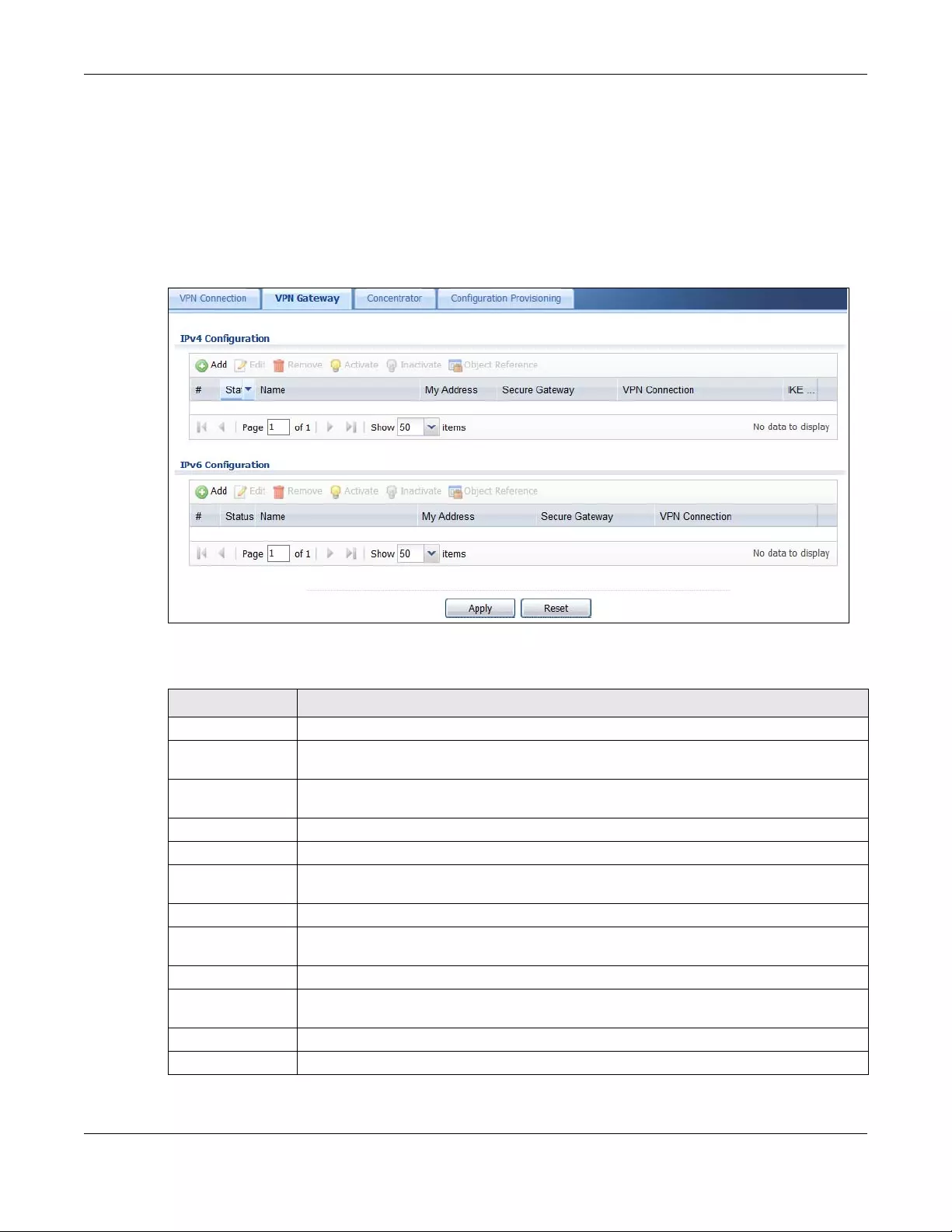
Chapter 22 IPSec VPN
ZyWALL/USG Series User’s Guide
389
22.3 The VPN Gateway Screen
The VPN Gateway summary screen displays the IPSec VPN gateway policies in the ZyWALL/USG,
as well as the ZyWALL/USG’s address, remote IPSec router’s address, and associated VPN
connections for each one. In addition, it also lets you activate and deactivate each VPN gateway. To
access this screen, click Configuration > VPN > Network > IPSec VPN > VPN Gateway. The
following screen appears.
Figure 260 Configuration > VPN > IPSec VPN > VPN Gateway
Each field is discussed in the following table. See Section 22.3.1 on page 390 for more information.
Table 164 Configuration > VPN > IPSec VPN > VPN Gateway
LABEL DESCRIPTION
Add Click this to create a new entry.
Edit Double-click an entry or select it and click Edit to open a screen where you can modify
the entry’s settings.
Remove To remove an entry, select it and click Remove. The ZyWALL/USG confirms you want to
remove it before doing so.
Activate To turn on an entry, select it and click Activate.
Inactivate To turn off an entry, select it and click Inactivate.
Object References Select an entry and click Object References to open a screen that shows which settings
use the entry. See Section 9.3.2 on page 201 for an example.
# This field is a sequential value, and it is not associated with a specific VPN gateway.
Status The activate (light bulb) icon is lit when the entry is active and dimmed when the entry is
inactive.
Name This field displays the name of the VPN gateway
My address This field displays the interface or a domain name the ZyWALL/USG uses for the VPN
gateway.
Secure Gateway This field displays the IP address(es) of the remote IPSec routers.
VPN Connection This field displays VPN connections that use this VPN gateway.

Chapter 22 IPSec VPN
ZyWALL/USG Series User’s Guide
390
22.3.1 The VPN Gateway Add/Edit Screen
The VPN Gateway Add/Edit screen allows you to create a new VPN gateway policy or edit an
existing one. To access this screen, go to the VPN Gateway summary screen (see Section 22.3 on
page 389), and click either the Add icon or an Edit icon.
IKE Version This field displays whether the gateway is using IKEv1 or IKEv2. IKEv1 applies to IPv4
traffic only. IKEv2 applies to both IPv4 and IPv6 traffic. IKE (Internet Key Exchange) is a
protocol used in setting up security associations that allows two parties to send data
securely. See Section 22.1 on page 376 for more information on IKEv1 and IKEv2.
Apply Click Apply to save your changes back to the ZyWALL/USG.
Reset Click Reset to return the screen to its last-saved settings.
Table 164 Configuration > VPN > IPSec VPN > VPN Gateway (continued)
LABEL DESCRIPTION

Chapter 22 IPSec VPN
ZyWALL/USG Series User’s Guide
391
Figure 261 Configuration > VPN > IPSec VPN > VPN Gateway > Add/Edit

Chapter 22 IPSec VPN
ZyWALL/USG Series User’s Guide
392
Each field is described in the following table.
Table 165 Configuration > VPN > IPSec VPN > VPN Gateway > Add/Edit
LABEL DESCRIPTION
Show Advanced
Settings / Hide
Advanced Settings
Click this button to display a greater or lesser number of configuration fields.
Create New Object Use to configure any new settings objects that you need to use in this screen.
General Settings
Enable Select this to activate the VPN Gateway policy.
VPN Gateway
Name Type the name used to identify this VPN gateway. You may use 1-31 alphanumeric
characters, underscores(_), or dashes (-), but the first character cannot be a number.
This value is case-sensitive.
IKE Version
IKEv1 / IKEv2 Select IKEv1 or IKEv2. IKEv1 applies to IPv4 traffic only. IKEv2 applies to both IPv4
and IPv6 traffic. IKE (Internet Key Exchange) is a protocol used in setting up security
associations that allows two parties to send data securely. See Section 22.1 on page
376 for more information on IKEv1 and IKEv2.
Gateway Settings
My Address Select how the IP address of the ZyWALL/USG in the IKE SA is defined.
If you select Interface, select the Ethernet interface, VLAN interface, virtual Ethernet
interface, virtual VLAN interface or PPPoE/PPTP interface. The IP address of the
ZyWALL/USG in the IKE SA is the IP address of the interface.
If you select Domain Name / IP, enter the domain name or the IP address of the
ZyWALL/USG. The IP address of the ZyWALL/USG in the IKE SA is the specified IP
address or the IP address corresponding to the domain name. 0.0.0.0 is not generally
recommended as it has the ZyWALL/USG accept IPSec requests destined for any
interface address on the ZyWALL/USG.
Peer Gateway
Address Select how the IP address of the remote IPSec router in the IKE SA is defined.
Select Static Address to enter the domain name or the IP address of the remote IPSec
router. You can provide a second IP address or domain name for the ZyWALL/USG to try
if it cannot establish an IKE SA with the first one.
Fall back to Primary Peer Gateway when possible: When you select this, if the
connection to the primary address goes down and the ZyWALL/USG changes to
using the secondary connection, the ZyWALL/USG will reconnect to the primary
address when it becomes available again and stop using the secondary connection.
Users will lose their VPN connection briefly while the ZyWALL/USG changes back to
the primary connection. To use this, the peer device at the secondary address
cannot be set to use a nailed-up VPN connection. In the Fallback Check Interval
field, set how often to check if the primary address is available.
Select Dynamic Address if the remote IPSec router has a dynamic IP address (and
does not use DDNS).
Authentication Note: The ZyWALL/USG and remote IPSec router must use the same authentication
method to establish the IKE SA.
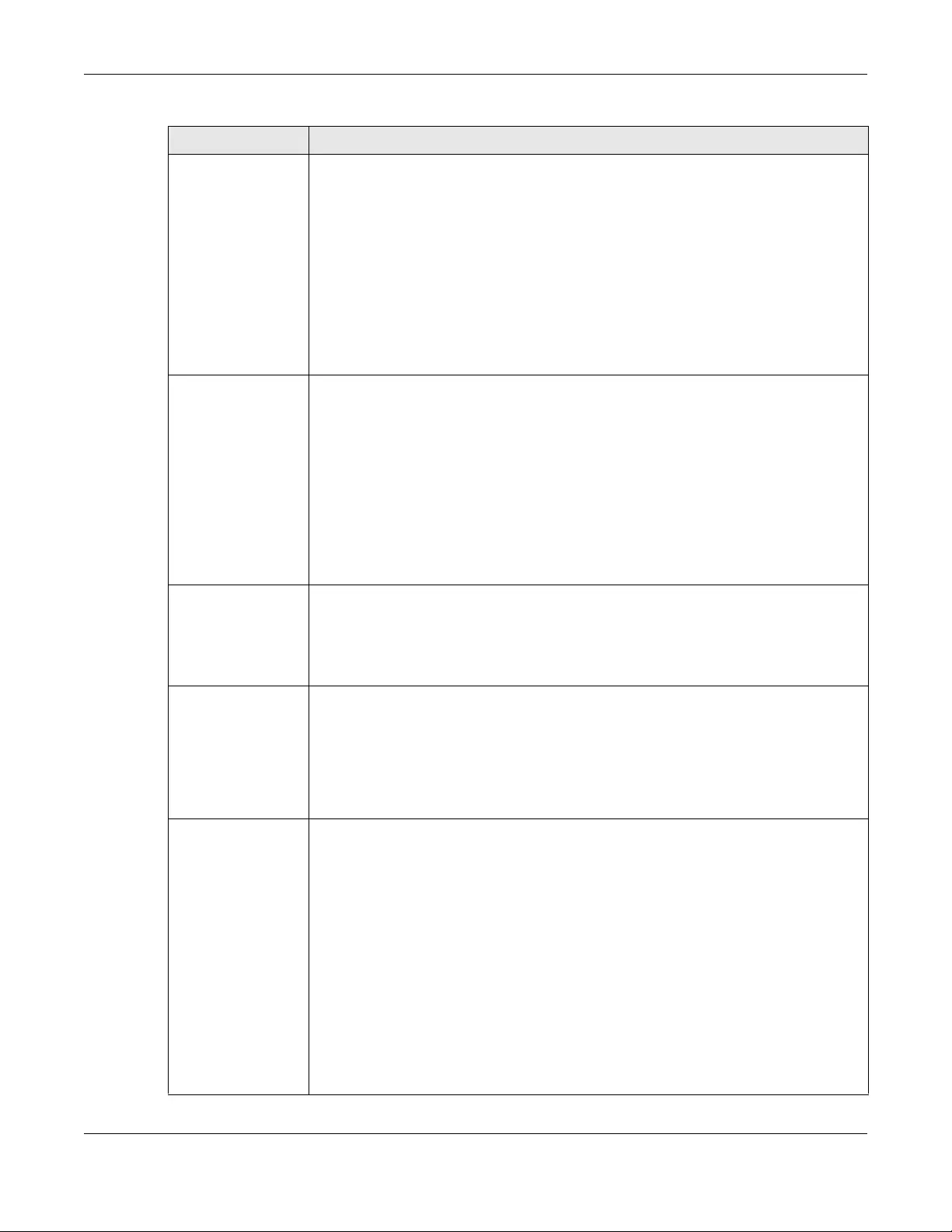
Chapter 22 IPSec VPN
ZyWALL/USG Series User’s Guide
393
Pre-Shared Key Select this to have the ZyWALL/USG and remote IPSec router use a pre-shared key
(password) to identify each other when they negotiate the IKE SA. Type the pre-shared
key in the field to the right. The pre-shared key can be:
• alphanumeric characters or ,;.|`~!@#$%^&*()_+\{}':./<>=-"
• pairs of hexadecimal (0-9, A-F) characters, preceded by “0x”.
Type “0x” at the beginning of a hexadecimal key. For example,
"0x0123456789ABCDEF" is in hexadecimal format; “0123456789ABCDEF” is in ASCII
format. If you use hexadecimal, you must enter twice as many characters since you
need to enter pairs.
The ZyWALL/USG and remote IPSec router must use the same pre-shared key.
Select unmasked to see the pre-shared key in readable plain text.
Certificate Select this to have the ZyWALL/USG and remote IPSec router use certificates to
authenticate each other when they negotiate the IKE SA. Then select the certificate the
ZyWALL/USG uses to identify itself to the remote IPsec router.
This certificate is one of the certificates in My Certificate s. If this certificate is self-
signed, import it into the remote IPsec router. If this certificate is signed by a CA, the
remote IPsec router must trust that CA.
Note: The IPSec routers must trust each other’s certificates.
The ZyWALL/USG uses one of its Trusted Certificates to authenticate the remote
IPSec router’s certificate. The trusted certificate can be a self-signed certificate or that
of a trusted CA that signed the remote IPSec router’s certificate.
User-based PSK User-based PSK (IKEv1 only) generates and manages separate pre-shared keys for
every user. This enables multiple users, each with a unique key, to access the same
VPN gateway policy with one-to-one authentication and strong encryption. Access can
be denied on a per-user basis thus allowing VPN SA user-based policies. Click User-
Based PSK then select a user or group object who is allowed VPN SA access using this
VPN gateway policy. This is for IKEv1 only.
Local ID Type This field is read-only if the ZyWALL/USG and remote IPSec router use certificates to
identify each other. Select which type of identification is used to identify the ZyWALL/
USG during authentication. Choices are:
IPv4 or IPv6 - the ZyWALL/USG is identified by an IP address
DNS - the ZyWALL/USG is identified by a domain name
E-mail - the ZyWALL/USG is identified by the string specified in this field
Content This field is read-only if the ZyWALL/USG and remote IPSec router use certificates to
identify each other. Type the identity of the ZyWALL/USG during authentication. The
identity depends on the Local ID Type.
IP - type an IP address; if you type 0.0.0.0, the ZyWALL/USG uses the IP address
specified in the My Address field. This is not recommended in the following situations:
• There is a NAT router between the ZyWALL/USG and remote IPSec router.
• You want the remote IPSec router to be able to distinguish between IPSec SA
requests that come from IPSec routers with dynamic WAN IP addresses.
In these situations, use a different IP address, or use a different Local ID Type.
DNS - type the fully qualified domain name (FQDN). This value is only used for
identification and can be any string that matches the peer ID string.
E-mail - the ZyWALL/USG is identified by the string you specify here; you can use up
to 63 ASCII characters including spaces, although trailing spaces are truncated. This
value is only used for identification and can be any string.
Table 165 Configuration > VPN > IPSec VPN > VPN Gateway > Add/Edit (continued)
LABEL DESCRIPTION

Chapter 22 IPSec VPN
ZyWALL/USG Series User’s Guide
394
Peer ID Type Select which type of identification is used to identify the remote IPSec router during
authentication. Choices are:
IP - the remote IPSec router is identified by an IP address
DNS - the remote IPSec router is identified by a domain name
E-mail - the remote IPSec router is identified by the string specified in this field
Any - the ZyWALL/USG does not check the identity of the remote IPSec router
If the ZyWALL/USG and remote IPSec router use certificates, there is one more choice.
Subject Name - the remote IPSec router is identified by the subject name in the
certificate
Content This field is disabled if the Peer ID Type is Any. Type the identity of the remote IPSec
router during authentication. The identity depends on the Peer ID Type.
If the ZyWALL/USG and remote IPSec router do not use certificates,
IP - type an IP address; see the note at the end of this description.
DNS - type the fully qualified domain name (FQDN). This value is only used for
identification and can be any string that matches the peer ID string.
E-mail - the remote IPSec router is identified by the string you specify here; you can
use up to 31 ASCII characters including spaces, although trailing spaces are truncated.
This value is only used for identification and can be any string.
If the ZyWALL/USG and remote IPSec router use certificates, type the following fields
from the certificate used by the remote IPSec router.
IP - subject alternative name field; see the note at the end of this description.
DNS - subject alternative name field
E-mail - subject alternative name field
Subject Name - subject name (maximum 255 ASCII characters, including spaces)
Note: If Peer ID Type is IP, please read the rest of this section.
If you type 0.0.0.0, the ZyWALL/USG uses the IP address specified in the Secure
Gateway Address field. This is not recommended in the following situations:
• There is a NAT router between the ZyWALL/USG and remote IPSec router.
• You want the remote IPSec router to be able to distinguish between IPSec SA
requests that come from IPSec routers with dynamic WAN IP addresses.
In these situations, use a different IP address, or use a different Peer ID Type.
Phase 1 Settings
SA Life Time
(Seconds) Type the maximum number of seconds the IKE SA can last. When this time has passed,
the ZyWALL/USG and remote IPSec router have to update the encryption and
authentication keys and re-negotiate the IKE SA. This does not affect any existing
IPSec SAs, however.
Negotiation
Mode Select the negotiation mode to use to negotiate the IKE SA. Choices are
Main - this encrypts the ZyWALL/USG’s and remote IPSec router’s identities but takes
more time to establish the IKE SA
Aggressive - this is faster but does not encrypt the identities
The ZyWALL/USG and the remote IPSec router must use the same negotiation mode.
Proposal Use this section to manage the encryption algorithm and authentication algorithm pairs
the ZyWALL/USG accepts from the remote IPSec router for negotiating the IKE SA.
Table 165 Configuration > VPN > IPSec VPN > VPN Gateway > Add/Edit (continued)
LABEL DESCRIPTION

Chapter 22 IPSec VPN
ZyWALL/USG Series User’s Guide
395
Add Click this to create a new entry.
Edit Select an entry and click this to be able to modify it.
Remove Select an entry and click this to delete it.
# This field is a sequential value, and it is not associated with a specific proposal. The
sequence of proposals should not affect performance significantly.
Encryption Select which key size and encryption algorithm to use in the IKE SA. Choices are:
DES - a 56-bit key with the DES encryption algorithm
3DES - a 168-bit key with the DES encryption algorithm
AES128 - a 128-bit key with the AES encryption algorithm
AES192 - a 192-bit key with the AES encryption algorithm
AES256 - a 256-bit key with the AES encryption algorithm
The ZyWALL/USG and the remote IPSec router must use the same key size and
encryption algorithm. Longer keys require more processing power, resulting in
increased latency and decreased throughput.
Authentication Select which hash algorithm to use to authenticate packet data in the IPSec SA.
Choices are SHA1, SHA256, SHA512 and MD5. SHA is generally considered stronger
than MD5, but it is also slower.
The remote IPSec router must use the same authentication algorithm.
Key Group Select which Diffie-Hellman key group (DHx) you want to use for encryption keys.
Choices are:
DH1 - use a 768-bit random number
DH2 - use a 1024-bit random number
DH5 - use a 1536-bit random number
The longer the key, the more secure the encryption, but also the longer it takes to
encrypt and decrypt information. Both routers must use the same DH key group.
NAT Traversal Select this if any of these conditions are satisfied.
• This IKE SA might be used to negotiate IPSec SAs that use ESP as the active
protocol.
• There are one or more NAT routers between the ZyWALL/USG and remote IPSec
router, and these routers do not support IPSec pass-thru or a similar feature.
The remote IPSec router must also enable NAT traversal, and the NAT routers have to
forward packets with UDP port 500 and UDP 4500 headers unchanged.
This field applies for IKEv1 only. NAT Traversal is always performed when you use
IKEv2.
Dead Peer
Detection (DPD) Select this check box if you want the ZyWALL/USG to make sure the remote IPSec
router is there before it transmits data through the IKE SA. The remote IPSec router
must support DPD. If there has been no traffic for at least 15 seconds, the ZyWALL/
USG sends a message to the remote IPSec router. If the remote IPSec router responds,
the ZyWALL/USG transmits the data. If the remote IPSec router does not respond, the
ZyWALL/USG shuts down the IKE SA.
If the remote IPSec router does not support DPD, see if you can use the VPN connection
connectivity check (see Section 22.2.1 on page 382).
This field applies for IKEv1 only. Dead Peer Detection (DPD) is always performed when
you use IKEv2.
Table 165 Configuration > VPN > IPSec VPN > VPN Gateway > Add/Edit (continued)
LABEL DESCRIPTION

Chapter 22 IPSec VPN
ZyWALL/USG Series User’s Guide
396
X Auth / Extended
Authentication
Protocol
This part of the screen displays X-Auth when using IKEv1 and Extended
Authentication Protocol when using IKEv2.
X-Auth This displays when using IKEv1. When different users use the same VPN tunnel to
connect to the ZyWALL/USG (telecommuters sharing a tunnel for example), use X-auth
to enforce a user name and password check. This way even though telecommuters all
know the VPN tunnel’s security settings, each still has to provide a unique user name
and password.
Enable Extended
Authentication Select this if one of the routers (the ZyWALL/USG or the remote IPSec router) verifies a
user name and password from the other router using the local user database and/or an
external server.
Server Mode Select this if the ZyWALL/USG authenticates the user name and password from the
remote IPSec router. You also have to select the authentication method, which specifies
how the ZyWALL/USG authenticates this information.
Client Mode Select this radio button if the ZyWALL/USG provides a username and password to the
remote IPSec router for authentication. You also have to provide the User Name and
the Password.
User Name This field is required if the ZyWALL/USG is in Client Mode for extended authentication.
Type the user name the ZyWALL/USG sends to the remote IPSec router. The user name
can be 1-31 ASCII characters. It is case-sensitive, but spaces are not allowed.
Password This field is required if the ZyWALL/USG is in Client Mode for extended authentication.
Type the password the ZyWALL/USG sends to the remote IPSec router. The password
can be 1-31 ASCII characters. It is case-sensitive, but spaces are not allowed.
Retype to
Confirm Type the exact same password again here to make sure an error was not made when
typing it originally.
Extended
Authentication
Protocol
This displays when using IKEv2. EAP uses a certificate for authentication.
Enable Extended
Authentication Select this if one of the routers (the ZyWALL/USG or the remote IPSec router) verifies a
user name and password from the other router using the local user database and/or an
external server or a certificate.
Server Mode Select this if the ZyWALL/USG authenticates the user name and password from the
remote IPSec router. You also have to select an AAA method, which specifies how the
ZyWALL/USG authenticates this information and who may be authenticated (Allowed
User).
Client Mode Select this radio button if the ZyWALL/USG provides a username and password to the
remote IPSec router for authentication. You also have to provide the User Name and
the Password.
User Name This field is required if the ZyWALL/USG is in Client Mode for extended authentication.
Type the user name the ZyWALL/USG sends to the remote IPSec router. The user name
can be 1-31 ASCII characters. It is case-sensitive, but spaces are not allowed.
Password This field is required if the ZyWALL/USG is in Client Mode for extended authentication.
Type the password the ZyWALL/USG sends to the remote IPSec router. The password
can be 1-31 ASCII characters. It is case-sensitive, but spaces are not allowed.
Retype to
Confirm Type the exact same password again here to make sure an error was not made when
typing it originally.
OK Click OK to save your settings and exit this screen.
Cancel Click Cancel to exit this screen without saving.
Table 165 Configuration > VPN > IPSec VPN > VPN Gateway > Add/Edit (continued)
LABEL DESCRIPTION

Chapter 22 IPSec VPN
ZyWALL/USG Series User’s Guide
397
22.4 VPN Concentrator
A VPN concentrator combines several IPSec VPN connections into one secure network.
Figure 262 VPN Topologies (Fully Meshed and Hub and Spoke)
In a fully-meshed VPN topology (1 in the figure), there is a VPN connection between every pair of
routers. In a hub-and-spoke VPN topology (2 in the figure), there is a VPN connection between
each spoke router (B, C, D, and E) and the hub router (A), which uses the VPN concentrator. The
VPN concentrator routes VPN traffic between the spoke routers and itself.
A VPN concentrator reduces the number of VPN connections that you have to set up and maintain in
the network. You might also be able to consolidate the policy routes in each spoke router,
depending on the IP addresses and subnets of each spoke.
However a VPN concentrator is not for every situation. The hub router is a single failure point, so a
VPN concentrator is not as appropriate if the connection between spoke routers cannot be down
occasionally (maintenance, for example). There is also more burden on the hub router. It receives
VPN traffic from one spoke, decrypts it, inspects it to find out to which spoke to route it, encrypts it,
and sends it to the appropriate spoke. Therefore, a VPN concentrator is more suitable when there is
a minimum amount of traffic between spoke routers.
22.4.1 VPN Concentrator Requirements and Suggestions
Consider the following when using the VPN concentrator.
• The local IP addresses configured in the VPN rules should not overlap.
• The concentrator must have at least one separate VPN rule for each spoke. In the local policy,
specify the IP addresses of the networks with which the spoke is to be able to have a VPN tunnel.
This may require you to use more than one VPN rule for each spoke.
• To have all Internet access from the spoke routers go through the VPN tunnel, set the VPN rules
in the spoke routers to use 0.0.0.0 (any) as the remote IP address.
• Your security policies can still block VPN packets.
12

Chapter 22 IPSec VPN
ZyWALL/USG Series User’s Guide
398
22.4.2 VPN Concentrator Screen
The VPN Concentrator summary screen displays the VPN concentrators in the ZyWALL/USG. To
access this screen, click Configuration > VPN > IPSec VPN > Concentrator.
Figure 263 Configuration > VPN > IPSec VPN > Concentrator
Each field is discussed in the following table. See Section 22.4.3 on page 398 for more information.
22.4.3 The VPN Concentrator Add/Edit Screen
Use the VPN Concentrator Add/Edit screen to create or edit a VPN concentrator. To access this
screen, go to the VPN Concentrator summary screen (see Section 22.4 on page 397), and click
either the Add icon or an Edit icon.
Table 166 Configuration > VPN > IPSec VPN > Concentrator
LABEL DESCRIPTION
IPv4/IPv6
Configuration
Choose to configure for IPv4 or IPv6 traffic.
Add Click this to create a new entry.
Edit Select an entry and click this to be able to modify it.
Remove Select an entry and click this to delete it.
# This field is a sequential value, and it is not associated with a specific concentrator.
Name This field displays the name of the VPN concentrator.
Group Members These are the VPN connection policies that are part of the VPN concentrator.
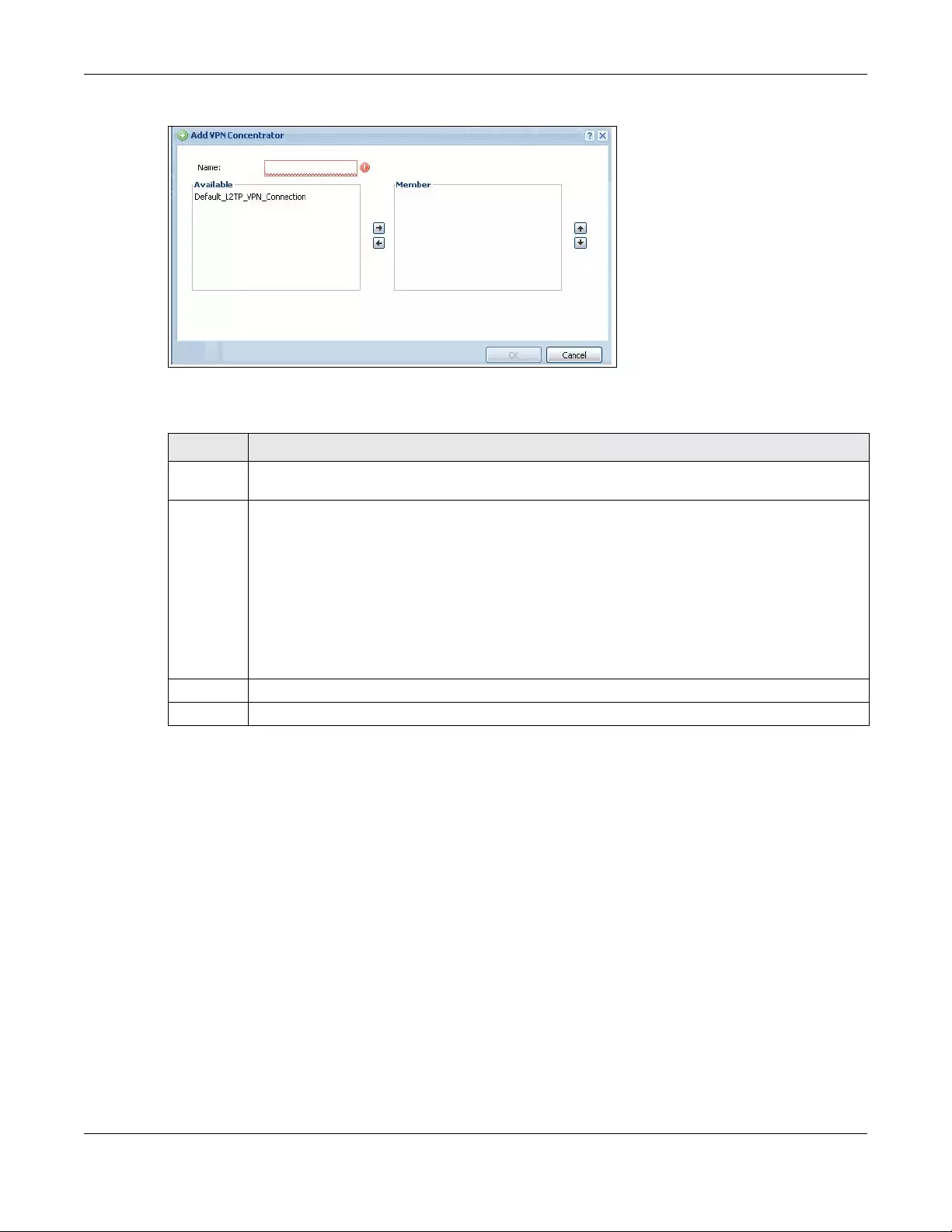
Chapter 22 IPSec VPN
ZyWALL/USG Series User’s Guide
399
Figure 264 Configuration > VPN > IPSec VPN > Concentrator > Add/Edit
Each field is described in the following table.
22.5 ZyWALL/USG IPSec VPN Client Configuration
Provisioning
Use the Configuration > VPN > IPSec VPN > Configuration Provisioning screen to configure
who can retrieve VPN rule settings from the ZyWALL/USG using the ZyWALL/USG IPSec VPN Client.
In the ZyWALL/USG IPSec VPN Client, you just need to enter the IP address of the ZyWALL/USG to
get all the VPN rule settings automatically. You do not need to manually configure all rule settings in
the ZyWALL/USG IPSec VPN client.
VPN rules for the ZyWALL/USG IPSec VPN Client have certain restrictions. They must not contain
the following settings:
•AH active protocol
•NULL encryption
•SHA512 authentication
Table 167 VPN > IPSec VPN > Concentrator > Add/Edit
LABEL DESCRIPTION
Name Enter the name of the concentrator. You may use 1-31 alphanumeric characters, underscores(_),
or dashes (-), but the first character cannot be a number. This value is case-sensitive.
Member Select the concentrator’s IPSec VPN connection policies.
Note: You must disable policy enforcement in each member. See Section 22.2.1 on page 382.
IPSec VPN connection policies that do not belong to a VPN concentrator appear under Available.
Select any VPN connection policies that you want to add to the VPN concentrator and click the
right arrow button to add them.
The VPN concentrator’s member VPN connections appear under Member. Select any VPN
connections that you want to remove from the VPN concentrator, and click the left arrow button
to remove them.
OK Click OK to save your changes in the ZyWALL/USG.
Cancel Click Cancel to exit this screen without saving.
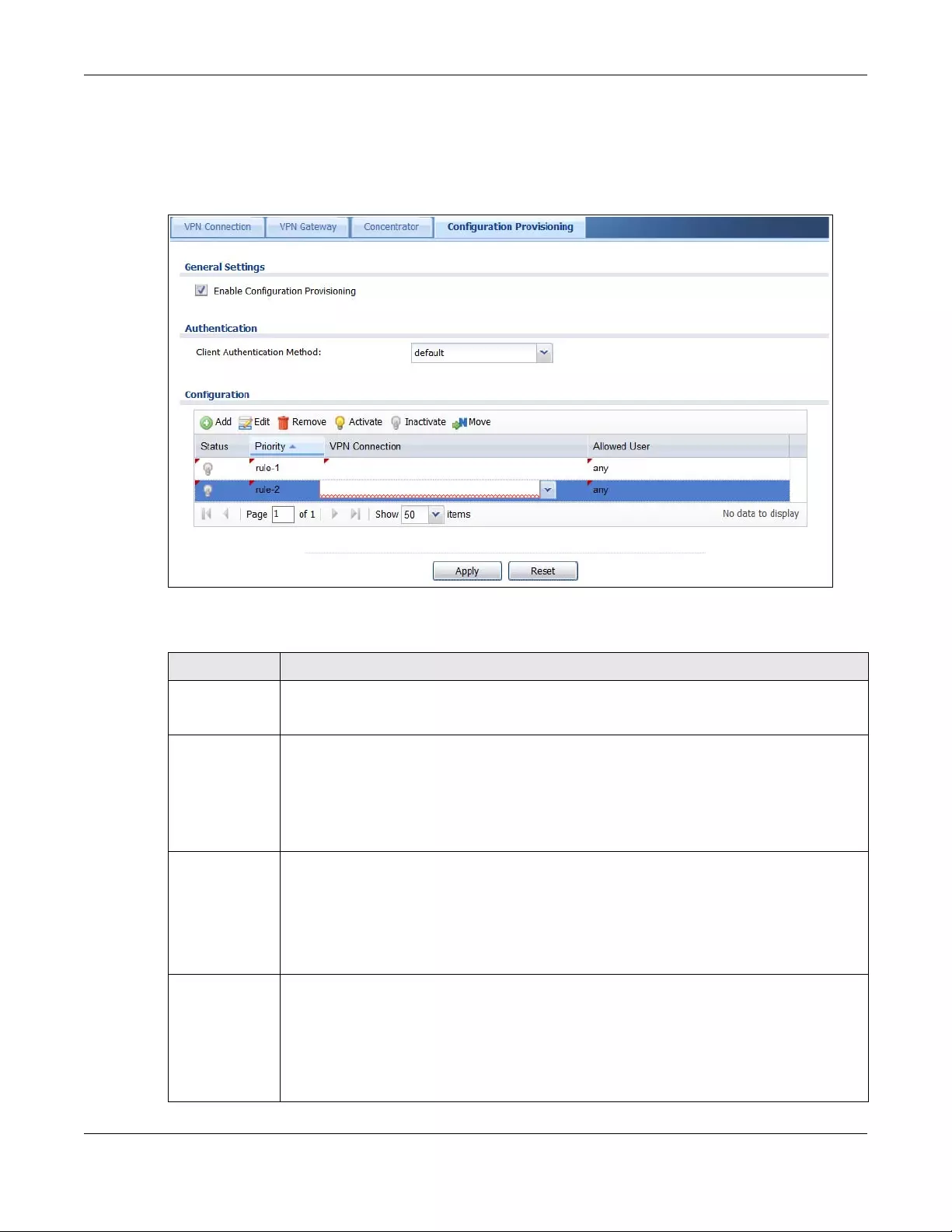
Chapter 22 IPSec VPN
ZyWALL/USG Series User’s Guide
400
• A subnet or range remote policy
In the ZyWALL/USG Quick Setup wizard, you can use the VPN Settings for Configuration
Provisioning wizard to create a VPN rule that will not violate these restrictions.
Figure 265 Configuration > VPN > IPSec VPN > Configuration Provisioning
Each field is discussed in the following table.
Table 168 Configuration > VPN > IPSec VPN > Configuration Provisioning
LABEL DESCRIPTION
Enable
Configuration
Provisioning
Select this for users to be able to retrieve VPN rule settings using the ZyWALL/USG IPSec
VPN client.
Client
Authentication
Method
Choose how users should be authenticated. They can be authenticated using the local
database on the ZyWALL/USG or an external authentication database such as LDAP, Active
Directory or RADIUS. default is a method you configured in Object > Auth Method. You
may configure multiple methods there. If you choose the local database on the ZyWALL/
USG, then configure users using the Object > User/Group screen. If you choose LDAP,
Active Directory or RADIUS authentication servers, then configure users on the respective
server.
Configuration When you add or edit a configuration provisioning entry, you are allowed to set the VPN
Connection and Allowed User fields.
Duplicate entries are not allowed. You cannot select the same VPN Co nn ection and
Allowed User pair in a new entry if the same pair exists in a previous entry.
You can bind different rules to the same user, but the ZyWALL/USG will only allow VPN rule
setting retrieval for the first match found.
Add Click Add to bind a configured VPN rule to a user or group. Only that user or group may
then retrieve the specified VPN rule settings.
If you click Add without selecting an entry in advance then the new entry appears as the
first entry. Entry order is important as the ZyWALL/USG searches entries in the order listed
here to find a match. After a match is found, the ZyWALL/USG stops searching. If you want
to add an entry as number three for example, then first select entry 2 and click Add. To
reorder an entry, use Move.

Chapter 22 IPSec VPN
ZyWALL/USG Series User’s Guide
401
22.6 IPSec VPN Background Information
Here is some more detailed IPSec VPN background information.
IKE SA Overview
The IKE SA provides a secure connection between the ZyWALL/USG and remote IPSec router.
It takes several steps to establish an IKE SA. The negotiation mode determines how many. There
are two negotiation modes--main mode and aggressive mode. Main mode provides better security,
while aggressive mode is faster.
Note: Both routers must use the same negotiation mode.
These modes are discussed in more detail in Negotiation Mode on page 405. Main mode is used in
various examples in the rest of this section.
The ZyWALL/USG supports IKEv1 and IKEv2. See Section 22.1 on page 376 for more information.
Edit Select an existing entry and click Edit to change its settings.
Remove To remove an entry, select it and click Remove. The ZyWALL/USG confirms you want to
remove it before doing so.
Activate To turn on an entry, select it and click Activate. Make sure that Enable Configuration
Provisioning is also selected.
Inactivate To turn off an entry, select it and click Inactivate.
Move Use Move to reorder a selected entry. Select an entry, click Move, type the number where
the entry should be moved, press <ENTER>, then click Apply.
Status This icon shows if the entry is active (yellow) or not (gray). VPN rule settings can only be
retrieved when the entry is activated (and Enable Configuration Provisioning is also
selected).
Priority Priority shows the order of the entry in the list. Entry order is important as the ZyWALL/USG
searches entries in the order listed here to find a match. After a match is found the ZyWALL/
USG stops searching.
VPN Connection This field shows all configured VPN rules that match the rule criteria for the ZyWALL/USG
IPSec VPN client. Select a rule to bind to the associated user or group.
Allowed User Select which user or group of users is allowed to retrieve the associated VPN rule settings
using the ZyWALL/USG IPSec VPN client. A user may belong to a number of groups. If
entries are configured for different groups, the ZyWALL/USG will allow VPN rule setting
retrieval based on the first match found.
Users of type admin or limited-admin are not allowed.
Apply Click Apply to save your changes back to the ZyWALL/USG.
Reset Click Reset to return the screen to its last-saved settings.
Table 168 Configuration > VPN > IPSec VPN > Configuration Provisioning (continued)
LABEL DESCRIPTION

Chapter 22 IPSec VPN
ZyWALL/USG Series User’s Guide
402
IP Addresses of the ZyWALL/USG and Remote IPSec Router
To set up an IKE SA, you have to specify the IP addresses of the ZyWALL/USG and remote IPSec
router. You can usually enter a static IP address or a domain name for either or both IP addresses.
Sometimes, your ZyWALL/USG might offer another alternative, such as using the IP address of a
port or interface, as well.
You can also specify the IP address of the remote IPSec router as 0.0.0.0. This means that the
remote IPSec router can have any IP address. In this case, only the remote IPSec router can initiate
an IKE SA because the ZyWALL/USG does not know the IP address of the remote IPSec router. This
is often used for telecommuters.
IKE SA Proposal
The IKE SA proposal is used to identify the encryption algorithm, authentication algorithm, and
Diffie-Hellman (DH) key group that the ZyWALL/USG and remote IPSec router use in the IKE SA. In
main mode, this is done in steps 1 and 2, as illustrated next.
Figure 266 IKE SA: Main Negotiation Mode, Steps 1 - 2: IKE SA Proposal
The ZyWALL/USG sends one or more proposals to the remote IPSec router. (In some devices, you
can only set up one proposal.) Each proposal consists of an encryption algorithm, authentication
algorithm, and DH key group that the ZyWALL/USG wants to use in the IKE SA. The remote IPSec
router selects an acceptable proposal and sends the accepted proposal back to the ZyWALL/USG. If
the remote IPSec router rejects all of the proposals, the ZyWALL/USG and remote IPSec router
cannot establish an IKE SA.
Note: Both routers must use the same encryption algorithm, authentication algorithm,
and DH key group.
In most ZyWALL/USGs, you can select one of the following encryption algorithms for each proposal.
The algorithms are listed in order from weakest to strongest.
• Data Encryption Standard (DES) is a widely used method of data encryption. It applies a 56-bit
key to each 64-bit block of data.
• Triple DES (3DES) is a variant of DES. It iterates three times with three separate keys, effectively
tripling the strength of DES.
• Advanced Encryption Standard (AES) is a newer method of data encryption that also uses a
secret key. AES applies a 128-bit key to 128-bit blocks of data. It is faster than 3DES.
One or more proposals, each one consisting of:
- encryption algorithm
- authentication algorithm
- Diffie-Hellman key group
1
2
XY

Chapter 22 IPSec VPN
ZyWALL/USG Series User’s Guide
403
Some ZyWALL/USGs also offer stronger forms of AES that apply 192-bit or 256-bit keys to 128-bit
blocks of data.
In most ZyWALL/USGs, you can select one of the following authentication algorithms for each
proposal. The algorithms are listed in order from weakest to strongest.
• MD5 (Message Digest 5) produces a 128-bit digest to authenticate packet data.
• SHA1 (Secure Hash Algorithm) produces a 160-bit digest to authenticate packet data.
• SHA256 (Secure Hash Algorithm) produces a 256-bit digest to authenticate packet data.
• SHA512 (Secure Hash Algorithm) produces a 512-bit digest to authenticate packet data.
See Diffie-Hellman (DH) Key Exchange on page 403 for more information about DH key groups.
Diffie-Hellman (DH) Key Exchange
The ZyWALL/USG and the remote IPSec router use DH public-key cryptography to establish a
shared secret. The shared secret is then used to generate encryption keys for the IKE SA and IPSec
SA. In main mode, this is done in steps 3 and 4, as illustrated next.
Figure 267 IKE SA: Main Negotiation Mode, Steps 3 - 4: DH Key Exchange
DH public-key cryptography is based on DH key groups. Each key group is a fixed number of bits
long. The longer the key, the more secure the encryption, but also the longer it takes to encrypt
and decrypt information. For example, DH2 keys (1024 bits) are more secure than DH1 keys (768
bits), but DH2 keys take longer to encrypt and decrypt.
Authentication
Before the ZyWALL/USG and remote IPSec router establish an IKE SA, they have to verify each
other’s identity. This process is based on pre-shared keys and router identities.
In main mode, the ZyWALL/USG and remote IPSec router authenticate each other in steps 5 and 6,
as illustrated below. The identities are also encrypted using the encryption algorithm and
encryption key the ZyWALL/USG and remote IPSec router selected in previous steps.
Diffie-Hellman key exchange
3
4
XY

Chapter 22 IPSec VPN
ZyWALL/USG Series User’s Guide
404
Figure 268 IKE SA: Main Negotiation Mode, Steps 5 - 6: Authentication (continued)
You have to create (and distribute) a pre-shared key. The ZyWALL/USG and remote IPSec router
use it in the authentication process, though it is not actually transmitted or exchanged.
Note: The ZyWALL/USG and the remote IPSec router must use the same pre-shared key.
Router identity consists of ID type and content. The ID type can be domain name, IP address, or e-
mail address, and the content is a (properly-formatted) domain name, IP address, or e-mail
address. The content is only used for identification. Any domain name or e-mail address that you
enter does not have to actually exist. Similarly, any domain name or IP address that you enter does
not have to correspond to the ZyWALL/USG’s or remote IPSec router’s properties.
The ZyWALL/USG and the remote IPSec router have their own identities, so both of them must
store two sets of information, one for themselves and one for the other router. Local ID type and
content refers to the ID type and content that applies to the router itself, and peer ID type and
content refers to the ID type and content that applies to the other router.
Note: The ZyWALL/USG’s local and peer ID type and content must match the remote
IPSec router’s peer and local ID type and content, respectively.
For example, in Table 169 on page 404, the ZyWALL/USG and the remote IPSec router authenticate
each other successfully. In contrast, in Table 170 on page 405, the ZyWALL/USG and the remote
IPSec router cannot authenticate each other and, therefore, cannot establish an IKE SA.
Step 5:
pre-shared key
ZyWALL/USG identity, consisting of
- ID type
- content
Step 6:
pre-shared key
Remote IPSec router identity, consisting of
- ID type
- content
Table 169 VPN Example: Matching ID Type and Content
ZYWALL/USG REMOTE IPSEC ROUTER
Local ID type: E-mail Local ID type: IP
Local ID content: tom@yourcompany.com Local ID content: 1.1.1.2
Peer ID type: IP Peer ID type: E-mail
Peer ID content: 1.1.1.2 Peer ID content: tom@yourcompany.com
5
6
XY

Chapter 22 IPSec VPN
ZyWALL/USG Series User’s Guide
405
It is also possible to configure the ZyWALL/USG to ignore the identity of the remote IPSec router. In
this case, you usually set the peer ID type to Any. This is less secure, so you should only use this if
your ZyWALL/USG provides another way to check the identity of the remote IPSec router (for
example, extended authentication) or if you are troubleshooting a VPN tunnel.
Additional Topics for IKE SA
This section provides more information about IKE SA.
Negotiation Mode
There are two negotiation modes--main mode and aggressive mode. Main mode provides better
security, while aggressive mode is faster.
Main mode takes six steps to establish an IKE SA.
Steps 1 - 2: The ZyWALL/USG sends its proposals to the remote IPSec router. The remote IPSec
router selects an acceptable proposal and sends it back to the ZyWALL/USG.
Steps 3 - 4: The ZyWALL/USG and the remote IPSec router exchange pre-shared keys for
authentication and participate in a Diffie-Hellman key exchange, based on the accepted DH key
group, to establish a shared secret.
Steps 5 - 6: Finally, the ZyWALL/USG and the remote IPSec router generate an encryption key
(from the shared secret), encrypt their identities, and exchange their encrypted identity
information for authentication.
In contrast, aggressive mode only takes three steps to establish an IKE SA. Aggressive mode does
not provide as much security because the identity of the ZyWALL/USG and the identity of the
remote IPSec router are not encrypted. It is usually used in remote-access situations, where the
address of the initiator is not known by the responder and both parties want to use pre-shared keys
for authentication. For example, the remote IPSec router may be a telecommuter who does not
have a static IP address.
VPN, NAT, and NAT Traversal
In the following example, there is another router (A) between router X and router Y.
Figure 269 VPN/NAT Example
If router A does NAT, it might change the IP addresses, port numbers, or both. If router X and
router Y try to establish a VPN tunnel, the authentication fails because it depends on this
information. The routers cannot establish a VPN tunnel.
Table 170 VPN Example: Mismatching ID Type and Content
ZYWALL/USG REMOTE IPSEC ROUTER
Local ID type: E-mail Local ID type: IP
Local ID content: tom@yourcompany.com Local ID content: 1.1.1.2
Peer ID type: IP Peer ID type: E-mail
Peer ID content: 1.1.1.20 Peer ID content: tom@yourcompany.com

Chapter 22 IPSec VPN
ZyWALL/USG Series User’s Guide
406
Most routers like router A now have an IPSec pass-thru feature. This feature helps router A
recognize VPN packets and route them appropriately. If router A has this feature, router X and
router Y can establish a VPN tunnel as long as the active protocol is ESP. (See Active Protocol on
page 407 for more information about active protocols.)
If router A does not have an IPSec pass-thru or if the active protocol is AH, you can solve this
problem by enabling NAT traversal. In NAT traversal, router X and router Y add an extra header to
the IKE SA and IPSec SA packets. If you configure router A to forward these packets unchanged,
router X and router Y can establish a VPN tunnel.
You have to do the following things to set up NAT traversal.
• Enable NAT traversal on the ZyWALL/USG and remote IPSec router.
• Configure the NAT router to forward packets with the extra header unchanged. (See the field
description for detailed information about the extra header.)
The extra header may be UDP port 500 or UDP port 4500, depending on the standard(s) the
ZyWALL/USG and remote IPSec router support.
X-Auth / Extended Authentication
X-Auth / Extended authentication is often used when multiple IPSec routers use the same VPN
tunnel to connect to a single IPSec router. For example, this might be used with telecommuters.
In extended authentication, one of the routers (the ZyWALL/USG or the remote IPSec router)
provides a user name and password to the other router, which uses a local user database and/or an
external server to verify the user name and password. If the user name or password is wrong, the
routers do not establish an IKE SA.
You can set up the ZyWALL/USG to provide a user name and password to the remote IPSec router,
or you can set up the ZyWALL/USG to check a user name and password that is provided by the
remote IPSec router.
If you use extended authentication, it takes four more steps to establish an IKE SA. These steps
occur at the end, regardless of the negotiation mode (steps 7-10 in main mode, steps 4-7 in
aggressive mode).
Certificates
It is possible for the ZyWALL/USG and remote IPSec router to authenticate each other with
certificates. In this case, you do not have to set up the pre-shared key, local identity, or remote
identity because the certificates provide this information instead.
A
XY

Chapter 22 IPSec VPN
ZyWALL/USG Series User’s Guide
407
• Instead of using the pre-shared key, the ZyWALL/USG and remote IPSec router check the
signatures on each other’s certificates. Unlike pre-shared keys, the signatures do not have to
match.
• The local and peer ID type and content come from the certificates.
Note: You must set up the certificates for the ZyWALL/USG and remote IPSec router first.
IPSec SA Overview
Once the ZyWALL/USG and remote IPSec router have established the IKE SA, they can securely
negotiate an IPSec SA through which to send data between computers on the networks.
Note: The IPSec SA stays connected even if the underlying IKE SA is not available
anymore.
This section introduces the key components of an IPSec SA.
Local Network and Remote Network
In an IPSec SA, the local network, the one(s) connected to the ZyWALL/USG, may be called the
local policy. Similarly, the remote network, the one(s) connected to the remote IPSec router, may
be called the remote policy.
Active Protocol
The active protocol controls the format of each packet. It also specifies how much of each packet is
protected by the encryption and authentication algorithms. IPSec VPN includes two active
protocols, AH (Authentication Header, RFC 2402) and ESP (Encapsulating Security Payload, RFC
2406).
Note: The ZyWALL/USG and remote IPSec router must use the same active protocol.
Usually, you should select ESP. AH does not support encryption, and ESP is more suitable with NAT.
Encapsulation
There are two ways to encapsulate packets. Usually, you should use tunnel mode because it is more
secure. Transport mode is only used when the IPSec SA is used for communication between the
ZyWALL/USG and remote IPSec router (for example, for remote management), not between
computers on the local and remote networks.
Note: The ZyWALL/USG and remote IPSec router must use the same encapsulation.
These modes are illustrated below.
Figure 270 VPN: Transport and Tunnel Mode Encapsulation
Original Packet IP Header TCP
Header
Data
Transport Mode Packet IP Header AH/ESP
Header
TCP
Header
Data

Chapter 22 IPSec VPN
ZyWALL/USG Series User’s Guide
408
In tunnel mode, the ZyWALL/USG uses the active protocol to encapsulate the entire IP packet. As a
result, there are two IP headers:
• Outside header: The outside IP header contains the IP address of the ZyWALL/USG or remote
IPSec router, whichever is the destination.
• Inside header: The inside IP header contains the IP address of the computer behind the ZyWALL/
USG or remote IPSec router. The header for the active protocol (AH or ESP) appears between the
IP headers.
In transport mode, the encapsulation depends on the active protocol. With AH, the ZyWALL/USG
includes part of the original IP header when it encapsulates the packet. With ESP, however, the
ZyWALL/USG does not include the IP header when it encapsulates the packet, so it is not possible
to verify the integrity of the source IP address.
IPSec SA Proposal and Perfect Forward Secrecy
An IPSec SA proposal is similar to an IKE SA proposal (see IKE SA Proposal on page 402), except
that you also have the choice whether or not the ZyWALL/USG and remote IPSec router perform a
new DH key exchange every time an IPSec SA is established. This is called Perfect Forward Secrecy
(PFS).
If you enable PFS, the ZyWALL/USG and remote IPSec router perform a DH key exchange every
time an IPSec SA is established, changing the root key from which encryption keys are generated.
As a result, if one encryption key is compromised, other encryption keys remain secure.
If you do not enable PFS, the ZyWALL/USG and remote IPSec router use the same root key that
was generated when the IKE SA was established to generate encryption keys.
The DH key exchange is time-consuming and may be unnecessary for data that does not require
such security.
PFS is ignored in initial IKEv2 authentication but is used when reauthenticating.
Additional Topics for IPSec SA
This section provides more information about IPSec SA in your ZyWALL/USG.
Authentication and the Security Parameter Index (SPI)
For authentication, the ZyWALL/USG and remote IPSec router use the SPI, instead of pre-shared
keys, ID type and content. The SPI is an identification number.
Note: The ZyWALL/USG and remote IPSec router must use the same SPI.
NAT for Inbound and Outbound Traffic
The ZyWALL/USG can translate the following types of network addresses in IPSec SA.
Tunnel Mode Packet IP Header AH/ESP
Header
IP Header TCP
Header
Data
Figure 270 VPN: Transport and Tunnel Mode Encapsulation
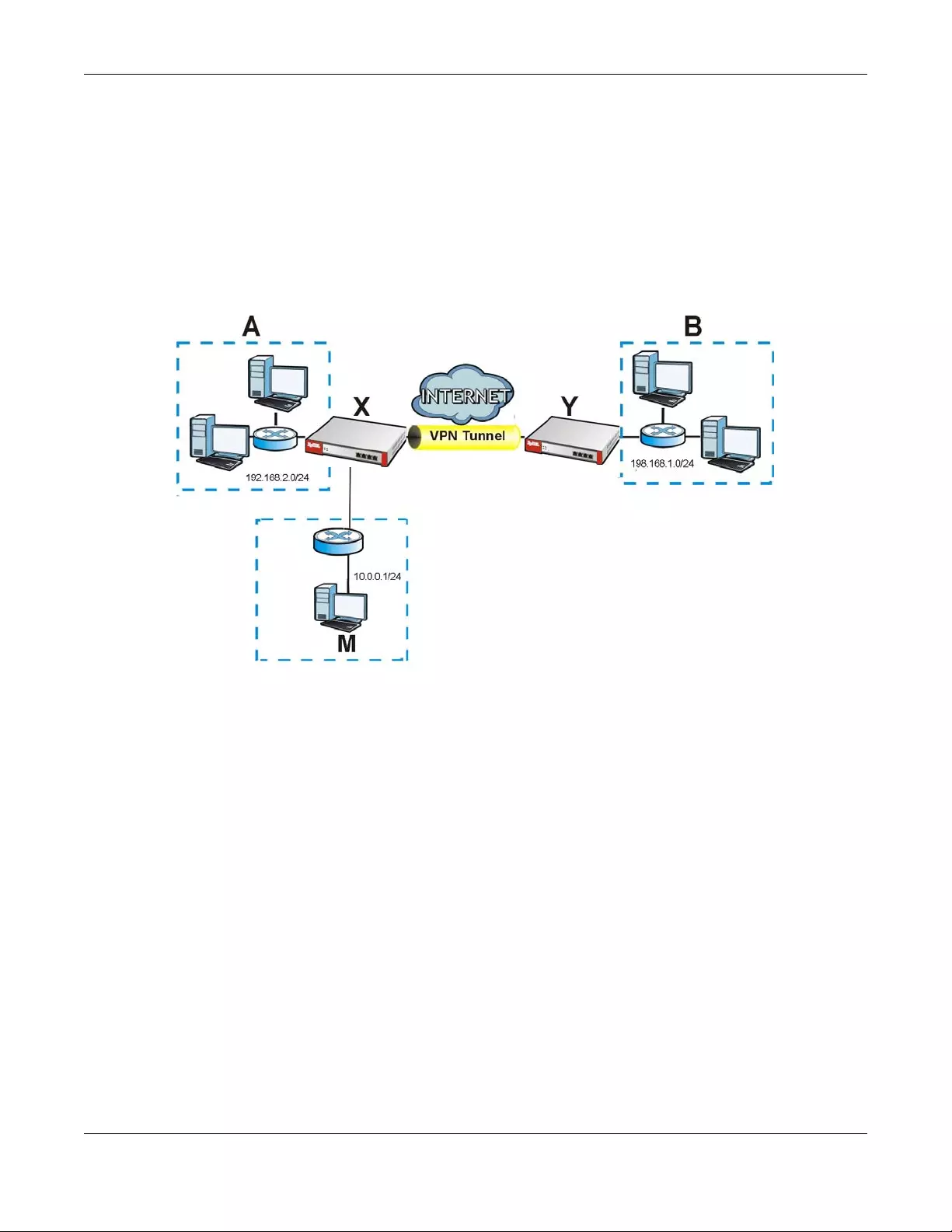
Chapter 22 IPSec VPN
ZyWALL/USG Series User’s Guide
409
• Source address in outbound packets - this translation is necessary if you want the ZyWALL/USG
to route packets from computers outside the local network through the IPSec SA.
• Source address in inbound packets - this translation hides the source address of computers in the
remote network.
• Destination address in inbound packets - this translation is used if you want to forward packets
(for example, mail) from the remote network to a specific computer (like the mail server) in the
local network.
Each kind of translation is explained below. The following example is used to help explain each one.
Figure 271 VPN Example: NAT for Inbound and Outbound Traffic
Source Address in Outbound Packets (Outbound Traffic, Source NAT)
This translation lets the ZyWALL/USG route packets from computers that are not part of the
specified local network (local policy) through the IPSec SA. For example, in Figure 271 on page
409, you have to configure this kind of translation if you want computer M to establish a connection
with any computer in the remote network (B). If you do not configure it, the remote IPSec router
may not route messages for computer M through the IPSec SA because computer M’s IP address is
not part of its local policy.
To set up this NAT, you have to specify the following information:
• Source - the original source address; most likely, computer M’s network.
• Destination - the original destination address; the remote network (B).
• SNAT - the translated source address; the local network (A).
Source Address in Inbound Packets (Inbound Traffic, Source NAT)
You can set up this translation if you want to change the source address of computers in the remote
network. To set up this NAT, you have to specify the following information:
• Source - the original source address; the remote network (B).

Chapter 22 IPSec VPN
ZyWALL/USG Series User’s Guide
410
• Destination - the original destination address; the local network (A).
• SNAT - the translated source address; a different IP address (range of addresses) to hide the
original source address.
Destination Address in Inbound Packets (Inbound Traffic, Destination NAT)
You can set up this translation if you want the ZyWALL/USG to forward some packets from the
remote network to a specific computer in the local network. For example, in Figure 271 on page
409, you can configure this kind of translation if you want to forward mail from the remote network
to the mail server in the local network (A).
You have to specify one or more rules when you set up this kind of NAT. The ZyWALL/USG checks
these rules similar to the way it checks rules for a security policy. The first part of these rules define
the conditions in which the rule apply.
• Original IP - the original destination address; the remote network (B).
• Protocol - the protocol [TCP, UDP, or both] used by the service requesting the connection.
• Original Port - the original destination port or range of destination ports; in Figure 271 on page
409, it might be port 25 for SMTP.
The second part of these rules controls the translation when the condition is satisfied.
• Mapped IP - the translated destination address; in Figure 271 on page 409, the IP address of the
mail server in the local network (A).
• Mapped Port - the translated destination port or range of destination ports.
The original port range and the mapped port range must be the same size.
IPSec VPN Example Scenario
Here is an example site-to-site IPSec VPN scenario.
Figure 272 Site-to-site IPSec VPN Example
192.168.1.0/24 172.16.1.0/24
1.2.3.4 2.2.2.2
LAN
LAN
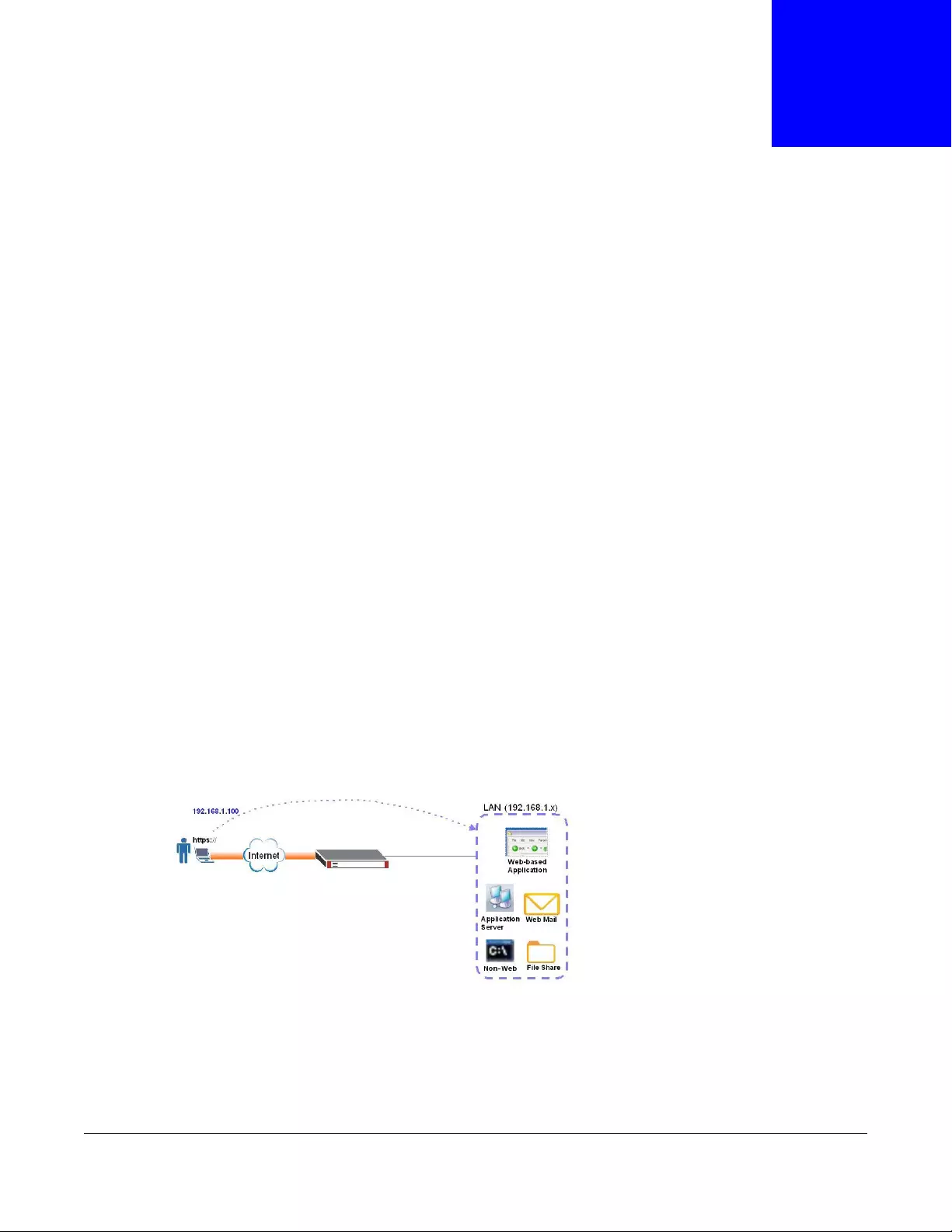
ZyWALL/USG Series User’s Guide
411
CHAPTER 23
SSL VPN
23.1 Overview
Use SSL VPN to allow users to use a web browser for secure remote user login. The remote users
do not need a VPN router or VPN client software.
23.1.1 What You Can Do in this Chapter
•Use the VPN > SSL VPN > Access Privilege screens (see Section 23.2 on page 412) to
configure SSL access policies.
• Use the Click VPN > SSL VPN > Global Setting screen (see Section 23.3 on page 416) to set
the IP address of the ZyWALL/USG (or a gateway device) on your network for full tunnel mode
access, enter access messages or upload a custom logo to be displayed on the remote user
screen.
•Use the VPN > SSL VP N > SecuExtender screen ( see Section 23.4 on page 418) to update
and check the current and latest version of the Security Extender.
23.1.2 What You Need to Know
Full Tunnel Mode
In full tunnel mode, a virtual connection is created for remote users with private IP addresses in the
same subnet as the local network. This allows them to access network resources in the same way
as if they were part of the internal network.
Figure 273 Network Access Mode: Full Tunnel Mode
SSL Access Policy
An SSL access policy allows the ZyWALL/USG to perform the following tasks:
• limit user access to specific applications or file sharing server on the network.

Chapter 23 SSL VPN
ZyWALL/USG Series User’s Guide
412
• allow user access to specific networks.
• assign private IP addresses and provide DNS/WINS server information to remote users to access
internal networks.
SSL Access Policy Objects
The SSL access policies reference the following objects. If you update this information, in response
to changes, the ZyWALL/USG automatically propagates the changes through the SSL policies that
use the object(s). When you delete an SSL policy, the objects are not removed.
You cannot delete an object that is referenced by an SSL access policy. To delete the object, you
must first unassociate the object from the SSL access policy.
23.2 The SSL Access Privilege Screen
Click VPN > SSL VPN to open the Access Privilege screen. This screen lists the configured SSL
access policies.
Figure 274 VPN > SSL VPN > Access Privilege
Table 171 Objects
OBJECT TYPE OBJECT
SCREEN DESCRIPTION
User Accounts User Account/
User Group
Configure a user account or user group to which you want to apply this SSL
access policy.
Application SSL
Application
Configure an SSL application object to specify the type of application and
the address of the local computer, server, or web site SSL users are to be
able to access.
IP Pool Address Configure an address object that defines a range of private IP addresses to
assign to user computers so they can access the internal network through a
VPN connection.
Server
Addresses
Address Configure address objects for the IP addresses of the DNS and WINS
servers that the ZyWALL/USG sends to the VPN connection users.
VPN Network Address Configure an address object to specify which network segment users are
allowed to access through a VPN connection.
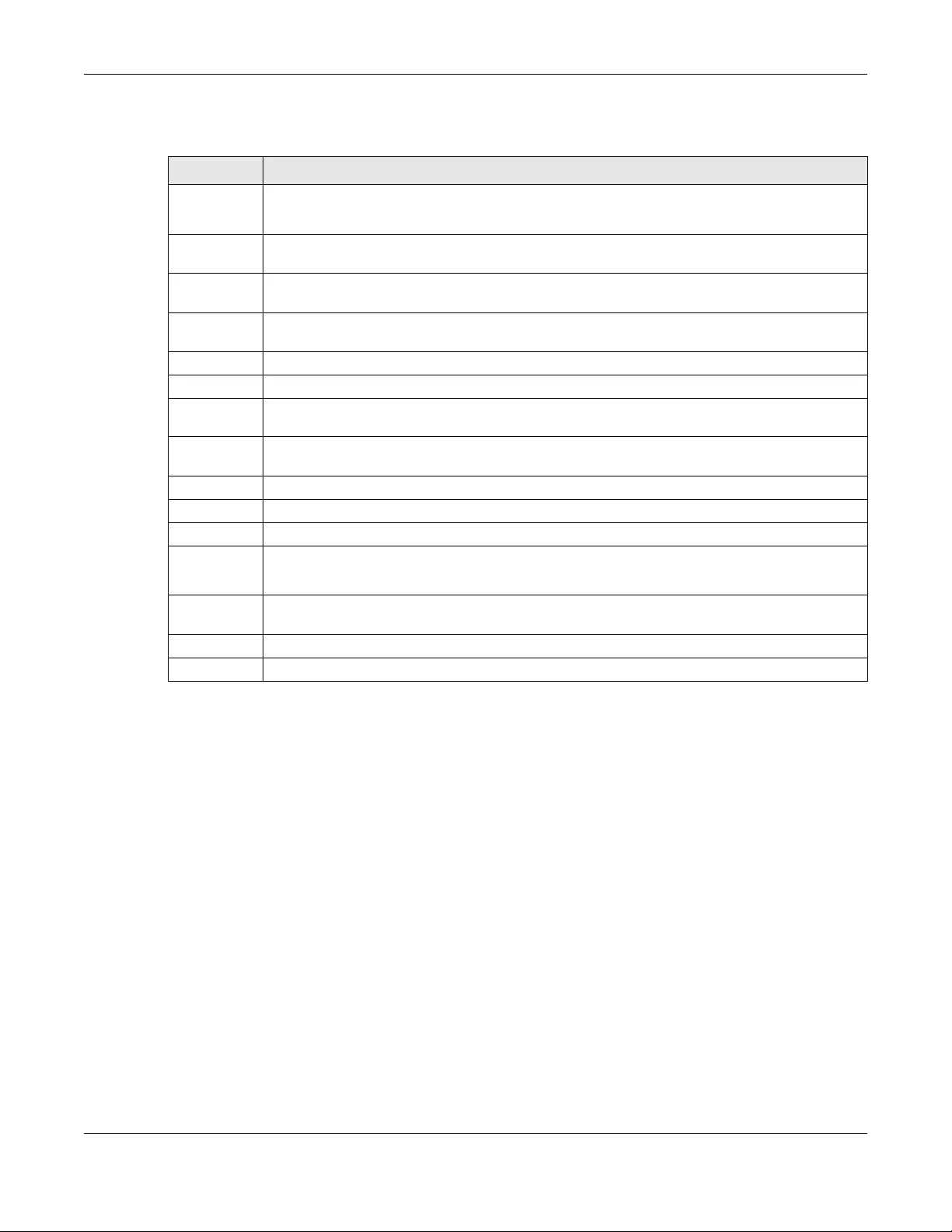
Chapter 23 SSL VPN
ZyWALL/USG Series User’s Guide
413
The following table describes the labels in this screen.
23.2.1 The SSL Access Privilege Policy Add/Edit Screen
To create a new or edit an existing SSL access policy, click the Add or Edit icon in the Access
Privilege screen.
Table 172 VPN > SSL VPN > Access Privilege
LABEL DESCRIPTION
Access Policy
Summary
This screen shows a summary of SSL VPN policies created.
Click on the VPN icon to go to the ZyXEL VPN Client product page at the ZyXEL website.
Add Click this to create a new entry. Select an entry and click Add to create a new entry after the
selected entry.
Edit Double-click an entry or select it and click Edit to open a screen where you can modify the
entry’s settings.
Remove To remove an entry, select it and click Remove. The ZyWALL/USG confirms you want to
remove it before doing so.
Activate To turn on an entry, select it and click Activate.
Inactivate To turn off an entry, select it and click Inactivate.
Move To move an entry to a different number in the list, click the Move icon. In the field that
appears, specify the number to which you want to move the interface.
Object
References
Select an entry and click Object References to open a screen that shows which settings use
the entry. Click Refresh to update information on this screen.
# This field displays the index number of the entry.
Status This icon is lit when the entry is active and dimmed when the entry is inactive.
Name This field displays the descriptive name of the SSL access policy for identification purposes.
User/Group This field displays the user account or user group name(s) associated to an SSL access policy.
This field displays up to three names.
Access Policy
Summary
This field displays details about the SSL application object this policy uses including its name,
type, and address.
Apply Click Apply to save the settings.
Reset Click Reset to discard all changes.

Chapter 23 SSL VPN
ZyWALL/USG Series User’s Guide
414
Figure 275 VPN > SSL VPN > Add/Edit
The following table describes the labels in this screen.
Table 173 VPN > SSL VPN > Access Privilege > Add/Edit
LABEL DESCRIPTION
Create new
Object
Use to configure any new settings objects that you need to use in this screen.
Configuration
Enable Policy Select this option to activate this SSL access policy.

Chapter 23 SSL VPN
ZyWALL/USG Series User’s Guide
415
Name Enter a descriptive name to identify this policy. You can enter up to 31 characters (“a-z”,
A-Z”, “0-9”) with no spaces allowed.
Zone Select the zone to which to add this SSL access policy. You use zones to apply security
settings such as security policy and remote management.
Description Enter additional information about this SSL access policy. You can enter up to 60
characters ("0-9", "a-z", "A-Z", "-" and "_").
User/Group The Selectable User/Group Objects list displays the name(s) of the user account and/
or user group(s) to which you have not applied an SSL access policy yet.
To associate a user or user group to this SSL access policy, select a user account or user
group and click the right arrow button to add to the Selected U ser/Gr oup Ob jec ts list.
You can select more than one name.
To remove a user or user group, select the name(s) in the Selected User/Group
Objects list and click the left arrow button.
Note: Although you can select admin and limited-admin accounts in this screen, they are
reserved for device configuration only. You cannot use them to access the SSL VPN
portal.
SSL Application
List (Optional)
The Selectable Application Object s list displays the name(s) of the SSL application(s)
you can select for this SSL access policy.
To associate an SSL application to this SSL access policy, select a name and click the right
arrow button to add to the Selected Application Objects list. You can select more than
one application.
To remove an SSL application, select the name(s) in the Selected Application Objects
list and click the left arrow button.
Note: To allow access to shared files on a Windows 7 computer, within Windows 7 you must
enable sharing on the folder and also go to the Network and Sharing Center’s
Advanced sharing settings and turn on the current network profile’s file and printer
sharing.
Network Extension (Optional)
Enable Network
Extension
Select this option to create a VPN tunnel between the authenticated users and the internal
network. This allows the users to access the resources on the network as if they were on
the same local network. This includes access to resources not supported by SSL
application objects. For example this lets users Telnet to the internal network even though
the ZyWALL/USG does not have SSL application objects for Telnet.
Clear this option to disable this feature. Users can only access the applications as defined
by the VPN tunnel’s selected SSL application settings and the remote user computers are
not made to be a part of the local network.
Force all client
traffic to SSL VPN
tunnel
Select this to send all traffic from the SSL VPN clients through the SSL VPN tunnel. This
replaces the default gateway of the SSL VPN clients with the SSL VPN gateway.
NetBIOS
broadcast over
SSL VPN Tunnel
Select this to search for a remote computer and access its applications as if it was in a
Local Area Network. The user can find a computer not only by its IP adress but also by
computer name.
Assign IP Pool Define a separate pool of IP addresses to assign to the SSL users. Select it here.
The SSL VPN IP pool should not overlap with IP addresses on the ZyWALL/USG's local
networks (LAN and DMZ for example), the SSL user's network, or the networks you
specify in the SSL VPN Network List.
DNS/WINS
Server 1..2
Select the name of the DNS or WINS server whose information the ZyWALL/USG sends to
the remote users. This allows them to access devices on the local network using domain
names instead of IP addresses.
Table 173 VPN > SSL VPN > Access Privilege > Add/Edit (continued)
LABEL DESCRIPTION

Chapter 23 SSL VPN
ZyWALL/USG Series User’s Guide
416
23.3 The SSL Global Setting Screen
Click VPN > SSL VPN and click the Global Setting tab to display the following screen. Use this
screen to set the IP address of the ZyWALL/USG (or a gateway device) on your network for full
tunnel mode access, enter access messages or upload a custom logo to be displayed on the remote
user screen.
Figure 276 VPN > SSL VPN > Global Setting
Network List To allow user access to local network(s), select a network name in the Selectable
Address Objects list and click the right arrow button to add to the Selected Address
Objects list. You can select more than one network.
To block access to a network, select the network name in the Selected Address Objects
list and click the left arrow button.
OK Click OK to save the changes and return to the main Access Privilege screen.
Cancel Click Cancel to discard all changes and return to the main Access Privilege screen.
Table 173 VPN > SSL VPN > Access Privilege > Add/Edit (continued)
LABEL DESCRIPTION

Chapter 23 SSL VPN
ZyWALL/USG Series User’s Guide
417
The following table describes the labels in this screen.
23.3.1 How to Upload a Custom Logo
Follow the steps below to upload a custom logo to display on the remote user SSL VPN screens.
1Click VPN > SSL VPN and click the Global Setting tab to display the configuration screen.
2Click Browse to locate the logo graphic. Make sure the file is in GIF, JPG, or PNG format.
3Click Apply to start the file transfer process.
4Log in as a user to verify that the new logo displays properly.
Table 174 VPN > SSL VPN > Global Setting
LABEL DESCRIPTION
Global Setting
Network
Extension Local
IP
Specify the IP address of the ZyWALL/USG (or a gateway device) for full tunnel mode SSL
VPN access.
Leave this field to the default settings unless it conflicts with another interface.
SSL VPN Login Domain Name
SSL VPN Login
Domain Name 1/
2
Specify a full domain name for users to use for SSL VPN login. The domain name must be
registered to one of the ZyWALL/USG’s IP addresses or be one of the ZyWALL/USG’s
DDNS entries. You can specify up to two domain names so you could use one domain
name for each of two WAN ports. For example, www.zyxel.com is a fully qualified domain
name where “www” is the host.
The ZyWALL/USG displays the normal login screen without the button for logging into the
Web Configurator.
Message
Login Message Specify a message to display on the screen when a user logs in and an SSL VPN
connection is established successfully. You can enter up to 60 characters (0-9, a-z, A-Z,
'()+,/:=?;!*#@$_%-") with spaces allowed.
Logout Message Specify a message to display on the screen when a user logs out and the SSL VPN
connection is terminated successfully. You can enter up to 60 characters (0-9, a-z, A-Z,
'()+,/:=?;!*#@$_%-") with spaces allowed.
Update Client
Virtual Desktop
Logo
You can upload a graphic logo to be displayed on the web browser on the remote user
computer. The ZyXEL company logo is the default logo.
Specify the location and file name of the logo graphic or click Browse to locate it.
Note: The logo graphic must be GIF, JPG, or PNG format. The graphic should use a
resolution of 103 x 29 pixels to avoid distortion when displayed. The ZyWALL/USG
automatically resizes a graphic of a different resolution to 103 x 29 pixels. The file
size must be 100 kilobytes or less. Transparent background is recommended.
Browse Click Browse to locate the graphic file on your computer.
Upload Click Upload to transfer the specified graphic file from your computer to the ZyWALL/
USG.
Reset Logo to
Default
Click Reset Logo to Default to display the ZyXEL company logo on the remote user’s
web browser.
Apply Click Apply to save the changes and/or start the logo file upload process.
Reset Click Reset to return the screen to its last-saved settings.

Chapter 23 SSL VPN
ZyWALL/USG Series User’s Guide
418
The following shows an example logo on the remote user screen.
Figure 277 Example Logo Graphic Display
23.4 ZyWALL/USG SecuExtender
The ZyWALL/USG automatically loads the ZyWALL/USG SecuExtender client program to your
computer after a successful login to an SSL VPN tunnel with network extension support enabled.
The ZyWALL/USG SecuExtender lets you:
• Access servers, remote desktops and manage files as if you were on the local network.
• Use applications like e-mail, file transfer, and remote desktop programs directly without using a
browser. For example, you can use Outlook for e-mail instead of the ZyWALL/USG’s web-based e-
mail.
• Use applications, even proprietary applications, for which the ZyWALL/USG does not offer SSL
application objects.
The applications must be installed on your computer. For example, to use the VNC remote desktop
program, you must have the VNC client installed on your computer. Please refer to the
SecuExtender chapter for details.
Figure 278 Configuration > VPN > SSL VPN > SecuExtender.

Chapter 23 SSL VPN
ZyWALL/USG Series User’s Guide
419
The following table describes the labels in this screen.
23.4.1 Example: Configure ZyWALL/USG for SecuExtender
Make these configurations on the ZyWALL/USG to allow the remote user to access resources behind
the ZyWALL/USG using SecuExtender. These steps can be performed in any order.
1Create a user that can log into the ZyWALL/USG. Using the ZyWALL/USG web configurator, go to
Configuration > Object > User > Ad d and substitute your information for the information shown
in the following example.
Figure 279 Create a User
2Next create an SSL VPN Access Privilege policy substituting your information for the information
shown in the following example. Using the ZyWALL/USG web configurator, go to Configuration >
VPN > SSL VPN > Access Privilege > Add.
Table 175 Configuration > VPN > SSL VPN > SecuExtender
LABEL DESCRIPTION
Latest Version This displays the latest version of the ZyWALL/USG Security SecuExtender that
is available.
Current Version This displays the current version of SecuExtender that is installed in the
ZyWALL/USG.
Note: You need to register first at portal.myzyxel.com to download the latest version of
SecuExtender.
Update Now The ZyWALL/USG periodically checks if there’s a later version of SecuExtender at
the portal. The Update Now button is enabled when thre is.Click Update Now
to get the latest version of SecuExtender.

Chapter 23 SSL VPN
ZyWALL/USG Series User’s Guide
420
Figure 280 Create an SSL VPN Access Privilege Policy
3Then create File Sharing and Web Application SSL Application objects. Using the ZyWALL/USG
web configurator, go to Configuration > Object > SSL Application > Add and select the Type
accordingly. Substitute your information for the information shown in the following example.
Figure 281 Create a File Sharing SSL Application Object

Chapter 23 SSL VPN
ZyWALL/USG Series User’s Guide
421
Create a Web Application SSL Application Object
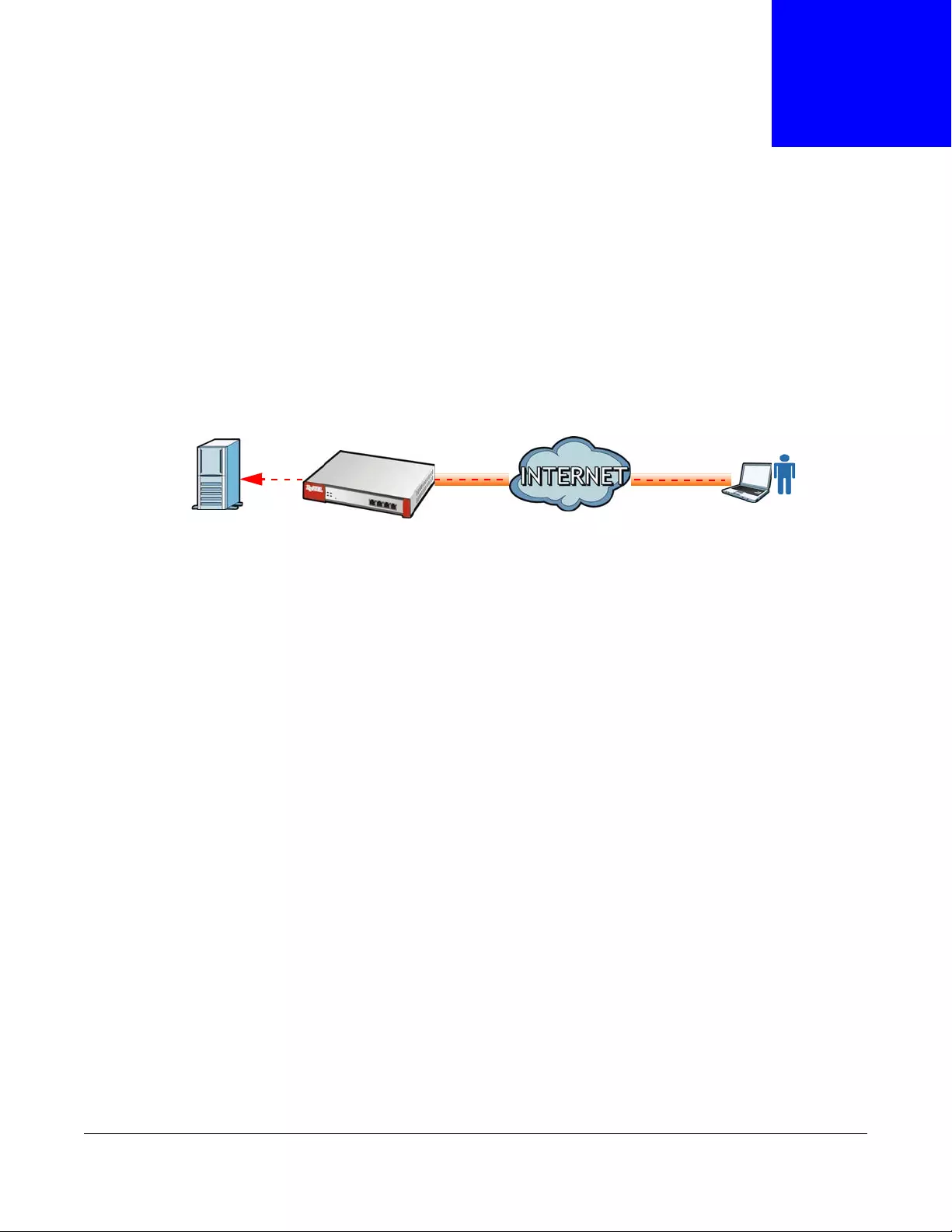
ZyWALL/USG Series User’s Guide
422
CHAPTER 24
SSL User Screens
24.1 Overview
This chapter introduces the remote user SSL VPN screens. The following figure shows a network
example where a remote user (A) logs into the ZyWALL/USG from the Internet to access the web
server (WWW) on the local network.
Figure 282 Network Example
24.1.1 What You Need to Know
The ZyWALL/USG can use SSL VPN to provide secure connections to network resources such as
applications, files, intranet sites or e-mail through a web-based interface and using Microsoft
Outlook Web Access (OWA).
Network Resource Access Methods
As a remote user, you can access resources on the local network using one of the following
methods.
• Using a supported web browser
Once you have successfully logged in through the ZyWALL/USG, you can access intranet sites,
web-based applications, or web-based e-mails using one of the supported web browsers.
• Using the ZyWALL/USG SecuExtender client
Once you have successfully logged into the ZyWALL/USG, if the SSL VPN access policy has
network extension enabled the ZyWALL/USG automatically loads the ZyWALL/USG SecuExtender
client program to your computer. With the ZyWALL/USG SecuExtender, you can access network
resources, remote desktops and manage files as if you were on the local network. See Chapter
25 on page 435 for more on the ZyWALL/USG SecuExtender.
System Requirements
Here are the browser and computer system requirements for remote user access.
• Windows 7 (32 or 64-bit), Vista (32 or 64-bit), 2003 (32-bit), XP (32-bit), or 2000 (32-bit)
• Internet Explorer 7 and above or Firefox 1.5 and above
A
WWW
Internet
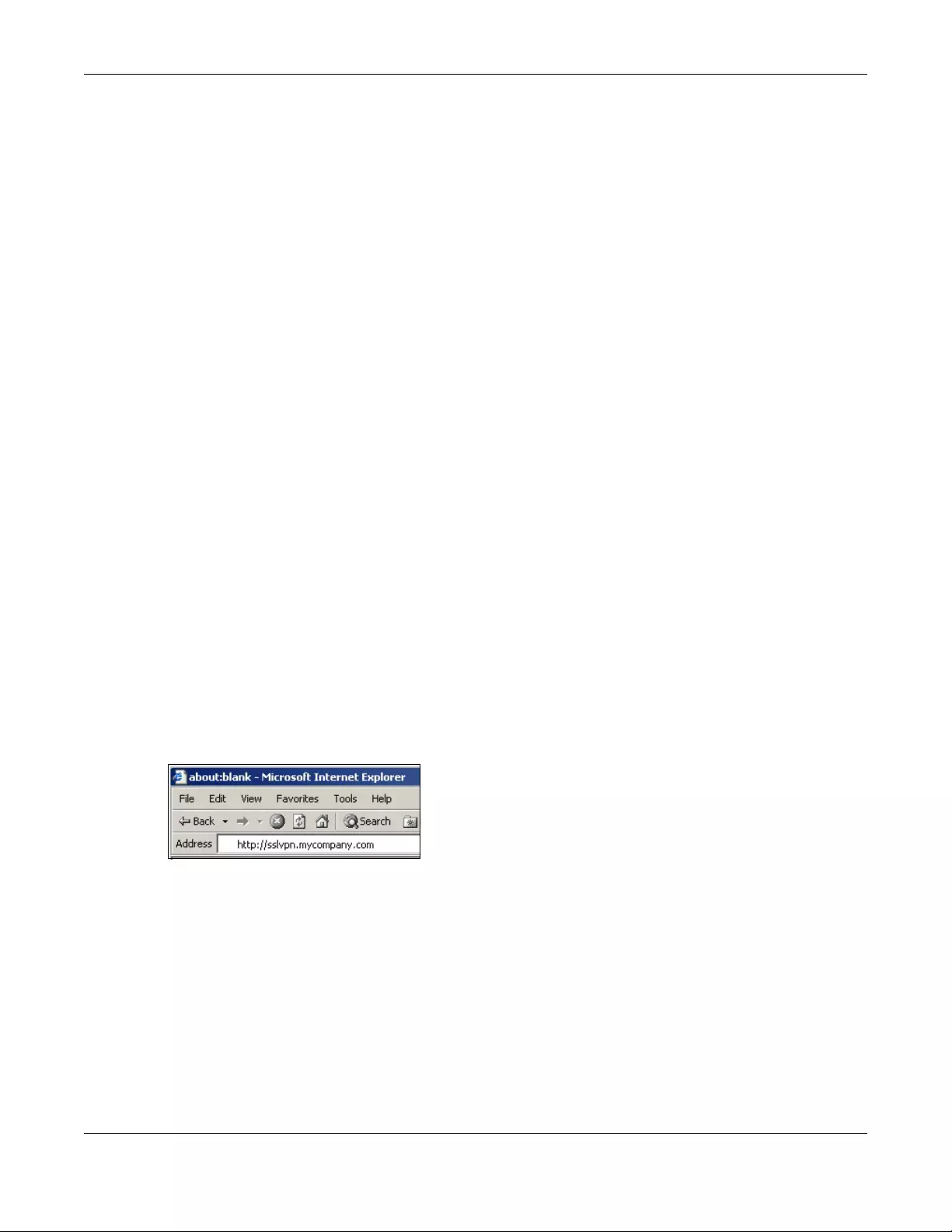
Chapter 24 SSL User Screens
ZyWALL/USG Series User’s Guide
423
• Using RDP requires Internet Explorer
• Sun’s Runtime Environment (JRE) version 1.6 or later installed and enabled.
Required Information
A remote user needs the following information from the network administrator to log in and access
network resources.
• the domain name or IP address of the ZyWALL/USG
• the login account user name and password
• if also required, the user name and/or password to access the network resource
Certificates
The remote user’s computer establishes an HTTPS connection to the ZyWALL/USG to access the
login screen. If instructed by your network administrator, you must install or import a certificate
(provided by the ZyWALL/USG or your network administrator).
Finding Out More
See Chapter 23 on page 411 for how to configure SSL VPN on the ZyWALL/USG.
24.2 Remote SSL User Login
This section shows you how to access and log into the network through the ZyWALL/USG. Example
screens for Internet Explorer are shown.
1Open a web browser and enter the web site address or IP address of the ZyWALL/USG. For
example, “http://sslvpn.mycompany.com”.
Figure 283 Enter the Address in a Web Browser
2Click OK or Yes if a security screen displays.

Chapter 24 SSL User Screens
ZyWALL/USG Series User’s Guide
424
Figure 284 Login Security Screen
3A login screen displays. Enter the user name and password of your login account. If a token
password is also required, enter it in the One-Time Password field. Click SSL VPN to log in and
establish an SSL VPN connection to the network to access network resources.
Figure 285 Login Screen
4Your computer starts establishing a secure connection to the ZyWALL/USG after a successful login.
This may take up to two minutes. If you get a message about needing Java, download and install it
and restart your browser and re-login. If a certificate warning screen displays, click OK, Yes or
Continue.
Figure 286 Java Needed Message
5The ZyWALL/USG tries to install the SecuExtender client. As shown next, you may have to click
some pop-ups to get your browser to allow the installation.

Chapter 24 SSL User Screens
ZyWALL/USG Series User’s Guide
425
Figure 287 ActiveX Object Installation Blocked by Browser
Figure 288 SecuExtender Blocked by Internet Explorer
6The ZyWALL/USG tries to run the “ssltun” application. You may need to click something to get your
browser to allow this. In Internet Explorer, click Run.
Figure 289 SecuExtender Progress
7Click Next to use the setup wizard to install the SecuExtender client on your computer.

Chapter 24 SSL User Screens
ZyWALL/USG Series User’s Guide
426
Figure 290 SecuExtender Progress
8If a screen like the following displays, click Continue Anyway to finish installing the SecuExtender
client on your computer.
Figure 291 Installation Warning
9The Application screen displays showing the list of resources available to you. See Figure 292 on
page 427 for a screen example.
Note: Available resource links vary depending on the configuration your network
administrator made.
24.3 The SSL VPN User Screens
This section describes the main elements in the remote user screens.

Chapter 24 SSL User Screens
ZyWALL/USG Series User’s Guide
427
Figure 292 Remote User Screen
The following table describes the various parts of a remote user screen.
24.4 Bookmarking the ZyWALL/USG
You can create a bookmark of the ZyWALL/USG by clicking the Add to Favorite icon. This allows
you to access the ZyWALL/USG using the bookmark without having to enter the address every
time.
1In any remote user screen, click the Add to Favorite icon.
Table 176 Remote User Screen Overview
#DESCRIPTION
1 Click on a menu tab to go to the Application or File Sharing screen.
2 Click this icon to log out and terminate the secure connection.
3 Click this icon to create a bookmark to the SSL VPN user screen in your web browser.
4 Click this icon to display the on-line help window.
5 Select your preferred language for the interface.
6 This part of the screen displays a list of the resources available to you.
In the Application screen, click on a link to access or display the access method.
In the File Sharing screen, click on a link to open a file or directory.
234
5
1
6
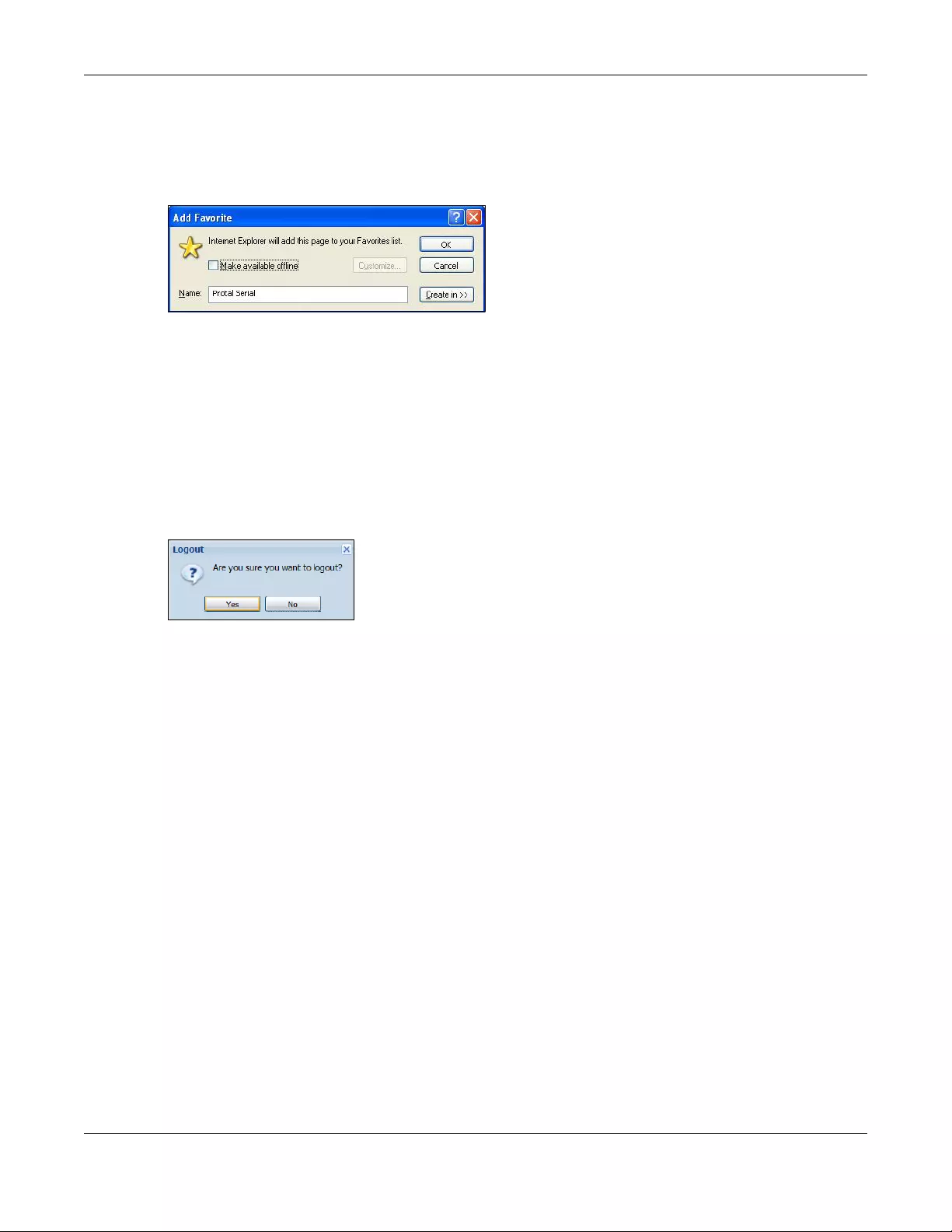
Chapter 24 SSL User Screens
ZyWALL/USG Series User’s Guide
428
2A screen displays. Accept the default name in the Name field or enter a descriptive name to
identify this link.
3Click OK to create a bookmark in your web browser.
Figure 293 Add Favorite
24.5 Logging Out of the SSL VPN User Screens
To properly terminate a connection, click on the Logout icon in any remote user screen.
1Click the Logout icon in any remote user screen.
2A prompt window displays. Click OK to continue.
Figure 294 Logout: Prompt
24.6 SSL User Application Screen
Use the Application tab’s screen to access web-based applications (such as web sites and e-mail)
on the network through the SSL VPN connection. Which applications you can access depends on the
ZyWALL/USG’s configuration.
The Name field displays the descriptive name for an application. The Type field displays wether the
application is a web site (Web Server) or web-based e-mail using Microsoft Outlook Web Access
(OWA).
To access a web-based application, simply click a link in the Application screen to display the web
screen in a separate browser window.
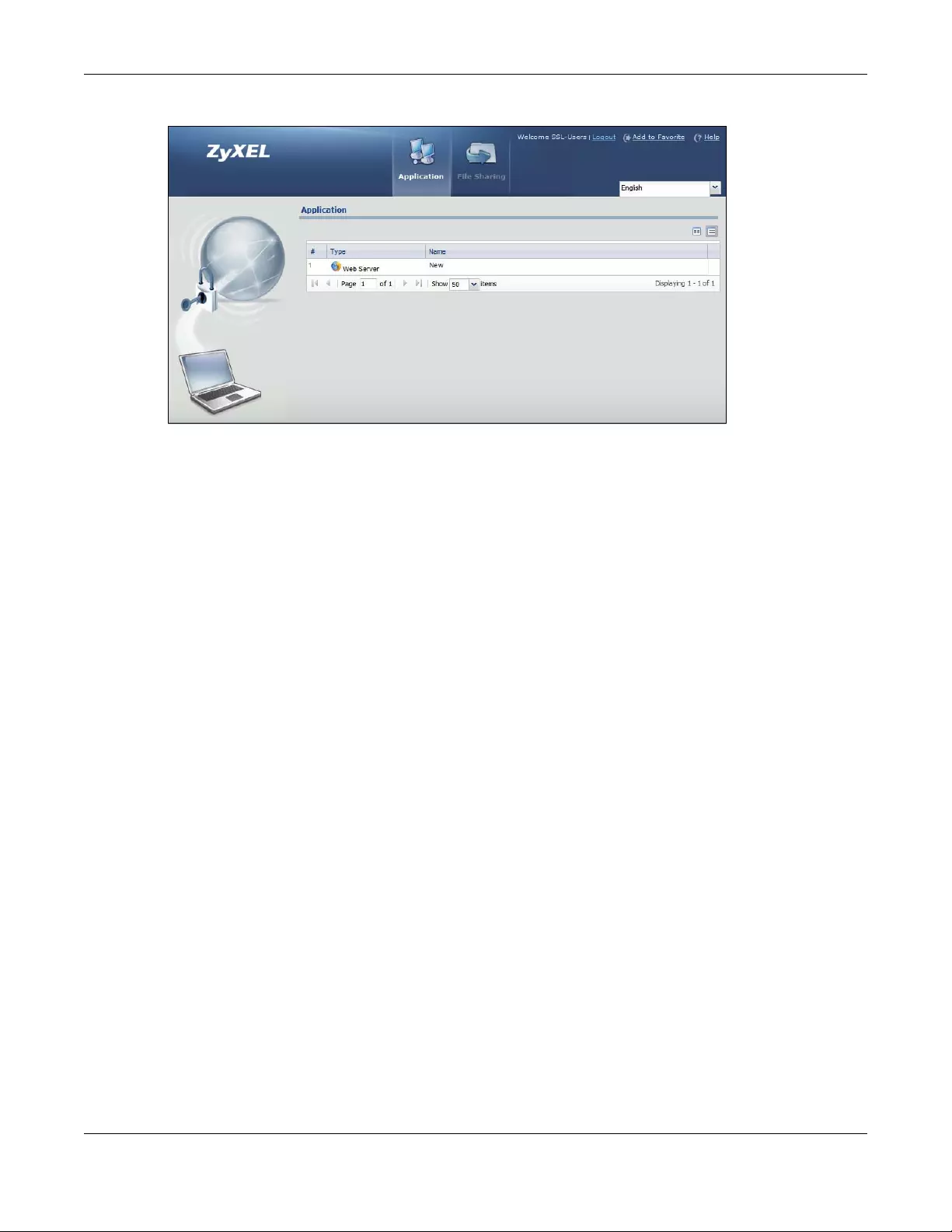
Chapter 24 SSL User Screens
ZyWALL/USG Series User’s Guide
429
Figure 295 Application
24.7 SSL User File Sharing
The File Sharing screen lets you access files on a file server through the SSL VPN connection. Use
it to display and access shared files/folders on a file server.
You can also perform the following actions:
• Access a folder.
• Open a file (if your web browser cannot open the file, you are prompted to download it).
• Save a file to your computer.
• Create a new folder.
• Rename a file or folder.
• Delete a file or folder.
• Upload a file.
Note: Available actions you can perform in the File Sharing screen vary depending on
the rights granted to you on the file server.
24.7.1 The Main File Sharing Screen
The first File Sharing screen displays the name(s) of the shared folder(s) available. The following
figure shows an example with one file share.

Chapter 24 SSL User Screens
ZyWALL/USG Series User’s Guide
430
Figure 296 File Sharing
24.7.2 Opening a File or Folder
You can open a file if the file extension is recognized by the web browser and the associated
application is installed on your computer.
1Log in as a remote user and click the File Sharing tab.
2Click on a file share icon.
3If an access user name and password are required, a screen displays as shown in the following
figure. Enter the account information and click Login to continue.
Figure 297 File Sharing: Enter Access User Name and Password

Chapter 24 SSL User Screens
ZyWALL/USG Series User’s Guide
431
4A list of files/folders displays. Double click a file to open it in a separate browser window or select a
file and click Download to save it to your computer. You can also click a folder to access it.
For this example, click on a .doc file to open the Word document.
Figure 298 File Sharing: Open a Word File
24.7.3 Downloading a File
You are prompted to download a file which cannot be opened using a web browser.
Follow the on-screen instructions to download and save the file to your computer. Then launch the
associated application to open the file.
24.7.4 Saving a File
After you have opened a file in a web browser, you can save a copy of the file by clicking File >
Save As and following the on-screen instructions.

Chapter 24 SSL User Screens
ZyWALL/USG Series User’s Guide
432
Figure 299 File Sharing: Save a Word File
24.7.5 Creating a New Folder
To create a new folder in the file share location, click the New Folder icon.
Specify a descriptive name for the folder. You can enter up to 356 characters. Then click Add.
Note: Make sure the length of the folder name does not exceed the maximum allowed on
the file server.
Figure 300 File Sharing: Create a New Folder
24.7.6 Renaming a File or Folder
To rename a file or folder, select a file or folder and click the Rename icon.
Figure 301 File Sharing: Rename

Chapter 24 SSL User Screens
ZyWALL/USG Series User’s Guide
433
A popup window displays. Specify the new name and/or file extension in the field provided. You can
enter up to 356 characters. Then click Apply.
Note: Make sure the length of the name does not exceed the maximum allowed on the
file server.
You may not be able to open a file if you change the file extension.
Figure 302 File Sharing: Rename
24.7.7 Deleting a File or Folder
Click the Delete icon next to a file or folder to remove it.
24.7.8 Uploading a File
Follow the steps below to upload a file to the file server.
1Log into the remote user screen and click the File Sharing tab.
2Click Upload and specify the location and/or name of the file you want to upload. Or click Browse
to locate it.
3Click OK to send the file to the file server.
4After the file is uploaded successfully, you should see the name of the file and a message in the
screen.
Figure 303 File Sharing: File Upload

Chapter 24 SSL User Screens
ZyWALL/USG Series User’s Guide
434
Note: Uploading a file with the same name and file extension replaces the existing file on
the file server. No warning message is displayed.

ZyWALL/USG Series User’s Guide
435
CHAPTER 25
ZyWALL/USG SecuExtender (Windows)
The ZyWALL/USG automatically loads the ZyWALL/USG SecuExtender for Windows client program
to your computer after a successful login to an SSL VPN tunnel with network extension support
enabled.
Note: For information on using the ZyWALL/USG SecuExtender for Mac client program,
please see its User’s Guide at the download library on the ZyXEL website.
The ZyWALL/USG SecuExtender (Windows) lets you:
• Access servers, remote desktops and manage files as if you were on the local network.
• Use applications like e-mail, file transfer, and remote desktop programs directly without using a
browser. For example, you can use Outlook for e-mail instead of the ZyWALL/USG’s web-based e-
mail.
• Use applications, even proprietary applications, for which the ZyWALL/USG does not offer SSL
application objects.
The applications must be installed on your computer. For example, to use the VNC remote desktop
program, you must have the VNC client installed on your computer.
25.1 The ZyWALL/USG SecuExtender Icon
The ZyWALL/USG SecuExtender icon color indicates the SSL VPN tunnel’s connection status.
Figure 304 ZyWALL/USG SecuExtender Icon
• Green: the SSL VPN tunnel is connected. You can connect to the SSL application and network
resources. You can also use another application to access resources behind the ZyWALL/USG.
• Gray: the SSL VPN tunnel’s connection is suspended. This means the SSL VPN tunnel is
connected, but the ZyWALL/USG SecuExtender will not send any traffic through it until you right-
click the icon and resume the connection.
• Red: the SSL VPN tunnel is not connected. You cannot connect to the SSL application and
network resources.
25.2 Status
Right-click the ZyWALL/USG SecuExtender icon in the system tray and select Status to open the
Status screen. Use this screen to view the ZyWALL/USG SecuExtender’s connection status and
activity statistics.
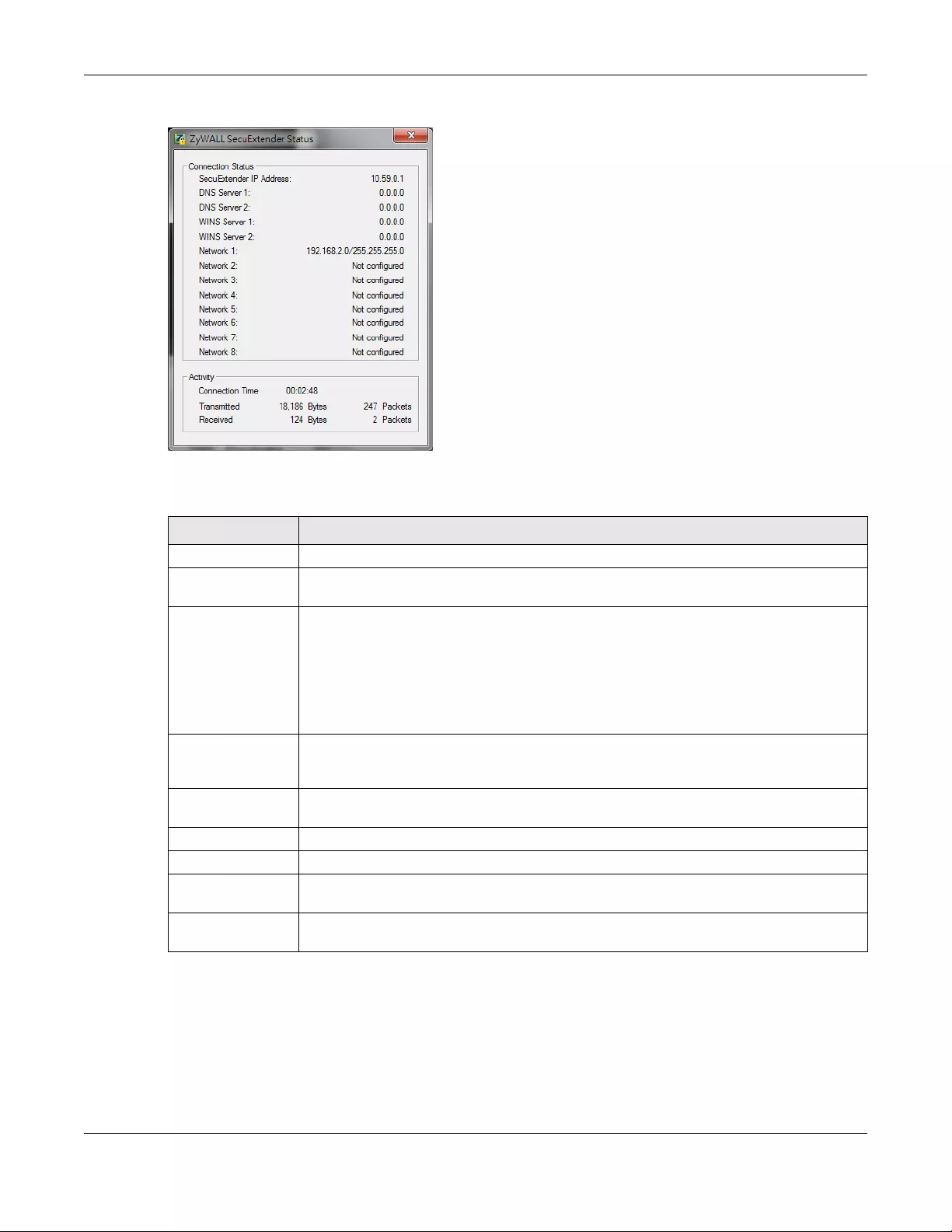
Chapter 25 ZyWALL/USG SecuExtender (Windows)
ZyWALL/USG Series User’s Guide
436
Figure 305 ZyWALL/USG SecuExtender Status
The following table describes the labels in this screen.
25.3 View Log
If you have problems with the ZyWALL/USG SecuExtender, customer support may request you to
provide information from the log. Right-click the ZyWALL/USG SecuExtender icon in the system tray
and select Log to open a notepad file of the ZyWALL/USG SecuExtender’s log.
Table 177 ZyWALL/USG SecuExtender Status
LABEL DESCRIPTION
Connection Status
SecuExtender IP
Address
This is the IP address the ZyWALL/USG assigned to this remote user computer for an SSL
VPN connection.
DNS Server 1/2 These are the IP addresses of the DNS server and backup DNS server for the SSL VPN
connection.
DNS (Domain Name System) maps a domain name to its corresponding IP address and
vice versa. The DNS server is extremely important because without it, you must know
the IP address of a computer before you can access it. Your computer uses the DNS
server specified here to resolve domain names for resources you access through the SSL
VPN connection.
WINS Server 1/2 These are the IP addresses of the WINS (Windows Internet Naming Service) and backup
WINS servers for the SSL VPN connection. The WINS server keeps a mapping table of
the computer names on your network and the IP addresses that they are currently using.
Network 1~8 These are the networks (including netmask) that you can access through the SSL VPN
connection.
Activity
Connected Time This is how long the computer has been connected to the SSL VPN tunnel.
Transmitted This is how many bytes and packets the computer has sent through the SSL VPN
connection.
Received This is how many bytes and packets the computer has received through the SSL VPN
connection.

Chapter 25 ZyWALL/USG SecuExtender (Windows)
ZyWALL/USG Series User’s Guide
437
Figure 306 ZyWALL/USG SecuExtender Log Example
25.4 Suspend and Resume the Connection
When the ZyWALL/USG SecuExtender icon in the system tray is green, you can right-click the icon
and select Suspend Connect ion to keep the SSL VPN tunnel connected but not send any traffic
through it until you right-click the icon and resume the connection.
25.5 Stop the Connection
Right-click the icon and select Stop Connection to disconnect the SSL VPN tunnel.
25.6 Uninstalling the ZyWALL/USG SecuExtender
Do the following if you need to remove the ZyWALL/USG SecuExtender.
1Click start > All Programs > ZyXEL > ZyWALL/USG SecuExtender > Uninstall ZyWALL
SecuExtender.
2In the confirmation screen, click Yes.
##################################################################################
##############
[ 2009/03/12 13:35:50 ][SecuExtender Agent][DETAIL] Build Datetime: Feb 24 2009/
10:25:07
[ 2009/03/12 13:35:50 ][SecuExtender Agent][DEBUG] rasphone.pbk: C:\Documents and
Settings\11746\rasphone.pbk
[ 2009/03/12 13:35:50 ][SecuExtender Agent][DEBUG] SecuExtender.log:
C:\Documents and Settings\11746\SecuExtender.log
[ 2009/03/12 13:35:50 ][SecuExtender Agent][DETAIL] Check Parameters
[ 2009/03/12 13:35:50 ][SecuExtender Agent][DETAIL] Connect to 172.23.31.19:443/
10444
[ 2009/03/12 13:35:50 ][SecuExtender Agent][DETAIL] Parameter is OK
[ 2009/03/12 13:35:50 ][SecuExtender Agent][DETAIL] Checking System status...
[ 2009/03/12 13:35:50 ][SecuExtender Agent][DETAIL] Checking service (first) ...
[ 2009/03/12 13:35:50 ][SecuExtender Agent][DETAIL] SecuExten der Helper is running
[ 2009/03/12 13:35:50 ][SecuExtender Agent][DETAIL] System is OK
[ 2009/03/12 13:35:50 ][SecuExtender Agent][DEBUG] Connect to 2887196435/443
[ 2009/03/12 13:35:50 ][SecuExtender Agent][DETAIL] Handshake LoopCounter: 0
[ 2009/03/12 13:35:50 ][SecuExtender Agent][DETAIL] 611 bytes of handshake data
received
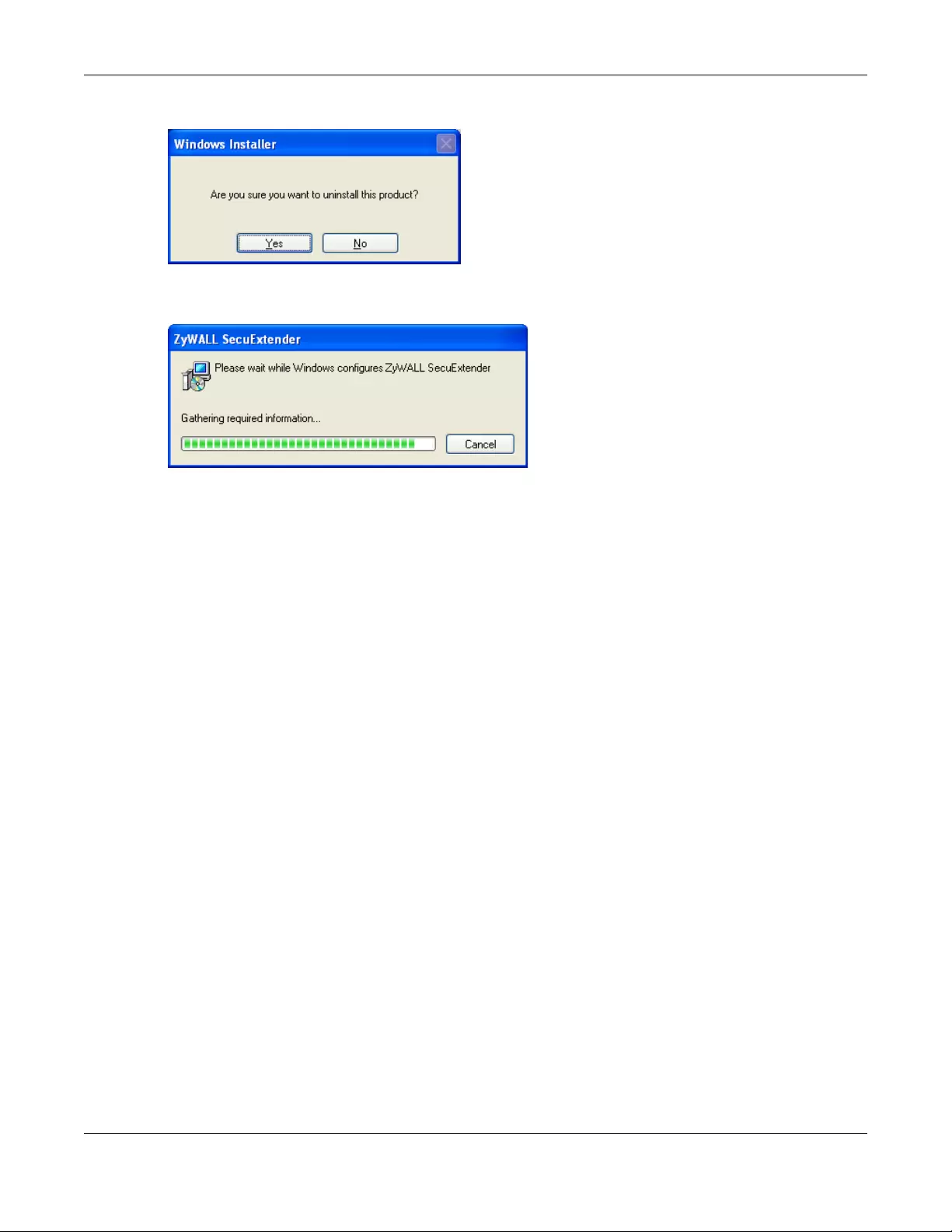
Chapter 25 ZyWALL/USG SecuExtender (Windows)
ZyWALL/USG Series User’s Guide
438
Figure 307 Uninstalling the ZyWALL/USG SecuExtender Confirmation
3Windows uninstalls the ZyWALL/USG SecuExtender.
Figure 308 ZyWALL/USG SecuExtender Uninstallation

ZyWALL/USG Series User’s Guide
439
CHAPTER 26
L2TP VPN
26.1 Overview
L2TP VPN uses the L2TP and IPSec client software included in remote users’ Android, iOS, Windows
or Mac OS X operating systems for secure connections to the network behind the ZyWALL/USG. The
remote users do not need their own IPSec gateways or third-party VPN client software.
Figure 309 L2TP VPN Overview
26.1.1 What You Can Do in this Chapter
•Use the L2TP VPN screen (see Section 26.2 on page 440) to configure the ZyWALL/USG’s L2TP
VPN settings.
•Use the VPN Setup Wizard screen in Quick Setup (Chapter 4 on page 56) to configure the
ZyWALL/USG’s L2TP VPN settings.
26.1.2 What You Need to Know
The Layer 2 Tunneling Protocol (L2TP) works at layer 2 (the data link layer) to tunnel network traffic
between two peers over another network (like the Internet). In L2TP VPN, an IPSec VPN tunnel is
established first and then an L2TP tunnel is built inside it. See Chapter 22 on page 376 for
information on IPSec VPN.
IPSec Configuration Required for L2TP VPN
You must configure an IPSec VPN connection prior to proper L2TP VPN usage (see Chapter 26 on
page 439 for details). The IPSec VPN connection must:
• Be enabled.
• Use transport mode.
•Use Pre-Shared Key authentication.
• Use a VPN gateway with the Secure Gateway set to 0.0.0.0 if you need to allow L2TP VPN
clients to connect from more than one IP address.
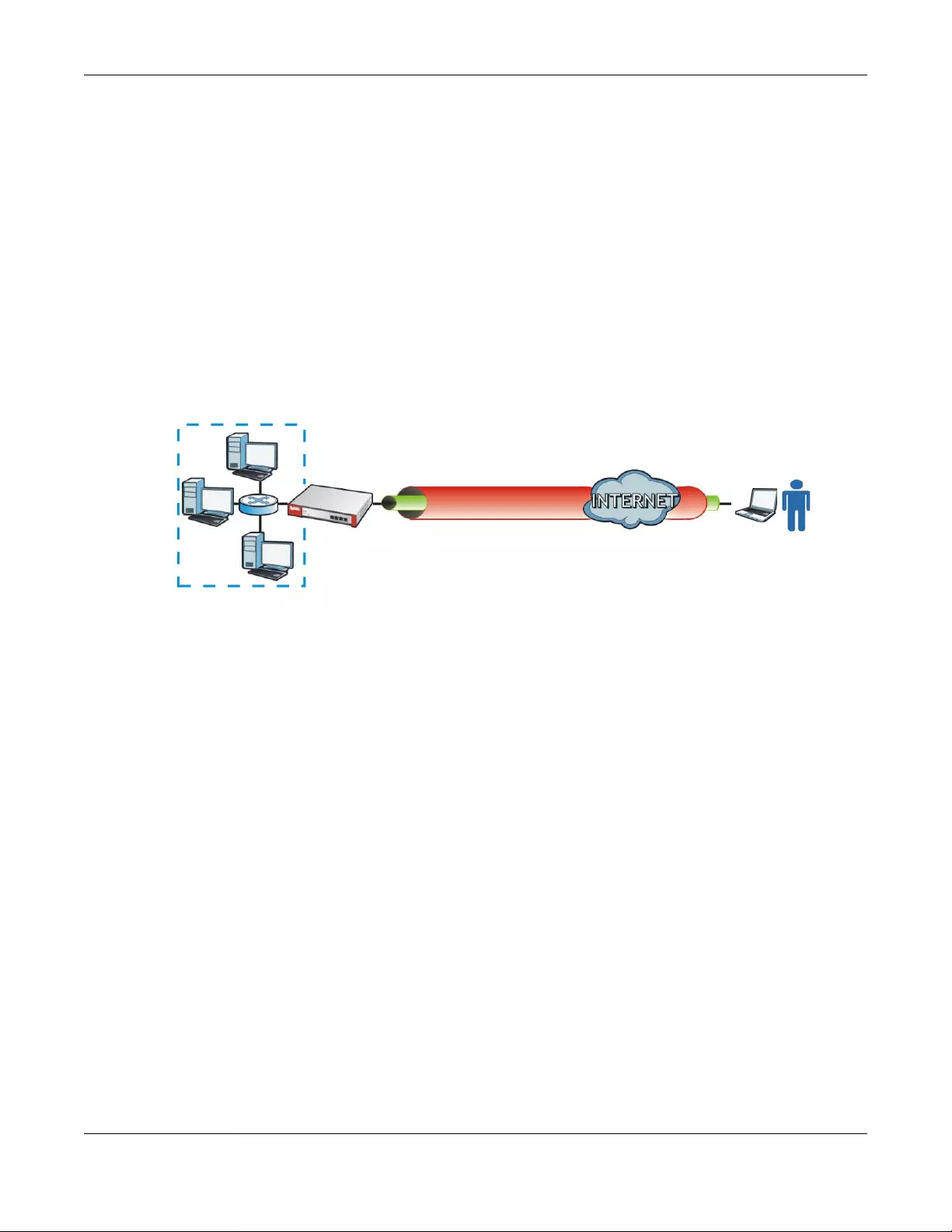
Chapter 26 L2TP VPN
ZyWALL/USG Series User’s Guide
440
Using the Quick Setup VPN Setup Wizard
The VPN Setup Wizard is an easy and convenient way to configure the L2TP VPN settings. Click
Configuration > Quick Setup > VPN Setup > VPN Settings for L2TP VPN Settings to get
started.
Policy Route
The Policy Route for return traffic (from LAN to L2TP clients) is automatically created when ZyWALL/
USG adds a new L2TP connection, allowing users access the resources on a network without
additional configuration. However, if some of the traffic from the L2TP clients needs to go to the
Internet, you will need to create a policy route to send that traffic from the L2TP tunnels out
through a WAN trunk. This task can be easily performed by clicking the Allow L2TP traffic through
WAN checkbox at Quick Setup > VPN Setup > Allow L2TP traffic through WAN.
Figure 310 Policy Route for L2TP VPN
26.2 L2TP VPN Screen
Click Configuration > VPN > L2TP VPN to open the following screen. Use this screen to configure
the ZyWALL/USG’s L2TP VPN settings.
Note: Disconnect any existing L2TP VPN sessions before modifying L2TP VPN settings.
The remote users must make any needed matching configuration changes and re-
establish the sessions using the new settings.
LAN_SUBNET
L2TP_POOL
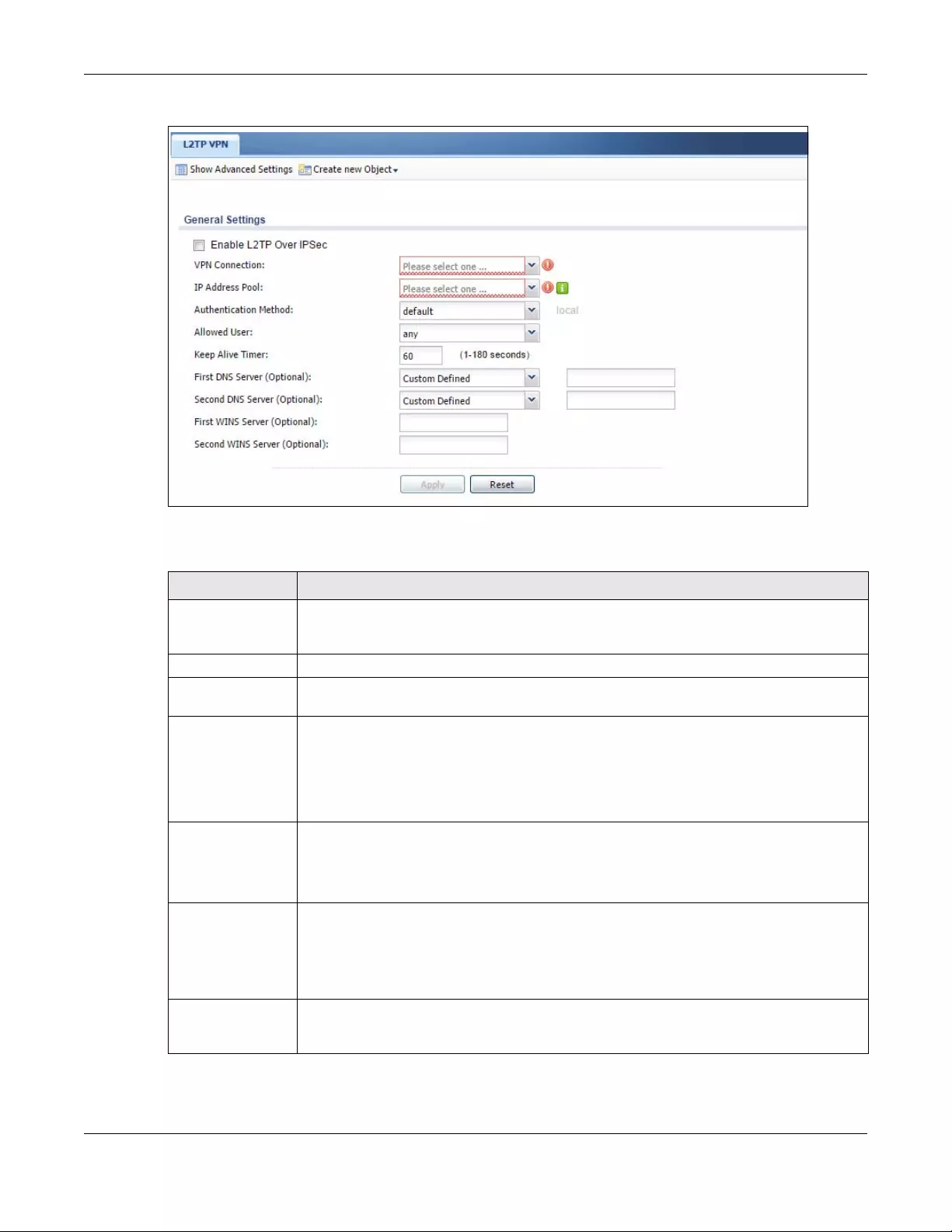
Chapter 26 L2TP VPN
ZyWALL/USG Series User’s Guide
441
Figure 311 Configuration > VPN > L2TP VPN
The following table describes the fields in this screen.
Table 178 Configuration > VPN > L2TP VPN
LABEL DESCRIPTION
Show Advanced
Settings / Hide
Advanced Settings
Click this button to display a greater or lesser number of configuration fields.
Create new Object Use to configure any new settings objects that you need to use in this screen.
Enable L2TP Over
IPSec
Use this field to turn the ZyWALL/USG’s L2TP VPN function on or off.
VPN Connection Select the IPSec VPN connection the ZyWALL/USG uses for L2TP VPN. All of the
configured VPN connections display here, but the one you use must meet the
requirements listed in IPSec Configuration Required for L2TP VPN on page 439.
Note: Modifying this VPN connection (or the VPN gateway that it uses) disconnects any
existing L2TP VPN sessions.
IP Address Pool Select the pool of IP addresses that the ZyWALL/USG uses to assign to the L2TP VPN
clients. Use Create new Object if you need to configure a new pool of IP addresses.
This should not conflict with any WAN, LAN, DMZ or WLAN subnet even if they are not in
use.
Authentication
Method
Select how the ZyWALL/USG authenticates a remote user before allowing access to the
L2TP VPN tunnel.
The authentication method has the ZyWALL/USG check a user’s user name and password
against the ZyWALL/USG’s local database, a remote LDAP, RADIUS, a Active Directory
server, or more than one of these.
Authentication
Server Certificate
Select the certificate to use to identify the ZyWALL/USG for L2TP VPN connections. You
must have certificates already configured in the My Cert ificates screen. The certificate is
used with the EAP, PEAP, and MSCHAPv2 authentication protocols.

Chapter 26 L2TP VPN
ZyWALL/USG Series User’s Guide
442
26.2.1 Example: L2TP and ZyWALL/USG Behind a NAT Router
If the ZyWALL/USG (Z) is behind a NAT router (N), then do the following for remote clients (C) to
access the network behind the ZyWALL/USG (Z) using L2TP over IPv4.
1Create an address object in Configuration > Object > Address for the WAN IP address of the
NAT router.
2Go to Configuration > VPN > IPSec VPN > VPN Connection and click Add for IPv4
Configuration to create a new VPN connection.
3Select Remote Access (Server Role) as the VPN scenario for the remote client.
Allowed User The remote user must log into the ZyWALL/USG to use the L2TP VPN tunnel.
Select a user or user group that can use the L2TP VPN tunnel. Use Create new O bject if
you need to configure a new user account. Otherwise, select any to allow any user with a
valid account and password on the ZyWALL/USG to log in.
Keep Alive Timer The ZyWALL/USG sends a Hello message after waiting this long without receiving any
traffic from the remote user. The ZyWALL/USG disconnects the VPN tunnel if the remote
user does not respond.
First DNS Server,
Second DNS
Server
Specify the IP addresses of DNS servers to assign to the remote users. You can specify
these IP addresses two ways.
Custom Defined - enter a static IP address.
From ISP - use the IP address of a DNS server that another interface received from its
DHCP server.
First WINS Server,
Second WINS
Server
The WINS (Windows Internet Naming Service) server keeps a mapping table of the
computer names on your network and the IP addresses that they are currently using.
Type the IP addresses of up to two WINS servers to assign to the remote users. You can
specify these IP addresses two ways.
Apply Click Apply to save your changes in the ZyWALL/USG.
Reset Click Reset to return the screen to its last-saved settings.
Table 178 Configuration > VPN > L2TP VPN (continued)
LABEL DESCRIPTION

Chapter 26 L2TP VPN
ZyWALL/USG Series User’s Guide
443
4Select the NAT router WAN IP address object as the Local Policy.
5Go to Configuration > VPN > L2TP VPN and select the VPN Connection just configured.

ZyWALL/USG Series User’s Guide
444
CHAPTER 27
BWM (Bandwidth Management)
27.1 Overview
Bandwidth management provides a convenient way to manage the use of various services on the
network. It manages general protocols (for example, HTTP and FTP) and applies traffic prioritization
to enhance the performance of delay-sensitive applications like voice and video.
27.1.1 What You Can Do in this Chapter
Use the BWM screens (see Section 27.2 on page 448) to control bandwidth for services passing
through the ZyWALL/USG, and to identify the conditions that define the bandwidth control.
27.1.2 What You Need to Know
When you allow a service, you can restrict the bandwidth it uses. It controls TCP and UDP traffic.
Use policy routes to manage other types of traffic (like ICMP).
Note: Bandwidth management in policy routes has priority over TCP and UDP traffic
policies.
If you want to use a service, make sure both the security policy allow the service’s packets to go
through the ZyWALL/USG.
Note: The ZyWALL/USG checks security policies before it checks bandwidth management
rules for traffic going through the ZyWALL/USG.
Bandwidth management examines every TCP and UDP connection passing through the ZyWALL/
USG. Then, you can specify, by port, whether or not the ZyWALL/USG continues to route the
connection.
BWM Type
The ZyWALL/USG supports three types of bandwidth management: Shared, Per user and Per-
Source-IP.
The Shared BWM type is selected by default in a bandwidth management rule. All matched taffic
shares the bandwidth configured in the rule.
If the BWM type is set to Per us er in a rule, each user that matches the rule can use up to the
configured bandwidth by his/her own.
Select the Per-Source-IP type when you want to set the maximum bandwidth for traffic from an
individual source IP address.
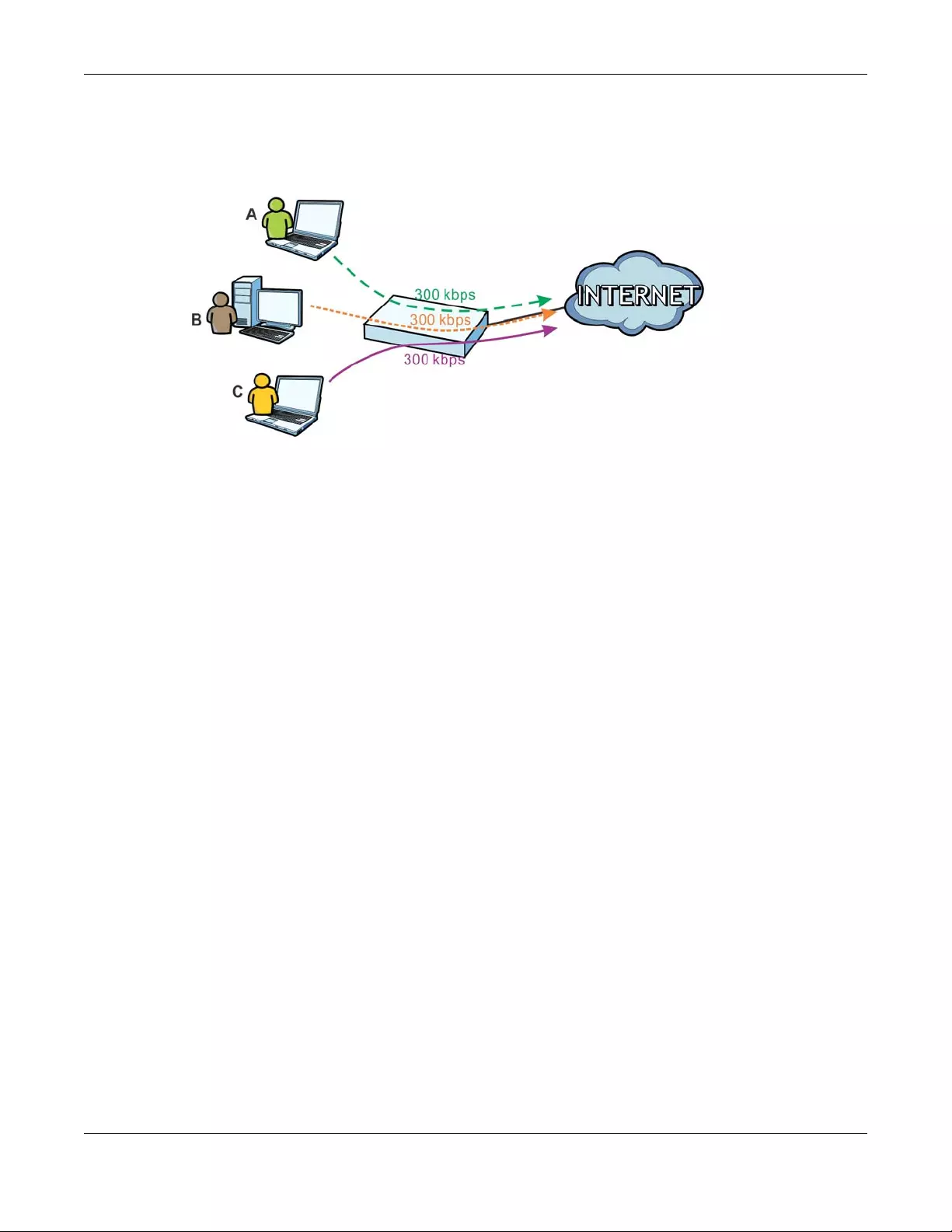
Chapter 27 BWM (Bandwidth Management)
ZyWALL/USG Series User’s Guide
445
In the following example, you configure a Per user bandwidth management rule for radius-users to
limit outgoing traffic to 300 kbs. Then all radius-users (A, B and C) can send 300 kbps of traffic.
DiffServ and DSCP Marking
QoS is used to prioritize source-to-destination traffic flows. All packets in the same flow are given
the same priority. CoS (class of service) is a way of managing traffic in a network by grouping
similar types of traffic together and treating each type as a class. You can use CoS to give different
priorities to different packet types.
DiffServ (Differentiated Services) is a class of service (CoS) model that marks packets so that they
receive specific per-hop treatment at DiffServ-compliant network devices along the route based on
the application types and traffic flow. Packets are marked with DiffServ Code Points (DSCPs)
indicating the level of service desired. This allows the intermediary DiffServ-compliant network
devices to handle the packets differently depending on the code points without the need to
negotiate paths or remember state information for every flow. In addition, applications do not have
to request a particular service or give advanced notice of where the traffic is going.
Connection and Packet Directions
Bandwidth management looks at the connection direction, that is, from which interface the
connection was initiated and to which interface the connection is going.
A connection has outbound and inbound packet flows. The ZyWALL/USG controls the bandwidth of
traffic of each flow as it is going out through an interface or VPN tunnel.
• The outbound traffic flows from the connection initiator to the connection responder.
• The inbound traffic flows from the connection responder to the connection initiator.
For example, a LAN1 to WAN connection is initiated from LAN1 and goes to the WAN.
• Outbound traffic goes from a LAN1 device to a WAN device. Bandwidth management is applied
before sending the packets out a WAN interface on the ZyWALL/USG.
• Inbound traffic comes back from the WAN device to the LAN1 device. Bandwidth management is
applied before sending the traffic out a LAN1 interface.
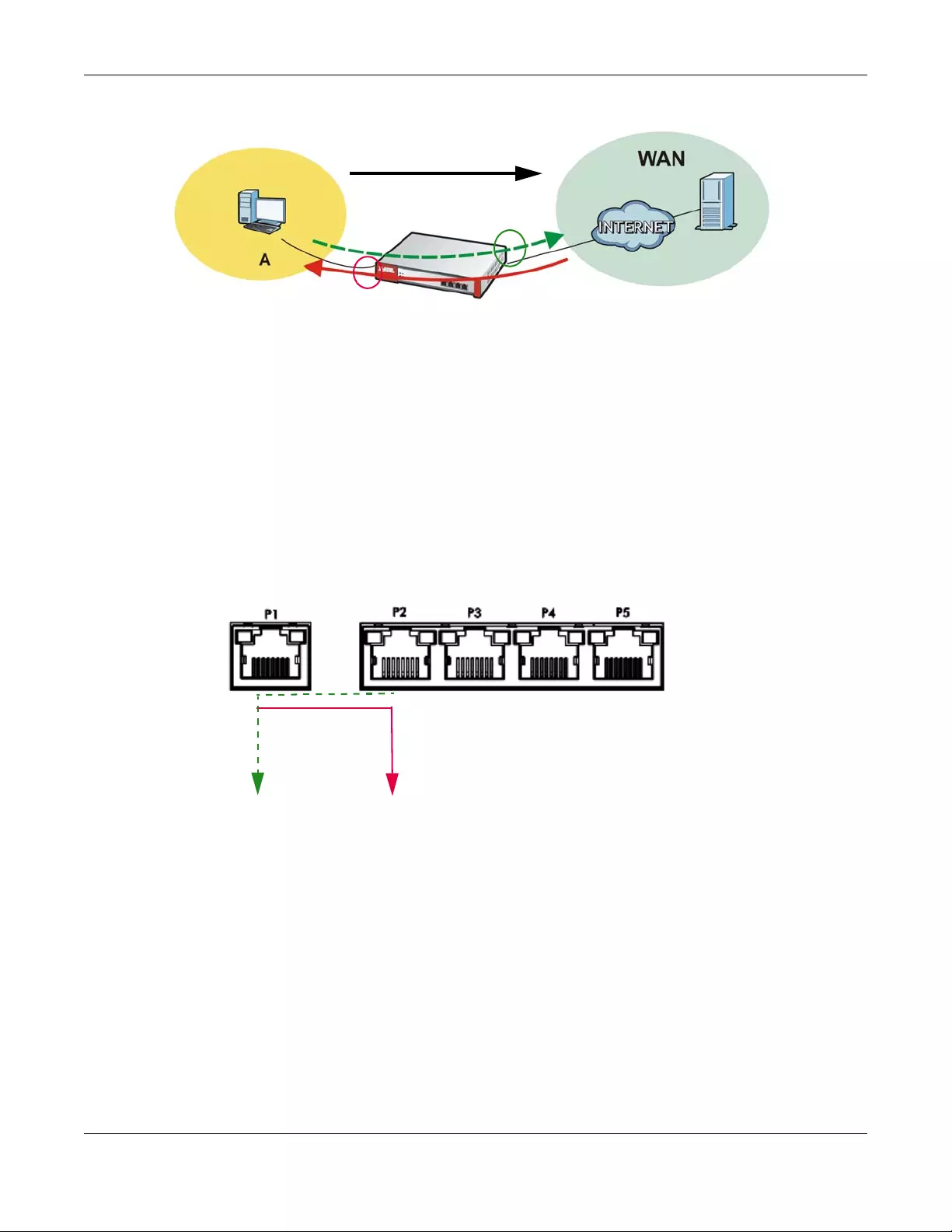
Chapter 27 BWM (Bandwidth Management)
ZyWALL/USG Series User’s Guide
446
Figure 312 LAN1 to WAN Connection and Packet Directions
Outbound and Inbound Bandwidth Limits
You can limit an application’s outbound or inbound bandwidth. This limit keeps the traffic from using
up too much of the out-going interface’s bandwidth. This way you can make sure there is bandwidth
for other applications. When you apply a bandwidth limit to outbound or inbound traffic, each
member of the out-going zone can send up to the limit. Take a LAN1 to WAN policy for example.
• Outbound traffic is limited to 200 kbps. The connection initiator is on the LAN1 so outbound
means the traffic traveling from the LAN1 to the WAN. Each of the WAN zone’s two interfaces can
send the limit of 200 kbps of traffic.
• Inbound traffic is limited to 500 kbs. The connection initiator is on the LAN1 so inbound means
the traffic traveling from the WAN to the LAN1.
Figure 313 LAN1 to WAN, Outbound 200 kbps, Inbound 500 kbps
Bandwidth Management Priority
• The ZyWALL/USG gives bandwidth to higher-priority traffic first, until it reaches its configured
bandwidth rate.
• Then lower-priority traffic gets bandwidth.
• The ZyWALL/USG uses a fairness-based (round-robin) scheduler to divide bandwidth among
traffic flows with the same priority.
• The ZyWALL/USG automatically treats traffic with bandwidth management disabled as priority 7
(the lowest priority).
Connection
BWM
BWM
Outbound
Inbound
LAN1
Inbound
Outbound
500 kbps
200 kbps
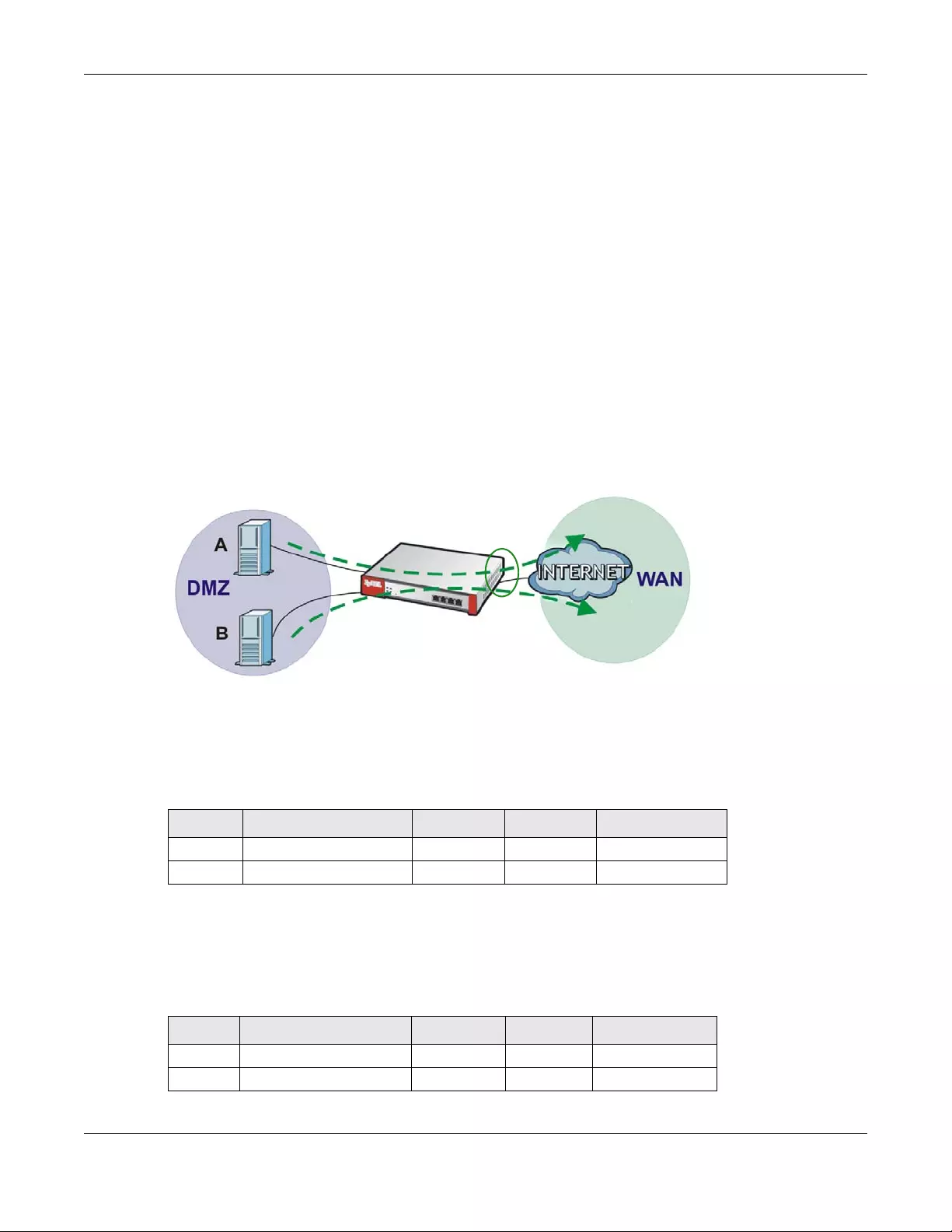
Chapter 27 BWM (Bandwidth Management)
ZyWALL/USG Series User’s Guide
447
Maximize Bandwidth Usage
Maximize bandwidth usage allows applications with maximize bandwidth usage enabled to “borrow”
any unused bandwidth on the out-going interface.
After each application gets its configured bandwidth rate, the ZyWALL/USG uses the fairness- based
scheduler to divide any unused bandwidth on the out-going interface amongst applications that
need more bandwidth and have maximize bandwidth usage enabled.
Unused bandwidth is divided equally. Higher priority traffic does not get a larger portion of the
unused bandwidth.
Bandwidth Management Behavior
The following sections show how bandwidth management behaves with various settings. For
example, you configure DMZ to WAN policies for FTP servers A and B. Each server tries to send
1000 kbps, but the WAN is set to a maximum outgoing speed of 1000 kbps. You configure policy A
for server A’s traffic and policy B for server B’s traffic.
Figure 314 Bandwidth Management Behavior
Configured Rate Effect
In the following table the configured rates total less than the available bandwidth and maximize
bandwidth usage is disabled, both servers get their configured rate.
Priority Effect
Here the configured rates total more than the available bandwidth. Because server A has higher
priority, it gets up to it’s configured rate (800 kbps), leaving only 200 kbps for server B.
Table 179 Configured Rate Effect
POLICY CONFIGURED RATE MAX. B. U. PRIORITY ACTUAL RATE
A 300 kbps No 1 300 kbps
B 200 kbps No 1 200 kbps
Table 180 Priority Effect
POLICY CONFIGURED RATE MAX. B. U. PRIORITY ACTUAL RATE
A 800 kbps Yes 1 800 kbps
B 1000 kbps Yes 2 200 kbps
1000 kbps
1000 kbps
BWM
1000 kbps
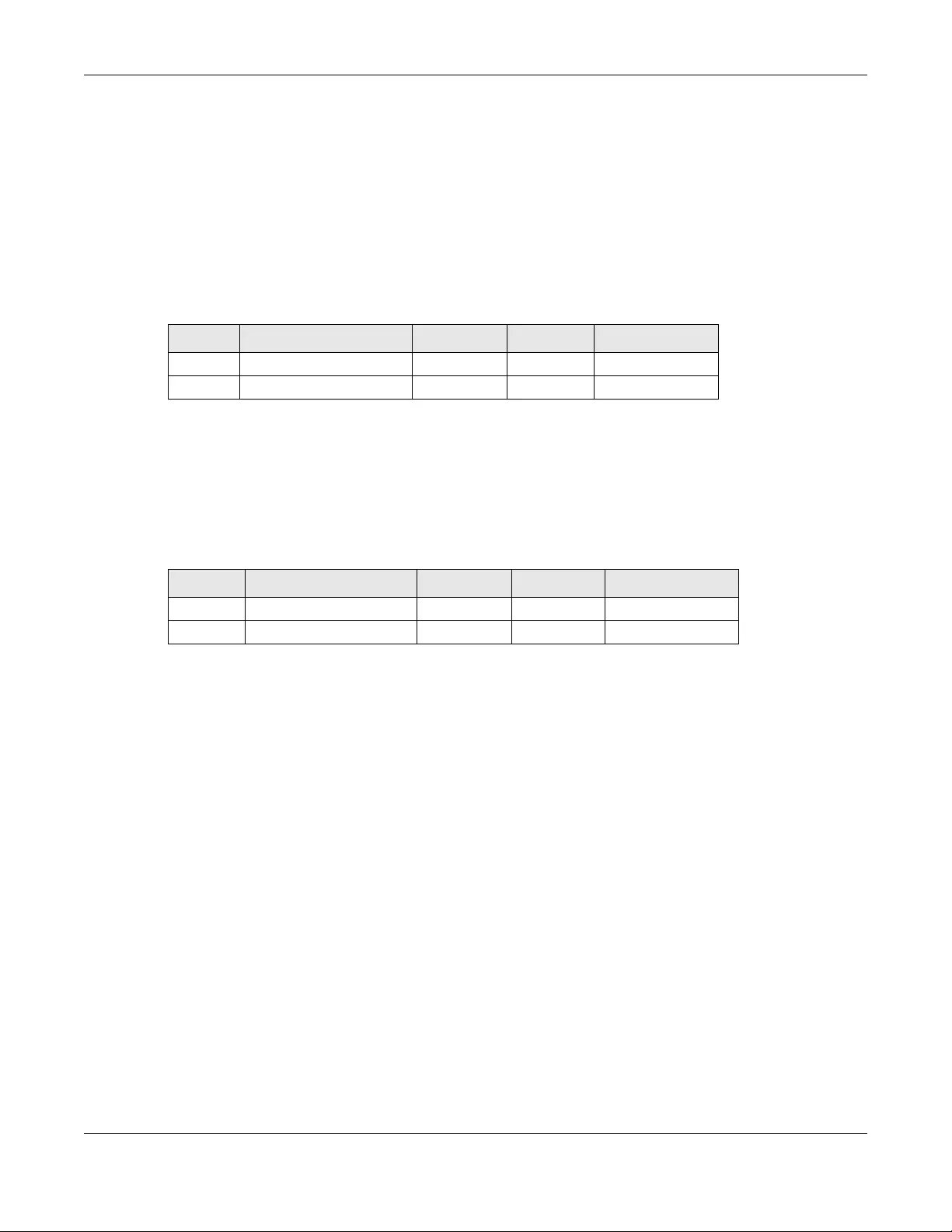
Chapter 27 BWM (Bandwidth Management)
ZyWALL/USG Series User’s Guide
448
Maximize Bandwidth Usage Effect
With maximize bandwidth usage enabled, after each server gets its configured rate, the rest of the
available bandwidth is divided equally between the two. So server A gets its configured rate of 300
kbps and server B gets its configured rate of 200 kbps. Then the ZyWALL/USG divides the
remaining bandwidth (1000 - 500 = 500) equally between the two (500 / 2 = 250 kbps for each).
The priority has no effect on how much of the unused bandwidth each server gets.
So server A gets its configured rate of 300 kbps plus 250 kbps for a total of 550 kbps. Server B
gets its configured rate of 200 kbps plus 250 kbps for a total of 450 kbps.
Priority and Over Allotment of Ban dwidth Effect
Server A has a configured rate that equals the total amount of available bandwidth and a higher
priority. You should regard extreme over allotment of traffic with different priorities (as shown here)
as a configuration error. Even though the ZyWALL/USG still attempts to let all traffic get through
and not be lost, regardless of its priority, server B gets almost no bandwidth with this configuration.
27.2 The Bandwidth Management Screen
The Bandwidth management screens control the bandwidth allocation for TCP and UDP traffic. You
can use source interface, destination interface, destination port, schedule, user, source, destination
information, DSCP code and service type as criteria to create a sequence of specific conditions,
similar to the sequence of rules used by firewalls, to specify how the ZyWALL/USG handles the
DSCP value and allocate bandwidth for the matching packets.
Click Configuration > BWM to open the following screen. This screen allows you to enable/disable
bandwidth management and add, edit, and remove user-defined bandwidth management policies.
The default bandwidth management policy is the one with the priority of “default”. It is the last
policy the ZyWALL/USG checks if traffic does not match any other bandwidth management policies
you have configured. You cannot remove, activate, deactivate or move the default bandwidth
management policy.
Table 181 Maximize Bandwidth Usage Effect
POLICY CONFIGURED RATE MAX. B. U. PRIORITY ACTUAL RATE
A 300 kbps Yes 1 550 kbps
B 200 kbps Yes 2 450 kbps
Table 182 Priority and Over Allotment of Bandwidth Effect
POLICY CONFIGURED RATE MAX. B. U. PRIORITY ACTUAL RATE
A 1000 kbps Yes 1 999 kbps
B 1000 kbps Yes 2 1 kbps

Chapter 27 BWM (Bandwidth Management)
ZyWALL/USG Series User’s Guide
449
Figure 315 Configuration > Bandwidth Management
The following table describes the labels in this screen. See Section 27.2.1 on page 451 for more
information as well.
Table 183 Configuration > Bandwidth Management
LABEL DESCRIPTION
Enable BWM Select this check box to activate management bandwidth.
Enable Highest
Bandwidth Priority
for SIP Traffic
Select this to maximize the throughput of SIP traffic to improve SIP-based VoIP call
sound quality. This has the ZyWALL/USG immediately send SIP traffic upon
identifying it. When this option is enabled the ZyWALL/USG ignores any other
application patrol rules for SIP traffic (so there is no bandwidth control for SIP traffic)
and does not record SIP traffic bandwidth usage statistics.
Add Click this to create a new entry. Select an entry and click Add to create a new entry
after the selected entry.
Edit Select an entry and click this to be able to modify it.
Remove Select an entry and click this to delete it.
Activate To turn on an entry, select it and click Activate.
Inactivate To turn off an entry, select it and click Inactivate.
Move To change an entry’s position in the numbered list, select it and click Move to display
a field to type a number for where you want to put that entry and press [ENTER] to
move the entry to the number that you typed.
Status The activate (light bulb) icon is lit when the entry is active and dimmed when the
entry is inactive. The status icon is not available for the default bandwidth
management policy.
Priority This field displays a sequential value for each bandwidth management policy and it is
not associated with a specific setting.
This field displays default for the default bandwidth management policy.
Description This field displays additional information about this policy.
BWM Type This field displays the below types of BWM:
•Shared, when the policy is set for all matched traffic
•Per User, when the policy is set for an individual user or a user group
•Per-Source-IP, when the policy is set for a source IP
User This is the type of user account to which the policy applies. If any displays, the policy
applies to all user accounts.
Schedule This is the schedule that defines when the policy applies. none means the policy
always applies.
Incoming Interface This is the source interface of the traffic to which this policy applies.
Outgoing Interface This is the destination interface of the traffic to which this policy applies.
Source This is the source address or address group for whom this policy applies. If any
displays, the policy is effective for every source.
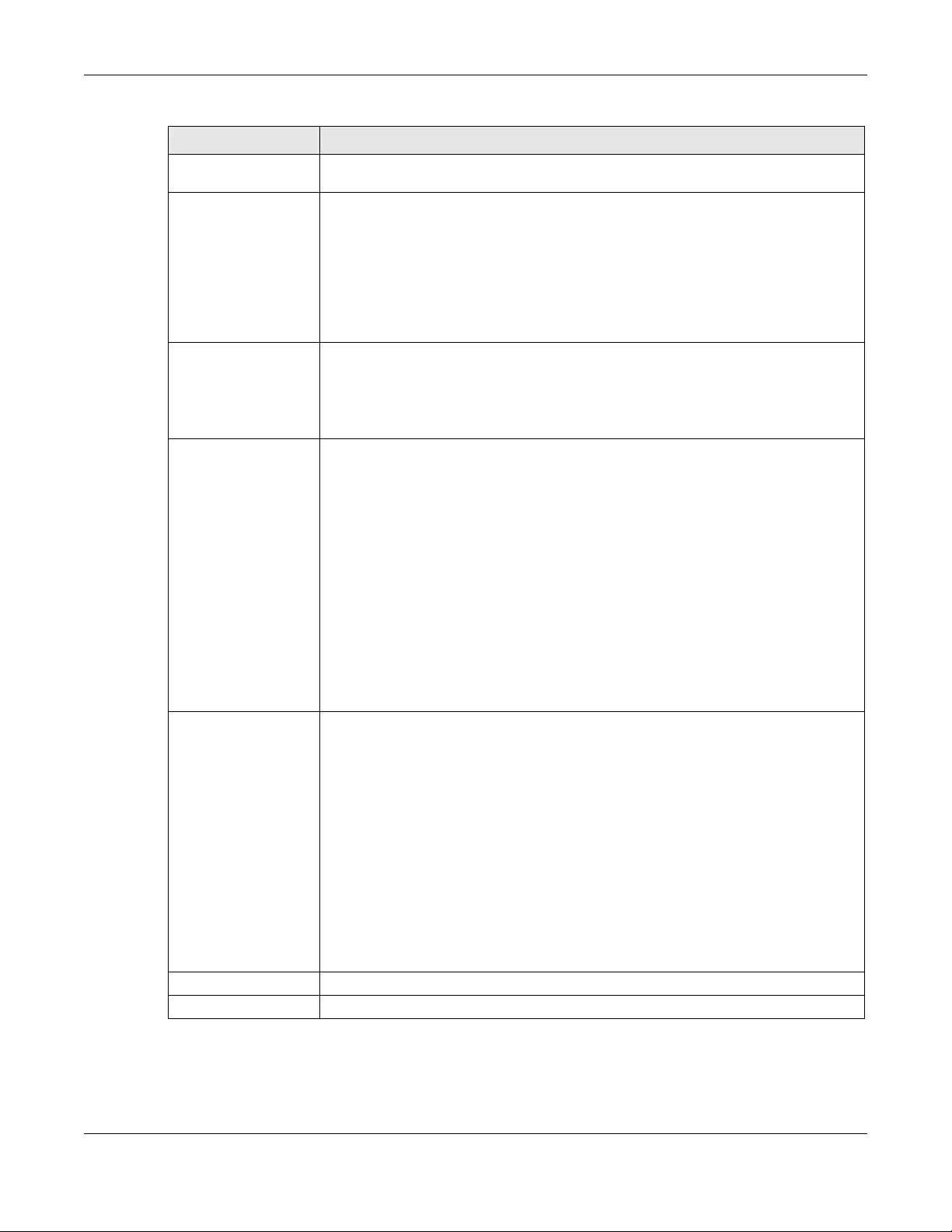
Chapter 27 BWM (Bandwidth Management)
ZyWALL/USG Series User’s Guide
450
Destination This is the destination address or address group for whom this policy applies. If any
displays, the policy is effective for every destination.
DSCP Code These are the DSCP code point values of incoming and outgoing packets to which this
policy applies. The lower the number the higher the priority with the exception of 0
which is usually given only best-effort treatment.
any means all DSCP value or no DSCP marker.
default means traffic with a DSCP value of 0. This is usually best effort traffic
The “af” options stand for Assured Forwarding. The number following the “af”
identifies one of four classes and one of three drop preferences.
Service Type App and the service name displays if you selected Application Object for the
service type. An Application Object is a pre-defined service.
Obj and the service name displays if you selected Serv ice Object for the service
type. A Service Object is a customized pre-defined service or another service.
Mouse over the service object name to view the corresponding IP protocol number.
BWM In/Pri/Out/Pri This field shows the amount of bandwidth the traffic can use.
In - This is how much inbound bandwidth, in kilobits per second, this policy allows
the matching traffic to use. Inbound refers to the traffic the ZyWALL/USG sends to a
connection’s initiator. If no displays here, this policy does not apply bandwidth
management for the inbound traffic.
Out - This is how much outgoing bandwidth, in kilobits per second, this policy allows
the matching traffic to use. Outbound refers to the traffic the ZyWALL/USG sends out
from a connection’s initiator. If no displays here, this policy does not apply bandwidth
management for the outbound traffic.
Pri - This is the priority for the incoming (the first Pri value) or outgoing (the second
Pri value) traffic that matches this policy. The smaller the number, the higher the
priority. Traffic with a higher priority is given bandwidth before traffic with a lower
priority. The ZyWALL/USG ignores this number if the incoming and outgoing limits
are both set to 0. In this case the traffic is automatically treated as being set to the
lowest priority (7) regardless of this field’s configuration.
DSCP Marking This is how the ZyWALL/USG handles the DSCP value of the incoming and outgoing
packets that match this policy.
In - Inbound, the traffic the ZyWALL/USG sends to a connection’s initiator.
Out - Outbound, the traffic the ZyWALL/USG sends out from a connection’s initiator.
If this field displays a DSCP value, the ZyWALL/USG applies that DSCP value to the
route’s outgoing packets.
preserve means the ZyWALL/USG does not modify the DSCP value of the route’s
outgoing packets.
default means the ZyWALL/USG sets the DSCP value of the route’s outgoing packets
to 0.
The “af” choices stand for Assured Forwarding. The number following the “af”
identifies one of four classes and one of three drop preferences.
Apply Click Apply to save your changes back to the ZyWALL/USG.
Reset Click Reset to return the screen to its last-saved settings.
Table 183 Configuration > Bandwidth Management
LABEL DESCRIPTION
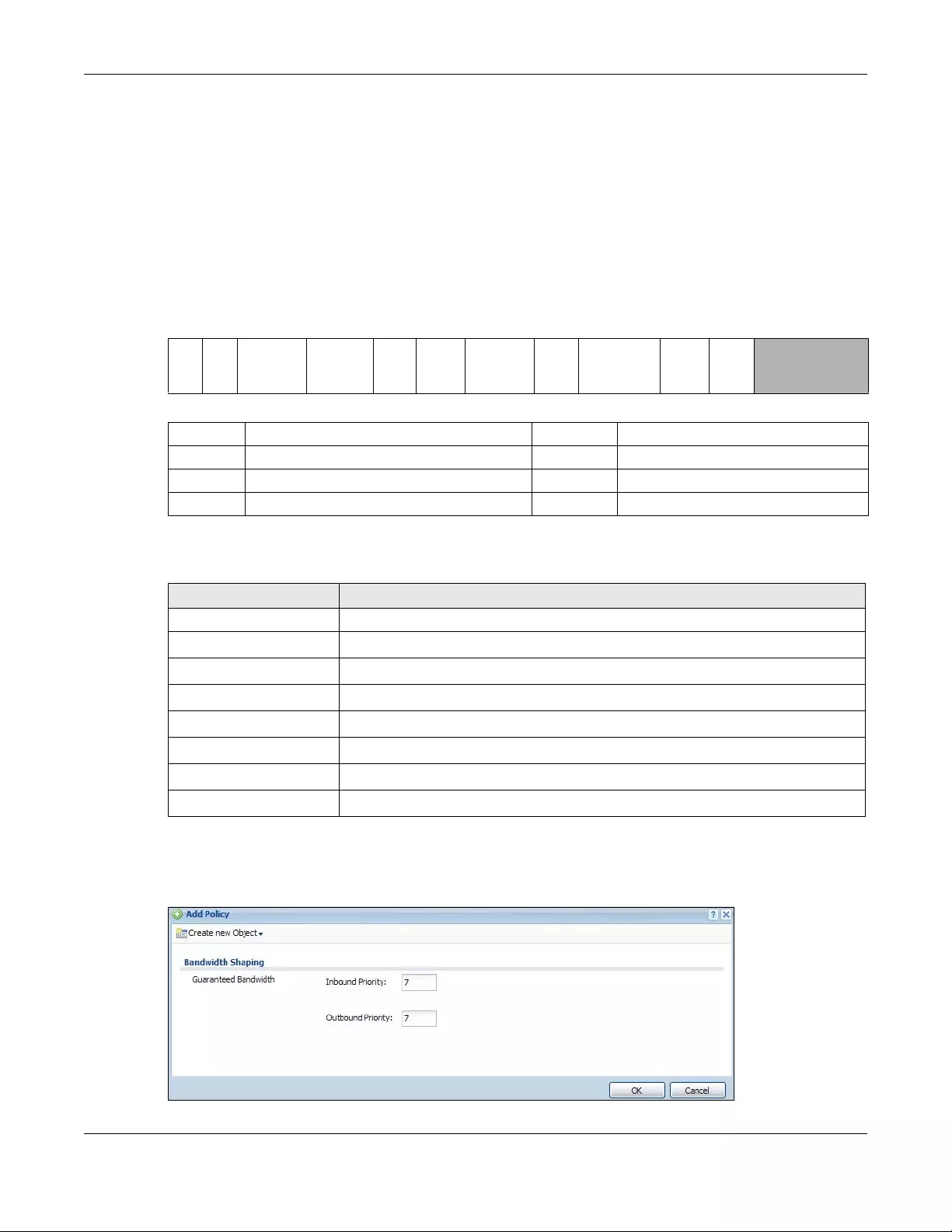
Chapter 27 BWM (Bandwidth Management)
ZyWALL/USG Series User’s Guide
451
27.2.1 The Bandwidth Management Add/Edit Screen
The Configuration > Bandwidth Manageme nt Add/Edit screen allows you to create a new
condition or edit an existing one.
802.1P Marking
Use 802.1P to prioritize outgoing traffic from a VLAN interface. The Priority Code is a 3-bit field
within a 802.1Q VLAN tag that’s used to prioritize associated outgoing VLAN traffic. "0" is the lowest
priority level and "7" is the highest.
The following table is a guide to types of traffic for the priority code.
To access this screen, go to the Configuration > Bandwidth Management screen (see Section
27.2 on page 448), and click either the Add icon or an Edit icon.
Figure 316 Configuration > Bandwidth Management > Edit (For the Default Policy)
Table 184 Single Tagged 802.1Q Frame Format
DA SA TPID Priority VID Len/Etype Data FCS IEEE 802.1Q
customer
tagged frame
Table 185 802.1Q Frame
DA Destination Address Priority 802.1p Priority
SA Source Address Len/Etype Length and type of Ethernet frame
TPID Tag Protocol IDentifier Data Frame data
VID VLAN ID FCS Frame Check Sequence
Table 186 Priority Code and Types of Traffic
PRIORITY TRAFFIC TYPES
0 (lowest) Background
1 Best Effort
2 Excellent Effort
3 Critical Applications
4 Video, less than 100 ms latency and jitter
5 Voice, less than 10 ms latency and jitter
6 Internetwork Control
7 (highest) Network Control

Chapter 27 BWM (Bandwidth Management)
ZyWALL/USG Series User’s Guide
452
Figure 317 Configuration > Bandwidth Management > Add/Edit
The following table describes the labels in this screen.
Table 187 Configuration > Bandwidth Management > Add/Edit
LABEL DESCRIPTION
Create new Object Use to configure any new settings objects that you need to use in this screen.
Configuration
Enable Select this check box to turn on this policy.
Description Enter a description of this policy. It is not used elsewhere. You can use alphanumeric
and ()+/:=?!*#@$_%- characters, and it can be up to 60 characters long.
Criteria Use this section to configure the conditions of traffic to which this policy applies.
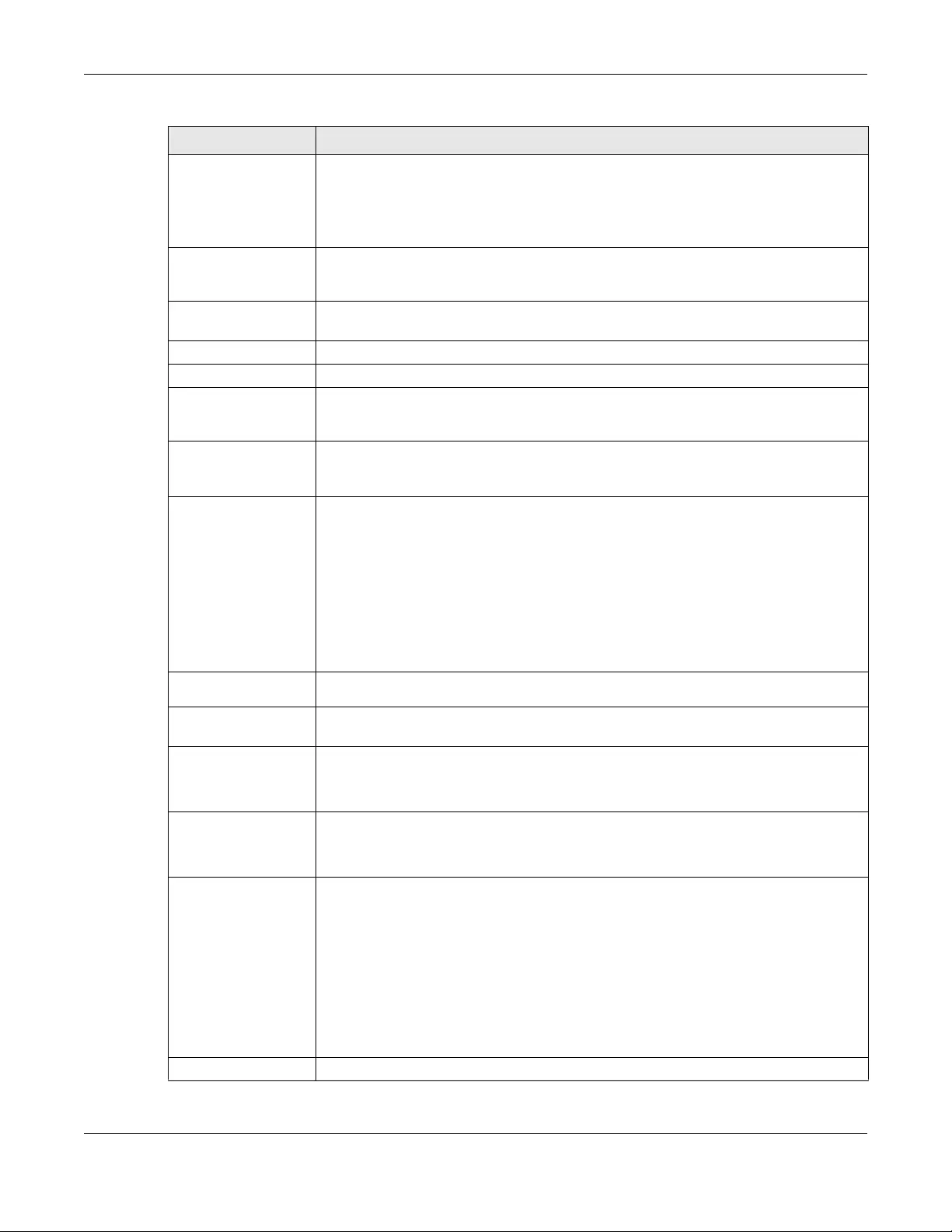
Chapter 27 BWM (Bandwidth Management)
ZyWALL/USG Series User’s Guide
453
BWM Type This field displays the below types of BWM rule:
• Shared, when the policy is set for all users
• Per User, when the policy is set for an individual user or a user group
• Per Source IP, when the policy is set for a source IP
User Select a user name or user group to which to apply the policy. Use Create new
Object if you need to configure a new user account. Select any to apply the policy for
every user.
Schedule Select a schedule that defines when the policy applies or select Create Object to
configure a new one. Otherwise, select none to make the policy always effective.
Incoming Interface Select the source interface of the traffic to which this policy applies.
Outgoing Interface Select the destination interface of the traffic to which this policy applies.
Source Select a source address or address group for whom this policy applies. Use Create
new Object if you need to configure a new one. Select any if the policy is effective for
every source.
Destination Select a destination address or address group for whom this policy applies. Use
Create new Object if you need to configure a new one. Select any if the policy is
effective for every destination.
DSCP Code Select a DSCP code point value of incoming packets to which this policy
route applies or select User Defined to specify another DSCP code point. The lower
the number the higher the priority with the exception of 0 which is usually given only
best-effort treatment.
any means all DSCP value or no DSCP marker.
default means traffic with a DSCP value of 0. This is usually best effort traffic
The “af” choices stand for Assured Forwarding. The number following the “af”
identifies one of four classes and one of three drop preferences.
User-Defined
DSCP Code Use this field to specify a custom DSCP code point.
Service Type Select Service Object or Application Object if you want a specific service (defined
in a service object) or application patrol service to which the policy applies.
Service Object This field is available if you selected Service Objec t as the service type.
Select a service or service group to identify the type of traffic to which this policy
applies. any means all services.
Application Object This field is available if you selected Application Object as the service type.
Select an application patrol service to identify the specific traffic to which this policy
applies.
DSCP Marking Set how the ZyWALL/USG handles the DSCP value of the incoming and outgoing
packets that match this policy. Inbound refers to the traffic the ZyWALL/USG sends to
a connection’s initiator. Outbound refers to the traffic the ZyWALL/USG sends out from
a connection’s initiator.
Select one of the pre-defined DSCP values to apply or select User Defined to specify
another DSCP value. The “af” choices stand for Assured Forwarding. The number
following the “af” identifies one of four classes and one of three drop preferences.
Select preserve to have the ZyWALL/USG keep the packets’ original DSCP value.
Select default to have the ZyWALL/USG set the DSCP value of the packets to 0.
Bandwidth Shaping Configure these fields to set the amount of bandwidth the matching traffic can use.
Table 187 Configuration > Bandwidth Management > Add/Edit
LABEL DESCRIPTION
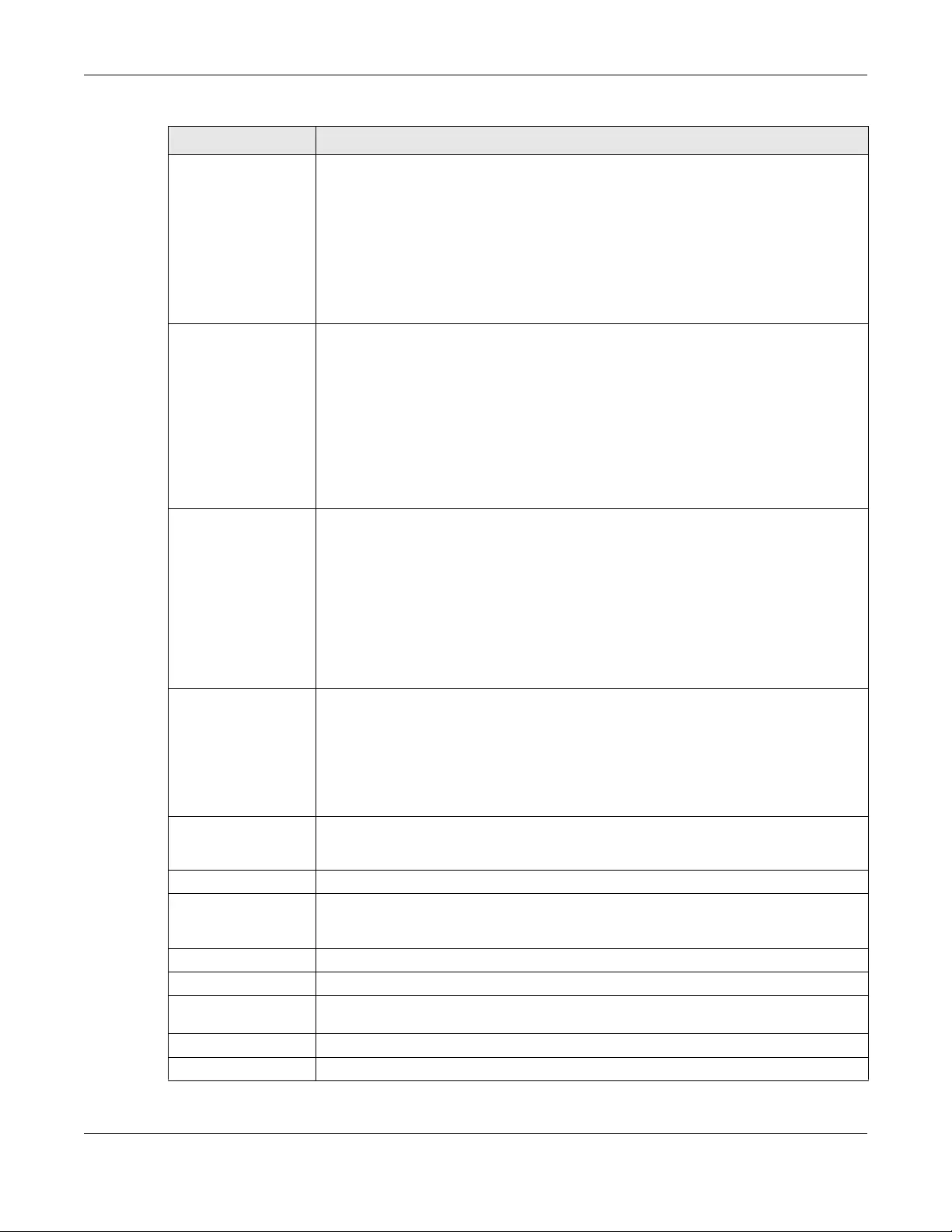
Chapter 27 BWM (Bandwidth Management)
ZyWALL/USG Series User’s Guide
454
Inbound kbps Type how much inbound bandwidth, in kilobits per second, this policy allows the traffic
to use. Inbound refers to the traffic the ZyWALL/USG sends to a connection’s initiator.
If you enter 0 here, this policy does not apply bandwidth management for the
matching traffic that the ZyWALL/USG sends to the initiator. Traffic with bandwidth
management disabled (inbound and outbound are both set to 0) is automatically
treated as the lowest priority (7).
If the sum of the bandwidths for routes using the same next hop is higher than the
actual transmission speed, lower priority traffic may not be sent if higher priority
traffic uses all of the actual bandwidth.
Outbound kbps Type how much outbound bandwidth, in kilobits per second, this policy allows the
traffic to use. Outbound refers to the traffic the ZyWALL/USG sends out from a
connection’s initiator.
If you enter 0 here, this policy does not apply bandwidth management for the
matching traffic that the ZyWALL/USG sends out from the initiator. Traffic with
bandwidth management disabled (inbound and outbound are both set to 0) is
automatically treated as the lowest priority (7).
If the sum of the bandwidths for routes using the same next hop is higher than the
actual transmission speed, lower priority traffic may not be sent if higher priority
traffic uses all of the actual bandwidth.
Priority This field displays when the inbound or outbound bandwidth management is not set to
0. Enter a number between 1 and 7 to set the priority for traffic that matches this
policy. The smaller the number, the higher the priority.
Traffic with a higher priority is given bandwidth before traffic with a lower priority.
The ZyWALL/USG uses a fairness-based (round-robin) scheduler to divide bandwidth
between traffic flows with the same priority.
The number in this field is ignored if the incoming and outgoing limits are both set to
0. In this case the traffic is automatically treated as being set to the lowest priority (7)
regardless of this field’s configuration.
Maximize
Bandwidth Usage This field displays when the inbound or outbound bandwidth management is not set to
0 and the BW M Type is set to Shared. Enable maximize bandwidth usage to let the
traffic matching this policy “borrow” all unused bandwidth on the out-going interface.
After each application or type of traffic gets its configured bandwidth rate, the
ZyWALL/USG uses the fairness-based scheduler to divide any unused bandwidth on
the out-going interface among applications and traffic types that need more
bandwidth and have maximize bandwidth usage enabled.
Maximum If you did not enable Maximize Bandwidth Usage, then type the maximium unused
bandwidth that traffic matching this policy is allowed to “borrow” on the out-going
interface (in Kbps), here.
802.1P Marking Use 802.1P to prioritize outgoing traffic from a VLAN interface.
Priority Code This is a 3-bit field within a 802.1Q VLAN tag that’s used to prioritize associated
outgoing VLAN traffic. "0" is the lowest priority level and "7" is the highest. See Table
186 on page 451. The setting configured here overwrites existing priority settings.
Interface Choose a VLAN interface to which to apply the priority level for matching frames.
Related Setting
Log Select whether to have the ZyWALL/USG generate a log (log), log and alert (log
alert) or neither (no) when any traffic matches this policy.
OK Click OK to save your changes back to the ZyWALL/USG.
Cancel Click Cancel to exit this screen without saving your changes.
Table 187 Configuration > Bandwidth Management > Add/Edit
LABEL DESCRIPTION
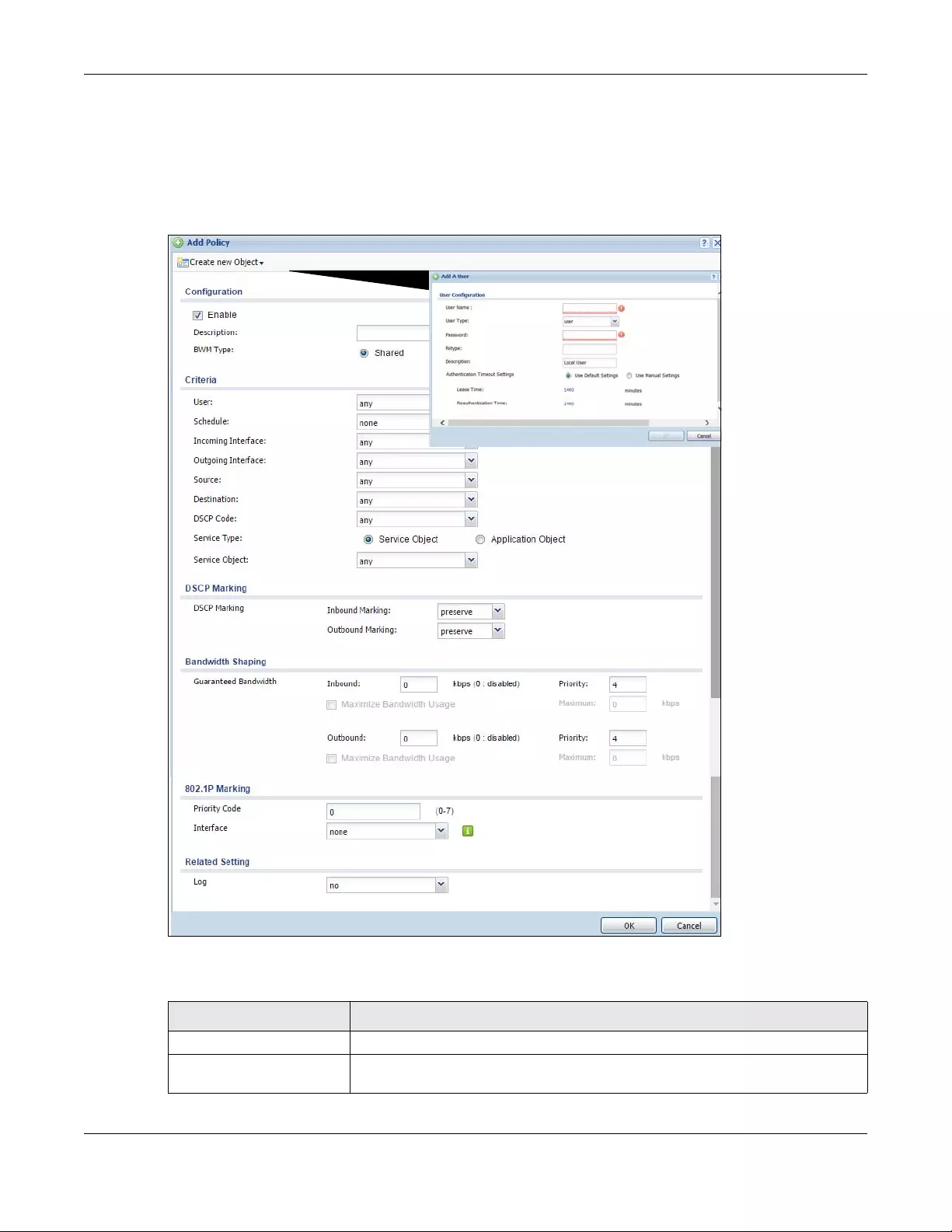
Chapter 27 BWM (Bandwidth Management)
ZyWALL/USG Series User’s Guide
455
27.2.1.1 Adding Objects for the BWM Policy
Objects are parameters to which the Policy rules are built upon. There are three kinds of objects
you can add/edit for the BWM policy, they are User, Schedule and Address objects. Click
Configuration > BWM > Add > Create New Object > Add User to see the following screen.
Figure 318 Configuration >BWM > Create New Object > Add User
The following table describes the fields in the above screen.
Table 188 Configuration > BWM > Create New Object > Add User
LABEL DESCRIPTION
User Name Type a user or user group object name of the rule.
User Type Select a user type from the drop down menu. The user types are Admin, Limited
admin, User, Guest, Ext-user, Ext-group-user.

Chapter 27 BWM (Bandwidth Management)
ZyWALL/USG Series User’s Guide
456
Password Type a password for the user object. The password can consist of alphanumeric
characters, the underscore, and some punctuation marks (+-/*= :; .! @$&%#~
‘ \ () ), and it can be up to eight characters long.
Retype Retype the password to confirm.
Description Enter a description for this user object. It is not used elsewhere. You can use
alphanumeric and ()+/:=?!*#@$_%- characters, and it can be up to 60
characters long.
Authentication Timeout
Settings
Choose either Use Default setting option, which shows the default Lease Time
of 1,440 minutes and Reauthentication Time of 1,440 minutes or you can enter
them manually by choosing Use Manual Settings option.
Lease Time This shows the Lease Time setting for the user, by default it is 1,440 minutes.
Reauthentication Time This shows the Reauthentication Time for the user, by default it is 1,440
minutes.
OK Click OK to save the setting.
Cancel Click Cancel to abandon this screen.
Table 188 Configuration > BWM > Create New Object > Add User
LABEL DESCRIPTION
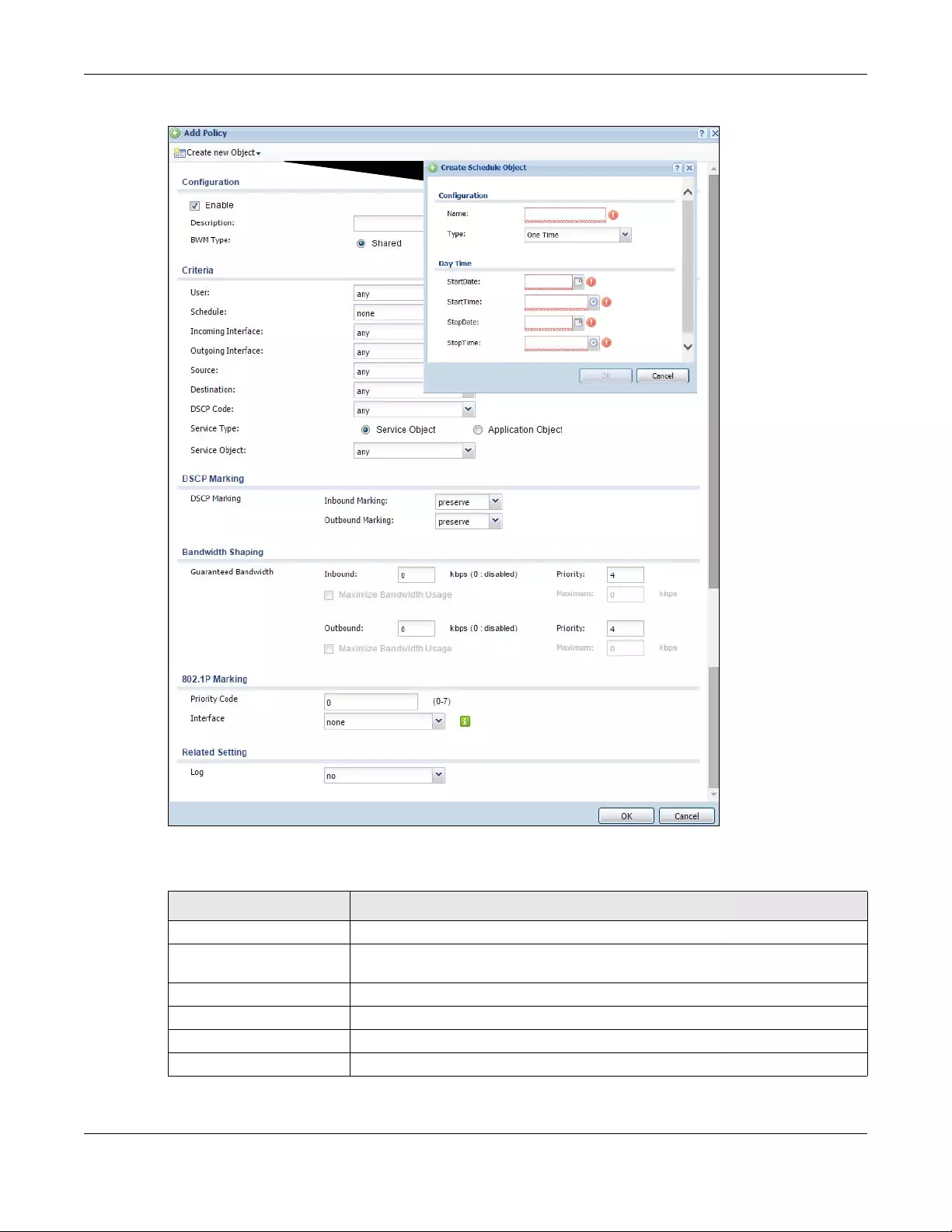
Chapter 27 BWM (Bandwidth Management)
ZyWALL/USG Series User’s Guide
457
Figure 319 Configuration > BWM > Create New Object > Add Schedule
The following table describes the fields in the above screen.
Table 189 Configuration > BWM > Create New Object > Add Schedule
LABEL DESCRIPTION
Name Enter a name for the schedule object of the rule.
Type Select an option from the drop down menu for the schedule object. It will show
One Time or Recurring.
Start Date Click the icon menu on the right to choose a Start Date for the schedule object.
Start Time Click the icon menu on the right to choose a Start Time for the schedule object.
Stop Date Click the icon menu on the right to choose a Stop Date for schedule object.
Stop Time Click the icon menu on the right to choose a Stop Time for the schedule object.

Chapter 27 BWM (Bandwidth Management)
ZyWALL/USG Series User’s Guide
458
Figure 320 Configuration > BWM > Create New Object > Add Address
The following table describes the fields in the above screen.
Table 190 Configuration > BWM > Create New Object > Add Address
LABEL DESCRIPTION
Name Enter a name for the Address object of the rule.
Address Type Select an Address Type from the drop down menu on the right. The Address
Types are Host, Range, Subnet, Interface IP, Interface Subnet, and Interface
Gateway.
IP Address Enter an IP address for the Address object.
OK Click OK to save the setting.
Cancel Click Cancel to abandon the setting.

ZyWALL/USG Series User’s Guide
459
CHAPTER 28
Application Patrol
28.1 Overview
Application patrol provides a convenient way to manage the use of various applications on the
network. It manages general protocols (for example, HTTP and FTP) and instant messenger (IM),
peer-to-peer (P2P), Voice over IP (VoIP), and streaming (RSTP) applications. You can even control
the use of a particular application’s individual features (like text messaging, voice, video
conferencing, and file transfers). You can also configure bandwidth management with application
patrol in the Configuration > BWM screen for traffic prioritization to enhance the performance of
delay-sensitive applications like voice and video.
28.1.1 What You Can Do in this Chapter
•Use the Profile summary screen (see Section 28.2 on page 460) to view license registration and
signature information.
•Use the Profile Add/Edit screens (see Section 28.2 on page 460) to set actions for application
categories and for specific applications within the category.
28.1.2 What You Need to Know
If you want to use a service, make sure both the Security Policy and application patrol allow the
service’s packets to go through the ZyWALL/USG.
Note: The ZyWALL/USG checks secure policies before it checks application patrol rules for
traffic going through the ZyWALL/USG.
Application patrol examines every TCP and UDP connection passing through the ZyWALL/USG and
identifies what application is using the connection. Then, you can specify whether or not the
ZyWALL/USG continues to route the connection. Traffic not recognized by the application patrol
signatures is ignored.
Application Profiles & Policies
An application patrol profile is a group of categories of application patrol signatures. For each
profile, you can specify the default action the ZyWALL/USG takes once a packet matches a
signature (forward, drop, or reject a service’s connections and/or create a log alert).
Use policies to link profiles to traffic flows based on criteria such as source zone, destination zone,
source address, destination address, schedule, user.

Chapter 28 Application Patrol
ZyWALL/USG Series User’s Guide
460
Classification of Applications
There are two ways the ZyWALL/USG can identify the application. The first is called auto. The
ZyWALL/USG looks at the IP payload (OSI level-7 inspection) and attempts to match it with known
patterns for specific applications. Usually, this occurs at the beginning of a connection, when the
payload is more consistent across connections, and the ZyWALL/USG examines several packets to
make sure the match is correct. Before confirnation, packets are forwarded by App Patrol with no
action taken. The number of packets inspected before confirmation varies by signature.
Note: The ZyWALL/USG allows the first eight packets to go through the security policy,
regardless of the application patrol policy for the application. The ZyWALL/USG
examines these first eight packets to identify the application.
The second approach is called service ports. The ZyWALL/USG uses only OSI level-4 information,
such as ports, to identify what application is using the connection. This approach is available in case
the ZyWALL/USG identifies a lot of “false positives” for a particular application.
Custom Ports for SIP and the SIP ALG
Configuring application patrol to use custom port numbers for SIP traffic also configures the SIP
ALG to use the same port numbers for SIP traffic. Likewise, configuring the SIP ALG to use custom
port numbers for SIP traffic also configures application patrol to use the same port numbers for SIP
traffic.
Finding Out More
• You must configure services in Objects > Application.
•See Configuration > BWM chapter for detailed information on bandwidth management.
28.2 Application Patrol Profile
Use the application patrol Profile screens to customize action and log settings for a group of
application patrol signatures. You then link a profile to a policy.Use this screen to create an
application patrol profile, and view signature information. It also lists the registration status and
details about the signature set the ZyWALL/USG is using.
Note: You must register for the IDP/AppPatrol signature service (at least the trial) before
you can use it.
A profile is an application object(s) or application group(s) that has customized action and log
settings.
Click Configuration > UTM Profile > App Patrol > Profile to open the following screen.
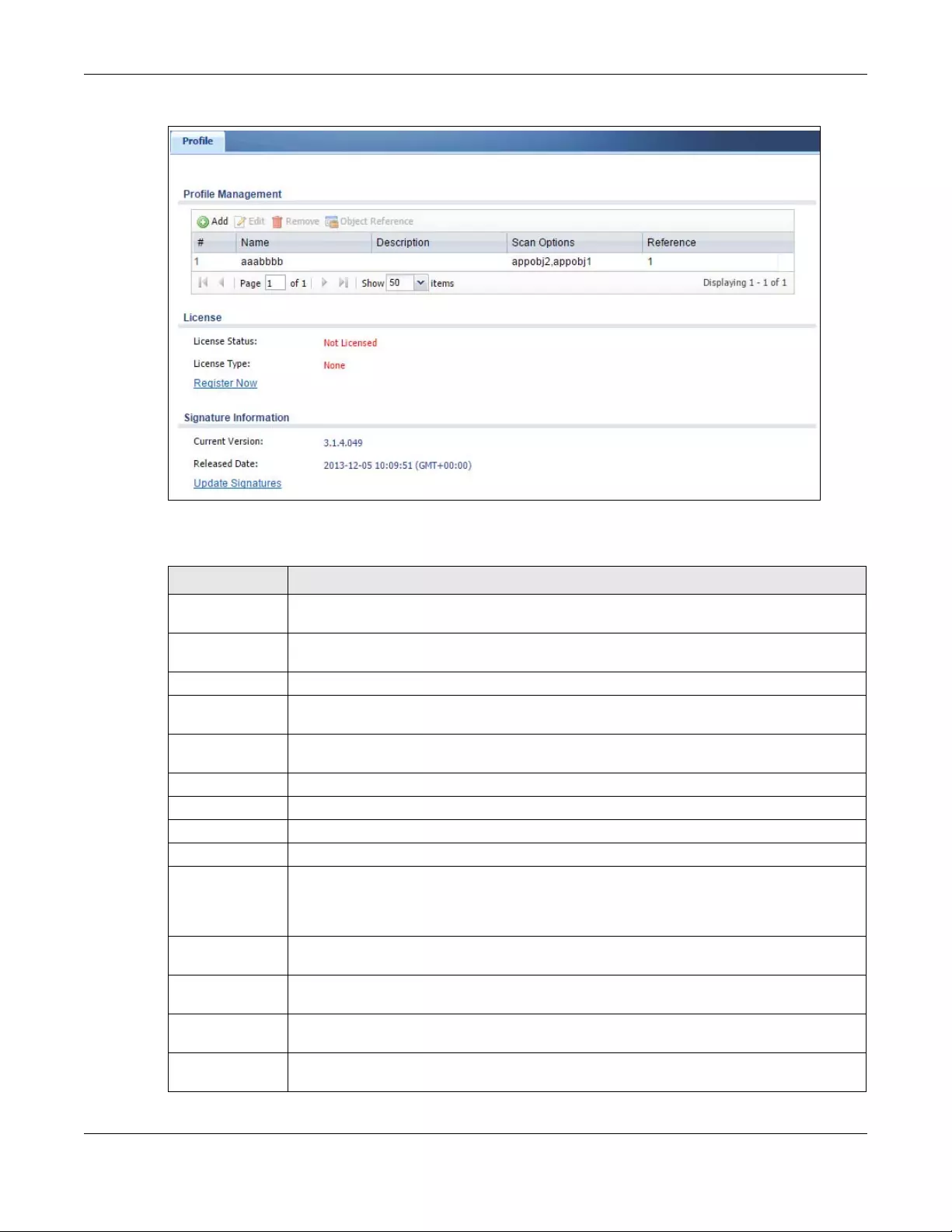
Chapter 28 Application Patrol
ZyWALL/USG Series User’s Guide
461
Figure 321 Configuration > UTM Profile > App Patrol > Profile
The following table describes the labels in this screen.
Table 191 Configuration > UTM Profile > App Patrol > Profile
LABEL DESCRIPTION
Add Click this to create a new entry. Select an entry and click Add to create a new entry after
the selected entry.
Edit Double-click an entry or select it and click Edit to open a screen where you can modify the
entry’s settings.
Remove Select an entry and click Remove to delete the selected entry.
Object Reference Select an entry and click Object References to open a screen that shows which settings
use the entry. Click Refresh to update information on this screen.
# This field is a sequential value showing the number of the profile. The profile order is not
important.
Name This displays the name of the profile created.
Description This displays the description of the App Patrol Profile.
Scan Option This field displays the scan options from the App Patrol profile.
Reference This displays the number of times an object reference is used in a profile.
License You need to create an account at myZyXEL.com, register your ZyWALL/USG and then
subscribe for App Patrol in order to be able to download new packet inspection signatures
from myZyXEL.com. There’s an initial free trial period for App Patrol after which you must
pay to subscribe to the service. See the Registration chapter for details.
License Status Licensed, Not Licensed or Expired indicates whether you have subscribed for App Patrol
services or not or your registration has expired.
License Type This field shows Trial, Standard or None depending on whether you subscribed to the
App Patrol trial, bought an iCard for App Patrol service or neither.
Signature
Information
The following fields display information on the current signature set that the ZyWALL/USG
is using.
Current Version This field displays the App Patrol signature set version number. This number gets larger as
the set is enhanced.
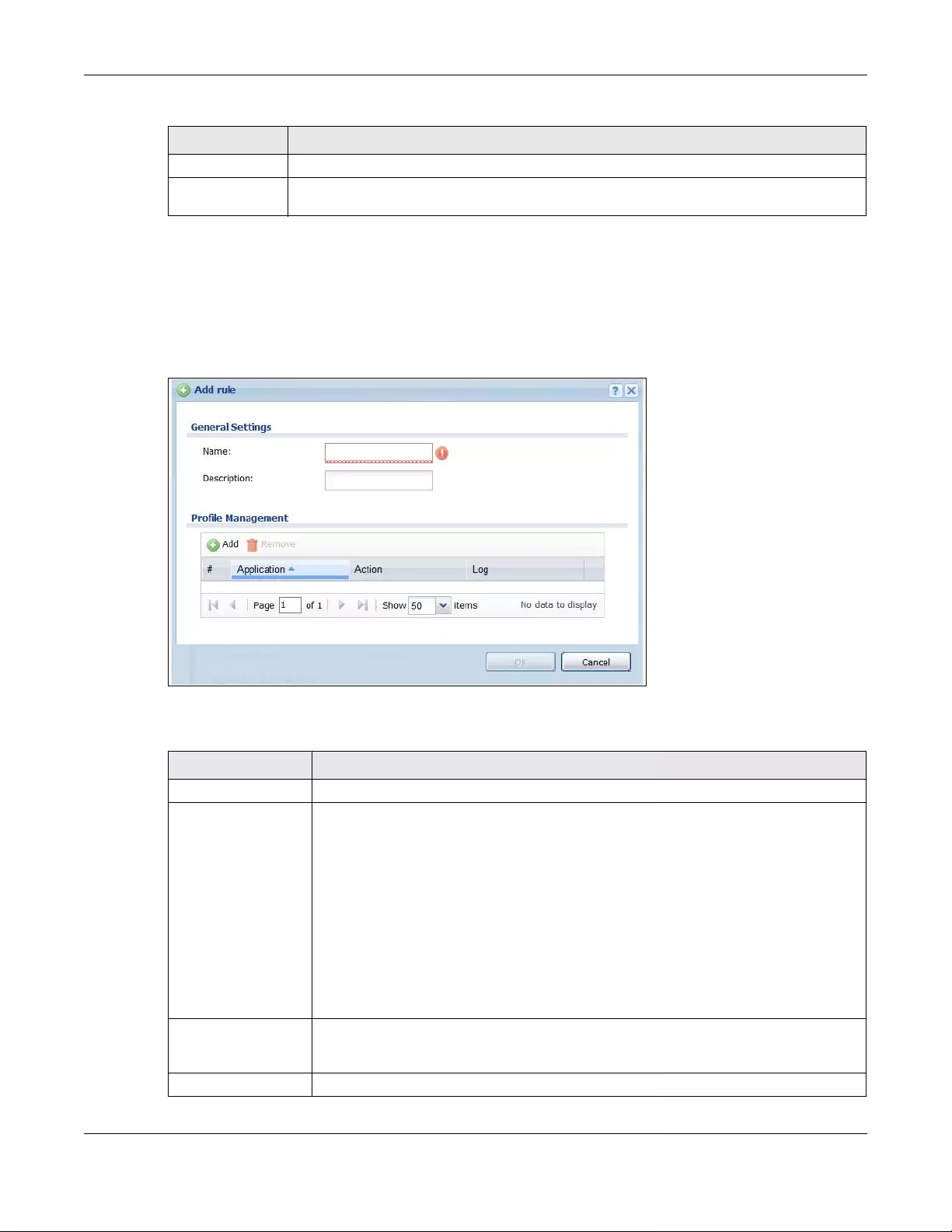
Chapter 28 Application Patrol
ZyWALL/USG Series User’s Guide
462
28.2.1 The Application Patrol Profile Add/Edit Screen
Use this screen to configure profile settings. Click Configuration > UTM Profile > App Patrol >
Profile, then click Add to create a new profile rule or click an existing profile and click Edit (or
double-click it) to open the following screen.
Figure 322 Configuration > UTM Profile > App Patrol > Profile > Add/Edit
The following table describes the labels in this screen.
Released Date This field displays the date and time the set was released.
Update
Signatures
Click this link to go to the screen you can use to download signatures from the update
server.
Table 191 Configuration > UTM Profile > App Patrol > Profile
LABEL DESCRIPTION
Table 192 Configuration > UTM Profile > App Patrol > Profile > Add/Edit
LABEL DESCRIPTION
General Settings
Name Type the name of the profile. You may use 1-31 alphanumeric characters,
underscores(_), or dashes (-), but the first character cannot be a number. This value is
case-sensitive. These are valid, unique profile names:
• MyProfile
• mYProfile
• Mymy12_3-4
These are invalid profile names:
•1mYProfile
•My Profile
• MyProfile?
• Whatalongprofilename123456789012
Description Type a description for the profile rule to help identify the purpose of rule. You may use
1-31 alphanumeric characters, underscores (_), or dashes (-), but the first character
cannot be a number. This value is case-sensitive. This field is optional.
Profile Management

Chapter 28 Application Patrol
ZyWALL/USG Series User’s Guide
463
28.2.2 The Application Patrol Profile Rule Add Application Screen
Click Add or Edit under Profile Management in the previous screen to display the following
screen.
Figure 323 Configuration > UTM Profile > App Patrol > Profile > Profile Management > Add/Edit
The following table describes the labels in this screen.
Add Click this to create a new entry. Select an entry and click Add to create a new entry
after the selected entry.
Remove Select an entry and click Remove to delete the selected entry.
# This field is a sequential value showing the number of the profile. The profile order is
not important.
Application Thie field displays the application name of the policy.
Action Select the default action for all signatures in this category.
forward - the ZyWALL/USG routes packets that matches these signatures.
Drop - the ZyWALL/USG silently drops packets that matches these signatures without
notification.
Reject - the ZyWALL/USG drops packets that matches these signatures and sends
notification.
Log Select whether to have the ZyWALL/USG generate a log (log), log and alert (log
alert) or neither (no) by default when traffic matches a signature in this category.
OK A profile consists of separate category editing screens. If you want to configure just
one category for a profile, click OK to save your settings to the ZyWALL/USG,
complete the profile and return to the profile summary page.
Cancel Click Cancel to return to the profile summary page without saving any changes.
Table 192 Configuration > UTM Profile > App Patrol > Profile > Add/Edit (continued)
LABEL DESCRIPTION
Table 193 Configuration > UTM Profile > App Patrol > Profile > Profile Management > Add/Edit
LABEL DESCRIPTION
General Settings
Application Select an application to apply the policy.
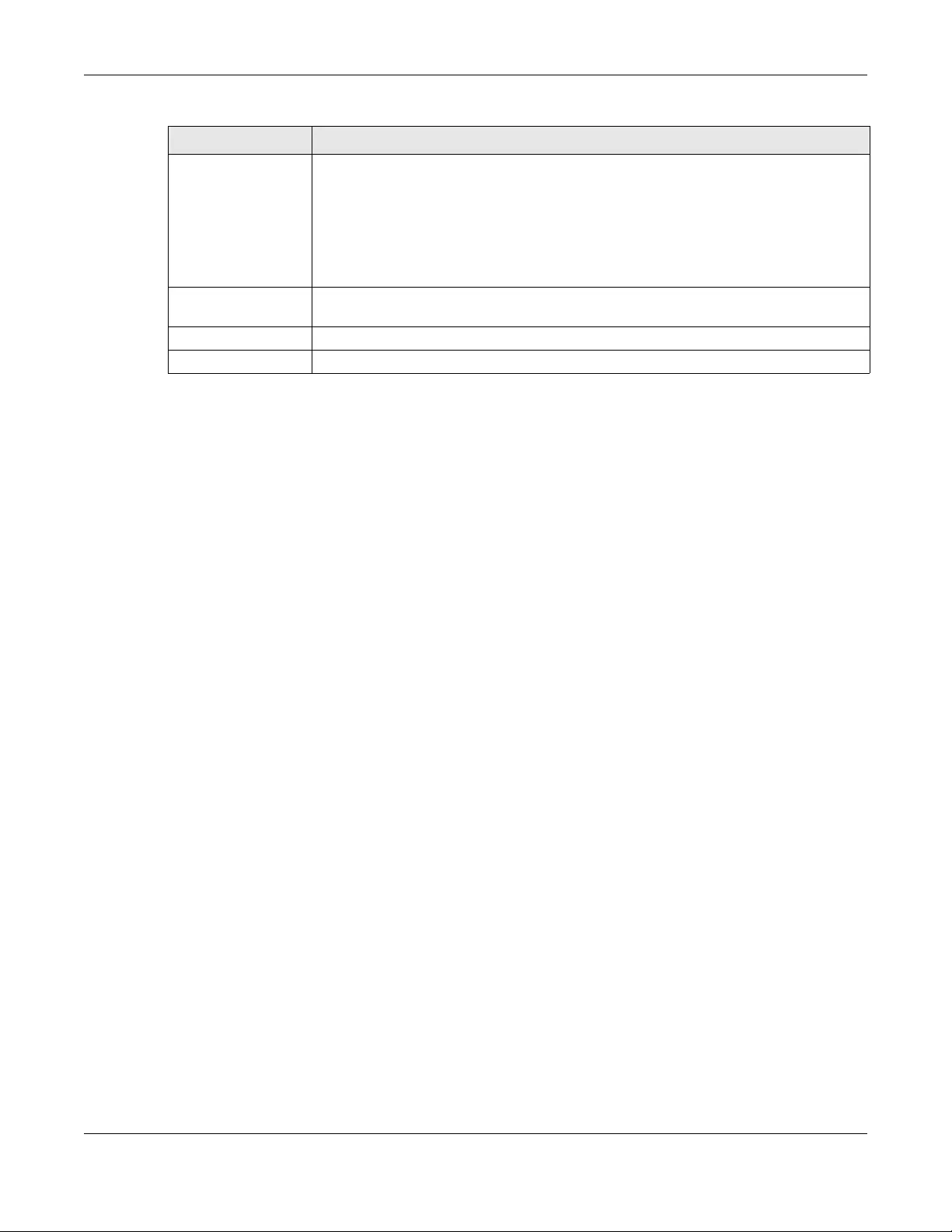
Chapter 28 Application Patrol
ZyWALL/USG Series User’s Guide
464
Action Select the default action for all signatures in this category.
forward - the ZyWALL/USG routes packets that matches these signatures.
Drop - the ZyWALL/USG silently drops packets that matches these signatures without
notification.
Reject - the ZyWALL/USG drops packets that matches these signatures and sends
notification.
Log Select whether to have the ZyWALL/USG generate a log (log), log and alert (log alert)
or neither (no) by default when traffic matches a signature in this category.
OK Click OK to save your settings to the ZyWALL/USG.
Cancel Click Cancel to return to the profile summary page without saving any changes.
Table 193 Configuration > UTM Profile > App Patrol > Profile > Profile Management > Add/Edit
LABEL DESCRIPTION

ZyWALL/USG Series User’s Guide
465
CHAPTER 29
Content Filtering
29.1 Overview
Use the content filtering feature to control access to specific web sites or web content.
29.1.1 What You Can Do in this Chapter
•Use the Filter Profile screens (Section Figure 325 on page 470) to set up content filtering
profiles.
•Use the Trusted Web Sites screens (Section 29.4 on page 480) to create a common list of good
(allowed) web site addresses.
•Use the Forbidden Web Sites screens (Section 29.5 on page 481) to create a common list of
bad (blocked) web site addresses.
29.1.2 What You Need to Know
Content Filtering
Content filtering allows you to block certain web features, such as cookies, and/or block access to
specific web sites. It can also block access to specific categories of web site content. You can create
different content filter policies for different addresses, schedules, users or groups and content filter
profiles. For example, you can configure one policy that blocks John Doe’s access to arts and
entertainment web pages during the workday and another policy that lets him access them after
work.
Content Filtering Policies
A content filtering policy allows you to do the following.
• Use schedule objects to define when to apply a content filter profile.
• Use address and/or user/group objects to define to whose web access to apply the content filter
profile.
• Apply a content filter profile that you have custom-tailored.
Content Filtering Profiles
A content filtering profile conveniently stores your custom settings for the following features.
• Category-based Blocking
The ZyWALL/USG can block access to particular categories of web site content, such as
pornography or racial intolerance.

Chapter 29 Content Filtering
ZyWALL/USG Series User’s Guide
466
• Restrict Web Features
The ZyWALL/USG can disable web proxies and block web features such as ActiveX controls, Java
applets and cookies.
• Customize Web Site Access
You can specify URLs to which the ZyWALL/USG blocks access. You can alternatively block access
to all URLs except ones that you specify. You can also have the ZyWALL/USG block access to
URLs that contain particular keywords.
Content Filtering Configuration Guidelines
When the ZyWALL/USG receives an HTTP request, the content filter searches for a policy that
matches the source address and time (schedule). The content filter checks the policies in order
(based on the policy numbers). When a matching policy is found, the content filter allows or blocks
the request depending on the settings of the filtering profile specified by the policy. Some requests
may not match any policy. The ZyWALL/USG allows the request if the default policy is not set to
block. The ZyWALL/USG blocks the request if the default policy is set to block.
External Web Filtering Service
When you register for and enable the external web filtering service, your ZyWALL/USG accesses an
external database that has millions of web sites categorized based on content. You can have the
ZyWALL/USG block, block and/or log access to web sites based on these categories.
Keyword Blocking URL Checking
The ZyWALL/USG checks the URL’s domain name (or IP address) and file path separately when
performing keyword blocking.
The URL’s domain name or IP address is the characters that come before the first slash in the URL.
For example, with the URL www.zyxel.com.tw/news/pressroom.php, the domain name is
www.zyxel.com.tw.
The file path is the characters that come after the first slash in the URL. For example, with the URL
www.zyxel.com.tw/news/pressroom.php, the file path is news/pressroom.php.
Since the ZyWALL/USG checks the URL’s domain name (or IP address) and file path separately, it
will not find items that go across the two. For example, with the URL www.zyxel.com.tw/news/
pressroom.php, the ZyWALL/USG would find “tw” in the domain name (www.zyxel.com.tw). It
would also find “news” in the file path (news/pressroom.php) but it would not find “tw/news”.
Finding Out More
•See Section 29.6 on page 482 for content filtering background/technical information.
29.1.3 Before You Begin
• You must configure an address object, a schedule object and a filtering profile before you can set
up a content security policy.
• You must have Content Filtering license in order to use the function.subscribe to use the external
database content filtering (see the Licensing > Registration screens).
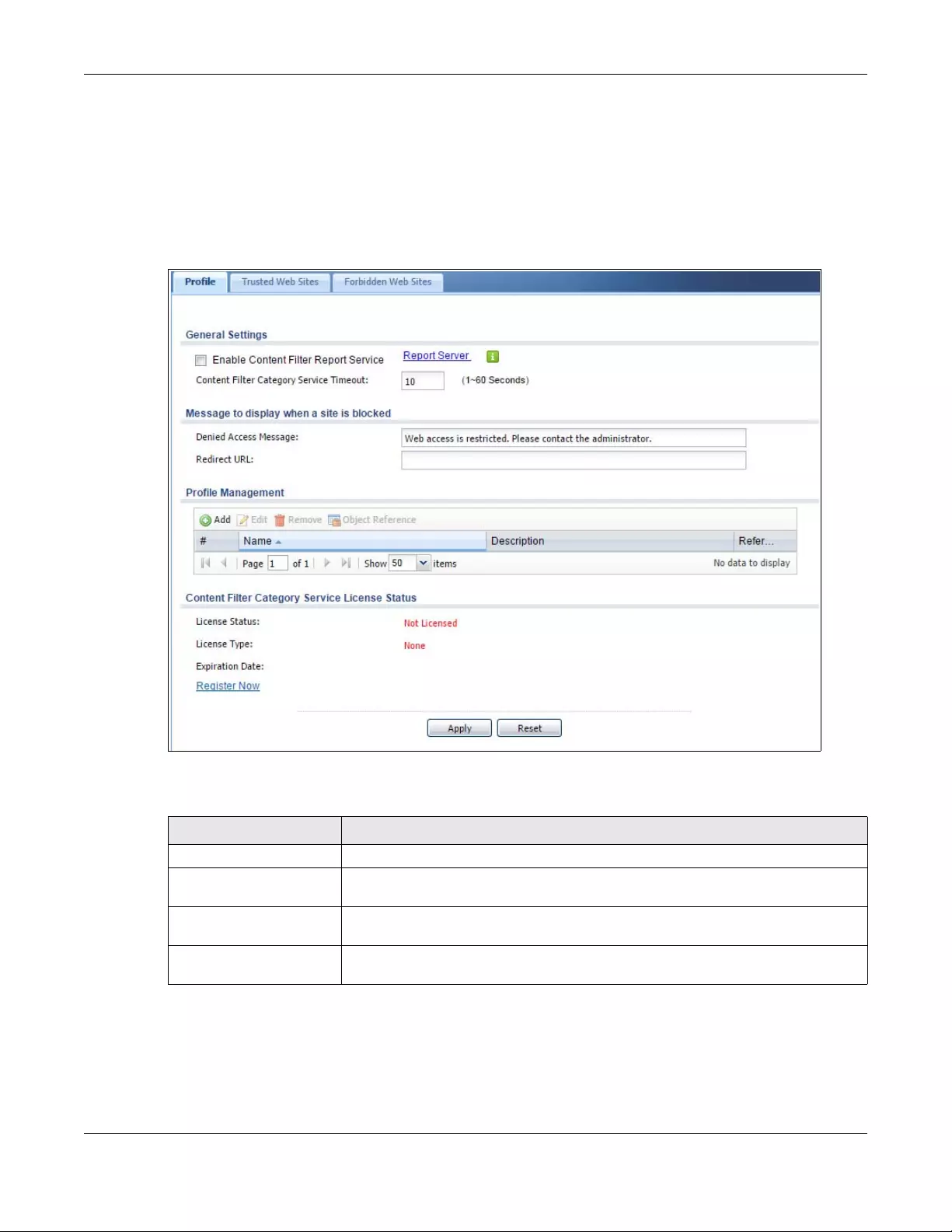
Chapter 29 Content Filtering
ZyWALL/USG Series User’s Guide
467
29.2 Content Filter Profile Screen
Click Configuration > UTM Profile> Content Filter > Profile to open the Content Filter
Profile screen. Use this screen to enable content filtering, view and order your list of content filter
policies, create a denial of access message or specify a redirect URL and check your external web
filtering service registration status.
Figure 324 Configuration > UTM Profile > Content Filter > Profile
The following table describes the labels in this screen.
Table 194 Configuration > UTM Profile > Content Filter > Profile
LABEL DESCRIPTION
General Settings
Enable Content Filter
Report Service
Select this check box to have the ZyWALL/USG collect category-based content
filtering statistics.
Report Server Click this link to choose where your ZyWALL/USG is registered: myZyXEL.com or
myZyXEL.com 2.0. Choose myZyXEL.com 2.0 for a model in this series.
Content Filter Category
Service Timeout
Specify the allowable time period in seconds for accessing the external web
filtering service’s server.
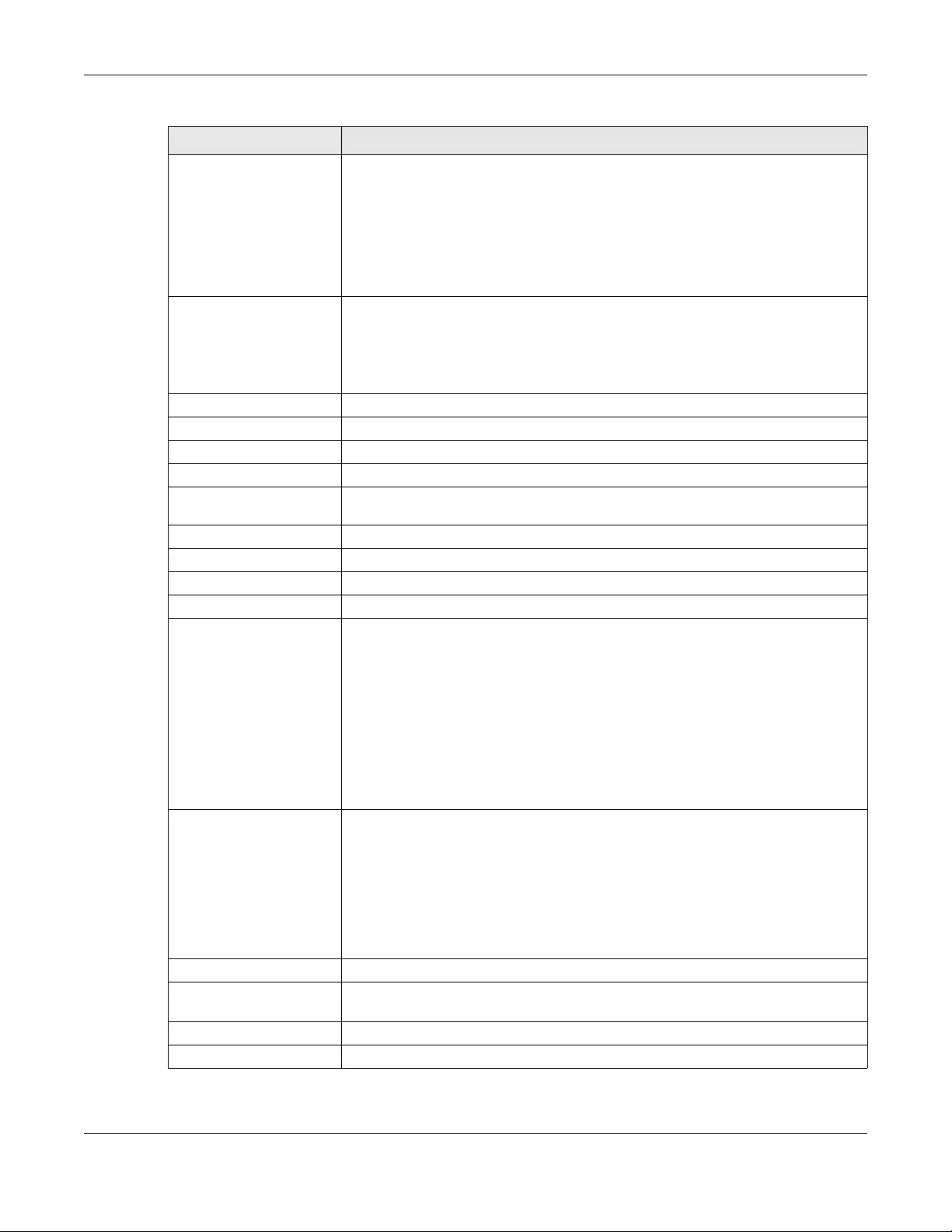
Chapter 29 Content Filtering
ZyWALL/USG Series User’s Guide
468
Denied Access Message Enter a message to be displayed when content filter blocks access to a web page.
Use up to 127 characters (0-9a-zA-Z;/?:@&=+$\.-_!~*'()%,”). For example,
“Access to this web page is not allowed. Please contact the network
administrator”.
It is also possible to leave this field blank if you have a URL specified in the
Redirect URL field. In this case if the content filter blocks access to a web page,
the ZyWALL/USG just opens the web page you specified without showing a denied
access message.
Redirect URL Enter the URL of the web page to which you want to send users when their web
access is blocked by content filter. The web page you specify here opens in a new
frame below the denied access message.
Use “http://” or “https://” followed by up to 262 characters (0-9a-zA-Z;/
?:@&=+$\.-_!~*'()%). For example, http://192.168.1.17/blocked access.
Profile Management
Add Click Add to create a new content filter rule.
Edit Click Edit to make changes to a content filter rule.
Remove Click Remove the delete a content filter rule.
Object Reference Select an entry and click Object Reference s to open a screen that shows which
settings use the entry. Click Refresh to update information on this screen.
# This column lists the index numbers of the content filter profile.
Name This column lists the names of the content filter profile rule.
Description This column lists the description of the content filter profile rule.
Reference This displays the number of times an Object Reference is used in a rule.
License Status This read-only field displays the status of your content-filtering database service
registration.
Not Licensed displays if you have not successfully registered and activated the
service.
Expired displays if your subscription to the service has expired.
Licensed displays if you have successfully registered the ZyWALL/USG and
activated the service.
You can view content filter reports after you register the ZyWALL/USG and
activate the subscription service in the Registration screen.
License Type This read-only field displays what kind of service registration you have for the
content-filtering database.
None displays if you have not successfully registered and activated the service.
Standard displays if you have successfully registered the ZyWALL/USG and
activated the service.
Trial displays if you have successfully registered the ZyWALL/USG and activated
the trial service subscription.
Expiration Date This field displays the date your service license expires.
Register Now This link appears if you have not registered for the service or the service has
expired. Click this link to go to the screen where you can register for the service.
Apply Click Apply to save your changes back to the ZyWALL/USG.
Reset Click Reset to return the screen to its last-saved settings.
Table 194 Configuration > UTM Profile > Content Filter > Profile (continued)
LABEL DESCRIPTION

Chapter 29 Content Filtering
ZyWALL/USG Series User’s Guide
469
29.3 Content Filter Profile Add or Edit Screen
Click Configuration > UTM > Content Filter > Profile > Add or Edit to open the Add Filter
Profile screen. Configure Categ ory Service and Custom Service tabs.
29.3.1 Content Filter Add Profile Category Service

Chapter 29 Content Filtering
ZyWALL/USG Series User’s Guide
470
Figure 325 Content Filter > Profile > Add Filter Profile > Category Service

Chapter 29 Content Filtering
ZyWALL/USG Series User’s Guide
471
The following table describes the labels in this screen.
Table 195 Configuration > UTM Profile> Content Filter > Profile > Add > Category Service
LABEL DESCRIPTION
License Status This read-only field displays the status of your content-filtering database
service registration.
Not Licensed displays if you have not successfully registered and activated
the service.
Expired displays if your subscription to the service has expired.
Licensed displays if you have successfully registered the ZyWALL/USG and
activated the service.
You can view content filter reports after you register the ZyWALL/USG and
activate the subscription service in the Registration screen.
License Type This read-only field displays what kind of service registration you have for the
content-filtering database.
None displays if you have not successfully registered and activated the
service.
Standard displays if you have successfully registered the ZyWALL/USG and
activated the standard content filtering service.
Trial displays if you have successfully registered the ZyWALL/USG and
activated the trial service subscription.
Name Enter a descriptive name for this content filtering profile name. You may use
1-31 alphanumeric characters, underscores(_), or dashes (-), but the first
character cannot be a number. This value is case-sensitive.
Description Enter a description for the content filtering profile rule to help identify the
purpose of rule. You may use 1-31 alphanumeric characters, underscores(_),
or dashes (-), but the first character cannot be a number. This value is case-
sensitive.
This field is optional.
Enable Content Filter
Category Service
Enable external database content filtering to have the ZyWALL/USG check an
external database to find to which category a requested web page belongs.
The ZyWALL/USG then blocks or forwards access to the web page depending
on the configuration of the rest of this page.
Action for Unsafe Web
Pages Select Pass to allow users to access web pages that match the unsafe
categories that you select below.
Select Block to prevent users from accessing web pages that match the
unsafe categories that you select below. When external database content
filtering blocks access to a web page, it displays the denied access message
that you configured in the Content Filter General screen along with the
category of the blocked web page.
Select Warn to display a warning message before allowing users to access
web pages that match the unsafe categories that you select below.
Select Log to record attempts to access web pages that match the unsafe
categories that you select below.
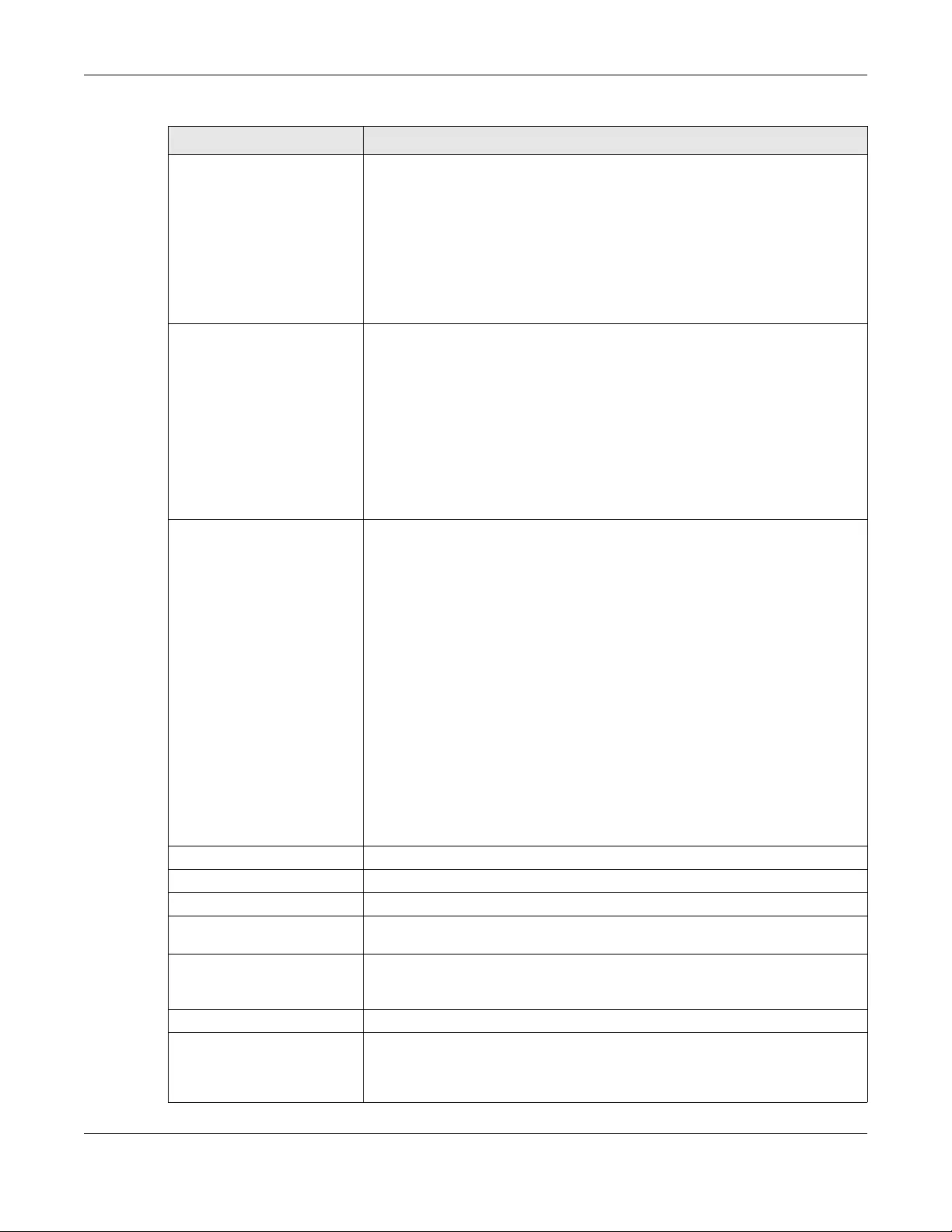
Chapter 29 Content Filtering
ZyWALL/USG Series User’s Guide
472
Action for Managed Web
Pages Select Pass to allow users to access web pages that match the other
categories that you select below.
Select Block to prevent users from accessing web pages that match the other
categories that you select below. When external database content filtering
blocks access to a web page, it displays the denied access message that you
configured in the Content Filter General screen along with the category of
the blocked web page.
Select Log to record attempts to access web pages that match the other
categories that you select below.
Action for Unrated Web
Pages Select Pass to allow users to access web pages that the external web filtering
service has not categorized.
Select Block to prevent users from accessing web pages that the external web
filtering service has not categorized. When the external database content
filtering blocks access to a web page, it displays the denied access message
that you configured in the Content Filter General screen along with the
category of the blocked web page.
Select Warn to display a warning message before allowing users to access
web pages that the external web filtering service has not categorized.
Select Log to record attempts to access web pages that are not categorized.
Action When Category
Server Is Unavailable Select Pass to allow users to access any requested web page if the external
content filtering database is unavailable.
Select Block to block access to any requested web page if the external
content filtering database is unavailable.
Select Warn to display a warning message before allowing users to access any
requested web page if the external content filtering database is unavailable.
The following are possible causes for the external content filtering server not
being available:
• There is no response from the external content filtering server within the
time period specified in the Content Filter Server Unavailable Timeout
field.
• The ZyWALL/USG is not able to resolve the domain name of the external
content filtering database.
• There is an error response from the external content filtering database.
This can be caused by an expired content filtering registration (External
content filtering’s license key is invalid”).
Select Log to record attempts to access web pages that occur when the
external content filtering database is unavailable.
Select Categories
Select All Categories Select this check box to restrict access to all site categories listed below.
Clear All Categories Select this check box to clear the selected categories below.
Security Threat (unsafe) Theese are the categories of web pages that are known to pose a threat to
users or their computers.
Anonymizers Sites and proxies that act as an intermediary for surfing to other Web sites in
an anonymous fashion, whether to circumvent Web filtering or for other
reasons. For example, blog.go2.tw, anonymizer.com, www.qu365.com.
Botnets Sites that use bots (zombies) including command-and-control sites.
Compromised Sites that have been compromised by someone other than the site owner in
order to install malicious programs without the user's knowledge. Includes
sites that may be vulnerable to a particular high-risk attack. For example,
www.wokoo.net, movie.sx.zj.cn.
Table 195 Configuration > UTM Profile> Content Filter > Profile > Add > Category Service
LABEL DESCRIPTION
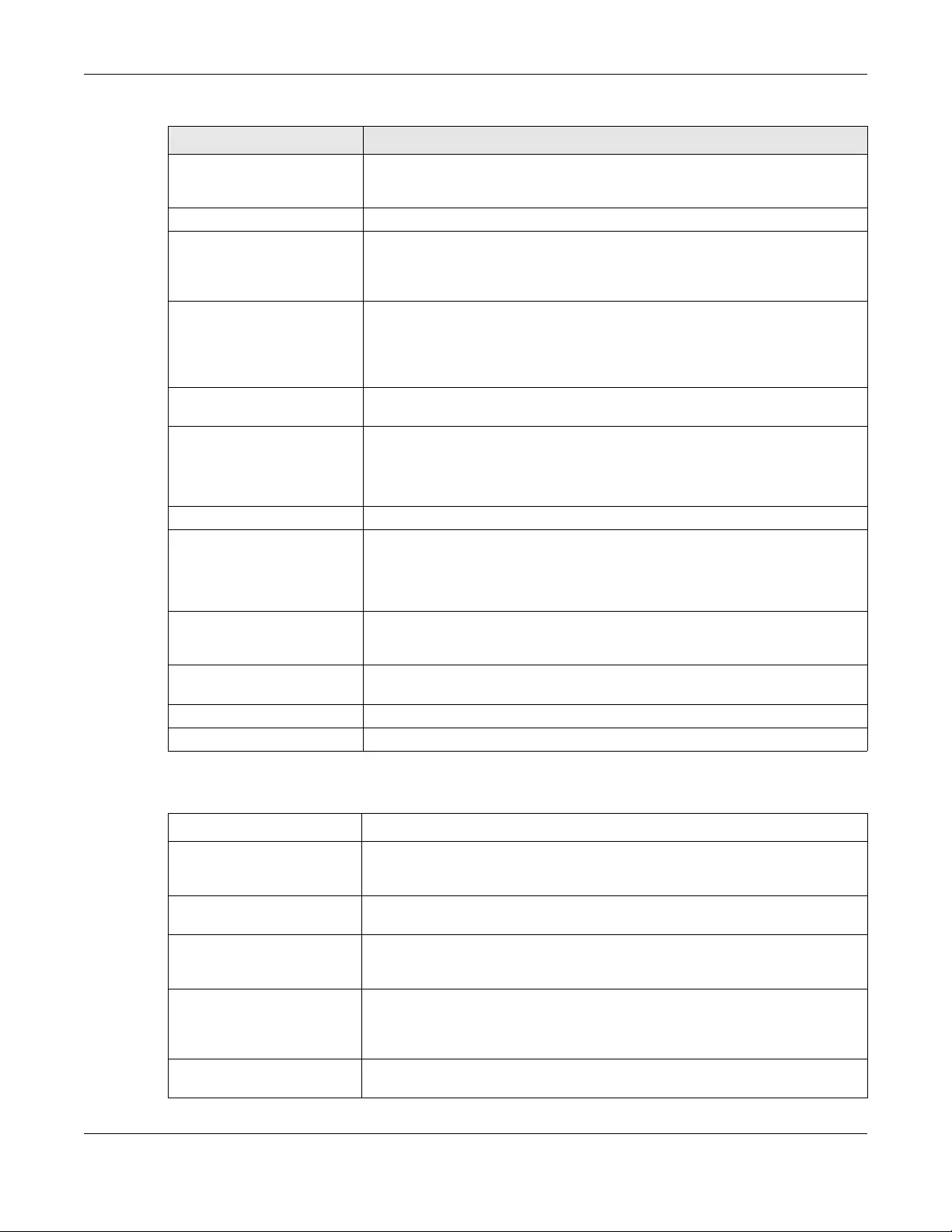
Chapter 29 Content Filtering
ZyWALL/USG Series User’s Guide
473
The following table describes the managed categories.
Malware Sites that install unwanted software on a user's computer with the intent to
enable third-party monitoring or make system changes without the user's
consent. For example, www.tqlkg.com, aladel.net.
Network Errors Sites that do not resolve to any IP address.
Parked Domains Sites that are inactive, typically reserved for later use. They most often do not
contain their own content, may simply say "under construction," "purchase
this domain," or display advertisements. For example, www.moemoon.com,
artlin.net, img.sedoparking.com.
Phishing & Fraud Sites that are used for deceptive or fraudulent purposes (e.g. phishing), such
as stealing financial or other user account information. These sites are most
often designed to appear as legitimate sites in order to mislead users into
entering their credentials. For example, optimizedby.rmxads.com,
218.1.71.226/.../e3b.
Spam Sites Sites that have been promoted through spam techniques. For example,
img.tongji.linezing.com, banner.chinesegamer.net.
Managed Categories These are categories of web pages based on their content. Select categories in
this section to control access to specific types of Internet content.
You must have the Category Service content filtering license to filter these
categories. See the next table for category details.
Test Web Site Category
URL to test You can check which category a web page belongs to. Enter a web site URL in
the text box.
When the content filter is active, you should see the web page’s category. The
query fails if the content filter is not active.
If you think the category is
incorrect
Click this link to see the category recorded in the ZyWALL/USG’s content
filtering database for the web page you specified (if the database has an entry
for it).
Test Against Content Filter
Category Server
Click this button to see the category recorded in the external content filter
server’s database for the web page you specified.
OK Click OK to save your changes back to the ZyWALL/USG.
Cancel Click Cancel to exit this screen without saving your changes.
Table 196 Managed Category Descriptions
CATEGORY DESCRIPTION
Advertisements & Pop-Ups Sites that provide advertising graphics or other ad content files such as
banners and pop-ups. For example, pagead2.googlesyndication.com,
ad.yieldmanager.com.
Alcohol & Tobacco Sites that promote or sell alcohol- or tobacco-related products or services. For
example, www.drinks.com.tw, www.p9.com.tw, beer.ttl.com.tw.
Arts Sites with artistic content or relating to artistic institutions such as theaters,
museums, galleries, dance companies, photography, and digital graphic
resources. For example, www.npm.gov.tw, www.nmh.gov.tw.
Business Sites that provide business related information such as corporate Web sites.
Information, services, or products that help businesses of all sizes to do their
day-to-day commercial activities. For example, www.kinkos.com,
www.proctorgamble.com, www.bbb.org.
Chat Sites that enable web-based exchange of realtime messages through chat
services or chat rooms. For example, me.sohu.com, blufiles.storage.live.com.
Table 195 Configuration > UTM Profile> Content Filter > Profile > Add > Category Service
LABEL DESCRIPTION
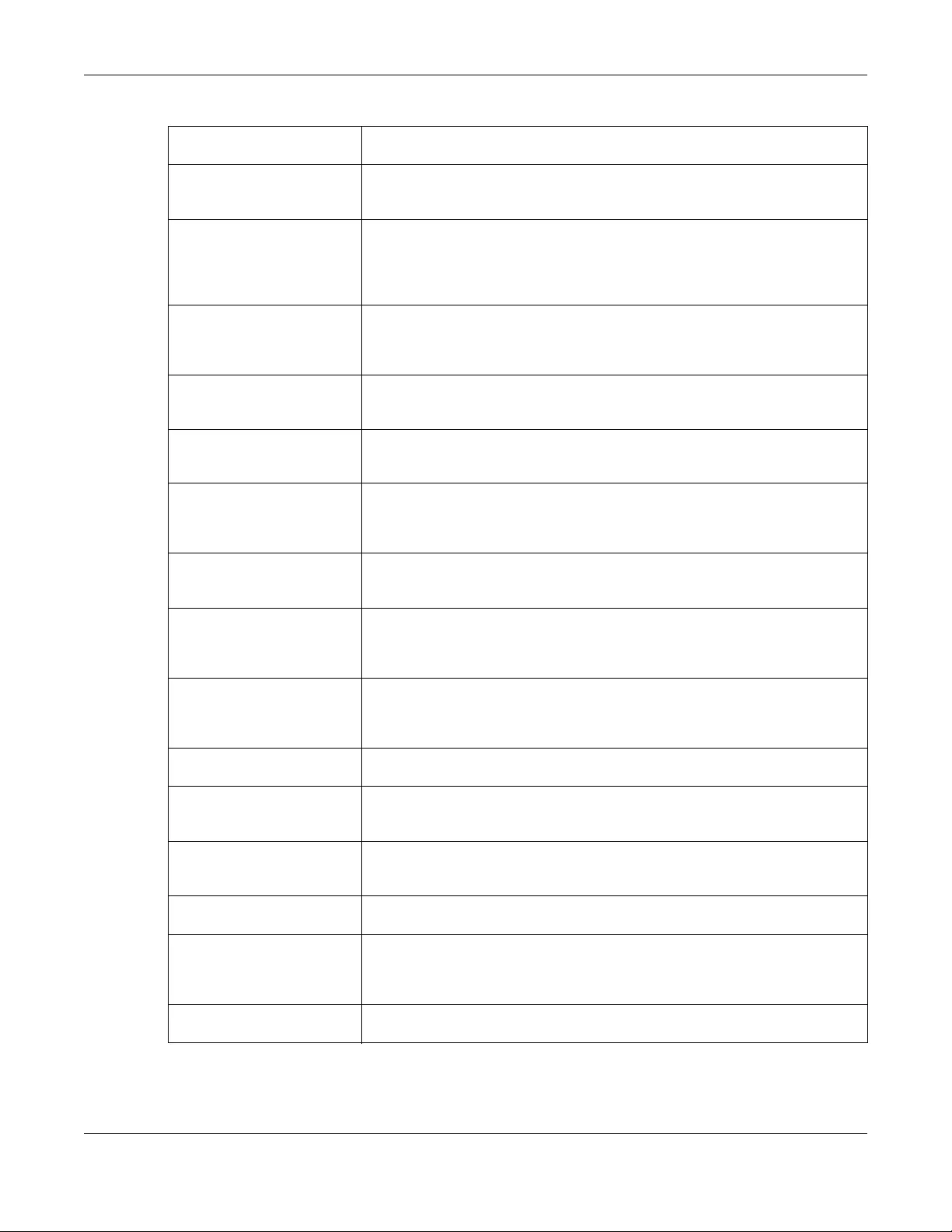
Chapter 29 Content Filtering
ZyWALL/USG Series User’s Guide
474
Child Abuse Images Sites that portray or discuss children in sexual or other abusive acts. For
example, a.uuzhijia.info.
Computers & Technology Sites that contain information about computers, software, hardware, IT,
peripheral and computer services, such as product reviews, discussions, and IT
news. For example, www.informationsecurity.com.tw, blog.ithome.com.tw.
Criminal Activity Sites that offer advice on how to commit illegal or criminal activities, or to
avoid detection. These can include how to commit murder, build bombs, pick
locks, etc. Also includes sites with information about illegal manipulation of
electronic devices, hacking, fraud and illegal distribution of software. For
example, www.hackbase.com, jia.hackbase.com, ad.adver.com.tw.
Cults Sites relating to non-traditional religious practice typically known as "cults,"
that is, considered to be false, unorthodox, extremist, or coercive, with
members often living under the direction of a charismatic leader. For example,
www.churchofsatan.com, www.ccya.org.tw.
Dating & Personals Sites that promote networking for interpersonal relationships such as dating
and marriage. Includes sites for match-making, online dating, spousal
introduction. For example, www.i-part.com.tw, www.imatchi.com.
Download Sites Sites that contain downloadable software, whether shareware, freeware, or for
a charge. Includes peer-to-peer sites. For example, www.hotdl.com,
toget.pchome.com.tw, www.azroo.com.
Education Sites sponsored by educational institutions and schools of all types including
distance education. Includes general educational and reference materials such
as dictionaries, encyclopedias, online courses, teaching aids and discussion
guides. For example, www.tfam.museum, www.lksf.org, www.1980.org.tw..
Entertainment Sites related to television, movies, music and video (including video on
demand), such as program guides, celebrity sites, and entertainment news.
For example, www.ctitv.com.tw, www.hboasia.com, www.startv.com.tw.
Fashion & Beauty Sites concerning fashion, jewelry, glamour, beauty, modeling, cosmetics or
related products or services. Includes product reviews, comparisons, and
general consumer information. For example, women.sohu.com,
baodian.women.sohu.com.
Finance Sites related to banking, finance, payment or investment, including banks,
brokerages, online stock trading, stock quotes, fund management, insurance
companies, credit unions, credit card companies, and so on. For example,
www.concords.com.tw, www.polaris.com.tw, www.bochk.com.
Forums & Newsgroups Sites for sharing information in the form of newsgroups, forums, bulletin
boards. For example, ck101.com, my.xuite.net, ptt.cc.
Gambling Sites that offer or are related to online gambling, lottery, casinos and betting
agencies involving chance. For example, www.taiwanlottery.com.tw, www.i-
win.com.tw, www.hkjc.com.
Games Sites relating to computer or other games, information about game producers,
or how to obtain cheat codes. Game-related publication sites. For example,
www.gamer.com.tw, www.wowtaiwan.com.tw, tw.lineage.gamania.com.
General Sites that do not clearly fall into other categories, for example, blank Web
pages. For example, bs.serving-sys.com, simg.sinajs.cn, i0.itc.cn.
Government Sites run by governmental organizations, departments, or agencies, including
police departments, fire departments, customs bureaus, emergency services,
civil defense, counterterrorism organizations, military and hospitals. For
example, www.ey.gov.tw, www.whitehouse.gov, www.npa.gov.tw.
Greeting cards Sites that allow people to send and receive greeting cards and postcards. For
example, www.e-card.com.tw, card.ivy.net.tw.
Table 196 Managed Category Descriptions (continued)

Chapter 29 Content Filtering
ZyWALL/USG Series User’s Guide
475
Hacking Sites that promote or give advice about how to gain unauthorized access to
proprietary computer systems, for the purpose of stealing information,
perpetrating fraud, creating viruses, or committing other illegal activity related
to theft of digital information. For example, www.hackbase.com,
www.chinahacker.com.
Hate & Intolerance Sites that promote a supremacist political agenda, encouraging oppression of
people or groups of people based on their race, religion, gender, age, disability,
sexual orientation or nationality. For example, www.racist-jokes.com, aryan-
nations.org, whitepower.com.
Health & Medicine Sites containing information pertaining to health, healthcare services, fitness
and well-being, including information about medical equipment, hospitals,
drugstores, nursing, medicine, procedures, prescription medications, etc. For
example, www.lksf.org, www.ohayo.com.tw.
Illegal Drug Sites with information on the purchase, manufacture, and use of illegal or
recreational drugs and their paraphernalia, and misuse of prescription drugs
and other compounds For example, www.cannabis.net,
www.amphetamines.com.
Illegal Software Sites that illegally distribute software or copyrighted materials such as movies
or music, software cracks, illicit serial numbers, illegal license key generators.
For example, www.zhaokey.com.cn, www.tiansha.net.
Image Sharing Sites that host digital photographs and images, online photo albums and digital
photo exchanges. For example, photo.pchome.com.tw, photo.xuite.net,
photobucket.com.
Information Security Sites that provide legitimate information about data protection, including
newly discovered vulnerabilities and how to block them. For example,
www.informationsecurity.com.tw, www.itis.tw.
Instant Messaging Sites that enable logging in to instant messaging services such as ICQ, AOL
Instant Messenger, IRC, MSN, Jabber, Yahoo Messenger, and the like. For
example, www.meebo.com, www.aim.com, www. ebuddy.com.
Job Search Sites containing job listings, career information, assistance with job searches
(such as resume writing, interviewing tips, etc.), employment agencies or
head hunters. For example, www.104.com.tw, www.1111.com.tw,
www.yes123.com.tw.
Leisure & Recreation Sites relating to recreational activities and hobbies including zoos, public
recreation centers, pools, amusement parks, and hobbies such as gardening,
literature, arts & crafts, home improvement, home d?cor, family, etc. For
example, tpbg.tfri.gov.tw, tw.fashion.yahoo.com, www.relaxtimes.com.tw.
News Sites covering news and current events such as newspapers, newswire
services, personalized news services, broadcasting sites, and magazines. For
example, www.tvbs.com.tw?Awww.ebc.net.tw?Awww.iset.com.tw.
Non-profits & NGOs Sites devoted to clubs, communities, unions, and non-profit organizations.
Many of these groups exist for educational or charitable purposes. For
example, www.tzuchi.org.tw, web.redcross.org.tw, www.lksf.org.
Nudity Sites that contain full or partial nudity that are not necessarily overtly sexual in
intent. Includes sites that advertise or sell lingerie, intimate apparel, or
swimwear. For example, www.easyshop.com.tw, www.faster-swim.com.tw,
image.baidu.com.
Peer-to-Peer Sites that enable direct exchange of files between users without dependence
on a central server. For example, www.eyny.com.
Personal Sites Sites about or hosted by personal individuals, including those hosted on
commercial sites. For example, blog.yam.com, www.wretch.cc, blog.xuite.net.
Politics Sites that promote political parties or political advocacy, or provide information
about political parties, interest groups, elections, legislation or lobbying. Also
includes sites that offer legal information and advice. For example,
www.kmt.org.tw, www.dpp.org.tw, cpc.people.com.cn.
Table 196 Managed Category Descriptions (continued)

Chapter 29 Content Filtering
ZyWALL/USG Series User’s Guide
476
Pornography/Sexually
Explicit
Sites that contain explicit sexual content. Includes adult products such as sex
toys, CD-ROMs, and videos, adult services such as videoconferencing, escort
services, and strip clubs, erotic stories and textual descriptions of sexual acts.
For example, www.dvd888.com, www.18center.com, blog.sina.com.tw.
Private IP Addresses Sites that are private IP addresses as defined in RFC 1918, that is, hosts that
do not require access to hosts in other enterprises (or require just limited
access) and whose IP address may be ambiguous between enterprises but are
well defined within a certain enterprise. For example, 172.21.20.123,
192.168.35.62.
Real Estate Sites relating to commercial or residential real estate services, including
renting, purchasing, selling or financing homes, offices, etc. For example,
www.sinyi.com.tw, www.yungching.com.tw, house.focus.cn.
Religion Sites that deal with faith, human spirituality or religious beliefs, including sites
of churches, synagogues, mosques and other houses of worship. For example,
www.fgs.org.tw, www.twtaoism.net, www.fhl.net.
Restaurants & Dining Sites that list, review, promote or advertise food, dining or catering services.
Includes sites for recipes, cooking instruction and tips, food products, and wine
advisors. For example, www.jogoya.com.tw, www.dintaifung.com.tw,
www2.pizzahut.com.tw.
School Cheating Sites that promote unethical practices such as cheating or plagiarism by
providing test answers, written essays, research papers, or term papers. For
example, www.zydk788.com, www.huafengksw.com.
Search Engines & Portals Sites enabling the searching of the Web, newsgroups, images, directories, and
other online content. Includes portal and directory sites such as white/yellow
pages. For example, tw.yahoo.com, www.pchome.com.tw,
www.google.com.tw.
Sex Education Sites relating to sex education, including subjects such as respect for partner,
abortion, gay and lesbian lifestyle, contraceptives, sexually transmitted
diseases, and pregnancy. For example, apps.rockyou.com,
www.howmama.com.tw, www.mombaby.com.tw.
Shopping Sites for online shopping, catalogs, online ordering, auctions, classified ads.
Excludes shopping for products and services exclusively covered by another
category such as health & medicine. For example, shopping.pchome.com.tw,
buy.yahoo.com.tw, www.tkec.com.tw.
Social Networking Sites that enable social networking for online communities of various topics,
for friendship, dating, or professional reasons. For example,
www.facebook.com, www.flickr.com, www.groups.google.com.
Sports Sites relating to sports teams, fan clubs, scores and sports news. Relates to all
sports, whether professional or recreational. For example, www.yankees.com,
www.nba.com, mlb.mlb.com.
Streaming Media &
Downloads
Sites that deliver streaming content, such as Internet radio, Internet TV or
MP3 and live or archived media download sites. Includes fan sites, or official
sites run by musicians, bands, or record labels. For example,
www.youtube.com, pfp.sina.com.cn, my.xunlei.com.
Tasteless Sites with offensive or tasteless content such as bathroom humor or profanity.
For example, comedycentral.com, dilbert.com.
Translators Sites that translate Web pages or phrases from one language to another. These
sites may be used to attempt to bypass a filtering system. For example,
translate.google.com.tw, www.smartlinkcorp.com, translation.paralink.com.
Transportation Sites that provide information about motor vehicles such as cars, motorcycles,
boats, trucks, RVs and the like. Includes manufacturer sites, dealerships,
review sites, pricing, , online purchase sites, enthusiasts clubs, etc. For
example, www.toyota.com.tw, www.ford.com.tw, www.sym.com.tw.
Table 196 Managed Category Descriptions (continued)

Chapter 29 Content Filtering
ZyWALL/USG Series User’s Guide
477
29.3.2 Content Filter Add Filter Profile Custom Service
Click Configuration > UTM Profile > Content Filter > Filter Profile > Add or Edit > Custom
Service to open the Custom Service screen. You can create a list of good (allowed) web site
addresses and a list of bad (blocked) web site addresses. You can also block web sites based on
whether the web site’s address contains a keyword. Use this screen to add or remove specific sites
or keywords from the filter list.
Travel Sites that provide travel and tourism information or online booking of travel
services such as airlines, accommodations, car rentals. Includes regional or
city information sites. For example, www.startravel.com.tw,
taipei.grand.hyatt.com.tw, www.car-plus.com.tw.
Unknown Unknown For example, www.669.com.tw, www.appleballoon.com.tw,
www.uimco.com.tw.
Violence Sites that contain images or text depicting or advocating physical assault
against humans, animals, or institutions. Sites of a particularly gruesome
nature such as shocking depictions of blood or wounds, or cruel animal
treatment. For example, crimescene.com, deathnet.com, michiganmilitia.com.
Weapons Sites that depict, sell, review or describe guns and weapons, including for
sport. For example, www.ak-47.net, warfare.ru.
Web-based Email Sites that enable users to send and receive email through a web-accessible
email account. For example, mail.163.com, mail.google.com,
mail.yahoo.com.tw.
Table 196 Managed Category Descriptions (continued)
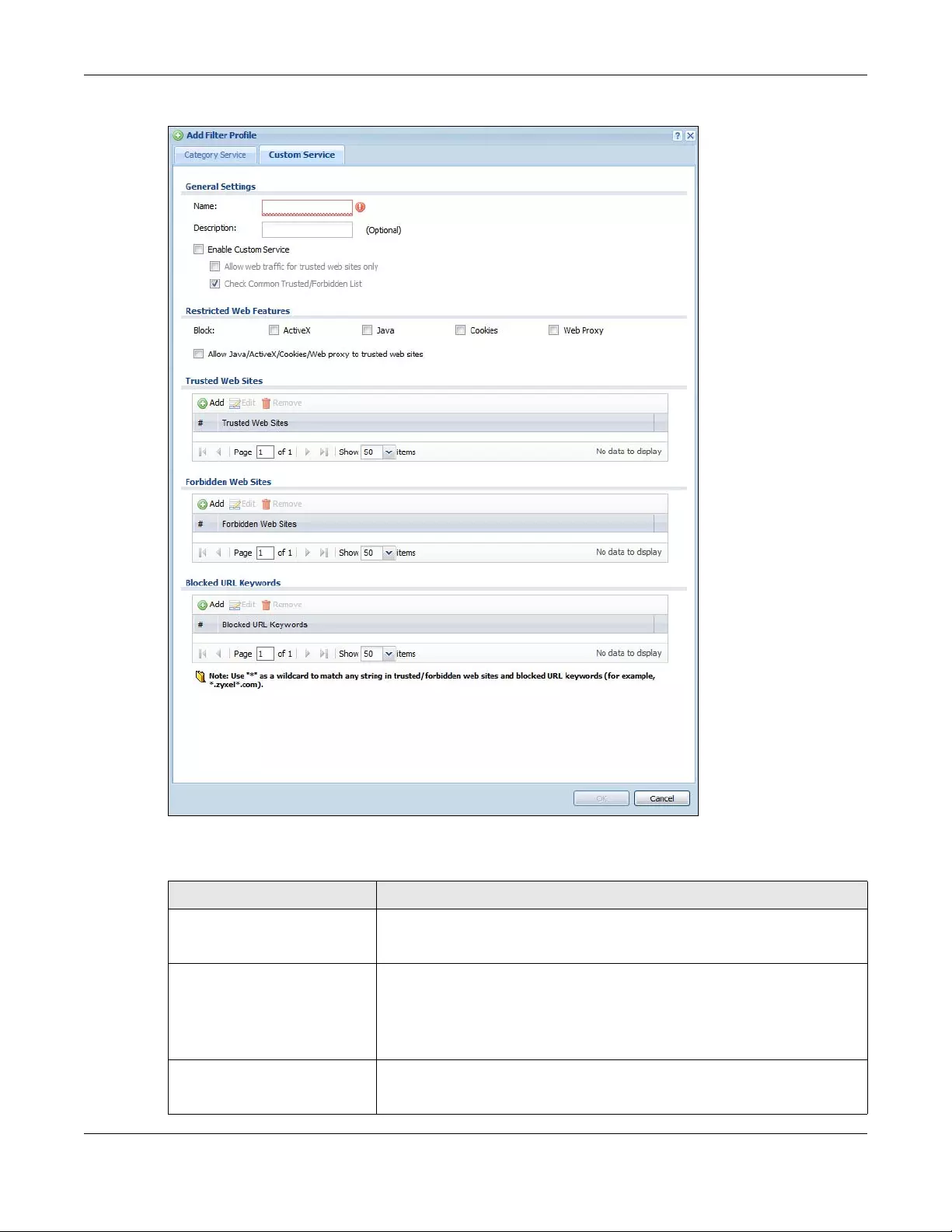
Chapter 29 Content Filtering
ZyWALL/USG Series User’s Guide
478
Figure 326 Configuration > UTM Profile > Content Filter > Filter Profile > Custom Service
The following table describes the labels in this screen.
Table 197 Configuration > UTM Profile > Content Filter > Profile > Custom Service
LABEL DESCRIPTION
Name Enter a descriptive name for this content filtering profile name. You may use
1-31 alphanumeric characters, underscores(_), or dashes (-), but the first
character cannot be a number. This value is case-sensitive.
Description Enter a description for the content filtering profile rule to help identify the
purpose of rule. You may use 1-31 alphanumeric characters,
underscores(_), or dashes (-), but the first character cannot be a number.
This value is case-sensitive.
This field is optional.
Enable Custom Service Select this check box to allow trusted web sites and block forbidden web
sites. Content filter list customization may be enabled and disabled without
re-entering these site names.
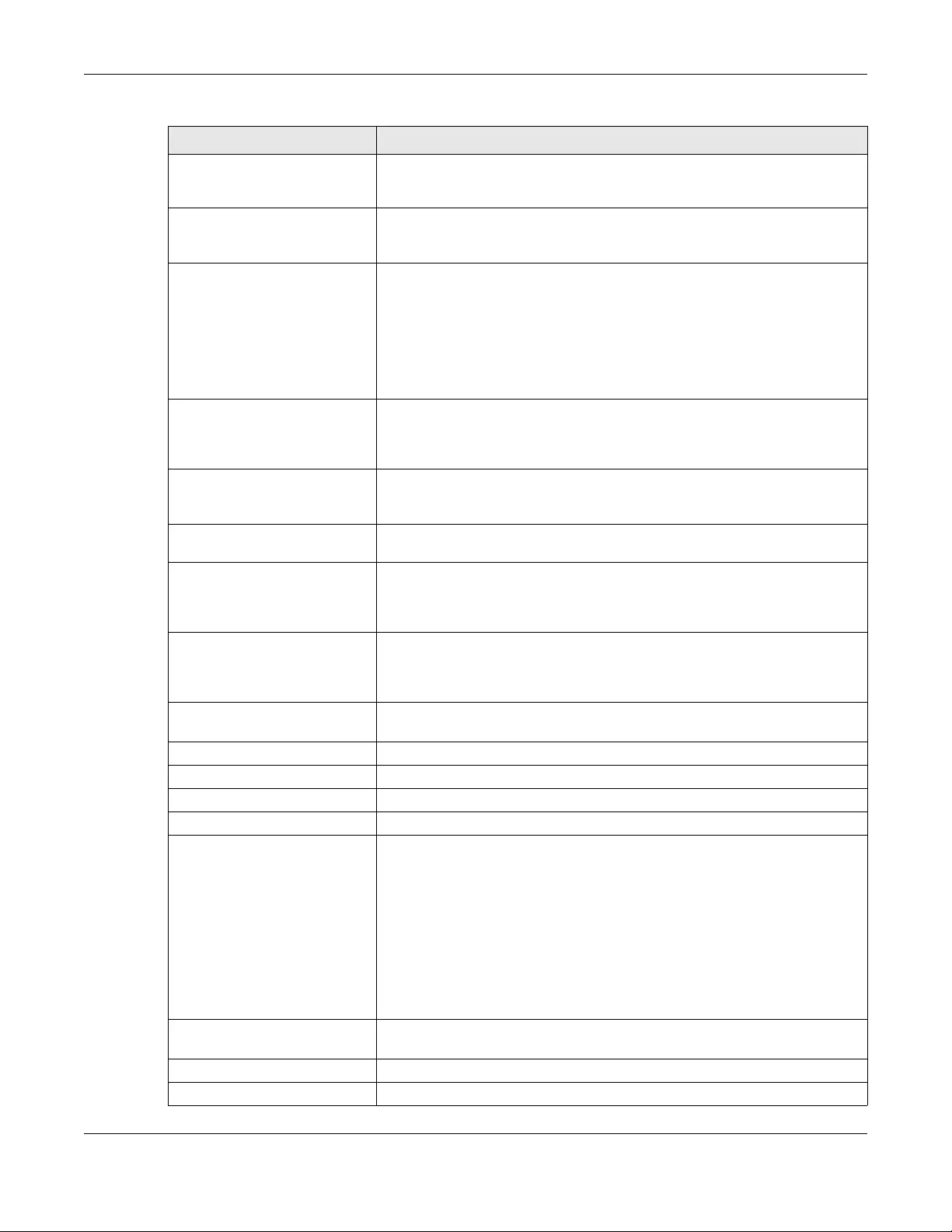
Chapter 29 Content Filtering
ZyWALL/USG Series User’s Guide
479
Allow Web traffic for trusted
web sites only
When this box is selected, the ZyWALL/USG blocks Web access to sites that
are not on the Trusted Web Sites list. If they are chosen carefully, this is
the most effective way to block objectionable material.
Check Common Trusted/
Forbidden List
Select this check box to check the common trusted and forbidden web sites
lists. See Section 29.4 on page 480 and Section 29.5 on page 481 for
information on configuring these lists.
Restricted Web Features Select the check box(es) to restrict a feature. Select the check box(es) to
restrict a feature.
• When you download a page containing ActiveX or Java, that part of the
web page will be blocked with an X.
• When you download a page coming from a Web Proxy, the whole web
page will be blocked.
• When you download a page containing cookies, the cookies will be
removed, but the page will not be blocked.
Block
ActiveX
ActiveX is a tool for building dynamic and active web pages and distributed
object applications. When you visit an ActiveX web site, ActiveX controls are
downloaded to your browser, where they remain in case you visit the site
again.
Java Java is a programming language and development environment for building
downloadable Web components or Internet and intranet business
applications of all kinds.
Cookies Cookies are files stored on a computer’s hard drive. Some web servers use
them to track usage and provide service based on ID.
Web Proxy A server that acts as an intermediary between a user and the Internet to
provide security, administrative control, and caching service. When a proxy
server is located on the WAN it is possible for LAN users to circumvent
content filtering by pointing to this proxy server.
Allow Java/ActiveX/Cookies/
Web proxy to trusted web sites
When this box is selected, the ZyWALL/USG will permit Java, ActiveX and
Cookies from sites on the Trusted Web Sites list to the LAN. In certain
cases, it may be desirable to allow Java, ActiveX or Cookies from sites that
are known and trusted.
Trusted Web Sites These are sites that you want to allow access to, regardless of their content
rating, can be allowed by adding them to this list.
Add Click this to create a new entry.
Edit Select an entry and click this to be able to modify it.
Remove Select an entry and click this to delete it.
# This displays the index number of the trusted web sites.
Trusted Web Site This column displays the trusted web sites already added.
Enter host names such as www.good-site.com into this text field. Do not
enter the complete URL of the site – that is, do not include “http://”. All
subdomains are allowed. For example, entering “*zyxel.com” also allows
“www.zyxel.com”, “partner.zyxel.com”, “press.zyxel.com”, and so on. You
can also enter just a top level domain. For example, enter “*.com” to allow
all .com domains.
Use up to 127 characters (0-9a-z-). The casing does not matter. “*” can be
used as a wildcard to match any string. The entry must contain at least one
“.” or it will be invalid.
Forbidden Web Site List Sites that you want to block access to, regardless of their content rating, can
be allowed by adding them to this list.
Add Click this to create a new entry.
Edit Select an entry and click this to be able to modify it.
Table 197 Configuration > UTM Profile > Content Filter > Profile > Custom Service (continued)
LABEL DESCRIPTION
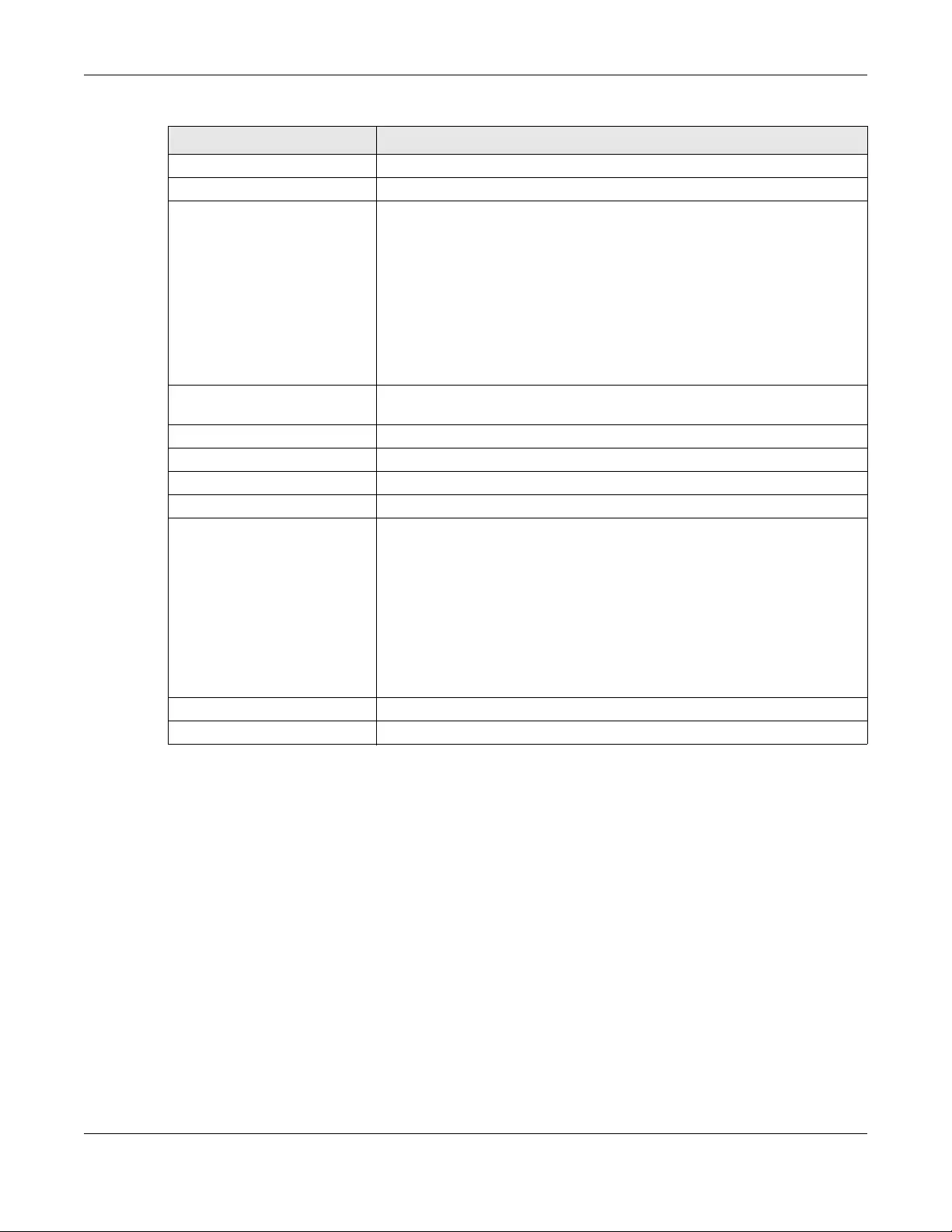
Chapter 29 Content Filtering
ZyWALL/USG Series User’s Guide
480
29.4 Content Filter Trusted Web Sites Screen
Click Conf iguration > UTM Prof ile > Conte nt Filte r > Trusted Web Site s to open the Trusted
Web Sites screen. You can create a common list of good (allowed) web site addresses. When you
configure Filter Profiles, you can select the option to check the Common Trusted Web Sites list.
Use this screen to add or remove specific sites from the filter list.
Remove Select an entry and click this to delete it.
# This displays the index number of the forbidden web sites.
Forbidden Web Sites This list displays the forbidden web sites already added.
Enter host names such as www.bad-site.com into this text field. Do not
enter the complete URL of the site – that is, do not include “http://”. All
subdomains are also blocked. For example, entering “*bad-site.com” also
blocks “www.bad-site.com”, “partner.bad-site.com”, “press.bad-site.com”,
and do on. You can also enter just a top level domain. For example, enter
“*.com” to block all .com domains.
Use up to 127 characters (0-9a-z-). The casing does not matter. “*” can be
used as a wildcard to match any string. The entry must contain at least one
“.” or it will be invalid.
Blocked URL Keywords This section allows you to block Web sites with URLs that contain certain
keywords in the domain name or IP address.
Add Click this to create a new entry.
Edit Select an entry and click this to be able to modify it.
Remove Select an entry and click this to delete it.
# This displays the index number of the blocked URL keywords.
Blocked URL Keywords This list displays the keywords already added.
Enter a keyword or a numerical IP address to block. You can also enter a
numerical IP address.
Use up to 127 case-insensitive characters (0-9a-zA-Z;/?:@&=+$\.-
_!~*()%). “*” can be used as a wildcard to match any string. Use “|*” to
indicate a single wildcard character.
For example enter *Bad_Site* to block access to any web page that includes
the exact phrase Bad_Site. This does not block access to web pages that
only include part of the phrase (such as Bad for example).
OK Click OK to save your changes back to the ZyWALL/USG.
Cancel Click Cancel to exit this screen without saving your changes.
Table 197 Configuration > UTM Profile > Content Filter > Profile > Custom Service (continued)
LABEL DESCRIPTION

Chapter 29 Content Filtering
ZyWALL/USG Series User’s Guide
481
Figure 327 Configuration > UTM Profile > Content Filter > Trusted Web Sites
The following table describes the labels in this screen.
29.5 Content Filter Forbidden Web Sites Screen
Click Configuration > UTM Profile > Content Filter > Forbidden Web Sites to open the
Forbidden Web Sites screen. You can create a common list of bad (blocked) web site addresses.
When you configure Filter Profiles, you can select the option to check the Common Forbidden
Web Sites list. Use this screen to add or remove specific sites from the filter list.
Table 198 Configuration > UTM Profile > Content Filter > Trusted Web Sites
LABEL DESCRIPTION
Common Trusted Web Sites These are sites that you want to allow access to, regardless of their content
rating, can be allowed by adding them to this list.
Add Click this to create a new entry.
Edit Select an entry and click this to be able to modify it.
Remove Select an entry and click this to delete it.
# This displays the index number of the trusted web sites.
Trusted Web Site This column displays the trusted web sites already added.
Enter host names such as www.good-site.com into this text field. Do not
enter the complete URL of the site – that is, do not include “http://”. All
subdomains are allowed. For example, entering “zyxel.com” also allows
“www.zyxel.com”, “partner.zyxel.com”, “press.zyxel.com”, and so on. You
can also enter just a top level domain. For example, enter .com to allow all
.com domains.
Use up to 127 characters (0-9a-z-). The casing does not matter.
Apply Click Apply to save your changes back to the ZyWALL/USG.
Reset Click Reset to return the screen to its last-saved settings.
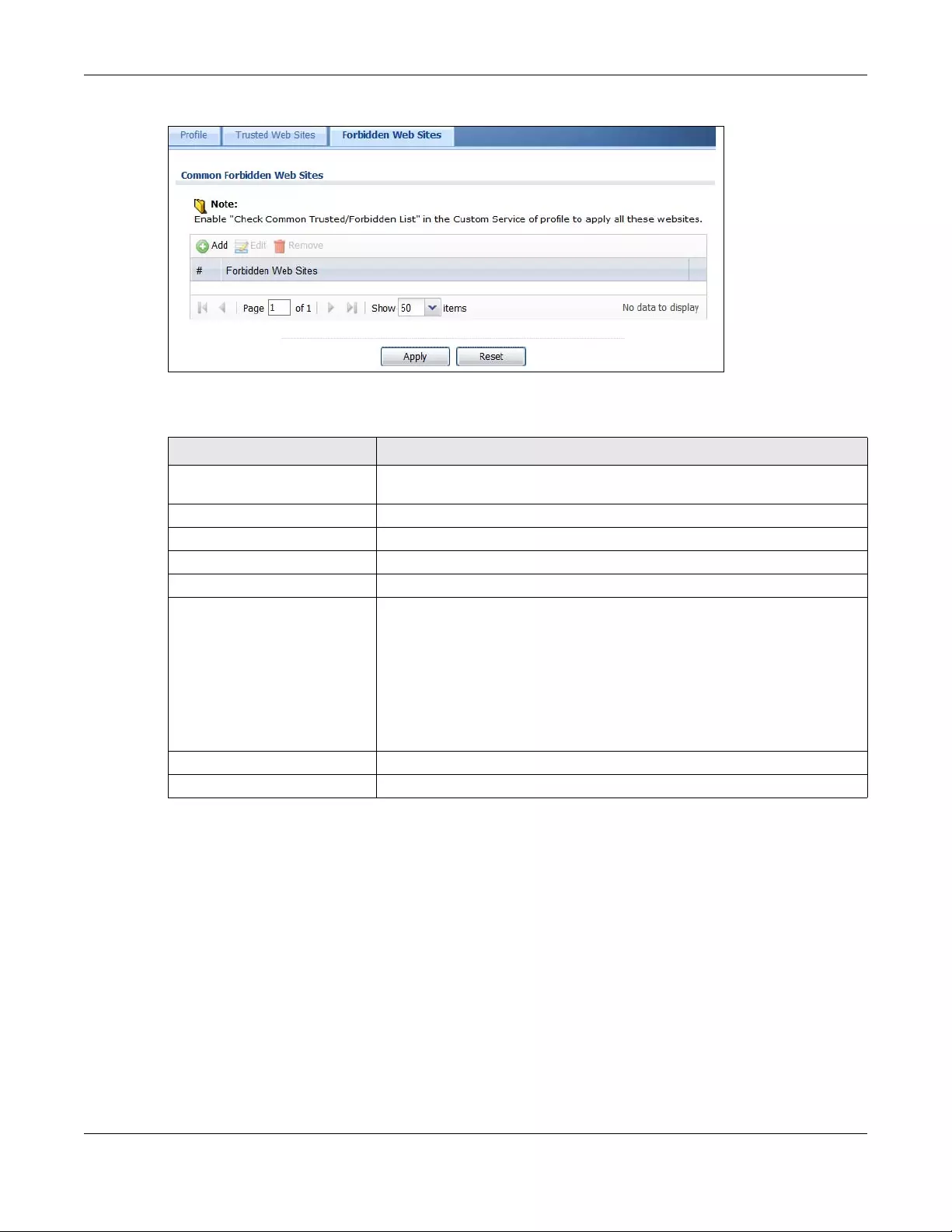
Chapter 29 Content Filtering
ZyWALL/USG Series User’s Guide
482
Figure 328 Configuration > UTM Profile > Content Filter > Forbidden Web Sites
The following table describes the labels in this screen.
29.6 Content Filter Technical Reference
This section provides content filtering background information.
External Content Filter Server Lookup Procedure
The content filter lookup process is described below.
Table 199 Configuration > UTM Profile > Content Filter > Forbidden Web Sites
LABEL DESCRIPTION
Forbidden Web Site List Sites that you want to block access to, regardless of their content rating, can
be allowed by adding them to this list.
Add Click this to create a new entry.
Edit Select an entry and click this to be able to modify it.
Remove Select an entry and click this to delete it.
# This displays the index number of the forbidden web sites.
Forbidden Web Sites This list displays the forbidden web sites already added.
Enter host names such as www.bad-site.com into this text field. Do not
enter the complete URL of the site – that is, do not include “http://”. All
subdomains are also blocked. For example, entering “bad-site.com” also
blocks “www.bad-site.com”, “partner.bad-site.com”, “press.bad-site.com”,
and do on. You can also enter just a top level domain. For example, enter
.com to block all .com domains.
Use up to 127 characters (0-9a-z-). The casing does not matter.
Apply Click Apply to save your changes back to the ZyWALL/USG.
Cancel Click Reset to return the screen to its last-saved settings.

Chapter 29 Content Filtering
ZyWALL/USG Series User’s Guide
483
Figure 329 Content Filter Lookup Procedure
1A computer behind the ZyWALL/USG tries to access a web site.
2The ZyWALL/USG looks up the web site in its cache. If an attempt to access the web site was made
in the past, a record of that web site’s category will be in the ZyWALL/USG’s cache. The ZyWALL/
USG blocks, blocks and logs or just logs the request based on your configuration.
3Use the Content Filter Cache screen to configure how long a web site address remains in the
cache as well as view those web site addresses. All of the web site address records are also cleared
from the local cache when the ZyWALL/USG restarts.
4If the ZyWALL/USG has no record of the web site, it queries the external content filter database and
simultaneously sends the request to the web server.
5The external content filter server sends the category information back to the ZyWALL/USG, which
then blocks and/or logs access to the web site based on the settings in the content filter profile. The
web site’s address and category are then stored in the ZyWALL/USG’s content filter cache.

ZyWALL/USG Series User’s Guide
484
CHAPTER 30
IDP
30.1 Overview
This chapter introduces packet inspection IDP (Intrusion, Detection and Prevention), IDP profiles,
binding an IDP profile to a traffic flow, custom signatures and updating signatures. An IDP system
can detect malicious or suspicious packets and respond instantaneously. IDP on the ZyWALL/USG
protects against network-based intrusions.
30.1.1 What You Can Do in this Chapter
•Use the UTM Profile > IDP > Profile screen (Section 30.2 on page 485) to view registration
and signature information. Click the Add or Edit icon in this screen to bind an IDP profile to a
traffic direction.
•Use the UTM Profile > IDP > Profile > Add screen (Section 30.2.2 on page 487) to add a new
profile, edit an existing profile or delete an existing profile.
•Use the UTM Profile > IDP > Custom Signature screens (Section 30.3 on page 496) to create
a new custom signature, edit an existing signature, delete existing signatures or save signatures
to your computer.
30.1.2 What You Need To Know
Packet Inspection Signatures
A signature identifies a malicious or suspicious packet and specifies an action to be taken. You can
change the action in the profile screens. Packet inspection signatures examine OSI (Open System
Interconnection) layer-4 to layer-7 packet contents for malicious data. Generally, packet inspection
signatures are created for known attacks while anomaly detection looks for abnormal behavior.
Applying Your IDP Configuration
Changes to the ZyWALL/USG’s IDP settings affect new sessions (not the sessions that already
existed before you applied the changed settings).
30.1.3 Before You Begin
• Register for a trial IDP subscription in the Registration screen. This gives you access to free
signature updates. This is important as new signatures are created as new attacks evolve. When
the trial subscription expires, purchase and enter a license key using the same screens to
continue the subscription.
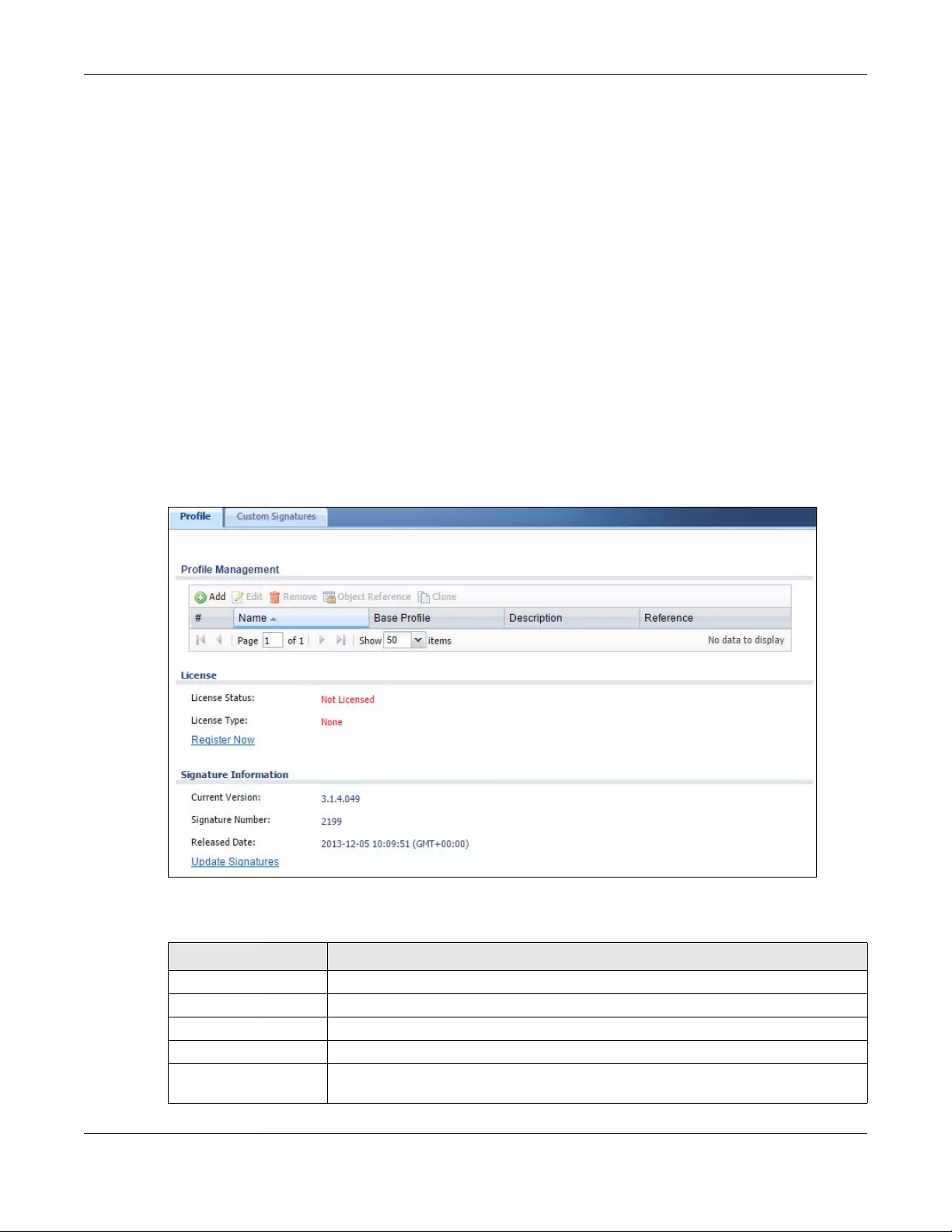
Chapter 30 IDP
ZyWALL/USG Series User’s Guide
485
30.2 The IDP Profile Screen
An IDP profile is a set of packet inspection signatures.
Packet inspection signatures examine packet content for malicious data. Packet inspection applies
to OSI (Open System Interconnection) layer-4 to layer-7 contents. You need to subscribe for IDP
service in order to be able to download new signatures.
In general, packet inspection signatures are created for known attacks while anomaly detection
looks for abnormal behavior.
Click Configuration > UTM Profile > IDP > Profile to open this screen. Use this screen to view
registration and signature information.
Note: You must register in order to use packet inspection signatures. See the
Registration screens.
If you try to enable IDP when the IDP service has not yet been registered, a warning screen
displays and IDP is not enabled.
Figure 330 Configuration > UTM Profile > IDP > Profile
The following table describes the fields in this screen.
Table 200 Configuration > UTM Profile > IDP > Profile
LABEL DESCRIPTION
Profile Management
Add Click Add to create a new profile. Select from the options in the box.
Edit Select an entry and click this to be able to modify it.
Remove Select an entry and click this to delete it.
Object Reference Select an entry and click Object References to open a screen that shows which
settings use the entry. Click Refresh to update information on this screen.
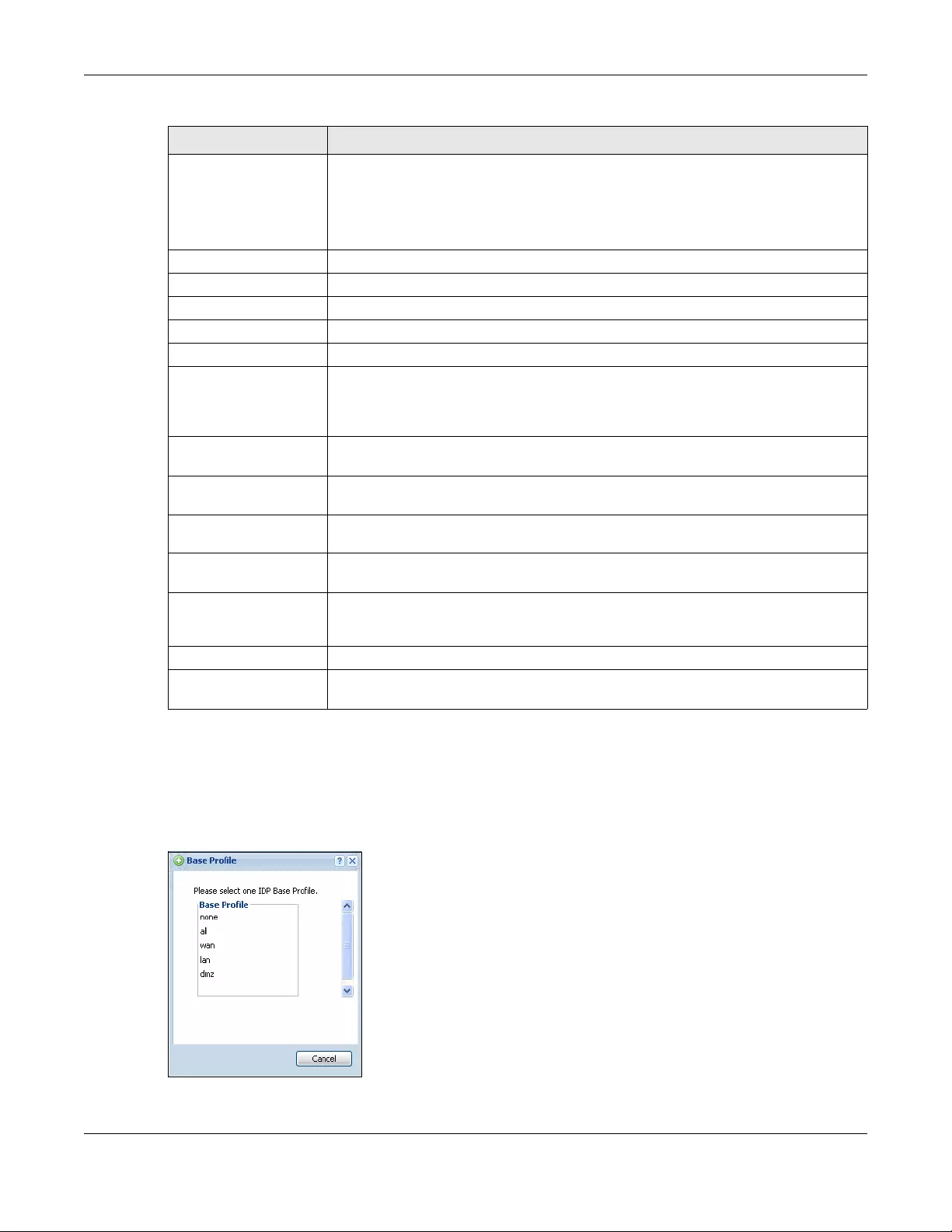
Chapter 30 IDP
ZyWALL/USG Series User’s Guide
486
30.2.1 Base Profiles
The ZyWALL/USG comes with several base profiles. You use base profiles to create new profiles. In
the Configuration > UTM > IDP > Profile screen, click Add to display the following screen.
Figure 331 Base Profiles
Clone Use Clone to create a new entry by modifying an existing one.
• Select an existing entry.
•Click Clone.
• A configuration copy of the selected entry pops up. You must at least change the
name as duplicate entry names are not allowed.
#This is the entry’s index number in the list.
Name This displays the name of the IDP Profile.
Base Profile This displays the base profile used to create the IDP profile.
Description This displays the description of the IDP Profile.
Reference This displays the number of times an object reference is used in a profile.
License You need to create an account at myZyXEL.com, register your ZyWALL/USG and
then subscribe for IDP in order to be able to download new packet inspection
signatures from myZyXEL.com. There’s an initial free trial period for IDP after which
you must pay to subscribe to the service. See the Registration chapter for details.
License Status Licensed, Not Licensed or Expired indicates whether you have subscribed for IDP
services or not or your registration has expired.
License Type This field shows Trial, Standard or None depending on whether you subscribed to
the IDP trial, bought an iCard for IDP service or neither.
Signature Information The following fields display information on the current signature set that the
ZyWALL/USG is using.
Current Version This field displays the IDP signature set version number. This number gets larger as
the set is enhanced.
Signature Number This field displays the number of IDP signatures in this set. This number usually gets
larger as the set is enhanced. Older signatures and rules may be removed if they are
no longer applicable or have been supplanted by newer ones.
Released Date This field displays the date and time the set was released.
Update Signatures Click this link to go to the screen you can use to download signatures from the
update server.
Table 200 Configuration > UTM Profile > IDP > Profile (continued)
LABEL DESCRIPTION

Chapter 30 IDP
ZyWALL/USG Series User’s Guide
487
The following table describes this screen.
30.2.2 Adding / Editing Profiles
You may want to create a new profile if not all signatures in a base profile are applicable to your
network. In this case you should disable non-applicable signatures so as to improve ZyWALL/USG
IDP processing efficiency.
You may also find that certain signatures are triggering too many false positives or false negatives.
A false positive is when valid traffic is flagged as an attack. A false negative is when invalid traffic is
wrongly allowed to pass through the ZyWALL/USG. As each network is different, false positives and
false negatives are common on initial IDP deployment.
You could create a new ‘monitor profile’ that creates logs but all actions are disabled. Observe the
logs over time and try to eliminate the causes of the false alarms. When you’re satisfied that they
have been reduced to an acceptable level, you could then create an ‘inline profile’ whereby you
configure appropriate actions to be taken when a packet matches a signature.
Packet inspection signatures examine the contents of a packet for malicious data. It operates at
layer-4 to layer-7. An IDP profile is a group of IDP signatures that have the same log and action
settings. In ‘group view’ you can configure the same log and action settings for all IDP signatures
by severity level in the Add Profile screen. You may also configure signature exceptions in the
sameview.
Table 201 Base Profiles
BASE PROFILE DESCRIPTION
none All signatures are disabled. No logs are generated nor actions are taken.
all All signatures are enabled. Signatures with a high or severe severity level (greater than
three) generate log alerts and cause packets that trigger them to be dropped.
Signatures with a very low, low or medium severity level (less than or equal to three)
generate logs (not log alerts) and no action is taken on packets that trigger them.
wan Signatures for all services are enabled. Signatures with a medium, high or severe
severity level (greater than two) generate logs (not log alerts) and no action is taken on
packets that trigger them. Signatures with a very low or low severity level (less than or
equal to two) are disabled.
lan This profile is most suitable for common LAN network services. Signatures for common
services such as DNS, FTP, HTTP, ICMP, IM, IMAP, MISC, NETBIOS, P2P, POP3, RPC,
RSERVICE, SMTP, SNMP, SQL, TELNET, TFTP, MySQL are enabled. Signatures with a high
or severe severity level (greater than three) generate logs (not log alerts) and cause
packets that trigger them to be dropped. Signatures with a low or medium severity level
(two or three) generate logs (not log alerts) and no action is taken on packets that
trigger them. Signatures with a very low severity level (one) are disabled.
dmz This profile is most suitable for networks containing your servers. Signatures for
common services such as DNS, FTP, HTTP, ICMP, IMAP, MISC, NETBIOS, POP3, RPC,
RSERVICE, SMTP, SNMP, SQL, TELNET, Oracle, MySQL are enabled. Signatures with a
high or severe severity level (greater than three) generate log alerts and cause packets
that trigger them to be dropped. Signatures with a low or medium severity level (two or
three) generate logs (not log alerts) and no action is taken on packets that trigger
them. Signatures with a very low severity level (one) are disabled.
OK Click OK to save your changes.
Cancel Click Cancel to exit this screen without saving your changes.
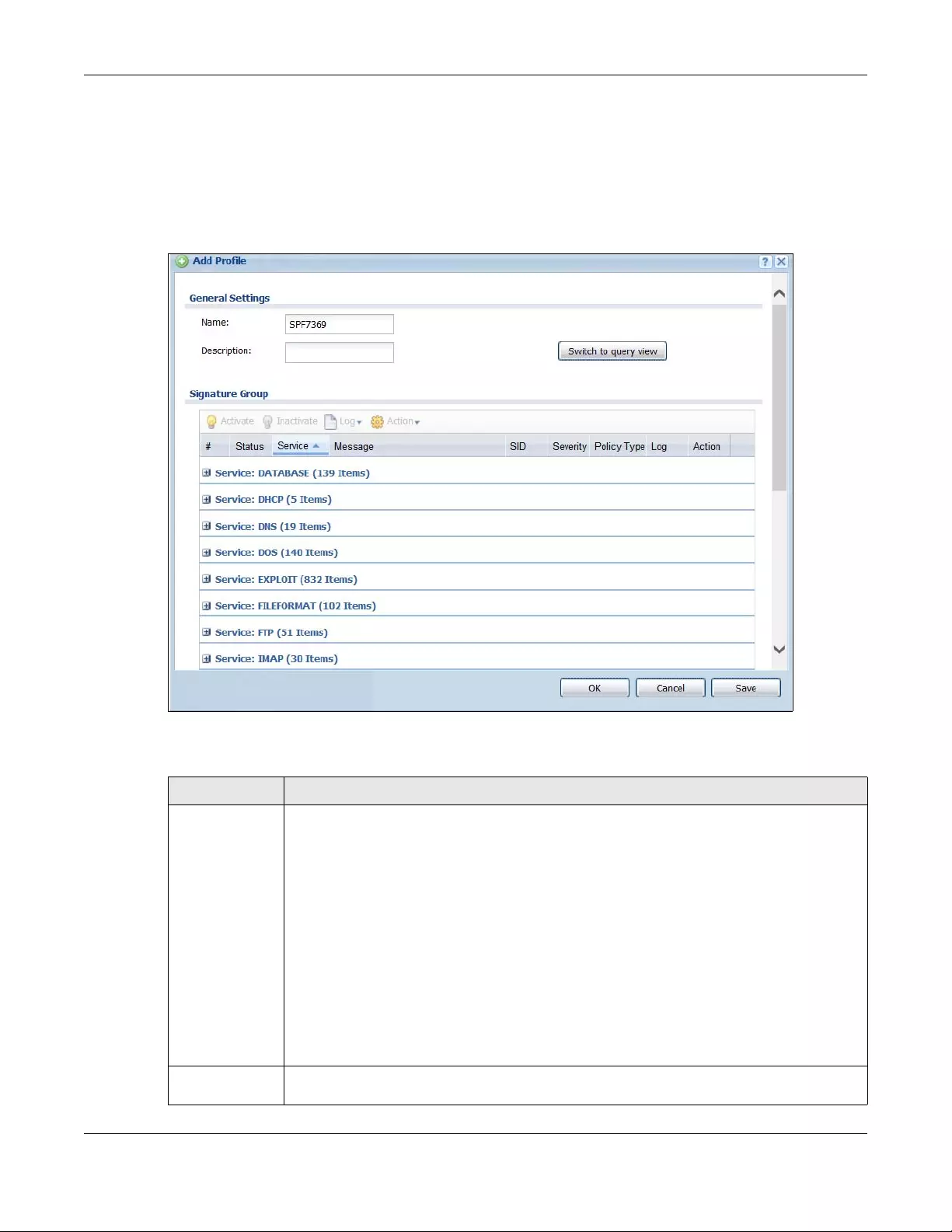
Chapter 30 IDP
ZyWALL/USG Series User’s Guide
488
30.2.3 Profile > Group View Screen
Select Configuration > UTM Profile > IDP > Profile and then click Add to create a new profile
or select an existing profile, then click a group in the base profile box (or double-click the existing
profile) to modify it. Group view is displayed first by default.
Figure 332 Configuration > UTM Profile > IDP > Profile > Add > Edit: Group View
The following table describes the fields in this screen.
Table 202 Configuration > UTM Profile> IDP > Profile > Add > Group View
LABEL DESCRIPTION
Name This is the name of the profile. You may use 1-31 alphanumeric characters,
underscores(_), or dashes (-), but the first character cannot be a number. This value is
case-sensitive. These are valid, unique profile names:
• MyProfile
• mYProfile
• Mymy12_3-4
These are invalid profile names:
• 1mYProfile
• My Profile
• MyProfile?
• Whatalongprofilename123456789012
Description Enter additional information about this IDP rule. You can enter up to 60 characters ("0-9",
"a-z", "A-Z", "-" and "_").

Chapter 30 IDP
ZyWALL/USG Series User’s Guide
489
Switch to query
view
Click this button to go to a screen where you can search for signatures by criteria such as
name, ID, severity, attack type, vulnerable attack platforms, service category, log options
or actions.
Severity Level Select a severity level and these use the icons to enable/disable and configure logs and
actions for all signatures of that level.
Signature
Group
Activate To turn on an entry, select it and click Activate.
Inactivate To turn off an entry, select it and click Inactivate.
Log To edit an item’s log option, select it and use the Log icon. These are the log options:
no: Select this option on an individual signature or a complete service group to have the
ZyWALL/USG create no log when a packet matches a signature(s).
log: Select this option on an individual signature or a complete service group to have the
ZyWALL/USG create a log when a packet matches a signature(s).
log alert: An alert is an e-mailed log for more serious events that may need more
immediate attention. They also appear in red in the Monitor > Log screen. Select this
option to have the ZyWALL/USG send an alert when a packet matches a signature(s).
Action To edit what action the ZyWALL/USG takes when a packet matches a signature, select the
signature and use the Action icon.
none: Select this action on an individual signature or a complete service group to have the
ZyWALL/USG take no action when a packet matches the signature(s).
drop: Select this action on an individual signature or a complete service group to have the
ZyWALL/USG silently drop a packet that matches the signature(s). Neither sender nor
receiver are notified.
reject-sender: Select this action on an individual signature or a complete service group to
have the ZyWALL/USG send a reset to the sender when a packet matches the signature. If
it is a TCP attack packet, the ZyWALL/USG will send a packet with a ‘RST’ flag. If it is an
ICMP or UDP attack packet, the ZyWALL/USG will send an ICMP unreachable packet.
reject-receiver: Select this action on an individual signature or a complete service group
to have the ZyWALL/USG send a reset to the receiver when a packet matches the
signature. If it is a TCP attack packet, the ZyWALL/USG will send a packet with an a ‘RST’
flag. If it is an ICMP or UDP attack packet, the ZyWALL/USG will do nothing.
reject-both: Select this action on an individual signature or a complete service group to
have the ZyWALL/USG send a reset to both the sender and receiver when a packet matches
the signature. If it is a TCP attack packet, the ZyWALL/USG will send a packet with a ‘RST’
flag to the receiver and sender. If it is an ICMP or UDP attack packet, the ZyWALL/USG will
send an ICMP unreachable packet.
#This is the entry’s index number in the list.
Status The activate (light bulb) icon is lit when the entry is active and dimmed when the entry is
inactive.
Message This displays the message of the violation of IDP Profile rule.
SID This displays the Signature ID number. The SID is a numerical field in the 9000000 to
9999999 range.
Table 202 Configuration > UTM Profile> IDP > Profile > Add > Group View (continued)
LABEL DESCRIPTION
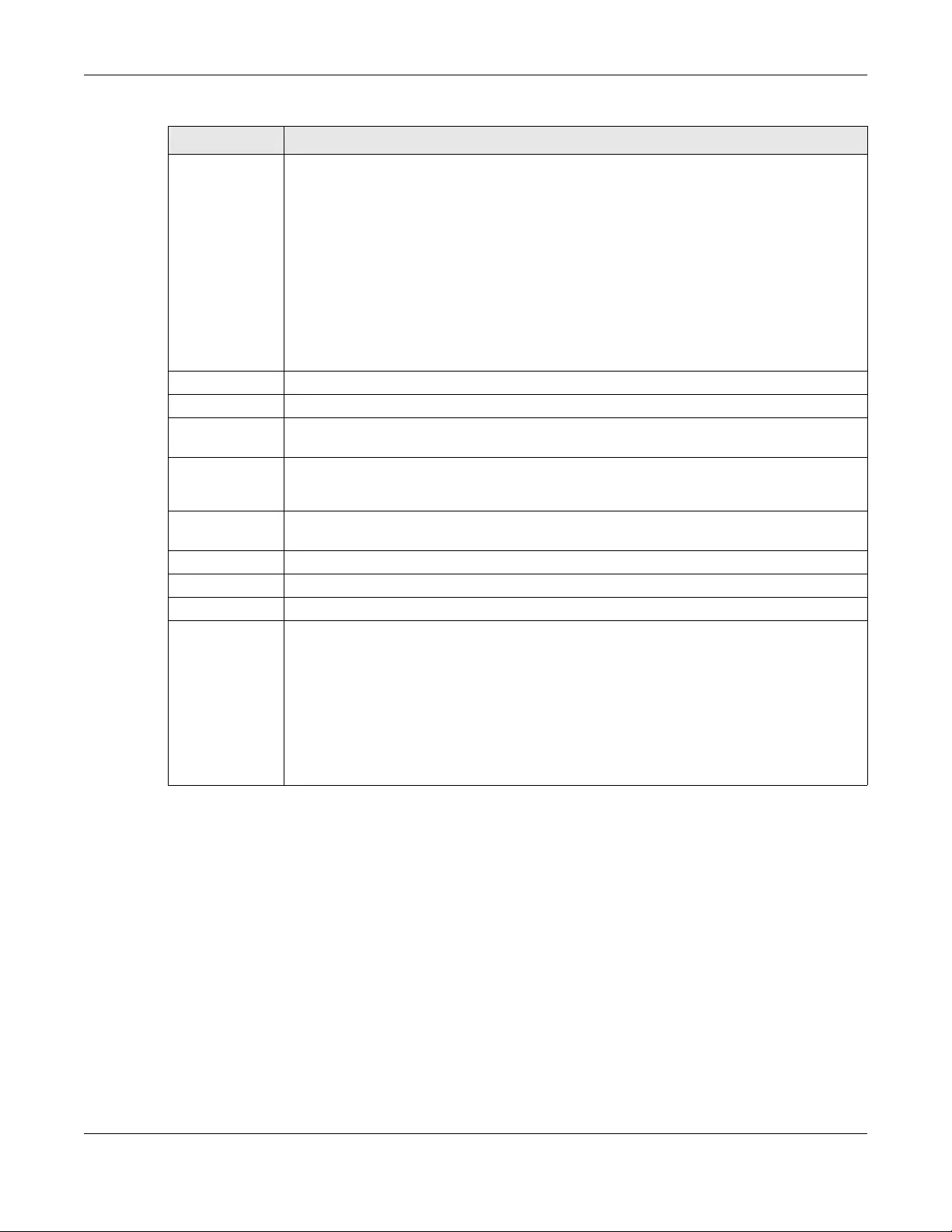
Chapter 30 IDP
ZyWALL/USG Series User’s Guide
490
Severity These are the severities as defined in the ZyWALL/USG. The number in brackets is the
number you use if using commands.
Severe (5): These denote attacks that try to run arbitrary code or gain system privileges.
High (4): These denote known serious vulnerabilities or attacks that are probably not false
alarms.
Medium (3): These denote medium threats, access control attacks or attacks that could be
false alarms.
Low (2): These denote mild threats or attacks that could be false alarms.
Very Low (1): These denote possible attacks caused by traffic such as Ping, trace route,
ICMP queries etc.
Policy Type This displays the application of the IDP profile.
Log These are the log options. To edit this, select an item and use the Log icon.
Action This is the action the ZyWALL/USG should take when a packet matches a signature here. To
edit this, select an item and use the Action icon.
Excepted
Signatures
Use the icons to enable/disable and configure logs and actions for individual signatures that
are different to the general settings configured for the severity level to which the signatures
belong. Signatures configured in Query View will appear in Group View.
Add Click this to configure settings to a signature that are different to the severity level to which
it belongs.
Remove Select an existing signature exception and then click this to delete the exception.
Activate To turn on an entry, select it and click Activate.
Inactivate To turn off an entry, select it and click Inactivate.
Log To edit an item’s log option, select it and use the Log icon. These are the log options:
no: Select this option on an individual signature or a complete service group to have the
ZyWALL/USG create no log when a packet matches a signature(s).
log: Select this option on an individual signature or a complete service group to have the
ZyWALL/USG create a log when a packet matches a signature(s).
log alert: An alert is an e-mailed log for more serious events that may need more
immediate attention. Select this option to have the ZyWALL/USG send an alert when a
packet matches a signature(s).
Table 202 Configuration > UTM Profile> IDP > Profile > Add > Group View (continued)
LABEL DESCRIPTION

Chapter 30 IDP
ZyWALL/USG Series User’s Guide
491
30.2.4 Add Profile > Query View
In the group view screen, click Switch to query view to search for signatures by criteria such as
Name, ID, Severity, Policy Type, Platform, Service, Platforms, or actions.
Action To edit what action the ZyWALL/USG takes when a packet matches a signature, select the
signature and use the Action icon.
none: Select this action on an individual signature or a complete service group to have the
ZyWALL/USG take no action when a packet matches the signature(s).
drop: Select this action on an individual signature or a complete service group to have the
ZyWALL/USG silently drop a packet that matches the signature(s). Neither sender nor
receiver are notified.
reject-sender: Select this action on an individual signature or a complete service group to
have the ZyWALL/USG send a reset to the sender when a packet matches the signature. If
it is a TCP attack packet, the ZyWALL/USG will send a packet with a ‘RST’ flag. If it is an
ICMP or UDP attack packet, the ZyWALL/USG will send an ICMP unreachable packet.
reject-receiver: Select this action on an individual signature or a complete service group
to have the ZyWALL/USG send a reset to the receiver when a packet matches the
signature. If it is a TCP attack packet, the ZyWALL/USG will send a packet with an a ‘RST’
flag. If it is an ICMP or UDP attack packet, the ZyWALL/USG will do nothing.
reject-both: Select this action on an individual signature or a complete service group to
have the ZyWALL/USG send a reset to both the sender and receiver when a packet matches
the signature. If it is a TCP attack packet, the ZyWALL/USG will send a packet with a ‘RST’
flag to the receiver and sender. If it is an ICMP or UDP attack packet, the ZyWALL/USG will
send an ICMP unreachable packet.
#This is the entry’s index number in the list.
Status The activate (light bulb) icon is lit when the entry is active and dimmed when the entry is
inactive.
SID Type the exact signature ID (identification) number that uniquely identifies a ZyWALL/USG
IDP signature.
Log These are the log options. To edit this, select an item and use the Log icon.
Action This is the action the ZyWALL/USG should take when a packet matches a signature here. To
edit this, select an item and use the Action icon.
OK A profile consists of three separate screens. If you want to configure just one screen for an
IDP profile, click OK to save your settings to the ZyWALL/USG, complete the profile and
return to the profile summary page.
Cancel Click Cancel to return to the profile summary page without saving any changes.
Save If you want to configure more than one screen for an IDP profile, click Save to save the
configuration to the ZyWALL/USG, but remain in the same page. You may then go to
another profile screen (tab) in order to complete the profile. Click OK in the final profile
screen to complete the profile.
Table 202 Configuration > UTM Profile> IDP > Profile > Add > Group View (continued)
LABEL DESCRIPTION
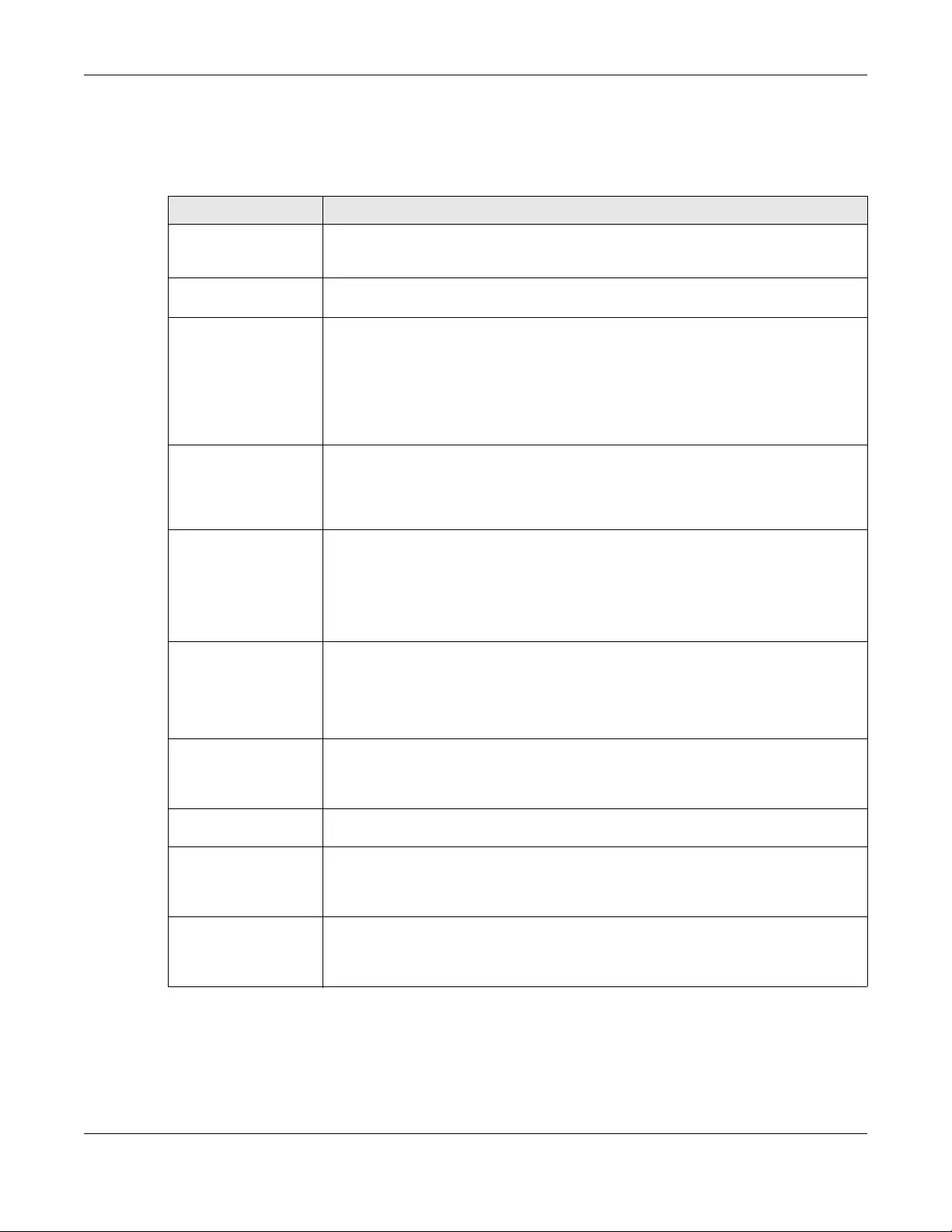
Chapter 30 IDP
ZyWALL/USG Series User’s Guide
492
Policy Types
This table describes Policy Types as categorized in the ZyWALL/USG.
Table 203 Policy Types
POLICY TYPE DESCRIPTION
Access Control Access control refers to procedures and controls that limit or detect access. Access
control attacks try to bypass validation checks in order to access network resources
such as servers, directories, and files.
Any Any attack includes all other kinds of attacks that are not specified in the policy such
as password, spoof, hijack, phishing, and close-in.
Backdoor/Trojan
Horse
A backdoor (also called a trapdoor) is hidden software or a hardware mechanism that
can be triggered to gain access to a program, online service or an entire computer
system. A Trojan horse is a harmful program that is hidden inside apparently
harmless programs or data.
Although a virus, a worm and a Trojan are different types of attacks, they can be
blended into one attack. For example, W32/Blaster and W32/Sasser are blended
attacks that feature a combination of a worm and a Trojan.
BotNet A Botnet is a number of Internet computers that have been set up to forward
transmissions including spam or viruses to other computers on the Internet though
their owners are unaware of it. It is also a collection of Internet-connected programs
communicating with other similar programs in order to perform tasks and participate
in distributed Denial-Of-Service attacks.
Buffer Overflow A buffer overflow occurs when a program or process tries to store more data in a
buffer (temporary data storage area) than it was intended to hold. The excess
information can overflow into adjacent buffers, corrupting or overwriting the valid
data held in them.
Intruders could run codes in the overflow buffer region to obtain control of the
system, install a backdoor or use the victim to launch attacks on other devices.
DoS/DDoS The goal of Denial of Service (DoS) attacks is not to steal information, but to disable
a device or network on the Internet.
A Distributed Denial of Service (DDoS) attack is one in which multiple compromised
systems attack a single target, thereby causing denial of service for users of the
targeted system.
Instant Messenger IM (Instant Messenger) refers to chat applications. Chat is real-time, text-based
communication between two or more users via networks-connected computers. After
you enter a chat (or chat room), any room member can type a message that will
appear on the monitors of all the other participants.
Mail A Mail or E-mail bombing attack involves sending several thoursand identical
messages to an electronic mailbox in order to overflow it, making it unusable.
Misc Miscellaneous attacks takes advantage of vulnerable computer networks and web
servers by forcing cache servers or web browsers into disclosing user-specific
information that might be sensitive and confidential. The most common type of Misc.
attacks are HTTP Response Smuggling, HTTP Response Splitting and JSON Hijacking.
P2P Peer-to-peer (P2P) is where computing devices link directly to each other and can
directly initiate communication with each other; they do not need an intermediary. A
device can be both the client and the server. In the ZyWALL/USG, P2P refers to peer-
to-peer applications such as e-Mule, e-Donkey, BitTorrent, iMesh, etc.
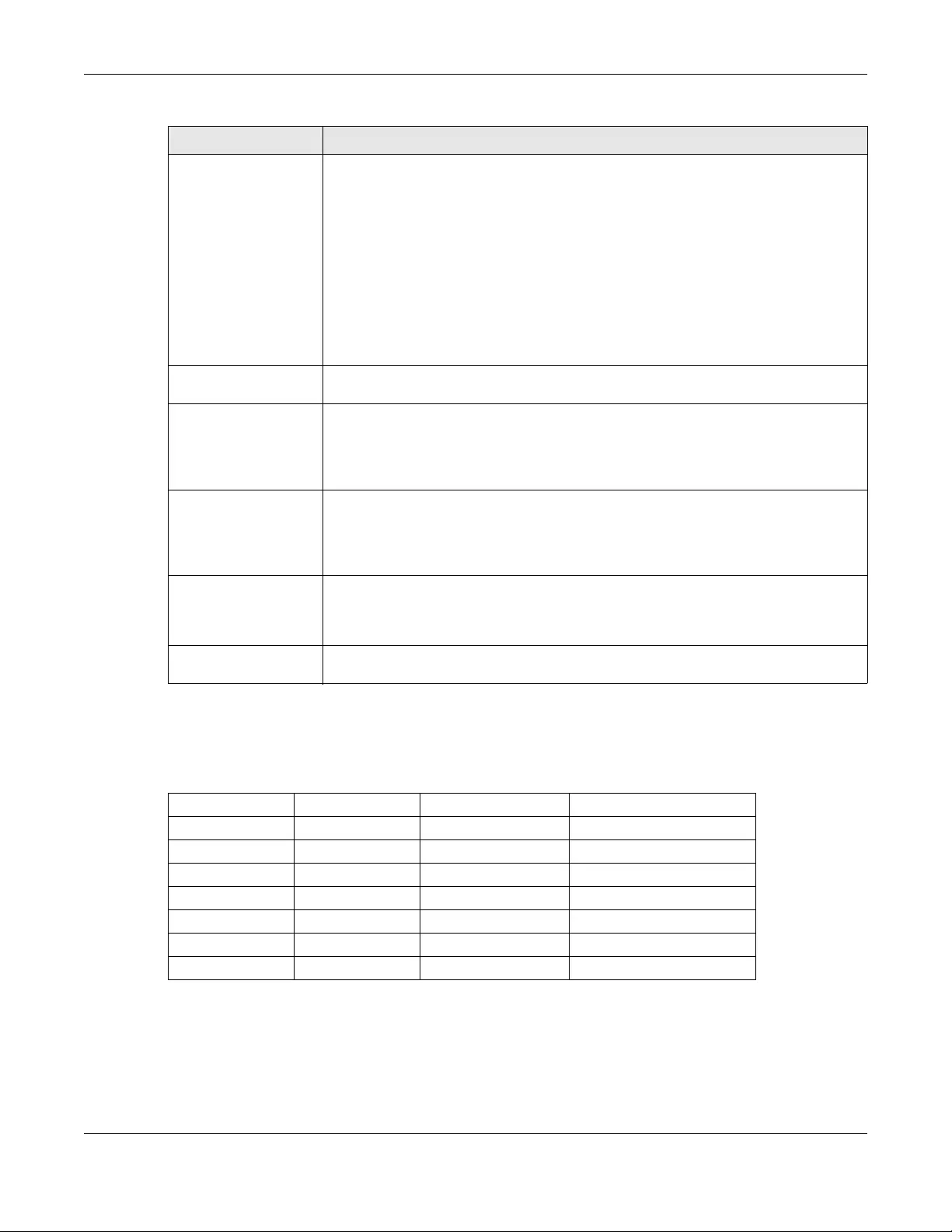
Chapter 30 IDP
ZyWALL/USG Series User’s Guide
493
IDP Service Groups
An IDP service group is a set of related packet inspection signatures.
The n/a service group is for signatures that are not for a specific service.
Scan A scan describes the action of searching a network for an exposed service. An attack
may then occur once a vulnerability has been found. Scans occur on several network
levels.
A network scan occurs at layer-3. For example, an attacker looks for network devices
such as a router or server running in an IP network.
A scan on a protocol is commonly referred to as a layer-4 scan. For example, once an
attacker has found a live end system, he looks for open ports.
A scan on a service is commonly referred to a layer-7 scan. For example, once an
attacker has found an open port, say port 80 on a server, he determines that it is a
HTTP service run by some web server application. He then uses a web vulnerability
scanner (for example, Nikto) to look for documented vulnerabilities.
SPAM Spam is unsolicited “junk” e-mail sent to large numbers of people to promote
products or services.
Stream Media A Stream Media attack occurs when a malicious network node downloads an
overwhelming amount of media stream data that could potentially exhaust the entire
system. This method allows users to send small requests messges that result in the
streaming of large media objects, providing an oportunity for malicious users to
exhaust resources in the system with little efffort expended on their part.
Tunnel A Tunneling attack involves sending IPv6 traffic over IPv4, slipping viruses, worms
and spyware through the network using secret tunnels. This method infiltrates
standard security measures through IPv6 tunnels, passing through IPv4 undetected.
An external signal then triggers the malware to spring to life and wreak havoc from
inside the network.
Virus/Worm A computer virus is a small program designed to corrupt and/or alter the operation of
other legitimate programs. A worm is a program that is designed to copy itself from
one computer to another on a network. A worm’s uncontrolled replication consumes
system resources, thus slowing or stopping other tasks.
Web Attack Web attacks refer to attacks on web servers such as IIS (Internet Information
Services).
Table 204 IDP Service Groups
WEB_PHP WEB_MISC WEB_IIS WEB_FRONTPAGE
WEB_CGI WEB_ATTACKS TFTP TELNET
SQL SNMP SMTP RSERVICES
RPC POP3 POP2 P2P
ORACLE NNTP NETBIOS MYSQL
MISC_EXPLOIT MISC_DDOS MISC_BACKDOOR MISC
IMAP IM ICMP FTP
FINGER DNS n/a
Table 203 Policy Types (continued)
POLICY TYPE DESCRIPTION
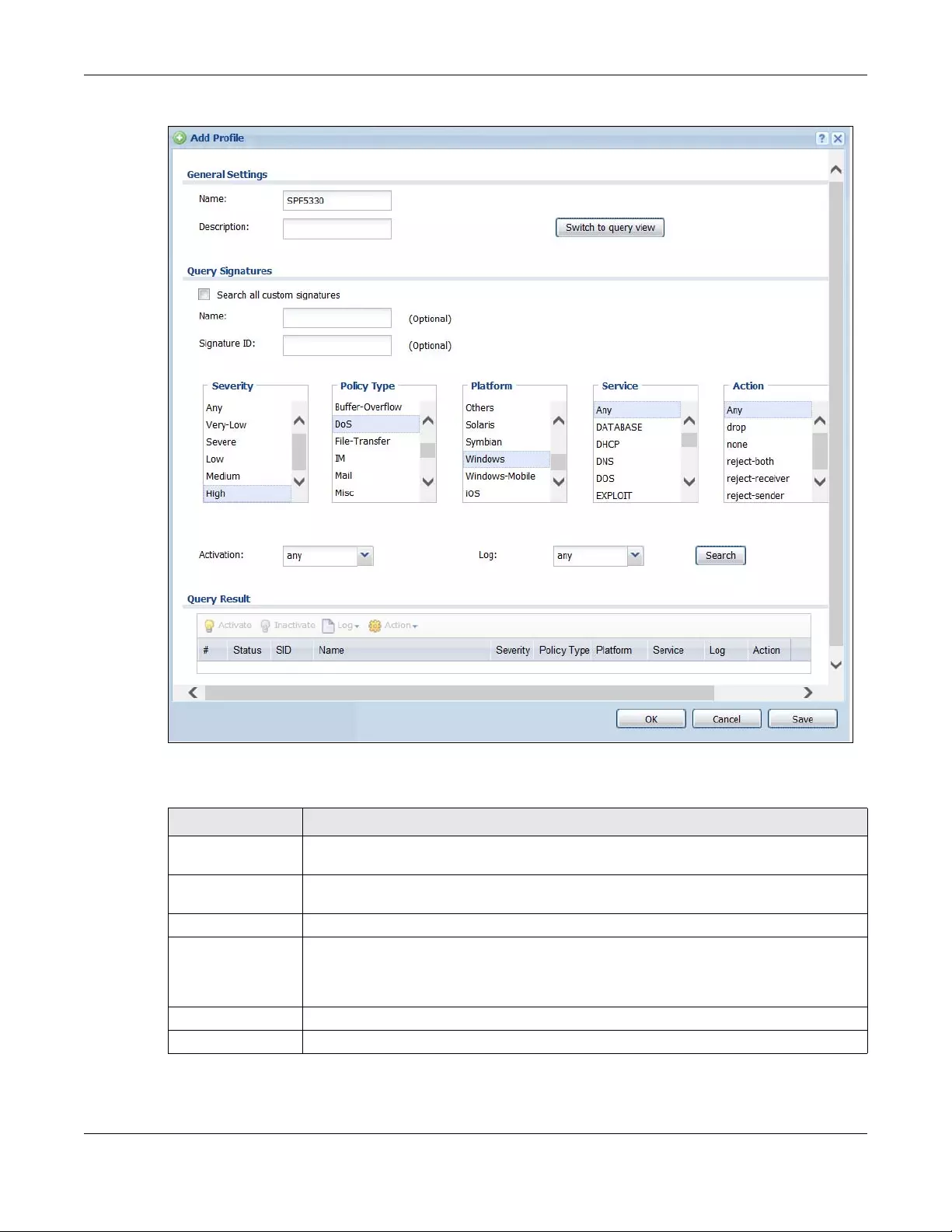
Chapter 30 IDP
ZyWALL/USG Series User’s Guide
494
Figure 333 Configuration > UTM Profile> IDP > Profile: Query View
The following table describes the fields specific to this screen’s query view.
Table 205 Configuration > UTM Profile > IDP > Profile: Query View
LABEL DESCRIPTION
Name This is the name of the profile that you created in the IDP > Profiles > Group View
screen.
Switch to query
view
Click this button to go to the IDP profile group view screen where IDP signatures are
grouped by service and you can configure activation, logs and/or actions.
Query Signatures Select the criteria on which to perform the search.
Search all
custom
signatures
Select this check box to include signatures you created or imported in the Custom
Signatures screen in the search. You can search for specific signatures by name or ID.
If the name and ID fields are left blank, then all signatures are searched according to
the criteria you select.
Name Type the name or part of the name of the signature(s) you want to find.
Signature ID Type the ID or part of the ID of the signature(s) you want to find.

Chapter 30 IDP
ZyWALL/USG Series User’s Guide
495
30.2.5 Query Example
This example shows a search with these criteria:
•Severity: high
•Policy Type: DoS
• Platform: Windows
•Service: Any
•Actions: Any
Severity Search for signatures by severity level(s). Hold down the [Ctrl] key if you want to make
multiple selections.
These are the severities as defined in the ZyWALL/USG. The number in brackets is the
number you use if using commands.
Severe (5): These denote attacks that try to run arbitrary code or gain system
privileges.
High (4): These denote known serious vulnerabilities or attacks that are probably not
false alarms.
Medium (3): These denote medium threats, access control attacks or attacks that could
be false alarms.
Low (2): These denote mild threats or attacks that could be false alarms.
Very-Low (1): These denote possible attacks caused by traffic such as Ping, trace
route, ICMP queries etc.
Attack Type Search for signatures by attack type(s) (see Table 203 on page 492). Attack types are
known as policy types in the group view screen. Hold down the [Ctrl] key if you want to
make multiple selections.
Platform Search for signatures created to prevent intrusions targeting specific operating
system(s). Hold down the [Ctrl] key if you want to make multiple selections.
Service Search for signatures by IDP service group(s). See Table 203 on page 492 for group
details. Hold down the [Ctrl] key if you want to make multiple selections.
Action Search for signatures by the response the ZyWALL/USG takes when a packet matches a
signature. See Table 202 on page 488 for action details. Hold down the [Ctrl] key if you
want to make multiple selections.
Activation Search for activated and/or inactivated signatures here.
Log Search for signatures by log option here. See Table 202 on page 488 for option details.
Search Click this button to begin the search. The results display at the bottom of the screen.
Results may be spread over several pages depending on how broad the search criteria
selected were. The tighter the criteria selected, the fewer the signatures returned.
Query Result The results are displayed in a table showing the SID, Name, Severity, Attack Type,
Platform, Service, Ac tivation, Log , and Action criteria as selected in the search.
Click the SID column header to sort search results by signature ID.
OK Click OK to save your settings to the ZyWALL/USG, complete the profile and return to
the profile summary page.
Cancel Click Cancel to return to the profile summary page without saving any changes.
Save Click Save to save the configuration to the ZyWALL/USG, but remain in the same page.
You may then go to the another profile screen (tab) in order to complete the profile.
Click OK in the final profile screen to complete the profile.
Table 205 Configuration > UTM Profile > IDP > Profile: Query View (continued)
LABEL DESCRIPTION
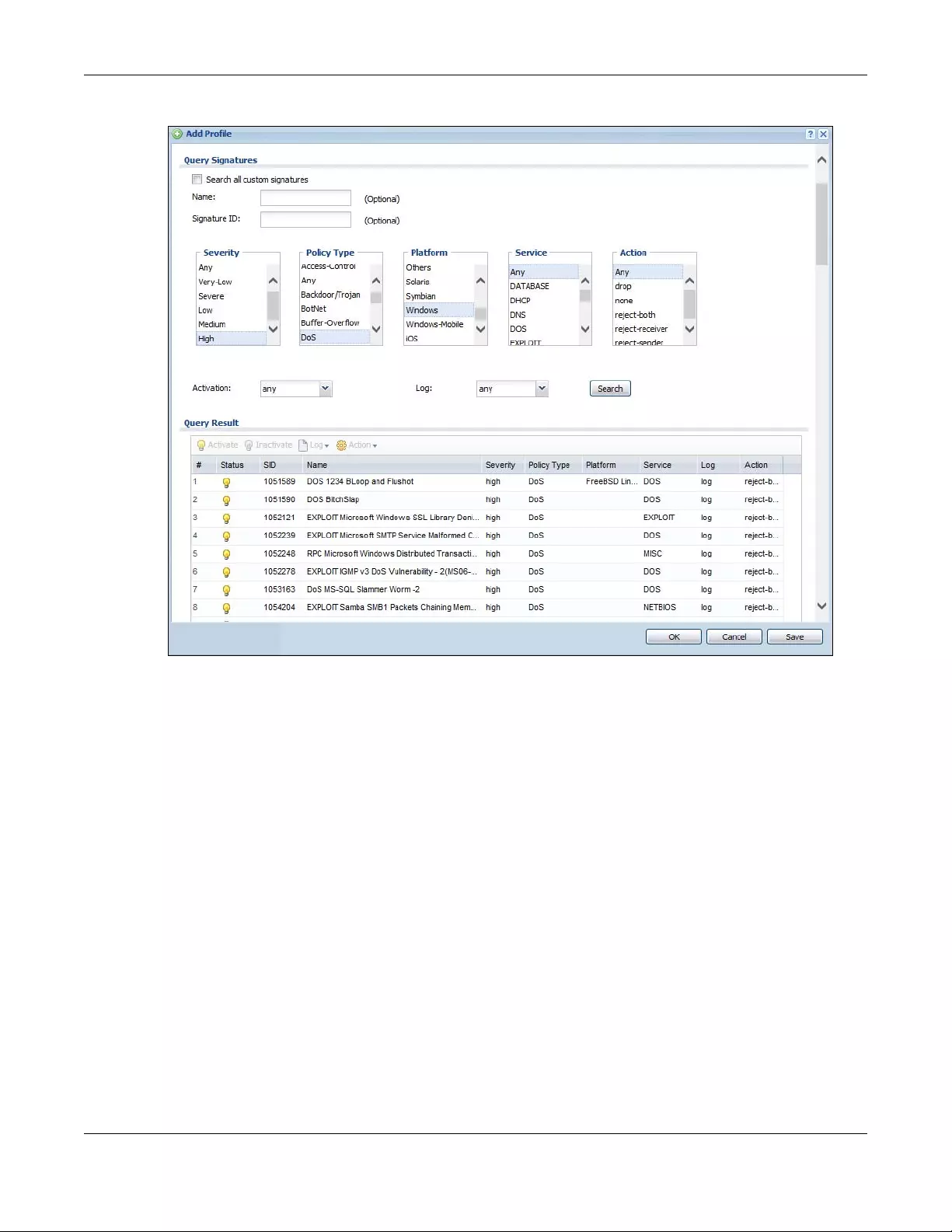
Chapter 30 IDP
ZyWALL/USG Series User’s Guide
496
Figure 334 Query Example Search
30.3 IDP Custom Signatures
Create custom signatures for new attacks or attacks peculiar to your network. Custom signatures
can also be saved to/from your computer so as to share with others.
You need some knowledge of packet headers and attack types to create your own custom
signatures.
IP Packet Header
These are the fields in an Internet Protocol (IP) version 4 packet header.

Chapter 30 IDP
ZyWALL/USG Series User’s Guide
497
Figure 335 IP v4 Packet Headers
The header fields are discussed in the following table.
Table 206 IP v4 Packet Headers
HEADER DESCRIPTION
Version The value 4 indicates IP version 4.
IHL IP Header Length is the number of 32 bit words forming the total length of the
header (usually five).
Type of Service The Type of Service, (also known as Differentiated Services Code Point (DSCP)) is
usually set to 0, but may indicate particular quality of service needs from the
network.
Total Length This is the size of the datagram in bytes. It is the combined length of the header
and the data.
Identification This is a 16-bit number, which together with the source address, uniquely
identifies this packet. It is used during reassembly of fragmented datagrams.
Flags Flags are used to control whether routers are allowed to fragment a packet and to
indicate the parts of a packet to the receiver.
Fragment Offset This is a byte count from the start of the original sent packet.
Time To Live This is a counter that decrements every time it passes through a router. When it
reaches zero, the datagram is discarded. It is used to prevent accidental routing
loops.
Protocol The protocol indicates the type of transport packet being carried, for example, 1 =
ICMP; 2= IGMP; 6 = TCP; 17= UDP.
Header Checksum This is used to detect processing errors introduced into the packet inside a router
or bridge where the packet is not protected by a link layer cyclic redundancy
check. Packets with an invalid checksum are discarded by all nodes in an IP
network.
Source IP Address This is the IP address of the original sender of the packet.
Destination IP Address This is the IP address of the final destination of the packet.
Options IP options is a variable-length list of IP options for a datagram that define IP
Security Option, IP Stream Identifier, (security and handling restrictions for
the military), Record Route (have each router record its IP address), Loose
Source Routing (specifies a list of IP addresses that must be traversed by the
datagram), Strict Source Routing (specifies a list of IP addresses that must
ONLY be traversed by the datagram), Timestamp (have each router record its IP
address and time), End of IP List and No IP Options.
Padding Padding is used as a filler to ensure that the IP packet is a multiple of 32 bits.
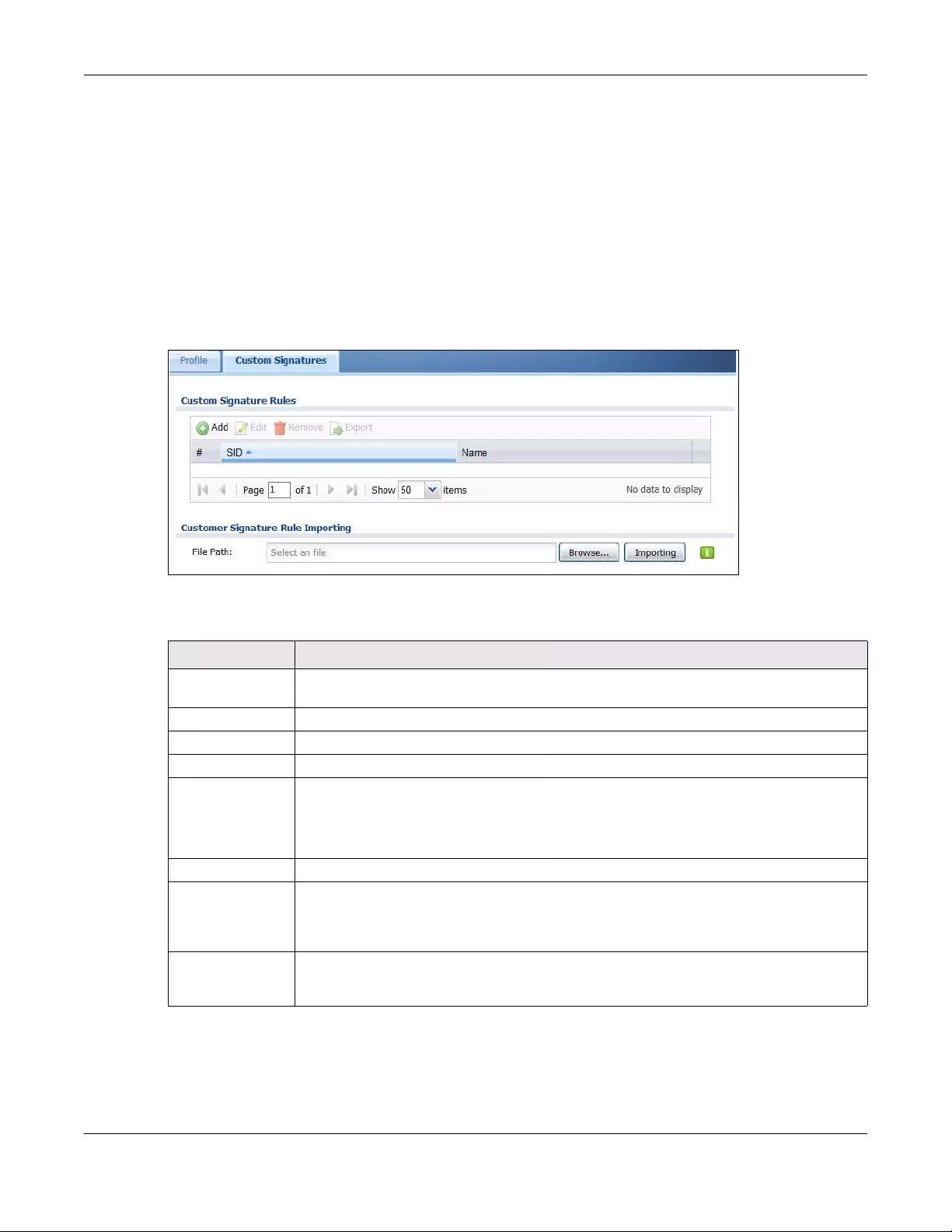
Chapter 30 IDP
ZyWALL/USG Series User’s Guide
498
Select Configuration > UTM Profile > IDP > Custom Signatures. The first screen shows a
summary of all custom signatures created. Click the SID or Name heading to sort. Click the Add
icon to create a new signature or click the Edit icon to edit an existing signature. You can also
delete custom signatures here or save them to your computer.
Note: The ZyWALL/USG checks all signatures and continues searching even after a match
is found. If two or more rules have conflicting actions for the same packet, then the
ZyWALL/USG applies the more restrictive action (reject-both, reject-receiver or
reject-sender, drop, none in this order). If a packet matches a rule for reject-
receiver and it also matches a rule for reject-sender, then the ZyWALL/USG will
reject-both.
Figure 336 Configuration > UTM Profile > IDP > Custom Signatures
The following table describes the fields in this screen.
Table 207 Configuration > UTM Profile> IDP > Custom Signatures
LABEL DESCRIPTION
Custom Signature
Rules
Use this part of the screen to create, edit, delete or export (save to your computer)
custom signatures.
Add Click this to create a new entry.
Edit Select an entry and click this to be able to modify it.
Remove Select an entry and click this to delete it.
Export To save an entry or entries as a file on your computer, select them and click Export. Click
Save in the file download dialog box and then select a location and name for the file.
Custom signatures must end with the ‘rules’ file name extension, for example,
MySig.rules.
#This is the entry’s index number in the list.
SID SID is the signature ID that uniquely identifies a signature. Click the SID header to sort
signatures in ascending or descending order. It is automatically created when you click
the Add icon to create a new signature. You can edit the ID, but it cannot already exist
and it must be in the 9000000 to 9999999 range.
Name This is the name of your custom signature. Duplicate names can exist, but it is advisable
to use unique signature names that give some hint as to intent of the signature and the
type of attack it is supposed to prevent.
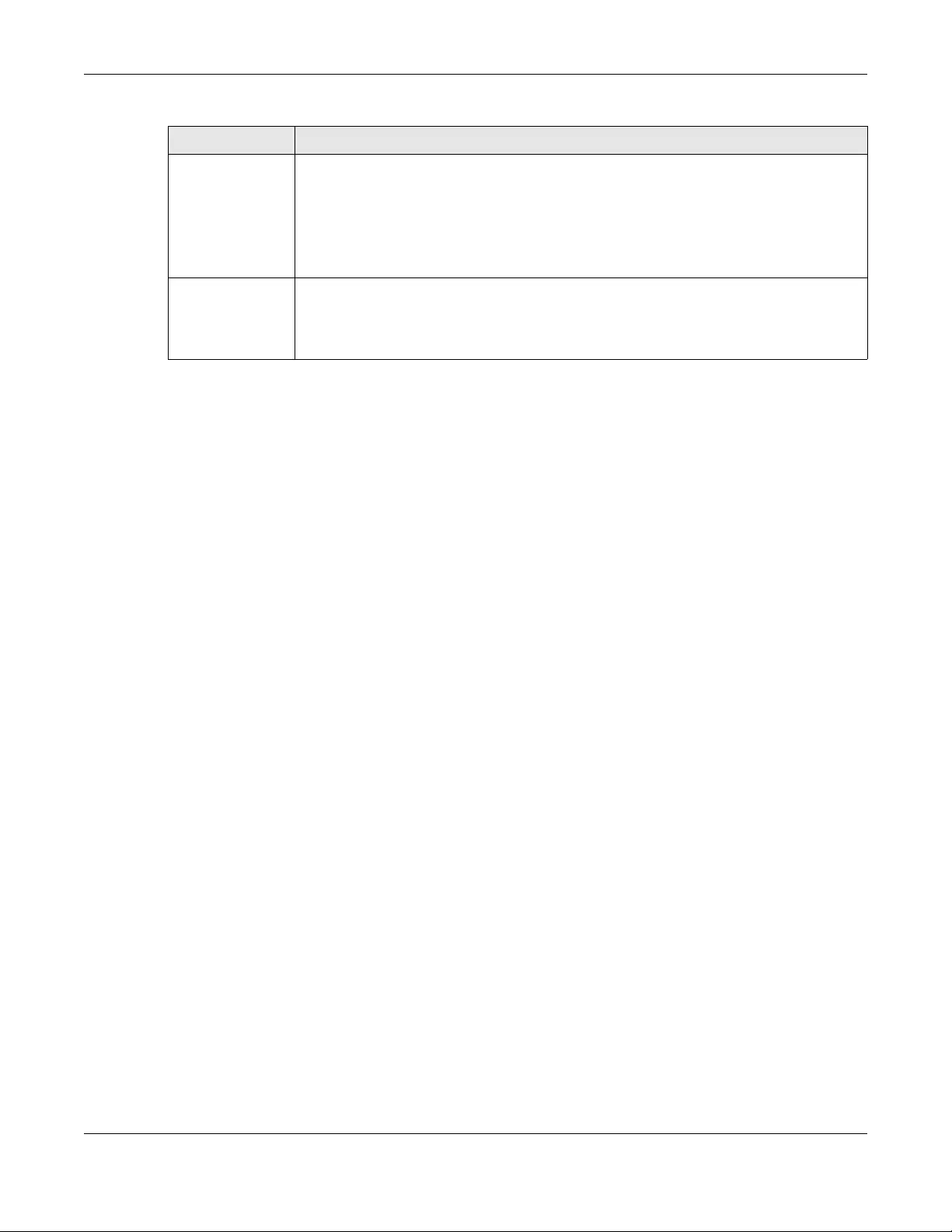
Chapter 30 IDP
ZyWALL/USG Series User’s Guide
499
30.3.1 Add / Edit Custom Signatures
Click the Add icon to create a new signature or click the Edit icon to edit an existing signature in
the screen as shown in Figure 336 on page 498.
A packet must match all items you configure in this screen before it matches the signature. The
more specific your signature (including packet contents), then the fewer false positives the
signature will trigger.
Try to write signatures that target a vulnerability, for example a certain type of traffic on certain
operating systems, instead of a specific exploit.
Customer
Signature Rule
Importing
Use this part of the screen to import custom signatures (previously saved to your
computer) to the ZyWALL/USG.
Note: The name of the complete custom signature file on the ZyWALL/USG is
‘custom.rules’. If you import a file named ‘custom.rules’, then all custom signatures
on the ZyWALL/USG are overwritten with the new file. If this is not your intention,
make sure that the files you import are not named ‘custom.rules’.
File Path Type the file path and name of the custom signature file you want to import in the text
box (or click Browse to find it on your computer) and then click Importing to transfer
the file to the ZyWALL/USG.
New signatures then display in the ZyWALL/USG IDP > Custom Signatures screen.
Table 207 Configuration > UTM Profile> IDP > Custom Signatures (continued)
LABEL DESCRIPTION
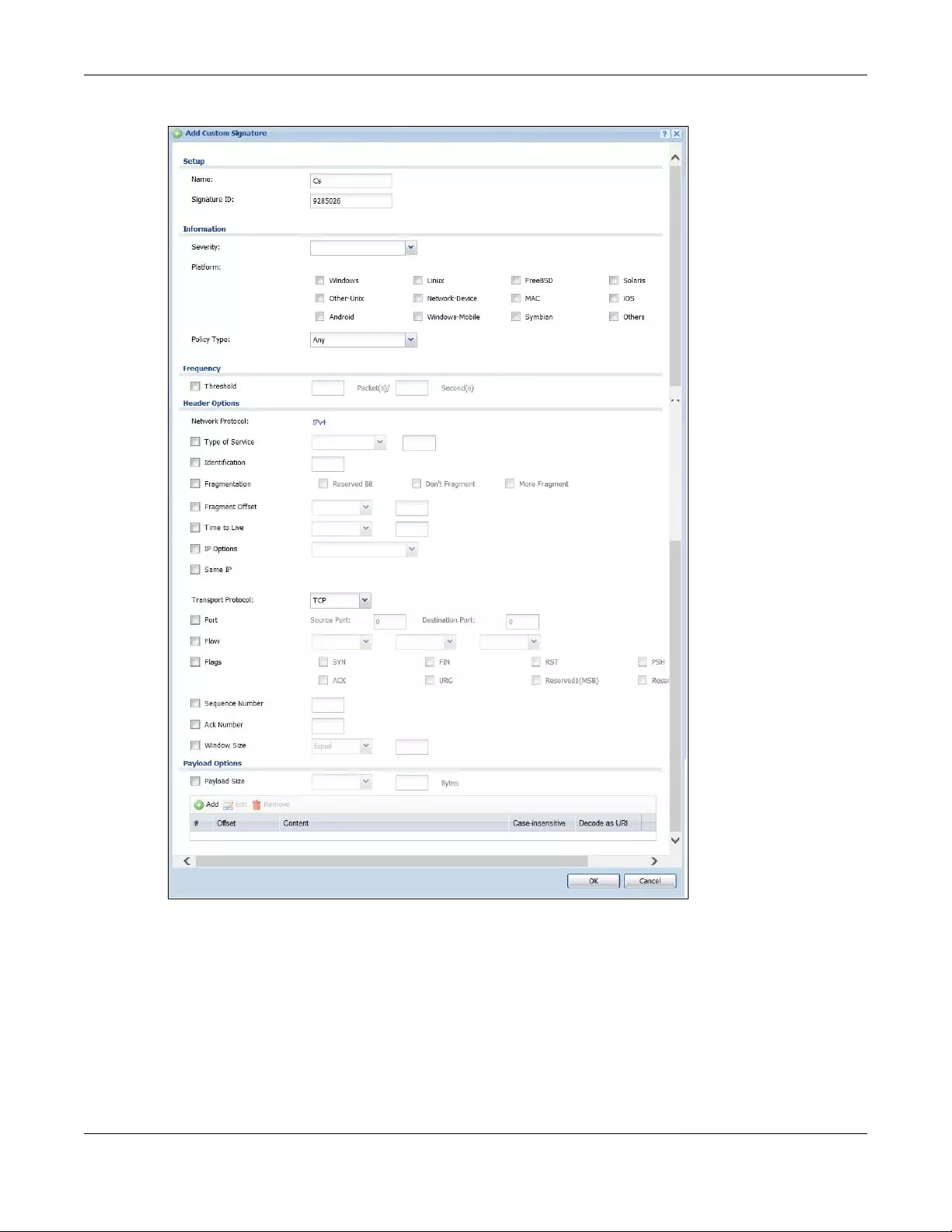
Chapter 30 IDP
ZyWALL/USG Series User’s Guide
500
Figure 337 Configuration > UTM Profile > IDP > Custom Signatures > Add/Edit
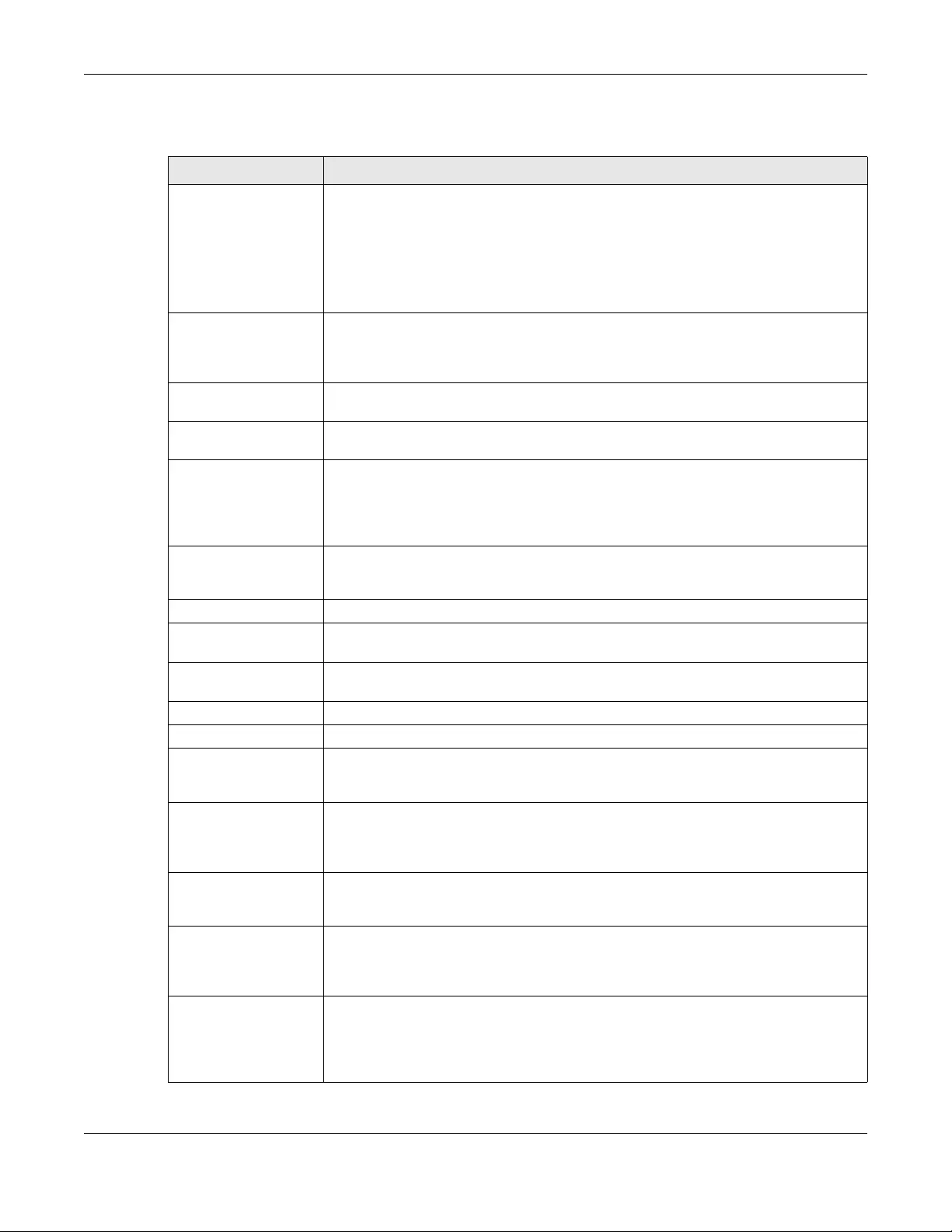
Chapter 30 IDP
ZyWALL/USG Series User’s Guide
501
The following table describes the fields in this screen.
Table 208 Configuration > UTM Profile > IDP > Custom Signatures > Add/Edit
LABEL DESCRIPTION
Name Type the name of your custom signature. You may use 1-31 alphanumeric
characters, underscores(_), or dashes (-), but the first character cannot be a
number. This value is case-sensitive.
Duplicate names can exist but it is advisable to use unique signature names that give
some hint as to intent of the signature and the type of attack it is supposed to
prevent. Refer to (but do not copy) the packet inspection signature names for hints
on creating a naming convention.
Signature ID A signature ID is automatically created when you click the Add icon to create a new
signature. You can edit the ID to create a new one (in the 9000000 to 9999999
range), but you cannot use one that already exists. You may want to do that if you
want to order custom signatures by SID.
Information Use the following fields to set general information about the signature as denoted
below.
Severity The severity level denotes how serious the intrusion is. Categorize the seriousness of
the intrusion here. See Table 202 on page 488 as a reference.
Platform Some intrusions target specific operating systems only. Select the operating systems
that the intrusion targets, that is, the operating systems you want to protect from
this intrusion. SGI refers to Silicon Graphics Incorporated, who manufactures multi-
user Unix workstations that run the IRIX operating system (SGI's version of UNIX). A
router is an example of a network device.
Service Select the IDP service group that the intrusion exploits or targets. See Table 204 on
page 493 for a list of IDP service groups. The custom signature then appears in that
group in the IDP > Profile > Group View screen.
Policy Type Categorize the attack type here. See Table 203 on page 492 as a reference.
Frequency Recurring packets of the same type may indicate an attack. Use the following field to
indicate how many packets per how many seconds constitute an intrusion
Threshold Select Threshold and then type how many packets (that meet the criteria in this
signature) per how many seconds constitute an intrusion.
Header Options
Network Protocol Configure signatures for IP version 4.
Type Of Service Type of service in an IP header is used to specify levels of speed and/or reliability.
Some intrusions use an invalid Type Of Service number. Select the check box, then
select Equal or Not-Equal and then type in a number.
Identification The identification field in a datagram uniquely identifies the datagram. If a datagram
is fragmented, it contains a value that identifies the datagram to which the fragment
belongs. Some intrusions use an invalid Identification number. Select the check
box and then type in the invalid number that the intrusion uses.
Fragmentation A fragmentation flag identifies whether the IP datagram should be fragmented, not
fragmented or is a reserved bit. Some intrusions can be identified by this flag. Select
the check box and then select the flag that the intrusion uses.
Fragment Offset When an IP datagram is fragmented, it is reassembled at the final destination. The
fragmentation offset identifies where the fragment belongs in a set of fragments.
Some intrusions use an invalid Fragment Offset number. Select the check box,
select Equal, Smaller or Greater and then type in a number
Time to Live Time to Live is a counter that decrements every time it passes through a router.
When it reaches zero, the datagram is discarded. Usually it’s used to set an upper
limit on the number of routers a datagram can pass through. Some intrusions can be
identified by the number in this field. Select the check box, select Equal, Smaller or
Greater and then type in a number.

Chapter 30 IDP
ZyWALL/USG Series User’s Guide
502
IP Options IP options is a variable-length list of IP options for a datagram that define IP
Security Option, IP Stream Identifier, (security and handling restrictions for the
military), Record Route (have each router record its IP address), Loose Source
Routing (specifies a list of IP addresses that must be traversed by the datagram),
Strict Source Ro uting (specifies a list of IP addresses that must ONLY be traversed
by the datagram), Timestamp (have each router record its IP address and time),
End of IP List and No IP Option s . IP Options can help identify some intrusions.
Select the check box, then select an item from the list box that the intrusion uses
Same IP Select the check box for the signature to check for packets that have the same
source and destination IP addresses.
Transport Protocol The following fields vary depending on whether you choose TCP, UDP or ICMP.
Transport Protocol:
TCP
Port Select the check box and then enter the source and destination TCP port numbers
that will trigger this signature.
Flow If selected, the signature only applies to certain directions of the traffic flow and only
to clients or servers. Select Flow and then select the identifying options.
Established: The signature only checks for established TCP connections
Stateless: The signature is triggered regardless of the state of the stream processor
(this is useful for packets that are designed to cause devices to crash)
To Client: The signature only checks for server responses from A to B.
To Server: The signature only checks for client requests from B to A.
From Client: The signature only checks for client requests from B to A.
From Servers: The signature only checks for server responses from A to B.
No Stream: The signature does not check rebuilt stream packets.
Only Stream: The signature only checks rebuilt stream packets.
Flags Select what TCP flag bits the signature should check.
Sequence Number Use this field to check for a specific TCP sequence number.
Ack Number Use this field to check for a specific TCP acknowledgement number.
Window Size Use this field to check for a specific TCP window size.
Transport Protocol:
UDP
Port Select the check box and then enter the source and destination UDP port numbers
that will trigger this signature.
Transport Protocol:
ICMP
Type Use this field to check for a specific ICMP type value.
Code Use this field to check for a specific ICMP code value.
ID Use this field to check for a specific ICMP ID value. This is useful for covert channel
programs that use static ICMP fields when they communicate.
Sequence Number Use this field to check for a specific ICMP sequence number. This is useful for covert
channel programs that use static ICMP fields when they communicate.
Payload Options The longer a payload option is, the more exact the match, the faster the signature
processing. Therefore, if possible, it is recommended to have at least one payload
option in your signature.
Table 208 Configuration > UTM Profile > IDP > Custom Signatures > Add/Edit (continued)
LABEL DESCRIPTION
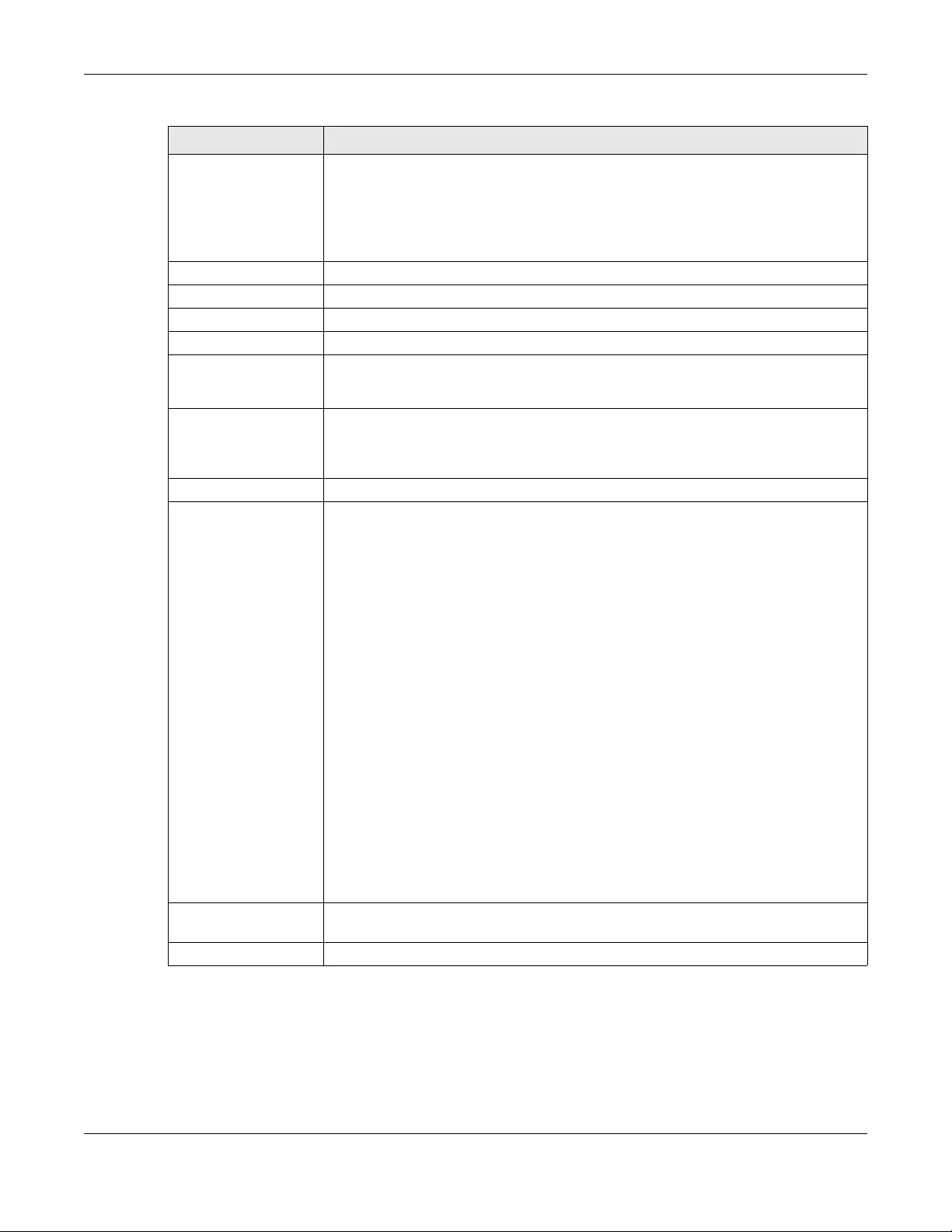
Chapter 30 IDP
ZyWALL/USG Series User’s Guide
503
30.3.2 Custom Signature Exampl e
Before creating a custom signature, you must first clearly understand the vulnerability.
Payload Size This field may be used to check for abnormally sized packets or for detecting buffer
overflows.
Select the check box, then select Equal, Smaller or Greater and then type the
payload size.
Stream rebuilt packets are not checked regardless of the size of the payload.
Add Click this to create a new entry.
Edit Select an entry and click this to be able to modify it.
Remove Select an entry and click this to delete it.
#This is the entry’s index number in the list.
Offset This field specifies where to start searching for a pattern within a packet. For
example, an offset of 5 would start looking for the specified pattern after the first
five bytes of the payload.
Content Type the content that the signature should search for in the packet payload.
Hexadecimal code entered between pipes is converted to ASCII. For example, you
could represent the ampersand as either & or |26| (26 is the hexadecimal code for
the ampersand).
Case-insensitive Select Yes if content casing does NOT matter.
Decode as URI A Uniform Resource Identifier (URI) is a string of characters for identifying an
abstract or physical resource (RFC 2396). A resource can be anything that has
identity, for example, an electronic document, an image, a service (“today's weather
report for Taiwan”), a collection of other resources. An identifier is an object that can
act as a reference to something that has identity. Example URIs are:
ftp://ftp.is.co.za/rfc/rfc1808.txt; ftp scheme for File Transfer Protocol services
http://www.math.uio.no/faq/compression-faq/part1.html; http scheme for
Hypertext Transfer Protocol services
mailto:mduerst@ifi.unizh.ch; mailto scheme for electronic mail addresses
telnet://melvyl.ucop.edu/; telnet scheme for interactive services via the TELNET
Protocol
Select Yes for the signature to search for normalized URI fields. This means that if
you are writing signatures that includes normalized content, such as %2 for directory
traversals, these signatures will not be triggered because the content is normalized
out of the URI buffer.
For example, the URI:
/scripts/..%c0%af../winnt/system32/cmd.exe?/c+ver
will get normalized into:
/winnt/system32/cmd.exe?/c+ver
OK Click this button to save your changes to the ZyWALL/USG and return to the
summary screen.
Cancel Click this button to return to the summary screen without saving any changes.
Table 208 Configuration > UTM Profile > IDP > Custom Signatures > Add/Edit (continued)
LABEL DESCRIPTION
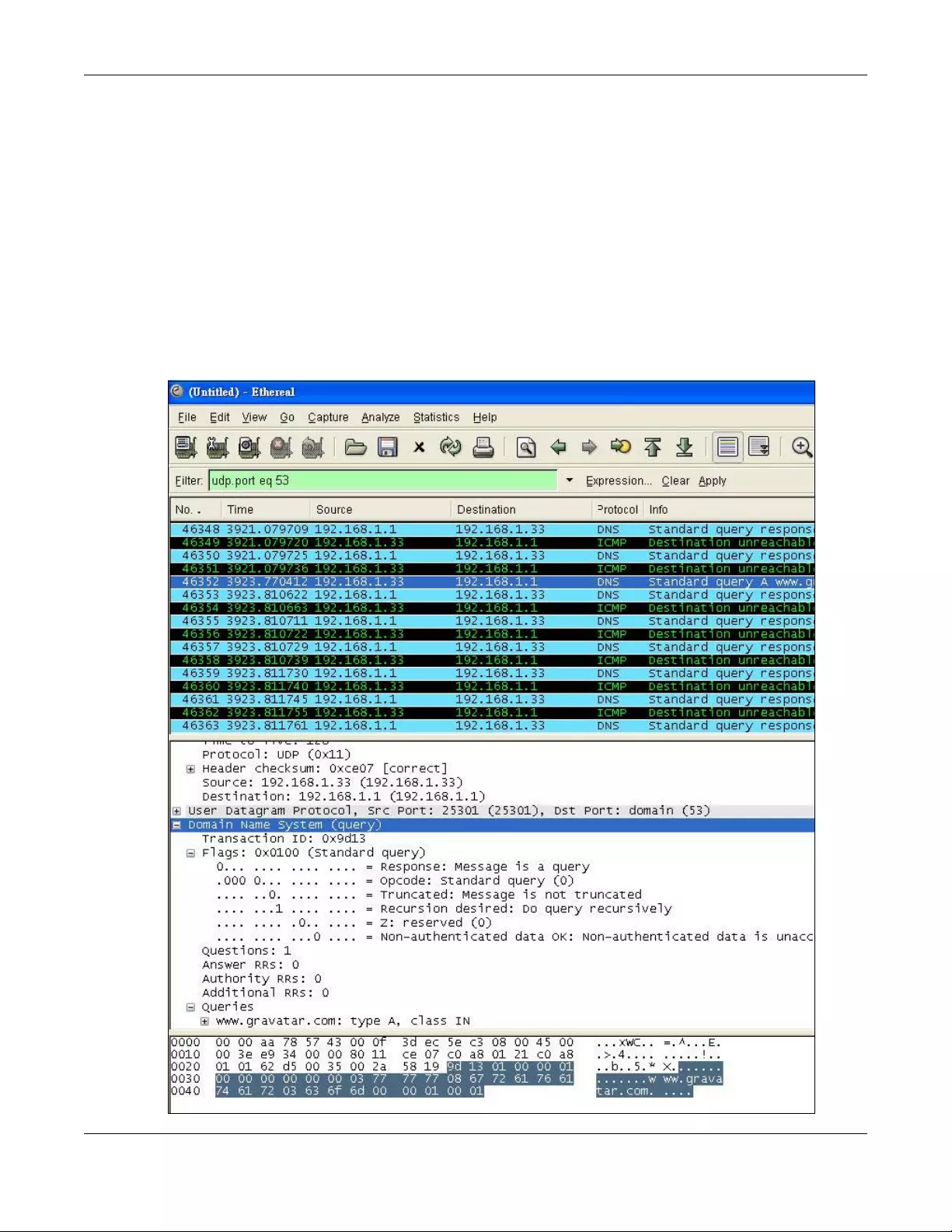
Chapter 30 IDP
ZyWALL/USG Series User’s Guide
504
30.3.2.1 Understand the Vulnerability
Check the ZyWALL/USG logs when the attack occurs. Use web sites such as Google or Security
Focus to get as much information about the attack as you can. The more specific your signature,
the less chance it will cause false positives.
As an example, say you want to check if your router is being overloaded with DNS queries so you
create a signature to detect DNS query traffic.
30.3.2.2 Analyze Packets
Use the packet capture screen and a packet analyzer (also known as a network or protocol
analyzer) such as Wireshark or Ethereal to investigate some more.
Figure 338 DNS Query Packet Details

Chapter 30 IDP
ZyWALL/USG Series User’s Guide
505
From the details about DNS query you see that the protocol is UDP and the port is 53. The type of
DNS packet is standard query and the Flag is 0x0100 with an offset of 2. Therefore enter |010| as
the first pattern.
The final custom signature should look like as shown in the following figure.
Figure 339 Example Custom Signature
30.3.3 Applying Custom Signatures
After you create your custom signature, it becomes available in an IDP profile (Configuration >
UTM Profile > IDP > Profile > Edit) screen. Custom signatures have an SID from 9000000 to
9999999.
Search for, then activate the signature, configure what action to take when a packet matches it and
if it should generate a log or alert in a profile. Then bind the profile to a zone.
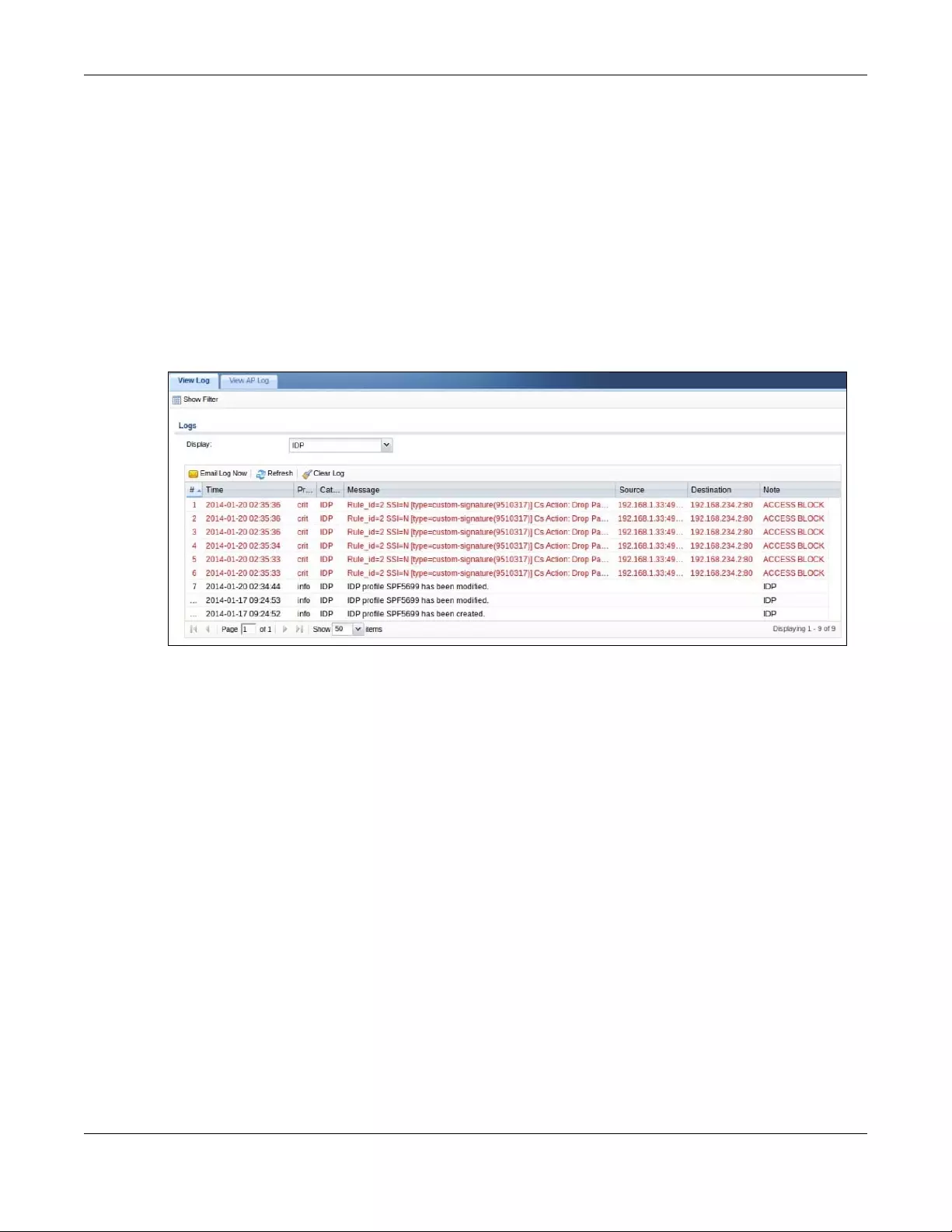
Chapter 30 IDP
ZyWALL/USG Series User’s Guide
506
30.3.4 Verifying Custom Signatures
Configure the signature to create a log when traffic matches the signature. (You may also want to
configure an alert if it is for a serious attack and needs immediate attention.) After you apply the
signature to a zone, you can see if it works by checking the logs (Monitor > Log).
The Priority column shows warn for signatures that are configured to generate a log only. It
shows critical for signatures that are configured to generate a log and alert. All IDP signatures
come under the IDP category. The Note column displays ACCESS FORWARD when no action is
configured for the signature. It displays ACCESS DENIED if you configure the signature action to
drop the packet. The destination port is the service port (53 for DNS in this case) that the attack
tries to exploit.
Figure 340 Custom Signature Log
30.4 IDP Technical Reference
This section contains some background information on IDP.
Host Intrusions
The goal of host-based intrusions is to infiltrate files on an individual computer or server in with the
goal of accessing confidential information or destroying information on a computer.
You must install a host IDP directly on the system being protected. It works closely with the
operating system, monitoring and intercepting system calls to the kernel or APIs in order to prevent
attacks as well as log them.
Disadvantages of host IDPs are that you have to install them on each device (that you want to
protect) in your network and due to the necessarily tight integration with the host operating
system, future operating system upgrades could cause problems.
Network Intrusions
Network-based intrusions have the goal of bringing down a network or networks by attacking
computer(s), switch(es), router(s) or modem(s). If a LAN switch is compromised for example, then

Chapter 30 IDP
ZyWALL/USG Series User’s Guide
507
the whole LAN is compromised. Host-based intrusions may be used to cause network-based
intrusions when the goal of the host virus is to propagate attacks on the network, or attack
computer/server operating system vulnerabilities with the goal of bringing down the computer/
server. Typical “network-based intrusions” are SQL slammer, Blaster, Nimda MyDoom etc.
Snort Signatures
You may want to refer to open source Snort signatures when creating custom ZyWALL/USG ones.
Most Snort rules are written in a single line. Snort rules are divided into two logical sections, the
rule header and the rule options as shown in the following example:
alert tcp any any -> 192.168.1.0/24 111 (content:”|00 01 a5|”; msg:”mountd access ”;)
The text up to the first parenthesis is the rule header and the section enclosed in parenthesis
contains the rule options. The words before the colons in the rule options section are the option
keywords.
The rule header contains the rule's:
•Action
•Protocol
• Source and destination IP addresses and netmasks
• Source and destination ports information.
The rule option section contains alert messages and information on which parts of the packet
should be inspected to determine if the rule action should be taken.
These are some equivalent Snort terms in the ZyWALL/USG.
Table 209 ZyWALL/USG - Snort Equivalent Terms
ZYWALL/USG TERM SNORT EQUIVALENT TERM
Type Of Service tos
Identification id
Fragmentation fragbits
Fragmentation Offset fragoffset
Time to Live ttl
IP Options ipopts
Same IP sameip
Transport Protocol
Transport Protocol: TCP
Port (In Snort rule header)
Flow flow
Flags flags
Sequence Number seq
Ack Number ack
Window Size window
Transport Protocol: UDP (In Snort rule header)
Port (In Snort rule header)
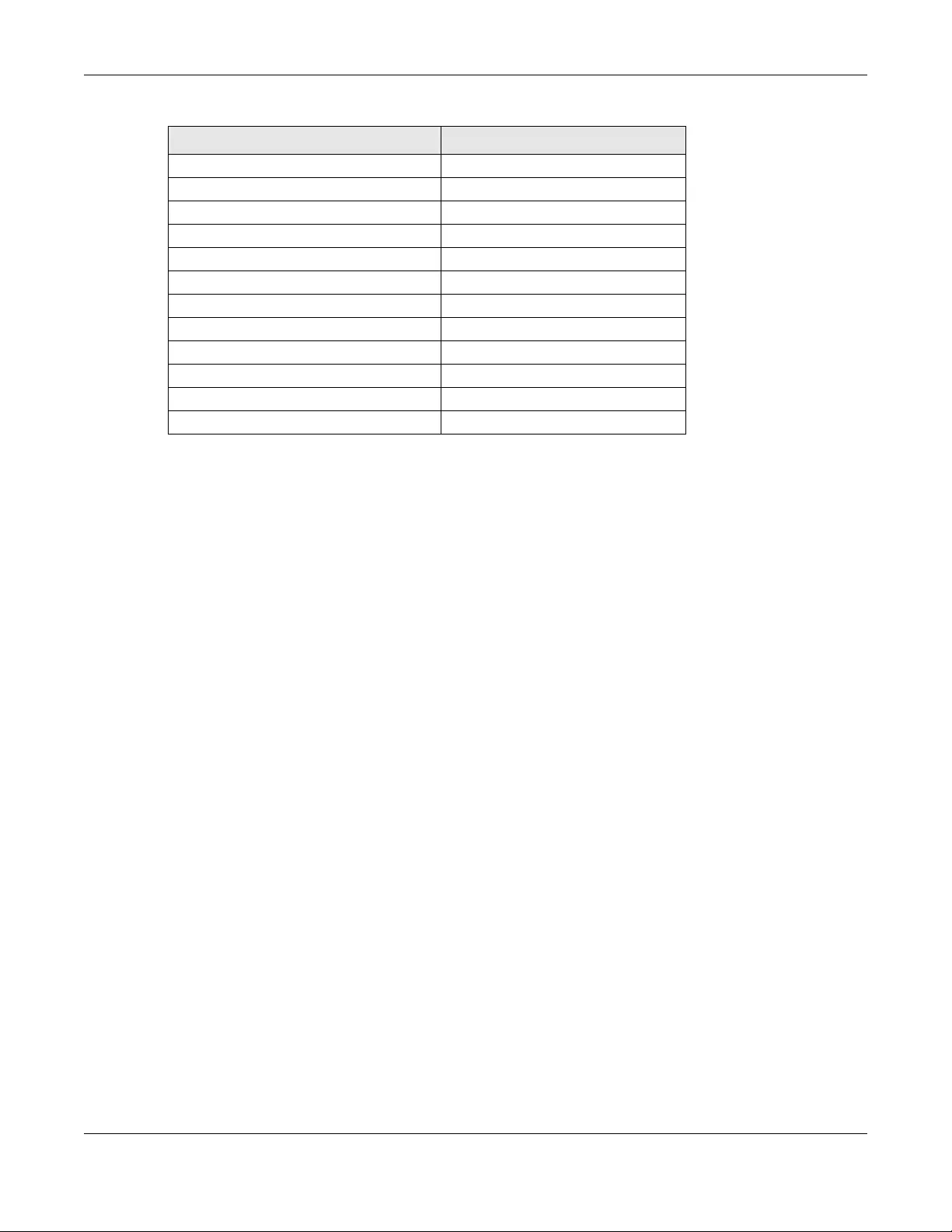
Chapter 30 IDP
ZyWALL/USG Series User’s Guide
508
Note: Not all Snort functionality is supported in the ZyWALL/USG.
Transport Protocol: ICMP
Type itype
Code icode
ID icmp_id
Sequence Number icmp_seq
Payload Options (Snort rule options)
Payload Size dsize
Offset (relative to start of payload) offset
Relative to end of last match distance
Content content
Case-insensitive nocase
Decode as URI uricontent
Table 209 ZyWALL/USG - Snort Equivalent Terms (continued)
ZYWALL/USG TERM SNORT EQUIVALENT TERM
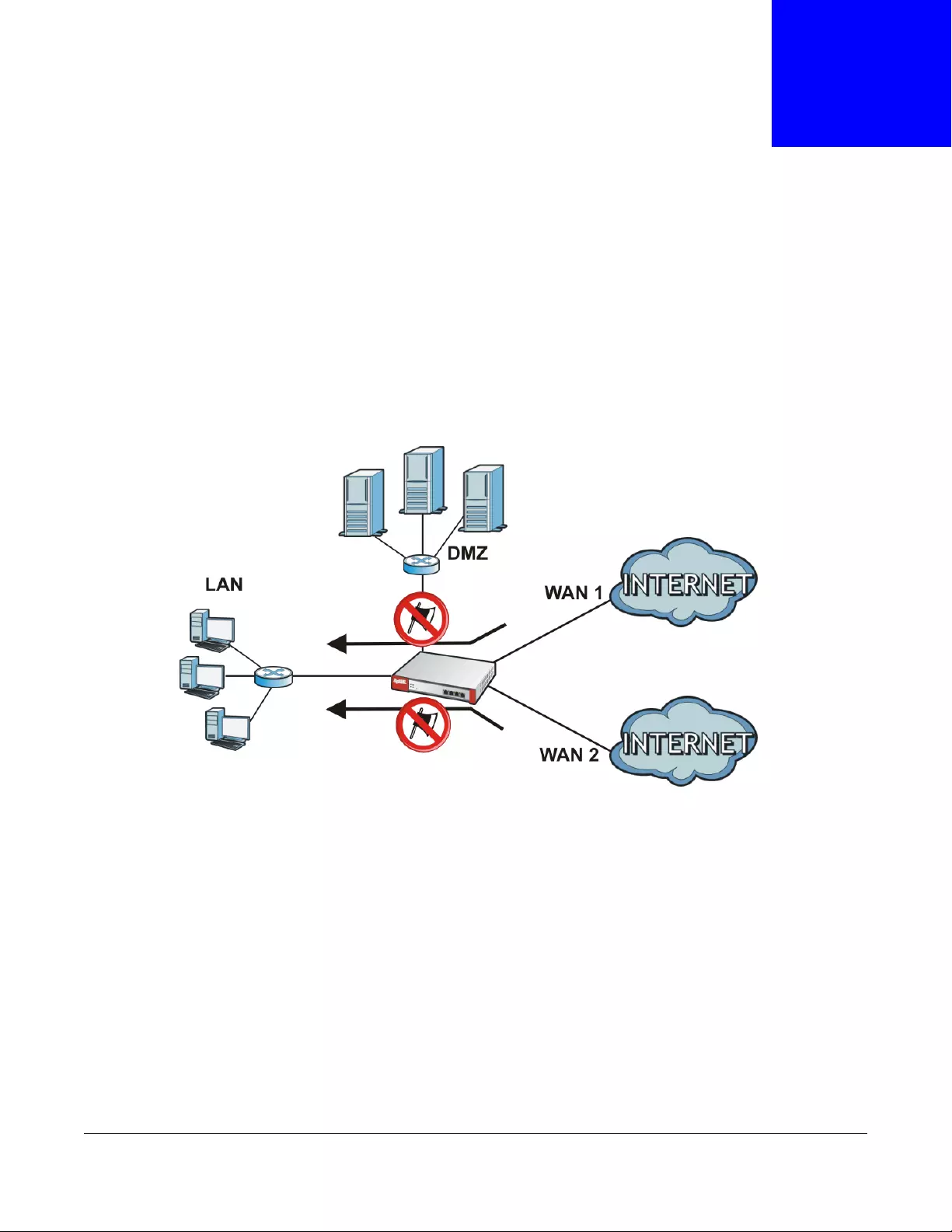
ZyWALL/USG Series User’s Guide
509
CHAPTER 31
Anti-Virus
31.1 Overview
Use the ZyWALL/USG’s anti-virus feature to protect your connected network from virus/spyware
infection. The ZyWALL/USG checks traffic going in the direction(s) you specify for signature
matches. In the following figure the ZyWALL/USG is set to check traffic coming from the WAN zone
(which includes two interfaces) to the LAN zone.
Figure 341 ZyWALL/USG Anti-Virus Example
31.1.1 What You Can Do in this Chapter
•Use the Profile screens (Section 31.2 on page 511) to turn anti-virus on or off, set up anti-virus
policies and custom service port rules. You can also check the anti-virus engine type and the anti-
virus license and signature status.
•Use the Black/White List screen (Section 31.3 on page 515) to set up anti-virus black
(blocked) and white (allowed) lists of virus file patterns.
•Use the Signature screen (Section 31.4 on page 518) to search for particular signatures and get
more information about them.

Chapter 31 Anti-Virus
ZyWALL/USG Series User’s Guide
510
31.1.2 What You Need to Know
Anti-Virus Engines
Subscribe to signature files for Kaspersky’s anti-virus engine. After the trial expires, you need to
purchase an iCard for the anti-virus engine you want to use and register it in the Registration >
Service screen. You must use the Kaspersky anti-virus iCard for the Kaspersky anti-virus engine.
Virus and Worm
A computer virus is a small program designed to corrupt and/or alter the operation of other
legitimate programs. A worm is a self-replicating virus that resides in active memory and duplicates
itself. The effect of a virus attack varies from doing so little damage that you are unaware your
computer is infected to wiping out the entire contents of a hard drive to rendering your computer
inoperable.
ZyWALL/USG Anti-Virus Scanner
The ZyWALL/USG has a built-in signature database. Setting up the ZyWALL/USG between your local
network and the Internet allows the ZyWALL/USG to scan files transmitting through the enabled
interfaces into your network. As a network-based anti-virus scanner, the ZyWALL/USG helps stop
threats at the network edge before they reach the local host computers.
You can set the ZyWALL/USG to examine files received through the following protocols:
• FTP (File Transfer Protocol)
• HTTP (Hyper Text Transfer Protocol)
• SMTP (Simple Mail Transfer Protocol)
• POP3 (Post Office Protocol version 3)
• IMAP4 (Internet Message Access Protocol version 4)
How the ZyWALL/USG Anti-Virus Scanner Works
The following describes the virus scanning process on the ZyWALL/USG.
1The ZyWALL/USG first identifies SMTP, POP3, IMAP4, HTTP and FTP packets through standard ports.
2If the packets are not session connection setup packets (such as SYN, ACK and FIN), the ZyWALL/
USG records the sequence of the packets.
3The scanning engine checks the contents of the packets for virus.
4If a virus pattern is matched, the ZyWALL/USG removes the infected portion of the file along with
the rest of the file. The un-infected portion of the file before a virus pattern was matched still goes
through.
Note: If a virus pattern is matched, the ZyWALL/USG removes the infected portion of the file along
with the rest of the file. The un-infected portion of the file before a virus pattern was
matched still goes through. Since the ZyWALL/USG erases the infected portion of the
file before sending it, you may not be able to open the file.

Chapter 31 Anti-Virus
ZyWALL/USG Series User’s Guide
511
Notes About the ZyWALL/USG Anti-Virus
The following lists important notes about the anti-virus scanner:
1The ZyWALL/USG anti-virus scanner can detect polymorphic viruses.
2When a virus is detected, an alert message is displayed in Microsoft Windows computers.
3Changes to the ZyWALL/USG’s anti-virus settings affect new sessions (not the sessions that already
existed before you applied the changed settings).
4The ZyWALL/USG does not scan the following file/traffic types:
• Simultaneous downloads of a file using multiple connections. For example, when you use
FlashGet to download sections of a file simultaneously.
• Encrypted traffic. This could be password-protected files or VPN traffic where the ZyWALL/USG
is not the endpoint (pass-through VPN traffic).
• Traffic through custom (non-standard) ports. The only exception is FTP traffic. The ZyWALL/
USG scans whatever port number is specified for FTP in the ALG screen.
• ZIP file(s) within a ZIP file.
• Traffic a server or client compressed or encoded using a method the ZyWALL/USG does not
support.
Finding Out More
•See Section 31.5 on page 519 for anti-virus background information.
31.2 Anti-Virus Profile Screen
Click Configuration > UTM Profile > Anti-Virus to display the configuration screen as shown
next.
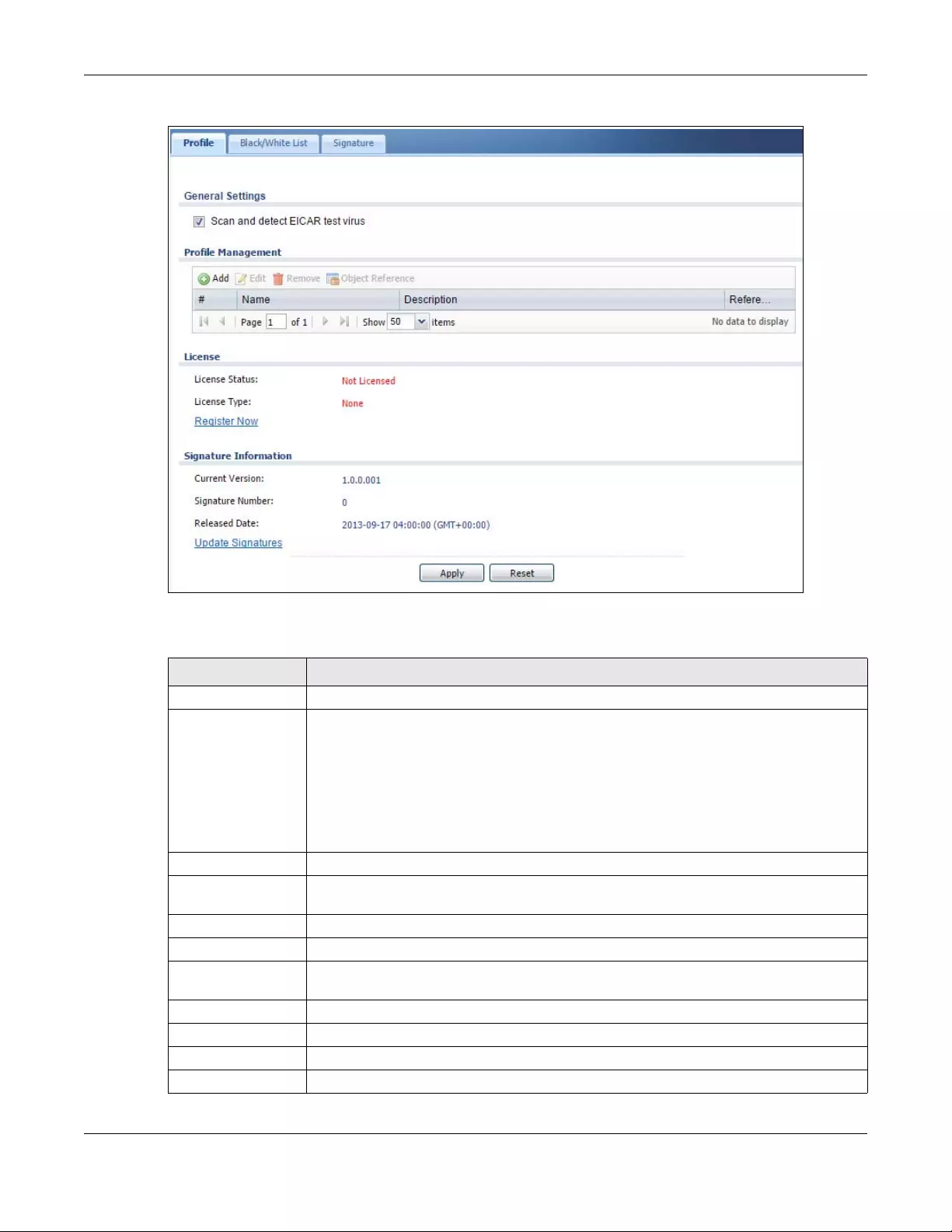
Chapter 31 Anti-Virus
ZyWALL/USG Series User’s Guide
512
Figure 342 Configuration > UTM Profile > Anti-Virus > Profile
The following table describes the labels in this screen.
Table 210 Configuration > UTM Profile > Anti-Virus > Profile
LABEL DESCRIPTION
General Setting
Scan and detect
EICAR test virus
Select this option to have the ZyWALL/USG check for the EICAR test file and treat it in
the same way as a real virus file. The EICAR test file is a standardized test file for
signature based anti-virus scanners. When the virus scanner detects the EICAR file, it
responds in the same way as if it found a real virus. Besides straightforward detection,
the EICAR file can also be compressed to test whether the anti-virus software can
detect it in a compressed file. The test string consists of the following human-readable
ASCII characters.
X5O!P%@AP[4\PZX54(P^)7CC)7}$EICAR-STANDARD-ANTIVIRUS-TEST-FILE!$H+H*
Profile Management
Add Click this to create a new entry. Select an entry and click Add to create a new entry
after the selected entry.
Edit Select an entry and click this to be able to modify it.
Remove Select an entry and click this to delete it.
Object Reference Select an entry and click Object References to open a screen that shows which
settings use the entry. Click Refresh to update information in this screen.
# This displays the index number of the rule.
Name This displays the name for the anti-virus rule.
Description This displays the description of the anti-virus rule.
Reference This displays the number of times an Object Reference is used in a rule.

Chapter 31 Anti-Virus
ZyWALL/USG Series User’s Guide
513
31.2.1 Anti-Virus Profile Add or Edit
Click the Add or Edit icon in the Configuration > UTM Profile > Anti-Virus > Profile screen to
display the configuration screen as shown next.
License The following fields display information about the current state of your subscription for
virus signatures.
License Status This field displays whether a service is activated (Licensed) or not (Not Licensed) or
expired (Expired).
License Type This field displays whether you applied for a trial application (Trial) or registered a
service with your iCard’s PIN number (Standard). None displays when the service is
not activated.
Denied Access
Message
Write a message that will display when a web site is blocked.
Redirect URL Type the URL of the web site to go to when a web site is blocked.
License Status This field displays whether a service is activated (Licensed) or not (Not Licensed) or
expired (Expired).
License Type This field displays whether you applied for a trial application (Trial) or registered a
service with your iCard’s PIN number (Standard). None displays when the service is
not activated.
Signature
Information
The following fields display information on the current signature set that the ZyWALL/
USG is using.
Current Version This field displays the anti-virus signature set version number. This number gets larger
as the set is enhanced.
Signature
Number This field displays the number of anti-virus signatures in this set.
Released Date This field displays the date and time the set was released.
Update
Signatures Click this link to go to the screen you can use to download signatures from the update
server.
Apply Click Apply to save your changes.
Reset Click Reset to return the screen to its last-saved settings.
Table 210 Configuration > UTM Profile > Anti-Virus > Profile (continued)
LABEL DESCRIPTION

Chapter 31 Anti-Virus
ZyWALL/USG Series User’s Guide
514
Figure 343 Configuration > UTM Profile > Anti-Virus > Profile: Profile Management > Add
The following table describes the labels in this screen.
Ta ble 211 Configuration > UTM > Anti-Virus > Profile: Profile Management > Add
LABEL DESCRIPTION
Configuration
Name Enter a descriptive name for this anti-virus rule. You may use 1-31 alphanumeric
characters, underscores(_), or dashes (-), but the first character cannot be a number.
This value is case-sensitive.Enter the name of the anti-virus policy.
Description Enter a descriptive name for this anti-virus rule. You may use 1-31 alphanumeric
characters, underscores(_), or dashes (-), but the first character cannot be a number.
This value is case-sensitive.
Actions When
Matched
Destroy infected file When you select this check box, if a virus pattern is matched, the ZyWALL/USG
overwrites the infected portion of the file (and the rest of the file) with zeros. The un-
infected portion of the file before a virus pattern was matched goes through
unmodified.
Log These are the log options:
no: Do not create a log when a packet matches a signature(s).
log: Create a log on the ZyWALL/USG when a packet matches a signature(s).
log alert: An alert is an e-mailed log for more serious events that may need more
immediate attention. Select this option to have the ZyWALL/USG send an alert when
a packet matches a signature(s).
Check White List Select this check box to check files against the white list.
Check Black List Select this check box to check files against the black list.
File decompression
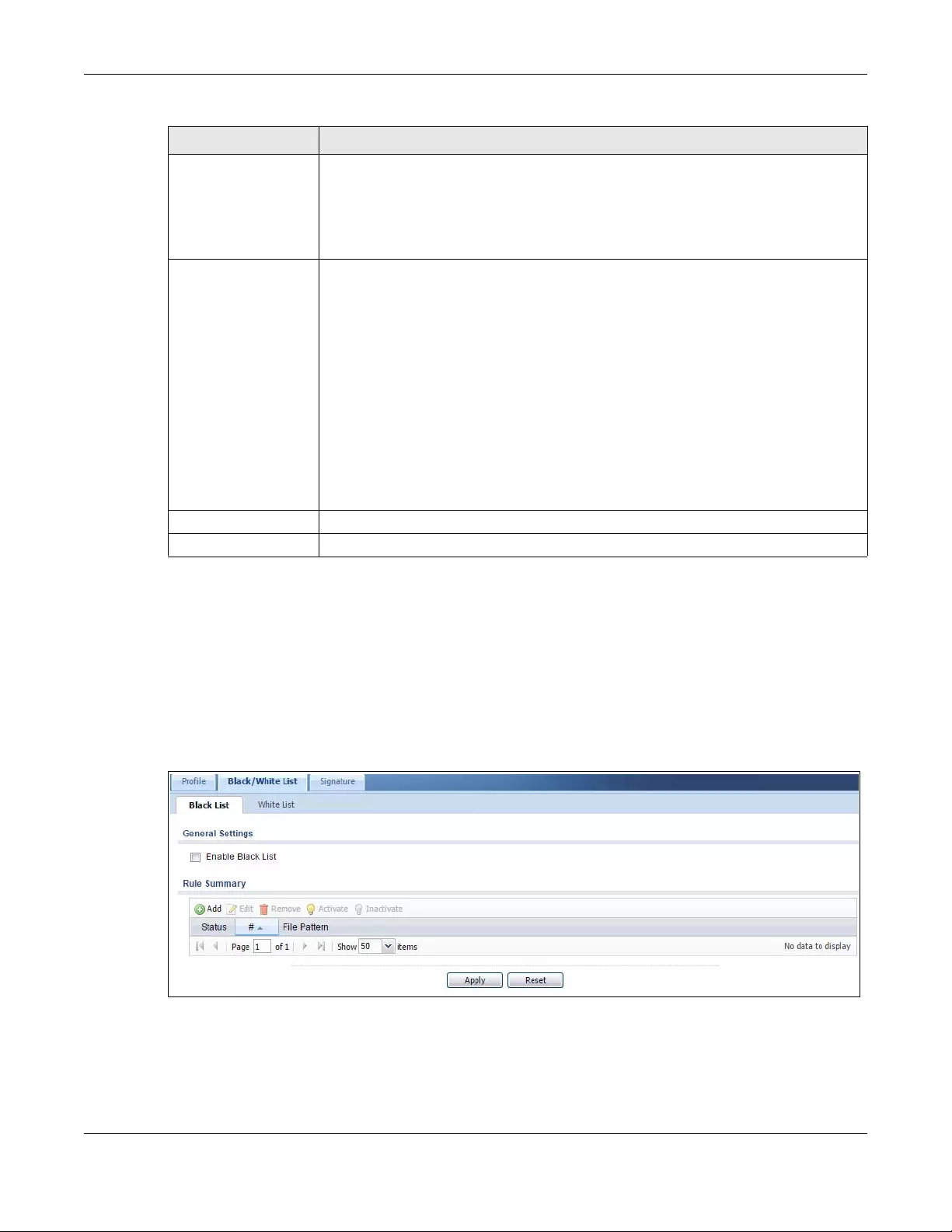
Chapter 31 Anti-Virus
ZyWALL/USG Series User’s Guide
515
31.3 Anti-Virus Black List
Click Configuration > UTM Profile > Anti-Virus > Black/White List to display the screen
shown next. Use the Black List screen to set up the Anti-Virus black (blocked) list of virus file
patterns. Click a column’s heading cell to sort the table entries by that column’s criteria. Click the
heading cell again to reverse the sort order.
Figure 344 Configuration > UTM Profile > Anti-Virus > Black/White List > Black List
Enable file
decompression (ZIP
and RAR)
Select this check box to have the ZyWALL/USG scan a ZIP file (the file does not have
to have a “zip” or “rar” file extension). The ZyWALL/USG first decompresses the ZIP
file and then scans the contents for viruses.
Note: The ZyWALL/USG decompresses a ZIP file once. The ZyWALL/USG does NOT
decompress any ZIP file(s) within a ZIP file.
Destroy
compressed files
that could not be
decompressed
Note: When you select this option, the ZyWALL/USG deletes ZIP files that use
password encryption.
Select this check box to have the ZyWALL/USG delete any ZIP files that it is not
able to unzip. The ZyWALL/USG cannot unzip password protected ZIP files or a ZIP
file within another ZIP file. There are also limits to the number of ZIP files that the
ZyWALL/USG can concurrently unzip.
Note: The ZyWALL/USG’s firmware package cannot go through the ZyWALL/USG
with this option enabled. The ZyWALL/USG classifies the firmware package
as not being able to be decompressed and deletes it.
You can upload the firmware package to the ZyWALL/USG with the option enabled,
so you only need to clear this option while you download the firmware package.
OK Click OK to save your changes.
Cancel Click Cancel to exit this screen without saving your changes.
Ta ble 211 Configuration > UTM > Anti-Virus > Profile: Profile Management > Add (continued)
LABEL DESCRIPTION
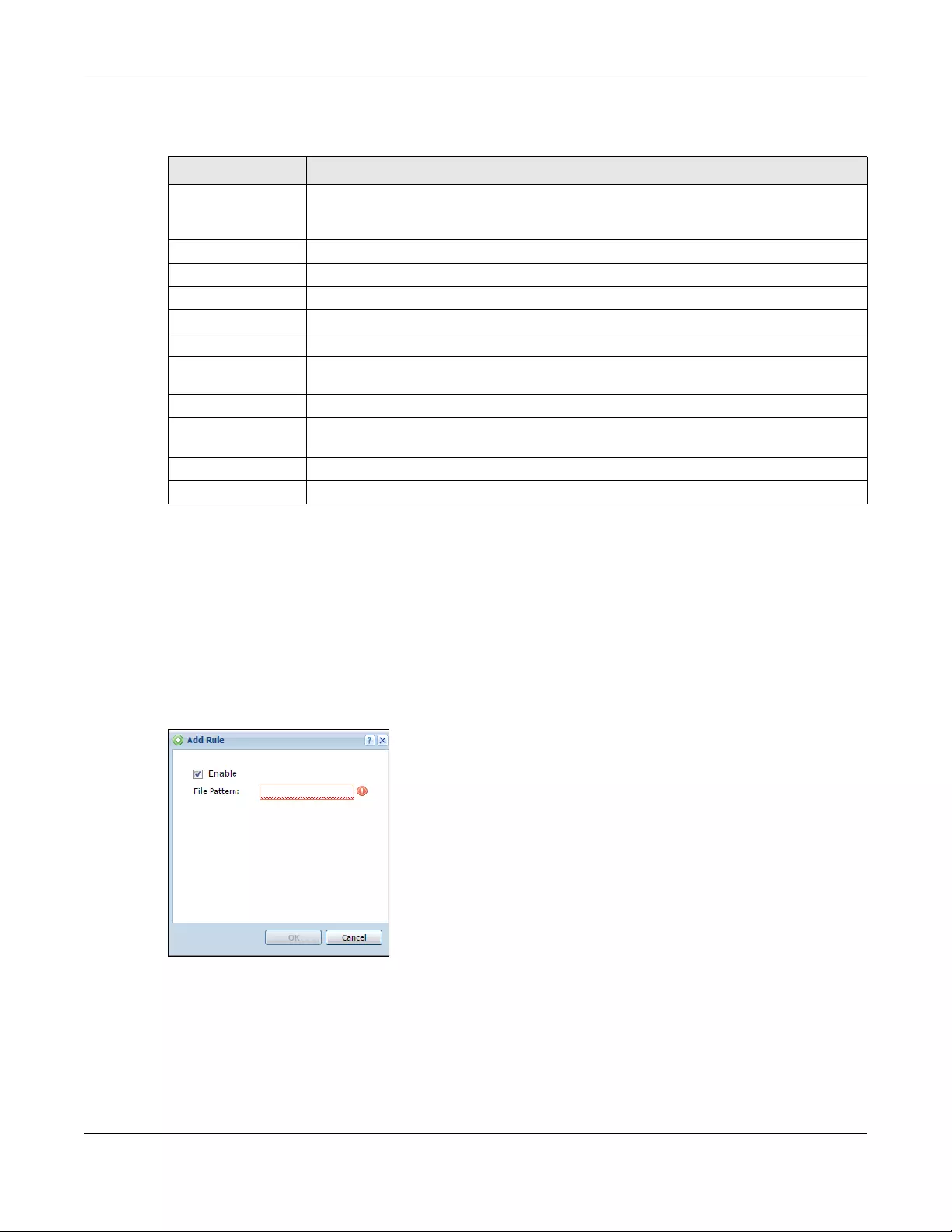
Chapter 31 Anti-Virus
ZyWALL/USG Series User’s Guide
516
The following table describes the labels in this screen.
31.3.1 Anti-Virus Black List or White List Add/Edit
From the Configuration > UTM Profile > Anti-Virus > Black/White List > Black List (or
White List) screen, click the Add icon or an Edit icon to display the following screen.
• For a black list entry, enter a file pattern that should cause the ZyWALL/USG to log and delete a
file.
• For a white list entry, enter a file pattern that should cause the ZyWALL/USG to allow a file.
Figure 345 Configuration > UTM Profile > Anti-Virus > Black/White List > Black List (or White List)
> Add
Table 212 Configuration > UTM Profile > Anti-Virus > Black/White List > Black List
LABEL DESCRIPTION
Enable Black List Select this check box to log and delete files with names that match the black list
patterns. Use the black list to log and delete files with names that match the black list
patterns.
Add Click this to create a new entry.
Edit Select an entry and click this to be able to modify it.
Remove Select an entry and click this to delete it.
Activate To turn on an entry, select it and click Activate.
Inactivate To turn off an entry, select it and click Inactivate.
Status The activate (light bulb) icon is lit when the entry is active and dimmed when the entry
is inactive.
#This is the entry’s index number in the list.
File Pattern This is the file name pattern. If a file’s name that matches this pattern, the ZyWALL/
USG logs and deletes the file.
Apply Click Apply to save your changes.
Reset Click Reset to return the screen to its last-saved settings.
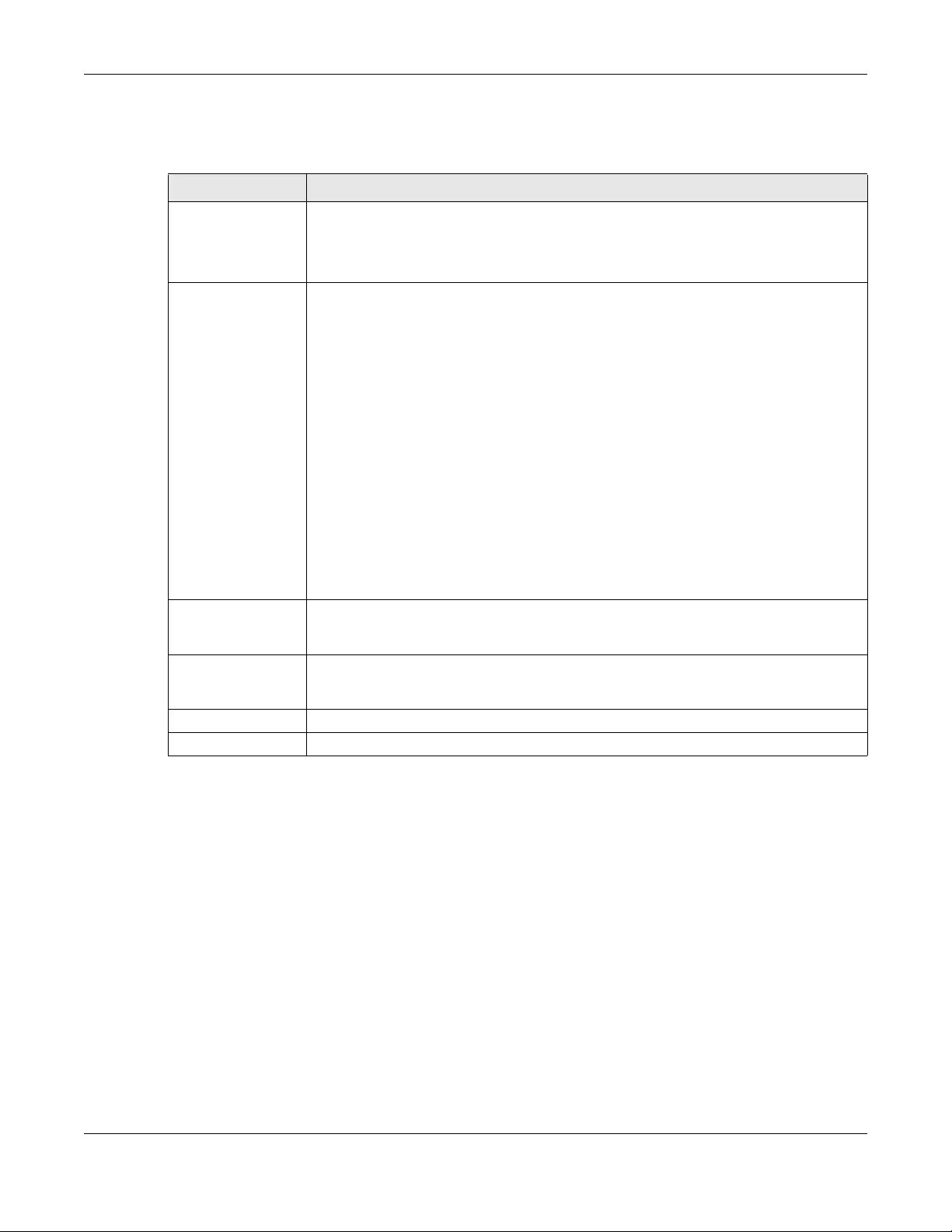
Chapter 31 Anti-Virus
ZyWALL/USG Series User’s Guide
517
The following table describes the labels in this screen.
31.3.2 Anti-Virus White List
Click Configuration > UTM Profile > Anti-Virus > Black/White List > White List to display
the screen shown next. Use the Black/White List screen to set up Anti-Virus black (blocked) and
white (allowed) lists of virus file patterns. Click a column’s heading cell to sort the table entries by
that column’s criteria. Click the heading cell again to reverse the sort order.
Table 213 Configuration > UTM Profile > Anti-Virus > Black/White List > Black List (or White List) >
Add
LABEL DESCRIPTION
Enable If this is a black list entry, select this option to have the ZyWALL/USG apply this entry
when using the black list.
If this is a white list entry, select this option to have the ZyWALL/USG apply this entry
when using the white list.
File Pattern For a black list entry, specify a pattern to identify the names of files that the ZyWALL/
USG should log and delete.
For a white list entry, specify a pattern to identify the names of files that the ZyWALL/
USG should not scan for viruses.
• Use up to 80 characters. Alphanumeric characters, underscores (_), dashes (-),
question marks (?) and asterisks (*) are allowed.
• A question mark (?) lets a single character in the file name vary. For example, use
“a?.zip” (without the quotation marks) to specify aa.zip, ab.zip and so on.
• Wildcards (*) let multiple files match the pattern. For example, use “*a.zip”
(without the quotation marks) to specify any file that ends with “a.zip”. A file named
“testa.zip would match. There could be any number (of any type) of characters in
front of the “a.zip” at the end and the file name would still match. A file named
“test.zipa” for example would not match.
• A * in the middle of a pattern has the ZyWALL/USG check the beginning and end of
the file name and ignore the middle. For example, with “abc*.zip”, any file starting
with “abc” and ending in “.zip” matches, no matter how many characters are in
between.
• The whole file name has to match if you do not use a question mark or asterisk.
• If you do not use a wildcard, the ZyWALL/USG checks up to the first 80 characters
of a file name.
Source Select a source address or address group for whom this policy applies. You can
configure a new one in the Object > Address > Add screen. Select any if the policy is
effective for every source.
Destination Select a destination address or address group for whom this policy applies. You can
configure a new one in the Object > Address > Add screen. Select any if the policy is
effective for every destination.
OK Click OK to save your changes.
Cancel Click Cancel to exit this screen without saving your changes.
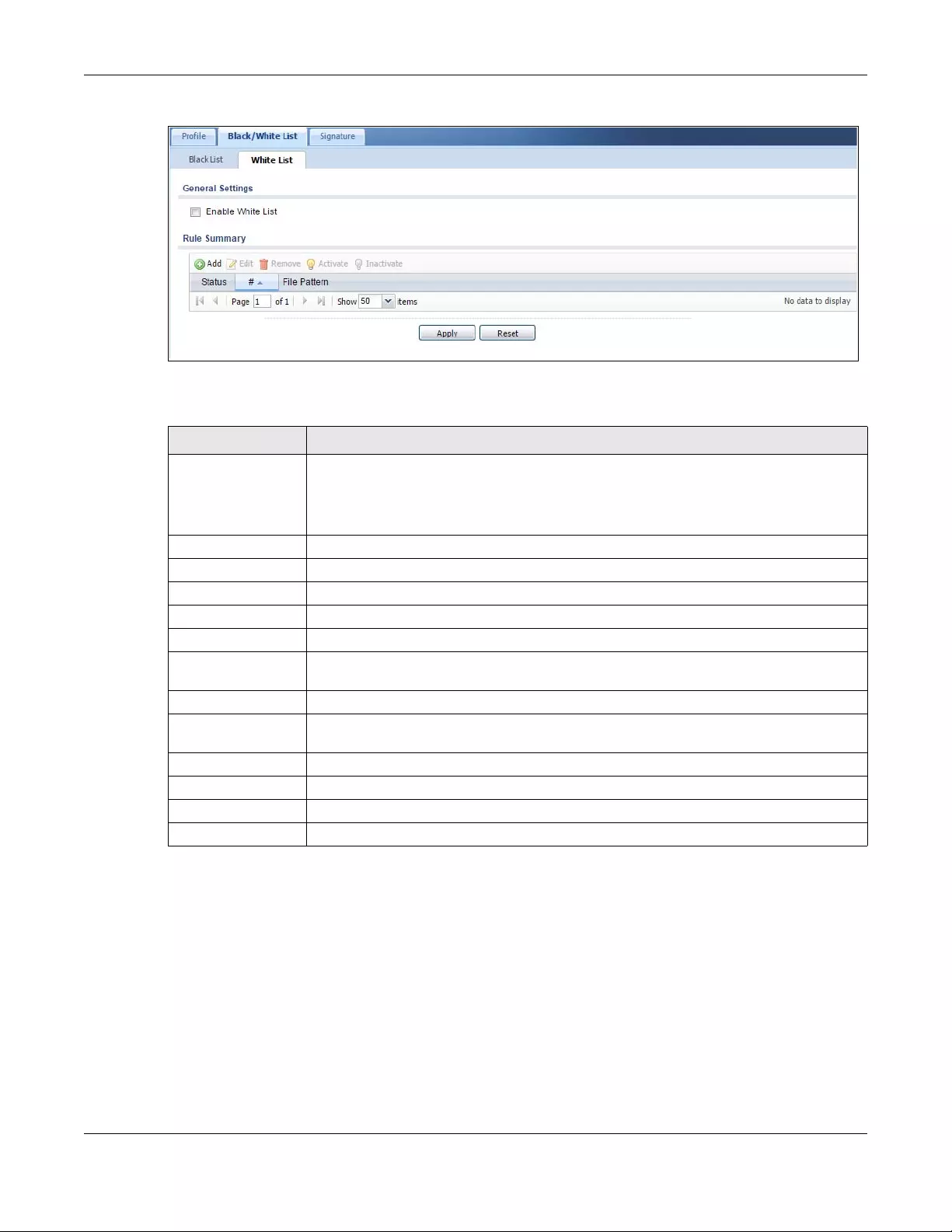
Chapter 31 Anti-Virus
ZyWALL/USG Series User’s Guide
518
Figure 346 Configuration > UTM Profile > Anti-Virus > Black/White List > White List
The following table describes the labels in this screen.
31.4 AV Signature Searching
Click Configuration > UTM Profile > Anti-Virus > Signature to display this screen. Use this
screen to locate signatures and display details about them.
If Internet Explorer opens a warning screen about a script making Internet Explorer run slowly and
the computer maybe becoming unresponsive, just click No to continue. Click a column’s heading
cell to sort the table entries by that column’s criteria. Click the heading cell again to reverse the sort
order.
Table 214 Configuration > UTM Profile > Anti-Virus > Black/White List > White List
LABEL DESCRIPTION
Enable White List Select this check box to have the ZyWALL/USG not perform the anti-virus check on files
with names that match the white list patterns.
Use the white list to have the ZyWALL/USG not perform the anti-virus check on files
with names that match the white list patterns.
Add Click this to create a new entry.
Edit Select an entry and click this to be able to modify it.
Remove Select an entry and click this to delete it.
Activate To turn on an entry, select it and click Activate.
Inactivate To turn off an entry, select it and click Inactivate.
Status The activate (light bulb) icon is lit when the entry is active and dimmed when the entry
is inactive.
#This is the entry’s index number in the list.
File Pattern This is the file name pattern. If a file’s name matches this pattern, the ZyWALL/USG
does not check the file for viruses.
Source This is the source address or address group for whom this policy applies.
Destination This is the destination address or address group for whom this policy applies.
Apply Click Apply to save your changes.
Reset Click Reset to return the screen to its last-saved settings.
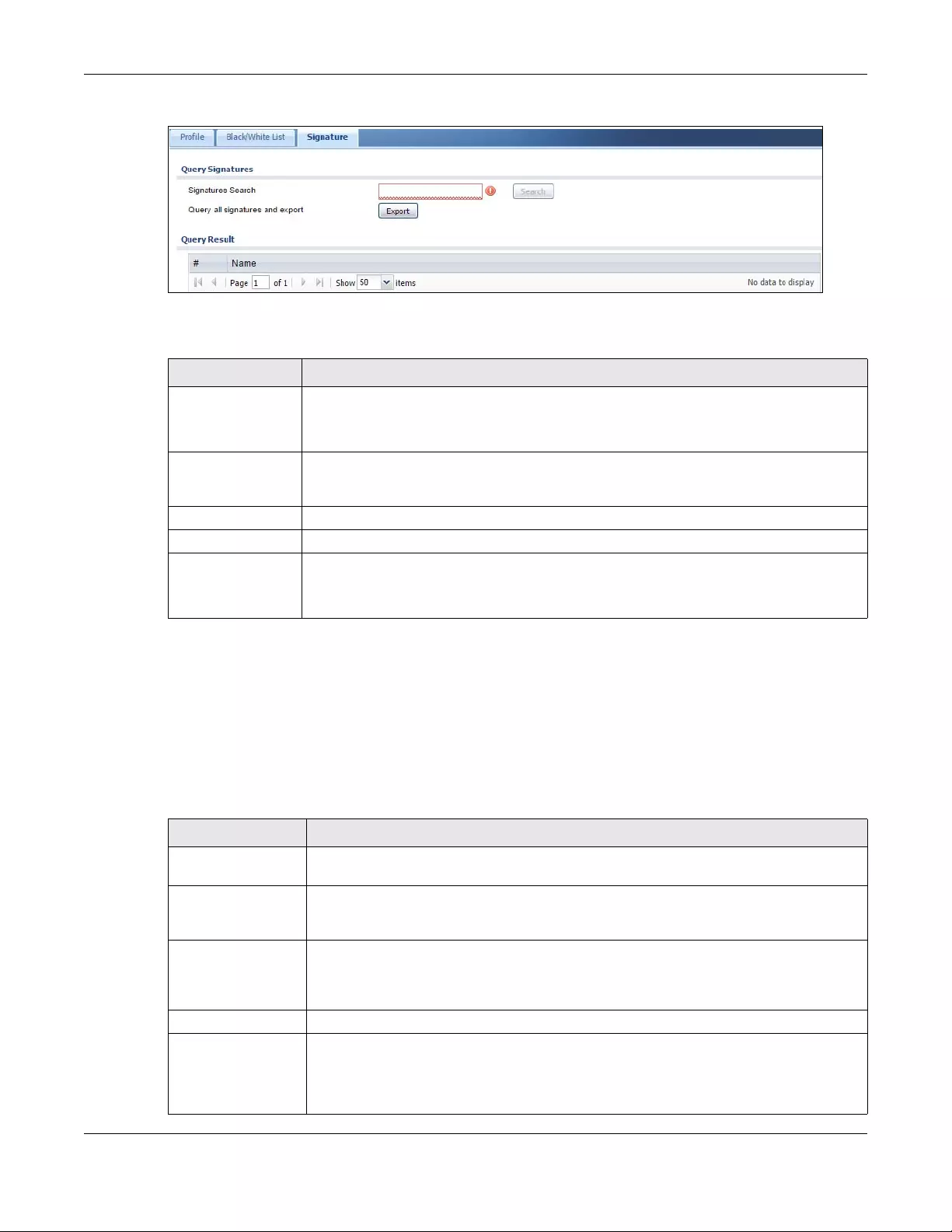
Chapter 31 Anti-Virus
ZyWALL/USG Series User’s Guide
519
Figure 347 Configuration > UTM Profile > Anti-Virus > Signature
The following table describes the labels in this screen.
31.5 Anti-Virus Technical Reference
Types of Computer Vi ruses
The following table describes some of the common computer viruses.
Table 215 Configuration > UTM > Anti-Virus > Signature
LABEL DESCRIPTION
Signatures Search Enter the name,part of the name or keyword of the signature(s) you want to find. This
search is not case-sensitive and accepts numerical strings.
Query all
signatures and
export
Click Export to have the ZyWALL/USG save all of the anti-virus signatures to your
computer in a .txt file.
Query Result
# This is the entry’s index number in the list.
Name This is the name of the anti-virus signature. Click the Name column heading to sort
your search results in ascending or descending order according to the signature name.
Click a signature’s name to see details about the virus.
Table 216 Common Computer Virus Types
TYPE DESCRIPTION
File Infector This is a small program that embeds itself in a legitimate program. A file infector is able
to copy and attach itself to other programs that are executed on an infected computer.
Boot Sector Virus This type of virus infects the area of a hard drive that a computer reads and executes
during startup. The virus causes computer crashes and to some extend renders the
infected computer inoperable.
Macro Virus Macro viruses or Macros are small programs that are created to perform repetitive
actions. Macros run automatically when a file to which they are attached is opened.
Macros spread more rapidly than other types of viruses as data files are often shared on
a network.
E-mail Virus E-mail viruses are malicious programs that spread through e-mail.
Polymorphic Virus A polymorphic virus (also known as a mutation virus) tries to evade detection by
changing a portion of its code structure after each execution or self replication. This
makes it harder for an anti-virus scanner to detect or intercept it.
A polymorphic virus can also belong to any of the virus types discussed above.

Chapter 31 Anti-Virus
ZyWALL/USG Series User’s Guide
520
Computer Virus Infection and Prevention
The following describes a simple life cycle of a computer virus.
1A computer gets a copy of a virus from a source such as the Internet, e-mail, file sharing or any
removable storage media. The virus is harmless until the execution of an infected program.
2The virus spreads to other files and programs on the computer.
3The infected files are unintentionally sent to another computer thus starting the spread of the virus.
4Once the virus is spread through the network, the number of infected networked computers can
grow exponentially.
Types of Anti-Virus Scanner
The section describes two types of anti-virus scanner: host-based and network-based.
A host-based anti-virus (HAV) scanner is often software installed on computers and/or servers in
the network. It inspects files for virus patterns as they are moved in and out of the hard drive.
However, host-based anti-virus scanners cannot eliminate all viruses for a number of reasons:
• HAV scanners are slow in stopping virus threats through real-time traffic (such as from the
Internet).
• HAV scanners may reduce computing performance as they also share the resources (such as CPU
time) on the computer for file inspection.
• You have to update the virus signatures and/or perform virus scans on all computers in the
network regularly.
A network-based anti-virus (NAV) scanner is often deployed as a dedicated security device (such as
your ZyWALL/USG) on the network edge. NAV scanners inspect real-time data traffic (such as E-
mail messages or web) that tends to bypass HAV scanners. The following lists some of the benefits
of NAV scanners.
• NAV scanners stops virus threats at the network edge before they enter or exit a network.
• NAV scanners reduce computing loading on computers as the read-time data traffic inspection is
done on a dedicated security device.

ZyWALL/USG Series User’s Guide
521
CHAPTER 32
Anti-Spam
32.1 Overview
The anti-spam feature can mark or discard spam (unsolicited commercial or junk e-mail). Use the
white list to identify legitimate e-mail. Use the black list to identify spam e-mail. The ZyWALL/USG
can also check e-mail against a DNS black list (DNSBL) of IP addresses of servers that are
suspected of being used by spammers.
32.1.1 What You Can Do in this Chapter
•Use the GeneralProfile screens (Section 32.3 on page 523) to turn anti-spam on or off and
manage anti-spam policies.
•Use the Mail Scan screen (Section 32.4 on page 526) to enable and configure the mail scan
functions.
•Use the Black/White List screens (Section 32.5 on page 528) to set up a black list to identify
spam and a white list to identify legitimate e-mail.
•Use the DNSBL screens (Section 32.7 on page 533) to have the ZyWALL/USG check e-mail
against DNS Black Lists.
32.1.2 What You Need to Know
White List
Configure white list entries to identify legitimate e-mail. The white list entries have the ZyWALL/
USG classify any e-mail that is from a specified sender or uses a specified header field and header
value as being legitimate (see E-mail Headers on page 522 for more on mail headers). The anti-
spam feature checks an e-mail against the white list entries before doing any other anti-spam
checking. If the e-mail matches a white list entry, the ZyWALL/USG classifies the e-mail as
legitimate and does not perform any more anti-spam checking on that individual e-mail. A properly
configured white list helps keep important e-mail from being incorrectly classified as spam. The
white list can also increases the ZyWALL/USG’s anti-spam speed and efficiency by not having the
ZyWALL/USG perform the full anti-spam checking process on legitimate e-mail.
Black List
Configure black list entries to identify spam. The black list entries have the ZyWALL/USG classify
any e-mail that is from or forwarded by a specified IP address or uses a specified header field and
header value as being spam. If an e-mail does not match any of the white list entries, the ZyWALL/
USG checks it against the black list entries. The ZyWALL/USG classifies an e-mail that matches a
black list entry as spam and immediately takes the configured action for dealing with spam. If an e-
mail matches a blacklist entry, the ZyWALL/USG does not perform any more anti-spam checking on

Chapter 32 Anti-Spam
ZyWALL/USG Series User’s Guide
522
that individual e-mail. A properly configured black list helps catch spam e-mail and increases the
ZyWALL/USG’s anti-spam speed and efficiency.
SMTP and POP3
Simple Mail Transfer Protocol (SMTP) is the Internet’s message transport standard. It controls the
sending of e-mail messages between servers. E-mail clients (also called e-mail applications) then
use mail server protocols such as POP (Post Office Protocol) or IMAP (Internet Message Access
Protocol) to retrieve e-mail. E-mail clients also generally use SMTP to send messages to a mail
server. The older POP2 requires SMTP for sending messages while the newer POP3 can be used with
or without it. This is why many e-mail applications require you to specify both the SMTP server and
the POP or IMAP server (even though they may actually be the same server).
The ZyWALL/USG’s anti-spam feature checks SMTP (TCP port 25) and POP3 (TCP port 110) e-mails
by default. You can also specify custom SMTP and POP3 ports for the ZyWALL/USG to check.
E-mail Headers
Every email has a header and a body. The header is structured into fields and includes the
addresses of the recipient and sender, the subject, and other information about the e-mail and its
journey. The body is the actual message text and any attachments. You can have the ZyWALL/USG
check for specific header fields with specific values.
E-mail programs usually only show you the To:, From:, Subject:, and Date: header fields but there
are others such as Received: and Content-Type:. To see all of an e-mail’s header, you can select an
e-mail in your e-mail program and look at its properties or details. For example, in Microsoft’s
Outlook Express, select a mail and click File > Properties > Details. This displays the e-mail’s
header. Click Message Source to see the source for the entire mail including both the header and
the body.
E-mail Header Buffer Size
The ZyWALL/USG has a 5 K buffer for an individual e-mail header. If an e-mail’s header is longer
than 5 K, the ZyWALL/USG only checks up to the first 5 K.
DNSBL
A DNS Black List (DNSBL) is a server that hosts a list of IP addresses known or suspected of having
sent or forwarded spam. A DNSBL is also known as a DNS spam blocking list. The ZyWALL/USG can
check the routing addresses of e-mail against DNSBLs and classify an e-mail as spam if it was sent
or forwarded by a computer with an IP address in the DNSBL.
Finding Out More
See Section 32.8 on page 535 for more background information on anti-spam.
32.2 Before You Begin
• Before using the Anti-Spam features (IP Reputation, Mail Content Analysis and Virus Outbreak
Detection) you must activate your Anti-Spam Service license.
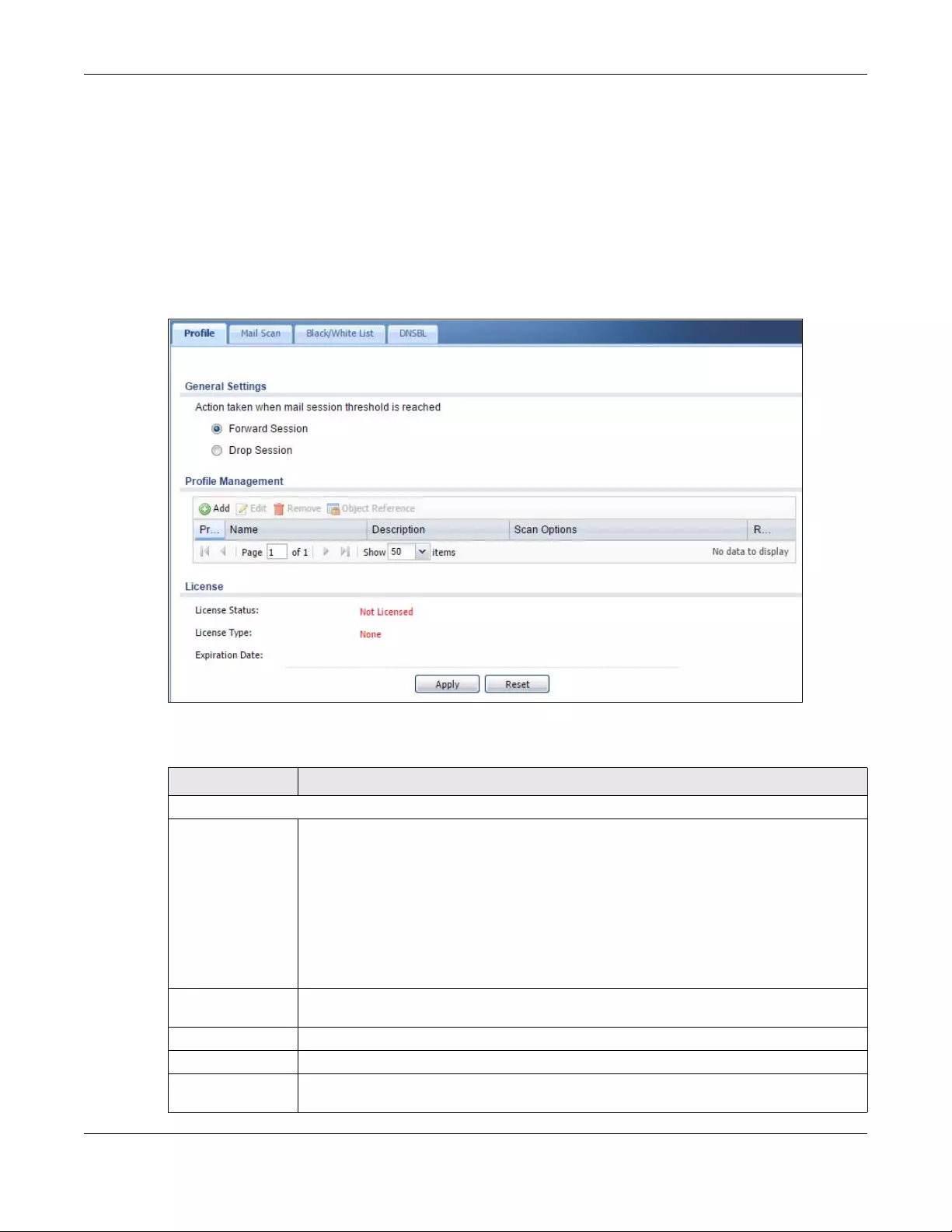
Chapter 32 Anti-Spam
ZyWALL/USG Series User’s Guide
523
• Configure your zones before you configure anti-spam.
32.3 The Anti-Spam Profile Screen
Click Configuration > UTM Profile > Anti-Spam to open the Anti-Spam Profile screen. Use
this screen to turn the anti-spam feature on or off and manage anti-spam policies. You can also
select the action the ZyWALL/USG takes when the mail sessions threshold is reached.
Figure 348 Configuration > UTM Profile > Anti-Spam > Profilel
The following table describes the labels in this screen.
Table 217 Configuration > UTM Profile > Anti-Spam > Profile
LABEL DESCRIPTION
General Settings
Action taken when
mail sessions
threshold is
reached
An e-mail session is when an e-mail client and e-mail server (or two e-mail servers)
connect through the ZyWALL/USG. Select how to handle concurrent e-mail sessions that
exceed the maximum number of concurrent e-mail sessions that the anti-spam feature
can handle. See the chapter of product specifications for the threshold.
Select Forward Session to have the ZyWALL/USG allow the excess e-mail sessions
without any spam filtering.
Select Drop Session to have the ZyWALL/USG drop mail connections to stop the excess
e-mail sessions. The e-mail client or server will have to re-attempt to send or receive e-
mail later when the number of e-mail sessions is under the threshold.
Add Click this to create a new entry. Select an entry and click Add to create a new entry after
the selected entry.
Edit Select an entry and click this to be able to modify it.
Remove Select an entry and click this to delete it.
Object
Reference Select an entry and click Object Ref erences to open a screen that shows which settings
use the entry. Click Refresh to update information in this screen.
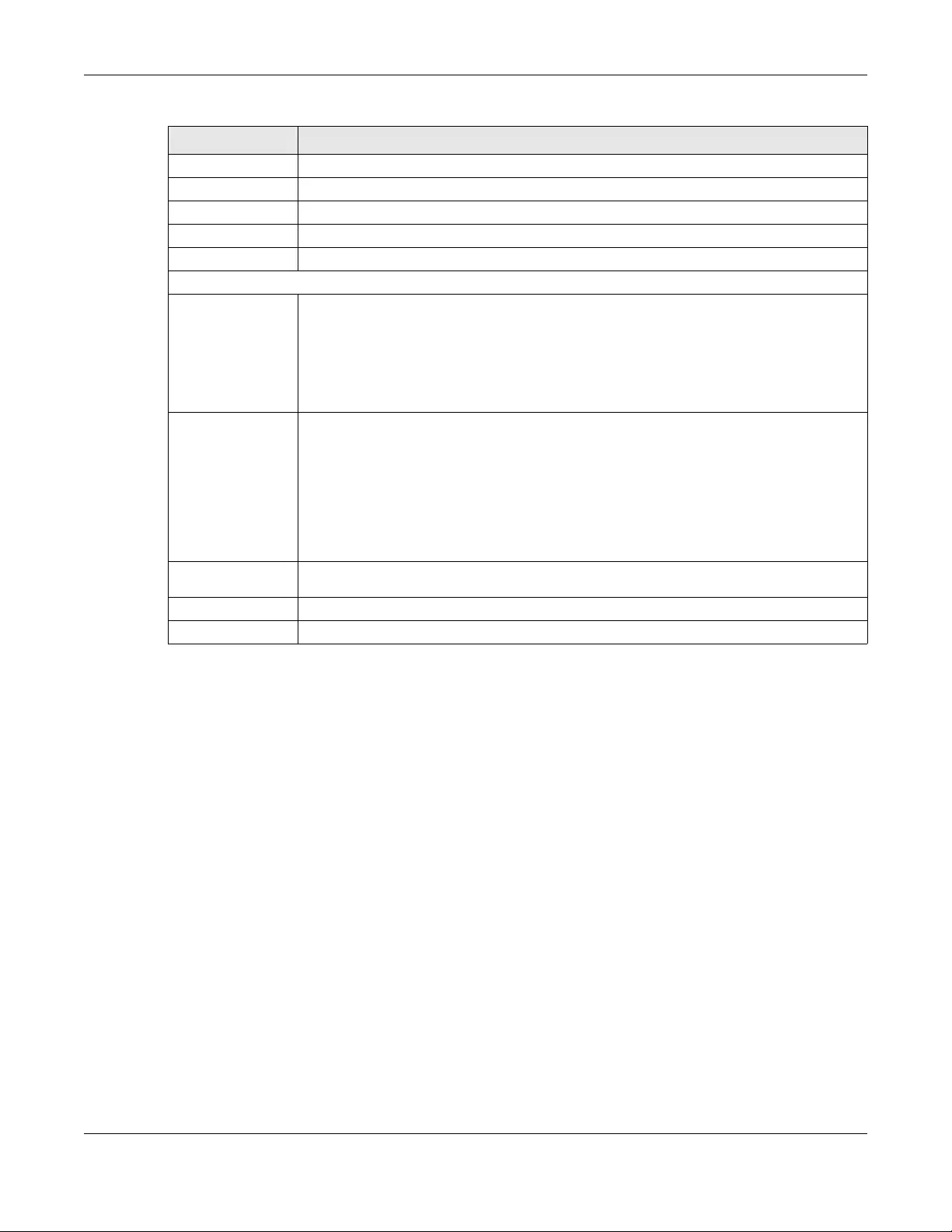
Chapter 32 Anti-Spam
ZyWALL/USG Series User’s Guide
524
32.3.1 The Anti-Spam Profile Add or Edit Screen
Click the Add or Edit icon in the Configuration > U TM Profile > Anti-Spam > Profile screen to
display the configuration screen as shown next. Use this screen to configure an anti-spam policy
that controls what traffic direction of e-mail to check, which e-mail protocols to scan, the scanning
options, and the action to take on spam traffic.
Priority This is the index number of the anti-spam rule. Antis-spam rules are applied in turn.
Name The name identifies the anti-spam rule.
Description This is some optional extra information on the rule.
Scan Options This shows which types (protocols) of traffic to scan for spam.
Reference This shows how many objects are referenced in the rule.
License
License Status This read-only field displays the status of your anti-spam scanning service registration.
Not Licensed displays if you have not successfully registered and activated the service.
Expired displays if your subscription to the service has expired.
Licensed displays if you have successfully registered the ZyWALL/USG and activated the
service.
License Type This read-only field displays what kind of service registration you have for the anti-spam
scanning.
None displays if you have not successfully registered and activated the service.
Standard displays if you have successfully registered the ZyWALL/USG and activated
the service with your iCard’s PIN number.
Trial displays if you have successfully registered the ZyWALL/USG and activated the trial
service subscription.
Expiration
Date This field displays the date your service license expires.
Apply Click Apply to save your changes back to the ZyWALL/USG.
Reset Click Reset to return the screen to its last-saved settings.
Table 217 Configuration > UTM Profile > Anti-Spam > Profile
LABEL DESCRIPTION
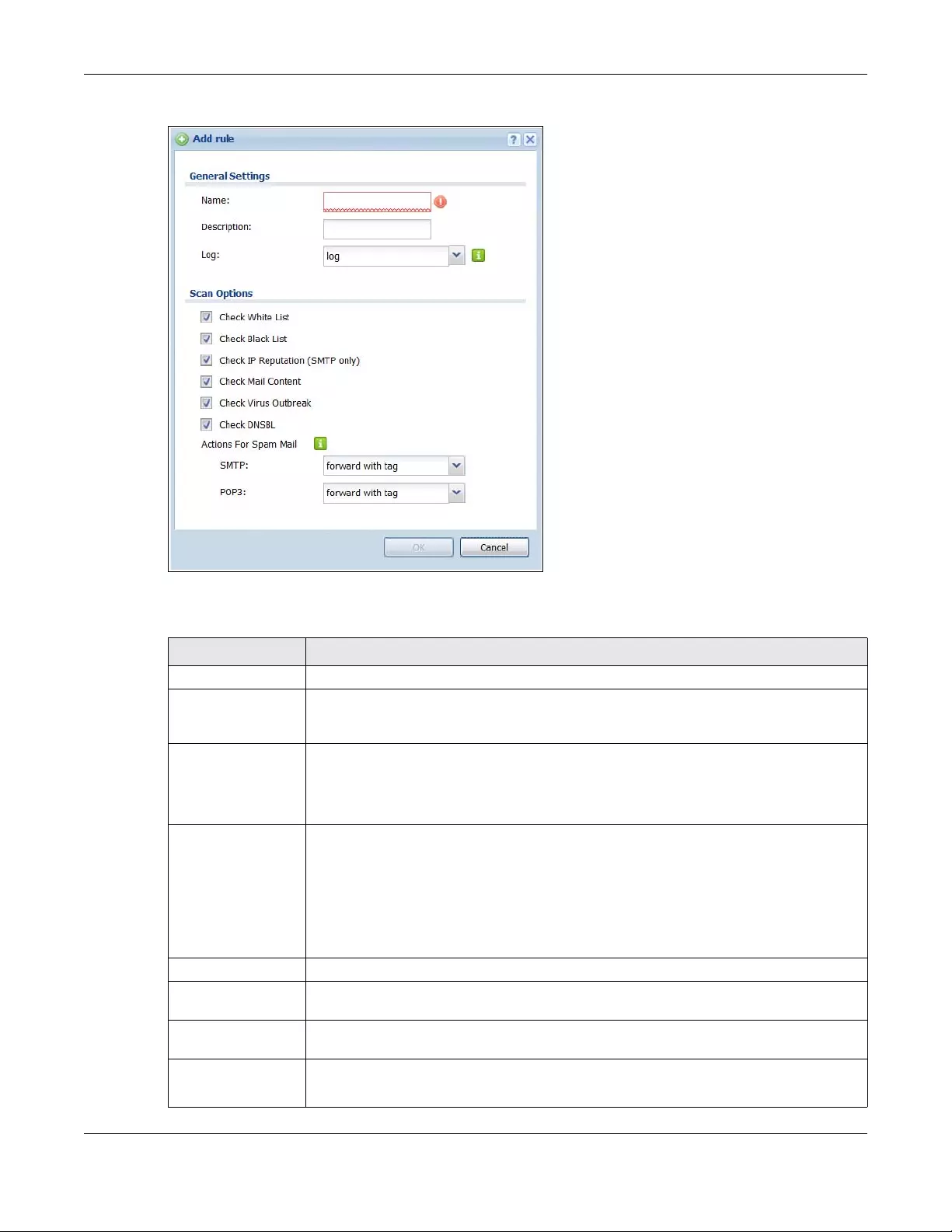
Chapter 32 Anti-Spam
ZyWALL/USG Series User’s Guide
525
Figure 349 Configuration > UTM Profile > Anti-Spam > Profile > Add
The following table describes the labels in this screen.
Table 218 Configuration > UTM Profile > Anti-Spam > Profile > Add
LABEL DESCRIPTION
General Settings
Name Enter a descriptive name for this anti-spam rule. You may use 1-31 alphanumeric
characters, underscores(_), or dashes (-), but the first character cannot be a number.
This value is case-sensitive.
Description Enter a description for the anti-spam rule to help identify the purpose of rule. You may
use 1-31 alphanumeric characters, underscores(_), or dashes (-), but the first
character cannot be a number. This value is case-sensitive.
This field is optional.
Log Select how the ZyWALL/USG is to log the event when the DNSBL times out or an e-mail
matches the white list, black list, or DNSBL.
no: Do not create a log.
log: Create a log on the ZyWALL/USG.
log alert: An alert is an e-mailed log for more serious events that may need more
immediate attention. Select this option to have the ZyWALL/USG send an alert.
Scan Options
Check White
List Select this check box to check e-mail against the white list. The ZyWALL/USG classifies
e-mail that matches a white list entry as legitimate (not spam).
Check Black List Select this check box to check e-mail against the black list. The ZyWALL/USG classifies
e-mail that matches a black list entry as spam.
Check IP
Reputation
(SMTP Only)
Select this to use IP reputation to identify Spam or Unwanted Bulk Email by the
sender’s IP address.
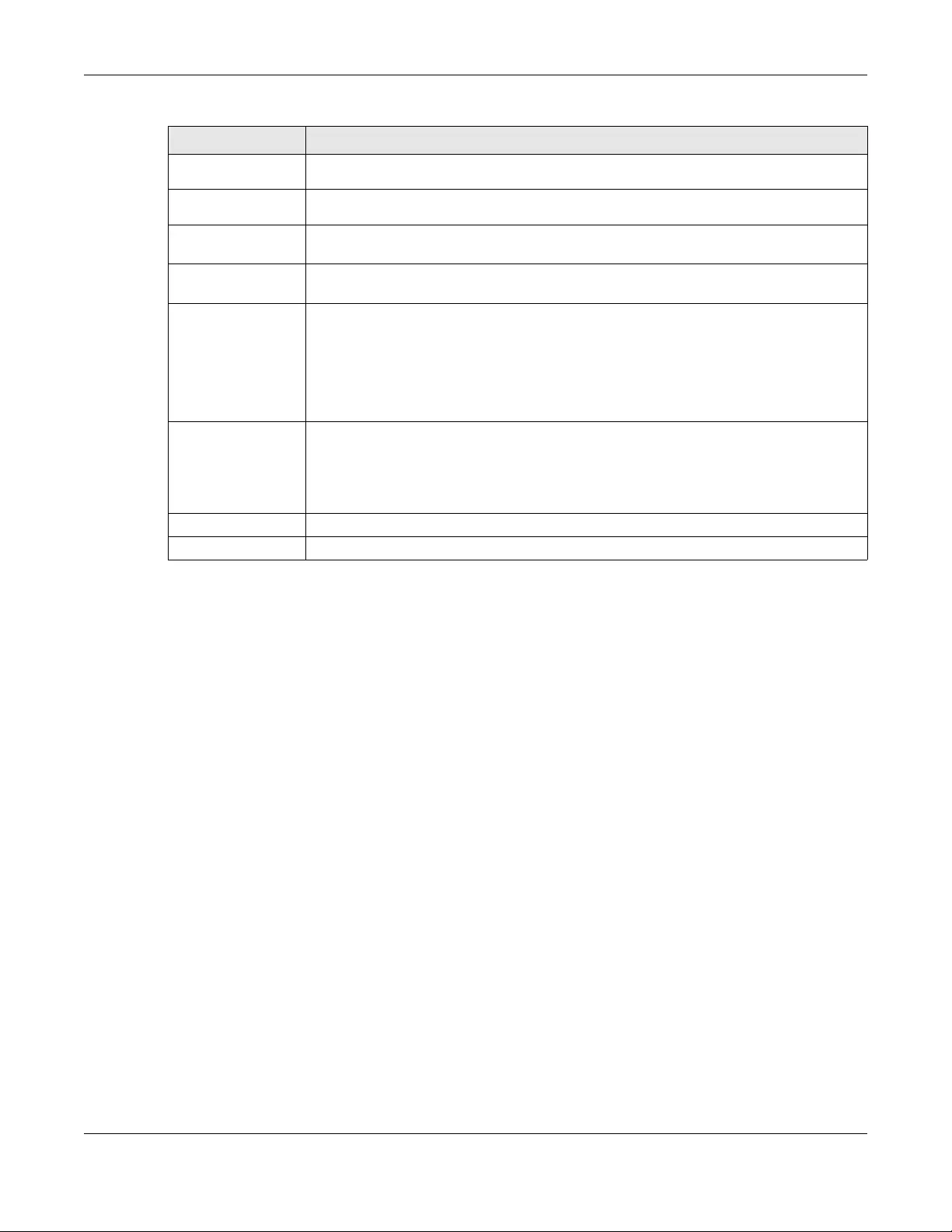
Chapter 32 Anti-Spam
ZyWALL/USG Series User’s Guide
526
32.4 The Mail Scan Screen
Click Configuration > UTM Profile > Anti-Spam > Mail Scan to open the Mail Scan screen.
Use this screen to enable and configure the Mail Scan functions. You must first enable the Mail Scan
functions on this screen before selecting them in the Configuration > UTM Profile > Anti-Spam
> Profile > Add/Edit screen.
Check Mail
Content Select this to identify Spam Email by content, such as malicious content.
Check Virus
Outbreak Select this to scan emails for attached viruses.
Check DNSBL Select this check box to check e-mail against the ZyWALL/USG’s configured DNSBL
domains. The ZyWALL/USG classifies e-mail that matches a DNS black list as spam.
Actions for Spam
Mail
Use this section to set how the ZyWALL/USG is to handle spam mail.
SMTP Select how the ZyWALL/USG is to handle spam SMTP mail.
Select drop to discard spam SMTP mail.
Select forward to allow spam SMTP mail to go through.
Select forward with tag to add a spam tag to an SMTP spam mail’s mail subject and
send it on to the destination.
POP3 Select how the ZyWALL/USG is to handle spam POP3 mail.
Select forward to allow spam POP3 mail to go through.
Select forward with tag to add a spam tag to an POP3 spam mail’s mail subject and
send it on to the destination.
OK Click OK to save your changes.
Cancel Click Cancel to exit this screen without saving your changes.
Table 218 Configuration > UTM Profile > Anti-Spam > Profile > Add (continued)
LABEL DESCRIPTION
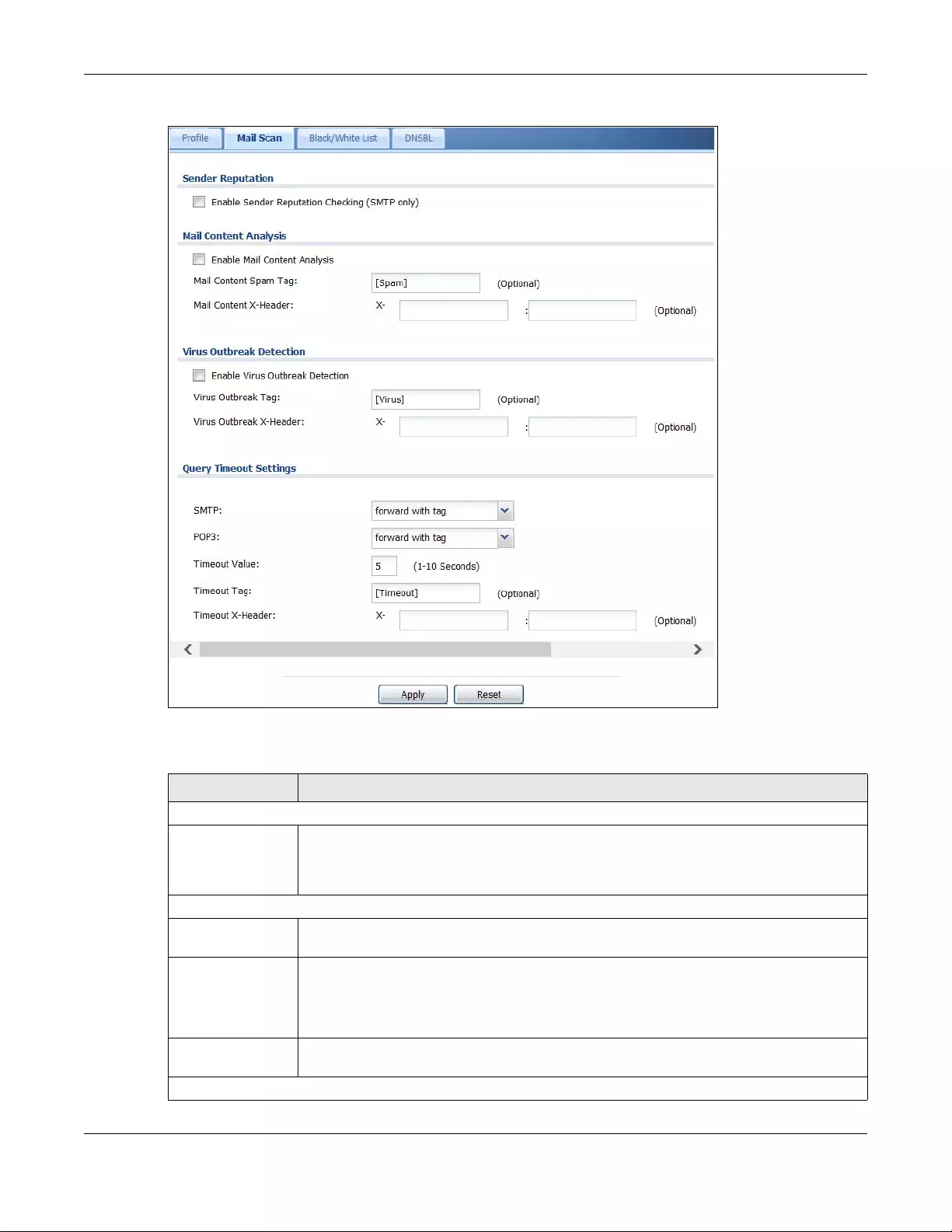
Chapter 32 Anti-Spam
ZyWALL/USG Series User’s Guide
527
Figure 350 Configuration > UTM Profile > Anti-Spam > Mail Scan
The following table describes the labels in this screen.
Table 219 Configuration > UTM Profile > Anti-Spam > Mail Scan
LABEL DESCRIPTION
Sender Reputation
Enable Sender
Reputation
Checking (SMTP
only)
Select this to have the ZyWALL/USG scan for spam e-mail by IP Reputation. Spam or
Unwanted Bulk Email is determined by the sender’s IP address.
Mail Content Analysis
Enable Mail
Content Analysis
Select this to identify Spam Email by content, such as malicious content.
Mail Content Spam
Tag
Enter a message or label (up to 15 ASCII characters) to add to the beginning of the mail
subject of e-mails that are determined to spam based on the mail content analysis.
This tag is only added if the anti-spam policy is configured to forward spam mail with a
spam tag.
Mail Content X-
Header
Specify the name and value for the X-Header to be added when an email is determined
to be spam by mail content.
Virus Outbreak Detection
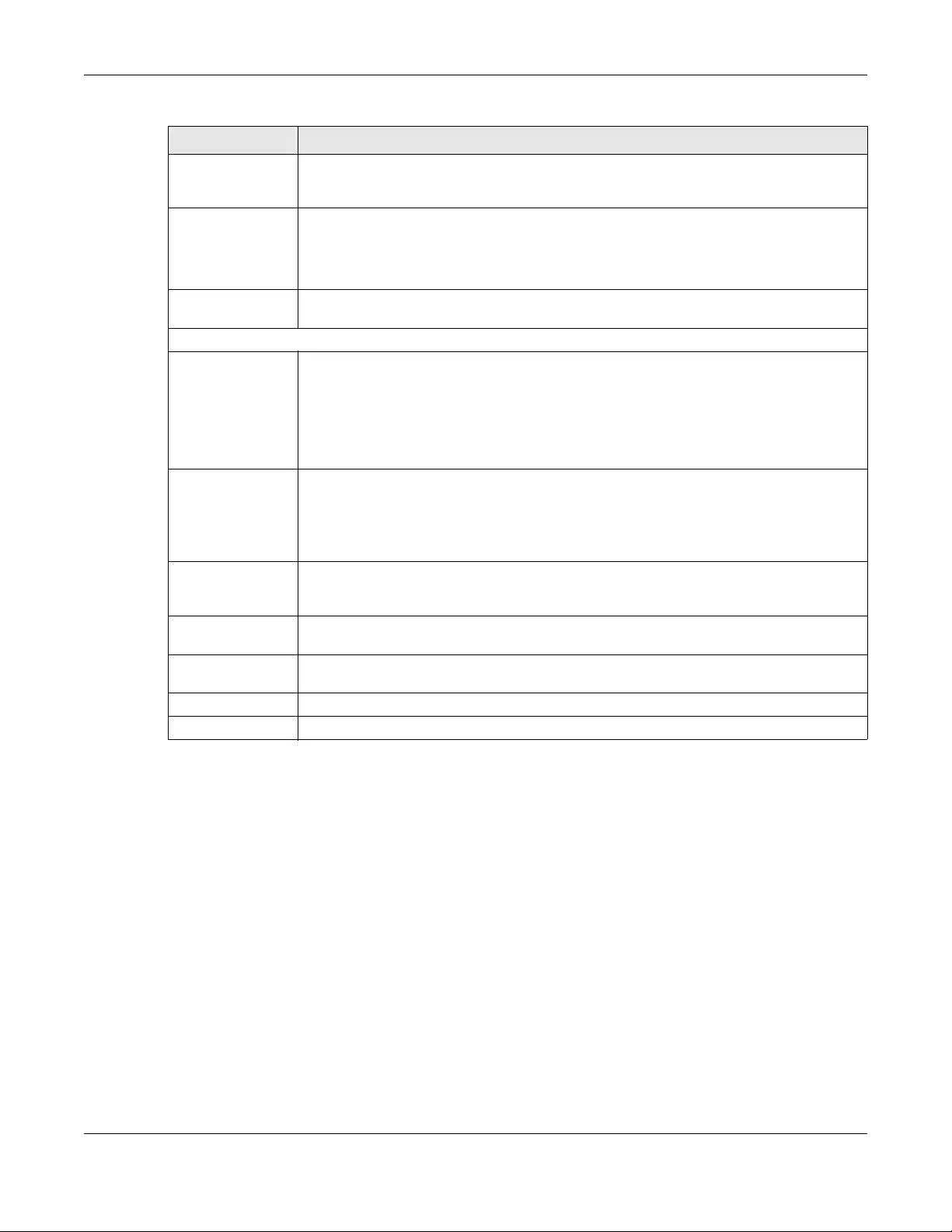
Chapter 32 Anti-Spam
ZyWALL/USG Series User’s Guide
528
32.5 The Anti-Spam Black List Screen
Click Configuration > UTM Profile > Anti-Spam > Black /White List to display the Anti-Spam
Black List screen.
Configure the black list to identify spam e-mail. You can create black list entries based on the
sender’s or relay server’s IP address or e-mail address. You can also create entries that check for
particular e-mail header fields with specific values or specific subject text. Click a column’s heading
cell to sort the table entries by that column’s criteria. Click the heading cell again to reverse the sort
order.
Enable Virus
Outbreak
Detection
This scans emails for attached viruses.
Virus Outbreak
Tag
Enter a message or label (up to 15 ASCII characters) to add to the beginning of the mail
subject of e-mails that are determined have an attached viruses.
This tag is only added if the anti-spam policy is configured to forward spam mail with a
spam tag.
Virus Outbreak X-
Header
Specify the name and value for the X-Header to be added when an email is determined
to have an attached virus.
Query Timeout Settings
SMTP Select how the ZyWALL/USG is to handle SMTP mail query timeout.
Select drop to discard SMTP mail.
Select forward to allow SMTP mail to go through.
Select forward with tag to add a tag to an SMTP query timeout mail’s mail subject and
send it on to the destination.
POP3 Select how the ZyWALL/USG is to handle POP3 mail query timeout.
Select forward to allow POP3 mail to go through.
Select forward with tag to add a tag to an POP3 query timeout mail’s mail subject and
send it on to the destination.
Timeout Value Set how long the ZyWALL/USG waits for a reply from the mail scan server. If there is no
reply before this time period expires, the ZyWALL/USG takes the action defined in the
relevant Actions when Query Timeout field.
Timeout Tag Enter a message or label (up to 15 ASCII characters) to add to the mail subject of e-
mails that the ZyWALL/USG forwards if queries to the mail scan servers time out.
Timeout X-Header Specify the name and value for the X-Header to be added when queries to the mail scan
servers time out.
Apply Click Apply to save your changes back to the ZyWALL/USG.
Reset Click Reset to return the screen to its last-saved settings.
Table 219 Configuration > UTM Profile > Anti-Spam > Mail Scan
LABEL DESCRIPTION
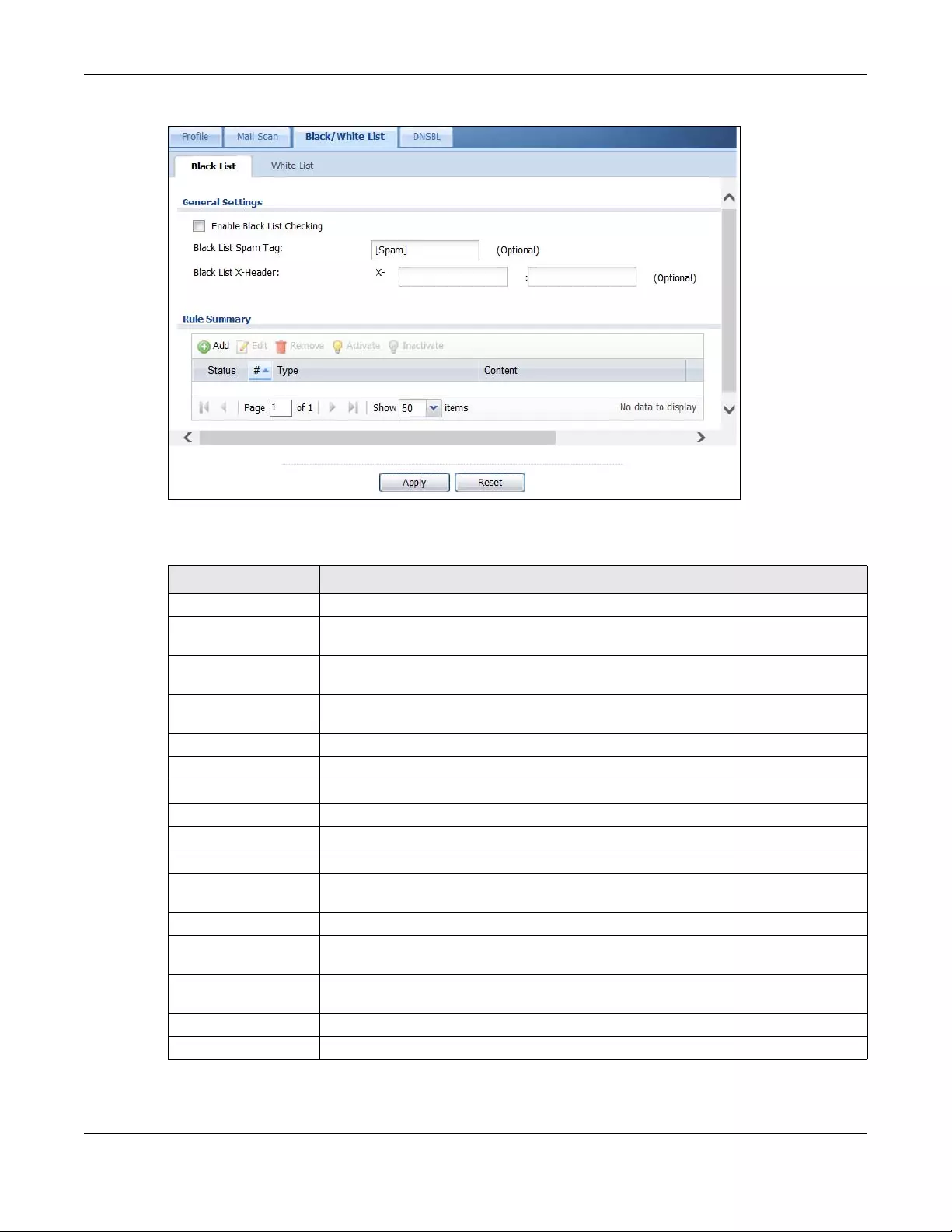
Chapter 32 Anti-Spam
ZyWALL/USG Series User’s Guide
529
Figure 351 Configuration > UTM Profile > Anti-Spam > Black/White List > Black List
The following table describes the labels in this screen.
Table 220 Configuration > UTM Profile > Anti-Spam > Black/White List > Black List
LABEL DESCRIPTION
General Settings
Enable Black List
Checking
Select this check box to have the ZyWALL/USG treat e-mail that matches (an active)
black list entry as spam.
Black List Spam Tag Enter a message or label (up to 15 ASCII characters) to add to the mail subject of e-
mails that match the ZyWALL/USG’s spam black list.
Black List X-Header Specify the name and value for the X-Header to be added to e-mails that match the
ZyWALL/USG’s spam black list.
Rule Summary
Add Click this to create a new entry.
Edit Select an entry and click this to be able to modify it.
Remove Select an entry and click this to delete it.
Activate To turn on an entry, select it and click Activate.
Inactivate To turn off an entry, select it and click Inactivate.
Status The activate (light bulb) icon is lit when the entry is active and dimmed when the
entry is inactive.
#This is the entry’s index number in the list.
Type This field displays whether the entry is based on the e-mail’s subject, source or relay
IP address, source e-mail address, or header.
Content This field displays the subject content, source or relay IP address, source e-mail
address, or header value for which the entry checks.
Apply Click Apply to save your changes back to the ZyWALL/USG.
Reset Click Reset to return the screen to its last-saved settings.
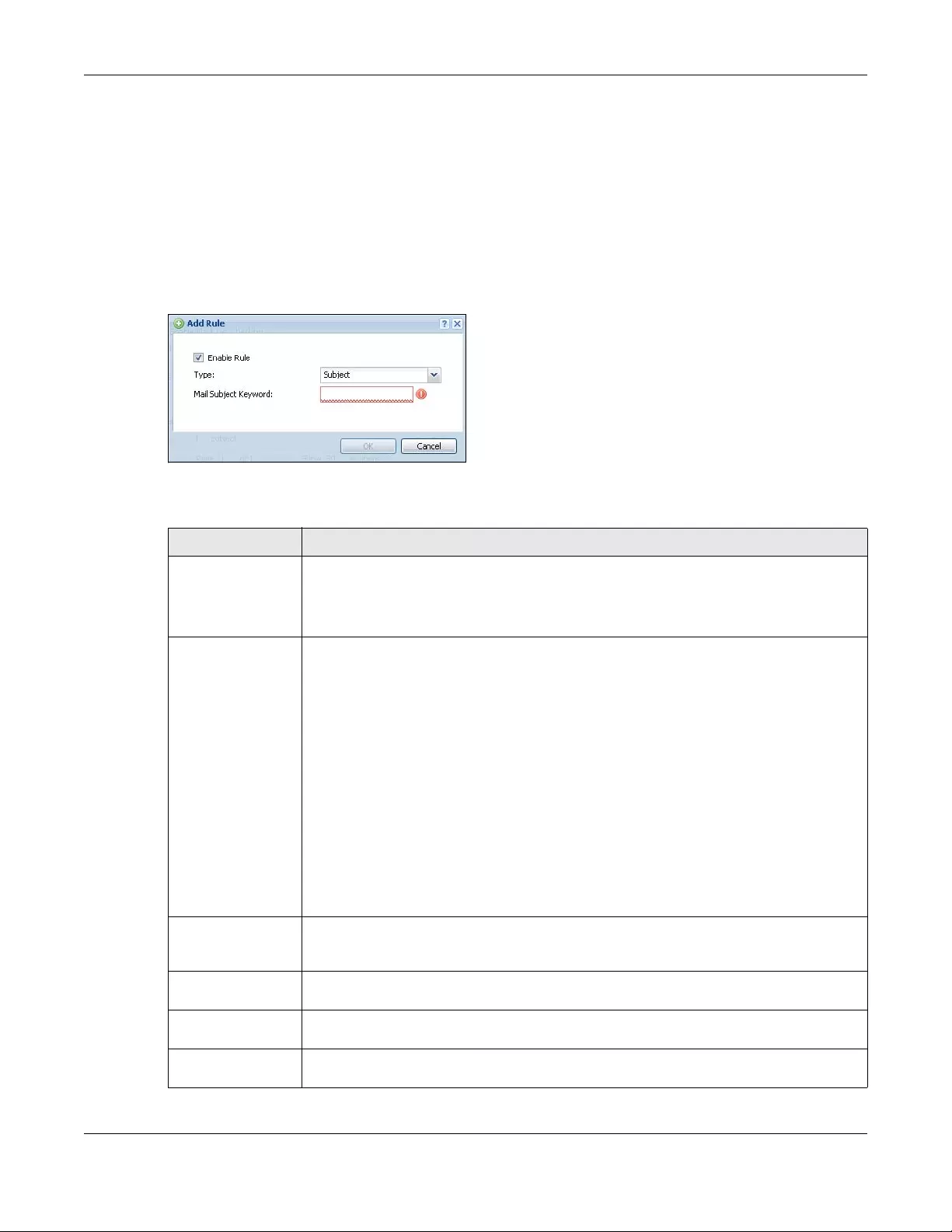
Chapter 32 Anti-Spam
ZyWALL/USG Series User’s Guide
530
32.5.1 The Anti-Spam Black or White List Add/Edit Screen
In the anti-spam Black List or White List screen, click the Add icon or an Edit icon to display the
following screen.
Use this screen to configure an anti-spam black list entry to identify spam e-mail. You can create
entries based on specific subject text, or the sender’s or relay’s IP address or e-mail address. You
can also create entries that check for particular header fields and values.
Figure 352 Configuration > UTM Profile > Anti-Spam > Black/White List > Black List (or White List)
> Add
The following table describes the labels in this screen.
Table 221 Configuration > UTM Profile > Anti-Spam > Black/White List > Black/White List > Add
LABEL DESCRIPTION
Enable Rule Select this to have the ZyWALL/USG use this entry as part of the black or white list.
To actually use the entry, you must also turn on the use of the list in the corresponding
list screen, enable the anti-spam feature in the anti-spam general screen, and configure
an anti-spam policy to use the list.
Type Use this field to base the entry on the e-mail’s subject, source or relay IP address,
source e-mail address, or header.
Select Subject to have the ZyWALL/USG check e-mail for specific content in the subject
line.
Select IP Address to have the ZyWALL/USG check e-mail for a specific source or relay
IP address.
Select IPv6 Address to have the ZyWALL/USG check e-mail for a specific source or
relay IPv6 address.
Select E-Mail Address to have the ZyWALL/USG check e-mail for a specific source e-
mail address or domain name.
Select Mail Header to have the ZyWALL/USG check e-mail for specific header fields and
values. Configure black list header entries to check for e-mail from bulk mail programs
or with content commonly used in spam. Configure white list header entries to allow
certain header values that identify the e-mail as being from a trusted source.
Mail Subject
Keyword
This field displays when you select the Subject type. Enter up to 63 ASCII characters of
text to check for in e-mail headers. Spaces are not allowed, although you could
substitute a question mark (?). See Section 32.5.2 on page 531 for more details.
Sender or Mail
Relay IP Address
This field displays when you select the IP Address type. Enter an IP address in dotted
decimal notation.
Sender or Mail
Relay IPv6 Address
This field displays when you select the IPv6 Address type. Enter an IPv6 address with
prefix.
Netmask This field displays when you select the IP type. Enter the subnet mask here, if
applicable.
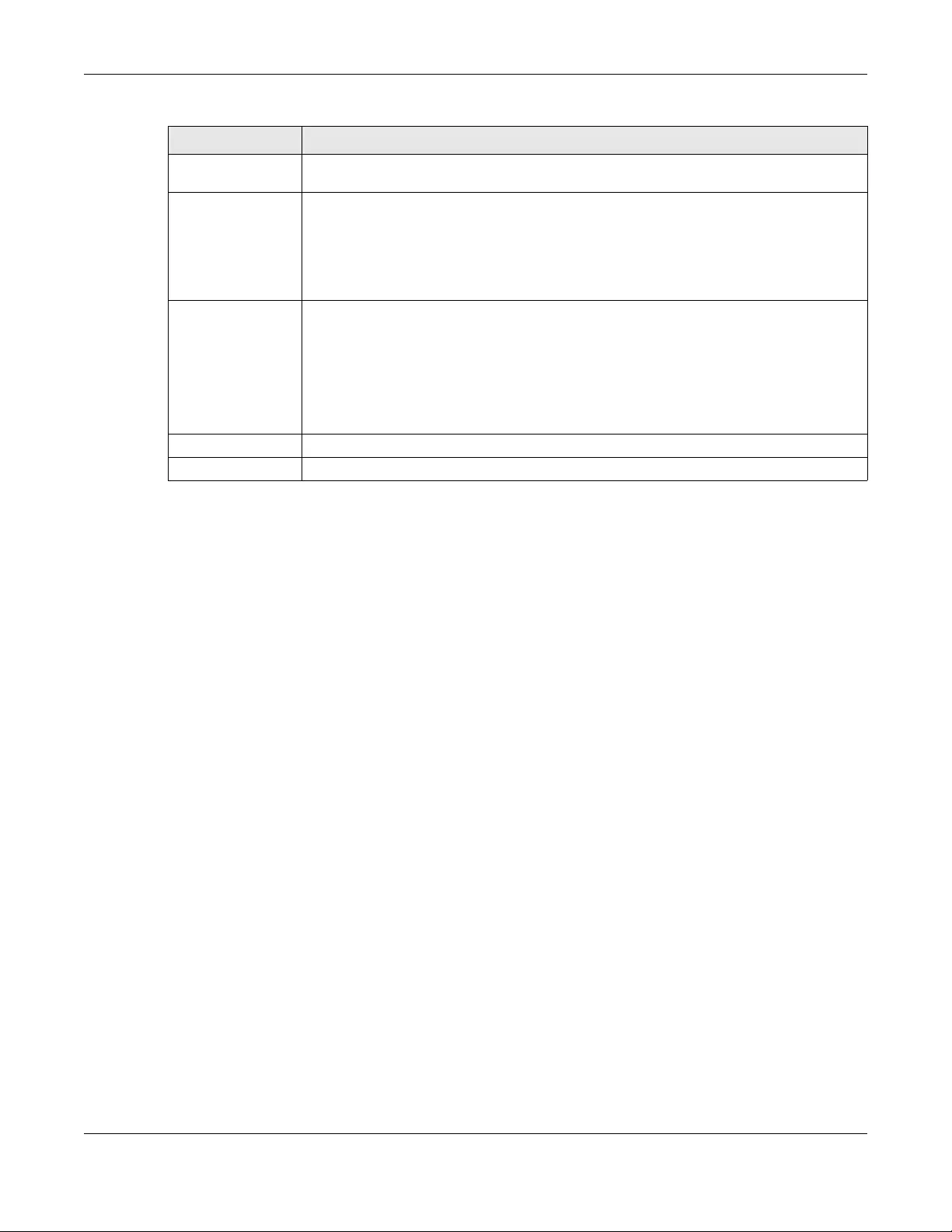
Chapter 32 Anti-Spam
ZyWALL/USG Series User’s Guide
531
32.5.2 Regular Expressions in Black or White List Entries
The following applies for a black or white list entry based on an e-mail subject, e-mail address, or
e-mail header value.
• Use a question mark (?) to let a single character vary. For example, use “a?c” (without the
quotation marks) to specify abc, acc and so on.
• You can also use a wildcard (*). For example, if you configure *def.com, any e-mail address that
ends in def.com matches. So “mail.def.com” matches.
• The wildcard can be anywhere in the text string and you can use more than one wildcard. You
cannot use two wildcards side by side, there must be other characters between them.
• The ZyWALL/USG checks the first header with the name you specified in the entry. So if the e-
mail has more than one “Received” header, the ZyWALL/USG checks the first one.
32.6 The Anti-Spam White List Screen
Click Configuration > UTM Profile > Anti-Spam > Black/White List and then the White List
tab to display the Anti-Spam White List screen.
Configure the white list to identify legitimate e-mail. You can create white list entries based on the
sender’s or relay’s IP address or e-mail address. You can also create entries that check for
particular header fields and values or specific subject text.
Sender E-Mail
Address
This field displays when you select the E-Mail type. Enter a keyword (up to 63 ASCII
characters). See Section 32.5.2 on page 531 for more details.
Mail Header Field
Name
This field displays when you select the Mail Header type.
Type the name part of an e-mail header (the part that comes before the colon). Use up
to 63 ASCII characters.
For example, if you want the entry to check the “Received:” header for a specific mail
server’s domain, enter “Received” here.
Field Value
Keyword
This field displays when you select the Mail Header type.
Type the value part of an e-mail header (the part that comes after the colon). Use up to
63 ASCII characters.
For example, if you want the entry to check the “Received:” header for a specific mail
server’s domain, enter the mail server’s domain here.
See Section 32.5.2 on page 531 for more details.
OK Click OK to save your changes.
Cancel Click Cancel to exit this screen without saving your changes.
Table 221 Configuration > UTM Profile > Anti-Spam > Black/White List > Black/White List > Add
LABEL DESCRIPTION
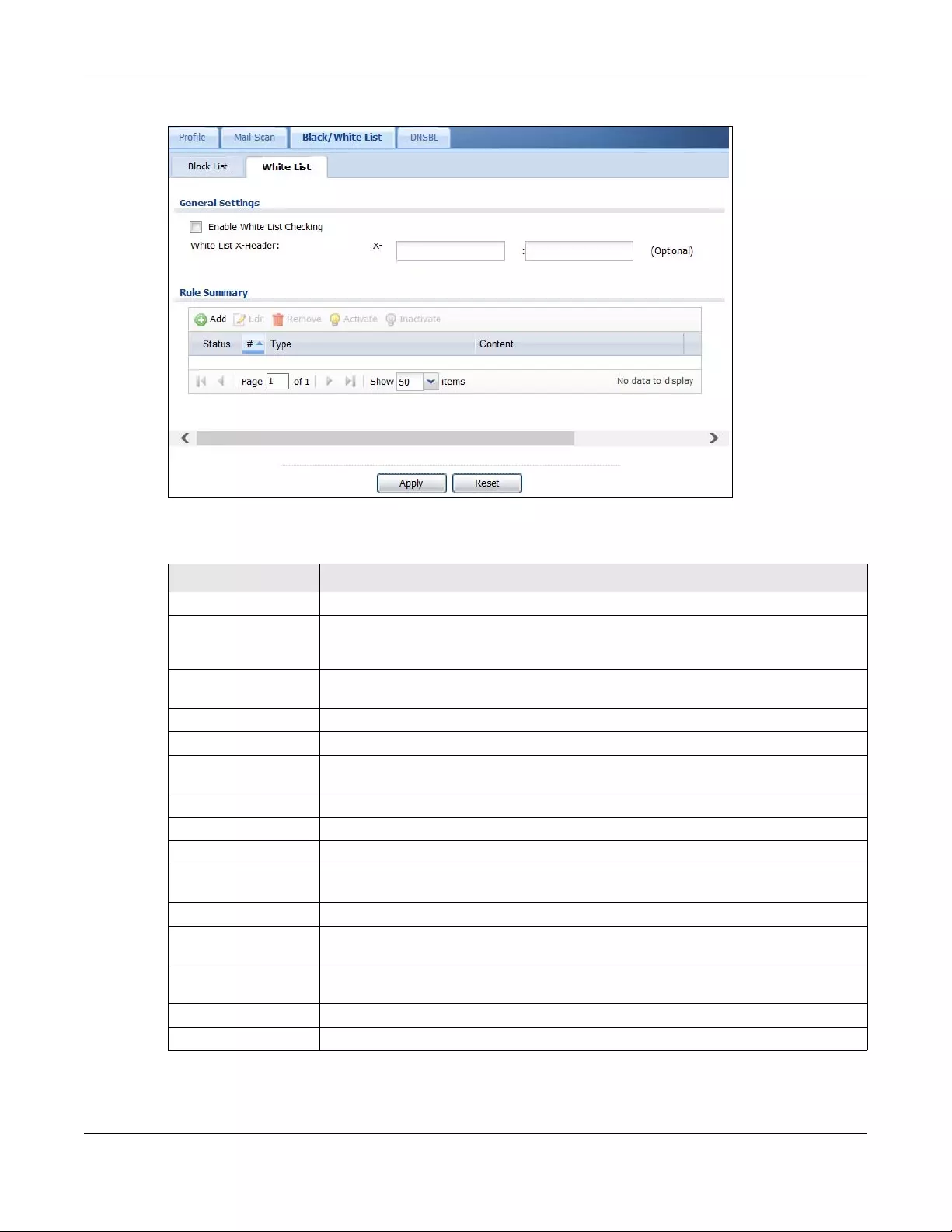
Chapter 32 Anti-Spam
ZyWALL/USG Series User’s Guide
532
Figure 353 Configuration > UTM Profile > Anti-Spam > Black/White List > White List
The following table describes the labels in this screen.
Table 222 Configuration > UTM Profile > Anti-Spam > Black/White List > White List
LABEL DESCRIPTION
General Settings
Enable White List
Checking
Select this check box to have the ZyWALL/USG forward e-mail that matches (an
active) white list entry without doing any more anti-spam checking on that individual
e-mail.
White List X-Header Specify the name and value for the X-Header to be added to e-mails that match the
ZyWALL/USG’s spam white list.
Rule Summary
Add Click this to create a new entry. See Section 32.5.1 on page 530 for details.
Edit Select an entry and click this to be able to modify it. See Section 32.5.1 on page 530
for details.
Remove Select an entry and click this to delete it.
Activate To turn on an entry, select it and click Activate.
Inactivate To turn off an entry, select it and click Inactivate.
Status The activate (light bulb) icon is lit when the entry is active and dimmed when the
entry is inactive.
#This is the entry’s index number in the list.
Type This field displays whether the entry is based on the e-mail’s subject, source or relay
IP address, source e-mail address, or a header.
Content This field displays the subject content, source or relay IP address, source e-mail
address, or header value for which the entry checks.
Apply Click Apply to save your changes back to the ZyWALL/USG.
Reset Click Reset to return the screen to its last-saved settings.
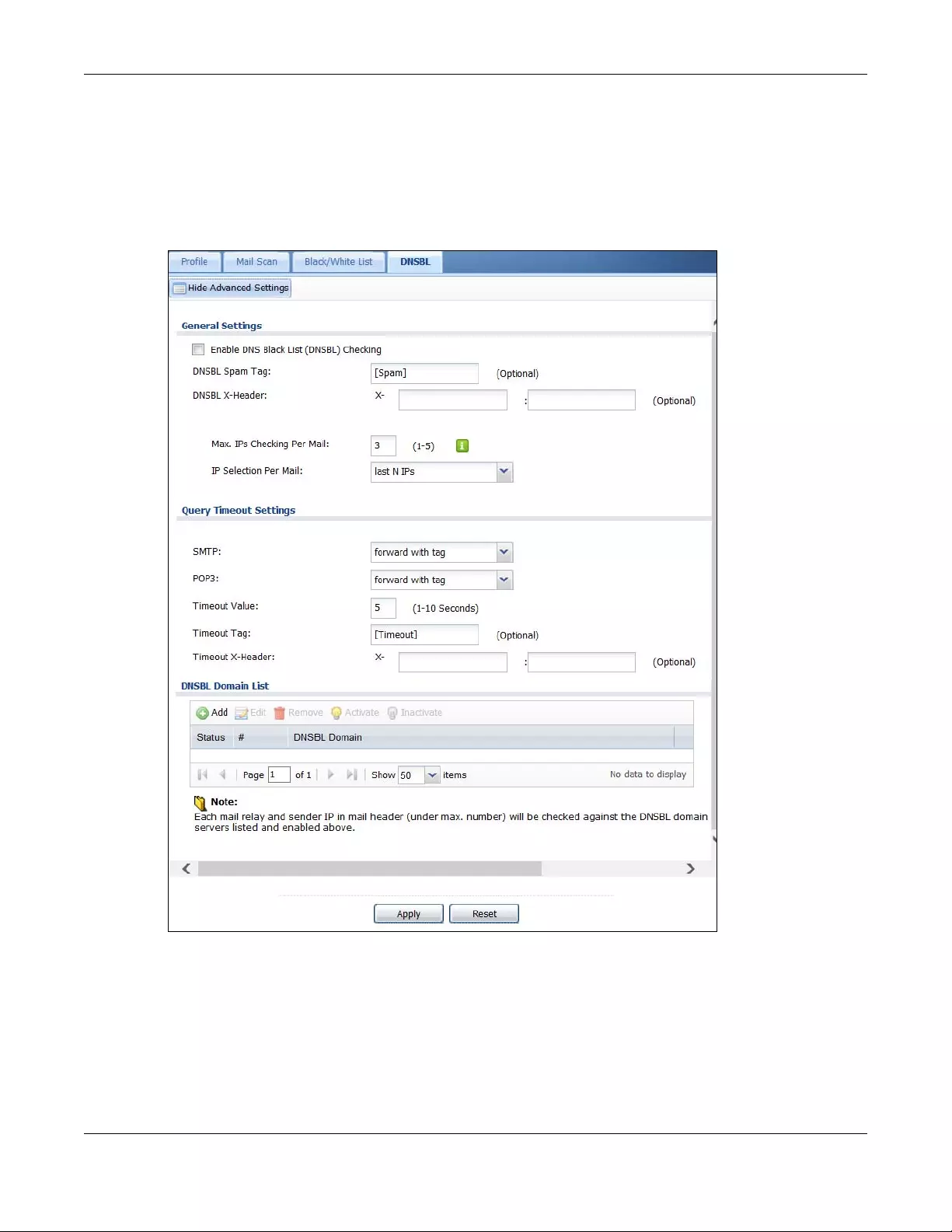
Chapter 32 Anti-Spam
ZyWALL/USG Series User’s Guide
533
32.7 The DNSBL Screen
Click Configuration > UTM Profile > Anti-Spam > DNSBL to display the anti-spam DNSBL
screen. Use this screen to configure the ZyWALL/USG to check the sender and relay IP addresses in
e-mail headers against DNS (Domain Name Service)-based spam Black Lists (DNSBLs).
Figure 354 Configuration > UTM Profile > Anti-Spam > DNSBL
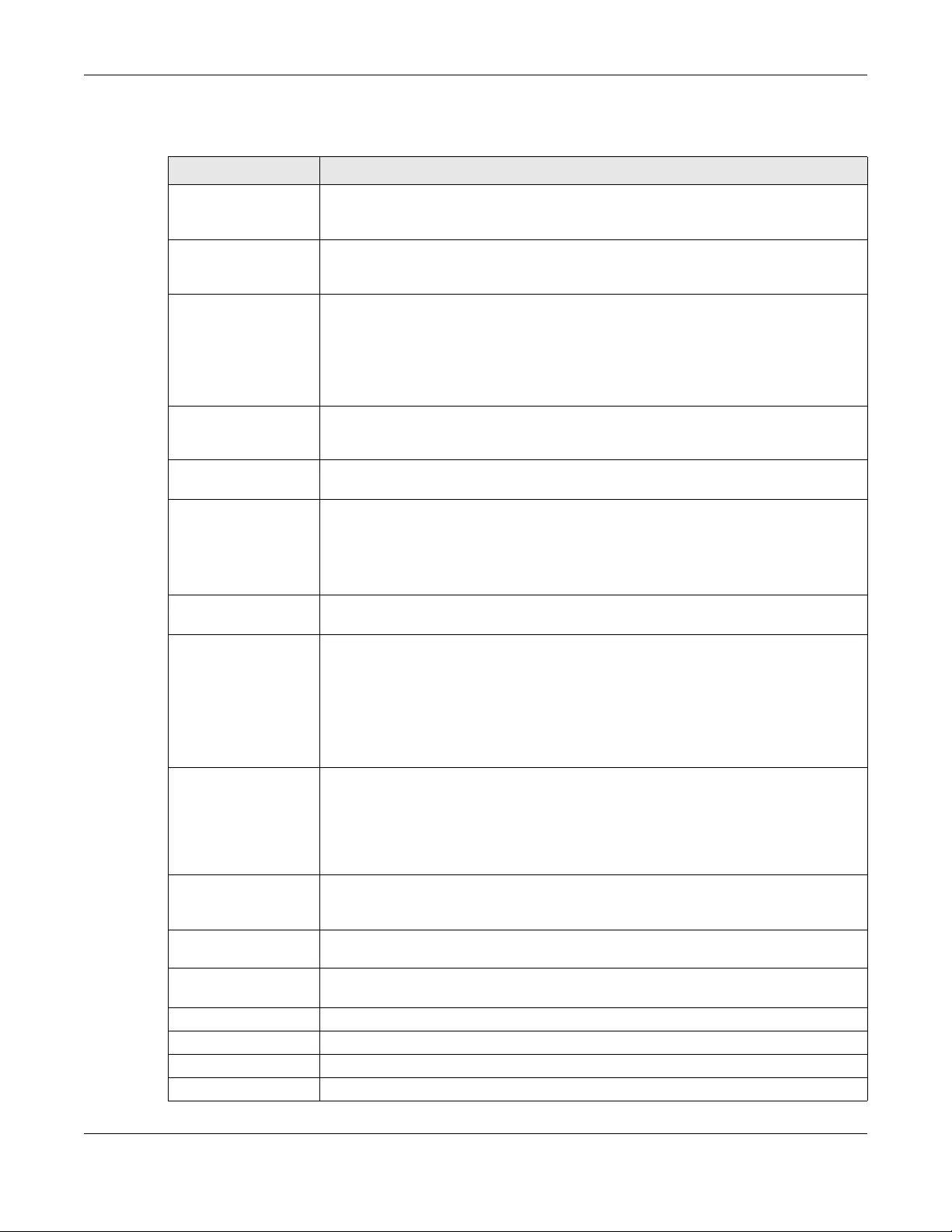
Chapter 32 Anti-Spam
ZyWALL/USG Series User’s Guide
534
The following table describes the labels in this screen.
Table 223 Configuration > UTM Profile > Anti-Spam > DNSBL
LABEL DESCRIPTION
Show Advanced
Settings / Hide
Advanced Settings
Click this button to display a greater or lesser number of configuration fields.
Enable DNS Black List
(DNSBL) Checking
Select this to have the ZyWALL/USG check the sender and relay IP addresses in e-
mail headers against the DNSBL servers maintained by the DNSBL domains listed in
the ZyWALL/USG.
DNSBL Spam Tag Enter a message or label (up to 15 ASCII characters) to add to the beginning of the
mail subject of e-mails that have a sender or relay IP address in the header that
matches a black list maintained by one of the DNSBL domains listed in the ZyWALL/
USG.
This tag is only added if the anti-spam policy is configured to forward spam mail with
a spam tag.
DSBNL X-Header Specify the name and value for the X-Header to be added to e-mails that have a
sender or relay IP address in the header that matches a black list maintained by one
of the DNSBL domains listed in the ZyWALL/USG.
Max. IPs Checking Per
Mail
Set the maximum number of sender and relay server IP addresses in the mail header
to check against the DNSBL domain servers.
IP Selection Per Mail Select first N IPs to have the ZyWALL/USG start checking from the first IP address in
the mail header. This is the IP of the sender or the first server that forwarded the
mail.
Select last N IPs to have the ZyWALL/USG start checking from the last IP address in
the mail header. This is the IP of the last server that forwarded the mail.
Query Timeout
Setting
SMTP Select how the ZyWALL/USG is to handle SMTP mail (mail going to an e-mail server)
if the queries to the DNSBL domains time out.
Select drop to discard SMTP mail.
Select forward to allow SMTP mail to go through.
Select forward with tag to add a DNSBL timeout tag to the mail subject of an SMTP
mail and send it.
POP3 Select how the ZyWALL/USG is to handle POP3 mail (mail coming to an e-mail client)
if the queries to the DNSBL domains time out.
Select forward to allow POP3 mail to go through.
Select forward with tag to add a DNSBL timeout tag to the mail subject of an POP3
mail and send it.
Timeout Value Set how long the ZyWALL/USG waits for a reply from the DNSBL domains listed
below. If there is no reply before this time period expires, the ZyWALL/USG takes the
action defined in the relevant Actions when Query Timeout field.
Timeout Tag Enter a message or label (up to 15 ASCII characters) to add to the mail subject of e-
mails that the ZyWALL/USG forwards if queries to the DNSBL domains time out.
Timeout X-Header Specify the name and value for the X-Header to be added to e-mails that the
ZyWALL/USG forwards if queries to the DNSBL domains time out.
DNSBL Domain List
Add Click this to create a new entry.
Edit Select an entry and click this to be able to modify it.
Remove Select an entry and click this to delete it.
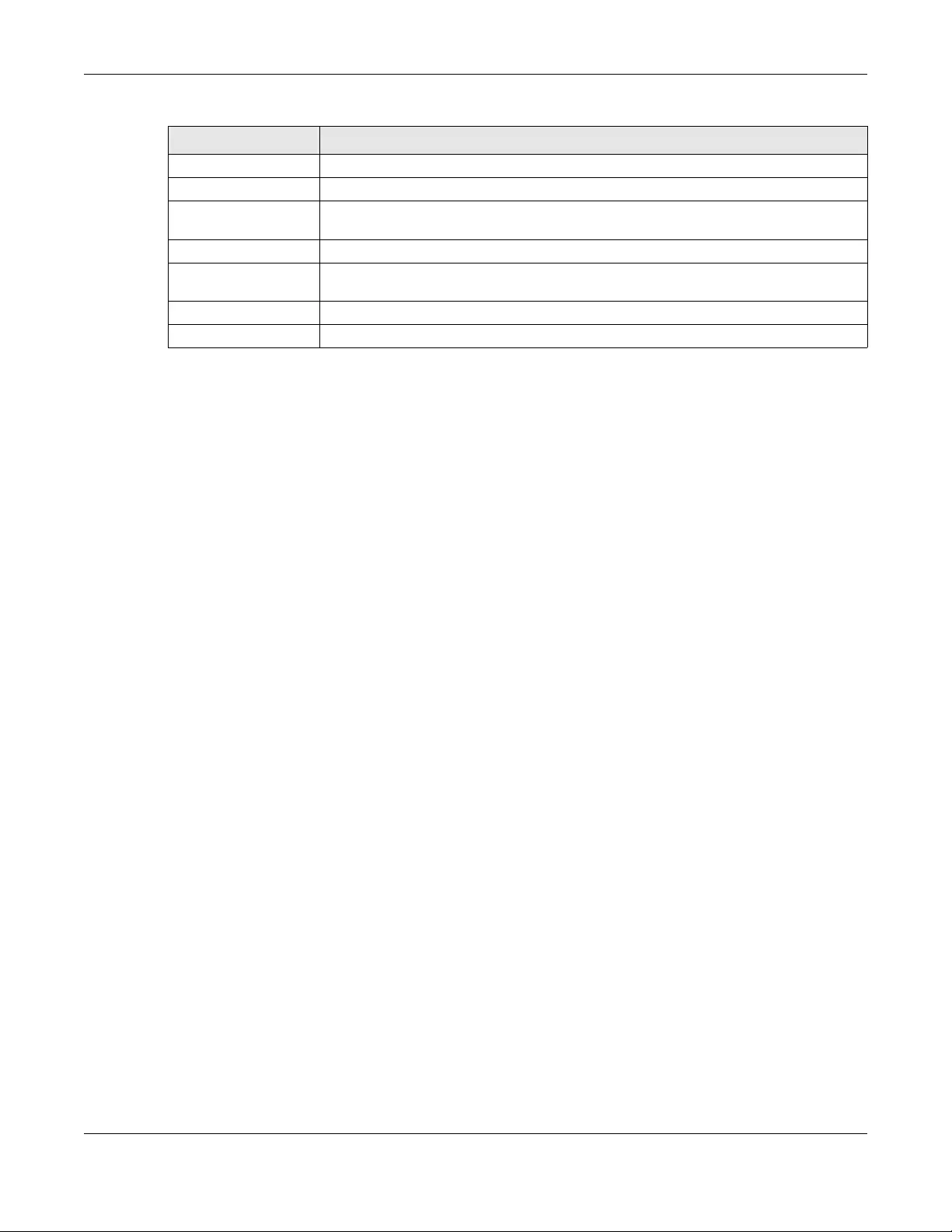
Chapter 32 Anti-Spam
ZyWALL/USG Series User’s Guide
535
32.8 Anti-Spam Technical Reference
Here is more detailed anti-spam information.
DNSBL
• The ZyWALL/USG checks only public sender and relay IP addresses, it does not check private IP
addresses.
• The ZyWALL/USG sends a separate query (DNS lookup) for each sender or relay IP address in the
e-mail’s header to each of the ZyWALL/USG’s DNSBL domains at the same time.
• The DNSBL servers send replies as to whether or not each IP address matches an entry in their
list. Each IP address has a separate reply.
• As long as the replies are indicating the IP addresses do not match entries on the DNSBL lists,
the ZyWALL/USG waits until it receives at least one reply for each IP address.
• If the ZyWALL/USG receives a DNSBL reply that one of the IP addresses is in the DNSBL list, the
ZyWALL/USG immediately classifies the e-mail as spam and takes the anti-spam policy’s
configured action for spam. The ZyWALL/USG does not wait for any more DNSBL replies.
• If the ZyWALL/USG receives at least one non-spam reply for each of an e-mail’s routing IP
addresses, the ZyWALL/USG immediately classifies the e-mail as legitimate and forwards it.
• Any further DNSBL replies that come after the ZyWALL/USG classifies an e-mail as spam or
legitimate have no effect.
• The ZyWALL/USG records DNSBL responses for IP addresses in a cache for up to 72 hours. The
ZyWALL/USG checks an e-mail’s sender and relay IP addresses against the cache first and only
sends DNSBL queries for IP addresses that are not in the cache.
Here is an example of an e-mail classified as spam based on DNSBL replies.
Activate To turn on an entry, select it and click Activate.
Inactivate To turn off an entry, select it and click Inactivate.
Status The activate (light bulb) icon is lit when the entry is active and dimmed when the
entry is inactive.
#This is the entry’s index number in the list.
DNSBL Domain This is the name of a domain that maintains DNSBL servers. Enter the domain that is
maintaining a DNSBL.
Apply Click Apply to save your changes back to the ZyWALL/USG.
Reset Click Reset to return the screen to its last-saved settings.
Table 223 Configuration > UTM Profile > Anti-Spam > DNSBL (continued)
LABEL DESCRIPTION
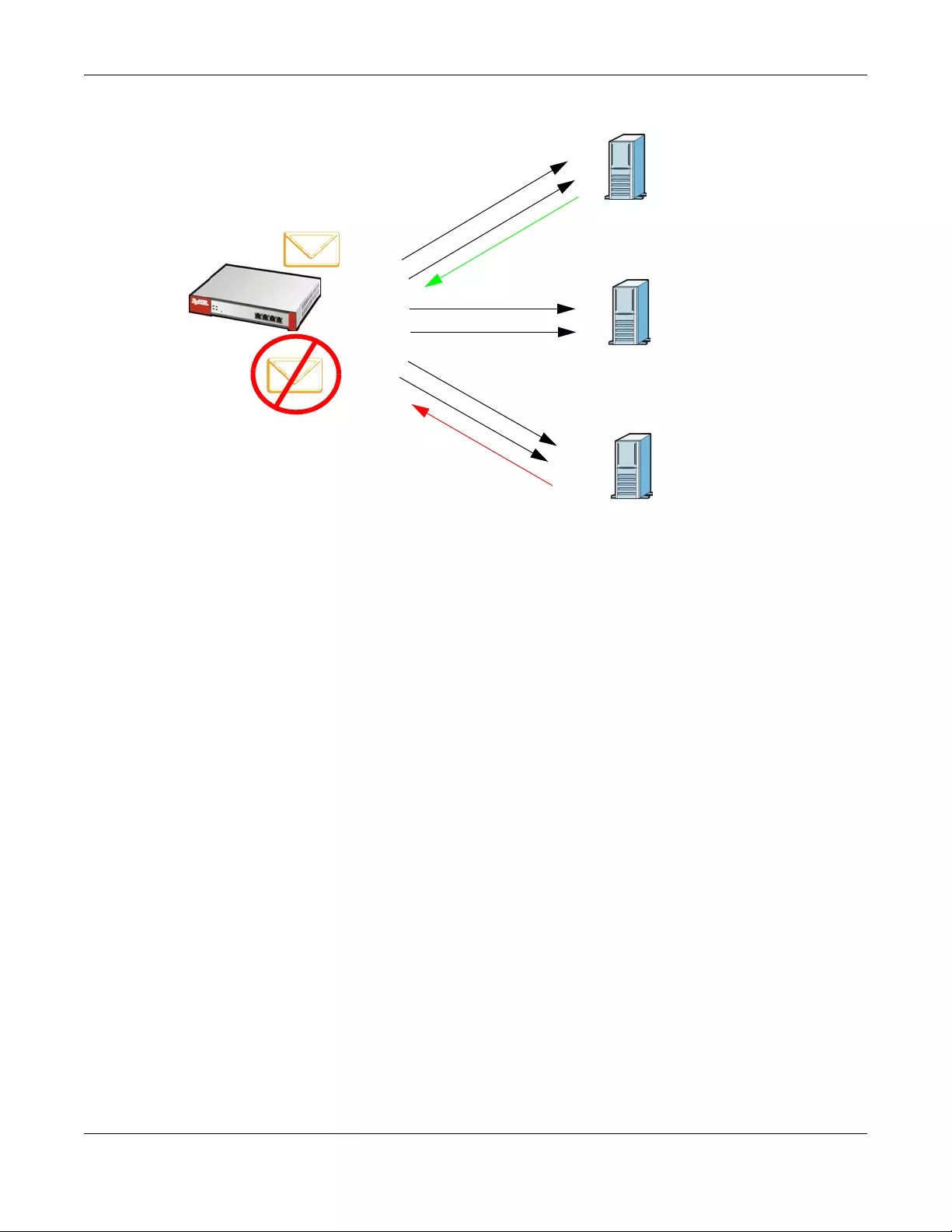
Chapter 32 Anti-Spam
ZyWALL/USG Series User’s Guide
536
Figure 355 DNSBL Spam Detection Example
1The ZyWALL/USG receives an e-mail that was sent from IP address a.a.a.a and relayed by an e-
mail server at IP address b.b.b.b. The ZyWALL/USG sends a separate query to each of its DNSBL
domains for IP address a.a.a.a. The ZyWALL/USG sends another separate query to each of its
DNSBL domains for IP address b.b.b.b.
2DNSBL A replies that IP address a.a.a.a does not match any entries in its list (not spam).
3DNSBL C replies that IP address b.b.b.b matches an entry in its list.
4The ZyWALL/USG immediately classifies the e-mail as spam and takes the action for spam that you
defined in the anti-spam policy. In this example it was an SMTP mail and the defined action was to
drop the mail. The ZyWALL/USG does not wait for any more DNSBL replies.
Here is an example of an e-mail classified as legitimate based on DNSBL replies.
DNSBL A
DNSBL B
DNSBL C
IPs: a.a.a.a
b.b.b.b
1
2
a.a.a.a Not spam
3
4
a.a.a.a?
b.b.b.b?
a.a.a.a?
b.b.b.b?
a.a.a.a?
b.b.b.b?
b.b.b.b Spam
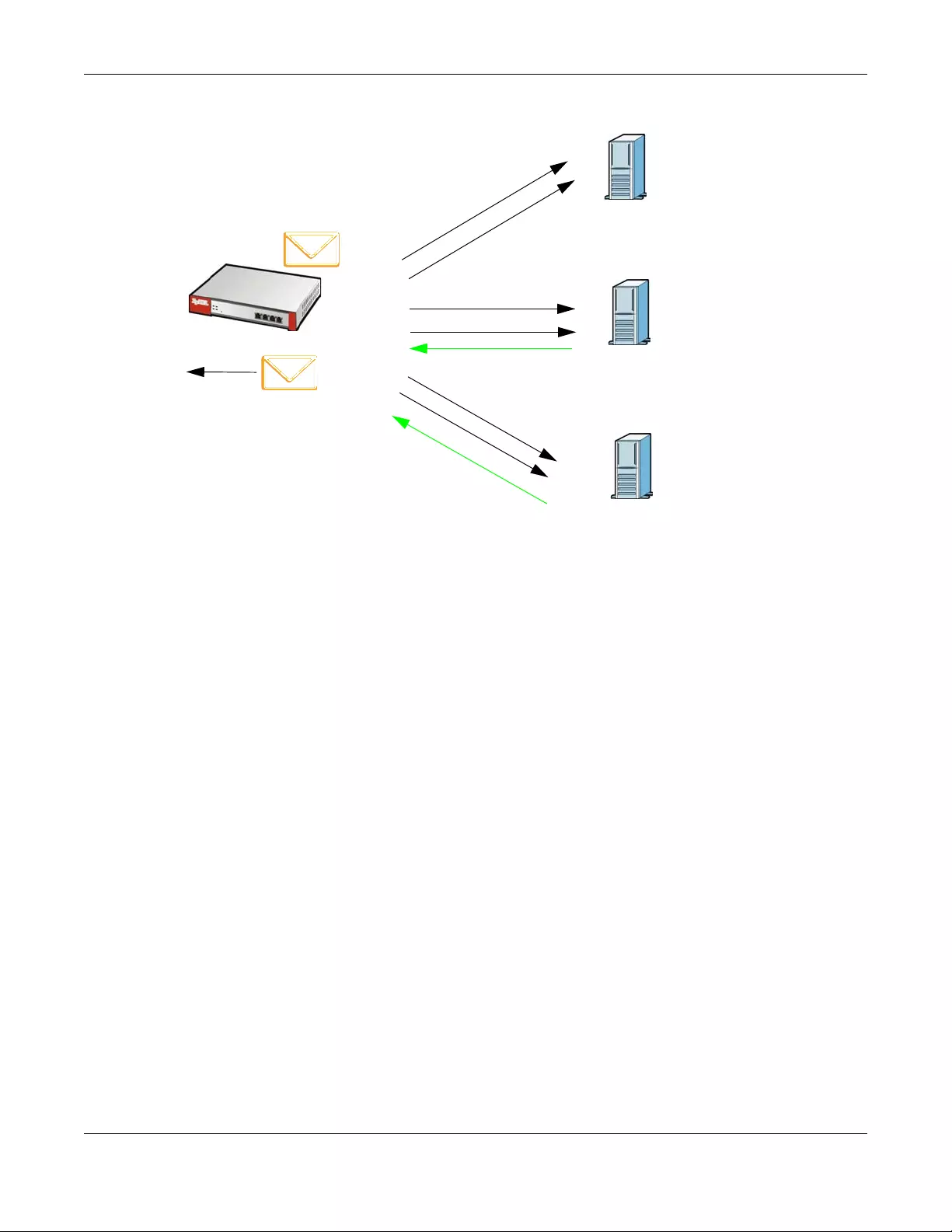
Chapter 32 Anti-Spam
ZyWALL/USG Series User’s Guide
537
Figure 356 DNSBL Legitimate E-mail Detection Example
1The ZyWALL/USG receives an e-mail that was sent from IP address c.c.c.c and relayed by an e-mail
server at IP address d.d.d.d. The ZyWALL/USG sends a separate query to each of its DNSBL
domains for IP address c.c.c.c. The ZyWALL/USG sends another separate query to each of its
DNSBL domains for IP address d.d.d.d.
2DNSBL B replies that IP address d.d.d.d does not match any entries in its list (not spam).
3DNSBL C replies that IP address c.c.c.c does not match any entries in its list (not spam).
4Now that the ZyWALL/USG has received at least one non-spam reply for each of the e-mail’s
routing IP addresses, the ZyWALL/USG immediately classifies the e-mail as legitimate and forwards
it. The ZyWALL/USG does not wait for any more DNSBL replies.
If the ZyWALL/USG receives conflicting DNSBL replies for an e-mail routing IP address, the
ZyWALL/USG classifies the e-mail as spam. Here is an example.
DNSBL A
DNSBL B
DNSBL C
IPs: c.c.c.c
d.d.d.d
1
c.c.c.c Not spam
2
4
c.c.c.c?
d.d.d.d?
c.c.c.c?
d.d.d.d?
c.c.c.c?
d.d.d.d?
d.d.d.d Not spam
3
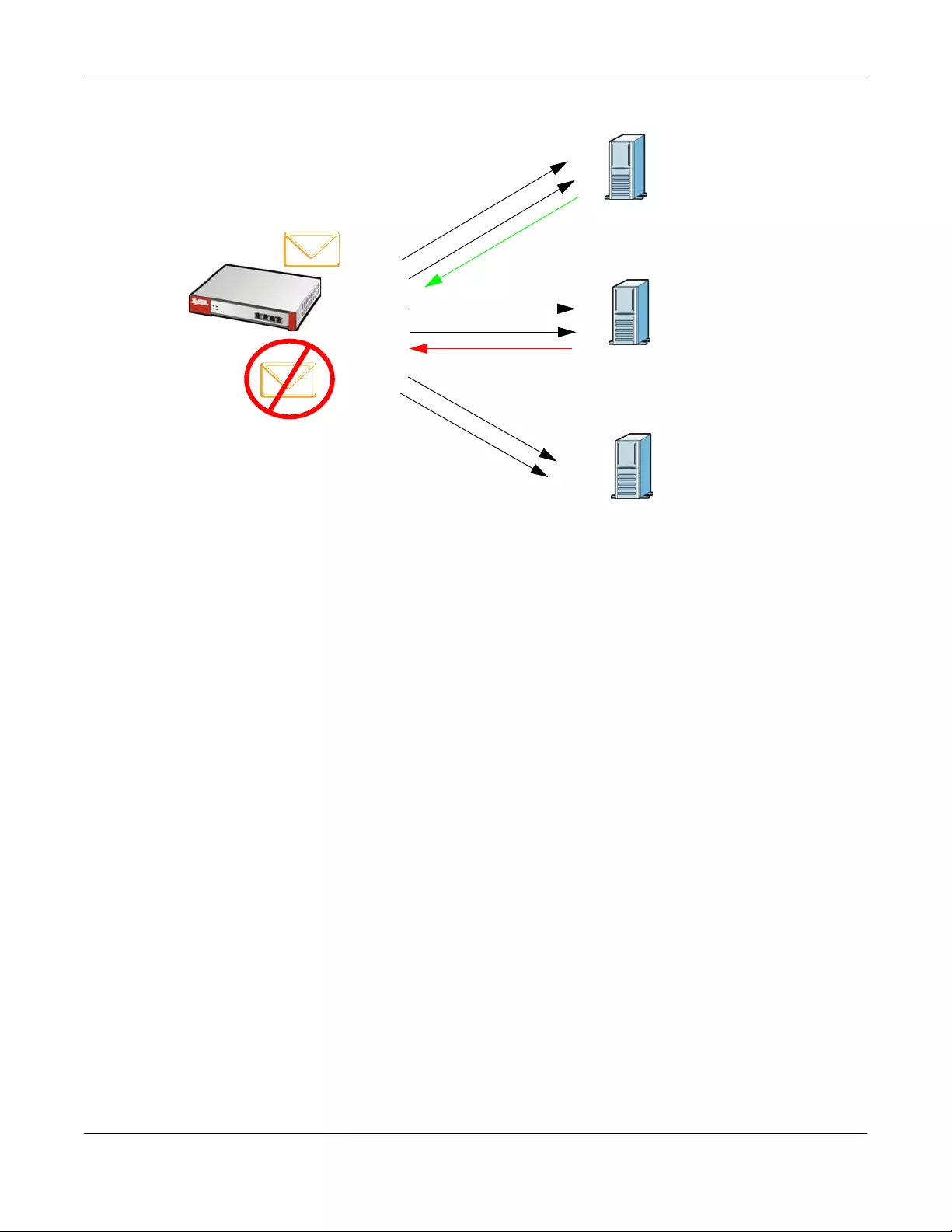
Chapter 32 Anti-Spam
ZyWALL/USG Series User’s Guide
538
Figure 357 Conflicting DNSBL Replies Example
1The ZyWALL/USG receives an e-mail that was sent from IP address a.b.c.d and relayed by an e-
mail server at IP address w.x.y.z. The ZyWALL/USG sends a separate query to each of its DNSBL
domains for IP address a.b.c.d. The ZyWALL/USG sends another separate query to each of its
DNSBL domains for IP address w.x.y.z.
2DNSBL A replies that IP address a.b.c.d does not match any entries in its list (not spam).
3While waiting for a DNSBL reply about IP address w.x.y.z, the ZyWALL/USG receives a reply from
DNSBL B saying IP address a.b.c.d is in its list.
4The ZyWALL/USG immediately classifies the e-mail as spam and takes the action for spam that you
defined in the anti-spam policy. In this example it was an SMTP mail and the defined action was to
drop the mail. The ZyWALL/USG does not wait for any more DNSBL replies.
DNSBL A
DNSBL B
DNSBL C
IPs: a.b.c.d
w.x.y.z
1
2
a.b.c.d Not spam
3
4
a.b.c.d?
w.x.y.z?
a.b.c.d?
w.x.y.z?
a.b.c.d?
w.x.y.z?
a.b.c.d Spam!
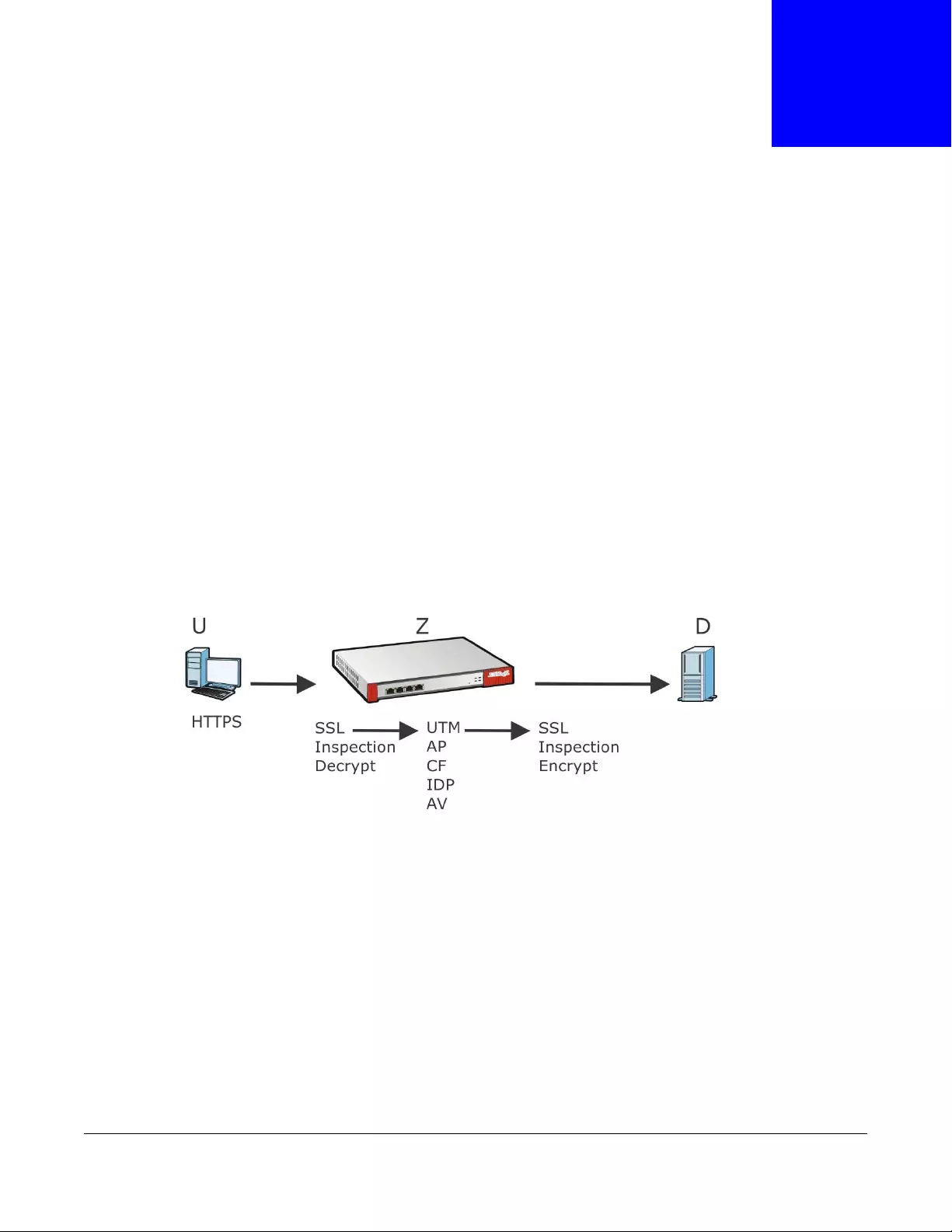
ZyWALL/USG Series User’s Guide
539
CHAPTER 33
SSL Inspection
33.1 Overview
Secure Socket Layer (SSL) traffic, such as https://www.google.com/HTTPS, FTPs, POP3s, SMTPs,
etc. is encrypted, and cannot be inspected using Unified Threat Management (UTM) profiles such as
App Patrol, Content Filter, Intrusion, Detection and Prevention (IDP), or Anti-Virus. The ZyWALL/
USG uses SSL Inspection to decrypt SSL traffic, sends it to the UTM engines for inspection, then
encrypts traffic that passes inspection and forwards it to the destination server, such as Google.
An example process is shown in the following figure. User U sends a HTTPS request (SSL) to
destination server D, via the ZyWALL/USG, Z. The traffic matches an SSL Inspection profile in a
security policy, so the ZyWALL/USG decrypts the traffic using SSL Inspection. The decrypted traffic
is then inspected by the UTM profiles in the same security profile that matched the SSL Inspection
profile. If all is OK, then the ZyWALL/USG re-encrypts the traffic using SSL Inspection and forwards
it to the destination server D. SSL traffic could be in the opposite direction for other examples.
Figure 358 SSL Inspection Overview
Note: Anti-Spam cannot be applied to traffic decrypted by SSL Inspection.
33.1.1 What You Can Do in this Chapter
•Use the UTM Profile > SSL Inspection > Profile screen (Section 33.2 on page 540) to view
SSL Inspection profiles. Click the Add or Edit icon in this screen to configure the CA certificate,
action and log in an SSL Inspection profile.
•Use the UTM Profile > SSL Inspection > Exclude List screens (Section 33.3 on page 543) to
create a whitelist of destination servers to which traffic is passed through uninspected.
33.1.2 What You Need To Know
• Supported Cipher Suite
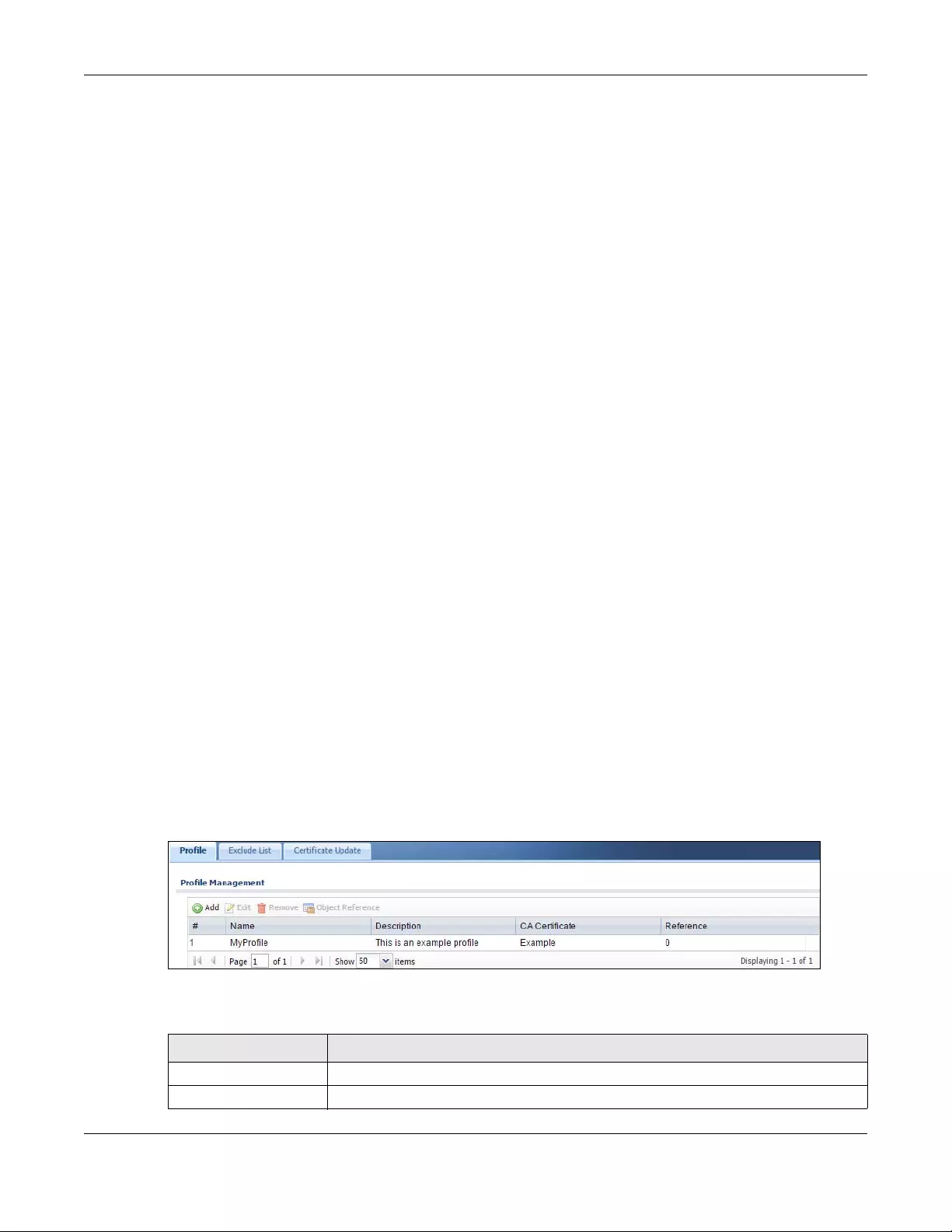
Chapter 33 SSL Inspection
ZyWALL/USG Series User’s Guide
540
• RC4 (Rivest Cipher 4)
• DES (Data Encryption Standard)
•3DES
• AES (Advanced Encryption Standard)
• SSLv3/TLS1.0 (Transport Layer Security) Support
• SSLv3/TLS1.0 is currently supported with option to pass or block SSLv2 traffic
• Traffic using TLS1.1 (Transport Layer Security) or TLS1.2 is downgraded to TLS1.0 for SSL
Inspection
• No Compression Support Now
• No Client Authentication Request Support Now
•Finding Out More
•See Configuration > Object > Certificate > My Certificates for information on creating
certificates on the ZyWALL/USG.
•See Monitor > UTM Statistics > SSL Inspection to get usage data and easily add a
destination server to the whitelist of exclusion servers.
•See Configuration > Security Policy > Policy Control > Policy to bind an SSL Inspection
profile to a traffic flow(s).
33.1.3 Before You Begin
• If you don’t want to use the default ZyWALL/USG certificate, then create a new certificate in
Object > Certificate > My Certificates.
• Decide what destination servers to which traffic is sent directly without inspection. This may be a
matter of privacy and legality regarding inspecting an individual’s encrypted session, such as
financial websites. This may vary by locale.
33.2 The SSL Inspection Profile Screen
An SSL Inspection profile is a template with pre-configured certificate, action and log.
Click Configuration > UTM Profile > SSL Inspection > Profile to open this screen.
Figure 359 Configuration > UTM Profile > SSL Inspection > Profile
The following table describes the fields in this screen.
Table 224 Configuration > UTM Profile > SSL Inspection > Profile
LABEL DESCRIPTION
Profile Management
Add Click Add to create a new profile.
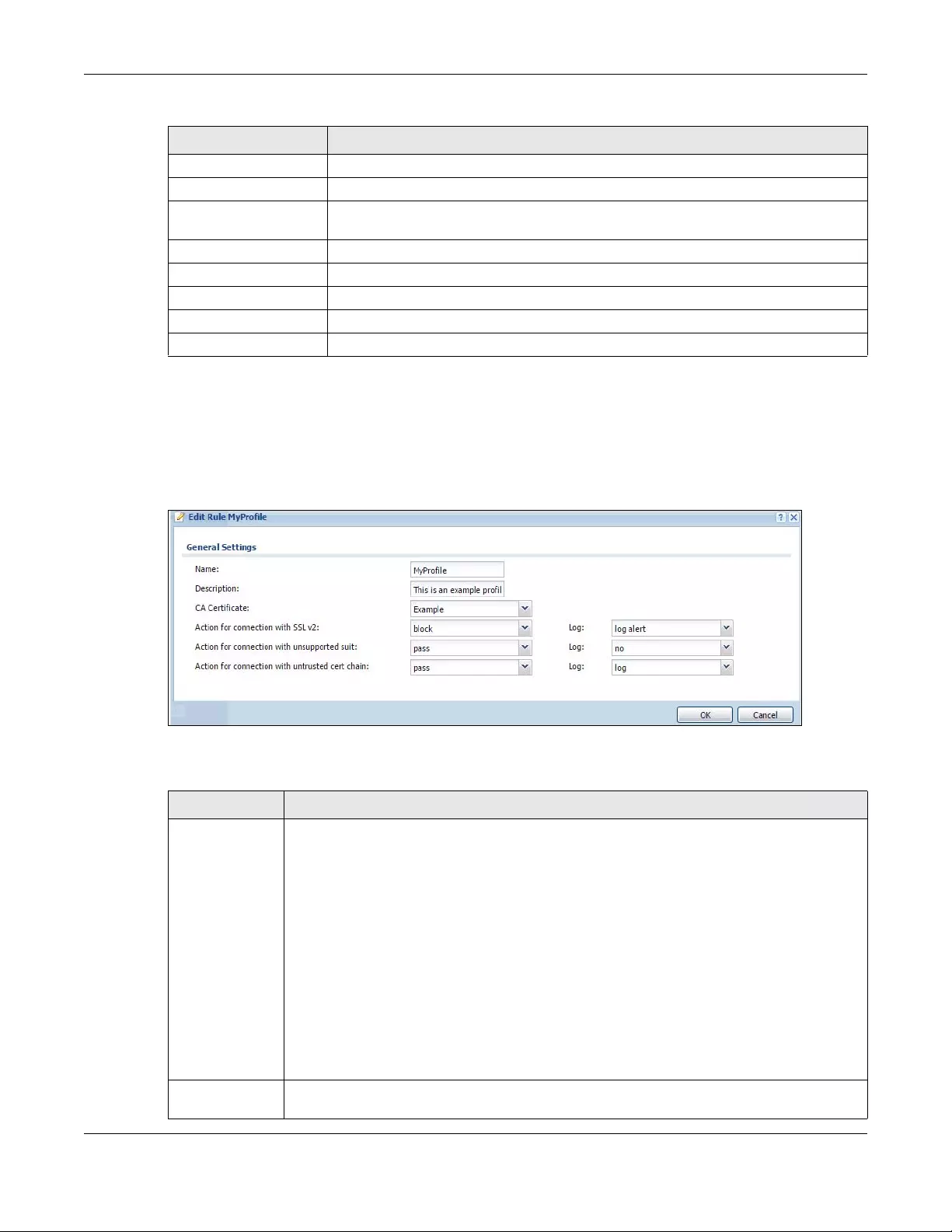
Chapter 33 SSL Inspection
ZyWALL/USG Series User’s Guide
541
33.2.1 Add / Edit SSL Inspection Profiles
Click Con figuration > UTM Profile > SSL Inspection > Profile > Add to create a new profile or
select an existing profile and click Edit to change its settings.
Figure 360 Configuration > UTM Profile > SSL Inspection > Profile > Add / Edit
The following table describes the fields in this screen.
Edit Select an entry and click this to be able to modify it.
Remove Select an entry and click this to delete it.
Object Reference Select an entry and click Object References to open a screen that shows which
settings use the entry. Click Refresh to update information on this screen.
#This is the entry’s index number in the list.
Name This displays the name of the profile.
Description This displays the description of the profile.
CA Certificate This displays the CA certificate being used in this profile.
Reference This displays the number of times an object reference is used in a profile.
Table 224 Configuration > UTM Profile > SSL Inspection > Profile (continued)
LABEL DESCRIPTION
Table 225 Configuration > UTM Profile > SSL Inspection > Profile > Add / Edit
LABEL DESCRIPTION
Name This is the name of the profile. You may use 1-31 alphanumeric characters,
underscores(_), or dashes (-), but the first character cannot be a number. This value is
case-sensitive. These are valid, unique profile names:
• MyProfile
• mYProfile
• Mymy12_3-4
These are invalid profile names:
• 1mYProfile
• My Profile
• MyProfile?
• Whatalongprofilename123456789012
Description Enter additional information about this SSL Inspection entry. You can enter up to 60
characters ("0-9", "a-z", "A-Z", "-" and "_").

Chapter 33 SSL Inspection
ZyWALL/USG Series User’s Guide
542
CA Certificate This contains the default certificate and the certificates created in Object > Certificate >
My Certificates. Choose the certificate for this profile.
Severity Level Select a severity level and these use the icons to enable/disable and configure logs and
actions for all signatures of that level.
Action for
connection with
SSL v2
SSL Inspection supports SSLv3 and TLS1.0. Select to pass or block SSLv2 traffic that
matches traffic bound to this policy here.
Log These are the log options for SSLv2 traffic that matches traffic bound to this policy:
•no: Select this option to have the ZyWALL/USG create no log for SSLv2 traffic that
matches traffic bound to this policy.
•log: Select this option to have the ZyWALL/USG create a log for SSLv2 traffic that
matches traffic bound to this policy.
•log alert: An alert is an e-mailed log for more serious events that may need more
immediate attention. They also appear in red in the Monitor > Log screen. Select this
option to have the ZyWALL/USG send an alert for SSLv2 traffic that matches traffic
bound to this policy.
Action for
Connection with
unsupported
suit
SSL Inspection supports these cipher suites:
•RC4
•DES
•3DES
•AES
Select to pass or block unsupported traffic (such as other cipher suites, compressed
traffic, client authentication requests, and so on) that matches traffic bound to this policy
here.
Log These are the log options for unsupported traffic that matches traffic bound to this policy:
•no: Select this option to have the ZyWALL/USG create no log for unsupported traffic
that matches traffic bound to this policy.
•log: Select this option to have the ZyWALL/USG create a log for unsupported traffic
that matches traffic bound to this policy
•log alert: An alert is an e-mailed log for more serious events that may need more
immediate attention. They also appear in red in the Monitor > Log screen. Select this
option to have the ZyWALL/USG send an alert for unsupported traffic that matches
traffic bound to this policy.
Excepted
Signatures
Use the icons to enable/disable and configure logs and actions for individual signatures that
are different to the general settings configured for the severity level to which the signatures
belong. Signatures configured in Query View will appear in Group View.
Add Click this to configure settings to a signature that are different to the severity level to which
it belongs.
Remove Select an existing signature exception and then click this to delete the exception.
Activate To turn on an entry, select it and click Activate.
Inactivate To turn off an entry, select it and click Inactivate.
Log To edit an item’s log option, select it and use the Log icon. These are the log options:
no: Select this option on an individual signature or a complete service group to have the
ZyWALL/USG create no log when a packet matches a signature(s).
log: Select this option on an individual signature or a complete service group to have the
ZyWALL/USG create a log when a packet matches a signature(s).
log alert: An alert is an e-mailed log for more serious events that may need more
immediate attention. Select this option to have the ZyWALL/USG send an alert when a
packet matches a signature(s).
Table 225 Configuration > UTM Profile > SSL Inspection > Profile > Add / Edit (continued)
LABEL DESCRIPTION
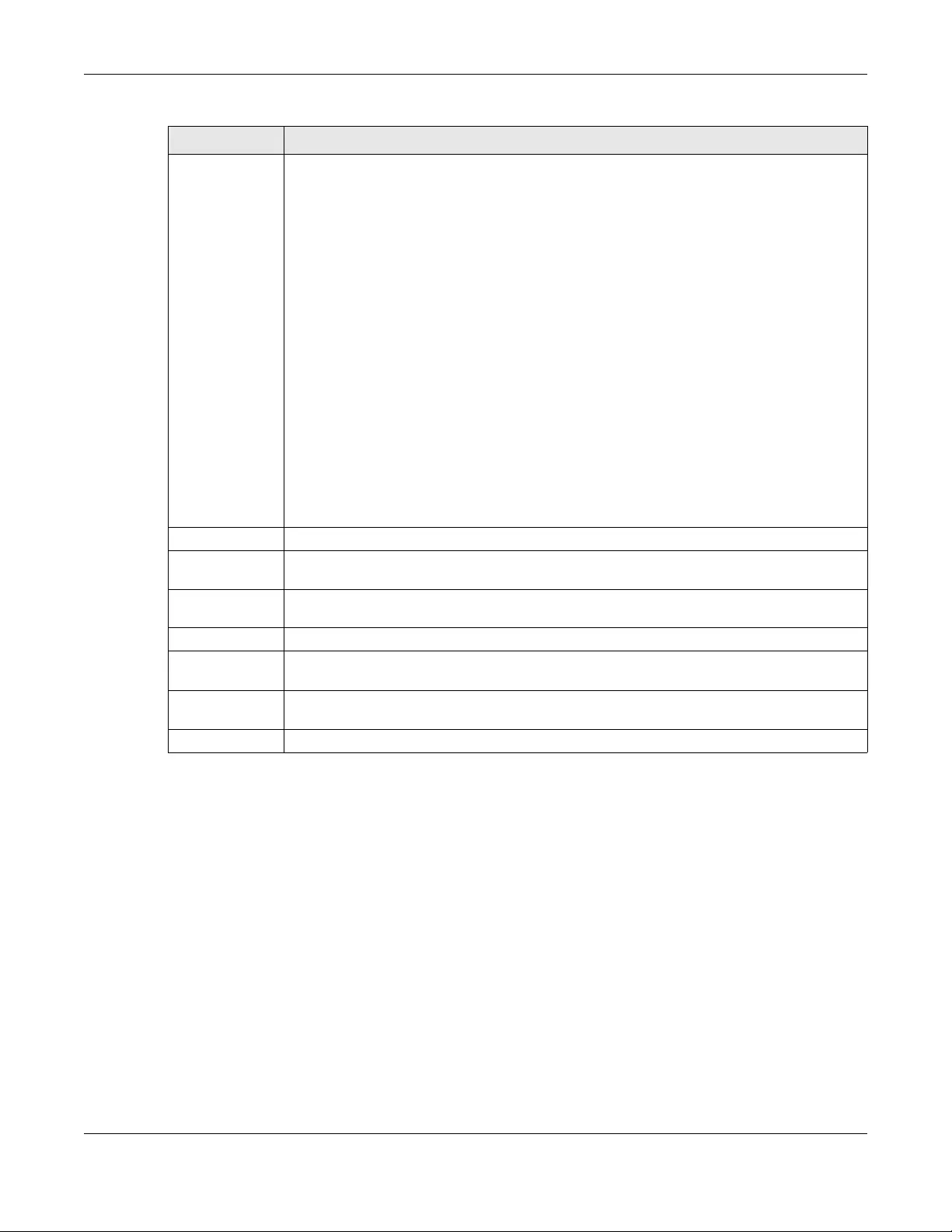
Chapter 33 SSL Inspection
ZyWALL/USG Series User’s Guide
543
33.3 Exclude List Screen
There may be privacy and legality issues regarding inspecting a user's encrypted session. The legal
issues may vary by locale, so it's important to check with your legal department to make sure that
it’s OK to intercept SSL traffic from your ZyWALL/USG users.
To ensure individual privacy and meet legal requirements, you can configure an exclusion list to
exclude matching sessions to destination servers. This traffic is not intercepted and is passed
through uninspected.
Click Configuration > UTM Profile > SSL Inspection > Exclude List to display the following
screen. Use Add to put a new item in the list or Edit to change an existing one or Remove to
delete an existing entry.
Action To edit what action the ZyWALL/USG takes when a packet matches a signature, select the
signature and use the Action icon.
none: Select this action on an individual signature or a complete service group to have the
ZyWALL/USG take no action when a packet matches the signature(s).
drop: Select this action on an individual signature or a complete service group to have the
ZyWALL/USG silently drop a packet that matches the signature(s). Neither sender nor
receiver are notified.
reject-sender: Select this action on an individual signature or a complete service group to
have the ZyWALL/USG send a reset to the sender when a packet matches the signature. If
it is a TCP attack packet, the ZyWALL/USG will send a packet with a ‘RST’ flag. If it is an
ICMP or UDP attack packet, the ZyWALL/USG will send an ICMP unreachable packet.
reject-receiver: Select this action on an individual signature or a complete service group
to have the ZyWALL/USG send a reset to the receiver when a packet matches the
signature. If it is a TCP attack packet, the ZyWALL/USG will send a packet with an a ‘RST’
flag. If it is an ICMP or UDP attack packet, the ZyWALL/USG will do nothing.
reject-both: Select this action on an individual signature or a complete service group to
have the ZyWALL/USG send a reset to both the sender and receiver when a packet matches
the signature. If it is a TCP attack packet, the ZyWALL/USG will send a packet with a ‘RST’
flag to the receiver and sender. If it is an ICMP or UDP attack packet, the ZyWALL/USG will
send an ICMP unreachable packet.
#This is the entry’s index number in the list.
Status The activate (light bulb) icon is lit when the entry is active and dimmed when the entry is
inactive.
SID Type the exact signature ID (identification) number that uniquely identifies a ZyWALL/USG
IDP signature.
Log These are the log options. To edit this, select an item and use the Log icon.
Action This is the action the ZyWALL/USG should take when a packet matches a signature here. To
edit this, select an item and use the Action icon.
OK Click OK to save your settings to the ZyWALL/USG, and return to the profile summary
page.
Cancel Click Cancel to return to the profile summary page without saving any changes.
Table 225 Configuration > UTM Profile > SSL Inspection > Profile > Add / Edit (continued)
LABEL DESCRIPTION

Chapter 33 SSL Inspection
ZyWALL/USG Series User’s Guide
544
Figure 361 Configuration > UTM Profile > SSL Inspection > Exclude List (> Add/Edit)
The following table describes the fields in this screen.
Table 226 Configuration > UTM Profile > SSL Inspection > Exclude List
LABEL DESCRIPTION
General Settings
Enable Logs
for Exclude
List
Click this to create a log for traffic that bypasses SSL Inspection.
Exclude List
Settings
Use this part of the screen to create, edit, or delete items in the SSL Inspection exclusion
list.
Add Click this to create a new entry.
Edit Select an entry and click this to be able to modify it.
Remove Select an entry and click this to delete it.
#This is the entry’s index number in the list.
Exclude List of
Certificate
Identity
SSL traffic to a server to be excluded from SSL Inspection is identified by its certificate.
Identify the certificate in one of the following ways:
• The Common Name (CN) of the certificate. The common name of the certificate can
be created in the Object > Certificate > My Certificates screen.
• Type an IPv4 or IPv6 address. For example, type 192.168.1.35, or
2001:7300:3500::1
• Type an IPv4/IPv6 in CIDR notation. For example, type 192.168.1.1/24, or
2001:7300:3500::1/64
• Type an IPv4/IPv6 address range. For example, type 192.168.1.1-192.168.1.35, or
2001:7300:3500::1-2001:7300:3500::35
• Type an email address. For example, type abc@zyxel.com.tw
• Type a DNS name or a common name (wildcard char: '*', escape char: '\'). Use up to
127 case-insensitive characters (0-9a-zA-Z`~!@#$%^&*()-_=+[]{}\|;:',.<>/?). ‘*’
can be used as a wildcard to match any string. Use ‘\*’ to indicate a single wildcard
character.
Alternatively, to automatically add an entry for existing SSL traffic to a destination server,
go to Monitor > UTM Statistics > SSL Inspection > Certificate Cache List, select an
item and then click Add to Exclude List. The item will then appear here.
Apply Click Apply to save your settings to the ZyWALL/USG.
Reset Click Reset to return to the profile summary page without saving any changes.
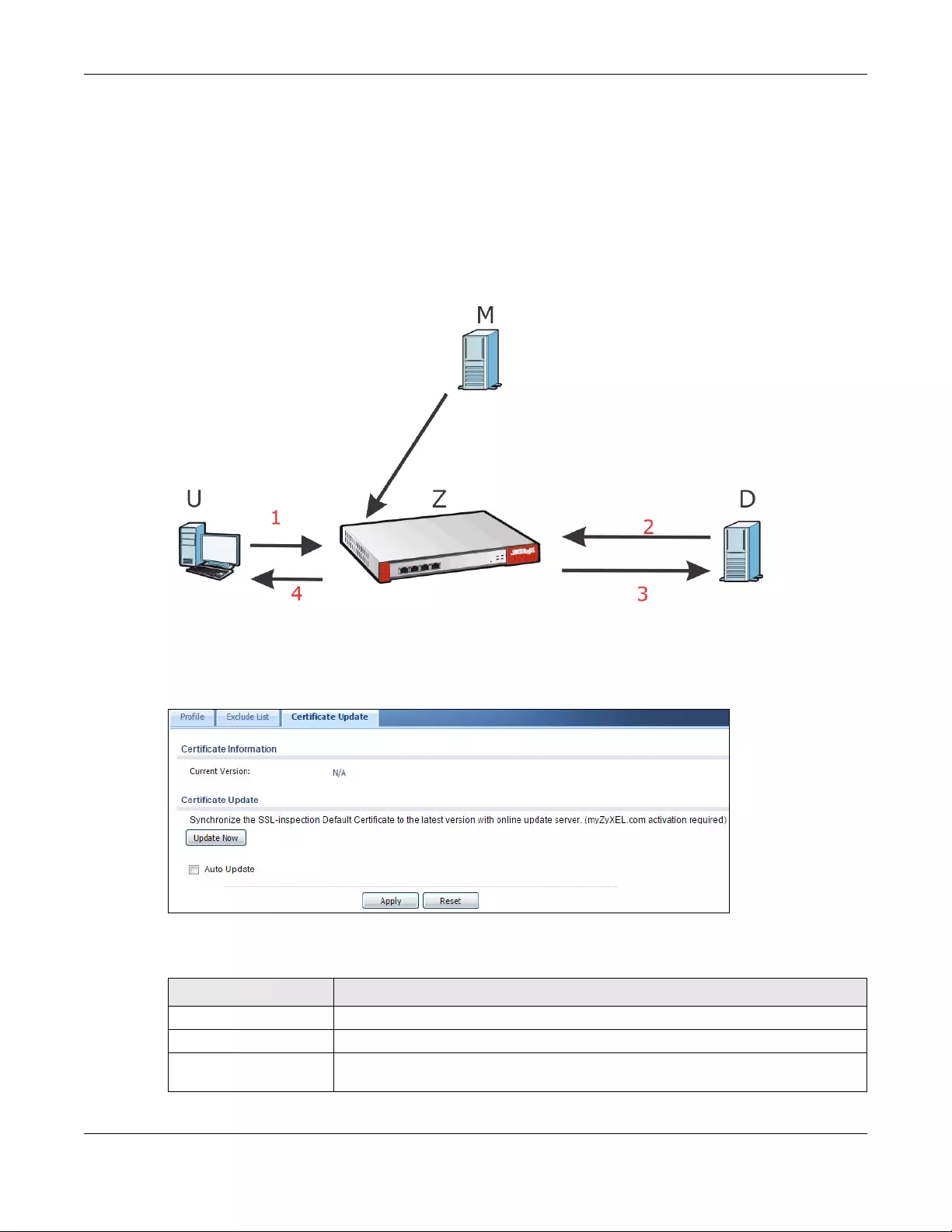
Chapter 33 SSL Inspection
ZyWALL/USG Series User’s Guide
545
33.4 Certificate Update Screen
Use this screen to update the latest certificates of servers using SSL connections to the ZyWALL/
USG network. User U sends an SSL request to destination server D (1), via the ZyWALL/USG, Z . D
replies (2); Z intercepts the response from D and checks if the certificate has been previously
signed. Z then replies to D (3) and also to U (4). D’s latest certificate is stored at myZyXEL.com
(M) along with other server certificates and can be downloaded to the ZyWALL/USG.
Figure 362 SSL Inspection Certificate Update Overview
Click Configuration > UTM Profile > SSL Inspection > Certificate Update to display the
following screen.
Figure 363 Configuration > UTM Profile > SSL Inspection > Certificate Update
The following table describes the fields in this screen.
Table 227 Configuration > UTM Profile > SSL Inspection > Certificate Update
LABEL DESCRIPTION
Certificate Information
Current Version This displays the current certificate set version.
Certificate Update You should have Internet access and have activated SSL Inspection on the
ZyWALL/USG at myZyXEL.com.

Chapter 33 SSL Inspection
ZyWALL/USG Series User’s Guide
546
33.5 Install a CA Certificate in a Browser
Certificates used in SSL Inspection profiles should be installed in user web browsers. Do the
following steps to install a certificate in a computer with a Windows operating system (PC). First,
save the certificate to your computer.
1Run the certificate manager using certmgr.msc.
2Go to Trusted Root Certification Authorities > Certificates.
3From the main menu, select Action > All Tasks > Import and run the Certificate Import
Wizard to install the certificate on the PC.
Update Now Click this button to download the latest certificate set from the myZyXEL.com and
update it on the ZyWALL/USG.
Auto Update Select this to automatically have the ZyWALL/USG update the certificate set when
a new one becomes available on myZyXEL.com.
Apply Click Apply to save your settings to the ZyWALL/USG.
Reset Click Reset to return to the profile summary page without saving any changes.
Table 227 Configuration > UTM Profile > SSL Inspection > Certificate Update (continued)
LABEL DESCRIPTION

Chapter 33 SSL Inspection
ZyWALL/USG Series User’s Guide
547
33.5.0.1 Firefox Browser
If you’re using a Firefox browser, in addition to the above you need to do the following to import a
certificate into the browser.
Click Tools > Options > Advanced > Encryption > View Certificates, click Import and enter
the filename of the certificate you want to import. See the browser's help for further information.
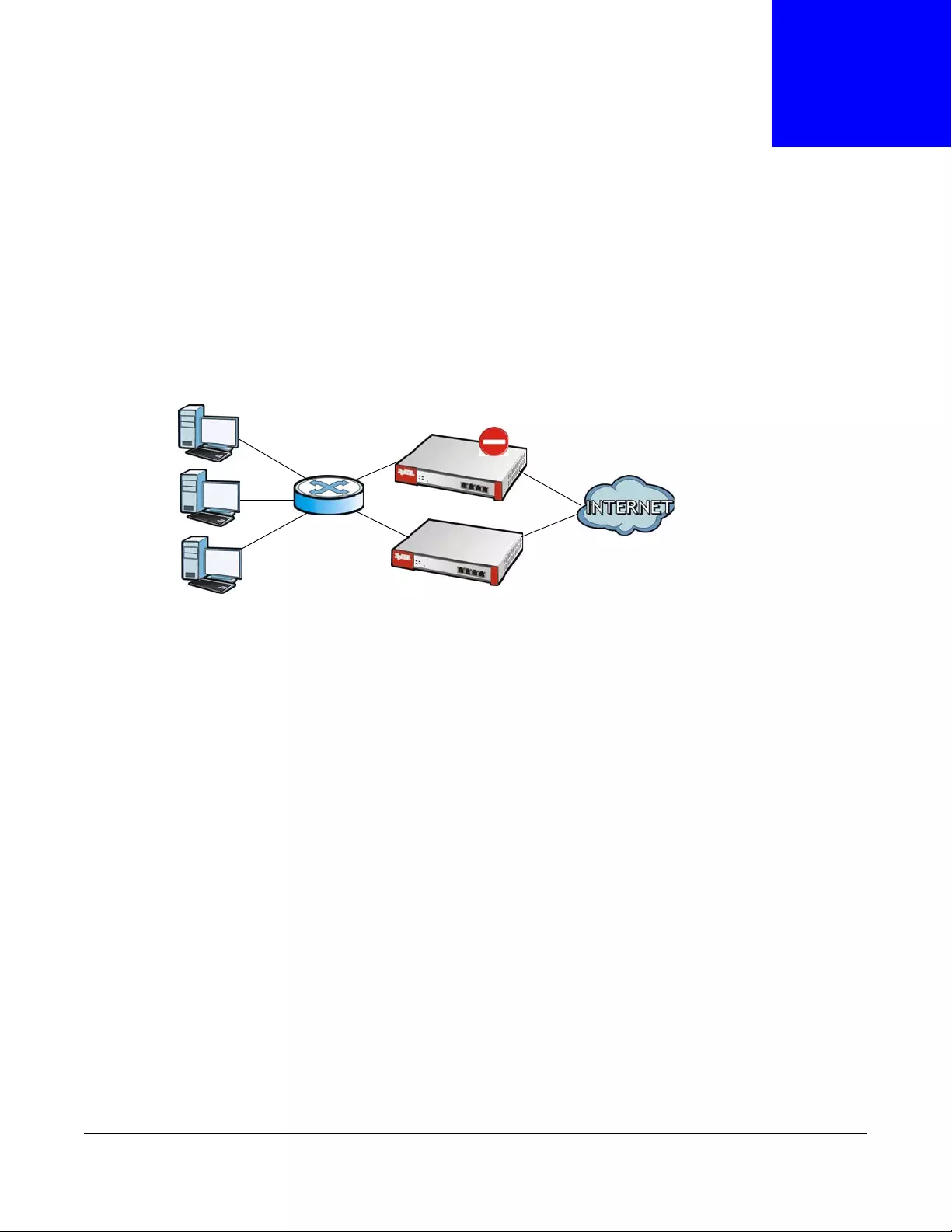
ZyWALL/USG Series User’s Guide
548
CHAPTER 34
Device HA
34.1 Overview
Device HA lets a backup ZyWALL/USG (B) automatically take over if the master ZyWALL/USG (A)
fails.
Figure 364 Device HA Backup Taking Over for the Master
34.1.1 What You Can Do in this Chapter
•Use the General screen (Section 34.2 on page 549) to configure device HA global settings, and
see the status of each interface monitored by device HA.
•Use the Active-Passive Mode screens (Section 34.3 on page 550) to use active-passive mode
device HA. You can configure general active-passive mode device HA settings, view and manage
the list of monitored interfaces, and synchronize backup ZyWALL/USGs.
34.1.2 What You Need to Know
Active-Passive Mode
• Active-passive mode lets a backup ZyWALL/USG take over if the master ZyWALL/USG fails.
• The ZyWALL/USGs must be set to use the same device HA mode (active-passive).
Management Access
You can configure a separate management IP address for each interface. You can use it to access
the ZyWALL/USG for management whether the ZyWALL/USG is the master or a backup. The
management IP address should be in the same subnet as the interface IP address.
A
B
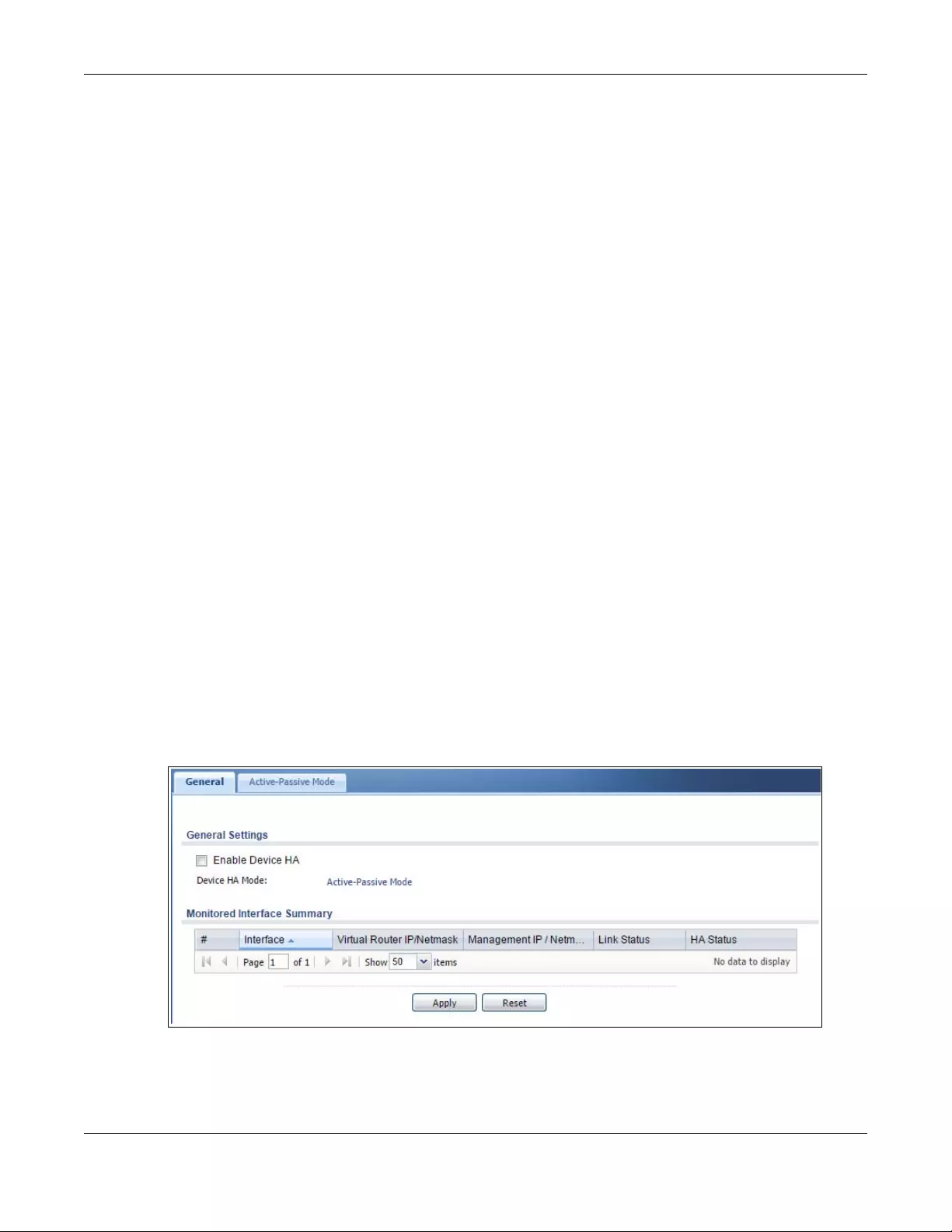
Chapter 34 Device HA
ZyWALL/USG Series User’s Guide
549
Synchronization
Use synchronization to have a backup ZyWALL/USG copy the master ZyWALL/USG’s configuration,
signatures (anti-virus, IDP/application patrol, and system protect), and certificates.
Note: Only ZyWALL/USGs of the same model and firmware version can synchronize.
Otherwise you must manually configure the master ZyWALL/USG’s settings on the backup (by
editing copies of the configuration files in a text editor for example).
Finding Out More
•See Section 34.5 on page 556 for device HA background/technical information.
34.1.3 Before You Begin
• Configure a static IP address for each interface that you will have device HA monitor.
Note: Subscribe to services on the backup ZyWALL/USG before synchronizing it with the
master ZyWALL/USG.
• Synchronization includes updates for services to which the master and backup ZyWALL/USGs are
both subscribed. For example, a backup subscribed to IDP/AppPatrol, but not anti-virus, gets
IDP/AppPatrol updates from the master, but not anti-virus updates. It is highly recommended to
subscribe the master and backup ZyWALL/USGs to the same services.
34.2 Device HA General
The Configuration > Device H A General screen lets you enable or disable device HA, and
displays which device HA mode the ZyWALL/USG is set to use along with a summary of the
monitored interfaces.
Figure 365 Configuration > Device HA > General
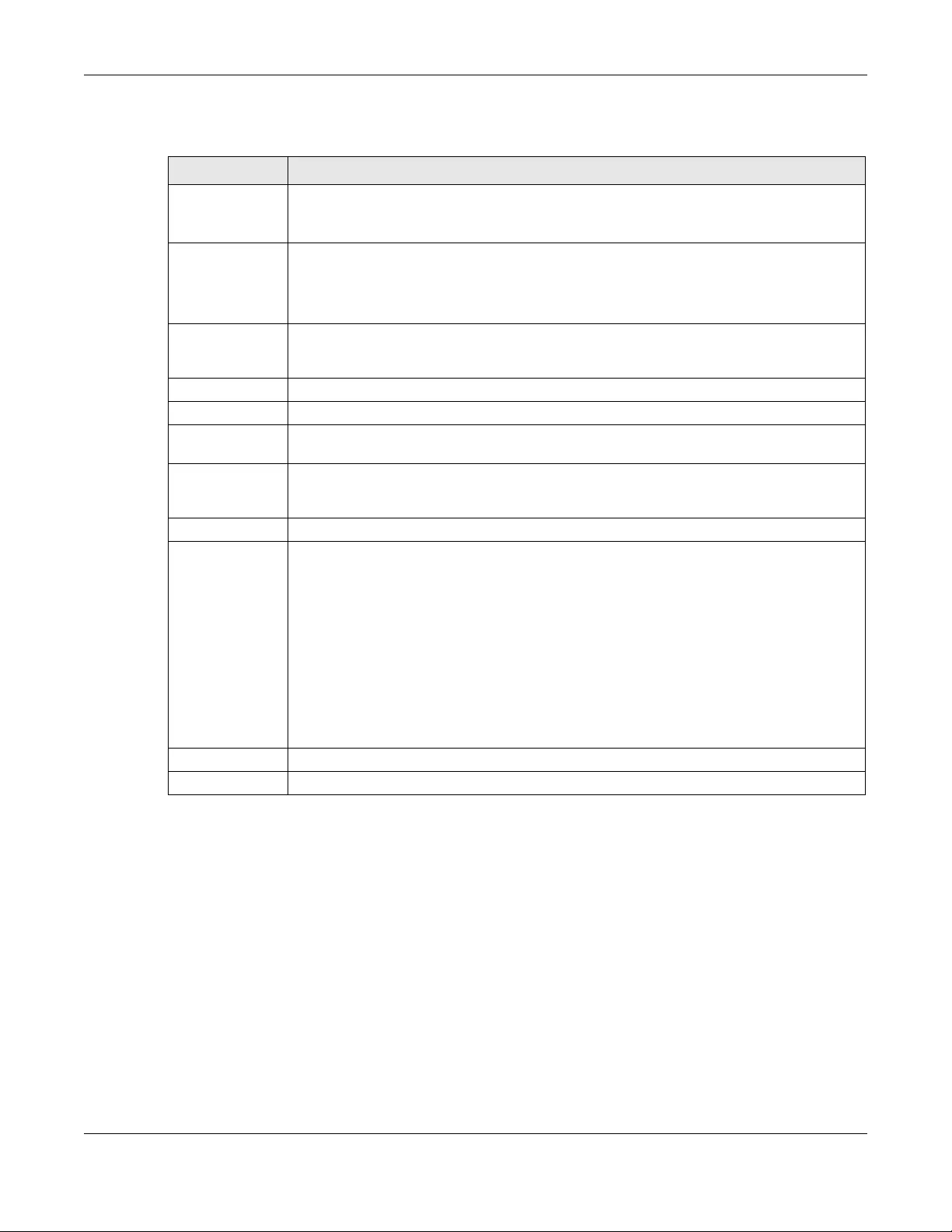
Chapter 34 Device HA
ZyWALL/USG Series User’s Guide
550
The following table describes the labels in this screen.
34.3 The Active-Passive Mode Screen
Virtual Router
The master and backup ZyWALL/USG form a single ‘virtual router’. In the following example,
master ZyWALL/USG A and backup ZyWALL/USG B form a virtual router.
Table 228 Configuration > Device HA > General
LABEL DESCRIPTION
Enable Device
HA
Turn the ZyWALL/USG’s device HA feature on or off.
Note: It is not recommended to use STP (Spanning Tree Protocol) with device HA.
Device HA Mode This displays whether the ZyWALL/USG is currently set to use active-passive mode device
HA. Active-passive mode is recommended for general device failover deployments.
Click the link to go to the screen where you can configure the ZyWALL/USG to use the
device HA mode that it is not currently using.
Monitored
Interface
Summary
This table shows the status of the interfaces that you selected for monitoring in the other
device HA screens.
#This is the entry’s index number in the list.
Interface These are the names of the interfaces that are monitored by device HA.
Virtual Router IP
/ Netmask
This is the interface’s IP address and subnet mask. Whichever ZyWALL/USG is the master
uses this virtual router IP address and subnet mask.
Management IP /
Netmask
This field displays the interface’s management IP address and subnet mask. You can use
this IP address and subnet mask to access the ZyWALL/USG whether it is in master or
backup mode.
Link Status This tells whether the monitored interface’s connection is down or up.
HA Status The text before the slash shows whether the device is configured as the master or the
backup role.
This text after the slash displays the monitored interface’s status in the virtual router.
Active - This interface is up and using the virtual IP address and subnet mask.
Stand-By - This interface is a backup interface in the virtual router. It is not using the
virtual IP address and subnet mask.
Fault - This interface is not functioning in the virtual router right now. In active-passive
mode if one of the master ZyWALL/USG’s interfaces loses its connection, the master
ZyWALL/USG forces all of its interfaces to the fault state so the backup ZyWALL/USG can
take over all of the master ZyWALL/USG’s functions.
Apply Click Apply to save your changes back to the ZyWALL/USG.
Reset Click Reset to return the screen to its last-saved settings.
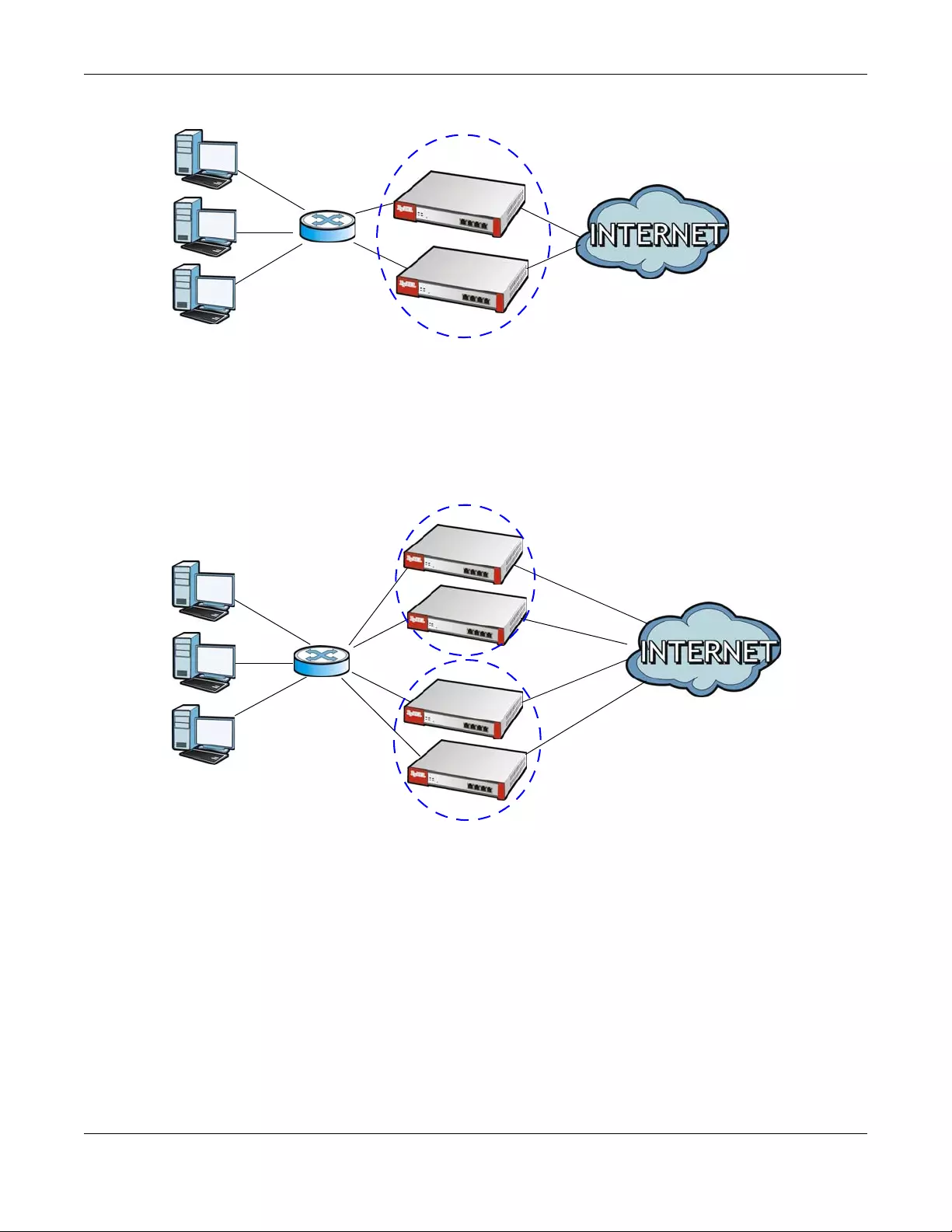
Chapter 34 Device HA
ZyWALL/USG Series User’s Guide
551
Figure 366 Virtual Router
Cluster ID
You can have multiple ZyWALL/USG virtual routers on your network. Use a different cluster ID to
identify each virtual router. In the following example, ZyWALL/USGs A and B form a virtual router
that uses cluster ID 1. ZyWALL/USGs C and D form a virtual router that uses cluster ID 2.
Figure 367 Cluster IDs for Multiple Virtual Routers
Monitored Interfaces in Active-Passive Mode Device HA
You can select which interfaces device HA monitors. If a monitored interface on the ZyWALL/USG
loses its connection, device HA has the backup ZyWALL/USG take over.
Enable monitoring for the same interfaces on the master and backup ZyWALL/USGs. Each
monitored interface must have a static IP address and be connected to the same subnet as the
corresponding interface on the backup or master ZyWALL/USG.
Virtual Router and Management IP Addresses
• If a backup takes over for the master, it uses the master’s IP addresses. These IP addresses are
know as the virtual router IP addresses.
A
B
A
B
C
D
1
2

Chapter 34 Device HA
ZyWALL/USG Series User’s Guide
552
• Each interface can also have a management IP address. You can connect to this IP address to
manage the ZyWALL/USG regardless of whether it is the master or the backup.
For example, ZyWALL/USG B takes over A’s 192.168.1.1 LAN interface IP address. This is a virtual
router IP address. ZyWALL/USG A keeps it’s LAN management IP address of 192.168.1.5 and
ZyWALL/USG B has its own LAN management IP address of 192.168.1.6. These do not change
when ZyWALL/USG B becomes the master.
Figure 368 Management IP Addresses
34.3.1 Configuring Active-Passive Mode Device HA
The Device HA Active-Passive Mode screen lets you configure general active-passive mode
device HA settings, view and manage the list of monitored interfaces, and synchronize backup
ZyWALL/USGs. To access this screen, click Configuration > Device HA > Active-Passive Mode.
A
192.168.1.1
B
192.168.1.1
192.168.1.5
192.168.1.6
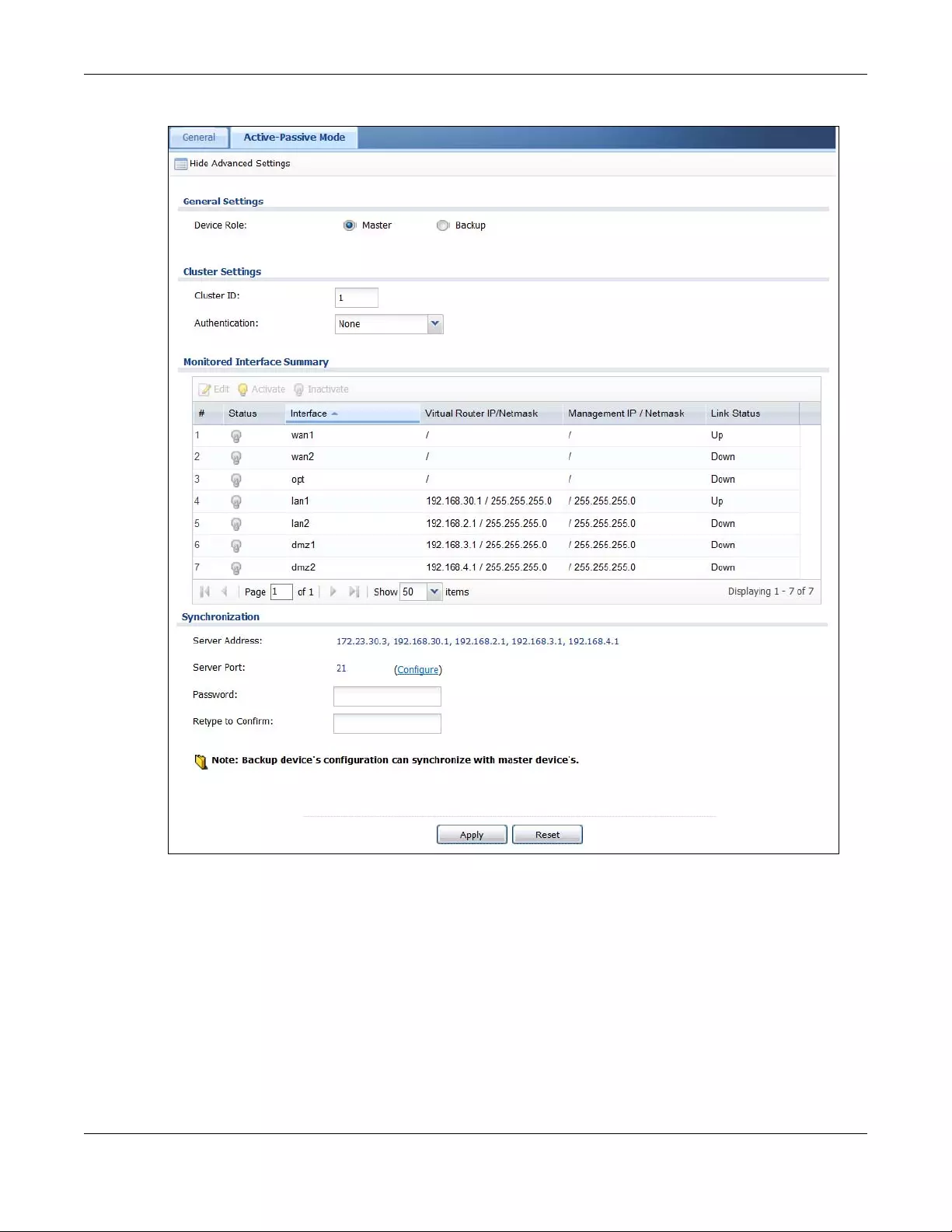
Chapter 34 Device HA
ZyWALL/USG Series User’s Guide
553
Figure 369 Configuration > Device HA > Active Passive Mode

Chapter 34 Device HA
ZyWALL/USG Series User’s Guide
554
The following table describes the labels in this screen. See Section 34.4 on page 555 for more
information as well.
Table 229 Configuration > Device HA > Active-Passive Mode
LABEL DESCRIPTION
Show Advanced
Settings / Hide
Advanced
Settings
Click this button to display a greater or lesser number of configuration fields.
Authentication Select the authentication method the virtual router uses. Every interface in a virtual
router must use the same authentication method and password. Choices are:
None - this virtual router does not use any authentication method.
Text - this virtual router uses a plain text password for authentication. Type the
password in the field next to the radio button. The password can consist of alphanumeric
characters, the underscore, and some punctuation marks (+-/*= :; .! @$&%#~ ‘ \ () ),
and it can be up to eight characters long.
IP AH (MD5) - this virtual router uses an encrypted MD5 password for authentication.
Type the password in the field next to the radio button. The password can consist of
alphanumeric characters, the underscore, and some punctuation marks (+-/*= :; .!
@$&%#~ ‘ \ () ), and it can be up to eight characters long.
Monitored
Interface
Summary
This table shows the status of the device HA settings and status of the ZyWALL/USG’s
interfaces.
Edit Select an entry and click this to be able to modify it.
Activate To turn on an entry, select it and click Activate.
Inactivate To turn off an entry, select it and click Inactivate.
#This is the entry’s index number in the list.
Status The activate (light bulb) icon is lit when the entry is active and dimmed when the entry is
inactive.
Interface This field identifies the interface. At the time of writing, Ethernet and bridge interfaces
can be included in the active-passive mode virtual router. The member interfaces of any
bridge interfaces do not display separately.
Virtual Router IP /
Netmask
This is the master ZyWALL/USG’s (static) IP address and subnet mask for this interface.
If a backup takes over for the master, it uses this IP address. These fields are blank if the
interface is a DHCP client or has no IP settings.
Management IP /
Netmask
This field displays the interface’s management IP address and subnet mask. You can use
this IP address and subnet mask to access the ZyWALL/USG whether it is in master or
backup mode.
Link Status This tells whether the monitored interface’s connection is down or up.
Synchronization Use synchronization to have a backup ZyWALL/USG copy the master ZyWALL/USG’s
configuration, certificates, AV signatures, IDP and application patrol signatures, and
system protect signatures.
Every interface’s management IP address must be in the same subnet as the interface’s
IP address (the virtual router IP address).
Server Address If this ZyWALL/USG is set to backup role, enter the IP address or Fully-Qualified Domain
Name (FQDN) of the ZyWALL/USG from which to get updated configuration. Usually, you
should enter the IP address or FQDN of a virtual router on a secure network.
If this ZyWALL/USG is set to master role, this field displays the ZyWALL/USG’s IP
addresses and/or Fully-Qualified Domain Names (FQDN) through which ZyWALL/USGs in
backup role can get updated configuration from this ZyWALL/USG.
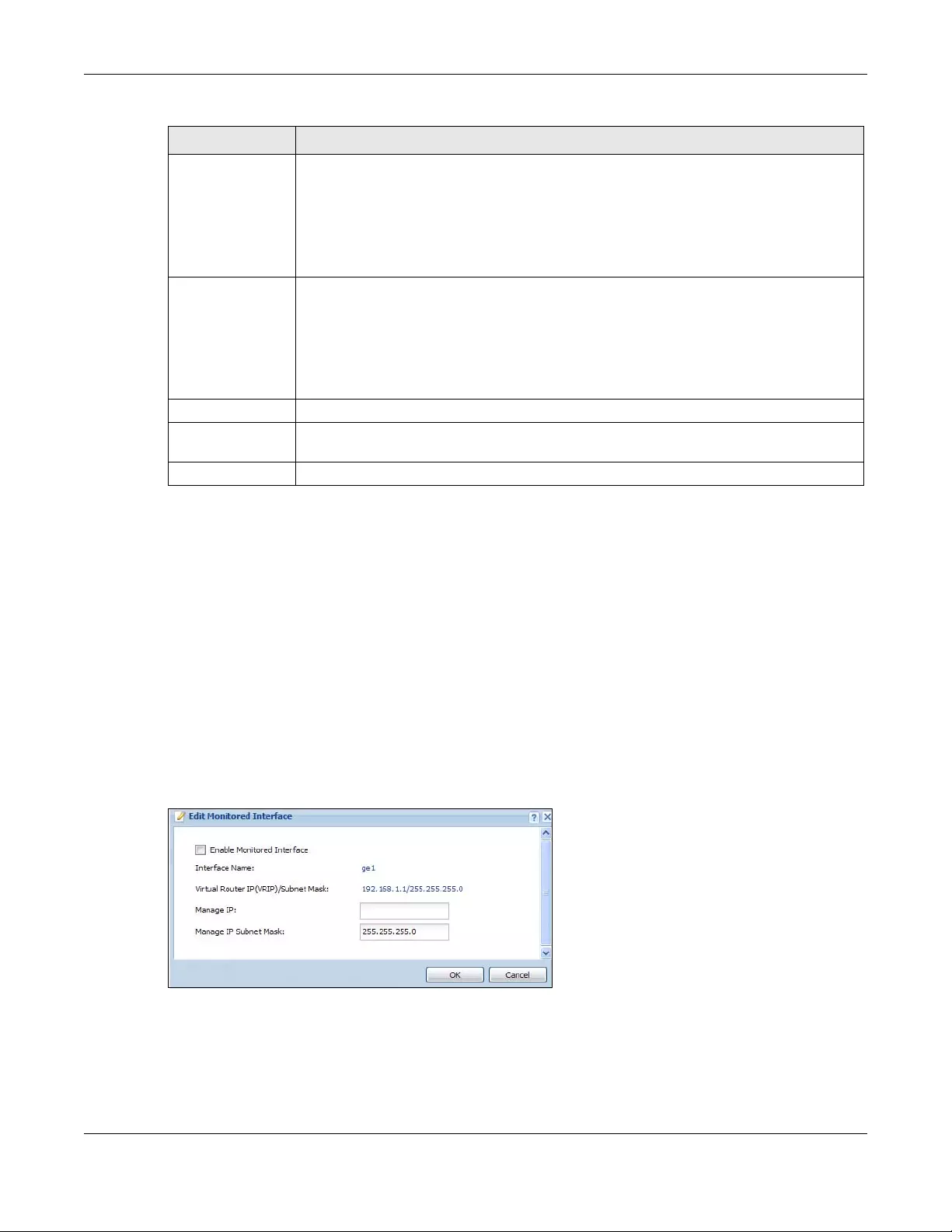
Chapter 34 Device HA
ZyWALL/USG Series User’s Guide
555
34.4 Active-Passive Mode Edit Monitored Interface
The Device HA Active-Passive Mode Monitored Interface Edit screen lets you enable or
disable monitoring of an interface and set the interface’s management IP address and subnet mask.
To access this screen, click Configuration > Device HA > Active-Passive Mode > Edit.
If you configure device HA settings for an Ethernet interface and later add the Ethernet interface to
a bridge, the ZyWALL/USG retains the interface’s device HA settings and uses them again if you
later remove the interface from the bridge. If the bridge is later deleted or the interface is removed
from it, Device HA will recover the interface’s setting.
A bridge interface’s device HA settings are not retained if you delete the bridge interface.
Figure 370 Configuration > Device HA > Active-Passive Mode > Edit
Server Port If this ZyWALL/USG is set to the backup role, enter the port number to use for Secure
FTP when synchronizing with the specified master ZyWALL/USG.
If this ZyWALL/USG is set to master role, this field displays the ZyWALL/USG’s Secure
FTP port number. Click the Configure link if you need to change the FTP port number.
Every ZyWALL/USG in the virtual router must use the same port number. If the master
ZyWALL/USG changes, you have to manually change this port number in the backups.
Password Enter the password used for verification during synchronization. Every ZyWALL/USG in
the virtual router must use the same password.
If you leave this field blank in the master ZyWALL/USG, no backup ZyWALL/USGs can
synchronize from it.
If you leave this field blank in a backup ZyWALL/USG, it cannot synchronize from the
master ZyWALL/USG.
Retype to Confirm Type the password again here to confirm it.
Apply This appears when the ZyWALL/USG is currently using active-passive mode device HA.
Click Apply to save your changes back to the ZyWALL/USG.
Reset Click Reset to return the screen to its last-saved settings.
Table 229 Configuration > Device HA > Active-Passive Mode (continued)
LABEL DESCRIPTION

Chapter 34 Device HA
ZyWALL/USG Series User’s Guide
556
Figure 371 Configuration > Device HA > Active-Passive Mode > Edit
The following table describes the labels in this screen.
34.5 Device HA Technical Reference
Active-Passive Mode Device HA with Bridge Interfaces
Here are two ways to avoid a broadcast storm when you connect the bridge interfaces on two
ZyWALL/USGs.
First Option for Connecting the Bridge Interfaces on Two ZyWALL/USGs
The first way is to activate device HA before connecting the bridge interfaces as shown in the
following example.
Table 230 Configuration > Device HA > Active-Passive Mode > Edit
LABEL DESCRIPTION
Enable
Monitored
Interface
Select this to have device HA monitor the status of this interface’s connection.
Interface Name This identifies the interface.
Note: Do not connect the bridge interfaces on two ZyWALL/USGs without device HA
activated on both. Doing so could cause a broadcast storm.
Either activate device HA before connecting the bridge interfaces or disable the bridge
interfaces, connect the bridge interfaces, activate device HA, and finally reactivate the
bridge interfaces.
Virtual Router IP
(VRIP) / Subnet
Mask
This is the interface’s (static) IP address and subnet mask in the virtual router. Whichever
ZyWALL/USG is currently serving as the master uses this virtual router IP address and
subnet mask. These fields are blank if the interface is a DHCP client or has no IP settings.
Manage IP Enter the interface’s IP address for management access. You can use this IP address to
access the ZyWALL/USG whether it is the master or a backup. This management IP
address should be in the same subnet as the interface IP address.
Manage IP
Subnet Mask
Enter the subnet mask of the interface’s management IP address.
OK Click OK to save your changes back to the ZyWALL/USG.
Cancel Click Cancel to exit this screen without saving your changes.

Chapter 34 Device HA
ZyWALL/USG Series User’s Guide
557
1Make sure the bridge interfaces of the master ZyWALL/USG (A) and the backup ZyWALL/USG (B)
are not connected.
2Configure the bridge interface on the master ZyWALL/USG, set the bridge interface as a monitored
interface, and activate device HA.
3Configure the bridge interface on the backup ZyWALL/USG, set the bridge interface as a monitored
interface, and activate device HA.
4Connect the ZyWALL/USGs.
B
A
B
A
Br0 {ge4, ge5}
B
A
Br0 {ge4, ge5}
Br0 {ge4, ge5}

Chapter 34 Device HA
ZyWALL/USG Series User’s Guide
558
Second Option for Connecting the Br idge Interfaces on Two ZyWALL/USGs
Another option is to disable the bridge interfaces, connect the bridge interfaces, activate device HA,
and finally reactivate the bridge interfaces as shown in the following example.
1In this case the ZyWALL/USGs are already connected, but the bridge faces have not been
configured yet. Configure a disabled bridge interface on the master ZyWALL/USG but disable it.
Then set the bridge interface as a monitored interface, and activate device HA.
2Configure a corresponding disabled bridge interface on the backup ZyWALL/USG. Then set the
bridge interface as a monitored interface, and activate device HA.
B
A
Br0 {ge4, ge5}
Br0 {ge4, ge5}
B
A
Br0 {ge4, ge5} Disabled
B
A
Br0 {ge4, ge5}
Br0 {ge4, ge5} Disabled
Disabled
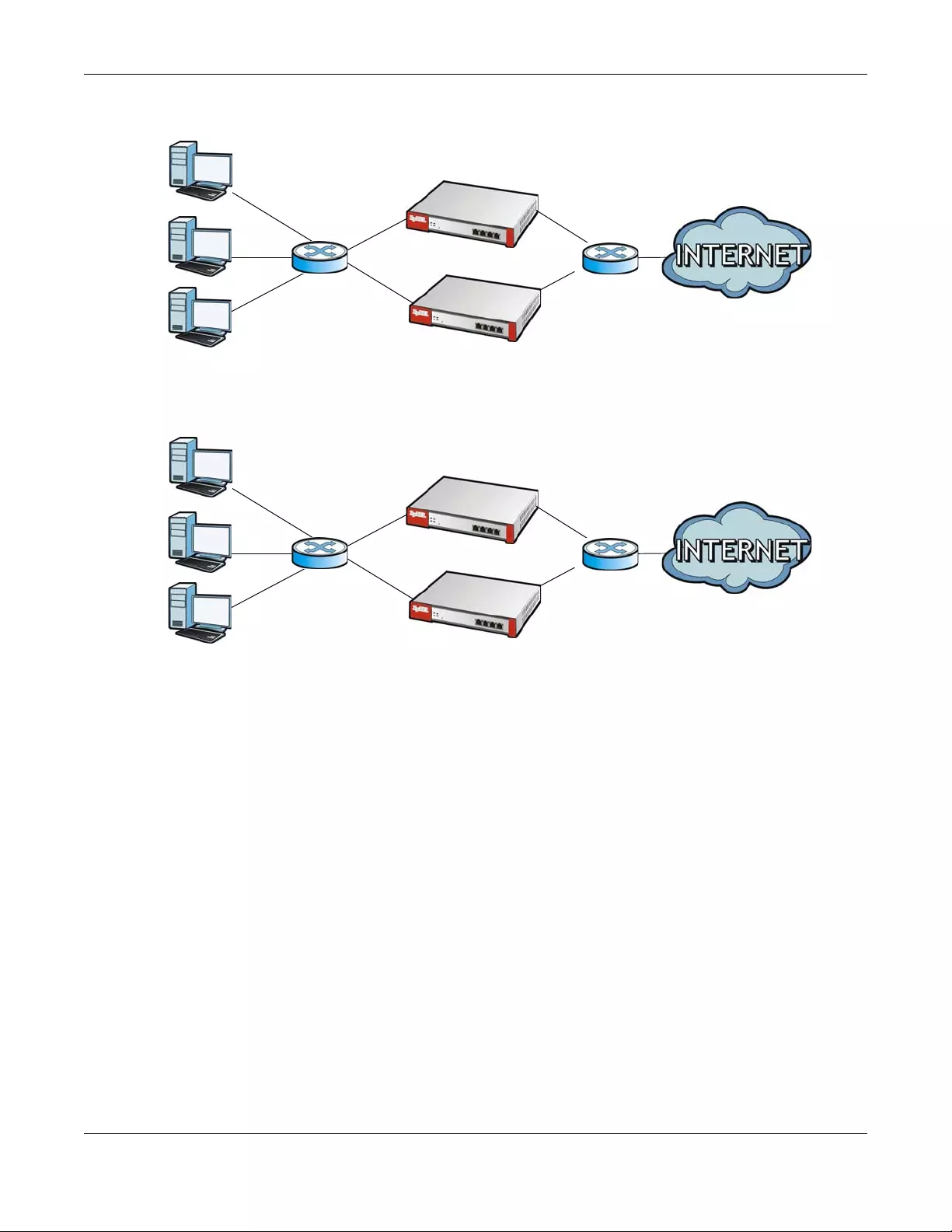
Chapter 34 Device HA
ZyWALL/USG Series User’s Guide
559
3Enable the bridge interface on the master ZyWALL/USG and then on the backup ZyWALL/USG.
4Connect the ZyWALL/USGs.
Synchronization
During synchronization, the master ZyWALL/USG sends the following information to the backup
ZyWALL/USG.
• Startup configuration file (startup-config.conf)
•AV signatures
• IDP and application patrol signatures
• System protect signatures
• Certificates (My Certificates, and Trusted Certificates)
Synchronization does not change the device HA settings in the backup ZyWALL/USG.
Synchronization affects the entire device configuration. You can only configure one set of settings
for synchronization, regardless of how many VRRP groups you might configure. The ZyWALL/USG
uses Secure FTP (on a port number you can change) to synchronize, but it is still recommended
that the backup ZyWALL/USG synchronize with a master ZyWALL/USG on a secure network.
B
A
Br0 {ge4, ge5}
Br0 {ge4, ge5}
B
A
Br0 {ge4, ge5}
Br0 {ge4, ge5}

Chapter 34 Device HA
ZyWALL/USG Series User’s Guide
560
The backup ZyWALL/USG gets the configuration from the master ZyWALL/USG. The backup
ZyWALL/USG cannot become the master or be managed while it applies the new configuration. This
usually takes two or three minutes or longer depending on the configuration complexity.
The following restrictions apply with active-passive mode.
• The master ZyWALL/USG must have no inactive monitored interfaces.
• The backup ZyWALL/USG cannot be the master. This refers to the actual role at the time of
synchronization, not the role setting in the configuration screen.
The backup applies the entire configuration if it is different from the backup’s current configuration.
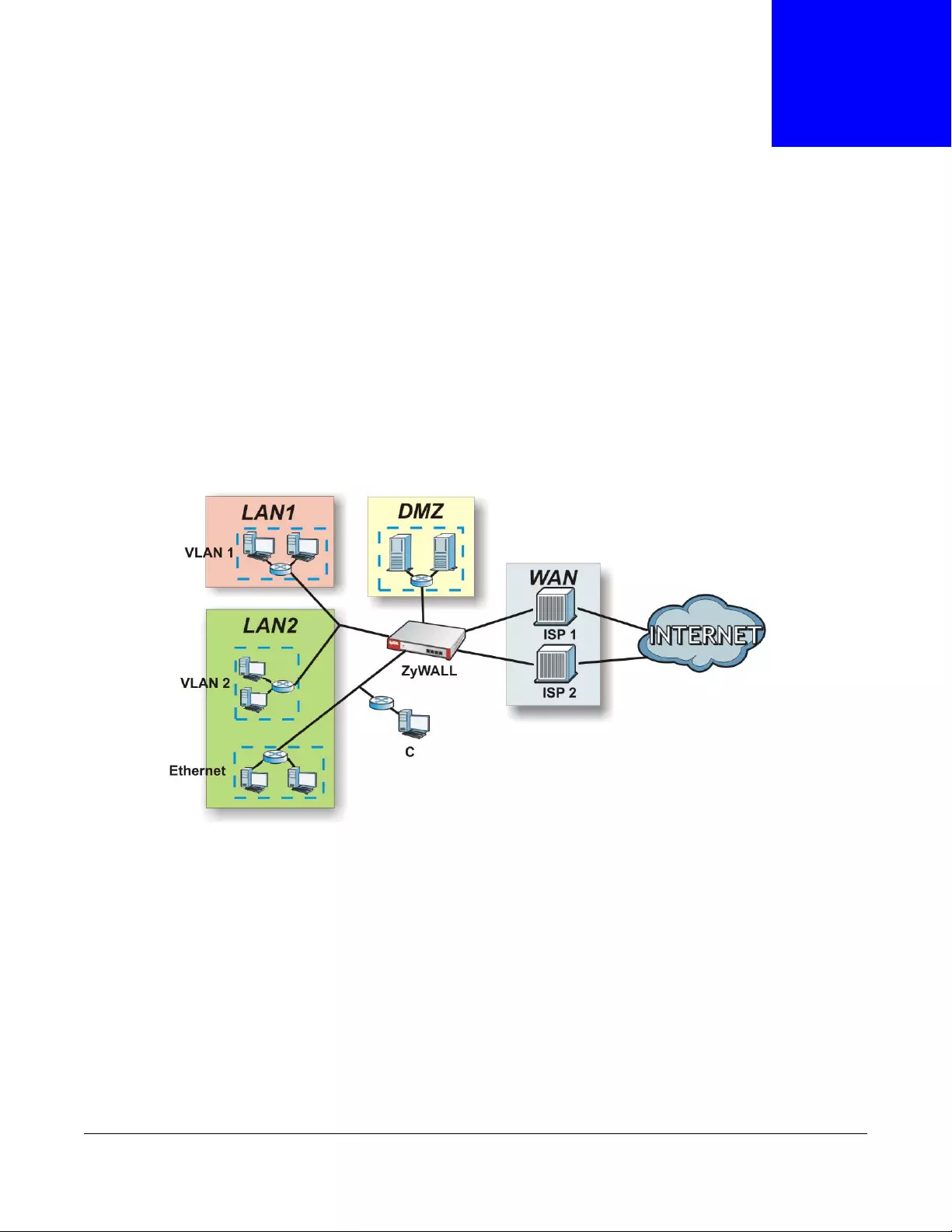
ZyWALL/USG Series User’s Guide
561
CHAPTER 35
Object
35.1 Zones Overview
Set up zones to configure network security and network policies in the ZyWALL/USG. A zone is a
group of interfaces and/or VPN tunnels. The ZyWALL/USG uses zones instead of interfaces in many
security and policy settings, such as Secure Policies rules, UTM Profile, and remote management.
Zones cannot overlap. Each Ethernet interface, VLAN interface, bridge interface, PPPoE/PPTP
interface and VPN tunnel can be assigned to at most one zone. Virtual interfaces are automatically
assigned to the same zone as the interface on which they run.
Figure 372 Example: Zones
Use the Zone screens (see Section 35.8.2 on page 614) to manage the ZyWALL/USG’s zones.
35.1.1 What You Need to Know
Zones effectively divide traffic into three types--intra-zone traffic, inter-zone traffic, and extra-zone
traffic.
Intra-zone Traffic
• Intra-zone traffic is traffic between interfaces or VPN tunnels in the same zone. For example, in
Figure 372 on page 561, traffic between VLAN 2 and the Ethernet is intra-zone traffic.
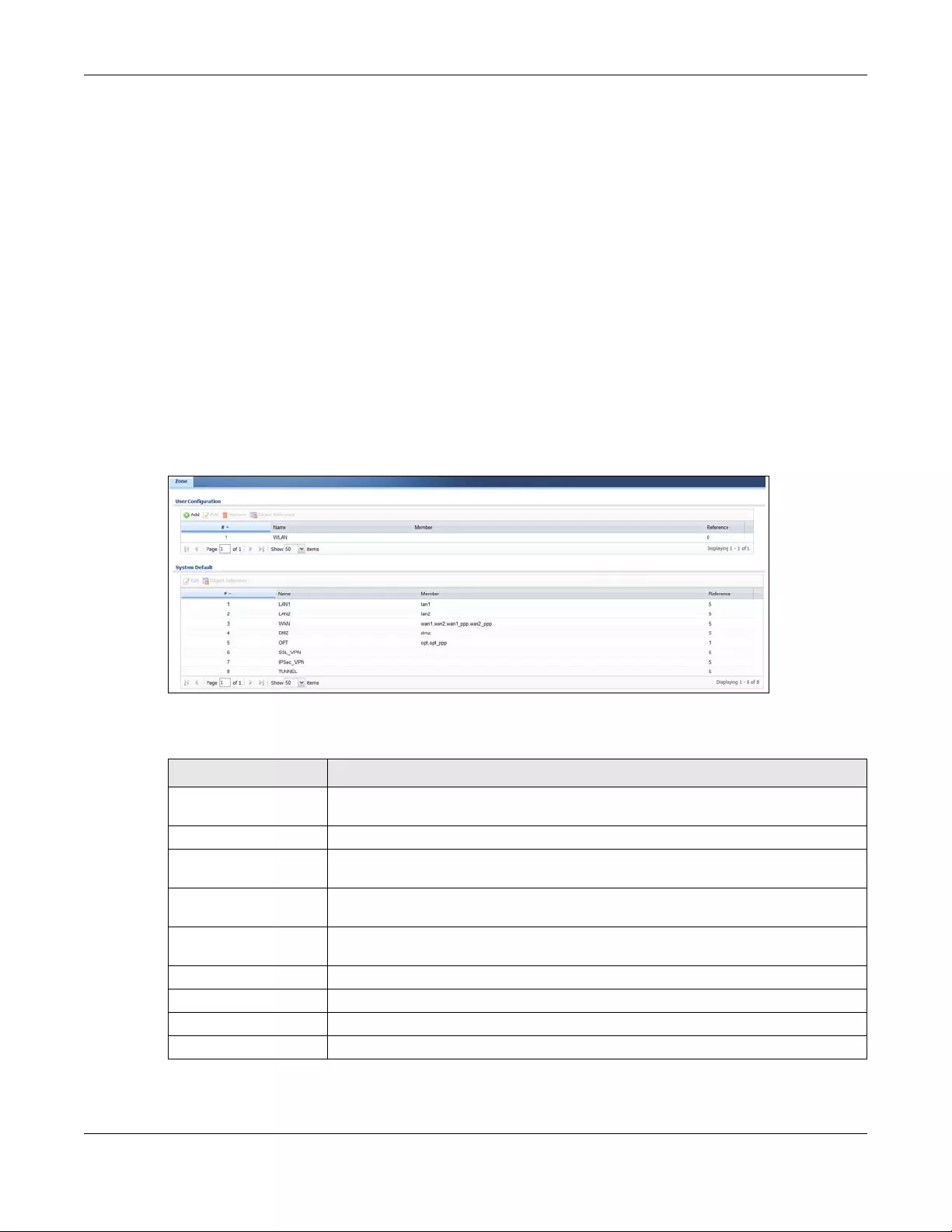
Chapter 35 Object
ZyWALL/USG Series User’s Guide
562
Inter-zone Traffic
Inter-zone traffic is traffic between interfaces or VPN tunnels in different zones. For example, in
Figure 372 on page 561, traffic between VLAN 1 and the Internet is inter-zone traffic. This is the
normal case when zone-based security and policy settings apply.
Extra-zone Traffic
• Extra-zone traffic is traffic to or from any interface or VPN tunnel that is not assigned to a zone.
For example, in Figure 372 on page 561, traffic to or from computer C is extra-zone traffic.
• Some zone-based security and policy settings may apply to extra-zone traffic, especially if you
can set the zone attribute in them to Any or All. See the specific feature for more information.
35.1.2 The Zone Screen
The Zone screen provides a summary of all zones. In addition, this screen allows you to add, edit,
and remove zones. To access this screen, click Configuration > Object > Zone.
Figure 373 Configuration > Object > Zone
The following table describes the labels in this screen.
Table 231 Configuration > Object > Zone
LABEL DESCRIPTION
User Configuration /
System Default
The ZyWALL/USG comes with pre-configured System Default zones that you
cannot delete. You can create your own User Configuration zones
Add Click this to create a new, user-configured zone.
Edit Double-click an entry or select it and click Edit to open a screen where you can
modify the entry’s settings.
Remove To remove a user-configured trunk, select it and click Remove. The ZyWALL/USG
confirms you want to remove it before doing so.
Object References Select an entry and click Object References to open a screen that shows which
settings use the entry. Click Refresh to update information in this screen.
# This field is a sequential value, and it is not associated with any interface.
Name This field displays the name of the zone.
Member This field displays the names of the interfaces that belong to each zone.
Reference This field displays the number of times an Object Reference is used in a policy.

Chapter 35 Object
ZyWALL/USG Series User’s Guide
563
35.1.2.1 Zone Edit
The Zone Edit screen allows you to add or edit a zone. To access this screen, go to the Zone
screen (see Section 35.8.2 on page 614), and click the Add icon or an Edit icon.
Figure 374 Configuration > Object > Zone > Add
The following table describes the labels in this screen.
35.2 User/Group Overview
This section describes how to set up user accounts, user groups, and user settings for the ZyWALL/
USG. You can also set up rules that control when users have to log in to the ZyWALL/USG before
the ZyWALL/USG routes traffic for them.
•The User screen (see Section 35.14.1 on page 654) provides a summary of all user accounts.
Table 232 Configuration > Object > Zone > Add/Edit
LABEL DESCRIPTION
Name For a system default zone, the name is read only.
For a user-configured zone, type the name used to refer to the zone. You may use 1-31
alphanumeric characters, underscores (_), or dashes (-), but the first character cannot
be a number. This value is case-sensitive.
Member List Available lists the interfaces and VPN tunnels that do not belong to any zone. Select
the interfaces and VPN tunnels that you want to add to the zone you are editing, and
click the right arrow button to add them.
Member lists the interfaces and VPN tunnels that belong to the zone. Select any
interfaces that you want to remove from the zone, and click the left arrow button to
remove them.
OK Click OK to save your customized settings and exit this screen.
Cancel Click Cancel to exit this screen without saving.
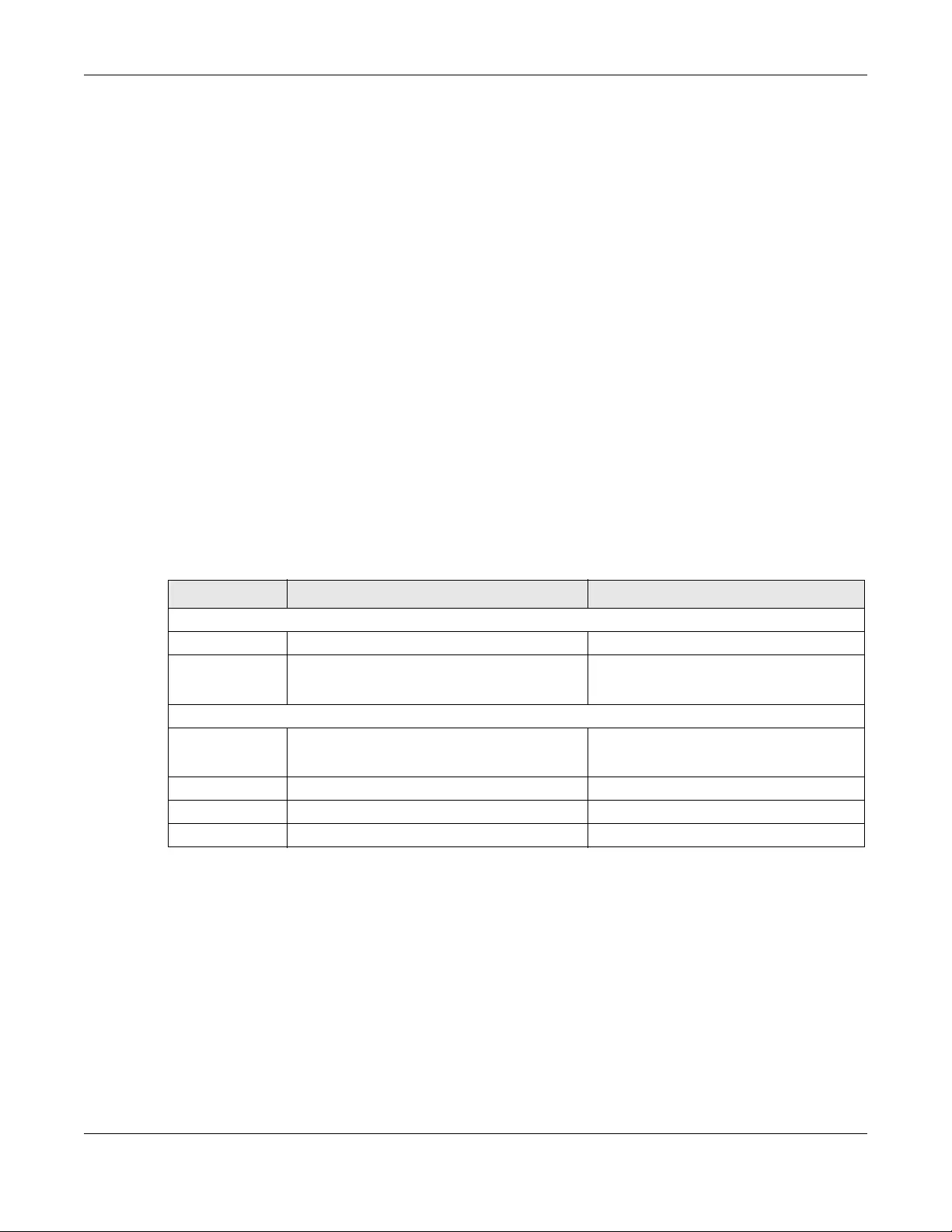
Chapter 35 Object
ZyWALL/USG Series User’s Guide
564
•The Group screen (see Section 35.2.3 on page 569) provides a summary of all user groups. In
addition, this screen allows you to add, edit, and remove user groups. User groups may consist of
access users and other user groups. You cannot put admin users in user groups
•The Setting screen (see Section 35.2.4 on page 570) controls default settings, login settings,
lockout settings, and other user settings for the ZyWALL/USG. You can also use this screen to
specify when users must log in to the ZyWALL/USG before it routes traffic for them.
•The MAC Address screen (see Section 35.2.5 on page 575) allows you to configure the MAC
addresses or OUI (Organizationally Unique Identifier) of wireless clients for MAC authentication
using the local user database. The OUI is the first three octets in a MAC address and uniquely
identifies the manufacturer of a network device.
35.2.1 What You Need To Know
User Account
A user account defines the privileges of a user logged into the ZyWALL/USG. User accounts are
used in security policies and application patrol, in addition to controlling access to configuration and
services in the ZyWALL/USG.
User Types
These are the types of user accounts the ZyWALL/USG uses.
Note: The default admin account is always authenticated locally, regardless of the
authentication method setting. (See Chapter 35 on page 627 for more information
about authentication methods.)
Ext-User Accounts
Set up an ext-user account if the user is authenticated by an external server and you want to set
up specific policies for this user in the ZyWALL/USG. If you do not want to set up policies for this
user, you do not have to set up an ext-user account.
All ext-user users should be authenticated by an external server, such as AD, LDAP or RADIUS. If
the ZyWALL/USG tries to use the local database to authenticate an ext-user, the authentication
Table 233 Types of User Accounts
TYPE ABILITIES LOGIN METHOD(S)
Admin Users
admin Change ZyWALL/USG configuration (web, CLI) WWW, TELNET, SSH, FTP, Console
limited-admin Look at ZyWALL/USG configuration (web, CLI)
Perform basic diagnostics (CLI)
WWW, TELNET, SSH, Console
Access Users
user Access network services
Browse user-mode commands (CLI)
WWW, TELNET, SSH
guest Access network services WWW
ext-user External user account WWW
ext-group-user External group user account WWW

Chapter 35 Object
ZyWALL/USG Series User’s Guide
565
attempt always fails. (This is related to AAA servers and authentication methods, which are
discussed in those chapters in this guide.)
Note: If the ZyWALL/USG tries to authenticate an ext-user using the local database, the
attempt always fails.
Once an ext-user user has been authenticated, the ZyWALL/USG tries to get the user type (see
Table 233 on page 564) from the external server. If the external server does not have the
information, the ZyWALL/USG sets the user type for this session to User.
For the rest of the user attributes, such as reauthentication time, the ZyWALL/USG checks the
following places, in order.
1User account in the remote server.
2User account (Ext-User) in the ZyWALL/USG.
3Default user account for AD users (ad-users), LDAP users (ldap-users) or RADIUS users (radius-
users) in the ZyWALL/USG.
See Setting up User Attributes in an External Server on page 577 for a list of attributes and how to
set up the attributes in an external server.
Ext-Group-User Accounts
Ext-Group-User accounts work are similar to ext-user accounts but allow you to group users by
the value of the group membership attribute configured for the AD or LDAP server. See Section
35.9.5.1 on page 622 for more on the group membership attribute.
User Groups
User groups may consist of user accounts or other user groups. Use user groups when you want to
create the same rule for several user accounts, instead of creating separate rules for each one.
Note: You cannot put access users and admin users in the same user group.
Note: You cannot put the default admin account into any user group.
The sequence of members in a user group is not important.
User Awareness
By default, users do not have to log into the ZyWALL/USG to use the network services it provides.
The ZyWALL/USG automatically routes packets for everyone. If you want to restrict network
services that certain users can use via the ZyWALL/USG, you can require them to log in to the
ZyWALL/USG first. The ZyWALL/USG is then ‘aware’ of the user who is logged in and you can create
‘user-aware policies’ that define what services they can use. See Section 35.2.6 on page 576 for a
user-aware login example.
Finding Out More
•See Section 35.2.6 on page 576 for some information on users who use an external
authentication server in order to log in.
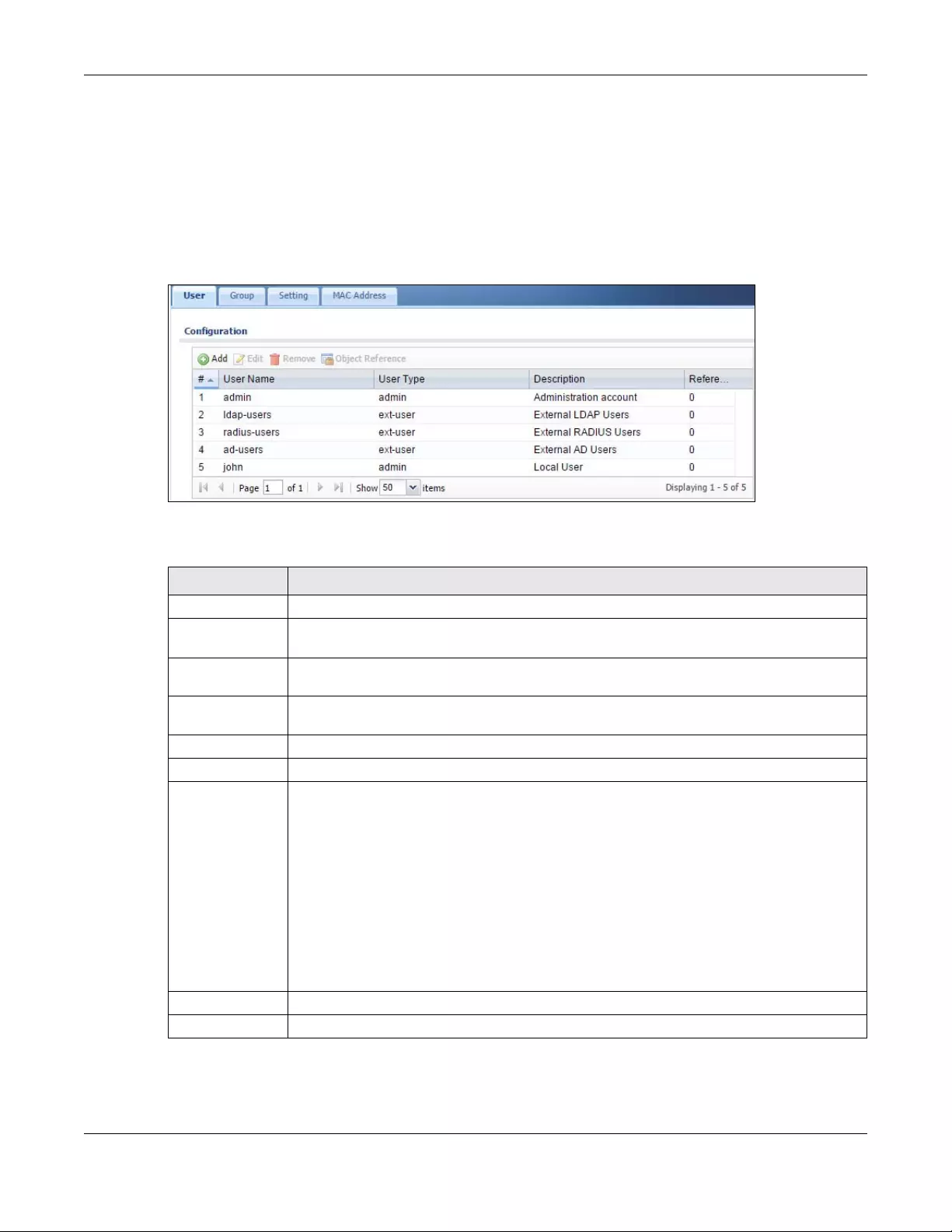
Chapter 35 Object
ZyWALL/USG Series User’s Guide
566
• The ZyWALL/USG supports TTLS using PAP so you can use the ZyWALL/USG’s local user database
to authenticate users with WPA or WPA2 instead of needing an external RADIUS server.
35.2.2 User/Group User Summary Screen
The User screen provides a summary of all user accounts. To access this screen, login to the Web
Configurator, and click Configuration > Object > User/Group.
Figure 375 Configuration > Object > User/Group > User
The following table describes the labels in this screen.
35.2.2.1 User Add/Edit Screen
The User Add/Edit screen allows you to create a new user account or edit an existing one.
Table 234 Configuration > Object > User/Group > User
LABEL DESCRIPTION
Add Click this to create a new entry.
Edit Double-click an entry or select it and click Edit to open a screen where you can modify the
entry’s settings.
Remove To remove an entry, select it and click Remove. The ZyWALL/USG confirms you want to
remove it before doing so.
Object
References
Select an entry and click Object References to open a screen that shows which settings
use the entry.
# This field is a sequential value, and it is not associated with a specific user.
User Name This field displays the user name of each user.
User Type This field displays the types of user accounts the ZyWALL/USG uses:
•admin - this user can look at and change the configuration of the ZyWALL/USG
•limited-admin - this user can look at the configuration of the ZyWALL/USG but not to
change it
•user - this user has access to the ZyWALL/USG’s services and can also browse user-
mode commands (CLI).
•guest - this user has access to the ZyWALL/USG’s services but cannot look at the
configuration
•ext-user - this user account is maintained in a remote server, such as RADIUS or
LDAP. See Ext-User Accounts on page 564 for more information about this type.
•ext-group-user - this user account is maintained in a remote server, such as RADIUS
or LDAP. See Ext-Group-User Accounts on page 565 for more information about this
type.
Description This field displays the description for each user.
Reference This displays the number of times an object reference is used in a profile.
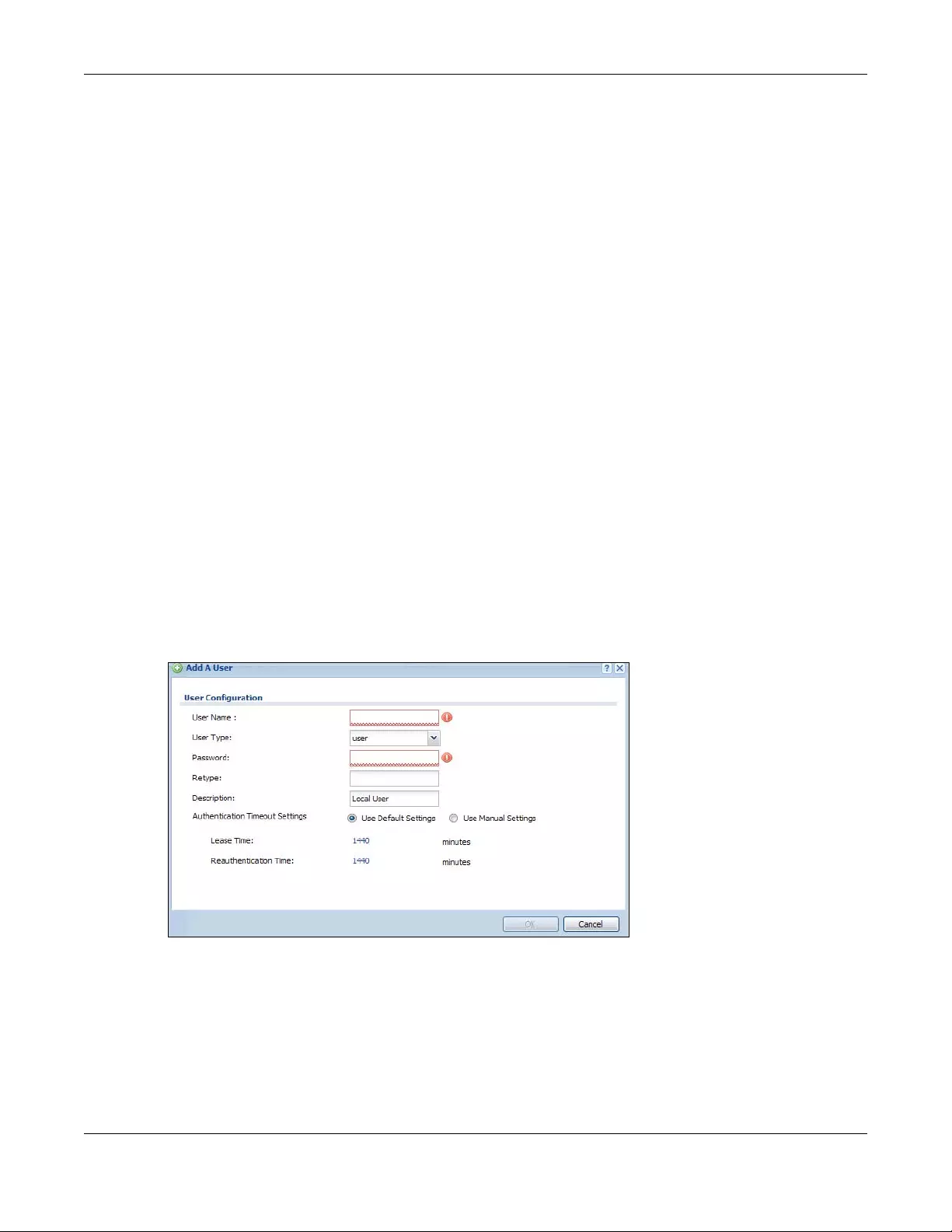
Chapter 35 Object
ZyWALL/USG Series User’s Guide
567
35.2.2.2 Rules for User Names
Enter a user name from 1 to 31 characters.
The user name can only contain the following characters:
• Alphanumeric A-z 0-9 (there is no unicode support)
• _ [underscores]
•- [dashes]
The first character must be alphabetical (A-Z a-z), an underscore (_), or a dash (-). Other
limitations on user names are:
• User names are case-sensitive. If you enter a user 'bob' but use 'BOB' when connecting via CIFS
or FTP, it will use the account settings used for 'BOB' not ‘bob’.
• User names have to be different than user group names.
• Here are the reserved user names:
To access this screen, go to the User screen (see Section 35.14.1 on page 654), and click either the
Add icon or an Edit icon.
Figure 376 Configuration > Object > User/Group > User > Add
•adm •admin •any •bin •daemon
•debug •devicehaecived•ftp •games •halt
•ldap-users •lp •mail •news •nobody
•operator •radius-users •root •shutdown •sshd
•sync •uucp •zyxel
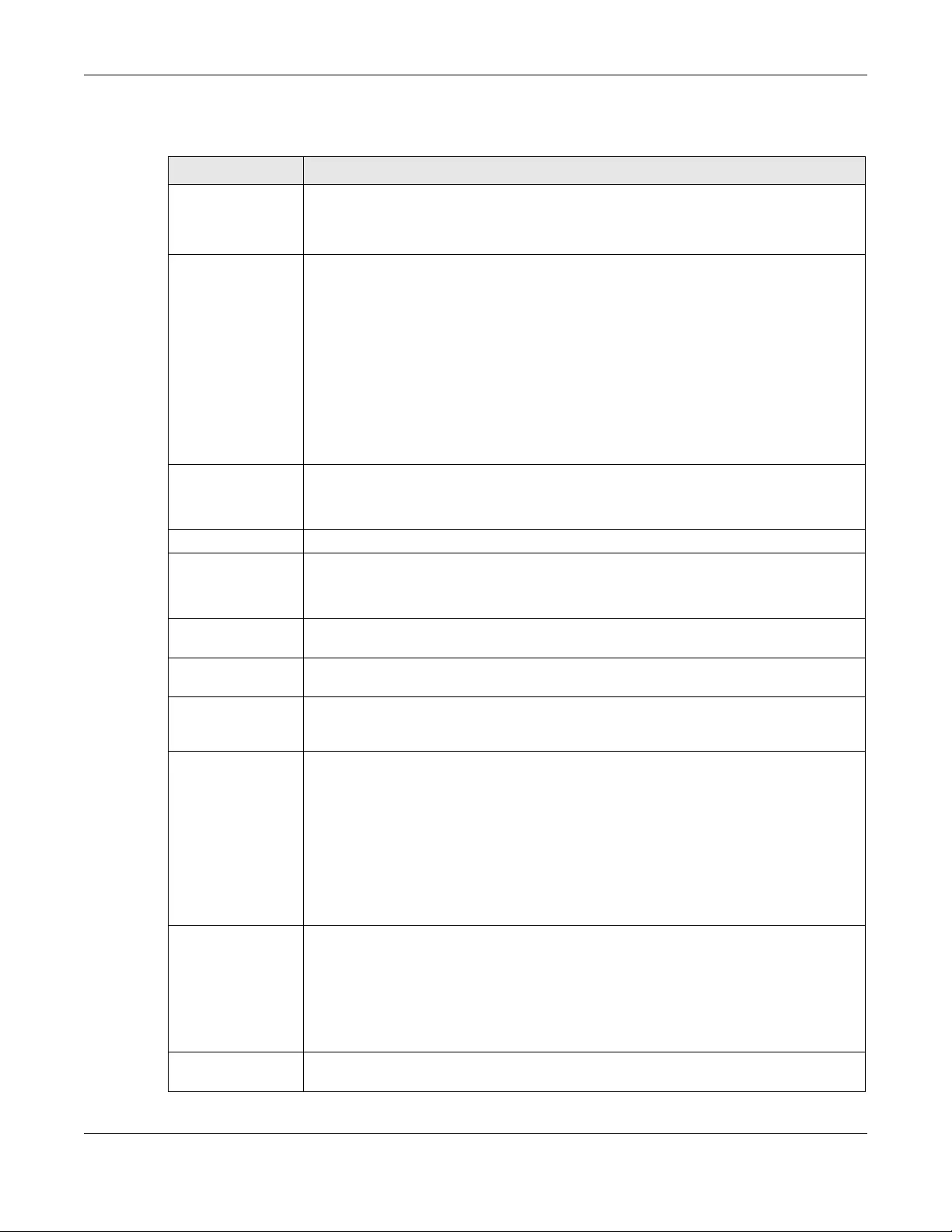
Chapter 35 Object
ZyWALL/USG Series User’s Guide
568
The following table describes the labels in this screen.
Table 235 Configuration > Object > User/Group > User > Add
LABEL DESCRIPTION
User Name Type the user name for this user account. You may use 1-31 alphanumeric characters,
underscores(_), or dashes (-), but the first character cannot be a number. This value is
case-sensitive. User names have to be different than user group names, and some
words are reserved. See Section 35.2.2.2 on page 567.
User Type This field displays the types of user accounts the ZyWALL/USG uses:
•admin - this user can look at and change the configuration of the ZyWALL/USG
•limited-admin - this user can look at the configuration of the ZyWALL/USG but not
to change it
•user - this user has access to the ZyWALL/USG’s services and can also browse user-
mode commands (CLI).
•guest - this user has access to the ZyWALL/USG’s services but cannot look at the
configuration.
•ext-user - this user account is maintained in a remote server, such as RADIUS or
LDAP. See Ext-User Accounts on page 564 for more information about this type.
•ext-group-user - this user account is maintained in a remote server, such as
RADIUS or LDAP. See Ext-Group-User Accounts on page 565 for more information
about this type.
Password This field is not available if you select the ext-user or ext-group-user type.
Enter the password of this user account. It can consist of 4 - 31 alphanumeric
characters.
Retype This field is not available if you select the ext-user or ext-group-user type.
Group Identifier This field is available for a ext-group-user type user account.
Specify the value of the AD or LDAP server’s Group Membership Attribute that
identifies the group to which this user belongs.
Associated AAA
Server Object
This field is available for a ext-group-user type user account. Select the AAA server to
use to authenticate this account’s users.
Description Enter the description of each user, if any. You can use up to 60 printable ASCII
characters. Default descriptions are provided.
Authentication
Timeout Settings
If you want the system to use default settings, select Use Default Settings. If you
want to set authentication timeout to a value other than the default settings, select Use
Manual Settings then fill your preferred values in the fields that follow.
Lease Time If you select Use Default Settings in the Au thentication Timeout Settings field, the
default lease time is shown.
If you select Use Manual Settings, you need to enter the number of minutes this user
has to renew the current session before the user is logged out. You can specify 1 to
1440 minutes. You can enter 0 to make the number of minutes unlimited. Admin users
renew the session every time the main screen refreshes in the Web Configurator. Access
users can renew the session by clicking the Renew button on their screen. If you allow
access users to renew time automatically (see Section 35.2.4 on page 570), the users
can select this check box on their screen as well. In this case, the session is
automatically renewed before the lease time expires.
Reauthentication
Time
If you select Use Defaul t Settings in the Authentication Timeout Sett ings field, the
default lease time is shown.
If you select Use Manual Settings, you need to type the number of minutes this user
can be logged into the ZyWALL/USG in one session before the user has to log in again.
You can specify 1 to 1440 minutes. You can enter 0 to make the number of minutes
unlimited. Unlike Lease Time, the user has no opportunity to renew the session
without logging out.
Configuration
Validation
Use a user account from the group specified above to test if the configuration is correct.
Enter the account’s user name in the User Name field and click Test.
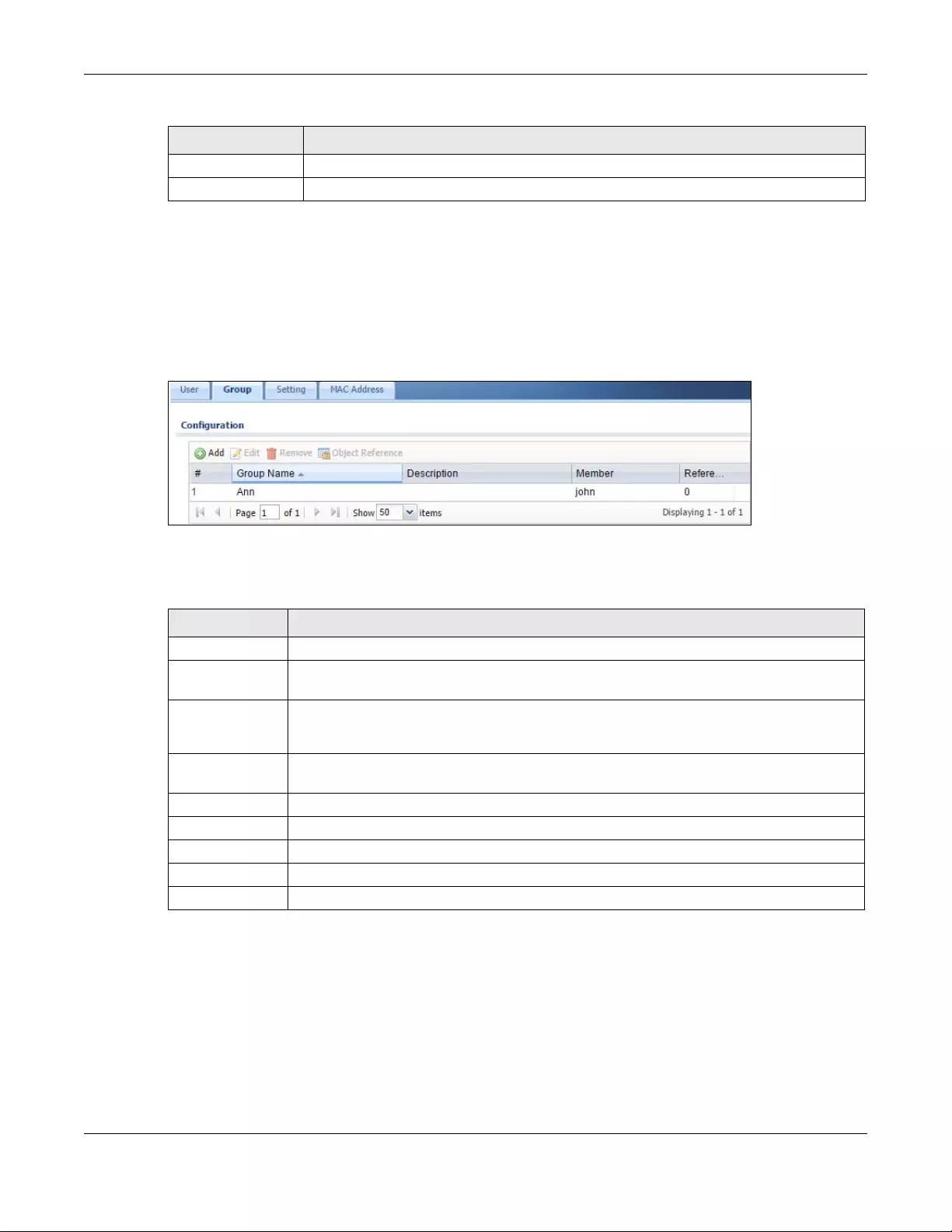
Chapter 35 Object
ZyWALL/USG Series User’s Guide
569
35.2.3 User/Group Group Summary Screen
User groups consist of access users and other user groups. You cannot put admin users in user
groups. The Group screen provides a summary of all user groups. In addition, this screen allows
you to add, edit, and remove user groups. To access this screen, login to the Web Configurator, and
click Configuration > Object > User/Group > Group.
Figure 377 Configuration > Object > User/Group > Group
The following table describes the labels in this screen. See Section 35.2.3.1 on page 569 for more
information as well.
35.2.3.1 Group Add/Edit Screen
The Group Add/Edit screen allows you to create a new user group or edit an existing one. To
access this screen, go to the Group screen (see Section 35.2.3 on page 569), and click either the
Add icon or an Edit icon.
OK Click OK to save your changes back to the ZyWALL/USG.
Cancel Click Cancel to exit this screen without saving your changes.
Table 235 Configuration > Object > User/Group > User > Add (continued)
LABEL DESCRIPTION
Table 236 Configuration > Object > User/Group > Group
LABEL DESCRIPTION
Add Click this to create a new entry.
Edit Double-click an entry or select it and click Edit to open a screen where you can modify the
entry’s settings.
Remove To remove an entry, select it and click Remove. The ZyWALL/USG confirms you want to
remove it before doing so. Removing a group does not remove the user accounts in the
group.
Object
References
Select an entry and click Object References to open a screen that shows which settings
use the entry.
# This field is a sequential value, and it is not associated with a specific user group.
Group Name This field displays the name of each user group.
Description This field displays the description for each user group.
Member This field lists the members in the user group. Each member is separated by a comma.
Reference This displays the number of times an object reference is used in a profile.
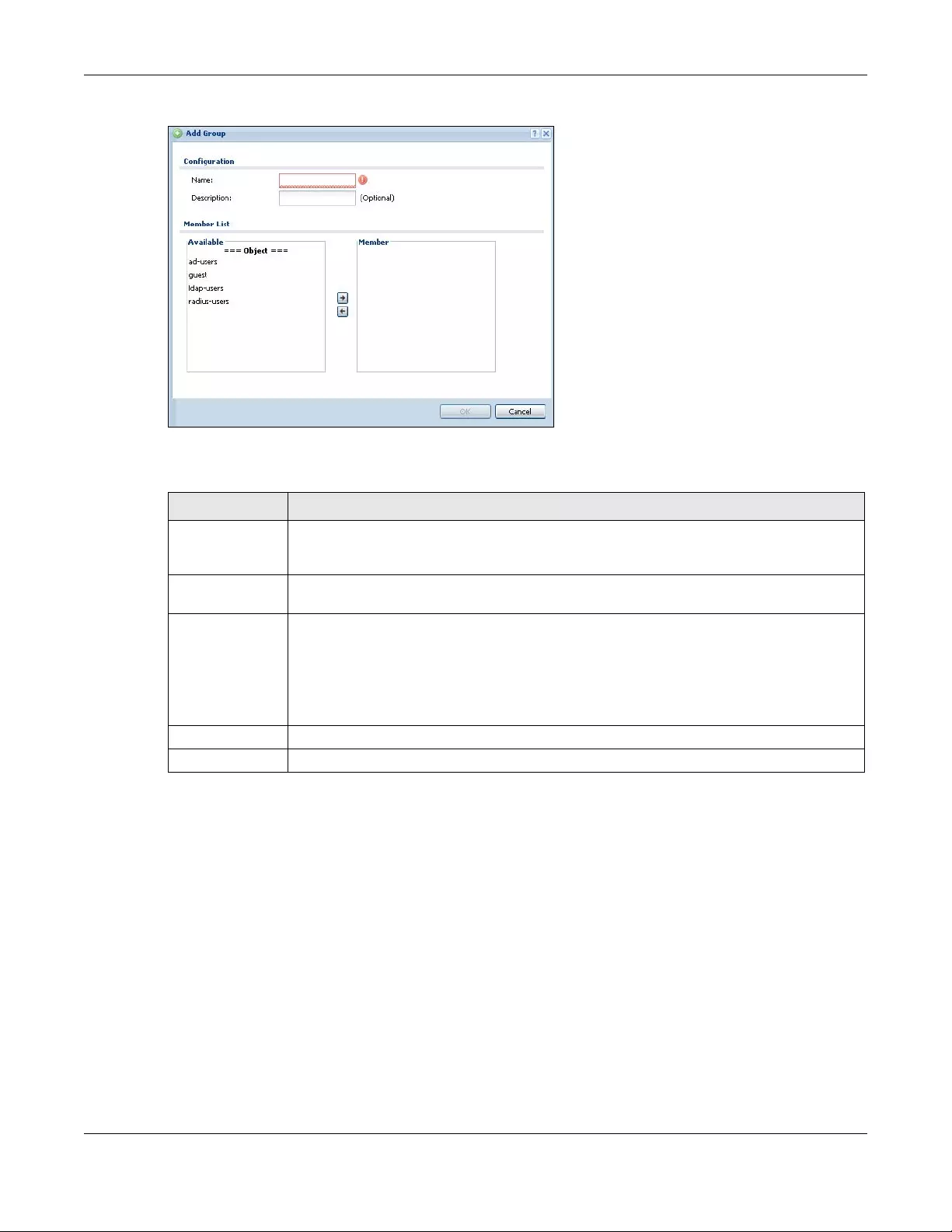
Chapter 35 Object
ZyWALL/USG Series User’s Guide
570
Figure 378 Configuration > Object > User/Group > Group > Add
The following table describes the labels in this screen.
35.2.4 User/Group Setting Screen
The Setting screen controls default settings, login settings, lockout settings, and other user
settings for the ZyWALL/USG. You can also use this screen to specify when users must log in to the
ZyWALL/USG before it routes traffic for them.
To access this screen, login to the Web Configurator, and click Configuration > Object > User/
Group > Setting.
Table 237 Configuration > Object > User/Group > Group > Add
LABEL DESCRIPTION
Name Type the name for this user group. You may use 1-31 alphanumeric characters,
underscores(_), or dashes (-), but the first character cannot be a number. This value is
case-sensitive. User group names have to be different than user names.
Description Enter the description of the user group, if any. You can use up to 60 characters,
punctuation marks, and spaces.
Member List The Member list displays the names of the users and user groups that have been added
to the user group. The order of members is not important. Select users and groups from
the Available list that you want to be members of this group and move them to the
Member list. You can double-click a single entry to move it or use the [Shift] or [Ctrl] key
to select multiple entries and use the arrow button to move them.
Move any members you do not want included to the Available list.
OK Click OK to save your changes back to the ZyWALL/USG.
Cancel Click Cancel to exit this screen without saving your changes.
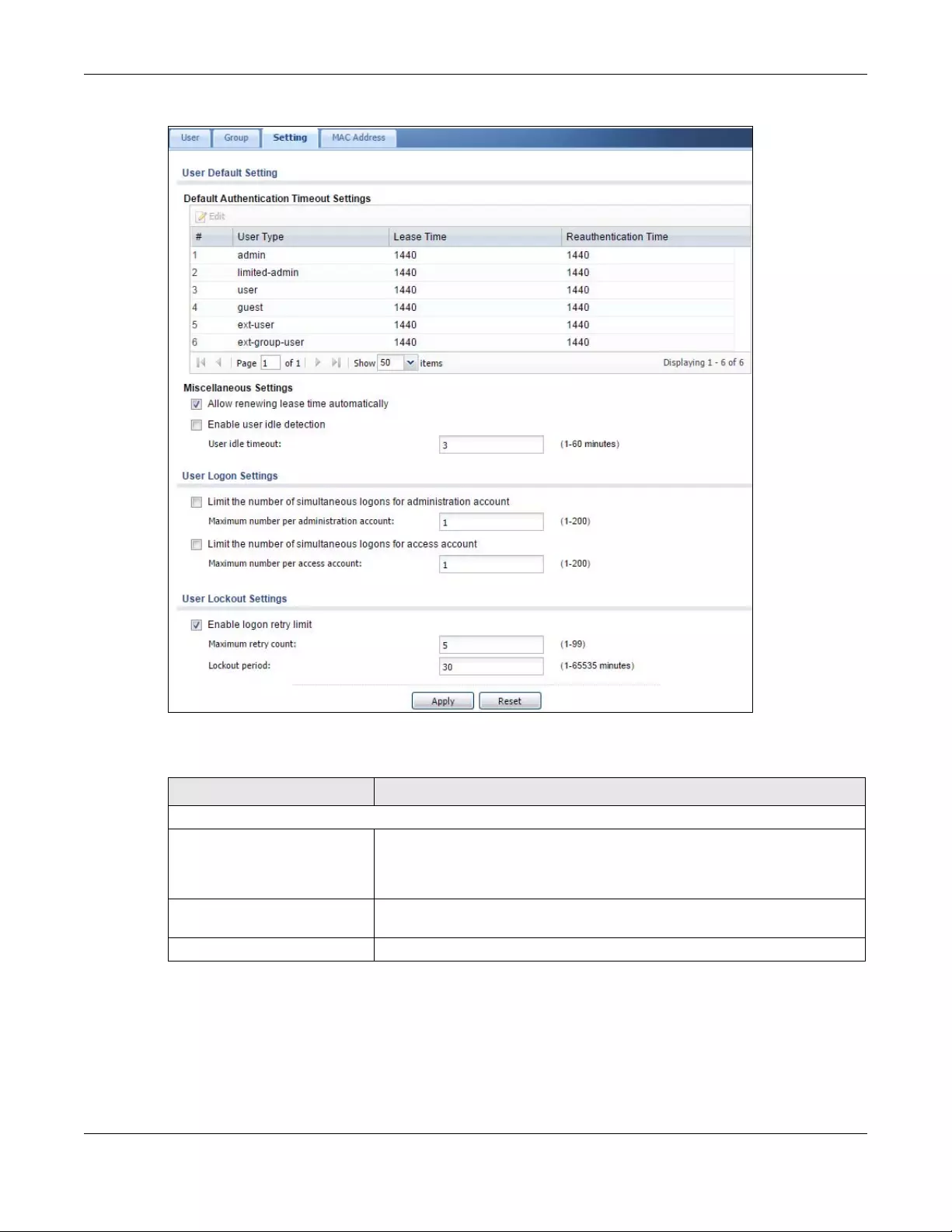
Chapter 35 Object
ZyWALL/USG Series User’s Guide
571
Figure 379 Configuration > Object > User/Group > Setting
The following table describes the labels in this screen.
Table 238 Configuration > Object > User/Group > Setting
LABEL DESCRIPTION
User Authentication Timeout Settings
Default Authentication
Timeout Settings
These authentication timeout settings are used by default when you create a
new user account. They also control the settings for any existing user
accounts that are set to use the default settings. You can still manually
configure any user account’s authentication timeout settings.
Edit Double-click an entry or select it and click Edit to open a screen where you
can modify the entry’s settings.
# This field is a sequential value, and it is not associated with a specific entry.
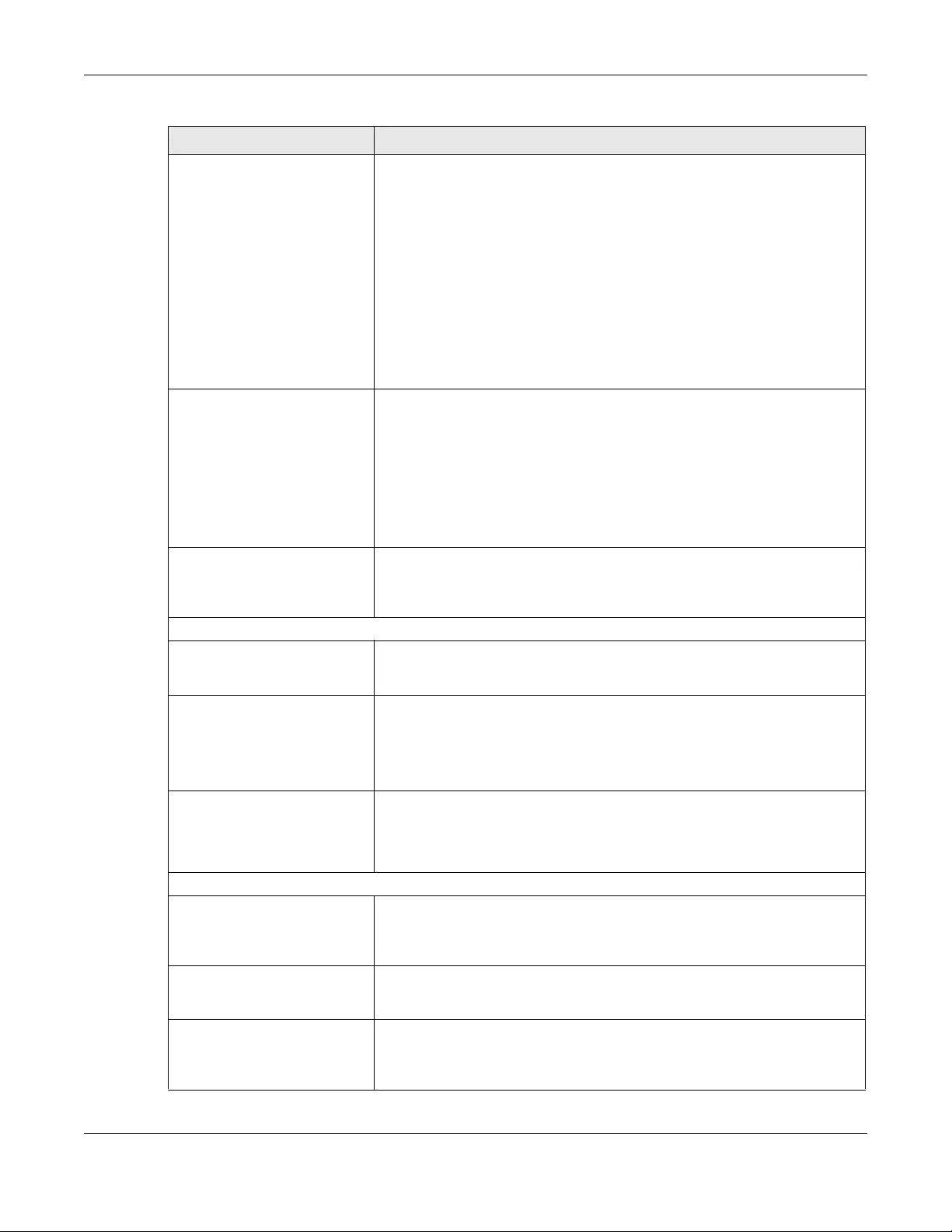
Chapter 35 Object
ZyWALL/USG Series User’s Guide
572
User Type These are the kinds of user account the ZyWALL/USG supports.
•admin - this user can look at and change the configuration of the
ZyWALL/USG
•limited-admin - this user can look at the configuration of the ZyWALL/
USG but not to change it
•user - this user has access to the ZyWALL/USG’s services but cannot
look at the configuration
•guest - this user has access to the ZyWALL/USG’s services but cannot
look at the configuration
•ext-user - this user account is maintained in a remote server, such as
RADIUS or LDAP. See Ext-User Accounts on page 564 for more
information about this type.
•ext-group-user - this user account is maintained in a remote server,
such as RADIUS or LDAP. See Ext-Group-User Accounts on page 565 for
more information about this type.
Lease Time This is the default lease time in minutes for each type of user account. It
defines the number of minutes the user has to renew the current session
before the user is logged out.
Admin users renew the session every time the main screen refreshes in the
Web Configurator. Access users can renew the session by clicking the
Renew button on their screen. If you allow access users to renew time
automatically (see Section 35.2.4 on page 570), the users can select this
check box on their screen as well. In this case, the session is automatically
renewed before the lease time expires.
Reauthentication Time This is the default reauthentication time in minutes for each type of user
account. It defines the number of minutes the user can be logged into the
ZyWALL/USG in one session before having to log in again. Unlike Lease
Time, the user has no opportunity to renew the session without logging out.
Miscellaneous Settings
Allow renewing lease time
automatically Select this check box if access users can renew lease time automatically, as
well as manually, simply by selecting the Updating lease time
automatically check box on their screen.
Enable user idle detection This is applicable for access users.
Select this check box if you want the ZyWALL/USG to monitor how long each
access user is logged in and idle (in other words, there is no traffic for this
access user). The ZyWALL/USG automatically logs out the access user once
the User idle timeout has been reached.
User idle timeout This is applicable for access users.
This field is effective when Enable user idle detection is checked. Type the
number of minutes each access user can be logged in and idle before the
ZyWALL/USG automatically logs out the access user.
User Logon Settings
Limit the number of
simultaneous logons for
administration account
Select this check box if you want to set a limit on the number of
simultaneous logins by admin users. If you do not select this, admin users
can login as many times as they want at the same time using the same or
different IP addresses.
Maximum number per
administration account This field is effective when Limit ... for administration account is
checked. Type the maximum number of simultaneous logins by each admin
user.
Limit the number of
simultaneous logons for
access account
Select this check box if you want to set a limit on the number of
simultaneous logins by non-admin users. If you do not select this, access
users can login as many times as they want as long as they use different IP
addresses.
Table 238 Configuration > Object > User/Group > Setting (continued)
LABEL DESCRIPTION
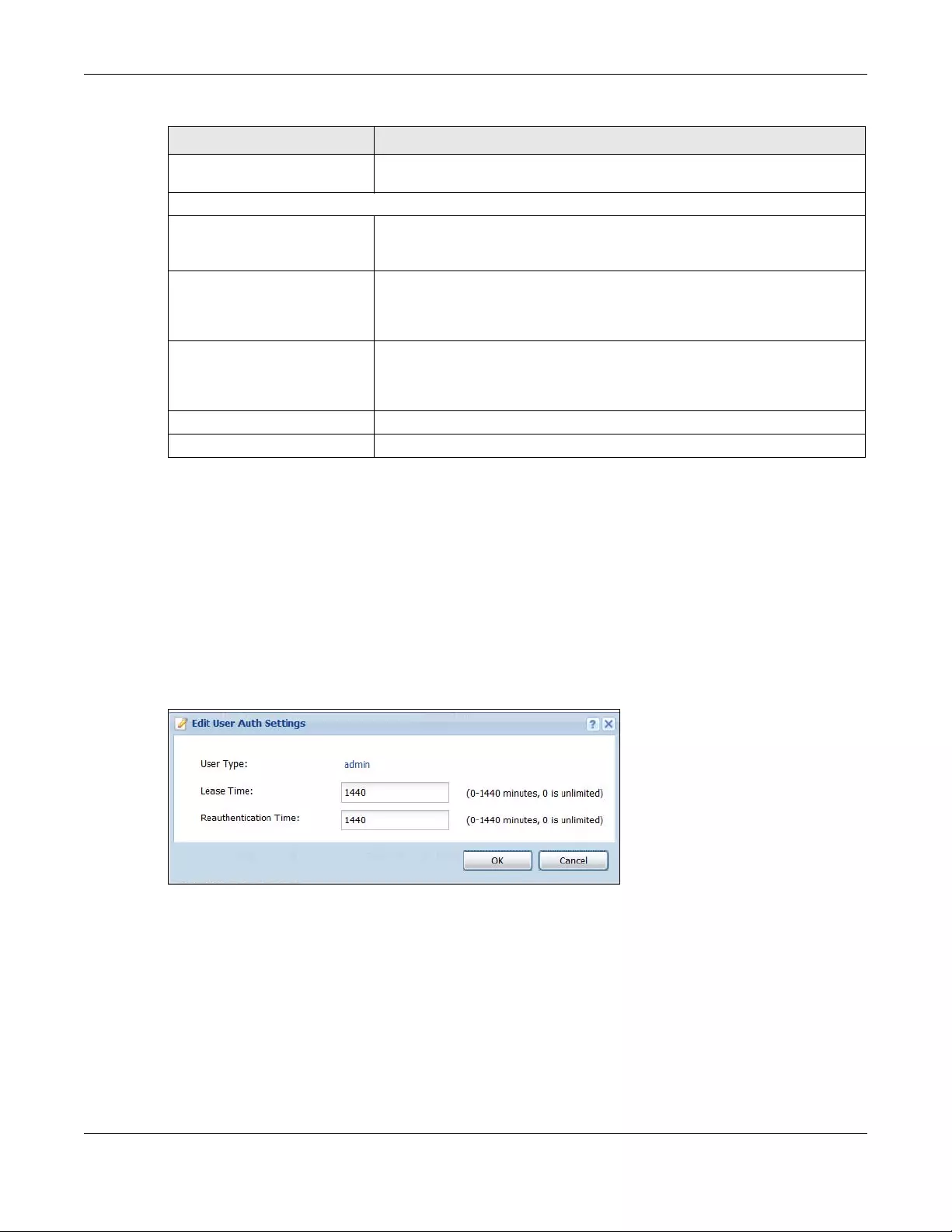
Chapter 35 Object
ZyWALL/USG Series User’s Guide
573
35.2.4.1 Default User Authentication Timeout Settings Edit Screens
The Default Authentication Timeout Settings Edit screen allows you to set the default
authentication timeout settings for the selected type of user account. These default authentication
timeout settings also control the settings for any existing user accounts that are set to use the
default settings. You can still manually configure any user account’s authentication timeout
settings.
To access this screen, go to the Configuration > Object > User/Group > Setting screen (see
Section 35.2.4 on page 570), and click one of the Default Authentication Timeout Settings
section’s Edit icons.
Figure 380 Configuration > Object > User/Group > Setting > Edit
Maximum number per
access account This field is effective when Limit ... for access account is checked. Type
the maximum number of simultaneous logins by each access user.
User Lockout Settings
Enable logon retry limit Select this check box to set a limit on the number of times each user can
login unsuccessfully (for example, wrong password) before the IP address is
locked out for a specified amount of time.
Maximum retry count This field is effective when Enable logon retry limit is checked. Type the
maximum number of times each user can login unsuccessfully before the IP
address is locked out for the specified lockout p eriod. The number must be
between 1 and 99.
Lockout period This field is effective when Enable logon retry limit is checked. Type the
number of minutes the user must wait to try to login again, if logon retry
limit is enabled and the maximum retry count is reached. This number
must be between 1 and 65,535 (about 45.5 days).
Apply Click Apply to save the changes.
Reset Click Reset to return the screen to its last-saved settings.
Table 238 Configuration > Object > User/Group > Setting (continued)
LABEL DESCRIPTION
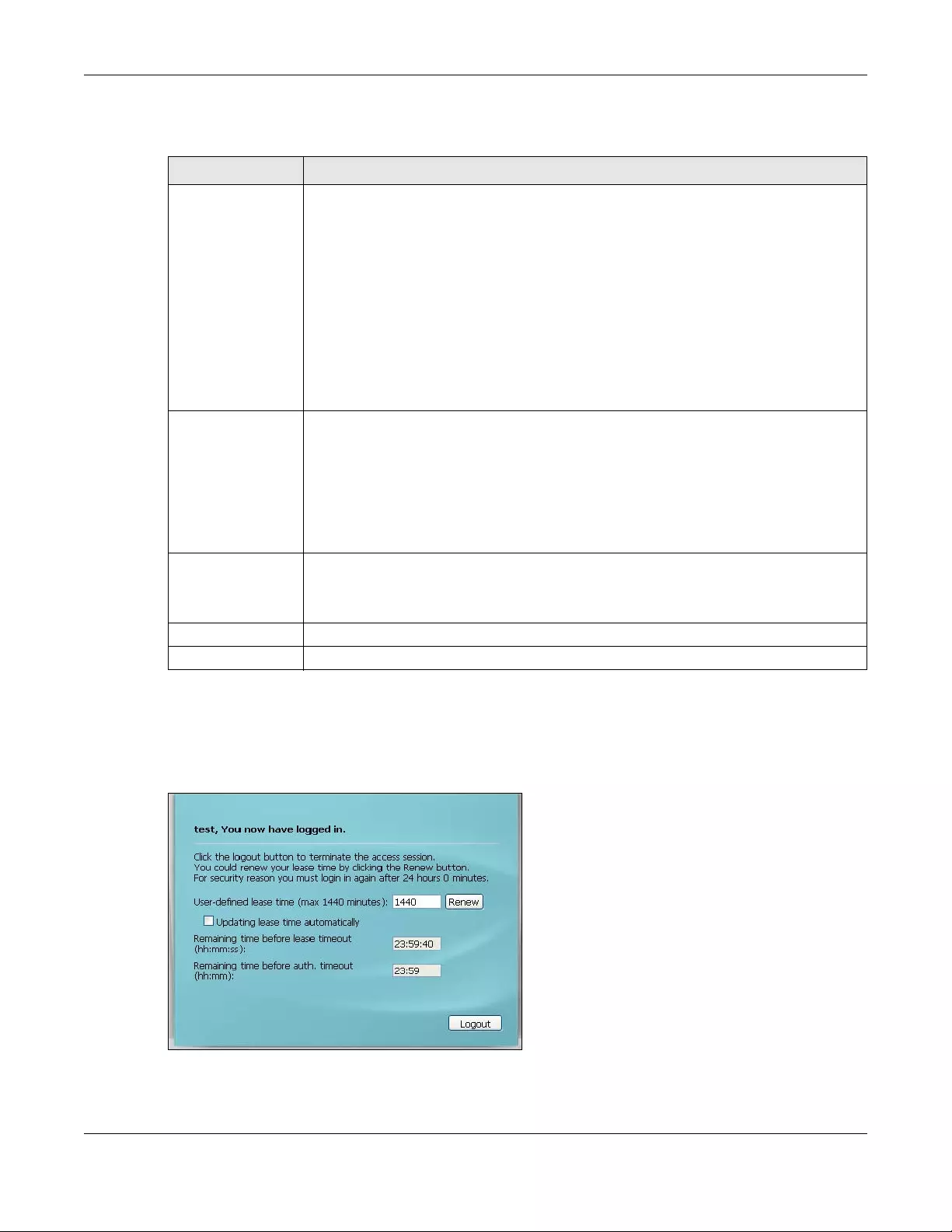
Chapter 35 Object
ZyWALL/USG Series User’s Guide
574
The following table describes the labels in this screen.
35.2.4.2 User Aware Login Example
Access users cannot use the Web Configurator to browse the configuration of the ZyWALL/USG.
Instead, after access users log into the ZyWALL/USG, the following screen appears.
Figure 381 Web Configurator for Non-Admin Users
Table 239 Configuration > Object > User/Group > Setting > Edit
LABEL DESCRIPTION
User Type This read-only field identifies the type of user account for which you are configuring the
default settings.
•admin - this user can look at and change the configuration of the ZyWALL/USG
•limited-admin - this user can look at the configuration of the ZyWALL/USG but not
to change it.
•user - this user has access to the ZyWALL/USG’s services but cannot look at the
configuration.
•guest - this user has access to the ZyWALL/USG’s services but cannot look at the
configuration.
•ext-user - this user account is maintained in a remote server, such as RADIUS or
LDAP. See Ext-User Accounts on page 564 for more information about this type.
•ext-group-user - this user account is maintained in a remote server, such as
RADIUS or LDAP. See Ext-Group-User Accounts on page 565 for more information
about this type.
Lease Time Enter the number of minutes this type of user account has to renew the current session
before the user is logged out. You can specify 1 to 1440 minutes. You can enter 0 to
make the number of minutes unlimited.
Admin users renew the session every time the main screen refreshes in the Web
Configurator. Access users can renew the session by clicking the Renew button on their
screen. If you allow access users to renew time automatically (see Section 35.2.4 on
page 570), the users can select this check box on their screen as well. In this case, the
session is automatically renewed before the lease time expires.
Reauthentication
Time
Type the number of minutes this type of user account can be logged into the ZyWALL/
USG in one session before the user has to log in again. You can specify 1 to 1440
minutes. You can enter 0 to make the number of minutes unlimited. Unlike Lease Time,
the user has no opportunity to renew the session without logging out.
OK Click OK to save your changes back to the ZyWALL/USG.
Cancel Click Cancel to exit this screen without saving your changes.
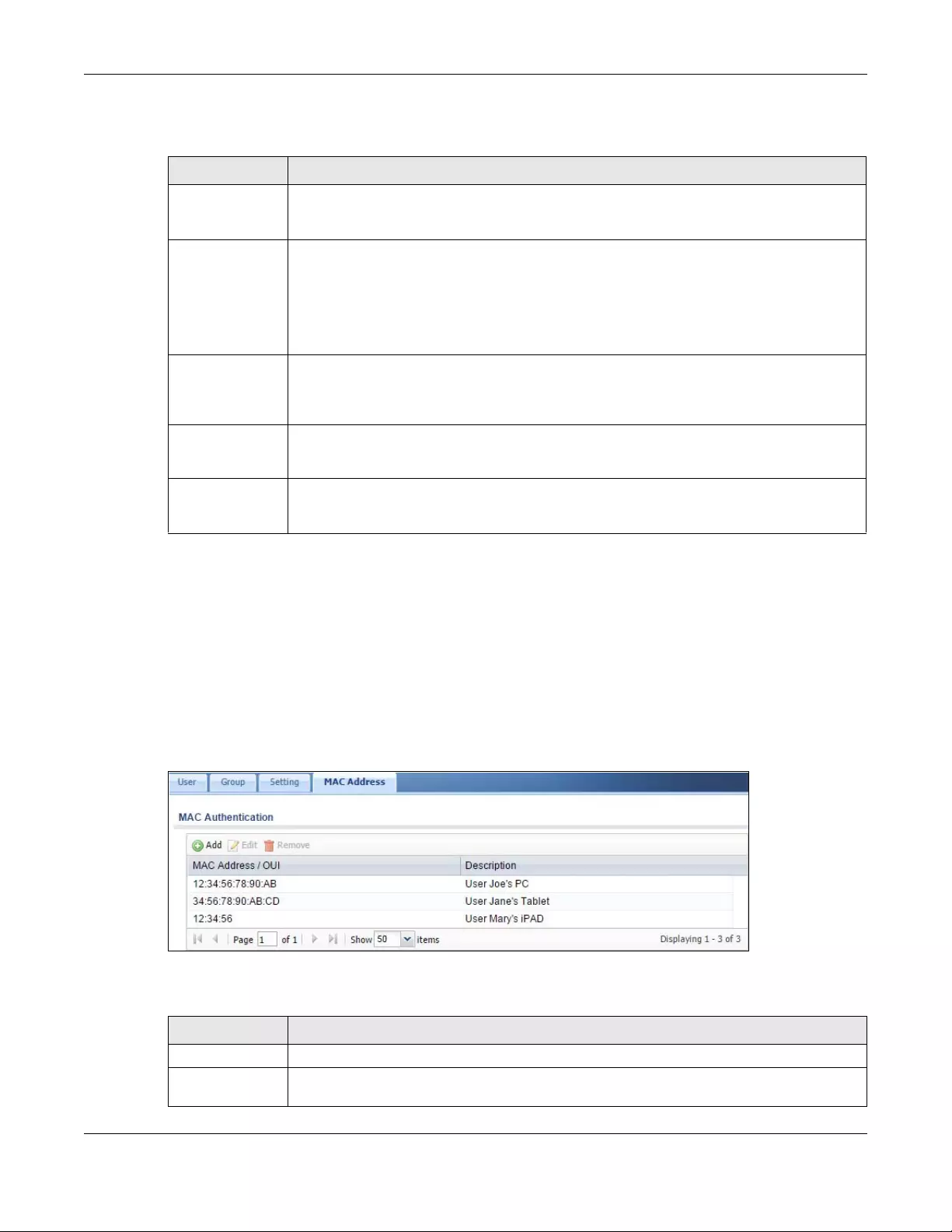
Chapter 35 Object
ZyWALL/USG Series User’s Guide
575
The following table describes the labels in this screen.
35.2.5 User/Group MAC Address Summary Screen
This screen shows the MAC addresses of wireless clients, which can be authenticated by their MAC
addresses using the local user database. Click Configuration > Object > User/Group > MAC
Address to open this screen.
Note: You need to configure an SSID security profile’s MAC authentication settings to
have the AP use the ZyWALL/USG’s local database to authenticate wireless clients
by their MAC addresses.
Figure 382 Configuration > Object > User/Group > MAC Address
The following table describes the labels in this screen.
Table 240 Web Configurator for Non-Admin Users
LABEL DESCRIPTION
User-defined
lease time (max
... minutes)
Access users can specify a lease time shorter than or equal to the one that you specified.
The default value is the lease time that you specified.
Renew Access users can click this button to reset the lease time, the amount of time remaining
before the ZyWALL/USG automatically logs them out. The ZyWALL/USG sets this amount
of time according to the
•User-defined lease time field in this screen
•Lease tim e field in the User Add/Edit screen (see Section 35.2.5.1 on page 576)
•Lease tim e field in the Setting screen (see Section 35.2.4 on page 570)
Updating lease
time
automatically
This box appears if you checked the Allow renewing lease time automatically box in
the Setting screen. (See Section 35.2.4 on page 570.) Access users can select this check
box to reset the lease time automatically 30 seconds before it expires. Otherwise, access
users have to click the Renew button to reset the lease time.
Remaining time
before lease
timeout
This field displays the amount of lease time that remains, though the user might be able to
reset it.
Remaining time
before auth.
timeout
This field displays the amount of time that remains before the ZyWALL/USG automatically
logs the access user out, regardless of the lease time.
Table 241 Configuration > Object > User/Group > MAC Address
LABEL DESCRIPTION
Add Click this to create a new entry.
Edit Double-click an entry or select it and click Edit to open a screen where you can modify the
entry’s settings.
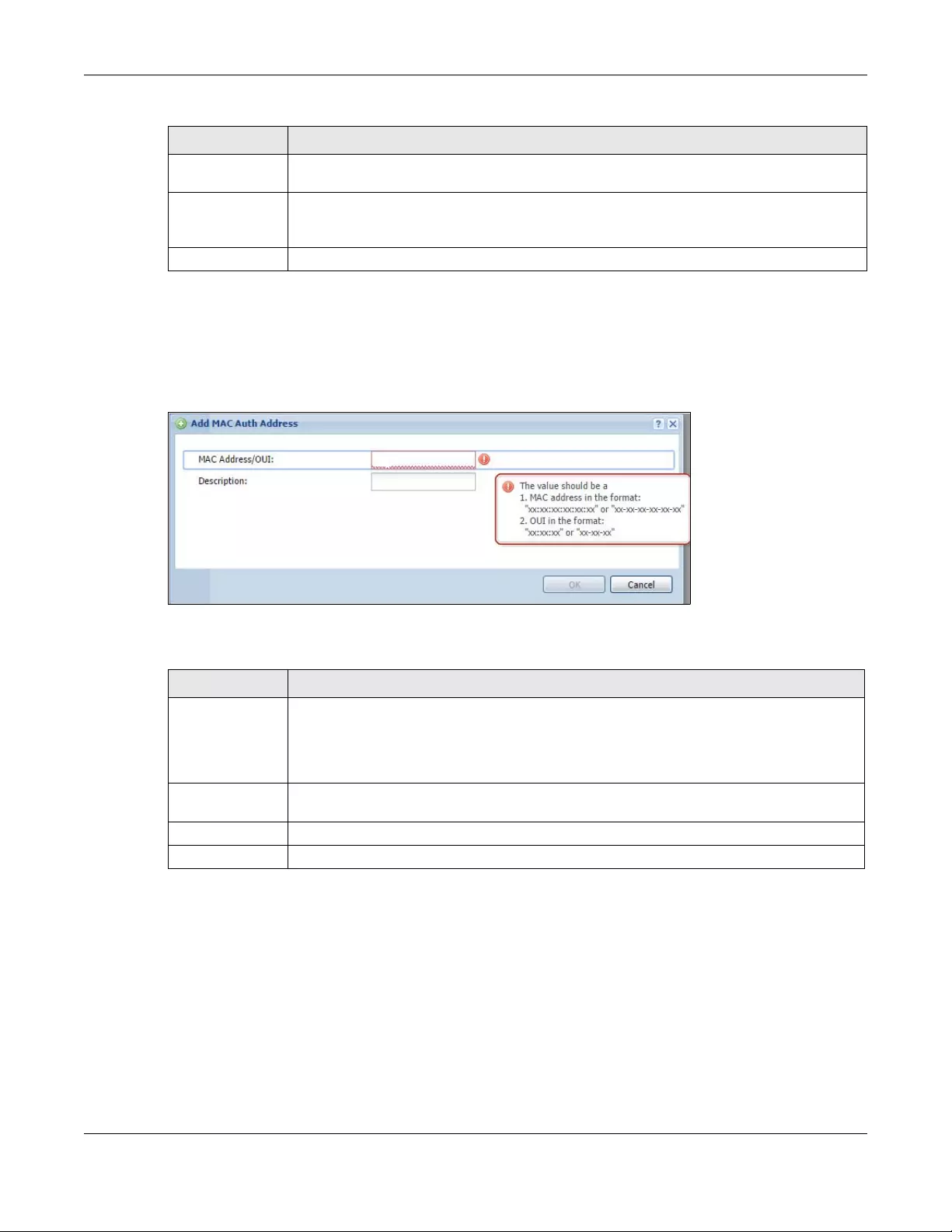
Chapter 35 Object
ZyWALL/USG Series User’s Guide
576
35.2.5.1 MAC Address Add/Edit Screen
This screen allows you to create a new allowed device or edit an existing one. To access this screen,
go to the MAC Address screen (see Section 35.2.5 on page 575), and click either the Add icon or
an Edit icon.
Figure 383 Configuration > Object > User/Group > MAC Address > Add
The following table describes the labels in this screen.
35.2.6 User /Group Technical Reference
This section provides some information on users who use an external authentication server in order
to log in.
Remove To remove an entry, select it and click Remove. The ZyWALL/USG confirms you want to
remove it before doing so.
MAC Address/
OUI
This field displays the MAC address or OUI (Organizationally Unique Identifier of computer
hardware manufacturers) of wireless clients using MAC authentication with the ZyWALL/
USG local user database.
Description This field displays a description of the device identified by the MAC address or OUI.
Table 241 Configuration > Object > User/Group > MAC Address (continued)
LABEL DESCRIPTION
Table 242 Configuration > Object > User/Group > MAC Address > Add
LABEL DESCRIPTION
MAC Address/
OUI
Type the MAC address (six hexadecimal number pairs separated by colons or hyphens) or
OUI (three hexadecimal number pairs separated by colons or hyphens) to identify specific
wireless clients for MAC authentication using the ZyWALL/USG local user database. The
OUI is the first three octets in a MAC address and uniquely identifies the manufacturer of
a network device.
Description Enter an optional description of the wireless device(s) identified by the MAC or OUI. You
can use up to 60 characters, punctuation marks, and spaces.
OK Click OK to save your changes back to the ZyWALL/USG.
Cancel Click Cancel to exit this screen without saving your changes.
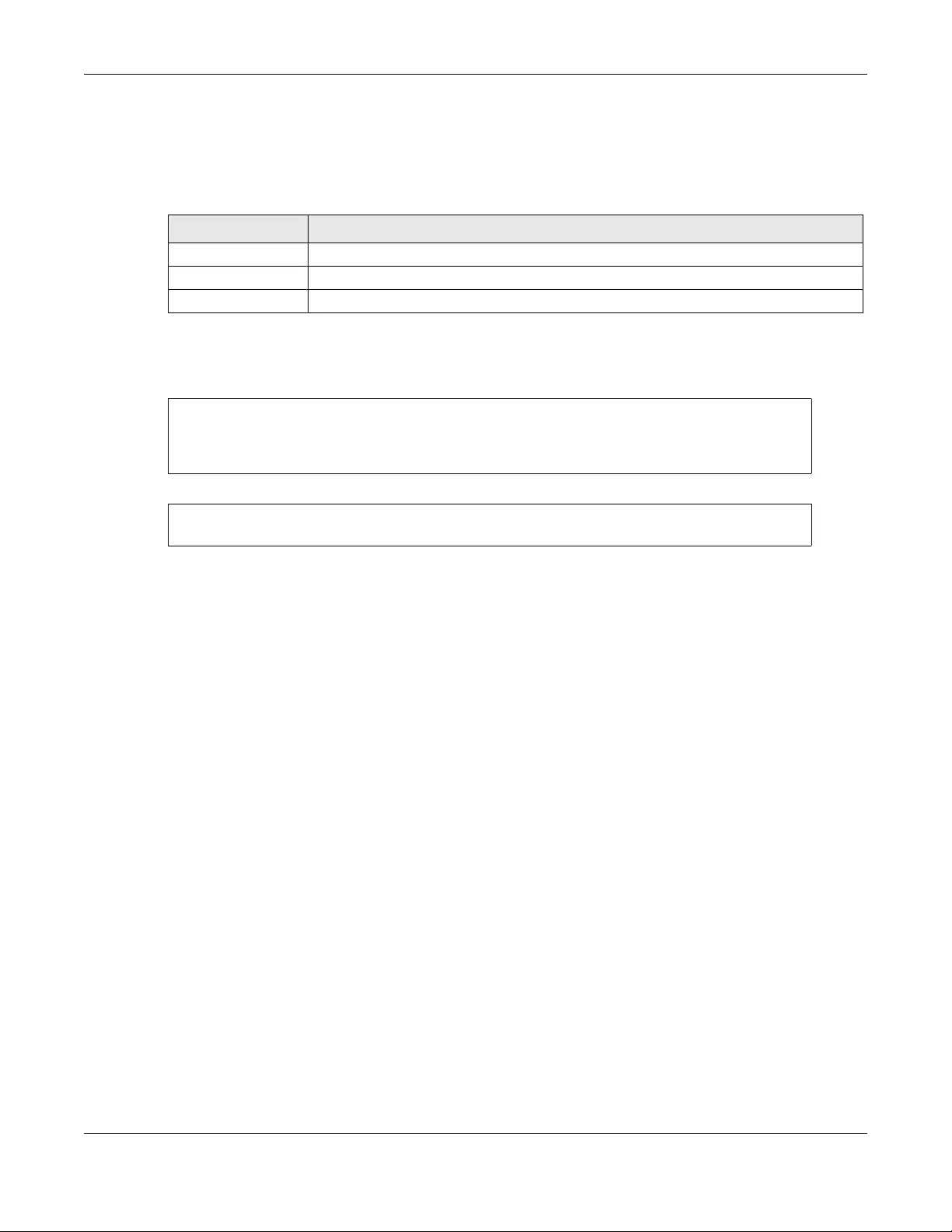
Chapter 35 Object
ZyWALL/USG Series User’s Guide
577
Setting up User Attributes in an External Server
To set up user attributes, such as reauthentication time, in LDAP or RADIUS servers, use the
following keywords in the user configuration file.
The following examples show you how you might set up user attributes in LDAP and RADIUS
servers.
Creating a Large Number of Ext-User Accounts
If you plan to create a large number of Ext-User accounts, you might use CLI commands, instead
of the Web Configurator, to create the accounts. Extract the user names from the LDAP or RADIUS
server, and create a shell script that creates the user accounts.
35.3 AP Profile Overview
This section shows you how to configure preset profiles for the Access Points (APs) connected to
your ZyWALL/USG’s wireless network.
•The Radio screen (Section 35.3.1 on page 578) creates radio configurations that can be used by
the APs.
•The SSID screen (Section 35.3.2 on page 583) configures three different types of profiles for
your networked APs.
35.3.0.1 What You Need To Know
The following terms and concepts may help as you read this section.
Wireless Profiles
At the heart of all wireless AP configurations on the ZyWALL/USG are profiles. A profile represents a
group of saved settings that you can use across any number of connected APs. You can set up the
following wireless profile types:
Table 243 LDAP/RADIUS: Keywords for User Attributes
KEYWORD CORRESPONDING ATTRIBUTE IN WEB CONFIGURATOR
type User Type. Possible Values: admin, limited-admin, user, guest.
leaseTime Lea s e T ime. Possible Values: 1-1440 (minutes).
reauthTime Reauthentication Time. Possible Values: 1-1440 (minutes).
Figure 384 LDAP Example: Keywords for User Attributes
type: admin
leaseTime: 99
reauthTime: 199
Figure 385 RADIUS Example: Keywords for User Attributes
type=user;leaseTime=222;reauthTime=222

Chapter 35 Object
ZyWALL/USG Series User’s Guide
578
•Radio - This profile type defines the properties of an AP’s radio transmitter. You can have a
maximum of 32 radio profiles on the ZyWALL/USG.
•SSID - This profile type defines the properties of a single wireless network signal broadcast by
an AP. Each radio on a single AP can broadcast up to 8 SSIDs. You can have a maximum of 32
SSID profiles on the ZyWALL/USG.
•Security - This profile type defines the security settings used by a single SSID. It controls the
encryption method required for a wireless client to associate itself with the SSID. You can have a
maximum of 32 security profiles on the ZyWALL/USG.
•MAC Filtering - This profile provides an additional layer of security for an SSID, allowing you to
block access or allow access to that SSID based on wireless client MAC addresses. If a client’s
MAC address is on the list, then it is either allowed or denied, depending on how you set up the
MAC Filter profile. You can have a maximum of 32 MAC filtering profiles on the ZyWALL/USG.
SSID
The SSID (Service Set IDentifier) is the name that identifies the Service Set with which a wireless
station is associated. Wireless stations associating to the access point (AP) must have the same
SSID. In other words, it is the name of the wireless network that clients use to connect to it.
WEP
WEP (Wired Equivalent Privacy) encryption scrambles all data packets transmitted between the AP
and the wireless stations associated with it in order to keep network communications private. Both
the wireless stations and the access points must use the same WEP key for data encryption and
decryption.
WPA and WPA2
Wi-Fi Protected Access (WPA) is a subset of the IEEE 802.11i standard. WPA2 (IEEE 802.11i) is a
wireless security standard that defines stronger encryption, authentication and key management
than WPA. Key differences between WPA(2) and WEP are improved data encryption and user
authentication.
IEEE 802.1x
The IEEE 802.1x standard outlines enhanced security methods for both the authentication of
wireless stations and encryption key management. Authentication is done using an external
RADIUS server.
35.3.1 Radio Screen
This screen allows you to create radio profiles for the APs on your network. A radio profile is a list of
settings that a supported managed AP (NWA5121-N for example) can use to configure either one of
its two radio transmitters. To access this screen click Configuration > Object > AP Profile.
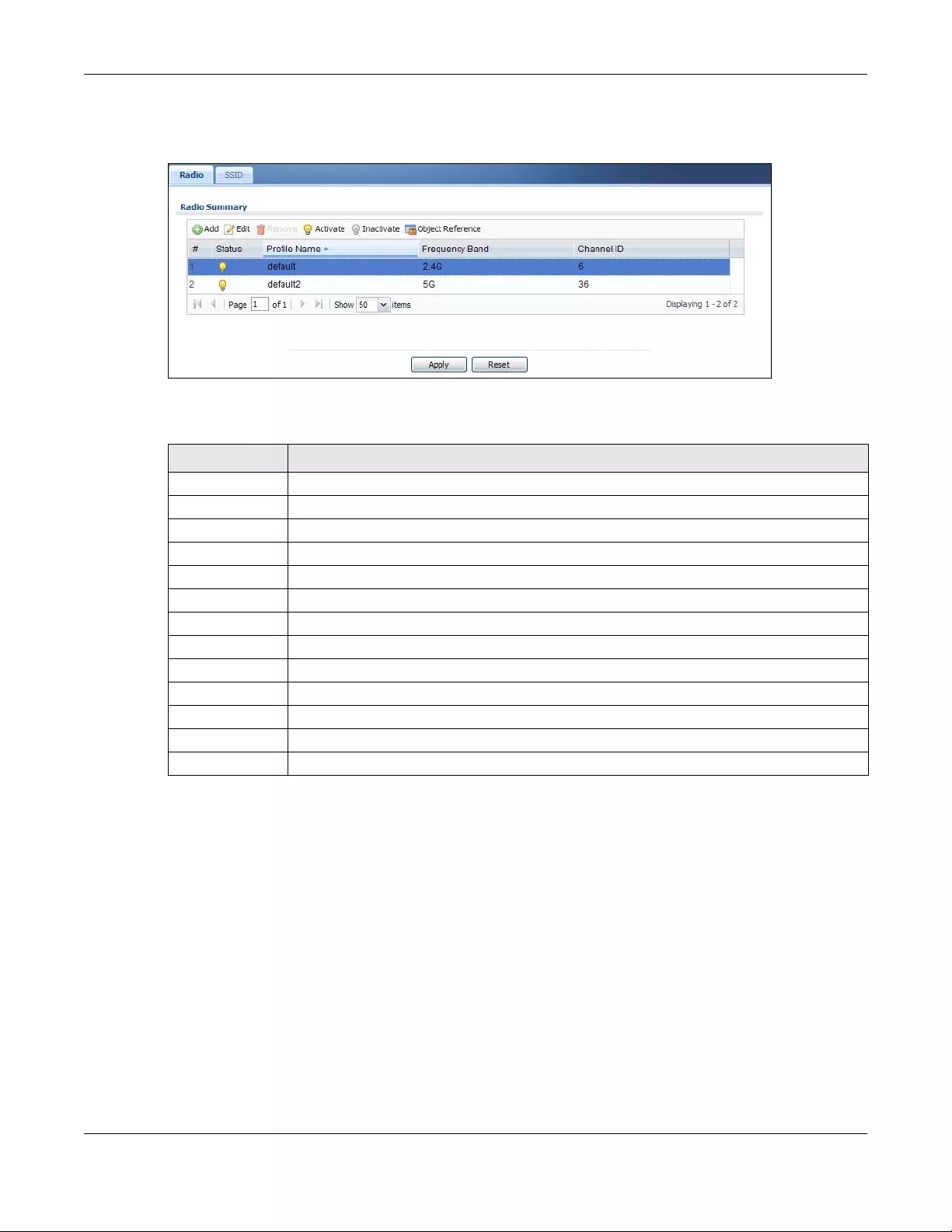
Chapter 35 Object
ZyWALL/USG Series User’s Guide
579
Note: You can have a maximum of 32 radio profiles on the ZyWALL/USG.
Figure 386 Configuration > Object > AP Profile > Radio
The following table describes the labels in this screen.
Table 244 Configuration > Object > AP Profile > Radio
LABEL DESCRIPTION
Add Click this to add a new radio profile.
Edit Click this to edit the selected radio profile.
Remove Click this to remove the selected radio profile.
Activate To turn on an entry, select it and click Activate.
Inactivate To turn off an entry, select it and click Inactivate.
Object Reference Click this to view which other objects are linked to the selected radio profile.
# This field is a sequential value, and it is not associated with a specific profile.
Status This icon is lit when the entry is active and dimmed when the entry is inactive.
Profile Name This field indicates the name assigned to the radio profile.
Frequency Band This field indicates the frequency band which this radio profile is configured to use.
Channel ID This field indicates the broadcast channel which this radio profile is configured to use.
Apply Click Apply to save your changes back to the ZyWALL/USG.
Reset Click Reset to return the screen to its last-saved settings.
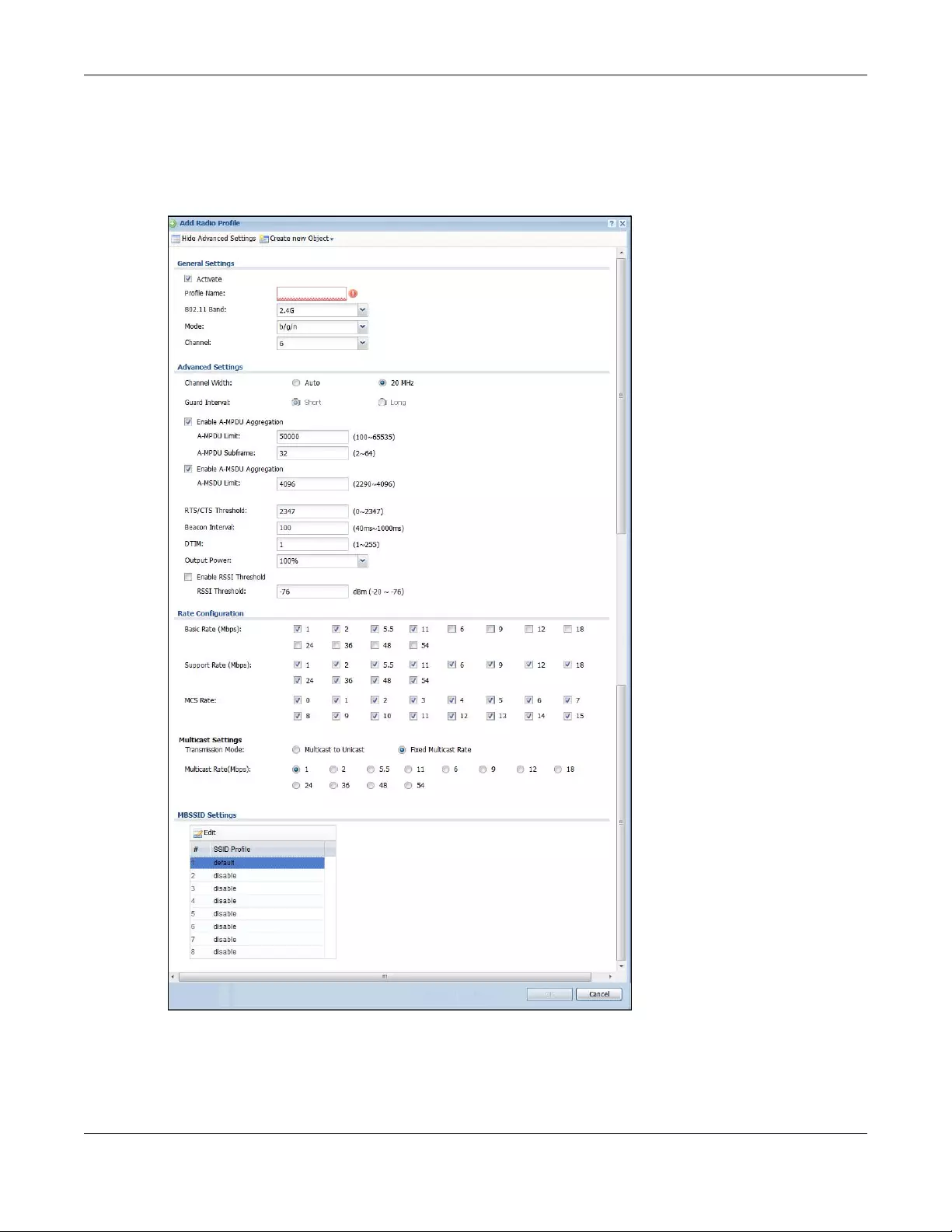
Chapter 35 Object
ZyWALL/USG Series User’s Guide
580
35.3.1.1 Add/Edit Radio Profile
This screen allows you to create a new radio profile or edit an existing one. To access this screen,
click the Add button or select a radio profile from the list and click the Edit button.
Figure 387 Configuration > Object > AP Profile > Add/Edit Radio Profile

Chapter 35 Object
ZyWALL/USG Series User’s Guide
581
The following table describes the labels in this screen.
Table 245 Configuration > Object > AP Profile > Add/Edit Radio Profile
LABEL DESCRIPTION
Hide / Show
Advanced Settings
Click this to hide or show the Advanced Settings in this window.
Create New Object Select an item from this menu to create a new object of that type. Any objects created
in this way are automatically linked to this radio profile.
General Settings
Activate Select this option to make this profile active.
Profile Name Enter up to 31 alphanumeric characters to be used as this profile’s name. Spaces and
underscores are allowed.
802.11 Band Select the wireless band which this radio profile should use.
2.4 GHz is the frequency used by IEEE 802.11b/g/n wireless clients.
5 GHz is the frequency used by IEEE 802.11a/n wireless clients.
Mode Select how to let wireless clients connect to the AP.
When using the 2.4 GHz band, select b/g to let IEEE 802.11b and IEEE 802.11g
compliant WLAN devices associate with the AP.
When using the 2.4 GHz band, select b/g/n to let IEEE 802.11b, IEEE 802.11g, and
IEEE 802.11n compliant WLAN devices associate with the AP.
When using the 5 GHz band, select a to let only IEEE 802.11a compliant WLAN devices
associate with the AP.
When using the 5 GHz band, select a/n to let IEEE 802.11a and IEEE 802.11n
compliant WLAN devices associate with the AP.
Channel Select the wireless channel which this radio profile should use.
It is recommended that you choose the channel least in use by other APs in the region
where this profile will be implemented. This will reduce the amount of interference
between wireless clients and the AP to which this profile is assigned.
Some 5 GHz channels include the label indoor use only. These are for use with an
indoor AP only. Do not use them with an outdoor AP.
Advanced Settings
Channel Width Select the channel bandwidth you want to use for your wireless network.
Select Auto to allow the ZyWALL/USG to adjust the channel bandwidth to 40 MHz or
20 MHz depending on network conditions.
Select 20 MHz if you want to lessen radio interference with other wireless devices in
your neighborhood.
Guard Interval Set the guard interval for this radio profile to either short or long.
The guard interval is the gap introduced between data transmission from users in order
to reduce interference. Reducing the interval increases data transfer rates but also
increases interference. Increasing the interval reduces data transfer rates but also
reduces interference.
Enable A-MPDU
Aggregation Select this to enable A-MPDU aggregation.
Message Protocol Data Unit (MPDU) aggregation collects Ethernet frames along with
their 802.11n headers and wraps them in a 802.11n MAC header. This method is useful
for increasing bandwidth throughput in environments that are prone to high error
rates.
A-MPDU Limit Enter the maximum frame size to be aggregated.
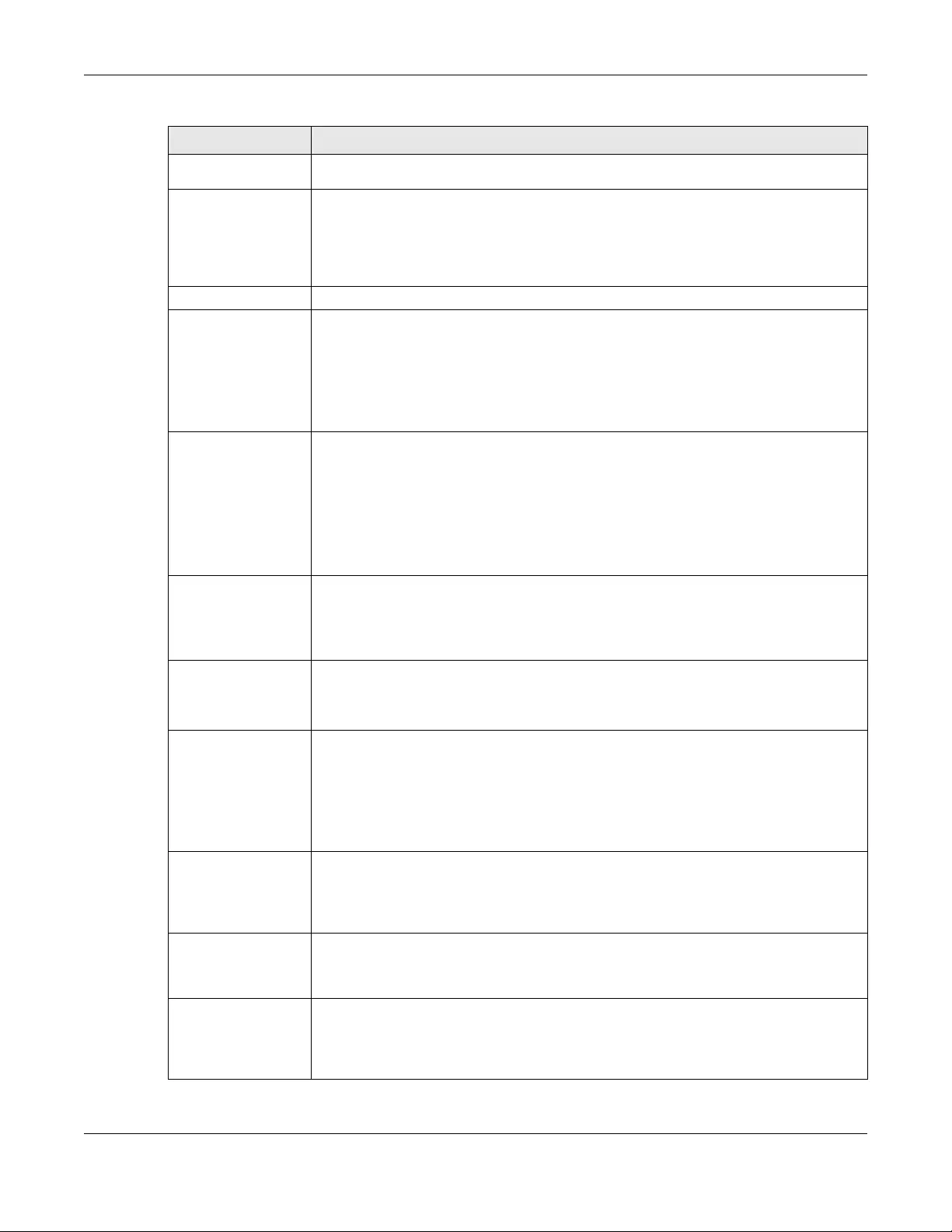
Chapter 35 Object
ZyWALL/USG Series User’s Guide
582
A-MPDU
Subframe Enter the maximum number of frames to be aggregated each time.
Enable A-MSDU
Aggregation Select this to enable A-MSDU aggregation.
Mac Service Data Unit (MSDU) aggregation collects Ethernet frames without any of
their 802.11n headers and wraps the header-less payload in a single 802.11n MAC
header. This method is useful for increasing bandwidth throughput. It is also more
efficient than A-MPDU except in environments that are prone to high error rates.
A-MSDU Limit Enter the maximum frame size to be aggregated.
Disable-Channel
Switch for DFS This field is available when you select 5G in the 802.11 Band field.
DFS (dynamic frequency selection) allows an AP to detect other devices in the same
channel. If there is another device using the same channel, the AP changes to a
different channel, so that it can avoid interference with radar systems or other wireless
networks.
Select this option to disable DFS on the AP.
RTS/CTS
Threshold Use RTS/CTS to reduce data collisions on the wireless network if you have wireless
clients that are associated with the same AP but out of range of one another. When
enabled, a wireless client sends an RTS (Request To Send) and then waits for a CTS
(Clear To Send) before it transmits. This stops wireless clients from transmitting
packets at the same time (and causing data collisions).
A wireless client sends an RTS for all packets larger than the number (of bytes) that
you enter here. Set the RTS/CTS equal to or higher than the fragmentation threshold
to turn RTS/CTS off.
Beacon Interval When a wirelessly networked device sends a beacon, it includes with it a beacon
interval. This specifies the time period before the device sends the beacon again. The
interval tells receiving devices on the network how long they can wait in low-power
mode before waking up to handle the beacon. A high value helps save current
consumption of the access point.
DTIM Delivery Traffic Indication Message (DTIM) is the time period after which broadcast and
multicast packets are transmitted to mobile clients in the Active Power Management
mode. A high DTIM value can cause clients to lose connectivity with the network. This
value can be set from 1 to 255.
Output Power Set the output power of the AP in this field. If there is a high density of APs in an area,
decrease the output power of the NWA5160N to reduce interference with other APs.
Select one of the following 100%, 50%, 25%, or 12.5%. See the product
specifications for more information on your ZyWALL/USG’s output power.
Note: Reducing the output power also reduces the ZyWALL/USG’s effective broadcast
radius.
Enable Signal
Threshold Select the check box to use the signal threshold to ensure wireless clients receive good
throughput. This allows only wireless clients with a strong signal to connect to the AP.
Clear the check box to not require wireless clients to have a minimum signal strength
to connect to the AP.
Station Signal
Threshold Set a minimum client signal strength. A wireless client is allowed to connect to the AP
only when its signal strength is stronger than the specified threshold.
-20 dBm is the strongest signal you can require and -76 is the weakest.
Disassociate
Station
Threshold
Set a minimum kick-off signal strength. When a wireless client’s signal strength is
lower than the specified threshold, the ZyWALL/USG disconnects the wireless client
from the AP.
-20 dBm is the strongest signal you can require and -90 is the weakest.
Table 245 Configuration > Object > AP Profile > Add/Edit Radio Profile (continued)
LABEL DESCRIPTION
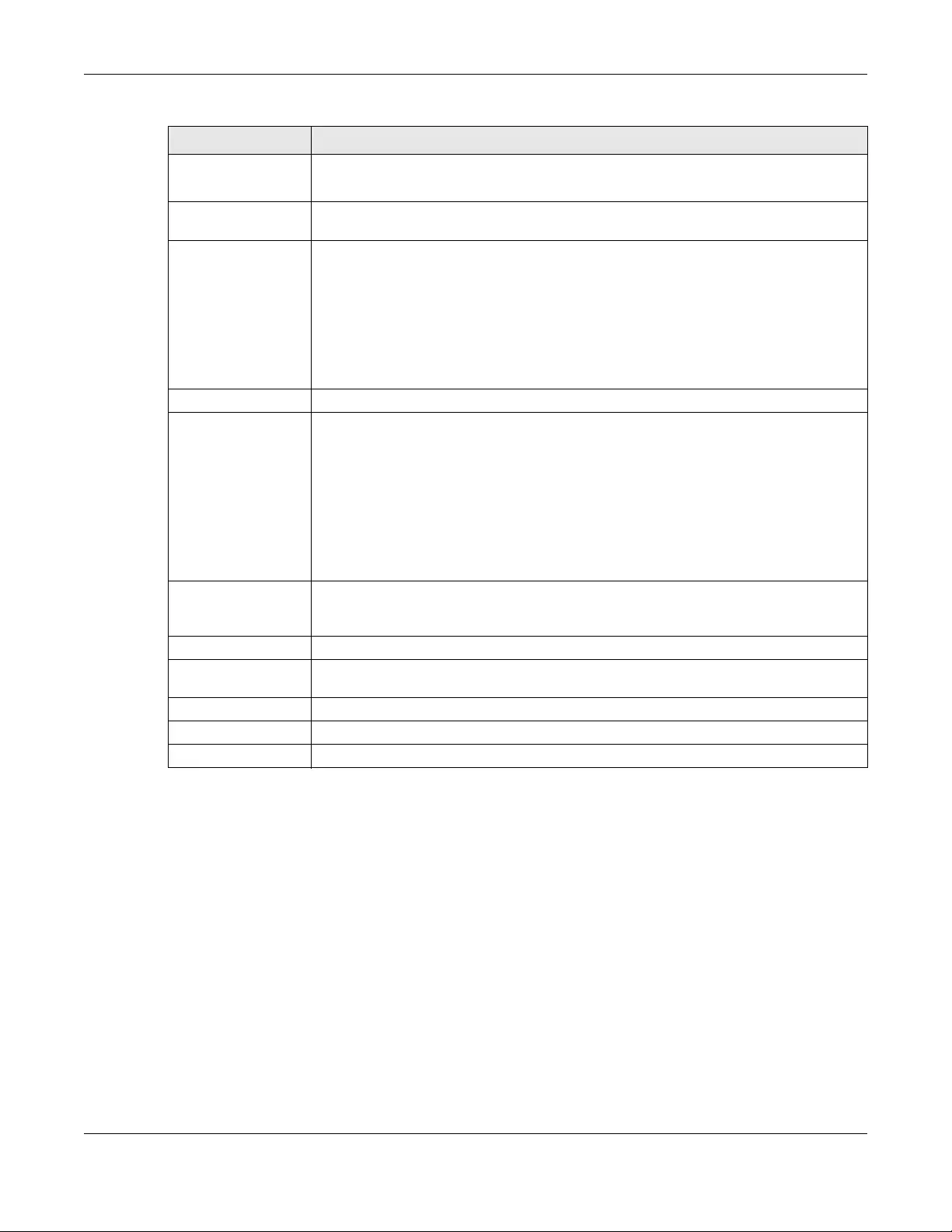
Chapter 35 Object
ZyWALL/USG Series User’s Guide
583
35.3.2 SSID Screen
The SSID screens allow you to configure three different types of profiles for your networked APs: an
SSID list, which can assign specific SSID configurations to your APs; a security list, which can
assign specific encryption methods to the APs when allowing wireless clients to connect to them;
and a MAC filter list, which can limit connections to an AP based on wireless clients MAC addresses.
35.3.2.1 SSID List
This screen allows you to create and manage SSID configurations that can be used by the APs. An
SSID, or Service Set IDentifier, is basically the name of the wireless network to which a wireless
client can connect. The SSID appears as readable text to any device capable of scanning for
wireless frequencies (such as the WiFi adapter in a laptop), and is displayed as the wireless network
name when a person makes a connection to it.
To access this screen click Configuration > Object > AP Profile > SSID.
Allow Station
Connection after
Multiple Retries
Select this option to allow a wireless client to try to associate with the AP again after it
is disconnected due to weak signal strength.
Station Retry
Count Set the maximum number of times a wireless client can attempt to re-connect to the
AP.
Rate Configuration This section controls the data rates permitted for clients.
For each Rate, select a rate option from its list. The rates are:
•Basic Rate (Mbps) - Set the basic rate configuration in Mbps.
•Support Rate (Mbps) - Set the support rate configuration in Mbps.
•MCS Rate - Set the MCS rate configuration. IEEE 802.11n supports many different
data rates which are called MCS rates. MCS stands for Modulation and Coding
Scheme. This is an 802.11n feature that increases the wireless network
performance in terms of throughput.
Multicast Settings Use this section to set a transmission mode and maximum rate for multicast traffic.
Transmission
Mode Set how the AP handles multicast traffic.
Select Multicast to Unicast to broadcast wireless multicast traffic to all of the wireless
clients as unicast traffic. Unicast traffic dynamically changes the data rate based on the
application’s bandwidth requirements. The retransmit mechanism of unicast traffic
provides more reliable transmission of the multicast traffic, although it also produces
duplicate packets.
Select Fixed Multicast Rate to send wireless multicast traffic at a single data rate.
You must know the multicast application’s bandwidth requirements and set it in the
following field.
Multicast Rate
(Mbps) If you set the multicast transmission mode to fixed multicast rate, set the data rate for
multicast traffic here. For example, to deploy 4 Mbps video, select a fixed multicast
rate higher than 4 Mbps.
MBSSID Settings This section allows you to associate an SSID profile with the radio profile.
Edit Select and SSID and click this button to reassign it. The selected SSID becomes
editable immediately upon clicking.
SSID Profile Indicates which SSID profile is associated with this radio profile.
OK Click OK to save your changes back to the ZyWALL/USG.
Cancel Click Cancel to exit this screen without saving your changes.
Table 245 Configuration > Object > AP Profile > Add/Edit Radio Profile (continued)
LABEL DESCRIPTION
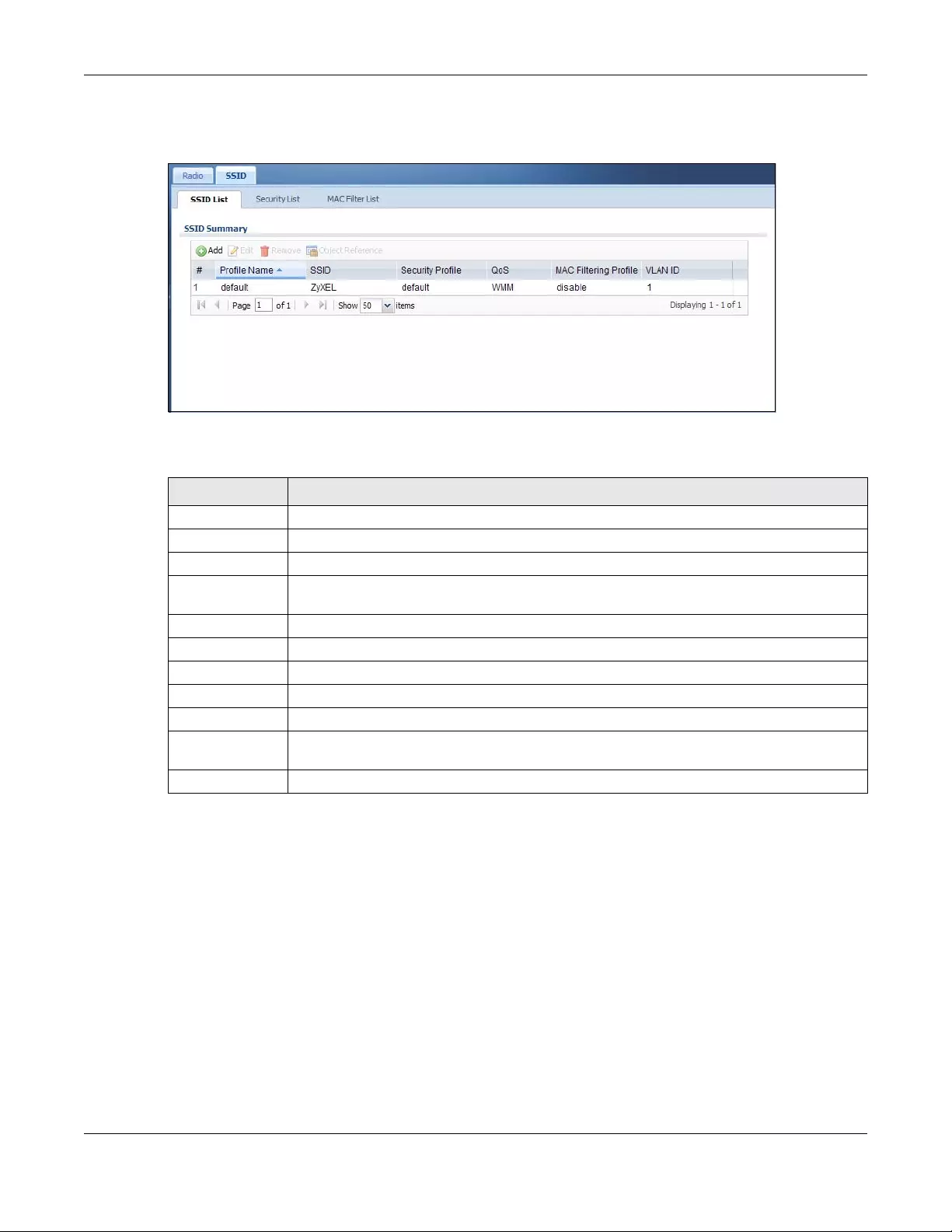
Chapter 35 Object
ZyWALL/USG Series User’s Guide
584
Note: You can have a maximum of 32 SSID profiles on the ZyWALL/USG.
Figure 388 Configuration > Object > AP Profile > SSID List
The following table describes the labels in this screen.
Table 246 Configuration > Object > AP Profile > SSID List
LABEL DESCRIPTION
Add Click this to add a new SSID profile.
Edit Click this to edit the selected SSID profile.
Remove Click this to remove the selected SSID profile.
Object Reference Click this to view which other objects are linked to the selected SSID profile (for example,
radio profile).
# This field is a sequential value, and it is not associated with a specific profile.
Profile Name This field indicates the name assigned to the SSID profile.
SSID This field indicates the SSID name as it appears to wireless clients.
Security Profile This field indicates which (if any) security profile is associated with the SSID profile.
QoS This field indicates the QoS type associated with the SSID profile.
MAC Filtering
Profile
This field indicates which (if any) MAC Filter Profile is associated with the SSID profile.
VLAN ID This field indicates the VLAN ID associated with the SSID profile.
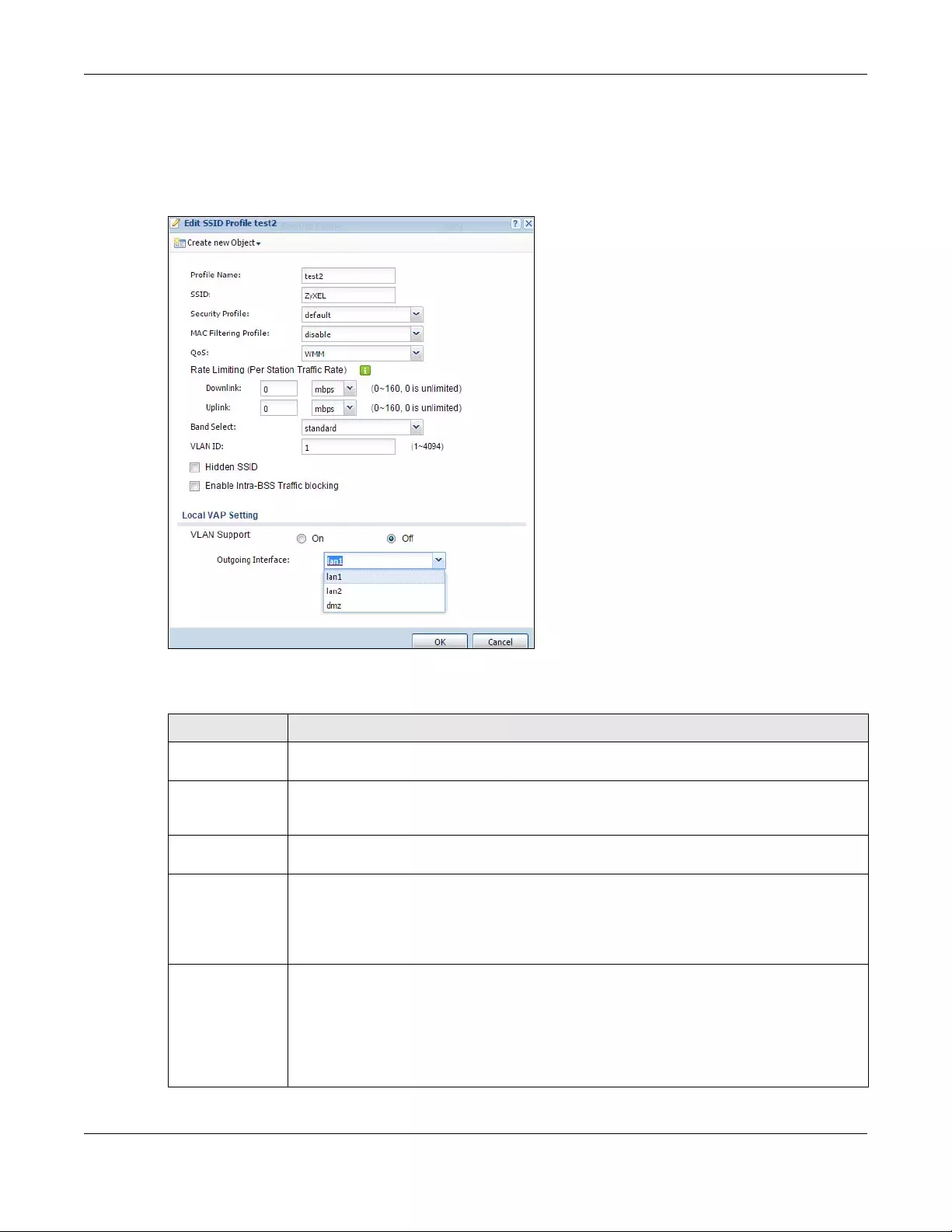
Chapter 35 Object
ZyWALL/USG Series User’s Guide
585
35.3.2.2 Add/Edit SSID Profile
This screen allows you to create a new SSID profile or edit an existing one. To access this screen,
click the Add button or select an SSID profile from the list and click the Edit button.
Figure 389 Configuration > Object > AP Profile > SSID > Add/Edit SSID Profile
The following table describes the labels in this screen.
Table 247 Configuration > Object > AP Profile > SSID > Add/Edit SSID Profile
LABEL DESCRIPTION
Create new
Object
Select an object type from the list to create a new one associated with this SSID profile.
Profile Name Enter up to 31 alphanumeric characters for the profile name. This name is only visible in
the Web Configurator and is only for management purposes. Spaces and underscores are
allowed.
SSID Enter the SSID name for this profile. This is the name visible on the network to wireless
clients. Enter up to 32 characters, spaces and underscores are allowed.
Security Profile Select a security profile from this list to associate with this SSID. If none exist, you can use
the Create new Obje ct menu to create one.
Note: It is highly recommended that you create security profiles for all of your SSIDs to
enhance your network security.
MAC Filtering
Profile
Select a MAC filtering profile from the list to associate with this SSID. If none exist, you can
use the Create new Ob je ct menu to create one.
MAC filtering allows you to limit the wireless clients connecting to your network through a
particular SSID by wireless client MAC addresses. Any clients that have MAC addresses not
in the MAC filtering profile of allowed addresses are denied connections.
The disable setting means no MAC filtering is used.
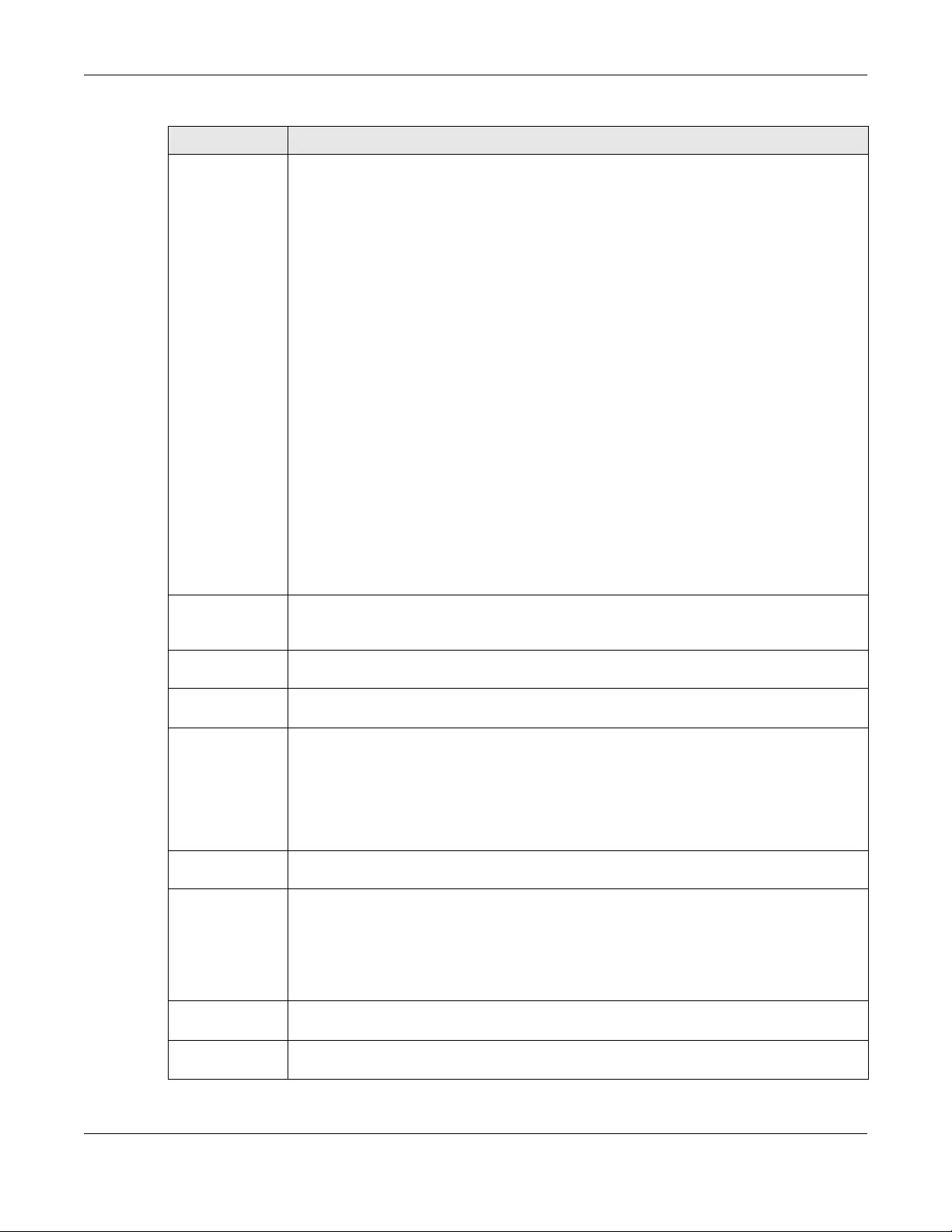
Chapter 35 Object
ZyWALL/USG Series User’s Guide
586
QoS Select a Quality of Service (QoS) access category to associate with this SSID. Access
categories minimize the delay of data packets across a wireless network. Certain
categories, such as video or voice, are given a higher priority due to the time sensitive
nature of their data packets.
QoS access categories are as follows:
disable: Turns off QoS for this SSID. All data packets are treated equally and not tagged
with access categories.
WMM: Enables automatic tagging of data packets. The ZyWALL/USG assigns access
categories to the SSID by examining data as it passes through it and making a best guess
effort. If something looks like video traffic, for instance, it is tagged as such.
WMM_VOICE: All wireless traffic to the SSID is tagged as voice data. This is
recommended if an SSID is used for activities like placing and receiving VoIP phone calls.
WMM_VIDEO: All wireless traffic to the SSID is tagged as video data. This is
recommended for activities like video conferencing.
WMM_BEST_EFFORT: All wireless traffic to the SSID is tagged as “best effort,” meaning
the data travels the best route it can without displacing higher priority traffic. This is good
for activities that do not require the best bandwidth throughput, such as surfing the
Internet.
WMM_BACKGROUND: All wireless traffic to the SSID is tagged as low priority or
“background traffic”, meaning all other access categories take precedence over this one. If
traffic from an SSID does not have strict throughput requirements, then this access
category is recommended. For example, an SSID that only has network printers connected
to it.
Rate Limiting
(Per Station
Traffic Rate)
Define the maximum incoming and outgoing transmission data rate per wireless station
Downlink: Define the maximum incoming transmission data rate (either in mbps or kbps) on a per-
station basis.
Uplink: Define the maximum outgoing transmission data rate (either in mbps or kbps) on a per-
station basis.
Band Select: To improve network performance and avoid interference in the 2.4 GHz frequency band,
you can enable this feature to use the 5 GHz band first. You should set 2.4GHz and 5 GHz
radio profiles to use the same SSID and security settings.
Select standard to have the AP try to connect the wireless clients to the same SSID using
the 5 GHZ band. Connections to an SSID using the 2.4GHz band are still allowed.
Otherwise, select disable to turn off this feature.
VLAN ID Enter the VLAN ID that will be used to tag all traffic originating from this SSID if the VLAN
is different from the native VLAN.
Hidden SSID Select this if you want to “hide” your SSID from wireless clients. This tells any wireless
clients in the vicinity of the AP using this SSID profile not to display its SSID name as a
potential connection. Not all wireless clients respect this flag and display it anyway.
When an SSID is “hidden” and a wireless client cannot see it, the only way you can connect
to the SSID is by manually entering the SSID name in your wireless connection setup
screen(s) (these vary by client, client connectivity software, and operating system).
Enable Intra-BSS
Traffic Blocking
Select this option to prevent crossover traffic from within the same SSID.
Local VAP
Setting
This part of the screen only applies to ZyWALL/USG models that have built-in wireless
functionality (AP) - see Table 1 on page 21.
Table 247 Configuration > Object > AP Profile > SSID > Add/Edit SSID Profile (continued)
LABEL DESCRIPTION
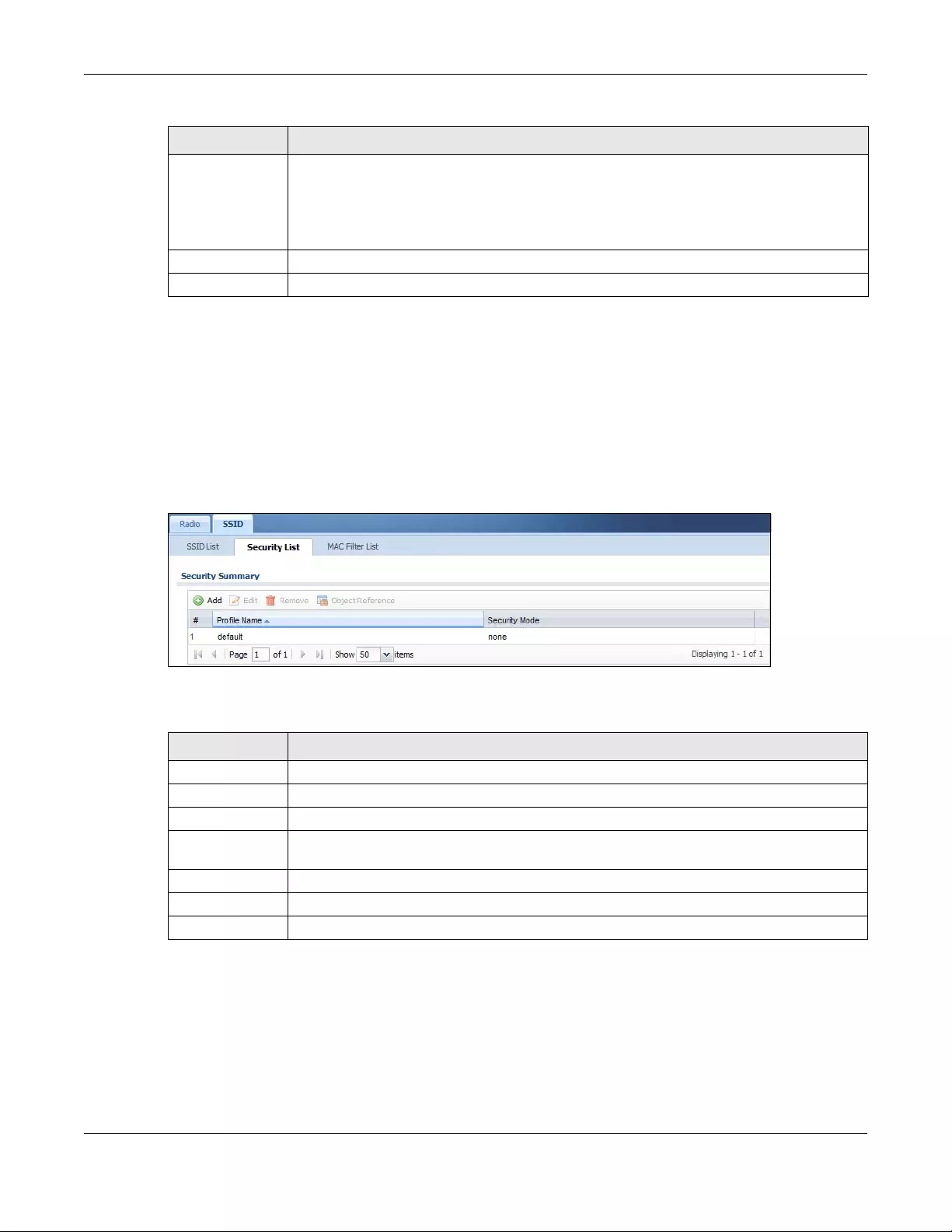
Chapter 35 Object
ZyWALL/USG Series User’s Guide
587
35.3.2.3 Security List
This screen allows you to manage wireless security configurations that can be used by your SSIDs.
Wireless security is implemented strictly between the AP broadcasting the SSID and the stations
that are connected to it.
To access this screen click Configuration > Object > AP Profil e > SSID > Secur ity List .
Note: You can have a maximum of 32 security profiles on the ZyWALL/USG.
Figure 390 Configuration > Object > AP Profile > SSID > Security List
The following table describes the labels in this screen.
VLAN Support Select On to have the ZyWALL/USG assign the VLAN ID listed in the top part of the screen
to the built-in AP.
Select Off to have the ZyWALL/USG ignore the VLAN ID listed in the top part of the screen.
Select an Outgoing Interface to have the ZyWALL/USG assign an IP address in the same
subnet as the selected interface to the built-in AP.
OK Click OK to save your changes back to the ZyWALL/USG.
Cancel Click Cancel to exit this screen without saving your changes.
Table 247 Configuration > Object > AP Profile > SSID > Add/Edit SSID Profile (continued)
LABEL DESCRIPTION
Table 248 Configuration > Object > AP Profile > SSID > Security List
LABEL DESCRIPTION
Add Click this to add a new security profile.
Edit Click this to edit the selected security profile.
Remove Click this to remove the selected security profile.
Object Reference Click this to view which other objects are linked to the selected security profile (for
example, SSID profile).
# This field is a sequential value, and it is not associated with a specific profile.
Profile Name This field indicates the name assigned to the security profile.
Security Mode This field indicates this profile’s security mode (if any).
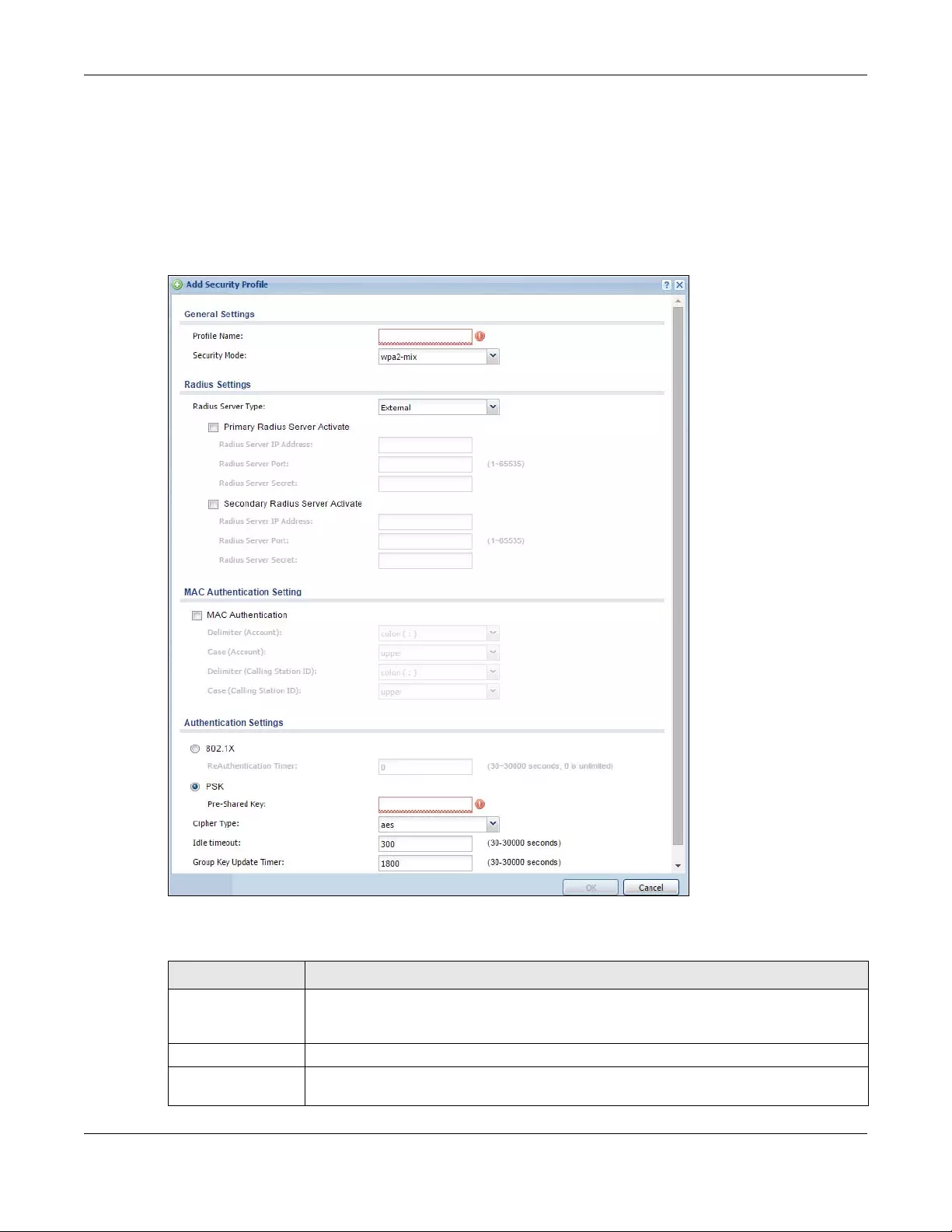
Chapter 35 Object
ZyWALL/USG Series User’s Guide
588
35.3.2.3.1 Add/Edit Security Profile
This screen allows you to create a new security profile or edit an existing one. To access this screen,
click the Add button or select a security profile from the list and click the Edit button.
Note: This screen’s options change based on the Security Mode selected. Only the
default screen is displayed here.
Figure 391 Configuration > Object > AP Profile > SSID > Security Profile > Add/Edit Security Profile
The following table describes the labels in this screen.
Table 249 Configuration > Object > AP Profile > SSID > Security Profile > Add/Edit Security Profile
LABEL DESCRIPTION
Profile Name Enter up to 31 alphanumeric characters for the profile name. This name is only visible in
the Web Configurator and is only for management purposes. Spaces and underscores
are allowed.
Security Mode Select a security mode from the list: wep, wpa, wpa2, or wpa2-mix.
Radius Server Type Select Internal to use the ZyWALL/USG’s internal authentication database, or External
to use an external RADIUS server for authentication.
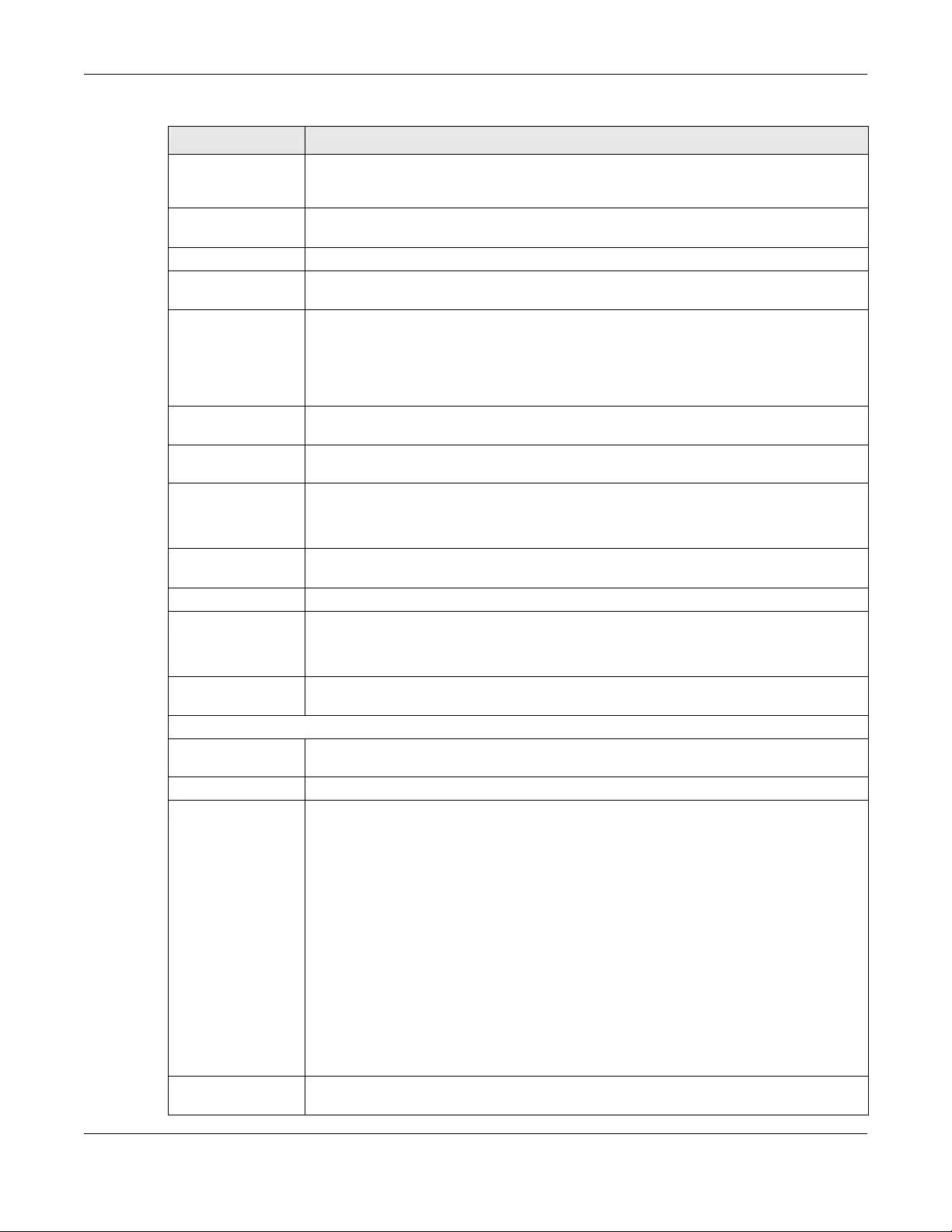
Chapter 35 Object
ZyWALL/USG Series User’s Guide
589
Primary /
Secondary Radius
Server Activate
Select this to have the ZyWALL/USG use the specified RADIUS server.
Radius Server IP
Address
Enter the IP address of the RADIUS server to be used for authentication.
Radius Server Port Enter the port number of the RADIUS server to be used for authentication.
Radius Server
Secret
Enter the shared secret password of the RADIUS server to be used for authentication.
MAC Authentication Select this to use an external server or the ZyWALL/USG’s local database to
authenticate wireless clients by their MAC addresses. Users cannot get an IP address if
the MAC authentication fails.
An external server can use the wireless client’s account (username/password) or Calling
Station ID for MAC authentication. Configure the ones the external server uses.
Delimiter
(Account) Select the separator the external server uses for the two-character pairs within account
MAC addresses.
Case (Account) Select the case (upper or lower) the external server requires for letters in the account
MAC addresses.
Delimiter
(Calling Station
ID)
RADIUS servers can require the MAC address in the Calling Station ID RADIUS attribute.
Select the separator the external server uses for the pairs in calling station MAC
addresses.
Case (Calling
Station ID) Select the case (upper or lower) the external server requires for letters in the calling
station MAC addresses.
802.1X Select this to enable 802.1x secure authentication.
Auth. Method This field is available only when you set the RADIUS server type to Internal.
Select an authentication method if you have created any in the Configuration >
Object > Auth. Method screen.
Reauthenticatio
n Timer Enter the interval (in seconds) between authentication requests. Enter a 0 for unlimited
requests.
The following fields are available if you set Security Mode to wep.
Idle Timeout Enter the idle interval (in seconds) that a client can be idle before authentication is
discontinued.
Authentication Type Select a WEP authentication method. Choices are Open or Share key.
Key Length Select the bit-length of the encryption key to be used in WEP connections.
If you select WEP-64:
• Enter 10 hexadecimal digits in the range of “A-F”, “a-f” and “0-9” (for example,
0x11AA22BB33) for each Key used.
or
• Enter 5 ASCII characters (case sensitive) ranging from “a-z”, “A-Z” and “0-9” (for
example, MyKey) for each Key used.
If you select WEP-128:
• Enter 26 hexadecimal digits in the range of “A-F”, “a-f” and “0-9” (for example,
0x00112233445566778899AABBCC) for each Key used.
or
• Enter 13 ASCII characters (case sensitive) ranging from “a-z”, “A-Z” and “0-9” (for
example, MyKey12345678) for each Key used.
Key 1~4 Based on your Key Length selection, enter the appropriate length hexadecimal or
ASCII key.
Table 249 Configuration > Object > AP Profile > SSID > Security Profile > Add/Edit Security Profile
LABEL DESCRIPTION
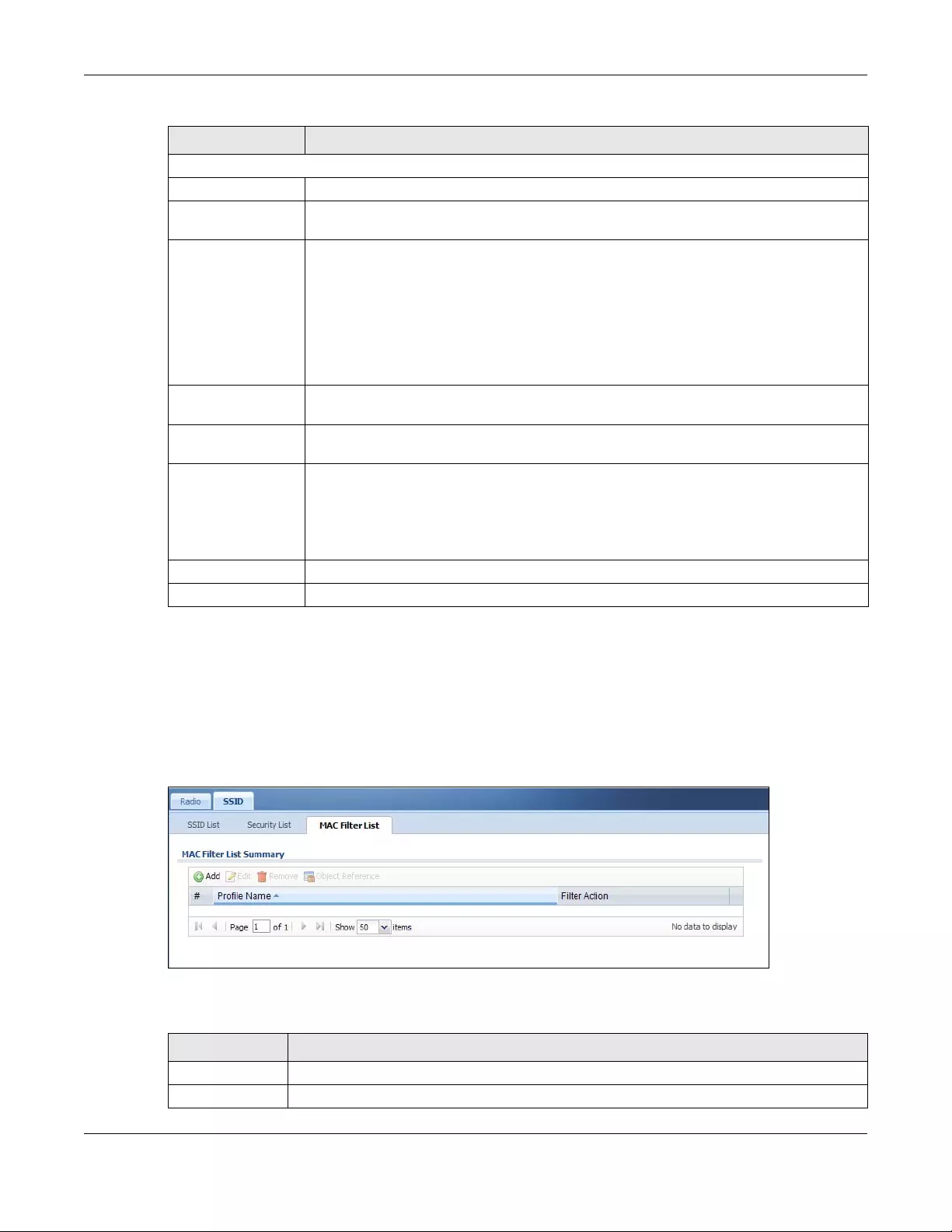
Chapter 35 Object
ZyWALL/USG Series User’s Guide
590
35.3.2.4 MAC Filter List
This screen allows you to create and manage security configurations that can be used by your
SSIDs. To access this screen click Configuration > Object > AP Profile > SSID > MAC Filter
List.
Note: You can have a maximum of 32 MAC filtering profiles on the ZyWALL/USG.
Figure 392 Configuration > Object > AP Profile > SSID > MAC Filter List
The following table describes the labels in this screen.
The following fields are available if you set Security Mode to wpa, wpa2 or wpa2-mix.
PSK Select this option to use a Pre-Shared Key with WPA encryption.
Pre-Shared Key Enter a pre-shared key of between 8 and 63 case-sensitive ASCII characters (including
spaces and symbols) or 64 hexadecimal characters.
Cipher Type Select an encryption cipher type from the list.
•auto - This automatically chooses the best available cipher based on the cipher in
use by the wireless client that is attempting to make a connection.
•tkip - This is the Temporal Key Integrity Protocol encryption method added later to
the WEP encryption protocol to further secure. Not all wireless clients may support
this.
•aes - This is the Advanced Encryption Standard encryption method. It is a more
recent development over TKIP and considerably more robust. Not all wireless clients
may support this.
Idle Timeout Enter the idle interval (in seconds) that a client can be idle before authentication is
discontinued.
Group Key Update
Timer
Enter the interval (in seconds) at which the AP updates the group WPA encryption key.
Pre-Authentication This field is available only when you set Security Mode to wpa2 or wpa2-mix and
enable 802.1x authentication.
Enable or Disable pre-authentication to allow the AP to send authentication
information to other APs on the network, allowing connected wireless clients to switch
APs without having to re-authenticate their network connection.
OK Click OK to save your changes back to the ZyWALL/USG.
Cancel Click Cancel to exit this screen without saving your changes.
Table 249 Configuration > Object > AP Profile > SSID > Security Profile > Add/Edit Security Profile
LABEL DESCRIPTION
Table 250 Configuration > Object > AP Profile > SSID > MAC Filter List
LABEL DESCRIPTION
Add Click this to add a new MAC filtering profile.
Edit Click this to edit the selected MAC filtering profile.
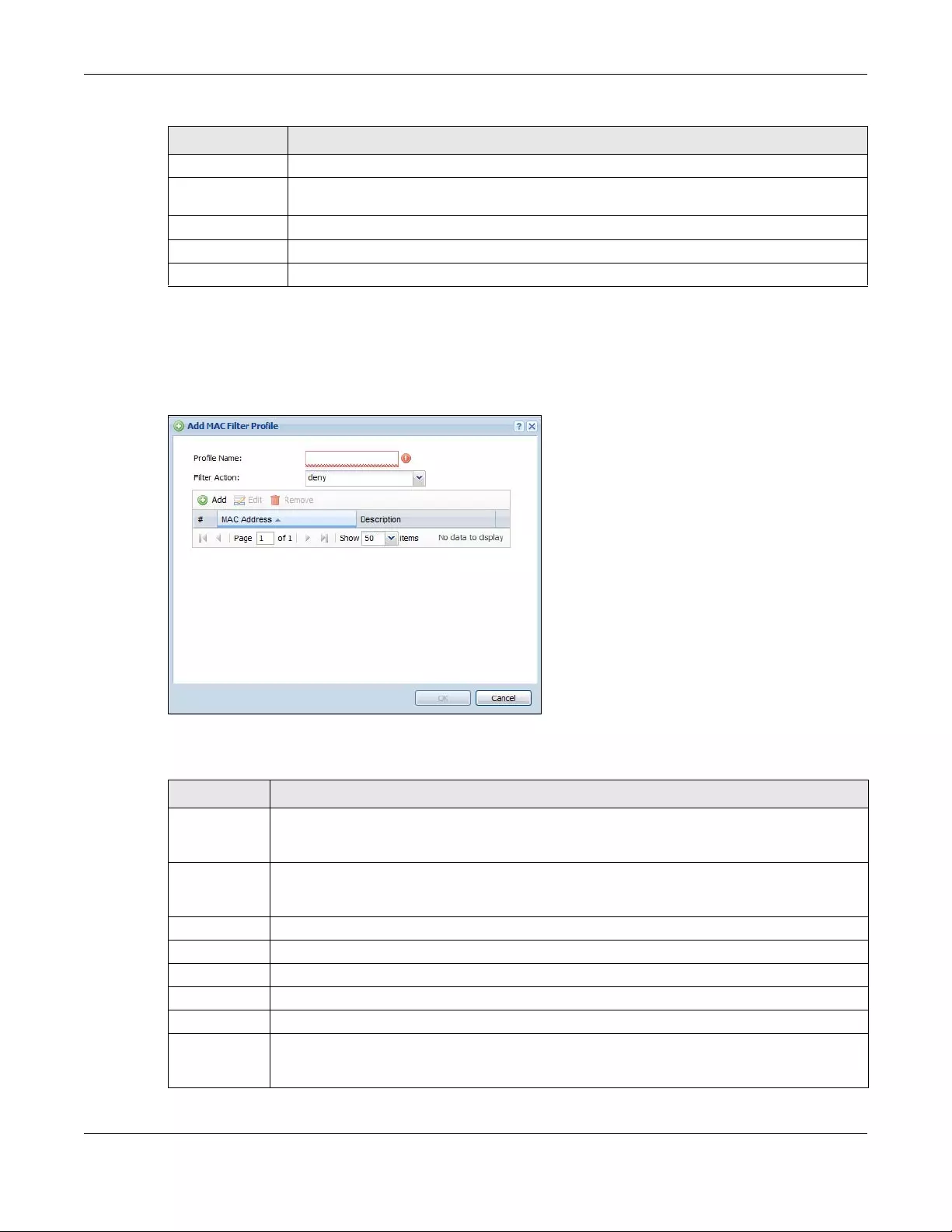
Chapter 35 Object
ZyWALL/USG Series User’s Guide
591
35.3.2.4.1 Add/Edit MAC Filter Profile
This screen allows you to create a new MAC filtering profile or edit an existing one. To access this
screen, click the Add button or select a MAC filter profile from the list and click the Edit button.
Figure 393 SSID > MAC Filter List > Add/Edit MAC Filter Profile
The following table describes the labels in this screen.
Remove Click this to remove the selected MAC filtering profile.
Object Reference Click this to view which other objects are linked to the selected MAC filtering profile (for
example, SSID profile).
# This field is a sequential value, and it is not associated with a specific profile.
Profile Name This field indicates the name assigned to the MAC filtering profile.
Filter Action This field indicates this profile’s filter action (if any).
Table 250 Configuration > Object > AP Profile > SSID > MAC Filter List (continued)
LABEL DESCRIPTION
Table 251 SSID > MAC Filter List > Add/Edit MAC Filter Profile
LABEL DESCRIPTION
Profile Name Enter up to 31 alphanumeric characters for the profile name. This name is only visible in the
Web Configurator and is only for management purposes. Spaces and underscores are
allowed.
Filter Action Select allow to permit the wireless client with the MAC addresses in this profile to connect to
the network through the associated SSID; select deny to block the wireless clients with the
specified MAC addresses.
Add Click this to add a MAC address to the profile’s list.
Edit Click this to edit the selected MAC address in the profile’s list.
Remove Click this to remove the selected MAC address from the profile’s list.
# This field is a sequential value, and it is not associated with a specific profile.
MAC Address This field specifies a MAC address associated with this profile.
Description This field displays a description for the MAC address associated with this profile. You can click
the description to make it editable. Enter up to 60 characters, spaces and underscores
allowed.

Chapter 35 Object
ZyWALL/USG Series User’s Guide
592
35.4 MON Profile
35.4.1 Overview
This screen allows you to set up monitor mode configurations that allow your connected APs to scan
for other wireless devices in the vicinity. Once detected, you can use the MON Mode screen
(Section 8.4 on page 166) to classify them as either rogue or friendly and then manage them
accordingly.
35.4.1.1 What You Can Do in this Chapter
The MON Profile screen (Section 35.4.2 on page 592) creates preset monitor mode configurations
that can be used by the APs.
35.4.1.2 What You Need To Know
The following terms and concepts may help as you read this chapter.
Active Scan
An active scan is performed when an 802.11-compatible wireless monitoring device is explicitly
triggered to scan a specified channel or number of channels for other wireless devices broadcasting
on the 802.11 frequencies by sending probe request frames.
Passive Scan
A passive scan is performed when an 802.11-compatible monitoring device is set to periodically
listen to a specified channel or number of channels for other wireless devices broadcasting on the
802.11 frequencies.
35.4.2 MON Profile
This screen allows you to create monitor mode configurations that can be used by the APs. To
access this screen, login to the Web Configurator, and click Configuration > Object > MON
Profile.
OK Click OK to save your changes back to the ZyWALL/USG.
Cancel Click Cancel to exit this screen without saving your changes.
Table 251 SSID > MAC Filter List > Add/Edit MAC Filter Profile (continued)
LABEL DESCRIPTION
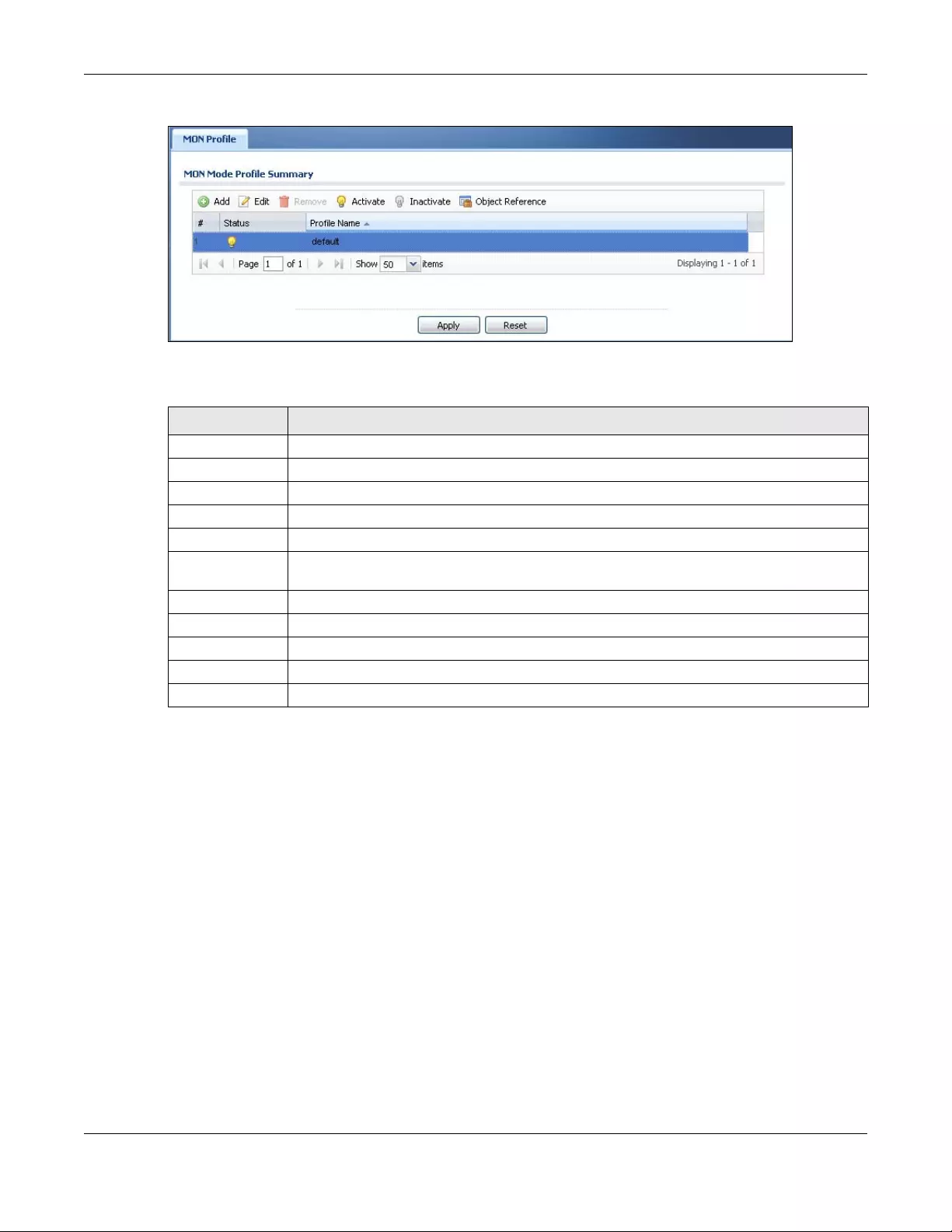
Chapter 35 Object
ZyWALL/USG Series User’s Guide
593
Figure 394 Configuration > Object > MON Profile
The following table describes the labels in this screen.
35.4.2.1 Add/Edit MON Profile
This screen allows you to create a new monitor mode profile or edit an existing one. To access this
screen, click the Add button or select and existing monitor mode profile and click the Edit button.
Table 252 Configuration > Object > MON Profile
LABEL DESCRIPTION
Add Click this to add a new monitor mode profile.
Edit Click this to edit the selected monitor mode profile.
Remove Click this to remove the selected monitor mode profile.
Activate To turn on an entry, select it and click Activate.
Inactivate To turn off an entry, select it and click Inactivate.
Object Reference Click this to view which other objects are linked to the selected monitor mode profile (for
example, an AP management profile).
# This field is a sequential value, and it is not associated with a specific user.
Status This icon is lit when the entry is active and dimmed when the entry is inactive.
Profile Name This field indicates the name assigned to the monitor profile.
Apply Click Apply to save your changes back to the ZyWALL/USG.
Reset Click Reset to return the screen to its last-saved settings.

Chapter 35 Object
ZyWALL/USG Series User’s Guide
594
Figure 395 Configuration > Object > MON Profile > Add/Edit MON Profile
The following table describes the labels in this screen.
Table 253 Configuration > Object > MON Profile > Add/Edit MON Profile
LABEL DESCRIPTION
Activate Select this to activate this monitor mode profile.
Profile Name This field indicates the name assigned to the monitor mode profile.
Channel dwell time Enter the interval (in milliseconds) before the AP switches to another channel for
monitoring.
Scan Channel Mode Select auto to have the AP switch to the next sequential channel once the Channel
dwell time expires.
Select manual to set specific channels through which to cycle sequentially when the
Channel dwell time expires. Selecting this options makes the Scan Channel List
options available.
Set Scan Channel
List (2.4 GHz)
Move a channel from the Available channels column to the Channels selected
column to have the APs using this profile scan that channel when Scan Channel Mode
is set to manual.
These channels are limited to the 2 GHz range (802.11 b/g/n).
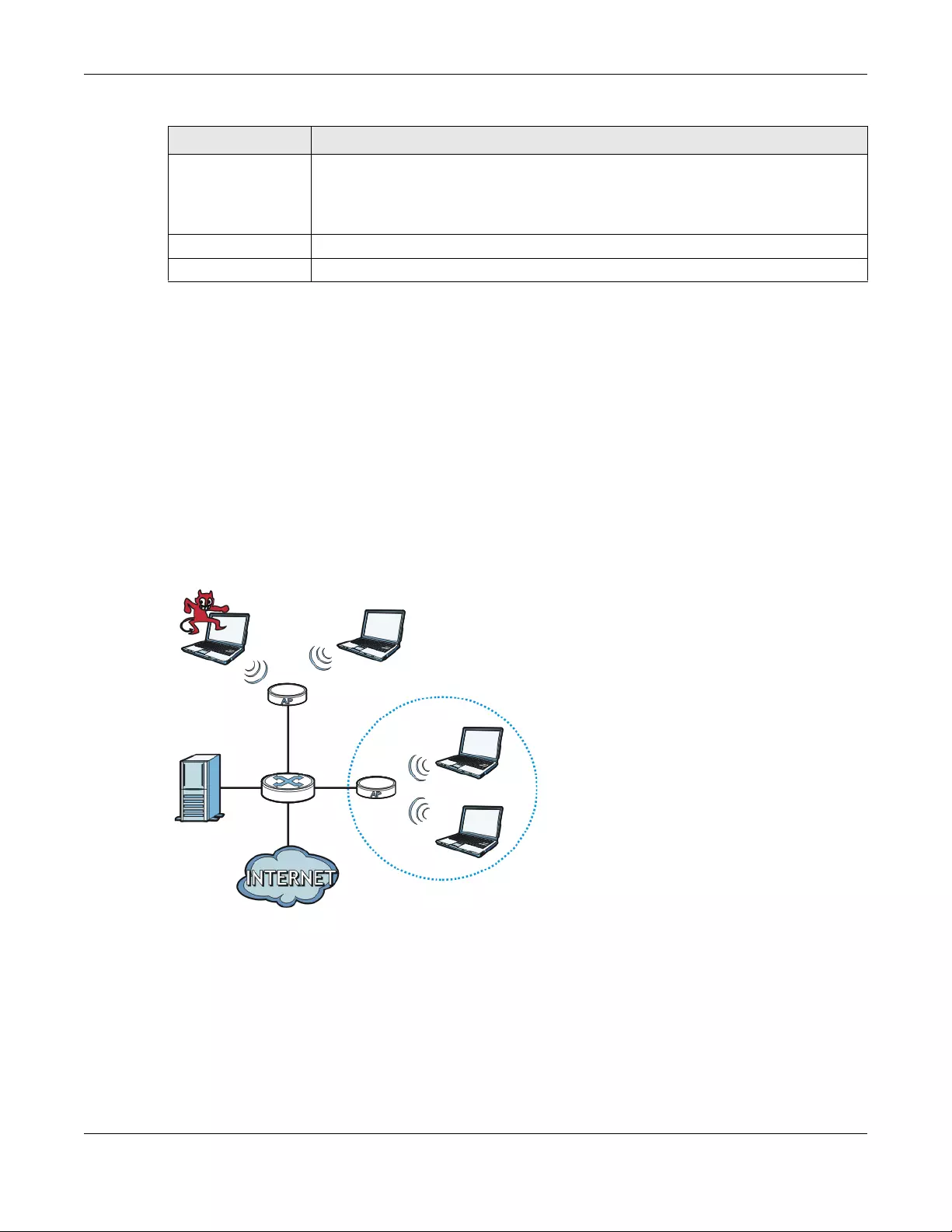
Chapter 35 Object
ZyWALL/USG Series User’s Guide
595
35.4.3 Technical Reference
The following section contains additional technical information about the features described in this
chapter.
Rogue APs
Rogue APs are wireless access points operating in a network’s coverage area that are not under the
control of the network’s administrators, and can open up holes in a network’s security. Attackers
can take advantage of a rogue AP’s weaker (or non-existent) security to gain access to the network,
or set up their own rogue APs in order to capture information from wireless clients. If a scan reveals
a rogue AP, you can use commercially-available software to physically locate it.
Figure 396 Rogue AP Example
In the example above, a corporate network’s security is compromised by a rogue AP (RG) set up by
an employee at his workstation in order to allow him to connect his notebook computer wirelessly
(A). The company’s legitimate wireless network (the dashed ellipse B) is well-secured, but the
rogue AP uses inferior security that is easily broken by an attacker (X) running readily available
encryption-cracking software. In this example, the attacker now has access to the company
network, including sensitive data stored on the file server (C).
Set Scan Channel
List (5 GHz)
Move a channel from the Available channels column to the Channels selected
column to have the APs using this profile scan that channel when Scan Channel Mode
is set to manual.
These channels are limited to the 5 GHz range (802.11 a/n).
OK Click OK to save your changes back to the ZyWALL/USG.
Cancel Click Cancel to exit this screen without saving your changes.
Table 253 Configuration > Object > MON Profile > Add/Edit MON Profile (continued)
LABEL DESCRIPTION
A
B
C
RG
X
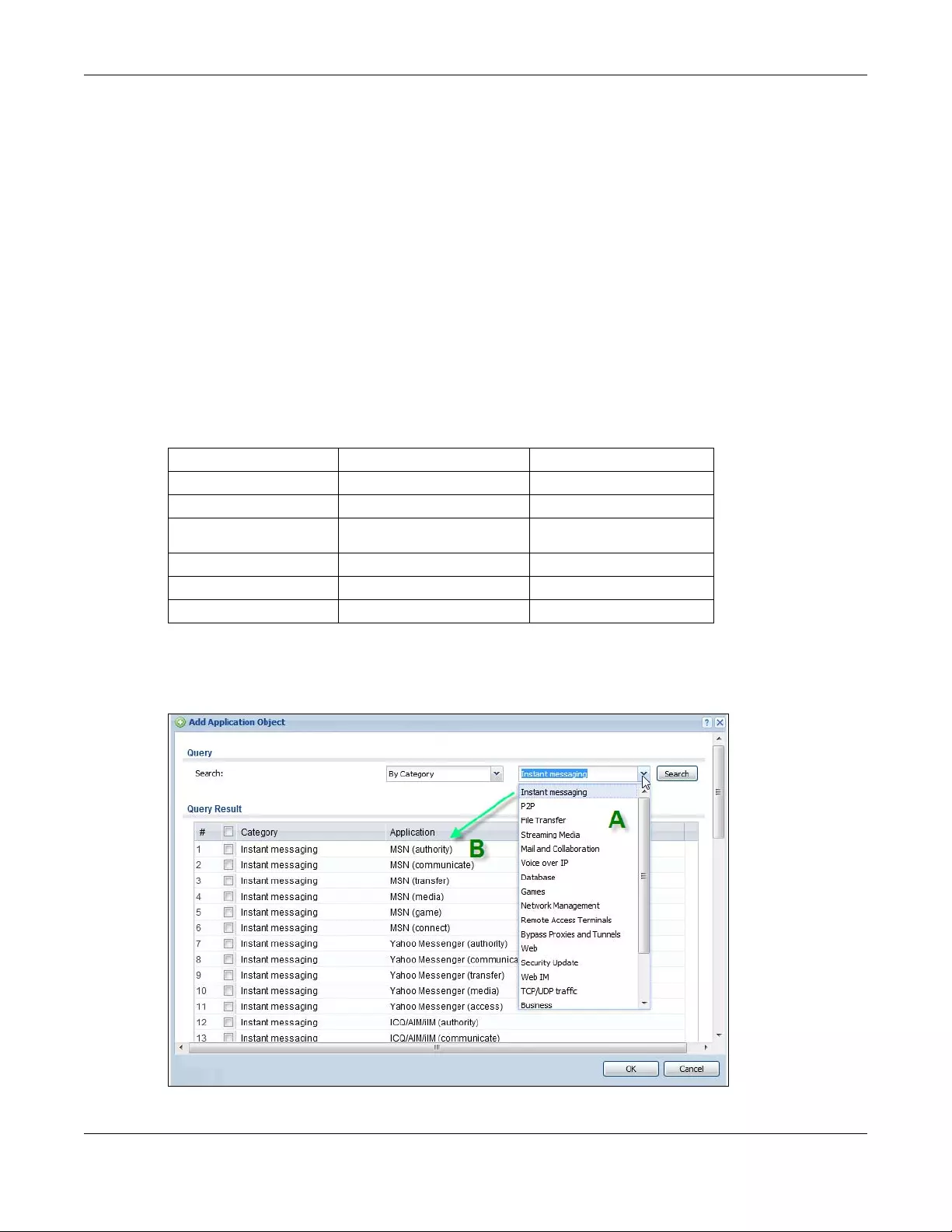
Chapter 35 Object
ZyWALL/USG Series User’s Guide
596
Friendly APs
If you have more than one AP in your wireless network, you should also configure a list of “friendly”
APs. Friendly APs are other wireless access points that are detected in your network, as well as any
others that you know are not a threat (those from recognized networks, for example). It is
recommended that you export (save) your list of friendly APs often, especially if you have a
network with a large number of access points.
35.5 Application
Go to Configuration > Licensing > Signature Update > IDP/AppPatrol to check that you
have the latest IDP and App Patrol signatures. These signatures are available to create application
objects in Configuration > Object > Application > Application. Categories of applications
include (at the time of writing):
The following table shows the types of categories currently supported (A) and the associated
signatures for each category (B).
Figure 397 Application Categories and Associated Signatures
Table 254 Categories of Applications
• Instant Messaging • P2P • File Transfer
• Streaming Media • Mail and Collaboration • Voice over IP
• Database • Games • Network Management
• Remote Access
Terminals • Bypass Proxies and
Tunnels •Web
•Security Update •Web IM •TCP/UDP traffic
• Business • Network Protocols • Mobile
• Private Protocol • Social Network •
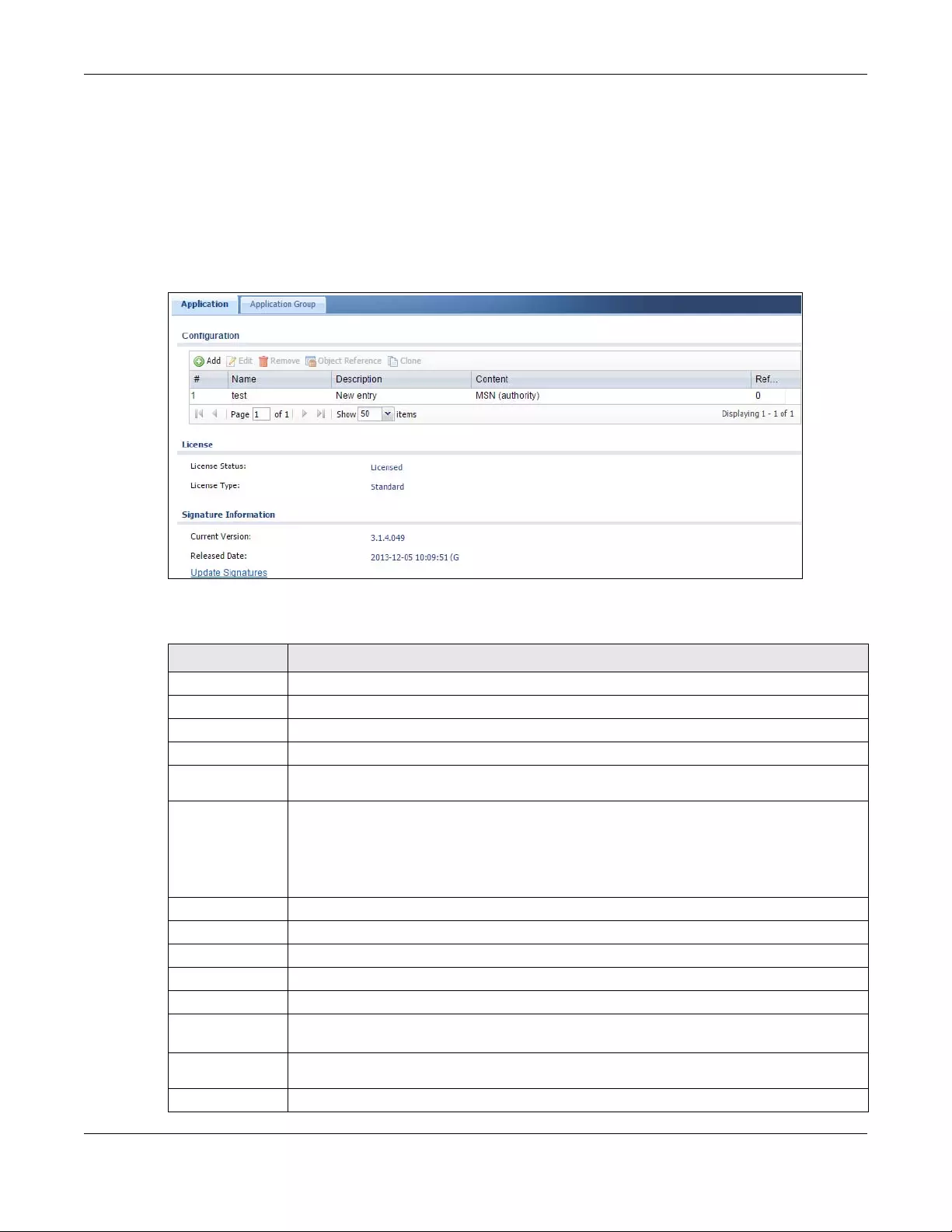
Chapter 35 Object
ZyWALL/USG Series User’s Guide
597
•Use the Application screen (Section on page 597) to create application objects that can be
used in App Patrol profiles.
•Use the Application Group screen (Section 35.5.2 on page 601) to group application objects as
an individual object that can be used in App Patrol profiles.
The Application screen allows you to create application objects consisting of service signatures as
well as view license and signature information. To access this screen click Configuration > Object
> Application > Application.
Figure 398 Configuration > Object > Application > Application
The following table describes the labels in this screen.
Table 255 Configuration > Object > Application > Application
LABEL DESCRIPTION
Configuration
Add Click this to add a new application object.
Edit Click this to edit the selected application object.
Remove Click this to remove the selected application object.
Object
Reference Click this to view which other objects are linked to the selected application object.
Clone Use Clone to create a new entry by modifying an existing one.
• Select an existing entry.
•Click Clone.
• A configuration copy of the selected entry pops up. You must at least change the name
as duplicate entry names are not allowed.
# This field is a sequential value associated with an application object..
Name This field indicates the name assigned to the application object.
Description This field shows some extra information on the application object.
Content This field shows the application signature(s) in this application object.
Reference This displays the number of times an object reference is used in a profile.
License You need to buy a license or use a trial license in order to use IDP/AppPatrol signatures.
These fields show license-related information.
License
Status This field shows whether you have activated an IDP/AppPatrol signatures license
License Type This field shows the type of IDP/AppPatrol signatures license you have activated
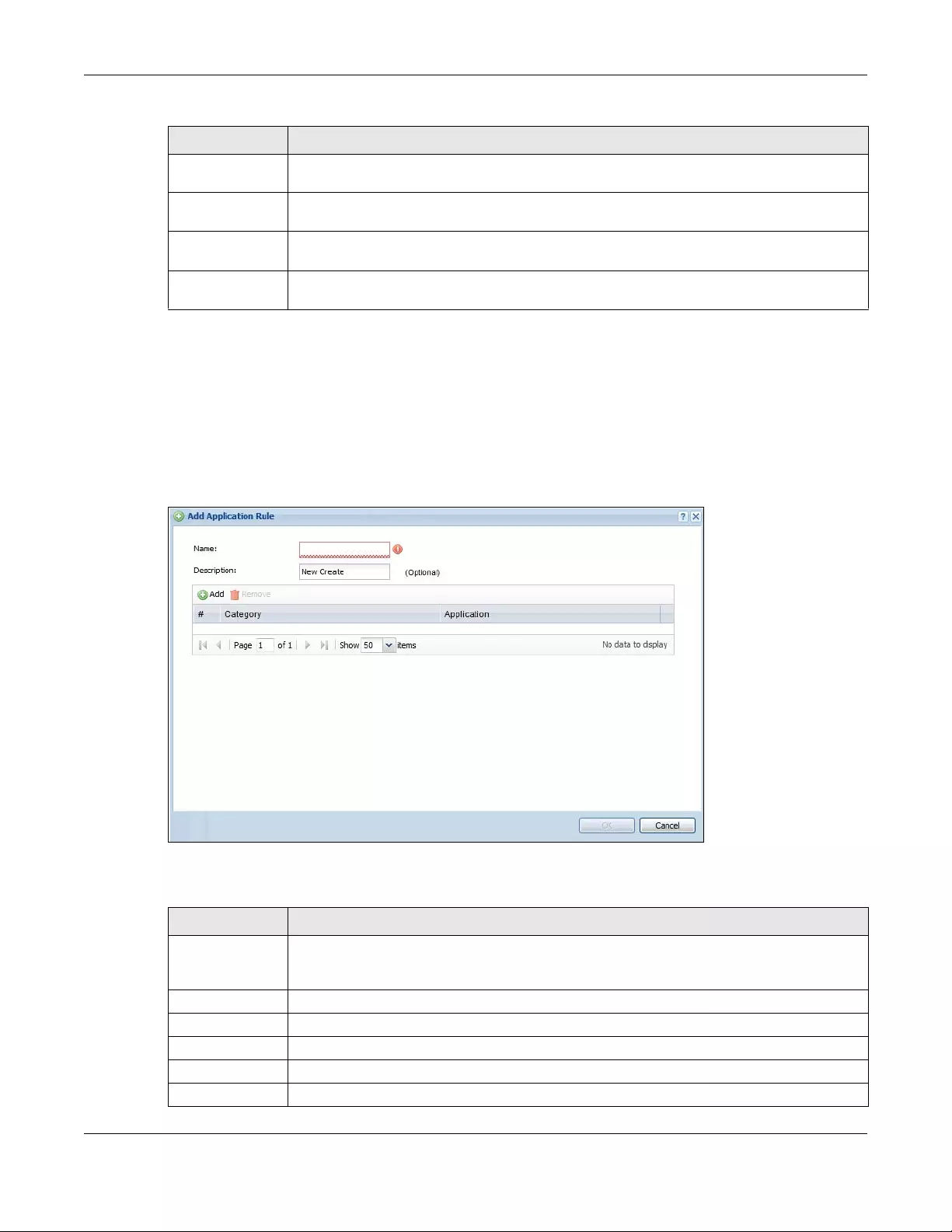
Chapter 35 Object
ZyWALL/USG Series User’s Guide
598
35.5.1 Add Application Rule
Click Add in Configuration > Object > Application > Application to create a new application
rule. In the first screen you type a name to identify this application object and write an optional
brief description of it.
You then click Add again to choose the signatures that should go into this object.
Figure 399 Configuration > Object > Application > Application > Add Application Rule
The following table describes the labels in this screen.
Signature
Information
An activated license allows you to download signatures to the ZyWALL/USG from
myZyXEL.com. These fields show details on the signatures downloaded.
Current
Version The version number increments when signatures are updated at myZyXEL.com. This field
shows the current version downloaded to the ZyWALL/USG.
Released
Date This field shows the date (YYYY-MM-DD) and time the current signature version was
released.
Update
Signatures If your signature set is not the most recent, click this to go to Configuration > Licensing >
Signature Update > IDP / AppPatrol to update your signatures.
Table 255 Configuration > Object > Application > Application (continued)
LABEL DESCRIPTION
Table 256 Configuration > Object > Application > Application > Add Application Rule
LABEL DESCRIPTION
Name Type a name to identify this application rule. You may use 1-31 alphanumeric characters,
underscores(_), or dashes (-), but the first character cannot be a number. This value is
case-sensitive.
Description You may type some extra information on the application object here.
Add Click this to create a new application rule.
Remove Click this to remove the selected application rule.
# This field is a sequential value associated with this application rule..
Category This field shows the category to which the signature belongs in this application rule.
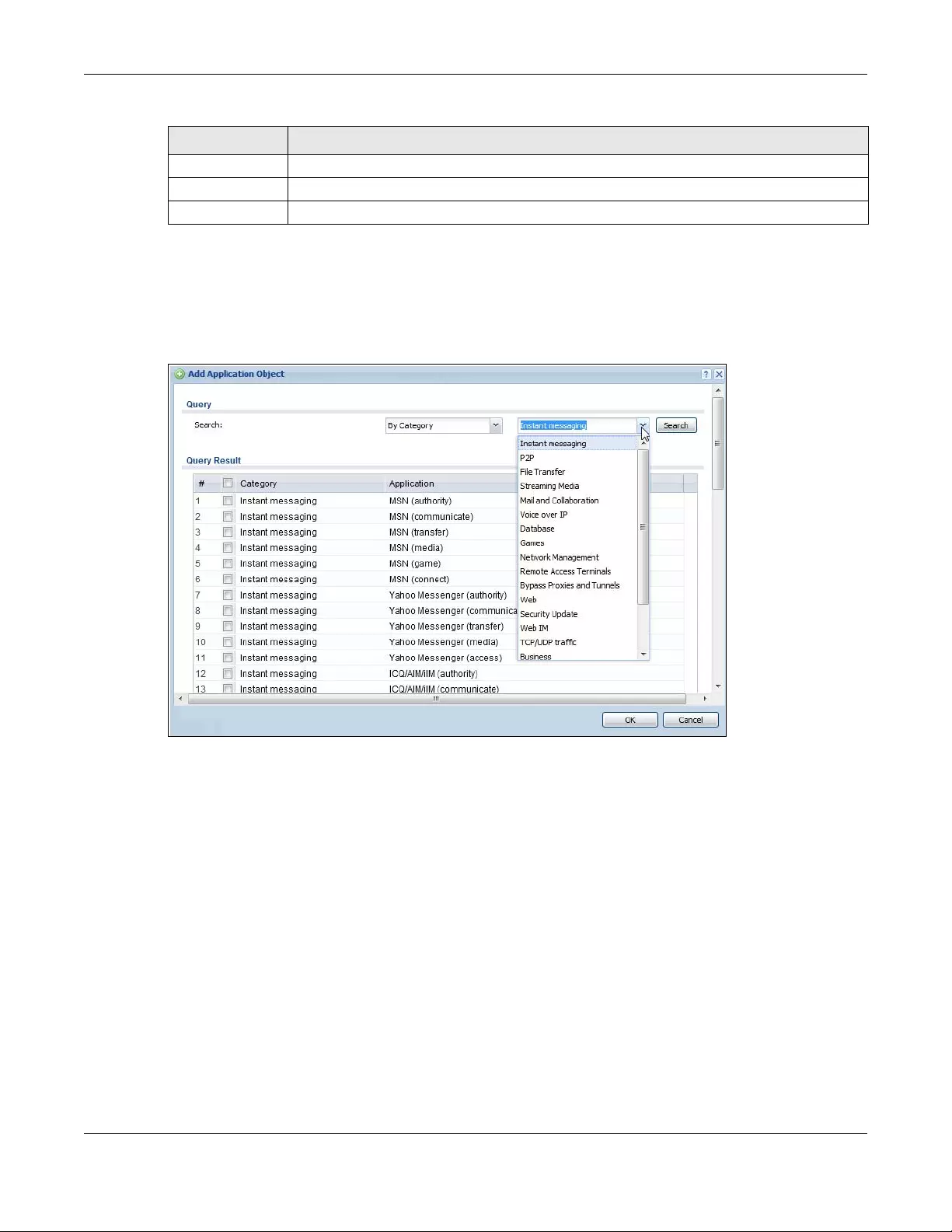
Chapter 35 Object
ZyWALL/USG Series User’s Guide
599
35.5.1.1 Add Application Object by Category or Service
Click Add in Configurat ion > Object > Application > Application > Add Application Rule to
choose the signatures that should go into this object.
Figure 400 Configuration > Object > Application > Application > Add Application Rule > Add By
Category
Application This displays the name of the application signature used in this application rule.
OK Click OK to save your changes back to the ZyWALL/USG.
Cancel Click Cancel to exit this screen without saving your changes.
Table 256 Configuration > Object > Application > Application (continued)> Add Application Rule
LABEL DESCRIPTION
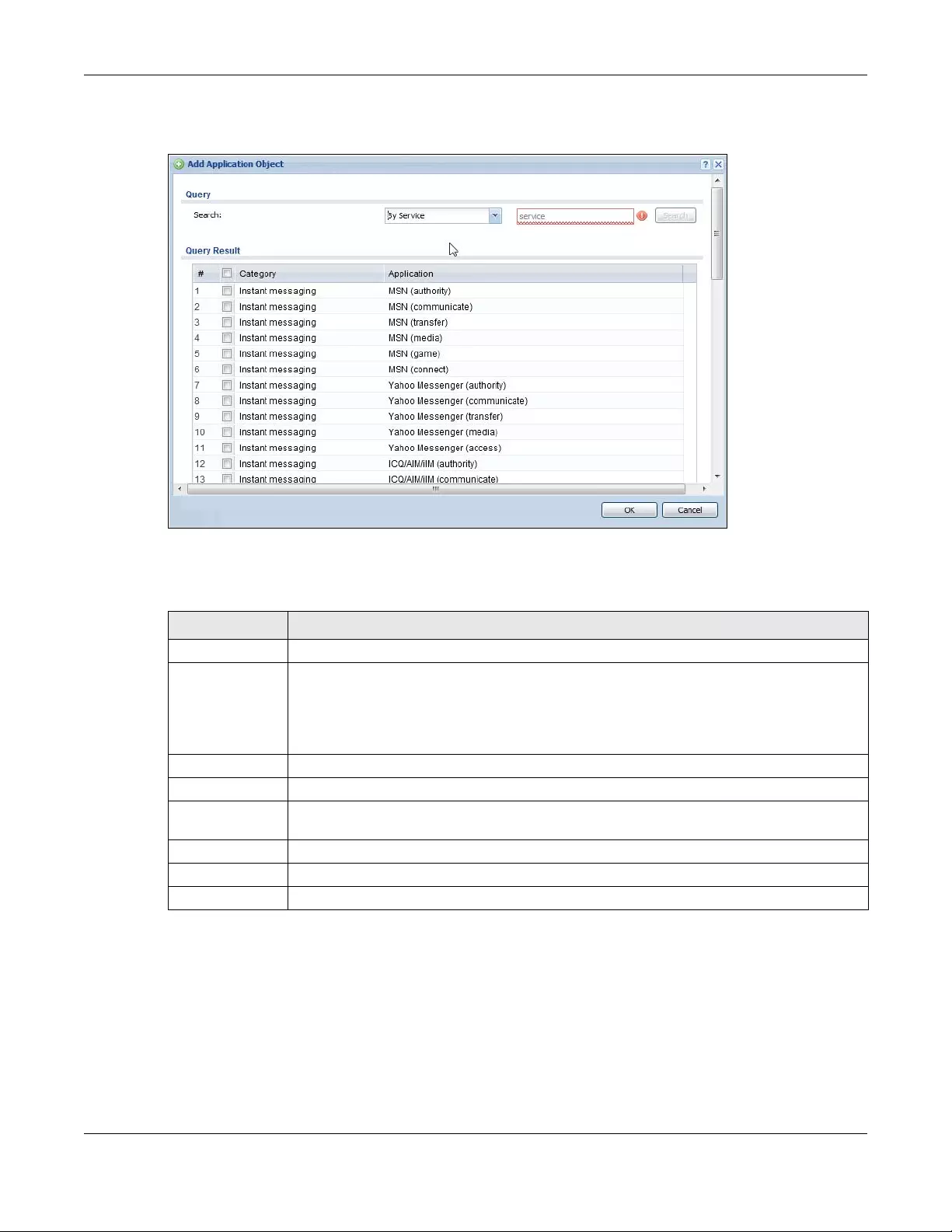
Chapter 35 Object
ZyWALL/USG Series User’s Guide
600
Figure 401 Configuration > Object > Application > Application > Add Application Rule > Add By
Service
The following table describes the labels in this screen.
Table 257 Configuration > Object > Application > Application > Add Application Rule > Add
Application Object
LABEL DESCRIPTION
Query
Search Choose signatures in one of the following ways:
• Select By Cat e gory then select a category in the adjacent drop-down list box to
display all signatures of that category
• Select By Service, type a keyword and click Search to display all signatures
containing that keyword.
Query Result The results of the search are displayed here.
# This field is a sequential value associated with this signature
Category This field shows the category to which the signature belongs. Select the checkbox to add
this signature to the application object.
Application This displays the name of the application signature.
OK Click OK to save your changes back to the ZyWALL/USG.
Cancel Click Cancel to exit this screen without saving your changes.
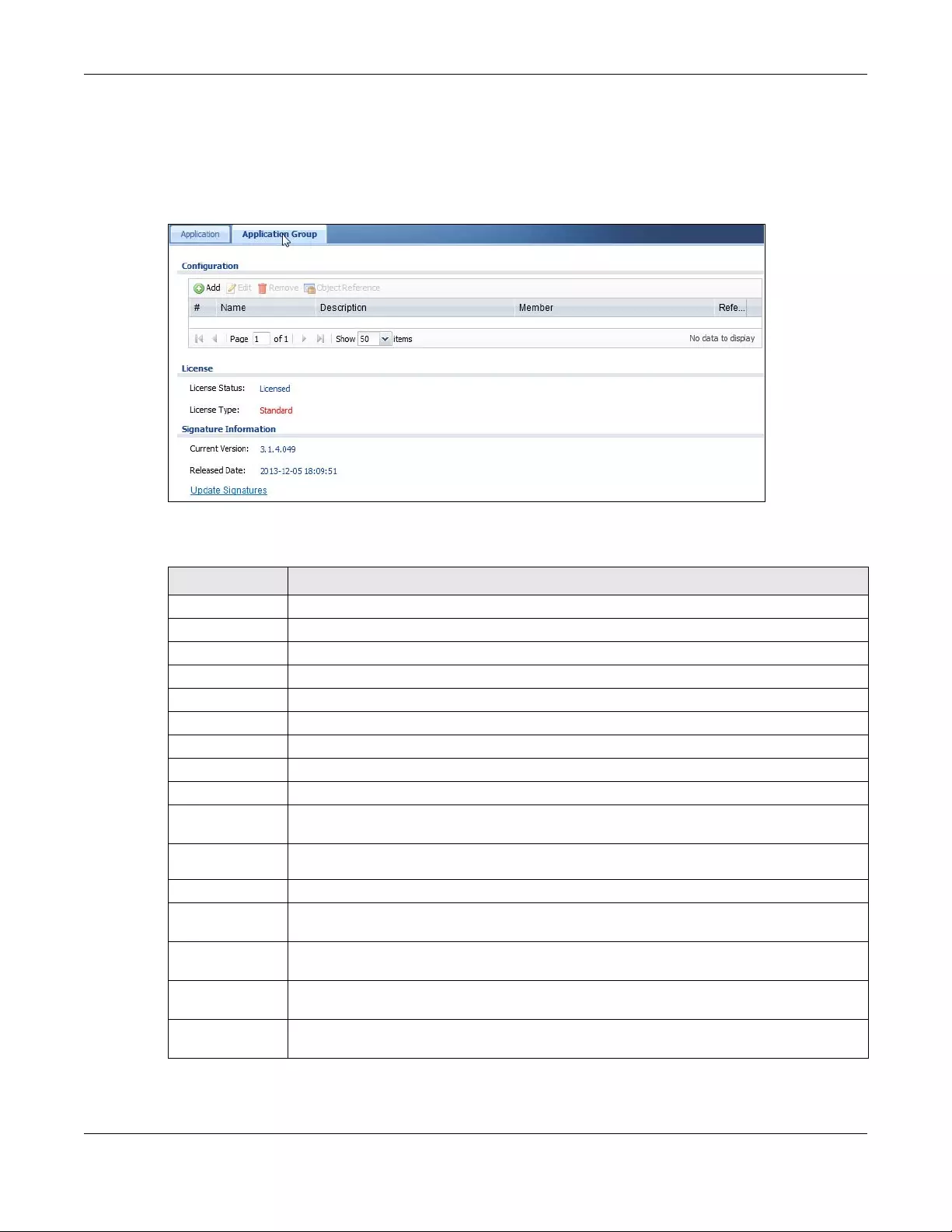
Chapter 35 Object
ZyWALL/USG Series User’s Guide
601
35.5.2 Application Group Screen
This screen allows you to group individual application objects to be treated as a single application
object. To access this screen click Configuration > Object > Application > Application Group.
Figure 402 Configuration > Object > Application > Application Group
The following table describes the labels in this screen.
Table 258 Configuration > Object > Application > Application Group
LABEL DESCRIPTION
Add Click this to add a new application group.
Edit Click this to edit the selected application group.
Remove Click this to remove the selected application group.
Object Reference Click this to view which other objects are linked to the selected application group.
# This field is a sequential value associated with an application group..
Name This field indicates the name assigned to the application group.
Description You may type some extra information on the application group here.
Member This field shows the application objects in this application group.
Reference This displays the number of times an object reference is used in a profile.
License You need to buy a license or use a trial license in order to use IDP/AppPatrol signatures.
These fields show license-related information.
License
Status This field shows whether you have activated an IDP/AppPatrol signatures license
License Type This field shows the type of IDP/AppPatrol signatures license you have activated
Signature
Information
An activated license allows you to download signatures to the ZyWALL/USG from
myZyXEL.com. These fields show details on the signatures downloaded.
Current
Version The version number increments when signatures are updated at myZyXEL.com. This field
shows the current version downloaded to the ZyWALL/USG.
Released
Date This field shows the date (YYYY-MM-DD) and time the current signature version was
released.
Update
Signatures If your signature set is not the most recent, click this to go to Configuration > Licensing
> Signature Update > IDP / AppPatrol to update your signatures.
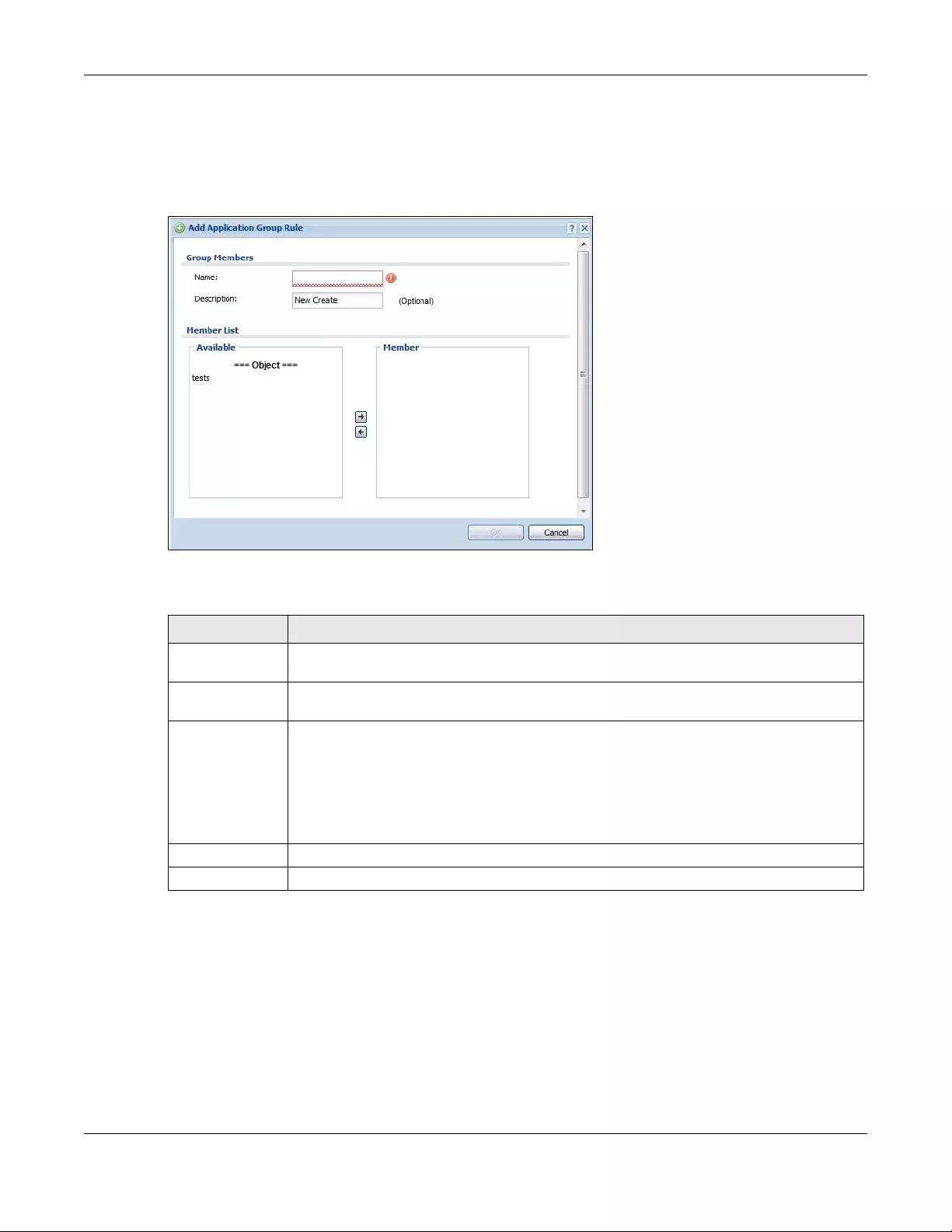
Chapter 35 Object
ZyWALL/USG Series User’s Guide
602
35.5.2.1 Add Application Group Rule
Click Add in Configurat ion > Object > Application > Application Group to select already
created application rules and combine them as a single new rule.
Figure 403 Configuration > Object > Application > Application > Add Application Group Rule
The following table describes the labels in this screen.
35.6 Address Overview
Address objects can represent a single IP address or a range of IP addresses. Address groups are
composed of address objects and other address groups.
•The Address screen (Section 35.6.2 on page 603) provides a summary of all addresses in the
ZyWALL/USG. Use the Address Add/Edit screen to create a new address or edit an existing
one.
Table 259 Configuration > Object > Application > Application > Add Application Group Rule
LABEL DESCRIPTION
Name Enter a name for the group. You may use 1-31 alphanumeric characters, underscores(_),
or dashes (-), but the first character cannot be a number. This value is case-sensitive.
Description This field displays the description of each group, if any. You can use up to 60 characters,
punctuation marks, and spaces.
Member List The Member list displays the names of the application and application group objects that
have been added to the application group. The order of members is not important.
Select items from the Available list that you want to be members and move them to the
Member list. You can double-click a single entry to move it or use the [Shift] or [Ctrl] key
to select multiple entries and use the arrow button to move them.
Move any members you do not want included to the Available list.
OK Click OK to save your changes back to the ZyWALL/USG.
Cancel Click Cancel to exit this screen without saving your changes.
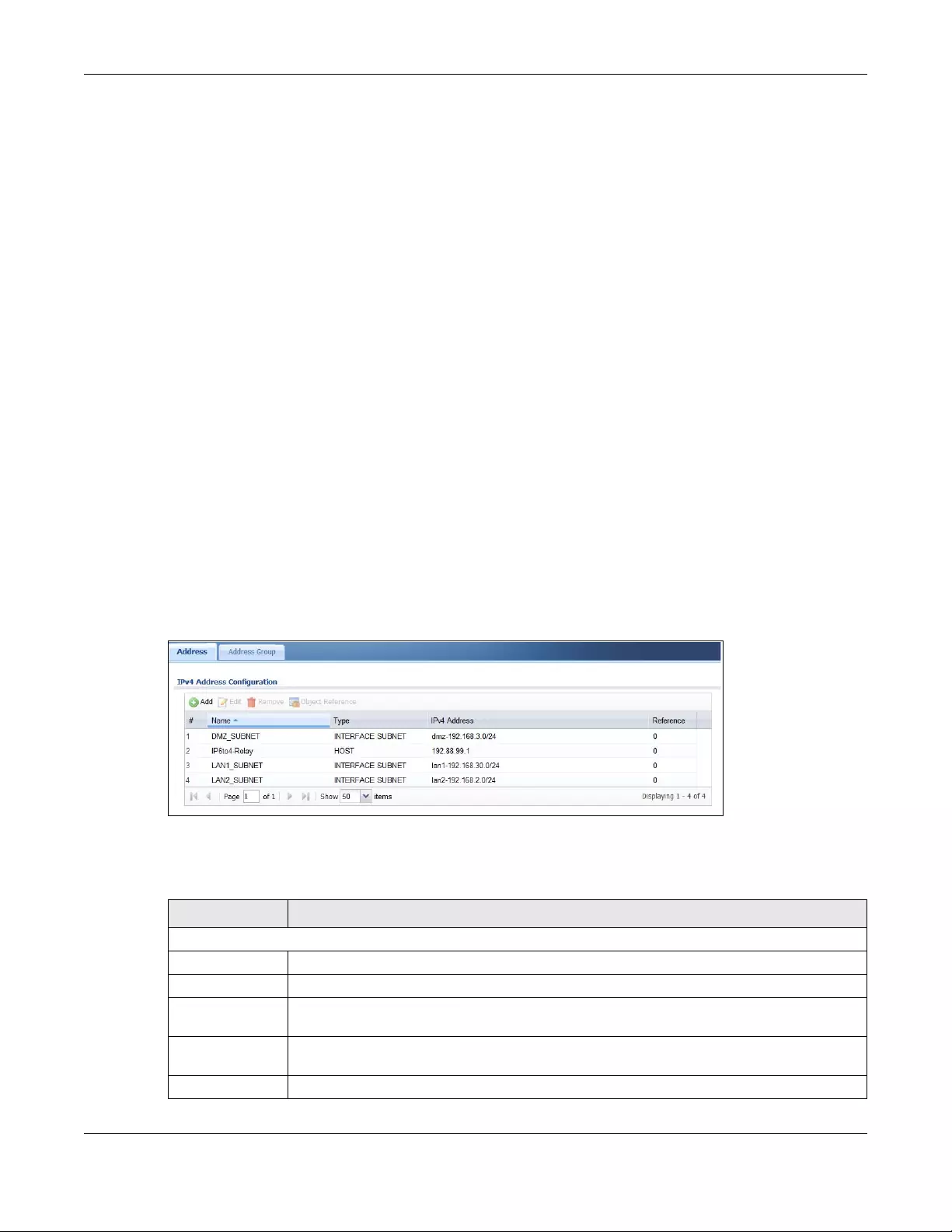
Chapter 35 Object
ZyWALL/USG Series User’s Guide
603
•Use the Address Group summary screen (Section 35.6.2.3 on page 606) and the Address
Group Add/Edit screen, to maintain address groups in the ZyWALL/USG.
35.6.1 What You Need To Know
Address objects and address groups are used in dynamic routes, security policies, application
patrol, content filtering, and VPN connection policies. For example, addresses are used to specify
where content restrictions apply in content filtering. Please see the respective sections for more
information about how address objects and address groups are used in each one.
Address groups are composed of address objects and address groups. The sequence of members in
the address group is not important.
35.6.2 Address Summary Screen
The address screens are used to create, maintain, and remove addresses. There are the types of
address objects.
•HOST - a host address is defined by an IP Address.
•RANGE - a range address is defined by a Starting IP Address and an Ending IP Address.
•SUBNET - a network address is defined by a Network IP address and Netmask subnet mask.
The Address screen provides a summary of all addresses in the ZyWALL/USG. To access this
screen, click Configuration > Object > Address > Ad dress. Click a column’s heading cell to sort
the table entries by that column’s criteria. Click the heading cell again to reverse the sort order.
Figure 404 Configuration > Object > Address > Address
The following table describes the labels in this screen. See Section 35.6.2.1 on page 604 for more
information as well.
Table 260 Configuration > Object > Address > Address
LABEL DESCRIPTION
IPv4 Address Configuration
Add Click this to create a new entry.
Edit Double-click an entry or select it and click Edit to be able to modify the entry’s settings.
Remove To remove an entry, select it and click Remove. The ZyWALL/USG confirms you want to
remove it before doing so.
Object
References
Select an entry and click Object References to open a screen that shows which settings
use the entry.
# This field is a sequential value, and it is not associated with a specific address.
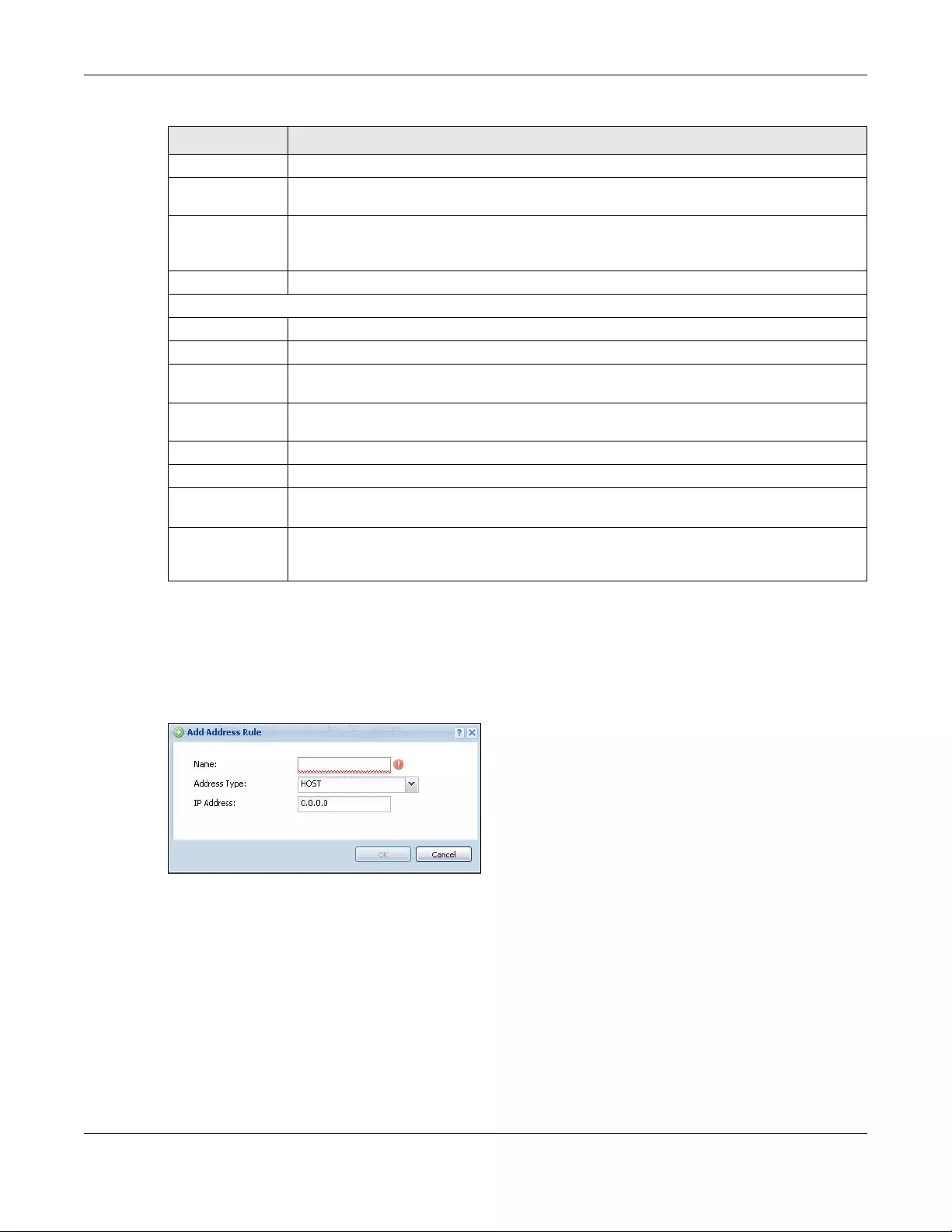
Chapter 35 Object
ZyWALL/USG Series User’s Guide
604
35.6.2.1 IPv4 Address Add/Edit Screen
The Configuration > IPv4 Address Add/Edit screen allows you to create a new address or edit
an existing one. To access this screen, go to the Address screen (see Section 35.6.2 on page 603),
and click either the Add icon or an Edit icon in the IPv4 Address Configuration section.
Figure 405 IPv4 Address Configuration > Add/Edit
Name This field displays the configured name of each address object.
Type This field displays the type of each address object. “INTERFACE” means the object uses
the settings of one of the ZyWALL/USG’s interfaces.
IPv4 Address This field displays the IPv4 addresses represented by each address object. If the object’s
settings are based on one of the ZyWALL/USG’s interfaces, the name of the interface
displays first followed by the object’s current address settings.
Reference This displays the number of times an object reference is used in a profile.
IPv6 Address Configuration
Add Click this to create a new entry.
Edit Double-click an entry or select it and click Edit to be able to modify the entry’s settings.
Remove To remove an entry, select it and click Remove. The ZyWALL/USG confirms you want to
remove it before doing so.
Object
References
Select an entry and click Object References to open a screen that shows which settings
use the entry.
# This field is a sequential value, and it is not associated with a specific address.
Name This field displays the configured name of each address object.
Type This field displays the type of each address object. “INTERFACE” means the object uses
the settings of one of the ZyWALL/USG’s interfaces.
IPv6 Address This field displays the IPv6 addresses represented by each address object. If the object’s
settings are based on one of the ZyWALL/USG’s interfaces, the name of the interface
displays first followed by the object’s current address settings.
Table 260 Configuration > Object > Address > Address (continued)
LABEL DESCRIPTION
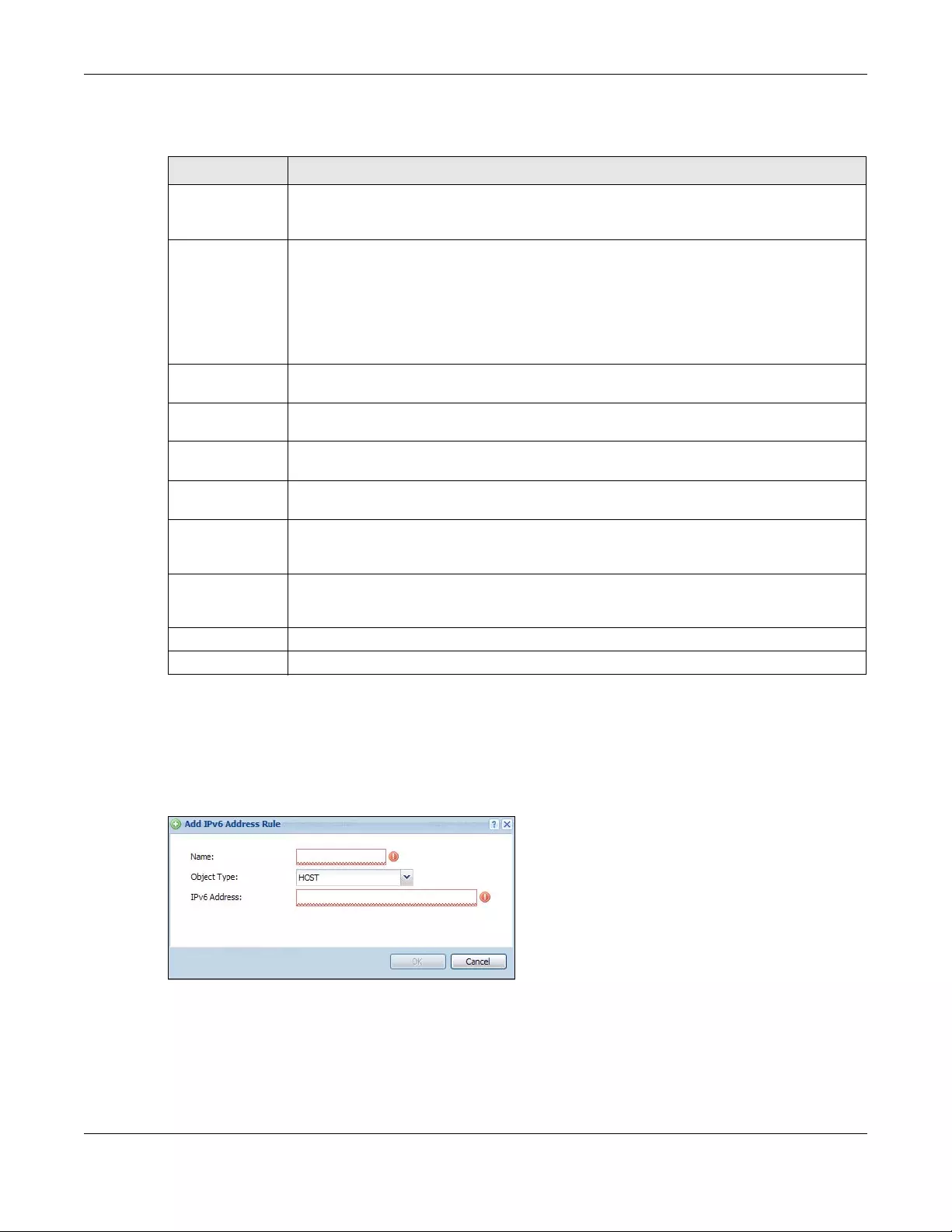
Chapter 35 Object
ZyWALL/USG Series User’s Guide
605
The following table describes the labels in this screen.
35.6.2.2 IPv6 Address Add/Edit Screen
The Configuration > IPv6 Address Add/Edit screen allows you to create a new address or edit
an existing one. To access this screen, go to the Address screen (see Section 35.6.2 on page 603),
and click either the Add icon or an Edit icon in the IPv6 Address Configuration section.
Figure 406 IPv6 Address Configuration > Add/Edit
Table 261 IPv4 Address Configuration > Add/Edit
LABEL DESCRIPTION
Name Type the name used to refer to the address. You may use 1-31 alphanumeric characters,
underscores(_), or dashes (-), but the first character cannot be a number. This value is
case-sensitive.
Address Type Select the type of address you want to create. Choices are: HOST, RANGE, SUBNET,
INTERFACE IP, INTERFACE SUBNET, and INTERFACE GATEWAY.
Note: The ZyWALL/USG automatically updates address objects that are based on an
interface’s IP address, subnet, or gateway if the interface’s IP address settings
change. For example, if you change 1’s IP address, the ZyWALL/USG automatically
updates the corresponding interface-based, LAN subnet address object.
IP Address This field is only available if the Address Type is HOST. This field cannot be blank. Enter
the IP address that this address object represents.
Starting IP
Address
This field is only available if the Address Type is RANGE. This field cannot be blank.
Enter the beginning of the range of IP addresses that this address object represents.
Ending IP
Address
This field is only available if the Address Type is RANGE. This field cannot be blank.
Enter the end of the range of IP address that this address object represents.
Network This field is only available if the Address Type is SUBNET, in which case this field cannot
be blank. Enter the IP address of the network that this address object represents.
Netmask This field is only available if the Address Type is SUBNET, in which case this field cannot
be blank. Enter the subnet mask of the network that this address object represents. Use
dotted decimal format.
Interface If you selected INTERFACE IP, INTERFACE SUBNET, or INTERFACE GATEWAY as the
Address Type, use this field to select the interface of the network that this address object
represents.
OK Click OK to save your changes back to the ZyWALL/USG.
Cancel Click Cancel to exit this screen without saving your changes.
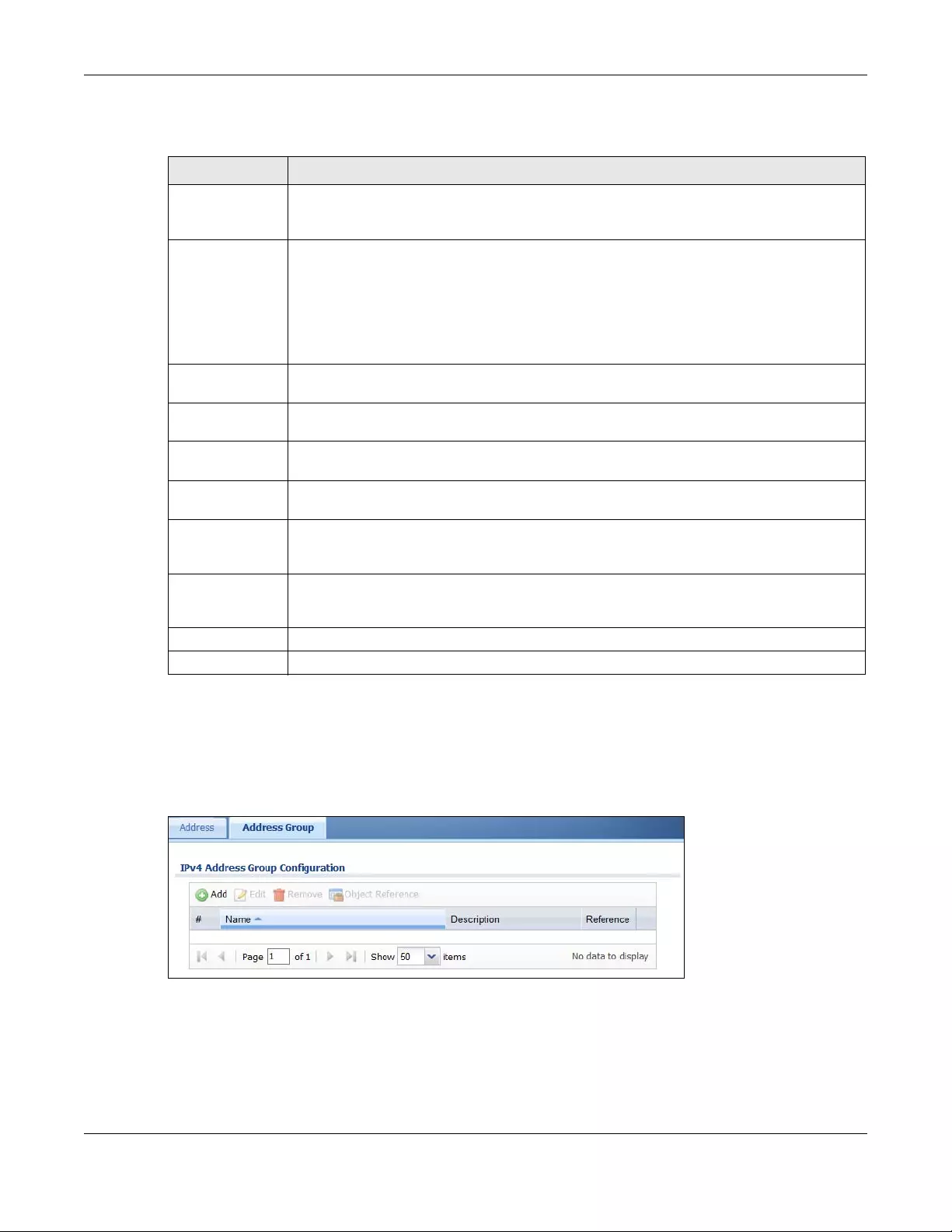
Chapter 35 Object
ZyWALL/USG Series User’s Guide
606
The following table describes the labels in this screen.
35.6.2.3 Address Group Summary Screen
The Address Group screen provides a summary of all address groups. To access this screen, click
Configuration > Object > Address > Address Group. Click a column’s heading cell to sort the
table entries by that column’s criteria. Click the heading cell again to reverse the sort order.
Figure 407 Configuration > Object > Address > Address Group
Table 262 IPv6 Address Configuration > Add/Edit
LABEL DESCRIPTION
Name Type the name used to refer to the address. You may use 1-31 alphanumeric characters,
underscores(_), or dashes (-), but the first character cannot be a number. This value is
case-sensitive.
Object Type Select the type of address you want to create. Choices are: HOST, RANGE, SUBNET,
INTERFACE IP, INTERFACE SUBNET, and INTERFACE GATEWAY.
Note: The ZyWALL/USG automatically updates address objects that are based on an
interface’s IP address, subnet, or gateway if the interface’s IP address settings
change. For example, if you change 1’s IP address, the ZyWALL/USG automatically
updates the corresponding interface-based, LAN subnet address object.
IPv6 Address This field is only available if the Address Type is HOST. This field cannot be blank. Enter
the IP address that this address object represents.
IPv6 Starting
Address
This field is only available if the Address Type is RANGE. This field cannot be blank.
Enter the beginning of the range of IP addresses that this address object represents.
IPv6 Ending
Address
This field is only available if the Address Type is RANGE. This field cannot be blank.
Enter the end of the range of IP address that this address object represents.
IPv6 Address
Prefix
This field is only available if the Address Type is SUBNET. This field cannot be blank.
Enter the IPv6 address prefix that the ZyWALL/USG uses for the LAN IPv6 address.
Interface If you selected INTERFACE IP, INTERFACE SUBNET, or INTERFACE GATEWAY as the
Address Type, use this field to select the interface of the network that this address object
represents.
IPv6 Address
Type
Select whether the IPv6 address is a link-local IP address (LINK LOCAL), static IP
address (STATIC), an IPv6 StateLess Address Auto Configuration IP address (SLAAC), or
is obtained from a DHCPv6 server (DHCPv6).
OK Click OK to save your changes back to the ZyWALL/USG.
Cancel Click Cancel to exit this screen without saving your changes.

Chapter 35 Object
ZyWALL/USG Series User’s Guide
607
The following table describes the labels in this screen. See Section 35.6.2.4 on page 607 for more
information as well.
35.6.2.4 Address Group Add/Edit Screen
The Address Group Add/Edit screen allows you to create a new address group or edit an existing
one. To access this screen, go to the Address Group screen (see Section 35.6.2.3 on page 606),
and click either the Add icon or an Edit icon in the IPv4 Address Grou p Configuration or IPv6
Address Group Configuration section.
Table 263 Configuration > Object > Address > Address Group
LABEL DESCRIPTION
IPv4 Address Group Configuration
Add Click this to create a new entry.
Edit Double-click an entry or select it and click Edit to be able to modify the entry’s settings.
Remove To remove an entry, select it and click Remove. The ZyWALL/USG confirms you want to
remove it before doing so.
Object
References
Select an entry and click Object References to open a screen that shows which settings
use the entry.
# This field is a sequential value, and it is not associated with a specific address group.
Name This field displays the name of each address group.
Description This field displays the description of each address group, if any.
Reference This displays the number of times an object reference is used in a profile.
IPv6 Address Group Configuration
Add Click this to create a new entry.
Edit Double-click an entry or select it and click Edit to be able to modify the entry’s settings.
Remove To remove an entry, select it and click Remove. The ZyWALL/USG confirms you want to
remove it before doing so.
Object
References
Select an entry and click Object References to open a screen that shows which settings
use the entry.
# This field is a sequential value, and it is not associated with a specific address group.
Name This field displays the name of each address group.
Description This field displays the description of each address group, if any.
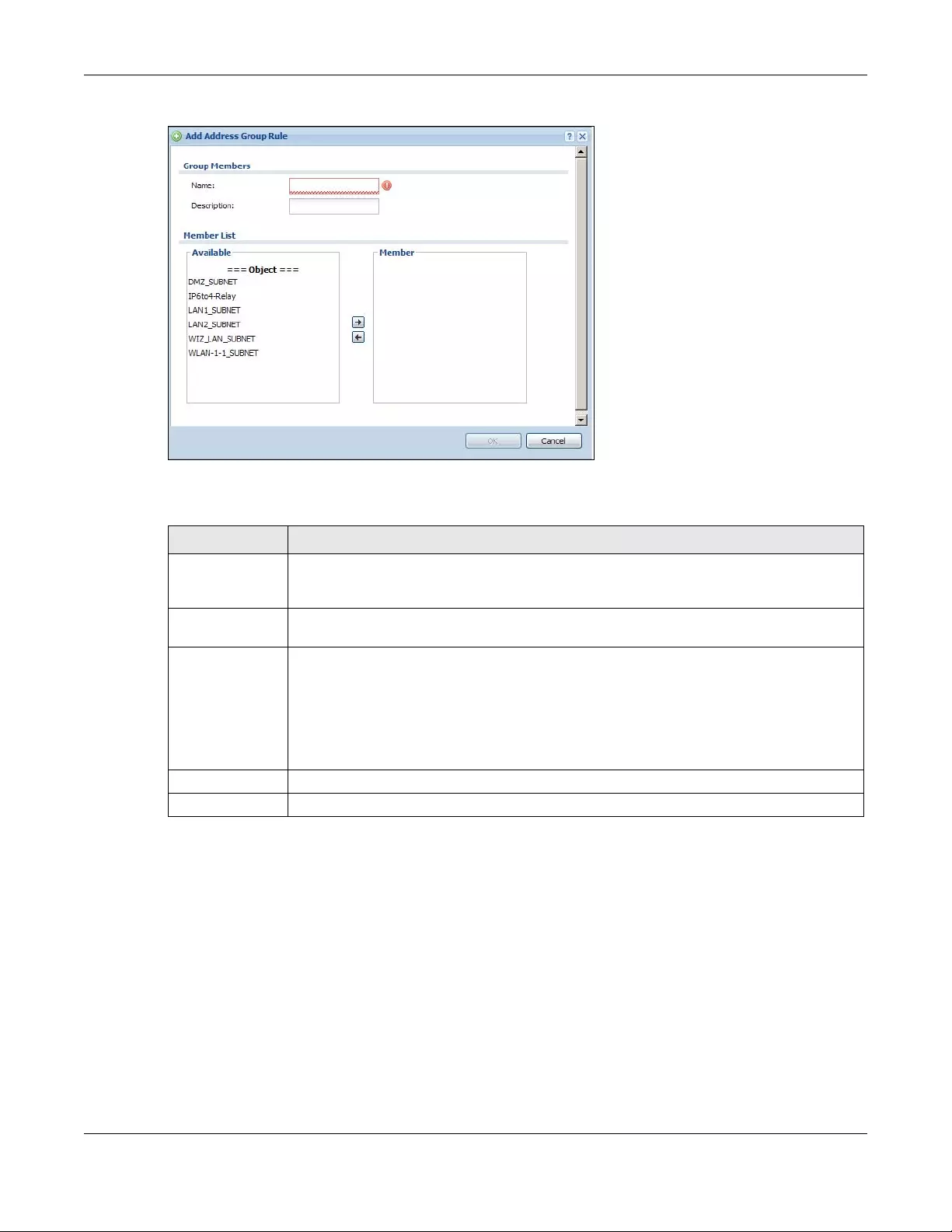
Chapter 35 Object
ZyWALL/USG Series User’s Guide
608
Figure 408 IPv4/IPv6 Address Group Configuration > Add
The following table describes the labels in this screen.
35.7 Service Overview
Use service objects to define TCP applications, UDP applications, and ICMP messages. You can also
create service groups to refer to multiple service objects in other features.
•Use the Service screens (Section 35.7.2 on page 609) to view and configure the ZyWALL/USG’s
list of services and their definitions.
•Use the Service Group screens (Section 35.7.2 on page 609) to view and configure the
ZyWALL/USG’s list of service groups.
Table 264 IPv4/IPv6 Address Group Configuration > Add
LABEL DESCRIPTION
Name Enter a name for the address group. You may use 1-31 alphanumeric characters,
underscores(_), or dashes (-), but the first character cannot be a number. This value is
case-sensitive.
Description This field displays the description of each address group, if any. You can use up to 60
characters, punctuation marks, and spaces.
Member List The Member list displays the names of the address and address group objects that have
been added to the address group. The order of members is not important.
Select items from the Available list that you want to be members and move them to the
Member list. You can double-click a single entry to move it or use the [Shift] or [Ctrl] key
to select multiple entries and use the arrow button to move them.
Move any members you do not want included to the Available list.
OK Click OK to save your changes back to the ZyWALL/USG.
Cancel Click Cancel to exit this screen without saving your changes.

Chapter 35 Object
ZyWALL/USG Series User’s Guide
609
35.7.1 What You Need to Know
IP Protoc ols
IP protocols are based on the eight-bit protocol field in the IP header. This field represents the next-
level protocol that is sent in this packet. This section discusses three of the most common IP
protocols.
Computers use Transmission Control Protocol (TCP, IP protocol 6) and User Datagram Protocol
(UDP, IP protocol 17) to exchange data with each other. TCP guarantees reliable delivery but is
slower and more complex. Some uses are FTP, HTTP, SMTP, and TELNET. UDP is simpler and faster
but is less reliable. Some uses are DHCP, DNS, RIP, and SNMP.
TCP creates connections between computers to exchange data. Once the connection is established,
the computers exchange data. If data arrives out of sequence or is missing, TCP puts it in sequence
or waits for the data to be re-transmitted. Then, the connection is terminated.
In contrast, computers use UDP to send short messages to each other. There is no guarantee that
the messages arrive in sequence or that the messages arrive at all.
Both TCP and UDP use ports to identify the source and destination. Each port is a 16-bit number.
Some port numbers have been standardized and are used by low-level system processes; many
others have no particular meaning.
Unlike TCP and UDP, Internet Control Message Protocol (ICMP, IP protocol 1) is mainly used to send
error messages or to investigate problems. For example, ICMP is used to send the response if a
computer cannot be reached. Another use is ping. ICMP does not guarantee delivery, but networks
often treat ICMP messages differently, sometimes looking at the message itself to decide where to
send it.
Service Objects and Service Groups
Use service objects to define IP protocols.
• TCP applications
• UDP applications
• ICMP messages
• user-defined services (for other types of IP protocols)
These objects are used in policy routes, security policies, and IDP profiles.
Use service groups when you want to create the same rule for several services, instead of creating
separate rules for each service. Service groups may consist of services and other service groups.
The sequence of members in the service group is not important.
35.7.2 The Service Summary Screen
The Service summary screen provides a summary of all services and their definitions. In addition,
this screen allows you to add, edit, and remove services.
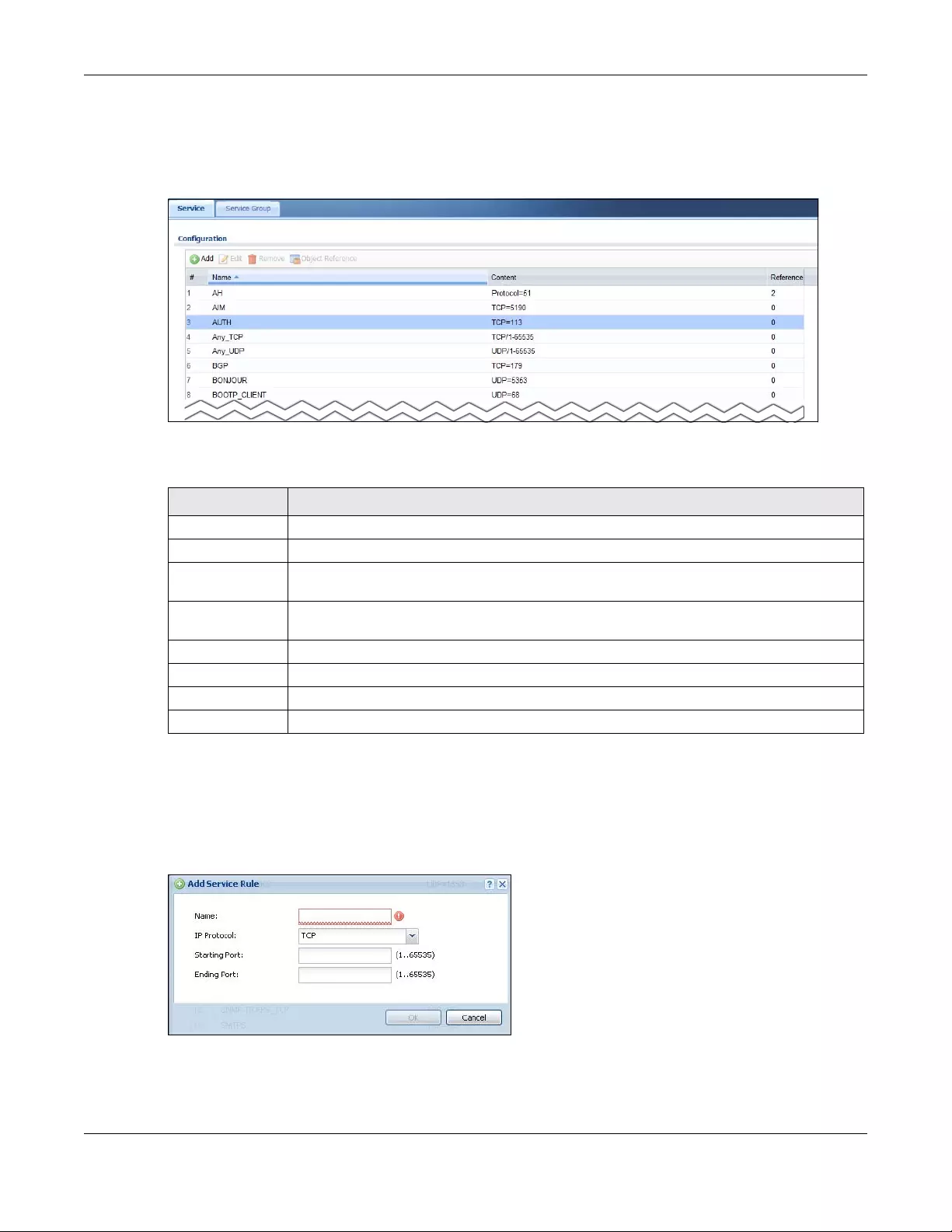
Chapter 35 Object
ZyWALL/USG Series User’s Guide
610
To access this screen, log in to the Web Configurator, and click Configuration > Object > Service
> Service. Click a column’s heading cell to sort the table entries by that column’s criteria. Click the
heading cell again to reverse the sort order.
Figure 409 Configuration > Object > Service > Service
The following table describes the labels in this screen.
35.7.2.1 The Service Add/Edit Screen
The Se rvice Add/Edit screen allows you to create a new service or edit an existing one. To access
this screen, go to the Service screen (see Section 35.7.2 on page 609), and click either the Add
icon or an Edit icon.
Figure 410 Configuration > Object > Service > Service > Edit
Table 265 Configuration > Object > Service > Service
LABEL DESCRIPTION
Add Click this to create a new entry.
Edit Double-click an entry or select it and click Edit to be able to modify the entry’s settings.
Remove To remove an entry, select it and click Remove. The ZyWALL/USG confirms you want to
remove it before doing so.
Object
References
Select an entry and click Object References to open a screen that shows which settings
use the entry.
# This field is a sequential value, and it is not associated with a specific service.
Name This field displays the name of each service.
Content This field displays a description of each service.
Reference This displays the number of times an object reference is used in a profile.
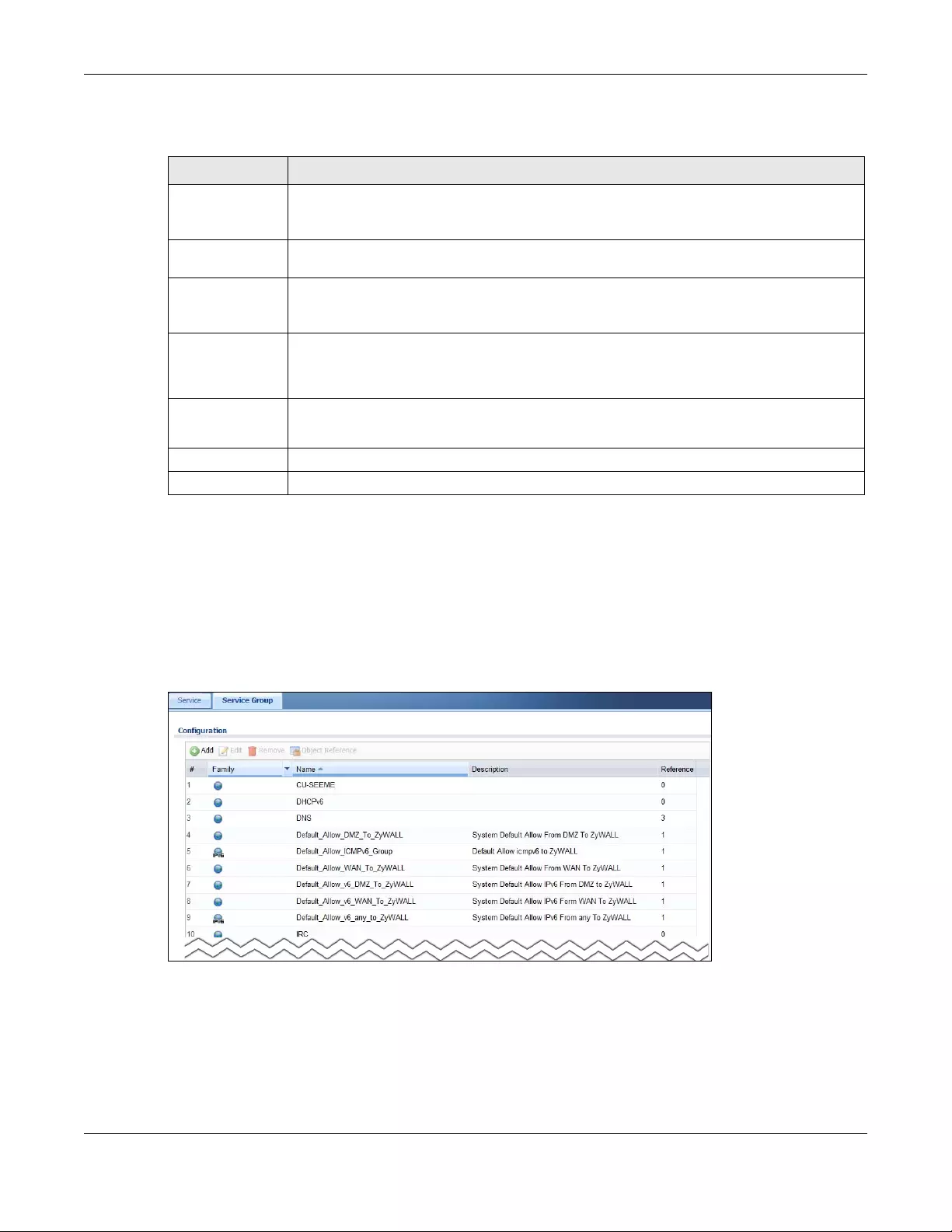
Chapter 35 Object
ZyWALL/USG Series User’s Guide
611
The following table describes the labels in this screen.
35.7.3 The Service Group Summary Screen
The Service Group summary screen provides a summary of all service groups. In addition, this
screen allows you to add, edit, and remove service groups.
To access this screen, log in to the Web Configurator, and click Configuration > Object > Service
> Service Group.
Figure 411 Configuration > Object > Service > Service Group
Table 266 Configuration > Object > Service > Service > Edit
LABEL DESCRIPTION
Name Type the name used to refer to the service. You may use 1-31 alphanumeric characters,
underscores(_), or dashes (-), but the first character cannot be a number. This value is
case-sensitive.
IP Protocol Select the protocol the service uses. Choices are: TCP, UDP, ICMP, ICMPv6, and User
Defined.
Starting Port
Ending Port
This field appears if the IP Protocol is TCP or UDP. Specify the port number(s) used by
this service. If you fill in one of these fields, the service uses that port. If you fill in both
fields, the service uses the range of ports.
ICMP Type This field appears if the IP Protocol is ICMP or ICMPv6.
Select the ICMP message used by this service. This field displays the message text, not
the message number.
IP Protocol
Number
This field appears if the IP Protocol is User Defined.
Enter the number of the next-level protocol (IP protocol). Allowed values are 1 - 255.
OK Click OK to save your changes back to the ZyWALL/USG.
Cancel Click Cancel to exit this screen without saving your changes.

Chapter 35 Object
ZyWALL/USG Series User’s Guide
612
The following table describes the labels in this screen. See Section 35.7.3.1 on page 612 for more
information as well.
35.7.3.1 The Service Group Add/Edit Screen
The Service Group Add/Edit screen allows you to create a new service group or edit an existing
one. To access this screen, go to the Service Gro up screen (see Section 35.7.3 on page 611), and
click either the Add icon or an Edit icon.
Figure 412 Configuration > Object > Service > Service Group > Edit
Table 267 Configuration > Object > Service > Service Group
LABEL DESCRIPTION
Add Click this to create a new entry.
Edit Double-click an entry or select it and click Edit to be able to modify the entry’s settings.
Remove To remove an entry, select it and click Remove. The ZyWALL/USG confirms you want to
remove it before doing so.
Object
References
Select an entry and click Object References to open a screen that shows which settings
use the entry.
# This field is a sequential value, and it is not associated with a specific service group.
Family This field displays the Server Group supported type, which is according to your
configurations in the Service Group Add/Edit screen.
There are 3 types of families:
• : Supports IPv4 only
• : Supports IPv6 only
• : Supports both IPv4 and IPv6
Name This field displays the name of each service group.
By default, the ZyWALL/USG uses services starting with “Default_Allow_” in the security
policies to allow certain services to connect to the ZyWALL/USG.
Description This field displays the description of each service group, if any.
Reference This displays the number of times an object reference is used in a profile.

Chapter 35 Object
ZyWALL/USG Series User’s Guide
613
The following table describes the labels in this screen.
35.8 Schedule Overview
Use schedules to set up one-time and recurring schedules for policy routes, security policies,
application patrol, and content filtering. The ZyWALL/USG supports one-time and recurring
schedules. One-time schedules are effective only once, while recurring schedules usually repeat.
Both types of schedules are based on the current date and time in the ZyWALL/USG.
Note: Schedules are based on the ZyWALL/USG’s current date and time.
•Use the Schedule summary screen (Section 35.8.2 on page 614) to see a list of all schedules in
the ZyWALL/USG.
•Use the One-Time Schedule Add/Edit screen (Section 35.8.2.1 on page 615) to create or edit
a one-time schedule.
•Use the Recurring Schedule Add/Edit screen (Section 35.8.2.2 on page 616) to create or edit
a recurring schedule.
• Use the Schedule Group screen (Section 35.8.3 on page 617) to merge individual schedule
objects as one object.
35.8.1 What You Need to Know
One-time Schedules
One-time schedules begin on a specific start date and time and end on a specific stop date and
time. One-time schedules are useful for long holidays and vacation periods.
Recurring Schedules
Recurring schedules begin at a specific start time and end at a specific stop time on selected days of
the week (Sunday, Monday, Tuesday, Wednesday, Thursday, Friday, and Saturday). Recurring
Table 268 Configuration > Object > Service > Service Group > Edit
LABEL DESCRIPTION
Name Enter the name of the service group. You may use 1-31 alphanumeric characters,
underscores(_), or dashes (-), but the first character cannot be a number. This value is
case-sensitive.
Description Enter a description of the service group, if any. You can use up to 60 printable ASCII
characters.
Member List The Member list displays the names of the service and service group objects that have
been added to the service group. The order of members is not important.
Select items from the Available list that you want to be members and move them to the
Member list. You can double-click a single entry to move it or use the [Shift] or [Ctrl] key
to select multiple entries and use the arrow button to move them.
Move any members you do not want included to the Available list.
OK Click OK to save your changes back to the ZyWALL/USG.
Cancel Click Cancel to exit this screen without saving your changes.

Chapter 35 Object
ZyWALL/USG Series User’s Guide
614
schedules always begin and end in the same day. Recurring schedules are useful for defining the
workday and off-work hours.
35.8.2 The Schedule Summary Screen
The Schedule summary screen provides a summary of all schedules in the ZyWALL/USG. To access
this screen, click Configuration > Object > Schedule.
Figure 413 Configuration > Object > Schedule
The following table describes the labels in this screen. See Section 35.8.2.1 on page 615 and
Section 35.8.2.2 on page 616 for more information as well.
Table 269 Configuration > Object > Schedule
LABEL DESCRIPTION
One Time
Add Click this to create a new entry.
Edit Double-click an entry or select it and click Edit to be able to modify the entry’s settings.
Remove To remove an entry, select it and click Remove. The ZyWALL/USG confirms you want to
remove it before doing so.
Object
References Select an entry and click Object References to open a screen that shows which settings
use the entry.
# This field is a sequential value, and it is not associated with a specific schedule.
Name This field displays the name of the schedule, which is used to refer to the schedule.
Start Day /
Time This field displays the date and time at which the schedule begins.
Stop Day /
Time This field displays the date and time at which the schedule ends.
Reference This displays the number of times an object reference is used in a profile.
Recurring
Add Click this to create a new entry.
Edit Double-click an entry or select it and click Edit to be able to modify the entry’s settings.
Remove To remove an entry, select it and click Remove. The ZyWALL/USG confirms you want to
remove it before doing so.
Object
References Select an entry and click Object References to open a screen that shows which settings
use the entry.
# This field is a sequential value, and it is not associated with a specific schedule.
Name This field displays the name of the schedule, which is used to refer to the schedule.
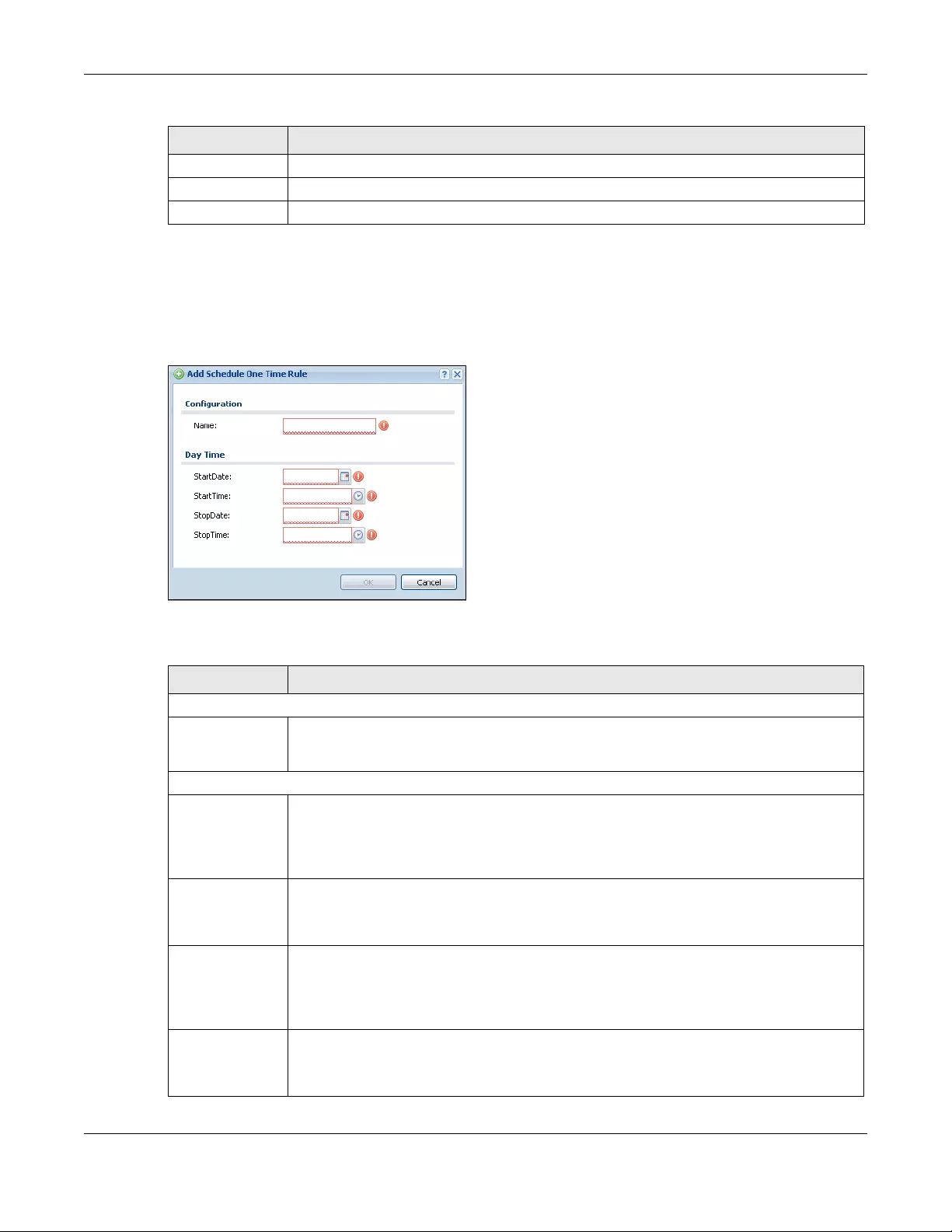
Chapter 35 Object
ZyWALL/USG Series User’s Guide
615
35.8.2.1 The One-Time Schedule Add/Edit Screen
The One-Time Schedule Add/Edit screen allows you to define a one-time schedule or edit an
existing one. To access this screen, go to the Schedule screen (see Section 35.8.2 on page 614),
and click either the Add icon or an Edit icon in the One Time section.
Figure 414 Configuration > Object > Schedule > Edit (One Time)
The following table describes the labels in this screen.
Start Time This field displays the time at which the schedule begins.
Stop Time This field displays the time at which the schedule ends.
Reference This displays the number of times an object reference is used in a profile.
Table 269 Configuration > Object > Schedule (continued)
LABEL DESCRIPTION
Table 270 Configuration > Object > Schedule > Edit (One Time)
LABEL DESCRIPTION
Configuration
Name Type the name used to refer to the one-time schedule. You may use 1-31 alphanumeric
characters, underscores(_), or dashes (-), but the first character cannot be a number.
This value is case-sensitive.
Date Time
StartDate Specify the year, month, and day when the schedule begins.
•Year - 1900 - 2999
•Month - 1 - 12
•Day - 1 - 31 (it is not possible to specify illegal dates, such as February 31.)
StartTime Specify the hour and minute when the schedule begins.
•Hour - 0 - 23
•Minute - 0 - 59
StopDate Specify the year, month, and day when the schedule ends.
•Year - 1900 - 2999
•Month - 1 - 12
•Day - 1 - 31 (it is not possible to specify illegal dates, such as February 31.)
StopTime Specify the hour and minute when the schedule ends.
•Hour - 0 - 23
•Minute - 0 - 59
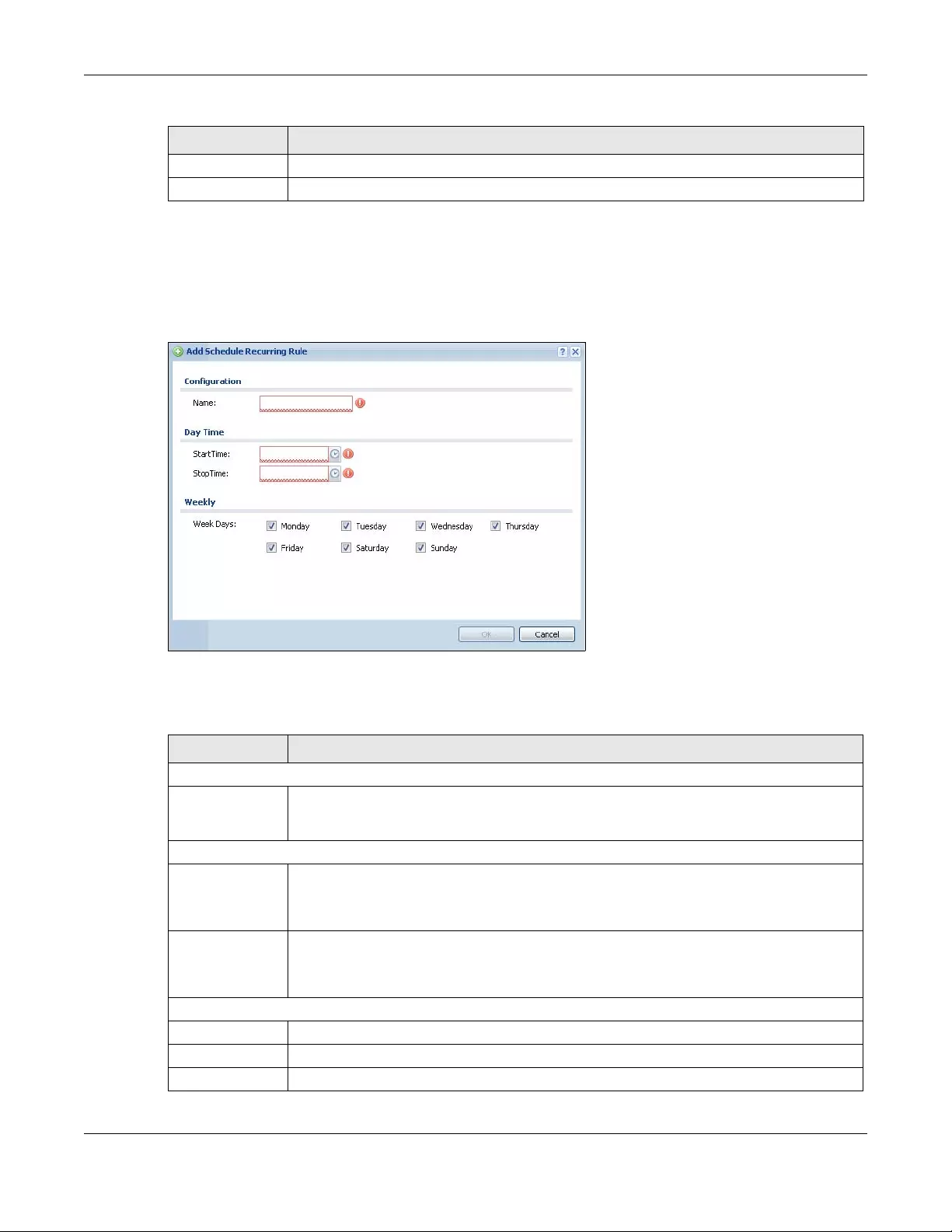
Chapter 35 Object
ZyWALL/USG Series User’s Guide
616
35.8.2.2 The Recurring Schedule Add/Edit Screen
The Recurring Schedule Add/Edit screen allows you to define a recurring schedule or edit an
existing one. To access this screen, go to the Schedule screen (see Section 35.8.2 on page 614),
and click either the Add icon or an Edit icon in the Recurring section.
Figure 415 Configuration > Object > Schedule > Edit (Recurring)
The Year, Month, and Day columns are not used in recurring schedules and are disabled in this
screen. The following table describes the remaining labels in this screen.
OK Click OK to save your changes back to the ZyWALL/USG.
Cancel Click Cancel to exit this screen without saving your changes.
Table 270 Configuration > Object > Schedule > Edit (One Time) (continued)
LABEL DESCRIPTION
Table 271 Configuration > Object > Schedule > Edit (Recurring)
LABEL DESCRIPTION
Configuration
Name Type the name used to refer to the recurring schedule. You may use 1-31 alphanumeric
characters, underscores(_), or dashes (-), but the first character cannot be a number.
This value is case-sensitive.
Date Time
StartTime Specify the hour and minute when the schedule begins each day.
•Hour - 0 - 23
•Minute - 0 - 59
StopTime Specify the hour and minute when the schedule ends each day.
•Hour - 0 - 23
•Minute - 0 - 59
Weekly
Week Days Select each day of the week the recurring schedule is effective.
OK Click OK to save your changes back to the ZyWALL/USG.
Cancel Click Cancel to exit this screen without saving your changes.
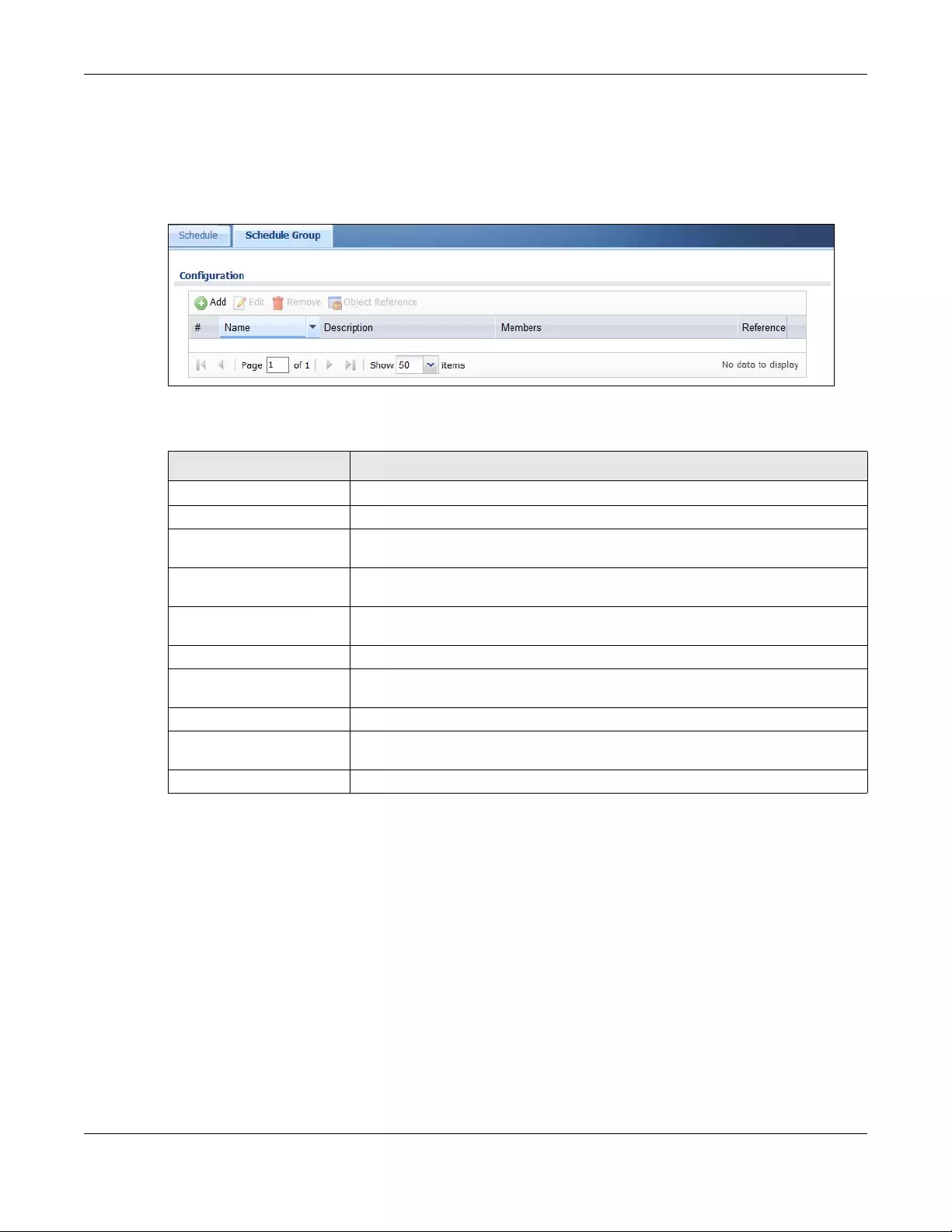
Chapter 35 Object
ZyWALL/USG Series User’s Guide
617
35.8.3 The Schedule Group Screen
The Schedule Group summary screen provides a summary of all groups of schedules in the
ZyWALL/USG. To access this screen, click Configuration > Object > Schedule >Group.
Figure 416 Configuration > Object > Schedule > Schedule Group
The following table describes the fields in the above screen.
35.8.3.1 The Schedule Group Add/Edit Screen
The Schedule Group Add/Edit screen allows you to define a schedule group or edit an existing
one. To access this screen, go to the Schedule screen (see ), and click either the Add icon or an
Edit icon in the Schedule Group section.
Table 272 Configuration > Object > Schedule > Schedule Group
LABEL DESCRIPTION
Configuration
Add Click this to create a new entry.
Edit Double-click an entry or select it and click Edit to be able to modify the entry’s
settings.
Remove To remove an entry, select it and click Remove. The ZyWALL/USG confirms you
want to remove it before doing so.
Object Reference Select an entry and click Ob ject Ref erence s to open a screen that shows which
settings use the entry.
# This field is a sequential value, and it is not associated with a specific schedule.
Name This field displays the name of the schedule group, which is used to refer to the
schedule.
Description This field displays the decription of the schedule group.
Members This field lists the members in the schedule group. Each member is separated by
a comma.
Reference This displays the number of times an object reference is used in a profile.
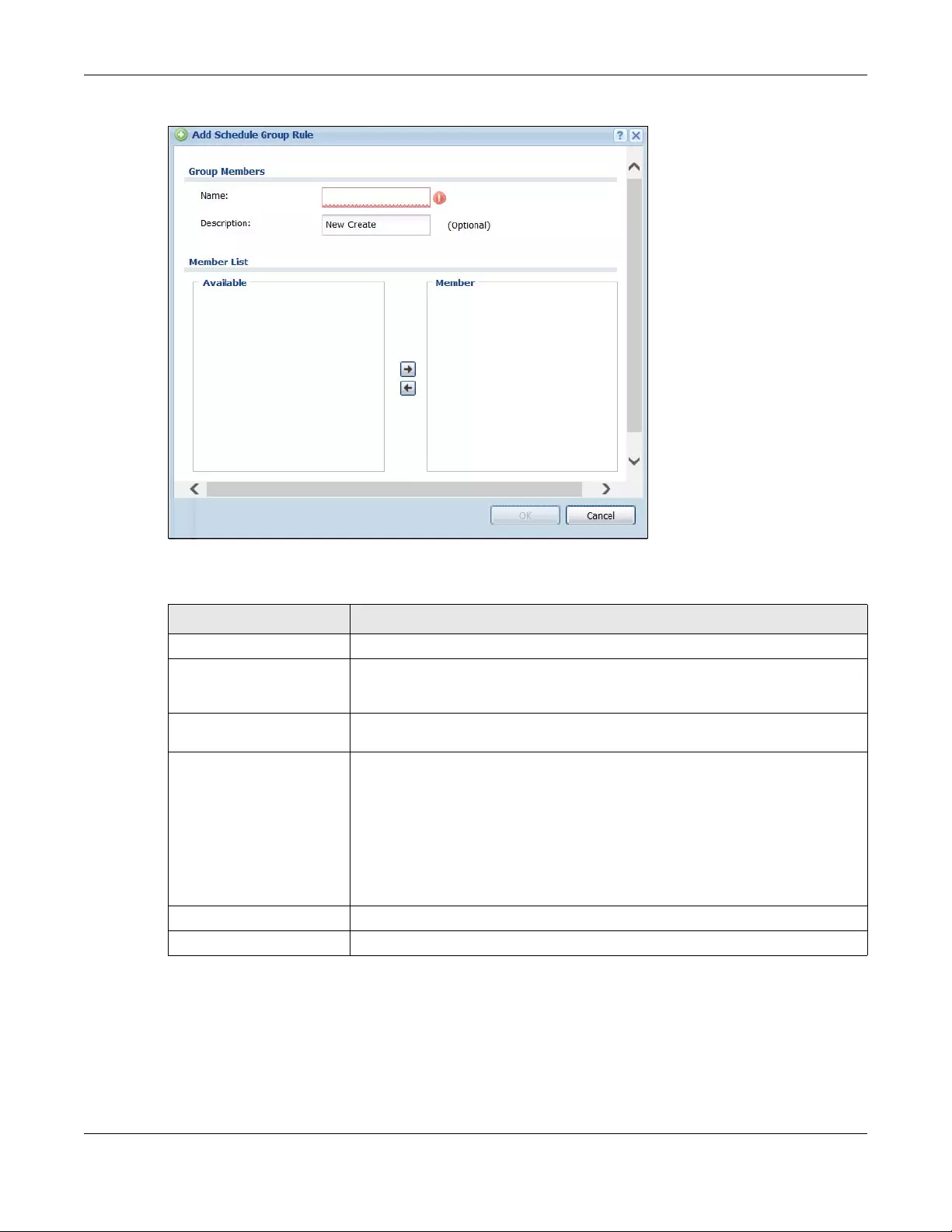
Chapter 35 Object
ZyWALL/USG Series User’s Guide
618
Figure 417 Configuration > Schedule > Schedule Group > Add
The following table describes the fields in the above screen.
35.9 AAA Server Overview
You can use a AAA (Authentication, Authorization, Accounting) server to provide access control to
your network. The AAA server can be a Active Directory, LDAP, or RADIUS server. Use the AAA
Server screens to create and manage objects that contain settings for using AAA servers. You use
Table 273 Configuration > Schedule > Schedule Group > Add
LABEL DESCRIPTION
Group Members
Name Type the name used to refer to the recurring schedule. You may use 1-31
alphanumeric characters, underscores(_), or dashes (-), but the first character
cannot be a number. This value is case-sensitive.
Description Enter a description of the service group, if any. You can use up to 60 printable
ASCII characters.
Member List The Member list displays the names of the service and service group objects
that have been added to the service group. The order of members is not
important.
Select items from the Available list that you want to be members and move
them to the Member list. You can double-click a single entry to move it or use
the [Shift] or [Ctrl] key to select multiple entries and use the arrow button to
move them.
Move any members you do not want included to the Available list.
OK Click OK to save your changes back to the ZyWALL/USG.
Cancel Click Cancel to exit this screen without saving your changes.
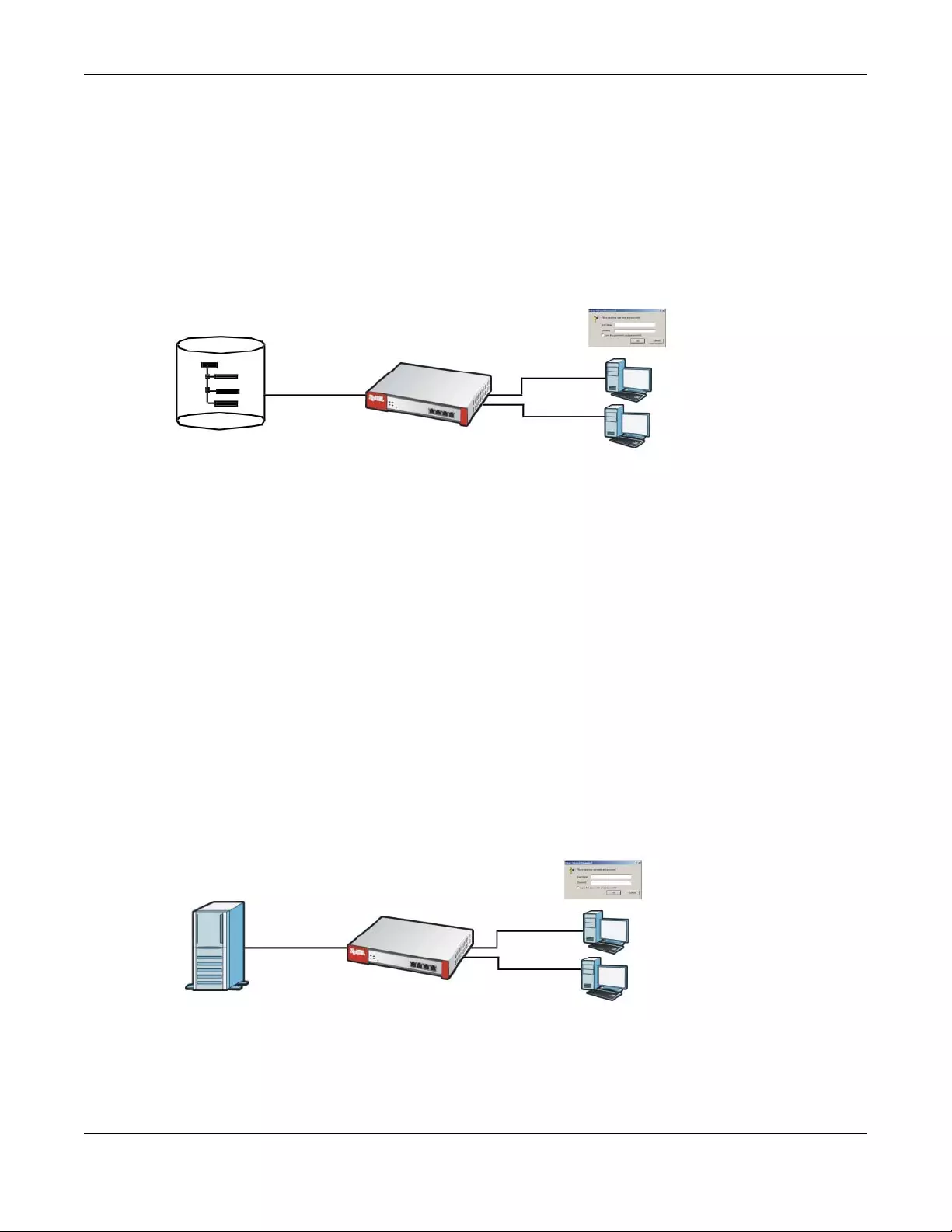
Chapter 35 Object
ZyWALL/USG Series User’s Guide
619
AAA server objects in configuring ext-group-user user objects and authentication method objects
(see Chapter 35 on page 627).
35.9.1 Directory Service (AD/LDAP)
LDAP/AD allows a client (the ZyWALL/USG) to connect to a server to retrieve information from a
directory. A network example is shown next.
Figure 418 Example: Directory Service Client and Server
The following describes the user authentication procedure via an LDAP/AD server.
1A user logs in with a user name and password pair.
2The ZyWALL/USG tries to bind (or log in) to the LDAP/AD server.
3When the binding process is successful, the ZyWALL/USG checks the user information in the
directory against the user name and password pair.
4If it matches, the user is allowed access. Otherwise, access is blocked.
35.9.2 RADIUS Server
RADIUS (Remote Authentication Dial-In User Service) authentication is a popular protocol used to
authenticate users by means of an external server instead of (or in addition to) an internal device
user database that is limited to the memory capacity of the device. In essence, RADIUS
authentication allows you to validate a large number of users from a central location.
Figure 419 RADIUS Server Network Example
35.9.3 ASAS
ASAS (Authenex Strong Authentication System) is a RADIUS server that works with the One-Time
Password (OTP) feature. Purchase a ZyWALL/USG OTP package in order to use this feature. The

Chapter 35 Object
ZyWALL/USG Series User’s Guide
620
package contains server software and physical OTP tokens (PIN generators). Do the following to
use OTP. See the documentation included on the ASAS’ CD for details.
1Install the ASAS server software on a computer.
2Create user accounts on the ZyWALL/USG and in the ASAS server.
3Import each token’s database file (located on the included CD) into the server.
4Assign users to OTP tokens (on the ASAS server).
5Configure the ASAS as a RADIUS server in the ZyWALL/USG’s Configuration > Object > AAA
Server screens.
6Give the OTP tokens to (local or remote) users.
•Use the Configuration > Object > AAA Server > Active Directory (or LDAP) screens
(Section 35.9.5 on page 621) to configure Active Directory or LDAP server objects.
•Use the Configuration > Object > AAA Server > RADIUS screen (Section 35.9.2 on page
619) to configure the default external RADIUS server to use for user authentication.
35.9.4 What You Need To Know
AAA Servers Supported by the ZyWALL/USG
The following lists the types of authentication server the ZyWALL/USG supports.
•Local user database
The ZyWALL/USG uses the built-in local user database to authenticate administrative users
logging into the ZyWALL/USG’s Web Configurator or network access users logging into the
network through the ZyWALL/USG. You can also use the local user database to authenticate VPN
users.
• Directory Service (LDAP/AD)
LDAP (Lightweight Directory Access Protocol)/AD (Active Directory) is a directory service that is
both a directory and a protocol for controlling access to a network. The directory consists of a
database specialized for fast information retrieval and filtering activities. You create and store
user profile and login information on the external server.
•RADIUS
RADIUS (Remote Authentication Dial-In User Service) authentication is a popular protocol used
to authenticate users by means of an external or built-in RADIUS server. RADIUS authentication
allows you to validate a large number of users from a central location.
Directory Structure
The directory entries are arranged in a hierarchical order much like a tree structure. Normally, the
directory structure reflects the geographical or organizational boundaries. The following figure
shows a basic directory structure branching from countries to organizations to organizational units
to individuals.
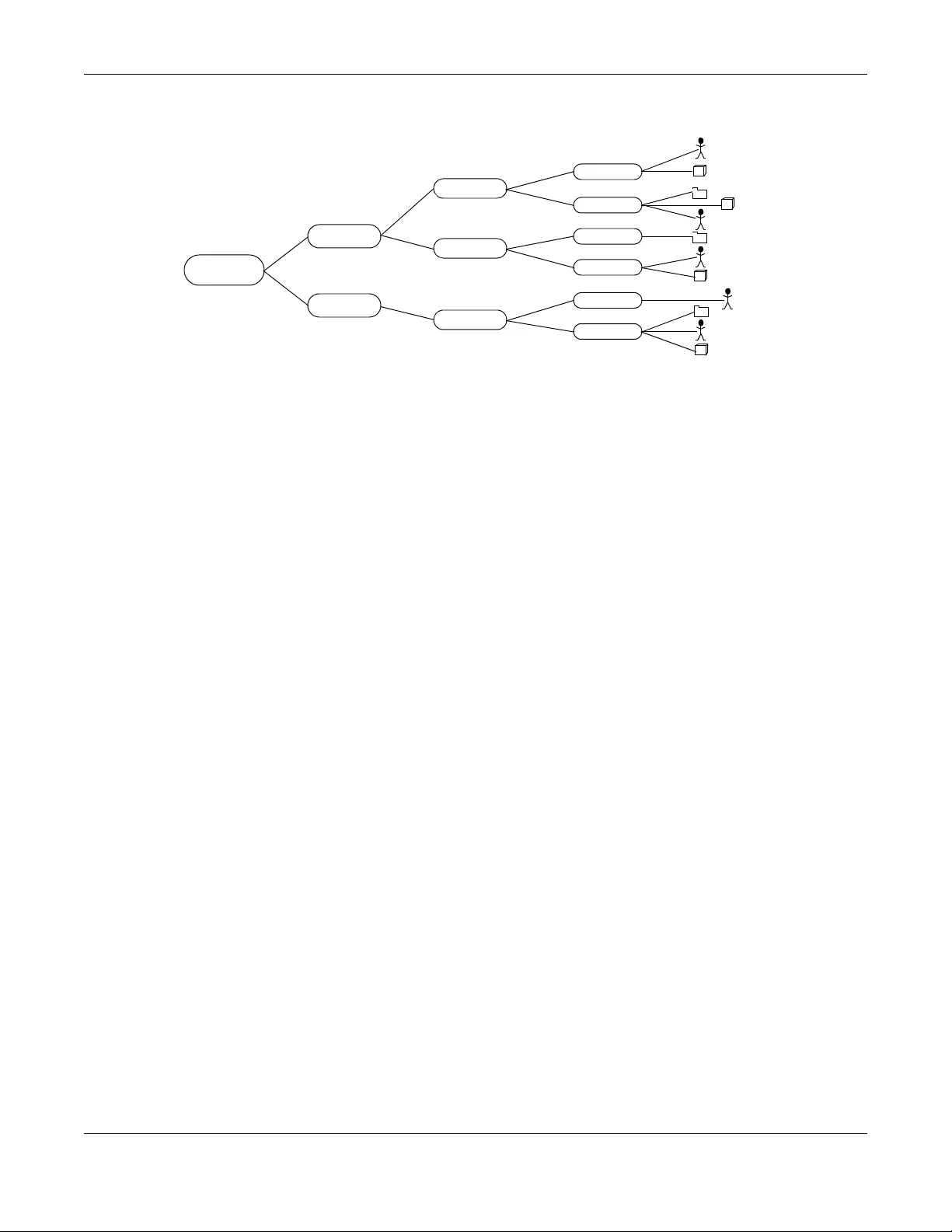
Chapter 35 Object
ZyWALL/USG Series User’s Guide
621
Figure 420 Basic Directory Structure
Distinguished Name (DN)
A DN uniquely identifies an entry in a directory. A DN consists of attribute-value pairs separated by
commas. The leftmost attribute is the Relative Distinguished Name (RDN). This provides a unique
name for entries that have the same “parent DN” (“cn=domain1.com, ou=Sales, o=MyCompany” in
the following examples).
cn=domain1.com, ou = Sales, o=MyCompany, c=US
cn=domain1.com, ou = Sales, o=MyCompany, c=JP
Base DN
A base DN specifies a directory. A base DN usually contains information such as the name of an
organization, a domain name and/or country. For example, o=MyCompany, c=UK where o means
organization and c means country.
Bind DN
A bind DN is used to authenticate with an LDAP/AD server. For example a bind DN of
cn=zywallAdmin allows the ZyWALL/USG to log into the LDAP/AD server using the user name of
zywallAdmin. The bind DN is used in conjunction with a bind password. When a bind DN is not
specified, the ZyWALL/USG will try to log in as an anonymous user. If the bind password is
incorrect, the login will fail.
35.9.5 Active Directory or LDAP Server Summary
Use the Active Direc tory or LDAP screen to manage the list of AD or LDAP servers the ZyWALL/
USG can use in authenticating users.
Click Configuration > Object > AAA Server > Active Directory (or LDAP) to display the
Active Directory (or LDAP) screen.
Root
US
Japan
Sprint
UPS
NEC
Sales
RD3
QA
CSO
Sales
RD
Countries (c) Organizations Organization Units Unique
Common Name
(cn)
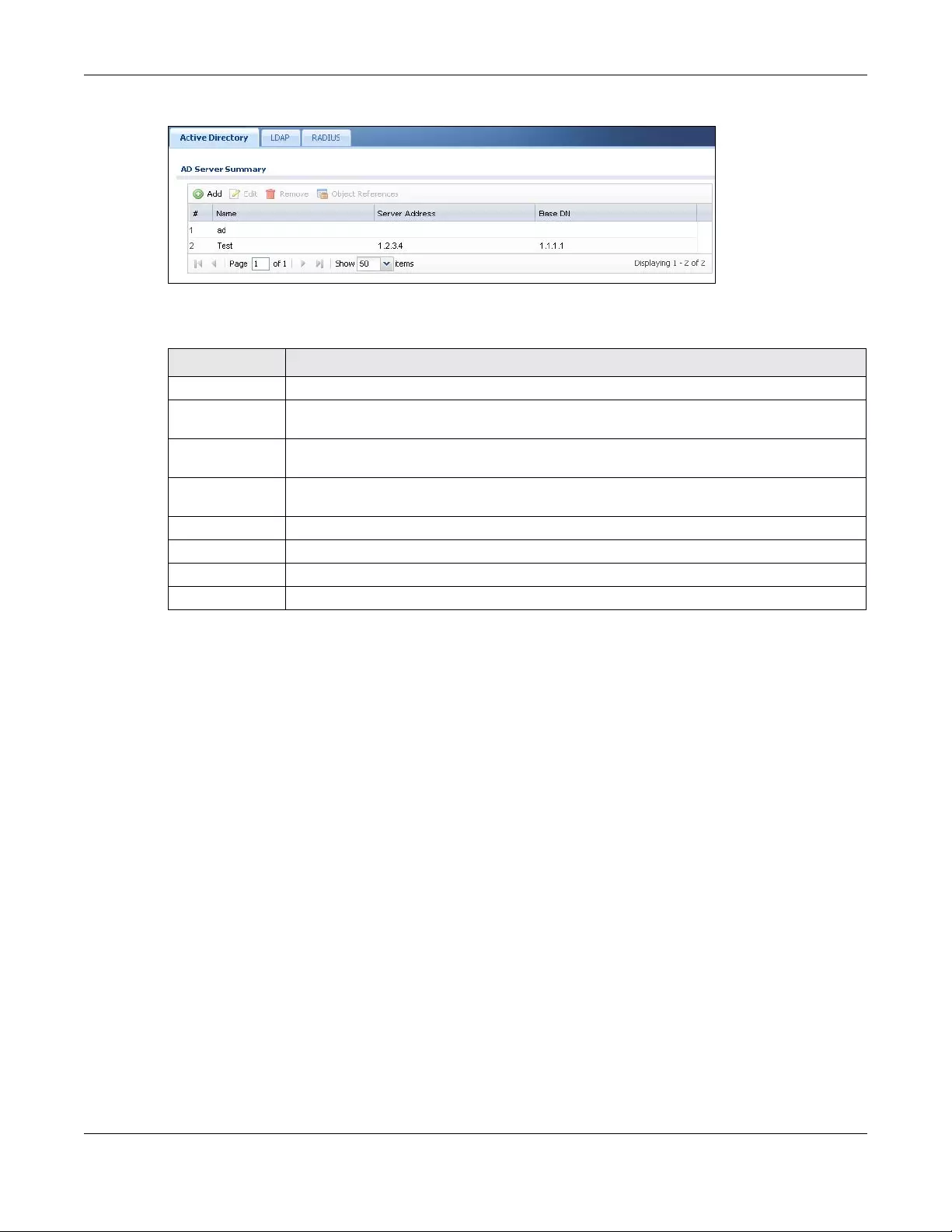
Chapter 35 Object
ZyWALL/USG Series User’s Guide
622
Figure 421 Configuration > Object > AAA Server > Active Directory (or LDAP)
The following table describes the labels in this screen.
35.9.5.1 Adding an Active Directory or LDAP Server
Click Object > AAA Server > Active Directory (or LDAP) to display the Active Directory (or
LDAP) screen. Click the Add icon or an Edit icon to display the following screen. Use this screen to
create a new AD or LDAP entry or edit an existing one.
Table 274 Configuration > Object > AAA Server > Active Directory (or LDAP)
LABEL DESCRIPTION
Add Click this to create a new entry.
Edit Double-click an entry or select it and click Edit to open a screen where you can modify the
entry’s settings.
Remove To remove an entry, select it and click Remove. The ZyWALL/USG confirms you want to
remove it before doing so.
Object
References
Select an entry and click Object References to open a screen that shows which settings
use the entry.
# This field is a sequential value, and it is not associated with a specific AD or LDAP server.
Name This field displays the name of the Active Directory.
Server Address This is the address of the AD or LDAP server.
Base DN This specifies a directory. For example, o=ZyXEL, c=US.
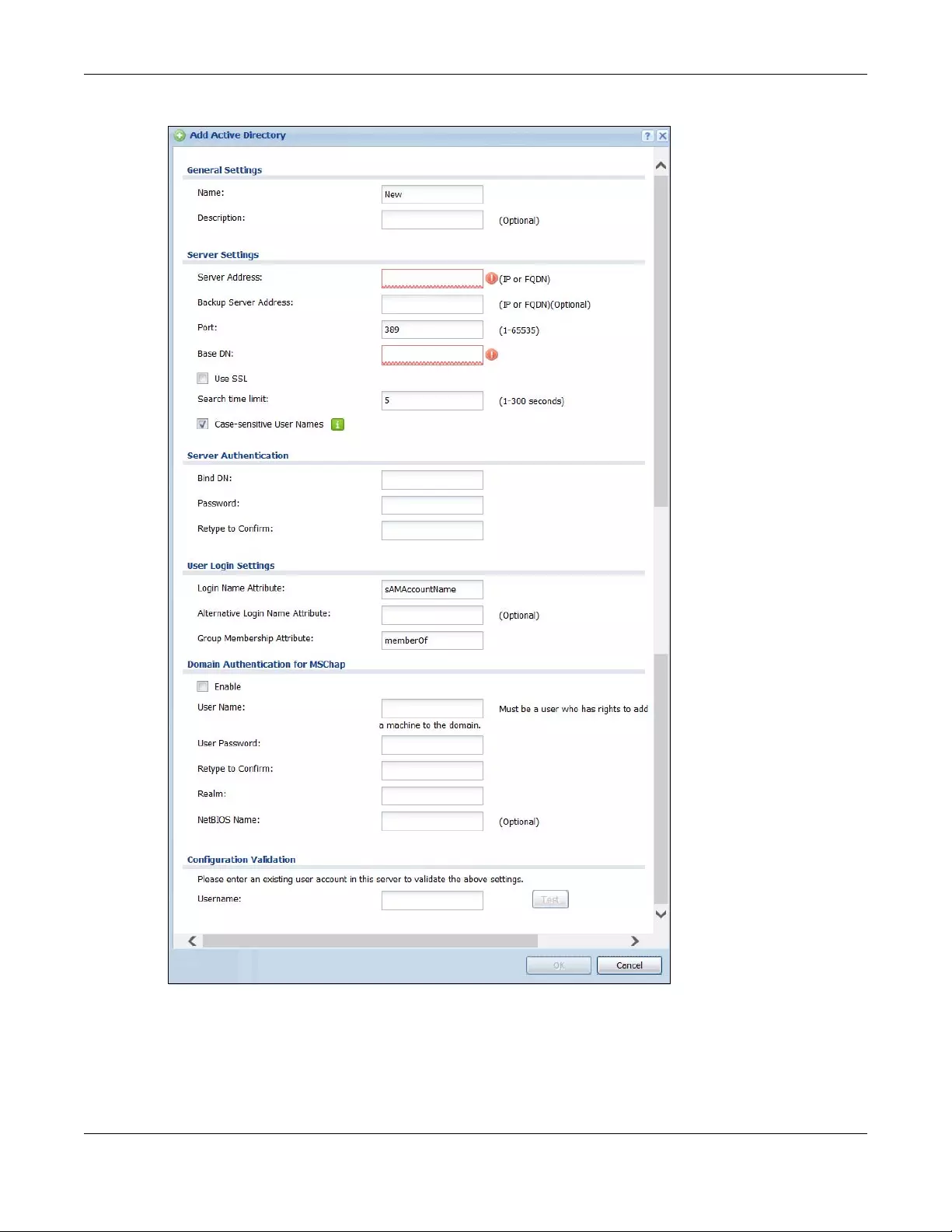
Chapter 35 Object
ZyWALL/USG Series User’s Guide
623
Figure 422 Configuration > Object > AAA Server > Active Directory (or LDAP) > Add

Chapter 35 Object
ZyWALL/USG Series User’s Guide
624
The following table describes the labels in this screen.
Table 275 Configuration > Object > AAA Server > Active Directory (or LDAP) > Add
LABEL DESCRIPTION
Name Enter a descriptive name (up to 63 alphanumerical characters) for identification
purposes.
Description Enter the description of each server, if any. You can use up to 60 printable ASCII
characters.
Server Address Enter the address of the AD or LDAP server.
Backup Server
Address
If the AD or LDAP server has a backup server, enter its address here.
Port Specify the port number on the AD or LDAP server to which the ZyWALL/USG sends
authentication requests. Enter a number between 1 and 65535.
This port number should be the same on all AD or LDAP server(s) in this group.
Base DN Specify the directory (up to 127 alphanumerical characters). For example, o=ZyXEL,
c=US.
This is only for LDAP.
Use SSL Select Use SSL to establish a secure connection to the AD or LDAP server(s).
Search time limit Specify the timeout period (between 1 and 300 seconds) before the ZyWALL/USG
disconnects from the AD or LDAP server. In this case, user authentication fails.
Search timeout occurs when either the user information is not in the AD or LDAP
server(s) or the AD or LDAP server(s) is down.
Case-sensitive
User Names
Select this if the server checks the case of the usernames.
Bind DN Specify the bind DN for logging into the AD or LDAP server. Enter up to 127
alphanumerical characters.
For example, cn=zywallAdmin specifies zywallAdmin as the user name.
Password If required, enter the password (up to 15 alphanumerical characters) for the ZyWALL/
USG to bind (or log in) to the AD or LDAP server.
Retype to Confirm Retype your new password for confirmation.
Login Name
Attribute
Enter the type of identifier the users are to use to log in. For example “name” or “e-mail
address”.
Alternative Login
Name Attribute
If there is a second type of identifier that the users can use to log in, enter it here. For
example “name” or “e-mail address”.
Group
Membership
Attribute
An AD or LDAP server defines attributes for its accounts. Enter the name of the attribute
that the ZyWALL/USG is to check to determine to which group a user belongs. The value
for this attribute is called a group identifier; it determines to which group a user belongs.
You can add ext-group-user user objects to identify groups based on these group
identifier values.
For example you could have an attribute named “memberOf” with values like “sales”,
“RD”, and “management”. Then you could also create a ext-group-user user object for
each group. One with “sales” as the group identifier, another for “RD” and a third for
“management”.
Domain
Authentication for
MSChap
Select the Enable checkbox to enable domain authentication for MSChap.
This is only for Active Directory.
User Name Enter the user name for the user who has rights to add a machine to the domain.
This is only for Active Directory.
User Password Enter the password for the associated user name.
This is only for Active Directory.

Chapter 35 Object
ZyWALL/USG Series User’s Guide
625
35.9.6 RADIUS Server Summary
Use the RADIUS screen to manage the list of RADIUS servers the ZyWALL/USG can use in
authenticating users.
Click Configuration > Object > AAA Server > RADIUS to display the RADIUS screen.
Figure 423 Configuration > Object > AAA Server > RADIUS
The following table describes the labels in this screen.
Retype to Confirm Retype your new password for confirmation.
This is only for Active Directory.
Realm Enter the realm FQDN.
This is only for Active Directory.
NetBIOS Name Type the NetBIOS name. This field is optional. NetBIOS packets are TCP or UDP packets
that enable a computer to connect to and communicate with a LAN which allows local
computers to find computers on the remote network and vice versa.
Configuration
Validation
Use a user account from the server specified above to test if the configuration is correct.
Enter the account’s user name in the Username field and click Test.
OK Click OK to save the changes.
Cancel Click Cancel to discard the changes.
Table 275 Configuration > Object > AAA Server > Active Directory (or LDAP) > Add (continued)
LABEL DESCRIPTION
Table 276 Configuration > Object > AAA Server > RADIUS
LABEL DESCRIPTION
Add Click this to create a new entry.
Edit Double-click an entry or select it and click Edit to open a screen where you can modify the
entry’s settings.
Remove To remove an entry, select it and click Remove. The ZyWALL/USG confirms you want to
remove it before doing so.
Object
References
Select an entry and click Object References to open a screen that shows which settings
use the entry.
# This field displays the index number.
Name This is the name of the RADIUS server entry.
Server Address This is the address of the AD or LDAP server.
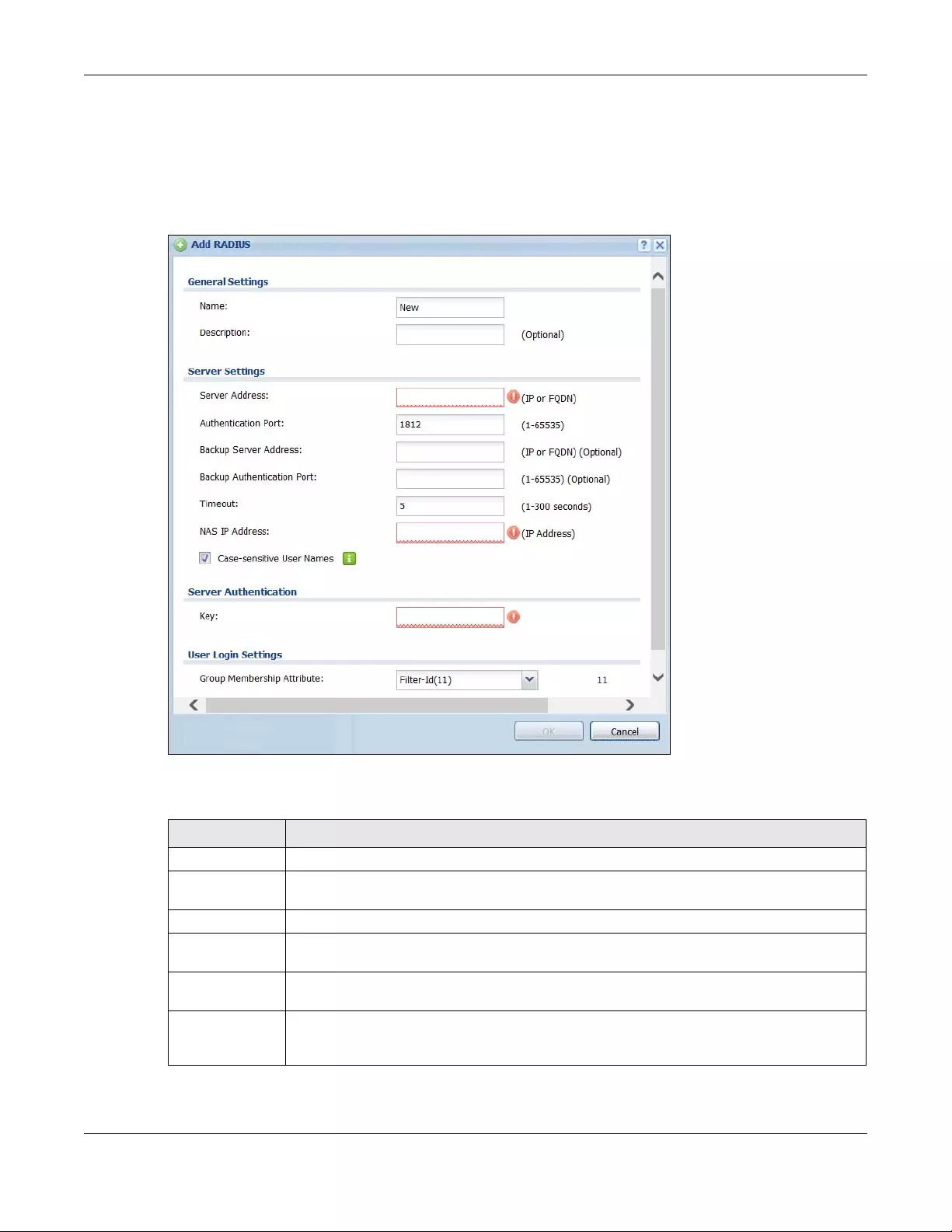
Chapter 35 Object
ZyWALL/USG Series User’s Guide
626
35.9.6.1 Adding a RADIUS Server
Click Configuration > Object > AAA Server > RADIUS to display the RADIUS screen. Click the
Add icon or an Edit icon to display the following screen. Use this screen to create a new AD or
LDAP entry or edit an existing one.
Figure 424 Configuration > Object > AAA Server > RADIUS > Add
The following table describes the labels in this screen.
Table 277 Configuration > Object > AAA Server > RADIUS > Add
LABEL DESCRIPTION
Name Enter a descriptive name (up to 63 alphanumerical characters) for identification purposes.
Description Enter the description of each server, if any. You can use up to 60 printable ASCII
characters.
Server Address Enter the address of the RADIUS server.
Authentication
Port
Specify the port number on the RADIUS server to which the ZyWALL/USG sends
authentication requests. Enter a number between 1 and 65535.
Backup Server
Address
If the RADIUS server has a backup server, enter its address here.
Backup
Authentication
Port
Specify the port number on the RADIUS server to which the ZyWALL/USG sends
authentication requests. Enter a number between 1 and 65535.
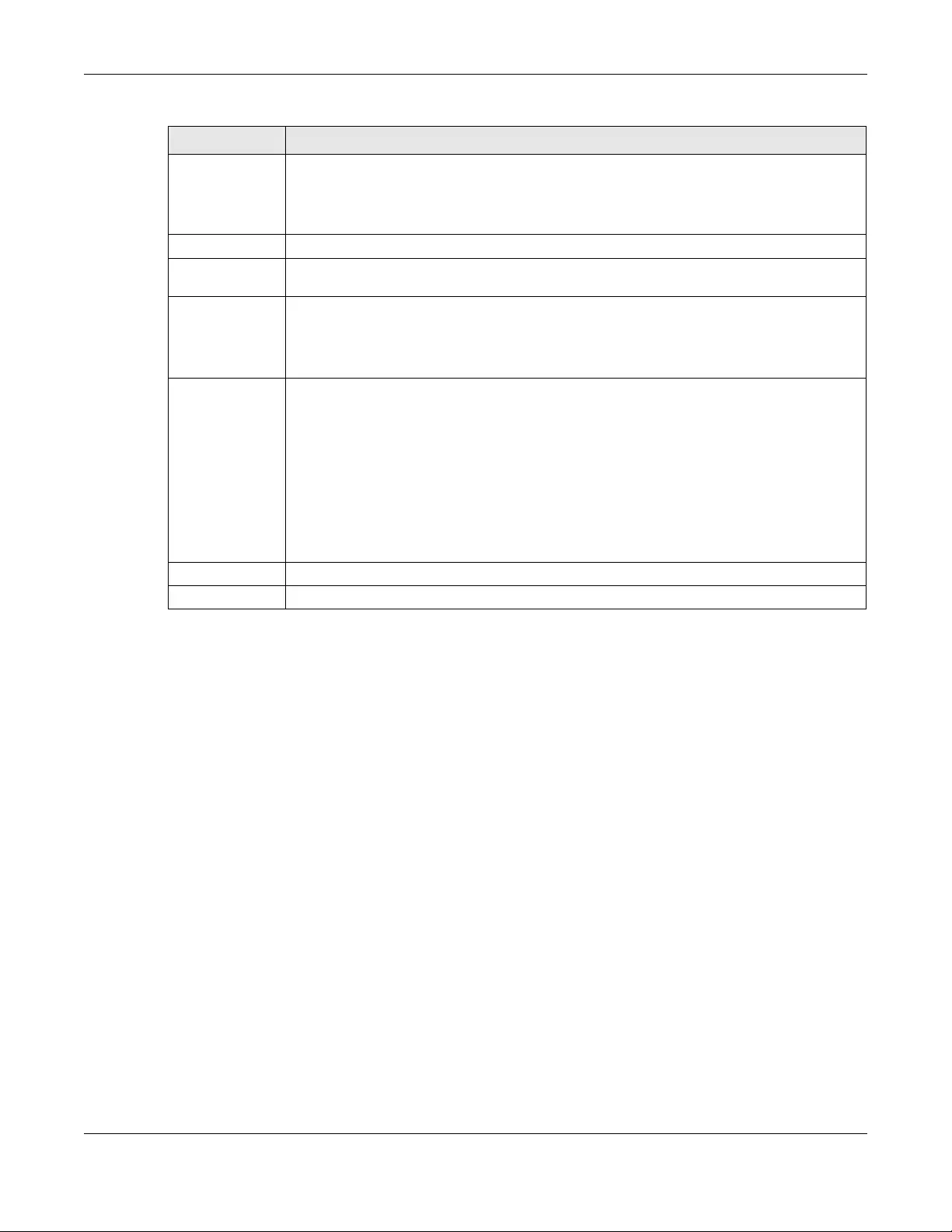
Chapter 35 Object
ZyWALL/USG Series User’s Guide
627
35.10 Auth. Method Overview
Authentication method objects set how the ZyWALL/USG authenticates wireless, HTTP/HTTPS
clients, and peer IPSec routers (extended authentication) clients. Configure authentication method
objects to have the ZyWALL/USG use the local user database, and/or the authentication servers
and authentication server groups specified by AAA server objects. By default, user accounts created
and stored on the ZyWALL/USG are authenticated locally.
•Use the Configuration > Object > Auth. Method screens (Section 35.10.3 on page 628) to
create and manage authentication method objects.
35.10.1 Before You Begin
Configure AAA server objects before you configure authentication method objects.
35.10.2 Example: Selecting a VPN Authentication Method
After you set up an authentication method object in the Auth. Method screens, you can use it in
the VPN Gateway screen to authenticate VPN users for establishing a VPN connection. Refer to the
chapter on VPN for more information.
Follow the steps below to specify the authentication method for a VPN connection.
Timeout Specify the timeout period (between 1 and 300 seconds) before the ZyWALL/USG
disconnects from the RADIUS server. In this case, user authentication fails.
Search timeout occurs when either the user information is not in the RADIUS server or the
RADIUS server is down.
NAS IP Address Type the IP address of the NAS (Network Access Server).
Case-sensitive
User Names
Select this if you want configure your username as case-sensitive.
Key Enter a password (up to 15 alphanumeric characters) as the key to be shared between the
external authentication server and the ZyWALL/USG.
The key is not sent over the network. This key must be the same on the external
authentication server and the ZyWALL/USG.
Group
Membership
Attribute
A RADIUS server defines attributes for its accounts. Select the name and number of the
attribute that the ZyWALL/USG is to check to determine to which group a user belongs. If
it does not display, select user-defined and specify the attribute’s number.
This attribute’s value is called a group identifier; it determines to which group a user
belongs. You can add ext-group-user user objects to identify groups based on these
group identifier values.
For example you could have an attribute named “memberOf” with values like “sales”, “RD”,
and “management”. Then you could also create a ext-group-user user object for each
group. One with “sales” as the group identifier, another for “RD” and a third for
“management”.
OK Click OK to save the changes.
Cancel Click Cancel to discard the changes.
Table 277 Configuration > Object > AAA Server > RADIUS > Add (continued)
LABEL DESCRIPTION
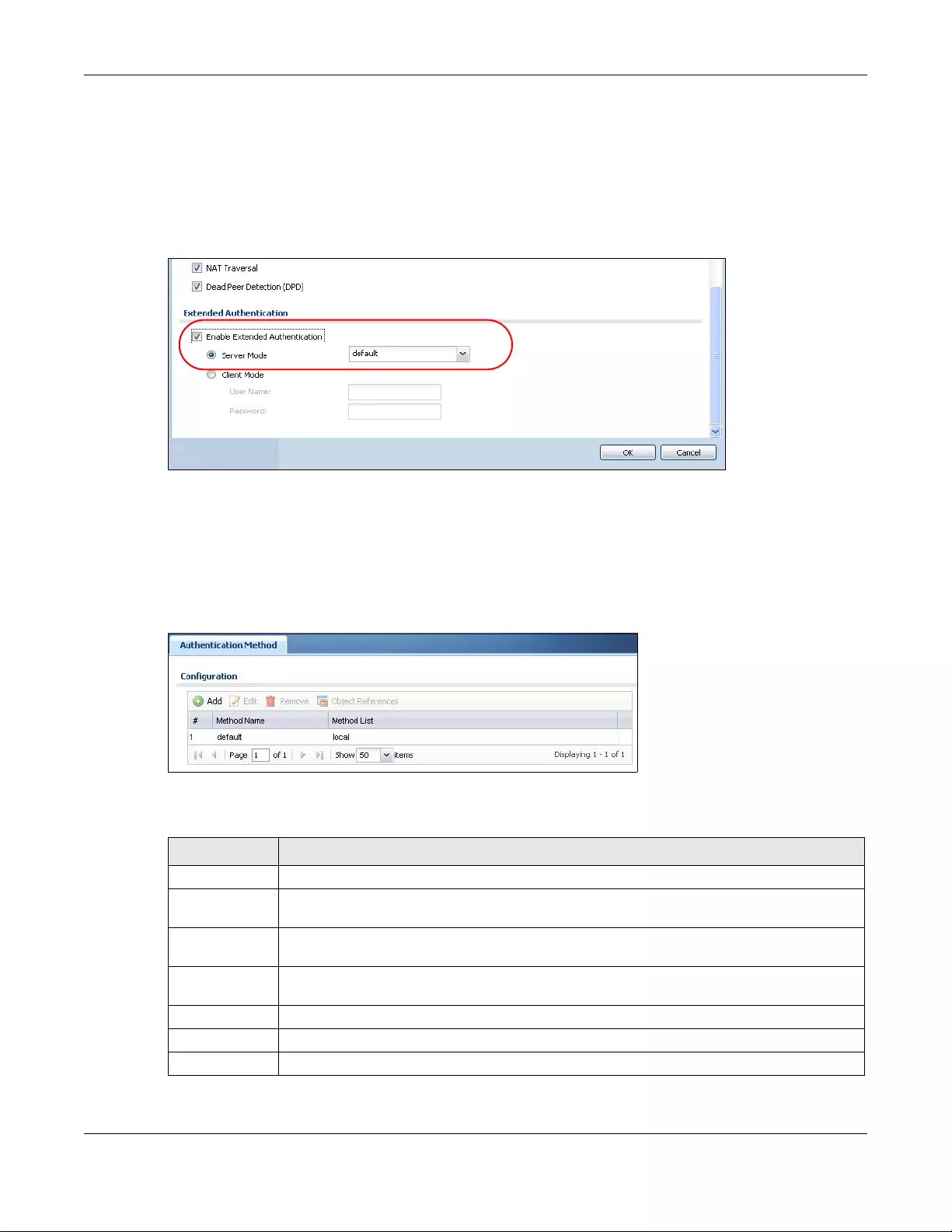
Chapter 35 Object
ZyWALL/USG Series User’s Guide
628
1Access the Configuration > VPN > IPSec VPN > VPN Gateway > Edit screen.
2Click Show Advance Setting and select Enable Extended Authentication.
3Select Server Mode and select an authentication method object from the drop-down list box.
4Click OK to save the settings.
Figure 425 Example: Using Authentication Method in VPN
35.10.3 Authentication Method Objects
Click Configuration > Object > Auth. Method to display the screen as shown.
Note: You can create up to 16 authentication method objects.
Figure 426 Configuration > Object > Auth. Method
The following table describes the labels in this screen.
Table 278 Configuration > Object > Auth. Method
LABEL DESCRIPTION
Add Click this to create a new entry.
Edit Double-click an entry or select it and click Edit to open a screen where you can modify the
entry’s settings.
Remove To remove an entry, select it and click Remove. The ZyWALL/USG confirms you want to
remove it before doing so.
Object
References
Select an entry and click Object References to open a screen that shows which settings
use the entry.
# This field displays the index number.
Method Name This field displays a descriptive name for identification purposes.
Method List This field displays the authentication method(s) for this entry.
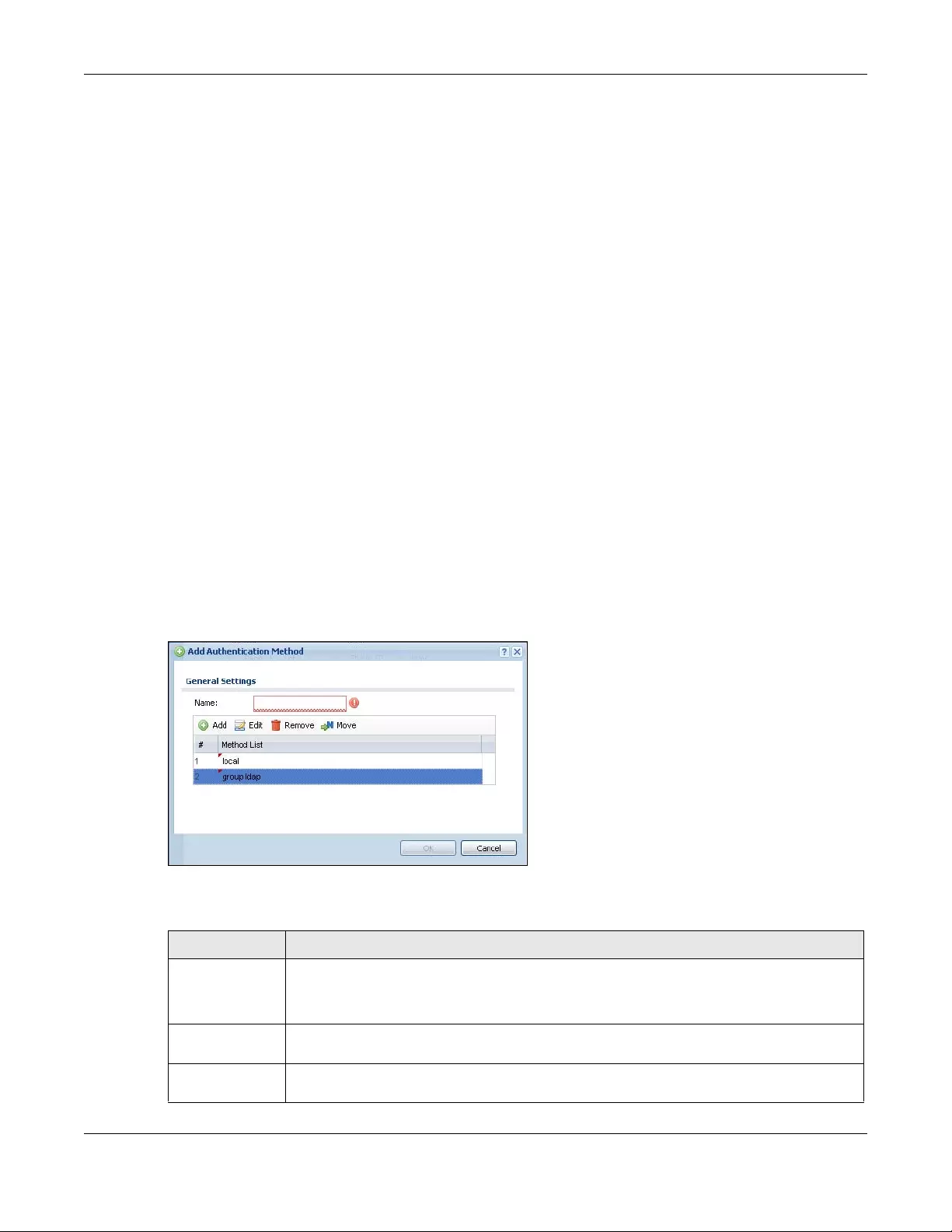
Chapter 35 Object
ZyWALL/USG Series User’s Guide
629
35.10.3.1 Creating an Authentication Method Object
Follow the steps below to create an authentication method object.
1Click Configuration > Object > Auth. Method.
2Click Add.
3Specify a descriptive name for identification purposes in the Name field. You may use 1-31
alphanumeric characters, underscores(_), or dashes (-), but the first character cannot be a number.
This value is case-sensitive. For example, “My_Device”.
4Click Add to insert an authentication method in the table.
5Select a server object from the Method List drop-down list box.
6You can add up to four server objects to the table. The ordering of the Method List column is
important. The ZyWALL/USG authenticates the users using the databases (in the local user
database or the external authentication server) in the order they appear in this screen.
If two accounts with the same username exist on two authentication servers you specify, the
ZyWALL/USG does not continue the search on the second authentication server when you enter the
username and password that doesn’t match the one on the first authentication server.
Note: You can NOT select two server objects of the same type.
7Click OK to save the settings or click Cancel to discard all changes and return to the previous
screen.
Figure 427 Configuration > Object > Auth. Method > Add
The following table describes the labels in this screen.
Table 279 Configuration > Object > Auth. Method > Add
LABEL DESCRIPTION
Name Specify a descriptive name for identification purposes.
You may use 1-31 alphanumeric characters, underscores(_), or dashes (-), but the first
character cannot be a number. This value is case-sensitive. For example, “My_Device”.
Add Click this to create a new entry. Select an entry and click Add to create a new entry after
the selected entry.
Edit Double-click an entry or select it and click Edit to open a screen where you can modify the
entry’s settings.
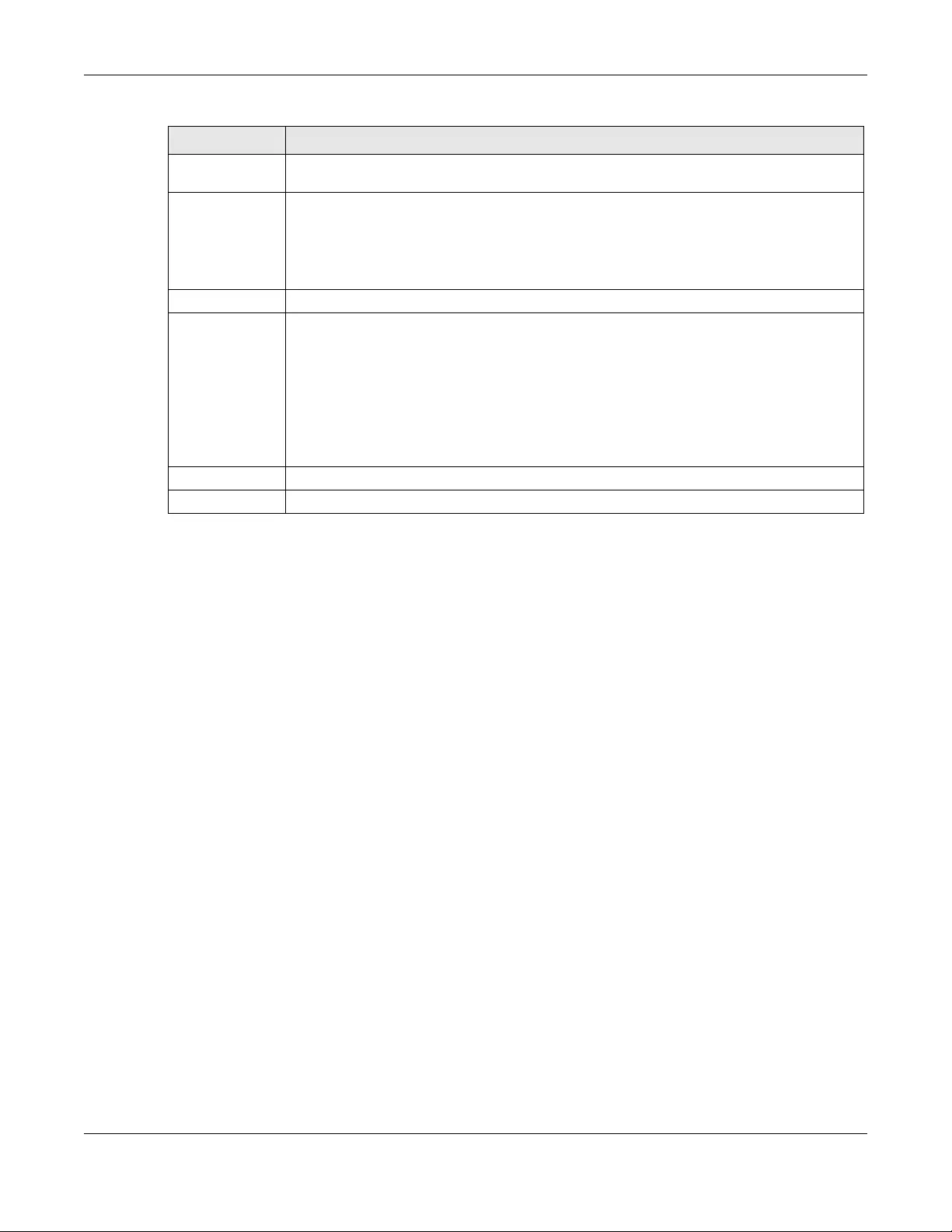
Chapter 35 Object
ZyWALL/USG Series User’s Guide
630
35.11 Certificate Overview
The ZyWALL/USG can use certificates (also called digital IDs) to authenticate users. Certificates are
based on public-private key pairs. A certificate contains the certificate owner’s identity and public
key. Certificates provide a way to exchange public keys for use in authentication.
•Use the My Certificates screens (see Section 35.11.3 on page 633 to Section 35.11.3.3 on page
639) to generate and export self-signed certificates or certification requests and import the CA-
signed certificates.
•Use the Trusted Certificates screens (see Section 35.11.4 on page 640 to Section 35.11.4.2 on
page 644) to save CA certificates and trusted remote host certificates to the ZyWALL/USG. The
ZyWALL/USG trusts any valid certificate that you have imported as a trusted certificate. It also
trusts any valid certificate signed by any of the certificates that you have imported as a trusted
certificate.
35.11.1 What You Need to Know
When using public-key cryptology for authentication, each host has two keys. One key is public and
can be made openly available. The other key is private and must be kept secure.
These keys work like a handwritten signature (in fact, certificates are often referred to as “digital
signatures”). Only you can write your signature exactly as it should look. When people know what
your signature looks like, they can verify whether something was signed by you, or by someone
else. In the same way, your private key “writes” your digital signature and your public key allows
people to verify whether data was signed by you, or by someone else. This process works as
follows.
Remove To remove an entry, select it and click Remove. The ZyWALL/USG confirms you want to
remove it before doing so.
Move To change a method’s position in the numbered list, select the method and click Move to
display a field to type a number for where you want to put it and press [ENTER] to move
the rule to the number that you typed.
The ordering of your methods is important as ZyWALL/USG authenticates the users using
the authentication methods in the order they appear in this screen.
# This field displays the index number.
Method List Select a server object from the drop-down list box. You can create a server object in the
AAA Server screen.
The ZyWALL/USG authenticates the users using the databases (in the local user database
or the external authentication server) in the order they appear in this screen.
If two accounts with the same username exist on two authentication servers you specify,
the ZyWALL/USG does not continue the search on the second authentication server when
you enter the username and password that doesn’t match the one on the first
authentication server.
OK Click OK to save the changes.
Cancel Click Cancel to discard the changes.
Table 279 Configuration > Object > Auth. Method > Add (continued)
LABEL DESCRIPTION

Chapter 35 Object
ZyWALL/USG Series User’s Guide
631
1Tim wants to send a message to Jenny. He needs her to be sure that it comes from him, and that
the message content has not been altered by anyone else along the way. Tim generates a public
key pair (one public key and one private key).
2Tim keeps the private key and makes the public key openly available. This means that anyone who
receives a message seeming to come from Tim can read it and verify whether it is really from him
or not.
3Tim uses his private key to sign the message and sends it to Jenny.
4Jenny receives the message and uses Tim’s public key to verify it. Jenny knows that the message is
from Tim, and that although other people may have been able to read the message, no-one can
have altered it (because they cannot re-sign the message with Tim’s private key).
5Additionally, Jenny uses her own private key to sign a message and Tim uses Jenny’s public key to
verify the message.
The ZyWALL/USG uses certificates based on public-key cryptology to authenticate users attempting
to establish a connection, not to encrypt the data that you send after establishing a connection. The
method used to secure the data that you send through an established connection depends on the
type of connection. For example, a VPN tunnel might use the triple DES encryption algorithm.
The certification authority uses its private key to sign certificates. Anyone can then use the
certification authority’s public key to verify the certificates.
A certification path is the hierarchy of certification authority certificates that validate a certificate.
The ZyWALL/USG does not trust a certificate if any certificate on its path has expired or been
revoked.
Certification authorities maintain directory servers with databases of valid and revoked certificates.
A directory of certificates that have been revoked before the scheduled expiration is called a CRL
(Certificate Revocation List). The ZyWALL/USG can check a peer’s certificate against a directory
server’s list of revoked certificates. The framework of servers, software, procedures and policies
that handles keys is called PKI (public-key infrastructure).
Advantages of Certificates
Certificates offer the following benefits.
• The ZyWALL/USG only has to store the certificates of the certification authorities that you decide
to trust, no matter how many devices you need to authenticate.
• Key distribution is simple and very secure since you can freely distribute public keys and you
never need to transmit private keys.
Self-signed Certificates
You can have the ZyWALL/USG act as a certification authority and sign its own certificates.
Factory Default Certificate
The ZyWALL/USG generates its own unique self-signed certificate when you first turn it on. This
certificate is referred to in the GUI as the factory default certificate.
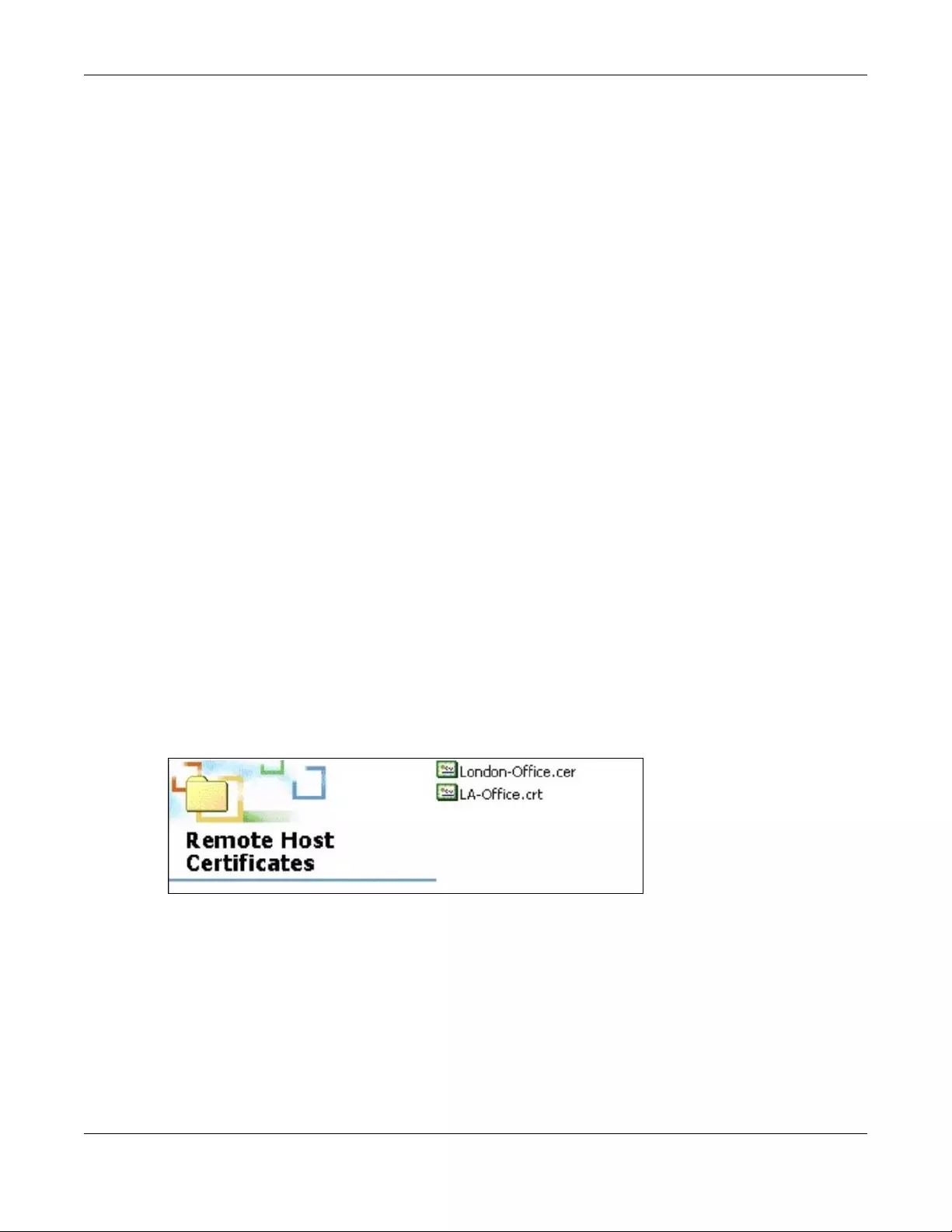
Chapter 35 Object
ZyWALL/USG Series User’s Guide
632
Certificate File Formats
Any certificate that you want to import has to be in one of these file formats:
• Binary X.509: This is an ITU-T recommendation that defines the formats for X.509 certificates.
• PEM (Base-64) encoded X.509: This Privacy Enhanced Mail format uses lowercase letters,
uppercase letters and numerals to convert a binary X.509 certificate into a printable form.
• Binary PKCS#7: This is a standard that defines the general syntax for data (including digital
signatures) that may be encrypted. A PKCS #7 file is used to transfer a public key certificate. The
private key is not included. The ZyWALL/USG currently allows the importation of a PKS#7 file
that contains a single certificate.
• PEM (Base-64) encoded PKCS#7: This Privacy Enhanced Mail (PEM) format uses lowercase
letters, uppercase letters and numerals to convert a binary PKCS#7 certificate into a printable
form.
• Binary PKCS#12: This is a format for transferring public key and private key certificates. The
private key in a PKCS #12 file is within a password-encrypted envelope. The file’s password is not
connected to your certificate’s public or private passwords. Exporting a PKCS #12 file creates this
and you must provide it to decrypt the contents when you import the file into the ZyWALL/USG.
Note: Be careful not to convert a binary file to text during the transfer process. It is easy
for this to occur since many programs use text files by default.
35.11.2 Verifying a Certificate
Before you import a trusted certificate into the ZyWALL/USG, you should verify that you have the
correct certificate. You can do this using the certificate’s fingerprint. A certificate’s fingerprint is a
message digest calculated using the MD5 or SHA1 algorithm. The following procedure describes
how to check a certificate’s fingerprint to verify that you have the actual certificate.
1Browse to where you have the certificate saved on your computer.
2Make sure that the certificate has a “.cer” or “.crt” file name extension.
Figure 428 Remote Host Certificates
3Double-click the certificate’s icon to open the Certificate window. Click the Details tab and scroll
down to the Thumbprint Algorithm and Thumbprint fields.
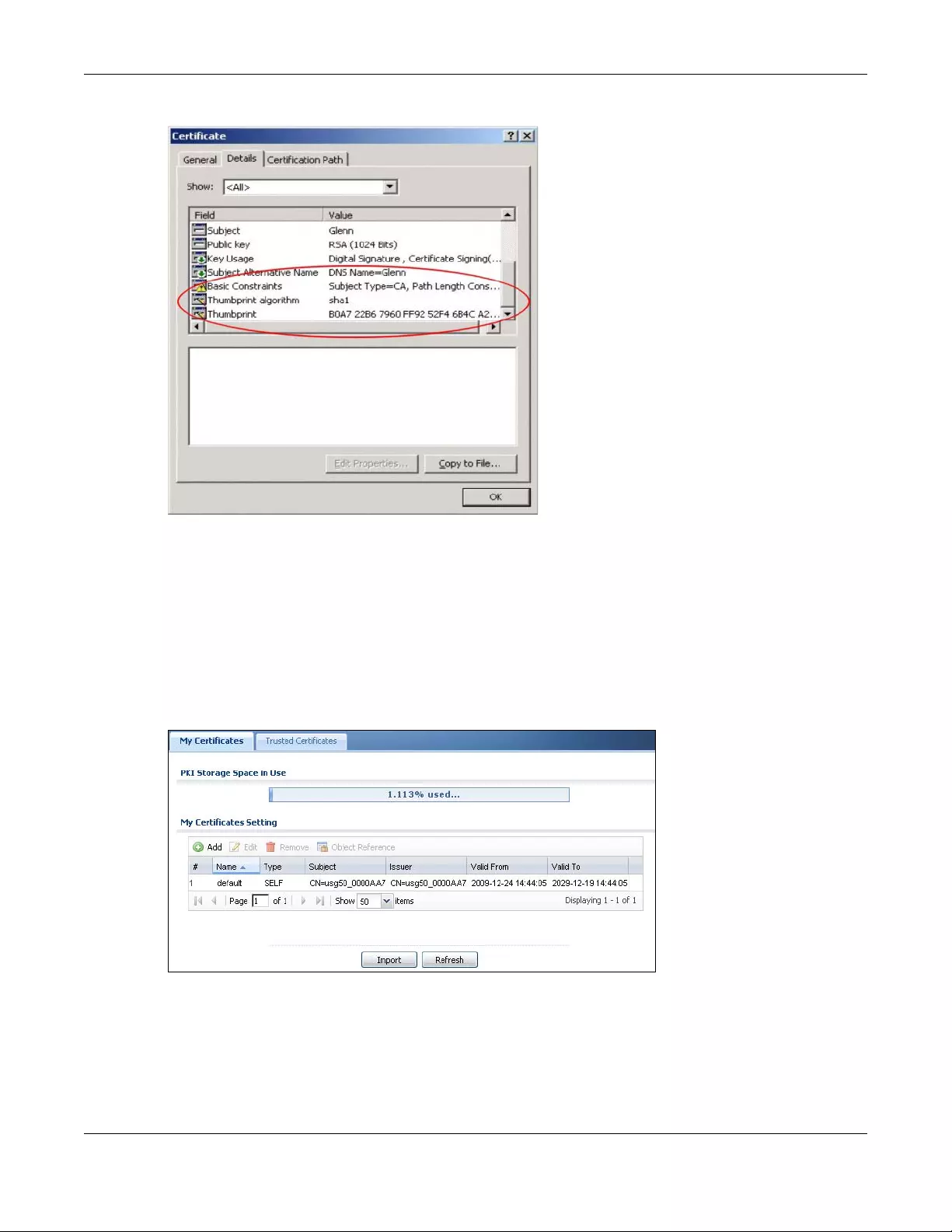
Chapter 35 Object
ZyWALL/USG Series User’s Guide
633
Figure 429 Certificate Details
4Use a secure method to verify that the certificate owner has the same information in the
Thumbprint Algorithm and Thumbprint fields. The secure method may very based on your
situation. Possible examples would be over the telephone or through an HTTPS connection.
35.11.3 The My Certificates Screen
Click Configuration > Object > Certificate > My Certificates to open the My Certificates
screen. This is the ZyWALL/USG’s summary list of certificates and certification requests.
Figure 430 Configuration > Object > Certificate > My Certificates

Chapter 35 Object
ZyWALL/USG Series User’s Guide
634
The following table describes the labels in this screen.
35.11.3.1 The My Certificates Add Screen
Click Configuration > Object > Certificate > My Certificates and then the Add icon to open
the My Certificates Add screen. Use this screen to have the ZyWALL/USG create a self-signed
certificate, enroll a certificate with a certification authority or generate a certification request.
Table 280 Configuration > Object > Certificate > My Certificates
LABEL DESCRIPTION
PKI Storage
Space in Use
This bar displays the percentage of the ZyWALL/USG’s PKI storage space that is currently
in use. When the storage space is almost full, you should consider deleting expired or
unnecessary certificates before adding more certificates.
Add Click this to go to the screen where you can have the ZyWALL/USG generate a certificate
or a certification request.
Edit Double-click an entry or select it and click Edit to open a screen with an in-depth list of
information about the certificate.
Remove The ZyWALL/USG keeps all of your certificates unless you specifically delete them.
Uploading a new firmware or default configuration file does not delete your certificates.
To remove an entry, select it and click Remove. The ZyWALL/USG confirms you want to
remove it before doing so. Subsequent certificates move up by one when you take this
action.
Object References You cannot delete certificates that any of the ZyWALL/USG’s features are configured to
use. Select an entry and click Object References to open a screen that shows which
settings use the entry.
# This field displays the certificate index number. The certificates are listed in alphabetical
order.
Name This field displays the name used to identify this certificate. It is recommended that you
give each certificate a unique name.
Type This field displays what kind of certificate this is.
REQ represents a certification request and is not yet a valid certificate. Send a
certification request to a certification authority, which then issues a certificate. Use the
My Certificate Import screen to import the certificate and replace the request.
SELF represents a self-signed certificate.
CERT represents a certificate issued by a certification authority.
Subject This field displays identifying information about the certificate’s owner, such as CN
(Common Name), OU (Organizational Unit or department), O (Organization or company)
and C (Country). It is recommended that each certificate have unique subject
information.
Issuer This field displays identifying information about the certificate’s issuing certification
authority, such as a common name, organizational unit or department, organization or
company and country. With self-signed certificates, this is the same information as in the
Subject field.
Valid From This field displays the date that the certificate becomes applicable.
Valid To This field displays the date that the certificate expires. The text displays in red and
includes an Expired! message if the certificate has expired.
Import Click Import to open a screen where you can save a certificate to the ZyWALL/USG.
Refresh Click Refresh to display the current validity status of the certificates.
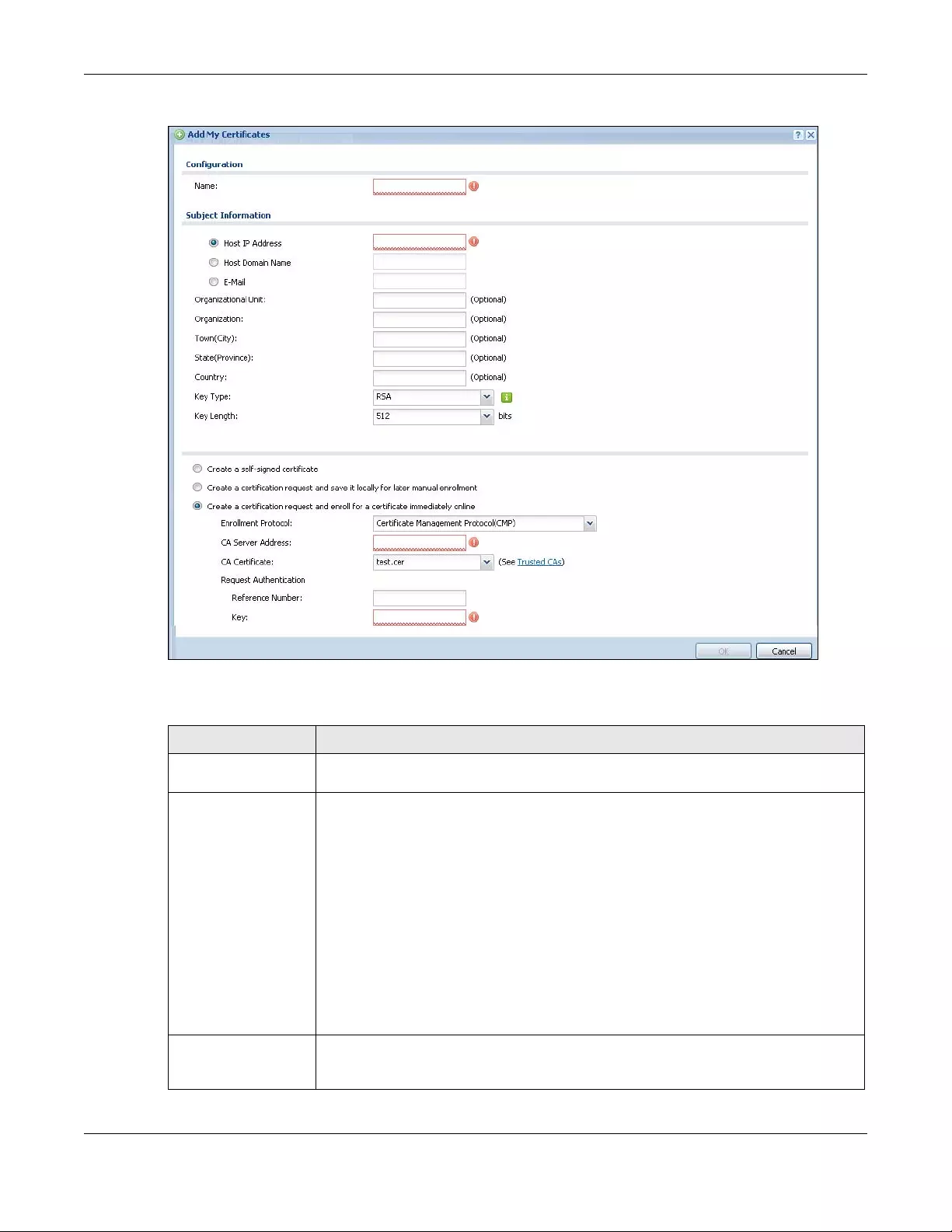
Chapter 35 Object
ZyWALL/USG Series User’s Guide
635
Figure 431 Configuration > Object > Certificate > My Certificates > Add
The following table describes the labels in this screen.
Table 281 Configuration > Object > Certificate > My Certificates > Add
LABEL DESCRIPTION
Name Type a name to identify this certificate. You can use up to 31 alphanumeric and
;‘~!@#$%^&()_+[]{}’,.=- characters.
Subject Information Use these fields to record information that identifies the owner of the certificate. You
do not have to fill in every field, although you must specify a Host IP Address, Host
IPv6 Address, Host Domain Name, or E-Mail. The certification authority may add
fields (such as a serial number) to the subject information when it issues a certificate.
It is recommended that each certificate have unique subject information.
Select a radio button to identify the certificate’s owner by IP address, domain name or
e-mail address. Type the IP address (in dotted decimal notation), domain name or e-
mail address in the field provided. The domain name or e-mail address is for
identification purposes only and can be any string.
A domain name can be up to 255 characters. You can use alphanumeric characters,
the hyphen and periods.
An e-mail address can be up to 63 characters. You can use alphanumeric characters,
the hyphen, the @ symbol, periods and the underscore.
Organizational Unit Identify the organizational unit or department to which the certificate owner belongs.
You can use up to 31 characters. You can use alphanumeric characters, the hyphen
and the underscore.
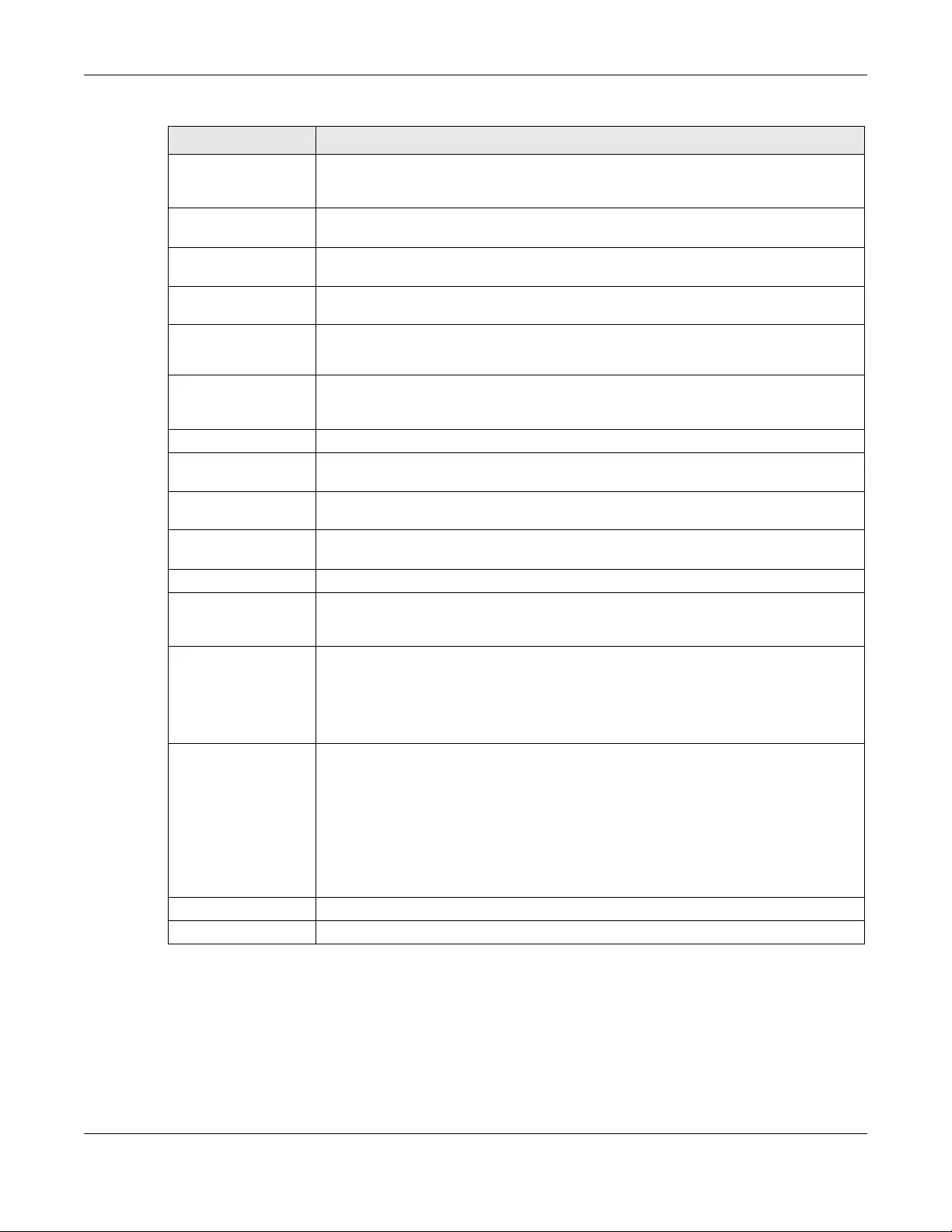
Chapter 35 Object
ZyWALL/USG Series User’s Guide
636
If you configured the My Certificate Create screen to have the ZyWALL/USG enroll a certificate
and the certificate enrollment is not successful, you see a screen with a Return button that takes
you back to the My Certificate Create screen. Click Return and check your information in the My
Certificate Create screen. Make sure that the certification authority information is correct and that
your Internet connection is working properly if you want the ZyWALL/USG to enroll a certificate
online.
Organization Identify the company or group to which the certificate owner belongs. You can use up
to 31 characters. You can use alphanumeric characters, the hyphen and the
underscore.
Town (City) Identify the town or city where the certificate owner is located. You can use up to 31
characters. You can use alphanumeric characters, the hyphen and the underscore.
State, (Province) Identify the state or province where the certificate owner is located. You can use up to
31 characters. You can use alphanumeric characters, the hyphen and the underscore.
Country Identify the nation where the certificate owner is located. You can use up to 31
characters. You can use alphanumeric characters, the hyphen and the underscore.
Key Type Select RSA to use the Rivest, Shamir and Adleman public-key algorithm.
Select DSA to use the Digital Signature Algorithm public-key algorithm.
Key Length Select a number from the drop-down list box to determine how many bits the key
should use (512 to 2048). The longer the key, the more secure it is. A longer key also
uses more PKI storage space.
Extended Key Usage
Server Authentication Select this to have ZyWALL/USG generate and store a request for server
authentication certificate.
Client Authentication Select this to have ZyWALL/USG generate and store a request for client
authentication certificate.
IKE Intermediate Select this to have ZyWALL/USG generate and store a request for IKE Intermediate
authentication certificate.
Create a self-signed
certificate
Select this to have the ZyWALL/USG generate the certificate and act as the
Certification Authority (CA) itself. This way you do not need to apply to a certification
authority for certificates.
Create a certification
request and save it
locally for later
manual enrollment
Select this to have the ZyWALL/USG generate and store a request for a certificate.
Use the My Certificate De tails screen to view the certification request and copy it to
send to the certification authority.
Copy the certification request from the My Certif icate Details screen (see Section
35.11.3.2 on page 637) and then send it to the certification authority.
Create a certification
request and enroll for
a certificate
immediately online
Select this to have the ZyWALL/USG generate a request for a certificate and apply to
a certification authority for a certificate.
You must have the certification authority’s certificate already imported in the Trusted
Certificates screen.
When you select this option, you must select the certification authority’s enrollment
protocol and the certification authority’s certificate from the drop-down list boxes and
enter the certification authority’s server address. You also need to fill in the
Reference Number and Key if the certification authority requires them.
OK Click OK to begin certificate or certification request generation.
Cancel Click Cancel to quit and return to the My Certificates screen.
Table 281 Configuration > Object > Certificate > My Certificates > Add (continued)
LABEL DESCRIPTION
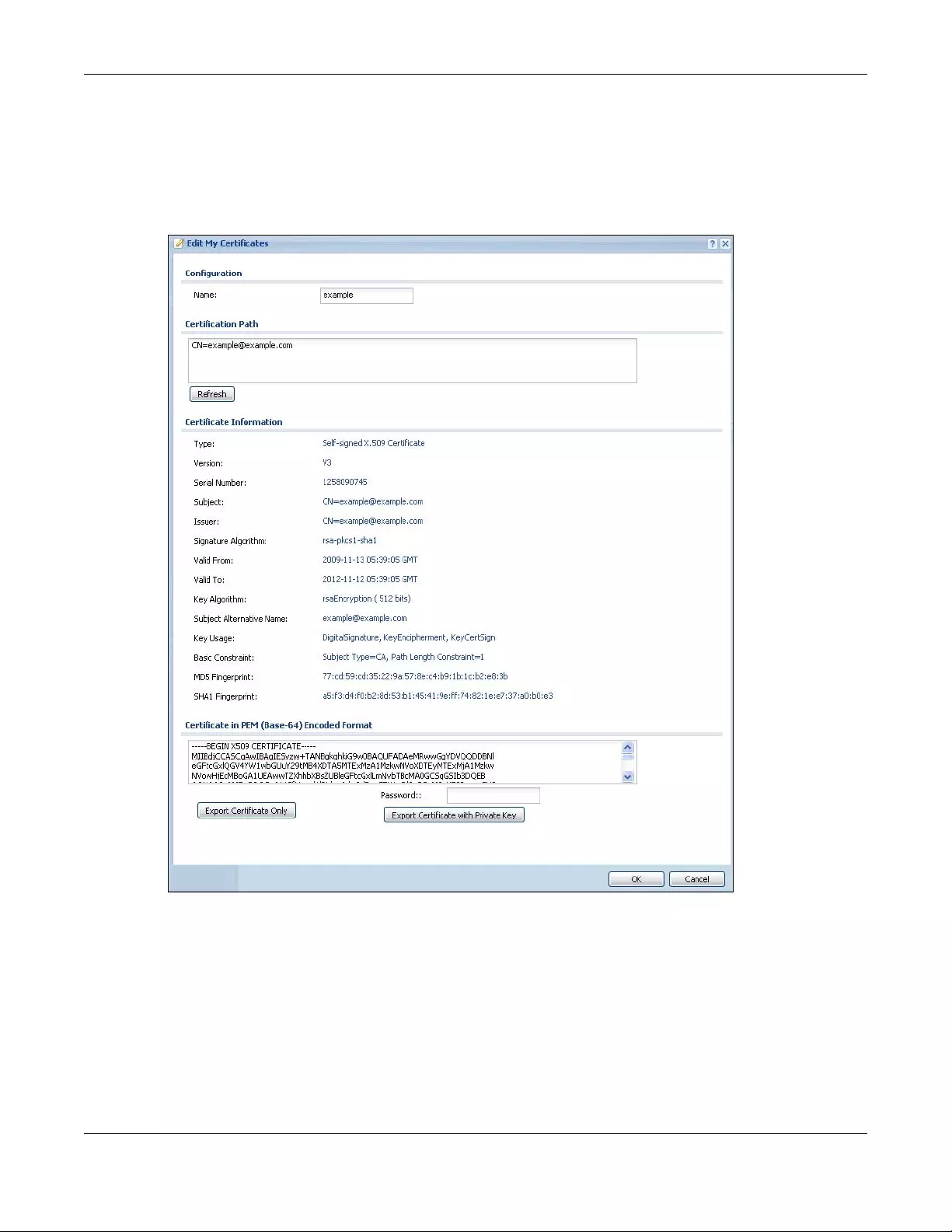
Chapter 35 Object
ZyWALL/USG Series User’s Guide
637
35.11.3.2 The My Certificates Edit Screen
Click Configuration > Object > Certificate > My Certificates and then the Edit icon to open
the My Certificate Edit screen. You can use this screen to view in-depth certificate information
and change the certificate’s name.
Figure 432 Configuration > Object > Certificate > My Certificates > Edit
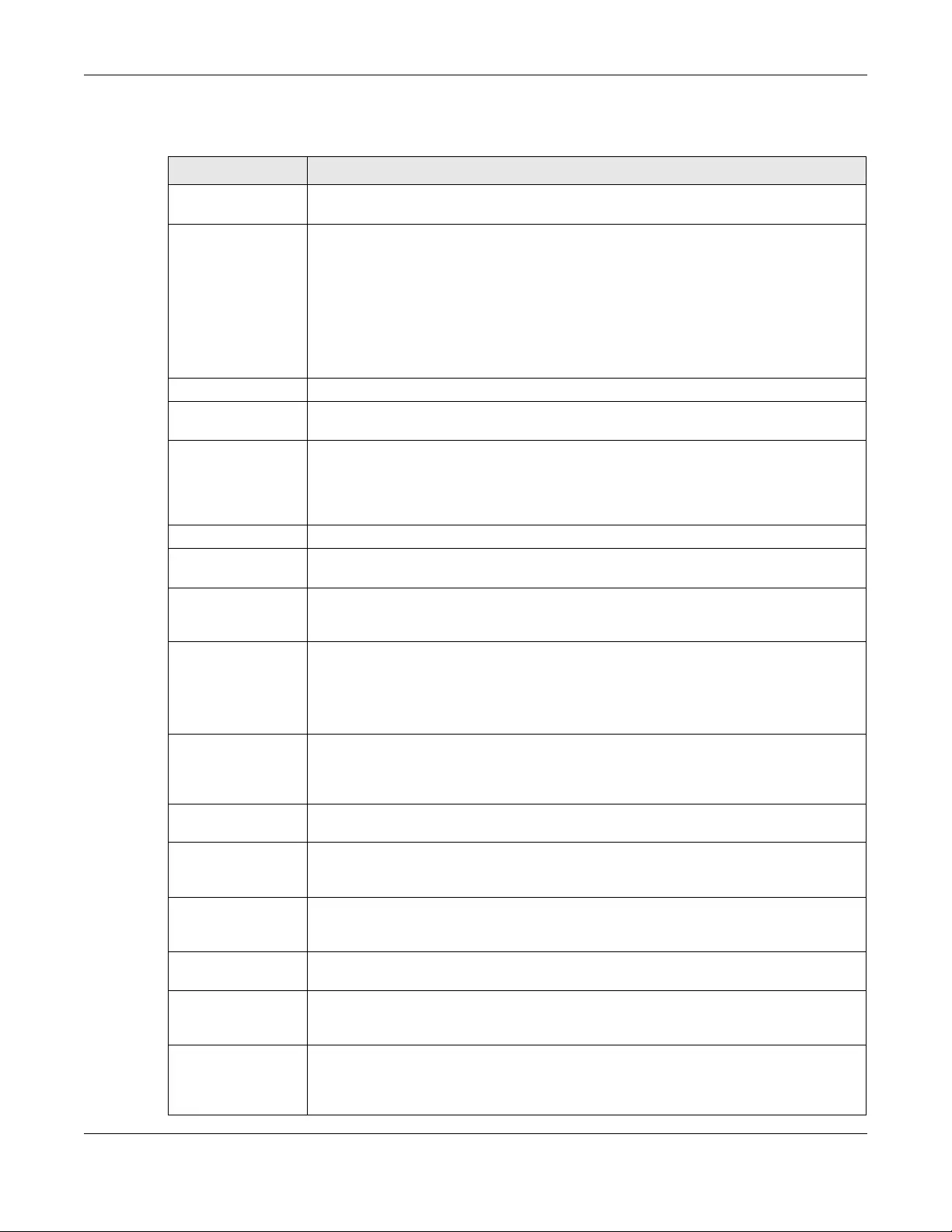
Chapter 35 Object
ZyWALL/USG Series User’s Guide
638
The following table describes the labels in this screen.
Table 282 Configuration > Object > Certificate > My Certificates > Edit
LABEL DESCRIPTION
Name This field displays the identifying name of this certificate. You can use up to 31
alphanumeric and ;‘~!@#$%^&()_+[]{}’,.=- characters.
Certification Path This field displays for a certificate, not a certification request.
Click the Refresh button to have this read-only text box display the hierarchy of
certification authorities that validate the certificate (and the certificate itself).
If the issuing certification authority is one that you have imported as a trusted
certification authority, it may be the only certification authority in the list (along with
the certificate itself). If the certificate is a self-signed certificate, the certificate itself is
the only one in the list. The ZyWALL/USG does not trust the certificate and displays
“Not trusted” in this field if any certificate on the path has expired or been revoked.
Refresh Click Refresh to display the certification path.
Certificate
Information
These read-only fields display detailed information about the certificate.
Type This field displays general information about the certificate. CA-signed means that a
Certification Authority signed the certificate. Self-signed means that the certificate’s
owner signed the certificate (not a certification authority). “X.509” means that this
certificate was created and signed according to the ITU-T X.509 recommendation that
defines the formats for public-key certificates.
Version This field displays the X.509 version number.
Serial Number This field displays the certificate’s identification number given by the certification
authority or generated by the ZyWALL/USG.
Subject This field displays information that identifies the owner of the certificate, such as
Common Name (CN), Organizational Unit (OU), Organization (O), State (ST), and
Country (C).
Issuer This field displays identifying information about the certificate’s issuing certification
authority, such as Common Name, Organizational Unit, Organization and Country.
With self-signed certificates, this is the same as the Subject Name field.
“none” displays for a certification request.
Signature Algorithm This field displays the type of algorithm that was used to sign the certificate. The
ZyWALL/USG uses rsa-pkcs1-sha1 (RSA public-private key encryption algorithm and
the SHA1 hash algorithm). Some certification authorities may use rsa-pkcs1-md5 (RSA
public-private key encryption algorithm and the MD5 hash algorithm).
Valid From This field displays the date that the certificate becomes applicable. “none” displays for a
certification request.
Valid To This field displays the date that the certificate expires. The text displays in red and
includes an Expired! message if the certificate has expired. “none” displays for a
certification request.
Key Algorithm This field displays the type of algorithm that was used to generate the certificate’s key
pair (the ZyWALL/USG uses RSA encryption) and the length of the key set in bits (1024
bits for example).
Subject Alternative
Name
This field displays the certificate owner‘s IP address (IP), domain name (DNS) or e-mail
address (EMAIL).
Key Usage This field displays for what functions the certificate’s key can be used. For example,
“DigitalSignature” means that the key can be used to sign certificates and
“KeyEncipherment” means that the key can be used to encrypt text.
Basic Constraint This field displays general information about the certificate. For example, Subject
Type=CA means that this is a certification authority’s certificate and “Path Length
Constraint=1” means that there can only be one certification authority in the
certificate’s path. This field does not display for a certification request.
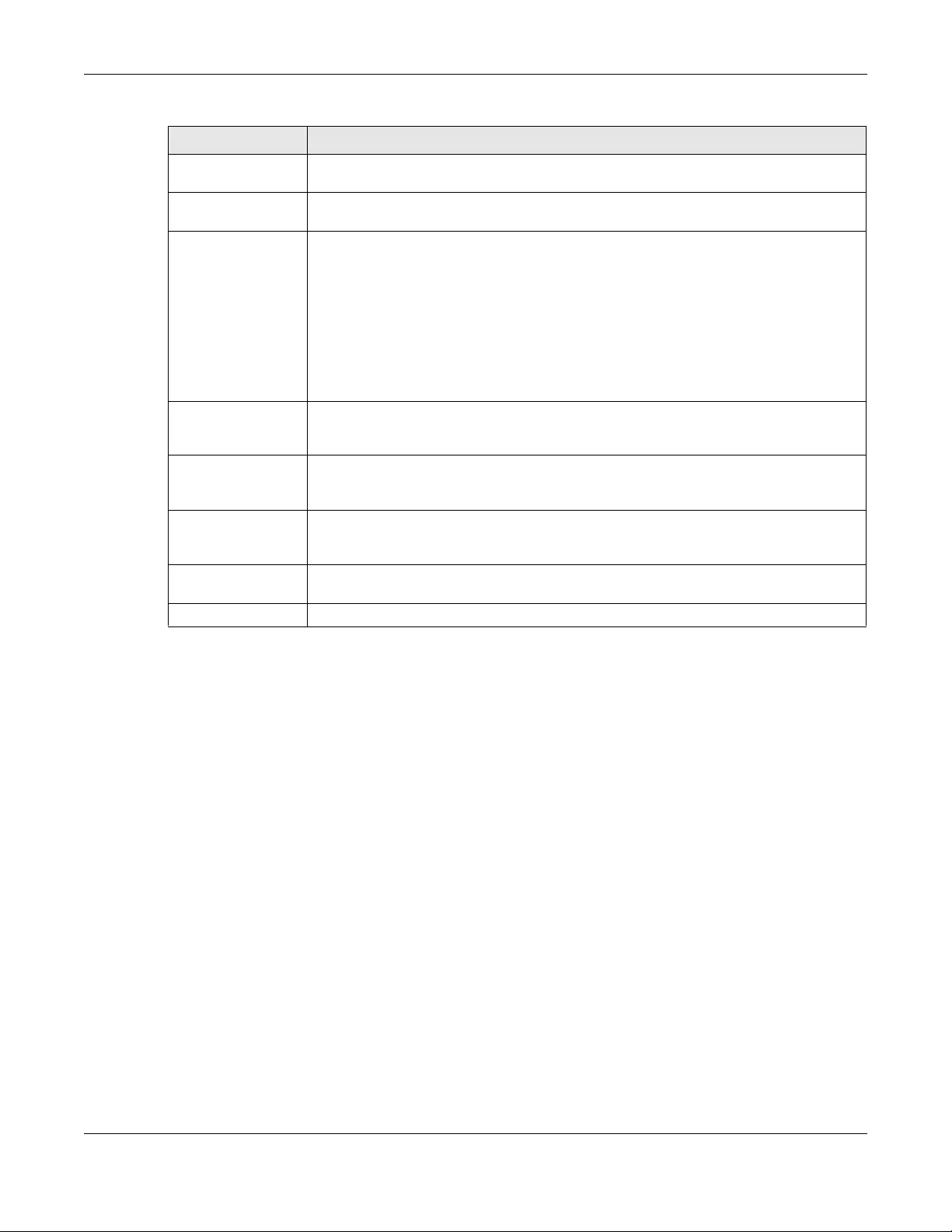
Chapter 35 Object
ZyWALL/USG Series User’s Guide
639
35.11.3.3 The My Certificates Import Screen
Click Configuration > Object > Certificate > My Certificates > Import to open the My
Certificate Import screen. Follow the instructions in this screen to save an existing certificate to
the ZyWALL/USG.
Note: You can import a certificate that matches a corresponding certification request that
was generated by the ZyWALL/USG. You can also import a certificate in PKCS#12
format, including the certificate’s public and private keys.
The certificate you import replaces the corresponding request in the My Certificates screen.
You must remove any spaces from the certificate’s filename before you can import it.
MD5 Fingerprint This is the certificate’s message digest that the ZyWALL/USG calculated using the MD5
algorithm.
SHA1 Fingerprint This is the certificate’s message digest that the ZyWALL/USG calculated using the SHA1
algorithm.
Certificate in PEM
(Base-64) Encoded
Format
This read-only text box displays the certificate or certification request in Privacy
Enhanced Mail (PEM) format. PEM uses lowercase letters, uppercase letters and
numerals to convert a binary certificate into a printable form.
You can copy and paste a certification request into a certification authority’s web page,
an e-mail that you send to the certification authority or a text editor and save the file
on a management computer for later manual enrollment.
You can copy and paste a certificate into an e-mail to send to friends or colleagues or
you can copy and paste a certificate into a text editor and save the file on a
management computer for later distribution (via floppy disk for example).
Export Certificate
Only
Use this button to save a copy of the certificate without its private key. Click this button
and then Save in the File Download screen. The Save As screen opens, browse to
the location that you want to use and click Save.
Password If you want to export the certificate with its private key, create a password and type it
here. Make sure you keep this password in a safe place. You will need to use it if you
import the certificate to another device.
Export Certificate
with Private Key
Use this button to save a copy of the certificate with its private key. Type the
certificate’s password and click this button. Click Save in the File Download screen.
The Save As screen opens, browse to the location that you want to use and click Save.
OK Click OK to save your changes back to the ZyWALL/USG. You can only change the
name.
Cancel Click Cancel to quit and return to the My Certificates screen.
Table 282 Configuration > Object > Certificate > My Certificates > Edit (continued)
LABEL DESCRIPTION
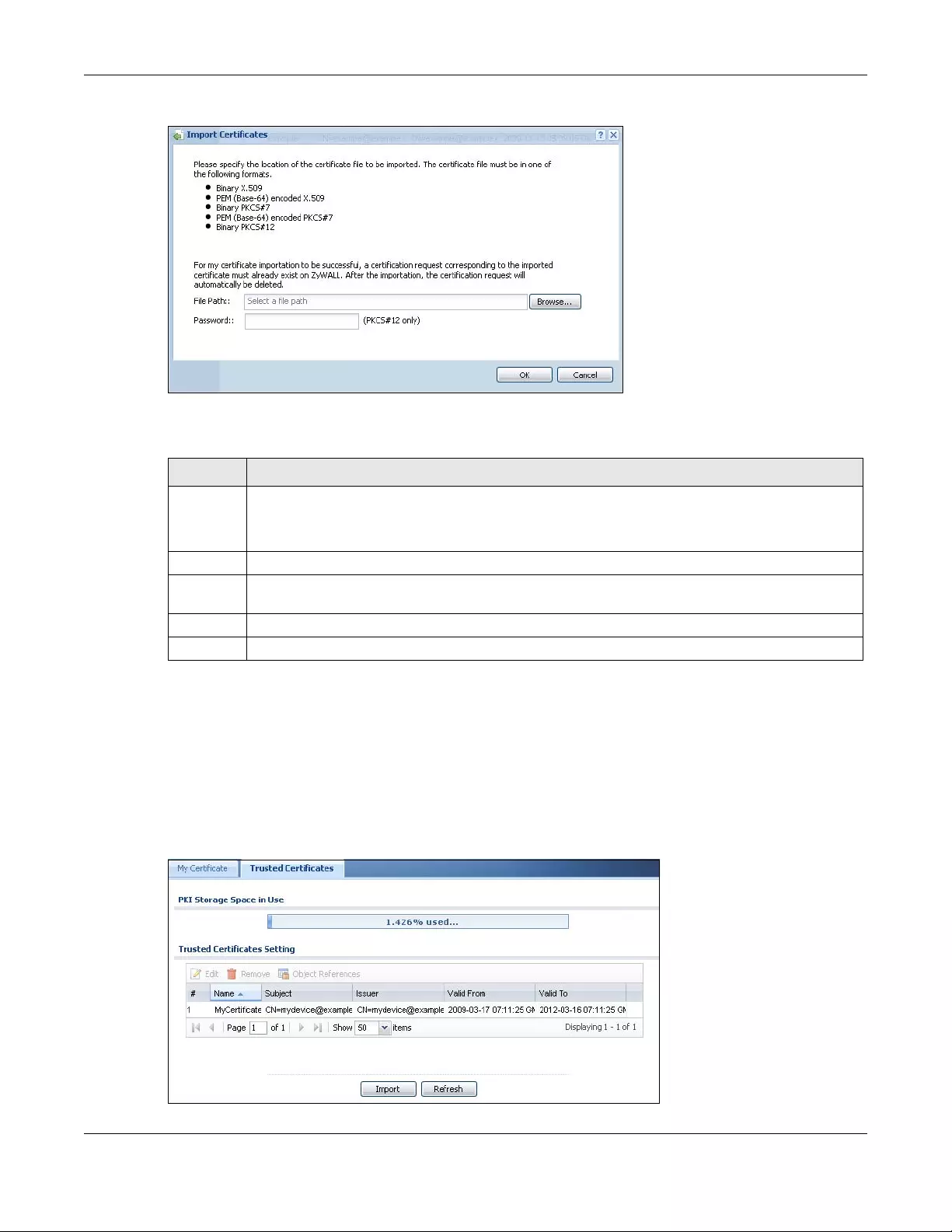
Chapter 35 Object
ZyWALL/USG Series User’s Guide
640
Figure 433 Configuration > Object > Certificate > My Certificates > Import
The following table describes the labels in this screen.
35.11.4 The Trusted Certificates Screen
Click Configuration > Object > Certificate > Trusted Certificates to open the Trusted
Certificates screen. This screen displays a summary list of certificates that you have set the
ZyWALL/USG to accept as trusted. The ZyWALL/USG also accepts any valid certificate signed by a
certificate on this list as being trustworthy; thus you do not need to import any certificate that is
signed by one of these certificates.
Figure 434 Configuration > Object > Certificate > Trusted Certificates
Table 283 Configuration > Object > Certificate > My Certificates > Import
LABEL DESCRIPTION
File Path Type in the location of the file you want to upload in this field or click Browse to find it.
You cannot import a certificate with the same name as a certificate that is already in the
ZyWALL/USG.
Browse Click Browse to find the certificate file you want to upload.
Password This field only applies when you import a binary PKCS#12 format file. Type the file’s password
that was created when the PKCS #12 file was exported.
OK Click OK to save the certificate on the ZyWALL/USG.
Cancel Click Cancel to quit and return to the My Certificates screen.
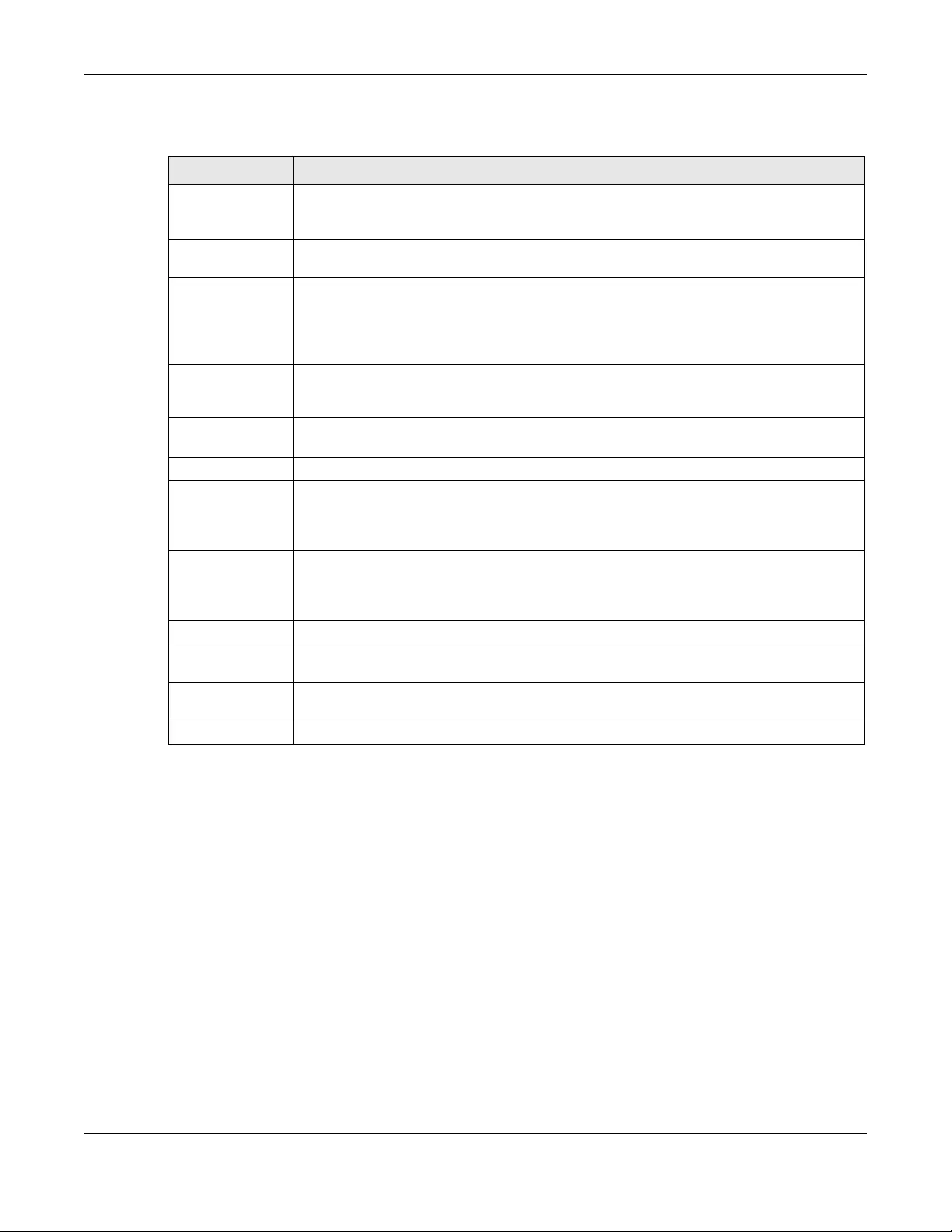
Chapter 35 Object
ZyWALL/USG Series User’s Guide
641
The following table describes the labels in this screen.
35.11.4.1 The Trusted Certificates Edit Screen
Click Configuration > Object > Certific ate > Tru sted C ertif ic ates and then a certificate’s Edit
icon to open the Trusted Certificates Edit screen. Use this screen to view in-depth information
about the certificate, change the certificate’s name and set whether or not you want the ZyWALL/
USG to check a certification authority’s list of revoked certificates before trusting a certificate issued
by the certification authority.
Table 284 Configuration > Object > Certificate > Trusted Certificates
LABEL DESCRIPTION
PKI Storage
Space in Use
This bar displays the percentage of the ZyWALL/USG’s PKI storage space that is currently
in use. When the storage space is almost full, you should consider deleting expired or
unnecessary certificates before adding more certificates.
Edit Double-click an entry or select it and click Edit to open a screen with an in-depth list of
information about the certificate.
Remove The ZyWALL/USG keeps all of your certificates unless you specifically delete them.
Uploading a new firmware or default configuration file does not delete your certificates.
To remove an entry, select it and click Remove. The ZyWALL/USG confirms you want to
remove it before doing so. Subsequent certificates move up by one when you take this
action.
Object
References
You cannot delete certificates that any of the ZyWALL/USG’s features are configured to
use. Select an entry and click Object References to open a screen that shows which
settings use the entry.
# This field displays the certificate index number. The certificates are listed in alphabetical
order.
Name This field displays the name used to identify this certificate.
Subject This field displays identifying information about the certificate’s owner, such as CN
(Common Name), OU (Organizational Unit or department), O (Organization or company)
and C (Country). It is recommended that each certificate have unique subject
information.
Issuer This field displays identifying information about the certificate’s issuing certification
authority, such as a common name, organizational unit or department, organization or
company and country. With self-signed certificates, this is the same information as in the
Subject field.
Valid From This field displays the date that the certificate becomes applicable.
Valid To This field displays the date that the certificate expires. The text displays in red and
includes an Expired! message if the certificate has expired.
Import Click Import to open a screen where you can save the certificate of a certification
authority that you trust, from your computer to the ZyWALL/USG.
Refresh Click this button to display the current validity status of the certificates.
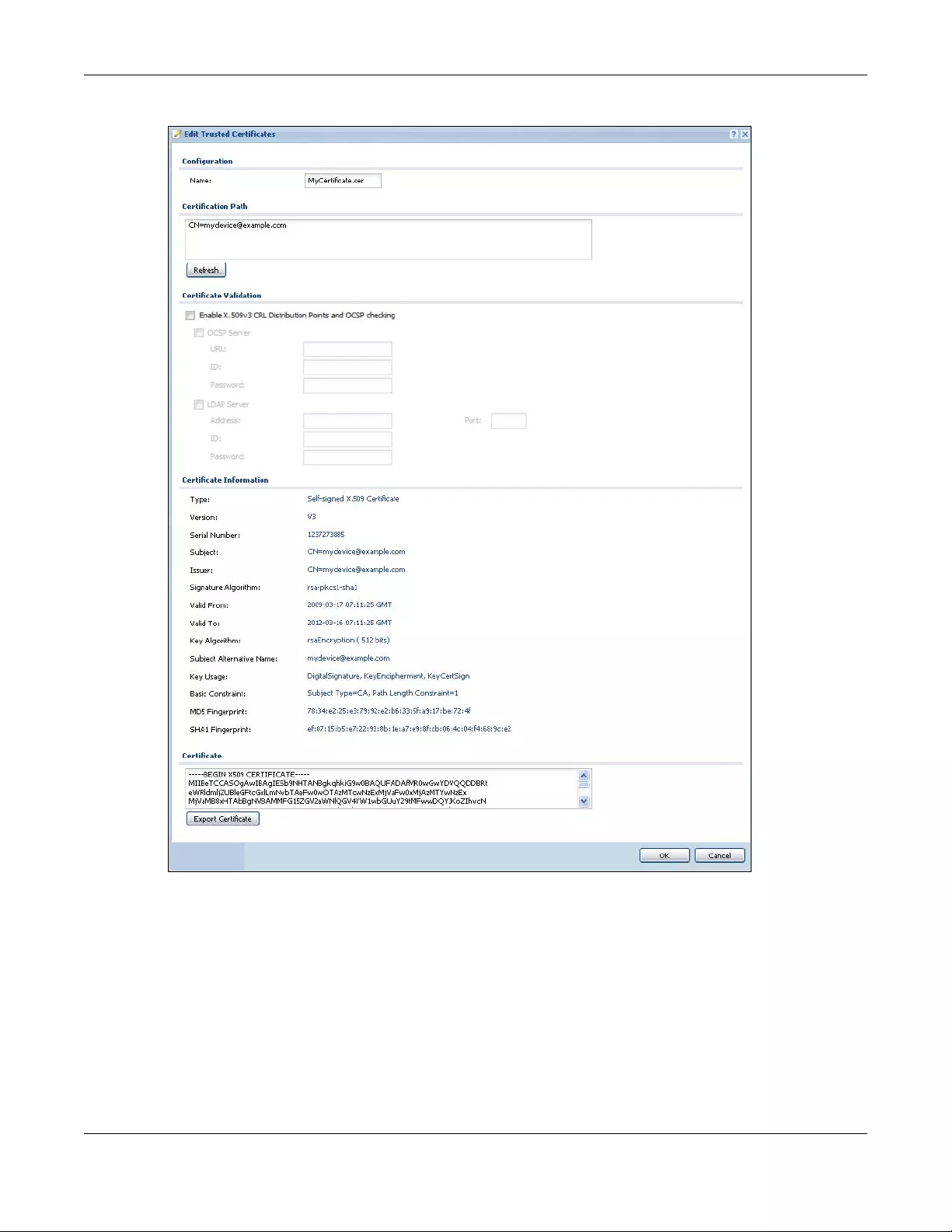
Chapter 35 Object
ZyWALL/USG Series User’s Guide
642
Figure 435 Configuration > Object > Certificate > Trusted Certificates > Edit
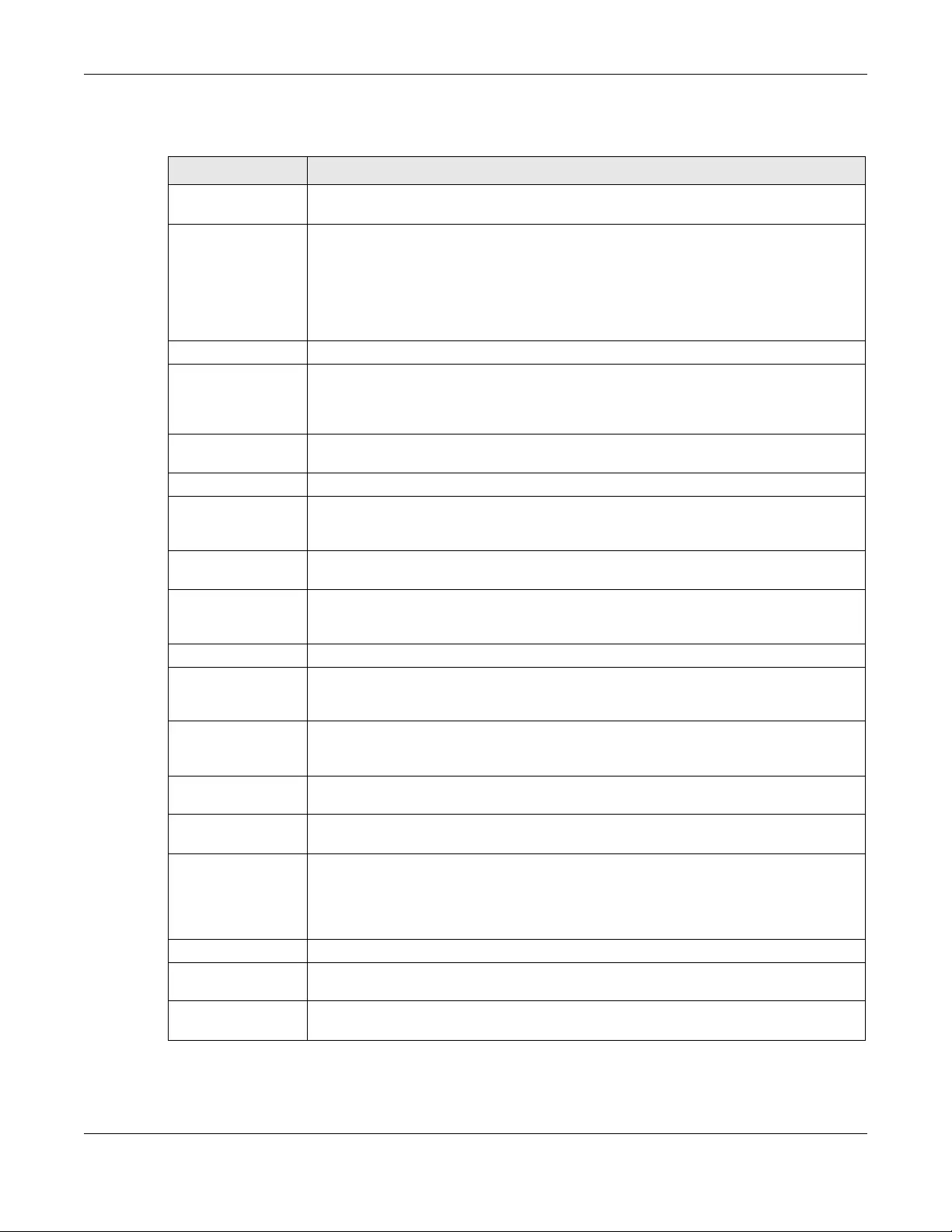
Chapter 35 Object
ZyWALL/USG Series User’s Guide
643
The following table describes the labels in this screen.
Table 285 Configuration > Object > Certificate > Trusted Certificates > Edit
LABEL DESCRIPTION
Name This field displays the identifying name of this certificate. You can change the name.
You can use up to 31 alphanumeric and ;‘~!@#$%^&()_+[]{}’,.=- characters.
Certification Path Click the Refresh button to have this read-only text box display the end entity’s
certificate and a list of certification authority certificates that shows the hierarchy of
certification authorities that validate the end entity’s certificate. If the issuing
certification authority is one that you have imported as a trusted certificate, it may be
the only certification authority in the list (along with the end entity’s own certificate).
The ZyWALL/USG does not trust the end entity’s certificate and displays “Not trusted”
in this field if any certificate on the path has expired or been revoked.
Refresh Click Refresh to display the certification path.
Enable X.509v3 CRL
Distribution Points
and OCSP checking
Select this check box to turn on/off certificate revocation. When it is turned on, the
ZyWALL/USG validates a certificate by getting Certificate Revocation List (CRL) through
HTTP or LDAP (can be configured after selecting the LDAP Server check box) and
online responder (can be configured after selecting the OCSP Server check box).
OCSP Server Select this check box if the directory server uses OCSP (Online Certificate Status
Protocol).
URL Type the protocol, IP address and path name of the OCSP server.
ID The ZyWALL/USG may need to authenticate itself in order to assess the OCSP server.
Type the login name (up to 31 ASCII characters) from the entity maintaining the server
(usually a certification authority).
Password Type the password (up to 31 ASCII characters) from the entity maintaining the OCSP
server (usually a certification authority).
LDAP Server Select this check box if the directory server uses LDAP (Lightweight Directory Access
Protocol). LDAP is a protocol over TCP that specifies how clients access directories of
certificates and lists of revoked certificates.
Address Type the IP address (in dotted decimal notation) of the directory server.
Port Use this field to specify the LDAP server port number. You must use the same server
port number that the directory server uses. 389 is the default server port number for
LDAP.
ID The ZyWALL/USG may need to authenticate itself in order to assess the CRL directory
server. Type the login name (up to 31 ASCII characters) from the entity maintaining
the server (usually a certification authority).
Password Type the password (up to 31 ASCII characters) from the entity maintaining the CRL
directory server (usually a certification authority).
Certificate
Information
These read-only fields display detailed information about the certificate.
Type This field displays general information about the certificate. CA-signed means that a
Certification Authority signed the certificate. Self-signed means that the certificate’s
owner signed the certificate (not a certification authority). X.509 means that this
certificate was created and signed according to the ITU-T X.509 recommendation that
defines the formats for public-key certificates.
Version This field displays the X.509 version number.
Serial Number This field displays the certificate’s identification number given by the certification
authority.
Subject This field displays information that identifies the owner of the certificate, such as
Common Name (CN), Organizational Unit (OU), Organization (O) and Country (C).

Chapter 35 Object
ZyWALL/USG Series User’s Guide
644
35.11.4.2 The Trusted Certificates Import Screen
Click Configuration > Object > Certificate > Trusted Certificates > Import to open the
Trusted Certificates Import screen. Follow the instructions in this screen to save a trusted
certificate to the ZyWALL/USG.
Note: You must remove any spaces from the certificate’s filename before you can import
the certificate.
Issuer This field displays identifying information about the certificate’s issuing certification
authority, such as Common Name, Organizational Unit, Organization and Country.
With self-signed certificates, this is the same information as in the Subject Name
field.
Signature Algorithm This field displays the type of algorithm that was used to sign the certificate. Some
certification authorities use rsa-pkcs1-sha1 (RSA public-private key encryption
algorithm and the SHA1 hash algorithm). Other certification authorities may use rsa-
pkcs1-md5 (RSA public-private key encryption algorithm and the MD5 hash algorithm).
Valid From This field displays the date that the certificate becomes applicable. The text displays in
red and includes a Not Yet Valid! message if the certificate has not yet become
applicable.
Valid To This field displays the date that the certificate expires. The text displays in red and
includes an Expiring! or Expired! message if the certificate is about to expire or has
already expired.
Key Algorithm This field displays the type of algorithm that was used to generate the certificate’s key
pair (the ZyWALL/USG uses RSA encryption) and the length of the key set in bits (1024
bits for example).
Subject Alternative
Name
This field displays the certificate’s owner‘s IP address (IP), domain name (DNS) or e-
mail address (EMAIL).
Key Usage This field displays for what functions the certificate’s key can be used. For example,
“DigitalSignature” means that the key can be used to sign certificates and
“KeyEncipherment” means that the key can be used to encrypt text.
Basic Constraint This field displays general information about the certificate. For example, Subject
Type=CA means that this is a certification authority’s certificate and “Path Length
Constraint=1” means that there can only be one certification authority in the
certificate’s path.
MD5 Fingerprint This is the certificate’s message digest that the ZyWALL/USG calculated using the MD5
algorithm. You can use this value to verify with the certification authority (over the
phone for example) that this is actually their certificate.
SHA1 Fingerprint This is the certificate’s message digest that the ZyWALL/USG calculated using the SHA1
algorithm. You can use this value to verify with the certification authority (over the
phone for example) that this is actually their certificate.
Certificate This read-only text box displays the certificate or certification request in Privacy
Enhanced Mail (PEM) format. PEM uses lowercase letters, uppercase letters and
numerals to convert a binary certificate into a printable form.
You can copy and paste the certificate into an e-mail to send to friends or colleagues or
you can copy and paste the certificate into a text editor and save the file on a
management computer for later distribution (via floppy disk for example).
Export Certificate Click this button and then Save in the File Download screen. The Save As screen
opens, browse to the location that you want to use and click Save.
OK Click OK to save your changes back to the ZyWALL/USG. You can only change the
name.
Cancel Click Cancel to quit and return to the Trusted Certificates screen.
Table 285 Configuration > Object > Certificate > Trusted Certificates > Edit (continued)
LABEL DESCRIPTION
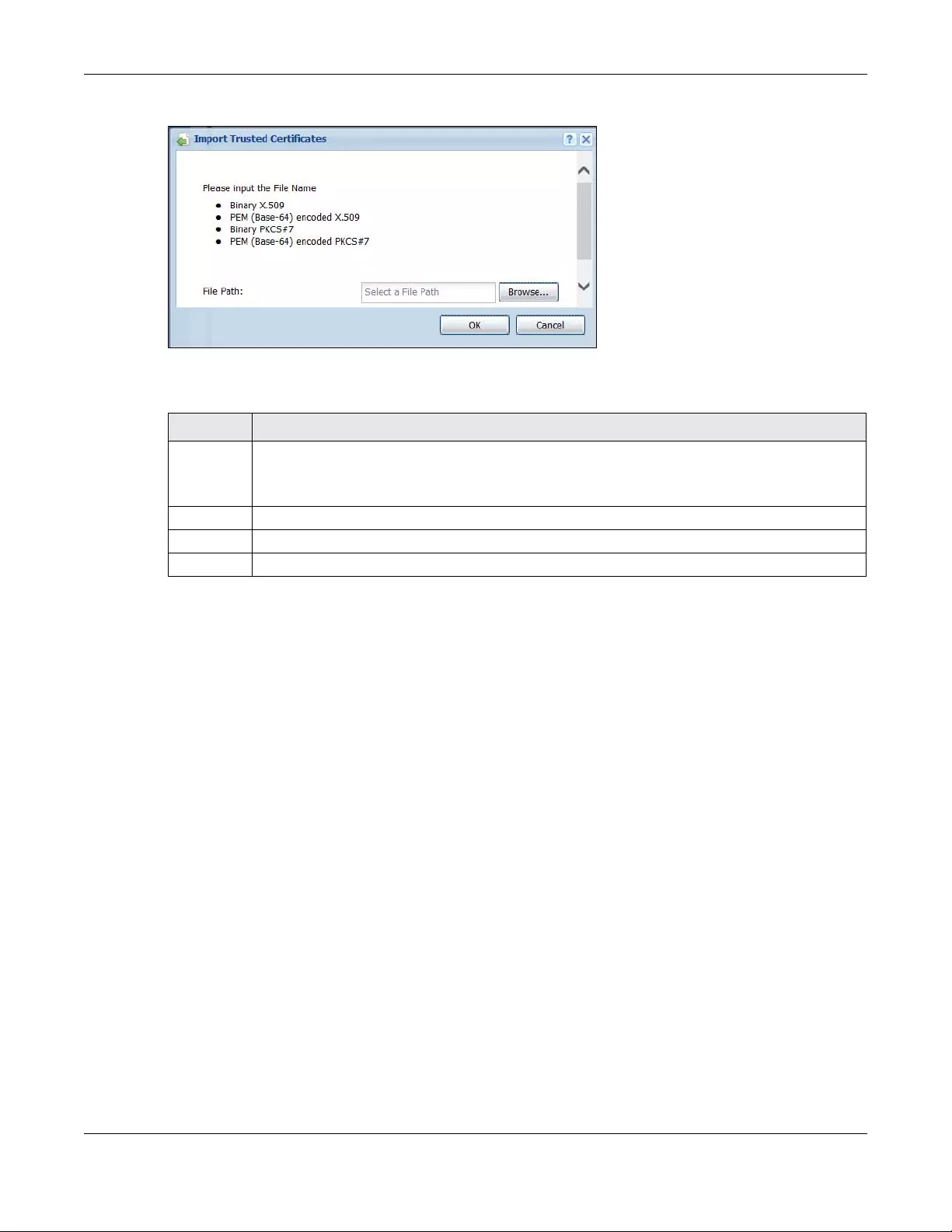
Chapter 35 Object
ZyWALL/USG Series User’s Guide
645
Figure 436 Configuration > Object > Certificate > Trusted Certificates > Import
The following table describes the labels in this screen.
35.11.5 Certificates Technical Reference
OCSP
OCSP (Online Certificate Status Protocol) allows an application or device to check whether a
certificate is valid. With OCSP the ZyWALL/USG checks the status of individual certificates instead
of downloading a Certificate Revocation List (CRL). OCSP has two main advantages over a CRL. The
first is real-time status information. The second is a reduction in network traffic since the ZyWALL/
USG only gets information on the certificates that it needs to verify, not a huge list. When the
ZyWALL/USG requests certificate status information, the OCSP server returns a “expired”, “current”
or “unknown” response.
35.12 ISP Account Overview
Use ISP accounts to manage Internet Service Provider (ISP) account information for PPPoE/PPTP
interfaces. An ISP account is a profile of settings for Internet access using PPPoE or PPTP.
Use the Object > ISP Account screens (Section 35.12.1 on page 646) to create and manage ISP
accounts in the ZyWALL/USG.
Table 286 Configuration > Object > Certificate > Trusted Certificates > Import
LABEL DESCRIPTION
File Path Type in the location of the file you want to upload in this field or click Browse to find it.
You cannot import a certificate with the same name as a certificate that is already in the
ZyWALL/USG.
Browse Click Browse to find the certificate file you want to upload.
OK Click OK to save the certificate on the ZyWALL/USG.
Cancel Click Cancel to quit and return to the previous screen.
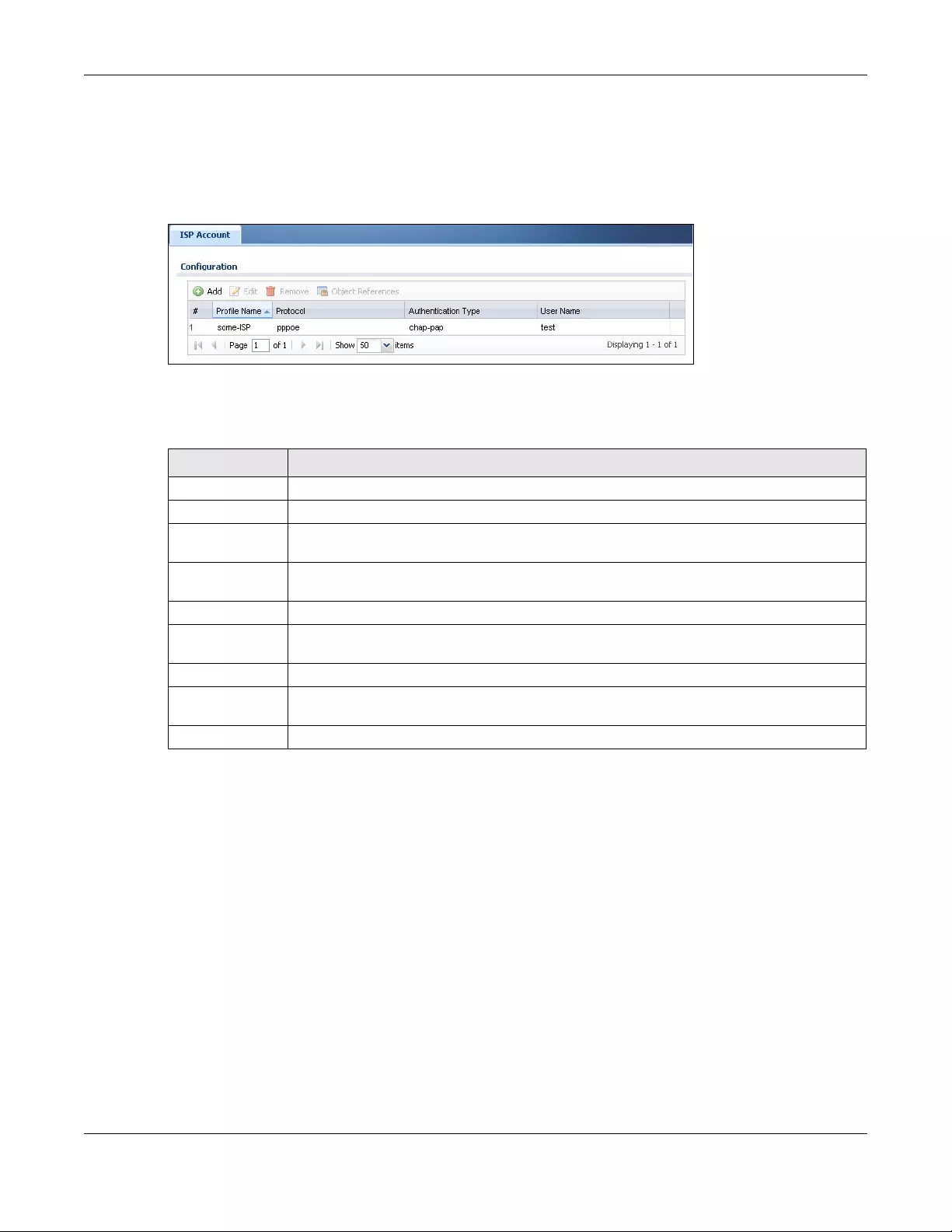
Chapter 35 Object
ZyWALL/USG Series User’s Guide
646
35.12.1 ISP Account Summary
This screen provides a summary of ISP accounts in the ZyWALL/USG. To access this screen, click
Configuration > Object > ISP Account.
Figure 437 Configuration > Object > ISP Account
The following table describes the labels in this screen. See the ISP Account Edit section below for
more information as well.
35.12.1.1 ISP Account Edit
The ISP Account Edit screen lets you add information about new accounts and edit information
about existing accounts. To open this window, open the ISP Account screen. (See Section 35.12.1
on page 646.) Then, click on an Add icon or Edit icon to open the ISP Account Edit screen below.
Table 287 Configuration > Object > ISP Account
LABEL DESCRIPTION
Add Click this to create a new entry.
Edit Double-click an entry or select it and click Edit to be able to modify the entry’s settings.
Remove To remove an entry, select it and click Remove. The ZyWALL/USG confirms you want to
remove it before doing so.
Object
References
Select an entry and click Object References to open a screen that shows which settings
use the entry.
# This field is a sequential value, and it is not associated with a specific entry.
Profile Name This field displays the profile name of the ISP account. This name is used to identify the
ISP account.
Protocol This field displays the protocol used by the ISP account.
Authentication
Type
This field displays the authentication type used by the ISP account.
User Name This field displays the user name of the ISP account.

Chapter 35 Object
ZyWALL/USG Series User’s Guide
647
Figure 438 Configuration > Object > ISP Account > Edit
The following table describes the labels in this screen.
Table 288 Configuration > Object > ISP Account > Edit
LABEL DESCRIPTION
Profile Name This field is read-only if you are editing an existing account. Type in the profile name of the
ISP account. The profile name is used to refer to the ISP account. You may use 1-31
alphanumeric characters, underscores(_), or dashes (-), but the first character cannot be
a number. This value is case-sensitive.
Protocol This field is read-only if you are editing an existing account. Select the protocol used by
the ISP account. Options are:
pppoe - This ISP account uses the PPPoE protocol.
pptp - This ISP account uses the PPTP protocol.
Authentication
Type
Use the drop-down list box to select an authentication protocol for outgoing calls. Options
are:
CHAP/PAP - Your ZyWALL/USG accepts either CHAP or PAP when requested by this
remote node.
Chap - Your ZyWALL/USG accepts CHAP only.
PAP - Your ZyWALL/USG accepts PAP only.
MSCHAP - Your ZyWALL/USG accepts MSCHAP only.
MSCHAP-V2 - Your ZyWALL/USG accepts MSCHAP-V2 only.
Encryption
Method
This field is available if this ISP account uses the PPTP protocol. Use the drop-down list
box to select the type of Microsoft Point-to-Point Encryption (MPPE). Options are:
nomppe - This ISP account does not use MPPE.
mppe-40 - This ISP account uses 40-bit MPPE.
mppe-128 - This ISP account uses 128-bit MMPE.
User Name Type the user name given to you by your ISP.
Password Type the password associated with the user name above. The password can only consist of
alphanumeric characters (A-Z, a-z, 0-9). This field can be blank.
Retype to
Confirm
Type your password again to make sure that you have entered is correctly.
Server IP If this ISP account uses the PPPoE protocol, this field is not displayed.
If this ISP account uses the PPTP protocol, type the IP address of the PPTP server.
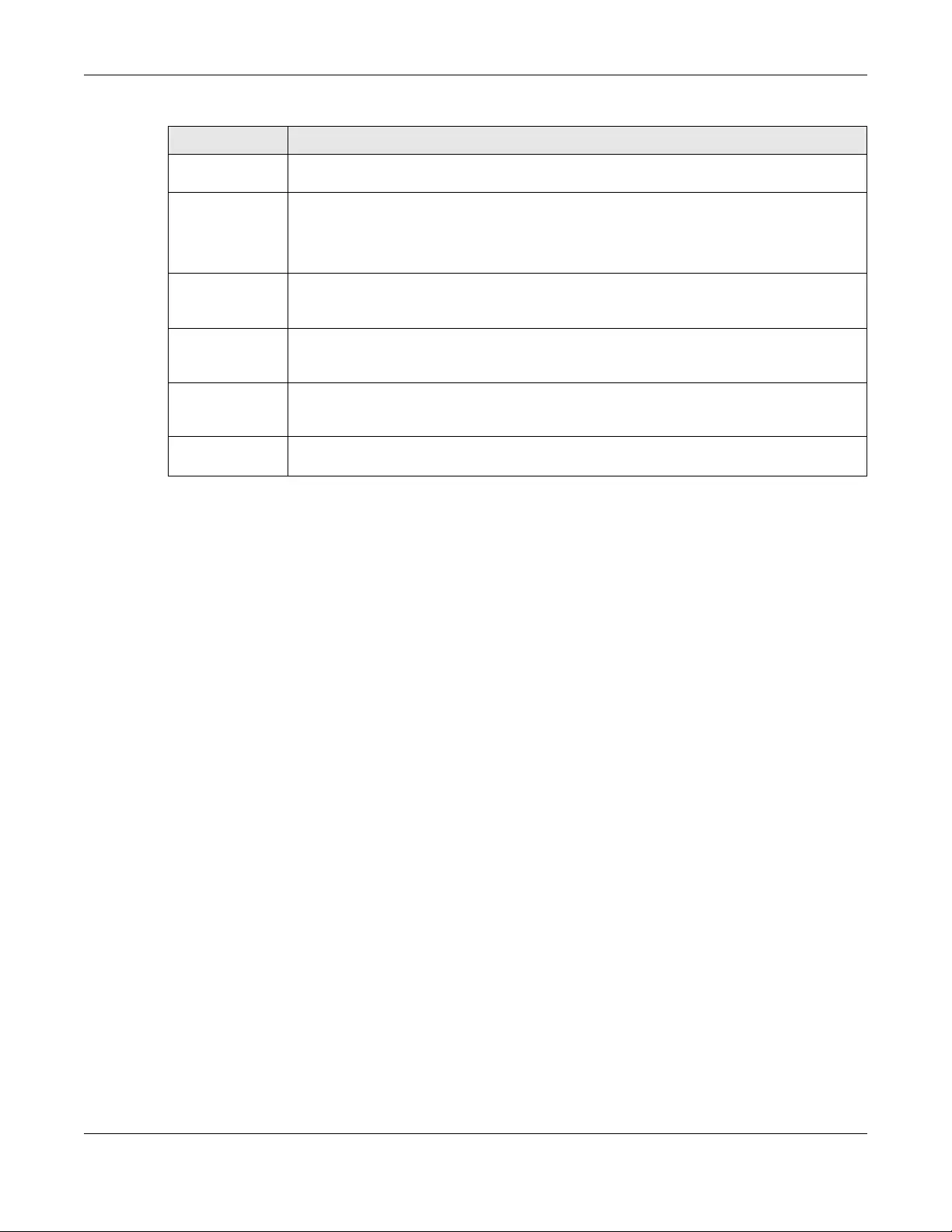
Chapter 35 Object
ZyWALL/USG Series User’s Guide
648
35.13 SSL Application Overview
You use SSL application objects in SSL VPN. Configure an SSL application object to specify the type
of application and the address of the local computer, server, or web site SSL users are to be able to
access. You can apply one or more SSL application objects in the VPN > SSL VPN screen for a user
account/user group.
•Use the SSL App lication screen (Section 35.13.2 on page 650) to view the ZyWALL/USG’s
configured SSL application objects.
•Use the SSL Application Edit screen to create or edit web-based application objects to allow
remote users to access an application via standard web browsers (Section 35.13.2.1 on page
651).
• You can also use the SSL Application Edit screen to specify the name of a folder on a Linux or
Windows file server which remote users can access using a standard web browser (Section
35.13.2.1 on page 651).
35.13.1 What You Need to Know
Application Types
You can configure the following SSL application on the ZyWALL/USG.
• Web-based
A web-based application allows remote users to access an intranet site using standard web
browsers.
Connection ID This field is available if this ISP account uses the PPTP protocol. Type your identification
name for the PPTP server. This field can be blank.
Service Name If this ISP account uses the PPPoE protocol, type the PPPoE service name to access. PPPoE
uses the specified service name to identify and reach the PPPoE server. This field can be
blank.
If this ISP account uses the PPTP protocol, this field is not displayed.
Compression Select On button to turn on stac compression, and select Off to turn off stac compression.
Stac compression is a data compression technique capable of compressing data by a factor
of about four.
Idle Timeout This value specifies the number of seconds that must elapse without outbound traffic
before the ZyWALL/USG automatically disconnects from the PPPoE/PPTP server. This value
must be an integer between 0 and 360. If this value is zero, this timeout is disabled.
OK Click OK to save your changes back to the ZyWALL/USG. If there are no errors, the
program returns to the ISP Account screen. If there are errors, a message box explains
the error, and the program stays in the ISP Account Edit screen.
Cancel Click Cancel to return to the ISP Account screen without creating the profile (if it is new)
or saving any changes to the profile (if it already exists).
Table 288 Configuration > Object > ISP Account > Edit (continued)
LABEL DESCRIPTION
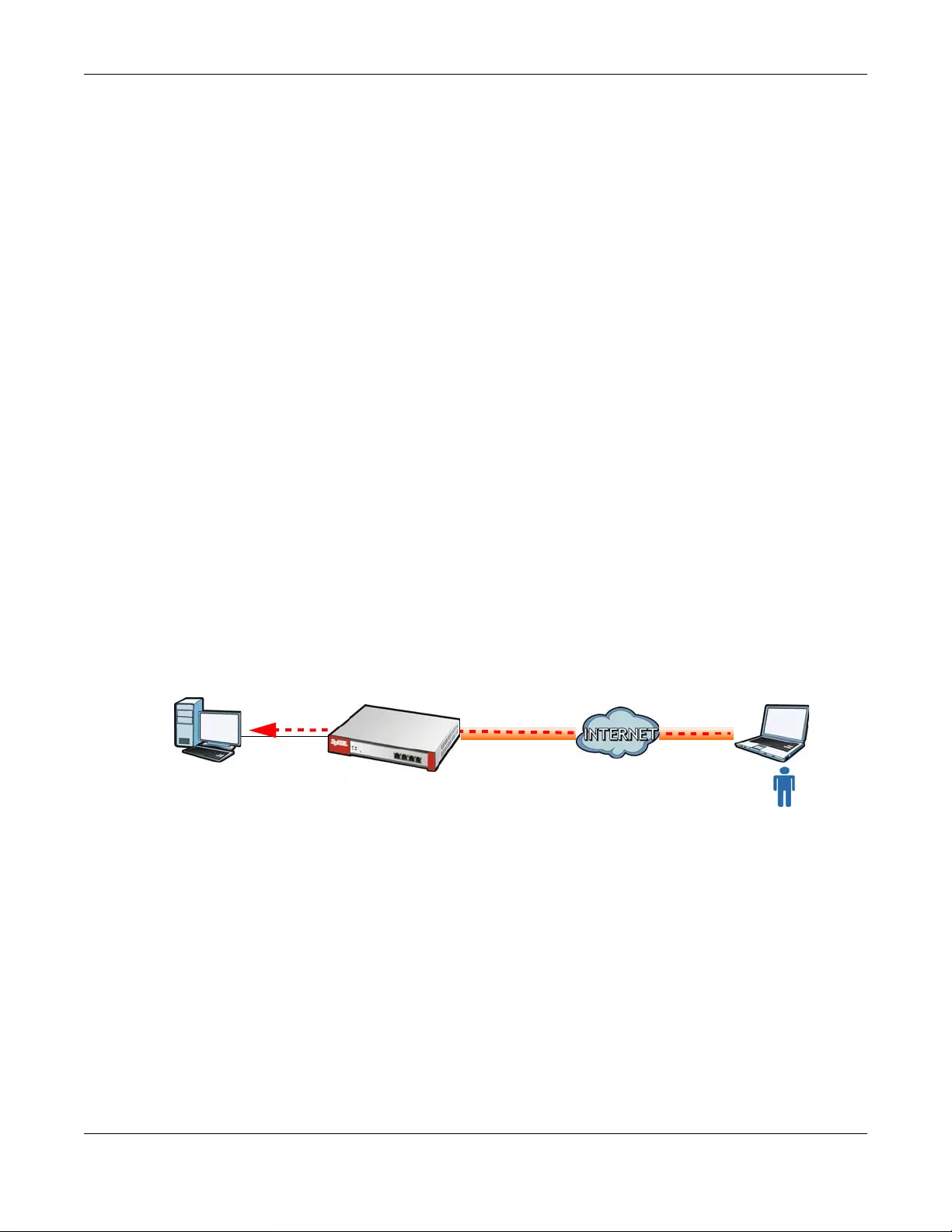
Chapter 35 Object
ZyWALL/USG Series User’s Guide
649
Remote User Screen Links
Available SSL application names are displayed as links in remote user screens. Depending on the
application type, remote users can simply click the links or follow the steps in the pop-up dialog box
to access.
Remote Desktop Connections
Use SSL VPN to allow remote users to manage LAN computers. Depending on the functions
supported by the remote desktop software, they can install or remove software, run programs,
change settings, and open, copy, create, and delete files. This is useful for troubleshooting,
support, administration, and remote access to files and programs.
The LAN computer to be managed must have VNC (Virtual Network Computing) or RDP (Remote
Desktop Protocol) server software installed. The remote user’s computer does not use VNC or RDP
client software. The ZyWALL/USG works with the following remote desktop connection software:
RDP
• Windows Remote Desktop (supported in Internet Explorer)
VNC
•RealVNC
•TightVNC
•UltraVNC
For example, user A uses an SSL VPN connection to log into the ZyWALL/USG. Then he manages
LAN computer B which has RealVNC server software installed.
Figure 439 SSL-protected Remote Management
Weblinks
You can configure weblink SSL applications to allow remote users to access web sites.
35.13.1.1 Example: Specifying a Web Site for Access
This example shows you how to create a web-based application for an internal web site. The
address of the web site is http://info with web page encryption.
1Click Configuration > Object > SSL Application in the navigation panel.
https://
A
SSL
B
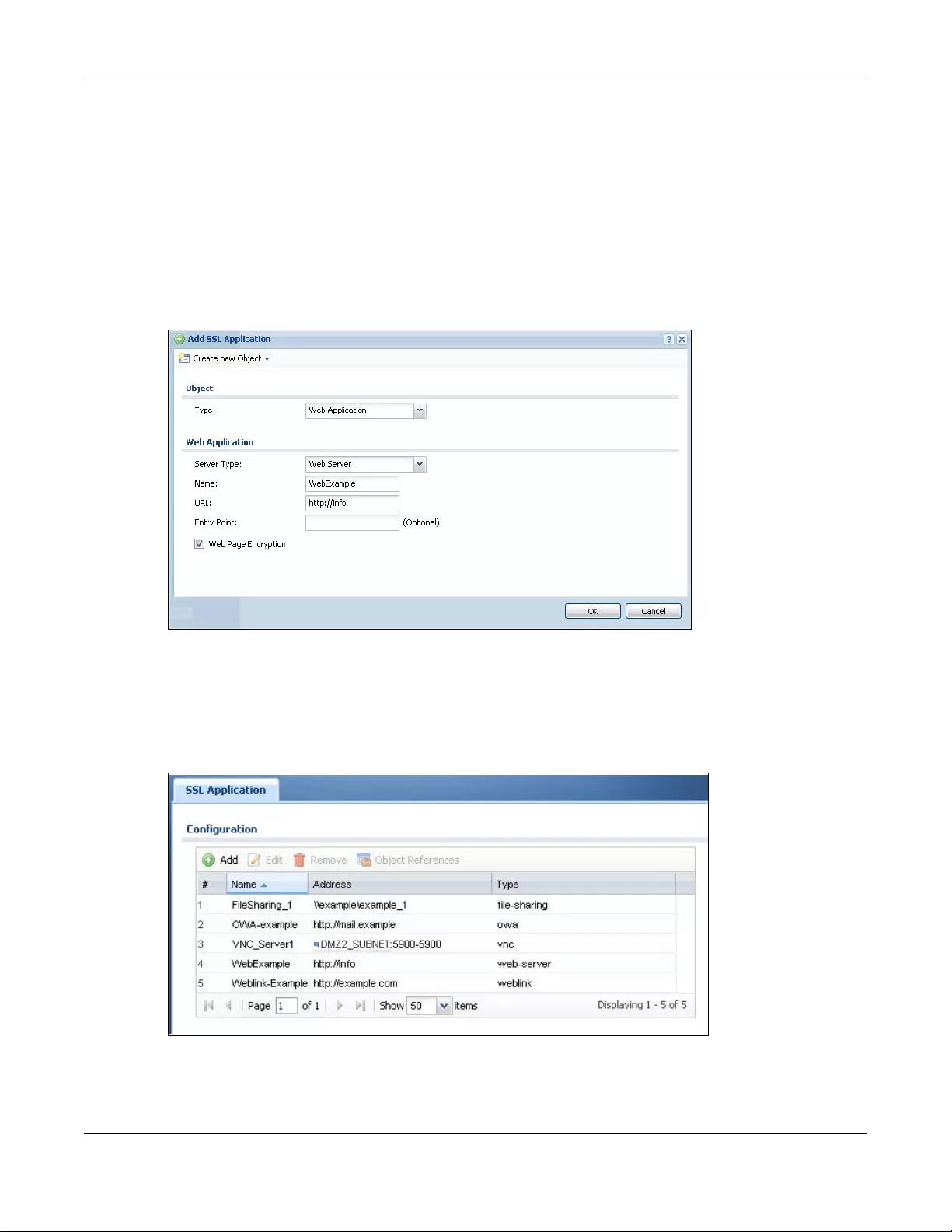
Chapter 35 Object
ZyWALL/USG Series User’s Guide
650
2Click the Add button and select Web Application in the Type field.
In the Server Type field, select Web Server.
Enter a descriptive name in the Display Name field. For example, “CompanyIntranet”.
In the URLAddress field, enter “http://my-info”.
Select Web Page Encryption to prevent users from saving the web content.
Click OK to save the settings.
The configuration screen should look similar to the following figure.
Figure 440 Example: SSL Application: Specifying a Web Site for Access
35.13.2 The SSL Application Screen
The main SSL Application screen displays a list of the configured SSL application objects. Click
Configuration > Object > SSL Application in the navigation panel.
Figure 441 Configuration > Object > SSL Application

Chapter 35 Object
ZyWALL/USG Series User’s Guide
651
The following table describes the labels in this screen.
35.13.2.1 Creating/Editing an SSL Application Object
You can create a web-based application that allows remote users to access an application via
standard web browsers. You can also create a file sharing application that specify the name of a
folder on a file server (Linux or Windows) which remote users can access. Remote users can access
files using a standard web browser and files are displayed as links on the screen.
To configure an SSL application, click the Add or Edit button in the SSL Application screen and
select Web Application or File Sharing in the Type field. The screen differs depending on what
object type you choose.
Note: If you are creating a file sharing SSL application, you must also configure the
shared folder on the file server for remote access. Refer to the document that
comes with your file server.
Figure 442 Configuration > Object > SSL Application > Add/Edit: Web Application
Table 289 Configuration > Object > SSL Application
LABEL DESCRIPTION
Add Click this to create a new entry.
Edit Double-click an entry or select it and click Edit to be able to modify the entry’s settings.
Remove To remove an entry, select it and click Remove. The ZyWALL/USG confirms you want to remove
it before doing so.
Object
References
Select an entry and click Object References to open a screen that shows which settings use
the entry.
# This field displays the index number.
Name This field displays the name of the object.
Address This field displays the IP address/URL of the application server or the location of a file share.
Type This field shows whether the object is a file-sharing, web-server, Outlook Web Access, Virtual
Network Computing, or Remote Desktop Protocol SSL application.

Chapter 35 Object
ZyWALL/USG Series User’s Guide
652
Figure 443 Configuration > Object > SSL Application > Add/Edit: File Sharing
The following table describes the labels in this screen.
Table 290 Configuration > Object > SSL Application > Add/Edit: Web Application/File Sharing
LABEL DESCRIPTION
Create new
Object
Use this to configure any new settings objects that you need to use in this screen.
Object
Type Select Web Application or File Sharing from the drop-down list box.
Web Application
Server Type This field only appears when you choose Web Application as the object type.
Specify the type of service for this SSL application.
Select Web Server to allow access to the specified web site hosted on the local network.
Select OWA (Outlook Web Access) to allow users to access e-mails, contacts, calenders
via Microsoft Outlook-like interface using supported web browsers. The ZyWALL/USG
supports one OWA object.
Select VNC to allow users to manage LAN computers that have Virtual Network
Computing remote desktop server software installed.
Select RDP to allow users to manage LAN computers that have Remote Desktop Protocol
remote desktop server software installed.
Select Weblink to create a link to a web site that you expect the SSL VPN users to
commonly use.
Name Enter a descriptive name to identify this object. You can enter up to 31 characters (“0-9”,
“a-z”, “A-Z”, “-” and “_”). Spaces are not allowed.
URL This field only appears when you choose Web Application as the object type.
This field displays if the Server Type is set to Web Server, OWA, or Weblink.
Enter the Fully-Qualified Domain Name (FQDN) or IP address of the application server.
Note: You must enter the “http://” or “https://” prefix.
Remote users are restricted to access only files in this directory. For example, if you enter
“\remote\” in this field, remote users can only access files in the “remote” directory.
If a link contains a file that is not within this domain, then remote users cannot access it.
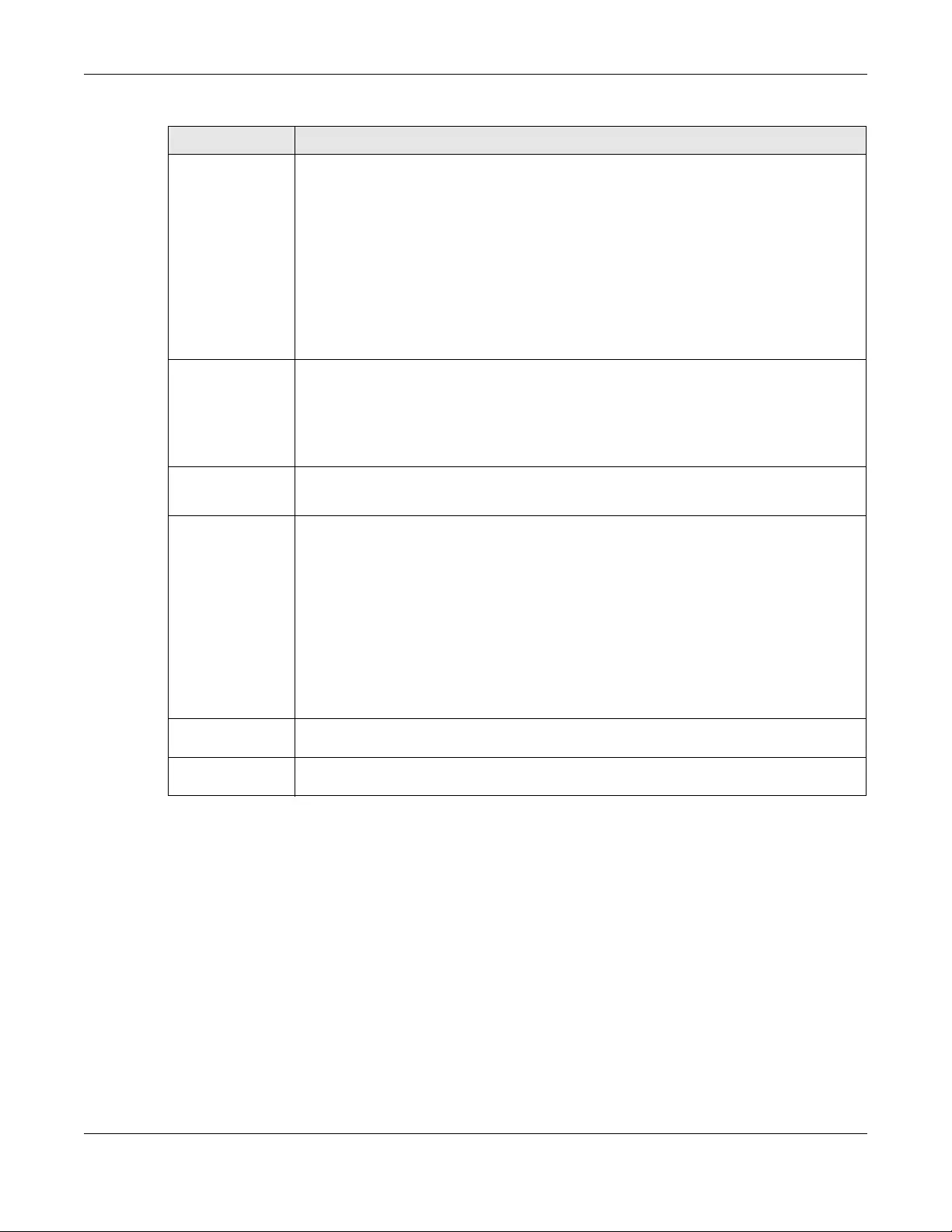
Chapter 35 Object
ZyWALL/USG Series User’s Guide
653
35.14 DHCPv6 Overview
This section describes how to configure DHCPv6 request type and lease type objects.
•The Request screen (see Section 35.14.1 on page 654) allows you to configure DHCPv6 request
type objects.
•The Lease screen (see Section 35.2.3 on page 569) allows you to configure DHCPv6 lease type
objects.
Preview This field only appears when you choose Web Application or File Sharing as the object
type.
This field displays if the Server Type is set to Web Server, OWA or Weblink.
Note: If your Internet Explorer or other browser screen doesn’t show a preview, it may
be due to your web browser security settings. You need to add the ZyWALL/USG’s
IP address in the trusted sites of your web browser. For example, in Internet
Explorer, click Tools > Internet Options > Security > Trusted Sites > Sites
and type the ZyWALL/USG’s IP address, then click Add. For other web browsers,
please check the browser help.
Click Preview to access the URL you specified in a new web browser screen.
Entry Point This field only appears when you choose Web Application as the object type.
This field displays if the Server Type is set to Web Server or OWA.
This field is optional. You only need to configure this field if you need to specify the name
of the directory or file on the local server as the home page or home directory on the user
screen.
Web Page
Encryption
This field only appears when you choose Web Application as the object type.
Select this option to prevent users from saving the web content.
Shared Path This field only appears when you choose File Sharing as the object type.
Specify the IP address, domain name or NetBIOS name (computer name) of the file
server and the name of the share to which you want to allow user access. Enter the path
in one of the following formats.
“\\<IP address>\<share name>”
“\\<domain name>\<share name>”
“\\<computer name>\<share name>”
For example, if you enter “\\my-server\Tmp”, this allows remote users to access all files
and/or folders in the “\Tmp” share on the “my-server” computer.
OK Click OK to save the changes and return to the main SSL Application Configuration
screen.
Cancel Click Cancel to discard the changes and return to the main SSL Application
Configuration screen.
Table 290 Configuration > Object > SSL Application > Add/Edit: Web Application/File Sharing
LABEL DESCRIPTION

Chapter 35 Object
ZyWALL/USG Series User’s Guide
654
35.14.1 The DHCPv6 Request Screen
The Request screen allows you to add, edit, and remove DHCPv6 request type objects. To access
this screen, login to the Web Configurator, and click Configuration > Object > DHCPv6 >
Request.
Figure 444 Configuration > Object > DHCPv6 > Request
The following table describes the labels in this screen.
35.14.1.1 DHCPv6 Request Add/Edit Screen
The Request Add/Edit screen allows you to create a new request object or edit an existing one.
To access this screen, go to the Request screen (see Section 35.14.1 on page 654), and click
either the Add icon or an Edit icon.
Figure 445 Configuration > DHCPv6 > Request > Add
Table 291 Configuration > Object > DHCPv6 > Request
LABEL DESCRIPTION
Configuration
Add Click this to create a new entry.
Edit Double-click an entry or select it and click Edit to open a screen where you can modify the
entry’s settings.
Remove To remove an entry, select it and click Remove. The ZyWALL/USG confirms you want to
remove it before doing so.
Object
References
Select an entry and click Object References to open a screen that shows which settings
use the entry.
# This field is a sequential value, and it is not associated with a specific object.
Name This field displays the name of each request object.
Type This field displays the request type of each request object.
Interface This field displays the interface used for each request object.
Value This field displays the value for each request object.

Chapter 35 Object
ZyWALL/USG Series User’s Guide
655
The following table describes the labels in this screen.
35.14.2 The DHCPv6 Lease Screen
The Lease screen allows you to add, edit, and remove DHCPv6 lease type objects. To access this
screen, login to the Web Configurator, and click Configuration > Object > DHCPv6 > Lease.
Figure 446 Configuration > Object > DHCPv6 > Lease
The following table describes the labels in this screen.
35.14.2.1 DHCPv6 Lease Add/Edit Screen
The Lease Add/Edit screen allows you to create a new lease object or edit an existing one.
To access this screen, go to the Lease screen (see Section 35.14.2 on page 655), and click either
the Add icon or an Edit icon.
Table 292 Configuration > DHCPv6 > Request > Add
LABEL DESCRIPTION
Name Type the name for this request object. You may use 1-31 alphanumeric characters,
underscores(_), or dashes (-), but the first character cannot be a number. This value is
case-sensitive.
Request Type Select the request type for this request object. You can choose from Prefix
Delegation, DNS Serve r, NTP Server, or SIP Server.
Interface Select the interface for this request object.
OK Click OK to save your changes back to the ZyWALL/USG.
Cancel Click Cancel to exit this screen without saving your changes.
Table 293 Configuration > Object > DHCPv6 > Lease
LABEL DESCRIPTION
Configuration
Add Click this to create a new entry.
Edit Double-click an entry or select it and click Edit to open a screen where you can modify the
entry’s settings.
Remove To remove an entry, select it and click Remove. The ZyWALL/USG confirms you want to
remove it before doing so.
Object
References
Select an entry and click Object References to open a screen that shows which settings
use the entry.
# This field is a sequential value, and it is not associated with a specific object.
Name This field displays the name of each lease object.
Type This field displays the request type of each lease object.
Interface This field displays the interface used for each lease object.
Value This field displays the value for each lease object.
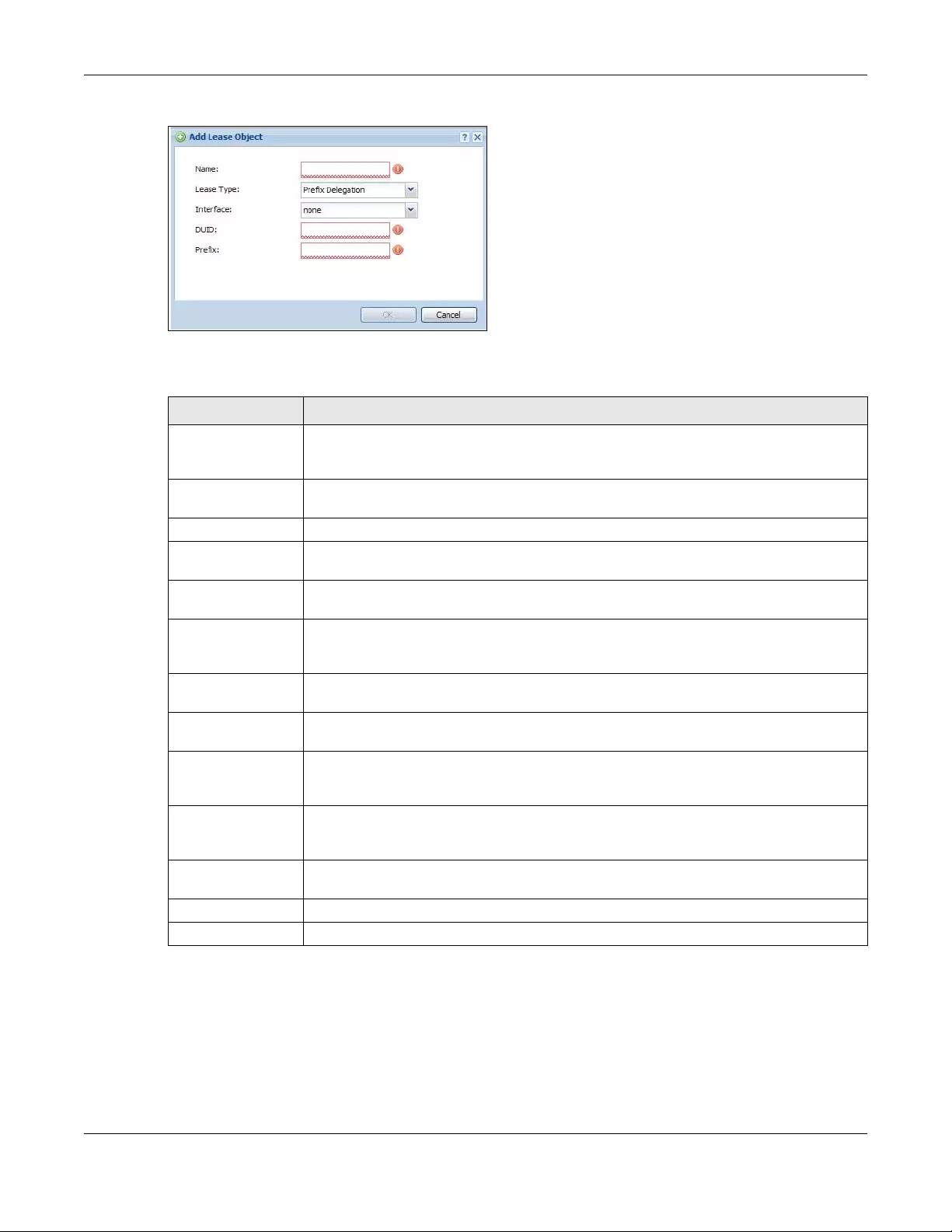
Chapter 35 Object
ZyWALL/USG Series User’s Guide
656
Figure 447 Configuration > DHCPv6 > Lease > Add
The following table describes the labels in this screen.
Table 294 Configuration > DHCPv6 > Lease > Add
LABEL DESCRIPTION
Name Type the name for this lease object. You may use 1-31 alphanumeric characters,
underscores(_), or dashes (-), but the first character cannot be a number. This value is
case-sensitive.
Lease Type Select the lease type for this lease object. You can choose from Prefix Delegation,
DNS Server, Address, Address Pool, NTP Server, or SIP Server.
Interface Select the interface for this lease object.
DUID If you select Prefix Delegation or Address in the Lease Type field, enter the DUID of
the interface.
Prefix If you select Prefix Delegation or Address in the Lease Type field, enter the IPv6
prefix of the interface.
DNS Server If you select DNS Server in the Le ase Typ e field, select a request object or User
Defined in the DNS Server field and enter the IP address of the DNS server in the
User Defined Address field below.
Starting IP Address If you select Address Poo l in the Lease Type field, enter the first of the contiguous
addresses in the IP address pool.
End IP Address If you select Address Pool in the Lease Type field, enter the last of the contiguous
addresses in the IP address pool.
NTP Server If you select NTP Server in the Lease Type field, select a request object or User
Defined in the NTP Server field and enter the IP address of the NTP server in the User
Defined Address field below.
SIP Server If you select SIP Server in the Lease Type field, select a request object or User
Defined in the SIP field and enter the IP address of the SIP server in the User Defined
Address field below.
User Defined
Address
If you select DNS Server, NTP Server, or SIP Server as your lease type, you must
enter the IP address of the server your selected.
OK Click OK to save your changes back to the ZyWALL/USG.
Cancel Click Cancel to exit this screen without saving your changes.

ZyWALL/USG Series User’s Guide
657
CHAPTER 36
System
36.1 Overview
Use the system screens to configure general ZyWALL/USG settings.
36.1.1 What You Can Do in this Chapter
•Use the System > Host Name screen (see Section 36.2 on page 658) to configure a unique
name for the ZyWALL/USG in your network.
•Use the System > USB Storage screen (see Section 36.3 on page 658) to configure the
settings for the connected USB devices.
•Use the System > Date/Time screen (see Section 36.4 on page 659) to configure the date and
time for the ZyWALL/USG.
•Use the System > Console Speed screen (see Section 36.5 on page 663) to configure the
console port speed when you connect to the ZyWALL/USG via the console port using a terminal
emulation program.
•Use the System > DNS screen (see Section 36.6 on page 664) to configure the DNS (Domain
Name System) server used for mapping a domain name to its corresponding IP address and vice
versa.
•Use the System > WWW screens (see Section 36.7 on page 673) to configure settings for HTTP
or HTTPS access to the ZyWALL/USG and how the login and access user screens look.
•Use the System > SSH screen (see Section 36.8 on page 690) to configure SSH (Secure SHell)
used to securely access the ZyWALL/USG’s command line interface. You can specify which zones
allow SSH access and from which IP address the access can come.
•Use the System > TELNET screen (see Section 36.9 on page 694) to configure Telnet to access
the ZyWALL/USG’s command line interface. Specify which zones allow Telnet access and from
which IP address the access can come.
•Use the System > FTP screen (see Section 36.10 on page 696) to specify from which zones FTP
can be used to access the ZyWALL/USG. You can also specify from which IP addresses the access
can come. You can upload and download the ZyWALL/USG’s firmware and configuration files
using FTP. .
• Your ZyWALL/USG can act as an SNMP agent, which allows a manager station to manage and
monitor the ZyWALL/USG through the network. Use the System > SNMP screen (see Section
36.11 on page 697) to configure SNMP settings, including from which zones SNMP can be used to
access the ZyWALL/USG. You can also specify from which IP addresses the access can come.
•Use the Auth. Server screen (Section 36.12 on page 702) to configure the ZyWALL/USG to
operate as a RADIUS server.
•Use the CloudCNM screen (Section 36.13 on page 704) to enable and configure management of
the ZyWALL/USG by a Central Network Management system.
•Use the System > Language screen (see Section 36.14 on page 706) to set a language for the
ZyWALL/USG’s Web Configurator screens.
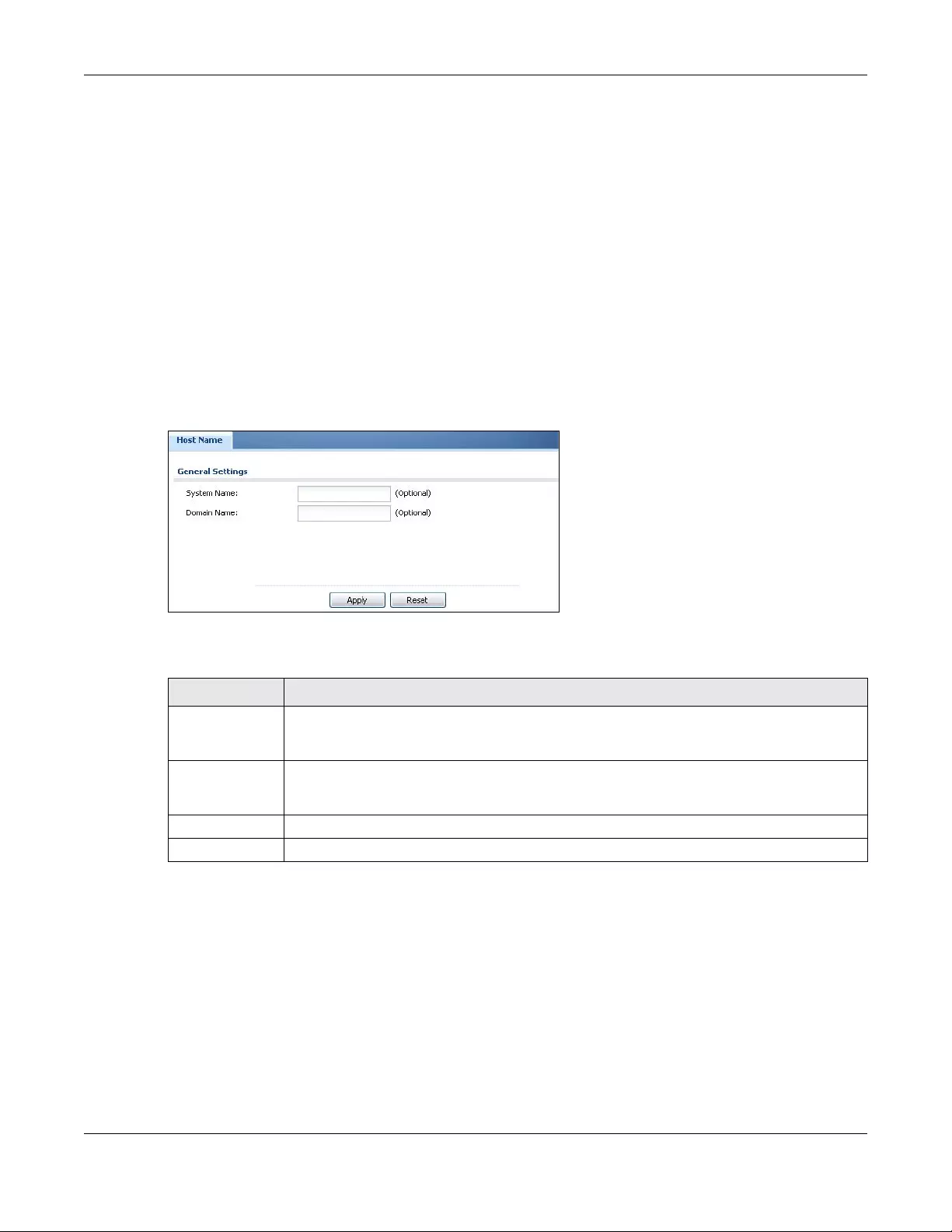
Chapter 36 System
ZyWALL/USG Series User’s Guide
658
•Use the System > IPv6 screen (see Section 36.15 on page 706) to enable or disable IPv6
support on the ZyWALL/USG.
•Use the System > ZON screen (see Section 36.16 on page 707) to enable or disable the ZyXEL
One Network (ZON) utility that uses ZyXEL Discovery Protocol (ZDP) for discovering and
configuring ZDP-aware ZyXEL devices in the same network as the computer on which ZON is
installed.
Note: See each section for related background information and term definitions.
36.2 Host Name
A host name is the unique name by which a device is known on a network. Click Configuration >
System > Host Name to open the Host Name screen.
Figure 448 Configuration > System > Host Name
The following table describes the labels in this screen.
36.3 USB Storage
The ZyWALL/USG can use a connected USB device to store the system log and other diagnostic
information. Use this screen to turn on this feature and set a disk full warning limit.
Note: Only connect one USB device. It must allow writing (it cannot be read-only) and
use the FAT16, FAT32, EXT2, or EXT3 file system.
Click Configuration > System > USB Storage to open the screen as shown next.
Table 295 Configuration > System > Host Name
LABEL DESCRIPTION
System Name Enter a descriptive name to identify your ZyWALL/USG device. This name can be up to 64
alphanumeric characters long. Spaces are not allowed, but dashes (-) underscores (_) and
periods (.) are accepted.
Domain Name Enter the domain name (if you know it) here. This name is propagated to DHCP clients
connected to interfaces with the DHCP server enabled. This name can be up to 254
alphanumeric characters long. Spaces are not allowed, but dashes “-” are accepted.
Apply Click Apply to save your changes back to the ZyWALL/USG.
Reset Click Reset to return the screen to its last-saved settings.

Chapter 36 System
ZyWALL/USG Series User’s Guide
659
Figure 449 Configuration > System > USB Storage
The following table describes the labels in this screen.
36.4 Date and Time
For effective scheduling and logging, the ZyWALL/USG system time must be accurate. The ZyWALL/
USG’s Real Time Chip (RTC) keeps track of the time and date. There is also a software mechanism
to set the time manually or get the current time and date from an external server.
To change your ZyWALL/USG’s time based on your local time zone and date, click Configuration >
System > Date/Time. The screen displays as shown. You can manually set the ZyWALL/USG’s
time and date or have the ZyWALL/USG get the date and time from a time server.
Table 296 Configuration > System > USB Storage
LABEL DESCRIPTION
Activate USB
storage service
Select this if you want to use the connected USB device(s).
Disk full warning
when remaining
space is less
than
Set a number and select a unit (MB or %) to have the ZyWALL/USG send a warning
message when the remaining USB storage space is less than the value you set here.
Apply Click Apply to save your changes back to the ZyWALL/USG.
Reset Click Reset to return the screen to its last-saved settings.
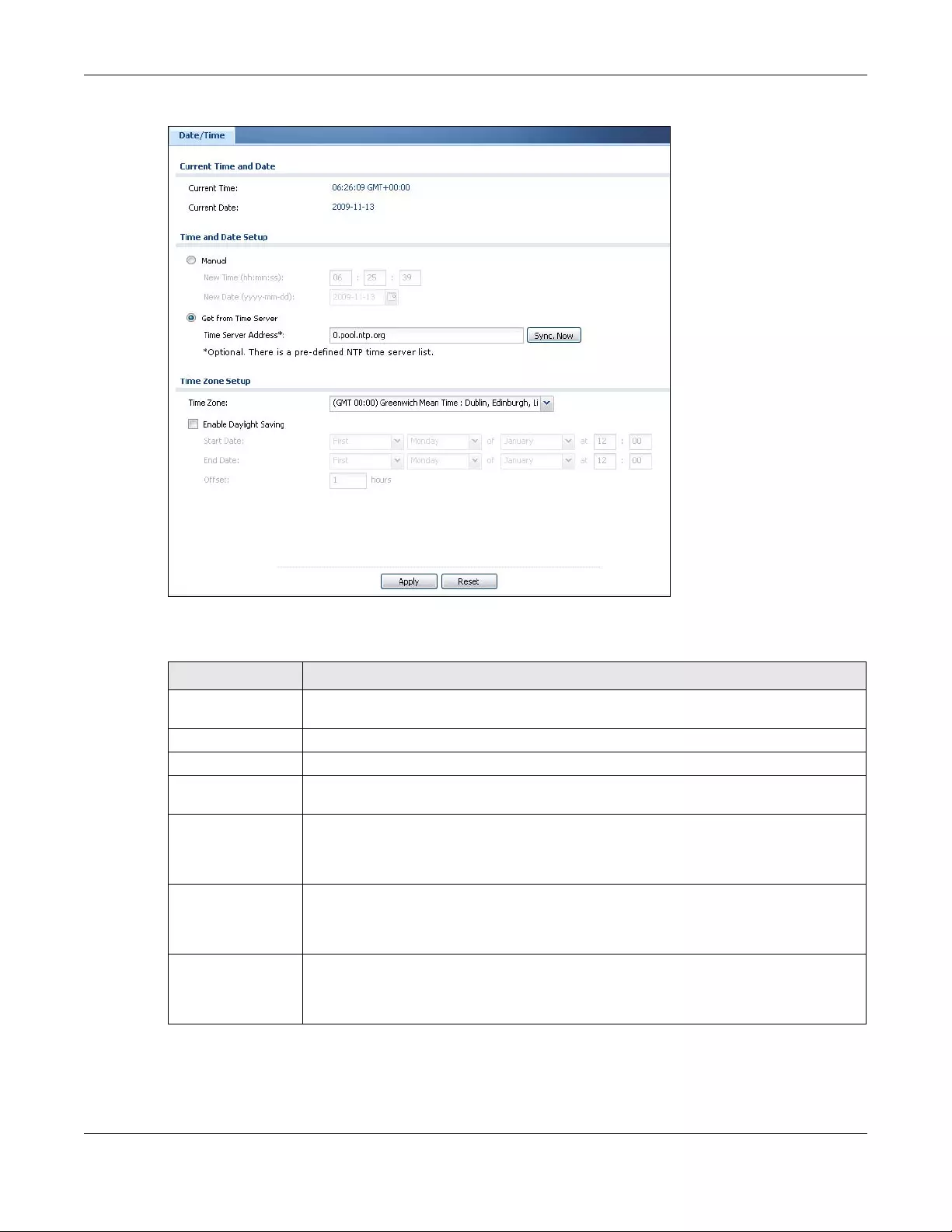
Chapter 36 System
ZyWALL/USG Series User’s Guide
660
Figure 450 Configuration > System > Date and Time
The following table describes the labels in this screen.
Table 297 Configuration > System > Date and Time
LABEL DESCRIPTION
Current Time and
Date
Current Time This field displays the present time of your ZyWALL/USG.
Current Date This field displays the present date of your ZyWALL/USG.
Time and Date
Setup
Manual Select this radio button to enter the time and date manually. If you configure a new time
and date, time zone and daylight saving at the same time, the time zone and daylight
saving will affect the new time and date you entered. When you enter the time settings
manually, the ZyWALL/USG uses the new setting once you click Apply.
New Time (hh-mm-
ss)
This field displays the last updated time from the time server or the last time configured
manually.
When you set Time and Date Setup to Manual, enter the new time in this field and
then click Apply.
New Date
(yyyy-mm-dd)
This field displays the last updated date from the time server or the last date configured
manually.
When you set Time and Date Setup to Manual, enter the new date in this field and
then click Apply.
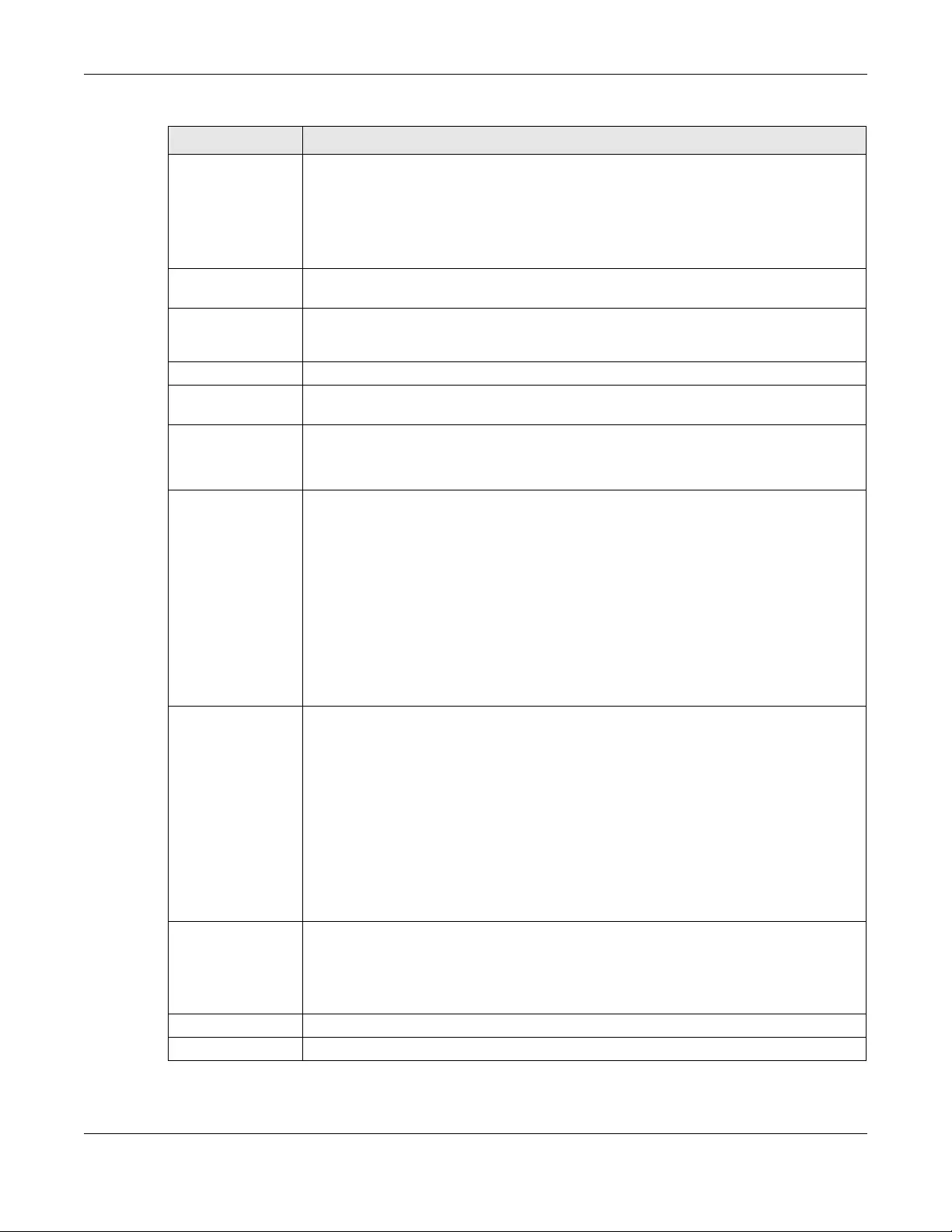
Chapter 36 System
ZyWALL/USG Series User’s Guide
661
Get from Time
Server
Select this radio button to have the ZyWALL/USG get the time and date from the time
server you specify below. The ZyWALL/USG requests time and date settings from the
time server under the following circumstances.
• When the ZyWALL/USG starts up.
• When you click Apply or Synchronize Now in this screen.
• 24-hour intervals after starting up.
Time Server
Address
Enter the IP address or URL of your time server. Check with your ISP/network
administrator if you are unsure of this information.
Sync. Now Click this button to have the ZyWALL/USG get the time and date from a time server (see
the Time Server Address field). This also saves your changes (except the daylight
saving settings).
Time Zone Setup
Time Zone Choose the time zone of your location. This will set the time difference between your
time zone and Greenwich Mean Time (GMT).
Enable Daylight
Saving
Daylight saving is a period from late spring to early fall when many countries set their
clocks ahead of normal local time by one hour to give more daytime light in the evening.
Select this option if you use Daylight Saving Time.
Start Date Configure the day and time when Daylight Saving Time starts if you selected Enable
Daylight Saving. The at field uses the 24 hour format. Here are a couple of examples:
Daylight Saving Time starts in most parts of the United States on the second Sunday of
March. Each time zone in the United States starts using Daylight Saving Time at 2 A.M.
local time. So in the United States you would select Second, Sunday, March and type
2 in the at field.
Daylight Saving Time starts in the European Union on the last Sunday of March. All of
the time zones in the European Union start using Daylight Saving Time at the same
moment (1 A.M. GMT or UTC). So in the European Union you would select Last,
Sunday, March. The time you type in the at field depends on your time zone. In
Germany for instance, you would type 2 because Germany's time zone is one hour
ahead of GMT or UTC (GMT+1).
End Date Configure the day and time when Daylight Saving Time ends if you selected Enable
Daylight Saving. The at field uses the 24 hour format. Here are a couple of examples:
Daylight Saving Time ends in the United States on the first Sunday of November. Each
time zone in the United States stops using Daylight Saving Time at 2 A.M. local time. So
in the United States you would select First, Sunday, November and type 2 in the at
field.
Daylight Saving Time ends in the European Union on the last Sunday of October. All of
the time zones in the European Union stop using Daylight Saving Time at the same
moment (1 A.M. GMT or UTC). So in the European Union you would select Last,
Sunday, October. The time you type in the at field depends on your time zone. In
Germany for instance, you would type 2 because Germany's time zone is one hour
ahead of GMT or UTC (GMT+1).
Offset Specify how much the clock changes when daylight saving begins and ends.
Enter a number from 1 to 5.5 (by 0.5 increments).
For example, if you set this field to 3.5, a log occurred at 6 P.M. in local official time will
appear as if it had occurred at 10:30 P.M.
Apply Click Apply to save your changes back to the ZyWALL/USG.
Reset Click Reset to return the screen to its last-saved settings.
Table 297 Configuration > System > Date and Time (continued)
LABEL DESCRIPTION
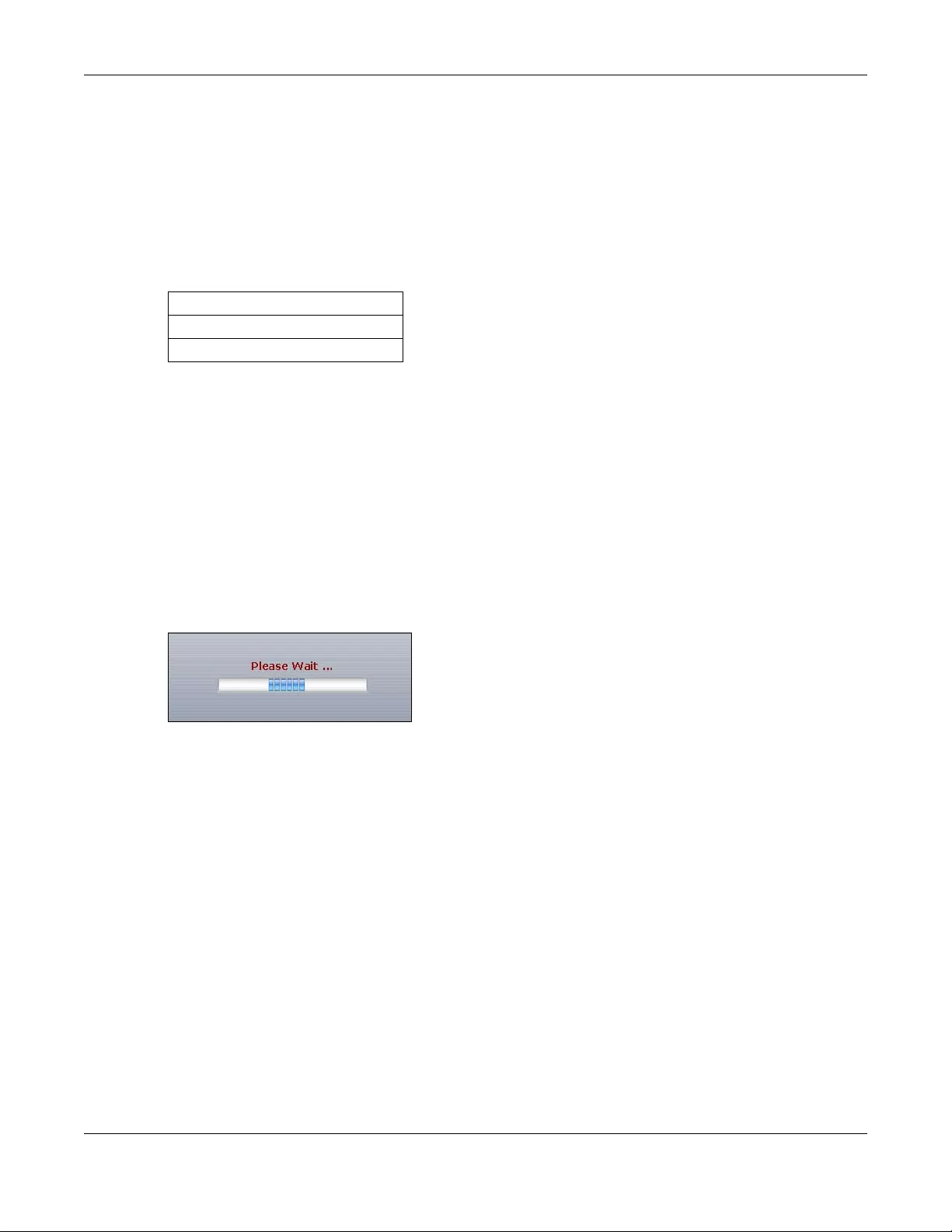
Chapter 36 System
ZyWALL/USG Series User’s Guide
662
36.4.1 Pre-defined NTP Time Servers List
When you turn on the ZyWALL/USG for the first time, the date and time start at 2003-01-01
00:00:00. The ZyWALL/USG then attempts to synchronize with one of the following pre-defined list
of Network Time Protocol (NTP) time servers.
The ZyWALL/USG continues to use the following pre-defined list of NTP time servers if you do not
specify a time server or it cannot synchronize with the time server you specified.
When the ZyWALL/USG uses the pre-defined list of NTP time servers, it randomly selects one server
and tries to synchronize with it. If the synchronization fails, then the ZyWALL/USG goes through the
rest of the list in order from the first one tried until either it is successful or all the pre-defined NTP
time servers have been tried.
36.4.2 Time Server Synchronization
Click the Synchronize Now button to get the time and date from the time server you specified in
the Time Server Address field.
When the Please Wait... screen appears, you may have to wait up to one minute.
Figure 451 Synchronization in Process
The Current Time and Current Date fields will display the appropriate settings if the
synchronization is successful.
If the synchronization was not successful, a log displays in the View Log screen. Try re-configuring
the Date/Time screen.
To manually set the ZyWALL/USG date and time.
1Click System > Date/Time.
2Select Manual under Time and Date Setup.
3Enter the ZyWALL/USG’s time in the New Time field.
4Enter the ZyWALL/USG’s date in the New Date field.
5Under Time Zone Setup, select your Time Zone from the list.
6As an option you can select the Enable Daylight Saving check box to adjust the ZyWALL/USG
clock for daylight savings.
Table 298 Default Time Servers
0.pool.ntp.org
1.pool.ntp.org
2.pool.ntp.org
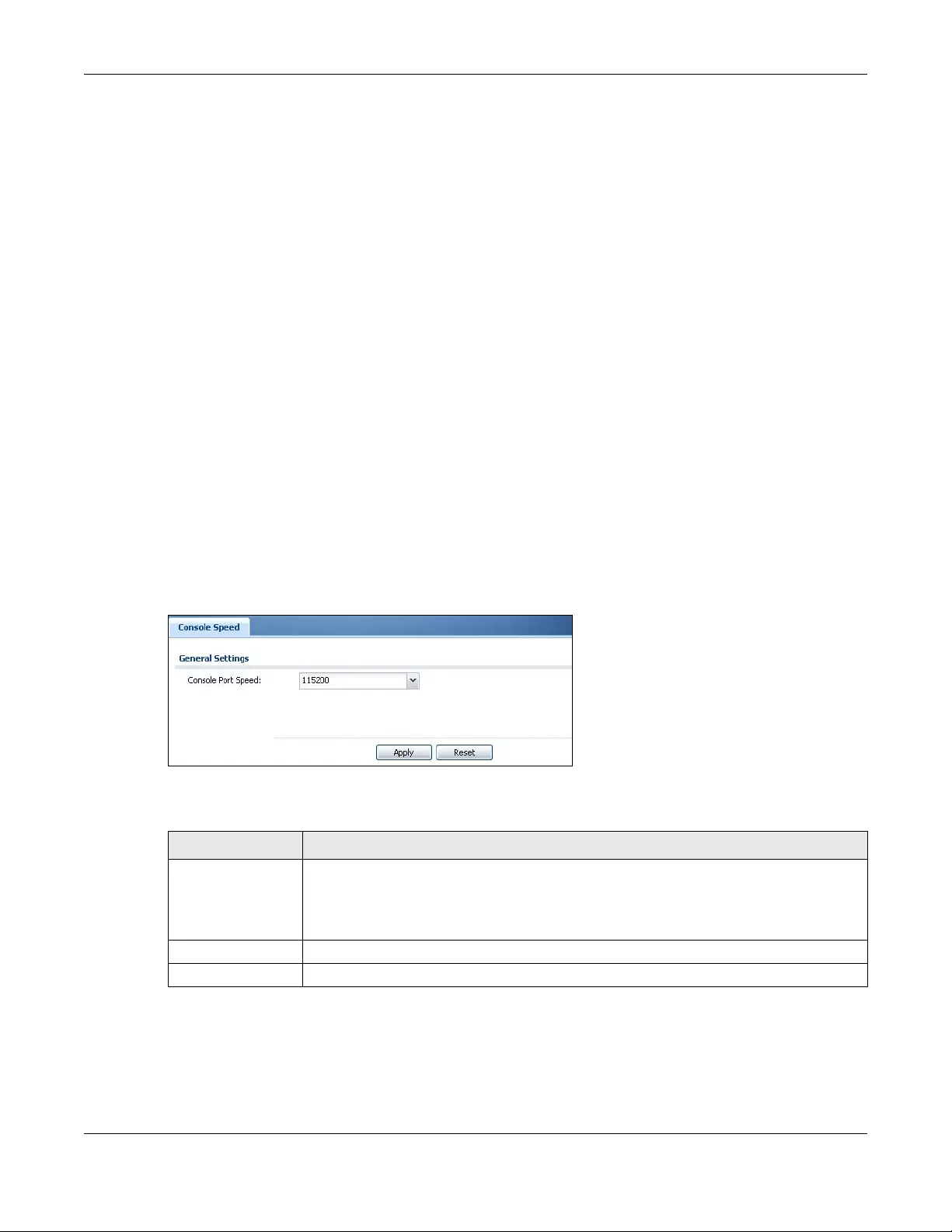
Chapter 36 System
ZyWALL/USG Series User’s Guide
663
7Click Apply.
To get the ZyWALL/USG date and time from a time server
1Click System > Date/Time.
2Select Get from Time Server under Time and Date Setup.
3Under Time Zone Setup, select your Time Zone from the list.
4As an option you can select the Enable Daylight Saving check box to adjust the ZyWALL/USG
clock for daylight savings.
5Under Time and Date Setup, enter a Time Server Address (Table 298 on page 662).
6Click Apply.
36.5 Console Port Speed
This section shows you how to set the console port speed when you connect to the ZyWALL/USG via
the console port using a terminal emulation program.
Click Configuration > System > Console Speed to open the Console Speed screen.
Figure 452 Configuration > System > Console Speed
The following table describes the labels in this screen.
Table 299 Configuration > System > Console Speed
LABEL DESCRIPTION
Console Port Speed Use the drop-down list box to change the speed of the console port. Your ZyWALL/USG
supports 9600, 19200, 38400, 57600, and 115200 bps (default) for the console port.
The Console Port Speed applies to a console port connection using terminal emulation
software and NOT the Console in the ZyWALL/USG Web Configurator Status screen.
Apply Click Apply to save your changes back to the ZyWALL/USG.
Reset Click Reset to return the screen to its last-saved settings.

Chapter 36 System
ZyWALL/USG Series User’s Guide
664
36.6 DNS Overview
DNS (Domain Name System) is for mapping a domain name to its corresponding IP address and
vice versa. The DNS server is extremely important because without it, you must know the IP
address of a machine before you can access it.
36.6.1 DNS Server Address Assignment
The ZyWALL/USG can get the DNS server addresses in the following ways.
• The ISP tells you the DNS server addresses, usually in the form of an information sheet, when
you sign up. If your ISP gives you DNS server addresses, manually enter them in the DNS server
fields.
• If your ISP dynamically assigns the DNS server IP addresses (along with the ZyWALL/USG’s WAN
IP address), set the DNS server fields to get the DNS server address from the ISP.
• You can manually enter the IP addresses of other DNS servers.
36.6.2 Configuring the DNS Screen
Click Configuration > System > DNS to change your ZyWALL/USG’s DNS settings. Use the DNS
screen to configure the ZyWALL/USG to use a DNS server to resolve domain names for ZyWALL/
USG system features like VPN, DDNS and the time server. You can also configure the ZyWALL/USG
to accept or discard DNS queries. Use the Network > Interface screens to configure the DNS
server information that the ZyWALL/USG sends to the specified DHCP client devices.
A name query begins at a client computer and is passed to a resolver, a DNS client service, for
resolution. The ZyWALL/USG can be a DNS client service. The ZyWALL/USG can resolve a DNS
query locally using cached Resource Records (RR) obtained from a previous query (and kept for a
period of time). If the ZyWALL/USG does not have the requested information, it can forward the
request to DNS servers. This is known as recursion.
The ZyWALL/USG can ask a DNS server to use recursion to resolve its DNS client requests. If
recursion on the ZyWALL/USG or a DNS server is disabled, they cannot forward DNS requests for
resolution.
A Domain Name Server (DNS) amplification attack is a kind of Distributed Denial of Service (DDoS)
attack that uses publicly accessible open DNS servers to flood a victim with DNS response traffic.
An open DNS server is a DNS server which is willing to resolve recursive DNS queries from anyone
on the Internet.
In a DNS amplification attack, an attacker sends a DNS name lookup request to an open DNS
server with the source address spoofed as the victim’s address. When the DNS server sends the
DNS record response, it is sent to the victim. Attackers can request as much information as possible
to maximize the amplification effect.
Configure the Security Option Control section in the Configuration > System > DNS screen
(click Show Advanced Settings to display it) if you suspect the ZyWALL/USG is being used (either
by hackers or by a corrupted open DNS server) in a DNS amplification attack.
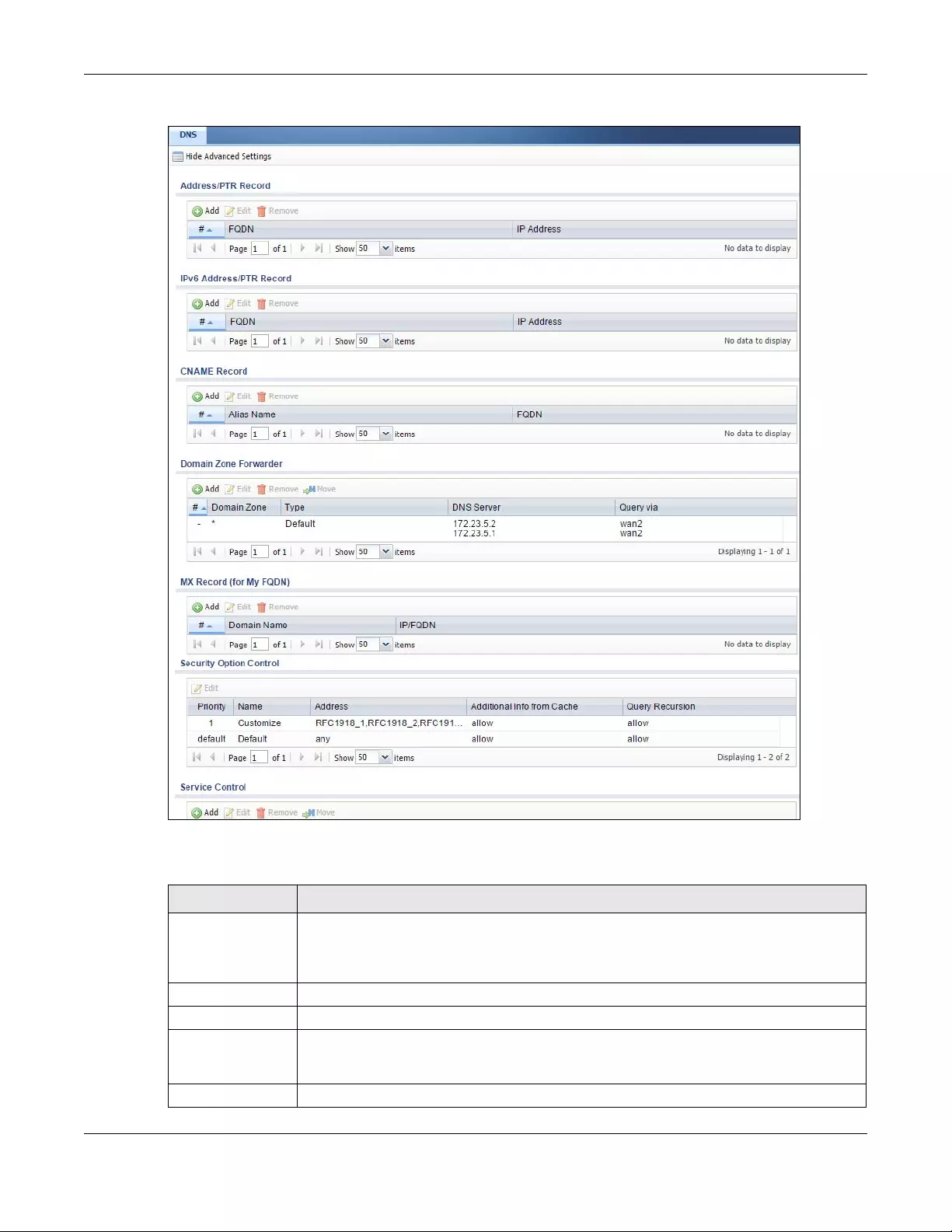
Chapter 36 System
ZyWALL/USG Series User’s Guide
665
Figure 453 Configuration > System > DNS
The following table describes the labels in this screen.
Table 300 Configuration > System > DNS
LABEL DESCRIPTION
Address/PTR
Record
This record specifies the mapping of a Fully-Qualified Domain Name (FQDN) to an IP
address. An FQDN consists of a host and domain name. For example, www.zyxel.com.tw
is a fully qualified domain name, where “www” is the host, “zyxel” is the third-level
domain, “com” is the second-level domain, and “tw” is the top level domain.
Add Click this to create a new entry.
Edit Double-click an entry or select it and click Edit to be able to modify the entry’s settings.
Remove To remove an entry, select it and click Remove. The ZyWALL/USG confirms you want to
remove it before doing so. Note that subsequent entries move up by one when you take
this action.
#This is the index number of the address/PTR record.
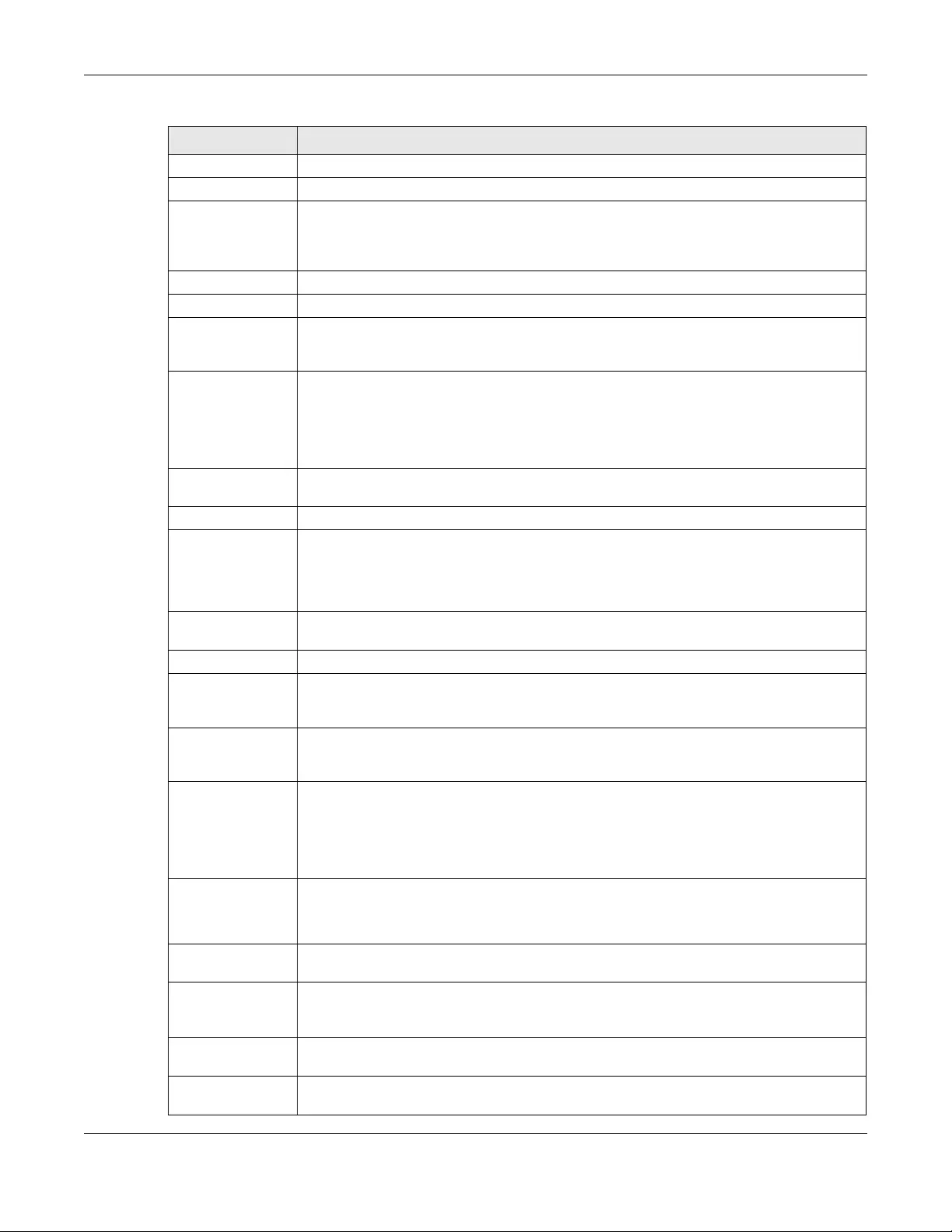
Chapter 36 System
ZyWALL/USG Series User’s Guide
666
FQDN This is a host’s fully qualified domain name.
IP Address This is the IP address of a host.
CNAME Record This record specifies an alias for a FQDN. Use this record to bind all subdomains with the
same IP address as the FQDN without having to update each one individually, which
increases chance for errors. See CNAME Record (Section 36.6.6 on page 669) for more
details.
Add Click this to create a new entry.
Edit Double-click an entry or select it and click Edit to be able to modify the entry’s settings.
Remove To remove an entry, select it and click Remove. The ZyWALL/USG confirms you want to
remove it before doing so. Note that subsequent entries move up by one when you take
this action.
#This is the index number of the domain zone forwarder record. The ordering of your rules
is important as rules are applied in sequence.
A hyphen (-) displays for the default domain zone forwarder record. The default record is
not configurable. The ZyWALL/USG uses this default record if the domain zone that
needs to be resolved does not match any of the other domain zone forwarder records.
Alias Name Enter an Alias name. Use “*.” as prefix for a wildcard domain name. For example,
*.example.com.
FQDN Enter the Fully Qualified Domain Name (FQDN).
Domain Zone
Forwarder
This specifies a DNS server’s IP address. The ZyWALL/USG can query the DNS server to
resolve domain zones for features like VPN, DDNS and the time server.
When the ZyWALL/USG needs to resolve a domain zone, it checks it against the domain
zone forwarder entries in the order that they appear in this list.
Add Click this to create a new entry. Select an entry and click Add to create a new entry after
the selected entry.
Edit Double-click an entry or select it and click Edit to be able to modify the entry’s settings.
Remove To remove an entry, select it and click Remove. The ZyWALL/USG confirms you want to
remove it before doing so. Note that subsequent entries move up by one when you take
this action.
Move To change an entry’s position in the numbered list, select the method and click Move to
display a field to type a number for where you want to put it and press [ENTER] to move
the rule to the number that you typed.
#This is the index number of the domain zone forwarder record. The ordering of your rules
is important as rules are applied in sequence.
A hyphen (-) displays for the default domain zone forwarder record. The default record is
not configurable. The ZyWALL/USG uses this default record if the domain zone that
needs to be resolved does not match any of the other domain zone forwarder records.
Domain Zone A domain zone is a fully qualified domain name without the host. For example,
zyxel.com.tw is the domain zone for the www.zyxel.com.tw fully qualified domain name.
A “*” means all domain zones.
Type This displays whether the DNS server IP address is assigned by the ISP dynamically
through a specified interface or configured manually (User-Defined).
DNS Server This is the IP address of a DNS server. This field displays N/A if you have the ZyWALL/
USG get a DNS server IP address from the ISP dynamically but the specified interface is
not active.
Query Via This is the interface through which the ZyWALL/USG sends DNS queries to the entry’s
DNS server. If the ZyWALL/USG connects through a VPN tunnel, tunnel displays.
MX Record (for My
FQDN)
A MX (Mail eXchange) record identifies a mail server that handles the mail for a
particular domain.
Table 300 Configuration > System > DNS (continued)
LABEL DESCRIPTION

Chapter 36 System
ZyWALL/USG Series User’s Guide
667
Add Click this to create a new entry.
Edit Double-click an entry or select it and click Edit to be able to modify the entry’s settings.
Remove To remove an entry, select it and click Remove. The ZyWALL/USG confirms you want to
remove it before doing so. Note that subsequent entries move up by one when you take
this action.
#This is the index number of the MX record.
Domain Name This is the domain name where the mail is destined for.
IP/FQDN This is the IP address or Fully-Qualified Domain Name (FQDN) of a mail server that
handles the mail for the domain specified in the field above.
Security Option
Control
Click S how Advance d Settings to display this part of the screen. There are two control
policies: Default and Customize.
Edit Click either control policy and then click this button to change allow or deny actions for
Query Recursion and Additional Info from Cache.
Priority The Customize control policy is checked first and if an address object match is not
found, the Default control policy is checked.
Name You may change the name of the Customize control policy.
Address These are the object addresses used in the control policy. RFC1918 refers to private IP
address ranges. It can be modified in Object > Address.
Additional Info
from Cache This displays if the ZyWALL/USG is allowed or denied to cache Resource Records (RR)
obtained from previous DNS queries.
Query
Recursion This displays if the ZyWALL/USG is allowed or denied to forward DNS client requests to
DNS servers for resolution.
Service Control This specifies from which computers and zones you can send DNS queries to the
ZyWALL/USG.
Add Click this to create a new entry. Select an entry and click Add to create a new entry after
the selected entry.
Edit Double-click an entry or select it and click Edit to be able to modify the entry’s settings.
Remove To remove an entry, select it and click Remove. The ZyWALL/USG confirms you want to
remove it before doing so. Note that subsequent entries move up by one when you take
this action.
Move To change an entry’s position in the numbered list, select the method and click Move to
display a field to type a number for where you want to put it and press [ENTER] to move
the rule to the number that you typed.
#This the index number of the service control rule. The ordering of your rules is important
as rules are applied in sequence.
The entry with a hyphen (-) instead of a number is the ZyWALL/USG’s (non-configurable)
default policy. The ZyWALL/USG applies this to traffic that does not match any other
configured rule. It is not an editable rule. To apply other behavior, configure a rule that
traffic will match so the ZyWALL/USG will not have to use the default policy.
Zone This is the zone on the ZyWALL/USG the user is allowed or denied to access.
Address This is the object name of the IP address(es) with which the computer is allowed or
denied to send DNS queries.
Action This displays whether the ZyWALL/USG accepts DNS queries from the computer with the
IP address specified above through the specified zone (Accept) or discards them
(Deny).
Table 300 Configuration > System > DNS (continued)
LABEL DESCRIPTION
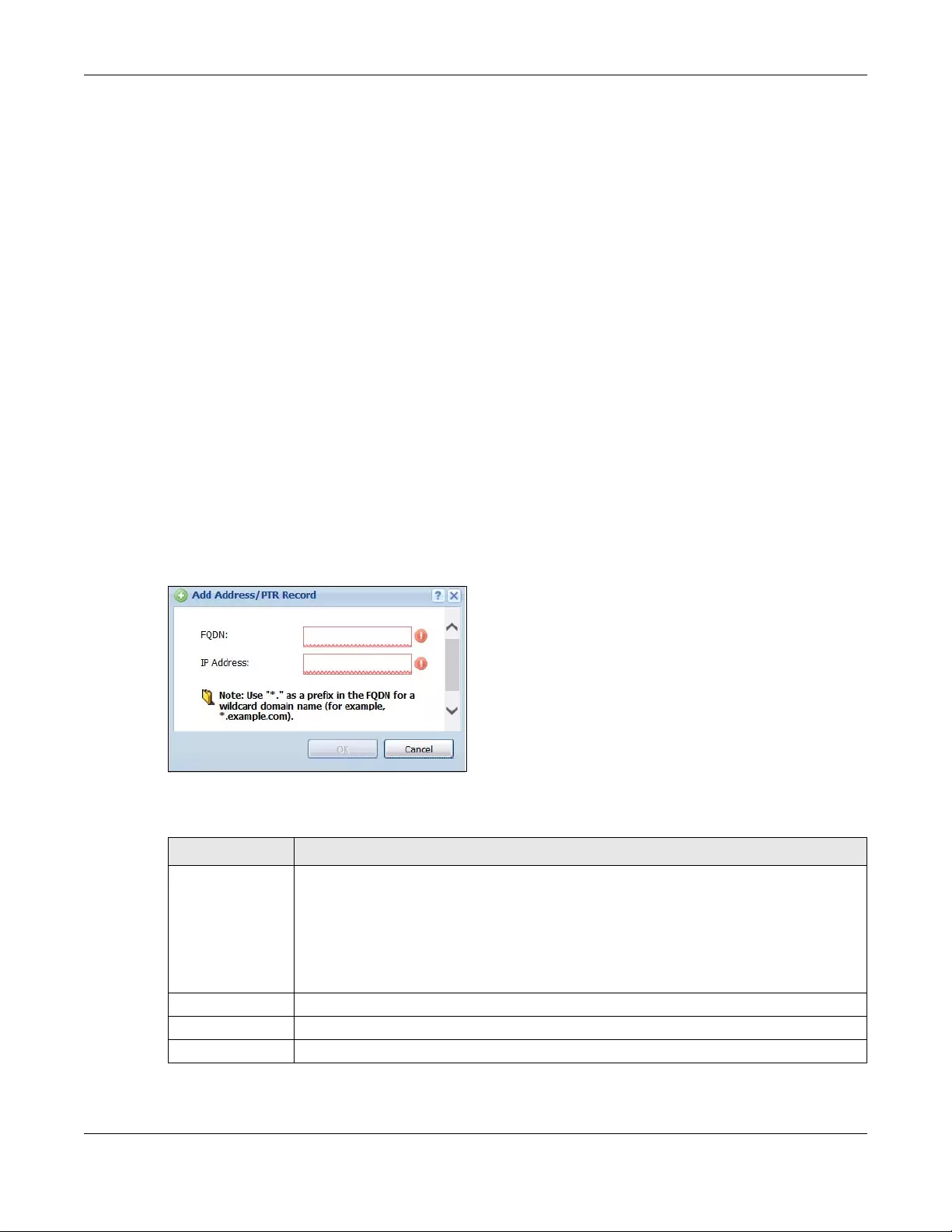
Chapter 36 System
ZyWALL/USG Series User’s Guide
668
36.6.3 Address Record
An address record contains the mapping of a Fully-Qualified Domain Name (FQDN) to an IP
address. An FQDN consists of a host and domain name. For example, www.zyxel.com is a fully
qualified domain name, where “www” is the host, “zyxel” is the second-level domain, and “com” is
the top level domain. mail.myZyXEL.com.tw is also a FQDN, where “mail” is the host, “myZyXEL” is
the third-level domain, “com” is the second-level domain, and “tw” is the top level domain.
The ZyWALL/USG allows you to configure address records about the ZyWALL/USG itself or another
device. This way you can keep a record of DNS names and addresses that people on your network
may use frequently. If the ZyWALL/USG receives a DNS query for an FQDN for which the ZyWALL/
USG has an address record, the ZyWALL/USG can send the IP address in a DNS response without
having to query a DNS name server.
36.6.4 PTR Record
A PTR (pointer) record is also called a reverse record or a reverse lookup record. It is a mapping of
an IP address to a domain name.
36.6.5 Adding an Address/PTR Record
Click the Add icon in the Address/PTR Record table to add an address/PTR record.
Figure 454 Configuration > System > DNS > Address/PTR Record Edit
The following table describes the labels in this screen.
Table 301 Configuration > System > DNS > Address/PTR Record Edit
LABEL DESCRIPTION
FQDN Type a Fully-Qualified Domain Name (FQDN) of a server. An FQDN starts with a host
name and continues all the way up to the top-level domain name. For example,
www.zyxel.com.tw is a fully qualified domain name, where “www” is the host, “zyxel” is
the third-level domain, “com” is the second-level domain, and “tw” is the top level
domain. Underscores are not allowed.
Use "*." as a prefix in the FQDN for a wildcard domain name (for example,
*.example.com).
IP Address Enter the IP address of the host in dotted decimal notation.
OK Click OK to save your customized settings and exit this screen.
Cancel Click Cancel to exit this screen without saving
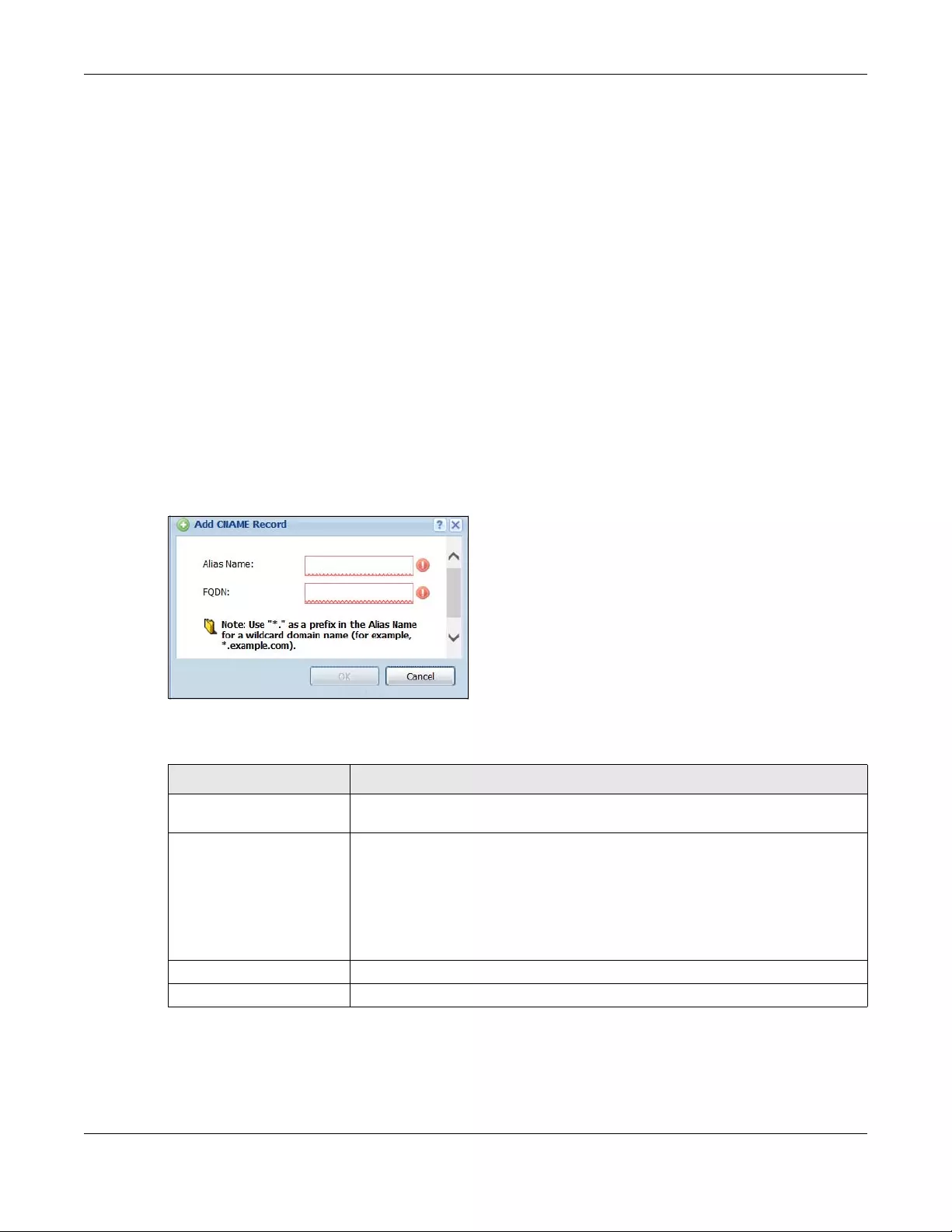
Chapter 36 System
ZyWALL/USG Series User’s Guide
669
36.6.6 CNAME Record
A Canonical Name Record or CNAME record is a type of resource record in the Domain Name
System (DNS) that specifies that the domain name is an alias of another, canonical domain name.
This allows users to set up a record for a domain name which translates to an IP address, in other
words, the domain name is an alias of another. This record also binds all the subdomains to the
same IP address without having to create a record for each, so when the IP address is changed, all
subdomain’s IP address is updated as well, with one edit to the record.
For example, the domain name zyxel.com is hooked up to a record named A which translates it to
11.22.33.44. You also have several subdomains, like mail.zyxel.com, ftp.zyxel.com and you want
this subdomain to point to your main domain zyxel.com. Edit the IP Address in record A and all
subdomains will follow automatically. This eliminates chances for errors and increases efficiency in
DNS management.
36.6.7 Adding a CNAME Record
Click the Add icon in the CNAME Record table to add a record. Use “*.” as a prefix for a wildcard
domain name. For example *.zyxel.com.
Figure 455 Configuration > System > DNS > CNAME Record > Add
The following table describes the labels in this screen.
36.6.8 Domain Zone Forwarder
A domain zone forwarder contains a DNS server’s IP address. The ZyWALL/USG can query the DNS
server to resolve domain zones for features like VPN, DDNS and the time server. A domain zone is a
Table 302 Configuration > System > DNS > CNAME Record > Add
LABEL DESCRIPTION
Alias name Enter an Alias Name. Use "*." as a prefix in the Alias name for a wildcard domain
name (for example, *.example.com).
FQDN Type a Fully-Qualified Domain Name (FQDN) of a server. An FQDN starts with a
host name and continues all the way up to the top-level domain name. For
example, www.zyxel.com.tw is a fully qualified domain name, where “www” is
the host, “zyxel” is the third-level domain, “com” is the second-level domain,
and “tw” is the top level domain. Underscores are not allowed.
Use "*." as a prefix in the FQDN for a wildcard domain name (for example,
*.example.com).
OK Click OK to save your customized settings and exit this screen.
Cancel Click Cancel to exit this screen without saving.
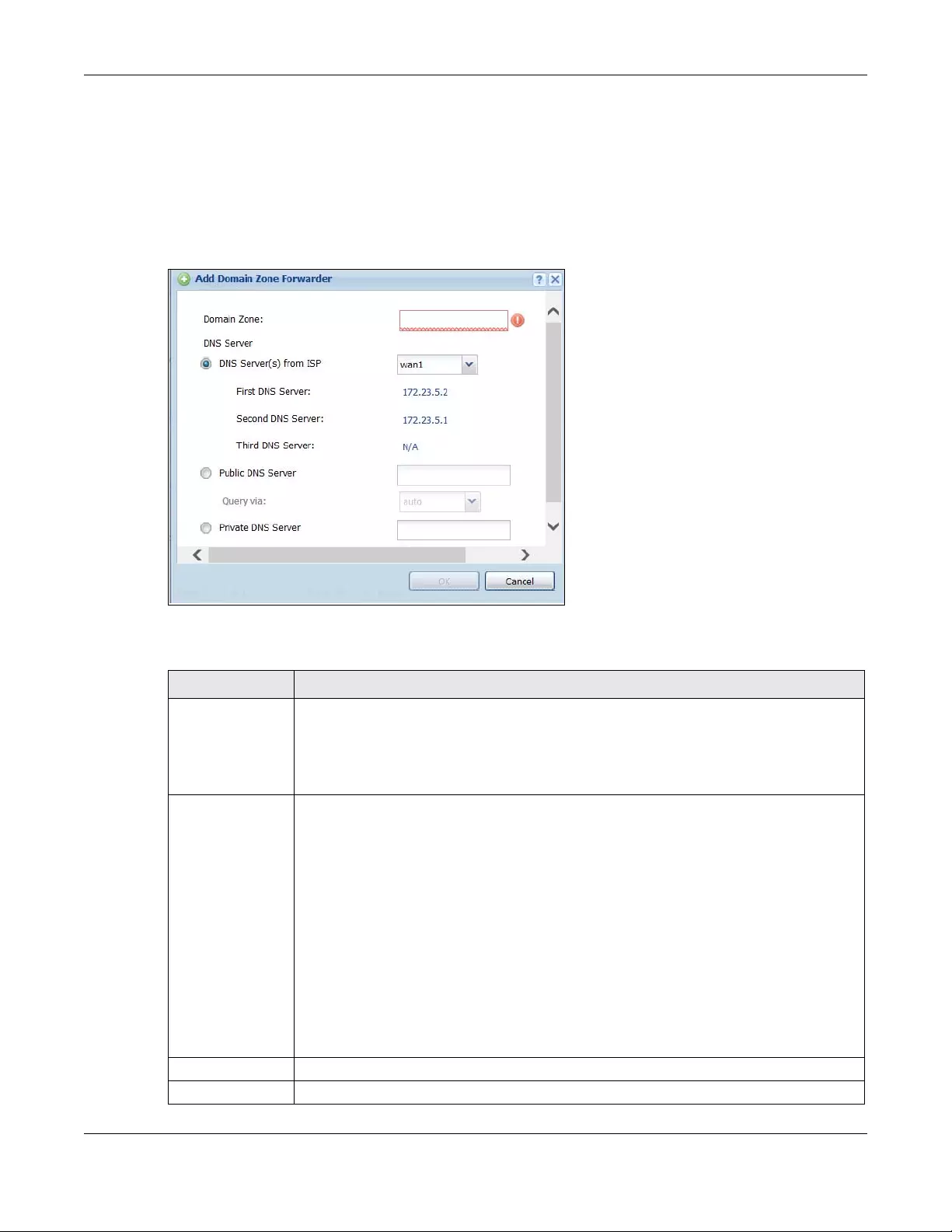
Chapter 36 System
ZyWALL/USG Series User’s Guide
670
fully qualified domain name without the host. For example, zyxel.com.tw is the domain zone for the
www.zyxel.com.tw fully qualified domain name.
36.6.9 Adding a Domain Zone Forwarder
Click the Add icon in the Domain Zone Forwarder table to add a domain zone forwarder record.
Figure 456 Configuration > System > DNS > Domain Zone Forwarder Add
The following table describes the labels in this screen.
Table 303 Configuration > System > DNS > Domain Zone Forwarder Add
LABEL DESCRIPTION
Domain Zone A domain zone is a fully qualified domain name without the host. For example,
zyxel.com.tw is the domain zone for the www.zyxel.com.tw fully qualified domain name.
For example, whenever the ZyWALL/USG receives needs to resolve a zyxel.com.tw
domain name, it can send a query to the recorded name server IP address.
Enter * if all domain zones are served by the specified DNS server(s).
DNS Server Select DNS Server(s) from ISP if your ISP dynamically assigns DNS server
information. You also need to select an interface through which the ISP provides the DNS
server IP address(es). The interface should be activated and set to be a DHCP client. The
fields below display the (read-only) DNS server IP address(es) that the ISP assigns. N/A
displays for any DNS server IP address fields for which the ISP does not assign an IP
address.
Select Public DNS Server if you have the IP address of a DNS server. Enter the DNS
server's IP address in the field to the right. The ZyWALL/USG must be able to connect to
the DNS server without using a VPN tunnel. The DNS server could be on the Internet or
one of the ZyWALL/USG’s local networks. You cannot use 0.0.0.0. Use the Query via
field to select the interface through which the ZyWALL/USG sends DNS queries to a DNS
server.
Select Private DNS Server if you have the IP address of a DNS server to which the
ZyWALL/USG connects through a VPN tunnel. Enter the DNS server's IP address in the
field to the right. You cannot use 0.0.0.0.
OK Click OK to save your customized settings and exit this screen.
Cancel Click Cancel to exit this screen without saving
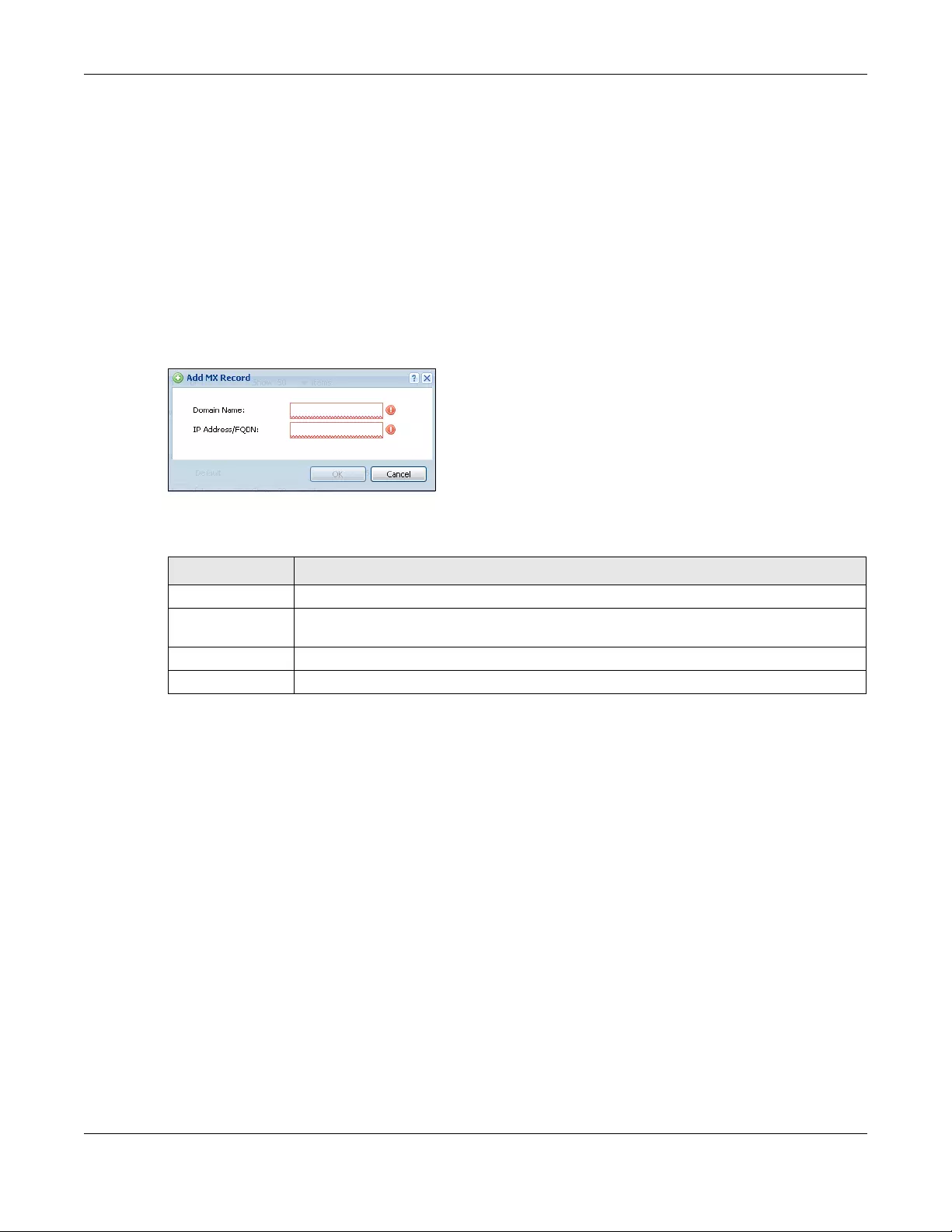
Chapter 36 System
ZyWALL/USG Series User’s Guide
671
36.6.10 MX Record
A MX (Mail eXchange) record indicates which host is responsible for the mail for a particular
domain, that is, controls where mail is sent for that domain. If you do not configure proper MX
records for your domain or other domain, external e-mail from other mail servers will not be able to
be delivered to your mail server and vice versa. Each host or domain can have only one MX record,
that is, one domain is mapping to one host.
36.6.11 Adding a MX Record
Click the Add icon in the MX Record table to add a MX record.
Figure 457 Configuration > System > DNS > MX Record Add
The following table describes the labels in this screen.
36.6.12 Security Option Control
Configure the Security Option Control section in the Configuration > System > DNS screen
(click Show Advanced Settings to display it) if you suspect the ZyWALL/USG is being used by
hackers in a DNS amplification attack.
One possible strategy would be to deny Query Recursion and Addition al Info from Cache in the
default policy and allow Query Recursion and Additional Info from Cache only from trusted
DNS servers identified by address objects and added as members in the customized policy.
36.6.13 Editing a Security Option Control
Click a control policy and then click Edit to change allow or deny actions for Query Recursion
and Additional Info from Cache.
Table 304 Configuration > System > DNS > MX Record Add
LABEL DESCRIPTION
Domain Name Enter the domain name where the mail is destined for.
IP Address/FQDN Enter the IP address or Fully-Qualified Domain Name (FQDN) of a mail server that
handles the mail for the domain specified in the field above.
OK Click OK to save your customized settings and exit this screen.
Cancel Click Cancel to exit this screen without saving

Chapter 36 System
ZyWALL/USG Series User’s Guide
672
Figure 458 Configuration > System > DNS > Security Option Control Edit (Customize)
The following table describes the labels in this screen.
36.6.14 Adding a DNS Service Control Rule
Click the Add icon in the Service Contro l table to add a service control rule.
Table 305 Configuration > System > DNS > Security Option Control Edit (Customize)
LABEL DESCRIPTION
Name You may change the name for the customized security option control policy. The
customized security option control policy is checked first and if an address object match is
not found, the Default control policy is checked
Query Recursion Choose if the ZyWALL/USG is allowed or denied to forward DNS client requests to DNS
servers for resolution. This can apply to specific open DNS servers using the address
objects in a customized rule.
Additional Info
from Cache
Choose if the ZyWALL/USG is allowed or denied to cache Resource Records (RR) obtained
from previous DNS queries.
Address List Specifiying address objects is not available in the default policy as all addresses are
included.
Available This box displays address objects created in Object > Address. Select one (or more),
and click the > arrow to have it (them) join the Member list of address objects that will
apply to this rule. For example, you could specifiy an open DNS server suspect of sending
compromised resource records by adding an address object for that server to the
member list.
Member This box displays address objects that will apply to this rule.
OK Click OK to save your customized settings and exit this screen.
Cancel Click Cancel to exit this screen without saving
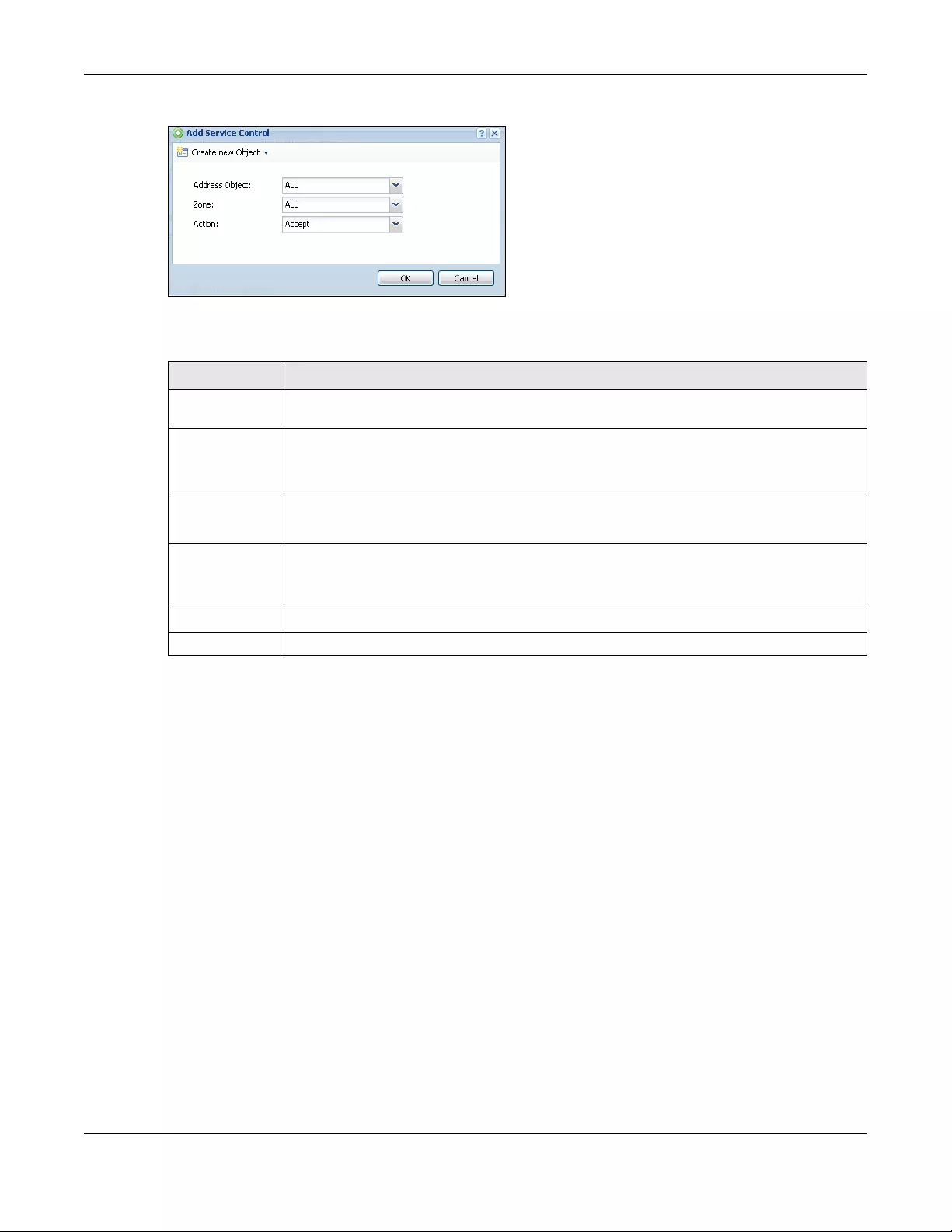
Chapter 36 System
ZyWALL/USG Series User’s Guide
673
Figure 459 Configuration > System > DNS > Service Control Rule Add
The following table describes the labels in this screen.
36.7 WWW Overview
The following figure shows secure and insecure management of the ZyWALL/USG coming in from
the WAN. HTTPS and SSH access are secure. HTTP and Telnet access are not secure.
Note: To allow the ZyWALL/USG to be accessed from a specified computer using a
service, make sure you do not have a service control rule or to-ZyWALL/USG
security policy rule to block that traffic.
To stop a service from accessing the ZyWALL/USG, clear Enable in the corresponding service
screen.
36.7.1 Service Access Limitations
A service cannot be used to access the ZyWALL/USG when:
1You have disabled that service in the corresponding screen.
2The allowed IP address (address object) in the Service Control table does not match the client IP
address (the ZyWALL/USG disallows the session).
Table 306 Configuration > System > DNS > Service Control Rule Add
LABEL DESCRIPTION
Create new
Object
Use this to configure any new settings objects that you need to use in this screen.
Address Object Select ALL to allow or deny any computer to send DNS queries to the ZyWALL/USG.
Select a predefined address object to just allow or deny the computer with the IP address
that you specified to send DNS queries to the ZyWALL/USG.
Zone Select ALL to allow or prevent DNS queries through any zones.
Select a predefined zone on which a DNS query to the ZyWALL/USG is allowed or denied.
Action Select Accept to have the ZyWALL/USG allow the DNS queries from the specified
computer.
Select Deny to have the ZyWALL/USG reject the DNS queries from the specified computer.
OK Click OK to save your customized settings and exit this screen.
Cancel Click Cancel to exit this screen without saving

Chapter 36 System
ZyWALL/USG Series User’s Guide
674
3The IP address (address object) in the Service Control table is not in the allowed zone or the
action is set to Deny.
4There is a security policy rule that blocks it.
36.7.2 System Timeout
There is a lease timeout for administrators. The ZyWALL/USG automatically logs you out if the
management session remains idle for longer than this timeout period. The management session
does not time out when a statistics screen is polling.
Each user is also forced to log in the ZyWALL/USG for authentication again when the
reauthentication time expires.
You can change the timeout settings in the User/Group screens.
36.7.3 HTTPS
You can set the ZyWALL/USG to use HTTP or HTTPS (HTTPS adds security) for Web Configurator
sessions. Specify which zones allow Web Configurator access and from which IP address the access
can come.
HTTPS (HyperText Transfer Protocol over Secure Socket Layer, or HTTP over SSL) is a web protocol
that encrypts and decrypts web pages. Secure Socket Layer (SSL) is an application-level protocol
that enables secure transactions of data by ensuring confidentiality (an unauthorized party cannot
read the transferred data), authentication (one party can identify the other party) and data
integrity (you know if data has been changed).
It relies upon certificates, public keys, and private keys.
HTTPS on the ZyWALL/USG is used so that you can securely access the ZyWALL/USG using the Web
Configurator. The SSL protocol specifies that the HTTPS server (the ZyWALL/USG) must always
authenticate itself to the HTTPS client (the computer which requests the HTTPS connection with the
ZyWALL/USG), whereas the HTTPS client only should authenticate itself when the HTTPS server
requires it to do so (select Authenticate Client Certificates in the WWW screen). Authenticate
Client Certificates is optional and if selected means the HTTPS client must send the ZyWALL/USG
a certificate. You must apply for a certificate for the browser from a CA that is a trusted CA on the
ZyWALL/USG.
Please refer to the following figure.
1HTTPS connection requests from an SSL-aware web browser go to port 443 (by default) on the
ZyWALL/USG’s web server.
2HTTP connection requests from a web browser go to port 80 (by default) on the ZyWALL/USG’s web
server.
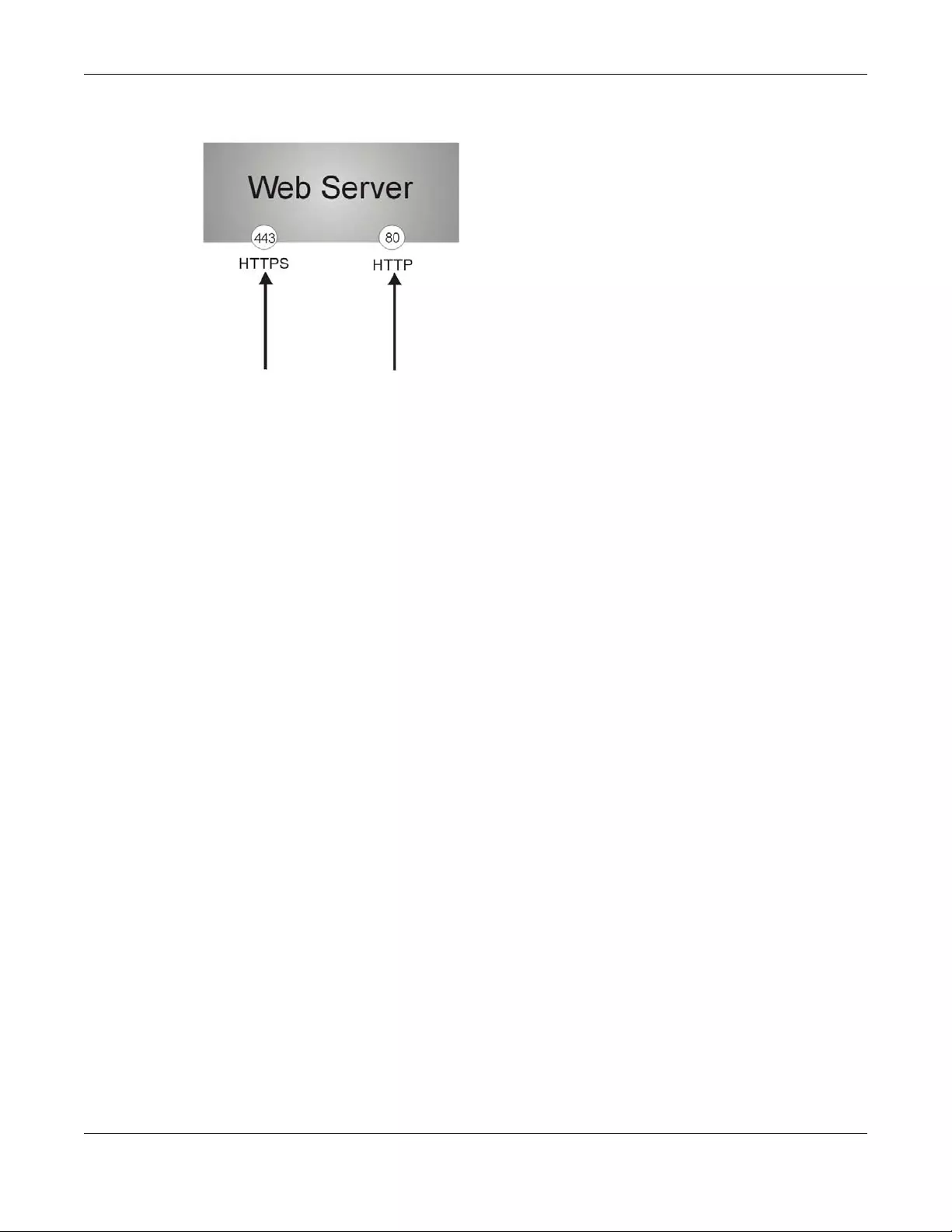
Chapter 36 System
ZyWALL/USG Series User’s Guide
675
Figure 460 HTTP/HTTPS Implementation
Note: If you disable HTTP in the WWW screen, then the ZyWALL/USG blocks all HTTP
connection attempts.
36.7.4 Configuring WWW Service Control
Click Configuration > System > WWW to open the WWW screen. Use this screen to specify
from which zones you can access the ZyWALL/USG using HTTP or HTTPS. You can also specify
which IP addresses the access can come from.
Note: Admin Service Control deals with management access (to the Web Configurator).
User Service Control deals with user access to the ZyWALL/USG (logging into
SSL VPN for example).
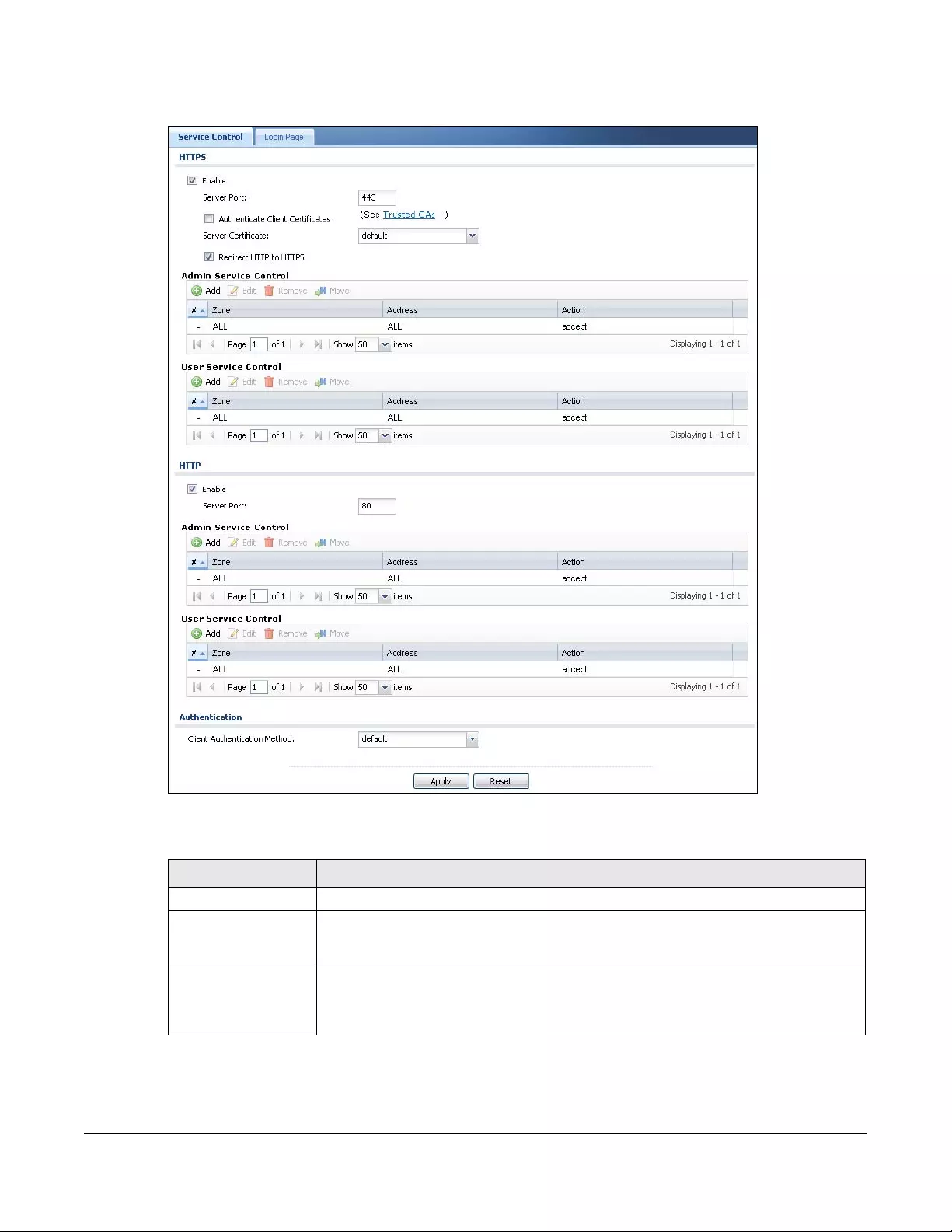
Chapter 36 System
ZyWALL/USG Series User’s Guide
676
Figure 461 Configuration > System > WWW > Service Control
The following table describes the labels in this screen.
Table 307 Configuration > System > WWW > Service Control
LABEL DESCRIPTION
HTTPS
Enable Select the check box to allow or disallow the computer with the IP address that
matches the IP address(es) in the Service Control table to access the ZyWALL/USG
Web Configurator using secure HTTPs connections.
Server Port The HTTPS server listens on port 443 by default. If you change the HTTPS server port
to a different number on the ZyWALL/USG, for example 8443, then you must notify
people who need to access the ZyWALL/USG Web Configurator to use “https://
ZyWALL/USG IP Address:8443” as the URL.
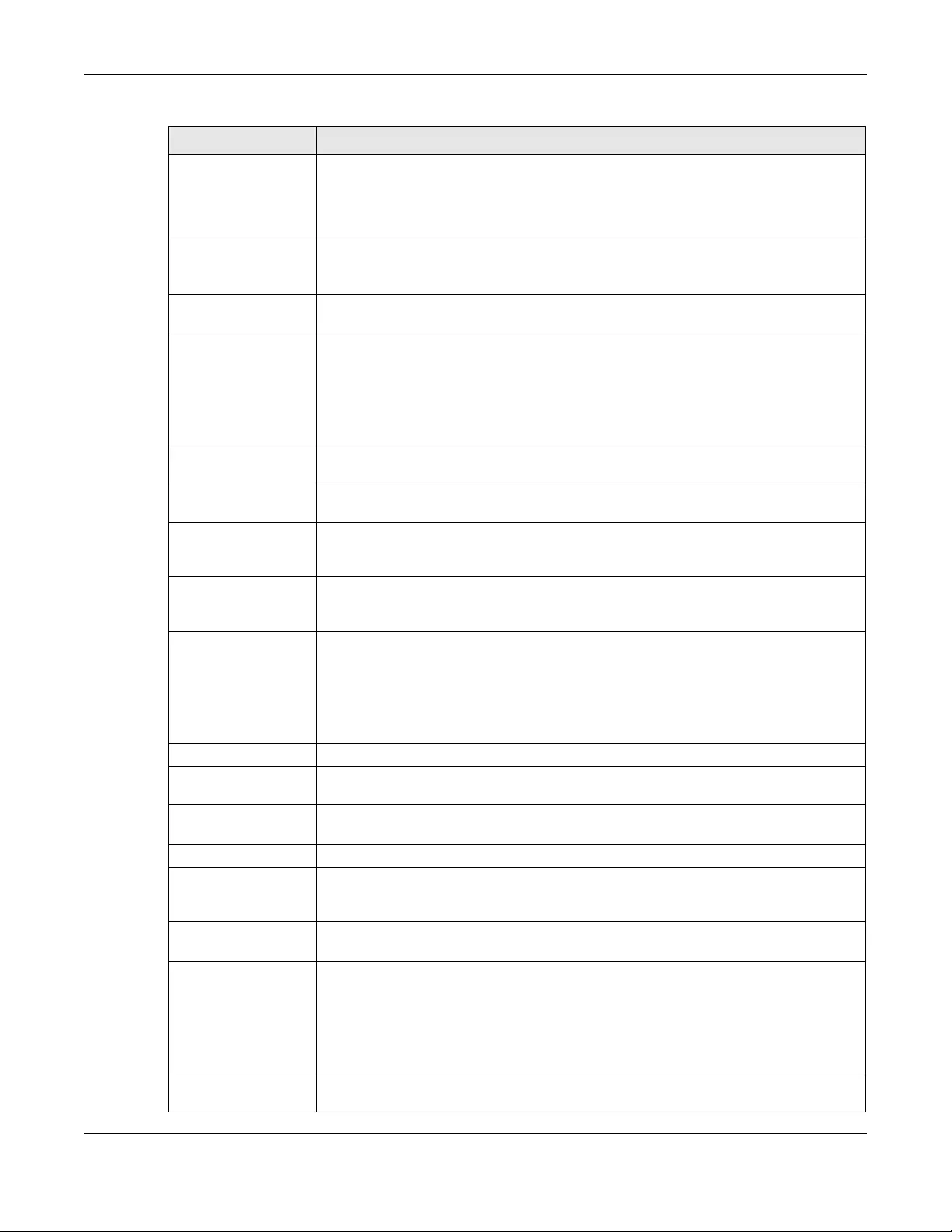
Chapter 36 System
ZyWALL/USG Series User’s Guide
677
Authenticate Client
Certificates
Select Authenticate Clie nt Certi f icates (optional) to require the SSL client to
authenticate itself to the ZyWALL/USG by sending the ZyWALL/USG a certificate. To
do that the SSL client must have a CA-signed certificate from a CA that has been
imported as a trusted CA on the ZyWALL/USG (see Section 36.7.7.5 on page 685 on
importing certificates for details).
Server Certificate Select a certificate the HTTPS server (the ZyWALL/USG) uses to authenticate itself to
the HTTPS client. You must have certificates already configured in the My
Certificates screen.
Redirect HTTP to
HTTPS
To allow only secure Web Configurator access, select this to redirect all HTTP
connection requests to the HTTPS server.
Admin/User Service
Control Admin Service Co ntro l specifies from which zones an administrator can use HTTPS
to manage the ZyWALL/USG (using the Web Configurator). You can also specify the IP
addresses from which the administrators can manage the ZyWALL/USG.
User Servic e Control specifies from which zones a user can use HTTPS to log into
the ZyWALL/USG (to log into SSL VPN for example). You can also specify the IP
addresses from which the users can access the ZyWALL/USG.
Add Click this to create a new entry. Select an entry and click Add to create a new entry
after the selected entry.
Edit Double-click an entry or select it and click Edit to be able to modify the entry’s
settings.
Remove To remove an entry, select it and click Remove. The ZyWALL/USG confirms you want
to remove it before doing so. Note that subsequent entries move up by one when you
take this action.
Move To change an entry’s position in the numbered list, select the method and click Move
to display a field to type a number for where you want to put it and press [ENTER] to
move the rule to the number that you typed.
#This is the index number of the service control rule.
The entry with a hyphen (-) instead of a number is the ZyWALL/USG’s (non-
configurable) default policy. The ZyWALL/USG applies this to traffic that does not
match any other configured rule. It is not an editable rule. To apply other behavior,
configure a rule that traffic will match so the ZyWALL/USG will not have to use the
default policy.
Zone This is the zone on the ZyWALL/USG the user is allowed or denied to access.
Address This is the object name of the IP address(es) with which the computer is allowed or
denied to access.
Action This displays whether the computer with the IP address specified above can access
the ZyWALL/USG zone(s) configured in the Zone field (Accept) or not (Deny).
HTTP
Enable Select the check box to allow or disallow the computer with the IP address that
matches the IP address(es) in the Service Control table to access the ZyWALL/USG
Web Configurator using HTTP connections.
Server Port You may change the server port number for a service if needed, however you must
use the same port number in order to use that service to access the ZyWALL/USG.
Admin/User Service
Control Admin Service Control specifies from which zones an administrator can use HTTP to
manage the ZyWALL/USG (using the Web Configurator). You can also specify the IP
addresses from which the administrators can manage the ZyWALL/USG.
User Service Control specifies from which zones a user can use HTTP to log into the
ZyWALL/USG (to log into SSL VPN for example). You can also specify the IP addresses
from which the users can access the ZyWALL/USG.
Add Click this to create a new entry. Select an entry and click Add to create a new entry
after the selected entry.
Table 307 Configuration > System > WWW > Service Control (continued)
LABEL DESCRIPTION

Chapter 36 System
ZyWALL/USG Series User’s Guide
678
36.7.5 Service Control Rules
Click Add or Edit in the Service Control table in a WWW, SSH, Telnet, FTP or SNMP screen to
add a service control rule.
Figure 462 Configuration > System > Service Control Rule > Edit
Edit Double-click an entry or select it and click Edit to be able to modify the entry’s
settings.
Remove To remove an entry, select it and click Remove. The ZyWALL/USG confirms you want
to remove it before doing so. Note that subsequent entries move up by one when you
take this action.
Move To change an entry’s position in the numbered list, select the method and click Move
to display a field to type a number for where you want to put it and press [ENTER] to
move the rule to the number that you typed.
#This is the index number of the service control rule.
The entry with a hyphen (-) instead of a number is the ZyWALL/USG’s (non-
configurable) default policy. The ZyWALL/USG applies this to traffic that does not
match any other configured rule. It is not an editable rule. To apply other behavior,
configure a rule that traffic will match so the ZyWALL/USG will not have to use the
default policy.
Zone This is the zone on the ZyWALL/USG the user is allowed or denied to access.
Address This is the object name of the IP address(es) with which the computer is allowed or
denied to access.
Action This displays whether the computer with the IP address specified above can access
the ZyWALL/USG zone(s) configured in the Zone field (Accept) or not (Deny).
Authentication
Client Authentication
Method
Select a method the HTTPS or HTTP server uses to authenticate a client.
You must have configured the authentication methods in the Auth. method screen.
Apply Click Apply to save your changes back to the ZyWALL/USG.
Reset Click Reset to return the screen to its last-saved settings.
Table 307 Configuration > System > WWW > Service Control (continued)
LABEL DESCRIPTION
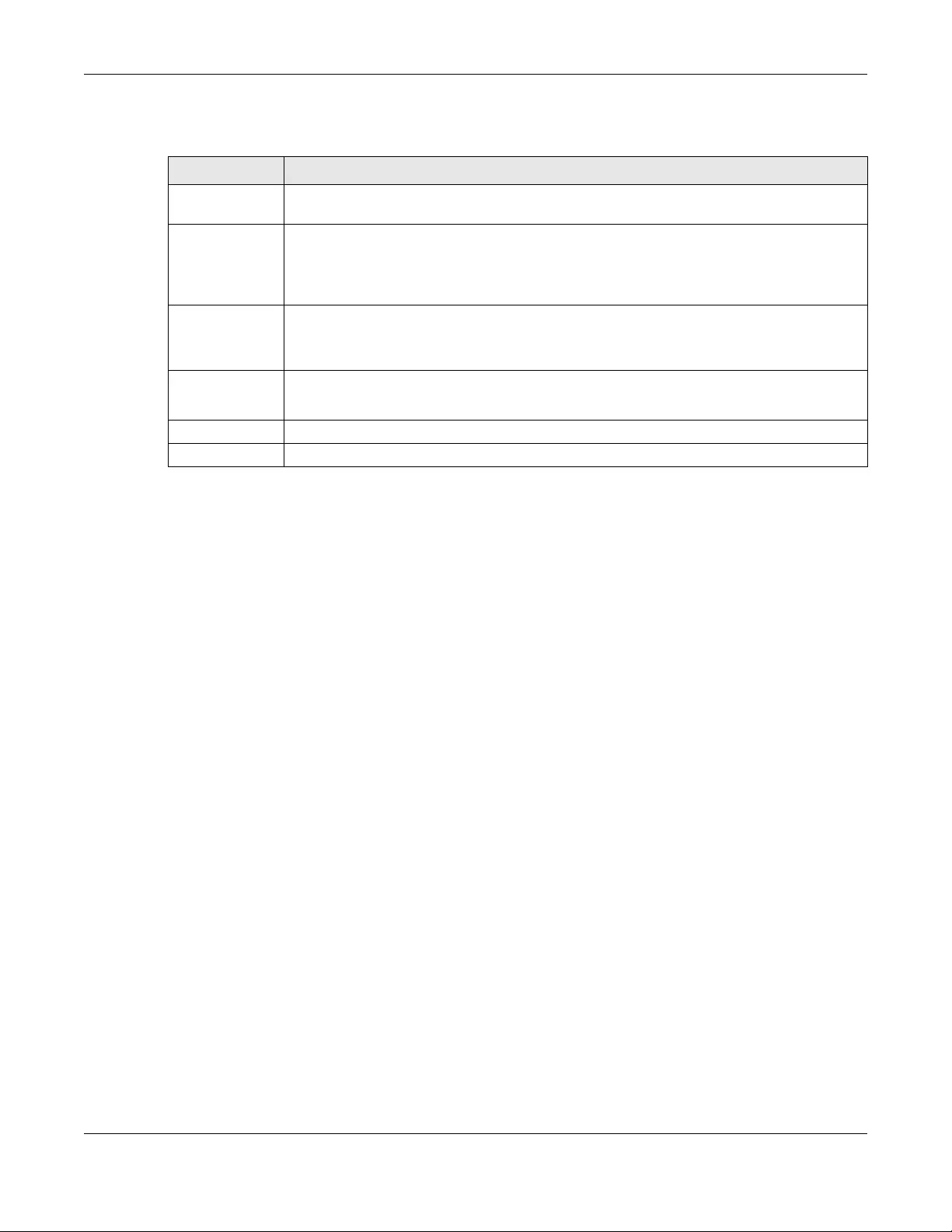
Chapter 36 System
ZyWALL/USG Series User’s Guide
679
The following table describes the labels in this screen.
36.7.6 Customizing the WWW Login Page
Click Configuration > System > WWW > Login Page to open the Login Page screen. Use this
screen to customize the Web Configurator login screen. You can also customize the page that
displays after an access user logs into the Web Configurator to access network services like the
Internet.
Table 308 Configuration > System > Service Control Rule > Edit
LABEL DESCRIPTION
Create new
Object
Use this to configure any new settings objects that you need to use in this screen.
Address Object Select ALL to allow or deny any computer to communicate with the ZyWALL/USG using this
service.
Select a predefined address object to just allow or deny the computer with the IP address
that you specified to access the ZyWALL/USG using this service.
Zone Select ALL to allow or prevent any ZyWALL/USG zones from being accessed using this
service.
Select a predefined ZyWALL/USG zone on which a incoming service is allowed or denied.
Action Select Accept to allow the user to access the ZyWALL/USG from the specified computers.
Select Deny to block the user’s access to the ZyWALL/USG from the specified computers.
OK Click OK to save your customized settings and exit this screen.
Cancel Click Cancel to exit this screen without saving
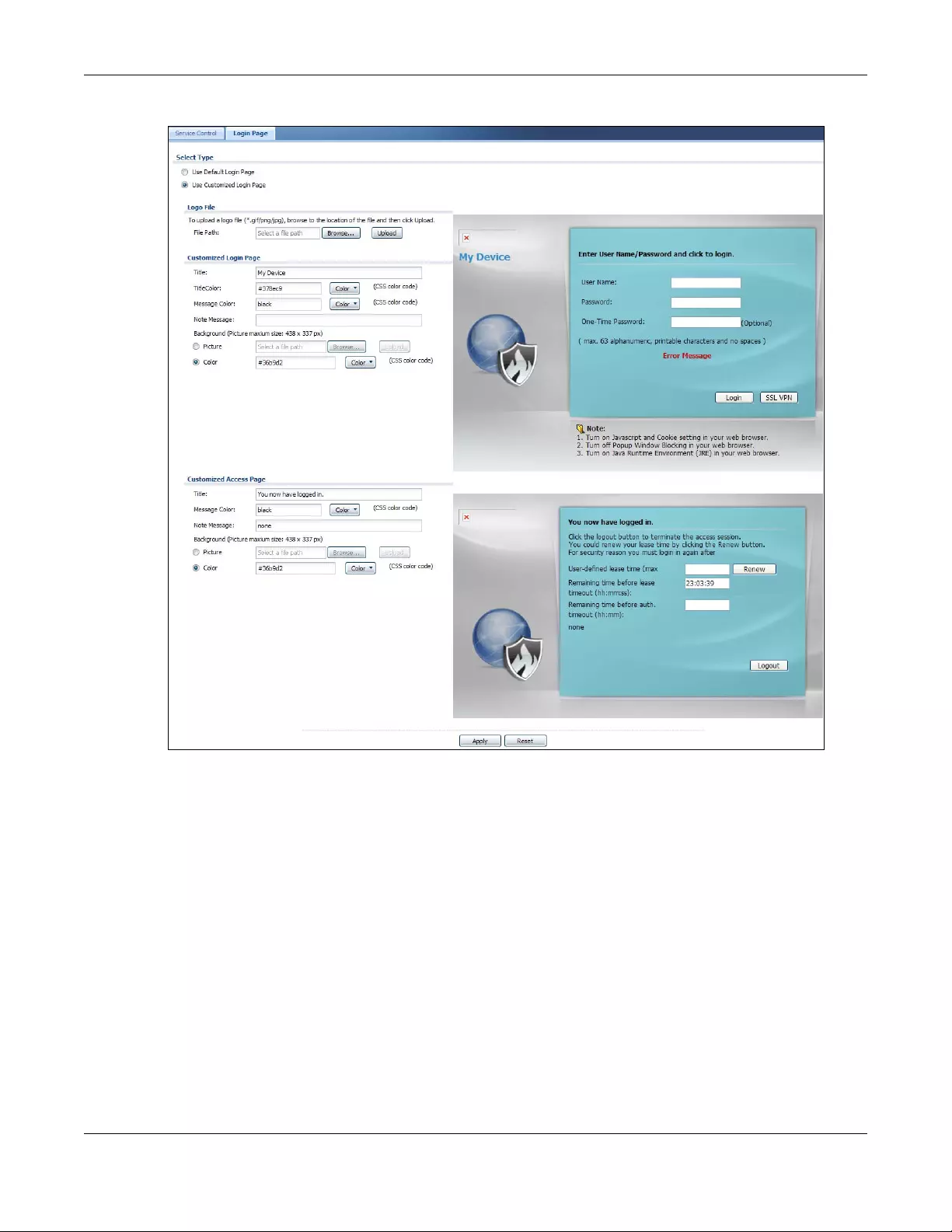
Chapter 36 System
ZyWALL/USG Series User’s Guide
680
Figure 463 Configuration > System > WWW > Login Page
The following figures identify the parts you can customize in the login and access pages.
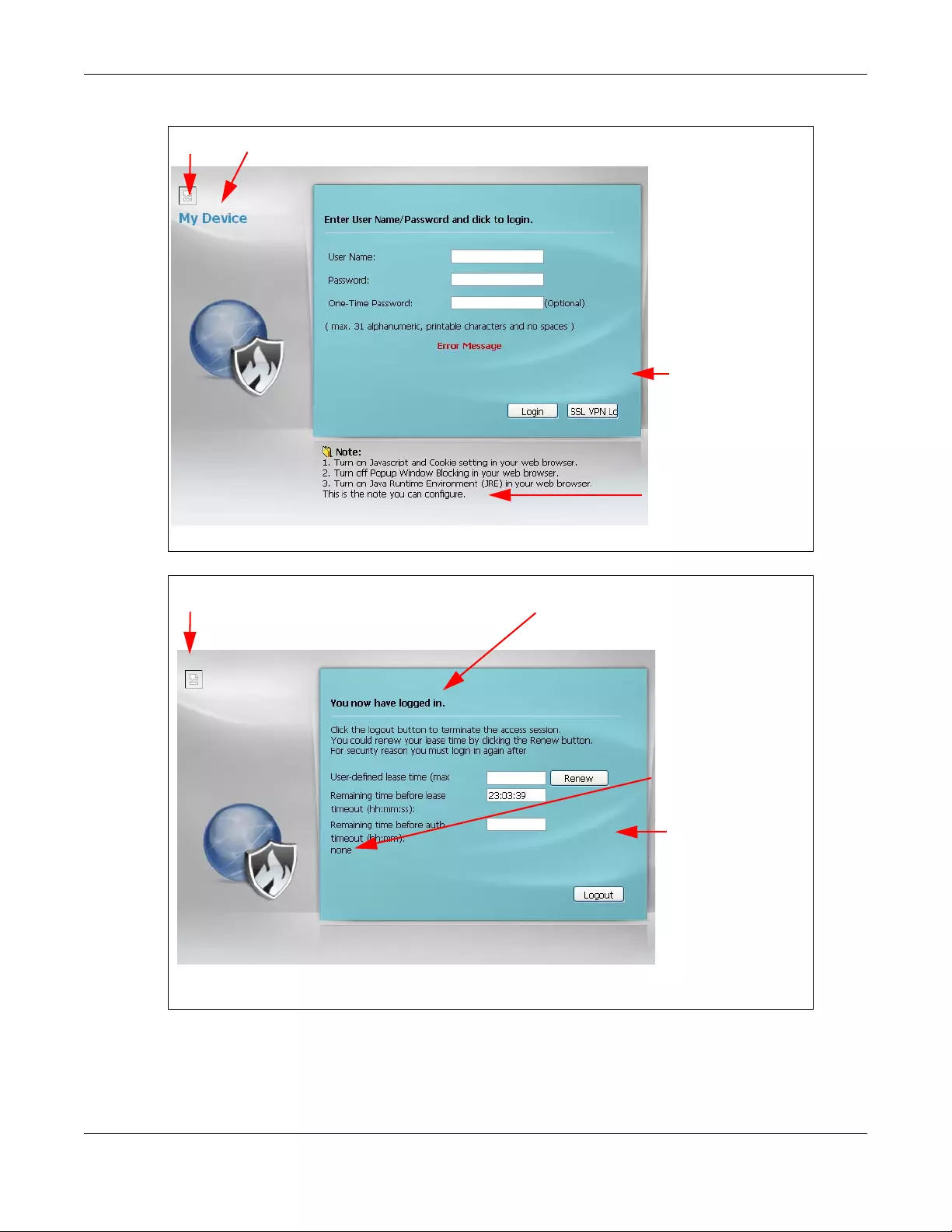
Chapter 36 System
ZyWALL/USG Series User’s Guide
681
Figure 464 Login Page Customization
Figure 465 Access Page Customization
You can specify colors in one of the following ways:
• Click Color to display a screen of web-safe colors from which to choose.
• Enter the name of the desired color.
Logo Title
Message
Note Message
Background
(last line of text)
(color of all text)
Logo Title
Message
Note Message
Window
(last line of text)
(color of all text)
Background
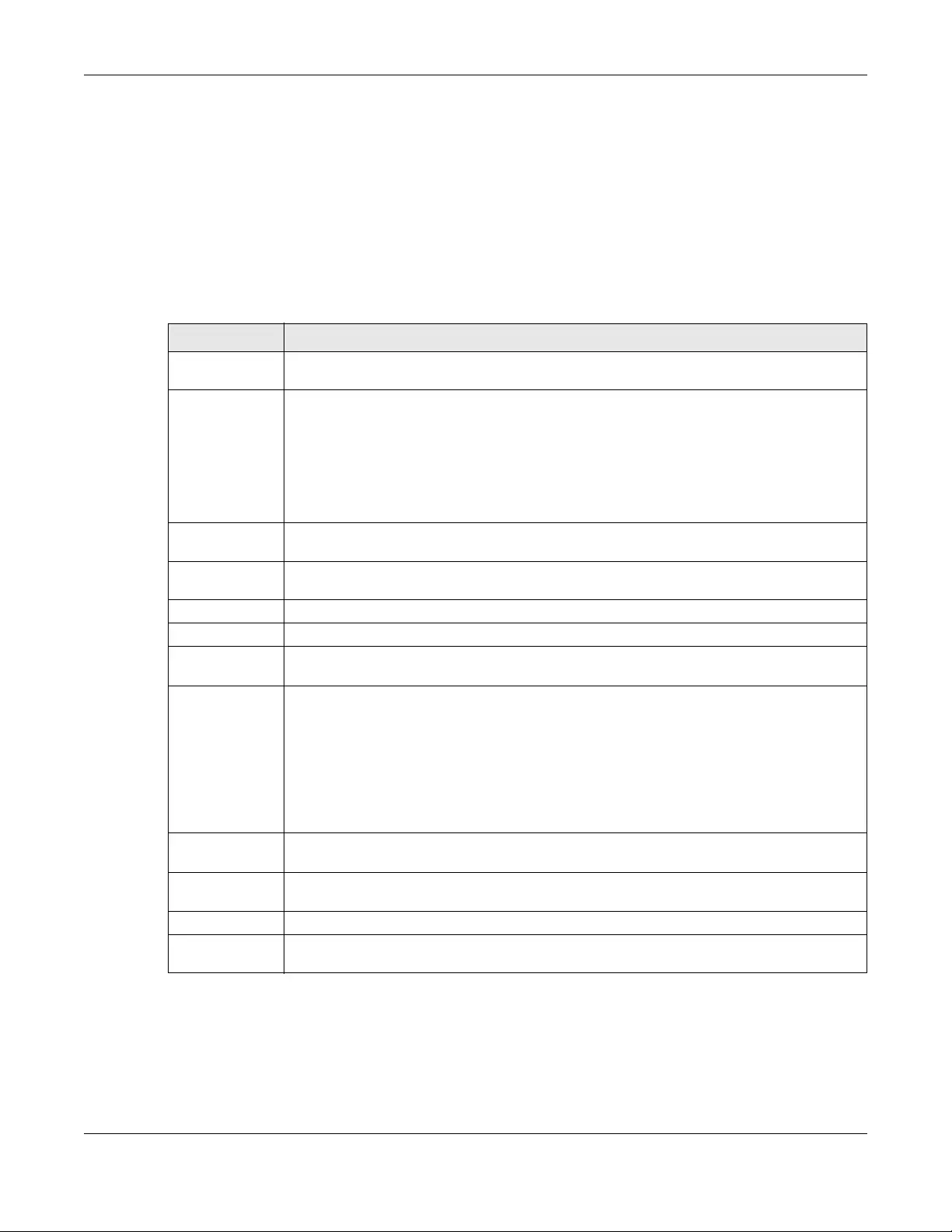
Chapter 36 System
ZyWALL/USG Series User’s Guide
682
• Enter a pound sign (#) followed by the six-digit hexadecimal number that represents the desired
color. For example, use “#000000” for black.
• Enter “rgb” followed by red, green, and blue values in parenthesis and separate by commas. For
example, use “rgb(0,0,0)” for black.
Your desired color should display in the preview screen on the right after you click in another field,
click Apply, or press [ENTER]. If your desired color does not display, your browser may not support
it. Try selecting another color.
The following table describes the labels in the screen.
Table 309 Configuration > System > WWW > Login Page
LABEL DESCRIPTION
Select Type Select whether the Web Configurator uses the default login screen or one that you
customize in the rest of this screen.
Logo File You can upload a graphic logo to be displayed on the upper left corner of the Web
Configurator login screen and access page.
Specify the location and file name of the logo graphic or click Browse to locate it.
Note: Use a GIF, JPG, or PNG of 100 kilobytes or less.
Click Upload to transfer the specified graphic file from your computer to the ZyWALL/USG.
Customized
Login Page
Use this section to set how the Web Configurator login screen looks.
Title Enter the title for the top of the screen. Use up to 64 printable ASCII characters. Spaces
are allowed.
Title Color Specify the color of the screen’s title text.
Message Color Specify the color of the screen’s text.
Note Message Enter a note to display at the bottom of the screen. Use up to 64 printable ASCII
characters. Spaces are allowed.
Background Set how the screen background looks.
To use a graphic, select Picture and upload a graphic. Specify the location and file name of
the logo graphic or click Browse to locate it. The picture’s size cannot be over 438 x 337
pixels.
Note: Use a GIF, JPG, or PNG of 100 kilobytes or less.
To use a color, select Color and specify the color.
Customized
Access Page
Use this section to customize the page that displays after an access user logs into the Web
Configurator to access network services like the Internet.
Title Enter the title for the top of the screen. Use up to 64 printable ASCII characters. Spaces
are allowed.
Message Color Specify the color of the screen’s text.
Note Message Enter a note to display below the title. Use up to 64 printable ASCII characters. Spaces are
allowed.
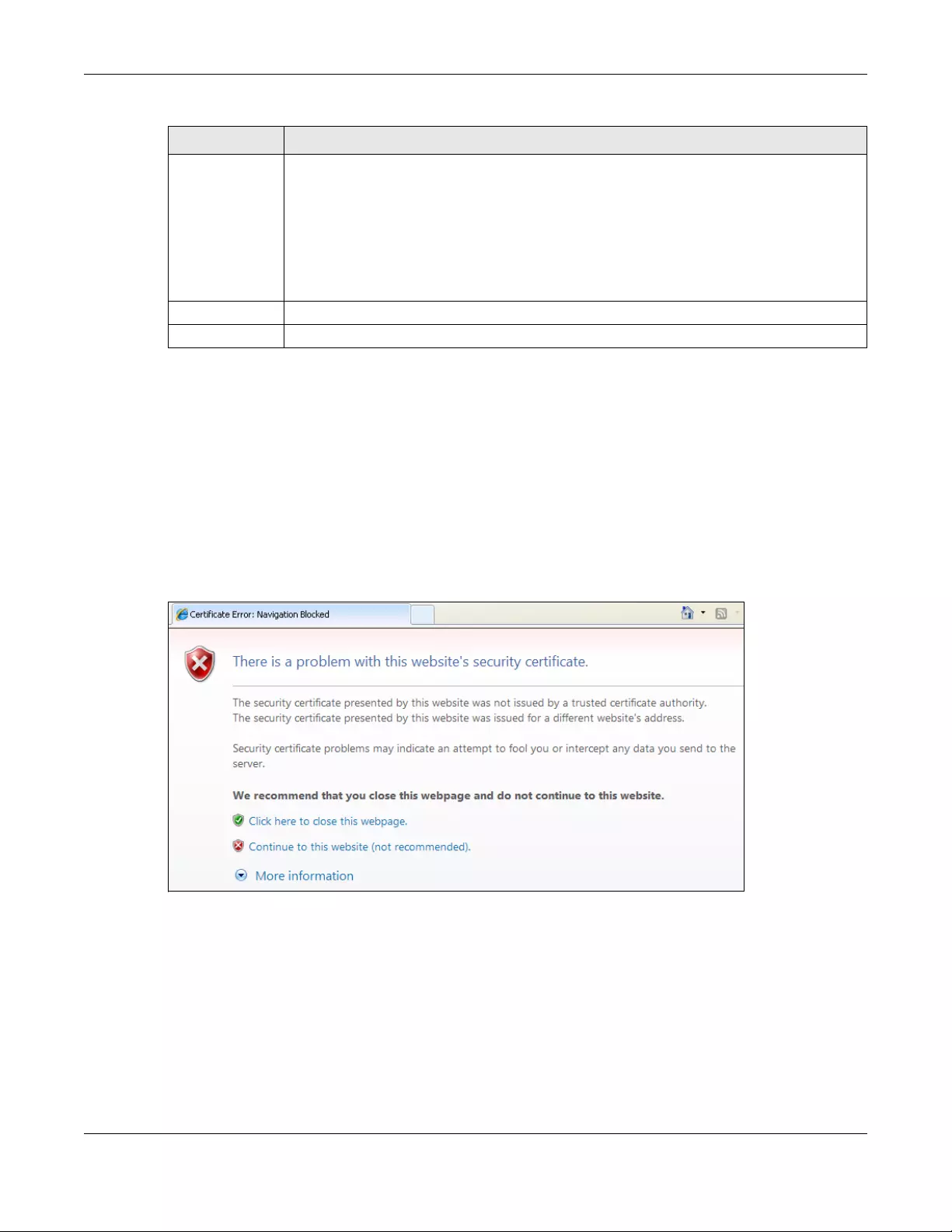
Chapter 36 System
ZyWALL/USG Series User’s Guide
683
36.7.7 HTTPS Example
If you haven’t changed the default HTTPS port on the ZyWALL/USG, then in your browser enter
“https://ZyWALL/USG IP Address/” as the web site address where “ZyWALL/USG IP Address” is the
IP address or domain name of the ZyWALL/USG you wish to access.
36.7.7.1 Internet Explorer Warning Messages
When you attempt to access the ZyWALL/USG HTTPS server, you will see the error message shown
in the following screen.
Figure 466 Security Alert Dialog Box (Internet Explorer)
Select Continue to this website to proceed to the Web Configurator login screen. Otherwise,
select Click here to close this webpage to block the access.
36.7.7.2 Mozilla Firefox Warning Messages
When you attempt to access the ZyWALL/USG HTTPS server, a The Connection is Untrusted
screen appears as shown in the following screen. Click Technical Details if you want to verify
more information about the certificate from the ZyWALL/USG.
Select I Understand the Risks and then click Add Exception to add the ZyWALL/USG to the
security exception list. Click Confirm Security Exception.
Background Set how the window’s background looks.
To use a graphic, select Picture and upload a graphic. Specify the location and file name of
the logo graphic or click Browse to locate it. The picture’s size cannot be over 438 x 337
pixels.
Note: Use a GIF, JPG, or PNG of 100 kilobytes or less.
To use a color, select Color and specify the color.
Apply Click Apply to save your changes back to the ZyWALL/USG.
Reset Click Reset to return the screen to its last-saved settings.
Table 309 Configuration > System > WWW > Login Page
LABEL DESCRIPTION
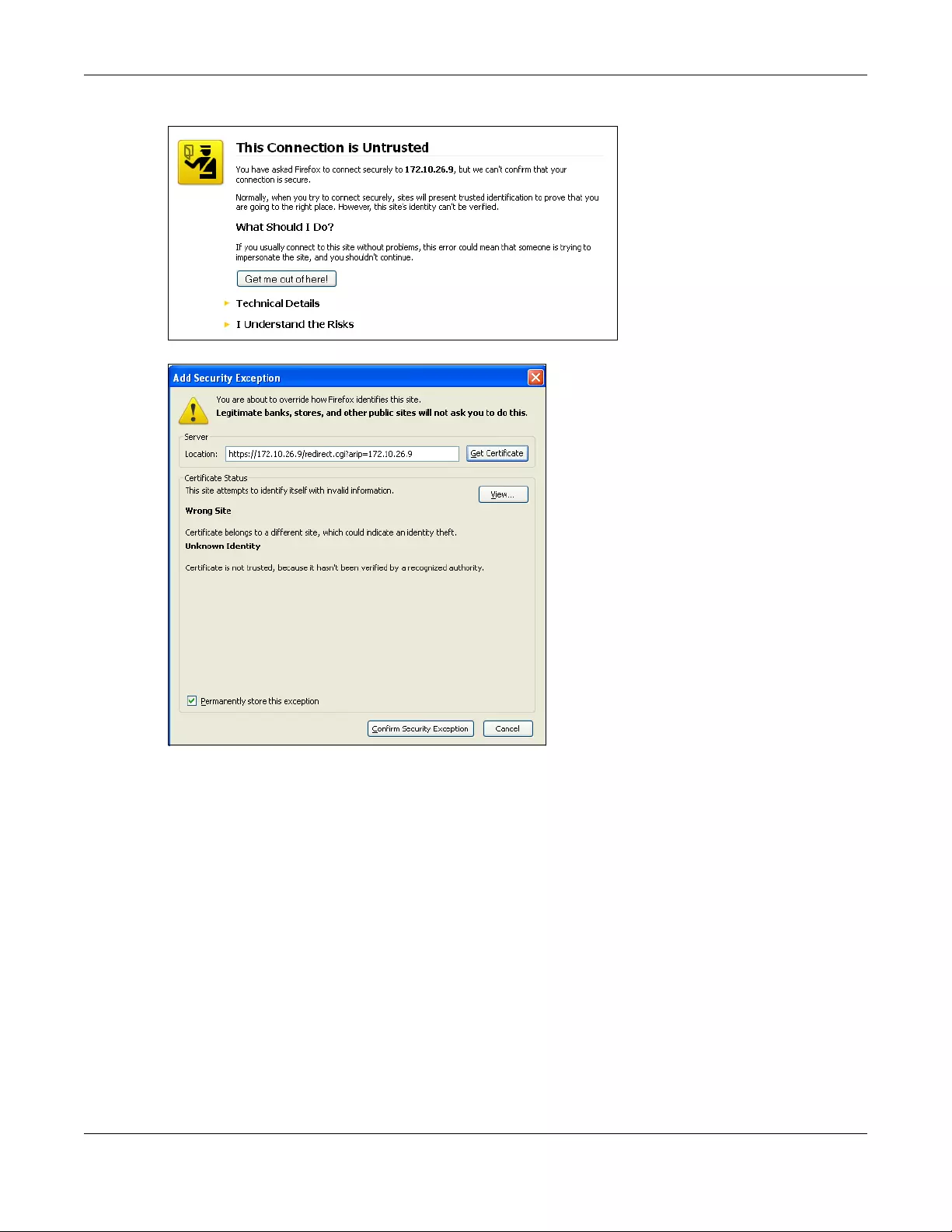
Chapter 36 System
ZyWALL/USG Series User’s Guide
684
Figure 467 Security Certificate 1 (Firefox)
Figure 468 Security Certificate 2 (Firefox)
36.7.7.3 Avoiding Browser Warning Messages
Here are the main reasons your browser displays warnings about the ZyWALL/USG’s HTTPS server
certificate and what you can do to avoid seeing the warnings:
• The issuing certificate authority of the ZyWALL/USG’s HTTPS server certificate is not one of the
browser’s trusted certificate authorities. The issuing certificate authority of the ZyWALL/USG's
factory default certificate is the ZyWALL/USG itself since the certificate is a self-signed certificate.
• For the browser to trust a self-signed certificate, import the self-signed certificate into your
operating system as a trusted certificate.
• To have the browser trust the certificates issued by a certificate authority, import the certificate
authority’s certificate into your operating system as a trusted certificate.
36.7.7.4 Login Screen
After you accept the certificate, the ZyWALL/USG login screen appears. The lock displayed in the
bottom of the browser status bar denotes a secure connection.
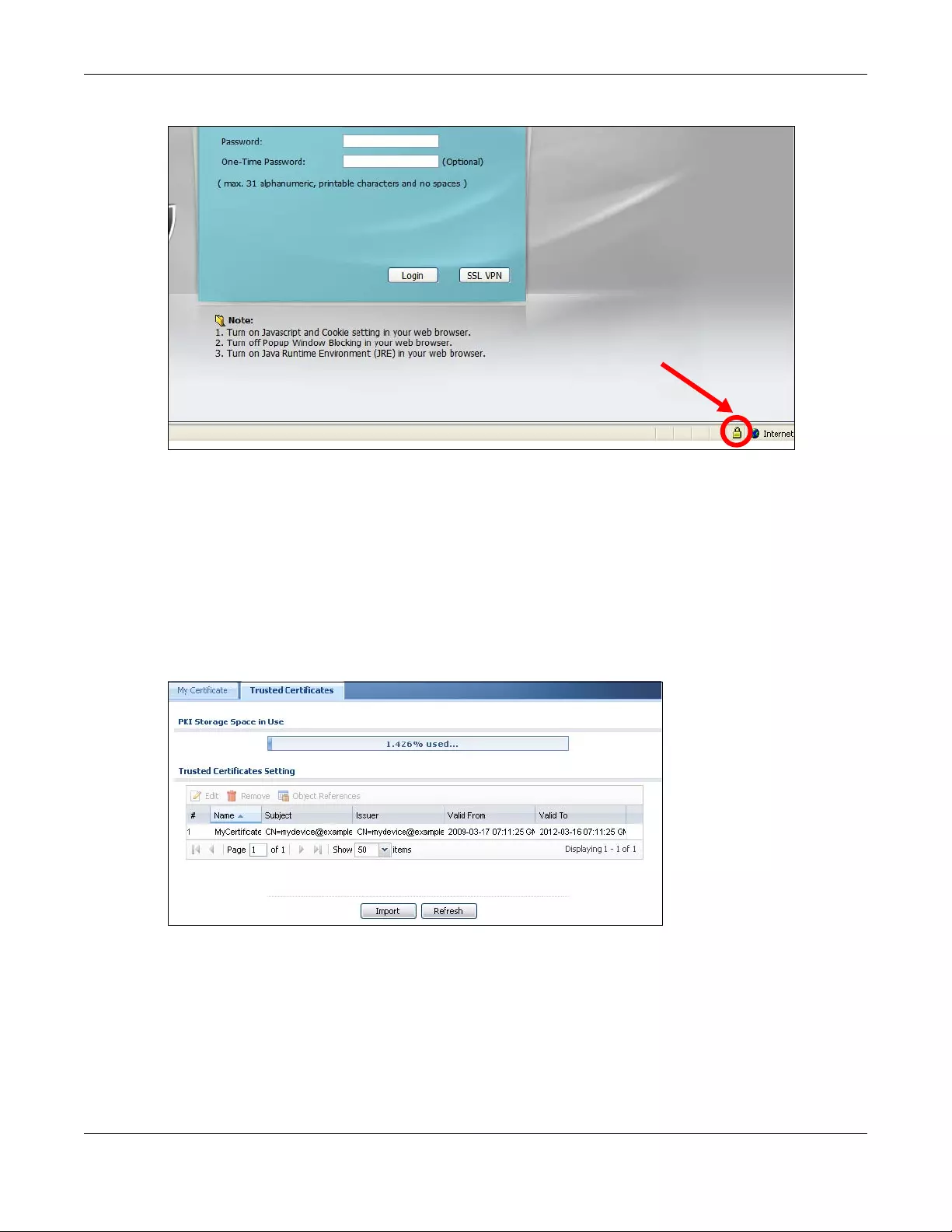
Chapter 36 System
ZyWALL/USG Series User’s Guide
685
Figure 469 Login Screen (Internet Explorer)
36.7.7.5 Enrolling and Importing SSL Client Certificates
The SSL client needs a certificate if Authenticate Client Certificates is selected on the ZyWALL/
USG.
You must have imported at least one trusted CA to the ZyWALL/USG in order for the Authenticate
Client Certificates to be active (see the Certificates chapter for details).
Apply for a certificate from a Certification Authority (CA) that is trusted by the ZyWALL/USG (see
the ZyWALL/USG’s Trusted CA Web Configurator screen).
Figure 470 ZyWALL/USG Trusted CA Screen
The CA sends you a package containing the CA’s trusted certificate(s), your personal certificate(s)
and a password to install the personal certificate(s).
36.7.7.5.1 Installing the CA’s Certificate
1Double click the CA’s trusted certificate to produce a screen similar to the one shown next.
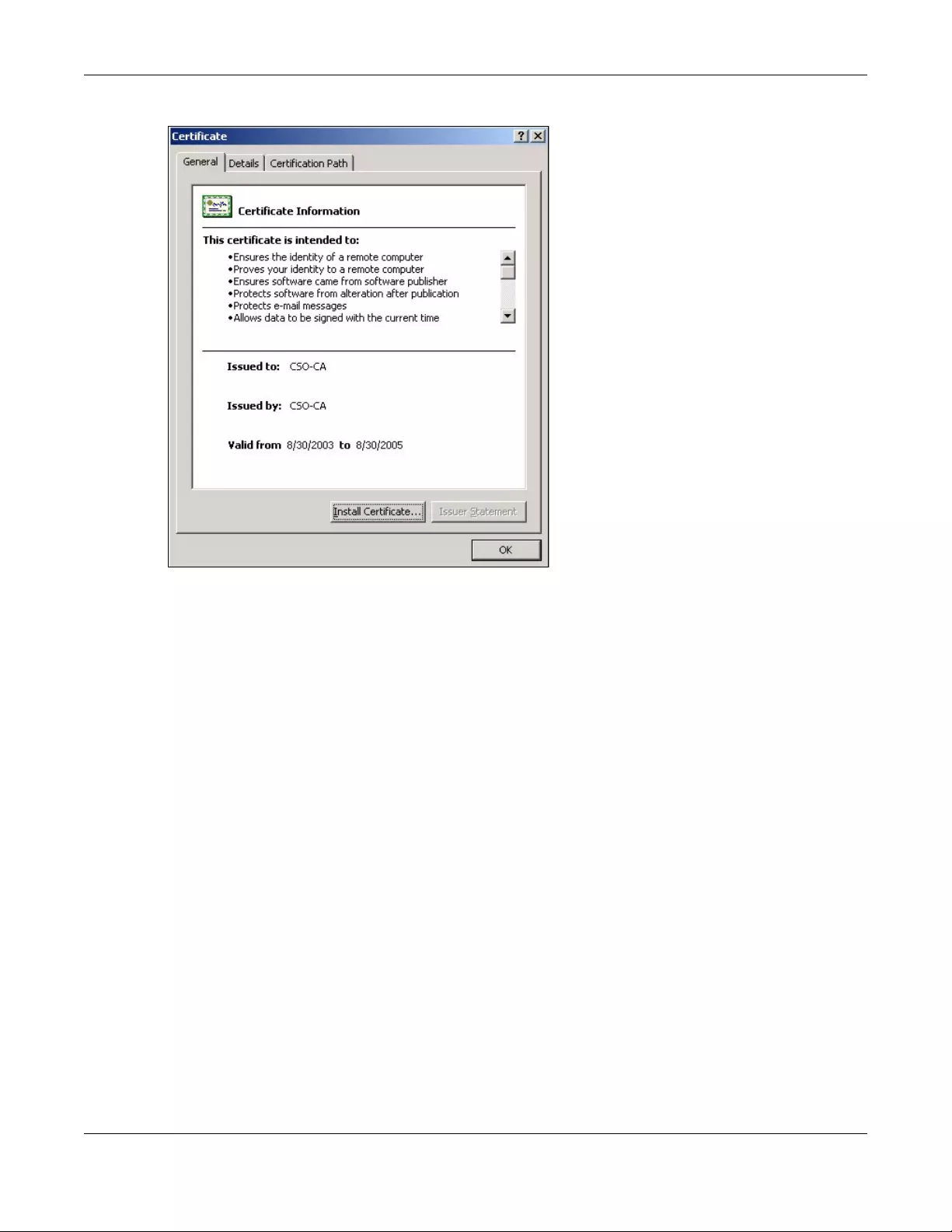
Chapter 36 System
ZyWALL/USG Series User’s Guide
686
Figure 471 CA Certificate Example
2Click Install Certificate and follow the wizard as shown earlier in this appendix.
36.7.7.5.2 Installing Your Personal Certificate(s)
You need a password in advance. The CA may issue the password or you may have to specify it
during the enrollment. Double-click the personal certificate given to you by the CA to produce a
screen similar to the one shown next
1Click Next to begin the wizard.
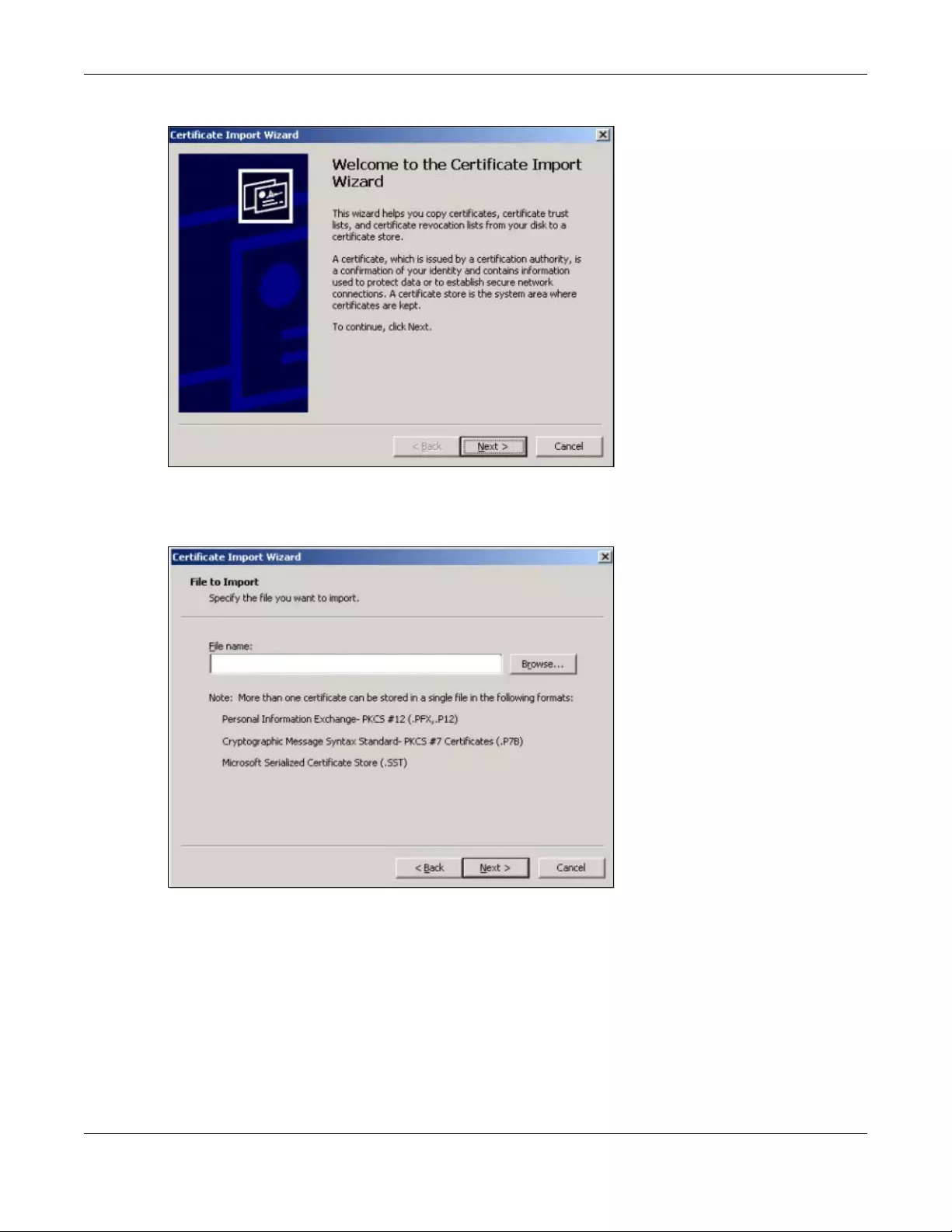
Chapter 36 System
ZyWALL/USG Series User’s Guide
687
Figure 472 Personal Certificate Import Wizard 1
2The file name and path of the certificate you double-clicked should automatically appear in the File
name text box. Click Browse if you wish to import a different certificate.
Figure 473 Personal Certificate Import Wizard 2
3Enter the password given to you by the CA.
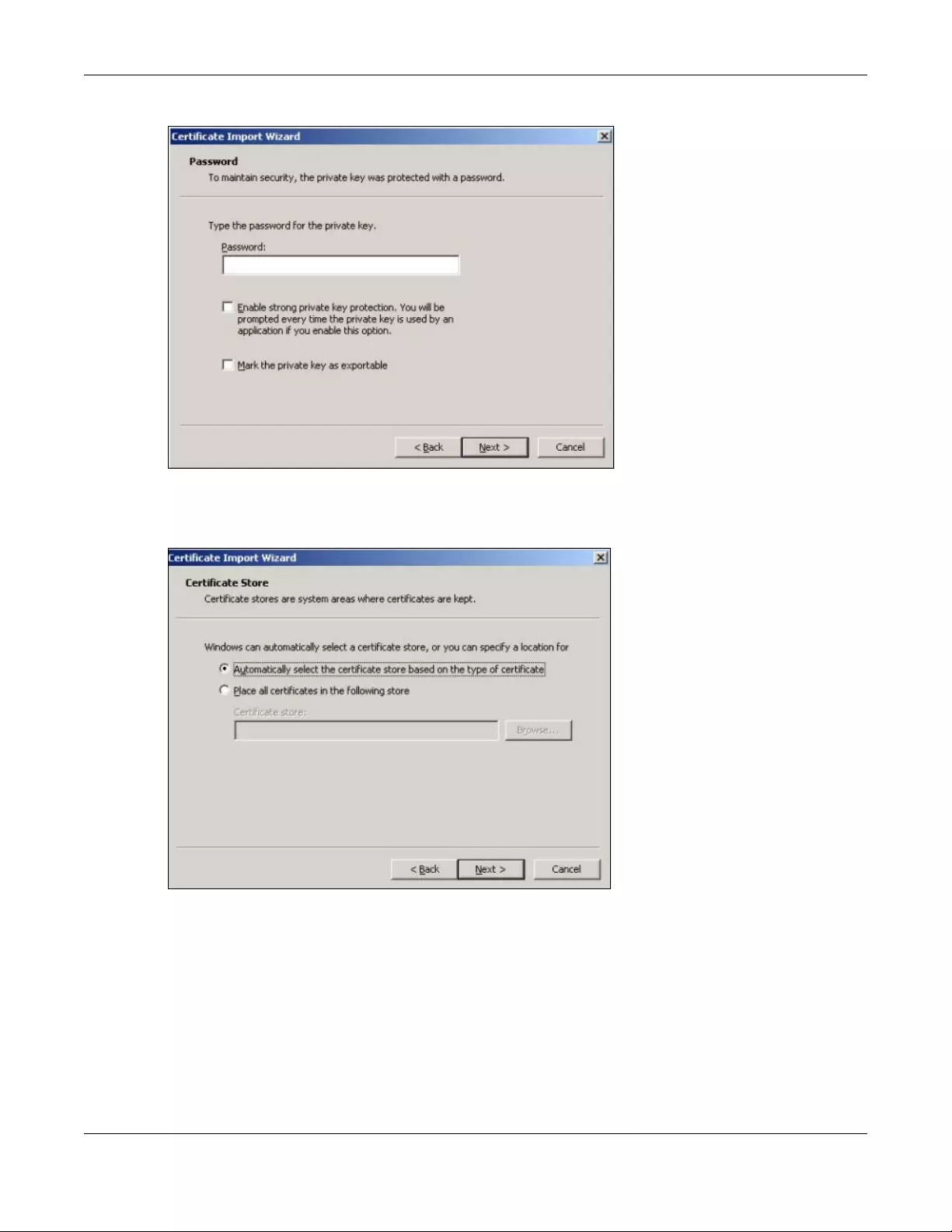
Chapter 36 System
ZyWALL/USG Series User’s Guide
688
Figure 474 Personal Certificate Import Wizard 3
4Have the wizard determine where the certificate should be saved on your computer or select Place
all certificates in the following store and choose a different location.
Figure 475 Personal Certificate Import Wizard 4
5Click Finish to complete the wizard and begin the import process.
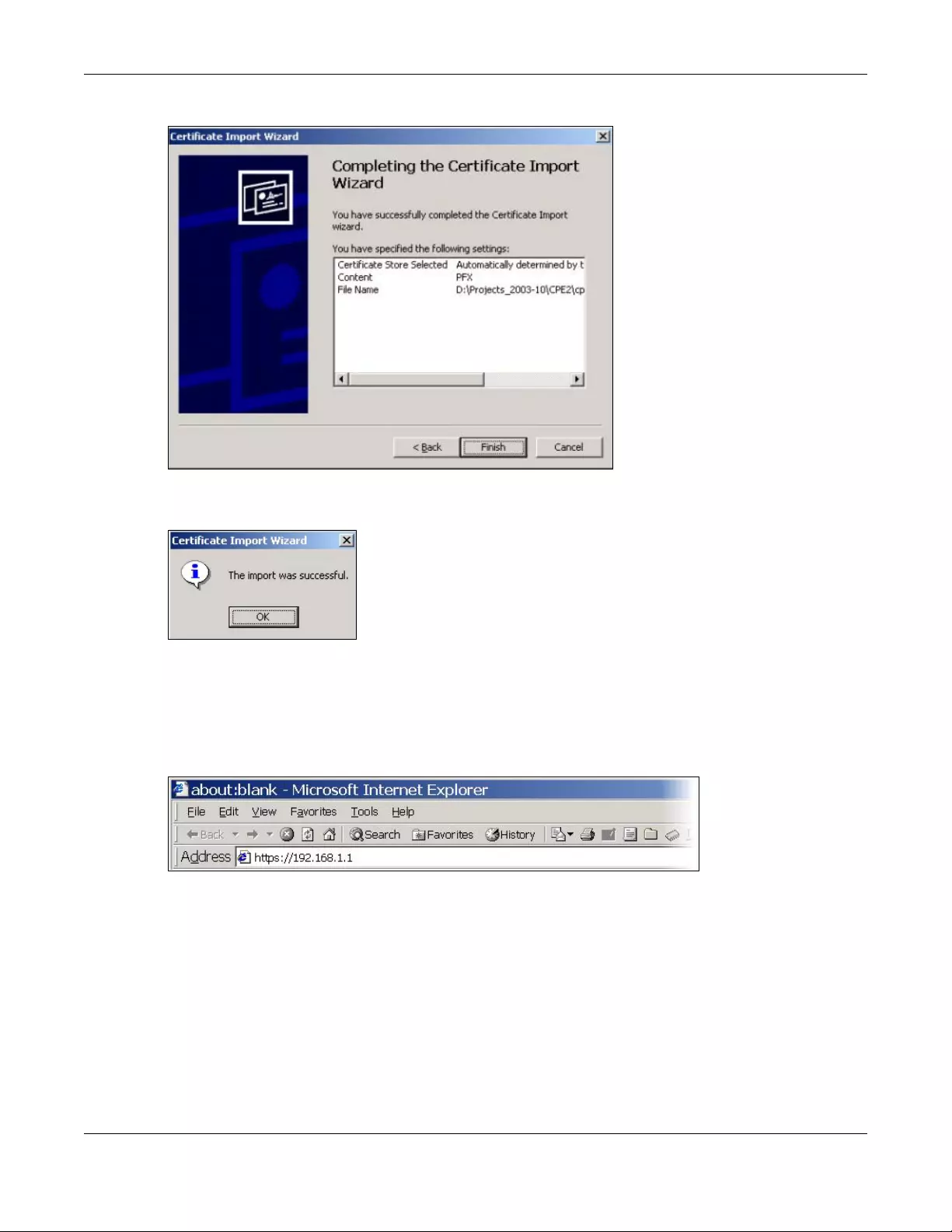
Chapter 36 System
ZyWALL/USG Series User’s Guide
689
Figure 476 Personal Certificate Import Wizard 5
6You should see the following screen when the certificate is correctly installed on your computer.
Figure 477 Personal Certificate Import Wizard 6
36.7.7.6 Using a Certificate When Accessing the ZyWALL/USG Example
Use the following procedure to access the ZyWALL/USG via HTTPS.
1Enter ‘https://ZyWALL/USG IP Address/ in your browser’s web address field.
Figure 478 Access the ZyWALL/USG Via HTTPS
2When Authenticate Client Certificates is selected on the ZyWALL/USG, the following screen asks
you to select a personal certificate to send to the ZyWALL/USG. This screen displays even if you
only have a single certificate as in the example.
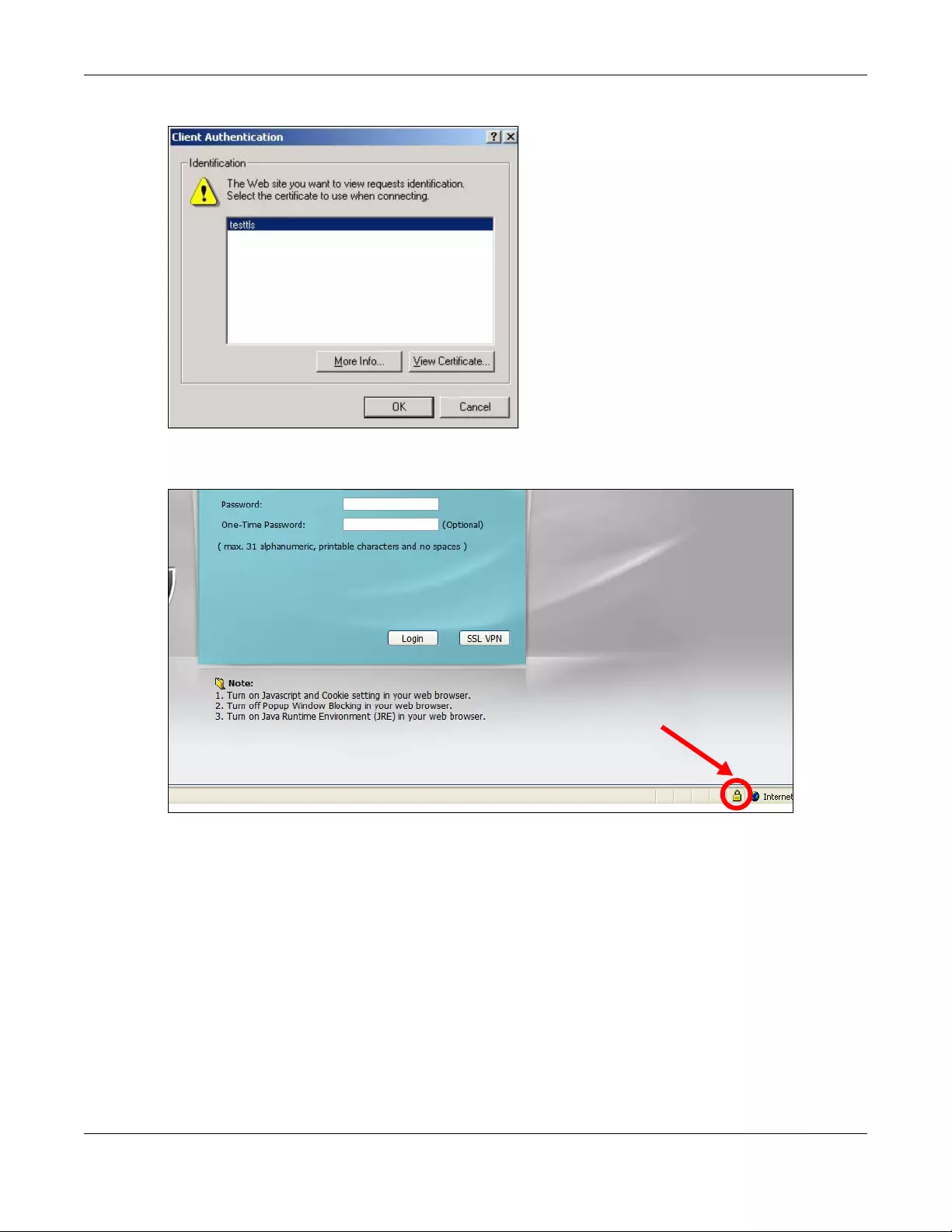
Chapter 36 System
ZyWALL/USG Series User’s Guide
690
Figure 479 SSL Client Authentication
3You next see the Web Configurator login screen.
Figure 480 Secure Web Configurator Login Screen
36.8 SSH
You can use SSH (Secure SHell) to securely access the ZyWALL/USG’s command line interface.
Specify which zones allow SSH access and from which IP address the access can come.
SSH is a secure communication protocol that combines authentication and data encryption to
provide secure encrypted communication between two hosts over an unsecured network. In the
following figure, computer A on the Internet uses SSH to securely connect to the WAN port of the
ZyWALL/USG for a management session.
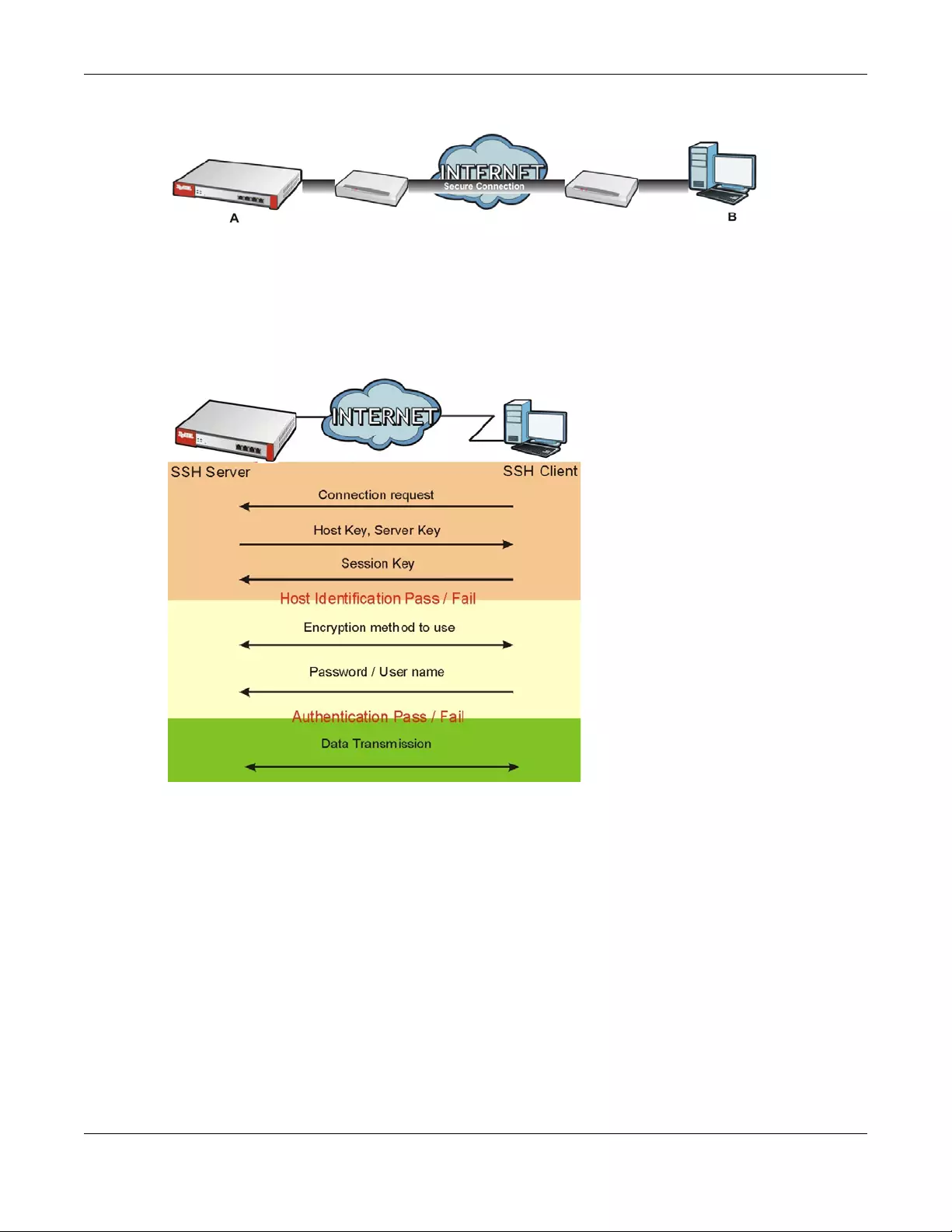
Chapter 36 System
ZyWALL/USG Series User’s Guide
691
Figure 481 SSH Communication Over the WAN Example
36.8.1 How SSH Works
The following figure is an example of how a secure connection is established between two remote
hosts using SSH v1.
Figure 482 How SSH v1 Works Example
1Host Identification
The SSH client sends a connection request to the SSH server. The server identifies itself with a host
key. The client encrypts a randomly generated session key with the host key and server key and
sends the result back to the server.
The client automatically saves any new server public keys. In subsequent connections, the server
public key is checked against the saved version on the client computer.
2Encryption Method
Once the identification is verified, both the client and server must agree on the type of encryption
method to use.
3Authentication and Data Transmission
After the identification is verified and data encryption activated, a secure tunnel is established
between the client and the server. The client then sends its authentication information (user name
and password) to the server to log in to the server.
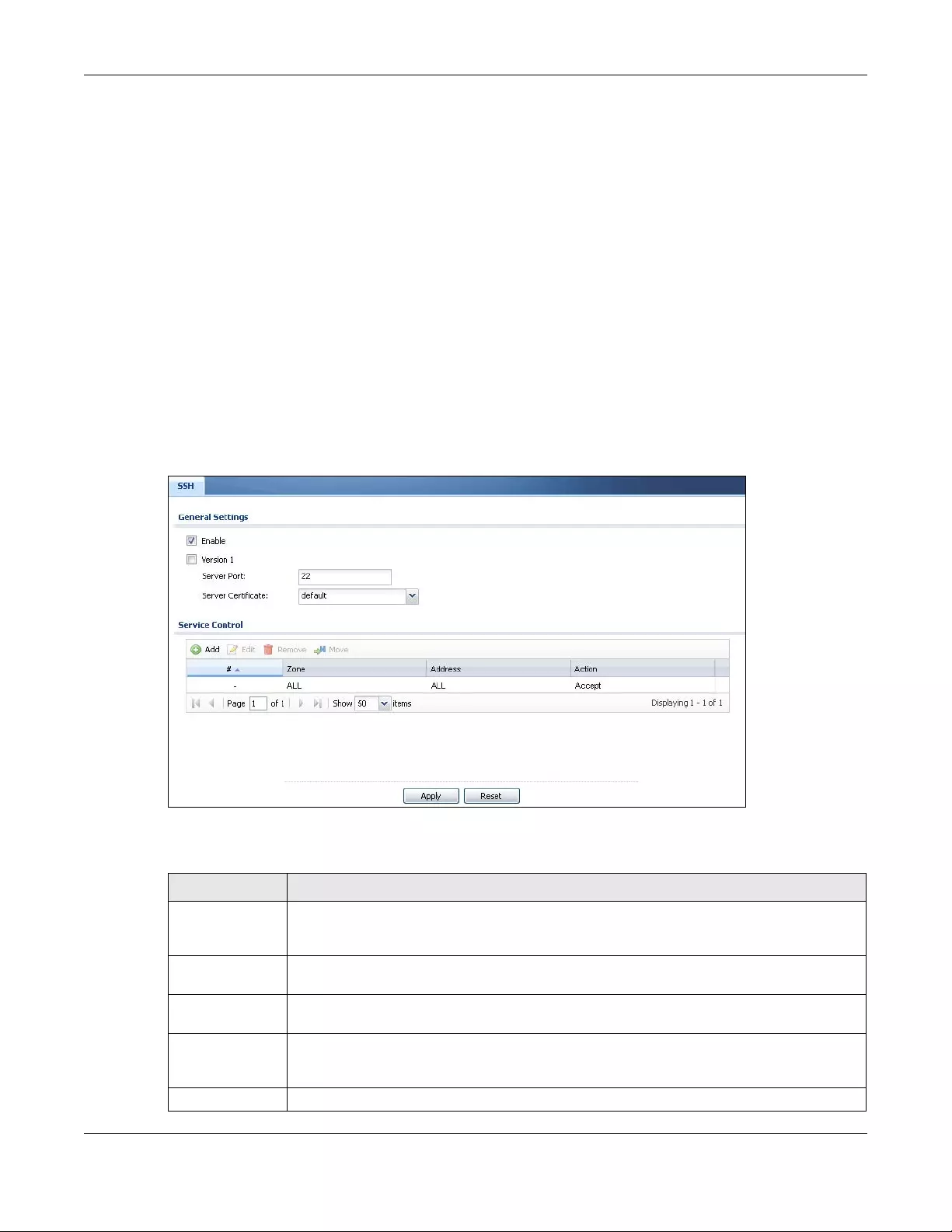
Chapter 36 System
ZyWALL/USG Series User’s Guide
692
36.8.2 SSH Implementation on the ZyWALL/USG
Your ZyWALL/USG supports SSH versions 1 and 2 using RSA authentication and four encryption
methods (AES, 3DES, Archfour, and Blowfish). The SSH server is implemented on the ZyWALL/USG
for management using port 22 (by default).
36.8.3 Requirements for Using SSH
You must install an SSH client program on a client computer (Windows or Linux operating system)
that is used to connect to the ZyWALL/USG over SSH.
36.8.4 Configuring SSH
Click Configuration > System > SSH to change your ZyWALL/USG’s Secure Shell settings. Use
this screen to specify from which zones SSH can be used to manage the ZyWALL/USG. You can also
specify from which IP addresses the access can come.
Figure 483 Configuration > System > SSH
The following table describes the labels in this screen.
Table 310 Configuration > System > SSH
LABEL DESCRIPTION
Enable Select the check box to allow or disallow the computer with the IP address that matches
the IP address(es) in the Service Control table to access the ZyWALL/USG CLI using this
service.
Version 1 Select the check box to have the ZyWALL/USG use both SSH version 1 and version 2
protocols. If you clear the check box, the ZyWALL/USG uses only SSH version 2 protocol.
Server Port You may change the server port number for a service if needed, however you must use the
same port number in order to use that service for remote management.
Server
Certificate
Select the certificate whose corresponding private key is to be used to identify the
ZyWALL/USG for SSH connections. You must have certificates already configured in the My
Certificates screen.
Service Control This specifies from which computers you can access which ZyWALL/USG zones.
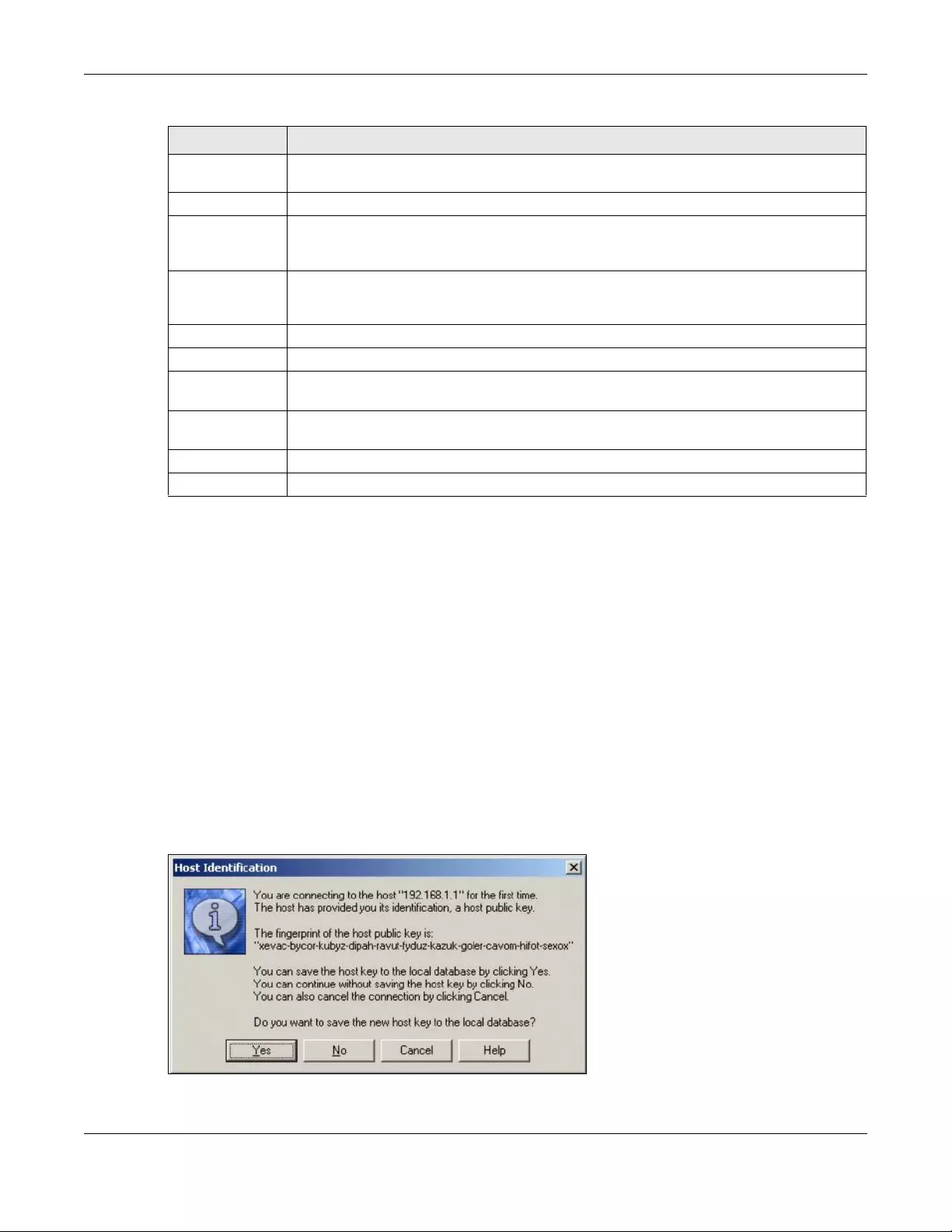
Chapter 36 System
ZyWALL/USG Series User’s Guide
693
36.8.5 Secure Telnet Using SSH Examples
This section shows two examples using a command interface and a graphical interface SSH client
program to remotely access the ZyWALL/USG. The configuration and connection steps are similar
for most SSH client programs. Refer to your SSH client program user’s guide.
36.8.5.1 Example 1: Microsoft Windows
This section describes how to access the ZyWALL/USG using the Secure Shell Client program.
1Launch the SSH client and specify the connection information (IP address, port number) for the
ZyWALL/USG.
2Configure the SSH client to accept connection using SSH version 1.
3A window displays prompting you to store the host key in you computer. Click Yes to continue.
Figure 484 SSH Example 1: Store Host Key
Enter the password to log in to the ZyWALL/USG. The CLI screen displays next.
Add Click this to create a new entry. Select an entry and click Add to create a new entry after
the selected entry. Refer to Table 308 on page 679 for details on the screen that opens.
Edit Double-click an entry or select it and click Edit to be able to modify the entry’s settings.
Remove To remove an entry, select it and click Remove. The ZyWALL/USG confirms you want to
remove it before doing so. Note that subsequent entries move up by one when you take
this action.
Move To change an entry’s position in the numbered list, select the method and click Move to
display a field to type a number for where you want to put it and press [ENTER] to move
the rule to the number that you typed.
#This the index number of the service control rule.
Zone This is the zone on the ZyWALL/USG the user is allowed or denied to access.
Address This is the object name of the IP address(es) with which the computer is allowed or denied
to access.
Action This displays whether the computer with the IP address specified above can access the
ZyWALL/USG zone(s) configured in the Zone field (Accept) or not (Deny).
Apply Click Apply to save your changes back to the ZyWALL/USG.
Reset Click Reset to return the screen to its last-saved settings.
Table 310 Configuration > System > SSH (continued)
LABEL DESCRIPTION

Chapter 36 System
ZyWALL/USG Series User’s Guide
694
36.8.5.2 Example 2: Linux
This section describes how to access the ZyWALL/USG using the OpenSSH client program that
comes with most Linux distributions.
1Test whether the SSH service is available on the ZyWALL/USG.
Enter “telnet 192.168.1.1 22” at a terminal prompt and press [ENTER]. The computer
attempts to connect to port 22 on the ZyWALL/USG (using the default IP address of
192.168.1.1).
A message displays indicating the SSH protocol version supported by the ZyWALL/USG.
Figure 485 SSH Example 2: Test
2Enter “ssh –1 192.168.1.1”. This command forces your computer to connect to the ZyWALL/USG
using SSH version 1. If this is the first time you are connecting to the ZyWALL/USG using SSH, a
message displays prompting you to save the host information of the ZyWALL/USG. Type “yes” and
press [ENTER].
Then enter the password to log in to the ZyWALL/USG.
Figure 486 SSH Example 2: Log in
3The CLI screen displays next.
36.9 Telnet
You can use Telnet to access the ZyWALL/USG’s command line interface. Specify which zones allow
Telnet access and from which IP address the access can come.
36.9.1 Configuring Telnet
Click Configuration > System > TELNET to configure your ZyWALL/USG for remote Telnet
access. Use this screen to specify from which zones Telnet can be used to manage the ZyWALL/
USG. You can also specify from which IP addresses the access can come.
$ telnet 192.168.1.1 22
Trying 192.168.1.1...
Connected to 192.168.1.1.
Escape character is '^]'.
SSH-1.5-1.0.0
$ ssh –1 192.168.1.1
The authenticity of host '192.168.1.1 (192.168.1.1)' can't be established.
RSA1 key fingerprint is 21:6c:07:25:7e:f4:75:80:ec:af:bd:d4:3d:80:53:d1.
Are you sure you want to continue connecting (yes/no)? yes
Warning: Permanently added '192.168.1.1' (RSA1) to the list of known hosts.
Administrator@192.168.1.1's password:

Chapter 36 System
ZyWALL/USG Series User’s Guide
695
Figure 487 Configuration > System > TELNET
The following table describes the labels in this screen.
Ta ble 311 Configuration > System > TELNET
LABEL DESCRIPTION
Enable Select the check box to allow or disallow the computer with the IP address that matches
the IP address(es) in the Service Control table to access the ZyWALL/USG CLI using this
service.
Server Port You may change the server port number for a service if needed, however you must use the
same port number in order to use that service for remote management.
Service Control This specifies from which computers you can access which ZyWALL/USG zones.
Add Click this to create a new entry. Select an entry and click Add to create a new entry after
the selected entry. Refer to Table 308 on page 679 for details on the screen that opens.
Edit Double-click an entry or select it and click Edit to be able to modify the entry’s settings.
Remove To remove an entry, select it and click Remove. The ZyWALL/USG confirms you want to
remove it before doing so. Note that subsequent entries move up by one when you take
this action.
Move To change an entry’s position in the numbered list, select the method and click Move to
display a field to type a number for where you want to put it and press [ENTER] to move
the rule to the number that you typed.
#This the index number of the service control rule.
The entry with a hyphen (-) instead of a number is the ZyWALL/USG’s (non-configurable)
default policy. The ZyWALL/USG applies this to traffic that does not match any other
configured rule. It is not an editable rule. To apply other behavior, configure a rule that
traffic will match so the ZyWALL/USG will not have to use the default policy.
Zone This is the zone on the ZyWALL/USG the user is allowed or denied to access.
Address This is the object name of the IP address(es) with which the computer is allowed or denied
to access.
Action This displays whether the computer with the IP address specified above can access the
ZyWALL/USG zone(s) configured in the Zone field (Accept) or not (Deny).
Apply Click Apply to save your changes back to the ZyWALL/USG.
Reset Click Reset to return the screen to its last-saved settings.
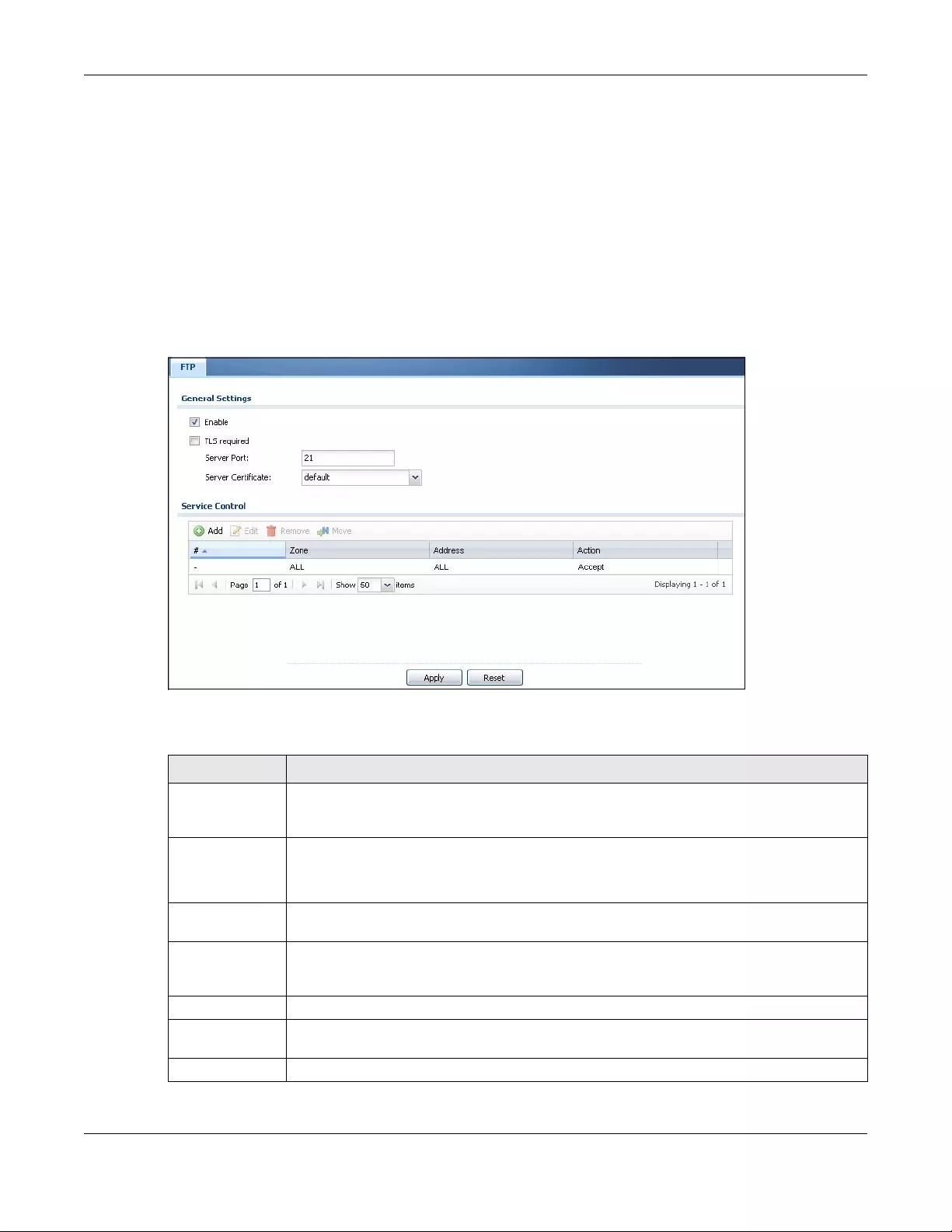
Chapter 36 System
ZyWALL/USG Series User’s Guide
696
36.10 FTP
You can upload and download the ZyWALL/USG’s firmware and configuration files using FTP. To use
this feature, your computer must have an FTP client.
36.10.1 Configuring FTP
To change your ZyWALL/USG’s FTP settings, click Configuration > System > FTP tab. The screen
appears as shown. Use this screen to specify from which zones FTP can be used to access the
ZyWALL/USG. You can also specify from which IP addresses the access can come.
Figure 488 Configuration > System > FTP
The following table describes the labels in this screen.
Table 312 Configuration > System > FTP
LABEL DESCRIPTION
Enable Select the check box to allow or disallow the computer with the IP address that matches
the IP address(es) in the Service Co ntrol table to access the ZyWALL/USG using this
service.
TLS required Select the check box to use FTP over TLS (Transport Layer Security) to encrypt
communication.
This implements TLS as a security mechanism to secure FTP clients and/or servers.
Server Port You may change the server port number for a service if needed, however you must use the
same port number in order to use that service for remote management.
Server
Certificate
Select the certificate whose corresponding private key is to be used to identify the
ZyWALL/USG for FTP connections. You must have certificates already configured in the My
Certificates screen.
Service Control This specifies from which computers you can access which ZyWALL/USG zones.
Add Click this to create a new entry. Select an entry and click Add to create a new entry after
the selected entry. Refer to Table 308 on page 679 for details on the screen that opens.
Edit Double-click an entry or select it and click Edit to be able to modify the entry’s settings.
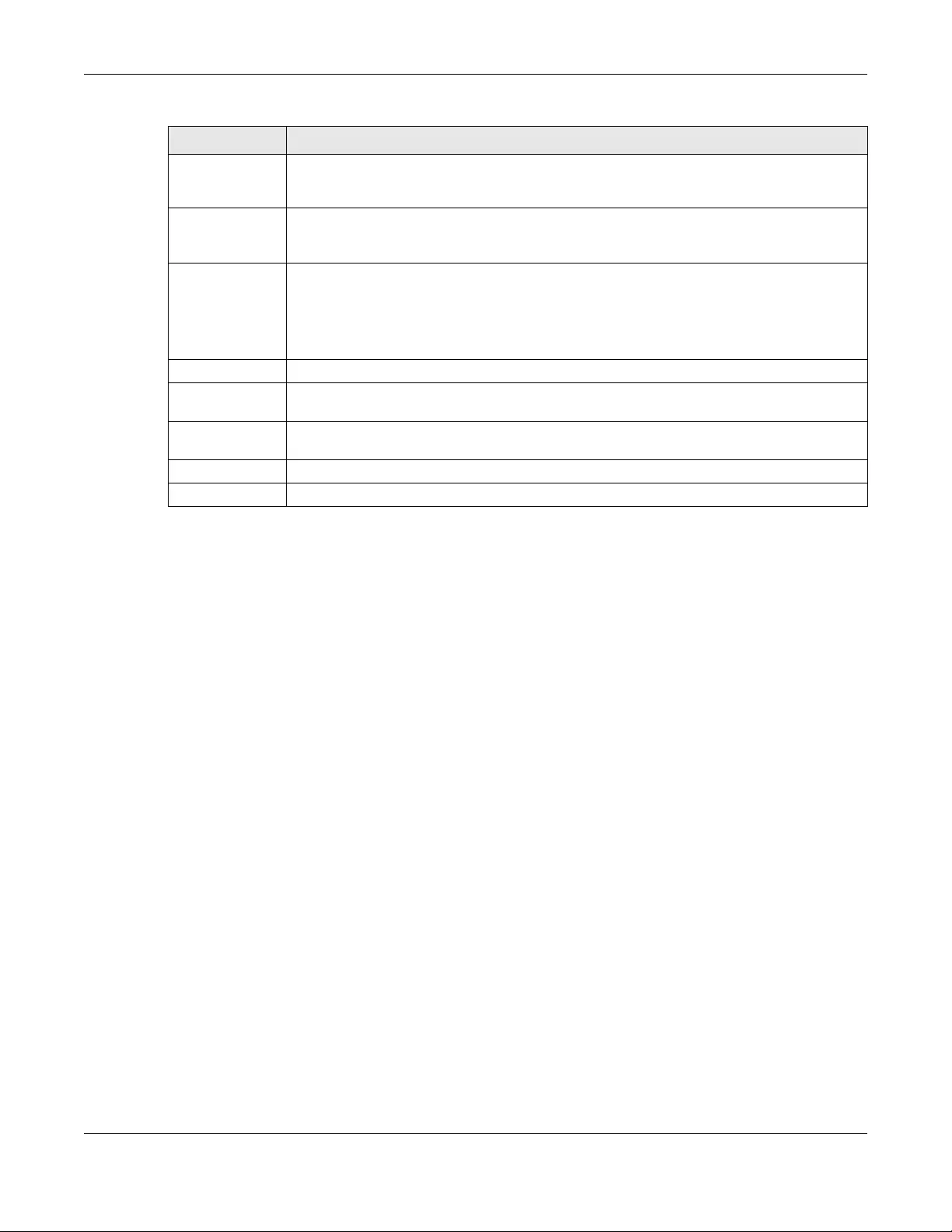
Chapter 36 System
ZyWALL/USG Series User’s Guide
697
36.11 SNMP
Simple Network Management Protocol is a protocol used for exchanging management information
between network devices. Your ZyWALL/USG supports SNMP agent functionality, which allows a
manager station to manage and monitor the ZyWALL/USG through the network. The ZyWALL/USG
supports SNMP version one (SNMPv1), version two (SNMPv2c) and version 3 (SNMPv3). The next
figure illustrates an SNMP management operation.
Remove To remove an entry, select it and click Remove. The ZyWALL/USG confirms you want to
remove it before doing so. Note that subsequent entries move up by one when you take
this action.
Move To change an entry’s position in the numbered list, select the method and click Move to
display a field to type a number for where you want to put it and press [ENTER] to move
the rule to the number that you typed.
#This the index number of the service control rule.
The entry with a hyphen (-) instead of a number is the ZyWALL/USG’s (non-configurable)
default policy. The ZyWALL/USG applies this to traffic that does not match any other
configured rule. It is not an editable rule. To apply other behavior, configure a rule that
traffic will match so the ZyWALL/USG will not have to use the default policy.
Zone This is the zone on the ZyWALL/USG the user is allowed or denied to access.
Address This is the object name of the IP address(es) with which the computer is allowed or denied
to access.
Action This displays whether the computer with the IP address specified above can access the
ZyWALL/USG zone(s) configured in the Zone field (Accept) or not (Deny).
Apply Click Apply to save your changes back to the ZyWALL/USG.
Reset Click Reset to return the screen to its last-saved settings.
Table 312 Configuration > System > FTP (continued)
LABEL DESCRIPTION
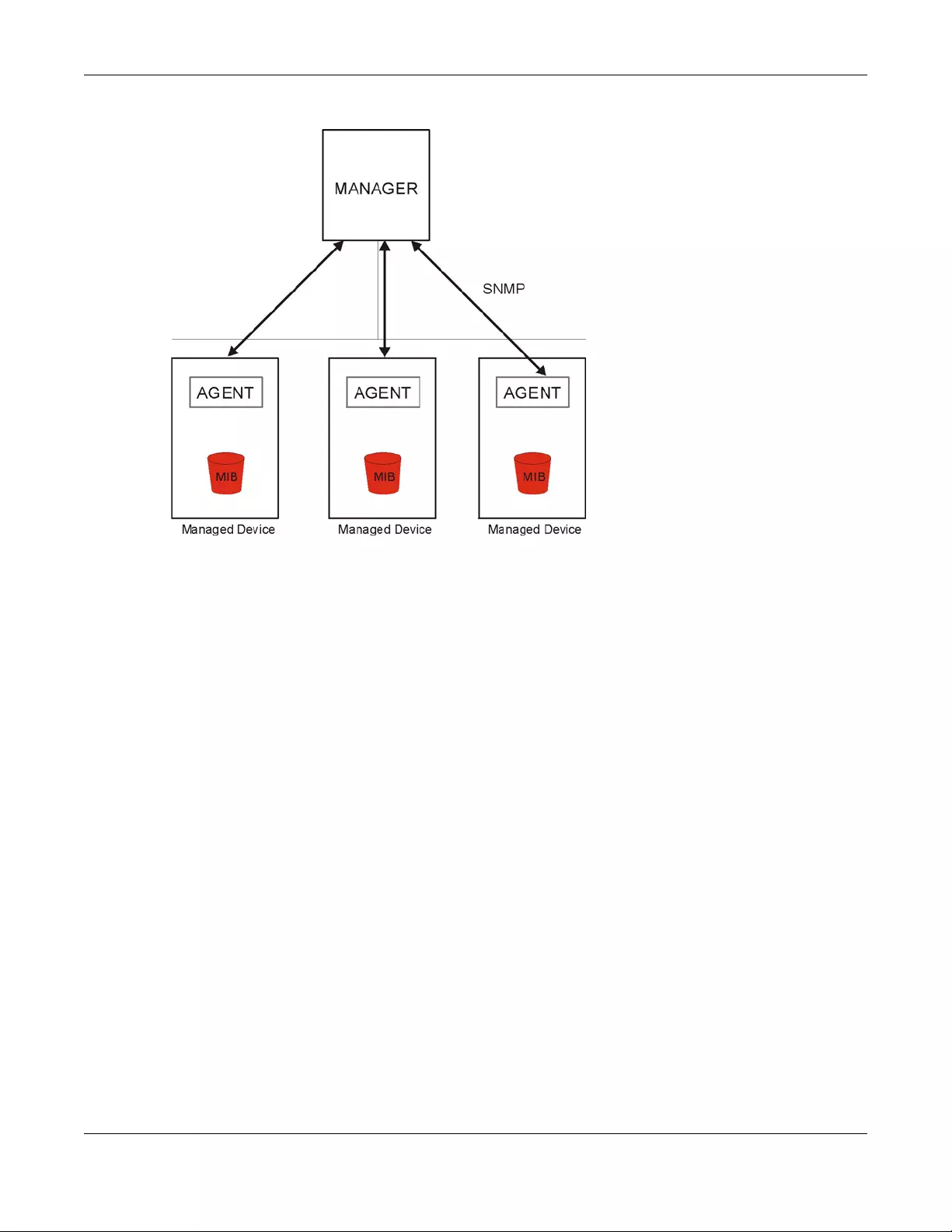
Chapter 36 System
ZyWALL/USG Series User’s Guide
698
Figure 489 SNMP Management Model
An SNMP managed network consists of two main types of component: agents and a manager.
An agent is a management software module that resides in a managed device (the ZyWALL/USG).
An agent translates the local management information from the managed device into a form
compatible with SNMP. The manager is the console through which network administrators perform
network management functions. It executes applications that control and monitor managed
devices.
The managed devices contain object variables/managed objects that define each piece of
information to be collected about a device. Examples of variables include such as number of
packets received, node port status etc. A Management Information Base (MIB) is a collection of
managed objects. SNMP allows a manager and agents to communicate for the purpose of accessing
these objects.
SNMP itself is a simple request/response protocol based on the manager/agent model. The
manager issues a request and the agent returns responses using the following protocol operations:
• Get - Allows the manager to retrieve an object variable from the agent.
• GetNext - Allows the manager to retrieve the next object variable from a table or list within an
agent. In SNMPv1, when a manager wants to retrieve all elements of a table from an agent, it
initiates a Get operation, followed by a series of GetNext operations.
• Set - Allows the manager to set values for object variables within an agent.
• Trap - Used by the agent to inform the manager of some events.
36.11.1 SNMP v3 and Security
SNMP v3 enhances security for SNMP management using authentication and encryption. SNMP
managers can be required to authenticate with agents before conducting SNMP management
sessions.
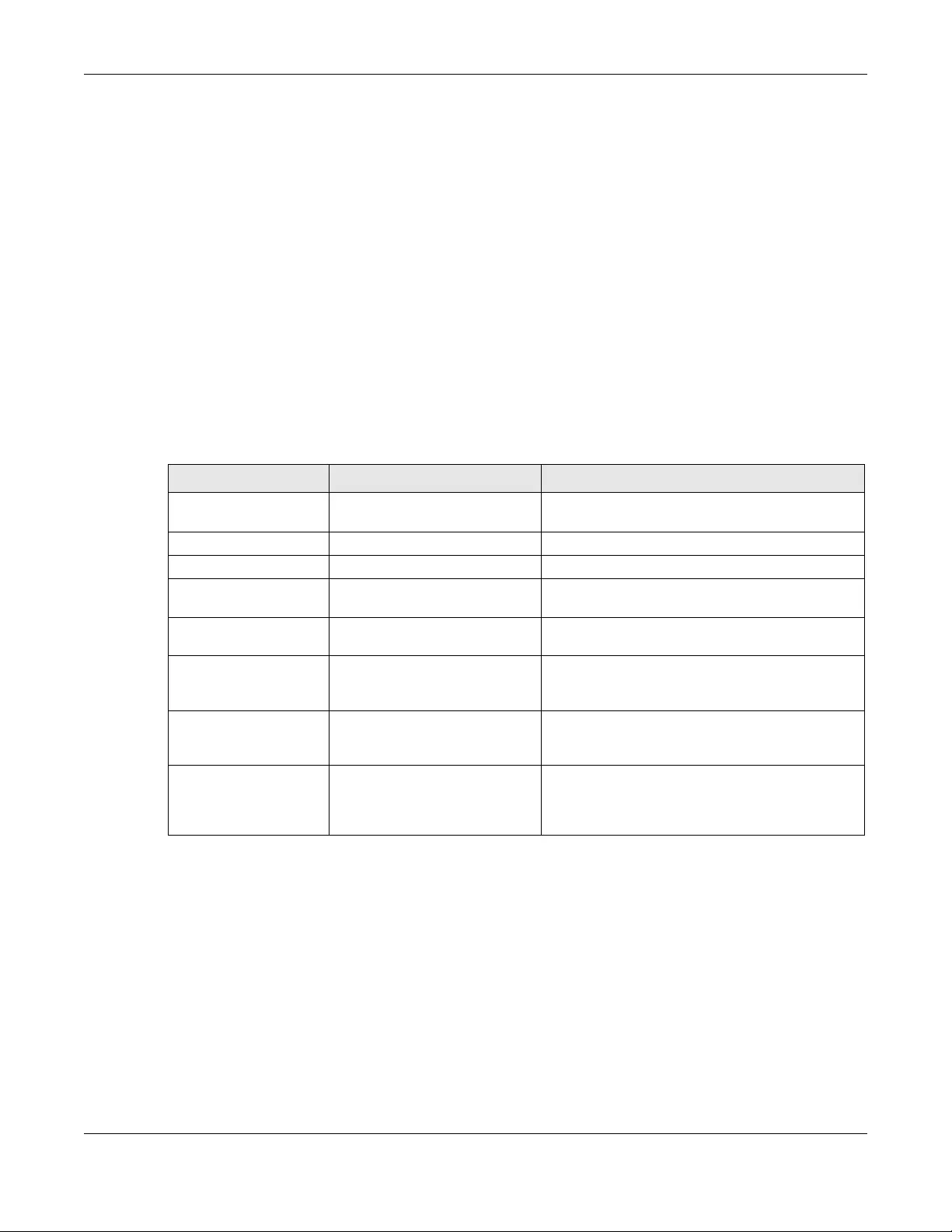
Chapter 36 System
ZyWALL/USG Series User’s Guide
699
Security can be further enhanced by encrypting the SNMP messages sent from the managers.
Encryption protects the contents of the SNMP messages. When the contents of the SNMP messages
are encrypted, only the intended recipients can read them.
36.11.2 Supported MIBs
The ZyWALL/USG supports MIB II that is defined in RFC-1213 and RFC-1215. The ZyWALL/USG
also supports private MIBs (zywall.mib and zyxel-zywall-ZLD-Common.mib) to collect information
about CPU and memory usage and VPN total throughput. The focus of the MIBs is to let
administrators collect statistical data and monitor status and performance. You can download the
ZyWALL/USG’s MIBs from www.zyxel.com.
36.11.3 SNMP Traps
The ZyWALL/USG will send traps to the SNMP manager when any one of the following events
occurs.
36.11.4 Configuring SNMP
To change your ZyWALL/USG’s SNMP settings, click Configuration > System > SNMP tab. The
screen appears as shown. Use this screen to configure your SNMP settings, including from which
zones SNMP can be used to access the ZyWALL/USG. You can also specify from which IP addresses
the access can come.
Table 313 SNMP Traps
OBJECT LABEL OBJECT ID DESCRIPTION
Cold Start 1.3.6.1.6.3.1.1.5.1 This trap is sent when the ZyWALL/USG is turned
on or an agent restarts.
linkDown 1.3.6.1.6.3.1.1.5.3 This trap is sent when the Ethernet link is down.
linkUp 1.3.6.1.6.3.1.1.5.4 This trap is sent when the Ethernet link is up.
authenticationFailure 1.3.6.1.6.3.1.1.5.5 This trap is sent when an SNMP request comes
from non-authenticated hosts.
vpnTunnelDisconnected 1.3.6.1.4.1.890.1.6.22.2.3 This trap is sent when an IPSec VPN tunnel is
disconnected.
vpnTunnelName 1.3.6.1.4.1.890.1.6.22.2.2.1.1 This trap is sent along with the
vpnTunnelDisconnected trap. This trap carries the
disconnected tunnel’s IPSec SA name.
vpnIKEName 1.3.6.1.4.1.890.1.6.22.2.2.1.2 This trap is sent along with the
vpnTunnelDisconnected trap. This trap carries the
disconnected tunnel’s IKE SA name.
vpnTunnelSPI 1.3.6.1.4.1.890.1.6.22.2.2.1.3 This trap is sent along with the
vpnTunnelDisconnected trap. This trap carries the
security parameter index (SPI) of the
disconnected VPN tunnel.
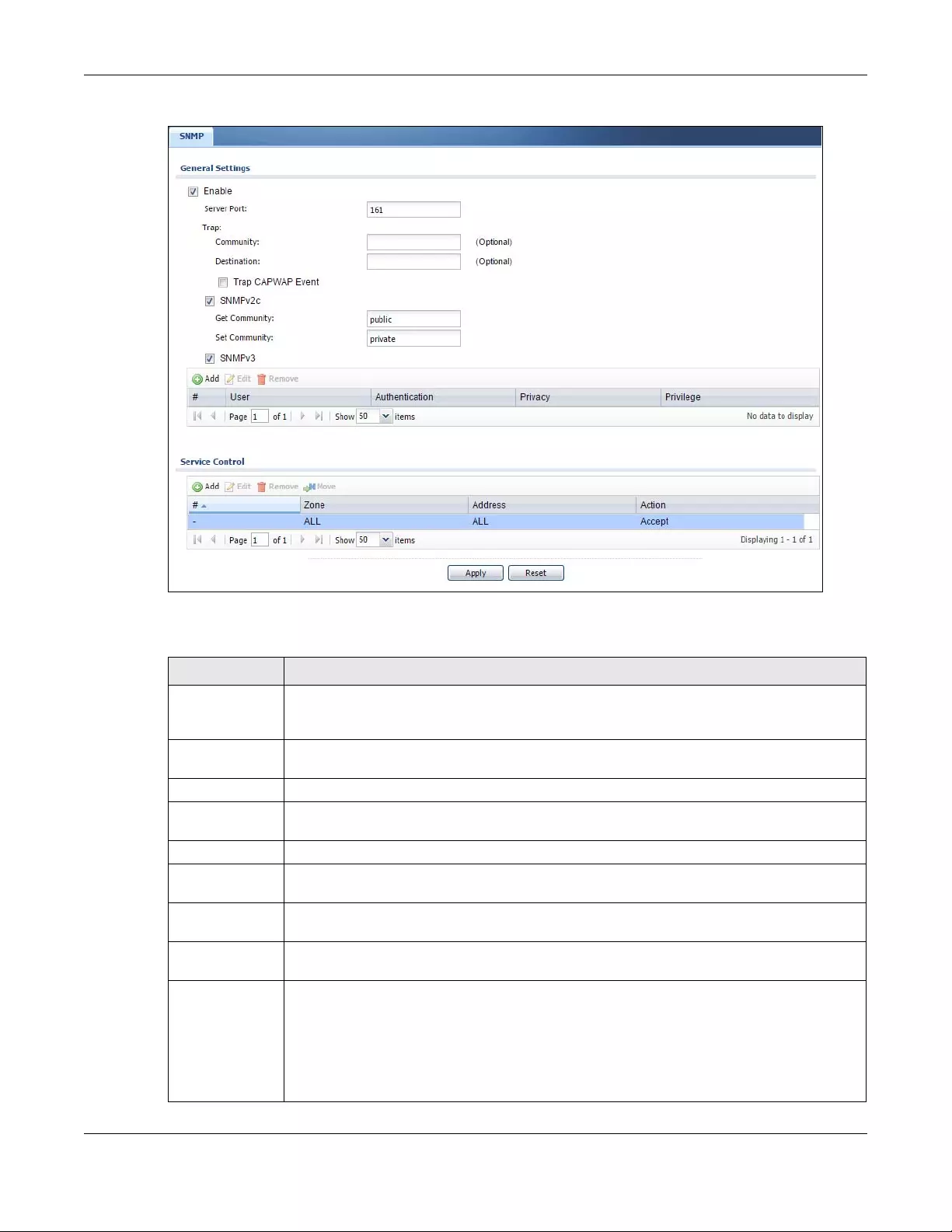
Chapter 36 System
ZyWALL/USG Series User’s Guide
700
Figure 490 Configuration > System > SNMP
The following table describes the labels in this screen.
Table 314 Configuration > System > SNMP
LABEL DESCRIPTION
Enable Select the check box to allow or disallow the computer with the IP address that matches
the IP address(es) in the Service Control table to access the ZyWALL/USG using this
service.
Server Port You may change the server port number for a service if needed, however you must use the
same port number in order to use that service for remote management.
Trap
Community Type the trap community, which is the password sent with each trap to the SNMP manager.
The default is public and allows all requests.
Destination Type the IP address of the station to send your SNMP traps to.
SNMPv2c Select the SNMP version for the ZyWALL/USG. The SNMP version on the ZyWALL/USG must
match the version on the SNMP manager.
Get
Community Enter the Get Community, which is the password for the incoming Get and GetNext
requests from the management station. The default is public and allows all requests.
Set
Community Enter the Set community, which is the password for incoming Set requests from the
management station. The default is private and allows all requests.
SNMPv3 Select the SNMP version for the ZyWALL/USG. The SNMP version on the ZyWALL/USG must
match the version on the SNMP manager. SNMPv3 (RFCs 3413 to 3415) provides secure
access by authenticating and encrypting data packets over the network. The ZyWALL/USG
uses your login password as the SNMPv3 authentication and encryption passphrase.
Note: Your login password must consist of at least 8 printable characters for SNMPv3. An
error message will display if your login password has fewer characters.
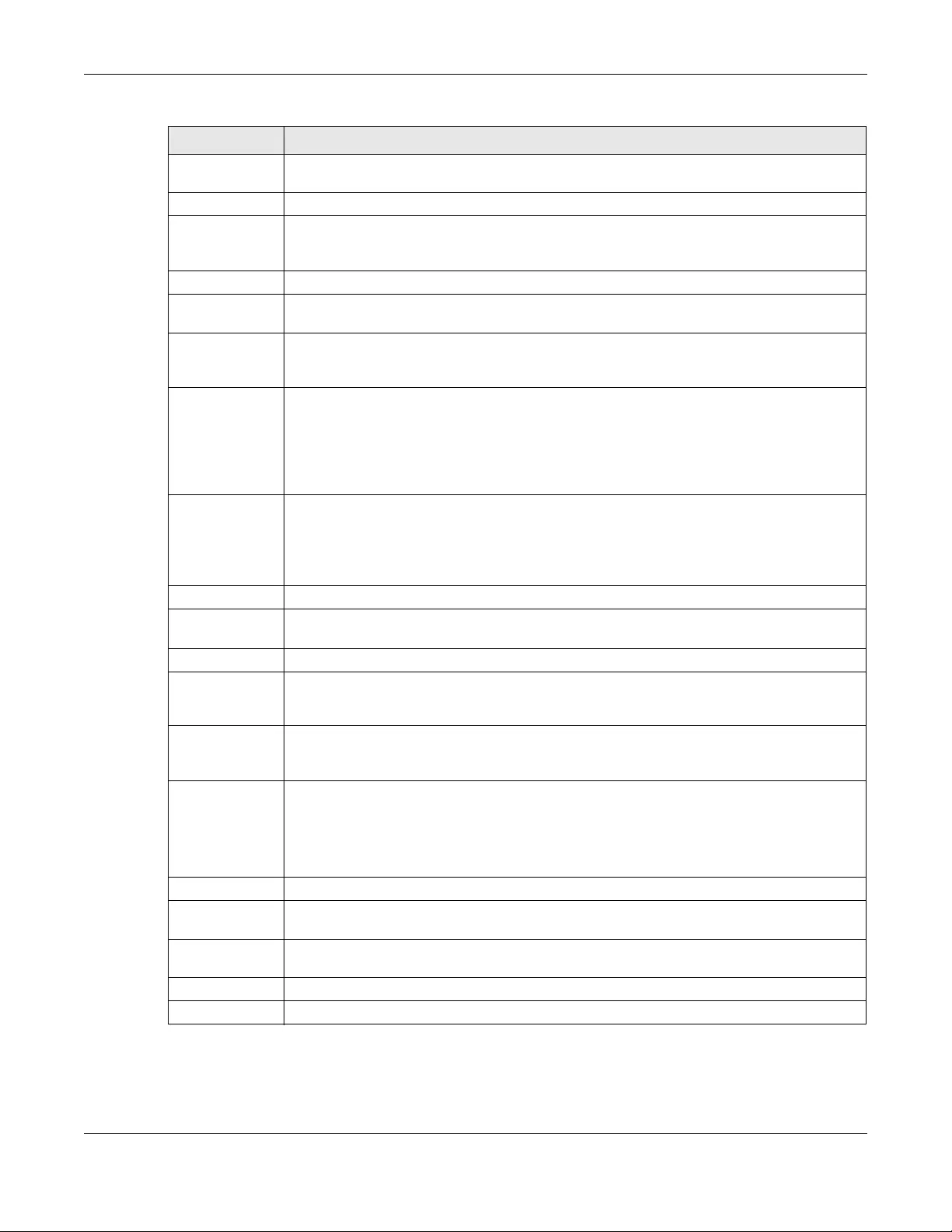
Chapter 36 System
ZyWALL/USG Series User’s Guide
701
Add Click this to create a new entry. Select an entry and click Add to create a new entry after
the selected entry
Edit Double-click an entry or select it and click Edit to be able to modify the entry’s settings.
Remove To remove an entry, select it and click Remove. The ZyWALL/USG confirms you want to
remove it before doing so. Note that subsequent entries move up by one when you take
this action.
#This is the index number of the entry.
User This displays the name of the user object to be sent to the SNMP manager along with the
SNMP v3 trap.
Authenticati
on This displays the authentication algorithm used for this entry. MD5 (Message Digest 5) and
SHA (Secure Hash Algorithm) are hash algorithms used to authenticate SNMP data. SHA
authentication is generally considered stronger than MD5, but is slower.
Privacy This displays the encryption method for SNMP communication from this user. Methods
available are:
•DES - Data Encryption Standard is a widely used (but breakable) method of data
encryption. It applies a 56-bit key to each 64-bit block of data.
•AES - Advanced Encryption Standard is another method for data encryption that also
uses a secret key. AES applies a 128-bit key to 128-bit blocks of data.
Privlege This displays the access rights to MIBs.
•Read-Write - The associated user can create and edit the MIBs on the ZyWALL/USG,
except the user account.
•Read-Only - The associated user can only collect information from the ZyWALL/USG
MIBs.
Service Control This specifies from which computers you can access which ZyWALL/USG zones.
Add Click this to create a new entry. Select an entry and click Add to create a new entry after
the selected entry. Refer to Table 308 on page 679 for details on the screen that opens.
Edit Double-click an entry or select it and click Edit to be able to modify the entry’s settings.
Remove To remove an entry, select it and click Remove. The ZyWALL/USG confirms you want to
remove it before doing so. Note that subsequent entries move up by one when you take
this action.
Move To change an entry’s position in the numbered list, select the method and click Move to
display a field to type a number for where you want to put it and press [ENTER] to move
the rule to the number that you typed.
#This the index number of the service control rule.
The entry with a hyphen (-) instead of a number is the ZyWALL/USG’s (non-configurable)
default policy. The ZyWALL/USG applies this to traffic that does not match any other
configured rule. It is not an editable rule. To apply other behavior, configure a rule that
traffic will match so the ZyWALL/USG will not have to use the default policy.
Zone This is the zone on the ZyWALL/USG the user is allowed or denied to access.
Address This is the object name of the IP address(es) with which the computer is allowed or denied
to access.
Action This displays whether the computer with the IP address specified above can access the
ZyWALL/USG zone(s) configured in the Zone field (Accept) or not (Deny).
Apply Click Apply to save your changes back to the ZyWALL/USG.
Reset Click Reset to return the screen to its last-saved settings.
Table 314 Configuration > System > SNMP (continued)
LABEL DESCRIPTION
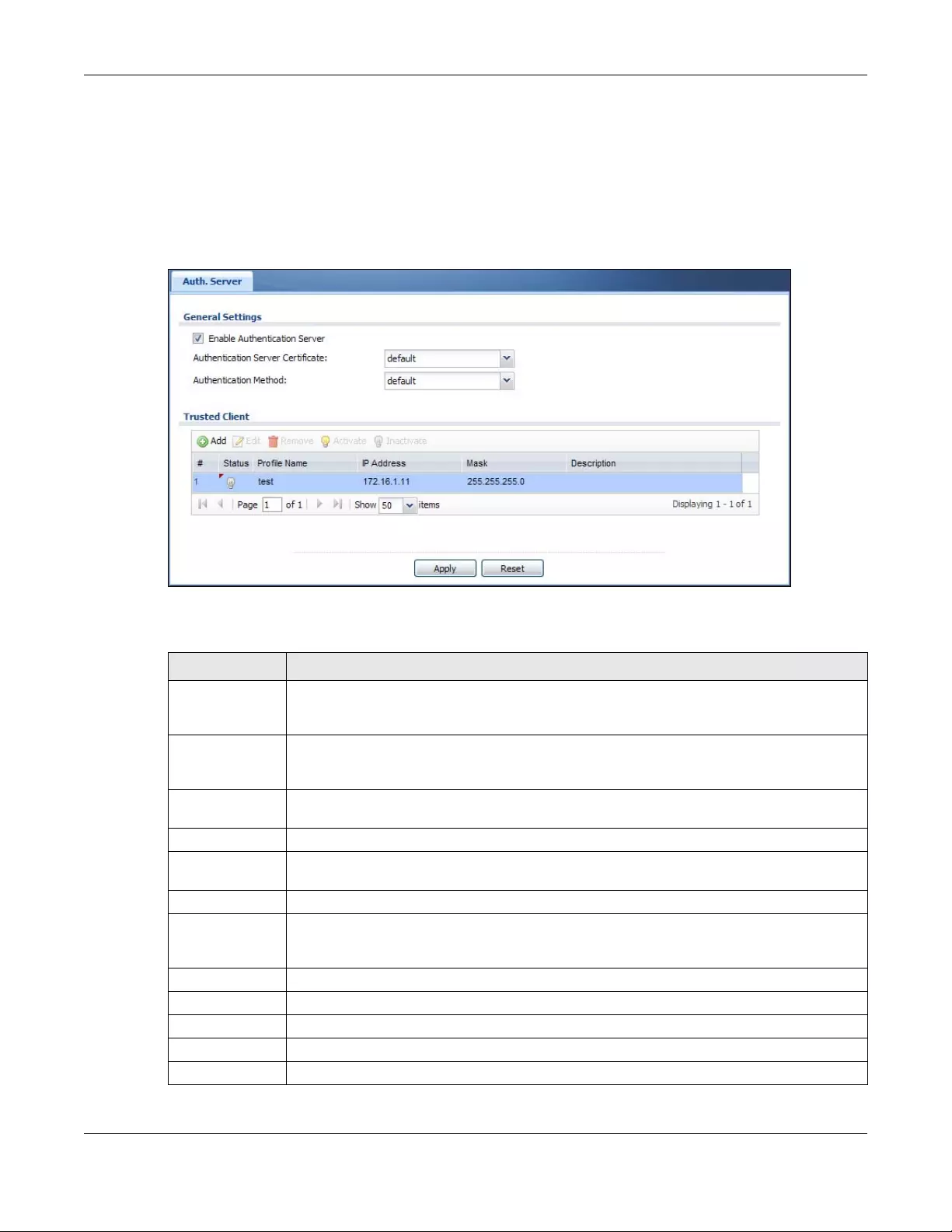
Chapter 36 System
ZyWALL/USG Series User’s Guide
702
36.12 Authentication Server
You can set the ZyWALL/USG to work as a RADIUS server to exchange messages with a RADIUS
client, such as an AP for user authentication and authorization. Click Configuration > System >
Auth. Server tab. The screen appears as shown. Use this screen to enable the authentication
server feature of the ZyWALL/USG and specify the RADIUS client’s IP address.
Figure 491 Configuration > System > Auth. Server
The following table describes the labels in this screen.
Table 315 Configuration > System > Auth. Server
LABEL DESCRIPTION
Enable
Authentication
Server
Select the check box to have the ZyWALL/USG act as a RADIUS server.
Authentication
Server
Certificate
Select the certificate whose corresponding private key is to be used to identify the
ZyWALL/USG to the RADIUS client. You must have certificates already configured in the My
Certificates screen.
Authentication
Method
Select an authentication method if you have created any in the Configuration > Object >
Auth. Method screen.
Trusted Client Use this section to configure trusted clients in the ZyWALL/USG RADIUS server database.
Add Click this to create a new entry. Select an entry and click Add to create a new entry after
the selected entry.
Edit Double-click an entry or select it and click Edit to be able to modify the entry’s settings.
Remove To remove an entry, select it and click Remove. The ZyWALL/USG confirms you want to
remove it before doing so. Note that subsequent entries move up by one when you take
this action.
Activate To turn on an entry, select it and click Activate.
Inactivate To turn off an entry, select it and click Inactivate.
#This is the index number of the entry.
Status This icon is lit when the entry is active and dimmed when the entry is inactive.
Profile Name This field indicates the name assigned to the profile.
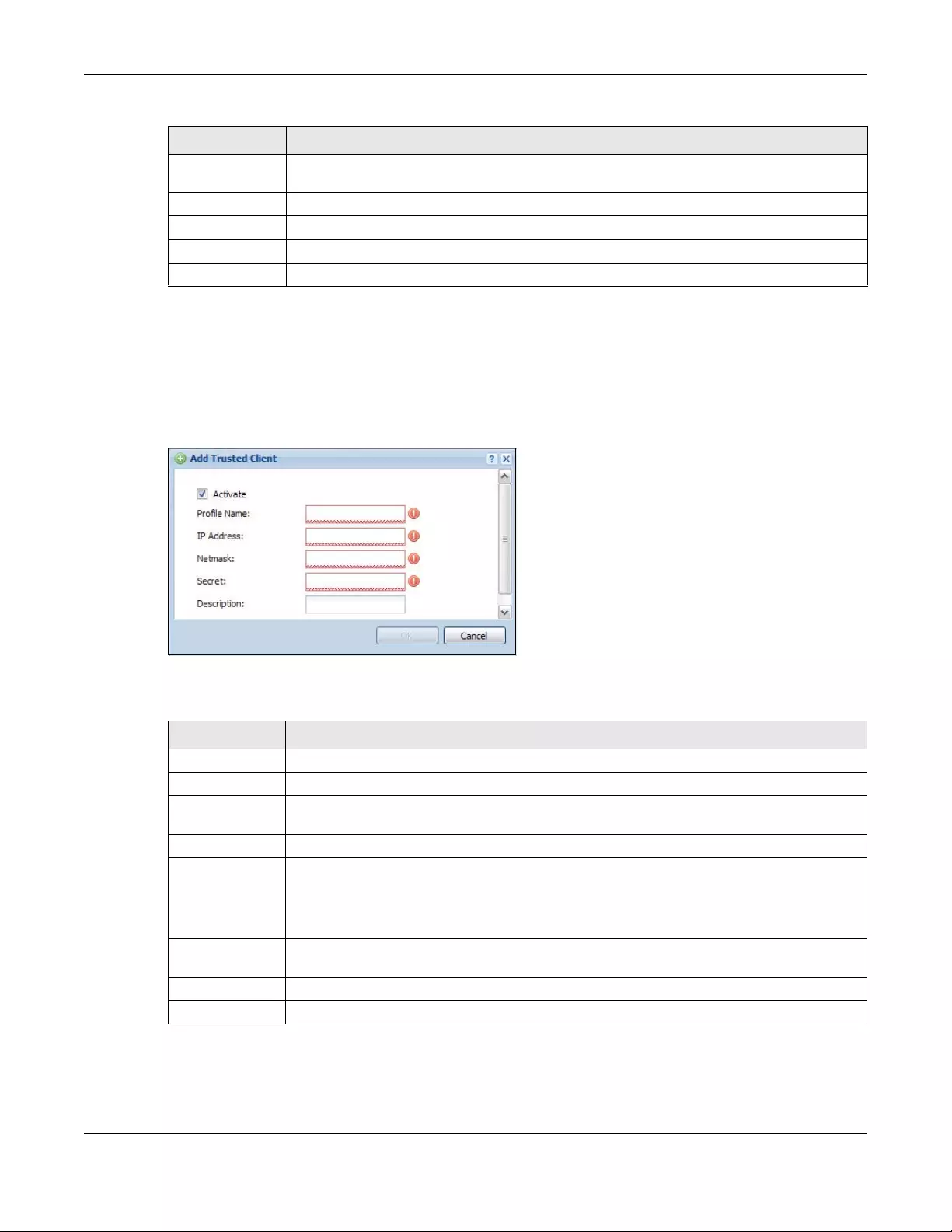
Chapter 36 System
ZyWALL/USG Series User’s Guide
703
36.12.1 Add/Edit Trusted RADIUS Client
Click Configuration > System > Auth. Server to display the Auth. Server screen. Click the Add
icon or an Edit icon to display the following screen. Use this screen to create a new entry or edit an
existing one.
Figure 492 Configuration > System > Auth. Server > Add/Edit
The following table describes the labels in this screen.
IP Address This is the IP address of the RADIUS client that is allowed to exchange messages with the
ZyWALL/USG.
Mask This is the subnet mask of the RADIUS client.
Description This is the description of the RADIUS client.
Apply Click Apply to save your changes back to the ZyWALL/USG.
Reset Click Reset to return the screen to its last-saved settings.
Table 315 Configuration > System > Auth. Server (continued)
LABEL DESCRIPTION
Table 316 Configuration > System > Auth. Server > Add/Edit
LABEL DESCRIPTION
Activate Select this check box to make this profile active.
Profile Name Enter a descriptive name (up to 31 alphanumerical characters) for identification purposes.
IP Address Enter the IP address of the RADIUS client that is allowed to exchange messages with the
ZyWALL/USG.
Netmask Enter the subnet mask of the RADIUS client.
Secret Enter a password (up to 64 alphanumeric characters) as the key to be shared between the
ZyWALL/USG and the RADIUS client.
The key is not sent over the network. This key must be the same on the external
authentication server and the ZyWALL/USG.
Description Enter the description of each server, if any. You can use up to 60 printable ASCII
characters.
OK Click OK to save the changes.
Cancel Click Cancel to discard the changes.
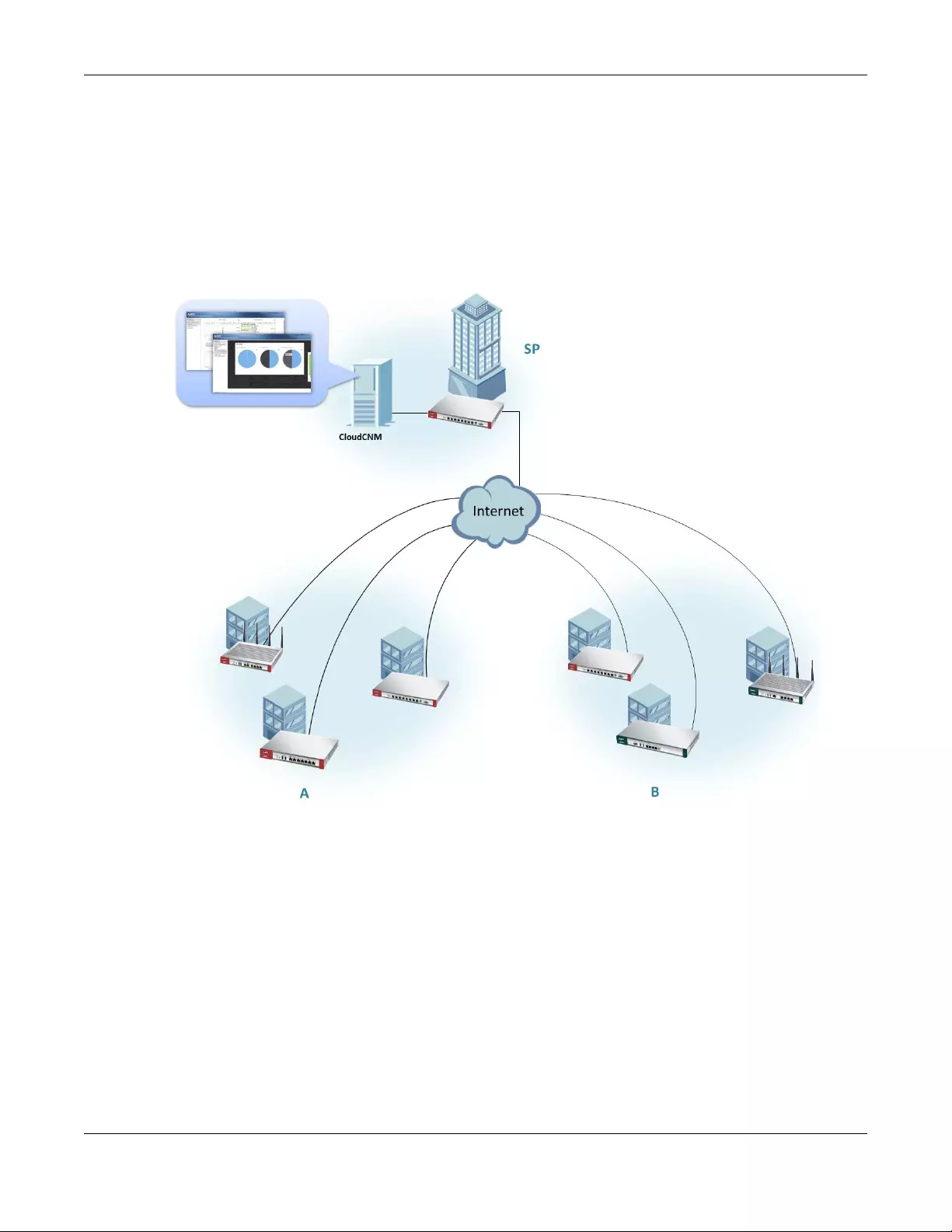
Chapter 36 System
ZyWALL/USG Series User’s Guide
704
36.13 CloudCNM Screen
CloudCNM is a cloud-based network management system that allows management and monitoring
of ZyWALL/USG/UAG security gateways with firmware that supports the TR-069 protocol.
In the following figure, SP is the management service provider, while A and B are sites with devices
being managed by SP.
Figure 493 CloudCNM Example Network Topology
CloudCNM features include:
• Batch import of managed devices at one time using one CSV file
• See an overview of all managed devices and system information in one place
• Monitor and manage devices
• Install firmware to multiple devices of the same model at one time
• Backup and restore device configuration
• View the location of managed devices on a map
• Receive notification for events and alarms, such as when a device goes down
• Graphically monitor individual devices and see related statistics
• Directly access a device for remote configuration
• Create four types of administrators with different privileges
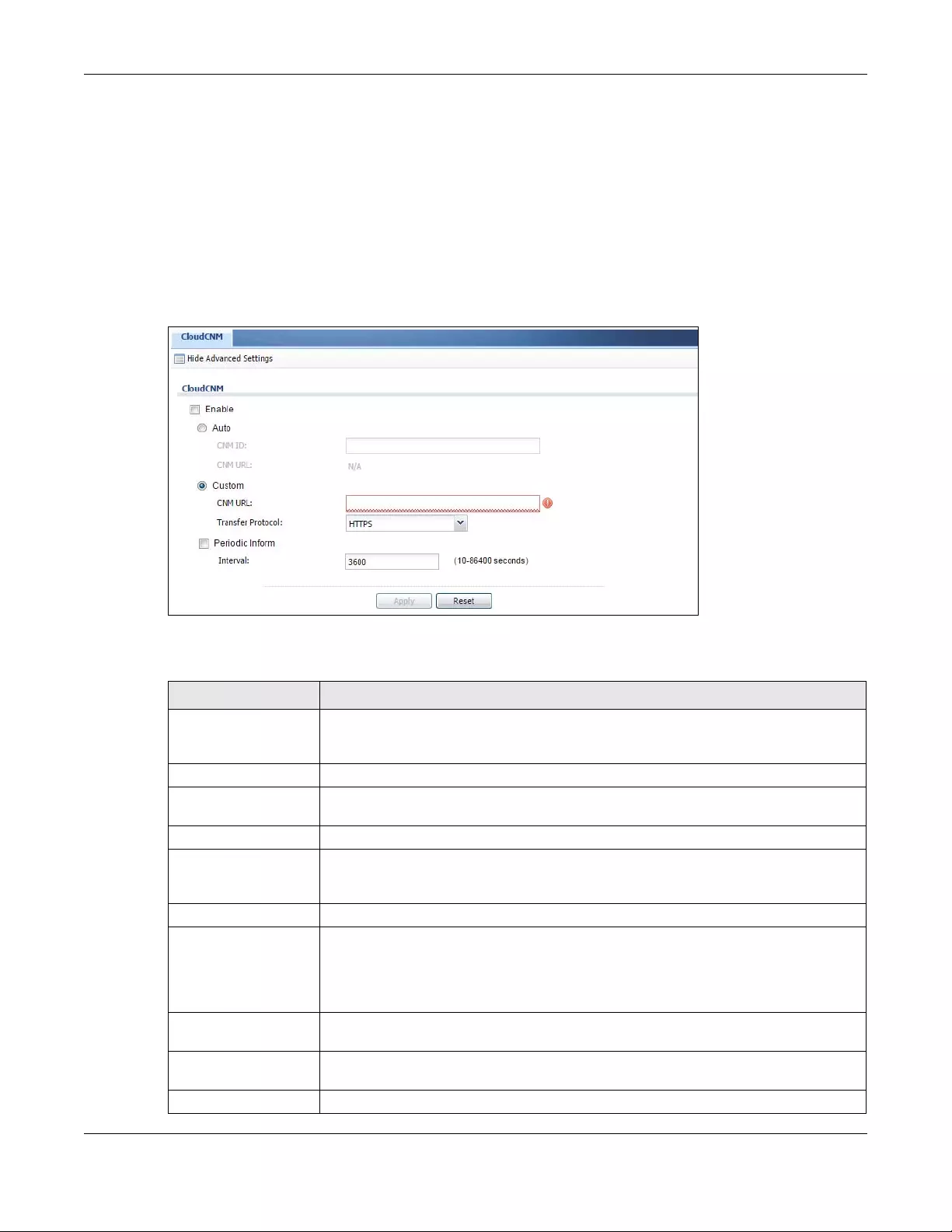
Chapter 36 System
ZyWALL/USG Series User’s Guide
705
• Perform Site-to-Site, Hub & Spoke, Fully-meshed and Remote Access VPN provisioning.
To allow CloudCNM management of your ZyWALL/USG:
• You must have a CloudCNM license with CNM ID number or a CloudCNM URL identifying the
server.
• The ZyWALL/USG must be able to communicate with the CloudCNM server.
You must configure Configuration > System > CloudCNM to allow the ZyWALL/USG to find the
CloudCNM server.
Figure 494 Configuration > System > CloudCNM
The following table describes the labels in this screen.
Table 317 Configuration > System > CloudCNM
LABEL DESCRIPTION
Show Advanced
Settings / Hide
Advanced Settings
Click this button to display a greater or lesser number of configuration fields.
Enable Select this to allow management of the ZyWALL/USG by CloudCNM.
Auto Select this if your CloudCNM server can access MyZyXEL.com and you have a CNM
ID from the CloudCNM license.
CNM ID Enter the CNM ID exactly as on the CloudCNM license.
CNM URL MyZyXEL.com associates the CNM ID with the CNM URL which identifies the server
on which CloudCNM is installed. Therefore you don’t need to enter the CNM URL when
you select Auto.
Custom Select this if your CloudCNM server cannot access MyZyXEL.com.
CNM URL Type the IPv4 IP address of the CloudCNM server followed by the TR-069 port
number (default 7547) in CNM URL. For example, if you installed CloudCNM on a
server with IP address 1.1.1.1, then enter http://1.1.1.1:7547 as the CNM URL. If
the default TR-069 port on the CloudCNM server is changed, then replace 7547 with
the new port number.
Transfer Protocol Choose the protocol for communication between the ZyWALL/USG and the CloudCNM
server: HTTP (port 80), or HTTPS (port 443).
Periodic Inform Enable this to have the ZyWALL/USG inform the CloudCNM server of its presence at
regular intervals.
Interval Type how often the ZyWALL/USG should inform CloudCNM server of its presence.
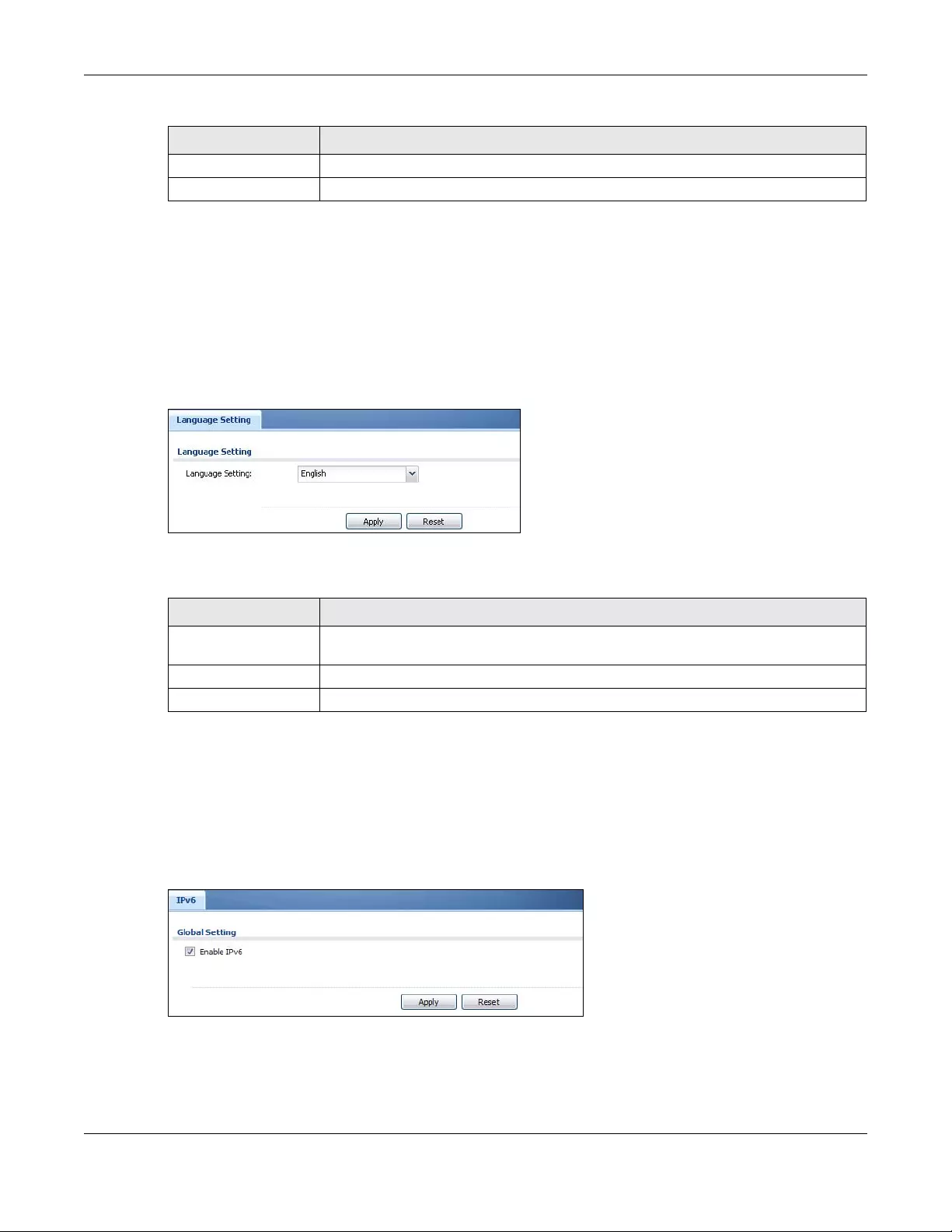
Chapter 36 System
ZyWALL/USG Series User’s Guide
706
Note: See the CloudCNM User Guide for more information on CloudCNM.
36.14 Language Screen
Click Configuration > System > Language to open the following screen. Use this screen to
select a display language for the ZyWALL/USG’s Web Configurator screens.
Figure 495 Configuration > System > Language
The following table describes the labels in this screen.
36.15 IPv6 Screen
Click Configuration > System > IPv6 to open the following screen. Use this screen to enable
IPv6 support for the ZyWALL/USG’s Web Configurator screens.
Figure 496 Configuration > System > IPv6
Apply Click Apply to save your changes back to the ZyWALL/USG.
Reset Click Reset to return the screen to its last-saved settings.
Table 317 Configuration > System > CloudCNM (continued)
LABEL DESCRIPTION
Table 318 Configuration > System > Language
LABEL DESCRIPTION
Language Setting Select a display language for the ZyWALL/USG’s Web Configurator screens. You also
need to open a new browser session to display the screens in the new language.
Apply Click Apply to save your changes back to the ZyWALL/USG.
Reset Click Reset to return the screen to its last-saved settings.
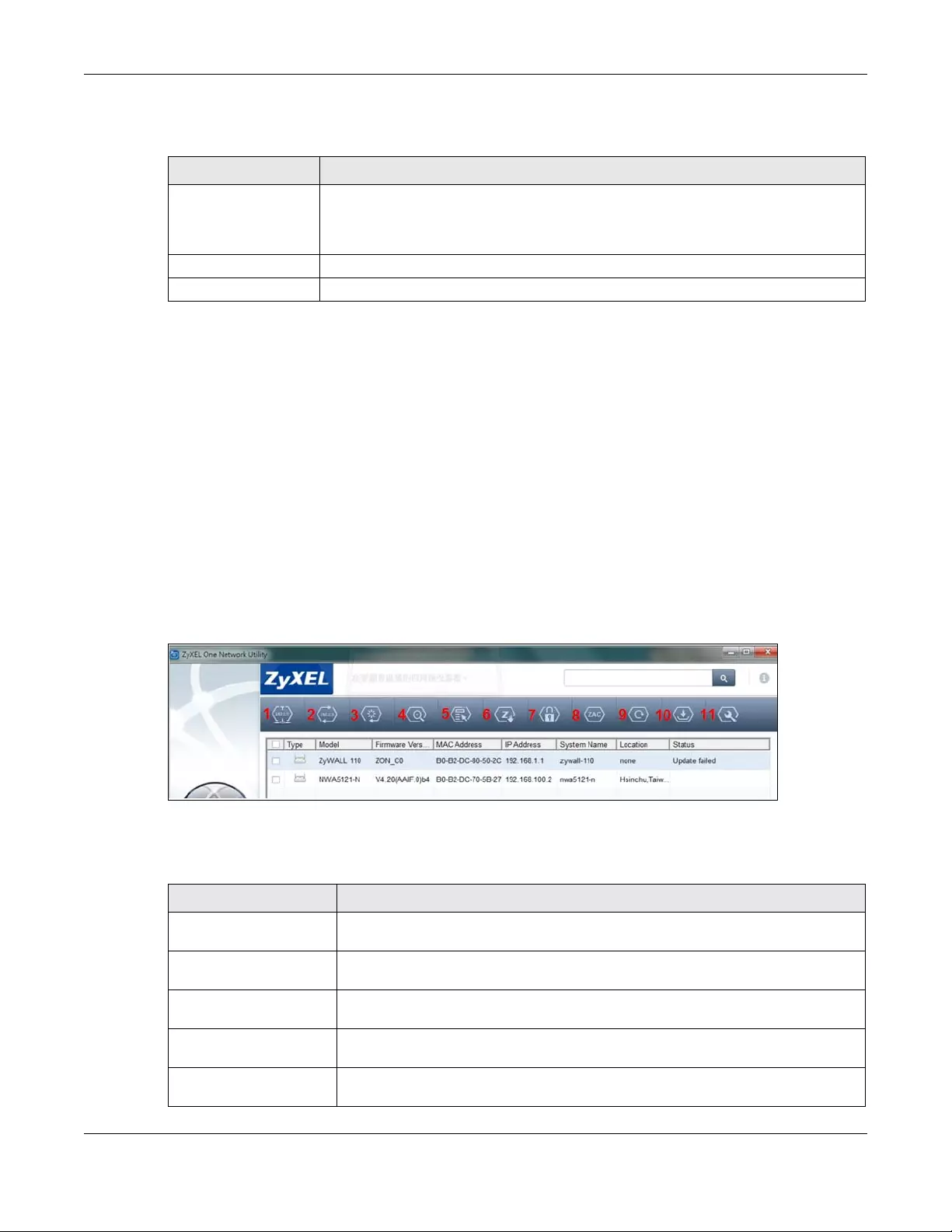
Chapter 36 System
ZyWALL/USG Series User’s Guide
707
The following table describes the labels in this screen.
36.16 ZyXEL One Network (ZON) Utility
The ZyXEL One Network (ZON) utility uses the ZyXEL Discovery Protocol (ZDP) for discovering and
configuring ZDP-aware ZyXEL devices in the same broadcast domain as the computer on which
ZON is installed.
The ZON Utility issues requests via ZDP and in response to the query, the ZyXEL device responds
with basic information including IP address, firmware version, location, system and model name.
The information is then displayed in the ZON Utility screen and you can perform tasks like basic
configuration of the devices and batch firmware upgrade in it. You can download the ZON Utility at
www.zyxel.com and install it on a computer.
The following figure shows the ZON Utility screen.
Figure 497 ZON Utility Screen
In the ZON Utility, select a device and then use the icons to perform actions. The following table
describes the icons numbered from left to right in the ZON Utility screen.
Table 319 Configuration > System > IPv6
LABEL DESCRIPTION
Enable IPv6 Select this to have the ZyWALL/USG support IPv6 and make IPv6 settings be
available on the screens that the functions support, such as the Configuration >
Network > Interface > Ethernet, VLAN, and Bridge screens. The ZyWALL/USG
discards all IPv6 packets if you clear this check box.
Apply Click Apply to save your changes back to the ZyWALL/USG.
Reset Click Reset to return the screen to its last-saved settings.
Table 320 ZON Utility Icons
ICON DESCRIPTION
1 IP configuration Change the selected device’s IP address. This is not supported by the ZyWALL/
USG at the time of writing.
2 Renew IP Update a DHCP-assigned dynamic IP address. This is not supported by the
ZyWALL/USG at the time of writing.
3 Reboot Device Use this icon to restart the selected device(s). This may be useful when
troubleshooting or upgrading new firmware.
4 Flash Locator LED Use this icon to locate the selected device by causing its Locator LED to blink. This
is not available on the ZyWALL/USG at the time of writing.
5 Web GUI Use this to access the selected device web configurator from your browser. You will
need a username and password to log in.

Chapter 36 System
ZyWALL/USG Series User’s Guide
708
The following table describes the fields in the ZON Utility main screen.
36.16.1 ZyXEL One Network (ZON) System Screen
Enable ZDP (ZON) and Smart Connect (Ethernet Neighbor) in the System > ZON screen.
See Monitor > System Status > Ethernet Neighbor for information on using Smart Connect
(Link Layer Discovery Protocol (LLDP)) for discovering and configuring LLDP-aware devices in the
same broadcast domain as the ZyWALL/USG that you’re logged into using the web configurator.
The following figure shows the System > ZON screen.
6 Firmware Upgrade Use this icon to upgrade new firmware to selected device(s) of the same model.
Make sure you have downloaded the firmware from the ZyXEL website to your
computer and unzipped it in advance.
7 Change Admin
Password
Use this icon to change the admin password of the selected device. You must know
the current admin password before changing to a new one.
8 ZAC Use this icon to run the ZyXEL AP Configurator of the selected AP. This is not
supported by the ZyWALL/USG at the time of writing.
9 Discovery You should use this icon first to display all connected devices in the same network
as your computer.
10 Save Configuration Use this icon to save configuration changes to permanent memory on a selected
device. This is not needed by the ZyWALL/USG at the time of writing.
11 Settings Use this icon to select a network adaptor for the computer on which the ZON utility
is installed, and the utility language.
Table 321 ZON Utility Fields
LABEL DESCRIPTION
Type This field displays an icon of the kind of device discovered.
Model This field displays the model name of the discovered device.
Firmware Version This field displays the firmware version of the discovered device.
MAC Address This field displays the MAC address of the discovered device.
IP Address This field displays the IP address of an internal interface on the discovered device
that first received an ZDP discovery request from the ZON utility.
System Name This field displays the system name of the discovered device.
Location This field displays where the discovered device is.
Status This field displays whether changes to the discovered device have been done
successfully. As the ZyWALL/USG does not support IP Configuration, Renew IP
address and Flash Locator LED, this field displays “Update failed”, “Not support
Renew IP address” and “Not support Flash Locator LED” respectively.
Table 320 ZON Utility Icons
ICON DESCRIPTION
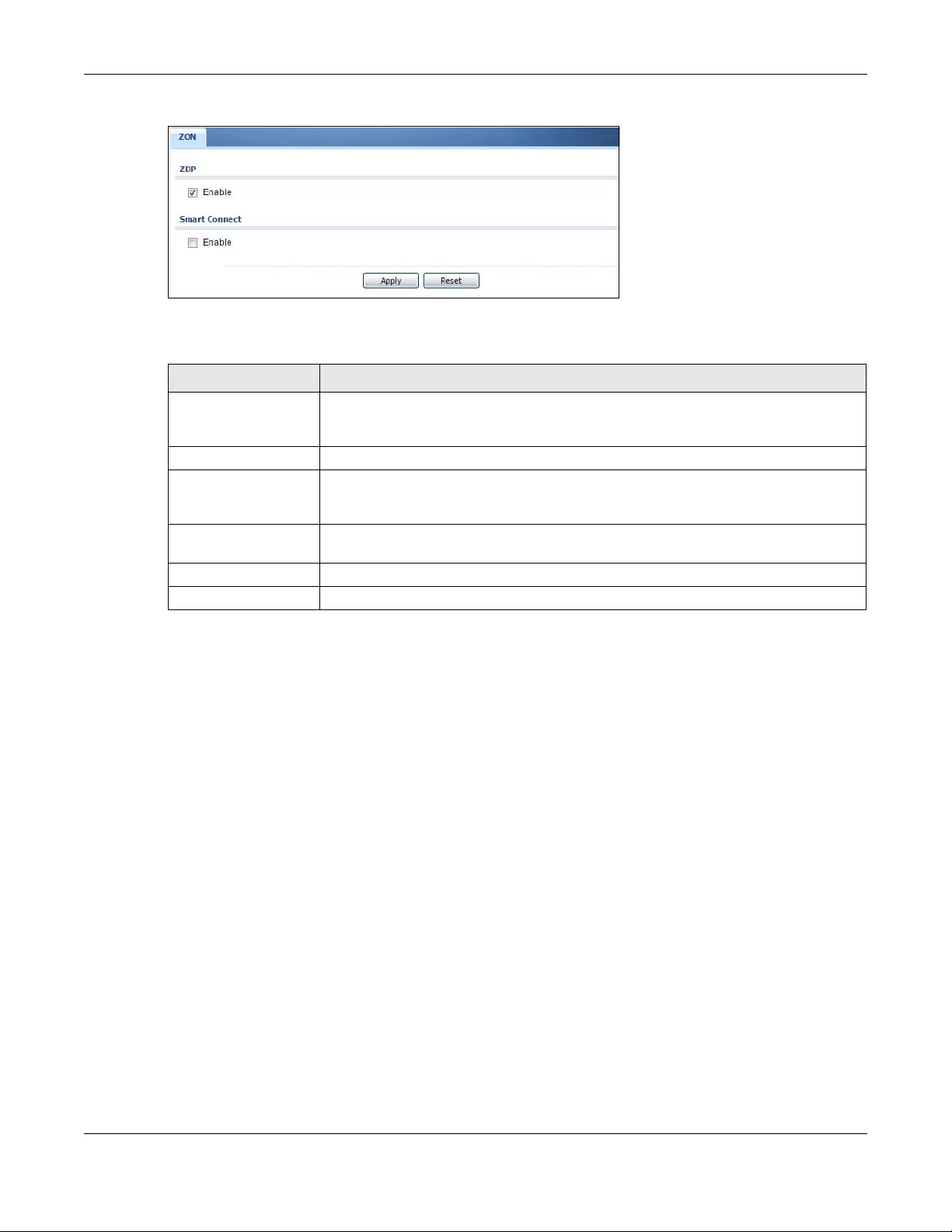
Chapter 36 System
ZyWALL/USG Series User’s Guide
709
Figure 498 Configuration > System > ZON
The following table describes the labels in this screen.
Table 322 Configuration > System > ZON
LABEL DESCRIPTION
ZDP ZyXEL Discovery Protocol (ZDP) is the protocol that the ZyXEL One Network (ZON)
utility uses for discovering and configuring ZDP-aware ZyXEL devices in the same
broadcast domain as the computer on which ZON is installed.
Enable Select to activate ZDP discovery on the ZyWALL/USG.
Smart Connect Smart Connect uses Link Layer Discovery Protocol (LLDP) for discovering and
configuring LLDP-aware devices in the same broadcast domain as the ZyWALL/USG
that you’re logged into using the web configurator.
Enable Select to activate LLDP discovery on the ZyWALL/USG. See also Monitor > System
Status > Ethernet Discovery.
Apply Click Apply to save your changes back to the ZyWALL/USG.
Reset Click Reset to return the screen to its last-saved settings.

ZyWALL/USG Series User’s Guide
710
CHAPTER 37
Log and Report
37.1 Overview
Use these screens to configure daily reporting and log settings.
37.1.1 What You Can Do In this Chapter
•Use the Emai l Daily Repor t screen (Section 37.2 on page 710) to configure where and how to
send daily reports and what reports to send.
•Use the Log Setting screens (Section 37.3 on page 712) to specify settings for recording log
messages and alerts, e-mailing them, storing them on a connected USB storage device, and
sending them to remote syslog servers.
37.2 Email Daily Report
Use the Email Daily Report screen to start or stop data collection and view various statistics about
traffic passing through your ZyWALL/USG.
Note: Data collection may decrease the ZyWALL/USG’s traffic throughput rate.
Click Configuration > Log & Report > Email Daily Report to display the following screen.
Configure this screen to have the ZyWALL/USG e-mail you system statistics every day.
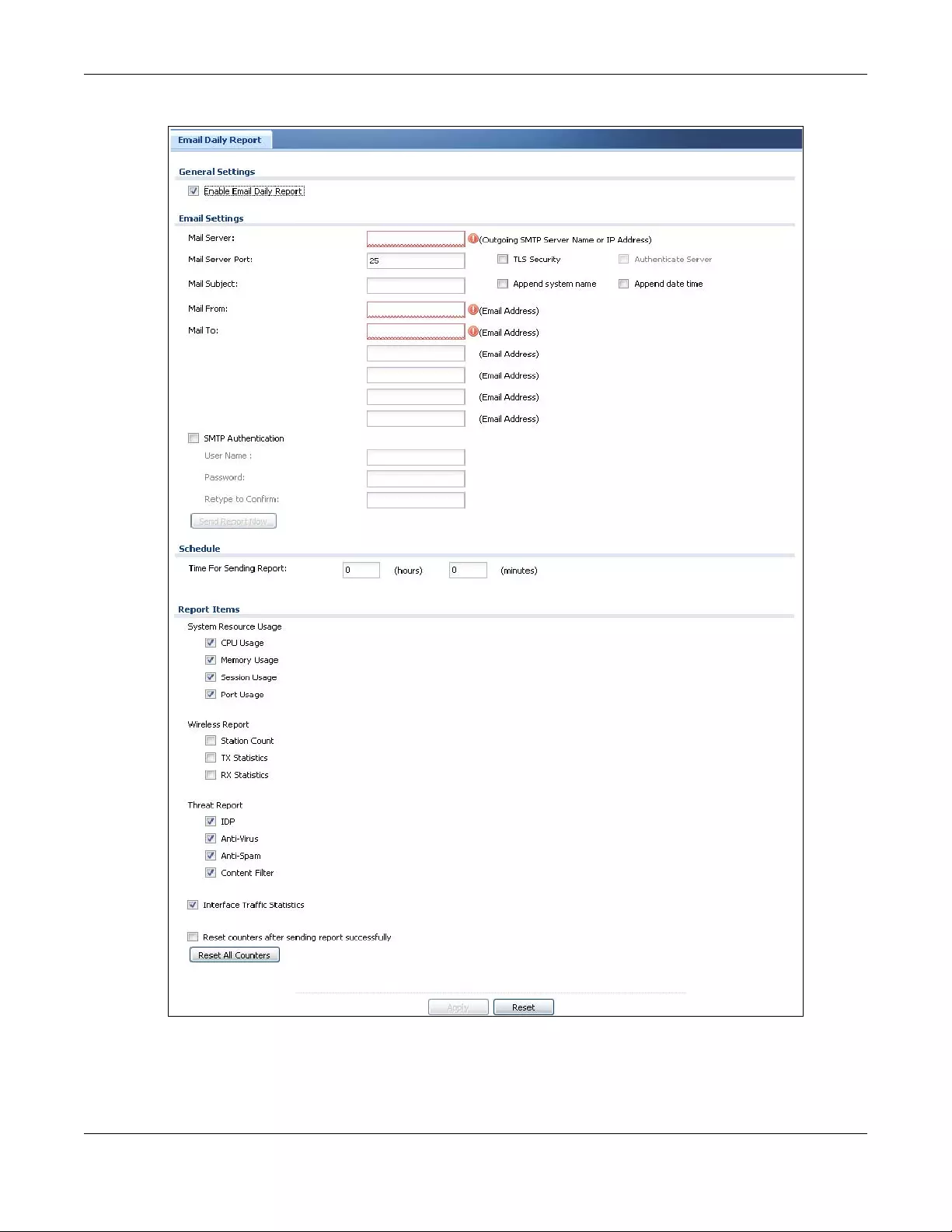
Chapter 37 Log and Report
ZyWALL/USG Series User’s Guide
711
Figure 499 Configuration > Log & Report > Email Daily Report

Chapter 37 Log and Report
ZyWALL/USG Series User’s Guide
712
The following table describes the labels in this screen.
37.3 Log Setting Screens
The Log Setting screens control log messages and alerts. A log message stores the information for
viewing or regular e-mailing later, and an alert is e-mailed immediately. Usually, alerts are used for
events that require more serious attention, such as system errors and attacks.
The ZyWALL/USG provides a system log and supports e-mail profiles and remote syslog servers.
View the system log in the MONITOR > Log screen. Use the e-mail profiles to mail log messages
Table 323 Configuration > Log & Report > Email Daily Report
LABEL DESCRIPTION
Enable Email
Daily Report
Select this to send reports by e-mail every day.
Mail Server Type the name or IP address of the outgoing SMTP server.
Mail Server Port Enter the same port number here as is on the mail server for mail traffic.
TLS Security Select Transport Layer Security (TLS) if you want encrypted communications between the
mail server and the ZyWALL/USG.
Authenticate
Server If you choose TLS Securit y, you may also select this to have the ZyWALL/USG
authenticate the mail server in the TLS handshake.
Mail Subject Type the subject line for outgoing e-mail from the ZyWALL/USG.
Append
system name Select Append system name to add the ZyWALL/USG’s system name to the subject.
Append date
time Select Append date time to add the ZyWALL/USG’s system date and time to the subject.
Mail From Type the e-mail address from which the outgoing e-mail is delivered. This address is used
in replies.
Mail To Type the e-mail address (or addresses) to which the outgoing e-mail is delivered.
SMTP
Authentication
Select this check box if it is necessary to provide a user name and password to the SMTP
server.
User Name This box is effective when you select the SMTP Authentication check box. Type the user
name to provide to the SMTP server when the log is e-mailed.
Password This box is effective when you select the SMTP Authentication check box. Type the
password to provide to the SMTP server when the log is e-mailed.
Retype to
Confirm Type the password again to make sure that you have entered is correctly.
Send Report Now Click this button to have the ZyWALL/USG send the daily e-mail report immediately.
Time for sending
report
Select the time of day (hours and minutes) when the log is e-mailed. Use 24-hour
notation.
Report Items Select the information to include in the report. Types of information include System
Resour ce Usage, Wireless Report, Threat Report, and Interface Traffic Statistics.
Select Reset counters after sending report successfully if you only want to see
statistics for a 24 hour period.
Reset All
Counters
Click this to discard all report data and start all of the counters over at zero.
Apply Click Apply to save your changes back to the ZyWALL/USG.
Reset Click Reset to return the screen to its last-saved settings.
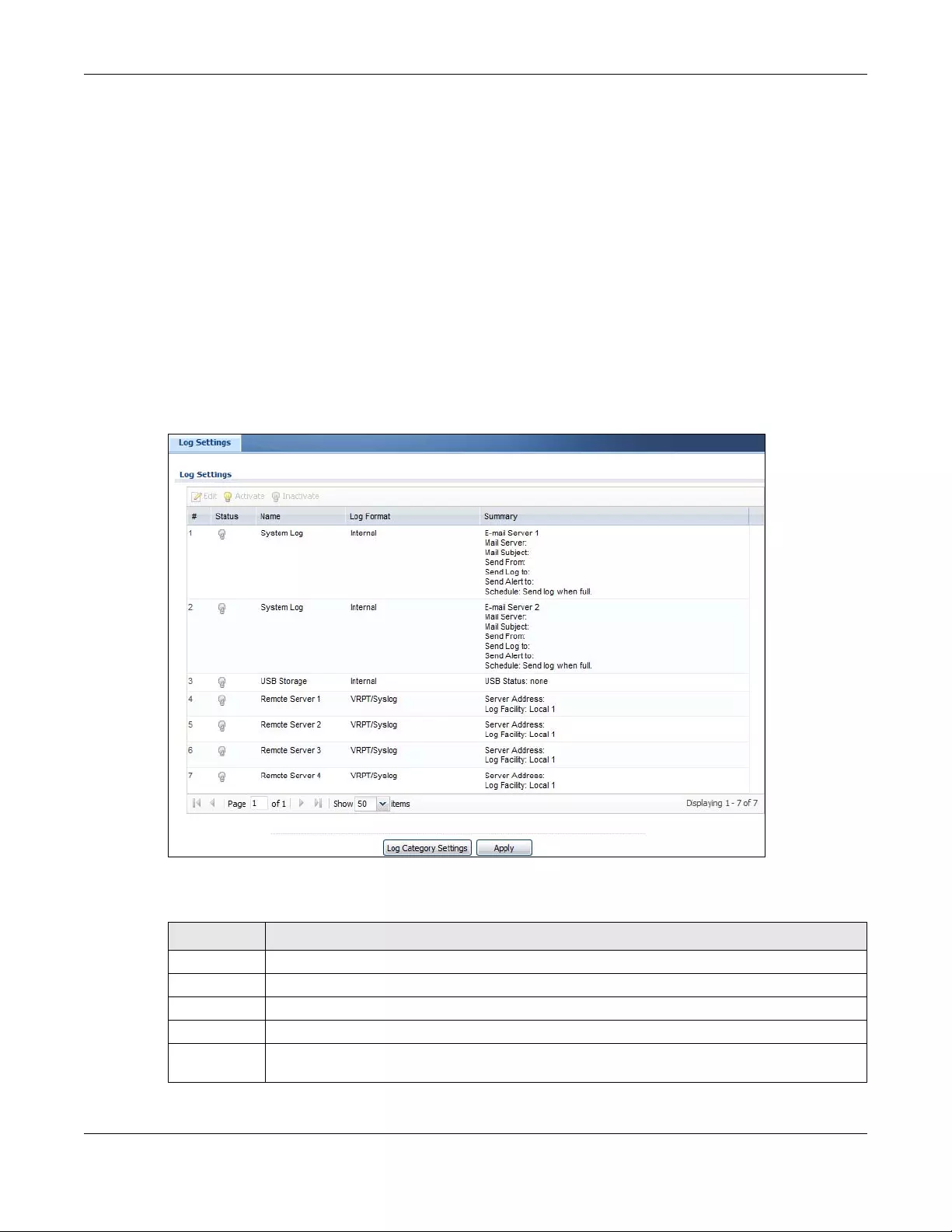
Chapter 37 Log and Report
ZyWALL/USG Series User’s Guide
713
to the specific destinations. You can also have the ZyWALL/USG store system logs on a connected
USB storage device. The other four logs are stored on specified syslog servers.
The Log Setting screens control what information the ZyWALL/USG saves in each log. You can also
specify which log messages to e-mail for the system log, and where and how often to e-mail them.
These screens also set for which events to generate alerts and where to email the alerts.
The first Log Setting screen provides a settings summary. Use the Edit screens to configure
settings such as log categories, e-mail addresses, and server names for any log. Use the Log
Category Settings screen to edit what information is included in the system log, USB storage, e-
mail profiles, and remote servers.
37.3.1 Log Setting Summary
To access this screen, click Configuration > Log & Report > Log Setting.
Figure 500 Configuration > Log & Report > Log Setting
The following table describes the labels in this screen.
Table 324 Configuration > Log & Report > Log Setting
LABEL DESCRIPTION
Edit Double-click an entry or select it and click Edit to open a screen where you can modify it.
Activate To turn on an entry, select it and click Activate.
Inactivate To turn off an entry, select it and click Inactivate.
# This field is a sequential value, and it is not associated with a specific log.
Name This field displays the type of log setting entry (system log, logs stored on a USB storage
device connected to the ZyWALL/USG, or one of the remote servers).
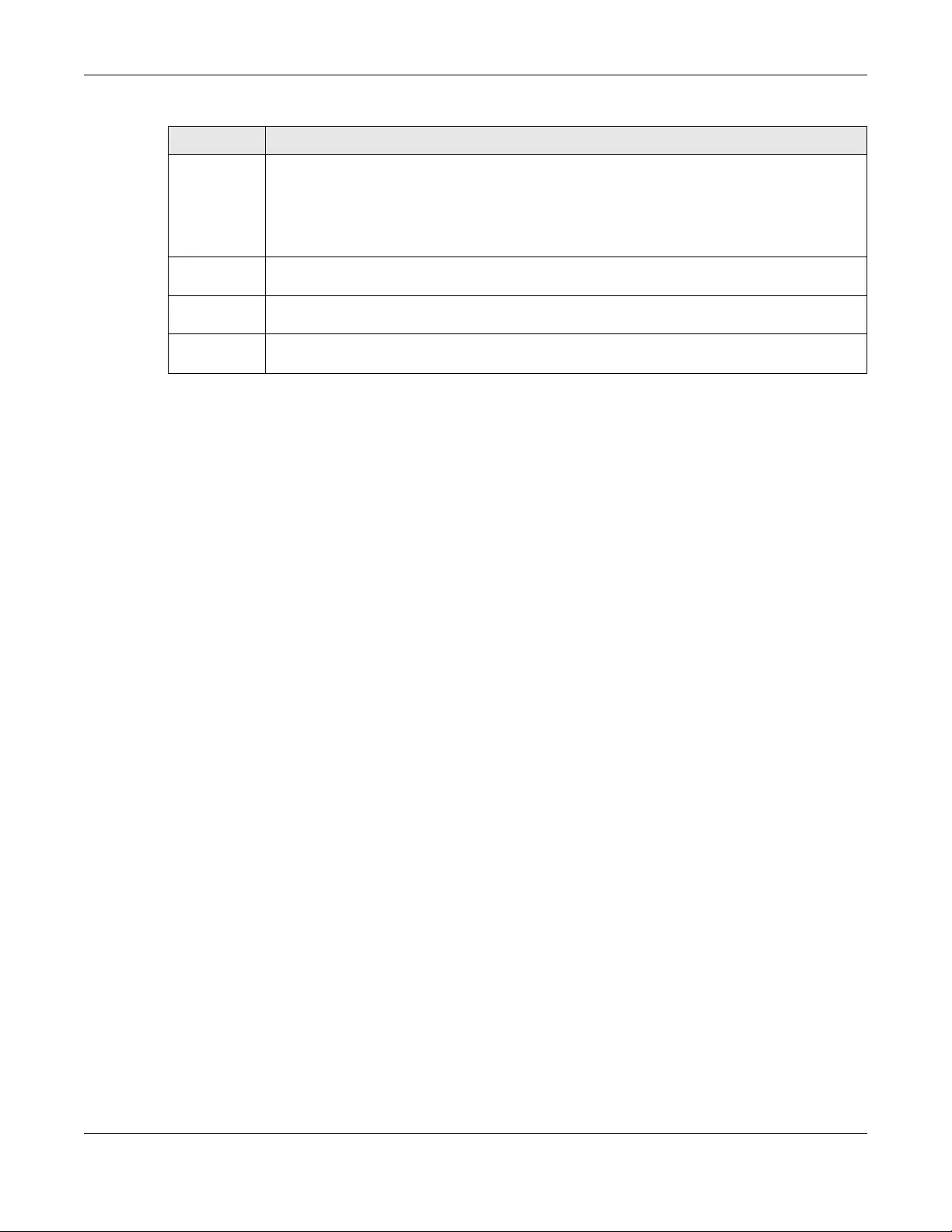
Chapter 37 Log and Report
ZyWALL/USG Series User’s Guide
714
37.3.2 Edit System Log Settings
The Log Settings Edit screen controls the detailed settings for each log in the system log (which
includes the e-mail profiles). Go to the Log Settings Summary screen (see Section 37.3.1 on
page 713), and click the system log Edit icon.
Log Format This field displays the format of the log.
Internal - system log; you can view the log on the View Log tab.
VRPT/Syslog - ZyXEL’s Vantage Report, syslog-compatible format.
CEF/Syslog - Common Event Format, syslog-compatible format.
Summary This field is a summary of the settings for each log. Please see Section 37.3.2 on page 714 for
more information.
Log Category
Settings
Click this button to open the Log Category Settings Edit screen.
Apply Click this button to save your changes (activate and deactivate logs) and make them take
effect.
Table 324 Configuration > Log & Report > Log Setting (continued)
LABEL DESCRIPTION

Chapter 37 Log and Report
ZyWALL/USG Series User’s Guide
715
Figure 501 Configuration > Log & Report > Log Setting > Edit (System Log - E-mail Servers)

Chapter 37 Log and Report
ZyWALL/USG Series User’s Guide
716
Figure 502 Configuration > Log & Report > Log Setting > Edit (System Log - AC)
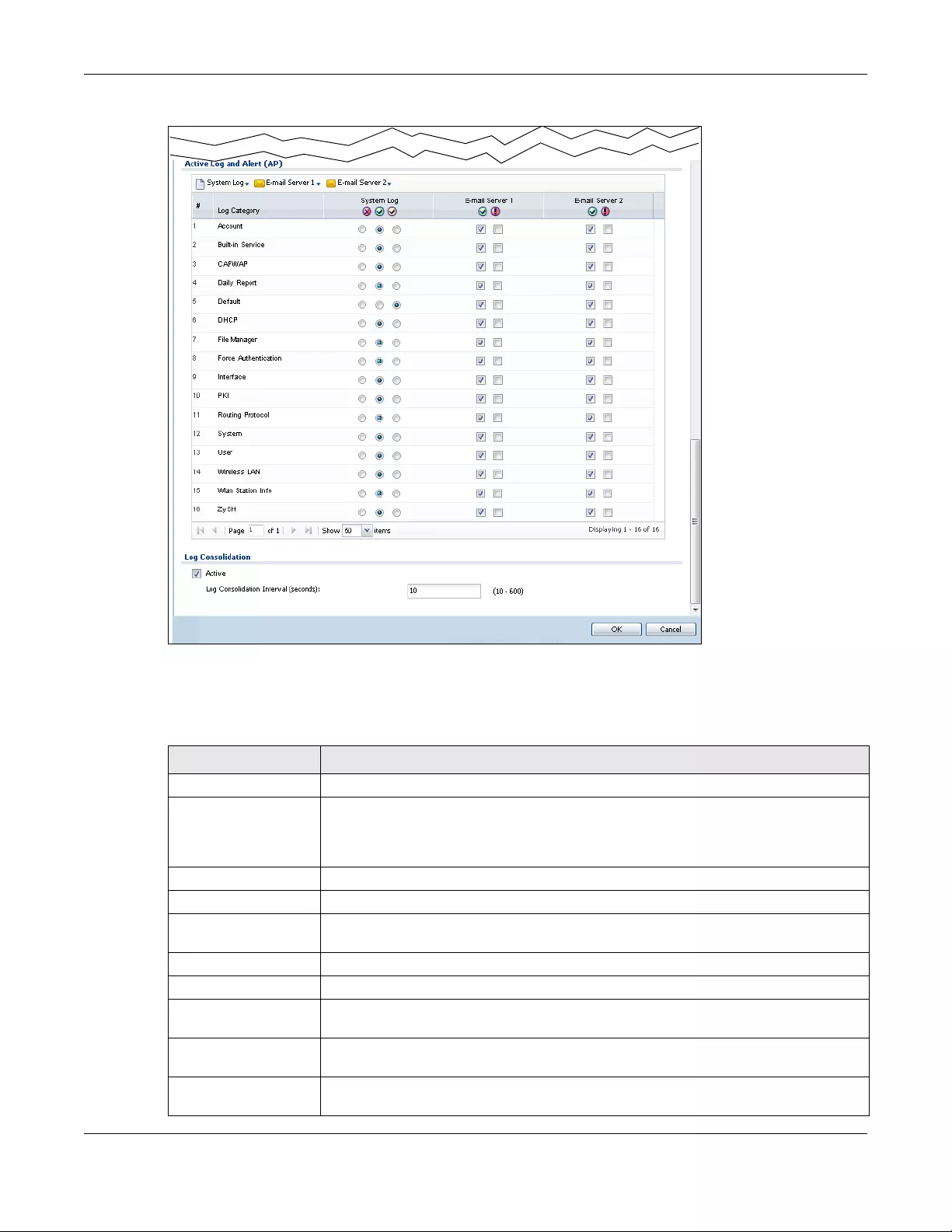
Chapter 37 Log and Report
ZyWALL/USG Series User’s Guide
717
Figure 503 Configuration > Log & Report > Log Setting > Edit (System Log - AP)
The following table describes the labels in this screen.
Table 325 Configuration > Log & Report > Log Setting > Edit (System Log)
LABEL DESCRIPTION
E-Mail Server 1/2
Active Select this to send log messages and alerts according to the information in this
section. You specify what kinds of log messages are included in log information and
what kinds of log messages are included in alerts in the Active Log and Alert
section.
Mail Server Type the name or IP address of the outgoing SMTP server.
Mail Subject Type the subject line for the outgoing e-mail.
Send From Type the e-mail address from which the outgoing e-mail is delivered. This address is
used in replies.
Send Log To Type the e-mail address to which the outgoing e-mail is delivered.
Send Alerts To Type the e-mail address to which alerts are delivered.
Sending Log Select how often log information is e-mailed. Choices are: When Full, Hourly and
When Full, Daily and When Full, and Weekly and When Full.
Day for Sending
Log This field is available if the log is e-mailed weekly. Select the day of the week the log
is e-mailed.
Time for Sending
Log This field is available if the log is e-mailed weekly or daily. Select the time of day
(hours and minutes) when the log is e-mailed. Use 24-hour notation.
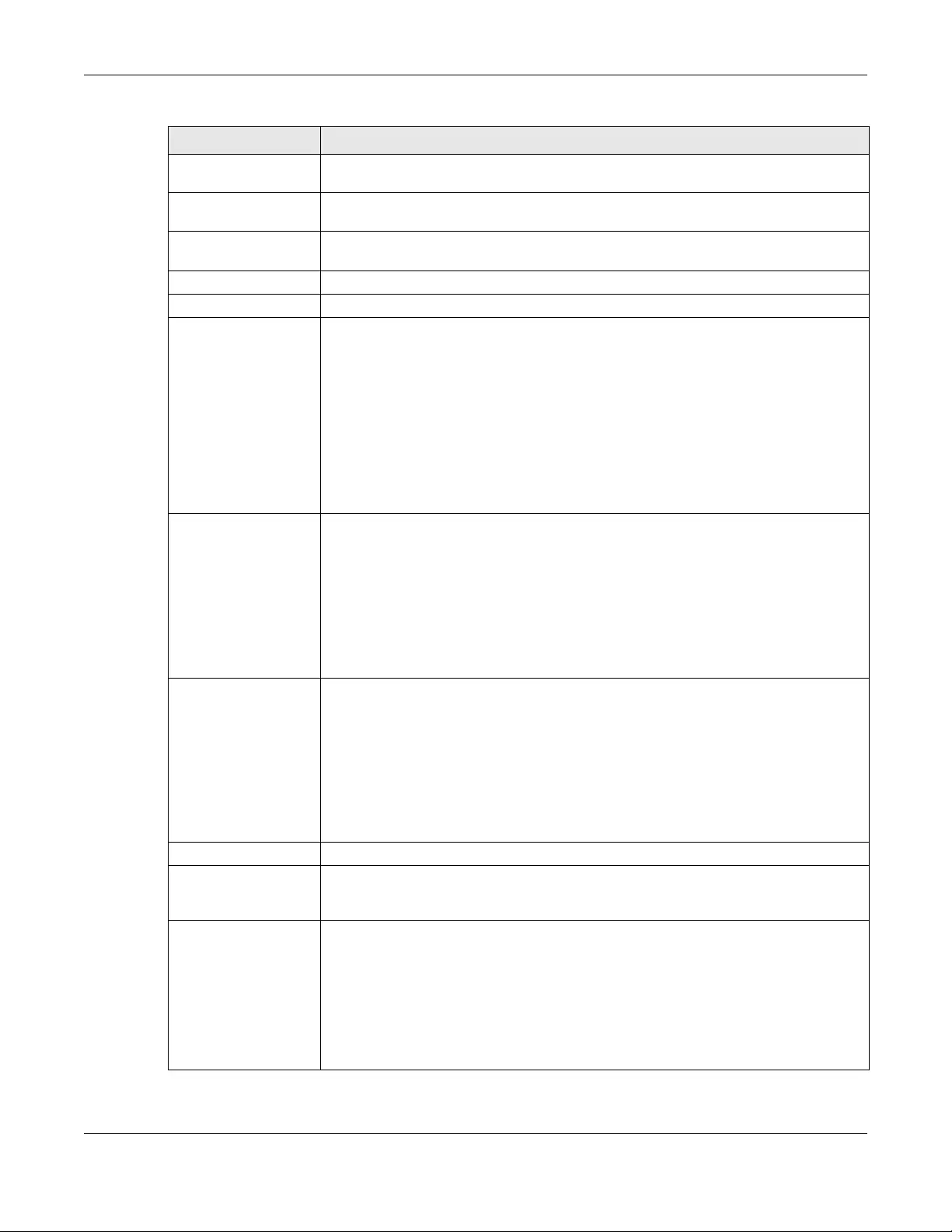
Chapter 37 Log and Report
ZyWALL/USG Series User’s Guide
718
SMTP
Authentication Select this check box if it is necessary to provide a user name and password to the
SMTP server.
User Name This box is effective when you select the SMTP Authentication check box. Type the
user name to provide to the SMTP server when the log is e-mailed.
Password This box is effective when you select the SMTP Authentication check box. Type the
password to provide to the SMTP server when the log is e-mailed.
Retype to Confirm Type the password again to make sure that you have entered is correctly.
Active Log and Alert
System Log Use the System Log drop-down list to change the log settings for all of the log
categories.
disable all logs (red X) - do not log any information for any category for the system
log or e-mail any logs to e-mail server 1 or 2.
enable normal logs (green check mark) - create log messages and alerts for all
categories for the system log. If e-mail server 1 or 2 also has normal logs enabled,
the ZyWALL/USG will e-mail logs to them.
enable normal logs and debug logs (yellow check mark) - create log messages,
alerts, and debugging information for all categories. The ZyWALL/USG does not e-
mail debugging information, even if this setting is selected.
E-mail Server 1 Use the E-Mail Server 1 drop-down list to change the settings for e-mailing logs to
e-mail server 1 for all log categories.
Using the System Log drop-down list to disable all logs overrides your e-mail server
1 settings.
enable normal logs (green check mark) - e-mail log messages for all categories to
e-mail server 1.
enable alert logs (red exclamation point) - e-mail alerts for all categories to e-mail
server 1.
E-mail Server 2 Use the E-Mail Server 2 drop-down list to change the settings for e-mailing logs to
e-mail server 2 for all log categories.
Using the System Log drop-down list to disable all logs overrides your e-mail server
2 settings.
enable normal logs (green check mark) - e-mail log messages for all categories to
e-mail server 2.
enable alert logs (red exclamation point) - e-mail alerts for all categories to e-mail
server 2.
# This field is a sequential value, and it is not associated with a specific address.
Log Category This field displays each category of messages. It is the same value used in the
Display and Category fields in the View Log tab. The Default category includes
debugging messages generated by open source software.
System log Select which events you want to log by Log Category. There are three choices:
disable all logs (red X) - do not log any information from this category
enable normal logs (green check mark) - create log messages and alerts from this
category
enable normal logs and debug logs (yellow check mark) - create log messages,
alerts, and debugging information from this category; the ZyWALL/USG does not e-
mail debugging information, however, even if this setting is selected.
Table 325 Configuration > Log & Report > Log Setting > Edit (System Log) (continued)
LABEL DESCRIPTION

Chapter 37 Log and Report
ZyWALL/USG Series User’s Guide
719
37.3.3 Edit Log on USB Storage Setting
The Edit Log on USB Storage Setting screen controls the detailed settings for saving logs to a
connected USB storage device. Go to the Log Setting Summary screen (see Section 37.3.1 on
page 713), and click the USB storage Edit icon.
E-mail Server 1 Select whether each category of events should be included in the log messages when
it is e-mailed (green check mark) and/or in alerts (red exclamation point) for the e-
mail settings specified in E-Mail Server 1. The ZyWALL/USG does not e-mail
debugging information, even if it is recorded in the System log.
E-mail Server 2 Select whether each category of events should be included in log messages when it is
e-mailed (green check mark) and/or in alerts (red exclamation point) for the e-mail
settings specified in E-Mail Server 2. The ZyWALL/USG does not e-mail debugging
information, even if it is recorded in the System log.
Log Consolidation
Active Select this to activate log consolidation. Log consolidation aggregates multiple log
messages that arrive within the specified Log Consolidation Interval. In the View
Log tab, the text “[count=x]”, where x is the number of original log messages, is
appended at the end of the Message field, when multiple log messages were
aggregated.
Log Consolidation
Interval Type how often, in seconds, to consolidate log information. If the same log message
appears multiple times, it is aggregated into one log message with the text
“[count=x]”, where x is the number of original log messages, appended at the end of
the Message field.
OK Click this to save your changes and return to the previous screen.
Cancel Click this to return to the previous screen without saving your changes.
Table 325 Configuration > Log & Report > Log Setting > Edit (System Log) (continued)
LABEL DESCRIPTION
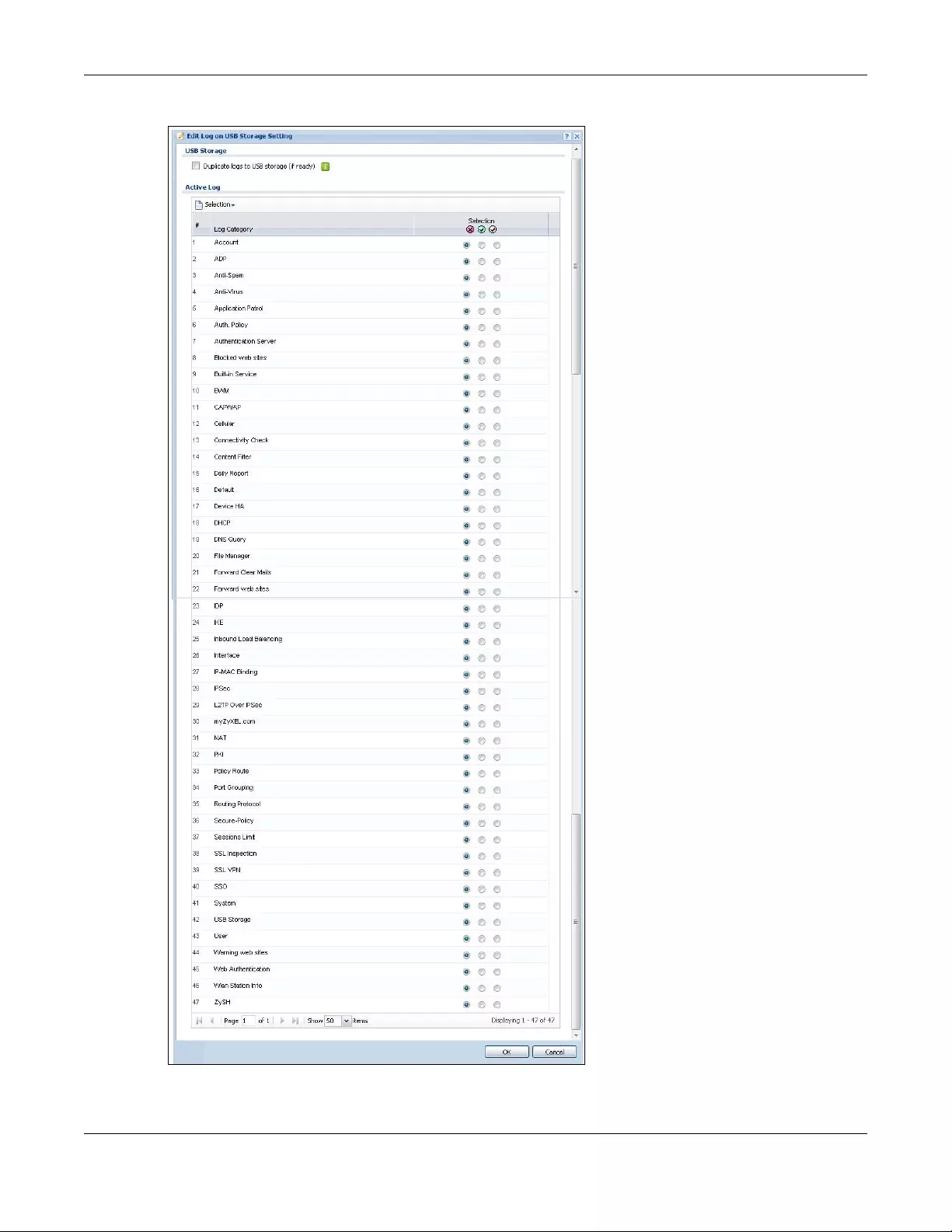
Chapter 37 Log and Report
ZyWALL/USG Series User’s Guide
720
Figure 504 Configuration > Log & Report > Log Setting > Edit (USB Storage)
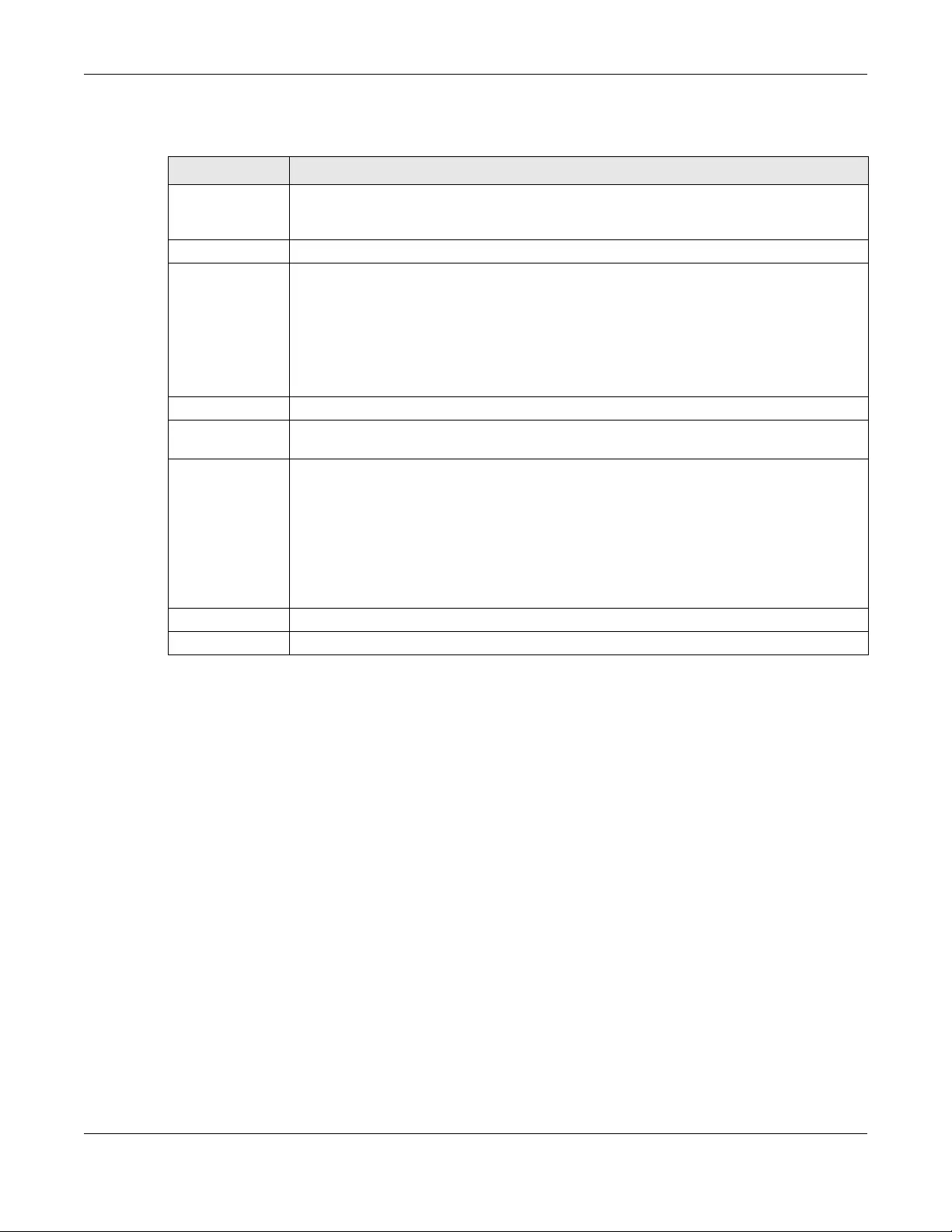
Chapter 37 Log and Report
ZyWALL/USG Series User’s Guide
721
The following table describes the labels in this screen.
37.3.4 Edit Remote Server Log Settings
The Log Settings Edit screen controls the detailed settings for each log in the remote server
(syslog). Go to the Log Settings Summary screen (see Section 37.3.1 on page 713), and click a
remote server Edit icon.
Table 326 Configuration > Log & Report > Log Setting > Edit (USB Storage)
LABEL DESCRIPTION
Duplicate logs to
USB storage (if
ready)
Select this to have the ZyWALL/USG save a copy of its system logs to a connected USB
storage device. Use the Active Log section to specify what kinds of messages to include.
Active Log
Selection Use the Selection drop-down list to change the log settings for all of the log categories.
disable all logs (red X) - do not send the remote server logs for any log category.
enable norm al logs (green check mark) - send the remote server log messages and
alerts for all log categories.
enable normal logs and debug logs (yellow check mark) - send the remote server log
messages, alerts, and debugging information for all log categories.
# This field is a sequential value, and it is not associated with a specific entry.
Log Category This field displays each category of messages. The Default category includes debugging
messages generated by open source software.
Selection Select what information you want to log from each Log Category (except All Logs; see
below). Choices are:
disable all logs (red X) - do not log any information from this category
enable norm al logs (green check mark) - log regular information and alerts from this
category
enable normal logs and debug logs (yellow check mark) - log regular information,
alerts, and debugging information from this category
OK Click this to save your changes and return to the previous screen.
Cancel Click this to return to the previous screen without saving your changes.
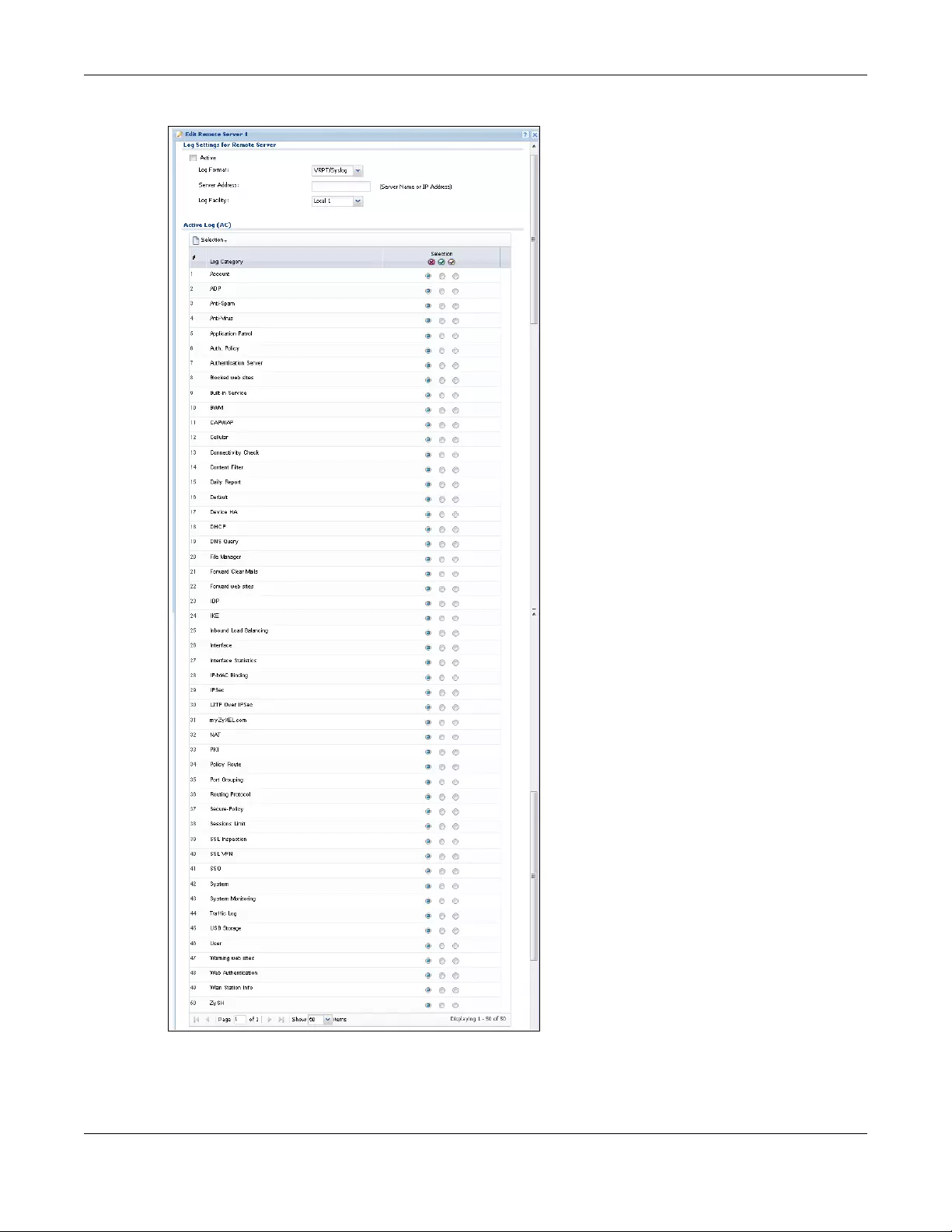
Chapter 37 Log and Report
ZyWALL/USG Series User’s Guide
722
Figure 505 Configuration > Log & Report > Log Setting > Edit (Remote Server - AC)
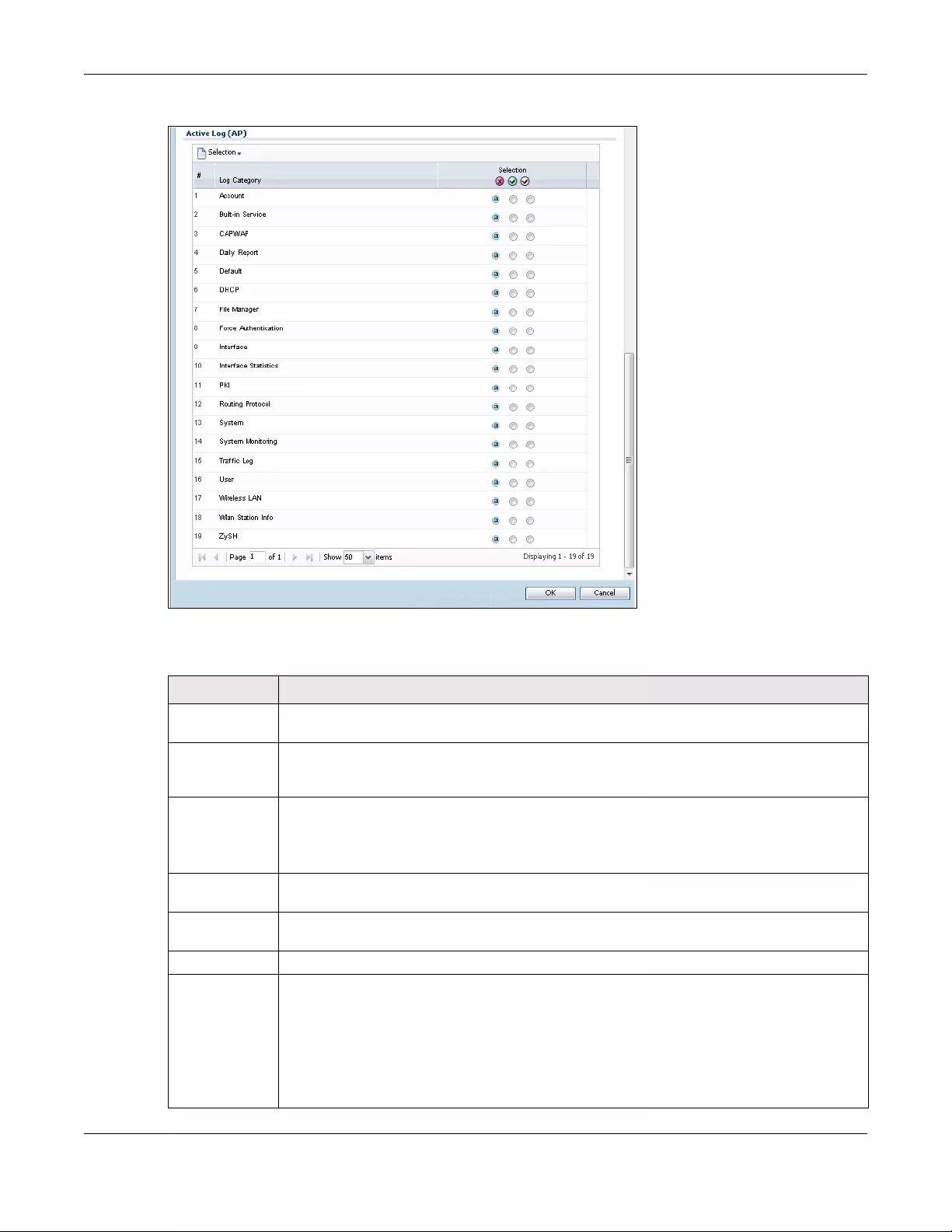
Chapter 37 Log and Report
ZyWALL/USG Series User’s Guide
723
Configuration > Log & Report > Log Setting > Edit (Remote Server - AP)
The following table describes the labels in this screen.
Table 327 Configuration > Log & Report > Log Setting > Edit (Remote Server)
LABEL DESCRIPTION
Log Settings for
Remote Server
Active Select this check box to send log information according to the information in this section.
You specify what kinds of messages are included in log information in the Active Log
section.
Log Format This field displays the format of the log information. It is read-only.
VRPT/Syslog - ZyXEL’s Vantage Report, syslog-compatible format.
CEF/Syslog - Common Event Format, syslog-compatible format.
Server
Address Type the server name or the IP address of the syslog server to which to send log
information.
Log Facility Select a log facility. The log facility allows you to log the messages to different files in the
syslog server. Please see the documentation for your syslog program for more information.
Active Log
Selection Use the Selection drop-down list to change the log settings for all of the log categories.
disable all logs (red X) - do not send the remote server logs for any log category.
enable normal logs (green check mark) - send the remote server log messages and alerts
for all log categories.
enable normal logs and debug logs (yellow check mark) - send the remote server log
messages, alerts, and debugging information for all log categories.
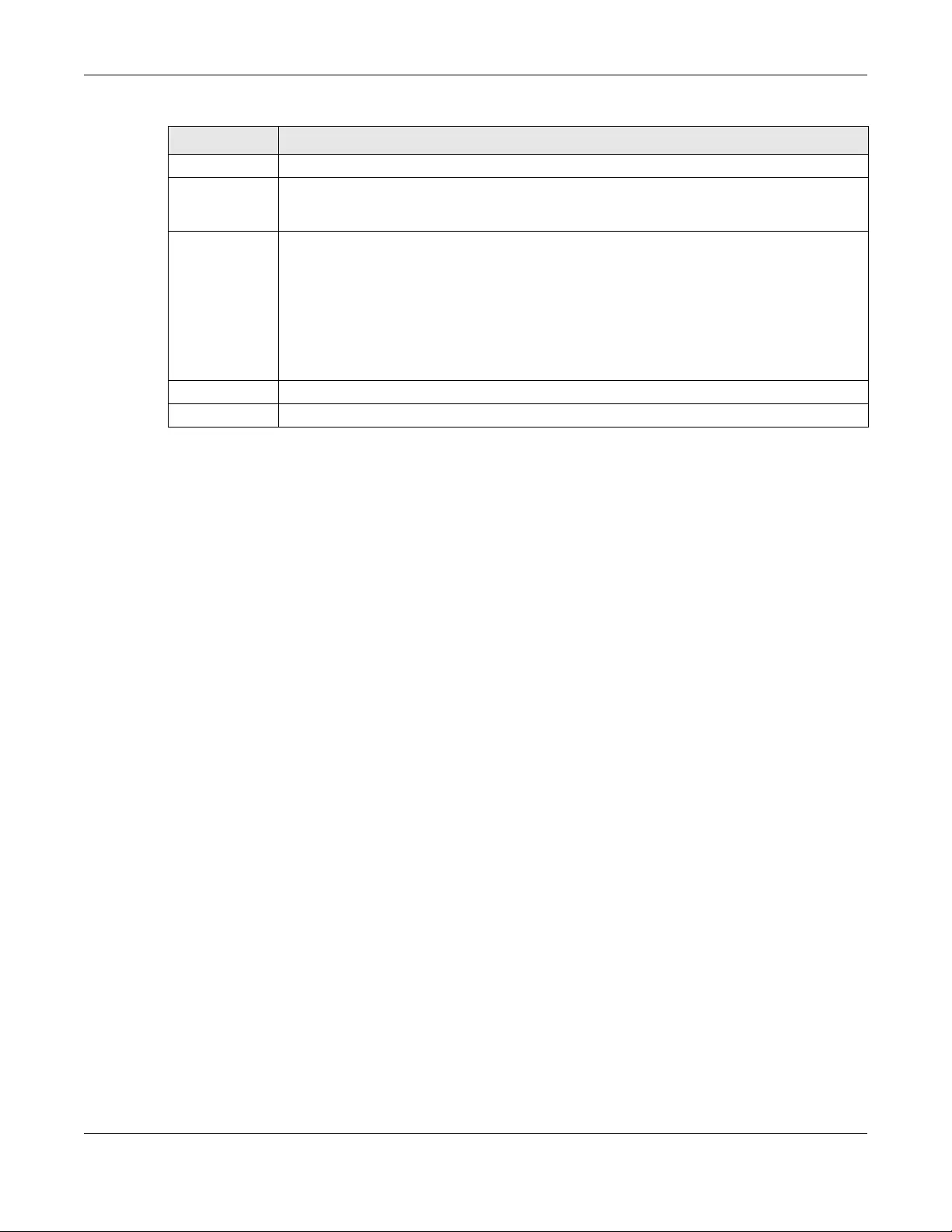
Chapter 37 Log and Report
ZyWALL/USG Series User’s Guide
724
37.3.5 Log Category Settings Screen
The Log Category Settings screen allows you to view and to edit what information is included in
the system log, USB storage, e-mail profiles, and remote servers at the same time. It does not let
you change other log settings (for example, where and how often log information is e-mailed or
remote server names). To access this screen, go to the Log Settings Summary screen (see
Section 37.3.1 on page 713), and click the Log Category Settings button.
# This field is a sequential value, and it is not associated with a specific address.
Log
Category This field displays each category of messages. It is the same value used in the Display and
Category fields in the View Log tab. The Default category includes debugging messages
generated by open source software.
Selection Select what information you want to log from each Log Category (except All Logs; see
below). Choices are:
disable all logs (red X) - do not log any information from this category
enable normal logs (green check mark) - log regular information and alerts from this
category
enable normal logs and debug logs (yellow check mark) - log regular information, alerts,
and debugging information from this category
OK Click this to save your changes and return to the previous screen.
Cancel Click this to return to the previous screen without saving your changes.
Table 327 Configuration > Log & Report > Log Setting > Edit (Remote Server) (continued)
LABEL DESCRIPTION
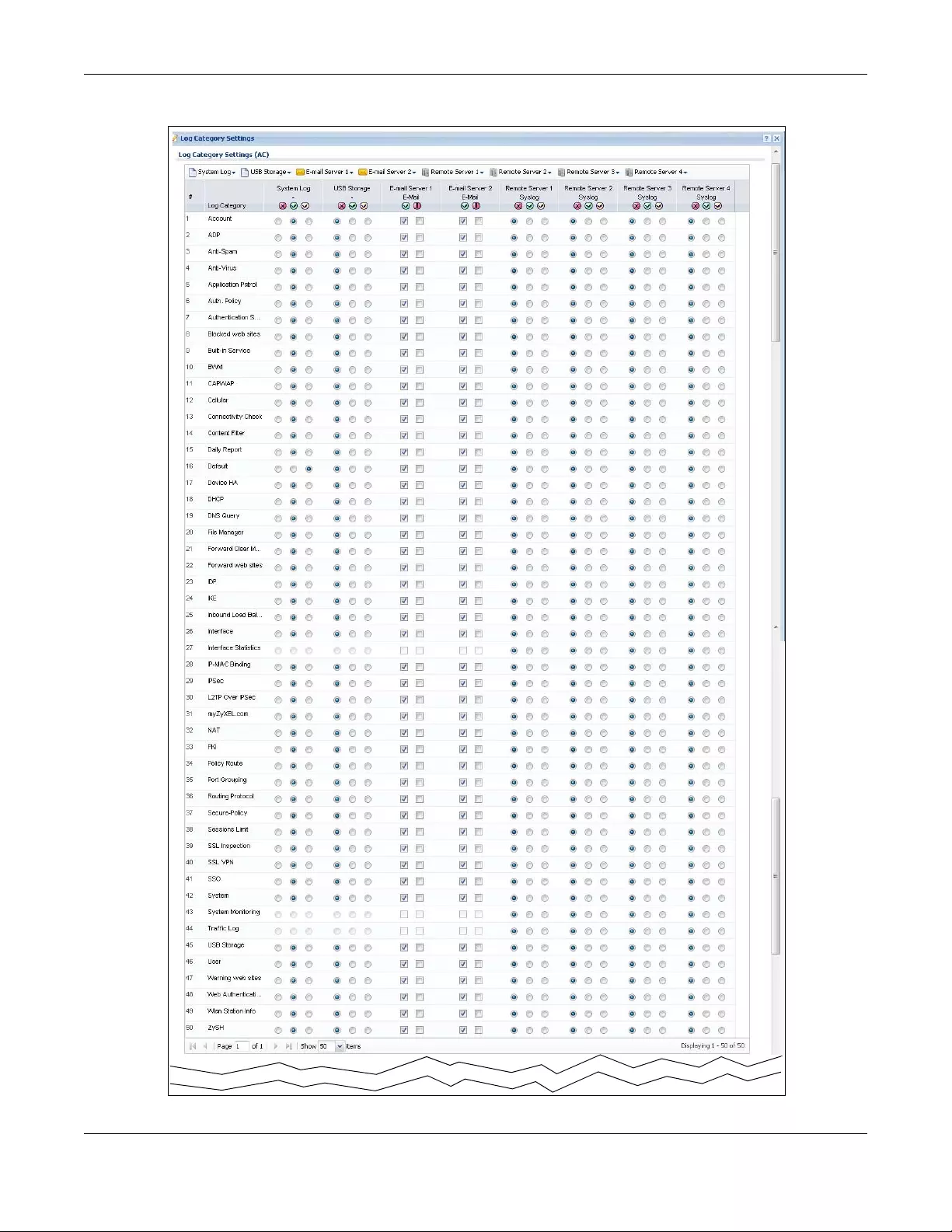
Chapter 37 Log and Report
ZyWALL/USG Series User’s Guide
725
Figure 506 Log Category Settings AC
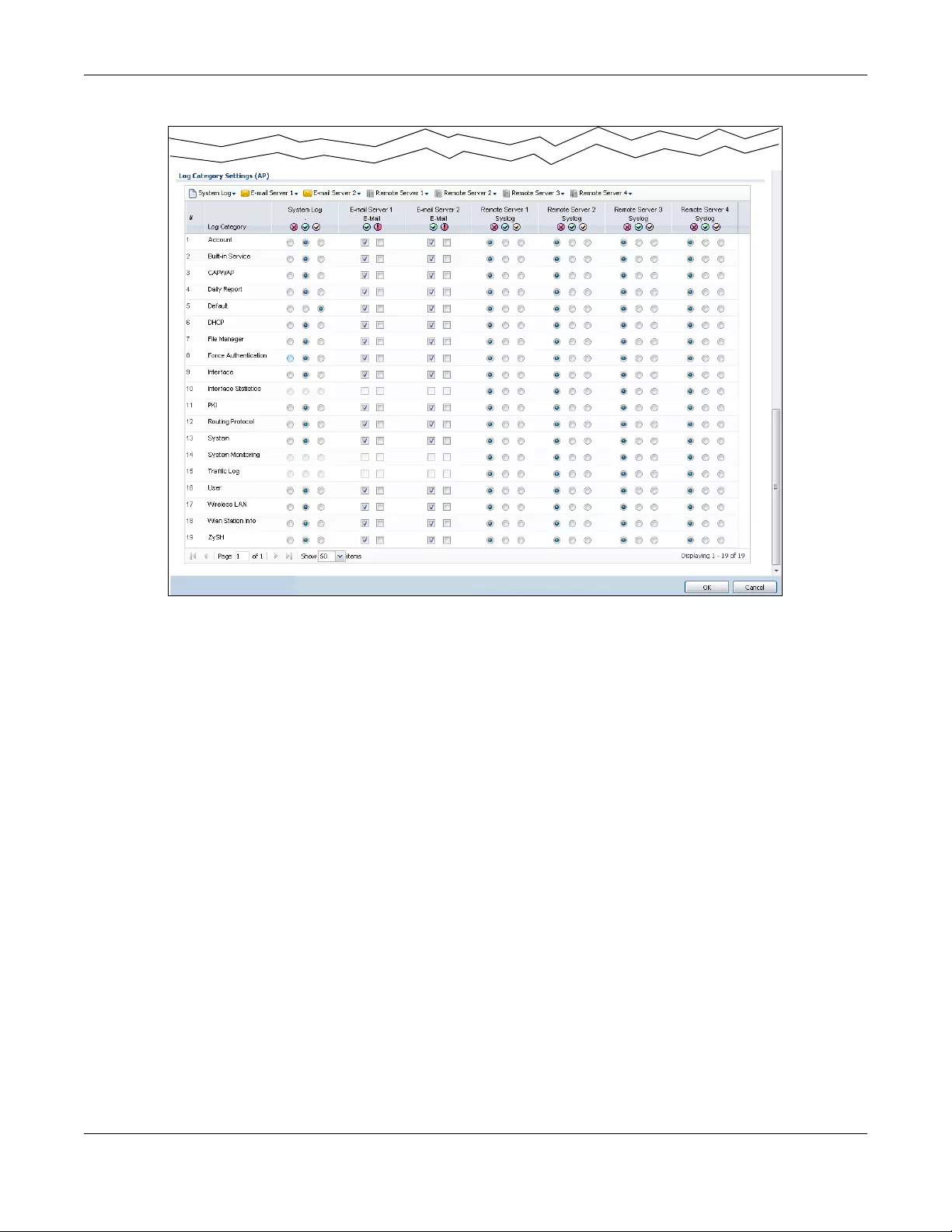
Chapter 37 Log and Report
ZyWALL/USG Series User’s Guide
726
Figure 507 Log Category Settings AP
This screen provides a different view and a different way of indicating which messages are included
in each log and each alert. Please see Section 37.3.2 on page 714, where this process is discussed.
(The Default category includes debugging messages generated by open source software.)
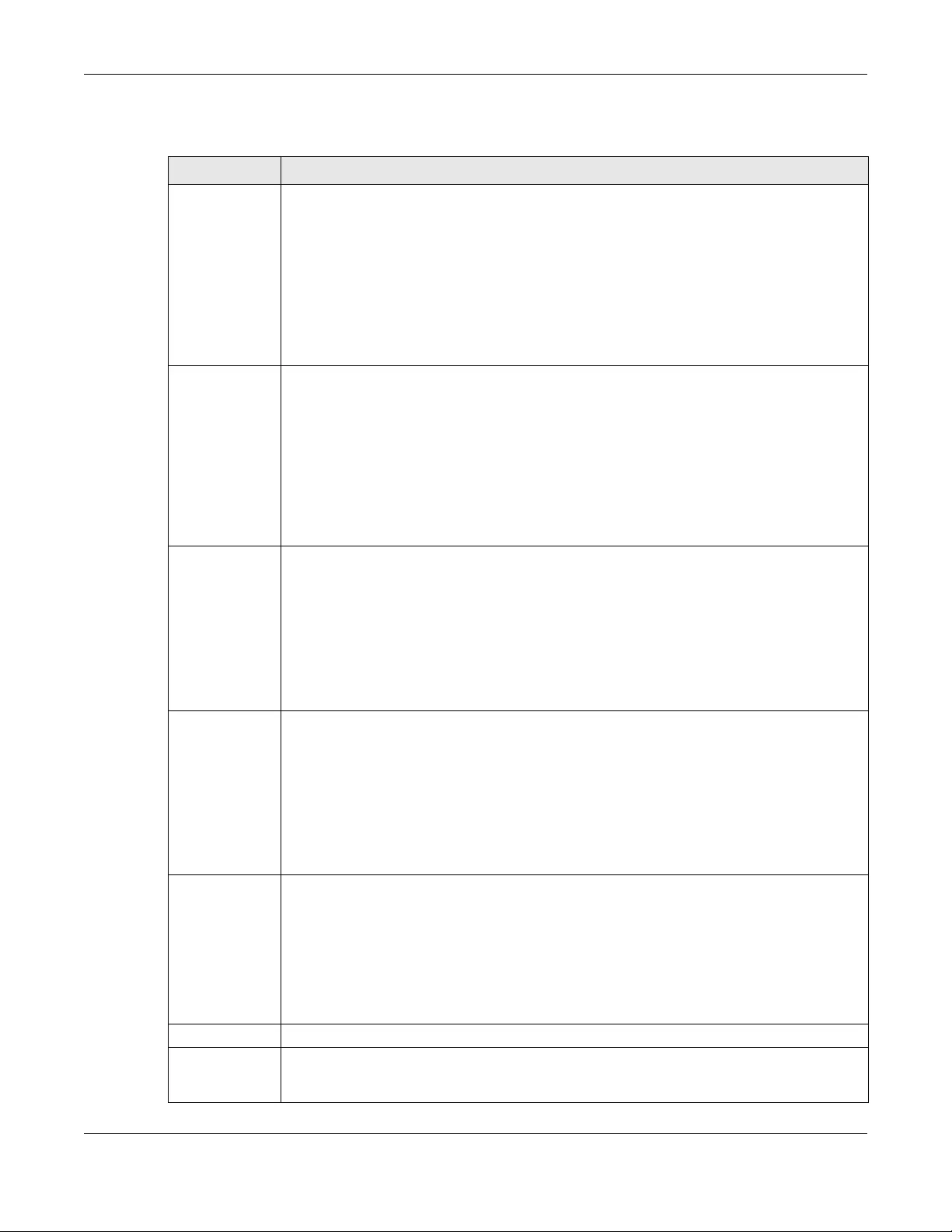
Chapter 37 Log and Report
ZyWALL/USG Series User’s Guide
727
The following table describes the fields in this screen.
Table 328 Configuration > Log & Report > Log Setting > Log Category Settings
LABEL DESCRIPTION
System Log Use the System Log drop-down list to change the log settings for all of the log categories.
disable all logs (red X) - do not log any information for any category for the system log or
e-mail any logs to e-mail server 1 or 2.
enable normal logs (green check mark) - create log messages and alerts for all categories
for the system log. If e-mail server 1 or 2 also has normal logs enabled, the ZyWALL/USG
will e-mail logs to them.
enable normal logs and debug logs (yellow check mark) - create log messages, alerts,
and debugging information for all categories. The ZyWALL/USG does not e-mail debugging
information, even if this setting is selected.
USB Storage Use the USB Stor ag e drop-down list to change the log settings for saving logs to a
connected USB storage device.
disable all logs (red X) - do not log any information for any category to a connected USB
storage device.
enable normal logs (green check mark) - create log messages and alerts for all categories
and save them to a connected USB storage device.
enable normal logs and debug logs (yellow check mark) - create log messages, alerts,
and debugging information for all categories and save them to a connected USB storage
device.
E-mail Server 1 Use the E-Mail Server 1 drop-down list to change the settings for e-mailing logs to e-mail
server 1 for all log categories.
Using the System Log drop-down list to disable all logs overrides your e-mail server 1
settings.
enable normal logs (green check mark) - e-mail log messages for all categories to e-mail
server 1.
enable alert logs (red exclamation point) - e-mail alerts for all categories to e-mail server
1.
E-mail Server 2 Use the E-Mail Server 2 drop-down list to change the settings for e-mailing logs to e-mail
server 2 for all log categories.
Using the System Log drop-down list to disable all logs overrides your e-mail server 2
settings.
enable normal logs (green check mark) - e-mail log messages for all categories to e-mail
server 2.
enable alert logs (red exclamation point) - e-mail alerts for all categories to e-mail server
2.
Remote Server
1~4
For each remote server, use the Selection drop-down list to change the log settings for all
of the log categories.
disable all logs (red X) - do not send the remote server logs for any log category.
enable normal logs (green check mark) - send the remote server log messages and alerts
for all log categories.
enable normal logs and debug logs (yellow check mark) - send the remote server log
messages, alerts, and debugging information for all log categories.
# This field is a sequential value, and it is not associated with a specific address.
Log Category This field displays each category of messages. It is the same value used in the Display and
Category fields in the View Log tab. The Default category includes debugging messages
generated by open source software.
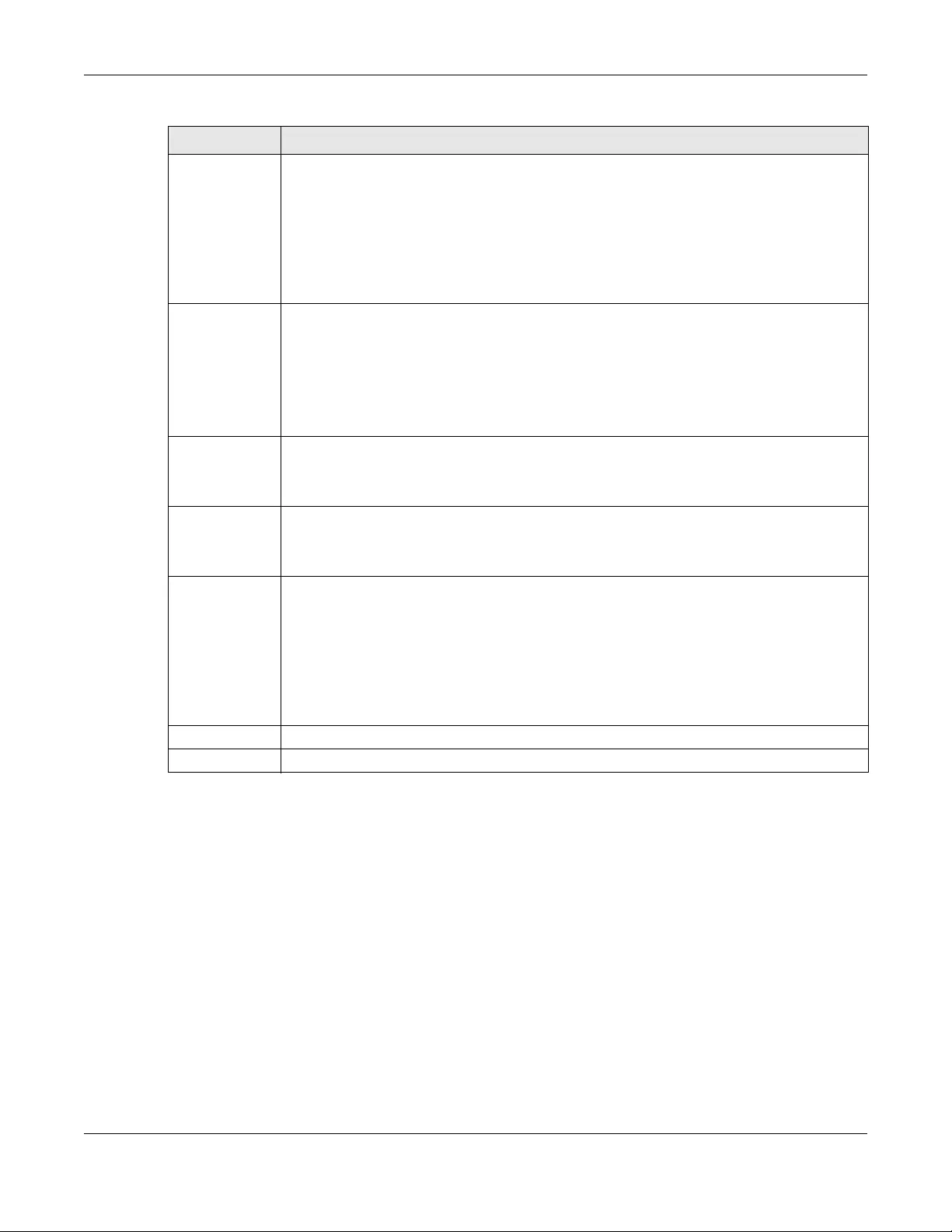
Chapter 37 Log and Report
ZyWALL/USG Series User’s Guide
728
System Log Select which events you want to log by Log Category. There are three choices:
disable all logs (red X) - do not log any information from this category
enable normal logs (green check mark) - create log messages and alerts from this
category
enable normal logs and debug logs (yellow check mark) - create log messages, alerts,
and debugging information from this category; the ZyWALL/USG does not e-mail debugging
information, however, even if this setting is selected.
USB Storage Select which event log categories to save to a connected USB storage device. There are
three choices:
disable all logs (red X) - do not log any information from this category
enable normal logs (green check mark) - save log messages and alerts from this category
enable normal logs and debug logs (yellow check mark) - save log messages, alerts,
and debugging information from this category.
E-mail Server 1
E-mail
Select whether each category of events should be included in the log messages when it is e-
mailed (green check mark) and/or in alerts (red exclamation point) for the e-mail settings
specified in E-Mail Se rver 1 . The ZyWALL/USG does not e-mail debugging information,
even if it is recorded in the System log.
E-mail Server 2
E-mail
Select whether each category of events should be included in log messages when it is e-
mailed (green check mark) and/or in alerts (red exclamation point) for the e-mail settings
specified in E-Mail Se rver 2 . The ZyWALL/USG does not e-mail debugging information,
even if it is recorded in the System log.
Remote Server
1~4
For each remote server, select what information you want to log from each Log Category
(except All Logs; see below). Choices are:
disable all logs (red X) - do not log any information from this category
enable normal logs (green check mark) - log regular information and alerts from this
category
enable normal logs and debug logs (yellow check mark) - log regular information,
alerts, and debugging information from this category
OK Click this to save your changes and return to the previous screen.
Cancel Click this to return to the previous screen without saving your changes.
Table 328 Configuration > Log & Report > Log Setting > Log Category Settings (continued)
LABEL DESCRIPTION

ZyWALL/USG Series User’s Guide
729
CHAPTER 38
File Manager
38.1 Overview
Configuration files define the ZyWALL/USG’s settings. Shell scripts are files of commands that you
can store on the ZyWALL/USG and run when you need them. You can apply a configuration file or
run a shell script without the ZyWALL/USG restarting. You can store multiple configuration files and
shell script files on the ZyWALL/USG. You can edit configuration files or shell scripts in a text editor
and upload them to the ZyWALL/USG. Configuration files use a .conf extension and shell scripts use
a .zysh extension.
38.1.1 What You Can Do in this Chapter
•Use the Configuration File screen (see Section 38.2 on page 731) to store and name
configuration files. You can also download configuration files from the ZyWALL/USG to your
computer and upload configuration files from your computer to the ZyWALL/USG.
•Use the Firmware Package screen (see Section 38.3 on page 735) to check your current
firmware version and upload firmware to the ZyWALL/USG.
•Use the Shell Script screen (see Section 38.4 on page 738) to store, name, download, upload
and run shell script files.
38.1.2 What you Need to Know
Configuration Files and Shell Scripts
When you apply a configuration file, the ZyWALL/USG uses the factory default settings for any
features that the configuration file does not include. When you run a shell script, the ZyWALL/USG
only applies the commands that it contains. Other settings do not change.

Chapter 38 File Manager
ZyWALL/USG Series User’s Guide
730
These files have the same syntax, which is also identical to the way you run CLI commands
manually. An example is shown below.
While configuration files and shell scripts have the same syntax, the ZyWALL/USG applies
configuration files differently than it runs shell scripts. This is explained below.
You have to run the example in Figure 508 on page 730 as a shell script because the first command
is run in Privilege mode. If you remove the first command, you have to run the example as a
configuration file because the rest of the commands are executed in Configuration mode.
Comments in Configuration Files or Shell Scripts
In a configuration file or shell script, use “#” or “!” as the first character of a command line to have
the ZyWALL/USG treat the line as a comment.
Your configuration files or shell scripts can use “exit” or a command line consisting of a single “!” to
have the ZyWALL/USG exit sub command mode.
Note: “exit” or “!'” must follow sub commands if it is to make the ZyWALL/USG exit sub
command mode.
Figure 508 Configuration File / Shell Script: Example
# enter configuration mode
configure terminal
# change administrator password
username admin password 4321 user-type admin
# configure ge3
interface ge3
ip address 172.23.37.240 255.255.255.0
ip gateway 172.23.37.254 metric 1
exit
# create address objects for remote management / to-ZyWALL firewall rules
# use the address group in case we want to open up remote management later
address-object TW_SUBNET 172.23.37.0/24
object-group address TW_TEAM
address-object TW_SUBNET
exit
# enable Telnet access (not enabled by default, unlike other services)
ip telnet server
# open WAN-to-ZyWALL firewall for TW_TEAM for remote management
firewall WAN ZyWALL insert 4
sourceip TW_TEAM
service TELNET
action allow
exit
write
Table 329 Configuration Files and Shell Scripts in the ZyWALL/USG
Configuration Files (.conf) Shell Scripts (.zysh)
• Resets to default configuration.
•Goes into CLI Configuration mode.
• Runs the commands in the configuration file.
•Goes into CLI Privilege mode.
• Runs the commands in the shell script.
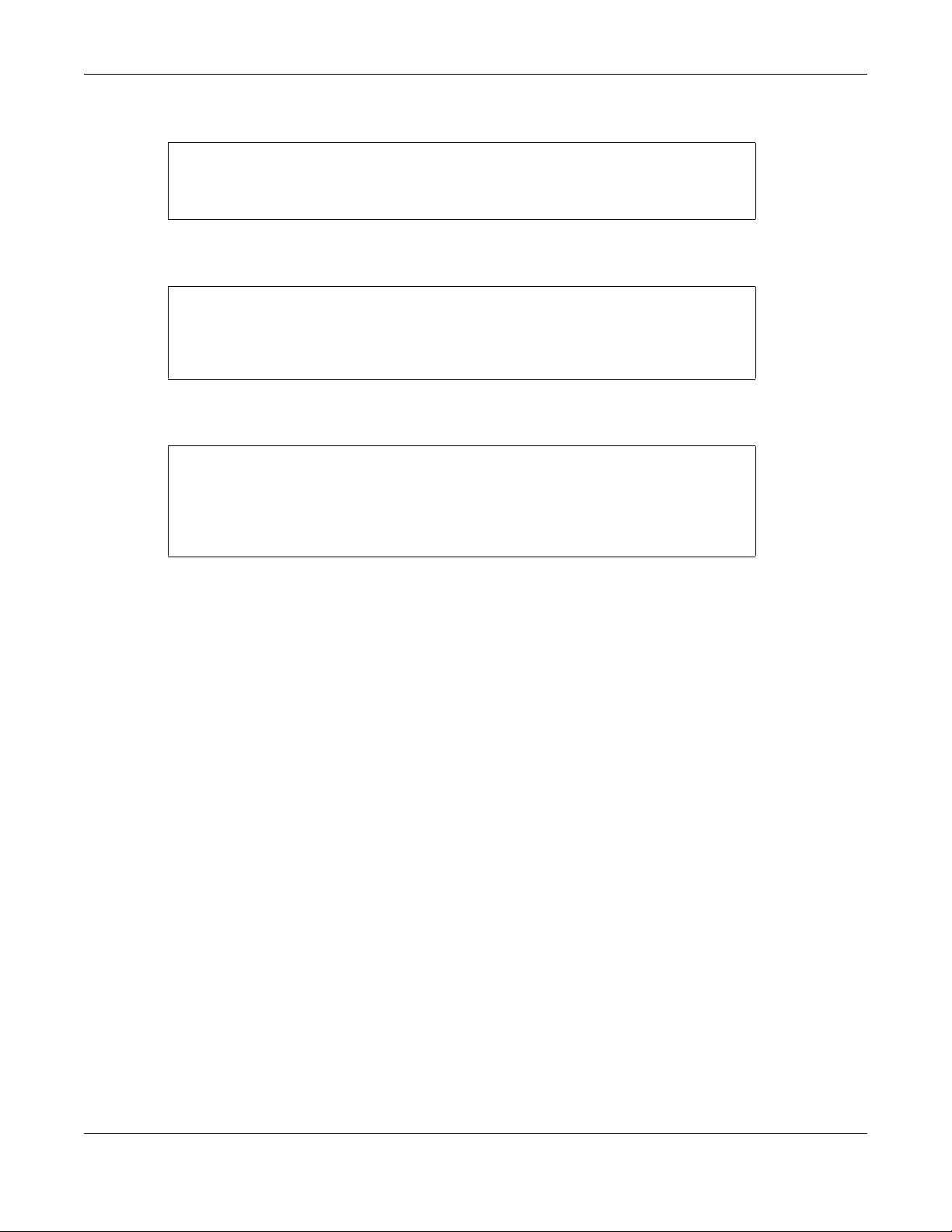
Chapter 38 File Manager
ZyWALL/USG Series User’s Guide
731
Line 3 in the following example exits sub command mode.
Lines 1 and 3 in the following example are comments and line 4 exits sub command mode.
Lines 1 and 2 are comments. Line 5 exits sub command mode.
Errors in Configuration Files or Shell Scripts
When you apply a configuration file or run a shell script, the ZyWALL/USG processes the file line-by-
line. The ZyWALL/USG checks the first line and applies the line if no errors are detected. Then it
continues with the next line. If the ZyWALL/USG finds an error, it stops applying the configuration
file or shell script and generates a log.
You can change the way a configuration file or shell script is applied. Include setenv stop-on-
error off in the configuration file or shell script. The ZyWALL/USG ignores any errors in the
configuration file or shell script and applies all of the valid commands. The ZyWALL/USG still
generates a log for any errors.
38.2 The Configuration File Screen
Click Maintenance > File Manager > Configuration File to open the Configuration File
screen. Use the Configuration File screen to store, run, and name configuration files. You can also
download configuration files from the ZyWALL/USG to your computer and upload configuration files
from your computer to the ZyWALL/USG.
Once your ZyWALL/USG is configured and functioning properly, it is highly recommended that you
back up your configuration file before making further configuration changes. The backup
configuration file will be useful in case you need to return to your previous settings.
interface ge1
ip address dhcp
!
!
interface ge1
# this interface is a DHCP client
!
! this is from Joe
# on 2008/04/05
interface ge1
ip address dhcp
!
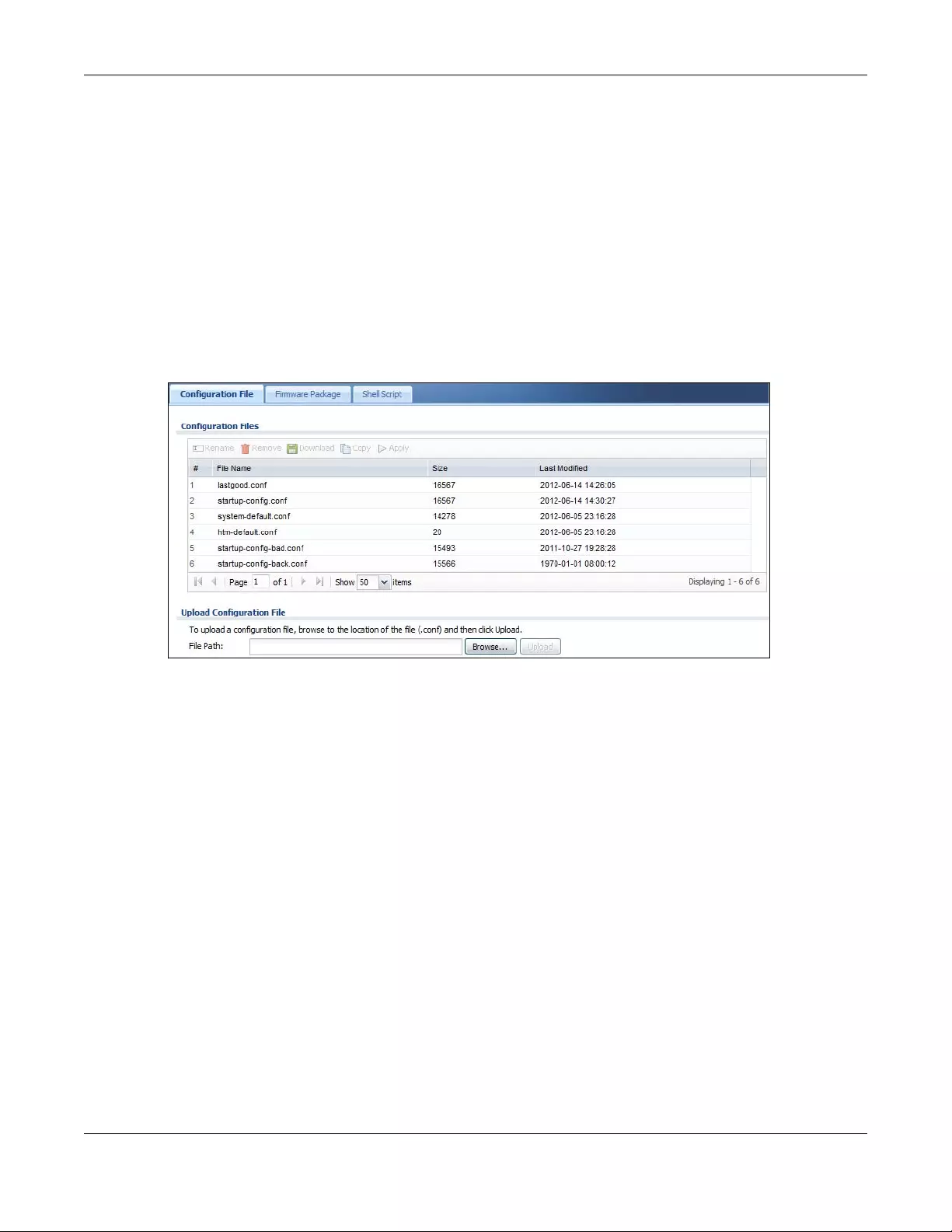
Chapter 38 File Manager
ZyWALL/USG Series User’s Guide
732
Configuration File Flow at Restart
• If there is not a startup-config.conf when you restart the ZyWALL/USG (whether through a
management interface or by physically turning the power off and back on), the ZyWALL/USG
uses the system-default.conf configuration file with the ZyWALL/USG’s default settings.
•If there is a startup-config.conf, the ZyWALL/USG checks it for errors and applies it. If there
are no errors, the ZyWALL/USG uses it and copies it to the lastgood.conf configuration file as a
back up file. If there is an error, the ZyWALL/USG generates a log and copies the startup-
config.conf configuration file to the startup-config-bad.conf configuration file and tries the
existing lastgood.conf configuration file. If there isn’t a lastgood.conf configuration file or it
also has an error, the ZyWALL/USG applies the system-default.conf configuration file.
• You can change the way the startup-config.conf file is applied. Include the setenv-startup
stop-on-error off command. The ZyWALL/USG ignores any errors in the startup-config.conf
file and applies all of the valid commands. The ZyWALL/USG still generates a log for any errors.
Figure 509 Maintenance > File Manager > Configuration File
Do not turn off the ZyWALL/USG while configuration file upload is in
progress.
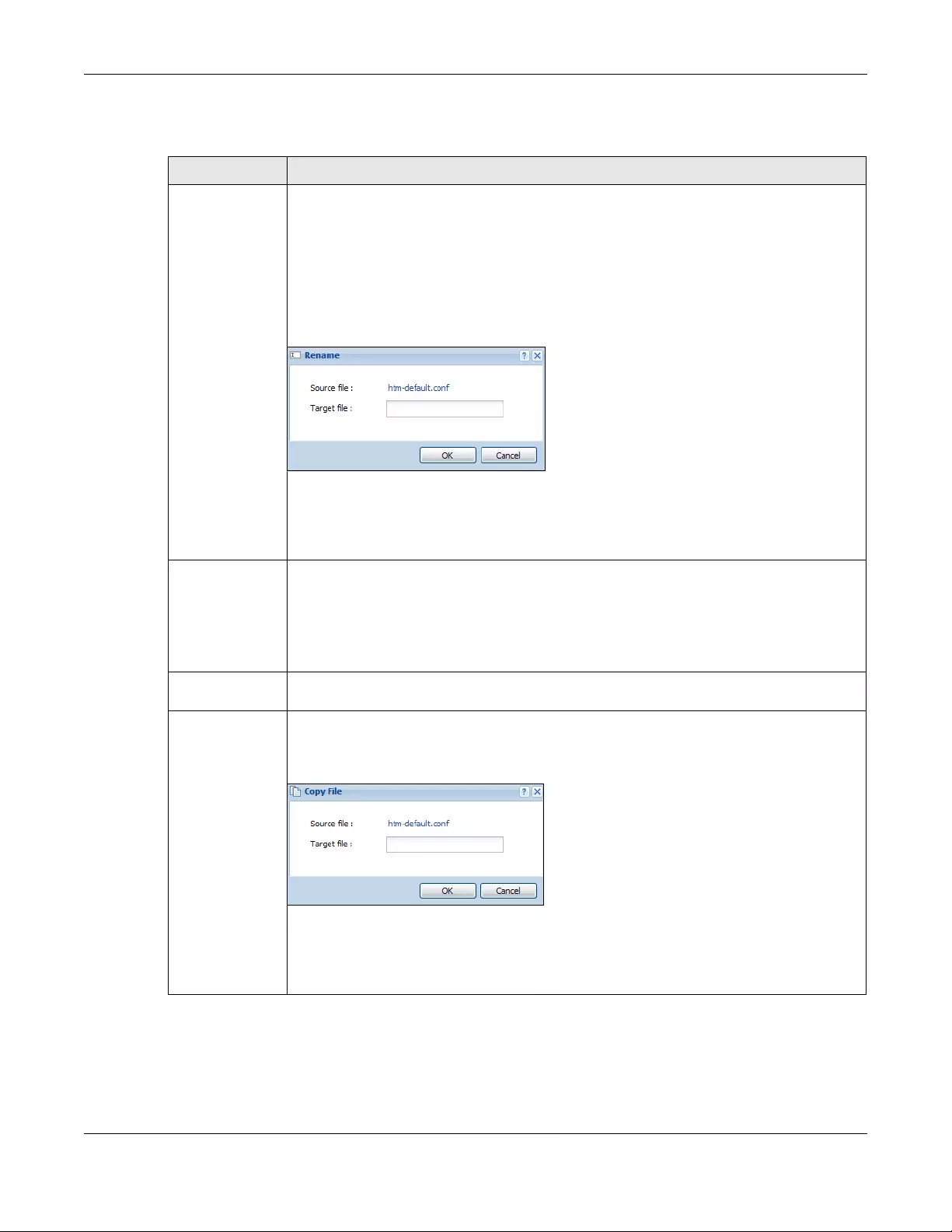
Chapter 38 File Manager
ZyWALL/USG Series User’s Guide
733
The following table describes the labels in this screen.
Table 330 Maintenance > File Manager > Configuration File
LABEL DESCRIPTION
Rename Use this button to change the label of a configuration file on the ZyWALL/USG. You can
only rename manually saved configuration files. You cannot rename the lastgood.conf,
system-default.conf and startup-config.conf files.
You cannot rename a configuration file to the name of another configuration file in the
ZyWALL/USG.
Click a configuration file’s row to select it and click Rename to open the Rename File
screen.
Figure 510 Maintenance > File Manager > Configuration File > Rename
Specify the new name for the configuration file. Use up to 25 characters (including a-zA-
Z0-9;‘~!@#$%^&()_+[]{}’,.=-).
Click OK to save the duplicate or click Cancel to close the screen without saving a
duplicate of the configuration file.
Remove Click a configuration file’s row to select it and click Remove to delete it from the ZyWALL/
USG. You can only delete manually saved configuration files. You cannot delete the
system-default.conf, startup-config.conf and lastgood.conf files.
A pop-up window asks you to confirm that you want to delete the configuration file. Click
OK to delete the configuration file or click Cancel to close the screen without deleting the
configuration file.
Download Click a configuration file’s row to select it and click Download to save the configuration to
your computer.
Copy Use this button to save a duplicate of a configuration file on the ZyWALL/USG.
Click a configuration file’s row to select it and click Copy to open the Copy File screen.
Figure 511 Maintenance > File Manager > Configuration File > Copy
Specify a name for the duplicate configuration file. Use up to 25 characters (including a-
zA-Z0-9;‘~!@#$%^&()_+[]{}’,.=-).
Click OK to save the duplicate or click Cancel to close the screen without saving a
duplicate of the configuration file.
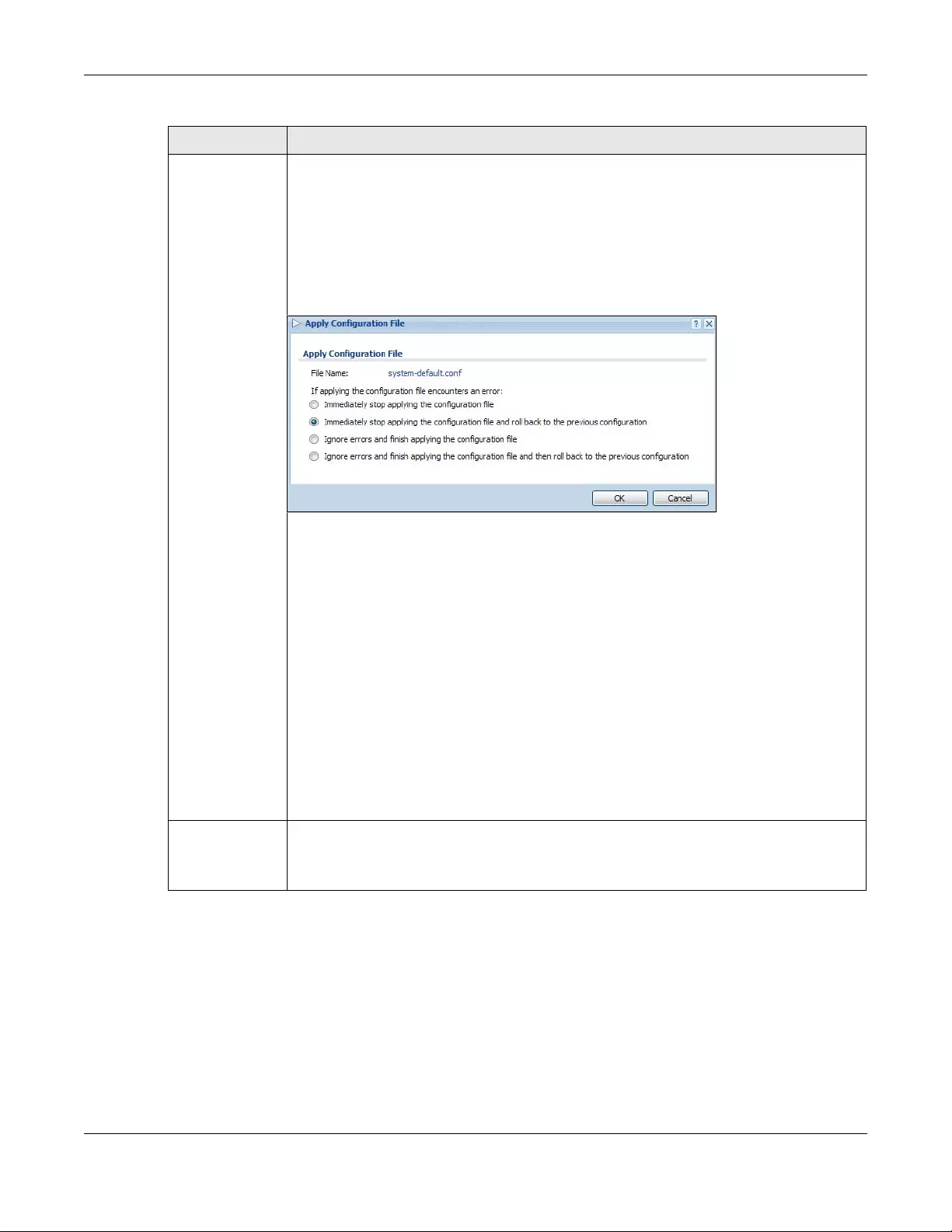
Chapter 38 File Manager
ZyWALL/USG Series User’s Guide
734
Apply Use this button to have the ZyWALL/USG use a specific configuration file.
Click a configuration file’s row to select it and click Apply to have the ZyWALL/USG use
that configuration file. The ZyWALL/USG does not have to restart in order to use a
different configuration file, although you will need to wait for a few minutes while the
system reconfigures.
The following screen gives you options for what the ZyWALL/USG is to do if it encounters
an error in the configuration file.
Figure 512 Maintenance > File Manager > Configuration File > Apply
Immediately stop applying the confi guration file - this is not recommended because
it would leave the rest of the configuration blank. If the interfaces were not configured
before the first error, the console port may be the only way to access the device.
Immediately stop applying the configuration file and roll back to the previous
configuration - this gets the ZyWALL/USG started with a fully valid configuration file as
quickly as possible.
Ignore errors and finish applying the configuration file - this applies the valid parts
of the configuration file and generates error logs for all of the configuration file’s errors.
This lets the ZyWALL/USG apply most of your configuration and you can refer to the logs
for what to fix.
Ignore errors and finish applying the configuration file and then roll back to the
previous configuration - this applies the valid parts of the configuration file, generates
error logs for all of the configuration file’s errors, and starts the ZyWALL/USG with a fully
valid configuration file.
Click OK to have the ZyWALL/USG start applying the configuration file or click Cancel to
close the screen
#This column displays the number for each configuration file entry. This field is a sequential
value, and it is not associated with a specific address. The total number of configuration
files that you can save depends on the sizes of the configuration files and the available
flash storage space.
Table 330 Maintenance > File Manager > Configuration File (continued)
LABEL DESCRIPTION
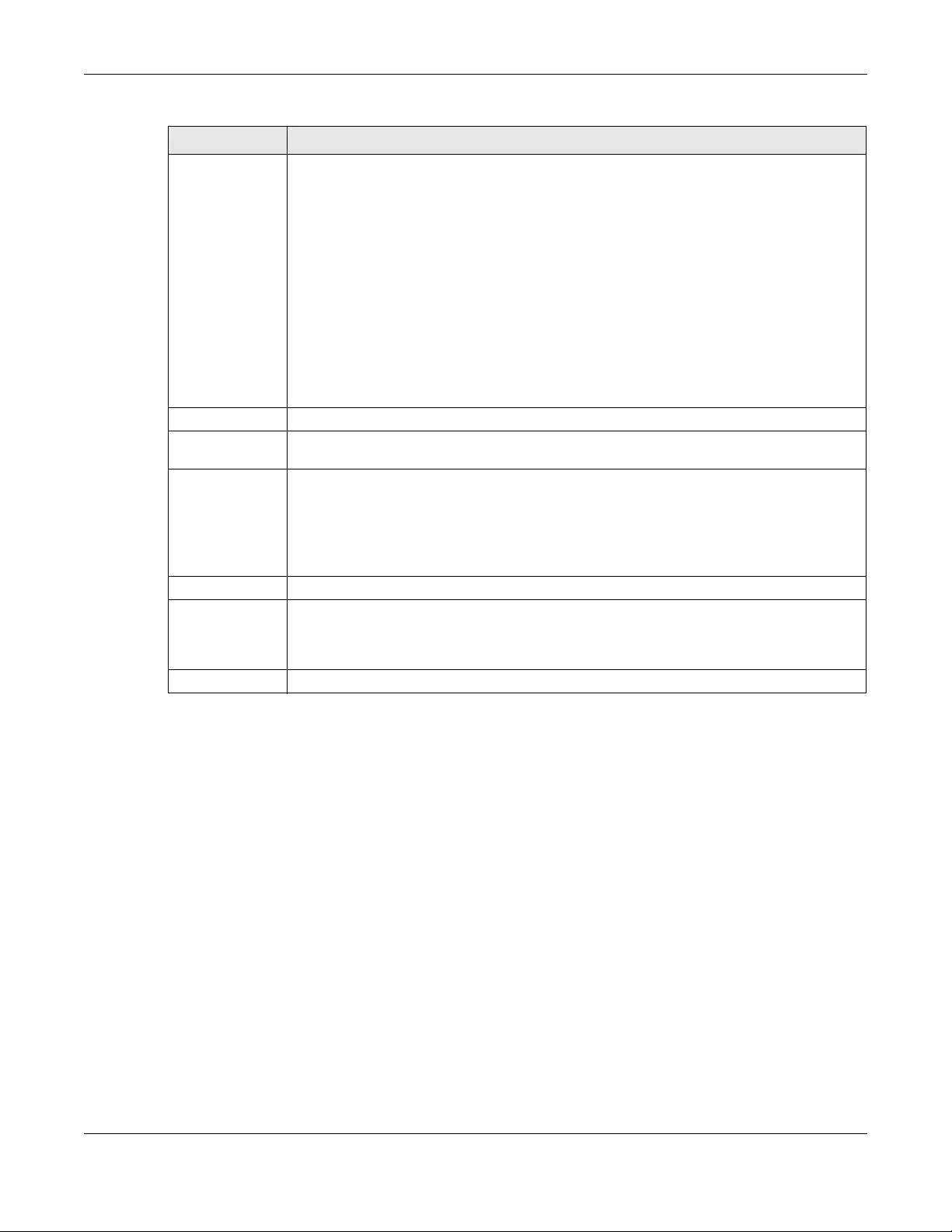
Chapter 38 File Manager
ZyWALL/USG Series User’s Guide
735
38.3 The Firmware Package Screen
Click Maintenance > File Manager > Firmware Package to open the Firmware Package
screen. Use the Firmware Package screen to check your current firmware version and upload
firmware to the ZyWALL/USG. You can upload firmware to be the Running firmware or Standby
firmware.
Note: The Web Configurator is the recommended method for uploading firmware. You
only need to use the command line interface if you need to recover the firmware.
See the CLI Reference Guide for how to determine if you need to recover the
firmware and how to recover it.
Find the firmware package at www.zyxel.com in a file that (usually) uses the system model name
with a .bin extension, for example, “zywall.bin”.
The ZyWALL/USG’s firmware package cannot go through the ZyWALL/USG when you enable the
anti-virus Destroy comp ressed files that could not be decompressed option. The ZyWALL/
USG classifies the firmware package as not being able to be decompressed and deletes it. You can
upload the firmware package to the ZyWALL/USG with the option enabled, so you only need to clear
File Name This column displays the label that identifies a configuration file.
You cannot delete the following configuration files or change their file names.
The system-default.conf file contains the ZyWALL/USG’s default settings. Select this file
and click Apply to reset all of the ZyWALL/USG settings to the factory defaults. This
configuration file is included when you upload a firmware package.
The startup-config.conf file is the configuration file that the ZyWALL/USG is currently
using. If you make and save changes during your management session, the changes are
applied to this configuration file. The ZyWALL/USG applies configuration changes made in
the Web Configurator to the configuration file when you click Apply or OK. It applies
configuration changes made via commands when you use the write command.
The lastgood.conf is the most recently used (valid) configuration file that was saved
when the device last restarted. If you upload and apply a configuration file with an error,
you can apply lastgood.conf to return to a valid configuration.
Size This column displays the size (in KB) of a configuration file.
Last Modified This column displays the date and time that the individual configuration files were last
changed or saved.
Upload
Configuration
File
The bottom part of the screen allows you to upload a new or previously saved
configuration file from your computer to your ZyWALL/USG
You cannot upload a configuration file named system-default.conf or lastgood.conf.
If you upload startup-config.conf, it will replace the current configuration and
immediately apply the new settings.
File Path Type in the location of the file you want to upload in this field or click Browse ... to find it.
Browse... Click Browse... to find the .conf file you want to upload. The configuration file must use a
“.conf” filename extension. You will receive an error message if you try to upload a fie of a
different format. Remember that you must decompress compressed (.zip) files before you
can upload them.
Upload Click Upload to begin the upload process. This process may take up to two minutes.
Table 330 Maintenance > File Manager > Configuration File (continued)
LABEL DESCRIPTION
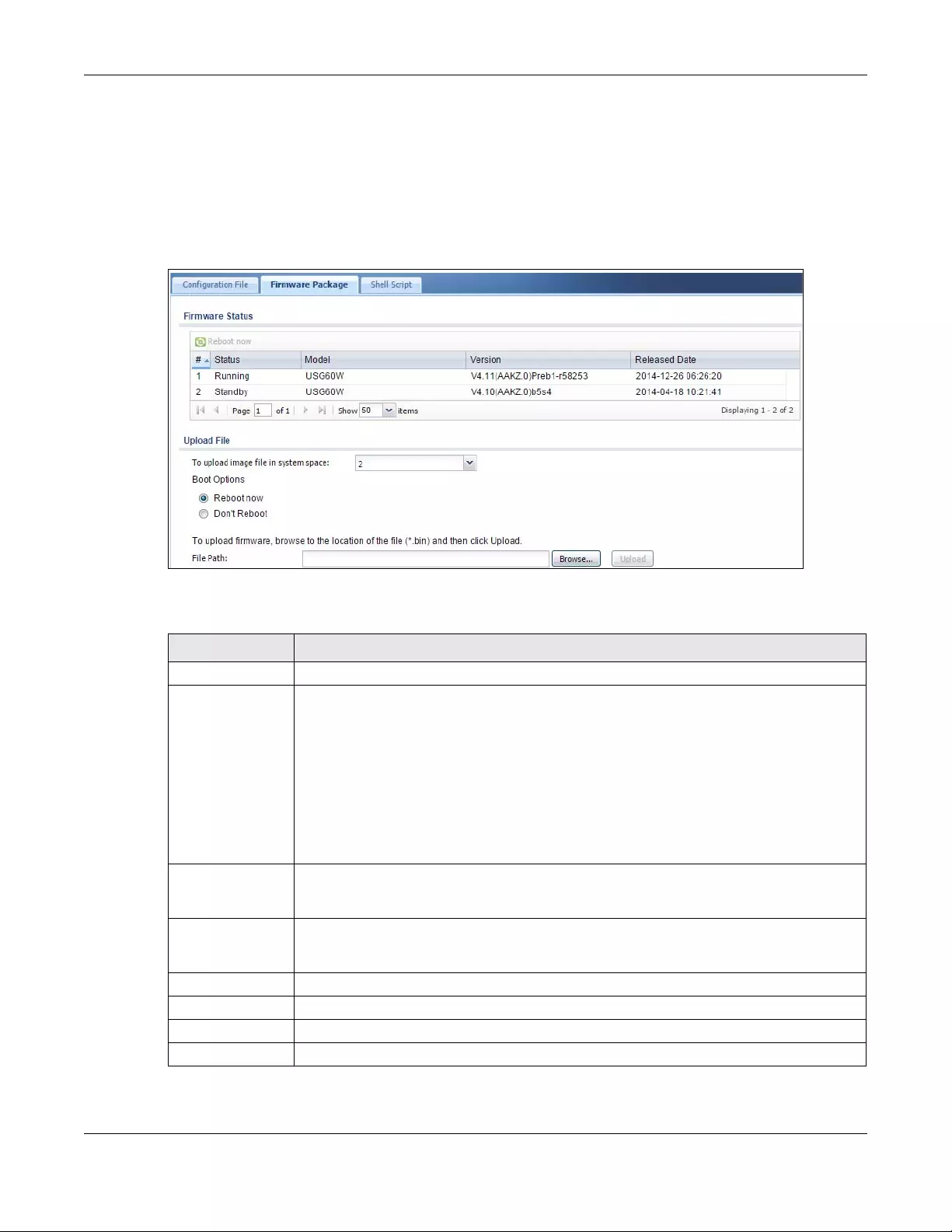
Chapter 38 File Manager
ZyWALL/USG Series User’s Guide
736
the Destroy compressed files that could not be decompressed option while you download the
firmware package. See Section 31.2.1 on page 513 for more on the anti-virus Destroy
compressed files that could not be decompressed option.
The firmware update can take up to five minutes. Do not turn off or reset
the ZyWALL/USG while the firmware update is in progress!
Figure 513 Maintenance > File Manager > Firmware Package
The following table describes the labels in this screen.
Table 331 Maintenance > File Manager > Firmware Package
LABEL DESCRIPTION
Firmware Status
Reboot Now Click the Reboot Now button to restart the ZyWALL/USG. If you applied changes in the
Web configurator, these were saved automatically and do not change when you reboot. If
you made changes in the CLI, however, you have to use the write command to save the
configuration before you reboot. Otherwise, the changes are lost when you reboot.
If you want the Standby firmware to be the Running firmware, then select the Standby
firmware row and click Reboot Now. Wait a few minutes until the login screen appears.
If the login screen does not appear, clear your browser cache and refresh the screen or
type the IP address of the ZyWALL/USG in your Web browser again.
You can also use the CLI command reboot to restart the ZyWALL/USG.
# This displays the system space (partition) index number where the firmwarm is located.
The firmware can be either Standby or Running; only one firmware can be running at
any one time.
Status This indicates whether the firmware is Running, or not running but already uploaded to
the ZyWALL/USG and is on Standby. It displays N/A if there is no firmware uploaded to
that system space.
Model This is the model name of the device which the firmware is running on.
Version This is the firmware version and the date created.
Released Date This is the date that the version of the firmware was created.
Upload File
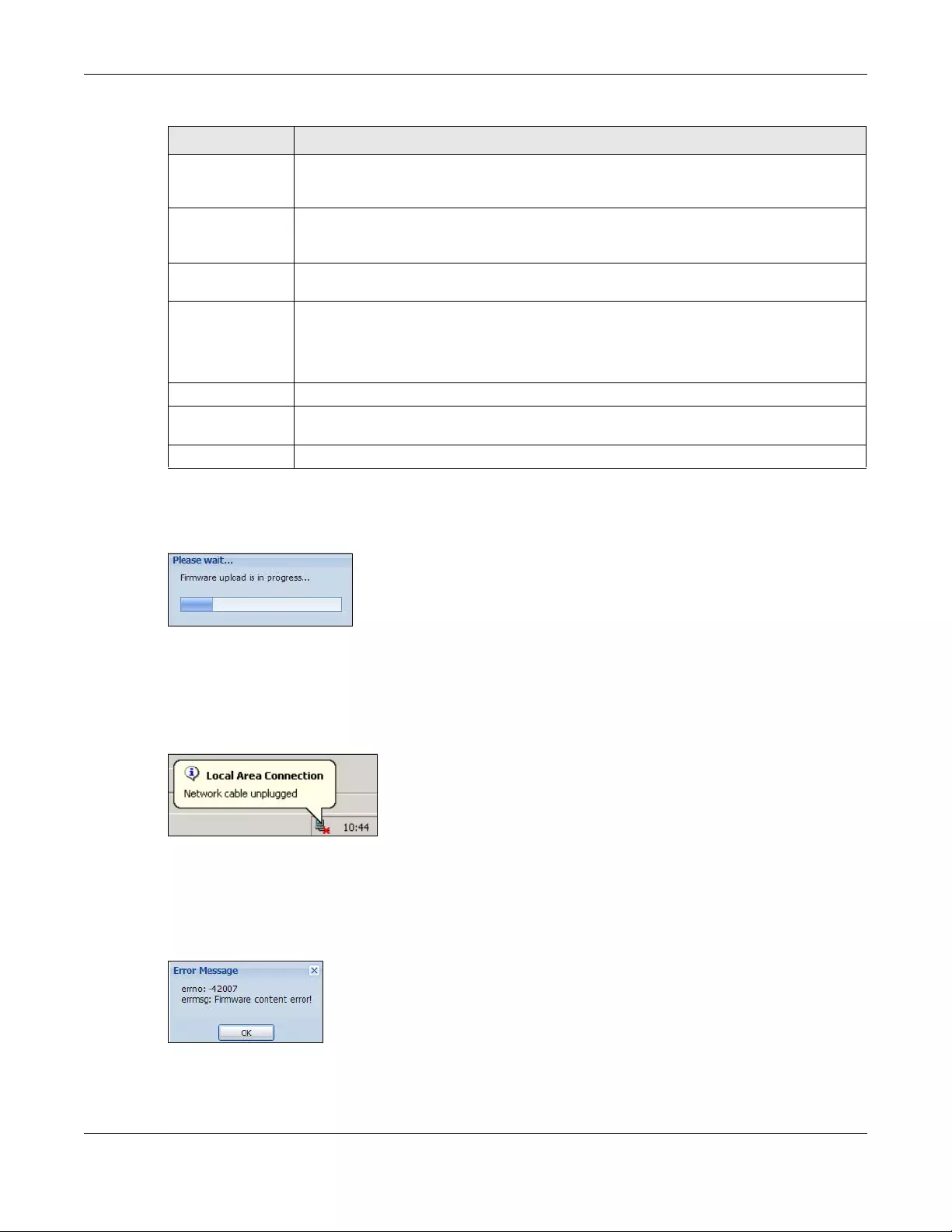
Chapter 38 File Manager
ZyWALL/USG Series User’s Guide
737
After you see the Firmware Upload in Process screen, wait a few minutes before logging into the
ZyWALL/USG again.
Figure 514 Firmware Upload In Process
Note: The ZyWALL/USG automatically reboots after a successful upload.
The ZyWALL/USG automatically restarts causing a temporary network disconnect. In some
operating systems, you may see the following icon on your desktop.
Figure 515 Network
After five minutes, log in again and check your new firmware version in the Dashboard screen.
If the upload was not successful, the following message appears in the status bar at the bottom of
the screen.
Figure 516 Firmware Upload Error
To upload image
file in system
space
Click the To upload image file in system space pull-down menu and select 1 or 2. The
default is the Standby system space, so if you want to upload new firmware to be the
Running firmware, then select the correct system space.
Boot Options If you upload firmware to the Running system space, the ZyWALL/USG will reboot
automatically. If you upload firmware to the Standby system space, you have the option
to Reboot now or Don’t Reboot.
Reboot now If you select Reboot now, then the firmware upload to Standby system space will
become the Running firmware after you click Upload and the upload process completes.
Don’t Reboot If you choose Don’t Reboot, then the firmware upload to Standby system space will be
the Standby firmware after you click Upload and the upload process completes.
If you want the Standby firmware to be the Running firmware, then select the Standby
firmware row in Firmware Status and click Reboot Now.
File Path Type in the location of the file you want to upload in this field or click Browse ... to find it.
Browse... Click Browse... to find the .bin file you want to upload. Remember that you must
decompress compressed (.zip) files before you can upload them.
Upload Click Upload to begin the upload process. This process may take a few minutes.
Table 331 Maintenance > File Manager > Firmware Package (continued)
LABEL DESCRIPTION
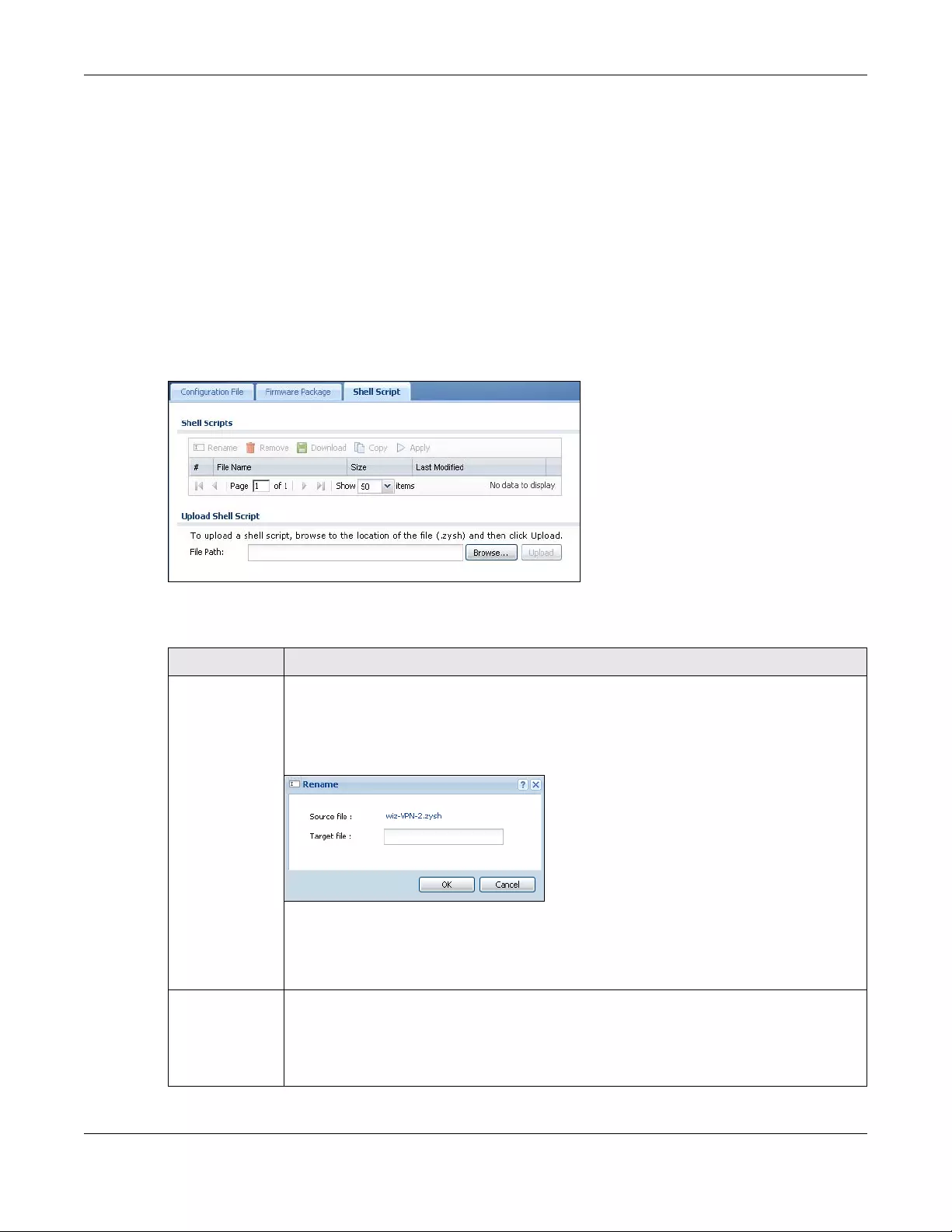
Chapter 38 File Manager
ZyWALL/USG Series User’s Guide
738
38.4 The Shell Script Screen
Use shell script files to have the ZyWALL/USG use commands that you specify. Use a text editor to
create the shell script files. They must use a “.zysh” filename extension.
Click Maintenance > File Manager > Shell Script to open the Shell Script screen. Use the
Shell Script screen to store, name, download, upload and run shell script files. You can store
multiple shell script files on the ZyWALL/USG at the same time.
Note: You should include write commands in your scripts. If you do not use the write
command, the changes will be lost when the ZyWALL/USG restarts. You could use
multiple write commands in a long script.
Figure 517 Maintenance > File Manager > Shell Script
Each field is described in the following table.
Table 332 Maintenance > File Manager > Shell Script
LABEL DESCRIPTION
Rename Use this button to change the label of a shell script file on the ZyWALL/USG.
You cannot rename a shell script to the name of another shell script in the ZyWALL/USG.
Click a shell script’s row to select it and click Rename to open the Rename File screen.
Figure 518 Maintenance > File Manager > Shell Script > Rename
Specify the new name for the shell script file. Use up to 25 characters (including a-zA-Z0-
9;‘~!@#$%^&()_+[]{}’,.=-).
Click OK to save the duplicate or click Cancel to close the screen without saving a
duplicate of the configuration file.
Remove Click a shell script file’s row to select it and click Remove to delete the shell script file from
the ZyWALL/USG.
A pop-up window asks you to confirm that you want to delete the shell script file. Click OK
to delete the shell script file or click Cancel to close the screen without deleting the shell
script file.

Chapter 38 File Manager
ZyWALL/USG Series User’s Guide
739
Download Click a shell script file’s row to select it and click Download to save the configuration to
your computer.
Copy Use this button to save a duplicate of a shell script file on the ZyWALL/USG.
Click a shell script file’s row to select it and click Copy to open the Copy File screen.
Figure 519 Maintenance > File Manager > Shell Script > Copy
Specify a name for the duplicate file. Use up to 25 characters (including a-zA-Z0-
9;‘~!@#$%^&()_+[]{}’,.=-).
Click OK to save the duplicate or click Cancel to close the screen without saving a
duplicate of the configuration file.
Apply Use this button to have the ZyWALL/USG use a specific shell script file.
Click a shell script file’s row to select it and click Apply to have the ZyWALL/USG use that
shell script file. You may need to wait awhile for the ZyWALL/USG to finish applying the
commands.
#This column displays the number for each shell script file entry.
File Name This column displays the label that identifies a shell script file.
Size This column displays the size (in KB) of a shell script file.
Last Modified This column displays the date and time that the individual shell script files were last
changed or saved.
Upload Shell
Script
The bottom part of the screen allows you to upload a new or previously saved shell script
file from your computer to your ZyWALL/USG.
File Path Type in the location of the file you want to upload in this field or click Browse ... to find it.
Browse... Click Browse... to find the .zysh file you want to upload.
Upload Click Upload to begin the upload process. This process may take up to several minutes.
Table 332 Maintenance > File Manager > Shell Script (continued)
LABEL DESCRIPTION
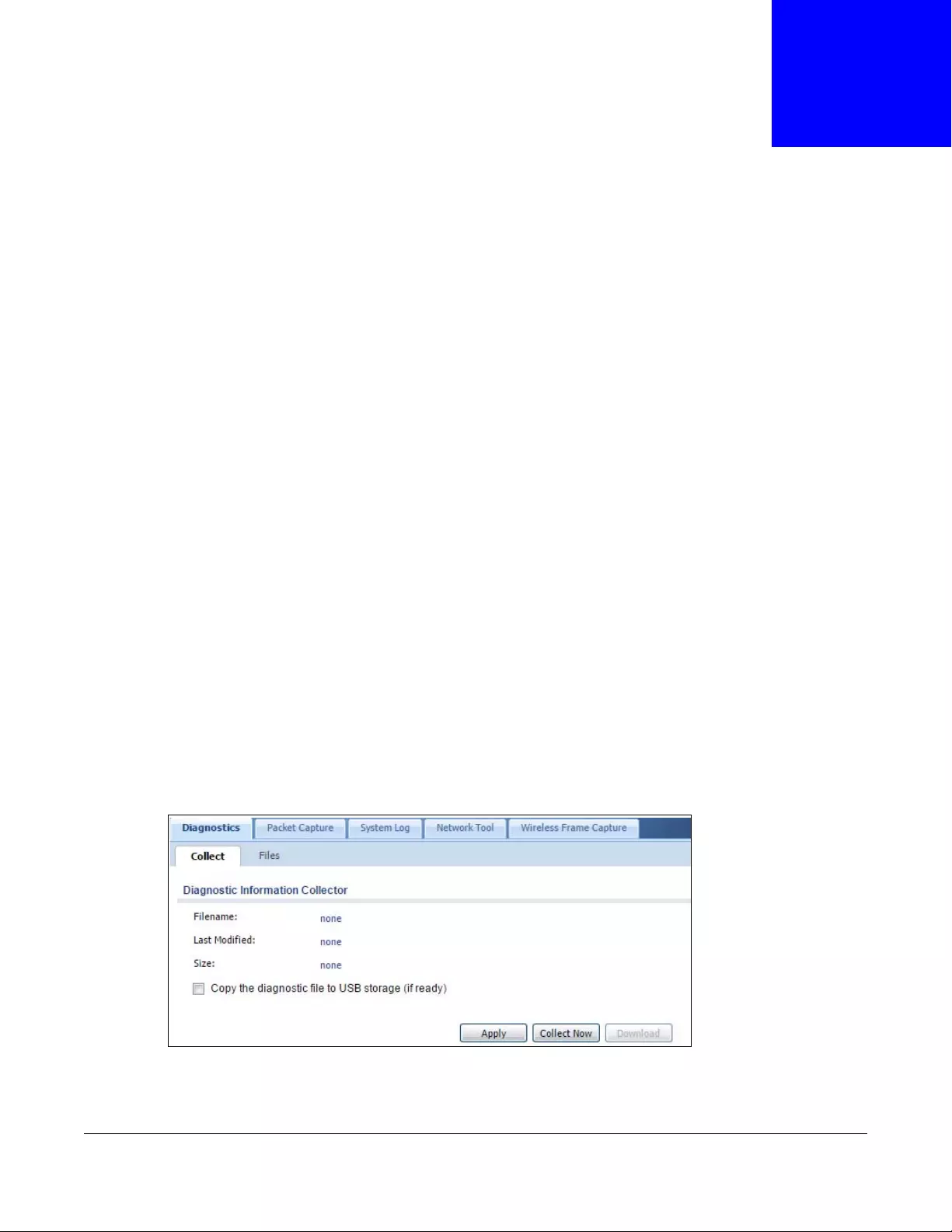
ZyWALL/USG Series User’s Guide
740
CHAPTER 39
Diagnostics
39.1 Overview
Use the diagnostics screens for troubleshooting.
39.1.1 What You Can Do in this Chapter
•Use the Diagnostics screen (see Section 39.2 on page 740) to generate a file containing the
ZyWALL/USG’s configuration and diagnostic information if you need to provide it to customer
support during troubleshooting.
•Use the Packet Capture screens (see Section 39.3 on page 742) to capture packets going
through the ZyWALL/USG.
•Use the Network Tool screen (see Section 39.5 on page 746) to ping an IP address or trace the
route packets take to a host.
•Use the Wireless Frame Capture screens (see Section 39.6 on page 747) to capture network
traffic going through the AP interfaces connected to your ZyWALL/USG.
39.2 The Diagnostic Screen
The Diagnostic screen provides an easy way for you to generate a file containing the ZyWALL/
USG’s configuration and diagnostic information. You may need to send this file to customer support
for troubleshooting.
Click Maintenance > Diagnostics to open the Diagnostic screen.
Figure 520 Maintenance > Diagnostics

Chapter 39 Diagnostics
ZyWALL/USG Series User’s Guide
741
The following table describes the labels in this screen.
39.2.1 The Diagnostics Files Screen
Click Maintenance > Diagnostics > Files to open the diagnostic files screen. This screen lists the
files of diagnostic information the ZyWALL/USG has collected and stored in a connected USB
storage device. You may need to send these files to customer support for troubleshooting.
Figure 521 Maintenance > Diagnostics > Files
The following table describes the labels in this screen.
Table 333 Maintenance > Diagnostics
LABEL DESCRIPTION
Filename This is the name of the most recently created diagnostic file.
Last modified This is the date and time that the last diagnostic file was created. The format is
yyyy-mm-dd hh:mm:ss.
Size This is the size of the most recently created diagnostic file.
Copy the diagnostic file to
USB storage (if ready)
Select this to have the ZyWALL/USG create an extra copy of the diagnostic file
to a connected USB storage device.
Apply Click Apply to save your changes.
Collect Now Click this to have the ZyWALL/USG create a new diagnostic file.
Wait while information is collected.
Download Click this to save the most recent diagnostic file to a computer.
Table 334 Maintenance > Diagnostics > Files
LABEL DESCRIPTION
Remove Select files and click Remove to delete them from the ZyWALL/USG. Use the [Shift] and/or
[Ctrl] key to select multiple files. A pop-up window asks you to confirm that you want to
delete.
Download Click a file to select it and click Download to save it to your computer.
#This column displays the number for each file entry. The total number of files that you can
save depends on the file sizes and the available storage space.
File Name This column displays the label that identifies the file.
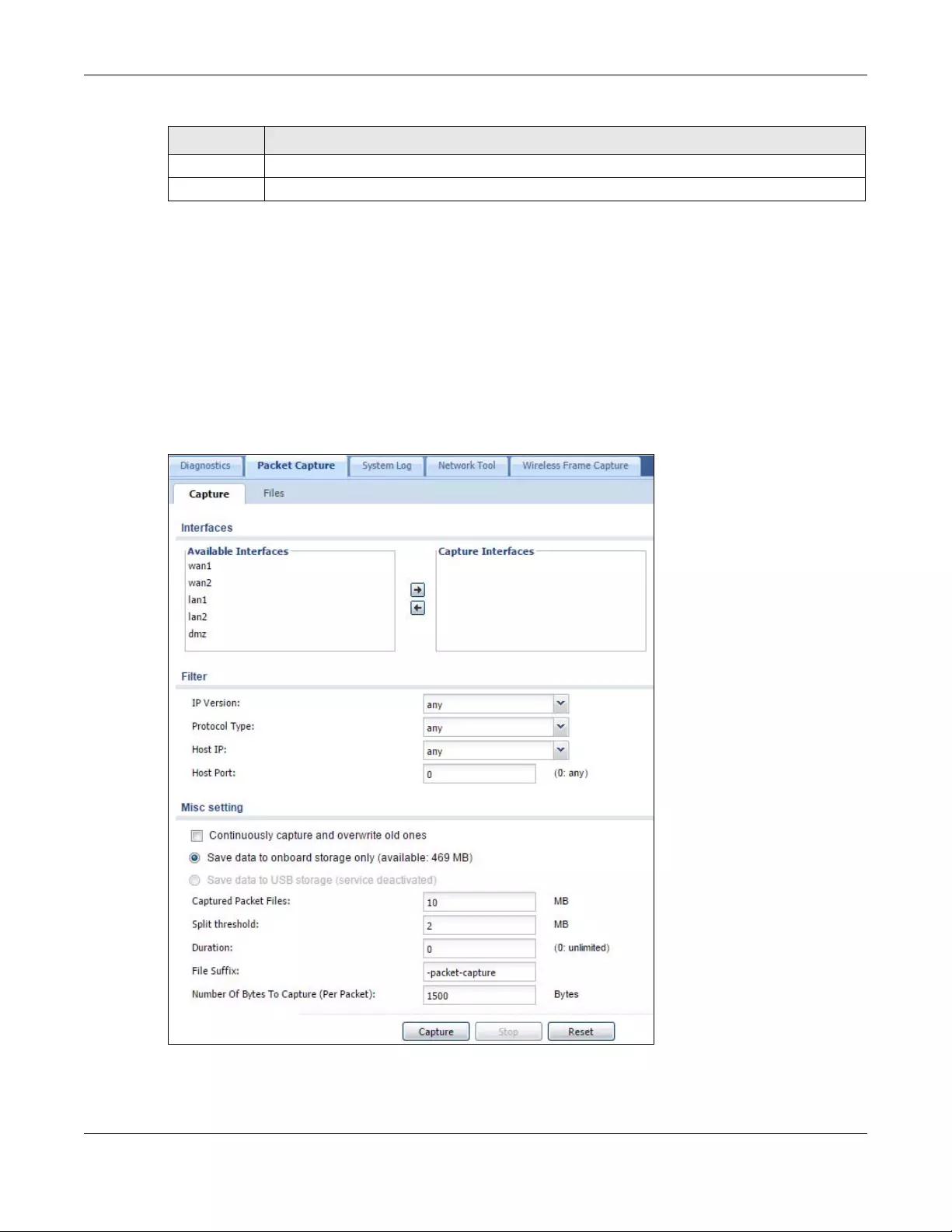
Chapter 39 Diagnostics
ZyWALL/USG Series User’s Guide
742
39.3 The Packet Capture Screen
Use this screen to capture network traffic going through the ZyWALL/USG’s interfaces. Studying
these packet captures may help you identify network problems. Click Maintenance > Diagnostics
> Packet Capture to open the packet capture screen.
Note: New capture files overwrite existing files of the same name. Change the File Suffix
field’s setting to avoid this.
Figure 522 Maintenance > Diagnostics > Packet Capture
Size This column displays the size (in bytes) of a file.
Last Modified This column displays the date and time that the individual files were saved.
Table 334 Maintenance > Diagnostics > Files (continued)
LABEL DESCRIPTION
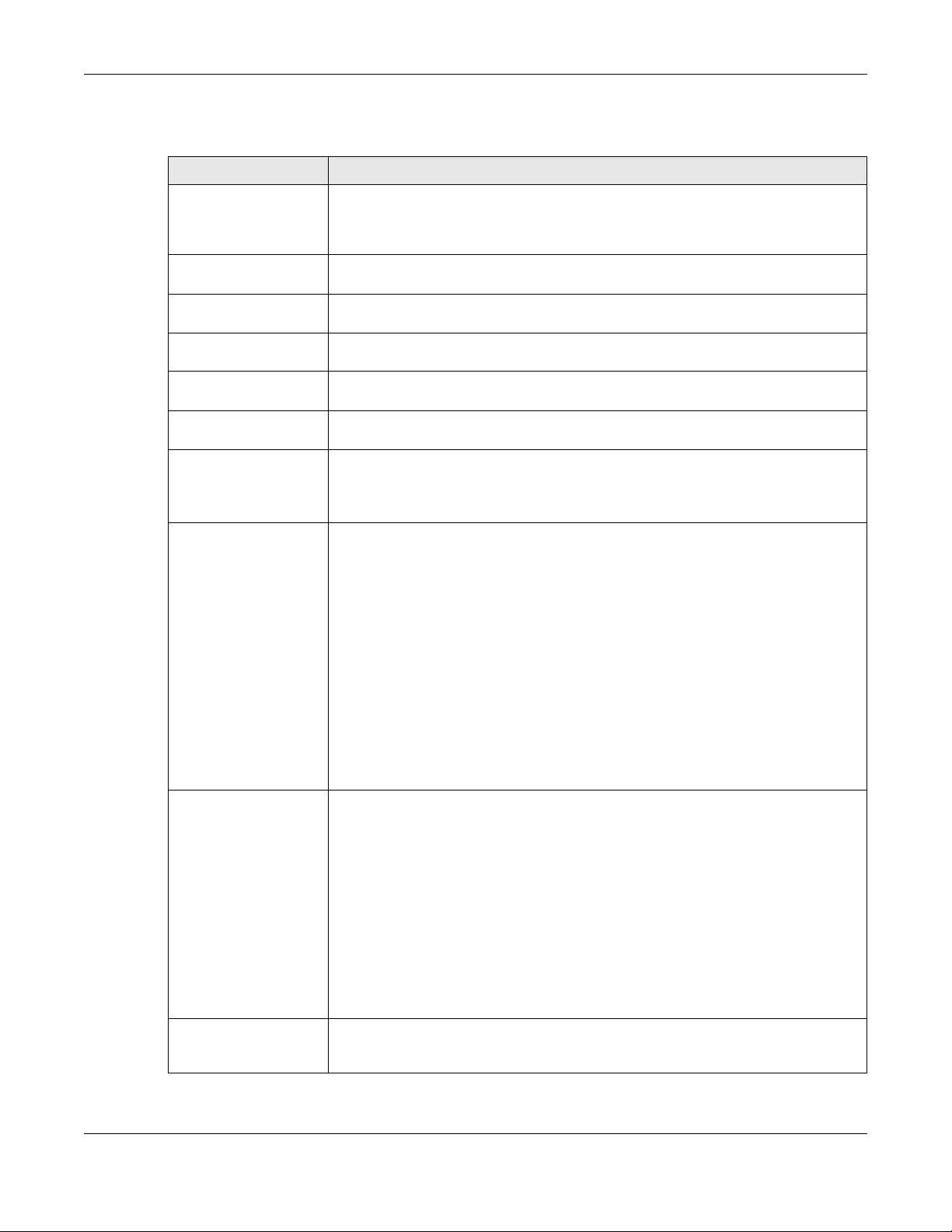
Chapter 39 Diagnostics
ZyWALL/USG Series User’s Guide
743
The following table describes the labels in this screen.
Table 335 Maintenance > Diagnostics > Packet Capture
LABEL DESCRIPTION
Interfaces Enabled interfaces (except for virtual interfaces) appear under Available
Interfaces. Select interfaces for which to capture packets and click the right arrow
button to move them to the Capture Interfaces list. Use the [Shift] and/or [Ctrl]
key to select multiple objects.
IP Version Select the version of IP for which to capture packets. Select any to capture packets
for all IP versions.
Protocol Type Select the protocol of traffic for which to capture packets. Select any to capture
packets for all types of traffic.
Host IP Select a host IP address object for which to capture packets. Select any to capture
packets for all hosts. Select User Defined to be able to enter an IP address.
Host Port This field is configurable when you set the IP Type to any, tcp, or udp. Specify the
port number of traffic to capture.
Continuously capture
and overwrite old ones
Select this to have the ZyWALL/USG keep capturing traffic and overwriting old
packet capture entries when the available storage space runs out.
Save data to onboard
storage only
Select this to have the ZyWALL/USG only store packet capture entries on the
ZyWALL/USG. The available storage size is displayed as well.
Note: The ZyWALL/USG reserves some onboard storage space as a buffer.
Save data to USB
storage
Select this to have the ZyWALL/USG store packet capture entries only on a USB
storage device connected to the ZyWALL/USG if the ZyWALL/USG allows this.
Status:
Unused - the connected USB storage device was manually unmounted by using the
Remove Now button or for some reason the ZyWALL/USG cannot mount it.
none - no USB storage device is connected.
service deactivated - USB storage feature is disabled (in Configuration >
Object > USB Storage), so the ZyWALL/USG cannot use a connected USB device
to store system logs and other diagnostic information.
available - you can have the ZyWALL/USG use the USB storage device. The
available storage capacity also displays.
Note: The ZyWALL/USG reserves some USB storage space as a buffer.
Captured Packet Files When saving packet captures only to the ZyWALL/USG’s onboard storage, specify a
maximum limit in megabytes for the total combined size of all the capture files on
the ZyWALL/USG.
When saving packet captures to a connected USB storage device, specify a
maximum limit in megabytes for each capture file.
Note: If you have existing capture files and have not selected the Continuously
capture and overwrite old ones option, you may need to set this size larger
or delete existing capture files.
The valid range depends on the available onboard/USB storage size. The ZyWALL/
USG stops the capture and generates the capture file when either the file reaches
this size or the time period specified in the Duration field expires.
Split threshold Specify a maximum size limit in megabytes for individual packet capture files. After
a packet capture file reaches this size, the ZyWALL/USG starts another packet
capture file.
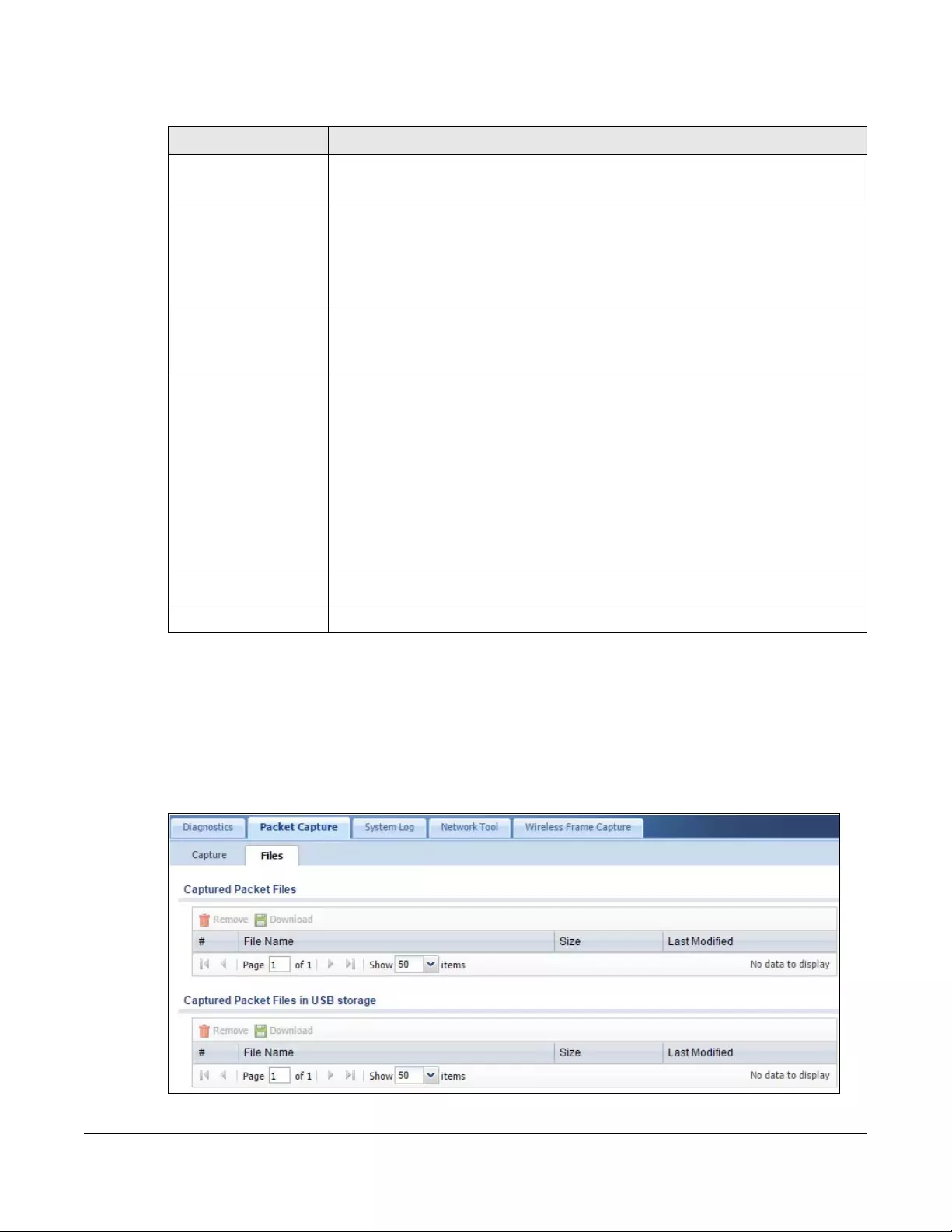
Chapter 39 Diagnostics
ZyWALL/USG Series User’s Guide
744
39.3.1 The Packet Capture Files Screen
Click Maintenance > Diagnostics > Packet Capture > Files to open the packet capture files
screen. This screen lists the files of packet captures stored on the ZyWALL/USG or a connected USB
storage device. You can download the files to your computer where you can study them using a
packet analyzer (also known as a network or protocol analyzer) such as Wireshark.
Figure 523 Maintenance > Diagnostics > Packet Capture > Files
Duration Set a time limit in seconds for the capture. The ZyWALL/USG stops the capture and
generates the capture file when either this period of time has passed or the file
reaches the size specified in the File Size field. 0 means there is no time limit.
File Suffix Specify text to add to the end of the file name (before the dot and filename
extension) to help you identify the packet capture files. Modifying the file suffix also
avoids making new capture files that overwrite existing files of the same name.
The file name format is “interface name-file suffix.cap”, for example “vlan2-packet-
capture.cap”.
Number Of Bytes To
Capture (Per Packet)
Specify the maximum number of bytes to capture per packet. The ZyWALL/USG
automatically truncates packets that exceed this size. As a result, when you view
the packet capture files in a packet analyzer, the actual size of the packets may be
larger than the size of captured packets.
Capture Click this button to have the ZyWALL/USG capture packets according to the settings
configured in this screen.
You can configure the ZyWALL/USG while a packet capture is in progress although
you cannot modify the packet capture settings.
The ZyWALL/USG’s throughput or performance may be affected while a packet
capture is in progress.
After the ZyWALL/USG finishes the capture it saves a separate capture file for each
selected interface. The total number of packet capture files that you can save
depends on the file sizes and the available flash storage space. Once the flash
storage space is full, adding more packet captures will fail.
Stop Click this button to stop a currently running packet capture and generate a separate
capture file for each selected interface.
Reset Click this button to return the screen to its last-saved settings.
Table 335 Maintenance > Diagnostics > Packet Capture (continued)
LABEL DESCRIPTION
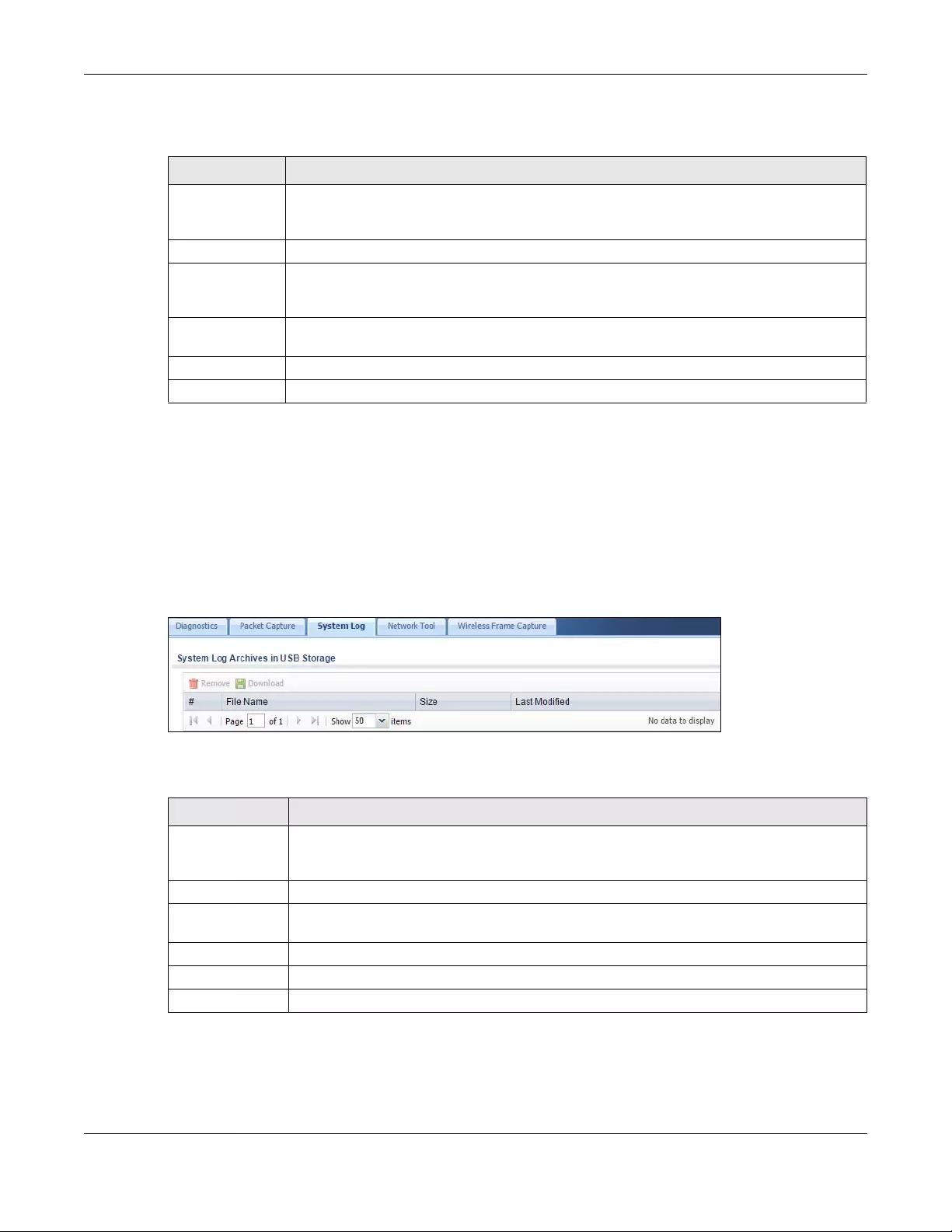
Chapter 39 Diagnostics
ZyWALL/USG Series User’s Guide
745
The following table describes the labels in this screen.
39.4 The System Log Screen
Click Main tenance > Diagnostics > System Log to open the system log files screen. This screen
lists the files of system logs stored on a connected USB storage device. The files are in comma
separated value (csv) format. You can download them to your computer and open them in a tool
like Microsoft’s Excel.
Figure 524 Maintenance > Diagnostics > System Log
The following table describes the labels in this screen.
Table 336 Maintenance > Diagnostics > Packet Capture > Files
LABEL DESCRIPTION
Remove Select files and click Remove to delete them from the ZyWALL/USG or the connected USB
storage device. Use the [Shift] and/or [Ctrl] key to select multiple files. A pop-up window
asks you to confirm that you want to delete.
Download Click a file to select it and click Download to save it to your computer.
#This column displays the number for each packet capture file entry. The total number of
packet capture files that you can save depends on the file sizes and the available flash
storage space.
File Name This column displays the label that identifies the file. The file name format is interface
name-file suffix.cap.
Size This column displays the size (in bytes) of a configuration file.
Last Modified This column displays the date and time that the individual files were saved.
Table 337 Maintenance > Diagnostics > System Log
LABEL DESCRIPTION
Remove Select files and click Remove to delete them from the ZyWALL/USG. Use the [Shift] and/
or [Ctrl] key to select multiple files. A pop-up window asks you to confirm that you want to
delete.
Download Click a file to select it and click Download to save it to your computer.
#This column displays the number for each file entry. The total number of files that you can
save depends on the file sizes and the available storage space.
File Name This column displays the label that identifies the file.
Size This column displays the size (in bytes) of a file.
Last Modified This column displays the date and time that the individual files were saved.

Chapter 39 Diagnostics
ZyWALL/USG Series User’s Guide
746
39.5 The Network Tool Screen
Use this screen to ping or traceroute an IP address.
Click Maintenance > Diagnostics > Network Tool to display this screen.
Figure 525 Maintenance > Diagnostics > Network Tool
The following table describes the labels in this screen.
Table 338 Maintenance > Diagnostics > Network Tool
LABEL DESCRIPTION
Network Tool Select PING IPv4 to ping the IP address that you entered.
Select TRACEROUTE IPv4 to perform the traceroute function. This determines the
path a packet takes to the specified computer.
Domain Name or IP
Address
Type the IPv4 address of a computer that you want to perform ping or traceroute in
order to test a connection.
Test Click this button to start to ping or run a traceroute.
Stop Click this button to terminate the current ping operation or traceroute.
Reset Click this button to return the screen to its last-saved settings.

Chapter 39 Diagnostics
ZyWALL/USG Series User’s Guide
747
39.6 The Wireless Frame Capture Screen
Use this screen to capture wireless network traffic going through the AP interfaces connected to
your ZyWALL/USG. Studying these frame captures may help you identify network problems.
Click Maintenance > Diagnostics > Wireless Frame Capture to display this screen.
Note: New capture files overwrite existing files of the same name. Change the File Prefix
field’s setting to avoid this.
Figure 526 Maintenance > Diagnostics > Wireless Frame Capture > Capture
The following table describes the labels in this screen.
Table 339 Maintenance > Diagnostics > Wireless Frame Capture > Capture
LABEL DESCRIPTION
MON Mode APs
Configure AP to
MON Mode Click this to go the Configuration > Wireless > AP Management screen, where
you can set one or more APs to monitor mode.
Available MON
Mode APs This column displays which APs on your wireless network are currently configured
for monitor mode.
Use the arrow buttons to move APs off this list and onto the Captured MON Mode
APs list.
Capture MON Mode
APs This column displays the monitor-mode configured APs selected to for wireless
frame capture.
Misc Setting
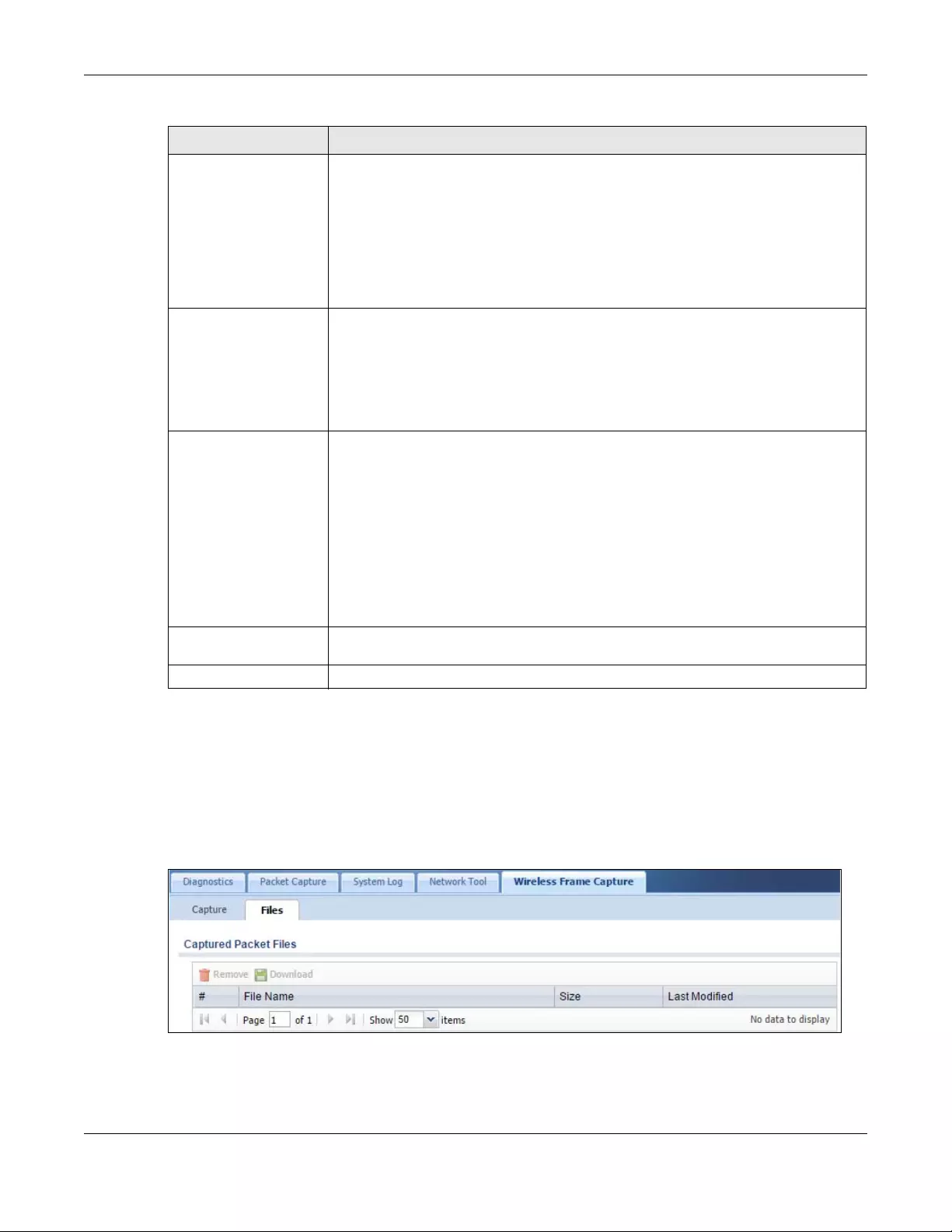
Chapter 39 Diagnostics
ZyWALL/USG Series User’s Guide
748
39.6.1 The Wireless Frame Capture Files Screen
Click Maintenance > Diagnostics > Wireless Frame Captu re > Files to open this screen. This
screen lists the files of wireless frame captures the ZyWALL/USG has performed. You can download
the files to your computer where you can study them using a packet analyzer (also known as a
network or protocol analyzer) such as Wireshark.
Figure 527 Maintenance > Diagnostics > Wireless Frame Capture > Files
File Size Specify a maximum size limit in kilobytes for the total combined size of all the
capture files on the ZyWALL/USG, including any existing capture files and any new
capture files you generate.
Note: If you have existing capture files you may need to set this size larger or delete
existing capture files.
The valid range is 1 to 50000. The ZyWALL/USG stops the capture and generates
the capture file when either the file reaches this size.
File Prefix Specify text to add to the front of the file name in order to help you identify frame
capture files.
You can modify the prefix to also create new frame capture files each time you
perform a frame capture operation. Doing this does no overwrite existing frame
capture files.
The file format is: [file prefix].cap. For example, “monitor.cap”.
Capture Click this button to have the ZyWALL/USG capture frames according to the settings
configured in this screen.
You can configure the ZyWALL/USG while a frame capture is in progress although
you cannot modify the frame capture settings.
The ZyWALL/USG’s throughput or performance may be affected while a frame
capture is in progress.
After the ZyWALL/USG finishes the capture it saves a combined capture file for all
APs. The total number of frame capture files that you can save depends on the file
sizes and the available flash storage space. Once the flash storage space is full,
adding more frame captures will fail.
Stop Click this button to stop a currently running frame capture and generate a combined
capture file for all APs.
Reset Click this button to return the screen to its last-saved settings.
Table 339 Maintenance > Diagnostics > Wireless Frame Capture > Capture (continued)
LABEL DESCRIPTION
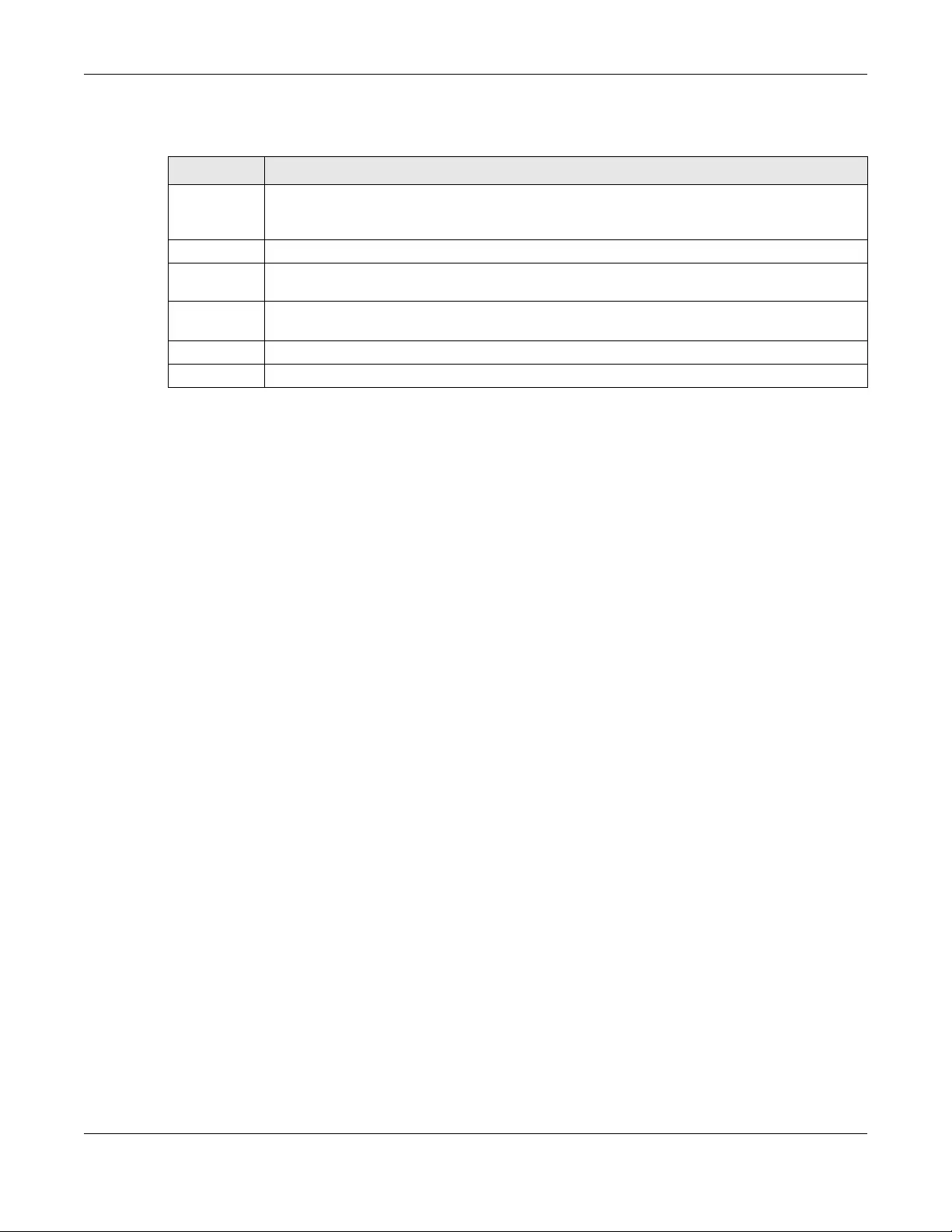
Chapter 39 Diagnostics
ZyWALL/USG Series User’s Guide
749
The following table describes the labels in this screen.
Table 340 Maintenance > Diagnostics > Wireless Frame Capture > Files
LABEL DESCRIPTION
Remove Select files and click Remove to delete them from the ZyWALL/USG. Use the [Shift] and/or
[Ctrl] key to select multiple files. A pop-up window asks you to confirm that you want to
delete.
Download Click a file to select it and click Download to save it to your computer.
#This column displays the number for each packet capture file entry. The total number of packet
capture files that you can save depends on the file sizes and the available flash storage space.
File Name This column displays the label that identifies the file. The file name format is interface name-
file suffix.cap.
Size This column displays the size (in bytes) of a configuration file.
Last Modified This column displays the date and time that the individual files were saved.

ZyWALL/USG Series User’s Guide
750
CHAPTER 40
Packet Flow Explore
40.1 Overview
Use this to get a clear picture on how the ZyWALL/USG determines where to forward a packet and
how to change the source IP address of the packet according to your current settings. This function
provides you a summary of all your routing and SNAT settings and helps troubleshoot any related
problems.
40.1.1 What You Can Do in this Chapter
•Use the Routing Status screen (see Section 40.2 on page 750) to view the overall routing flow
and each routing function’s settings.
•Use the SNAT Status screen (see Section 40.3 on page 755) to view the overall source IP
address conversion (SNAT) flow and each SNAT function’s settings.
40.2 The Routing Status Screen
The Routing Status screen allows you to view the current routing flow and quickly link to specific
routing settings. Click a function box in the Routing Flow section, the related routes (activated)
will display in the Routing Table section. To access this screen, click Maintenance > Packet
Flow Explore.
The order of the routing flow may vary depending on whether you:
•Select use policy route to override direct route in the CONFIGURATION > Network >
Routing > Policy Route screen.
• Use policy routes to control 1-1 NAT by using the policy control-virtual- server-r ules
activate command.
•Select use policy routes to control dynamic IPSec rules in the CONFIGU RATION > VPN >
IPSec VPN > VPN Connection screen.
Note: Once a packet matches the criteria of a routing rule, the ZyWALL/USG takes the
corresponding action and does not perform any further flow checking.
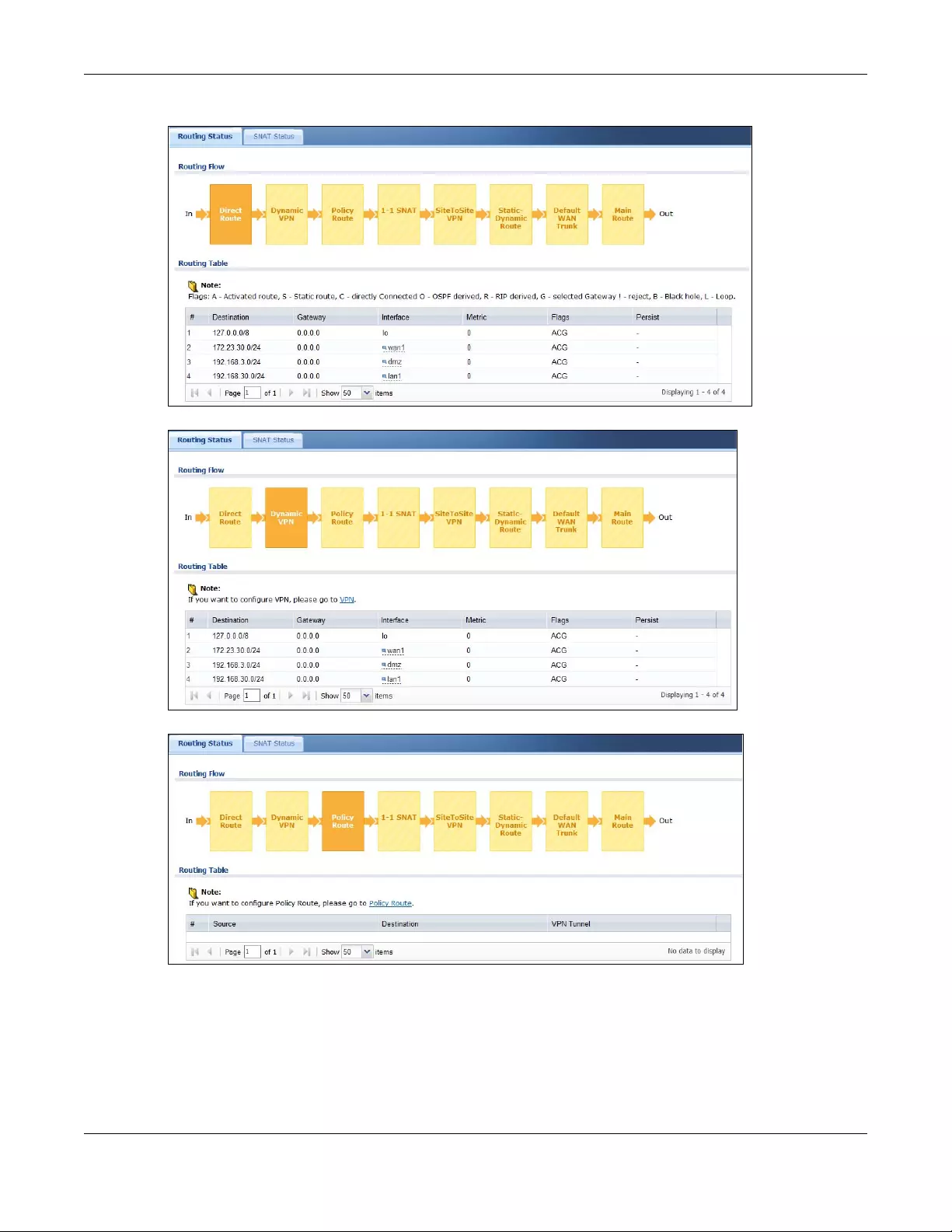
Chapter 40 Packet Flow Explore
ZyWALL/USG Series User’s Guide
751
Figure 528 Maintenance > Packet Flow Explore > Routing Status (Direct Route)
Figure 529 Maintenance > Packet Flow Explore > Dynamic VPN
Figure 530 Maintenance > Packet Flow Explore > Routing Status (Policy Route)
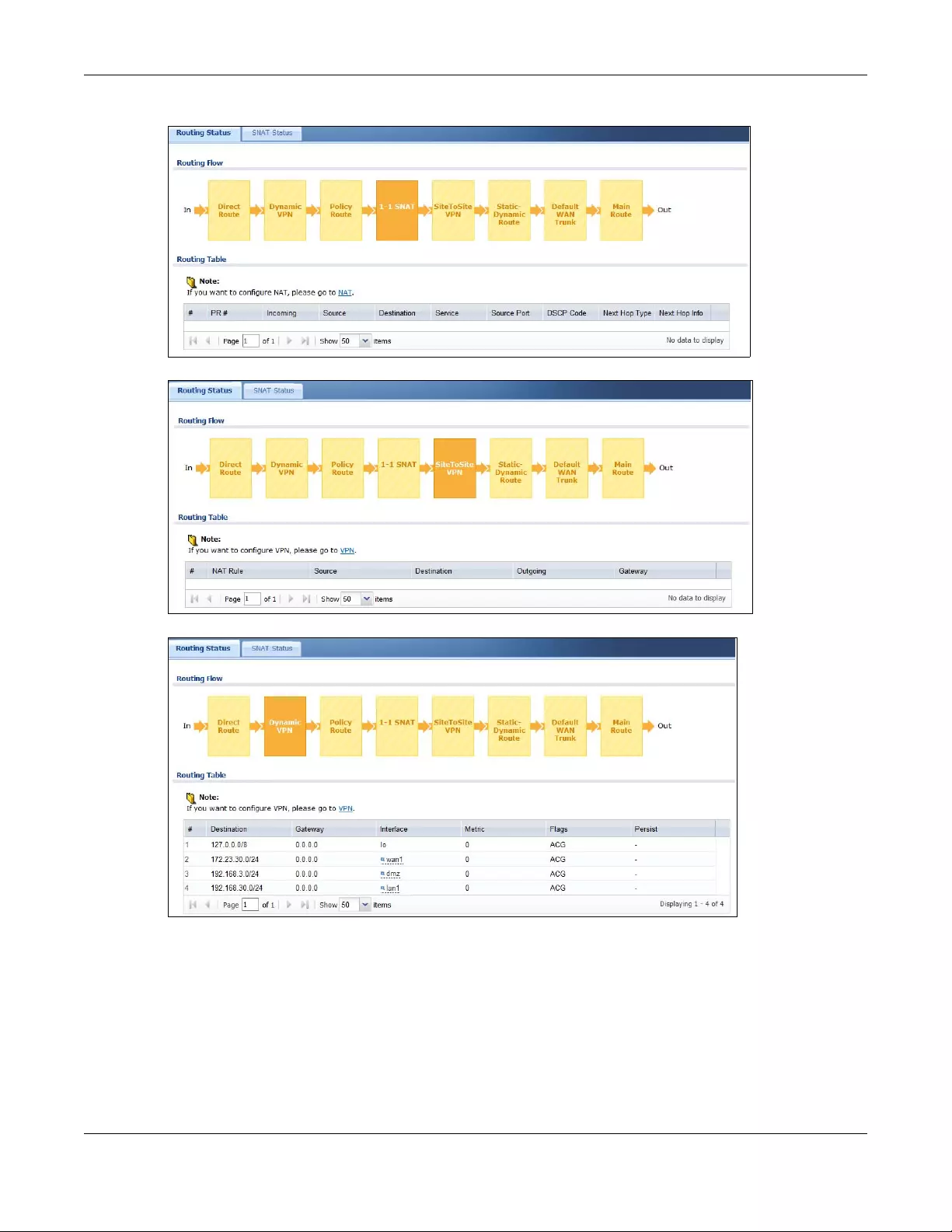
Chapter 40 Packet Flow Explore
ZyWALL/USG Series User’s Guide
752
Figure 531 Maintenance > Packet Flow Explore > Routing Status (1-1 SNAT)
Figure 532 Maintenance > Packet Flow Explore > Routing Status (SiteToSite VPN)
Figure 533 Maintenance > Packet Flow Explore > Routing Status (Dynamic VPN)
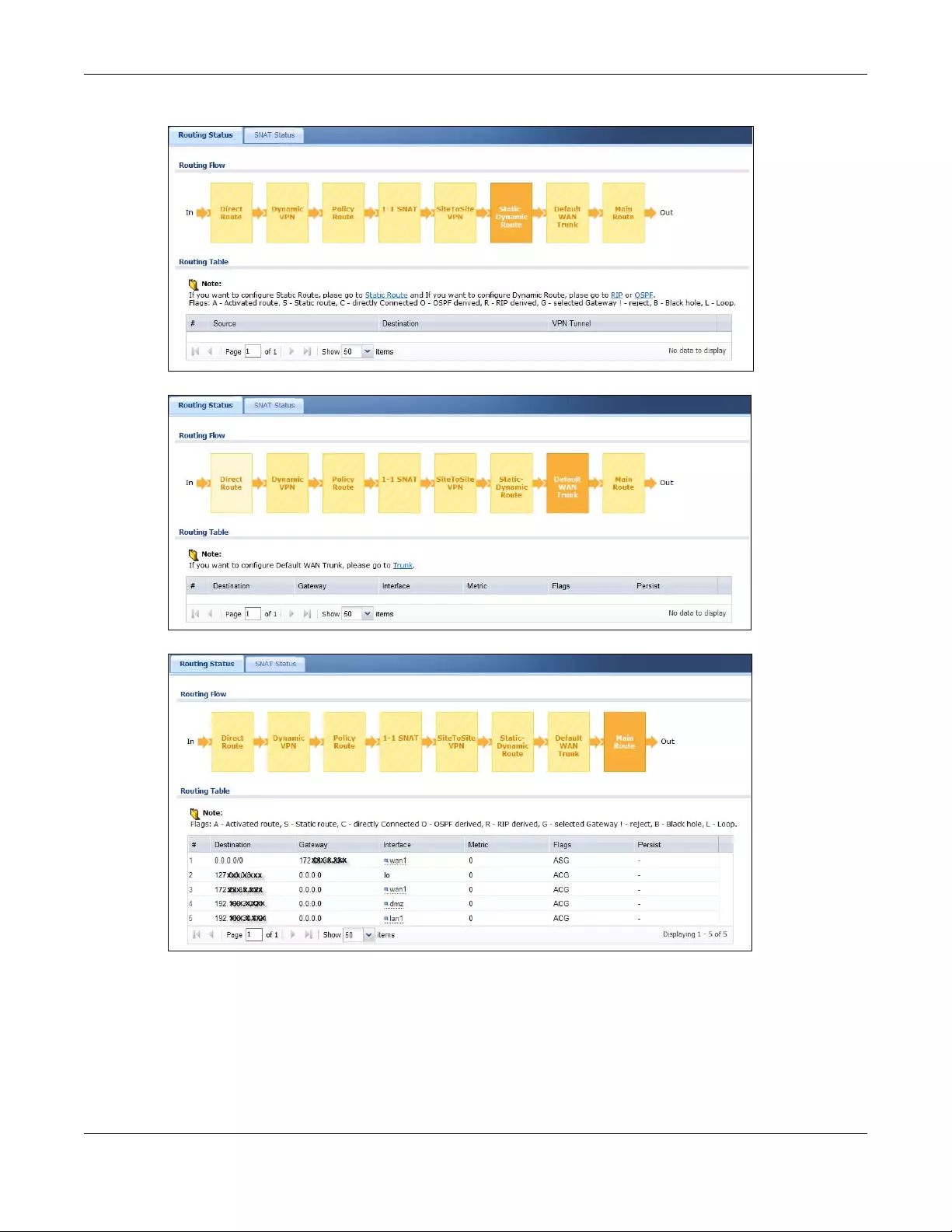
Chapter 40 Packet Flow Explore
ZyWALL/USG Series User’s Guide
753
Figure 534 Maintenance > Packet Flow Explore > Routing Status (Static-Dynamic Route)
Figure 535 Maintenance > Packet Flow Explore > Routing Status (Default WAN Trunk)
Figure 536 Maintenance > Packet Flow Explore > Routing Status (Main Route)
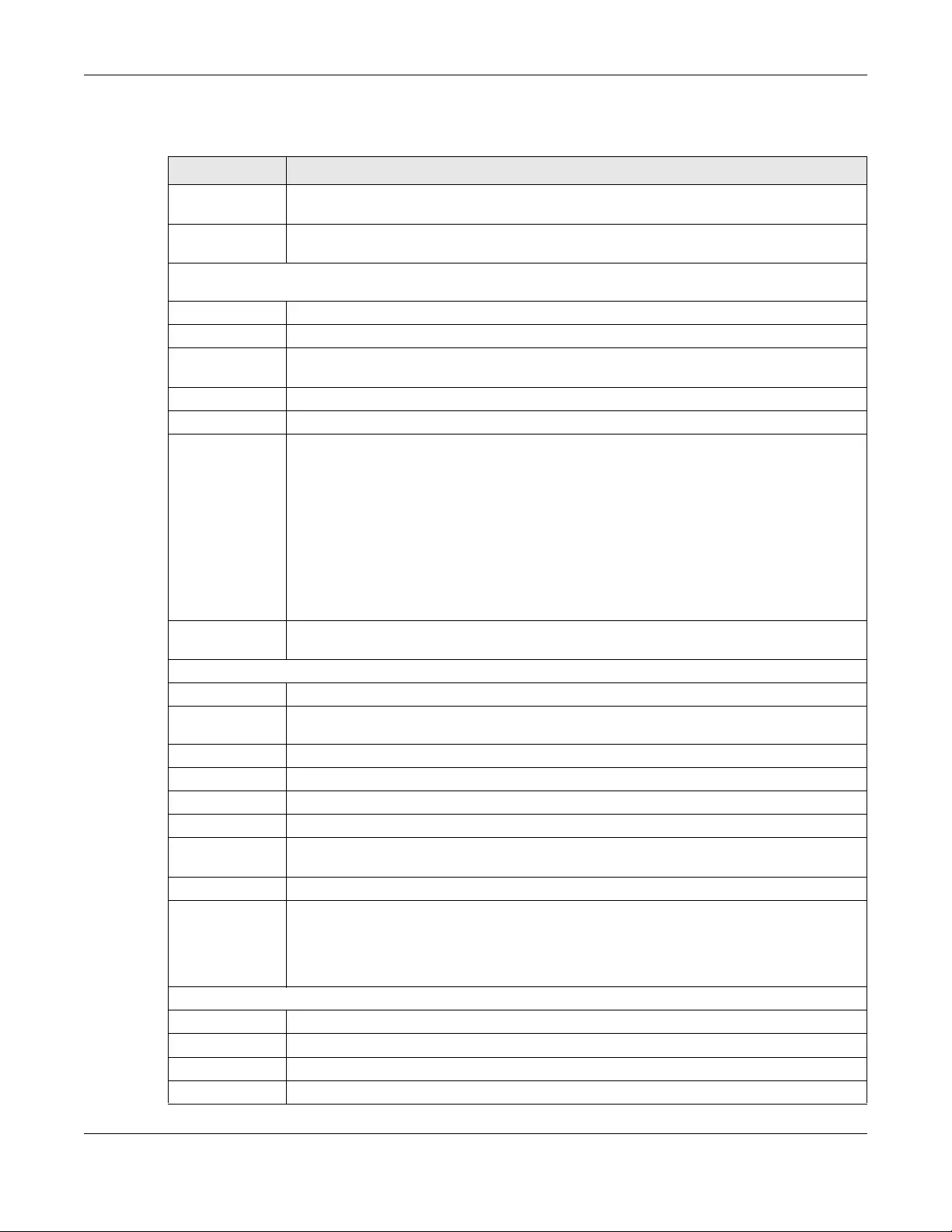
Chapter 40 Packet Flow Explore
ZyWALL/USG Series User’s Guide
754
The following table describes the labels in this screen.
Table 341 Maintenance > Packet Flow Explore > Routing Status
LABEL DESCRIPTION
Routing Flow This section shows you the flow of how the ZyWALL/USG determines where to route a
packet. Click a function box to display the related settings in the Routing Table section.
Routing Table This section shows the corresponding settings according to the function box you click in the
Routing Flow section.
The following fields are available if you click Direct Route, Static-Dynamic Route, or Main Route in the
Routing Flow section.
#This field is a sequential value, and it is not associated with any entry.
Destination This is the destination IP address of a route.
Gateway This is the IP address of the next-hop gateway or the interface through which the traffic is
routed.
Interface This is the name of an interface associated with the route.
Metric This is the route’s priority among the displayed routes.
Flags This indicates additional information for the route. The possible flags are:
•A - this route is currently activated
•S - this is a static route
•C - this is a direct connected route
•O - this is a dynamic route learned through OSPF
•R - this is a dynamic route learned through RIP
•G - the route is to a gateway (router) in the same network.
•! - this is a route which forces a route lookup to fail.
•B - this is a route which discards packets.
•L - this is a recursive route.
Persist This is the remaining time of a dynamically learned route. The ZyWALL/USG removes the
route after this time period is counted down to zero.
The following fields are available if you click Policy Route in the Routing Flow section.
#This field is a sequential value, and it is not associated with any entry.
PR # This is the number of an activated policy route. If you have configured a schedule for the
route, this screen only displays the route at the scheduled time.
Incoming This is the interface on which the packets are received.
Source This is the source IP address(es) from which the packets are sent.
Destination This is the destination IP address(es) to which the packets are transmitted.
Service This is the name of the service object. any means all services.
DSCP Code This is the DSCP value of incoming packets to which this policy route applies. See Section
10.2 on page 265 for more information.
Next Hop Type This is the type of the next hop to which packets are directed.
Next Hop Info • This is the main route if the next hop type is Auto.
• This is the interface name and gateway IP address if the next hop type is Interface /
GW.
• This is the tunnel name if the next hop type is VPN Tunnel.
• This is the trunk name if the next hop type is Trunk.
The following fields are available if you click 1-1 SNAT in the Routing Flow section.
#This field is a sequential value, and it is not associated with any entry.
NAT Rule This is the name of an activated 1:1 or Many 1:1 NAT rule in the NAT table.
Source This is the original source IP address(es). any means any IP address.
Destination This is the original destination IP address(es). any means any IP address.
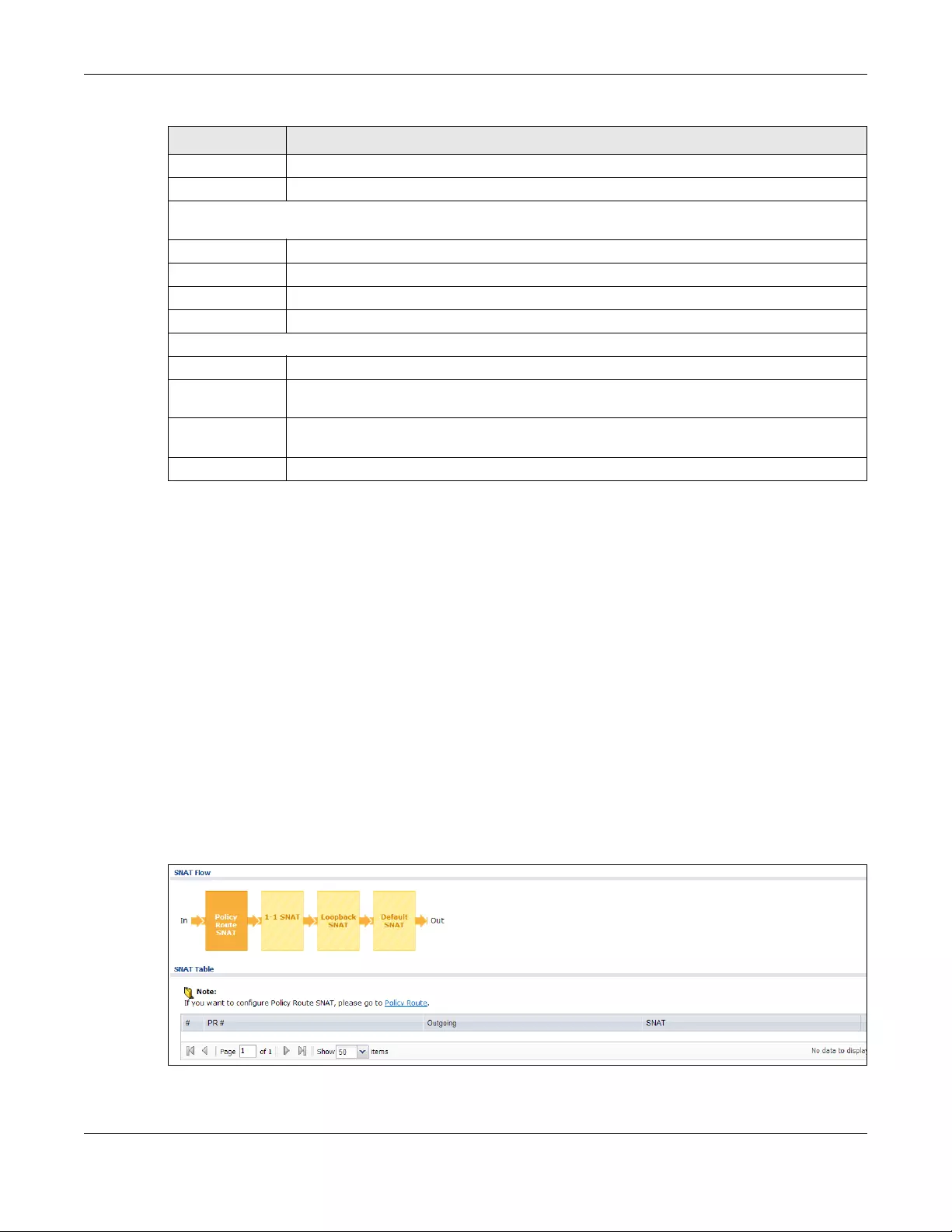
Chapter 40 Packet Flow Explore
ZyWALL/USG Series User’s Guide
755
40.3 The SNAT Status Screen
The SNAT Status screen allows you to view and quickly link to specific source NAT (SNAT) settings.
Click a function box in the SNAT Flow section, the related SNAT rules (activated) will display in the
SNAT Table section. To access this screen, click Maintenance > Packet Flow Explore > SNAT
Status.
The order of the SNAT flow may vary depending on whether you:
• select use default SNAT in the CONFIGURATION > Network > Interface > Trunk screen.
• use policy routes to control 1-1 NAT by using the policy control-virtual-server-rules
activate command.
Note: Once a packet matches the criteria of an SNAT rule, the ZyWALL/USG takes the
corresponding action and does not perform any further flow checking.
Figure 537 Maintenance > Packet Flow Explore > SNAT Status (Policy Route SNAT)
Outgoing This is the name of an interface which transmits packets out of the ZyWALL/USG.
Gateway This is the IP address of the gateway in the same network of the outgoing interface.
The following fields are available if you click Dynamic VPN or SiteToSite VPN in the Routing Flow
section.
#This field is a sequential value, and it is not associated with any entry.
Source This is the IP address(es) of the local VPN network.
Destination This is the IP address(es) for the remote VPN network.
VPN Tunnel This is the name of the VPN tunnel.
The following fields are available if you click Default WAN Tru n k in the Routing Flow section.
#This field is a sequential value, and it is not associated with any entry.
Source This is the source IP address(es) from which the packets are sent. any means any IP
address.
Destination This is the destination IP address(es) to which the packets are transmitted. any means
any IP address.
Trunk This is the name of the WAN trunk through which the matched packets are transmitted.
Table 341 Maintenance > Packet Flow Explore > Routing Status (continued)
LABEL DESCRIPTION
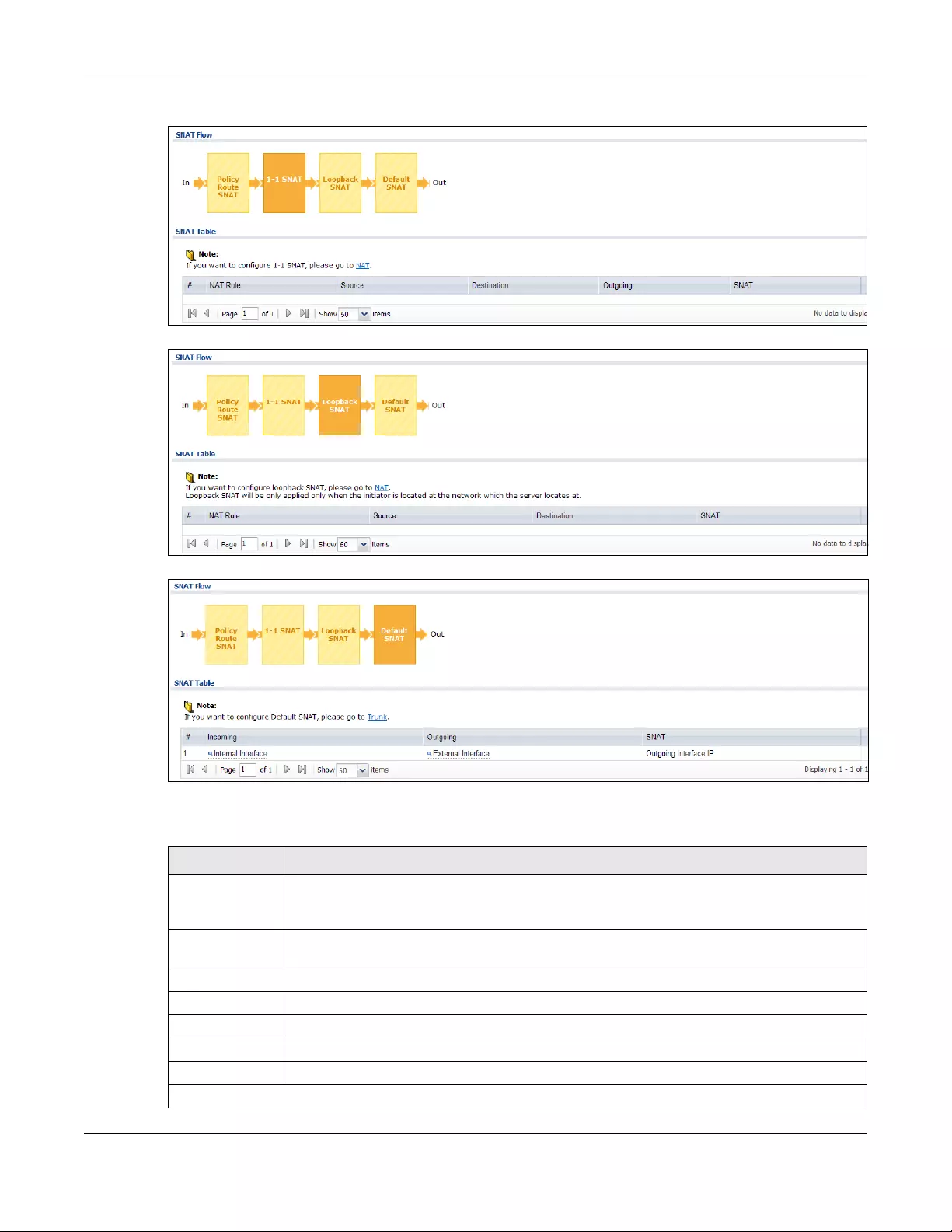
Chapter 40 Packet Flow Explore
ZyWALL/USG Series User’s Guide
756
Figure 538 Maintenance > Packet Flow Explore > SNAT Status (1-1 SNAT)
Figure 539 Maintenance > Packet Flow Explore > SNAT Status (Loopback SNAT)
Figure 540 Maintenance > Packet Flow Explore > SNAT Status (Default SNAT)
The following table describes the labels in this screen.
Table 342 Maintenance > Packet Flow Explore > SNAT Status
LABEL DESCRIPTION
SNAT Flow This section shows you the flow of how the ZyWALL/USG changes the source IP address for
a packet according to the rules you have configured in the ZyWALL/USG. Click a function
box to display the related settings in the SNAT Table section.
SNAT Table The table fields in this section vary depending on the function box you select in the SNAT
Flow section.
The following fields are available if you click Policy Route SNAT in the SNAT Flow section.
#This field is a sequential value, and it is not associated with any entry.
PR # This is the number of an activated policy route which uses SNAT.
Outgoing This is the outgoing interface that the route uses to transmit packets.
SNAT This is the source IP address(es) that the SNAT rule uses finally.
The following fields are available if you click 1-1 SNAT in the SNAT Flow section.
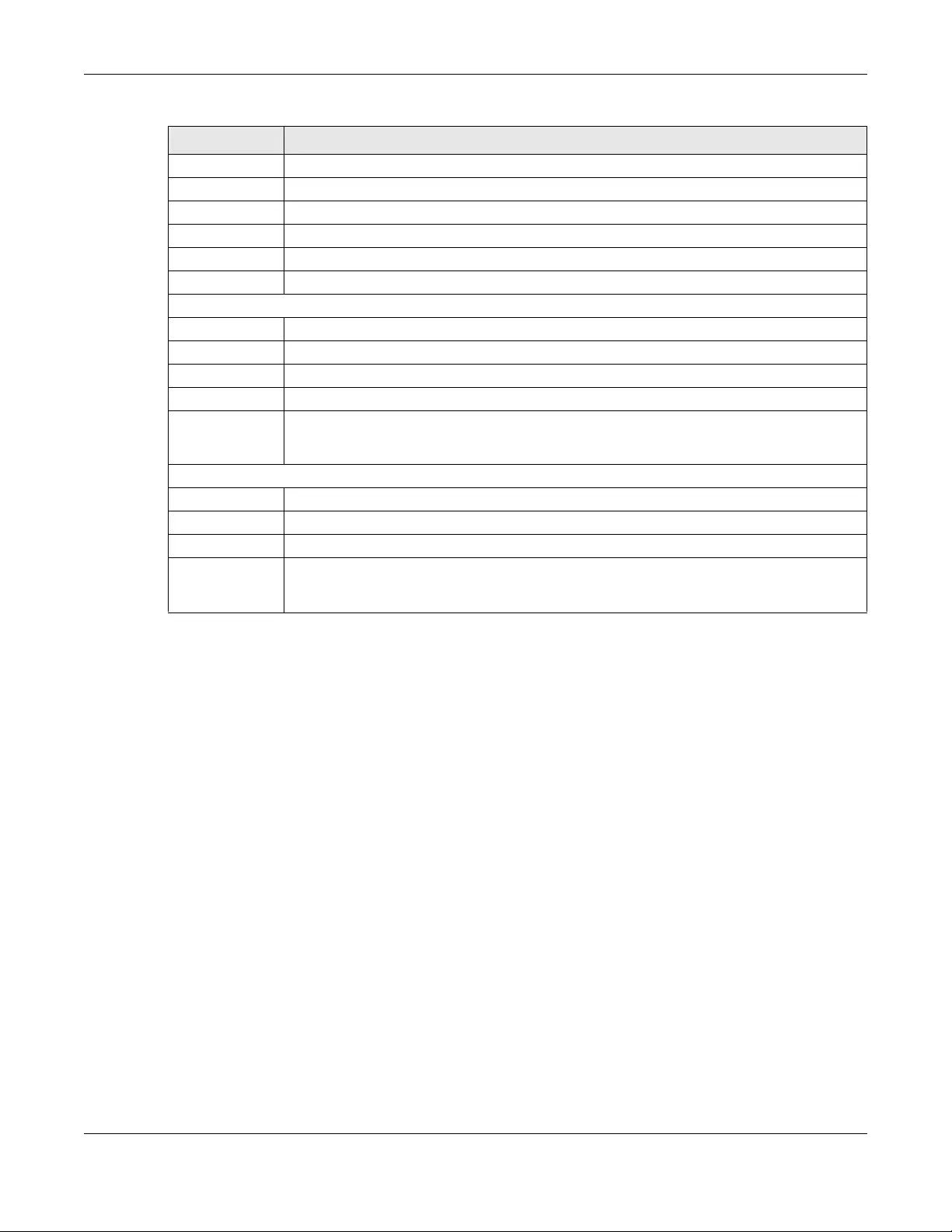
Chapter 40 Packet Flow Explore
ZyWALL/USG Series User’s Guide
757
#This field is a sequential value, and it is not associated with any entry.
NAT Rule This is the name of an activated NAT rule which uses SNAT.
Source This is the original source IP address(es).
Destination This is the original destination IP address(es).
Outgoing This is the outgoing interface that the SNAT rule uses to transmit packets.
SNAT This is the source IP address(es) that the SNAT rule uses finally.
The following fields are available if you click Loopback SNAT in the SNAT Flow section.
#This field is a sequential value, and it is not associated with any entry.
NAT Rule This is the name of an activated NAT rule which uses SNAT and enables NAT loopback.
Source This is the original source IP address(es). any means any IP address.
Destination This is the original destination IP address(es). any means any IP address.
SNAT This indicates which source IP address the SNAT rule uses finally. For example, Outgoing
Interface IP means that the ZyWALL/USG uses the IP address of the outgoing interface as
the source IP address for the matched packets it sends out through this rule.
The following fields are available if you click Default SNAT in the SNAT Flow section.
#This field is a sequential value, and it is not associated with any entry.
Incoming This indicates internal interface(s) on which the packets are received.
Outgoing This indicates external interface(s) from which the packets are transmitted.
SNAT This indicates which source IP address the SNAT rule uses finally. For example, Outgoing
Interface IP means that the ZyWALL/USG uses the IP address of the outgoing interface as
the source IP address for the matched packets it sends out through this rule.
Table 342 Maintenance > Packet Flow Explore > SNAT Status (continued)
LABEL DESCRIPTION

ZyWALL/USG Series User’s Guide
758
CHAPTER 41
Shutdown
41.1 Overview
Use this to shutdown the device in preparation for disconnecting the power.
Always use the Maintenance > Shutdown > Shutdown screen or the
“shutdown” command before you turn off the ZyWALL/USG or remove
the power. Not doing so can cause the firmware to become corrupt.
41.1.1 What You Need To Know
Shutdown writes all cached data to the local storage and stops the system processes.
41.2 The Shutdown Screen
To access this screen, click Maintenance > Shutdown.
Figure 541 Maintenance > Shutdown
Click the Shutdown button to shut down the ZyWALL/USG. Wait for the device to shut down before
you manually turn off or remove the power. It does not turn off the power.
You can also use the CLI command shutdown to shutdown the ZyWALL/USG.

ZyWALL/USG Series User’s Guide
759
CHAPTER 42
Troubleshooting
This chapter offers some suggestions to solve problems you might encounter.
• You can also refer to the logs (see Chapter 6 on page 150).
• For the order in which the ZyWALL/USG applies its features and checks, see Chapter 40 on page
750.
None of the LEDs turn on.
Make sure that you have the power cord connected to the ZyWALL/USG and plugged in to an
appropriate power source. Make sure you have the ZyWALL/USG turned on. Check all cable
connections.
If the LEDs still do not turn on, you may have a hardware problem. In this case, you should contact
your local vendor.
Cannot access the ZyWALL/USG from the LAN.
• Check the cable connection between the ZyWALL/USG and your computer or switch.
• Ping the ZyWALL/USG from a LAN computer. Make sure your computer’s Ethernet card is installed
and functioning properly. Also make sure that its IP address is in the same subnet as the
ZyWALL/USG’s.
• In the computer, click Start, (All) Programs, Accessories and then Command Prompt. In
the Command Prompt window, type "ping" followed by the ZyWALL/USG’s LAN IP address
(192.168.1.1 is the default) and then press [ENTER]. The ZyWALL/USG should reply.
• If you’ve forgotten the ZyWALL/USG’s password, use the RESET button. Press the button in for
about 5 seconds (or until the PWR LED starts to blink), then release it. It returns the ZyWALL/
USG to the factory defaults (password is 1234, LAN IP address 192.168.1.1 etc.; see your User’s
Guide for details).
• If you’ve forgotten the ZyWALL/USG’s IP address, you can use the commands through the
console port to check it. Connect your computer to the CONSOLE port using a console cable.
Your computer should have a terminal emulation communications program (such as
HyperTerminal) set to VT100 terminal emulation, no parity, 8 data bits, 1 stop bit, no flow control
and 115200 bps port speed.
I cannot access the Internet.

Chapter 42 Troubleshooting
ZyWALL/USG Series User’s Guide
760
• Check the ZyWALL/USG’s connection to the Ethernet jack with Internet access. Make sure the
Internet gateway device (such as a DSL modem) is working properly.
• Check the WAN interface's status in the Dashboard. Use the installation setup wizard again and
make sure that you enter the correct settings. Use the same case as provided by your ISP.
I cannot update the anti-virus signatures.
• Make sure your ZyWALL/USG has the anti-virus service registered and that the license is not
expired. Purchase a new license if the license is expired.
• Make sure your ZyWALL/USG is connected to the Internet.
I cannot update the IDP/application patrol signatures.
• Make sure your ZyWALL/USG has the IDP/application patrol service registered and that the
license is not expired. Purchase a new license if the license is expired.
• Make sure your ZyWALL/USG is connected to the Internet.
I downloaded updated anti-virus or IDP/application patrol signatures. Why has the ZyWALL/
USG not re-booted yet?
The ZyWALL/USG does not have to reboot when you upload new signatures.
The content filter category service is not working.
• Make sure your ZyWALL/USG has the content filter category service registered and that the
license is not expired. Purchase a new license if the license is expired.
• Make sure your ZyWALL/USG is connected to the Internet.
I configured security settings but the ZyWALL/USG is not applying them for certain
interfaces.
Many security settings are usually applied to zones. Make sure you assign the interfaces to the
appropriate zones. When you create an interface, there is no security applied on it until you assign
it to a zone.
The ZyWALL/USG is not applying the custom policy route I configured.

Chapter 42 Troubleshooting
ZyWALL/USG Series User’s Guide
761
The ZyWALL/USG checks the policy routes in the order that they are listed. So make sure that your
custom policy route comes before any other routes that the traffic would also match.
The ZyWALL/USG is not applying the custom security policy I configured.
The ZyWALL/USG checks the security policies in the order that they are listed. So make sure that
your custom security policy comes before any other rules that the traffic would also match.
I cannot enter the interface name I want.
The format of interface names other than the Ethernet interface names is very strict. Each name
consists of 2-4 letters (interface type), followed by a number (x, limited by the maximum number
of each type of interface). For example, VLAN interfaces are vlan0, vlan1, vlan2, ...; and so on.
• The names of virtual interfaces are derived from the interfaces on which they are created. For
example, virtual interfaces created on Ethernet interface wan1 are called wan1:1, wan1:2, and
so on. Virtual interfaces created on VLAN interface vlan2 are called vlan2:1, vlan2:2, and so on.
You cannot specify the number after the colon(:) in the Web Configurator; it is a sequential
number. You can specify the number after the colon if you use the CLI to set up a virtual
interface.
I cannot set up a PPP interface, virtual Ethernet interface or virtual VLAN interface on an
Ethernet interface.
You cannot set up a PPP interface, virtual Ethernet interface or virtual VLAN interface if the
underlying interface is a member of a bridge. You also cannot add an Ethernet interface or VLAN
interface to a bridge if the member interface has a virtual interface or PPP interface on top of it.
My rules and settings that apply to a particular interface no longer work.
The interface’s IP address may have changed. To avoid this create an IP address object based on
the interface. This way the ZyWALL/USG automatically updates every rule or setting that uses the
object whenever the interface’s IP address settings change. For example, if you change LAN1’s IP
address, the ZyWALL/USG automatically updates the corresponding interface-based, LAN1 subnet
address object.
I cannot set up a PPP interface.
You have to set up an ISP account before you create a PPPoE or PPTP interface.

Chapter 42 Troubleshooting
ZyWALL/USG Series User’s Guide
762
The data rates through my cellular connection are no-where near the rates I expected.
The actual cellular data rate you obtain varies depending on the cellular device you use, the signal
strength to the service provider’s base station, and so on.
I created a cellular interface but cannot connect through it.
• Make sure you have a compatible mobile broadband device installed or connected. See
www.zyxel.com for details.
• Make sure you have the cellular interface enabled.
• Make sure the cellular interface has the correct user name, password, and PIN code configured
with the correct casing.
• If the ZyWALL/USG has multiple WAN interfaces, make sure their IP addresses are on different
subnets.
Hackers have accessed my WEP-encrypted wireless LAN.
WEP is extremely insecure. Its encryption can be broken by an attacker, using widely-available
software. It is strongly recommended that you use a more effective security mechanism. Use the
strongest security mechanism that all the wireless devices in your network support. WPA2 or WPA2-
PSK is recommended.
The wireless security is not following the re-authentication timer setting I specified.
If a RADIUS server authenticates wireless stations, the re-authentication timer on the RADIUS
server has priority. Change the RADIUS server’s configuration if you need to use a different re-
authentication timer setting.
I cannot configure a particular VLAN interface on top of an Ethernet interface even though I
have it configured it on top of another Ethernet interface.
Each VLAN interface is created on top of only one Ethernet interface.
The ZyWALL/USG is not applying an interface’s configured ingress bandwidth limit.
At the time of writing, the ZyWALL/USG does not support ingress bandwidth management.

Chapter 42 Troubleshooting
ZyWALL/USG Series User’s Guide
763
The ZyWALL/USG is not applying my application patrol bandwidth management settings.
Bandwidth management in policy routes has priority over application patrol bandwidth
management.
The ZyWALL/USG’s performance slowed down after I configured many new application patrol
entries.
The ZyWALL/USG checks the ports and conditions configured in application patrol entries in the
order they appear in the list. While this sequence does not affect the functionality, you might
improve the performance of the ZyWALL/USG by putting more commonly used ports at the top of
the list.
The ZyWALL/USG’s anti-virus scanner cleaned an infected file but now I cannot use the file.
The scanning engine checks the contents of the packets for virus. If a virus pattern is matched, the
ZyWALL/USG removes the infected portion of the file along with the rest of the file. The un-infected
portion of the file before a virus pattern was matched still goes through. Since the ZyWALL/USG
erases the infected portion of the file before sending it, you may not be able to open the file.
The ZyWALL/USG is not scanning some zipped files.
The ZyWALL/USG cannot unzip password protected ZIP files or a ZIP file within another ZIP file. There are also
limits to the number of ZIP files that the ZyWALL/USG can concurrently unzip.
The ZyWALL/USG is deleting some zipped files.
The anti-virus policy may be set to delete zipped files that the ZyWALL/USG cannot unzip. The
ZyWALL/USG cannot unzip password protected ZIP files or a ZIP file within another ZIP file. There
are also limits to the number of ZIP files that the ZyWALL/USG can concurrently unzip.
The ZyWALL/USG’s performance seems slower after configuring IDP.

Chapter 42 Troubleshooting
ZyWALL/USG Series User’s Guide
764
Depending on your network topology and traffic load, binding every packet direction to an IDP
profile may affect the ZyWALL/USG’s performance. You may want to focus IDP scanning on certain
traffic directions such as incoming traffic.
IDP is dropping traffic that matches a rule that says no action should be taken.
The ZyWALL/USG checks all signatures and continues searching even after a match is found. If two
or more rules have conflicting actions for the same packet, then the ZyWALL/USG applies the more
restrictive action (reject-both, reject-receiver or reject-sender, drop, none in this order). If a
packet matches a rule for reject-receiver and it also matches a rule for reject-sender, then the
ZyWALL/USG will reject-both.
I uploaded a custom signature file and now all of my earlier custom signatures are gone.
The name of the complete custom signature file on the ZyWALL/USG is ‘custom.rules’. If you import
a file named ‘custom.rules’, then all custom signatures on the ZyWALL/USG are overwritten with
the new file. If this is not your intention, make sure that the files you import are not named
‘custom.rules’.
I cannot configure some items in IDP that I can configure in Snort.
Not all Snort functionality is supported in the ZyWALL/USG.
The ZyWALL/USG’s performance seems slower after configuring ADP.
Depending on your network topology and traffic load, applying an anomaly profile to each and
every packet direction may affect the ZyWALL/USG’s performance.
The ZyWALL/USG routes and applies SNAT for traffic from some interfaces but not from
others.
The ZyWALL/USG automatically uses SNAT for traffic it routes from internal interfaces to external
interfaces. For example LAN to WAN traffic. You must manually configure a policy route to add
routing and SNAT settings for an interface with the Interface Type set to General. You can also
configure a policy route to override the default routing and SNAT behavior for an interface with the
Interface Type set to Internal or External.

Chapter 42 Troubleshooting
ZyWALL/USG Series User’s Guide
765
I cannot get Dynamic DNS to work.
• You must have a public WAN IP address to use Dynamic DNS.
• Make sure you recorded your DDNS account’s user name, password, and domain name and have
entered them properly in the ZyWALL/USG.
• You may need to configure the DDNS entry’s IP Address setting to Auto if the interface has a
dynamic IP address or there are one or more NAT routers between the ZyWALL/USG and the
DDNS server.
• The ZyWALL/USG may not determine the proper IP address if there is an HTTP proxy server
between the ZyWALL/USG and the DDNS server.
I cannot create a second HTTP redirect rule for an incoming interface.
You can configure up to one HTTP redirect rule for each (incoming) interface.
I cannot get the application patrol to manage SIP traffic.
Make sure you have the SIP ALG enabled.
I cannot get the application patrol to manage H.323 traffic.
Make sure you have the H.323 ALG enabled.
I cannot get the application patrol to manage FTP traffic.
Make sure you have the FTP ALG enabled.
The ZyWALL/USG keeps resetting the connection.
If an alternate gateway on the LAN has an IP address in the same subnet as the ZyWALL/USG’s LAN
IP address, return traffic may not go through the ZyWALL/USG. This is called an asymmetrical or
“triangle” route. This causes the ZyWALL/USG to reset the connection, as the connection has not
been acknowledged.

Chapter 42 Troubleshooting
ZyWALL/USG Series User’s Guide
766
You can set the ZyWALL/USG’s security policy to permit the use of asymmetrical route topology on
the network (so it does not reset the connection) although this is not recommended since allowing
asymmetrical routes may let traffic from the WAN go directly to the LAN without passing through
the ZyWALL/USG. A better solution is to use virtual interfaces to put the ZyWALL/USG and the
backup gateway on separate subnets. See Asymmetrical Routes on page 267 and the chapter about
interfaces for more information.
I cannot set up an IPSec VPN tunnel to another device.
If the IPSec tunnel does not build properly, the problem is likely a configuration error at one of the
IPSec routers. Log into both ZyXEL IPSec routers and check the settings in each field methodically
and slowly. Make sure both the ZyWALL/USG and remote IPSec router have the same security
settings for the VPN tunnel. It may help to display the settings for both routers side-by-side.
Here are some general suggestions. See also Chapter 22 on page 376.
• The system log can often help to identify a configuration problem.
• If you enable NAT traversal, the remote IPSec device must also have NAT traversal enabled.
• The ZyWALL/USG and remote IPSec router must use the same authentication method to
establish the IKE SA.
• Both routers must use the same negotiation mode.
• Both routers must use the same encryption algorithm, authentication algorithm, and DH key
group.
• When using pre-shared keys, the ZyWALL/USG and the remote IPSec router must use the same
pre-shared key.
• The ZyWALL/USG’s local and peer ID type and content must match the remote IPSec router’s
peer and local ID type and content, respectively.
• The ZyWALL/USG and remote IPSec router must use the same active protocol.
• The ZyWALL/USG and remote IPSec router must use the same encapsulation.
• The ZyWALL/USG and remote IPSec router must use the same SPI.
• If the sites are/were previously connected using a leased line or ISDN router, physically
disconnect these devices from the network before testing your new VPN connection. The old
route may have been learnt by RIP and would take priority over the new VPN connection.
• To test whether or not a tunnel is working, ping from a computer at one site to a computer at the
other.
Before doing so, ensure that both computers have Internet access (via the IPSec routers).
• It is also helpful to have a way to look at the packets that are being sent and received by the
ZyWALL/USG and remote IPSec router (for example, by using a packet sniffer).
Check the configuration for the following ZyWALL/USG features.
• The ZyWALL/USG does not put IPSec SAs in the routing table. You must create a policy route for
each VPN tunnel. See Chapter 10 on page 263.
• Make sure the To-ZyWALL/USG security policies allow IPSec VPN traffic to the ZyWALL/USG. IKE
uses UDP port 500, AH uses IP protocol 51, and ESP uses IP protocol 50.
• The ZyWALL/USG supports UDP port 500 and UDP port 4500 for NAT traversal. If you enable this,
make sure the To-ZyWALL/USG security policies allow UDP port 4500 too.

Chapter 42 Troubleshooting
ZyWALL/USG Series User’s Guide
767
• Make sure regular security policies allow traffic between the VPN tunnel and the rest of the
network. Regular security policies check packets the ZyWALL/USG sends before the ZyWALL/USG
encrypts them and check packets the ZyWALL/USG receives after the ZyWALL/USG decrypts
them. This depends on the zone to which you assign the VPN tunnel and the zone from which and
to which traffic may be routed.
• If you set up a VPN tunnel across the Internet, make sure your ISP supports AH or ESP
(whichever you are using).
• If you have the ZyWALL/USG and remote IPSec router use certificates to authenticate each other,
You must set up the certificates for the ZyWALL/USG and remote IPSec router first and make
sure they trust each other’s certificates. If the ZyWALL/USG’s certificate is self-signed, import it
into the remote IPsec router. If it is signed by a CA, make sure the remote IPsec router trusts
that CA. The ZyWALL/USG uses one of its Trusted Certificates to authenticate the remote
IPSec router’s certificate. The trusted certificate can be the remote IPSec router’s self-signed
certificate or that of a trusted CA that signed the remote IPSec router’s certificate.
• Multiple SAs connecting through a secure gateway must have the same negotiation mode.
The VPN connection is up but VPN traffic cannot be transmitted through the VPN tunnel.
If you have the Configuration > VPN > IPSec VPN > VPN Connection screen’s Use Policy
Route to control dynamic IPSec rules option enabled, check the routing policies to see if they
are sending traffic elsewhere instead of through the VPN tunnels.
I uploaded a logo to show in the SSL VPN user screens but it does not display properly.
The logo graphic must be GIF, JPG, or PNG format. The graphic should use a resolution of 103 x 29
pixels to avoid distortion when displayed. The ZyWALL/USG automatically resizes a graphic of a
different resolution to 103 x 29 pixels. The file size must be 100 kilobytes or less. Transparent
background is recommended.
I logged into the SSL VPN but cannot see some of the resource links.
Available resource links vary depending on the SSL application object’s configuration.
I cannot download the ZyWALL/USG’s firmware package.
The ZyWALL/USG’s firmware package cannot go through the ZyWALL/USG when you enable the
anti-virus Destroy comp ressed files that could not be decompressed option. The ZyWALL/
USG classifies the firmware package as not being able to be decompressed and deletes it.
You can upload the firmware package to the ZyWALL/USG with the option enabled, so you only
need to clear the Destroy compressed files that cou ld not be decompressed option while you
download the firmware package. See Section 31.2.1 on page 513 for more on the anti-virus
Destroy compressed files that could not be decompressed option.

Chapter 42 Troubleshooting
ZyWALL/USG Series User’s Guide
768
I changed the LAN IP address and can no longer access the Internet.
The ZyWALL/USG automatically updates address objects based on an interface’s IP address,
subnet, or gateway if the interface’s IP address settings change. However, you need to manually
edit any address objects for your LAN that are not based on the interface.
I configured application patrol to allow and manage access to a specific service but access is
blocked.
• If you want to use a service, make sure the security policy allows UTM application patrol to go
through the ZyWALL/USG.
I configured policy routes to manage the bandwidth of TCP and UDP traffic but the bandwidth
management is not being applied properly.
It is recommended to use application patrol instead of policy routes to manage the bandwidth of
TCP and UDP traffic.
I cannot get the RADIUS server to authenticate the ZyWALL/USG‘s default admin account.
The default admin account is always authenticated locally, regardless of the authentication method
setting.
The ZyWALL/USG fails to authentication the ext-user user accounts I configured.
An external server such as AD, LDAP or RADIUS must authenticate the ext-user accounts. If the
ZyWALL/USG tries to use the local database to authenticate an ext-user, the authentication
attempt will always fail. (This is related to AAA servers and authentication methods, which are
discussed in other chapters in this guide.)
I cannot add the admin users to a user group with access users.
You cannot put access users and admin users in the same user group.

Chapter 42 Troubleshooting
ZyWALL/USG Series User’s Guide
769
I cannot add the default admin account to a user group.
You cannot put the default admin account into any user group.
The schedule I configured is not being applied at the configured times.
Make sure the ZyWALL/USG’s current date and time are correct.
I cannot get a certificate to import into the ZyWALL/USG.
1For My Certificates, you can import a certificate that matches a corresponding certification
request that was generated by the ZyWALL/USG. You can also import a certificate in PKCS#12
format, including the certificate’s public and private keys.
2You must remove any spaces from the certificate’s filename before you can import the certificate.
3Any certificate that you want to import has to be in one of these file formats:
• Binary X.509: This is an ITU-T recommendation that defines the formats for X.509 certificates.
• PEM (Base-64) encoded X.509: This Privacy Enhanced Mail format uses lowercase letters,
uppercase letters and numerals to convert a binary X.509 certificate into a printable form.
• Binary PKCS#7: This is a standard that defines the general syntax for data (including digital
signatures) that may be encrypted. A PKCS #7 file is used to transfer a public key certificate. The
private key is not included. The ZyWALL/USG currently allows the importation of a PKS#7 file
that contains a single certificate.
• PEM (Base-64) encoded PKCS#7: This Privacy Enhanced Mail (PEM) format uses lowercase
letters, uppercase letters and numerals to convert a binary PKCS#7 certificate into a printable
form.
• Binary PKCS#12: This is a format for transferring public key and private key certificates.The
private key in a PKCS #12 file is within a password-encrypted envelope. The file’s password is not
connected to your certificate’s public or private passwords. Exporting a PKCS #12 file creates this
and you must provide it to decrypt the contents when you import the file into the ZyWALL/USG.
Note: Be careful not to convert a binary file to text during the transfer process. It is easy
for this to occur since many programs use text files by default.
I cannot access the ZyWALL/USG from a computer connected to the Internet.
Check the service control rules and to-ZyWALL/USG security policies.

Chapter 42 Troubleshooting
ZyWALL/USG Series User’s Guide
770
I uploaded a logo to display on the upper left corner of the Web Configurator login screen and
access page but it does not display properly.
Make sure the logo file is a GIF, JPG, or PNG of 100 kilobytes or less.
I uploaded a logo to use as the screen or window background but it does not display properly.
Make sure the logo file is a GIF, JPG, or PNG of 100 kilobytes or less.
The ZyWALL/USG’s traffic throughput rate decreased after I started collecting traffic
statistics.
Data collection may decrease the ZyWALL/USG’s traffic throughput rate.
I can only see newer logs. Older logs are missing.
When a log reaches the maximum number of log messages, new log messages automatically
overwrite existing log messages, starting with the oldest existing log message first.
The commands in my configuration file or shell script are not working properly.
• In a configuration file or shell script, use “#” or “!” as the first character of a command line to
have the ZyWALL/USG treat the line as a comment.
• Your configuration files or shell scripts can use “exit” or a command line consisting of a single “!”
to have the ZyWALL/USG exit sub command mode.
•Include write commands in your scripts. Otherwise the changes will be lost when the ZyWALL/
USG restarts. You could use multiple write commands in a long script.
Note: “exit” or “!'” must follow sub commands if it is to make the ZyWALL/USG exit sub
command mode.
See Chapter 38 on page 729 for more on configuration files and shell scripts.
I cannot get the firmware uploaded using the commands.
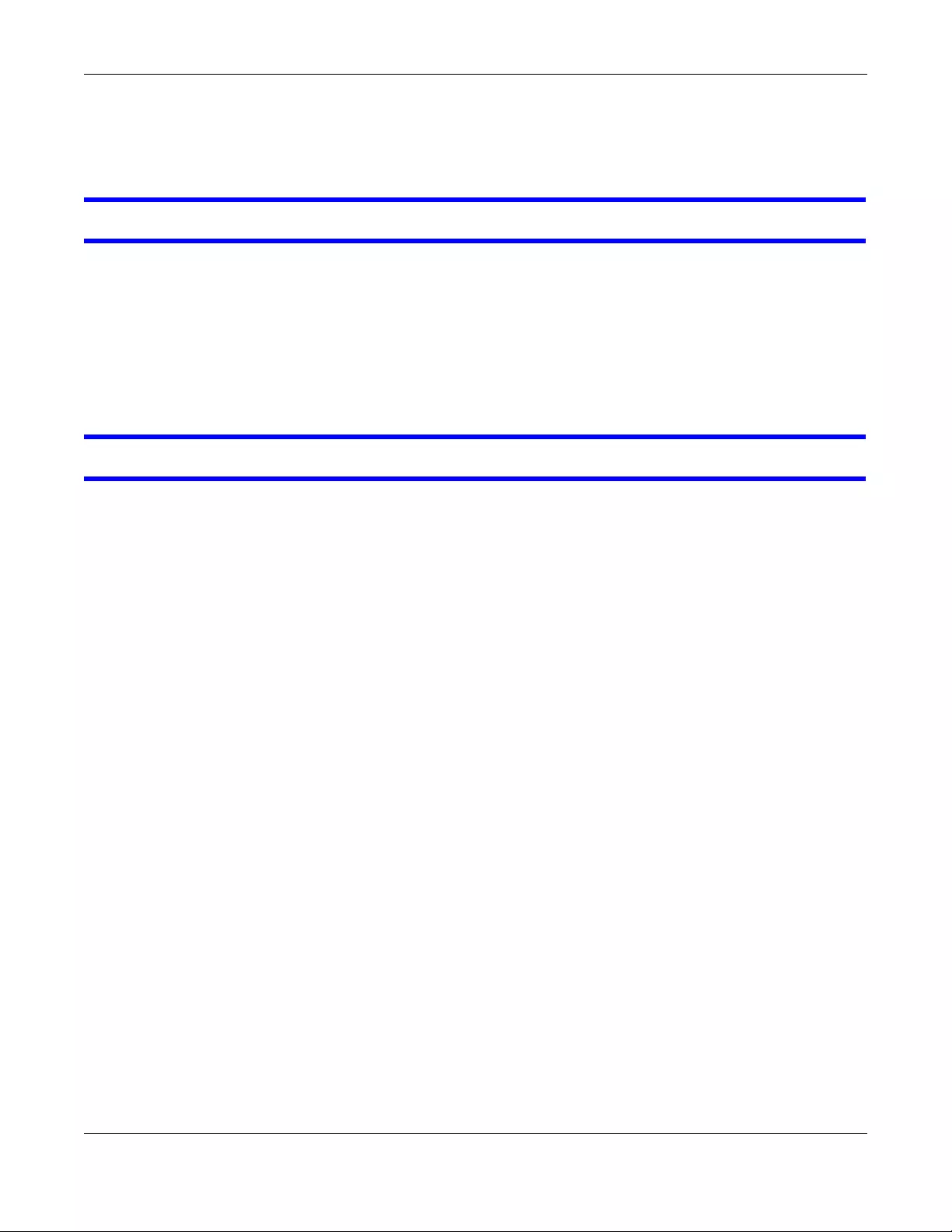
Chapter 42 Troubleshooting
ZyWALL/USG Series User’s Guide
771
The Web Configurator is the recommended method for uploading firmware. You only need to use
the command line interface if you need to recover the firmware. See the CLI Reference Guide for
how to determine if you need to recover the firmware and how to recover it.
My packet capture captured less than I wanted or failed.
The packet capture screen’s File Size sets a maximum size limit for the total combined size of all
the capture files on the ZyWALL/USG, including any existing capture files and any new capture files
you generate. If you have existing capture files you may need to set this size larger or delete
existing capture files.
The ZyWALL/USG stops the capture and generates the capture file when either the capture files
reach the File Size or the time period specified in the Duration field expires.
My earlier packet capture files are missing.
New capture files overwrite existing files of the same name. Change the File Suffix field’s setting
to avoid this.
42.1 Resetting the ZyWALL/USG
If you cannot access the ZyWALL/USG by any method, try restarting it by turning the power off and
then on again. If you still cannot access the ZyWALL/USG by any method or you forget the
administrator password(s), you can reset the ZyWALL/USG to its factory-default settings. Any
configuration files or shell scripts that you saved on the ZyWALL/USG should still be available
afterwards.
Use the following procedure to reset the ZyWALL/USG to its factory-default settings. This
overwrites the settings in the startup-config.conf file with the settings in the system-default.conf
file.
Note: This procedure removes the current configuration.
1Make sure the SYS LED is on and not blinking.
2Press the RESET button and hold it until the SYS LED begins to blink. (This usually takes about five
seconds.)
3Release the RESET button, and wait for the ZyWALL/USG to restart.
You should be able to access the ZyWALL/USG using the default settings.

Chapter 42 Troubleshooting
ZyWALL/USG Series User’s Guide
772
42.2 Getting More Troubleshooting Help
Search for support information for your model at www.zyxel.com for more troubleshooting
suggestions.

ZyWALL/USG Series User’s Guide
773
APPENDIX A
Customer Support
In the event of problems that cannot be solved by using this manual, you should contact your
vendor. If you cannot contact your vendor, then contact a ZyXEL office for the region in which you
bought the device.
Regional websites are listed below.
See also http://www.zyxel.com/about_zyxel/zyxel_worldwide.shtml.
Please have the following information ready when you contact an office.
Required Information
• Product model and serial number.
• Warranty Information.
• Date that you received your device.
• Brief description of the problem and the steps you took to solve it.
Corporate Headquarters (Worldwide)
Taiwan
• ZyXEL Communications Corporation
• http://www.zyxel.com
Asia
China
• ZyXEL Communications (Shanghai) Corp.
ZyXEL Communications (Beijing) Corp.
ZyXEL Communications (Tianjin) Corp.
• http://www.zyxel.cn
India
• ZyXEL Technology India Pvt Ltd
• http://www.zyxel.in
Kazakhstan
•ZyXEL Kazakhstan

Appendix A Customer Support
ZyWALL/USG Series User’s Guide
774
• http://www.zyxel.kz
Korea
• ZyXEL Korea Corp.
• http://www.zyxel.kr
Malaysia
• ZyXEL Malaysia Sdn Bhd.
• http://www.zyxel.com.my
Pakistan
• ZyXEL Pakistan (Pvt.) Ltd.
• http://www.zyxel.com.pk
Philipines
• ZyXEL Philippines
• http://www.zyxel.com.ph
Singapore
• ZyXEL Singapore Pte Ltd.
• http://www.zyxel.com.sg
Taiwan
• ZyXEL Communications Corporation
• http://www.zyxel.com
Thailand
• ZyXEL Thailand Co., Ltd
• http://www.zyxel.co.th
Vietnam
• ZyXEL Communications Corporation-Vietnam Office
• http://www.zyxel.com/vn/vi
Europe
Austria
• ZyXEL Deutschland GmbH
• http://www.zyxel.de

Appendix A Customer Support
ZyWALL/USG Series User’s Guide
775
Belarus
•ZyXEL BY
• http://www.zyxel.by
Belgium
• ZyXEL Communications B.V.
• http://www.zyxel.com/be/nl/
Bulgaria
•ZyXEL България
• http://www.zyxel.com/bg/bg/
Czech
• ZyXEL Communications Czech s.r.o
• http://www.zyxel.cz
Denmark
• ZyXEL Communications A/S
• http://www.zyxel.dk
Estonia
•ZyXEL Estonia
• http://www.zyxel.com/ee/et/
Finland
• ZyXEL Communications
• http://www.zyxel.fi
France
•ZyXEL France
• http://www.zyxel.fr
Germany
• ZyXEL Deutschland GmbH
• http://www.zyxel.de
Hungary
• ZyXEL Hungary & SEE
• http://www.zyxel.hu
Latvia
•ZyXEL Latvia

Appendix A Customer Support
ZyWALL/USG Series User’s Guide
776
• http://www.zyxel.com/lv/lv/homepage.shtml
Lithuania
• ZyXEL Lithuania
• http://www.zyxel.com/lt/lt/homepage.shtml
Netherlands
•ZyXEL Benelux
• http://www.zyxel.nl
Norway
• ZyXEL Communications
• http://www.zyxel.no
Poland
• ZyXEL Communications Poland
• http://www.zyxel.pl
Romania
•ZyXEL Romania
• http://www.zyxel.com/ro/ro
Russia
• ZyXEL Russia
• http://www.zyxel.ru
Slovakia
• ZyXEL Communications Czech s.r.o. organizacna zlozka
• http://www.zyxel.sk
Spain
•ZyXEL Spain
• http://www.zyxel.es
Sweden
• ZyXEL Communications
• http://www.zyxel.se
Switzerland
•Studerus AG

Appendix A Customer Support
ZyWALL/USG Series User’s Guide
777
• http://www.zyxel.ch/
Turkey
•ZyXEL Turkey A.S.
• http://www.zyxel.com.tr
UK
• ZyXEL Communications UK Ltd.
• http://www.zyxel.co.uk
Ukraine
•ZyXEL Ukraine
• http://www.ua.zyxel.com
Latin America
Argentina
• ZyXEL Communication Corporation
• http://www.zyxel.com/ec/es/
Ecuador
• ZyXEL Communication Corporation
• http://www.zyxel.com/ec/es/
Middle East
Egypt
• ZyXEL Communication Corporation
• http://www.zyxel.com/homepage.shtml
Middle East
• ZyXEL Communication Corporation
• http://www.zyxel.com/homepage.shtml
North America
USA
• ZyXEL Communications, Inc. - North America Headquarters
• http://www.us.zyxel.com/

Appendix A Customer Support
ZyWALL/USG Series User’s Guide
778
Oceania
Australia
• ZyXEL Communications Corporation
• http://www.zyxel.com/au/en/
Africa
South Africa
• Nology (Pty) Ltd.
• http://www.zyxel.co.za
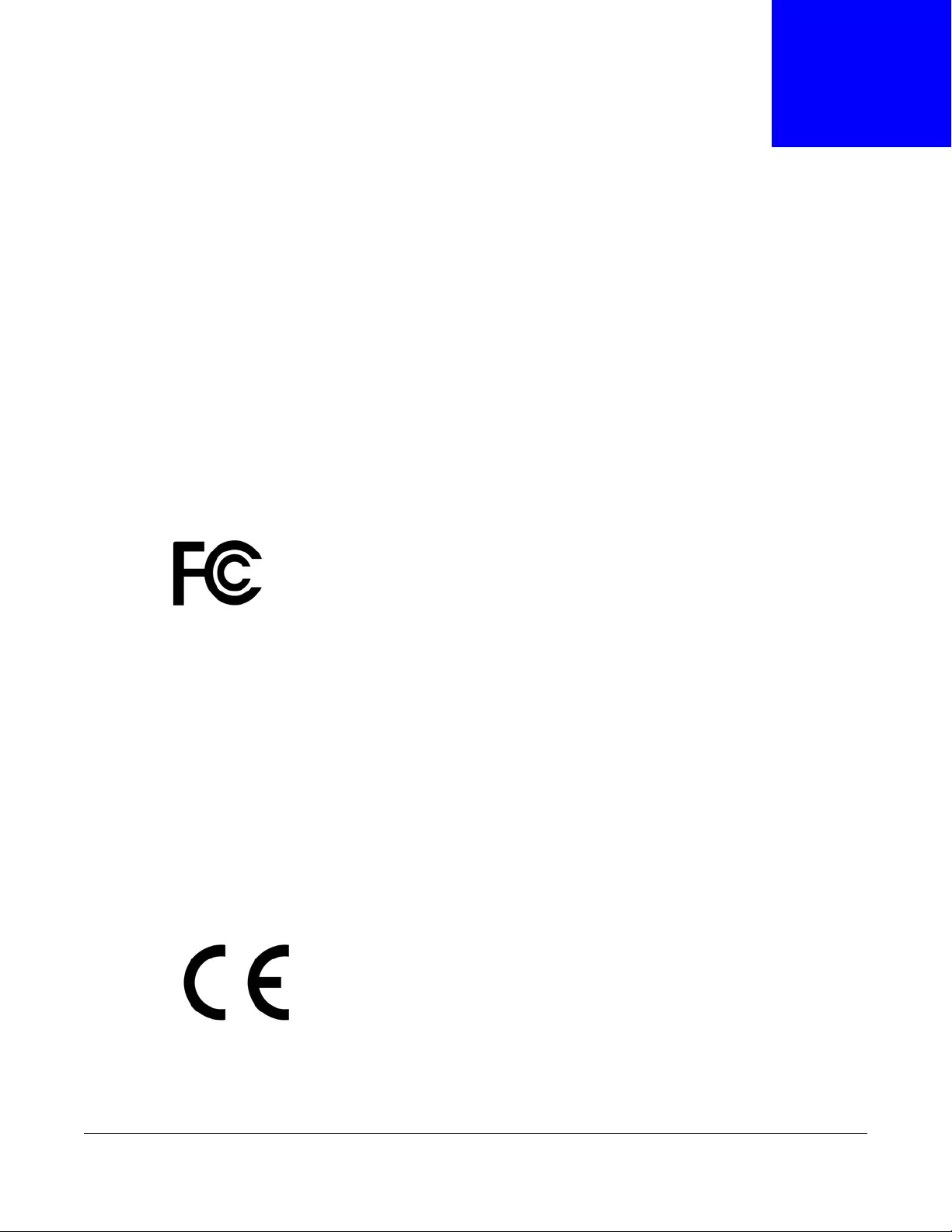
ZyWALL/USG Series User’s Guide
779
APPENDIX B
Legal Information
Copyright
Copyright © 2015 by ZyXEL Communications Corporation.
The contents of this publication may not be reproduced in any part or as a whole, transcribed, stored in a retrieval system, translated into
any language, or transmitted in any form or by any means, electronic, mechanical, magnetic, optical, chemical, photocopying, manual, or
otherwise, without the prior written permission of ZyXEL Communications Corporation.
Published by ZyXEL Communications Corporation. All rights reserved.
Disclaimer
ZyXEL does not assume any liability arising out of the application or use of any products, or software described herein. Neither does it
convey any license under its patent rights nor the patent rights of others. ZyXEL further reserves the right to make changes in any
products described herein without notice. This publication is subject to change without notice.
Regulatory Notice and Statement (Class A)
Model List: ZyWALL 110, ZyWALL 310, ZyWALL 1100, USG210, USG310, USG1110, USG1900
United States of America
Federal Communications Commission (FCC) EMC Statement
• This device complies with Part 15 of FCC rules. Operation is subject to the following two conditions:
(1) This device may not cause harmful interference.
(2) This device must accept any interference received, including interference that may cause undesired operations.
• Changes or modifications not expressly approved by the party responsible for compliance could void the user’s authority to operate the
equipment.
• This equipment has been tested and found to comply with the limits for a Class A digital device, pursuant to part 15 of the FCC Rules.
These limits are designed to provide reasonable protection against harmful interference when the equipment is operated in a
commercial environment. This equipment generates, uses, and can radiate radio frequency energy and, if not installed and used in
accordance with the instruction manual, may cause harmful interference to radio communications. Operation of this equipment in a
residential area is likely to cause harmful interference in which case the user will be required to correct the interference at his own
expense.
Canada
The following information applies if you use the product within Canada area
Industry Canada ICES statement
CAN ICES-3 (A)/NMB-3(A)
European Union
The following information applies if you use the product within the European Union.
CE EMC statement

Appendix B Legal Information
ZyWALL/USG Series User’s Guide
780
This is Class A Product. In domestic environment this product may cause radio interference in which case the user may be required to take
adequate measures.
List of National Codes
Notices
CLASS 1 LASER PRODUCT
APPAREIL À LASER DE CLASS 1
PRODUCT COMPLIES WITH 21 CFR 1040.10 AND 1040.11.
PRODUIT CONFORME SELON 21 CFR 1040.10 ET 1040.11.
Safety Warnings
• Do NOT use this product near water, for example, in a wet basement or near a swimming pool.
• Do NOT expose your device to dampness, dust or corrosive liquids.
• Do NOT store things on the device.
• Do NOT install, use, or service this device during a thunderstorm. There is a remote risk of electric shock from lightning.
• Connect ONLY suitable accessories to the device.
• Do NOT open the device or unit. Opening or removing covers can expose you to dangerous high voltage points or other risks. ONLY
qualified service personnel should service or disassemble this device. Please contact your vendor for further information.
• Make sure to connect the cables to the correct ports.
• Place connecting cables carefully so that no one will step on them or stumble over them.
• Always disconnect all cables from this device before servicing or disassembling.
• Use ONLY an appropriate power adaptor or cord for your device. Connect it to the right supply voltage (for example, 110V AC in North
America or 230V AC in Europe).
• Do NOT remove the plug and connect it to a power outlet by itself; always attach the plug to the power adaptor first before connecting
it to a power outlet.
• Do NOT allow anything to rest on the power adaptor or cord and do NOT place the product where anyone can walk on the power
adaptor or cord.
• Do NOT use the device if the power adaptor or cord is damaged as it might cause electrocution.
• If the power adaptor or cord is damaged, remove it from the device and the power source.
• Do NOT attempt to repair the power adaptor or cord. Contact your local vendor to order a new one.
• Do not use the device outside, and make sure all the connections are indoors. There is a remote risk of electric shock from lightning.
• CAUTION: RISK OF EXPLOSION IF BATTERY (on the motherboard) IS REPLACED BY AN INCORRECT TYPE. DISPOSE OF USED
BATTERIES ACCORDING TO THE INSTRUCTIONS. Dispose them at the applicable collection point for the recycling of electrical and
electronic equipment. For detailed information about recycling of this product, please contact your local city office, your household
waste disposal service or the store where you purchased the product.
• Do NOT obstruct the device ventilation slots, as insufficient airflow may harm your device.
• Antenna Warning! This device meets ETSI and FCC certification requirements when using the included antenna(s). Only use the
included antenna(s).
• If you wall mount your wall-mountable device, make sure that no electrical lines, gas or water pipes will be damaged.
The following warnings apply if product is disconnect device:
• A readily accessible disconnect device shall be incorporated external to the equipment; and/or
The socket-outlet shall be installed near the equipment and shall be easily accessible.
WEEE Directive
COUNTRY ISO 3166 2 LETTER CODE COUNTRY ISO 3166 2 LETTER CODE
Austria AT Malta MT
Belgium BE Netherlands NL
Cyprus CY Poland PL
Czech Republic CR Portugal PT
Denmark DK Slovakia SK
Estonia EE Slovenia SI
Finland FI Spain ES
France FR Sweden SE
Germany DE United Kingdom GB
Greece GR Iceland IS
Hungary HU Liechtenstein LI
Ireland IE Norway NO
Italy IT Switzerland CH
Latvia LV Bulgaria BG
Lithuania LT Romania RO
Luxembourg LU Turkey TR
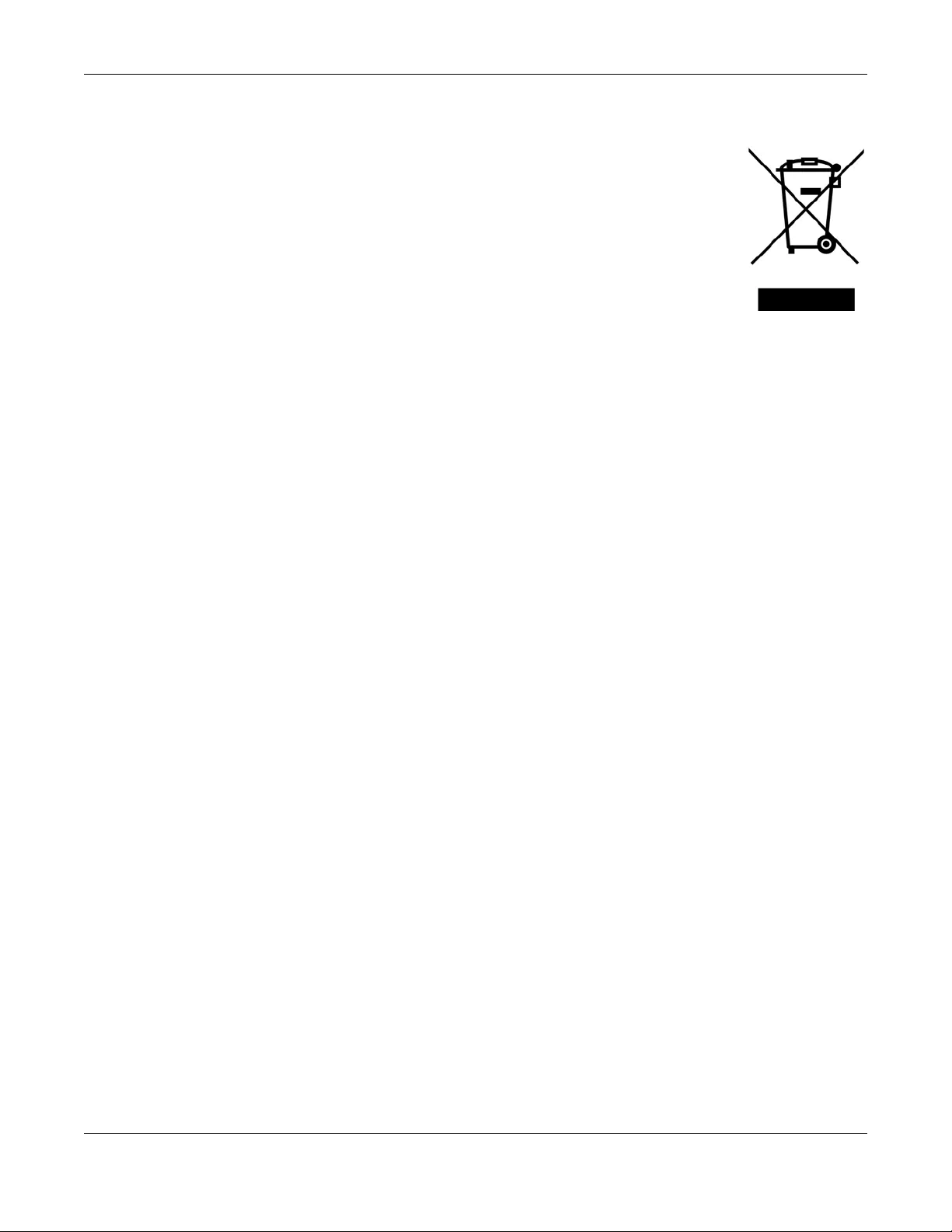
Appendix B Legal Information
ZyWALL/USG Series User’s Guide
781
Your product is marked with this symbol, which is known as the WEEE mark. WEEE stands for Waste Electronics and Electrical Equipment.
It means that used electrical and electronic products should not be mixed with general waste. Used electrical and electronic equipment
should be treated separately.
"INFORMAZIONI AGLI UTENTI"
Ai sensi della Direttiva 2012/19/UE del Parlamento europeo e del Consiglio, del 4 luglio 2012, sui rifiuti di apparecchiature elettriche ed
elettroniche (RAEE).
Il simbolo del cassonetto barrato riportato sull’apparecchiatura o sulla sua confezione indica che il prodotto alla fine della propria vita utile
deve essere raccolto separatamente dagli altri rifiuti.
La raccolta differenziata della presente apparecchiatura giunta a fine vita è organizzata e gestita dal produttore. L’utente che vorrà disfarsi
della presente apparecchiatura dovrà quindi contattare il
produttore e seguire il sistema che questo ha adottato per consentire la raccolta separata dell’apparecchiatura giunta a fine vita.
L’adeguata raccolta differenziata per l’avvio successivo dell’apparecchiatura dismessa al riciclaggio, al trattamento e allo smaltimento
ambientalmente compatibile contribuisce ad evitare possibili effetti negativi sull’ambiente e sulla salute e favorisce il reimpiego e/o riciclo
dei materiali di cui è composta l’apparecchiatura.
Lo smaltimento abusivo del prodotto da parte del detentore comporta l’applicazione delle sanzioni amministrative previste dalla normativa
vigente."
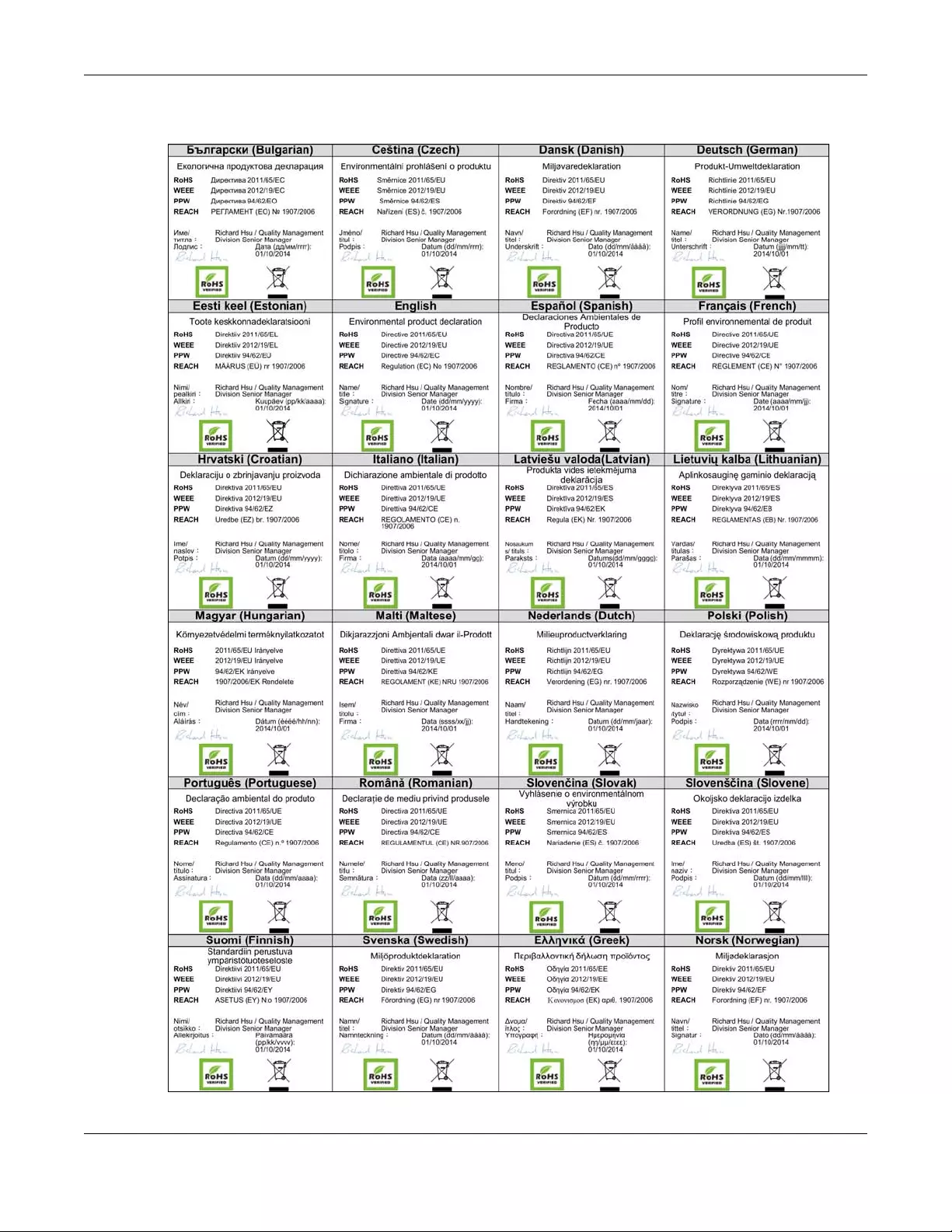
Appendix B Legal Information
ZyWALL/USG Series User’s Guide
782
Environmental Product Declaration

Appendix B Legal Information
ZyWALL/USG Series User’s Guide
783
台灣 以下訊息僅適用於產品銷售至台灣地區這是甲類的資訊產品,在居住的環境中使用時,可能會造成射頻干擾,在這種情況下,
使用者會被要求採取某些適當的對策。
Regulatory Notice and Statement (Class B)
Model List: USG40, USG40W, USG60, USG60W
United States of America
Federal Communications Commission (FCC) EMC Statement
• This device complies with Part 15 of FCC rules. Operation is subject to the following two conditions:
(1) This device may not cause harmful interference.
(2) This device must accept any interference received, including interference that may cause undesired operations.
• Changes or modifications not expressly approved by the party responsible for compliance could void the user’s authority to operate the
equipment.
• This product has been tested and complies with the specifications for a Class B digital device, pursuant to Part 15 of the FCC Rules.
These limits are designed to provide reasonable protection against harmful interference in a residential installation. This equipment
generates, uses, and can radiate radio frequency energy and, if not installed and used according to the instructions, may cause
harmful interference to radio communications. However, there is no guarantee that interference will not occur in a particular
installation.
• If this equipment does cause harmful interference to radio or television reception, which is found by turning the equipment off and on,
the user is encouraged to try to correct the interference by one or more of the following measures:
• Reorient or relocate the receiving antenna
• Increase the separation between the equipment or devices
• Connect the equipment to an outlet other than the receiver’s
• Consult a dealer or an experienced radio/TV technician for assistance
FCC Radiation Exposure Statement: (Models: USG40W, USG60W)
This equipment complies with FCC radiation exposure limits set forth for an uncontrolled environment. This equipment should be installed
and operated with minimum distance 20cm between the radiator & your body.
Canada
The following information applies if you use the product within Canada area
Industry Canada ICES statement
CAN ICES-3 (B)/NMB-3(B)
Industry Canada RSS-GEN & RSS-210 statement (Models: USG40W, USG60W)
This device complies with Industry Canada license-exempt RSS standard(s). Operation is subject to the following two conditions: (1) this
device may not cause interference, and (2) this device must accept any interference, including interference that may cause undesired
operation of the device.
• Under Industry Canada regulations, this radio transmitter may only operate using an antenna of a type and maximum (or lesser) gain
approved for the transmitter by Industry Canada. To reduce potential radio interference to other users, the antenna type and its gain
should be so chosen that the equivalent isotropically radiated power (e.i.r.p.) is not more than that necessary for successful
communication.
• This radio transmitter(2468C-Z2FPM9582 , 2468C-Z5SPM9382 ) has been approved by Industry Canada to operate with the antenna
types listed below with the maximum permissible gain and required antenna impedance for each antenna type indicated. Antenna
types not included in this list, having a gain greater than the maximum gain indicated for that type, are strictly prohibited for use with
this device.
• If you use the produce with 5G wireless function, the following attention shall be paid that,
(i) the device for operation in the band 5150-5250 MHz is only for indoor use to reduce the potential for harmful interference to co-
channel mobile satellite systems;
(ii) the maximum antenna gain permitted for devices in the bands 5250-5350 MHz and 5470-5725 MHz shall comply with the e.i.r.p.
limit; and
(iii) the maximum antenna gain permitted for devices in the band 5725-5825 MHz shall comply with the e.i.r.p. limits specified for
point-to-point and non point-to-point operation as appropriate.
(iv) high-power radars are allocated as primary users (i.e. priority users) of the bands 5250-5350 MHz and 5650-5850 MHz and that
these radars could cause interference and/or damage to LE-LAN devices.
• Le présent appareil est conforme aux CNR d’Industrie Canada applicables aux appareils radio exempts de licence. L’exploitation est
autorisée aux deux conditions suivantes : (1) l’appareil ne doit pas produire de brouillage, et (2) l’utilisateur de l’appareil doit accepter
tout brouillage radioélectrique subi, même si le brouillage est susceptible d’en compromettre le fonctionnement.
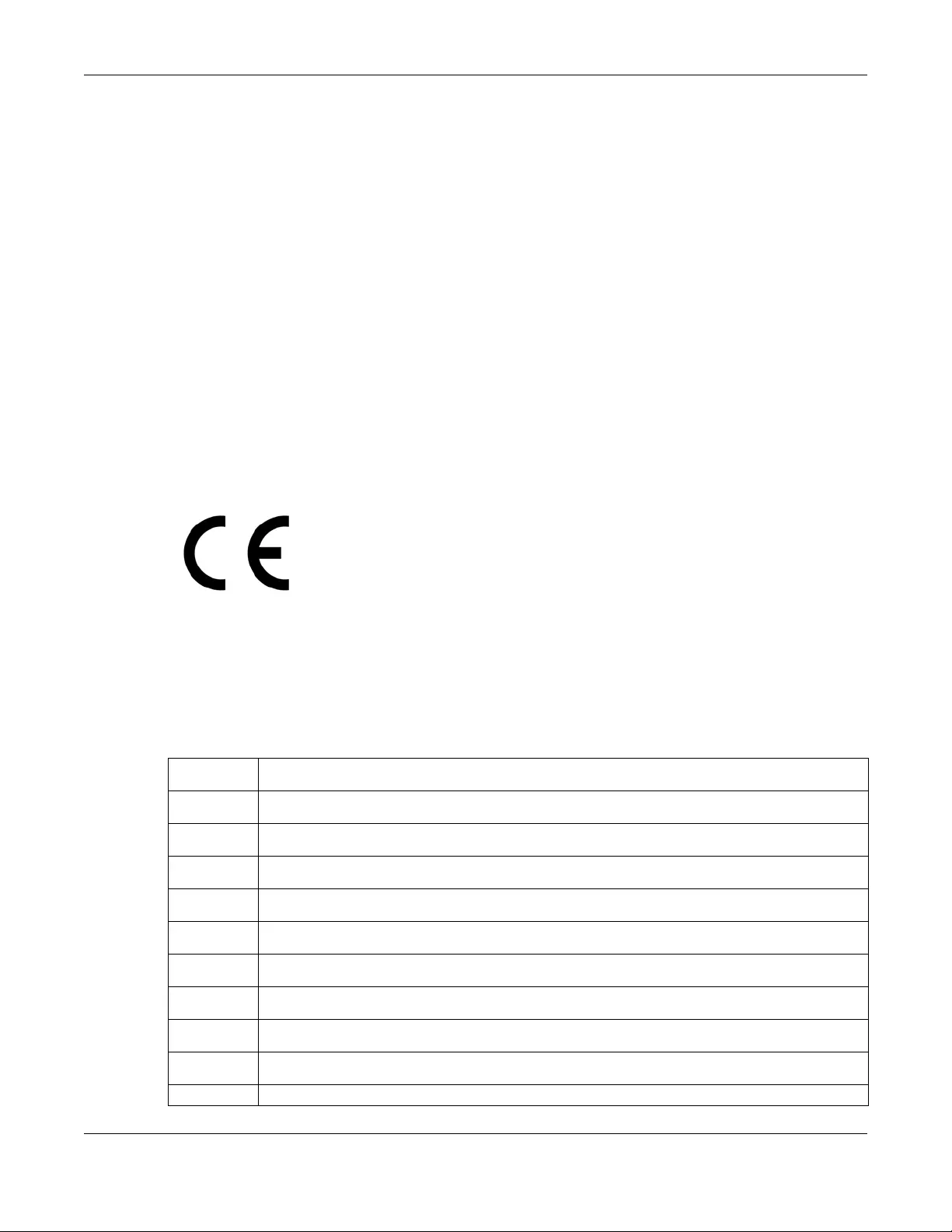
Appendix B Legal Information
ZyWALL/USG Series User’s Guide
784
• Conformément à la réglementation d’Industrie Canada, le présent émetteur radio peut fonctionner avec une antenne d’un type et d’un
gain maximal (ou inférieur) approuvé pour l’émetteur par Industrie Canada. Dans le but de réduire les risques de brouillage
radioélectrique à l’intention des autres utilisateurs, il faut choisir le type d’antenne et son gain de sorte que la puissance isotrope
rayonnée quivalente (p.i.r.e.) ne dépassepas l’intensité nécessaire à l’établissement d’une communication satisfaisante
• Le présent émetteur radio (2468C-Z2FPM9582 , 2468C-Z5SPM9382 ) de modèle s'il fait partie du matériel de catégorieI) a été
approuvé par Industrie Canada pour fonctionner avec les types d'antenne énumérés ci-dessous et ayant un gain admissible maximal et
l'impédance requise pour chaque type d'antenne. Les types d'antenne non inclus dans cette liste, ou dont le gain est supérieur au gain
maximal indiqué, sont strictement interdits pour l'exploitation de l'émetteur.
• Si vous utilisez le produit avec 5G sans fil fonction, suivant l'attention doit être versée que,
(i) les dispositifs fonctionnant dans la bande 5150-5250 MHz sont réservés uniquement pour une utilisation à l’intérieur afin de réduire
les risques de brouillage préjudiciable aux systèmes de satellites mobiles utilisant les mêmes canaux;
(ii) le gain maximal d’antenne permis pour les dispositifs utilisant les bandes 5 250-5 350 MHz et 5 470-5 725 MHz doit se conformer
à la limite de p.i.r.e.;
(iii) le gain maximal d’antenne permis (pour les dispositifs utilisant la bande 5 725-5 825 MHz) doit se conformer à la limite de p.i.r.e.
spécifiée pour l’exploitation point à point et non point à point, selon le cas.
(iv) De plus, les utilisateurs devraient aussi être avisés que les utilisateurs de radars de haute puissance sont désignés utilisateurs
principaux (c.-à-d., qu’ils ont la priorité) pour les bandes 5 250-5 350 MHz et 5 650-5 850 MHz et que ces radars pourraient causer
du brouillage et/ou des dommages aux dispositifs LAN-EL.
Industry Canada radiation exposure statement
This equipment complies with IC radiation exposure limits set forth for an uncontrolled environment. This equipment should be installed
and operated with a minimum distance of 20cm between the radiator and your body.
Déclaration d’exposition aux radiations:
Cet équipement est conforme aux limites d’exposition aux rayonnements IC établies pour un environnement non contrôlé.Cet équipement
doit être installé et utilisé avec un minimum de 20 cm de distance entre la source de rayonnement et votre corps.
European Union
The following information applies if you use the product within the European Union.
Declaration of Conformity with Regard to EU Directive 1999/5/EC (R&TTE Directive)
(Models: USG40W, USG60W)
Compliance Information for 2.4GHz and 5GHz Wireless Products Relevant to the EU and Other Countries Following the EU Directive 1999/5/EC
(R&TTE Directive)
[Czech] ZyXEL tímto prohlašuje, že tento zařízení je ve shodě se základními požadavky a dalšími příslušnými ustanoveními
směrnice 1999/5/EC.
[Danish] Undertegnede ZyXEL erklærer herved, at følgende udstyr udstyr overholder de væsentlige krav og øvrige relevante
krav i direktiv 1999/5/EF.
[German] Hiermit erklärt ZyXEL, dass sich das Gerät Ausstattung in Übereinstimmung mit den grundlegenden Anforderungen
und den übrigen einschlägigen Bestimmungen der Richtlinie 1999/5/EU befindet.
[Estonian] Käesolevaga kinnitab ZyXEL seadme seadmed vastavust direktiivi 1999/5/EÜ põhinõuetele ja nimetatud direktiivist
tulenevatele teistele asjakohastele sätetele.
English Hereby, ZyXEL declares that this equipment is in compliance with the essential requirements and other relevant
provisions of Directive 1999/5/EC.
[Spanish] Por medio de la presente ZyXEL declara que el equipo cumple con los requisitos esenciales y cualesquiera otras
disposiciones aplicables o exigibles de la Directiva 1999/5/CE.
[Greek] ΜΕ ΤΗΝ ΠΑΡΟΥΣΑ ZyXEL ∆ΗΛΩΝΕΙ ΟΤΙ εξοπλισμός ΣΥΜΜΟΡΦΩΝΕΤΑΙ ΠΡΟΣ ΤΙΣ ΟΥΣΙΩ∆ΕΙΣ ΑΠΑΙΤΗΣΕΙΣ ΚΑΙ ΤΙΣ
ΛΟΙΠΕΣ ΣΧΕΤΙΚΕΣ ∆ΙΑΤΑΞΕΙΣ ΤΗΣ Ο∆ΗΓΙΑΣ 1999/5/ΕC.
[French] Par la présente ZyXEL déclare que l'appareil équipements est conforme aux exigences essentielles et aux autres
dispositions pertinentes de la directive 1999/5/EC.
[Italian] Con la presente ZyXEL dichiara che questo attrezzatura è conforme ai requisiti essenziali ed alle altre disposizioni
pertinenti stabilite dalla direttiva 1999/5/CE.
[Latvian] Ar šo ZyXEL deklarē, ka iekārtas atbilst Direktīvas 1999/5/EK būtiskajām prasībām un citiem ar to saistītajiem
noteikumiem.
[Lithuanian] Šiuo ZyXEL deklaruoja, kad šis įranga atitinka esminius reikalavimus ir kitas 1999/5/EB Direktyvos nuostatas.
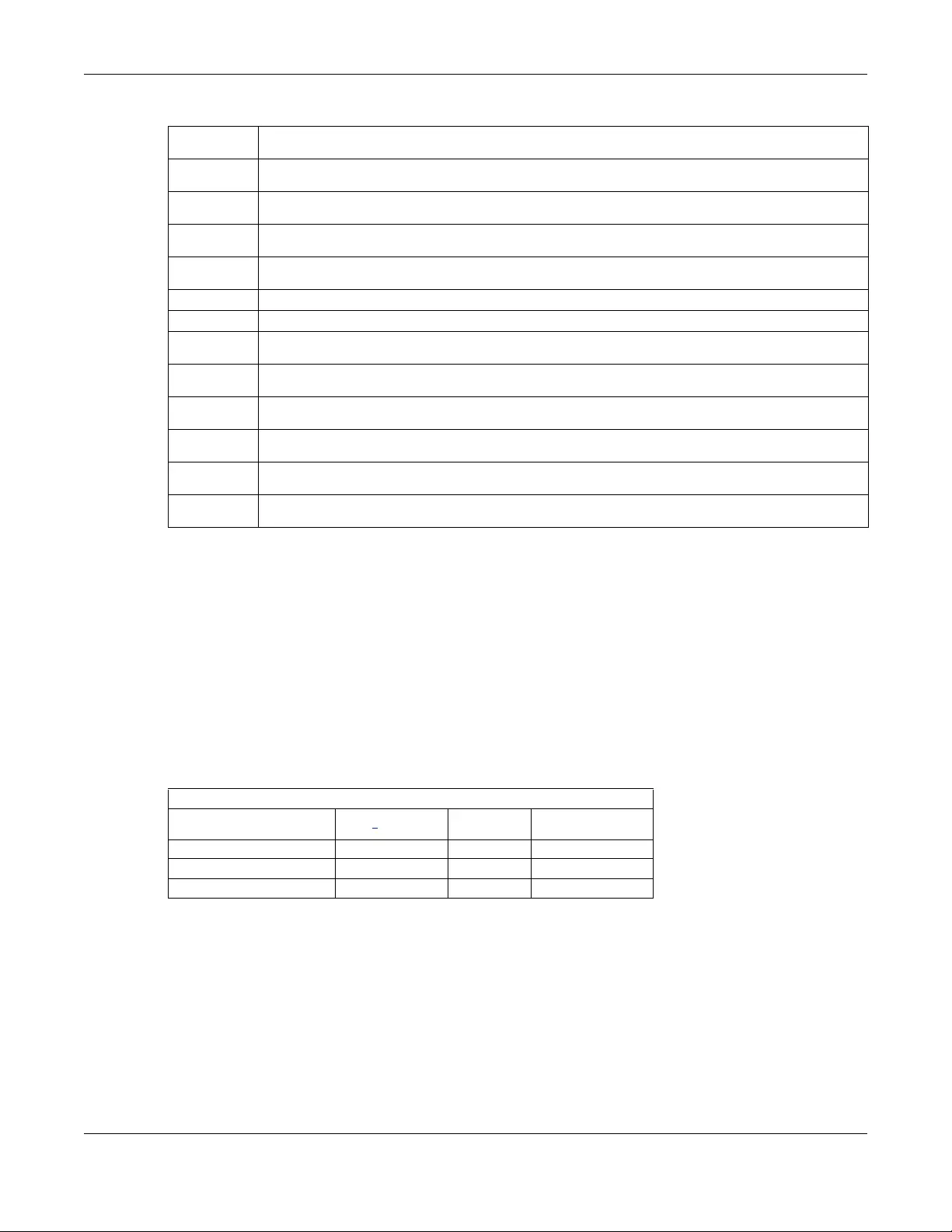
Appendix B Legal Information
ZyWALL/USG Series User’s Guide
785
National Restrictions
This product may be used in all EU countries (and other countries following the EU directive 1999/5/EC) without any limitation except for
the countries mentioned below:
Ce produit peut être utilisé dans tous les pays de l’UE (et dans tous les pays ayant transposés la directive 1999/5/CE) sans aucune
limitation, excepté pour les pays mentionnés ci-dessous:
Questo prodotto è utilizzabile in tutte i paesi EU (ed in tutti gli altri paesi che seguono le direttive EU 1999/5/EC) senza nessuna
limitazione, eccetto per i paesii menzionati di seguito:
Das Produkt kann in allen EU Staaten ohne Einschränkungen eingesetzt werden (sowie in anderen Staaten die der EU Direktive 1995/5/CE
folgen) mit Außnahme der folgenden aufgeführten Staaten:
In the majority of the EU and other European countries, the 2, 4- and 5-GHz bands have been made available for the use of wireless local
area networks (LANs). Later in this document you will find an overview of countries inwhich additional restrictions or requirements or both
are applicable.
The requirements for any country may evolve. ZyXEL recommends that you check with the local authorities for the latest status of their
national regulations for both the 2,4- and 5-GHz wireless LANs.
The following countries have restrictions and/or requirements in addition to those given in the table labeled “Overview of Regulatory
Requirements for Wireless LANs”:.
Belgium
The Belgian Institute for Postal Services and Telecommunications (BIPT) must be notified of any outdoor wireless link having a range
exceeding 300 meters. Please check http://www.bipt.be for more details.
Draadloze verbindingen voor buitengebruik en met een reikwijdte van meer dan 300 meter dienen aangemeld te worden bij het Belgisch
Instituut voor postdiensten en telecommunicatie (BIPT). Zie http://www.bipt.be voor meer gegevens.
Les liaisons sans fil pour une utilisation en extérieur d’une distance supérieure à 300 mètres doivent être notifiées à l’Institut Belge des
services Postaux et des Télécommunications (IBPT). Visitez http://www.ibpt.be pour de plus amples détails.
Denmark
In Denmark, the band 5150 - 5350 MHz is also allowed for outdoor usage.
I Danmark må frekvensbåndet 5150 - 5350 også anvendes udendørs.
France
For 2.4 GHz, the output power is restricted to 10 mW EIRP when the product is used outdoors in the band 2454 - 2483.5 MHz. There are
no restrictions when used indoors or in other parts of the 2.4 GHz band. Check http://www.arcep.fr/ for more details.
[Dutch] Hierbij verklaart ZyXEL dat het toestel uitrusting in overeenstemming is met de essentiële eisen en de andere
relevante bepalingen van richtlijn 1999/5/EC.
[Maltese] Hawnhekk, ZyXEL, jiddikjara li dan tagħmir jikkonforma mal-ħtiġijiet essenzjali u ma provvedimenti oħrajn relevanti li
hemm fid-Dirrettiva 1999/5/EC.
[Hungarian] Alulírott, ZyXEL nyilatkozom, hogy a berendezés megfelel a vonatkozó alapvetõ követelményeknek és az 1999/5/EK
irányelv egyéb elõírásainak.
[Polish] Niniejszym ZyXEL oświadcza, że sprzęt jest zgodny z zasadniczymi wymogami oraz pozostałymi stosownymi
postanowieniami Dyrektywy 1999/5/EC.
[Portuguese] ZyXEL declara que este equipamento está conforme com os requisitos essenciais e outras disposições da Directiva
1999/5/EC.
[Slovenian] ZyXEL izjavlja, da je ta oprema v skladu z bistvenimi zahtevami in ostalimi relevantnimi določili direktive 1999/5/EC.
[Slovak] ZyXEL týmto vyhlasuje, že zariadenia spĺňa základné požiadavky a všetky príslušné ustanovenia Smernice 1999/5/EC.
[Finnish] ZyXEL vakuuttaa täten että laitteet tyyppinen laite on direktiivin 1999/5/EY oleellisten vaatimusten ja sitä koskevien
direktiivin muiden ehtojen mukainen.
[Swedish] Härmed intygar ZyXEL att denna utrustning står I överensstämmelse med de väsentliga egenskapskrav och övriga
relevanta bestämmelser som framgår av direktiv 1999/5/EC.
[Bulgarian] С настоящото ZyXEL декларира, че това оборудване е в съответствие със съществените изисквания и другите
приложими разпоредбите на Директива 1999/5/ЕC.
[Icelandic] Hér með lýsir, ZyXEL því yfir að þessi búnaður er í samræmi við grunnkröfur og önnur viðeigandi ákvæði tilskipunar
1999/5/EC.
[Norwegian] Erklærer herved ZyXEL at dette utstyret er I samsvar med de grunnleggende kravene og andre relevante
bestemmelser I direktiv 1999/5/EF.
[Romanian] Prin prezenta, ZyXEL declară că acest echipament este în conformitate cu cerinţele esenţiale şi alte prevederi
relevante ale Directivei 1999/5/EC.
Overview of Regulatory Requirements for Wireless LANs
Frequency Band (MHz) Max Power Level
(EIRP)1 (mW) Indoor ONLY Indoor and Outdoor
2400-2483.5 100 V
5150-5350 200 V
5470-5725 1000 V

Appendix B Legal Information
ZyWALL/USG Series User’s Guide
786
Pour la bande 2.4 GHz, la puissance est limitée à 10 mW en p.i.r.e. pour les équipements utilisés en extérieur dans la bande 2454 -
2483.5 MHz. Il n'y a pas de restrictions pour des utilisations en intérieur ou dans d'autres parties de la bande 2.4 GHz. Consultez http://
www.arcep.fr/ pour de plus amples détails.
Italy
This product meets the National Radio Interface and the requirements specified in the National Frequency Allocation Table for Italy. Unless
this wireless LAN product is operating within the boundaries of the owner's property, its use requires a “general authorization.” Please
check http://www.sviluppoeconomico.gov.it/ for more details.
Questo prodotto è conforme alla specifiche di Interfaccia Radio Nazionali e rispetta il Piano Nazionale di ripartizione delle frequenze in
Italia. Se non viene installato all 'interno del proprio fondo, l'utilizzo di prodotti Wireless LAN richiede una “Autorizzazione Generale”.
Consultare http://www.sviluppoeconomico.gov.it/ per maggiori dettagli.
Latvia
The outdoor usage of the 2.4 GHz band requires an authorization from the Electronic Communications Office. Please check http://
www.esd.lv for more details.
2.4 GHz frekvenèu joslas izmantoðanai ârpus telpâm nepiecieðama atïauja no Elektronisko sakaru direkcijas. Vairâk informâcijas: http://www.esd.lv.
Notes:
1. Although Norway, Switzerland and Liechtenstein are not EU member states, the EU Directive 1999/5/EC has also been implemented in
those countries.
2. The regulatory limits for maximum output power are specified in EIRP. The EIRP level (in dBm) of a device can be calculated by adding
the gain of the antenna used(specified in dBi) to the output power available at the connector (specified in dBm).
List of National Codes
Safety Warnings
• Do NOT use this product near water, for example, in a wet basement or near a swimming pool.
• Do NOT expose your device to dampness, dust or corrosive liquids.
• Do NOT store things on the device.
• Do NOT install, use, or service this device during a thunderstorm. There is a remote risk of electric shock from lightning.
• Connect ONLY suitable accessories to the device.
• Do NOT open the device or unit. Opening or removing covers can expose you to dangerous high voltage points or other risks. ONLY
qualified service personnel should service or disassemble this device. Please contact your vendor for further information.
• Make sure to connect the cables to the correct ports.
• Place connecting cables carefully so that no one will step on them or stumble over them.
• Always disconnect all cables from this device before servicing or disassembling.
• Use ONLY an appropriate power adaptor or cord for your device. Connect it to the right supply voltage (for example, 110V AC in North
America or 230V AC in Europe).
R&TTE 1999/5/EC
WLAN 2.4 – 2.4835 GHz
IEEE 802.11 b/g/n
Location Frequency Range(GHz) Power (EIRP)
Indoor (No restrictions) 2.4 – 2.4835 100mW (20dBm)
Outdoor 2.4 – 2.454 100mW (20dBm)
2.454 – 2.4835 10mW (10dBm)
COUNTRY ISO 3166 2 LETTER CODE COUNTRY ISO 3166 2 LETTER CODE
Austria AT Malta MT
Belgium BE Netherlands NL
Cyprus CY Poland PL
Czech Republic CR Portugal PT
Denmark DK Slovakia SK
Estonia EE Slovenia SI
Finland FI Spain ES
France FR Sweden SE
Germany DE United Kingdom GB
Greece GR Iceland IS
Hungary HU Liechtenstein LI
Ireland IE Norway NO
Italy IT Switzerland CH
Latvia LV Bulgaria BG
Lithuania LT Romania RO
Luxembourg LU Turkey TR

Appendix B Legal Information
ZyWALL/USG Series User’s Guide
787
• Do NOT remove the plug and connect it to a power outlet by itself; always attach the plug to the power adaptor first before connecting
it to a power outlet.
• Do NOT allow anything to rest on the power adaptor or cord and do NOT place the product where anyone can walk on the power
adaptor or cord.
• Do NOT use the device if the power adaptor or cord is damaged as it might cause electrocution.
• If the power adaptor or cord is damaged, remove it from the device and the power source.
• Do NOT attempt to repair the power adaptor or cord. Contact your local vendor to order a new one.
• Do not use the device outside, and make sure all the connections are indoors. There is a remote risk of electric shock from lightning.
• CAUTION: RISK OF EXPLOSION IF BATTERY (on the motherboard) IS REPLACED BY AN INCORRECT TYPE. DISPOSE OF USED
BATTERIES ACCORDING TO THE INSTRUCTIONS. Dispose them at the applicable collection point for the recycling of electrical and
electronic equipment. For detailed information about recycling of this product, please contact your local city office, your household
waste disposal service or the store where you purchased the product.
• Do NOT obstruct the device ventilation slots, as insufficient airflow may harm your device.
• Antenna Warning! This device meets ETSI and FCC certification requirements when using the included antenna(s). Only use the
included antenna(s).
• If you wall mount your wall-mountable device, make sure that no electrical lines, gas or water pipes will be damaged.
The following warnings apply if product is disconnect device:
• A readily accessible disconnect device shall be incorporated external to the equipment; and/or
• The socket-outlet shall be installed near the equipment and shall be easily accessible.
Environment Statement
ErP (Energy-related Products)
All ZyXEL products put on the EU market in compliance with the requirement of the European Parliament and the Council published
Directive 2009/125/EC establishing a framework for the setting of ecodesign requirements for energy-related products (recast), so called
as “ErP Directive (Energy-related Products directive) as well as ecodesign requirement laid down in applicable implementing measures,
power consumption has satisfied regulation requirements which are:
• Network standby power consumption < 12W and/or
• Off mode power consumption < 0.5W and/or
• Standby mode power consumption < 0.5W.
Please refer to "Wireless" chapter for more details on Wireless settings.
WEEE Directive
Your product is marked with this symbol, which is known as the WEEE mark. WEEE stands for Waste Electronics and Electrical Equipment.
It means that used electrical and electronic products should not be mixed with general waste. Used electrical and electronic equipment
should be treated separately.
"INFORMAZIONI AGLI UTENTI"
Ai sensi della Direttiva 2012/19/UE del Parlamento europeo e del Consiglio, del 4 luglio 2012, sui rifiuti di apparecchiature elettriche ed
elettroniche (RAEE).
Il simbolo del cassonetto barrato riportato sull’apparecchiatura o sulla sua confezione indica che il prodotto alla fine della propria vita utile
deve essere raccolto separatamente dagli altri rifiuti.
La raccolta differenziata della presente apparecchiatura giunta a fine vita è organizzata e gestita dal produttore. L’utente che vorrà disfarsi
della presente apparecchiatura dovrà quindi contattare il
produttore e seguire il sistema che questo ha adottato per consentire la raccolta separata dell’apparecchiatura giunta a fine vita.
L’adeguata raccolta differenziata per l’avvio successivo dell’apparecchiatura dismessa al riciclaggio, al trattamento e allo smaltimento
ambientalmente compatibile contribuisce ad evitare possibili effetti negativi sull’ambiente e sulla salute e favorisce il reimpiego e/o riciclo
dei materiali di cui è composta l’apparecchiatura.
Lo smaltimento abusivo del prodotto da parte del detentore comporta l’applicazione delle sanzioni amministrative previste dalla normativa
vigente."
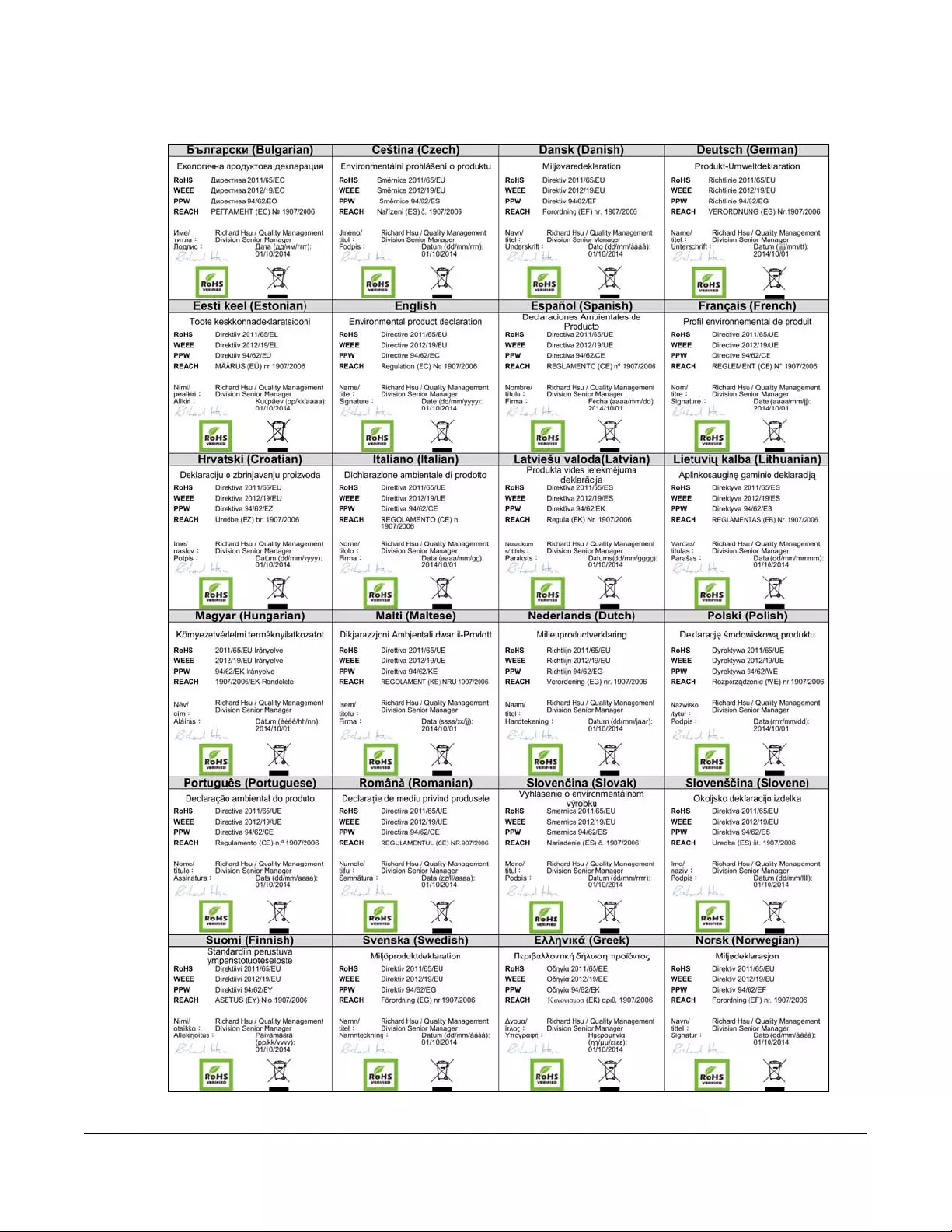
Appendix B Legal Information
ZyWALL/USG Series User’s Guide
788
Environmental Product Declaration

Appendix B Legal Information
ZyWALL/USG Series User’s Guide
789
台灣
以下訊息僅適用於產品銷售至台灣地區
第十二條 經型式認證合格之低功率射頻電機,非經許可,公司、商號或使用者均不得擅自變更頻率、加大功率或變更原設計
之特性及功能。 第十四條 低功率射頻電機之使用不得影響飛航安全及干擾合法通信;經發現有干擾現象時,應立即停用,並改善至無干擾時
方得繼續使用。 前項合法通信,指依電信法規定作業之無線電通信。低功率射頻電機須忍受合法通信或工業、科學及醫療用電波輻射性電機設
備之干擾
Viewing Certifications
Go to http://www.zyxel.com to view this product’s documentation and certifications.
ZyXEL Limited Warranty
ZyXEL warrants to the original end user (purchaser) that this product is free from any defects in material or workmanship for a specific
period (the Warranty Period) from the date of purchase. The Warranty Period varies by region. Check with your vendor and/or the
authorized ZyXEL local distributor for details about the Warranty Period of this product. During the warranty period, and upon proof of
purchase, should the product have indications of failure due to faulty workmanship and/or materials, ZyXEL will, at its discretion, repair or
replace the defective products or components without charge for either parts or labor, and to whatever extent it shall deem necessary to
restore the product or components to proper operating condition. Any replacement will consist of a new or re-manufactured functionally
equivalent product of equal or higher value, and will be solely at the discretion of ZyXEL. This warranty shall not apply if the product has
been modified, misused, tampered with, damaged by an act of God, or subjected to abnormal working conditions.
Note
Repair or replacement, as provided under this warranty, is the exclusive remedy of the purchaser. This warranty is in lieu of all other
warranties, express or implied, including any implied warranty of merchantability or fitness for a particular use or purpose. ZyXEL shall in
no event be held liable for indirect or consequential damages of any kind to the purchaser.
To obtain the services of this warranty, contact your vendor. You may also refer to the warranty policy for the region in which you bought
the device at http://www.zyxel.com/web/support_warranty_info.php.
Registration
Register your product online to receive e-mail notices of firmware upgrades and information at www.zyxel.com for global products, or at
www.us.zyxel.com for North American products.
Open Source Licenses
This product contains in part some free software distributed under GPL license terms and/or GPL like licenses. Open source licenses are
provided with the firmware package. You can download the latest firmware at www.zyxel.com. If you cannot find it there, contact your
vendor or ZyXEL Technical Support at support@zyxel.com.tw.
To obtain the source code covered under those Licenses, please contact your vendor or ZyXEL Technical Support at support@zyxel.com.
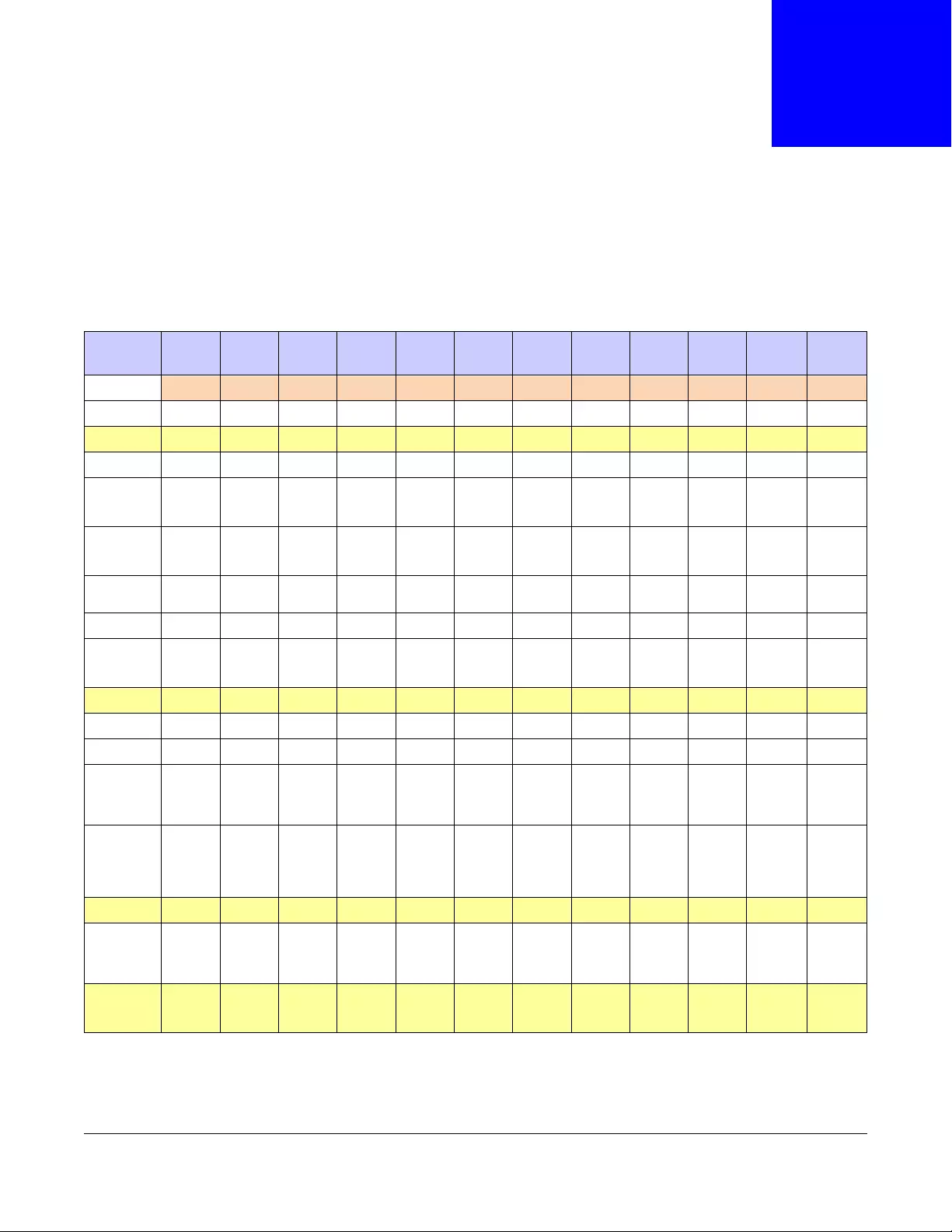
ZyWALL/USG Series User’s Guide
790
APPENDIX C
Product Features
Please refer to the product datasheet for the latest product features.
Ta ble 343 Product Features
MODEL
NAME USG40 USG40W USG60 USG60W ZYWALL
110 USG110 USG210 ZYWALL
310 USG310 ZYWALL
1100 USG1100 USG1900
Version 4.11 4.11 4.11 4.11 4.11 4.11 4.11 4.11 4.11 4.11 4.11 4.11
# of MAC56687778888 8
Interface
VLAN 8 8 16 16 16 16 32 64 64 128 128 128
Virtual
(alias) per
interface
4 4 4 4 4 4 4 4 4 4 4 4
PPP
(system
default)
22223338888 8
PPP (user
create) 224444488161616
Bridge22448881616161616
Tunnel(GRE
/IPv6
Transition)
44444444444 4
Routing
Static route 64 64 128 128 128 128 256 256 256 512 512 512
Policy route 100 100 200 200 500 500 500 1000 1000 1000 1000 2000
Sessions
(Forwardin
g, NAT/
firewall)
20000 20000 40000 40000 80000 60000 80000 100000 100000 500000 500000 500000
Reserved
Sessions
For
Managed
Devices
500 500 500 500 500 500 500 500 500 500 500 500
NAT
Max.
Virtual
Server
Number
128 128 256 256 256 256 512 1024 1024 1024 1024 1024
Firewall
(Security
policy)
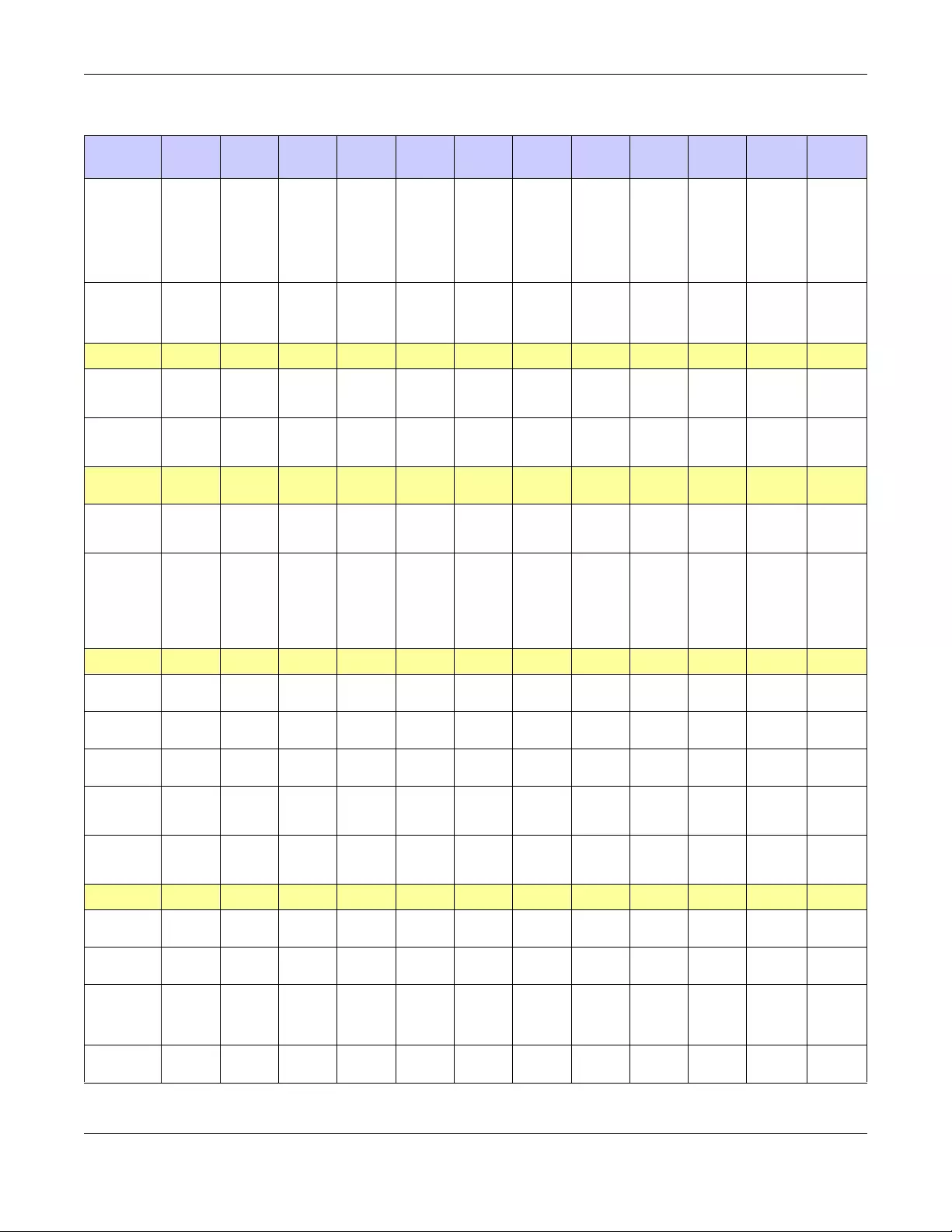
Appendix C Product Features
ZyWALL/USG Series User’s Guide
791
Max
Firewall
ACL Rule
Number =
Secure
Policy
Number
500 500 500 500 500 500 500 2000 2000 5000 5000 10000
Max
Session
Limit per
Host Rules
1000 1000 1000 1000 1000 1000 1000 1000 1000 1000 1000 1000
ADP
Max. ADP
Profile
Number
88888881616161632
Max. ADP
Rule
Number
32 32 32 32 32 32 32 32 32 32 32 32
Application
Patrol
Max.
Apppatrol
Profile
32 32 32 32 32 32 32 64 64 64 64 64
Max
Application
Object In
Each Profile
(Object +
Object
Group)
32 32 32 32 32 32 32 32 32 32 32 32
User Profile
Max. Local
User 64 64 128 128 128 128 128 256 256 512 512 1024
Max.
Admin User 555555555101010
Max. User
Group. 16 16 32 32 32 32 32 64 64 128 128 256
Max User
In One
User Group
64 64 128 128 128 128 128 256 256 512 512 1024
Max
Concurrent
User
64 64 128 128 128 128 128 256 256 512 512 1024
Objects
Address
Object 100 100 200 200 200 200 500 1000 1000 2000 2000 2000
Address
Group 25 25 50 50 50 50 100 200 200 400 400 400
Max.
Address
Object In
One Group
64 64 128 128 128 128 128 128 128 256 256 256
Service
Object 200 200 200 200 500 500 500 1000 1000 1000 1000 1000
Ta ble 343 Product Features
MODEL
NAME USG40 USG40W USG60 USG60W ZYWALL
110 USG110 USG210 ZYWALL
310 USG310 ZYWALL
1100 USG1100 USG1900
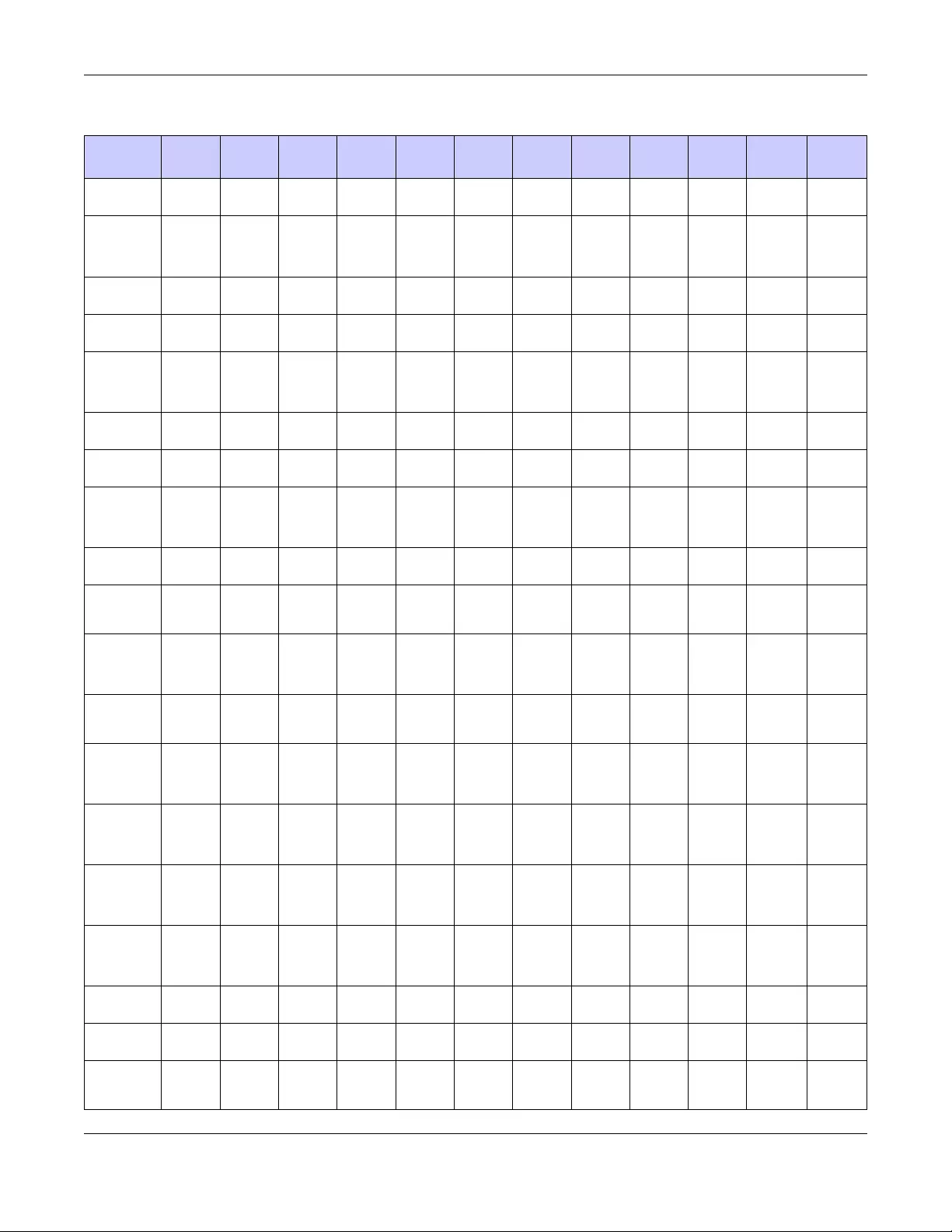
Appendix C Product Features
ZyWALL/USG Series User’s Guide
792
Service
Group 50 50 50 50 100 100 100 200 200 200 200 200
Max.
Service
Object In
One Group
64 64 128 128 128 128 128 128 128 256 256 256
Schedule
Object 32 32 32 32 32 32 32 32 32 32 32 32
Schedule
Group 16 16 16 16 16 16 16 16 16 16 16 16
Max.
Schedule
Object In
One Group
24 24 24 24 24 24 24 24 24 24 24 24
Application
Object 500 500 500 500 500 500 500 1000 1000 1000 1000 1000
Application
Group 100 100 100 100 100 100 100 200 200 200 200 200
Max.
Application
Object In
One Group
128 128 128 128 128 128 128 128 128 256 256 256
ISP
Account 16(PPP
+3G) 16(PPP
+3G) 16(PPP
+3G) 16(PPP
+3G) 16(PPP
+3G) 16(PPP
+3G) 16(PPP
+3G) 32(PPP
+3G) 32(PPP
+3G) 32(PPP
+3G) 128(PP
P+3G) 128(PP
P+3G)
Max. LDAP
Server
Object #
22228881616161616
Max.
Radius
Server
Object #
22228881616161616
Max. AD
Server
Object #
44448881616161616
Max. Zone
Number
(System
Default)
88888888888 8
Max. Zone
Number
(User
Define)
8 8 16 16 16 16 16 16 16 32 32 32
Max. Trunk
Number
(System
Default)
11111111111 1
Max. Trunk
Number
(User
Define)
44444481616323232
Max Radio
Profile 16 16 16 16 16 16 16 16 16 16 16 16
Max SSID
Profile 32 32 32 32 32 32 32 32 32 128 128 128
Max
Security
Profile
32 32 32 32 32 32 32 32 32 32 32 32
Ta ble 343 Product Features
MODEL
NAME USG40 USG40W USG60 USG60W ZYWALL
110 USG110 USG210 ZYWALL
310 USG310 ZYWALL
1100 USG1100 USG1900
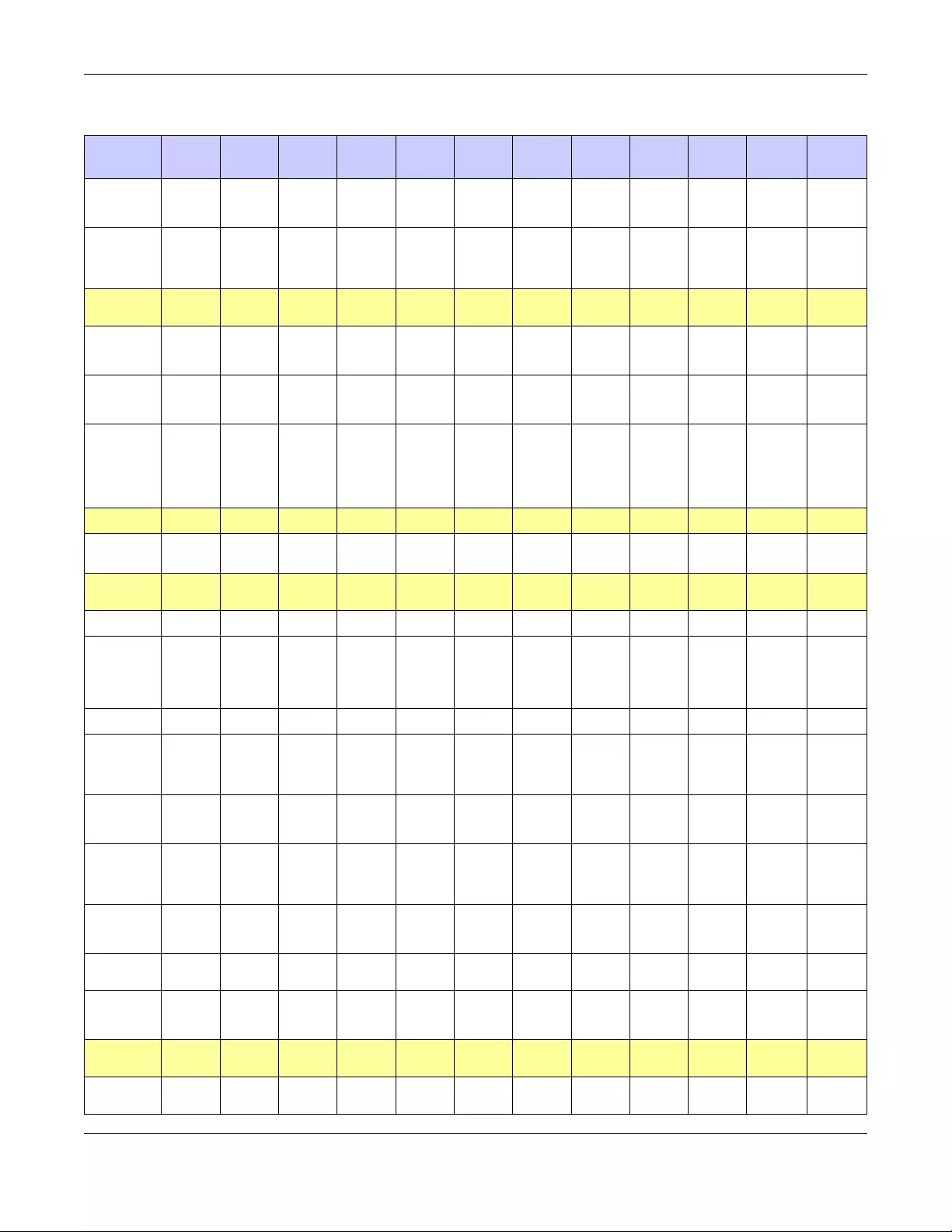
Appendix C Product Features
ZyWALL/USG Series User’s Guide
793
Max
Macfilter
Profile
32 32 32 32 32 32 32 32 32 32 32 32
Max MAC
Entry Per
Macfilter
Profile
512 512 512 512 512 512 512 512 512 512 512 512
VPN
Max. VPN
Tunnels
Number
10 10 20 20 100 100 200 300 300 1000 1000 2000
Max. VPN
Concentrat
or Number
22222221616323264
Max. VPN
Configurati
on
Provision
Rule
Number
10 10 20 20 100 100 200 300 300 1000 1000 2000
Certificate
Certificate
Buffer Size 128k 128k 128k 128k 256k 256k 256k 512k 512k 512k 512k 1024k
Built-in
service
A record 32 32 64 64 64 64 64 128 128 128 128 128
NS record
(DNS
Domain
Zone
Forward)
8 8 8 8 16 16 16 16 16 16 16 16
MX record44888881616161616
Max
Service
Control
Entries
16 per
service 16 per
service 16 per
service 16 per
service 16 per
service 16 per
service 16 per
service 32 per
service 32 per
service 32 per
service 32 per
service 32 per
service
Max. Dhcp
Network
Pool
vlan+b
rg+eth
ernet
vlan+b
rg+eth
ernet
vlan+b
rg+eth
ernet
vlan+b
rg+eth
ernet
vlan+b
rg+eth
ernet
vlan+b
rg+eth
ernet
vlan+b
rg+eth
ernet
vlan+b
rg+eth
ernet
vlan+b
rg+eth
ernet
vlan+b
rg+eth
ernet
vlan+br
g+ether
net
vlan+br
g+ether
net
Max. DHCP
Host
Pool(Static
Dhcp)
64 64 96 96 256 256 256 512 512 1024 1024 1024
Max. DHCP
Extended
Options
10 10 10 10 15 15 15 30 30 30 30 30
Max DDNS
Profiles 5 5 10 10 10 10 10 10 10 10 10 10
DHCP
Relay 2 per
interfac
e
2 per
interfac
e
2 per
interfac
e
2 per
interfac
e
2 per
interfac
e
2 per
interfac
e
2 per
interfac
e
2 per
interfac
e
2 per
interfac
e
2 per
interfac
e
2 per
interfac
e
2 per
interfac
e
USB
Storage
Device
Number 112222222222
Ta ble 343 Product Features
MODEL
NAME USG40 USG40W USG60 USG60W ZYWALL
110 USG110 USG210 ZYWALL
310 USG310 ZYWALL
1100 USG1100 USG1900
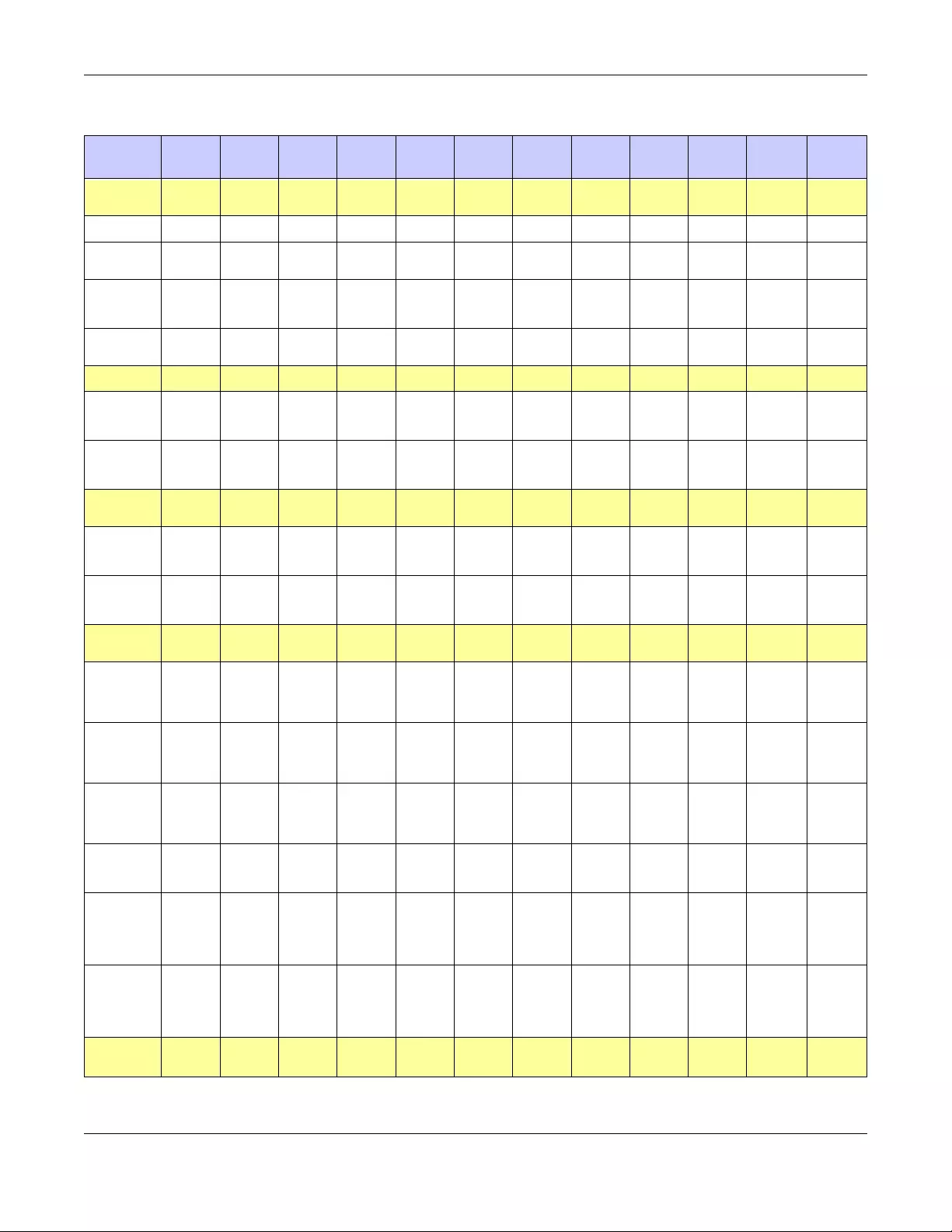
Appendix C Product Features
ZyWALL/USG Series User’s Guide
794
Centralized
Log
Log Entries 512 512 512 512 1024 1024 1024 1024 1024 2048 2048 2048
Debug Log
Entries 1024 1024 1024 1024 1024 1024 1024 1024 1024 1024 1024 1024
Admin E-
mail
Address
22222222222 2
Syslog
Server 444444444444
IDP
Max. IDP
Profile
Number
88888881616161632
Max.
Custom
Signatures
32 32 32 32 32 32 32 256 256 512 512 512
SSL
Inspection
Max. SSL
Inspection
Profile
n/a n/a n/a n/a 8 8 8 16 16 16 16 16
Max.
Exclude
List
n/a n/a n/a n/a 32 32 32 64 64 64 64 64
Content
Filtering
Max.
Number Of
Content
Filter Policy
16 16 16 16 16 16 16 32 32 64 64 128
Forbidden
Domain
Entry
Number
256 per
profile 256 per
profile 256 per
profile 256 per
profile 256 per
profile 256 per
profile 256 per
profile 512 per
profile 512 per
profile 512 per
profile 512 per
profile 512 per
profile
Trusted
Domain
Entry
Number
256 per
profile 256 per
profile 256 per
profile 256 per
profile 256 per
profile 256 per
profile 256 per
profile 512 per
profile 512 per
profile 512 per
profile 512 per
profile 512 per
profile
Keyword
Blocking
Number
128 per
profile 128 per
profile 128 per
profile 128 per
profile 128 per
profile 128 per
profile 128 per
profile 256 per
profile 256 per
profile 256 per
profile 256 per
profile 256 per
profile
Common
Forbidden
Domain
Entry
Number
1024 1024 1024 1024 1024 1024 1024 1024 1024 1024 1024 1024
Common
Trusted
Domain
Entry
Number
1024 1024 1024 1024 1024 1024 1024 1024 1024 1024 1024 1024
Anti-Spam
Ta ble 343 Product Features
MODEL
NAME USG40 USG40W USG60 USG60W ZYWALL
110 USG110 USG210 ZYWALL
310 USG310 ZYWALL
1100 USG1100 USG1900
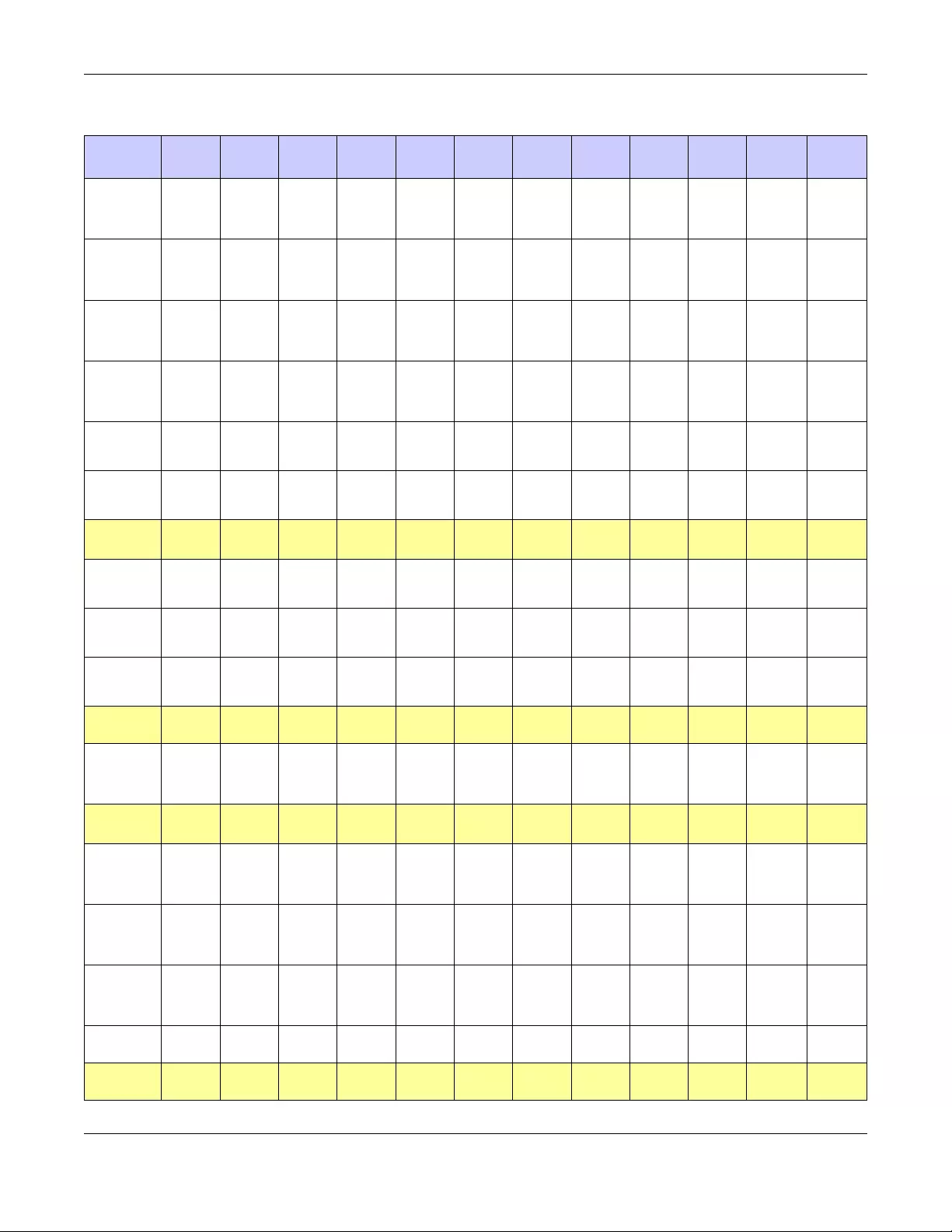
Appendix C Product Features
ZyWALL/USG Series User’s Guide
795
Maximum
AS Rule
Number
(Profile)
16 16 16 16 32 32 32 64 64 64 64 64
Maximum
White List
Rule
Support
128 128 128 128 128 128 128 256 256 256 256 256
Maximum
Black List
Rule
Support
128 128 128 128 128 128 128 256 256 256 256 256
Maximum
DNSBL
Domain
Support
55555551010101010
Max.
Statistics
Number
500 500 500 500 500 500 500 500 500 500 500 500
Max.
Statistics
Ranking
10 10 10 10 10 10 10 10 10 10 10 10
Anti-Virus
Max. AV
Rule
(Profile)
16 16 16 16 16 16 16 32 32 32 32 32
Max.
Statistics
Number
500 500 500 500 500 500 500 500 500 500 500 500
Max.
Statistics
Ranking
10 10 10 10 10 10 10 10 10 10 10 10
MyZyXEL.c
om
SKU
update
interval
(day)
2 ~ 6
hrs 2 ~ 6
hrs 2 ~ 6
hrs 2 ~ 6
hrs 2 ~ 6
hrs 2 ~ 6
hrs 2 ~ 6
hrs 2 ~ 6
hrs 2 ~ 6
hrs 2 ~ 6
hrs 2 ~ 6
hrs 2 ~ 6
hrs
SSL VPN
Default
SSL VPN
Connection
s
5 5 5 5 25 25 35 50 50 250 250 250
Maximum
SSL VPN
Connection
s
15 15 20 20 150 150 150 150 150 500 500 750
Max. SSL
VPN
Network
List
88888888888 8
SSL VPN
Max Policy 16 16 16 16 16 16 16 16 16 16 16 16
AP
controller
Ta ble 343 Product Features
MODEL
NAME USG40 USG40W USG60 USG60W ZYWALL
110 USG110 USG210 ZYWALL
310 USG310 ZYWALL
1100 USG1100 USG1900
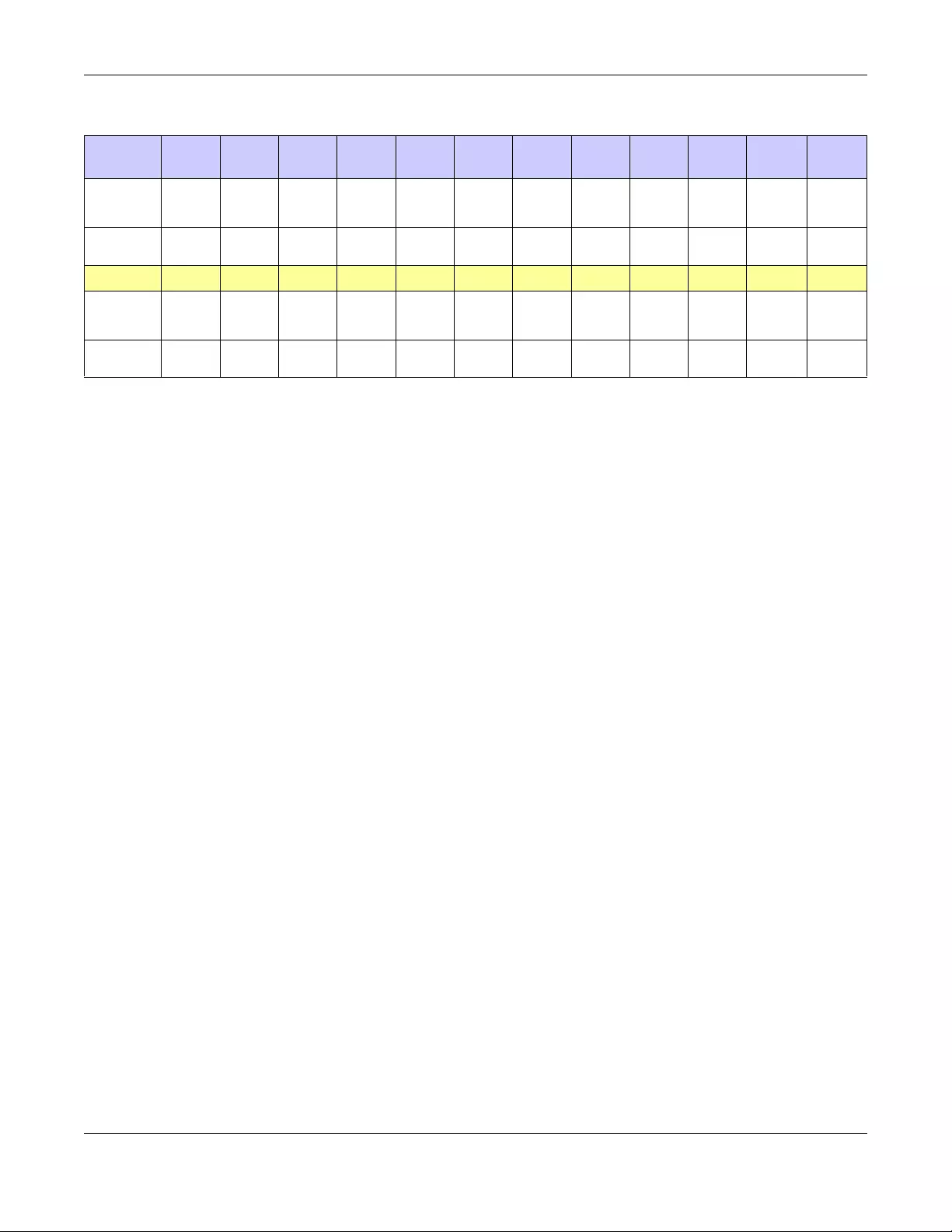
Appendix C Product Features
ZyWALL/USG Series User’s Guide
796
Default #
Of Control
AP
22222222222 2
Max. # Of
Control AP 10 10 10 10 18 18 18 18 18 18 18 18
Others
Device HA
VRRP
Group
32 32 32 32 32 32 32 32 32 32 32 32
Max OSPF
Areas 32 32 32 32 32 32 32 32 32 32 32 32
Ta ble 343 Product Features
MODEL
NAME USG40 USG40W USG60 USG60W ZYWALL
110 USG110 USG210 ZYWALL
310 USG310 ZYWALL
1100 USG1100 USG1900

Index
ZyWALL/USG Series User’s Guide
797
Index
Symbols
Numbers
3322 Dynamic DNS 286
3DES 402
6in4 tunneling 220
6to4 tunneling 221
A
AAA
Base DN 621
Bind DN 621, 624
directory structure 620
Distinguished Name, see DN
DN 621, 622, 624
password 624
port 624, 626
search time limit 624
SSL 624
AAA server 618
AD 620
and users 564
directory service 619
LDAP 619, 620
local user database 620
RADIUS 619, 620, 625
RADIUS group 626
see also RADIUS
access 25
access control attacks 492
Access Point Name, see APN
access users 564, 565
custom page 679
forcing login 336
idle timeout 572
logging in 336
multiple logins 573
see also users 564
Web Configurator 574
access users, see also force user authentication
policies
account
user 563, 653
accounting server 618
Active Directory, see AD
active protocol 407
AH 407
and encapsulation 407
ESP 407
active sessions 97, 117
ActiveX 479
AD 619, 621, 622, 624
directory structure 620
Distinguished Name, see DN
password 624
port 624, 626
search time limit 624
SSL 624
address groups 602
and content filtering 465, 466
and FTP 697
and security policy 340
and SNMP 701
and SSH 693
and Telnet 695
and WWW 679
address objects 602
and content filtering 465, 466
and FTP 697
and NAT 271, 295
and policy routes 270
and security policy 340
and SNMP 701
and SSH 693
and Telnet 695
and VPN connections 381
and WWW 679
HOST 603

Index
ZyWALL/USG Series User’s Guide
798
RANGE 603
SUBNET 603
types of 603
address record 668
admin user
troubleshooting 768, 769
admin users 564
multiple logins 572
see also users 564
ADP 363
false negatives 365
false positives 365
inline profile 365
monitor profile 365
Advanced Encryption Standard, see AES
AES 402
AF 274
AH 386, 407
and transport mode 408
alerts 717, 718, 721, 724, 726, 727
anti-spam 525
anti-virus 514
IDP 489, 490, 542
ALG 303, 309
and NAT 303, 305
and policy routes 305, 309
and security policy 303, 305
and trunks 309
FTP 303, 304
H.323 303, 304, 309
peer-to-peer calls 305
RTP 310
see also VoIP pass through 303
SIP 303, 304
Anomaly Detection and Prevention, see ADP
anti-spam 521, 525, 528
action for spam mails 526
alerts 525
and registration 524
black list 521, 525, 528
concurrent e-mail sessions 147, 523
DNSBL 522, 526, 533
e-mail header buffer 522
e-mail headers 522
excess e-mail sessions 523
general settings 523
identifying legitimate e-mail 521
identifying spam 521
log options 525
mail scan 526
mail sessions threshold 523
POP2 522
POP3 522
registration status 524
regular expressions 531
SMTP 522
status 148
white list 521, 525, 530, 531
anti-virus 509, 510
alerts 514
black list 514, 516
boot sector virus 519
EICAR 512
e-mail virus 519
engines 510
file decompression 515
file infector virus 519
firmware package blocking 515
log options 514
macro virus 519
packet scan 510
packet types 510
polymorphic virus 519
registration status 513
scanner types 520
signatures 518
statistics 144
troubleshooting 760, 763
troubleshooting signatures update 760
updating signatures 158
virus 510
virus types 519
white list 518
worm 510
APN 215
Application Layer Gateway, see ALG
application patrol 459
actions 459
and HTTP redirect 300
and security policy 459
classification 460
exceptions 459
port-less 460
ports 460
service ports 460
troubleshooting 760, 765, 768
troubleshooting signatures update 760

Index
ZyWALL/USG Series User’s Guide
799
updating signatures 160
AppPatrol, see application patrol 160
ASAS (Authenex Strong Authentication
System) 619
asymmetrical routes 358
allowing through the security policy 360
vs virtual interfaces 358
attacks
access control 492
backdoor 492
buffer overflow 492
Denial of Service (DoS) 384
DoS/DDoS 492
false negatives 487
false positives 487
IM 492
known 485
P2P 492
scan 493
severity of 490
spam 493
trapdoor 492
trojan 492
virus 493, 510
worm 493
Authenex Strong Authentication System
(ASAS) 619
authentication
in IPSec 386
LDAP/AD 620
server 618
authentication algorithms 284, 402, 403
and active protocol 402
and routing protocols 284
MD5 284, 403
SHA1 403
text 284
Authentication Header, see AH
authentication method objects 627
and users 564
and WWW 678
create 629
example 627
authentication policy
exceptional services 338
Authentication server
RADIUS client 703
authentication server 702
authentication type 60, 647
Authentication, Authorization, Accounting servers,
see AAA server
authorization server 618
auxiliary interfaces 178
B
backdoor attacks 492
backing up configuration files 731
bandwidth
egress 216, 225
ingress 216, 225
bandwidth limit
troubleshooting 762
bandwidth management 459
maximize bandwidth usage 274, 448
see also application patrol 459
troubleshooting 763
Base DN 621
base profiles
in IDP 486
Batch import 704
Bind DN 621, 624
BitTorrent 492
black list 525, 528
anti-spam 521
Blaster 507
bookmarks 427
boot sector virus 519
bridge interfaces 178, 239
and virtual interfaces of members 240
basic characteristics 179
effect on routing table 239
member interfaces 239
virtual 250
bridges 238
buffer overflow 492
buffer overflow attacks 492
C
CA

Index
ZyWALL/USG Series User’s Guide
800
and certificates 631
CA (Certificate Authority), see certificates
Calling Station ID 589
capturing packets 742
card SIM 216
CEF (Common Event Format) 714, 723
cellular 210
APN 215
interfaces 178
signal quality 124, 125
SIM card 216
status 126
system 124
troubleshooting 762
certificate
troubleshooting 769
Certificate Authority (CA)
see certificates
Certificate Revocation List (CRL) 631
vs OCSP 645
certificates 630
advantages of 631
and CA 631
and FTP 696
and HTTPS 674
and IKE SA 406
and SSH 692
and synchronization (device HA) 559
and VPN gateways 381
and WWW 677
certification path 631, 638, 643
expired 631
factory-default 631
file formats 632
fingerprints 639, 644
importing 634
in IPSec 393
not used for encryption 631
revoked 631
self-signed 631, 636
serial number 638, 643
storage space 634, 641
thumbprint algorithms 632
thumbprints 632
used for authentication 631
verifying fingerprints 632
certification requests 636
certifications 783
notices 780
viewing 789
Challenge Handshake Authentication Protocol
(CHAP) 647
CHAP (Challenge Handshake Authentication
Protocol) 647
CHAP/PAP 647
CLI 25, 31
button 31
messages 31
popup window 31
Reference Guide 2
client 435
cloud-based network management system 704
cluster ID 551
commands 25
sent by Web Configurator 31
Common Event Format (CEF) 714, 723
compression (stac) 648
computer names 198, 236, 248, 254, 442
computer virus 510
infection and prevention 520
see also virus
concurrent e-mail sessions 147, 523
configuration
information 740
web-based SSL application example 649
configuration file
troubleshooting 770
configuration files 729
at restart 732
backing up 731
downloading 733, 749
downloading with FTP 696
editing 729
how applied 730
lastgood.conf 732, 735
managing 731
startup-config.conf 735
startup-config-bad.conf 732
syntax 730
system-default.conf 735
uploading 735
uploading with FTP 696
use without restart 729
connection
troubleshooting 765

Index
ZyWALL/USG Series User’s Guide
801
connection monitor (in SSL) 137
connectivity check 197, 209, 216, 225, 235, 249, 387
console port
speed 663
contact information 773, 790
content (pattern) 503
content filter
troubleshooting 760
content filtering 465, 466
and address groups 465, 466
and address objects 465, 466
and registration 468, 471
and schedules 465, 466
and user groups 465
and users 465
by category 465, 466, 472
by keyword (in URL) 466, 480
by URL 466, 479, 481, 482
by web feature 466, 479
cache 483
categories 472
category service 471
default policy 466
external web filtering service 471, 483
filter list 466
managed web pages 472
policies 465, 466
registration status 157, 468, 471
statistics 140
testing 473
uncategorized pages 472
unsafe web pages 471
URL for blocked access 468
cookies 25, 479
copyright 779
CPU usage 97
current date/time 92, 659
and schedules 613
daylight savings 661
setting manually 662
time server 663
current user list 137
custom
access user page 679
login page 679
custom signatures 496, 499, 764
applying 505
example 503
verifying 506
custom.rules file 499, 764
customer support 773, 790
D
Data Encryption Standard, see DES
date 659
daylight savings 661
DDNS 286
backup mail exchanger 291
mail exchanger 291
service providers 286
troubleshooting 765
DDoS attacks 492
Dead Peer Detection, see DPD
decompression of files (in anti-virus) 515
default
security policy behavior 356
Default_L2TP_VPN_GW 440
Denial of Service (DoS) attacks 492
Denial of Service (Dos) attacks 384
DES 402
device access
troubleshooting 759
device HA 548
active-passive mode 548, 550
cluster ID 551
copying configuration 549
HA status 550
legacy mode 548
management access 548
management IP address 548
modes 548
monitored interfaces 551, 555
password 555
synchronization 549, 559
synchronization password 555
synchronization port number 555
virtual router 550
virtual router and management IP
addresses 551
device High Availability see device HA 548
DHCP 253, 658
and DNS servers 254

Index
ZyWALL/USG Series User’s Guide
802
and domain name 658
and interfaces 253
pool 254
static DHCP 254
DHCP Unique IDentifier 182
DHCPv6 653
DHCP Unique IDentifier 182
DHCPv6 Request 654
diagnostics 740
Differentiated Services Code Point (DSCP) 497
Diffie-Hellman key group 403
DiffServ 274
Digital Signature Algorithm public-key algorithm,
see DSA
direct routes 266
directory 619
directory service 619
file structure 620
disclaimer 779
Distinguished Name (DN) 621, 622, 624
Distributed Denial of Service (DDoS) attacks 492
DN 621, 622, 624
DNS 664
address records 668
domain name forwarders 669
domain name to IP address 668
IP address to domain name 668
L2TP VPN 442
Mail eXchange (MX) records 671
pointer (PTR) records 668
DNS Blacklist see DNSBL 522
DNS inbound LB 329
DNS servers 61, 664, 669
and interfaces 254
DNSBL 522, 526, 533
see also anti-spam 522
documentation
related 2
domain name 658
Domain Name System, see DNS
DoS (Denial of Service) attacks 492
DPD 395
DSA 636
DSCP 267, 270, 450, 754
DUID 182
Dynamic Domain Name System, see DDNS
Dynamic Host Configuration Protocol, see DHCP.
dynamic peers in IPSec 385
DynDNS 286
DynDNS see also DDNS 286
Dynu 286
E
e-Donkey 492
egress bandwidth 216, 225
EICAR 512
Ekahau RTLS 352
e-mail 521
daily statistics report 710
header buffer 522
headers 522
virus 519
e-Mule 492
Encapsulating Security Payload, see ESP
encapsulation
and active protocol 407
IPSec 386
transport mode 407
tunnel mode 407
VPN 407
encryption
and anti-virus 515
IPSec 386
RSA 638
encryption algorithms 402
3DES 402
AES 402
and active protocol 402
DES 402
encryption method 647
end of IP list 497
enforcing policies in IPSec 385
ESP 386, 407
and transport mode 408
Ethernet interfaces 178
and OSPF 185
and RIP 185
and routing protocols 183
basic characteristics 179

Index
ZyWALL/USG Series User’s Guide
803
virtual 250
exceptional services 338
extended authentication
and VPN gateways 381
IKE SA 406
Extended Service Set IDentification 578
ext-user
troubleshooting 768
F
false negatives 365, 487
false positives 365, 368, 487
FCC interference statement 779, 783
file decompression (in anti-virus) 515
file extensions
configuration files 729
shell scripts 729
file infector 519
file manager 729
file sharing SSL application
create 651
Firefox 25
firmware
and restart 735
current version 92, 736
getting updated 735
uploading 735, 737
uploading with FTP 696
firmware package
troubleshooting 767
firmware upload
troubleshooting 770
flags 497
flash usage 97
forcing login 336
FQDN 668
fragmentation flag 501
fragmentation offset 501
FTP 696
additional signaling port 308
ALG 303
and address groups 697
and address objects 697
and certificates 696
and zones 697
signaling port 308
troubleshooting 765
with Transport Layer Security (TLS) 696
full tunnel mode 411, 415
Fully-Qualified Domain Name, see FQDN
G
Generic Routing Encapsulation, see GRE.
global SSL setting 416
user portal logo 417
GRE 255
GSM 216
Guide
CLI Reference 2
Quick Start 2
H
H.323 309
additional signaling port 308
ALG 303, 309
and RTP 310
and security policy 304
signaling port 308
troubleshooting 765
HA status see device HA 550
header checksum 497
host-based intrusions 506
HSDPA 216
HTTP
over SSL, see HTTPS
redirect to HTTPS 677
vs HTTPS 674
HTTP redirect 299
and application patrol 300
and interfaces 302
and policy routes 300
and security policy 300
packet flow 300
troubleshooting 765
HTTPS 674

Index
ZyWALL/USG Series User’s Guide
804
and certificates 674
authenticating clients 674
avoiding warning messages 684
example 683
vs HTTP 674
with Internet Explorer 683
with Netscape Navigator 683
hub-and-spoke VPN, see VPN concentrator
HyperText Transfer Protocol over Secure Socket
Layer, see HTTPS
I
ICMP 609
code 502
sequence number 502
type 502
identification (IP) 501
identifying
legitimate e-mail 521
spam 521
IDP 484
action 370, 489, 491, 543
alerts 489, 490, 542
applying custom signatures 505
base profiles 486
custom signature example 503
custom signatures 496
false negatives 487
false positives 487
inline profile 487
log options 368, 371, 489, 490, 491, 542, 543
monitor profile 487
packet inspection profiles 487
packet inspection signatures 487
query view 489, 491
registration status 486
reject sender 370, 489, 491, 543
reject-both 370, 489, 491, 543
reject-receiver 370, 489, 491, 543
service group 493
severity 490
signature ID 491, 543
signatures 484
signatures and synchronization (device HA) 559
Snort signatures 507
statistics 142
troubleshooting 760, 764
troubleshooting signatures update 760
updating signatures 160
verifying custom signatures 506
IEEE 802.1q VLAN
IEEE 802.1q. See VLAN.
IEEE 802.1x 578
IHL (IP Header Length) 497
IKE SA
aggressive mode 401, 405
and certificates 406
and RADIUS 406
and to-ZyWALL security policy 766
authentication algorithms 402, 403
content 404
Dead Peer Detection (DPD) 395
Diffie-Hellman key group 403
encryption algorithms 402
extended authentication 406
ID type 404
IP address, remote IPSec router 402
IP address, ZyXEL device 402
local identity 404
main mode 401, 405
NAT traversal 406
negotiation mode 401
password 406
peer identity 404
pre-shared key 404
proposal 402
see also VPN
user name 406
IM (Instant Messenger) 492
IMAP 522
iMesh 492
inbound LB algorithm
least connection 331
least load 331
weighted round robin 331
inbound load balancing 329
time to live 332
incoming bandwidth 216, 225
ingress bandwidth 216, 225
inline profile 365, 487
inspection signatures 485
Instant Messenger (IM) 459, 492
managing 459

Index
ZyWALL/USG Series User’s Guide
805
interface
status 112
troubleshooting 761
interfaces 177
and DNS servers 254
and HTTP redirect 302
and layer-3 virtualization 178
and NAT 295
and physical ports 178
and policy routes 270
and static routes 273
and VPN gateways 381
and zones 178
as DHCP relays 253
as DHCP servers 253, 658
auxiliary, see also auxiliary interfaces.
backup, see trunks
bandwidth management 253, 261, 262
bridge, see also bridge interfaces.
cellular 178
DHCP clients 252
Ethernet, see also Ethernet interfaces.
gateway 253
general characteristics 178
IP address 252
metric 253
MTU 253
overlapping IP address and subnet mask 252
port groups, see also port groups.
PPPoE/PPTP, see also PPPoE/PPTP interfaces.
prerequisites 179
relationships between 179
static DHCP 254
subnet mask 252
trunks, see also trunks.
Tunnel, see also Tunnel interfaces.
types 178
virtual, see also virtual interfaces.
VLAN, see also VLAN interfaces.
WLAN, see also WLAN interfaces.
Internet access
troubleshooting 759, 768
Internet Control Message Protocol, see ICMP
Internet Explorer 25
Internet Message Access Protocol, see IMAP 522
Internet Protocol (IP) 496
Internet Protocol Security, see IPSec
Internet Protocol version 6, see IPv6
Intrusion, Detection and Prevention see IDP 484
intrusions
host 506
network 506
IP (Internet Protocol) 496
IP options 497, 502
IP policy routing, see policy routes
IP pool 415
IP protocols 609
and service objects 609
ICMP, see ICMP
TCP, see TCP
UDP, see UDP
IP security option 497
IP static routes, see static routes
IP stream identifier 497
IP v4 packet headers 497
IP/MAC binding 320
exempt list 323
monitor 120
static DHCP 322
IPSec 376
active protocol 386
AH 386
and certificates 381
authentication 386
basic troubleshooting 766
certificates 393
connections 381
connectivity check 387
Default_L2TP_VPN_GW 440
encapsulation 386
encryption 386
ESP 386
established in two phases 379
L2TP VPN 439
local network 376
local policy 385
NetBIOS 384
peer 376
Perfect Forward Secrecy 387
PFS 387
phase 2 settings 385
policy enforcement 385
remote access 385
remote IPSec router 376
remote network 376
remote policy 385

Index
ZyWALL/USG Series User’s Guide
806
replay detection 384
SA life time 385
SA monitor 136
SA see also IPSec SA 407
see also VPN
site-to-site with dynamic peer 385
static site-to-site 385
transport encapsulation 386
tunnel encapsulation 386
VPN gateway 381
IPSec SA
active protocol 407
and security policy 767
and to-ZyWALL security policy 766
authentication algorithms 402, 403
destination NAT for inbound traffic 410
encapsulation 407
encryption algorithms 402
local policy 407
NAT for inbound traffic 408
NAT for outbound traffic 408
Perfect Forward Secrecy (PFS) 408
proposal 408
remote policy 407
search by name 136
search by policy 136
Security Parameter Index (SPI) (manual
keys) 408
see also IPSec
see also VPN
source NAT for inbound traffic 409
source NAT for outbound traffic 409
status 136
transport mode 407
tunnel mode 407
when IKE SA is disconnected 407
IPSec VPN
troubleshooting 766
IPv6 180
link-local address 181
prefix 180
prefix delegation 181
prefix length 180
stateless autoconfiguration 181
IPv6 tunnelings
6in4 tunneling 220
6to4 tunneling 221
IPv6-in-IPv4 tunneling 220
ISP account
CHAP 647
CHAP/PAP 647
MPPE 647
MSCHAP 647
MSCHAP-V2 647
PAP 647
ISP accounts 645
and PPPoE/PPTP interfaces 204, 645
authentication type 647
encryption method 647
stac compression 648
J
Java 479
permissions 25
JavaScripts 25
K
key pairs 630
L
L2TP VPN 439
Default_L2TP_VPN_GW 440
DNS 442
IPSec configuration 439
policy routes 440
session monitor 138
WINS 442
lastgood.conf 732, 735
Layer 2 Tunneling Protocol Virtual Private Network,
see L2TP VPN 439
layer-2 isolation 325
example 325
IP 326
LDAP 619
and users 564
Base DN 621
Bind DN 621, 624
directory 619
directory structure 620

Index
ZyWALL/USG Series User’s Guide
807
Distinguished Name, see DN
DN 621, 622, 624
password 624
port 624, 626
search time limit 624
SSL 624
user attributes 577
least connection algorithm 331
least load algorithm 331
least load first load balancing 256
LED troubleshooting 759
legitimate e-mail 521
level-4 inspection 460
level-7 inspection 460
licensing 156
Lightweight Directory Access Protocol, see LDAP
Link Layer Discovery Protocol (LLDP ) 127
LLDP (Link Layer Discovery Protocol) 127
load balancing 255
algorithms 256, 260, 262
DNS inbound 329
least load first 256
round robin 257
see also trunks 255
session-oriented 256
spillover 257
weighted round robin 257
local user database 620
log
troubleshooting 770
log messages
categories 718, 721, 724, 726, 727
debugging 152
regular 152
types of 152
log options 514, 525
(IDP) 368, 371, 489, 490, 491, 542, 543
login
custom page 679
SSL user 423
logo
troubleshooting 770
logo in SSL 417
logout
SSL user 428
Web Configurator 28
logs
and security policy 363
e-mail profiles 712
e-mailing log messages 155, 717
formats 714
log consolidation 719
settings 712
syslog servers 712
system 712
types of 712
loose source routing 497
M
MAC address 575
and VLAN 226
Ethernet interface 193
range 92
MAC authentication 589
Calling Station ID 589
case 589
delimiter 589
mac role 575
macro virus 519
mail sessions threshold 523
managed web pages 472
management access
troubleshooting 769
management access and device HA 548
Management Information Base (MIB) 698, 699
managing the device
using SNMP. See SNMP.
MD5 403
memory usage 97
Message Digest 5, see MD5
messages
CLI 31
metrics, see reports
Microsoft
Challenge-Handshake Authentication Protocol
(MSCHAP) 647
Challenge-Handshake Authentication Protocol
Version 2 (MSCHAP-V2) 647
Point-to-Point Encryption (MPPE) 647
mobile broadband see also cellular 210

Index
ZyWALL/USG Series User’s Guide
808
model name 92
Monitor 704
monitor 137
SA 136
monitor profile
ADP 365
IDP 487
monitored interfaces 551
device HA 555
mounting
rack 24, 54
wall 55
MPPE (Microsoft Point-to-Point Encryption) 647
MSCHAP (Microsoft Challenge-Handshake
Authentication Protocol) 647
MSCHAP-V2 (Microsoft Challenge-Handshake
Authentication Protocol Version 2) 647
MTU 216, 225
multicast 583
multicast rate 583
mutation virus 519
My Certificates, see also certificates 633
MyDoom 507
myZyXEL.com 156, 160
accounts, creating 156
and IDP 461, 486
N
NAT 274, 292
ALG, see ALG
and address objects 271
and address objects (HOST) 295
and ALG 303, 305
and interfaces 295
and policy routes 264, 271
and security policy 358
and to-ZyWALL security policy 296
and VoIP pass through 305
and VPN 405
loopback 296
port forwarding, see NAT
port translation, see NAT
traversal 406
NAT Port Mapping Protocol 311
NAT Traversal 311
NAT-PMP 311
NBNS 198, 236, 248, 254, 415
NetBIOS
Broadcast over IPSec 384
Name Server, see NBNS.
NetBIOS Name Server, see NBNS
NetMeeting 309
see also H.323
Netscape Navigator 25
network access mode 23
full tunnel 411
Network Address Translation, see NAT
network list, see SSL 416
Network Time Protocol (NTP) 662
network-based intrusions 506, 507
Nimda 507
no IP options 497
No-IP 286
NSSA 278
O
objects 412
AAA server 618
addresses and address groups 602
authentication method 627
certificates 630
schedules 613
services and service groups 608
SSL application 648
users, user groups 563, 653
offset (patterns) 503
One-Time Password (OTP) 619
Online Certificate Status Protocol (OCSP) 645
vs CRL 645
Open Shortest Path First, see OSPF
OSI (Open System Interconnection) 484, 485
OSI level-4 460
OSI level-7 460
OSPF 277
and Ethernet interfaces 185
and RIP 278
and static routes 278
and to-ZyWALL security policy 277

Index
ZyWALL/USG Series User’s Guide
809
area 0 278
areas, see OSPF areas
authentication method 185
autonomous system (AS) 277
backbone 278
configuration steps 280
direction 185
link cost 185
priority 186
redistribute 278
redistribute type (cost) 281
routers, see OSPF routers
virtual links 279
vs RIP 275, 277
OSPF areas 277
and Ethernet interfaces 185
backbone 277
Not So Stubby Area (NSSA) 278
stub areas 277
types of 277
OSPF routers 278
area border (ABR) 278
autonomous system boundary (ASBR) 278
backbone (BR) 279
backup designated (BDR) 279
designated (DR) 279
internal (IR) 278
link state advertisements
priority 279
types of 278
other documentation 2
OTP (One-Time Password) 619
outgoing bandwidth 216, 225
P
P2P (Peer-to-peer) 492
attacks 492
see also Peer-to-peer
packet
inspection signatures 485, 487
scan 510
statistics 109, 110, 129
packet capture 742
files 741, 744, 745
troubleshooting 771
packet captures
downloading files 741, 745
padding 497
PAP (Password Authentication Protocol) 647
Password Authentication Protocol (PAP) 647
payload
option 502
size 503
Peanut Hull 286
Peer-to-peer (P2P) 492
calls 305
managing 459
Perfect Forward Secrecy (PFS) 387
Diffie-Hellman key group 408
performance
troubleshooting 763, 764
Personal Identification Number code, see PIN code
PFS (Perfect Forward Secrecy) 387, 408
physical ports
packet statistics 109, 110, 129
PIN code 216
PIN generator 619
pointer record 668
Point-to-Point Protocol over Ethernet, see PPPoE.
Point-to-Point Tunneling Protocol, see PPTP
policy enforcement in IPSec 385
policy route
troubleshooting 760, 768
policy routes 264
actions 265
and address objects 270
and ALG 305, 309
and HTTP redirect 300
and interfaces 270
and NAT 264
and schedules 270, 449, 453
and service objects 609
and trunks 256, 270
and user groups 269, 449, 453
and users 269, 449, 453
and VoIP pass through 305
and VPN connections 270, 766
benefits 264
BWM 266
criteria 265
L2TP VPN 440
overriding direct routes 266
polymorphic virus 519

Index
ZyWALL/USG Series User’s Guide
810
POP
POP2 522
POP3 522
pop-up windows 25
port forwarding, see NAT
port groups 178, 183
port roles 182
and Ethernet interfaces 182
and physical ports 182
port translation, see NAT
Post Office Protocol, see POP 522
power off 758
PPP 254
troubleshooting 761
PPP interfaces
subnet mask 252
PPPoE 254
and RADIUS 254
TCP port 1723 255
PPPoE/PPTP interfaces 178, 204
and ISP accounts 204, 645
basic characteristics 179
gateway 204
subnet mask 204
PPTP 254
and GRE 255
as VPN 255
prefix delegation 181
problems 759
product registration 789
profiles
packet inspection 487
proxy servers 299
web, see web proxy servers
PTR record 668
Public-Key Infrastructure (PKI) 631
public-private key pairs 630
Q
QoS 265, 445
query view (IDP) 489, 491
Quick Start Guide 2
R
rack-mounting 24, 54
RADIUS 619, 620
advantages 619
and IKE SA 406
and PPPoE 254
and users 564
user attributes 577
RADIUS server 702
troubleshooting 768
RDP 649
Real-time Transport Protocol, see RTP
RealVNC 649
record route 497
Reference Guide, CLI 2
registration 156
and anti-spam 524
and content filtering 468, 471
product 789
registration status
anti-virus 513
IDP 486
reject (IDP)
both 370, 489, 491, 543
receiver 370, 489, 491, 543
sender 370, 489, 491, 543
related documentation 2
Relative Distinguished Name (RDN) 621, 622, 624
remote access IPSec 385
Remote Authentication Dial-In User Service, see
RADIUS
remote desktop connections 649
Remote Desktop Protocol
see RDP
remote management
FTP, see FTP
see also service control 673
Telnet 694
to-Device security policy 357
WWW, see WWW
remote network 376
remote user screen links 649
replay detection 384
reports
anti-virus 144

Index
ZyWALL/USG Series User’s Guide
811
collecting data 115
content filtering 140
daily 710
daily e-mail 710
IDP 142
specifications 116
traffic statistics 114
reset 771
RESET button 771
RFC
1058 (RIP) 275
1389 (RIP) 275
1587 (OSPF areas) 278
1631 (NAT) 274
1889 (RTP) 310
2131 (DHCP) 253
2132 (DHCP) 253
2328 (OSPF) 277
2402 (AH) 386, 407
2406 (ESP) 386, 407
2516 (PPPoE) 254
2637 (PPTP) 254
2890 (GRE) 255
3261 (SIP) 309
RIP 275
and Ethernet interfaces 185
and OSPF 276
and static routes 276
and to-ZyWALL security policyl 276
authentication 275
direction 185
redistribute 276
RIP-2 broadcasting methods 185
versions 185
vs OSPF 275
Rivest, Shamir and Adleman public-key algorithm
(RSA) 636
round robin 257
routing
troubleshooting 764
Routing Information Protocol, see RIP
routing protocols 275
and authentication algorithms 284
and Ethernet interfaces 183
RSA 636, 638, 644
RSSI threshold 582
RTLS 352
RTP 310
see also ALG 310
S
same IP 502
scan attacks 493
scanner types 520
schedule
troubleshooting 769
schedules 613
and content filtering 465, 466
and current date/time 613
and policy routes 270, 449, 453
and security policy 340, 363, 449, 453
one-time 613
recurring 613
types of 613
screen resolution 25
SecuExtender 435
Secure Hash Algorithm, see SHA1
Secure Socket Layer, see SSL
security associations, see IPSec
security policy 356
actions 363
and address groups 340
and address objects 340
and ALG 303, 305
and application patrol 459
and H.323 (ALG) 304
and HTTP redirect 300
and IPSec VPN 767
and logs 363
and NAT 358
and schedules 340, 363, 449, 453
and service groups 362
and service objects 609
and services 362
and SIP (ALG) 304
and user groups 363, 373
and users 363, 373
and VoIP pass through 305
and zones 356, 361
asymmetrical routes 358, 360
global rules 357
priority 361
rule criteria 357

Index
ZyWALL/USG Series User’s Guide
812
see also to-Device security policy 356
session limits 357, 371
triangle routes 358, 360
troubleshooting 761
security settings
troubleshooting 760
sensitivity level 368
serial number 92
service control 673
and to-ZyWALL security policy 673
and users 674
limitations 673
timeouts 674
service groups 609
and security policy 362
in IDP 493
service objects 608
and IP protocols 609
and policy routes 609
and security policy 609
Service Set 578
service subscription status 157
services 608
and device HA 549
and security policy 362
Session Initiation Protocol, see SIP
session limits 357, 371
session monitor (L2TP VPN) 138
sessions 117
sessions usage 97
severity (IDP) 487, 490
SHA1 403
shell script
troubleshooting 770
shell scripts 729
and users 577
downloading 739
editing 738
how applied 730
managing 738
syntax 730
uploading 739
shutdown 758
signal quality 124, 125
signature categories
access control 492
backdoor/Trojan 492
buffer overflow 492
DoS/DDoS 492
IM 492
P2P 492
scan 493
spam 493
virus/worm 493
Web attack 493
signature ID 491, 498, 501, 543
signatures 485
anti-virus 518
IDP 484
packet inspection 487
updating 158
SIM card 216
Simple Mail Transfer Protocol, see SMTP 522
Simple Network Management Protocol, see SNMP
Simple Traversal of UDP through NAT, see STUN
SIP 304, 309
ALG 303
and RTP 310
and security policy 304
media inactivity timeout 307
signaling inactivity timeout 308
signaling port 308
troubleshooting 765
SMTP 522
SNAT 274
troubleshooting 764
SNMP 25, 697, 698
agents 698
and address groups 701
and address objects 701
and zones 701
Get 698
GetNext 698
Manager 698
managers 698
MIB 698, 699
network components 698
Set 698
Trap 698
traps 699
version 3 and security 698
versions 697
Snort
equivalent terms 507

Index
ZyWALL/USG Series User’s Guide
813
rule header 507
rule options 507
signatures 507
Source Network Address Translation, see SNAT
spam 493, 521
spillover (for load balancing) 257
SQL slammer 507
SSH 690
and address groups 693
and address objects 693
and certificates 692
and zones 693
client requirements 692
encryption methods 692
for secure Telnet 693
how connection is established 691
versions 692
with Linux 694
with Microsoft Windows 693
SSL 411, 415, 674
access policy 411
and AAA 624
and AD 624
and LDAP 624
certificates 423
client 435
client virtual desktop logo 417
computer names 415
connection monitor 137
full tunnel mode 415
global setting 416
IP pool 415
network list 416
remote user login 423
remote user logout 428
SecuExtender 435
see also SSL VPN 411
troubleshooting 767
user application screens 428
user file sharing 429
user screen bookmarks 427
user screens 422, 426
user screens access methods 422
user screens certificates 423
user screens login 423
user screens logout 428
user screens required information 423
user screens system requirements 422
WINS 415
SSL application object 648
file sharing application 651
remote user screen links 649
summary 650
types 648
web-based 648, 651
web-based example 649
SSL policy
add 413
edit 413
objects used 412
SSL VPN 411
access policy 411
full tunnel mode 411
network access mode 23
remote desktop connections 649
see also SSL 411
troubleshooting 767
weblink 649
stac compression 648
startup-config.conf 735
and synchronization (device HA) 559
if errors 732
missing at restart 732
present at restart 732
startup-config-bad.conf 732
static DHCP 322
static routes 264
and interfaces 273
and OSPF 278
and RIP 276
metric 273
statistics
anti-virus 144
content filtering 140
daily e-mail report 710
IDP 142
traffic 114
status 89
streaming protocols management 459
strict source routing 497
stub area 277
STUN 305
and ALG 305
subscription services
and synchronization (device HA) 549
SSL VPN 156
SSL VPN, see also SSL VPN

Index
ZyWALL/USG Series User’s Guide
814
status 157, 513
supported browsers 25
SWM 266
synchronization 549
and subscription services 549
information synchronized 559
password 555
port number 555
restrictions 560
syslog 714, 723
syslog servers, see also logs
system log, see logs
system name 92, 658
system reports, see reports
system uptime 92
system-default.conf 735
T
TCP 609
ACK number 502
attack packet 370, 489, 491, 543
connections 609
flag bits 502
port numbers 609
window size 502
Telnet 694
and address groups 695
and address objects 695
and zones 695
with SSH 693
throughput rate
troubleshooting 770
TightVNC 649
time 659
time servers (default) 662
time to live 497
timestamp 497
to-Device security policy
and remote management 357
global rules 356
see also security policy 356
token 619
to-ZyWALL security policy
and NAT 296
and NAT traversal (VPN) 766
and OSPF 277
and RIP 276
and service control 673
and VPN 766
TR-069 protocol 704
traffic statistics 114
Transmission Control Protocol, see TCP
transport encapsulation 386
Transport Layer Security (TLS) 696
trapdoor attacks 492
triangle routes 358
allowing through the security policy 360
vs virtual interfaces 358
Triple Data Encryption Standard, see 3DES
trojan attacks 492
troubleshooting 740, 759
admin user 768, 769
anti-virus 760, 763
anti-virus signatures update 760
application patrol 760, 765, 768
application patrol signatures update 760
bandwidth limit 762
bandwidth management 763
cellular 762
certificate 769
configuration file 770
connection resets 765
content filter 760
DDNS 765
device access 759
ext-user 768
firmware package 767
firmware upload 770
FTP 765
H.323 765
HTTP redirect 765
IDP 760, 764
IDP signatures update 760
interface 761
Internet access 759, 768
IPSec VPN 766
LEDs 759
logo 770
logs 770
management access 769
packet capture 771
performance 763, 764

Index
ZyWALL/USG Series User’s Guide
815
policy route 760, 768
PPP 761
RADIUS server 768
routing 764
schedules 769
security policy 761
security settings 760
shell scripts 770
SIP 765
SNAT 764
SSL 767
SSL VPN 767
throughput rate 770
VLAN 762
VPN 767
WLAN 762
zipped files 763
trunks 178, 255
and ALG 309
and policy routes 256, 270
member interface mode 260, 262
member interfaces 260, 262
see also load balancing 255
Trusted Certificates, see also certificates 640
tunnel encapsulation 386
Tunnel interfaces 178
U
UDP 609
attack packet 370, 489, 491, 543
messages 609
port numbers 609
UltraVNC 649
Universal Plug and Play 311
Application 311
security issues 312
unsafe web pages 471
unsolicited commercial e-mail 521
updating
anti-virus signatures 158
IDP and application patrol signatures 160
signatures 158
upgrading
firmware 735
uploading
configuration files 735
firmware 735
shell scripts 738
UPnP 311
URI (Uniform Resource Identifier) 503
usage
CPU 97
flash 97
memory 97
onboard flash 97
sessions 97
user accounts
for WLAN 566
user authentication 564
external 564
local user database 620
user awareness 565
User Datagram Protocol, see UDP
user group objects 563, 653
user groups 563, 565, 653
and content filtering 465
and policy routes 269, 449, 453
and security policy 363, 373
user name
rules 567
user objects 563, 653
user portal
links 649
logo 417
see SSL user screens 422, 426
user sessions, see sessions
user SSL screens 422, 426
access methods 422
bookmarks 427
certificates 423
login 423
logout 428
required information 423
system requirements 422
users 563, 564, 653
access, see also access users
admin (type) 564
admin, see also admin users
and AAA servers 564
and authentication method objects 564
and content filtering 465
and LDAP 564

Index
ZyWALL/USG Series User’s Guide
816
and policy routes 269, 449, 453
and RADIUS 564
and security policy 363, 373
and service control 674
and shell scripts 577
attributes for Ext-User 565
attributes for LDAP 577
attributes for RADIUS 577
attributes in AAA servers 577
currently logged in 93
default lease time 572, 574
default reauthentication time 572, 574
default type for Ext-User 565
ext-group-user (type) 564
Ext-User (type) 564
ext-user (type) 564
groups, see user groups
Guest (type) 564
lease time 568
limited-admin (type) 564
lockout 573
reauthentication time 568
types of 564
user (type) 564
user names 567
V
Vantage Report (VRPT) 714, 723
virtual interfaces 178, 250
basic characteristics 179
not DHCP clients 252
types of 250
vs asymmetrical routes 358
vs triangle routes 358
Virtual Local Area Network, see VLAN.
Virtual Local Area Network. See VLAN.
Virtual Network Computing
see VNC
Virtual Private Network, see VPN
virtual router 550
virus 493
attack 493, 510
boot sector 519
e-mail 519
file infector 519
life cycle 520
macro 519
mutation 519
polymorphic 519
scan 510
VLAN 219, 226
advantages 227
and MAC address 226
ID 226
troubleshooting 762
VLAN interfaces 178, 227
and Ethernet interfaces 227, 762
basic characteristics 179
virtual 250
VoIP pass through 309
and NAT 305
and policy routes 305
and security policy 305
see also ALG 303
VPN 376
active protocol 407
and NAT 405
basic troubleshooting 766
hub-and-spoke, see VPN concentrator
IKE SA, see IKE SA
IPSec 376
IPSec SA
proposal 402
security associations (SA) 379
see also IKE SA
see also IPSec 376
see also IPSec SA
status 93
troubleshooting 767
VPN concentrator 397
advantages 397
and IPSec SA policy enforcement 399
disadvantages 397
VPN connections
and address objects 381
and policy routes 270, 766
VPN gateways
and certificates 381
and extended authentication 381
and interfaces 381
and to-ZyWALL security policy 766
VRPT (Vantage Report) 714, 723

Index
ZyWALL/USG Series User’s Guide
817
W
wall-mounting 55
warranty 789
note 789
Web attack 493
Web Configurator 24
access 25
access users 574
requirements 25
supported browsers 25
web features
ActiveX 479
cookies 479
Java 479
web proxy servers 479
web proxy servers 300, 479
see also HTTP redirect
web-based SSL application 648
configuration example 649
create 651
weblink 649
weighted round robin (for load balancing) 257
weighted round robin algorithm 331
WEP (Wired Equivalent Privacy) 578
white list (anti-spam) 521, 525, 530, 531
Wi-Fi Protected Access 578
Windows Internet Naming Service, see WINS
Windows Internet Naming Service, see WINS.
Windows Remote Desktop 649
WINS 198, 236, 248, 254, 415
in L2TP VPN 442
WINS server 198, 442
Wireshark 504
Wizard Setup 41, 56
WLAN
troubleshooting 762
user accounts 566
WLAN interfaces 178
worm 493, 510
attacks 493
WPA 578
WPA2 578
WWW 675
and address groups 679
and address objects 679
and authentication method objects 678
and certificates 677
and zones 679
see also HTTP, HTTPS 675
Z
zipped files
troubleshooting 763
ZON Utility 707
zones 561
and FTP 697
and interfaces 561
and security policy 356, 361
and SNMP 701
and SSH 693
and Telnet 695
and VPN 561
and WWW 679
extra-zone traffic 562
inter-zone traffic 562
intra-zone traffic 561
types of traffic 561
